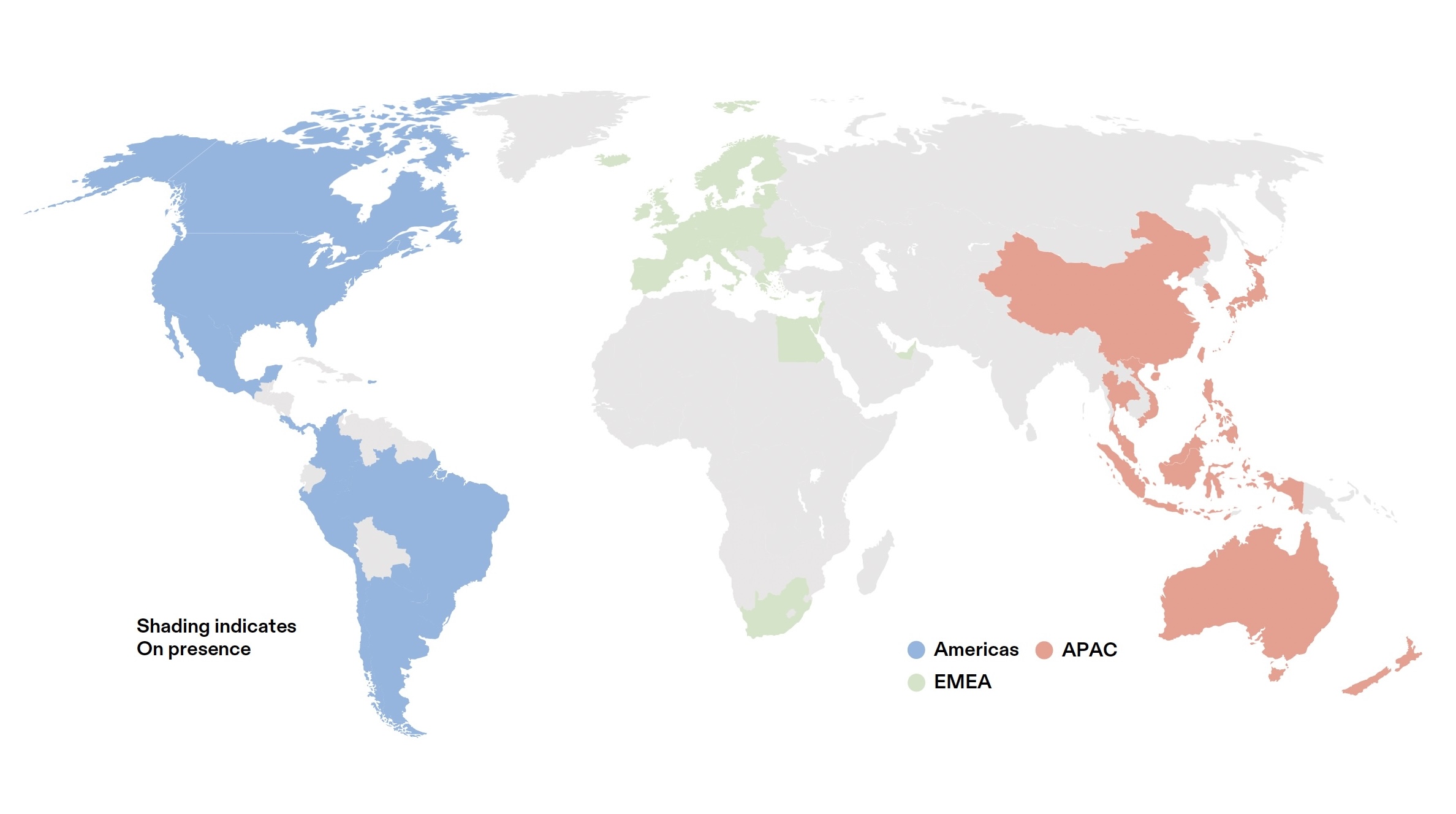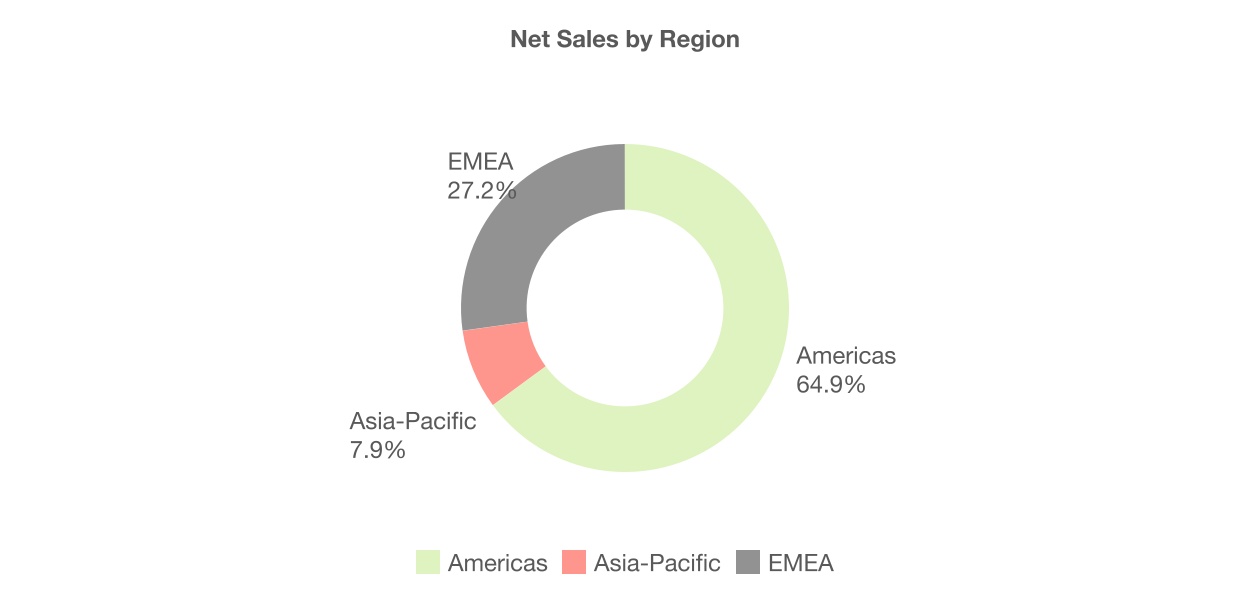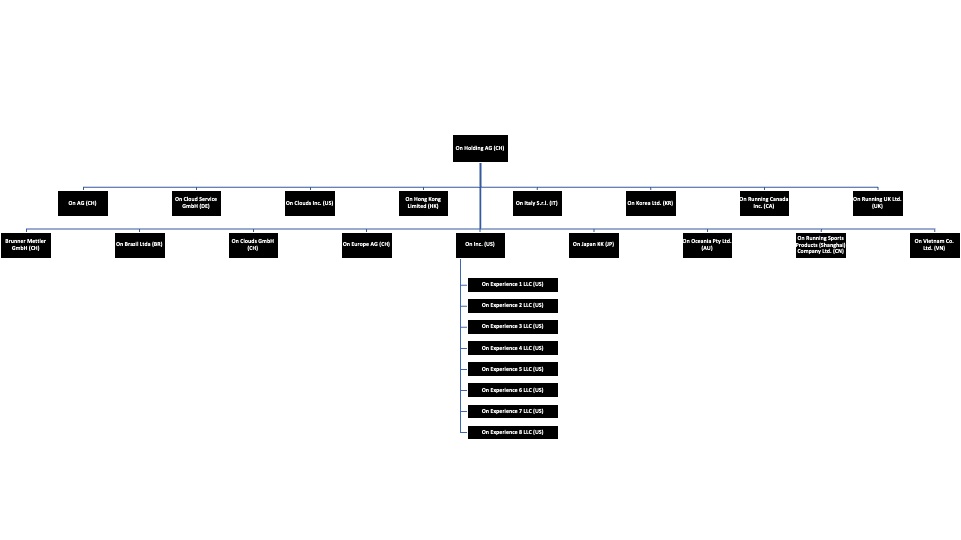false00018589852023FYone2P6MP2YP3YP2YP3YP2YP3Y570.330.330.333000000000018589852023-01-012023-12-310001858985dei:BusinessContactMember2023-01-012023-12-3100018589852023-12-31xbrli:shares0001858985onholdingag:BankOverdraftFacilityFourCHFMember2023-07-07iso4217:CHF0001858985ifrs-full:LeaseLiabilitiesMember2023-12-3100018589852022-01-012022-12-3100018589852021-01-012021-12-310001858985onholdingag:ClassASharesMember2023-01-012023-12-31iso4217:CHFxbrli:shares0001858985onholdingag:ClassASharesMember2022-01-012022-12-310001858985onholdingag:ClassASharesMember2021-01-012021-12-310001858985onholdingag:ClassBVotingSharesMember2023-01-012023-12-310001858985onholdingag:ClassBVotingSharesMember2022-01-012022-12-310001858985onholdingag:ClassBVotingSharesMember2021-01-012021-12-3100018589852022-12-3100018589852021-12-3100018589852020-12-310001858985ifrs-full:IssuedCapitalMember2020-12-310001858985ifrs-full:TreasurySharesMember2020-12-310001858985ifrs-full:CapitalReserveMember2020-12-310001858985ifrs-full:OtherReservesMember2020-12-310001858985ifrs-full:RetainedEarningsMember2020-12-310001858985ifrs-full:RetainedEarningsMember2021-01-012021-12-310001858985ifrs-full:OtherReservesMember2021-01-012021-12-310001858985ifrs-full:IssuedCapitalMember2021-01-012021-12-310001858985ifrs-full:CapitalReserveMember2021-01-012021-12-310001858985ifrs-full:TreasurySharesMember2021-01-012021-12-310001858985ifrs-full:IssuedCapitalMember2021-12-310001858985ifrs-full:TreasurySharesMember2021-12-310001858985ifrs-full:CapitalReserveMember2021-12-310001858985ifrs-full:OtherReservesMember2021-12-310001858985ifrs-full:RetainedEarningsMember2021-12-310001858985ifrs-full:RetainedEarningsMember2022-01-012022-12-310001858985ifrs-full:OtherReservesMember2022-01-012022-12-310001858985ifrs-full:CapitalReserveMember2022-01-012022-12-310001858985ifrs-full:TreasurySharesMember2022-01-012022-12-310001858985ifrs-full:IssuedCapitalMember2022-12-310001858985ifrs-full:TreasurySharesMember2022-12-310001858985ifrs-full:CapitalReserveMember2022-12-310001858985ifrs-full:OtherReservesMember2022-12-310001858985ifrs-full:RetainedEarningsMember2022-12-310001858985ifrs-full:RetainedEarningsMember2023-01-012023-12-310001858985ifrs-full:OtherReservesMember2023-01-012023-12-310001858985ifrs-full:CapitalReserveMember2023-01-012023-12-310001858985ifrs-full:TreasurySharesMember2023-01-012023-12-310001858985ifrs-full:IssuedCapitalMember2023-12-310001858985ifrs-full:TreasurySharesMember2023-12-310001858985ifrs-full:CapitalReserveMember2023-12-310001858985ifrs-full:OtherReservesMember2023-12-310001858985ifrs-full:RetainedEarningsMember2023-12-310001858985onholdingag:OnAGMember2023-01-012023-12-31xbrli:pure0001858985onholdingag:OnAGMember2022-01-012022-12-310001858985onholdingag:OnBrazilLtdaMember2023-01-012023-12-310001858985onholdingag:OnBrazilLtdaMember2022-01-012022-12-310001858985onholdingag:OnCloudServiceGmbHMember2023-01-012023-12-310001858985onholdingag:OnCloudServiceGmbHMember2022-01-012022-12-310001858985onholdingag:OnCloudsGmbHMember2023-01-012023-12-310001858985onholdingag:OnCloudsGmbHMember2022-01-012022-12-310001858985onholdingag:OnCloudsIncMember2023-01-012023-12-310001858985onholdingag:OnCloudsIncMember2022-01-012022-12-310001858985onholdingag:OnEuropeAGMember2023-01-012023-12-310001858985onholdingag:OnEuropeAGMember2022-01-012022-12-310001858985onholdingag:OnExperience1LLCMember2023-01-012023-12-310001858985onholdingag:OnExperience1LLCMember2022-01-012022-12-310001858985onholdingag:OnExperience2LLCMember2023-01-012023-12-310001858985onholdingag:OnExperience2LLCMember2022-01-012022-12-310001858985onholdingag:OnExperience3LLCMember2023-01-012023-12-310001858985onholdingag:OnExperience3LLCMember2022-01-012022-12-310001858985onholdingag:OnExperience4LLCMember2023-01-012023-12-310001858985onholdingag:OnExperience4LLCMember2022-01-012022-12-310001858985onholdingag:OnExperience5LLCMember2023-01-012023-12-310001858985onholdingag:OnExperience5LLCMember2022-01-012022-12-310001858985onholdingag:OnExperience6LLCMember2023-01-012023-12-310001858985onholdingag:OnExperience6LLCMember2022-01-012022-12-310001858985onholdingag:OnExperience7LLCMember2023-01-012023-12-310001858985onholdingag:OnExperience7LLCMember2022-01-012022-12-310001858985onholdingag:OnExperience8LLCMember2023-01-012023-12-310001858985onholdingag:OnExperience8LLCMember2022-01-012022-12-310001858985onholdingag:OnHongKongLtdMember2023-01-012023-12-310001858985onholdingag:OnHongKongLtdMember2022-01-012022-12-310001858985onholdingag:OnIncMember2023-01-012023-12-310001858985onholdingag:OnIncMember2022-01-012022-12-310001858985onholdingag:OnItalySrlMember2023-01-012023-12-310001858985onholdingag:OnItalySrlMember2022-01-012022-12-310001858985onholdingag:OnJapanKKMember2023-01-012023-12-310001858985onholdingag:OnJapanKKMember2022-01-012022-12-310001858985onholdingag:OnKoreaLtd.Member2023-01-012023-12-310001858985onholdingag:OnKoreaLtd.Member2022-01-012022-12-310001858985onholdingag:OnOceaniaPtyLtdMember2023-01-012023-12-310001858985onholdingag:OnOceaniaPtyLtdMember2022-01-012022-12-310001858985onholdingag:OnRunningCanadaIncMember2023-01-012023-12-310001858985onholdingag:OnRunningCanadaIncMember2022-01-012022-12-310001858985onholdingag:OnRunningSportsProductsShanghaiCompanyLtdMember2023-01-012023-12-310001858985onholdingag:OnRunningSportsProductsShanghaiCompanyLtdMember2022-01-012022-12-310001858985onholdingag:OnRunningUKLtdMember2023-01-012023-12-310001858985onholdingag:OnRunningUKLtdMember2022-01-012022-12-310001858985onholdingag:OnVietnamCompanyLtdMember2023-01-012023-12-310001858985onholdingag:OnVietnamCompanyLtdMember2022-01-012022-12-310001858985onholdingag:BrunnerMettlerGmbHMember2023-01-012023-12-310001858985onholdingag:BrunnerMettlerGmbHMember2022-01-012022-12-310001858985ifrs-full:GoodsSoldThroughIntermediariesMember2023-01-012023-12-310001858985ifrs-full:GoodsSoldThroughIntermediariesMember2022-01-012022-12-310001858985ifrs-full:GoodsSoldThroughIntermediariesMember2021-01-012021-12-310001858985ifrs-full:GoodsSoldDirectlyToConsumersMember2023-01-012023-12-310001858985ifrs-full:GoodsSoldDirectlyToConsumersMember2022-01-012022-12-310001858985ifrs-full:GoodsSoldDirectlyToConsumersMember2021-01-012021-12-310001858985onholdingag:ShoesMember2023-01-012023-12-310001858985onholdingag:ShoesMember2022-01-012022-12-310001858985onholdingag:ShoesMember2021-01-012021-12-310001858985onholdingag:ApparelMember2023-01-012023-12-310001858985onholdingag:ApparelMember2022-01-012022-12-310001858985onholdingag:ApparelMember2021-01-012021-12-310001858985onholdingag:AccessoriesMember2023-01-012023-12-310001858985onholdingag:AccessoriesMember2022-01-012022-12-310001858985onholdingag:AccessoriesMember2021-01-012021-12-31onholdingag:salesChannel0001858985onholdingag:EuropeMiddleEastAndAfricaMember2023-01-012023-12-310001858985onholdingag:EuropeMiddleEastAndAfricaMember2022-01-012022-12-310001858985onholdingag:EuropeMiddleEastAndAfricaMember2021-01-012021-12-310001858985country:CH2023-01-012023-12-310001858985country:CH2022-01-012022-12-310001858985country:CH2021-01-012021-12-310001858985srt:AmericasMember2023-01-012023-12-310001858985srt:AmericasMember2022-01-012022-12-310001858985srt:AmericasMember2021-01-012021-12-310001858985country:US2023-01-012023-12-310001858985country:US2022-01-012022-12-310001858985country:US2021-01-012021-12-310001858985srt:AsiaPacificMember2023-01-012023-12-310001858985srt:AsiaPacificMember2022-01-012022-12-310001858985srt:AsiaPacificMember2021-01-012021-12-310001858985onholdingag:RestOfTheWorldMembersrt:RevisionOfPriorPeriodReclassificationAdjustmentMember2022-01-012022-12-310001858985onholdingag:RestOfTheWorldMembersrt:RevisionOfPriorPeriodReclassificationAdjustmentMember2021-01-012021-12-310001858985onholdingag:EuropeMiddleEastAndAfricaMembersrt:RevisionOfPriorPeriodReclassificationAdjustmentMember2022-01-012022-12-310001858985onholdingag:EuropeMiddleEastAndAfricaMembersrt:RevisionOfPriorPeriodReclassificationAdjustmentMember2021-01-012021-12-310001858985srt:AmericasMembersrt:RevisionOfPriorPeriodReclassificationAdjustmentMember2022-01-012022-12-310001858985srt:AmericasMembersrt:RevisionOfPriorPeriodReclassificationAdjustmentMember2021-01-012021-12-310001858985srt:EuropeMembersrt:ScenarioPreviouslyReportedMember2022-01-012022-12-310001858985srt:EuropeMembersrt:ScenarioPreviouslyReportedMember2021-01-012021-12-310001858985country:CHsrt:ScenarioPreviouslyReportedMember2022-01-012022-12-310001858985country:CHsrt:ScenarioPreviouslyReportedMember2021-01-012021-12-310001858985srt:NorthAmericaMembersrt:ScenarioPreviouslyReportedMember2022-01-012022-12-310001858985srt:NorthAmericaMembersrt:ScenarioPreviouslyReportedMember2021-01-012021-12-310001858985srt:ScenarioPreviouslyReportedMembersrt:AsiaPacificMember2022-01-012022-12-310001858985srt:ScenarioPreviouslyReportedMembersrt:AsiaPacificMember2021-01-012021-12-310001858985onholdingag:RestOfTheWorldMembersrt:ScenarioPreviouslyReportedMember2022-01-012022-12-310001858985onholdingag:RestOfTheWorldMembersrt:ScenarioPreviouslyReportedMember2021-01-012021-12-310001858985srt:ScenarioPreviouslyReportedMember2022-01-012022-12-310001858985srt:ScenarioPreviouslyReportedMember2021-01-012021-12-31onholdingag:co-founderonholdingag:numberOfCo-ceo0001858985onholdingag:RestOfTheWorldMember2022-12-310001858985onholdingag:EuropeMiddleEastAndAfricaMember2023-12-310001858985onholdingag:EuropeMiddleEastAndAfricaMember2022-12-310001858985country:CH2023-12-310001858985country:CH2022-12-310001858985srt:AmericasMember2023-12-310001858985srt:AmericasMember2022-12-310001858985country:US2023-12-310001858985country:US2022-12-310001858985srt:AsiaPacificMember2023-12-310001858985srt:AsiaPacificMember2022-12-31onholdingag:Reporting_Segment0001858985ifrs-full:SellingGeneralAndAdministrativeExpenseMember2023-01-012023-12-310001858985ifrs-full:SellingGeneralAndAdministrativeExpenseMember2022-01-012022-12-310001858985ifrs-full:SellingGeneralAndAdministrativeExpenseMember2021-01-012021-12-310001858985ifrs-full:CostOfSalesMember2023-01-012023-12-310001858985ifrs-full:CostOfSalesMember2022-01-012022-12-310001858985ifrs-full:CostOfSalesMember2021-01-012021-12-310001858985ifrs-full:TradeReceivablesMemberifrs-full:GrossCarryingAmountMemberifrs-full:CurrentMember2023-12-310001858985ifrs-full:TradeReceivablesMemberifrs-full:GrossCarryingAmountMemberifrs-full:CurrentMember2022-12-310001858985ifrs-full:TradeReceivablesMemberifrs-full:GrossCarryingAmountMemberonholdingag:LaterThanOneDayAndNotLaterThanNinetyDaysMember2023-12-310001858985ifrs-full:TradeReceivablesMemberifrs-full:GrossCarryingAmountMemberonholdingag:LaterThanOneDayAndNotLaterThanNinetyDaysMember2022-12-310001858985ifrs-full:TradeReceivablesMemberifrs-full:GrossCarryingAmountMemberonholdingag:LaterThanNinetyOneDaysAndNotLaterThanOneHundredAndEightyDaysMember2023-12-310001858985ifrs-full:TradeReceivablesMemberifrs-full:GrossCarryingAmountMemberonholdingag:LaterThanNinetyOneDaysAndNotLaterThanOneHundredAndEightyDaysMember2022-12-310001858985ifrs-full:TradeReceivablesMemberonholdingag:LaterThanOneHundredAndEightyDaysAndNotLaterThanOneYearMemberifrs-full:GrossCarryingAmountMember2023-12-310001858985ifrs-full:TradeReceivablesMemberonholdingag:LaterThanOneHundredAndEightyDaysAndNotLaterThanOneYearMemberifrs-full:GrossCarryingAmountMember2022-12-310001858985ifrs-full:TradeReceivablesMemberifrs-full:GrossCarryingAmountMemberifrs-full:LaterThanOneYearMember2023-12-310001858985ifrs-full:TradeReceivablesMemberifrs-full:GrossCarryingAmountMemberifrs-full:LaterThanOneYearMember2022-12-310001858985ifrs-full:TradeReceivablesMemberifrs-full:GrossCarryingAmountMember2023-12-310001858985ifrs-full:TradeReceivablesMemberifrs-full:GrossCarryingAmountMember2022-12-310001858985ifrs-full:TradeReceivablesMemberonholdingag:AllowanceForCreditLossesOfIndividualDebtorsMember2023-12-310001858985ifrs-full:TradeReceivablesMemberonholdingag:AllowanceForCreditLossesOfIndividualDebtorsMember2022-12-310001858985ifrs-full:TradeReceivablesMemberonholdingag:ExpectedCreditLossesOfTradeReceivablesMember2023-12-310001858985ifrs-full:TradeReceivablesMemberonholdingag:ExpectedCreditLossesOfTradeReceivablesMember2022-12-310001858985ifrs-full:TradeReceivablesMemberifrs-full:AccumulatedImpairmentMember2023-12-310001858985ifrs-full:TradeReceivablesMemberifrs-full:AccumulatedImpairmentMember2022-12-310001858985ifrs-full:TradeReceivablesMember2023-12-310001858985ifrs-full:TradeReceivablesMember2022-12-310001858985ifrs-full:TradeReceivablesMemberonholdingag:AllowanceForCreditLossesOfIndividualDebtorsMember2021-12-310001858985ifrs-full:TradeReceivablesMemberonholdingag:AllowanceForCreditLossesOfIndividualDebtorsMember2023-01-012023-12-310001858985ifrs-full:TradeReceivablesMemberonholdingag:AllowanceForCreditLossesOfIndividualDebtorsMember2022-01-012022-12-310001858985ifrs-full:TradeReceivablesMemberonholdingag:ExpectedCreditLossesOfTradeReceivablesMember2021-12-310001858985ifrs-full:TradeReceivablesMemberonholdingag:ExpectedCreditLossesOfTradeReceivablesMember2023-01-012023-12-310001858985ifrs-full:TradeReceivablesMemberonholdingag:ExpectedCreditLossesOfTradeReceivablesMember2022-01-012022-12-310001858985ifrs-full:GrossCarryingAmountMemberonholdingag:ShoesMember2023-12-310001858985ifrs-full:GrossCarryingAmountMemberonholdingag:ShoesMember2022-12-310001858985ifrs-full:GrossCarryingAmountMemberonholdingag:ApparelMember2023-12-310001858985ifrs-full:GrossCarryingAmountMemberonholdingag:ApparelMember2022-12-310001858985onholdingag:AccessoriesMemberifrs-full:GrossCarryingAmountMember2023-12-310001858985onholdingag:AccessoriesMemberifrs-full:GrossCarryingAmountMember2022-12-310001858985onholdingag:OtherInventoryMemberifrs-full:GrossCarryingAmountMember2023-12-310001858985onholdingag:OtherInventoryMemberifrs-full:GrossCarryingAmountMember2022-12-310001858985ifrs-full:AccumulatedImpairmentMember2023-12-310001858985ifrs-full:AccumulatedImpairmentMember2022-12-310001858985ifrs-full:LeaseholdImprovementsMemberifrs-full:GrossCarryingAmountMember2021-12-310001858985ifrs-full:GrossCarryingAmountMemberonholdingag:TradeToolsMember2021-12-310001858985onholdingag:ProductionToolsMemberifrs-full:GrossCarryingAmountMember2021-12-310001858985ifrs-full:FixturesAndFittingsMemberifrs-full:GrossCarryingAmountMember2021-12-310001858985ifrs-full:OtherPropertyPlantAndEquipmentMemberifrs-full:GrossCarryingAmountMember2021-12-310001858985ifrs-full:GrossCarryingAmountMember2021-12-310001858985ifrs-full:LeaseholdImprovementsMemberifrs-full:AccumulatedDepreciationAndAmortisationMember2021-12-310001858985ifrs-full:AccumulatedDepreciationAndAmortisationMemberonholdingag:TradeToolsMember2021-12-310001858985onholdingag:ProductionToolsMemberifrs-full:AccumulatedDepreciationAndAmortisationMember2021-12-310001858985ifrs-full:FixturesAndFittingsMemberifrs-full:AccumulatedDepreciationAndAmortisationMember2021-12-310001858985ifrs-full:OtherPropertyPlantAndEquipmentMemberifrs-full:AccumulatedDepreciationAndAmortisationMember2021-12-310001858985ifrs-full:AccumulatedDepreciationAndAmortisationMember2021-12-310001858985ifrs-full:LeaseholdImprovementsMember2021-12-310001858985onholdingag:TradeToolsMember2021-12-310001858985onholdingag:ProductionToolsMember2021-12-310001858985ifrs-full:FixturesAndFittingsMember2021-12-310001858985ifrs-full:OtherPropertyPlantAndEquipmentMember2021-12-310001858985ifrs-full:LeaseholdImprovementsMember2022-01-012022-12-310001858985onholdingag:TradeToolsMember2022-01-012022-12-310001858985onholdingag:ProductionToolsMember2022-01-012022-12-310001858985ifrs-full:FixturesAndFittingsMember2022-01-012022-12-310001858985ifrs-full:OtherPropertyPlantAndEquipmentMember2022-01-012022-12-310001858985ifrs-full:LeaseholdImprovementsMember2022-12-310001858985onholdingag:TradeToolsMember2022-12-310001858985onholdingag:ProductionToolsMember2022-12-310001858985ifrs-full:FixturesAndFittingsMember2022-12-310001858985ifrs-full:OtherPropertyPlantAndEquipmentMember2022-12-310001858985ifrs-full:LeaseholdImprovementsMemberifrs-full:GrossCarryingAmountMember2022-12-310001858985ifrs-full:GrossCarryingAmountMemberonholdingag:TradeToolsMember2022-12-310001858985onholdingag:ProductionToolsMemberifrs-full:GrossCarryingAmountMember2022-12-310001858985ifrs-full:FixturesAndFittingsMemberifrs-full:GrossCarryingAmountMember2022-12-310001858985ifrs-full:OtherPropertyPlantAndEquipmentMemberifrs-full:GrossCarryingAmountMember2022-12-310001858985ifrs-full:GrossCarryingAmountMember2022-12-310001858985ifrs-full:LeaseholdImprovementsMemberifrs-full:AccumulatedDepreciationAndAmortisationMember2022-12-310001858985ifrs-full:AccumulatedDepreciationAndAmortisationMemberonholdingag:TradeToolsMember2022-12-310001858985onholdingag:ProductionToolsMemberifrs-full:AccumulatedDepreciationAndAmortisationMember2022-12-310001858985ifrs-full:FixturesAndFittingsMemberifrs-full:AccumulatedDepreciationAndAmortisationMember2022-12-310001858985ifrs-full:OtherPropertyPlantAndEquipmentMemberifrs-full:AccumulatedDepreciationAndAmortisationMember2022-12-310001858985ifrs-full:AccumulatedDepreciationAndAmortisationMember2022-12-310001858985ifrs-full:LeaseholdImprovementsMember2023-01-012023-12-310001858985onholdingag:TradeToolsMember2023-01-012023-12-310001858985onholdingag:ProductionToolsMember2023-01-012023-12-310001858985ifrs-full:FixturesAndFittingsMember2023-01-012023-12-310001858985ifrs-full:OtherPropertyPlantAndEquipmentMember2023-01-012023-12-310001858985ifrs-full:LeaseholdImprovementsMember2023-12-310001858985onholdingag:TradeToolsMember2023-12-310001858985onholdingag:ProductionToolsMember2023-12-310001858985ifrs-full:FixturesAndFittingsMember2023-12-310001858985ifrs-full:OtherPropertyPlantAndEquipmentMember2023-12-310001858985ifrs-full:LeaseholdImprovementsMemberifrs-full:GrossCarryingAmountMember2023-12-310001858985ifrs-full:GrossCarryingAmountMemberonholdingag:TradeToolsMember2023-12-310001858985onholdingag:ProductionToolsMemberifrs-full:GrossCarryingAmountMember2023-12-310001858985ifrs-full:FixturesAndFittingsMemberifrs-full:GrossCarryingAmountMember2023-12-310001858985ifrs-full:OtherPropertyPlantAndEquipmentMemberifrs-full:GrossCarryingAmountMember2023-12-310001858985ifrs-full:GrossCarryingAmountMember2023-12-310001858985ifrs-full:LeaseholdImprovementsMemberifrs-full:AccumulatedDepreciationAndAmortisationMember2023-12-310001858985ifrs-full:AccumulatedDepreciationAndAmortisationMemberonholdingag:TradeToolsMember2023-12-310001858985onholdingag:ProductionToolsMemberifrs-full:AccumulatedDepreciationAndAmortisationMember2023-12-310001858985ifrs-full:FixturesAndFittingsMemberifrs-full:AccumulatedDepreciationAndAmortisationMember2023-12-310001858985ifrs-full:OtherPropertyPlantAndEquipmentMemberifrs-full:AccumulatedDepreciationAndAmortisationMember2023-12-310001858985ifrs-full:AccumulatedDepreciationAndAmortisationMember2023-12-310001858985ifrs-full:ConstructionInProgressMember2023-12-310001858985ifrs-full:ConstructionInProgressMember2022-12-310001858985srt:MinimumMemberifrs-full:ConstructionInProgressMember2023-01-012023-12-310001858985srt:MaximumMemberifrs-full:ConstructionInProgressMember2023-01-012023-12-310001858985ifrs-full:FixturesAndFittingsMembersrt:MinimumMember2023-01-012023-12-310001858985ifrs-full:FixturesAndFittingsMembersrt:MaximumMember2023-01-012023-12-310001858985ifrs-full:OtherPropertyPlantAndEquipmentMembersrt:MinimumMember2023-01-012023-12-310001858985ifrs-full:OtherPropertyPlantAndEquipmentMembersrt:MaximumMember2023-01-012023-12-310001858985ifrs-full:GrossCarryingAmountMembersrt:WarehouseMember2021-12-310001858985ifrs-full:GrossCarryingAmountMemberonholdingag:StoresAndShowroomsMember2021-12-310001858985srt:OfficeBuildingMemberifrs-full:GrossCarryingAmountMember2021-12-310001858985ifrs-full:GrossCarryingAmountMemberifrs-full:VehiclesMember2021-12-310001858985srt:WarehouseMemberifrs-full:AccumulatedDepreciationAndAmortisationMember2021-12-310001858985ifrs-full:AccumulatedDepreciationAndAmortisationMemberonholdingag:StoresAndShowroomsMember2021-12-310001858985srt:OfficeBuildingMemberifrs-full:AccumulatedDepreciationAndAmortisationMember2021-12-310001858985ifrs-full:VehiclesMemberifrs-full:AccumulatedDepreciationAndAmortisationMember2021-12-310001858985srt:WarehouseMember2021-12-310001858985onholdingag:StoresAndShowroomsMember2021-12-310001858985srt:OfficeBuildingMember2021-12-310001858985ifrs-full:VehiclesMember2021-12-310001858985srt:WarehouseMember2022-01-012022-12-310001858985onholdingag:StoresAndShowroomsMember2022-01-012022-12-310001858985srt:OfficeBuildingMember2022-01-012022-12-310001858985ifrs-full:VehiclesMember2022-01-012022-12-310001858985srt:WarehouseMember2022-12-310001858985onholdingag:StoresAndShowroomsMember2022-12-310001858985srt:OfficeBuildingMember2022-12-310001858985ifrs-full:VehiclesMember2022-12-310001858985ifrs-full:GrossCarryingAmountMembersrt:WarehouseMember2022-12-310001858985ifrs-full:GrossCarryingAmountMemberonholdingag:StoresAndShowroomsMember2022-12-310001858985srt:OfficeBuildingMemberifrs-full:GrossCarryingAmountMember2022-12-310001858985ifrs-full:GrossCarryingAmountMemberifrs-full:VehiclesMember2022-12-310001858985srt:WarehouseMemberifrs-full:AccumulatedDepreciationAndAmortisationMember2022-12-310001858985ifrs-full:AccumulatedDepreciationAndAmortisationMemberonholdingag:StoresAndShowroomsMember2022-12-310001858985srt:OfficeBuildingMemberifrs-full:AccumulatedDepreciationAndAmortisationMember2022-12-310001858985ifrs-full:VehiclesMemberifrs-full:AccumulatedDepreciationAndAmortisationMember2022-12-310001858985srt:WarehouseMember2023-01-012023-12-310001858985onholdingag:StoresAndShowroomsMember2023-01-012023-12-310001858985srt:OfficeBuildingMember2023-01-012023-12-310001858985ifrs-full:VehiclesMember2023-01-012023-12-310001858985srt:WarehouseMember2023-12-310001858985onholdingag:StoresAndShowroomsMember2023-12-310001858985srt:OfficeBuildingMember2023-12-310001858985ifrs-full:VehiclesMember2023-12-310001858985ifrs-full:GrossCarryingAmountMembersrt:WarehouseMember2023-12-310001858985ifrs-full:GrossCarryingAmountMemberonholdingag:StoresAndShowroomsMember2023-12-310001858985srt:OfficeBuildingMemberifrs-full:GrossCarryingAmountMember2023-12-310001858985ifrs-full:GrossCarryingAmountMemberifrs-full:VehiclesMember2023-12-310001858985srt:WarehouseMemberifrs-full:AccumulatedDepreciationAndAmortisationMember2023-12-310001858985ifrs-full:AccumulatedDepreciationAndAmortisationMemberonholdingag:StoresAndShowroomsMember2023-12-310001858985srt:OfficeBuildingMemberifrs-full:AccumulatedDepreciationAndAmortisationMember2023-12-310001858985ifrs-full:VehiclesMemberifrs-full:AccumulatedDepreciationAndAmortisationMember2023-12-310001858985onholdingag:LeasedLocationsMember2023-01-012023-12-310001858985srt:WarehouseMembersrt:MinimumMember2023-01-012023-12-310001858985srt:WarehouseMembersrt:MaximumMember2023-01-012023-12-310001858985srt:OfficeBuildingMembersrt:MinimumMember2023-01-012023-12-310001858985srt:OfficeBuildingMembersrt:MaximumMember2023-01-012023-12-310001858985srt:MinimumMemberonholdingag:StoresAndShowroomsMember2023-01-012023-12-310001858985srt:MaximumMemberonholdingag:StoresAndShowroomsMember2023-01-012023-12-310001858985ifrs-full:VehiclesMembersrt:MinimumMember2023-01-012023-12-310001858985ifrs-full:VehiclesMembersrt:MaximumMember2023-01-012023-12-310001858985ifrs-full:CopyrightsPatentsAndOtherIndustrialPropertyRightsServiceAndOperatingRightsMemberifrs-full:GrossCarryingAmountMember2021-12-310001858985ifrs-full:ComputerSoftwareMemberifrs-full:GrossCarryingAmountMember2021-12-310001858985ifrs-full:GoodwillMemberifrs-full:GrossCarryingAmountMember2021-12-310001858985ifrs-full:CopyrightsPatentsAndOtherIndustrialPropertyRightsServiceAndOperatingRightsMemberifrs-full:AccumulatedDepreciationAndAmortisationMember2021-12-310001858985ifrs-full:ComputerSoftwareMemberifrs-full:AccumulatedDepreciationAndAmortisationMember2021-12-310001858985ifrs-full:GoodwillMemberifrs-full:AccumulatedDepreciationAndAmortisationMember2021-12-310001858985ifrs-full:CopyrightsPatentsAndOtherIndustrialPropertyRightsServiceAndOperatingRightsMember2021-12-310001858985ifrs-full:ComputerSoftwareMember2021-12-310001858985ifrs-full:GoodwillMember2021-12-310001858985ifrs-full:CopyrightsPatentsAndOtherIndustrialPropertyRightsServiceAndOperatingRightsMember2022-01-012022-12-310001858985ifrs-full:ComputerSoftwareMember2022-01-012022-12-310001858985ifrs-full:GoodwillMember2022-01-012022-12-310001858985ifrs-full:CopyrightsPatentsAndOtherIndustrialPropertyRightsServiceAndOperatingRightsMember2022-12-310001858985ifrs-full:ComputerSoftwareMember2022-12-310001858985ifrs-full:GoodwillMember2022-12-310001858985ifrs-full:CopyrightsPatentsAndOtherIndustrialPropertyRightsServiceAndOperatingRightsMemberifrs-full:GrossCarryingAmountMember2022-12-310001858985ifrs-full:ComputerSoftwareMemberifrs-full:GrossCarryingAmountMember2022-12-310001858985ifrs-full:GoodwillMemberifrs-full:GrossCarryingAmountMember2022-12-310001858985ifrs-full:CopyrightsPatentsAndOtherIndustrialPropertyRightsServiceAndOperatingRightsMemberifrs-full:AccumulatedDepreciationAndAmortisationMember2022-12-310001858985ifrs-full:ComputerSoftwareMemberifrs-full:AccumulatedDepreciationAndAmortisationMember2022-12-310001858985ifrs-full:GoodwillMemberifrs-full:AccumulatedDepreciationAndAmortisationMember2022-12-310001858985ifrs-full:CopyrightsPatentsAndOtherIndustrialPropertyRightsServiceAndOperatingRightsMember2023-01-012023-12-310001858985ifrs-full:ComputerSoftwareMember2023-01-012023-12-310001858985ifrs-full:GoodwillMember2023-01-012023-12-310001858985ifrs-full:CopyrightsPatentsAndOtherIndustrialPropertyRightsServiceAndOperatingRightsMember2023-12-310001858985ifrs-full:ComputerSoftwareMember2023-12-310001858985ifrs-full:GoodwillMember2023-12-310001858985ifrs-full:CopyrightsPatentsAndOtherIndustrialPropertyRightsServiceAndOperatingRightsMemberifrs-full:GrossCarryingAmountMember2023-12-310001858985ifrs-full:ComputerSoftwareMemberifrs-full:GrossCarryingAmountMember2023-12-310001858985ifrs-full:GoodwillMemberifrs-full:GrossCarryingAmountMember2023-12-310001858985ifrs-full:CopyrightsPatentsAndOtherIndustrialPropertyRightsServiceAndOperatingRightsMemberifrs-full:AccumulatedDepreciationAndAmortisationMember2023-12-310001858985ifrs-full:ComputerSoftwareMemberifrs-full:AccumulatedDepreciationAndAmortisationMember2023-12-310001858985ifrs-full:GoodwillMemberifrs-full:AccumulatedDepreciationAndAmortisationMember2023-12-310001858985ifrs-full:IntangibleAssetsUnderDevelopmentMember2023-12-310001858985ifrs-full:IntangibleAssetsUnderDevelopmentMember2022-12-310001858985ifrs-full:CopyrightsPatentsAndOtherIndustrialPropertyRightsServiceAndOperatingRightsMembersrt:MinimumMember2023-01-012023-12-310001858985ifrs-full:CopyrightsPatentsAndOtherIndustrialPropertyRightsServiceAndOperatingRightsMembersrt:MaximumMember2023-01-012023-12-310001858985ifrs-full:CapitalisedDevelopmentExpenditureMember2023-01-012023-12-310001858985onholdingag:ServiceLicenseAndInvestmentAgreementSLIA2019Member2023-12-310001858985onholdingag:MarketingFreightCustomsSellingAndDistributionCostsMember2022-12-310001858985ifrs-full:FinancialAssetsAtAmortisedCostCategoryMemberonholdingag:CreditCardsMember2023-12-310001858985ifrs-full:FinancialAssetsAtAmortisedCostCategoryMemberonholdingag:CreditCardsMember2022-12-310001858985ifrs-full:FinancialAssetsAtAmortisedCostCategoryMemberonholdingag:DepositAssetsMember2023-12-310001858985ifrs-full:FinancialAssetsAtAmortisedCostCategoryMemberonholdingag:DepositAssetsMember2022-12-310001858985ifrs-full:FinancialAssetsAtAmortisedCostCategoryMemberonholdingag:OtherMiscellaneousCurrentFinancialAssetsMember2023-12-310001858985ifrs-full:FinancialAssetsAtAmortisedCostCategoryMemberonholdingag:OtherMiscellaneousCurrentFinancialAssetsMember2022-12-310001858985ifrs-full:FinancialAssetsAtAmortisedCostCategoryMember2023-12-310001858985ifrs-full:FinancialAssetsAtAmortisedCostCategoryMember2022-12-310001858985ifrs-full:FinancialAssetsAtFairValueThroughProfitOrLossCategoryMember2023-12-310001858985ifrs-full:FinancialAssetsAtFairValueThroughProfitOrLossCategoryMember2022-12-310001858985ifrs-full:FinancialLiabilitiesAtAmortisedCostCategoryMemberifrs-full:LeaseLiabilitiesMember2023-12-310001858985ifrs-full:FinancialLiabilitiesAtAmortisedCostCategoryMemberifrs-full:LeaseLiabilitiesMember2022-12-310001858985onholdingag:MiscellaneousOtherFinancialLiabilitiesMemberifrs-full:FinancialLiabilitiesAtAmortisedCostCategoryMember2023-12-310001858985onholdingag:MiscellaneousOtherFinancialLiabilitiesMemberifrs-full:FinancialLiabilitiesAtAmortisedCostCategoryMember2022-12-310001858985ifrs-full:FinancialLiabilitiesAtAmortisedCostCategoryMember2023-12-310001858985ifrs-full:FinancialLiabilitiesAtAmortisedCostCategoryMember2022-12-310001858985onholdingag:OtherCustomerRefundLiabilitiesMember2023-12-310001858985onholdingag:OtherCustomerRefundLiabilitiesMember2022-12-310001858985ifrs-full:LeaseLiabilitiesMember2021-12-310001858985onholdingag:OtherMember2021-12-310001858985ifrs-full:LeaseLiabilitiesMember2022-01-012022-12-310001858985onholdingag:OtherMember2022-01-012022-12-310001858985ifrs-full:LeaseLiabilitiesMember2022-12-310001858985onholdingag:OtherMember2022-12-310001858985ifrs-full:LeaseLiabilitiesMember2023-01-012023-12-310001858985onholdingag:OtherMember2023-01-012023-12-310001858985onholdingag:OtherMember2023-12-310001858985onholdingag:ClassASharesMember2023-12-310001858985onholdingag:ClassBVotingSharesMember2023-12-310001858985onholdingag:ClassASharesMember2022-12-310001858985onholdingag:ClassBVotingSharesMember2022-12-310001858985onholdingag:AuthorizedCapitalMemberonholdingag:ClassASharesMember2023-01-012023-12-310001858985onholdingag:ClassASharesMemberifrs-full:TreasurySharesMember2023-01-012023-12-310001858985onholdingag:OutstandingShareCapitalMemberonholdingag:ClassASharesMember2023-01-012023-12-310001858985onholdingag:ClassBVotingSharesMemberonholdingag:AuthorizedCapitalMember2023-01-012023-12-310001858985onholdingag:ClassBVotingSharesMemberonholdingag:OutstandingShareCapitalMember2023-01-012023-12-310001858985ifrs-full:SharePremiumMember2023-12-310001858985ifrs-full:SharePremiumMember2022-12-310001858985ifrs-full:StatutoryReserveMember2023-12-310001858985ifrs-full:StatutoryReserveMember2022-12-310001858985onholdingag:ReserveForEquityTransactionCostsMember2023-12-310001858985onholdingag:ReserveForEquityTransactionCostsMember2022-12-310001858985onholdingag:ReserveForCurrentTaxBenefitsOnEquityTransactionCostsMember2023-12-310001858985onholdingag:ReserveForCurrentTaxBenefitsOnEquityTransactionCostsMember2022-12-310001858985ifrs-full:ReserveOfSharebasedPaymentsMember2023-12-310001858985ifrs-full:ReserveOfSharebasedPaymentsMember2022-12-310001858985ifrs-full:ReserveOfExchangeDifferencesOnTranslationMember2023-12-310001858985ifrs-full:ReserveOfExchangeDifferencesOnTranslationMember2022-12-310001858985onholdingag:ReserveForActuarialGainsAndLossesBeforeTaxMember2023-12-310001858985onholdingag:ReserveForActuarialGainsAndLossesBeforeTaxMember2022-12-310001858985onholdingag:ReserveForTaxOnActuarialGainsAndLossesMember2023-12-310001858985onholdingag:ReserveForTaxOnActuarialGainsAndLossesMember2022-12-310001858985ifrs-full:ContingentLiabilityForGuaranteesMember2023-12-310001858985ifrs-full:ContingentLiabilityForGuaranteesMember2022-12-310001858985onholdingag:AtlantaMember2023-12-310001858985country:BE2023-12-310001858985onholdingag:AtlantaMember2022-12-310001858985country:BE2022-12-310001858985onholdingag:BankOverdraftFacilityFourCHFMember2023-12-310001858985onholdingag:GroupCashPoolParticipantsMember2023-12-310001858985onholdingag:GroupCashPoolParticipantsMember2022-12-310001858985ifrs-full:NotLaterThanOneYearMember2023-12-310001858985ifrs-full:NotLaterThanOneYearMember2022-12-310001858985ifrs-full:LaterThanOneYearAndNotLaterThanFiveYearsMember2023-12-310001858985ifrs-full:LaterThanOneYearAndNotLaterThanFiveYearsMember2022-12-310001858985ifrs-full:LaterThanFiveYearsMember2023-12-310001858985ifrs-full:LaterThanFiveYearsMember2022-12-310001858985onholdingag:LeasedLocationsMember2023-12-310001858985currency:AUD2023-12-31iso4217:AUDiso4217:CHF0001858985currency:AUD2022-12-310001858985currency:BRL2023-12-310001858985currency:BRL2022-12-310001858985currency:CAD2023-12-310001858985currency:CAD2022-12-310001858985currency:CNY2023-12-310001858985currency:CNY2022-12-310001858985currency:EUR2023-12-310001858985currency:EUR2022-12-310001858985currency:GBP2023-12-310001858985currency:GBP2022-12-310001858985currency:JPY2023-12-310001858985currency:JPY2022-12-310001858985currency:HKD2023-12-310001858985currency:HKD2022-12-310001858985currency:USD2023-12-310001858985currency:USD2022-12-310001858985currency:AUD2023-01-012023-12-310001858985currency:AUD2022-01-012022-12-310001858985currency:AUD2021-01-012021-12-310001858985currency:BRL2023-01-012023-12-310001858985currency:BRL2022-01-012022-12-310001858985currency:BRL2021-01-012021-12-310001858985currency:CAD2023-01-012023-12-310001858985currency:CAD2022-01-012022-12-310001858985currency:CAD2021-01-012021-12-310001858985currency:CNY2023-01-012023-12-310001858985currency:CNY2022-01-012022-12-310001858985currency:CNY2021-01-012021-12-310001858985currency:EUR2023-01-012023-12-310001858985currency:EUR2022-01-012022-12-310001858985currency:EUR2021-01-012021-12-310001858985currency:GBP2023-01-012023-12-310001858985currency:GBP2022-01-012022-12-310001858985currency:GBP2021-01-012021-12-310001858985currency:JPY2023-01-012023-12-310001858985currency:JPY2022-01-012022-12-310001858985currency:JPY2021-01-012021-12-310001858985currency:HKD2023-01-012023-12-310001858985currency:HKD2022-01-012022-12-310001858985currency:HKD2021-01-012021-12-310001858985currency:USD2023-01-012023-12-310001858985currency:USD2022-01-012022-12-310001858985currency:USD2021-01-012021-12-31iso4217:USDiso4217:EUR0001858985ifrs-full:CurrencyRiskMember2023-01-012023-12-310001858985currency:USDifrs-full:CurrencyRiskMember2023-01-012023-12-310001858985currency:USDifrs-full:CurrencyRiskMember2022-01-012022-12-310001858985currency:USDifrs-full:CurrencyRiskMember2021-01-012021-12-310001858985currency:EURifrs-full:CurrencyRiskMember2023-01-012023-12-310001858985currency:EURifrs-full:CurrencyRiskMember2022-01-012022-12-310001858985currency:EURifrs-full:CurrencyRiskMember2021-01-012021-12-310001858985ifrs-full:NotLaterThanThreeMonthsMember2023-12-310001858985ifrs-full:LaterThanThreeMonthsAndNotLaterThanOneYearMember2023-12-310001858985ifrs-full:NotLaterThanThreeMonthsMember2022-12-310001858985ifrs-full:LaterThanThreeMonthsAndNotLaterThanOneYearMember2022-12-310001858985onholdingag:MarketingFreightCustomsSellingAndDistributionCostsMember2023-12-310001858985onholdingag:BankOverdraftFacilityOneCHFMember2022-12-310001858985onholdingag:BankOverdraftFacilityTwoCHFMember2022-12-310001858985onholdingag:BankOverdraftFacilityThreeUSDMember2022-12-310001858985onholdingag:BankOverdraftFacilityFourCHFMember2023-01-012023-12-310001858985onholdingag:LongTermIncentivePlanLTIP2021Member2023-01-012023-12-310001858985onholdingag:OtherShareBasedCompensationPlansMember2023-01-012023-12-310001858985onholdingag:LongTermIncentivePlanLTIP2021Member2022-01-012022-12-310001858985onholdingag:OtherShareBasedCompensationPlansMember2022-01-012022-12-310001858985onholdingag:RSUsMemberonholdingag:LongTermParticipationPlanLTPP2018Member2023-01-012023-12-310001858985onholdingag:ServiceLicenseAndInvestmentAgreementSLIA2019Memberonholdingag:RSUsMember2021-01-012021-12-310001858985onholdingag:LongTermIncentivePlanLTIP2021Memberonholdingag:FirstAnniversaryOfTheGrantingDateMemberonholdingag:RSUsMember2023-01-012023-12-310001858985onholdingag:LongTermIncentivePlanLTIP2021Memberonholdingag:EachQuarterFollowingTheFirstAnniversaryOfTheGrantingDateMemberonholdingag:RSUsMember2023-01-012023-12-310001858985onholdingag:LongTermIncentivePlanLTIP2021Memberonholdingag:PSUsMemberonholdingag:PerformanceCycle1Member2023-01-012023-12-310001858985onholdingag:LongTermIncentivePlanLTIP2021Memberonholdingag:PSUsMemberonholdingag:PerformanceCycle2Member2023-01-012023-12-310001858985onholdingag:ExecutiveBoardMemberonholdingag:LongTermIncentivePlanLTIP2021Memberonholdingag:PSUsMemberonholdingag:PerformanceCycle1Member2023-01-012023-12-310001858985onholdingag:ExecutiveBoardMemberonholdingag:LongTermIncentivePlanLTIP2021Memberonholdingag:PSUsMemberonholdingag:PerformanceCycle2Member2023-01-012023-12-310001858985onholdingag:LongTermParticipationPlanLTPP2018Memberonholdingag:PhantomOptionsMember2021-12-310001858985onholdingag:LongTermParticipationPlanLTPP2018Member2021-12-31iso4217:USDxbrli:shares0001858985onholdingag:LongTermIncentivePlanLTIP2018Member2021-12-31onholdingag:share0001858985onholdingag:LongTermParticipationPlanLTPP2018Memberonholdingag:PhantomOptionsMember2022-01-012022-12-310001858985onholdingag:LongTermIncentivePlanLTIP2018Member2022-01-012022-12-310001858985onholdingag:LongTermParticipationPlanLTPP2018Member2022-01-012022-12-310001858985onholdingag:LongTermParticipationPlanLTPP2018Memberonholdingag:PhantomOptionsMember2022-12-310001858985onholdingag:LongTermParticipationPlanLTPP2018Member2022-12-310001858985onholdingag:LongTermIncentivePlanLTIP2018Member2022-12-31onholdingag:year0001858985onholdingag:LongTermParticipationPlanLTPP2018Memberonholdingag:PhantomOptionsMember2023-01-012023-12-310001858985onholdingag:LongTermIncentivePlanLTIP2018Member2023-01-012023-12-310001858985onholdingag:LongTermParticipationPlanLTPP2018Member2023-01-012023-12-310001858985onholdingag:LongTermParticipationPlanLTPP2018Memberonholdingag:PhantomOptionsMember2023-12-310001858985onholdingag:LongTermParticipationPlanLTPP2018Member2023-12-310001858985onholdingag:LongTermIncentivePlanLTIP2018Member2023-12-310001858985onholdingag:LongTermIncentivePlanLTIP2020Memberonholdingag:ClassASharesMember2021-12-310001858985onholdingag:ClassBVotingSharesMemberonholdingag:LongTermIncentivePlanLTIP2020Member2021-12-310001858985onholdingag:LongTermIncentivePlanLTIP2020Memberonholdingag:ClassASharesMember2022-01-012022-12-310001858985onholdingag:ClassBVotingSharesMemberonholdingag:LongTermIncentivePlanLTIP2020Member2022-01-012022-12-310001858985onholdingag:LongTermIncentivePlanLTIP2020Memberonholdingag:ClassASharesMember2022-12-310001858985onholdingag:ClassBVotingSharesMemberonholdingag:LongTermIncentivePlanLTIP2020Member2022-12-310001858985onholdingag:LongTermIncentivePlanLTIP2020Memberonholdingag:ClassASharesMember2023-01-012023-12-310001858985onholdingag:ClassBVotingSharesMemberonholdingag:LongTermIncentivePlanLTIP2020Member2023-01-012023-12-310001858985onholdingag:LongTermIncentivePlanLTIP2020Memberonholdingag:ClassASharesMember2023-12-310001858985onholdingag:ClassBVotingSharesMemberonholdingag:LongTermIncentivePlanLTIP2020Member2023-12-310001858985onholdingag:PhantomSharesMemberonholdingag:OnEmployeeParticipationProgramOEPP2018Member2021-12-310001858985onholdingag:TheBoardOfDirectorsOfOnBoD2019Member2021-12-310001858985onholdingag:ServiceLicenseAndInvestmentAgreementSLIA2019Member2021-12-310001858985onholdingag:PhantomSharesMemberonholdingag:OnEmployeeParticipationProgramOEPP2018Member2022-01-012022-12-310001858985onholdingag:TheBoardOfDirectorsOfOnBoD2019Member2022-01-012022-12-310001858985onholdingag:ServiceLicenseAndInvestmentAgreementSLIA2019Member2022-01-012022-12-310001858985onholdingag:PhantomSharesMemberonholdingag:OnEmployeeParticipationProgramOEPP2018Member2022-12-310001858985onholdingag:TheBoardOfDirectorsOfOnBoD2019Member2022-12-310001858985onholdingag:ServiceLicenseAndInvestmentAgreementSLIA2019Member2022-12-310001858985onholdingag:PhantomSharesMemberonholdingag:OnEmployeeParticipationProgramOEPP2018Member2023-01-012023-12-310001858985onholdingag:TheBoardOfDirectorsOfOnBoD2019Member2023-01-012023-12-310001858985onholdingag:ServiceLicenseAndInvestmentAgreementSLIA2019Member2023-01-012023-12-310001858985onholdingag:PhantomSharesMemberonholdingag:OnEmployeeParticipationProgramOEPP2018Member2023-12-310001858985onholdingag:TheBoardOfDirectorsOfOnBoD2019Member2023-12-310001858985onholdingag:ServiceLicenseAndInvestmentAgreementSLIA2019Member2023-12-310001858985onholdingag:LongTermIncentivePlanLTIP2021Memberonholdingag:RestrictedShareUnitsRSUMember2021-12-310001858985onholdingag:LongTermIncentivePlanLTIP2021Memberonholdingag:PerformanceShareUnitsPSUMember2021-12-310001858985onholdingag:FoundersPlan2021Member2021-12-310001858985onholdingag:TaxRecognitionMember2021-12-310001858985onholdingag:LongTermIncentivePlanLTIP2021Memberonholdingag:RestrictedShareUnitsRSUMember2022-01-012022-12-310001858985onholdingag:LongTermIncentivePlanLTIP2021Memberonholdingag:PerformanceShareUnitsPSUMember2022-01-012022-12-310001858985onholdingag:FoundersPlan2021Member2022-01-012022-12-310001858985onholdingag:TaxRecognitionMember2022-01-012022-12-310001858985onholdingag:LongTermIncentivePlanLTIP2021Memberonholdingag:RestrictedShareUnitsRSUMember2022-12-310001858985onholdingag:LongTermIncentivePlanLTIP2021Memberonholdingag:PerformanceShareUnitsPSUMember2022-12-310001858985onholdingag:FoundersPlan2021Member2022-12-310001858985onholdingag:TaxRecognitionMember2022-12-310001858985onholdingag:LongTermIncentivePlanLTIP2021Memberonholdingag:RestrictedShareUnitsRSUMember2023-01-012023-12-310001858985onholdingag:LongTermIncentivePlanLTIP2021Memberonholdingag:PerformanceShareUnitsPSUMember2023-01-012023-12-310001858985onholdingag:FoundersPlan2021Member2023-01-012023-12-310001858985onholdingag:TaxRecognitionMember2023-01-012023-12-310001858985onholdingag:LongTermIncentivePlanLTIP2021Memberonholdingag:RestrictedShareUnitsRSUMember2023-12-310001858985onholdingag:LongTermIncentivePlanLTIP2021Memberonholdingag:PerformanceShareUnitsPSUMember2023-12-310001858985onholdingag:FoundersPlan2021Member2023-12-310001858985onholdingag:TaxRecognitionMember2023-12-31utr:Y0001858985onholdingag:LongTermIncentivePlanLTIP2021Memberonholdingag:RestrictedShareUnitsRSUMember2023-12-180001858985onholdingag:LongTermIncentivePlanLTIP2021Memberonholdingag:PerformanceShareUnitsPSUMember2023-12-180001858985onholdingag:LongTermIncentivePlanLTIP2021Memberonholdingag:RestrictedShareUnitsRSUMember2023-09-260001858985onholdingag:LongTermIncentivePlanLTIP2021Memberonholdingag:PerformanceShareUnitsPSUMember2023-09-260001858985onholdingag:LongTermIncentivePlanLTIP2021Memberonholdingag:RestrictedShareUnitsRSUMember2023-06-230001858985onholdingag:LongTermIncentivePlanLTIP2021Memberonholdingag:PerformanceShareUnitsPSUMember2023-06-230001858985onholdingag:LongTermIncentivePlanLTIP2021Memberonholdingag:RestrictedShareUnitsRSUMember2023-04-010001858985onholdingag:LongTermIncentivePlanLTIP2021Memberonholdingag:PerformanceShareUnitsPSUMember2023-04-010001858985onholdingag:LongTermIncentivePlanLTIP2021Memberonholdingag:RestrictedShareUnitsRSUMember2023-03-280001858985onholdingag:LongTermIncentivePlanLTIP2021Memberonholdingag:PerformanceShareUnitsPSUMember2023-03-280001858985onholdingag:LongTermIncentivePlanLTIP2021Memberonholdingag:RestrictedShareUnitsRSUMember2023-03-090001858985onholdingag:RestrictedShareUnitsRSUMemberonholdingag:TheBoardOfDirectorsOfOnBoD2019Member2023-03-270001858985onholdingag:RestrictedShareUnitsRSUMemberonholdingag:TheBoardOfDirectorsOfOnBoD2019Member2023-06-230001858985onholdingag:RestrictedShareUnitsRSUMemberonholdingag:TheBoardOfDirectorsOfOnBoD2019Member2023-09-260001858985onholdingag:RestrictedShareUnitsRSUMemberonholdingag:TheBoardOfDirectorsOfOnBoD2019Member2023-12-180001858985onholdingag:TaxRecognitionMemberonholdingag:ClassASharesMember2023-03-010001858985onholdingag:FoundersPlan2021Memberonholdingag:ClassASharesMember2023-03-010001858985onholdingag:LongTermIncentivePlanLTIP2020Memberonholdingag:ClassAOptionsMember2022-06-120001858985onholdingag:LongTermIncentivePlanLTIP2020Memberonholdingag:ClassBOptionsMember2022-06-120001858985onholdingag:LongTermIncentivePlanLTIP2020Memberonholdingag:ClassAOptionsMembersrt:MinimumMember2022-06-120001858985onholdingag:LongTermIncentivePlanLTIP2020Memberonholdingag:ClassAOptionsMembersrt:MaximumMember2022-06-120001858985onholdingag:LongTermIncentivePlanLTIP2020Memberonholdingag:ClassAOptionsMember2022-06-122022-06-120001858985onholdingag:LongTermIncentivePlanLTIP2020Memberonholdingag:ClassBOptionsMember2022-12-062022-12-060001858985onholdingag:LongTermIncentivePlanLTIP2020Memberonholdingag:ClassAOptionsMembersrt:MinimumMember2022-06-122022-06-120001858985onholdingag:LongTermIncentivePlanLTIP2020Memberonholdingag:ClassAOptionsMembersrt:MaximumMember2022-06-122022-06-120001858985onholdingag:LongTermIncentivePlanLTIP2020Memberonholdingag:ClassBOptionsMember2022-06-122022-06-120001858985onholdingag:LongTermIncentivePlanLTIP2021Memberonholdingag:RestrictedShareUnitsRSUMember2022-03-310001858985onholdingag:LongTermIncentivePlanLTIP2021Memberonholdingag:PerformanceShareUnitsPSUMember2022-03-310001858985onholdingag:LongTermIncentivePlanLTIP2021Memberonholdingag:PerformanceShareUnitsPSUMember2022-06-240001858985onholdingag:LongTermIncentivePlanLTIP2021Memberonholdingag:PerformanceShareUnitsPSUMember2023-09-230001858985onholdingag:LongTermIncentivePlanLTIP2021Memberonholdingag:RestrictedShareUnitsRSUMember2022-12-060001858985onholdingag:LongTermIncentivePlanLTIP2021Memberonholdingag:PerformanceShareUnitsPSUMember2022-12-190001858985onholdingag:RestrictedShareUnitsRSUMemberonholdingag:TheBoardOfDirectorsOfOnBoD2019Member2022-02-180001858985onholdingag:RestrictedShareUnitsRSUMemberonholdingag:TheBoardOfDirectorsOfOnBoD2019Member2022-03-310001858985onholdingag:RestrictedShareUnitsRSUMemberonholdingag:TheBoardOfDirectorsOfOnBoD2019Member2022-06-240001858985onholdingag:RestrictedShareUnitsRSUMemberonholdingag:TheBoardOfDirectorsOfOnBoD2019Member2022-09-230001858985onholdingag:RestrictedShareUnitsRSUMemberonholdingag:TheBoardOfDirectorsOfOnBoD2019Member2022-12-190001858985onholdingag:TaxRecognitionMemberonholdingag:ClassASharesMember2022-12-1900018589852022-01-012022-09-3000018589852022-10-012022-12-310001858985onholdingag:LongTermIncentivePlanLTIP2018Memberonholdingag:RSUsMember2023-01-012023-12-310001858985onholdingag:LongTermIncentivePlanLTIP2020Memberonholdingag:RSUsMember2023-01-012023-12-310001858985onholdingag:ExecutiveBoardMemberonholdingag:LongTermIncentivePlanLTIP2021Memberonholdingag:RSUsMemberonholdingag:GrantingDateMember2023-01-012023-12-310001858985onholdingag:ExecutiveBoardMemberonholdingag:LongTermIncentivePlanLTIP2021Memberonholdingag:FirstAnniversaryOfTheGrantingDateMemberonholdingag:RSUsMember2023-01-012023-12-310001858985onholdingag:ExecutiveBoardMemberonholdingag:LongTermIncentivePlanLTIP2021Memberonholdingag:RSUsMemberonholdingag:SecondAnniversaryOfGrantingDateMember2023-01-012023-12-310001858985onholdingag:LongTermIncentivePlanLTIP2021Memberonholdingag:PSUsMember2023-01-012023-12-310001858985ifrs-full:PresentValueOfDefinedBenefitObligationMember2022-12-310001858985ifrs-full:PresentValueOfDefinedBenefitObligationMember2021-12-310001858985ifrs-full:PresentValueOfDefinedBenefitObligationMember2023-01-012023-12-310001858985ifrs-full:PresentValueOfDefinedBenefitObligationMember2022-01-012022-12-310001858985ifrs-full:PresentValueOfDefinedBenefitObligationMember2023-12-310001858985ifrs-full:PlanAssetsMember2022-12-310001858985ifrs-full:PlanAssetsMember2021-12-310001858985ifrs-full:PlanAssetsMember2023-01-012023-12-310001858985ifrs-full:PlanAssetsMember2022-01-012022-12-310001858985ifrs-full:PlanAssetsMember2023-12-310001858985ifrs-full:ActuarialAssumptionOfDiscountRatesMember2023-12-310001858985ifrs-full:ActuarialAssumptionOfDiscountRatesMember2022-12-310001858985ifrs-full:ActuarialAssumptionOfExpectedRatesOfSalaryIncreasesMember2023-12-310001858985ifrs-full:ActuarialAssumptionOfExpectedRatesOfSalaryIncreasesMember2022-12-310001858985ifrs-full:ActuarialAssumptionOfLifeExpectancyAfterRetirementMember2023-12-310001858985ifrs-full:ActuarialAssumptionOfLifeExpectancyAfterRetirementMember2022-12-310001858985onholdingag:SocialChargesMember2021-12-310001858985onholdingag:LongServiceLeaveMember2021-12-310001858985onholdingag:AssetRetirementObligationMember2021-12-310001858985onholdingag:SocialChargesMember2022-01-012022-12-310001858985onholdingag:LongServiceLeaveMember2022-01-012022-12-310001858985onholdingag:AssetRetirementObligationMember2022-01-012022-12-310001858985onholdingag:SocialChargesMember2022-12-310001858985onholdingag:LongServiceLeaveMember2022-12-310001858985onholdingag:AssetRetirementObligationMember2022-12-310001858985onholdingag:SocialChargesMember2023-01-012023-12-310001858985onholdingag:LongServiceLeaveMember2023-01-012023-12-310001858985onholdingag:AssetRetirementObligationMember2023-01-012023-12-310001858985onholdingag:SocialChargesMember2023-12-310001858985onholdingag:LongServiceLeaveMember2023-12-310001858985onholdingag:AssetRetirementObligationMember2023-12-310001858985onholdingag:IncomeNotSubjectToTaxNettingMember2021-01-012021-12-310001858985onholdingag:TradeReceivableRelatedTemporaryDifferencesMember2023-12-310001858985onholdingag:TradeReceivableRelatedTemporaryDifferencesMember2022-12-310001858985onholdingag:InventoryRelatedTemporaryDifferencesMember2023-12-310001858985onholdingag:InventoryRelatedTemporaryDifferencesMember2022-12-310001858985onholdingag:OtherCurrentAssetsRelatedTemporaryDifferencesMember2023-12-310001858985onholdingag:OtherCurrentAssetsRelatedTemporaryDifferencesMember2022-12-310001858985onholdingag:PropertyPlantAndEquipmentRelatedTemporaryDifferencesMember2023-12-310001858985onholdingag:PropertyPlantAndEquipmentRelatedTemporaryDifferencesMember2022-12-310001858985onholdingag:RightOfUseAssetRelatedTemporaryDifferencesMember2023-12-310001858985onholdingag:RightOfUseAssetRelatedTemporaryDifferencesMember2022-12-310001858985onholdingag:IntangibleAssetRelatedTemporaryDifferencesMember2023-12-310001858985onholdingag:IntangibleAssetRelatedTemporaryDifferencesMember2022-12-310001858985onholdingag:OtherCurrentFinancialLiabilitiesRelatedTemporaryDifferencesMember2023-12-310001858985onholdingag:OtherCurrentFinancialLiabilitiesRelatedTemporaryDifferencesMember2022-12-310001858985onholdingag:OtherCurrentOperatingLiabilitiesRelatedTemporaryDifferencesMember2023-12-310001858985onholdingag:OtherCurrentOperatingLiabilitiesRelatedTemporaryDifferencesMember2022-12-310001858985onholdingag:CurrentProvisionsRelatedTemporaryDifferencesMember2023-12-310001858985onholdingag:CurrentProvisionsRelatedTemporaryDifferencesMember2022-12-310001858985onholdingag:EmployeeBenefitObligationsRelatedTemporaryDifferencesMember2023-12-310001858985onholdingag:EmployeeBenefitObligationsRelatedTemporaryDifferencesMember2022-12-310001858985onholdingag:NonCurrentProvisionsRelatedTemporaryDifferencesMember2023-12-310001858985onholdingag:NonCurrentProvisionsRelatedTemporaryDifferencesMember2022-12-310001858985onholdingag:OtherNonCurrentProvisionsRelatedTemporaryDifferencesMember2023-12-310001858985onholdingag:OtherNonCurrentProvisionsRelatedTemporaryDifferencesMember2022-12-310001858985ifrs-full:UnusedTaxLossesMember2023-12-310001858985ifrs-full:UnusedTaxLossesMember2022-12-310001858985onholdingag:BeforeOffsetAmountMember2023-12-310001858985onholdingag:BeforeOffsetAmountMember2022-12-310001858985onholdingag:OffsetAmountMember2023-12-310001858985onholdingag:OffsetAmountMember2022-12-310001858985onholdingag:NonExecutiveDirectorsMember2023-01-012023-12-310001858985onholdingag:NonExecutiveDirectorsMember2022-01-012022-12-310001858985onholdingag:NonExecutiveDirectorsMember2021-01-012021-12-31onholdingag:executiveMemberonholdingag:grant0001858985onholdingag:RegionalCoreManagementTeamCostsMember2022-12-310001858985onholdingag:OfficeRentalMember2022-12-310001858985onholdingag:OfficeRentalMember2023-12-310001858985onholdingag:RetailFootprintAndSalesGrowthMember2023-12-31
UNITED STATES
SECURITIES AND EXCHANGE COMMISSION
WASHINGTON, D.C. 20549
________________________
FORM 20-F
________________________
|
|
|
|
|
|
| (Mark One) |
| o |
REGISTRATION STATEMENT PURSUANT TO SECTION 12(b) OR (g) OF THE SECURITIES EXCHANGE ACT OF 1934 |
| x |
ANNUAL REPORT PURSUANT TO SECTION 13 OR 15(d) OF THE SECURITIES EXCHANGE ACT OF 1934 |
| o |
TRANSITION REPORT PURSUANT TO SECTION 13 OR 15(d) OF THE SECURITIES EXCHANGE ACT OF 1934 |
| o |
SHELL COMPANY REPORT PURSUANT TO SECTION 13 OR 15(d) OF THE SECURITIES EXCHANGE ACT OF 1934 |
For the fiscal year ended December 31, 2023
Commission File Number: 001-40795
On Holding AG
(Exact name of registrant as specified in its charter)
n/a
(Translation of Registrant's name into English)
Switzerland
(Jurisdiction of incorporation or organization)
|
|
|
| Förrlibuckstrasse 190 |
8005 Zurich, Switzerland |
(Address of principal executive offices)
|
|
|
| Martin Hoffmann |
| Chief Financial Officer and Co-Chief Executive Officer |
| Förrlibuckstrasse 190 |
8005 Zurich, Switzerland |
Tel: +41 44 225 1555 |
Fax: +41 44 225 1556 |
(Name, Telephone, E-mail and/or Facsimile number and Address of Company Contact Person)
_________________________
Copies to:
Deanna L. Kirkpatrick
Michael Kaplan
Yasin Keshvargar
Davis Polk & Wardwell LLP
450 Lexington Avenue
New York, NY 10017
(212) 450-4000
Securities registered or to be registered pursuant to Section 12(b) of the Act.
|
|
|
|
|
|
|
|
|
| Title of each class |
Trading Symbol(s) |
Name of each exchange on which registered |
| Class A ordinary shares, par value CHF 0.10 per share |
ONON |
New York Stock Exchange |
|
|
|
Securities registered or to be registered pursuant to Section 12(g) of the Act.
_________________________
(Title of Class)
Securities for which there is a reporting obligation pursuant to Section 15(d) of the Act.
_________________________
(Title of Class)
Indicate the number of outstanding shares of each of the issuer’s classes of capital or common stock as of the close of the period covered by the annual report.
Class A ordinary shares: 284,215,277
Class B voting rights shares: 345,437,500
Indicate by check mark if the registrant is a well-known seasoned issuer, as defined in Rule 405 of the Securities Act. ☒ Yes ☐ No
If this report is an annual or transition report, indicate by check mark if the registrant is not required to file reports pursuant to Section 13 or 15(d) of the Securities Exchange Act of 1934. ☐ Yes ☒ No
Note—Checking the box above will not relieve any registrant required to file reports pursuant to Section 13 or 15(d) of the Securities Exchange Act of 1934 from their obligations under those Sections.
Indicate by check mark whether the registrant (1) has filed all reports required to be filed by Section 13 or 15(d) of the Securities Exchange Act of 1934 during the preceding 12 months (or for such shorter period that the registrant was required to file such reports), and (2) has been subject to such filing requirements for the past 90 days. ☒ Yes ☐ No
Indicate by check mark whether the registrant has submitted electronically every Interactive Data File required to be submitted pursuant to Rule 405 of Regulation S-T (§232.405 of this chapter) during the preceding 12 months (or for such shorter period that the registrant was required to submit such files). ☒ Yes ☐ No
Indicate by check mark whether the registrant is a large accelerated filer, an accelerated filer, a non-accelerated filer, or an emerging growth company. See the definition of “large accelerated filer,” “accelerated filer,” and “emerging growth company” in Rule 12b-2 of the Exchange Act.
Large Accelerated Filer ☒ Accelerated Filer ☐ Non-Accelerated Filer ☐ Emerging growth company ☐
If an emerging growth company that prepares its financial statements in accordance with U.S. GAAP, indicate by check mark if the registrant has elected not to use the extended transition period for complying with any new or revised financial accounting standards† provided pursuant to Section 13(a) of the Exchange Act. ☐
† The term “new or revised financial accounting standard” refers to any update issued by the Financial Accounting Standards Board to its Accounting Standards Codification after April 5, 2012.
Indicate by check mark whether the registrant has filed a report on and attestation to its management’s assessment of the effectiveness of its internal control over financial reporting under Section 404(b) of the Sarbanes-Oxley Act (15 U.S.C. 7262(b)) by the registered public accounting firm that prepared or issued its audit report. ☒
If securities are registered pursuant to Section 12(b) of the Act, indicate by check mark whether the
financial statements of the registrant included in the filing reflect the correction of an error to
previously issued financial statements. ☐
Indicate by check mark whether any of those error corrections are restatements that required a
recovery analysis of incentive based compensation received by any of the registrant’s executive
officers during the relevant recovery period pursuant to §240.10D-1(b). ☐
Indicate by check mark which basis of accounting the registrant has used to prepare the financial statements included in this filing:
|
|
|
|
|
|
|
|
|
U.S. GAAP ☐ |
International Financial Reporting Standards as issued by the International Accounting Standards Board ☒ |
Other ☐ |
If “Other” has been checked in response to the previous question, indicate by check mark which financial statement item the registrant has elected to follow. ☐ Item 17 ☐ Item 18
If this is an annual report, indicate by check mark whether the registrant is a shell company (as defined in Rule 12b-2 of the Exchange Act). ☐ Yes ☒ No On athlete Hellen Obiri claims the winning title in both the New York and the Boston Marathon.
2023 Memorable Moments
On introduces its latest cushioning technology CloudTec Phase with the launch of the Cloudsurfer.
The first On flagship store in the United Kingdom opens on Regent Street, in the heart of London.
Tennis athletes Iga Świątek and Ben Shelton achieve remarkable success in major Grand Slam tournaments wearing On.
On takes a significant leap in its sustainability mission by introducing the CleanCloud technology in the Pace Collection, featuring 20% recycled carbon emissions.
On hosts its first Investor Day as a public company in Zurich, Switzerland.
On expands its product offering with the launch of its first-ever footwear collection for kids and pre-teens.
The On team surpasses 2,000 team members globally.
TABLE OF CONTENTS
PRESENTATION OF FINANCIAL AND OTHER INFORMATION
Certain Definitions
Unless otherwise indicated or the context otherwise requires, all references in this Annual Report on Form 20-F ("Annual Report") to the terms “On,” “On Holding AG,” the “Company,” “we,” “our,” “ours,” “us” or similar terms refer to On Holding AG and its consolidated subsidiaries. References to our “extended founder team” or our “executive officers” are to (i) our “co-founders,” which consists of (a) our co-founders and executive co-chairmen, David Allemann and Caspar Coppetti, and (b) our co-founder and executive director Olivier Bernhard, (ii) our chief financial officer and co-chief executive officer, Martin Hoffmann, and (iii) our co-chief executive officer, Marc Maurer.
All references to “U.S. dollars,” “dollars” or “USD” are to the lawful currency of the United States of America. All references to “CHF” or “Swiss francs” are to the lawful currency of Switzerland. In this Annual Report, amounts that are converted from CHF to U.S. dollars are converted at an exchange rate of USD 1.19 per CHF, the exchange rate as of December 31, 2023.
Financial Statements
We maintain our books and records in Swiss francs and prepare our consolidated financial statements in accordance with International Financial Reporting Standards ("IFRS") and International Financial Reporting Interpretations Committee (IFRIC) interpretations (together “IFRS Accounting Standards”), as issued by the International Accounting Standards Board (IASB).
Rounding
We have made rounding adjustments to some of the figures included in this Annual Report Accordingly, numerical figures, including percentages shown as totals in some tables may not be an arithmetic aggregation of the figures that preceded them. With respect to financial information set out in this Annual Report, a dash (“—”) signifies that the relevant figure is not available or not applicable, while a zero (“0.0”) signifies that the relevant figure is available but is or has been rounded to zero.
Trademarks and Trade Names
We own registered and unregistered rights in trademarks, service marks, and trade names used in connection with the manufacturing, distribution and sale of our products, including, among others, On, the On Logo, On Running, Run On Clouds, Dream On, CloudTec, Speedboard, Helion, Missiongrip, Cyclon, Cloud, the Cloud Logo, CleanCloud, Cloud X, Cloudalpine, Cloudaway, Cloudboom, Cloudeclipse, Cloudflow, Cloudflyer, Cloudmonster, Cloudsurfer, Cloudwander, Cloudvista, Cloudultra, Cloudhero, Cloudroam, Cloudrock, Cloudventure, Cloudvista, Cloudswift, Cloudgo, Cloudstratus, Cloudrunner, Cloudneo, Cloudtilt, Cloudnova, Cloudrift, Cloudaway, Cloudspike, Cloudswift, Cloudeasy, and Cloudcombo. Solely for convenience, some of the trademarks, service marks, and trade names referred to in this Annual Report are listed without the ® and ™ symbols, but such references are not intended to indicate, in any way, that we will not assert, to the fullest extent under applicable law, our rights in and to such trademarks, service marks and trade names.
CAUTIONARY STATEMENT REGARDING FORWARD-LOOKING STATEMENTS
This Annual Report contains statements that constitute forward-looking statements. Many of the forward-looking statements contained in this Annual Report can be identified by the use of forward-looking words such as “anticipate,” “believe,” “continue,” “could,” “expect,” “estimate,” “forecast,” “intend,” “may,” “plan,” “potential,” “predict,” “project,” “target,” “will,” “would,” and “should,” among others.
Forward-looking statements appear in a number of places in this Annual Report and include, but are not limited to, statements regarding our intent, belief or current expectations. Forward-looking statements are based on our management’s beliefs and assumptions and on information currently available to our management. Such statements are subject to risks and uncertainties, and actual results may differ materially from those expressed or implied in the forward-looking statements due to various factors, including, but not limited to, those identified under the section entitled “Risk Factors” in this Annual Report. These risks and uncertainties include factors relating to:
•the strength of our brand and our ability to maintain our reputation and brand image;
•our ability and the ability of our independent manufacturers and other suppliers to follow responsible business practices;
•our ability to implement our growth strategy;
•the concentration of our business in a single, discretionary product category, namely footwear, apparel and accessories;
•our ability to continue to innovate and meet consumer expectations;
•changes in consumer tastes and preferences including in products and sustainability, and our ability to connect with our consumer base;
•our generation of net losses in the past and potentially in the future;
•our limited operating experience in new markets;
•our ability to open new stores at locations that will attract customers to our premium products;
•our ability to compete and conduct our business in the future;
•health epidemics, pandemics and similar outbreaks, including the COVID-19 pandemic;
•general economic, political, demographic and business conditions worldwide, including geopolitical uncertainty and instability, such as the Russia-Ukraine or Israel-Hamas conflicts and shipping disruptions in the Red Sea and surrounding waterways;
•the success of operating initiatives, including advertising and promotional efforts and new product and concept development by us and our competitors;
•our ability to strengthen and grow our direct-to-consumer (“DTC”) channel;
•our ability to address climate related risks;
•our ability to execute and manage our sustainability strategy and achieve our sustainability-related goals and targets, including sustainable product offerings, including investor and customer scrutiny
•our third-party suppliers, manufacturers and other partners, including their financial stability and our ability to find suitable partners to implement our growth strategy;
•supply chain disruptions, inflation and increased costs in supplies, goods and transportation;
•the availability of qualified personnel and the ability to retain such personnel, including our extended founder team;
•our ability to accurately forecast demand for our products and manage product manufacturing decisions;
•our ability to distribute products through our wholesale channel;
•changes in commodity, material, labor, distribution and other operating costs;
•our international operations;
•our ability to protect our intellectual property and defend against allegations of violations of third-party intellectual property by us;
•Cybersecurity incidents and other disruptions to our information technology ("IT") systems;
•increased hacking activity against the critical infrastructure of any nation or organization that retaliates against Russia for its invasion of Ukraine;
•our reliance on complex IT systems;
•our ability to adopt generative artificial intelligence ("AI") technologies in our operations;
•financial accounting and tax matters;
•our ability to maintain effective internal control over financial reporting;
•the potential impact of, and our compliance with, new and existing laws and regulations;
•other factors that may affect our financial condition, liquidity and results of operations; and
•other risk factors discussed under “Risk Factors.”
Forward-looking statements speak only as of the date they are made, and we do not undertake any obligation to update them in light of new information or future developments or to release publicly any revisions to these statements in order to reflect later events or circumstances or to reflect the occurrence of unanticipated events.
PART I
ITEM 1. IDENTIFY OF DIRECTORS, SENIOR MANAGEMENT AND ADVISERS
Not applicable.
ITEM 2. OFFER STATISTICS AND EXPECTED TIMETABLE
Not applicable.
ITEM 3. KEY INFORMATION
A. [Reserved]
B. Capitalization and Indebtedness
Not applicable.
C. Reason for the Offer and Use of Proceeds
Not applicable.
D. Risk Factors
In addition to the other information contained in this Annual Report on Form 20-F, the following risk factors, as well as additional factors not presently known to us or that we currently deem to be immaterial, should be considered in evaluating our business. Our business, financial condition, or results of operations could be materially adversely affected as a result of any of these risks.
Summary of Risk Factors
The following is a summary of the material risk factors associated with an investment in our Class A ordinary shares, which are more fully described below:
I.Risks Related to Our Business Industry and Economic Environment
i.Brand resilience
ii.Business strategy
iii.Innovation
iv.Competitors
v.Economic, political and market conditions
II.Risks Related to Our Operations, Distribution Network and Suppliers
i.Business operations
ii.Supply chain and distribution
iii.Third-party partners and suppliers
iv.Human capital
v.Climate
III.Risks Related to Our Intellectual Property and Information Technology
i.Protection of intellectual property and litigation
ii.Information technology security, laws, and systems
IV.Risks Related to Financial, Accounting and Tax Matters
i.Additional investments of our resources
ii.Financial reporting and internal controls
iii.Foreign currency exchange rates
iv.Taxes
V.Risks Related to Legal and Regulatory Compliance
i.Trade policies, tariffs and import/export regulations
ii.Data protection laws
iii.Compliance with legal or regulatory requirements, proceedings and audits
VI.Risks Associated with Securities Markets and Ownership of our Class A Ordinary Shares
i.Dual class structure of our shares
ii.Foreign private issuer status
iii.Pricing volatility, dividends, and dilution
iv.Swiss corporate law
I. Risks Related to Our Business, Industry and Economic Environment
(i) Brand resilience
Our business depends on the strength of our premium brand, and if we are not able to maintain and enhance our brand, our results of operations may be adversely impacted.
The “On” name, our claims (such as “Running on Clouds”), our product or technical-related trademarks (such as “Cloud,” “Cloudsurfer,” “Cloudswift,” and “CloudTec,” among others), our designs and technical patents (such as the “Speedboard”) and our premium performance brand image are integral to our business, and to the implementation of our strategies for expanding our business. We believe that the brand image we have cultivated has significantly contributed to the success of our business and is critical to maintaining and expanding our customer base. Maintaining and enhancing our premium brand may require us to make substantial investments in areas such as product design, intellectual property (such as patents and trademarks), marketing, operations, community relations, employee training and our wholesale and DTC channels, such as investments in additional distribution partnerships, the opening of new physical and e-commerce stores and other e-commerce projects, and these investments may not be successful.
We anticipate that, as our business expands into new markets and new product categories, maintaining and enhancing our brand may become more difficult and may require the use of significant resources. If these or similar efforts in the future are not successful, our brand may be adversely impacted. Even if such efforts are successful, they may dilute our image in our core running market. Conversely, as we penetrate these new markets and our brand becomes more widely available, it could potentially detract from the appeal stemming from the relative novelty and scarcity of our brand. Our brand may be adversely affected if our public image or reputation is tarnished by negative publicity, which may occur due to quality issues relating to our production in China, Vietnam, or Indonesia, or our use of certain raw materials or product-related environmental concerns. Furthermore, our exposure to social media platforms may accelerate and aggravate such negative publicity. In addition, ineffective marketing, product diversion to unauthorized distribution channels, product defects, counterfeit products, unfair labor practices and failure or legal limitations to protect the intellectual property rights in our brand are some of the potential threats to the strength of our brand, and those and other factors could diminish consumer confidence in us. Maintaining and enhancing our brand will depend largely on our ability to be a leader in premium performance footwear, the apparel and accessories industry and to continue to offer a range of high-quality products to our customers, which we may not execute successfully. Any of these factors could harm our sales, profitability, financial condition and the price of our Class A ordinary shares.
A key element of our growth strategy is innovation, product development and expansion of our product offerings into new product categories. However, we may be unsuccessful in designing products that meet our customers’ expectations for our brand or that are attractive to new customers. If we are unable to anticipate customer preferences or industry changes, or if we are unable to modify our products on a timely basis or expand effectively into new product categories, we may lose customers. As of December 31, 2023, our products are available at approximately 10,000 retail stores across our direct markets. As we expand into new geographic markets, consumers in these new markets may be less compelled by our brand image and may not be willing to pay a higher price to purchase our premium performance products as compared to traditional footwear, apparel and accessories. Our operating results would also suffer if our investments and innovations do not anticipate the needs of our customers, are not appropriately timed with market opportunities or are not effectively brought to market.
We may receive negative publicity if we do not meet expectations of transparency with respect to our business practices, which could harm our brand image. Additionally, if our independent contract manufacturers or other suppliers fail to implement socially and environmentally responsible business practices or fail to comply with applicable laws and regulations or our guidelines, we may be subject to fines, penalties or litigation and our brand image could also be harmed due to negative publicity.
Our core values, which include developing high-quality products in a socially and environmentally responsible manner, as illustrated by shoe models such as Cloudneo, are an important component of our brand image, which makes our reputation sensitive to allegations of unethical or improper business practices, whether real or perceived. Parties active in promoting ethical business practices, in addition to evaluating the substance of companies’ practices, also often scrutinize companies’ transparency as to such practices and the policies and procedures they use to ensure compliance by their suppliers and other business partners. As a general matter, we do not expect to publicly disclose information that we deem competitively sensitive, except as required by law. If we do not meet the transparency standards expected by parties active in promoting ethical business practices, we may be subject to negative publicity, regardless of whether the actual labor and other business practices adhered to by us and our independent manufacturers satisfy the substantive expectations of such parties. In addition, we may fail to, or only partially, achieve our sustainability and environmental commitments, which could also result in negative publicity. Such negative publicity could be accelerated through social media channels and harm our reputation, brand image, business, results of operations, financial condition and the price of our Class A ordinary shares.
While we are conscious and strategic with our choices of our business partners and require, as part of our supply contracts, compliance with our Supplier Code of Conduct and our standards, we do not control our manufacturing suppliers or their business practices. Accordingly, we cannot guarantee their compliance with our guidelines or applicable laws. A failure by our suppliers to comply with such requirements could, in turn, lead to reduced sales by us as the result of recalls or adverse consumer reactions, damage to our brand or cause us to seek alternative suppliers, which could increase our costs and result in delayed delivery of our products, product shortages or other disruptions of our operations.
In addition, certain jurisdictions in which we sell have various regulations related to manufacturing processes and the chemical content of our products, including their component parts. Monitoring compliance by our contract manufacturing and other suppliers is complex, and we are reliant on their compliance reporting in order to comply with regulations applicable to our products. We may be subject to investigations, enforcement proceedings or claims arising from our supplier’s actual or alleged noncompliance with regulations and statutes and/or to claims relating to alleged personal injury, such as California’s Proposition 65. The expectations of NGOs, consumers or any other third parties regarding socially and environmentally responsible business practices continually evolve and may be substantially more demanding than applicable legal requirements. Socially and environmentally responsible business practices are also driven in part by legal and political developments and by diverse groups active in publicizing and organizing public responses to perceived ethical shortcomings, which can quickly lead to negative publicity and boycotts. Accordingly, we cannot predict how such regulations or expectations might develop in the future and cannot be certain that our guidelines or current practices would satisfy all parties who are active in monitoring our products or other business practices worldwide. Our exposure on social media platforms may accelerate and aggravate such negative publicity and boycott risks not only related to potential non-compliance, but also related to geopolitical developments and related controversial public discussions, such as recent discussions regarding brands sourcing their products from China, which NGOs and others are requesting to boycott due to China’s handling of minorities. Also, China has previously placed pressure and obstacles on international companies who criticize Chinese politics, and may continue to do so in the future. A failure by our suppliers to comply with such requirements could, in turn, lead to reduced sales by us as the result of recalls or adverse consumer reactions, damage to our brand or cause us to seek alternative suppliers, which could increase our costs and result in delayed delivery of our products, product shortages or other disruptions of our operations.
If our grassroots marketing efforts or partnerships with other brands are not successful, our business, results of operations and financial condition could be harmed. Additionally, the costs and return on our investments for our sports marketing sponsorships may become more challenging and this could impact the value of our brand image.
We rely principally on grassroots marketing efforts to advertise our brand. These efforts include working with select premium brand partners, such as our co-entrepreneur, Roger Federer, athletes chosen by us, and influencers, who we refer to as our ambassadors. Our ambassadors assist us by introducing our brand and culture to various communities. Our grassroots marketing efforts must be tailored to each particular market, which may require substantial ongoing attention and resources. For instance, we must successfully identify suitable ambassadors in each of our new and existing markets. Our future growth and profitability and the vibrancy of our premium brand, particularly among running communities, will depend in part upon the effectiveness and efficiency of these grassroots marketing efforts. Additionally, we also partner with fashion brands on collaborative product collections. Partnering with fashion brands can also increase the risk of brand reputational damage if the brand we work with faces any negative publicity.
An element of our marketing strategy has been to create a link in the consumer market between our products and professional and Olympic athletes, such as with Roger Federer and various athletes and celebrities around the world, and we face additional risks as a result. If we lose our celebrity endorsers, or if our celebrity endorsers engage in activities that damage our reputation (whether actual or perceived), our brand and our business could be adversely impacted.
We have also developed sponsorship agreements with a variety of athletes. However, as competition in the footwear, apparel and accessories industry has increased, the costs associated with athlete sponsorships, including the costs of obtaining and retaining these sponsorships and agreements, have varied and at times increased greatly. If we are unable to maintain our current association with athletes, or to do so at a reasonable cost, we could lose the reputational benefit associated with such partnerships, and we may be required to modify and substantially increase our marketing investments. Moreover, a failure to continue to correctly identify promising public figures to use and endorse our products or a failure to enter into cost-effective endorsement arrangements with prominent public figures could adversely affect our brand, sales and profitability.While our partnerships and sponsorships of celebrities, athletes or events often aim to enhance brand visibility, credibility, and market reach, such investments may not always be successful. Additionally, the brand may face adverse consequences in the event of any scandals involving athletes endorsing or associated with our products or in the event of injuries while such persons use our product, impacting consumer trust and market reputation.
Because we have not historically made extensive use of traditional advertising channels, such as print or television advertisements, to build our brand, if our grassroots marketing efforts or sports marketing sponsorships are not successful, there may not be an immediately available alternative marketing channel for us to build awareness of our products in a successful manner. This may impair our ability to successfully integrate new stores into the surrounding communities, to expand into new markets at all or to maintain the strength or distinctiveness of our brand in our existing markets. In addition, if our grassroots marketing efforts are unsuccessful and we are required to use traditional advertising channels in our overall marketing strategy, then we will incur additional expense associated with the transition to and operation of a traditional advertising channel, and we may not have the financial or other resources needed to do so successfully. Failure to successfully market our products and brand in new and existing markets could harm our premium brand and our business, results of operations, financial condition and the price of our Class A ordinary shares.
(ii) Business strategy
We may not be able to successfully implement our growth strategies on a timely basis or at all. Additionally, implementation of these plans may divert the attention of our operational, managerial and administrative resources, which could harm our competitive position and results of operations.
Our future success depends, in large part, on our ability to implement our growth strategies, including expanding our product offerings to earn more share of customers’ closets, continuing to engage in customer acquisition and retention efforts that drive long-term customer relationships and continuing to grow our business. Our ability to implement these growth strategies depends, among other things, on our ability to:
I.manage our risks associated with regard to third-party distribution and expand our product offerings;
II.increase our brand recognition by effectively implementing our multi-channel strategy alongside our network of retail relationships without compromising our premium customer experience;
III.increase customer engagement with our digital platforms;
IV.leverage our investments in our human capital and operational infrastructure to drive traffic and customer acquisition;
V.expand and diversify our wholesale channel, accelerate partnerships with digital pure play retailers, and expand our owned retail stores; and
VI.enter into distribution and other strategic arrangements with potential distributors of our products in order to better influence customer experience with better cost efficiency.
We may not be able to successfully implement our growth strategies and may need to change them. If we fail to implement our growth strategies or if we invest resources in a growth strategy that ultimately proves unsuccessful, our business, results of operations, financial condition and the price of our Class A ordinary shares may be materially and adversely affected.
Because our business is highly concentrated on a single, discretionary product category, namely footwear, apparel and accessories, we are vulnerable to changes in consumer preferences that could harm our sales, profitability and financial condition.
Our business is not currently diversified and consists primarily of designing and distributing footwear, apparel and accessories. In 2023, our main product category across all seasons, our footwear, was made up of over 70 styles and comprised a significant majority of our sales. Consumer preferences often change rapidly, and demand for our products is substantially dependent on our ability to attract customers who are willing to pay a higher price for our premium products. We believe there are a number of factors that may affect the demand for our products, including:
I.brand loyalty;
II.consumer perceptions of, and preferences for, our products and brands, including, among other things, as a result of evolving ethical or social standards;
III.seasonality;
IV.consumer acceptance of our new and existing products, including our ability to develop new products that address the needs and preferences of new consumers;
V.consumer demand for products of our competitors;
VI.publicity, including social media, related to us, our products, our brands, our marketing campaigns and our celebrity endorsers;
VII.the extent to which consumers view certain of our products as substitutes for other products we manufacture; VIII.the life cycle of our products and consumer replenishment behavior;
IX.changes in consumer confidence and buying patterns, and other factors that impact discretionary income and spending;
X.legislation restricting our ability to use certain materials in our products;
XI.changes in general economic, political, and market conditions;
XII.pandemics or other outbreaks of illness or disease, such as the COVID-19 pandemic; and
XIII.any future shifts in consumer preferences away from retail spending for footwear, apparel and accessories would also have a material adverse effect on our business, results of operations, financial condition and the price of our Class A ordinary shares.
In addition, we believe that continued increases in sales of footwear, apparel and accessories will largely depend on customers continuing to demand technical superiority from their premium products. If the number of customers demanding footwear, apparel and accessories does not continue to increase, or if our customers are not convinced that our footwear, apparel and accessories are more functional, stylish or technically superior than other footwear, apparel and accessories alternatives, we may not achieve the level of sales necessary to support new growth platforms and our ability to grow our business will be severely impaired, and our business, results of operations, financial condition and the price of our Class A ordinary shares may be adversely impacted.
Sales of footwear, apparel and accessories may not continue to increase, and this could impair our ability to innovate and grow our business.
We believe that continued increases in sales of footwear, apparel and accessories will partly depend on customers continuing to demand footwear, apparel and accessories designed for specific athletic pursuits such as running. If the number of customers demanding footwear, apparel and accessories does not continue to increase, the trend of increased focus on health and wellness or the associated growth in exercise subsides, the appeal of high-technology footwear, apparel and accessories diminishes, the style of our athletic and technical footwear, apparel and accessories falls out of fashion with customers or customers engaging in athletic pursuits are not convinced that our footwear, apparel and accessories are a better choice than available alternatives, our ability to innovate and grow our business will be severely impaired, and our business, results of operations, financial condition and the price of our Class A ordinary shares may be adversely impacted.
We have generated net losses in the past and may incur net losses in the future.
Although we generated net income of CHF 79.6 million and CHF 57.7 million for the years ended December 31, 2023 and 2022, respectively, we generated a net loss of CHF 170.2 million for the year ended December 31, 2021. We will need to continue to generate and sustain increased net sales and net income levels in future periods in order to increase profitability, and, even if we do, we may not be able to maintain or increase our level of profitability over the long term. We intend to continue to expend significant funds to grow our business, and we may not be able to increase our net sales enough to offset our higher operating expenses. We may incur significant losses in the future for a number of reasons, including the other risks described in Item 3. "Risk Factors" of this Annual Report, and unforeseen expenses, difficulties, complications and delays, and other unknown events. If we are unable to achieve or sustain profitability, our business, results of operations, financial condition and the price of our Class A ordinary shares may be adversely impacted.
Our limited operating experience and brand recognition in new markets may limit our expansion strategy and cause our business and growth to suffer.
Our future growth depends, to a considerable extent, on our efforts to expand our markets and also on our success in entering new markets throughout the world that we deem attractive. While our headquarters are in Switzerland, we sell our footwear, apparel and accessories globally. For the year ended December 31, 2023, 64.9%, 27.2% and 7.9% of our sales were to customers in the Americas, Europe, Middle East and Africa ("EMEA"), and Asia-Pacific regions, respectively.
We also have limited experience with regulatory environments and market practices outside of Europe and the United States, and cannot guarantee that we will be able to penetrate or successfully operate in any such markets. In connection with our expansion efforts, especially in the United States, we have encountered increased costs of operations resulting from higher customs, payroll and other expenses and from new and different business requirements generally. In connection with our continued expansion efforts throughout the world, we have encountered, and expect to continue to encounter, a number of obstacles including cultural and linguistic differences, differences in regulatory environments and market practices, difficulties in keeping abreast of market, business and technical developments and foreign customers’ tastes and preferences, as well as differences in employee expectations and working culture. We may also encounter difficulty expanding into new markets throughout the world because of limited brand recognition leading to delayed acceptance of our athletic and technical footwear, apparel and accessories by customers in these new markets. In particular, we have no assurance that our grassroots marketing efforts will prove successful outside of the geographic regions in which they have been used in Europe and the United States. The expansion into new markets may also present competitive, merchandising, forecasting and distribution challenges that are different from or more severe than those we currently face. Failure to develop new markets globally or disappointing growth outside of such markets may harm our business, results of operations, financial condition or the price of our Class A ordinary shares.
If we fail to adequately continue to connect with our consumer base, it could have a material adverse effect on our business, results of operations and financial condition.
Our marketing and promotional programs, by focusing on the premium experience our products provide, are important in capturing the interest of consumers and attracting them to our products and encouraging purchases by consumers. If we fail to successfully develop and implement marketing, advertising and promotional strategies in new and existing markets, we may be unable to achieve and maintain brand awareness and consumer traffic to our sites or stores may be reduced.
We believe that much of the growth in our customer base to date has originated from our marketing strategy, including social media and other digital marketing efforts. If we are unable to cost-effectively use social media platforms as marketing tools, our ability to acquire new customers and our business and financial condition may suffer. Unauthorized or inappropriate use of our social media channels could result in harmful publicity or negative consumer experiences, which could have an adverse impact on the effectiveness of our marketing in these channels. In addition, substantial negative commentary by others on social media platforms could have an adverse impact on our ability to successfully connect with consumers. In addition, if our customers believe we have failed to live up to our stated goals (whether real or perceived), including those related to environmental, social and governance ("ESG") matters, they may use social media platforms to cause reputational damage to our brand and business. Furthermore, as laws and regulations rapidly evolve to govern the use of these platforms, the failure by us, our employees or third parties acting at our direction to comply with applicable laws and regulations could subject us to regulatory investigations, lawsuits (including class actions), liability, fines or other penalties. Moreover, if digital advertising platforms increase advertising expenses or change their policies in a manner that is inconsistent with our marketing strategy, our expenses may increase and the effectiveness of our digital advertising strategy may be diminished, and our growth may be harmed as a result. Furthermore, an increase in the use of social media platforms for product promotion and marketing may cause an increase in our burden to monitor compliance of such platforms, and increase the risk that such materials could contain problematic product or marketing claims in violation of applicable regulations. These and other risks could adversely affect our business, results of operations, financial condition and the price of our Class A ordinary shares.
Our ability to attract customers to our stores and premium products depends heavily on successfully locating our stores in suitable locations and any impairment of a store location, including any decrease in customer traffic, could cause our net sales, business and results of operations to be less than expected and adversely affect our financial condition and the price of our Class A ordinary shares.
Our approach to identifying locations for our stores and premium products typically favors street locations and lifestyle centers. As a result, our stores are typically located near retailers or fitness facilities that we believe are consistent with our customers’ lifestyle choices. Our net sales, business and results of operations at these stores are derived, in part, from the volume of foot traffic in these locations. Store locations may become unsuitable due to, and our sales volume, customer traffic and profitability generally may be harmed by, among other things:
I.economic downturns in a particular area;
II.competition from nearby retailers selling athletic apparel;
III.changing consumer demographics in a particular market;
IV.changing lifestyle choices of consumers in a particular market; and
V.the closing or decline in popularity of other businesses located near our stores, including as a result of pandemics such as COVID-19.
Changes in areas around our store locations that result in reductions in customer foot traffic or otherwise render the locations unsuitable could cause our sales, business and results of operations to be less than expected. While we currently sell our products through a limited number of stores that are owned and operated by us, we plan to open additional stores in the future. If our net sales, business and results of operations through stores owned and operated by us increase in the future, the risks described above may be exacerbated and may adversely affect our financial condition and the price of our Class A ordinary shares.
(iii) Innovation
We rely on technical innovation, unique designs and high-quality products to compete in the market for our products. If we fail to continue to innovate and provide consumers with design features, new technologies and environmentally sustainable products that meet consumer expectations, we may not be able to generate sufficient consumer interest in our athletic and technical footwear, apparel and accessories to remain competitive.
Innovation is at the core of our business, and we must continue to invest in research and development in connection with the innovation, intellectual property and design of our footwear, apparel and accessories in order to attract and retain consumers. If we are unable to anticipate consumer preferences or industry changes, or if we are unable to modify our products on a timely basis, we may lose customers or become subject to greater pricing pressures. Our operating results would also suffer if our innovations and designs do not respond to the needs and demands of our customers, are not appropriately timed with market opportunities or are not effectively brought to market. Any failure on our part to innovate and design new products or modify existing products will harm our brand image and could result in a decrease in our net sales and an increase in our inventory levels. In addition, we may not be able to generate sufficient consumer interest in our athletic and technical apparel and accessories to remain competitive.
In particular, sourcing novel high performance or sustainable materials, technical innovation, our unique designs and quality control in the design and manufacturing process of athletic and technical footwear, apparel and accessories is essential to the commercial success of our products. Research and development play a key role in technical and environmentally sustainable innovation. Over the last two years, we have systematically redesigned many of our key franchises, like the Cloud and the Cloudswift, as well as our entire apparel range.
We rely upon specialists in the fields of biomechanics, chemistry, exercise physiology, engineering, digital technologies, industrial design, sustainability and related fields, as well as research and advisory boards made up of athletes, coaches, trainers, equipment managers, orthopedists, podiatrists and other experts to develop and test our performance products. While we strive to produce products that help to enhance athletic performance and maximize comfort, consumer demand for our products could decline if we fail to introduce technical and environmentally sustainable innovations in our products. In addition, if we experience problems with the quality of our products, we may incur substantial expense to remedy such problems and lose consumer confidence and loyalty, which could negatively impact our reputation, business, results of operations, financial condition and the price of our Class A ordinary shares.
Our plans to innovate and expand our product offerings may not be successful, and implementation of these plans may divert the attention of our operational, managerial and administrative resources, which could harm our competitive position and reduce our net sales and profitability.
In addition to our DTC strategy and the expansion of our geographic footprint, we plan to grow our business by innovating and expanding our product offerings. The principal risks to our ability to successfully carry out our plans to expand our product offering include:
I.if our expanded product offerings fail to maintain and enhance our distinctive brand identity and premium quality, our brand image may be diminished, and our sales may decrease;
II.our innovations may fail to be financially viable at scale or may not be well received by our customers or the market;
III.implementation of our plans may divert management’s attention from other aspects of our business and place a strain on our management, operational and financial resources, as well as our information systems; and
IV.incorporation of novel materials or features into our footwear, apparel and accessories may not be accepted by our customers or may be considered inferior to similar products offered by our competitors.
Moreover, our ability to successfully carry out our plans to expand our product offerings may be affected by economic and competitive conditions, changes in consumer spending patterns and changes in consumer preferences and styles. These plans could be abandoned, could cost more than anticipated, could impact the quality of our products and could divert resources from other areas of our business, any of which could negatively impact our competitive position, reduce our net sales and profitability or negatively impact the price of our Class A ordinary shares.
(iv) Competitors
We operate in a highly competitive market and the size and resources of some of our competitors may allow them to impose pricing pressures or compete more effectively than we can, resulting in a loss of our market share and a decrease in our net sales and profitability.
The market for footwear, apparel and accessories is highly fragmented and extremely competitive. We compete directly against wholesalers and direct retailers of footwear, apparel and accessories. Because of the fragmented nature of the marketplace, we also compete with other apparel sellers, including those who do not specialize in footwear, apparel and accessories. Many of our competitors have significant competitive advantages, including longer operating histories, larger and broader customer bases, more established relationships with a broader set of suppliers, greater brand recognition and greater financial, technological and engineering resources, research and development, store development, marketing, distribution and other resources than we do. We may face intense pressure with respect to competition for key customer accounts and distribution channels. Because of the highly competitive nature of our industry, we may face increased pressure from our competitors to lower our prices for our products, which may adversely impact consumer demand for our products, our brand image, our realized margins, our net sales and our results of operations.
Furthermore, we believe that our key customers face intense competition from other department stores, sporting goods stores, retail specialty stores, and online retailers, among others, which could negatively impact the financial stability of their businesses and their ability to conduct business with us. These factors may result in a loss of our market share, a decrease in our net sales and profitability or negative impacts to our business, results of operations, financial condition and the price of our Class A ordinary shares.
Competitors have and will likely continue to attempt to imitate our premium products and technology and divert sales.
As our business has expanded, our competitors have imitated, and will likely continue to imitate, our premium product designs and branding, which could harm our business, results of operations, financial condition and the price of our Class A ordinary shares. Also, any theft, piracy or leaking, such as through industrial espionage, of our technologies, materials or trade secrets could cause harm to our brand and business. Competitors who flood the market with products seeking to imitate our products could divert sales and dilute the value of our brand. Continued sales of competing products by our competitors could harm our brand and adversely impact our business, financial condition and results of operations. While we rely on a variety of intellectual property laws and procedures to protect our competitive position, intellectual property protection has its limitations. For more information, please see “—Risks Related to Our Intellectual Property and Information Technology—If we are unable to obtain, maintain, protect and enforce our intellectual property rights for the products we develop, or if the scope of our intellectual property protection is not sufficiently broad, others may be able to develop and commercialize products substantially similar to ours, and our business may be adversely affected."
(v) Economic, political and market conditions
We may be adversely affected by the financial health of our retail partners and customers.
We extend credit to our retail partners based on an assessment of a customer’s financial condition, generally without requiring collateral. To assist in the scheduling of production and the shipping of our products, we offer certain customers the opportunity to place orders five to six months ahead of delivery under our futures ordering program. These advance orders may be canceled under certain conditions, and the risk of cancellation may increase when dealing with financially unstable retailers or retailers struggling with economic uncertainty. In the past, some customers have experienced financial difficulties, including bankruptcies, which have had an adverse effect on our sales, our ability to collect on receivables and our financial condition. In addition, we and our retail partners could face risks from a decline in the overall level of consumer retail spending, and a weak retail environment could impact customer traffic in the stores of our retail partners and also adversely affect our net sales. Moreover, traditional brick-and-mortar retail channels have experienced low growth or declines in recent years, including as a result of rise in online purchases and recent trends have increased permanent and temporary store closures. Recent years have also seen shifts in consumer preferences and purchasing practices, which may increase the difficulty for us to retain and grow our customer base. If and when the retail economy weakens or as consumer behavior shifts, retailers may be more cautious with orders. A slowing or changing economy in our key markets could adversely affect the financial health of our customers, which in turn could have an adverse effect on our results of operations and financial condition. In addition, product sales are dependent in part on high-quality merchandising and an appealing retail environment to attract consumers, which requires continuing investments by retailers. Retailers that experience financial difficulties may fail to make such investments or delay them, resulting in lower sales and orders for our products. These and other risks could adversely affect our business, results of operations, financial condition and the price of our Class A ordinary shares.
An economic recession, depression, downturn, periods of inflation, or economic uncertainty may adversely affect consumer purchases of discretionary items, which could materially harm our sales, profitability and financial condition.
Many factors affect the level of consumer spending for discretionary items such as our footwear, apparel and accessories. These factors include general business conditions, inflation, interest and tax rates, the availability of consumer credit and consumer confidence in future economic conditions.
Consumer purchases of discretionary items, such as our premium footwear, apparel and accessories, tend to decline during recessionary periods when disposable income is lower, and during such periods consumers may tend to choose less costly products and turn away from our premium products. Recent geopolitical events and general economic conditions, such as rising inflation and increased interest rates, have led to a slow-down in certain segments of the global economy and affected the amount of discretionary income available for certain consumers to purchase our products. Any downturn in the economy in markets in which we sell our products may materially harm our sales, business, results of operations, financial condition and the price of our Class A ordinary shares.
Our international operations involve inherent risks which could result in harm to our business.
All of our premium footwear, apparel and accessories are manufactured outside of the United States, and a significant amount of our products are sold outside of the United States. Accordingly, we are subject to the risks generally associated with global trade and doing business abroad, which include foreign laws and regulations, varying consumer preferences across geographic regions, political unrest (for example national or international armed conflicts), disruptions or delays in cross-border shipments for various reasons and changes in economic conditions in countries in which our products are manufactured or where we sell products. This includes, for example, new and proposed changes affecting tax laws and trade policy in the United States and elsewhere, as further described below under “—Risks Related to Financial, Accounting and Tax Matters— We could be subject to changes in tax laws, tax regulations and tax treaties, including their interpretation and application, in Switzerland, the United States or any other country in which we operate, which could result in additional tax liabilities or increased volatility in our effective tax rate” and “—Risks Related to Legal and Regulatory Compliance—Changes to trade policies, tariffs and import/export regulations in the United States, EU and other jurisdictions, or our failure to comply with such regulations, may have a material adverse effect on our reputation, business, financial condition and results of operations.” There could be legislative actions limiting outsourcing manufacturing and production activities to foreign jurisdictions, including through tariffs or penalties on goods manufactured outside the United States, which may require us to change the way we conduct business and adversely affect our business, results of operations, financial condition and the price of our Class A ordinary shares.
In addition, disease outbreaks, including the COVID-19 pandemic, terrorist acts and political or military conflicts have increased the risks of doing business abroad. These factors, among others, could affect, among other things, our ability to manufacture products or procure materials, our ability to import products, our ability to ship our products globally, our ability to sell products in international markets and our cost of doing business. If any of these or other factors make the conduct of business in a particular country undesirable, unprofitable or impractical, our business and financial results could be adversely affected. In addition, many of our imported products are subject to duties, tariffs or quotas that affect the cost and quantity of various types of goods imported into the United States and other countries. Any country in which our products are produced, imported or sold may eliminate, adjust or impose new quotas, duties, tariffs, safeguard or protectionist measures, anti-dumping duties, cargo restrictions to prevent terrorism, restrictions on the transfer of currency, climate change legislation, product safety regulations or other charges or restrictions, any of which could have an adverse effect on our business, results of operations, financial condition and the price of our Class A ordinary shares.
Furthermore, we are subject to the U.S. Foreign Corrupt Practices Act as well as the anti-corruption laws of other countries in which we operate. Although we have implemented policies and procedures designed to promote compliance with these laws, our employees, contractors and agents, including the partners, suppliers and companies to which we outsource certain of our business operations, may take actions in violation of our policies or such laws. In addition, these policies and procedures might not be sufficient or adequate to prevent violations by our employees, contractors and agents of our policies or such laws.
Any such violation could result in sanctions or other penalties and have an adverse effect on our reputation, business, results of operations, financial condition and the price of our Class A ordinary shares.
We distribute our products to customers directly from the factory and through distribution centers located throughout the world. Our ability to meet customer expectations, manage inventory, complete sales and achieve objectives for operating efficiencies and growth, depends on the proper operation of our distribution facilities, the development or expansion of additional distribution capabilities and the timely and proper performance of services by third parties, including those involved in shipping product to and from our distribution facilities. In addition, our property damage, business interruption and other insurance policies may not adequately protect us from adverse effects caused by significant disruptions to our distribution facilities. Any negative impacts to our distribution facilities could result in an adverse effect on our business, results of operations, financial condition and the price of our Class A ordinary shares.
Political uncertainty or geopolitical tensions could have a material adverse effect on our business, results of operation and financial condition.
As a prominent Swiss brand, geopolitical events that involve Switzerland may have an impact on our business and share price. In addition, our brand and Swiss heritage may be detrimental to the Company in the context of geopolitical disputes aimed at Switzerland or actors or situations with significant actual or perceived connection to Switzerland. We sell a significant portion of our products to customers outside of Switzerland and changes, potential changes or uncertainties in regulatory and economic conditions or laws and policies governing foreign trade, manufacturing, and development and investment in the territories and countries where we operate, could adversely affect our business, results of operations, and financial condition.
The conflict between Russia and Ukraine and the war between Israel and Hamas have resulted in worldwide geopolitical and macroeconomic uncertainty, and we cannot predict how these conflicts will evolve or the timing and effects thereof. These conflicts could grow and bring about disruption, instability and volatility in global markets, supply chains and logistics operations, such as recent shipping disruptions in the Red Sea and surrounding waterways, which could in turn adversely affect our business operations and financial performance. If these conflicts continue for a significant time or further expand to other countries and depending on the ultimate outcomes of these conflicts, which remain uncertain, they could have additional adverse effects on macroeconomic conditions, including but not limited to, increased costs, constraints on the availability of materials, supply chain disruptions and decreased consumer spending. Furthermore, the potential continuation and expansion of these conflicts could give rise to disruptions to our or our business partners’ global technology infrastructure, including through cybersecurity incidents; adverse changes in international trade policies and relations; regulatory enforcement; our ability to implement and execute our business strategy; terrorist activities; our exposure to foreign currency fluctuations; and constraints, volatility, or disruption in the capital markets, any of which could magnify the impact of other risks factors discussed in this Annual Report and have a material adverse effect on our business, results of operations, cash flows, financial condition and the price of our Class A ordinary shares.
Our financial condition and results of operations have been, and could in the future be, adversely affected by a pandemic, epidemic or other public health emergency.
Pandemics, including the COVID-19 pandemic, and other public health emergencies have caused, and may in the future cause disruptions to our business, including disruptions to sourcing, our supply chain, our manufacturing facilities and our distribution facilities. For example, in 2022 and 2021, the COVID-19 pandemic caused operations in certain of our suppliers’ facilities to be disrupted or temporarily suspended, certain of our warehouses to experience disruptions or operate at reduced capacity, and further caused us to delay our plans to expand our footwear supplier base beyond Vietnam.
The effects of the COVID-19 pandemic have also had a negative impact on many of our business partners, such as the retail stores and distributors that sell our products, and can in the future adversely impact some or all of such partners. Moreover, the negative implications of COVID-19, including from responses to the pandemic, may not be predictable and may negatively impact our business and operations, including in ways that we do not currently anticipate. For example, certain unemployment programs instituted by governments caused our operations to experience a workforce shortage and increased costs, and other unpredictable results of the COVID-19 pandemic, or any future epidemic or pandemic, may cause adverse changes to our business, financial condition, results of operation and the price of our Class A ordinary shares.
The spread of COVID-19 and its various mutations of the virus (e.g. Delta, Omicron and other variants) had caused public health officials to impose restrictions and recommend precautions to mitigate the spread of the virus, especially avoiding congregating in heavily populated areas, such as malls and fitness centers, in which our owned and operated stores and retail outlets are located. Such measures include restrictions such as limitations on the number of guests allowed in our stores at any single time, minimum physical distancing requirements and limited operating hours. Even though COVID-19 related measures have been lifted in our main markets, we do not know whether new measures will be recommended by local authorities or will need to be implemented by us in the future, including if there are future COVID-19 resurgences or any other public health crisis. In such a case, there could be significant uncertainty regarding what the results of operations of our stores would be.
Additionally, pandemics, epidemics or other health emergencies (including COVID-19) could increase the magnitude of many of the other risks described in "Item 3. Risk Factors" of this Annual Report and may have other material adverse effects on our operations that we are not currently able to predict. If our business and the markets in which we operate experience a prolonged occurrence of adverse public health conditions, it could materially adversely affect our business, financial condition, results of operations and the price of our Class A ordinary shares.
II. Risks Related to Our Operations, Distribution Network and Suppliers
(i) Business operations
We have grown rapidly in recent years and we have limited operating experience at our current scale of operations. If we are unable to manage our operations at our current size or to manage any future growth effectively, our brand image and financial performance may suffer.
We have expanded our operations rapidly since our inception in 2010 and have limited operating experience at our current scale of operations. Our products were first carried by wholesale partners in Switzerland in 2010, with a subsequent expansion in Europe and first points of sale in the U.S. in 2013. We launched our own e-commerce platform in 2012 operated by On to offer e-commerce shopping in most countries in which we had a physical points of sale. Outside of China, we have 10 retail stores operated by us to date, five of which are located in the Americas, four in EMEA, and one in APAC. We also operate 22 mall-based stores in China.
Our substantial growth to date has placed a significant strain on our management systems and resources. If our operations continue to grow, of which there can be no assurance, we will be required to continue to expand our sales and marketing, product development and distribution functions, to upgrade our management information systems and other processes, and to obtain more space for our expanding administrative support and other headquarters personnel. Moreover, our new innovations may require either new or different infrastructure, relationships or processes. Our continued growth could increase the strain on our resources, and we could experience serious operating difficulties, including difficulties in hiring, training and managing an increasing number of employees, difficulties in obtaining sufficient supplies, raw materials and manufacturing capacity to produce our products, and delays in production and shipments.
These difficulties would likely result in the erosion of our brand image and lead to a decrease in net sales, income from operations and the price of our Class A ordinary shares.
We may not be able to successfully execute our growth strategy on the continued expansion of our DTC channel, including our own retail stores and e-commerce platform.
Our business involves distributing products on a wholesale basis for resale through our retail partners and also includes a multi-channel experience, including physical and online retail stores that are owned and operated by us. Growing our e-commerce platforms and the number of physical stores owned by us is essential to our growth strategy, as is innovating and expanding our product offerings available through these channels. Sales in our DTC channel continue to grow, which may expose us to other risks, including those relating to continuing to grow brand awareness. This strategy has, and will continue to require significant investment in cross-functional operations and management focus, along with investment in supporting technologies and retail store spaces. If we are unable to provide a convenient and consistent experience for our customers, our ability to compete and our results of operations could be adversely affected. In addition, if our e-commerce platform design does not appeal to our customers, function reliably and conveniently, or maintain the privacy and security of customer data, or if we are unable to consistently meet our brand promise to our customers, we may experience a loss of customer confidence or sales, including as a result of losing repeat customers, or be exposed to fraudulent purchases, cybersecurity incidents or other issues which could adversely affect our reputation and results of operations.
As of December 31, 2023, we currently operate our e-commerce digital platforms in multiple countries globally, which are serviced by our wholesale channel as well. Additionally, we are planning to expand the reach of our e-commerce platform to new geographies. Existing and additional countries may impose different and evolving laws governing the operation and marketing of e-commerce websites, as well as the collection, storage and use of information on consumers interacting with those websites. We may incur additional costs and operational challenges in complying with these laws, and differences in these laws may cause us to operate our businesses differently in different territories. If so, we may incur additional costs and may not realize benefits from our investment in our international expansion. We are also exposed to the risk of fraudulent domains or websites pretending to sell our products, when they are in reality phishing sites or imitator domains, and we might be unable to stop those sites from operating in due time, or permanently due to regulatory or factual constraints.
Our business or our results of operations could be harmed if we or our wholesale partners are unable to accurately forecast demand for our products or if we are unsuccessful at managing product manufacturing decisions.
To ensure adequate inventory supply, we and our wholesale partners forecast inventory needs, which are subject to seasonal and quarterly variations, and are also subject to variation as a result of broader economic and social trends. Like our competitors, we have an extended design, development, manufacturing and logistics process, which involves the initial design and development of our products, the purchase of raw materials, the accumulation and subsequent sale of inventories, and the collection of the resulting accounts receivable. This production cycle requires us to incur significant expenses relating to the design, development, manufacturing, distributing and marketing of our products, including product development costs for new products, in advance of the realization of any net sales from the sale of our products, and results in significant liquidity requirements and working capital fluctuations throughout our fiscal year. Because the production cycle typically involves long lead times, which requires us to make manufacturing decisions several months in advance of an anticipated purchasing decision by the consumer, it is challenging for us to estimate and manage our inventory and working capital requirements, and as such challenges have been, and could in the future be, exacerbated by global supply chain issues. If we fail to accurately forecast demand or our inventory and working capital requirements, we may experience excess inventory levels or a shortage of product to deliver to our wholesale partners and through our DTC channels. In addition, we or our wholesale partners may fail to accurately forecast the demand for our products and may purchase an insufficient amount of our products or may accumulate excess inventory, increase operational complexity and lower cost efficiency, or increase operational costs.
Moreover, a potential increase of inventory stock level resulting from fluctuating supply/demand/logistics lead time and capacity may increase our operational costs such as rental costs, and may increase our cost of goods sold and decrease profit margin, if additional freight charges, including demurrage and detention costs, are incurred, and can negatively impact our business, brand and results of operations.
If we underestimate the demand for our products, we may not be able to produce products to meet our wholesale partner requirements, and this could result in delays in the shipment of our products and our failure to satisfy demand, as well as damage to our reputation and wholesale partner relationships. If our wholesale partners underestimate the demand for our products, they may not have enough products on hand to satisfy demand in a timely fashion and sales opportunities may be lost. If we or our retail partners overestimate the demand for our products, we or our wholesale partners could face inventory levels in excess of demand, which could result in inventory write-downs or write-offs and the sale of excess inventory at discounted prices, which would harm our gross profit margins and our brand management efforts. In addition, these and other factors, including failures to accurately predict the level of demand for our products, could cause a decline in net sales and harm our business, operating results, financial condition, cash flows and the price of our Class A ordinary shares.
We may not be able to successfully open new retail stores owned and operated by us in a timely manner, if at all, which could harm our results of operations.
Our growth will depend in part on our ability to successfully open and operate new retail stores owned and operated by us or convince third parties to operate those stores and sell our premium products on our behalf. Our ability to successfully open and operate new retail stores depends on many factors, including, among others, our ability to:
•identify suitable store locations, the availability of which is outside of our control;
•negotiate acceptable lease terms, including desired tenant improvement allowances;
•hire, train and retain store personnel and field management;
•assimilate new store personnel and field management into our corporate culture and spirits;
•source sufficient inventory levels; and
•successfully integrate new retail stores owned and operated by us into our existing operations and information technology systems.
Successful new store openings may also be affected by our ability to initiate our grassroots marketing efforts to identify new and suitable markets for the opening of a potential new retail store. We typically rely on our grassroots marketing efforts to build awareness of our brand and demand for our products. Our grassroots marketing efforts are often lengthy and must be tailored to each new market based on our emerging understanding of the market. Accordingly, there can be no assurance that we will be able to successfully implement our grassroots marketing efforts in a particular market in a timely manner, if at all. Additionally, we may be unsuccessful in identifying new markets where our footwear, apparel and accessories and other products and brand image will be accepted or the performance of our retail stores owned and operated by us will be considered successful. Furthermore, we will encounter pre-operating costs and we may encounter initial losses while new stores commence operations.
Outside of China, we have 10 retail stores operated by us to date, five of which are located in the Americas, four in EMEA, and one in APAC. We also operate 22 mall-based stores in China. We plan to open other stores owned and operated by us in the future. We expect that we will incur additional capital expenditures to open additional stores operated by us in the future, which may be significant. We have limited experience opening our own stores, and there can be no assurance that we will be able to open additional stores successfully. In addition, new retail stores owned and operated by us will not be immediately profitable, and will cause losses until these stores become profitable and such stores have required, and will continue to require, substantial fixed investment in equipment and leasehold improvements and personnel, and we have entered into substantial operating lease commitments for retail space.
There can be no assurance that we will open our planned number of new stores in 2024 or thereafter, or that our estimates regarding the associated costs will be accurate. Any failure to successfully open and operate new stores operated by us would harm our business, results of operations, financial condition and the price of our Class A ordinary shares.
We are subject to risks associated with leasing retail and distribution, office and warehouse spaces subject to long-term and non-cancelable leases.
We enter into lease agreements for all of our stores and our inability to secure appropriate real estate or lease terms could impact our ability to grow. Our leases generally have initial terms of between five and ten years, and generally can be extended in five-year increments, if at all. We generally cannot unilaterally terminate these leases at an earlier time. If an existing or new store owned and operated by us is not profitable, and we decide to close it, we may nonetheless be committed to perform our obligations under the applicable lease including, among other things, paying rent for the balance of the lease term.
Similarly, we may be committed to perform our obligations under the applicable leases even if current locations of our retail stores become unattractive as demographic patterns change, or if we have to close retail stores due to governmental orders, for example in connection with pandemics, including the COVID-19 pandemic, and other public health emergencies. If the current remote working trends that have arisen since the COVID-19 pandemic continue to exist in the future, we may be committed to perform our obligations under our leases for office space and distribution locations that we do not need, which may adversely affect our financial condition. Moreover, as our operations expand, we may be unable to find additional office space to accommodate our needs. In addition, as each of our leases expire, we may fail to negotiate renewals, either on commercially acceptable terms or at all, which could require us to close retail stores owned and operated by us in desirable locations. We also lease all of our distribution centers and our inability to secure appropriate real estate or lease terms could impact our ability to deliver our products to the market.
(ii) Supply-chain and distribution
We have in the past and could in the future experience significant disruptions in supply from our current or future sources.
We have agreements with our suppliers that are on a purchase order basis and typically rely on inventory forecasts to help determine our quantities for purchase orders. We are highly dependent upon our suppliers, several of them representing a significant share of certain components of our footwear, apparel and accessories and certain of our suppliers are concentrated in a single country. Identifying a suitable supplier is a resource-intensive process that requires us to become satisfied with their quality control, responsiveness and service, financial stability and labor and other ethical practices. In addition, any indirect supply chain disruptions due to the Russia-Ukraine or Israel-Hamas conflicts and shipping disruptions in the Red Sea and surrounding waterways, trade restrictions, political instability, severe weather and natural disasters, war, labor shortages, reduced freight availability and increased costs, port disruptions and other factors may further complicate existing supply chain constraints. Interruption of supplies from any of the Company’s suppliers, or the loss of one or more key suppliers, could have a negative effect on the Company’s business and operating results.
Any delays, interruption or increased costs in the supply of fabric, raw materials or other subcomponents or manufacture of our products have in the past and could in the future have an adverse effect on our ability to meet customer demand for our products and result in lower net sales and operating income both in the short and long term, which could in turn negatively impact our business, financial condition and the price of our Class A ordinary shares.
Problems with our distribution system, including our partners’ ability to scale warehouse and factory operations, could harm our ability to meet customer expectations, manage inventory, complete sales and achieve objectives for operating efficiencies.
We rely on distribution facilities in Australia, Brazil, Canada, China, Hong Kong, Japan, Luxembourg, Switzerland, the United Kingdom and the United States, all of which are operated by third-party vendors, for substantially all of our product distribution. Our contracts for these facilities expire at various times, and we may be unable to successfully renegotiate such agreements on terms attractive to us. In addition, we may be unable to terminate such contracts at our convenience. There can be no assurance that we will be able to enter into other contracts for distribution centers on acceptable terms, which could disrupt our operations. Our distribution facilities include computer controlled and automated equipment, and their operations are complicated and may be subject to a number of risks related to security or computer viruses, the proper operation of software and hardware, electronic or power interruptions or other system failures. In addition, because substantially all of our products are distributed from these distribution centers, our operations could also be interrupted by labor difficulties, or by floods, fires or other natural disasters or force majeure events.
Additionally, our potential, anticipated growth will require further investments into our supply chain and operations capabilities, including but not limited to new warehouses or other facilities. For instance, in the third quarter of 2022 we entered into a third party logistics and warehouse services agreement for a new, highly-automated fulfillment center in Atlanta (USA) to facilitate our future omnichannel growth in North America and lower our handling cost over time through automation. In the second quarter of 2023, we also signed a similar contract for a new fulfillment center in Belgium (Beringen). If our partner's ability to scale warehouse operations and automation is unsuccessful or if the warehouse automation does not provide the anticipated benefits or it does not meet market demands, our financial condition and results of operations can be adversely impacted.
In addition, the property damage, business interruption and other insurance policies held by us may not adequately protect us from the adverse effects that could result from significant disruptions to our business and distribution system, such as the long-term loss of customers or an erosion of our brand image. In addition, our distribution capacity is dependent on the timely performance of services by third parties, including the uninterrupted operation of our warehouses as well as the shipment of our products to and from our distribution facilities around the globe, including in Europe, Asia and the United States. If we encounter problems with our distribution system, our ability to meet customer expectations, manage inventory, complete sales, achieve objectives for operating efficiencies and the price of our Class A ordinary shares could be harmed.
Fluctuations in the cost of raw materials and commodities we use in our products and our supply chain, including as a result of inflation, could negatively affect our operating results.
The fabrics and other subcomponents used by our suppliers and manufacturers are made of raw materials, including virgin and recycled petrol-based and bio-based polyester, polyamide and ethylene vinyl acetate, rubber and organic cotton. Significant raw material price fluctuations, such as oil prices, including as a result of inflation, or shortages in such raw materials could adversely impact our cost of goods sold. We are also subject to risks from price fluctuations due to our storage capacity restrictions at our warehouses for the raw materials that our suppliers and manufacturers use for production. Furthermore, we and our manufacturers compete with other companies and industries for raw materials used in our products. In the event of heightened competition for such materials, we or our manufacturers might not be able to locate alternative suppliers of materials of comparable quality at an acceptable price or at all. In addition, all our manufacturers are subject to government regulations related to wage rates, and therefore the labor costs to produce our products may fluctuate. The cost of transporting our products for distribution and sale is also subject to fluctuation due in large part to the price of oil, but such costs are also subject to geopolitical and climate change impacts that may disrupt our global supply chains, including from geopolitical conditions such as international conflicts, such as the military conflict in Ukraine, and resulting sanctions imposed by the U.S. and other countries. Because most of our products are manufactured abroad, our products must be transported by third parties over large geographical distances and an increase in the price of oil can significantly increase costs.
Manufacturing delays or unexpected transportation delays can also cause us to rely more heavily on airfreight to achieve timely delivery to our customers, which significantly increases freight costs and impacts our carbon-dioxide reduction targets negatively. Price fluctuations, raw material inventory capacity restrictions and extended lead times in our supply chains reduce our ability to react to variances in our inventory forecasts and limit our operational flexibility. Our goal to reduce the carbon dioxide-footprint of our Company may cause us to forgo airfreight transport completely, or may result in increased freight and transportation costs. In addition, any disruptions or reductions of our shipments made through airfreight may increase shipment times. Any of these fluctuations may increase our cost of products and have an adverse effect on our profit margins, business, results of operations, financial condition and the price of our Class A ordinary shares.
(iii) Third-party partners and suppliers
Our financial success may be impacted by the strength of our relationships with our retail partners and is dependent on the success of these retail partners.
Our financial success is dependent on our retail partners continuing to carry our products and the success of these partners. A substantial amount of our sales are made through our retail partners, either directly or indirectly, who may decide to emphasize products from our competitors, to redeploy their retail floor space to other product categories, or to take other actions that reduce or discontinue their purchases of our products. We do not have long-term contracts with any of our retail partners, and sales to our retail partners are generally on an order-by-order basis and are subject to rights of cancellation and rescheduling by the partner. If we cannot fill our retail partners’ orders in a timely manner, the sales of our products and our relationships with those partners may suffer, and this could have a material adverse effect on our ability to grow our product lines and our results of operations.
Although we believe that our business relationships with our retail partners are satisfactory, we cannot assure you that these business relationships will continue to generate satisfactory sales in the future. If any of our major retail partners experiences a significant downturn in their business or fails to remain committed to our products or brand, then these partners may reduce or discontinue purchases from us, which could adversely impact our business. Additionally, if any of our partners experience a significant downturn this could lead to potential losses given that we grant certain credit limits to our partners.
Many of our retail partners compete with each other, and if they perceive that we are offering their competitors better pricing and support, they may reduce or discontinue purchases of our products. In addition, we compete directly with our retail partners by selling our products to consumers through our DTC channel. If our retail partners believe that our DTC channel diverts sales from their stores, this may weaken our relationships with our partners and cause them to reduce or discontinue purchases of our products. In addition, if we fail to accurately identify the needs of our partners, our partners fail to accept new products or product line expansions or attribute premium value to our new or existing products or product line expansions relative to competing products or if we fail to obtain shelf space from our retail partners (whether by our competitors introducing new products or otherwise), our sales, business, results of operations and financial condition may be adversely impacted.
The operations of many of our suppliers and third-party manufacturers are subject to additional risks that are beyond our control and that could harm our business, financial condition and results of operations.
Almost all of our manufacturing partners and raw material suppliers are located outside the United States. In addition, we work with selected third-party distributors, especially in the initial stages of expansion for highly complicated products and in new markets. Background checks on third parties and any "Know Your Customer" processes for negotiating and entering contracts with key counterparties may not always identify all risks associated with such parties, including risks of inadvertently engaging with parties with criminal backgrounds or ongoing legal proceedings, such as cases involving child and forced labor, health, safety, and environmental (HSE) violations, bribery, corruption, and sanctions.
Moreover, entering into business relationships with third parties involved in lawsuits or criminal cases, or that are not compliant with local and international laws, could adversely affect our business performance and brand reputation, and because we ultimately do not control those third parties, we are subject to additional risks as a result of such relationships. In 2023, 90% of our footwear products were produced in Vietnam and 10% of our footwear products were produced in Indonesia.
Moreover, in 2023 approximately 61% of our apparel and accessories units produced were manufactured in Vietnam, 26% in Turkey, 7% China, 4% in Slovenia and 2% in Portugal. All of our products are manufactured by third party manufacturers. As a result of our international suppliers, we are subject to risks associated with doing business in multiple jurisdictions, including:
•political unrest, international or other conflicts, terrorism, labor disputes and economic instability resulting in the disruption of trade from foreign countries in which our products are manufactured;
•consumer boycotts due to ethical, environmental or political issues in certain countries we do business with, such as for example, human rights and labor concerns in Asia, or product-related environmental concerns;
•compliance with existing and new laws and regulations, including those relating to labor conditions and workplace safety, environmental protection, chemical regulation, quality and safety standards, imports, duties, taxes and other charges on imports, as well as trade restrictions and restrictions on currency exchange or the transfer of funds;
•reduced protection for intellectual property rights, including patent and trademark protection, in some countries;
•disruptions or delays in shipments, global container and capacity shortages, or port congestion such as the accident in the Suez Canal in 2021 that disrupted container shipments and supply chains globally; and
•changes in local economic conditions in countries where our manufacturers, suppliers or customers are located.
We also face risks from potential employment shortages for our supply operations as potential employees in certain geographies, including Vietnam, China and Indonesia, pursue opportunities outside of our and our suppliers’ industries. Any potential employment shortages may increase costs for our supplier and manufacturing partners and may limit our ability to scale our warehouse and factory operations efficiently. Increased costs in production may limit our profitability and may adversely impact our business, results of operations and financial condition.
These and other factors beyond our control could interrupt our suppliers’ production in offshore facilities, influence the ability of our suppliers to export our products cost-effectively or at all and inhibit our suppliers’ ability to procure certain materials, any of which could harm our business, financial condition, results of operations and the price of our Class A ordinary shares.
We rely on third-party suppliers to provide fabrics and other subcomponents for and to produce our footwear, apparel and accessories, and we have limited control over them and may not be able to obtain quality products on a timely basis or in sufficient quantity.
We do not manufacture our products or the raw materials used in our products and rely instead on third-party suppliers and contract manufacturers. Many of the specialty fabrics used in our products are technically advanced textile products developed by third parties and may be available from only one or a very limited number of sources. For example, our engineered warp knitting textiles, which are included in many of our products, are supplied to the manufacturers we use by a few major producers in Vietnam, China, Taiwan and Korea. In 2023, all of our products were produced by less than 25 manufacturing suppliers. In addition, in 2023, 90% of our footwear products were manufactured in Vietnam, and some of our apparel styles were purchased from only a single manufacturer. These factors increase the risk of supply disruption and cost inflation, and our efforts to expand our supplier base may fail or be delayed.
If we experience significant increased demand, or need to replace an existing manufacturer, there can be no assurance that additional supplies of fabrics, other subcomponents or raw materials or additional manufacturing capacity will be available when required on terms that are acceptable to us, or at all, or that any supplier or manufacturer would allocate sufficient capacity to us in order to meet our requirements or fill our orders in a timely manner or at all. We allocate production orders among our suppliers based on the contractor’s capability, capacity and cost, but there is no assurance that we will be able to do so efficiently and effectively or that we will be able to utilize capable contractors that have capacity at reasonable costs. Even if we are able to expand existing, or find new, manufacturing or fabric and other subcomponent sources, we may encounter delays in production and added costs as a result of the time it takes to train our suppliers and manufacturers in our methods, products and quality control standards. Delays related to supplier changes could also arise due to an increase in shipping times if new suppliers are located farther away from our markets or from other participants in our supply chain. Any delays, interruption or increased costs in the supply of fabric and other subcomponents or manufacturing of our products could have an adverse effect on our ability to meet customer demand for our products and could result in lower net sales and income from operations, both in the short and long term.
In addition, there can be no assurance that our suppliers and manufacturers will continue to provide fabrics, other subcomponents and raw materials or manufacture products that are consistent with our standards. We have occasionally received, and may in the future continue to receive, shipments of products that fail to conform to our quality control standards. If this occurs, unless we are able to obtain replacement products in a timely manner, we risk the loss of net sales resulting from the inability to sell those products and related increased administrative and shipping costs. Further, as we continue our journey to eliminate petroleum-based materials, there is an increased use of recycled materials and other innovative new and sustainable materials. For example, our Cloudneo shoe is designed to be recycled, and made with over 50% bio-based material derived from castor beans. The use of innovative and sustainable materials without a long history of manufacture by our third-party suppliers increases the risk of higher manufacturing costs or that products that are manufactured may not be consistent with our standards.
We may fail to find suitable partners to expand outside the United States and the EU and this may cause our growth strategy to suffer and may harm our net sales and results of operations.
As part of our growth strategy, we plan to expand our distribution network and sales of our products into new locations outside of the United States and the EU. Our successful expansion and operation of new stores outside the United States and the EU will depend on our ability to find suitable partners and to successfully implement and manage joint relationships. Additionally, granting credit limits to our partners poses credit risks. As such, if our partners experience financial difficulties, this could lead to financial losses, disruption of cash flows, and potential write-offs of accounts receivable. Additionally, dependence on a few key customers or wholesale partners in certain markets increases vulnerability to market fluctuations and industry-specific challenges. In 2023, we had distribution agreements with 22 partners distributing to 86 markets. Failure to find sufficient or capable partners in a particular geographic region may delay the rollout of our products in that area. If we are unable to find suitable partners through distribution relationships, our growth strategy will suffer and our net sales, results of operations and the price of our Class A ordinary shares could be harmed.
(iv) Human capital
Our success is substantially dependent on the continued service of our senior management and broader leadership team.
Our success is substantially dependent on the continued service of our senior management, including the extended founder team, our board of directors and broader leadership team. The loss of the services of key individuals of our senior management, board of directors and broader leadership team could make it more difficult to successfully operate our business and achieve our business goals. We also may be unable to retain existing management, technical, sales and client support personnel that are critical to our success, which could harm our customer and employee relationships, result in loss of key information, expertise or know-how or cause us to incur unanticipated recruitment, training and other costs, which could in turn harm our business, operating results, financial condition and the price of our Class A ordinary shares.
Laws and regulations on executive compensation, including legislation in our home country, Switzerland, may restrict our ability to attract, motivate and retain the required level of qualified personnel. In Switzerland, legislation affecting public companies is in force that, among other things, (i) imposes an annual binding shareholders’ “say on pay” vote with respect to the compensation of our executive committee and board of directors, (ii) generally prohibits severance, advances, transaction premiums and similar payments to members of our executive committee and board of directors, and (iii) requires companies to specify certain compensation-related matters in their articles of association, thus requiring them to be approved by a shareholders’ vote.
We have not obtained key person life insurance policies on any members of our senior management and broader leadership teams. As a result, we would not be protected against the associated financial loss if we were to lose the services of members of our senior management and broader leadership teams.
If we are unable to attract, assimilate and retain employees, we may not be able to grow or successfully operate our business.
Our success has largely been the result of significant contributions by our employees, including members of our current senior management, broader leadership and product design teams. However, to be successful in continuing to grow our business, we will need to continue to attract, assimilate, retain and motivate highly talented individuals with a diverse range of skills and experience. Certain geographies in which we operate, including the United States, have experienced historically strong labor markets, which complicates our efforts to attract and retain new employees, and may also cause us to fail to retain existing employees. Competition for employees in our industry is intense and we have from time-to-time experienced difficulty in attracting the personnel necessary to support the growth of our business, and we may experience similar difficulties in the future. Moreover, we have experienced challenges obtaining work permits for potential employees, including in Switzerland and the EU, which may continue to pose challenges. These problems could be further exacerbated as we embark on our strategy of significantly expanding our business in the United States and elsewhere over the next few years. In addition, if we fail to mitigate labor disputes, fail to properly hire and dismiss employees as needed or fail to comply with labor laws, which differ by location and jurisdiction and are rapidly changing, our risk of litigation may increase, which would cause us to incur additional costs. If we are unable to attract, assimilate and retain additional employees with the necessary skills, we may not be able to grow or successfully operate our business, and our business, results of operation, financial condition and the price of our Class A ordinary shares may be adversely impacted.
(v) Climate
Climate related risks such as extreme weather conditions and natural disasters could negatively impact our operations, operating results and financial condition. Additionally, the operations of many of our suppliers and third-party manufacturers, warehouses or distribution centers are subject to additional environmental risks that are beyond our control and that could harm our business, financial condition and results of operations.
Shifts in weather patterns or extreme weather conditions, including as a result of climate change, in the areas in which our retail stores, employees, suppliers, manufacturers, customers, warehouses or distribution centers, headquarters and vendors are located could adversely affect our operating results and financial condition. The emergence of longer summers and shorter winters poses challenges for sales forecasting and planning, especially for seasonal items.
The usual predictability of demand based on historical weather patterns is becoming less reliable. This uncertainty may impact inventory management and procurement as we strive to adapt to these changing conditions. Moreover, natural disasters such as earthquakes, hurricanes and tsunamis, whether occurring in Switzerland, the United States or elsewhere, and their related consequences and effects, including energy shortages and public health issues, have in the past temporarily disrupted, and could in the future disrupt, our operations, the operations of our vendors, manufacturers, warehouses or distribution centers and other suppliers or have in the past resulted in and could in the future result in economic instability (without adequate or any recourse on insurance coverage) that may negatively impact our operating results and financial condition. In particular, if a natural disaster were to occur in an area in which we or our suppliers, manufacturers, customers, warehouses or distribution centers and vendors are located, our continued success would depend, in part, on the safety and availability of the relevant personnel and facilities and proper functioning of our or third parties’ computer, telecommunication and other systems and operations. In addition, a severe weather event could have an adverse impact on consumer spending, which could in turn result in a decrease in sales of our products. In addition, the physical changes prompted by climate change could result in changes in regulations or consumer preferences, which could in turn affect our business, operating results and financial condition. For example, there has been increased focus by governmental and non-governmental organizations, customers, employees and other stakeholders on products that are sustainably made and other sustainability matters, including responsible sourcing and deforestation, the use of plastic, energy and water, the recyclability or recoverability of packaging and materials transparency, any of which may require us to incur increased costs for additional transparency, due diligence and reporting. In addition, governmental authorities in various countries have proposed, and are likely to continue to propose, legislative and regulatory initiatives to reduce or mitigate the impacts of climate change on the environment. Various countries and regions are following different approaches to the regulation of climate change, which could increase the complexity of, and potential cost related to complying with, such regulations. Further, if we are unable to find alternative suppliers, replace capacity at key manufacturing or distribution locations or quickly repair damage to our IT systems or supply systems, we could be late in delivering, or be unable to deliver at all, products to our customers. These events could result in reputational damage, lost sales, cancellation charges or markdowns, all of which could have an adverse effect on our business, results of operations, financial condition and the price of our Class A ordinary shares.
All of our products are manufactured by third-party manufacturers. While we are conscious and strategic with our choices of our business partners and require, as part of our supply contracts, compliance with our Supplier Code of Conduct and our standards, we do not control our manufacturing suppliers or their business practices. Accordingly, we cannot guarantee their compliance with our guidelines (e.g. emissions, wastewater, or harmful chemical management) or applicable laws. A failure by our suppliers to comply with such requirements could, in turn, lead to fines, penalties or litigation, reduced sales by us as a result of recalls or adverse consumer reactions, and damage to our brand and reputation or cause us to seek alternative suppliers, which could increase our costs and result in delayed delivery of our products, product shortages or other disruptions of our operations.
Although we have announced sustainability-related goals and targets, there can be no assurance that our stakeholders will agree with our strategies, and any perception, whether or not valid, that we have failed to achieve, or to act responsibly with respect to, such matters or to effectively respond to new or additional legal or regulatory requirements regarding climate change, could result in adverse publicity and adversely affect our business and reputation. Execution of these strategies and achievement of our goals is subject to risks and uncertainties, many of which are outside of our control. These risks and uncertainties include, but are not limited to, our ability to execute our strategies and achieve our goals within the currently projected costs and the expected timeframes; the availability and cost of raw materials and renewable energy; unforeseen production, design, operational and technological difficulties; the outcome of research efforts and future technology developments, including the ability to scale projects and technologies on a commercially competitive basis such as carbon sequestration and/or other related processes; compliance with, and changes or additions to, global and regional regulations, taxes, charges, mandates or requirements relating to greenhouse gas emissions, carbon costs or climate-related goals; adapting products to customer preferences and customer acceptance of sustainable supply chain solutions; and the actions of competitors and competitive pressures. As a result, there is no assurance that we will be able to successfully execute our strategies and achieve our sustainability-related goals, which could damage our reputation and customer and other stakeholder relationships and have an adverse effect on our business, results of operations and financial condition.
We have committed to CO2 reduction targets that are approved by the Science Based Targets initiative (SBTi). If we are unable to achieve the CO2 reduction targets that we have committed to achieve, we will face reputational harm, which in turn could have an adverse effect on our business, results of operations, financial condition and the price of our Class A ordinary shares.
Increased scrutiny from investors, customers and others regarding our environmental, social, governance, or sustainability responsibilities could result in additional costs or risks and adversely impact our reputation, employee retention, and willingness of customers and suppliers to do business with us.
Investor advocacy groups, certain institutional investors, investment funds, other market participants, stockholders, current and prospective employees, and customers have focused increasingly on the ESG or "sustainability" practices of companies, including those associated with climate change. If our sustainability practices do not meet investor or other industry stakeholder expectations and standards, which continue to evolve, our brand, reputation and employee retention may be negatively impacted based on an assessment of our ESG practices. It is possible that stakeholders may not be satisfied with our ESG practices or the speed of their adoption. We could also incur additional costs and require additional resources to monitor, report, and comply with various ESG practices. Further, our failure, or perceived failure, to meet the standards included in any sustainability disclosure could negatively impact our reputation, employee retention, and the willingness of our customers and suppliers to do business with us.
Additionally, customers and investors increasingly prioritize businesses that are transparent about their operations, particularly regarding environmental sustainability. Failure to recognize and respond to these expectations may result in a negative impact on the Company's market share and revenue.
III. Risks Related to our Intellectual Property and Information Technology
(i) Protection of intellectual property and litigation
If we are unable to obtain, maintain, protect and enforce our intellectual property rights for the products we develop, or if the scope of our intellectual property protection is not sufficiently broad, others may be able to develop and commercialize products substantially similar to ours, and our business may be adversely affected.
Our intellectual property is an essential asset of our business. Failure to adequately protect our intellectual property rights could result in our competitors offering similar products, potentially resulting in the loss of our competitive advantage and a decrease in our net sales, which would adversely affect our business prospects, financial condition and results of operations. We place considerable emphasis on technological innovation, including our proprietary CloudTec and Speedboard technologies. We rely on a combination of intellectual property rights, such as patents, trademarks, design rights, trade secrets and domain names, in addition to confidentiality procedures and contractual provisions to establish, maintain, protect and enforce our rights in our brand, technologies, proprietary information and processes.
For example, we rely heavily upon our trademarks and related domain names and distinctive logos to market our premium brand and to build and maintain brand loyalty and recognition. Without adequate protection for our trademarks and trade names, we will not be able to build name recognition in our markets of interest and our business may be adversely affected. Effective trademark protection may not be available or may not be sought in every country in which our products are made available, and contractual disputes may affect the use of marks governed by private contract. Our registered or unregistered trademarks or trade names may be challenged, infringed, circumvented, declared generic or determined to be dilutive of or infringing on other trademarks, or may lapse. Further, at times, competitors may adopt trade names or trademarks similar to ours, thereby impeding our ability to build brand identity and possibly leading to market confusion.
In addition, there could be potential trade name or trademark infringement claims brought by owners of other trademarks or trademarks that incorporate variations of our registered or unregistered trademarks or trade names. We have in the past entered, and may in the future enter, into trademark co-existence agreements to settle such claims. Such agreements may restrict the ways in which we are permitted to obtain, maintain, protect and enforce certain trademark rights. Over the long term, if we are unable to establish name recognition based on our trademarks and trade names, then we may not be able to compete effectively and our business may be adversely affected. Similarly, not every variation of a domain name may be available or be registered, even if available. The occurrence of any of these events could result in the erosion of our brand and limit our ability to market our brand using our various domain names, as well as impede our ability to effectively compete against competitors with similar products or technologies.
Additionally, we rely on patent laws for the protection of our products and product components such as our outsole, CloudTec, upper, Speedboard and lacing technologies. Any patents that may issue in the future from our pending or future patent applications may not provide us with competitive advantages, may be of limited territorial reach and may be held invalid or unenforceable if successfully challenged by third parties, which may lead to increased competition to our business, which could have a material adverse effect on our business, financial condition, results of operations and prospects. As our patents expire, the scope of our patent protection will be reduced for certain of our patented technology in those jurisdictions where such protection has existed, which may reduce or eliminate any competitive advantage afforded by our patent portfolio for products utilizing the protected technology or application in those jurisdictions. Additionally, certain of our patents are limited to certain jurisdictions and do not cover all of our key markets. As a result, our patent portfolio may not provide us with sufficient rights to exclude others from commercializing products similar or identical to ours. Furthermore, the issuance of a patent is not conclusive as to its inventorship, scope, validity or enforceability, and we may become party to adversarial proceedings regarding our patent portfolio or the patents of third parties. Such proceedings could include supplemental examination or contested post-grant proceedings such as review, reexamination, interference or derivation proceedings challenging our patent rights. It is also possible that third parties, including our competitors, may obtain patents relating to technologies that overlap or compete with our technology. If third parties obtain patent protection with respect to such technologies, they may assert that our technology infringes their patents and seek to charge us a licensing fee or otherwise preclude the use of certain of our technologies.
Any successful third-party challenge to our patents could result in the unenforceability or invalidity of such patents, which may lead to increased competition to our business, which could harm our business. In addition, if the breadth or strength of protection provided by our patents and patent applications is threatened, regardless of the outcome, it could dissuade companies from collaborating with us to license, develop or commercialize current or future products.
We also rely on agreements under which we contract to own, or license rights to use, intellectual property developed by employees, contractors and other third parties. While we seek to enter into agreements with all of our employees who develop intellectual property during their employment to assign the rights in such intellectual property to us, we may fail to enter into such agreements with all relevant employees, such agreements may be breached or may not be self-executing, and we may be subject to claims that our employees have misappropriated the trade secrets or other intellectual property or proprietary rights of their former employers or other third parties.
In addition, while we generally enter into confidentiality, intellectual property assignment and non-compete agreements with our employees and third parties, as applicable, to protect our trade secrets, know-how, business strategy and other proprietary information, such confidentiality agreements could be breached and our proprietary information could be disclosed, and we may not be able to obtain adequate remedies for such breaches. These agreements also may not provide meaningful protection for our trade secrets and know-how related to our products in the event of unauthorized use or disclosure or other breaches of the agreements, and we may not be able to prevent such unauthorized disclosure, which could adversely impact our ability to establish or maintain a competitive advantage in the market.
If we are required to assert our rights against such parties, it could result in significant cost and distraction. Depending on the parties involved in such a breach, the available remedies may not provide adequate compensation for the value of the proprietary information disclosed to a third party.
We cannot guarantee that our efforts to obtain and maintain intellectual property rights are adequate, that we have secured, or will be able to secure, appropriate permissions or protections for all of the intellectual property rights we use or rely on. Furthermore, even if we are able to obtain any intellectual property rights, any such intellectual property rights may be challenged, invalidated, circumvented, infringed, misappropriated or otherwise violated. Any challenge to our intellectual property rights could result in them being narrowed in scope or declared invalid or unenforceable. In addition, other parties may also independently develop products and technologies that are substantially similar or superior to ours and we may not be able to stop such parties from using such independently developed products or technologies from competing with us. If we fail to obtain and maintain our intellectual property rights adequately, we may lose an important advantage in the markets in which we compete.
Intellectual property rights in certain elements of our products and manufacturing technology are owned or controlled by our suppliers and are generally not unique to us. Our ability to obtain intellectual property protection for our products is therefore limited. As a result, our current and future competitors are able to manufacture and sell products with performance characteristics, designs and styling similar to our products. Because many of our competitors have significantly greater financial, distribution, marketing, and other resources than we do, they may be able to manufacture and sell products based on ours at lower prices than we can. If our competitors sell products similar to ours at lower prices, our financial results could suffer.
Our intellectual property rights and the enforcement or defense of such rights may be affected by developments or uncertainty in laws and regulations relating to intellectual property rights. Some of our brands, trademarks and logos might not be sufficiently distinctive for robust legal protection. Moreover, many companies have encountered significant problems in protecting and defending intellectual property rights in foreign jurisdictions. The legal systems of certain countries, particularly certain developing countries, do not favor the enforcement of patents, design rights, trademarks, trade secrets and other intellectual property protection, which could make it difficult for us to stop the infringement, misappropriation or other violation of our intellectual property or marketing of competing products in violation of our intellectual property rights generally. Proceedings to enforce our patent rights in foreign jurisdictions could result in substantial costs and divert our efforts and attention from other aspects of our business, could put our patents at risk of being invalidated or interpreted narrowly and our patent applications at risk of not issuing and could provoke third parties to assert claims against us.
We also may be forced to bring claims against third parties to determine the ownership of what we regard as our intellectual property or to enforce our intellectual property against its infringement, misappropriation or other violations by third parties. However, the measures we take to protect our intellectual property from unauthorized use by others may not be effective and there can be no assurance that our intellectual property rights will be sufficient to protect against others offering products that are substantially similar or superior to ours and that compete with our business. In intellectual property-related proceedings in court or before patent, trademark and copyright agencies, the defendant could claim that our asserted intellectual property is invalid or unenforceable and the court may agree that our asserted intellectual property is invalid or unenforceable, in which case we could lose valuable intellectual property rights. The outcome following such intellectual property-related proceedings is often unpredictable. In addition, even if we are successful in enforcing our intellectual property against third parties, the damages or other remedies awarded, if any, may not be commercially meaningful. Regardless of whether any such proceedings are resolved in our favor, such proceedings could cause us to incur significant expenses and could distract our personnel from their normal responsibilities. In addition, if the strength of our intellectual property portfolio is threatened, regardless of the outcome, it could dissuade others from collaborating with us to license intellectual property, or develop or commercialize current or future products. Accordingly, our efforts to enforce our intellectual property rights around the world may be inadequate to obtain a significant commercial advantage from the intellectual property that we develop or license.
Over time we may increase our investment in protecting our intellectual property through additional patent, trademark and other intellectual property filings, which could be expensive and time consuming. Effective patent, trademark, trade secret, design right, copyright and other intellectual property protection is expensive to develop and maintain, both in terms of initial and ongoing registration requirements and the costs of defending our rights. Even so, these measures may not be sufficient to offer us meaningful protection. Furthermore, monitoring unauthorized use of our intellectual property is difficult and costly. From time to time, we seek to analyze our competitors’ products, and may in the future seek to enforce our rights against potential infringement, misappropriation or other violation. However, the steps we have taken to protect our intellectual property rights may not be adequate to prevent infringement, misappropriation or other violations of our intellectual property. We may not be able to detect unauthorized use of, or take appropriate steps to enforce, our intellectual property rights, or pursue all counterfeiters who may seek to benefit from our brand. Any inability to meaningfully protect our intellectual property rights could result in harm to our ability to compete and reduce demand for our products. Moreover, our failure to develop and properly manage new intellectual property could adversely affect our market positions, business opportunities and the price of our Class A ordinary shares.
Third parties may initiate legal proceedings alleging that we are infringing, misappropriating or otherwise violating their intellectual property rights, the outcome of which would be uncertain and could have a material adverse effect on our business, financial condition and results of operations.
Our commercial success depends on our avoiding infringement, misappropriation or other violations of the intellectual property rights of third parties. As we face increasing competition, and to the extent we gain greater public recognition, the possibility of intellectual property rights claims against us grows. Any claim or litigation alleging that we have infringed, misappropriated or otherwise violated intellectual property rights of third parties, with or without merit, and whether or not settled out of court or determined in our favor, could be time consuming and costly to address and resolve, and could divert the time and attention of our management and technical personnel. Such claims may be made by third parties seeking to obtain a competitive advantage, including non-practicing entities or individuals with no relevant product sales, and, therefore, our own issued and pending patents, registered designs, registered trademarks and other intellectual property rights may provide little or no deterrence to these rights holders in bringing intellectual property rights claims against us. Additionally, some third parties have substantially greater human and financial resources than we do and are able to sustain the costs and workload of complex intellectual property litigation to a greater degree and for longer periods of time than we could. The outcome of any litigation is inherently uncertain, and there can be no assurances that favorable final outcomes will be obtained in all cases. In addition, third parties may seek, and we may become subject to, preliminary or provisional rulings in the course of any such litigation, including potential preliminary injunctions requiring us to change our products or even cease the commercialization of our products entirely.
We may decide to settle such lawsuits and disputes on terms that are unfavorable to us. Similarly, if any litigation to which we are a party is resolved adversely, we may be subject to an unfavorable judgment that may not be reversed upon appeal, including being subject to a permanent injunction and being required to pay substantial monetary damages, including treble damages and attorneys’ fees, if we are found to have willfully infringed a party’s intellectual property rights. The terms of such a settlement or judgment may require us to cease some or all of our operations or pay substantial amounts to the other party. Even if we have an agreement to indemnify us against such costs, the indemnifying party may be unable or unwilling to uphold its contractual obligations. Further, our liability insurance may not cover potential claims of this type adequately or at all. In addition, we may have to seek a license to continue practices found to be in violation of a third party’s rights. If we are required, or choose to enter into royalty or licensing arrangements, such arrangements may not be available on reasonable terms, or at all, and may significantly increase our operating costs and expenses.
Such arrangements may also only be available on a non-exclusive basis, such that third parties, including our competitors, could have access to use the same intellectual property to compete with us. We may also have to redesign our products so they do not infringe, misappropriate or otherwise violate third-party intellectual property rights, which may not be possible or may require substantial monetary expenditures and time, during which our products may not be available for commercialization or use. If we cannot redesign our products in a non-infringing manner or obtain a license for any allegedly infringing aspect of our business, we would be forced to limit our products and may be unable to compete effectively.
In addition, in any intellectual property proceeding against us or that we assert against a third party, there could be public announcements of the results of hearings, motions or other interim proceedings or developments, and if securities analysts or investors perceive these results to be negative, it could have a material adverse effect on the price of our Class A ordinary shares. Such litigation or proceedings could substantially increase our expenses and reduce the resources available for development activities or any future sales, marketing or distribution activities. Furthermore, because of the substantial amount of discovery required in connection with intellectual property litigation, there is a risk that some of our confidential information could be compromised by disclosure during this type of litigation. Any of the foregoing, and any unfavorable resolution of such disputes and litigation, could have an adverse effect on our business, financial condition, results of operations and prospects.
We license intellectual property rights from third-party owners. If we fail to comply with our obligations in any current or future agreements under which we license intellectual property rights from third parties or otherwise experience disruptions to our business relationships with our licensors, we could lose license rights that are important to our business.
We are and may become party to license agreements with third parties to obtain the rights to certain brands or to allow commercialization of our products. Such agreements may impose numerous obligations, such as development, payment, royalty, sublicensing, insurance, enforcement and other obligations on us in order to maintain the licenses. In spite of our best efforts, our licensors might conclude that we have materially breached such license agreements and might therefore terminate the license agreements, thereby removing or limiting our ability to use certain brands or develop and commercialize products covered by these license agreements. For example, we do not own “THE ROGER” brand and are dependent on a license from Tenro AG for certain trademarks and other rights related to Roger Federer’s name, image and likeness. If our license agreement with Tenro AG were to terminate for any reason, we may be required to cease the development, advertisement, promotion and sale of certain of our products. Any termination of our licenses could result in the loss of significant rights and could harm our ability to commercialize our products, which could have a material adverse effect on our sales, profitability or financial condition.
Disputes may also arise between us and our licensors regarding intellectual property subject to a license agreement, including:
•the scope of rights granted under the license agreement and other interpretation-related issues;
•our compliance with reporting, financial or other obligations under the license agreement;
•the amounts of royalties or other payments due under the license agreement;
•whether and the extent to which we infringe, misappropriate or otherwise violate intellectual property rights of the licensor that are not subject to the license agreement;
•our right to sublicense applicable rights to third parties;
•our right to transfer or assign the license; and
•the ownership of intellectual property and know-how resulting from the joint creation or use of intellectual property by our future licensors and us and our partners.
If we do not prevail in such disputes, we may lose any or all of our rights under such license agreements, experience significant delays in the development and commercialization of our products and technologies, or incur liability for damages, any of which could have a material adverse effect on our business prospects, financial condition and results of operations.
In addition, we may seek to obtain additional licenses from our licensors, and, in connection with obtaining such licenses, we may agree to amend our existing licenses in a manner that may be more favorable to the applicable licensor, including by agreeing to terms that could enable third parties, including our competitors, to receive licenses to a portion of the intellectual property that is subject to our existing licenses and to compete with our products.
In addition, the agreements under which we may license intellectual property from third parties are likely to be complex, and certain provisions in such agreements may be susceptible to multiple interpretations. The resolution of any contract interpretation disagreement that may arise could narrow what we believe to be the scope of our rights to the relevant intellectual property, or increase what we believe to be our financial or other obligations under the relevant agreement, either of which could have a material adverse effect on our sales, business, financial condition or results of operations.
Moreover, if disputes over intellectual property that we license from third parties prevent or impair our ability to maintain our license agreements on acceptable terms, we may be unable to successfully commercialize the affected products, which could have a material adverse effect on our sales, business, financial conditions or results of operations.
(ii) Information technology security, laws, and systems
A security breach, including a cybersecurity incident or other disruption to our IT systems could result in adverse effects on the confidentiality, integrity, or availability of our IT systems or any information residing therein, including the loss, theft, misuse, unauthorized disclosure, or unauthorized access of customer, supplier, or sensitive company information or could disrupt our operations. Such cybersecurity threats could damage our relationships with customers, suppliers or employees, expose us to litigation or regulatory proceedings, or harm our reputation, any of which could materially adversely affect our business strategy, financial condition or results of operations.
Our business involves the storage, transmission and other processing of a significant amount of personal, confidential, and sensitive information, including the personal information of our customers and employees, credit card information, information relating to customer preferences, and our proprietary financial, operational and strategic information. In addition, the utilization of various tools and platforms by teams within the organization involves the storage of a significant amount of confidential information, encompassing sensitive data such as supplier base, new product designs, product costs, etc. The potential exposure of such proprietary information could impact our business, including but not limited to competitive disadvantage, as unauthorized disclosure of proprietary information could provide competitors with insights into our strategic initiatives, product development plans, and supplier relationships, resulting in a loss of competitive advantage. Additionally, there is the risk of reputational damage, as public exposure of confidential data could affect our reputation. Furthermore, the risk of loss of intellectual property is significant, as leakage of new product designs or proprietary technologies could result in unauthorized replication or exploitation by third parties, leading to diminished market share and revenue streams. The protection of this information is vitally important to us as the loss, theft, misuse, unauthorized disclosure, or unauthorized access of such information could lead to significant reputational or competitive harm, result in litigation involving us or our business partners, expose us to regulatory proceedings, and cause us to incur substantial liabilities, fines, penalties, or expenses. As a result, we believe our future success and growth depends, in part, on the ability of our key business processes and systems, including our IT and global communication systems, to prevent the theft, loss, misuse, unauthorized disclosure, or unauthorized access of this personal, confidential, and sensitive information, and to respond quickly and effectively if data security incidents do occur. In light of these risks, we acknowledge the critical importance of implementing appropriate data security measures, including but not limited to encryption protocols, access controls, user training programs, and regular audits, designed to mitigate the likelihood and impact of confidential information leakage. Furthermore, appropriate monitoring and evaluation of the efficacy of existing controls and proactive risk management strategies are imperative to striving to safeguard our intellectual property and preserve our competitive position in the market.
The frequency, intensity, and sophistication of cybersecurity incidents, ransom-ware attacks, and other data security incidents has significantly increased in recent years and, as with many other businesses, we have experienced, and are continually at risk of being subject to, such attacks and incidents. Such threats may see their frequency increased, and effectiveness enhanced, by the use of AI. For example, the sophisticated nature of generative AI could be exploited in cybersecurity incidents, enhancing threats like convincing phishing campaigns or advanced social engineering tactics. This necessitates more robust cybersecurity measures, continuous monitoring, and specialized strategies to counteract these advanced cybersecurity threats. Due to the increased risk of these types of attacks and incidents, we expend significant resources on IT and data security tools, measures, and processes designed to protect our IT systems, as well as the personal, confidential, or sensitive information stored on, transmitted through or otherwise processed by those systems, and to ensure an effective response to any cybersecurity or data security incident. Despite the implementation of preventative, detective and reactive security controls, our IT systems are vulnerable to damage or interruption from a variety of sources, including telecommunications or network failures or interruptions, system malfunction, natural disasters, epidemics, malicious human acts, terrorism and war. Our ability to effectively manage and maintain our inventory and to ship products to customers on a timely basis depends significantly on the reliability of our IT systems. We also use these systems to process financial information and results of operations for internal reporting purposes and to comply with regulatory financial reporting, legal and tax requirements. IT systems provided by third parties, such as Microsoft and Salesforce, may also be difficult to integrate with other tools due to their complexity, resulting in high data inconsistency and incompatibility, and also face similar cybersecurity threats.
Our IT systems are additionally vulnerable to physical or electronic break-ins, security breaches from inadvertent or intentional actions by our employees, third-party service providers, contractors, consultants, business partners, and/or other third parties, from cybersecurity threats by malicious third parties (including the deployment of harmful malware, ransomware, denial-of-service attacks, social engineering, and other means to affect service reliability and threaten the confidentiality, integrity, and availability of information), or other data security incidents. These risks may be exacerbated in the remote work environment. These risks may also be exacerbated by the complicated supply chains involved with operating a cloud native environment to support our IT systems. In addition, because the techniques used to obtain unauthorized access to IT systems are constantly evolving and becoming more sophisticated, may not be recognized until launched, and can originate from a wide variety of sources, including outside groups such as external service providers, organized crime affiliates, terrorist organizations, or hostile foreign governments or agencies, we may be unable to anticipate all types of cybersecurity threats or implement adequate preventive measures in response.
We have experienced and may in the future experience, whether directly or through our supply chain or other channels, cybersecurity incidents. While prior incidents have not materially affected our business strategy, results of operations of financial condition, and although our processes are designed to help prevent, detect, respond to, and mitigate the impact of such incidents, there is no guarantee that a future cybersecurity incident would not materially affect our business strategy, results of operations or financial conditions. Cybersecurity or data security incidents could remain undetected for an extended period, which could potentially result in significant harm to our systems, as well as unauthorized access to the information stored on and transmitted by our systems. Even when a security breach is detected, the full extent of the breach may not be determined immediately. The costs to us to mitigate network security problems, bugs, viruses, worms, malicious software programs and security vulnerabilities could be significant and, while we have implemented security measures to protect our systems, our efforts to address these problems may not be successful. Further, despite our security efforts and training, our employees may purposefully or inadvertently cause security breaches that could harm our systems or result in the unauthorized disclosure of or access to information. Any measures we take to prevent security breaches, whether caused by employees or third parties, have the potential to limit our ability to complete sales or ship products to our customers, harm relationships with our suppliers, or restrict our ability to meet our customers’ expectations with respect to their online or retail shopping experience.
A cybersecurity or other data security incident could result in the significant and protracted disruption of our business such that:
•critical business systems become inoperable or require a significant amount of time or cost to restore;
•key personnel are unable to perform their duties or communicate with employees, customers or third-party partners;
•it results in the loss, theft, misuse, unauthorized disclosure or unauthorized access of customer, supplier or company information;
•we are prevented from accessing information necessary to conduct our business;
•we are required to make unanticipated investments in equipment, technology or security measures;
•customers cannot access our e-commerce websites and customer orders may not be received or fulfilled;
•we become subject to return fraud schemes, reselling schemes and imposter sites schemes; or
•we become subject to other unanticipated liabilities, costs or claims.
If any of these events were to occur, it could have a material adverse effect on our financial condition and results of operations and result in harm to our reputation and the price of our Class A ordinary shares. Furthermore, our disaster recovery or business continuity plan may not adequately address such disruptions and we may not be able to adequately continue our business or return to operability within a reasonable period of time in the case of such an occurrence. Recovery of our IT systems may be additionally hampered where we have outsourced the operation of IT and data storage to third parties.
In addition, if a cybersecurity or other data incident results in the loss, theft, misuse, unauthorized disclosure, or unauthorized access of personal, confidential, or sensitive information belonging to our customers, suppliers, or employees, it could put us at a competitive disadvantage, result in the deterioration of our customers’ confidence in our brand, cause our suppliers to reconsider their relationship with our Company or impose more onerous contractual provisions and subject us to potential litigation, liability, fines and penalties. For example, we could be subject to regulatory or other actions pursuant to domestic and international privacy laws, including regulations such as the California Consumer Privacy Act, as amended by the California Privacy Rights Act (“CCPA”), the General Data Protection Regulation (“GDPR”) in the EU and its equivalent in the United Kingdom ("UK GDPR") and Swiss data protection laws. This could result in costly investigations and litigation, civil or criminal penalties, operational changes, and negative publicity that could adversely affect our reputation, as well as our results of operations and financial condition. For more information regarding risks related to our data privacy and security practices, see “—Changes in laws or regulations relating to data privacy and security, or any actual or perceived failure by us to comply with such laws and regulations, or contractual or other obligations relating to data privacy and security, could lead to government enforcement actions (which could include civil or criminal penalties), private litigation or adverse publicity and could have a material adverse effect on our reputation, results of operations, financial condition and cash flows."
We currently maintain separate cybersecurity insurance. However, any insurance we maintain now or in the future against risks associated with cybersecurity threats and data incidents may be insufficient to cover all losses and would not, in any event, remedy damage to our reputation. In addition, we may face difficulties in recovering any losses from a provider and any losses we recover may be lower than we initially expect.
We are also reliant on the security practices of our third-party service providers, which may be outside of our direct control. The services provided by these third parties are subject to the same risk of outages, other failures and security breaches described above. If these third parties fail to adhere to adequate security practices, or experience a breach of their systems, the data of our employees, customers and business associates may be improperly accessed, used or disclosed. In addition, our providers have broad discretion to change and interpret the terms of service and other policies with respect to us, and those actions may be unfavorable to our business operations.
Our providers may also take actions beyond our control that could harm our business, including discontinuing or limiting our access to one or more services, increasing pricing terms, terminating or seeking to terminate our contractual relationship altogether, or altering how we are able to process data in a way that is unfavorable or costly to us. Although we expect that we could obtain similar services from other third parties, if our arrangements with our current providers were terminated, we could experience interruptions in our business, as well as delays and additional expenses in arranging for alternative cloud infrastructure services. Any loss or interruption to our IT systems or the services provided by third parties could adversely affect our business, financial condition and results of operations. Additionally, due to the Russia-Ukraine conflict which started in February 2022, there have been publicized cybersecurity threats to increase hacking activity against the critical infrastructure of any nation or organization that retaliates against Russia for its invasion of Ukraine. Similarly, cybersecurity threats may be heightened as a result of the ongoing military conflict between Israel and Hamas. Any such increase in such attacks on our third-party service providers or other systems could adversely affect our network systems or other operations. We have measures in place that are designed to detect and respond to such cybersecurity and data security incidents, but there can be no assurance that our efforts will prevent or detect such cybersecurity and data security incidents.
Changes in laws or regulations relating to data privacy and security, or any actual or perceived failure by us to comply with such laws and regulations, or contractual or other obligations relating to data privacy and security, could lead to government enforcement actions (which could include civil or criminal penalties), private litigation or adverse publicity and could have a material adverse effect on our reputation, results of operations, financial condition and cash flows.
We are, and may increasingly become, subject to various laws, directives, industry standards and regulations, as well as contractual obligations, relating to data privacy and security in the jurisdictions in which we operate. The regulatory environment related to data privacy and security is increasingly rigorous, with new and constantly changing requirements applicable to our business, and enforcement practices are likely to remain uncertain for the foreseeable future. These laws and regulations may be interpreted and applied differently over time and from jurisdiction to jurisdiction, and it is possible that they will be interpreted and applied in ways that may have a material adverse effect on our results of operations, financial condition and cash flows.
In the United States, various federal and state regulators, including governmental agencies like the Consumer Financial Protection Bureau and the Federal Trade Commission, have adopted, or are considering adopting, laws and regulations concerning personal information and data security and have prioritized privacy and information security violations for enforcement actions. Certain state laws may be more stringent or broader in scope, or offer greater individual rights, with respect to personal information than federal, international or other state laws, and such laws may differ from each other, all of which may complicate compliance efforts. For example, the CCPA increases privacy rights for California residents and imposes obligations on companies that process their personal information. Among other things, the CCPA requires covered companies to provide disclosures to California consumers and provide such consumers data protection and privacy rights, including the ability to opt out of certain data-sharing arrangements of personal information, and the ability to access, delete and correct personal information. The CCPA provides for civil penalties for violations, as well as a private right of action for certain data breaches that result in the loss of personal information. This private right of action may increase the likelihood of, and risks associated with, data breach litigation. Numerous other states have enacted, or are considering enacting, comprehensive privacy laws and regulations that share similarities with the CCPA. In addition, laws in all 50 states in the United States require businesses to provide notice to consumers (and, in some cases, to regulators) whose personal information has been accessed or acquired as a result of a data breach. State laws are changing rapidly and there is discussion in Congress of a new comprehensive federal data privacy law to which we would become subject if it is enacted, which may add additional complexity, variation in requirements, restrictions and potential legal risks, require additional investment of resources in compliance programs, impact strategies and the availability of previously useful data and could result in increased compliance costs or changes in business practices and policies.
We are also subject to international laws, regulations and standards in many jurisdictions, which apply broadly to the collection, use, retention, security, disclosure, transfer and other processing of personal information. For example, the GDPR, which became effective in May 2018, greatly increased the European Commission’s jurisdictional reach of its laws and added a broad array of requirements for handling personal data. EU member states are tasked under the GDPR to enact, and have enacted, certain implementing legislation that adds to or further interprets the GDPR requirements and potentially extends our obligations and potential liability for failing to meet such obligations. The GDPR, together with national legislation, regulations and guidelines of the EU member states governing the processing of personal data, imposes strict obligations and restrictions on the ability to collect, use, retain, protect, disclose, transfer and otherwise process personal data. In particular, the GDPR includes obligations and restrictions concerning data transparency and consent, the overall rights of individuals to whom the personal data relates, the transfer of personal data out of the European Economic Area (“EEA”), security breach notifications and the security and confidentiality of personal data. The GDPR authorizes fines for certain violations of up to 4% of global annual net sales or €20 million, whichever is greater. Additionally, the United Kingdom's decision to leave the EU has created uncertainty with regard to data protection regulation in the United Kingdom. As of January 1, 2021, we are also subject to the UK GDPR and UK Data Protection Act of 2018, which retains the GDPR in the United Kingdom's national law. While the UK GDPR currently imposes substantially the same obligations as the GDPR, the UK GDPR will not automatically incorporate changes made to the GDPR going forward (which would need to be specifically incorporated by the United Kingdom government). Moreover, the United Kingdom government has publicly announced plans to reform the UK GDPR in ways that, if formalized, are likely to deviate from the GDPR, all of which creates a risk of divergent parallel regimes and related uncertainty, along with the potential for increased compliance costs and risks for affected businesses. Recent legal developments in the EU have created further complexity and uncertainty regarding transfers of personal data from the EEA and the United Kingdom to the United States. Although the United Kingdom currently has an adequacy decision from the European Commission, such that the standard contractual clauses ("SCCs") are not required for the transfer of personal data from the EEA to the United Kingdom, that decision will sunset in June 2025 unless extended and it may be revoked in the future by the European Commission if the United Kingdom data protection regime is reformed in ways that deviate substantially from the GDPR. Adding further complexity for international data transfers, in March 2022, the United Kingdom adopted its own International Data Transfer Agreement for transfers of personal data out of the United Kingdom to so-called third countries, as well as an international data transfer addendum that can be used with the SCCs for the same purpose. Moreover, on July 10, 2023 the European Commission adopted an adequacy decision concluding that the United States ensures an adequate level of protection for personal data transferred from the EEA to the United States under the EU-U.S. Data Privacy Framework (followed on October 12, 2023 with the adoption of an adequacy decision in the UK for the UK-US Data Bridge). However, the adequacy decision does not foreclose, and is likely to face, future legal challenges and the ongoing legal uncertainty may increase our costs and our ability to efficiently process personal data from the EEA or in the United Kingdom. These recent developments will require us to review and amend the legal mechanisms by which we make or receive personal data transfers. As supervisory authorities issue further guidance on personal data export mechanisms, including circumstances where the SCCs and other mechanisms cannot be used, or start taking enforcement action, we could suffer additional costs, complaints or regulatory investigations or fines, or if we are otherwise unable to transfer personal data between and among countries and regions in which we operate, it could affect the manner in which we do business, the geographical location or segregation of our relevant operations, and could adversely affect our financial results.
The Swiss Federal Act on Data Protection, or DPA, also applies to the collection and processing of personal data by companies located in Switzerland, or in certain circumstances, by companies located outside of Switzerland. On September 1, 2023, the revised DPA entered into force. The revision aligned the DPA with international rules, which allowed the upholding of the European Commission's adequacy decision for Switzerland. The revised DPA largely follows the regime provided by the GDPR with some reliefs and very limited “Swiss finishes”. This may lead to an increase in our costs of compliance, risk of noncompliance and penalties for noncompliance.
All of these evolving compliance and operational requirements impose significant costs, such as costs related to organizational changes, implementing additional protection technologies, training associates and engaging consultants, which are likely to increase over time. In addition, such requirements may require us to modify our data processing practices and policies, distract management or divert resources from other initiatives and projects, all of which could have a material adverse effect on our results of operations, financial condition and cash flows. Any failure or perceived failure by us to comply with any applicable federal, state or similar foreign laws and regulations relating to data privacy and security could result in damage to our reputation and our relationship with our customers, as well as proceedings or litigation by governmental agencies or customers, including class action privacy litigation in certain jurisdictions, which could subject us to significant fines, sanctions, awards, penalties or judgments, any of which could result in costly investigations and litigation, civil or criminal penalties, operational changes, and negative publicity that could adversely affect our reputation, as well as our results of operations and financial condition.
We rely on a large number of complex IT systems. The integration of these IT systems may not be successful. Any failure to operate, maintain and upgrade our IT systems may materially and adversely affect our operations.
It is critical to our success that retailers, consumers and potential new customers within the countries we operate in are able to access our online services at all times. We operate on a combination of shared and individual, central or local IT systems and solutions. Any failure of either central or local IT systems and functions may disrupt the efficiency and functioning of all our operations. Updates or changes in the software or hardware technology may lead to failures of communication between our platforms and customers in the course of the order transmission or other processes. We therefore rely on a large number of IT systems, such as local network and internet coverage, to manage the entire process, from the placing of and payment for orders online by customers to the receipt of and confirmation of those orders by our backend systems, which creates significant complexity and negatively affects our ability to scale our business and realize cost savings. We also rely on our complex IT landscape to provide us with quality operation and financial data and any disruption may lead to inconsistencies, errors, and delays in the reporting of operational and financial information, potentially compromising decision-making processes, regulatory compliance, and overall operational efficiency.
We have made substantial investments into the development of our IT systems, which form the back bone of our business operations. Due to the complexity of these IT systems, we cannot rule out that they may cause or contribute to failures in the order transmission process or may prove less efficient than anticipated. In addition, a failure of any individual network carrier, IT system or IT provider would impact our ability to receive and transmit orders or to accept payment for orders. The efficient operation and scalability of our own IT systems and third-party IT systems is therefore critical to maintain operations.
We have previously experienced service disruptions, and in the future, we may experience further service disruptions, outages, or other performance problems due to a variety of factors, including infrastructure changes, human or software errors, capacity constraints due to an overwhelming number of users accessing our platform simultaneously, and fraud, denial-of-service attacks or cybersecurity incidents. In some instances, we may not be able to identify the cause or causes of these performance problems within an acceptable period of time. It may become increasingly difficult to maintain and improve the availability of our platform, especially during peak usage times and as customer traffic increases. If our online marketplace is unavailable when users attempt to access it or does not load as quickly as customers expect, they may seek other services, and may not return to our online marketplace as often in the future, or at all. This would harm our ability to attract customers and decrease the frequency with which customers use our online marketplace. We expect to continue to make significant investments to maintain and improve the availability of our online marketplace and to enable rapid releases of new products. To the extent that we do not effectively address capacity constraints, respond adequately to service disruptions, upgrade our systems as needed or continually develop our technology and network architecture to accommodate actual and anticipated changes in technology, our business, results of operations and the price of our Class A ordinary shares would be harmed.
The materialization of any of the risks described above could have a material adverse effect on our assets, financial condition, cash flows and results of operations.
We utilize AI, which could expose us to liability or adversely affect our business.
The adoption of generative AI technologies in our operations introduces distinct risks, notably in data management and data privacy. No assurance can be provided that our use of such AI technologies will enhance our products or operations or produce the intended results. These AI systems, capable of synthesizing customer interactions and generating personalized recommendations could inadvertently use sensitive data to train future models. If this were to occur within a public model, this raises the possibility of reputational damage and legal challenges, especially if false or inaccurate information is disseminated. Additionally, the need for these systems to access extensive datasets heightens the risk of data breaches, potentially leading to unauthorized disclosure of sensitive customer and company information. Such breaches could result in identity theft, financial fraud, and non-compliance with data privacy and security laws and regulations, thereby exposing the Company to regulatory penalties and legal liabilities. Further, AI algorithms may be flawed, insufficient, of poor quality, reflect unwanted forms of bias, or contain other errors or inadequacies, any of which may not be easily detectable; AI has been known to produce false or “hallucinatory” inferences or outputs; AI can present ethical issues and may subject us to new or heightened legal, regulatory, ethical, or other challenges; and inappropriate or controversial data practices by developers and end-users, or other factors adversely affecting public opinion of AI, could impair the acceptance of AI solutions, including those incorporated in our products and services. If the AI tools that we use are deficient, inaccurate or controversial, we could incur operational inefficiencies, competitive harm, legal liability, brand or reputational harm, or other adverse impacts on our business and financial results. If we do not have sufficient rights to use the data or other material or content on which the AI tools we use rely, we also may incur liability through the violation of applicable laws and regulations, third-party intellectual property, privacy or other rights, or contracts to which we are a party.
In addition, regulation of AI is rapidly evolving worldwide as legislators and regulators are increasingly focused on these powerful emerging technologies. The technologies underlying AI and its uses are subject to a variety of laws and regulations, including intellectual property, data privacy and security, consumer protection, competition, and equal opportunity laws, and are expected to be subject to increased regulation and new laws or new applications of existing laws and regulations. AI is the subject of ongoing review by various United States governmental and regulatory agencies, and various United States states and other foreign jurisdictions are applying, or are considering applying, their platform moderation, cybersecurity, and data protection laws and regulations to AI or are considering general legal frameworks for AI. We may not be able to anticipate how to respond to these rapidly evolving frameworks, and we may need to expend resources to adjust our operations or offerings in certain jurisdictions if the legal frameworks are inconsistent across jurisdictions. Furthermore, because AI technology itself is highly complex and rapidly developing, it is not possible to predict all of the legal, operational or technological risks that may arise relating to the use of AI. In essence, while generative AI offers significant opportunities for innovation and efficiency in our operations, it also demands stringent management to ensure the protection of data integrity, customer and employee safety, regulatory compliance, and the maintenance of our Company's reputation.
IV. Risks Related to Financial, Accounting and Tax Matters
(i) Additional investments in our business
We plan to primarily use cash from operations to finance our growth strategy, but may need to raise additional capital that may be required to grow our business, which we may not be able to raise on terms acceptable to us or at all.
While we intend to primarily finance our growth through the cash flows generated by our operations, we may need to seek additional capital, potentially through debt or equity financings, to fund our growth. We cannot assure you that we will be able to raise the needed cash on terms acceptable to us or at all. In particular, there may be volatility in the financial markets or a lack of investor demand, which would negatively impact our ability to raise additional capital. In addition, macroeconomic conditions, such as increased volatility or disruption in the credit markets, could adversely affect our ability to incur indebtedness. Further, to combat rising inflation, central banks may deploy various strategies, including increasing interest rates, which may impact our borrowing costs and in turn, our financial condition should we incur more debt. Financings may be on terms that are dilutive or potentially dilutive to our shareholders, and the prices at which new investors would be willing to purchase our securities may be lower than the price per share of our Class A ordinary shares. The holders of any new securities may also have rights, preferences or privileges which are senior to those of existing holders of ordinary shares. If we raise additional capital through the sale of equity or convertible debt securities, our existing shareholders may experience substantial dilution, and the terms of these securities may include liquidation or other preferences that adversely affect the rights of holders of our Class A ordinary shares. If new sources of financing are required, but are insufficient or unavailable, we will be required to modify our growth and operating plans based on available funding, if any, which would harm our profitability, business, results of operation, financial condition and the price of our Class A ordinary shares.
We have and expect to continue to incur expenses and devote resources and management time as a result of being a public company, which may negatively impact our financial performance, our results of operations, cash flows and financial condition.
As a public company, we are subject to laws, regulations and requirements, certain corporate governance provisions of the Sarbanes-Oxley Act, related regulations of the SEC and the requirements of the NYSE. Complying with these statutes, regulations and requirements occupies a significant amount of time of our board of directors and management and significantly increases our costs and expenses as compared to when we were a private company. For example, as a public company, we have had to institute a more comprehensive internal controls and financial reporting function, comply with rules promulgated by the NYSE, prepare and distribute periodic public reports in compliance with our obligations under the federal securities laws, maintain effective disclosure controls and procedures and internal controls for financial reporting, and involve and retain to a greater degree outside counsel and accountants in the above activities. As such, we have incurred and expect to continue to incur significant legal, accounting, insurance and other expenses as our Company has grown in recent years. The rules implemented by the SEC, the NYSE, and the securities regulators in Switzerland have required changes in corporate governance practices of public companies. Compliance with these laws, rules and regulations has and will continue to substantially increase our expenses, including our legal, accounting and information technology costs and expenses, and make some activities more time consuming and costly. Compliance with these laws, rules and regulations also require attention from our senior management and could divert their attention away from the day-to-day management of our business. As a public company, these laws, rules and regulations also make it more expensive for us to obtain director and officer liability insurance, and we may be required to accept reduced policy limits and coverage or incur substantially higher costs to obtain the same or similar coverage. Due to increased risks and exposure it may be more difficult for us to attract and retain qualified persons to serve on our board of directors or as officers. As a result of the foregoing, we expect to continue to incur a substantial increase in legal, accounting, insurance and certain other expenses in the future, which will negatively impact our financial performance and could cause our results of operations and financial condition to suffer.
Furthermore, if we are unable to satisfy our obligations as a public company, we could be subject to the delisting of our Class A ordinary shares, fines, sanctions and other regulatory action and potentially civil litigation, which could adversely impact our business, results of operation, financial condition and the price of our Class A ordinary shares.
Our financial results may be adversely affected if substantial investments in businesses and operations fail to produce expected returns.
From time to time, we may invest in technology, business infrastructure, new businesses, product offering and manufacturing innovation and expansion of existing businesses, such as our DTC operations, which require substantial cash investments and management attention. We believe cost-effective investments are essential to business growth and profitability; however, significant investments are subject to typical risks and uncertainties inherent in developing a new business or expanding an existing business. Additionally, our future potential will require further investments into our supply chain and operations capabilities, including but not limited to new warehouses or other facilities. For instance, during 2023 and 2022, we entered into third party logistics and warehouse services agreements for new, highly-automated fulfillment centers in and Belgium (Beringen) and Atlanta (USA), respectively, in order to facilitate our future omnichannel growth in both Europe and North America, and lower our handling cost over time through automation. The failure of any significant investment to provide expected returns or profitability could adversely impact our financial results and results of operation, and divert our management’s attention from more profitable business operations.
(ii) Financial reporting and internal controls
If our estimates or judgments relating to our critical accounting policies prove to be incorrect, our operating results could be adversely affected.
The preparation of financial statements in conformity with IFRS Accounting Standards requires management to make estimates and assumptions that affect the amounts reported in the consolidated financial statements and accompanying notes. We base our estimates on historical experience and on various other assumptions we believe to be reasonable under the circumstances at the time of the estimate, as provided in “Item 5. Operating and Financial Review and Prospects - E. Critical Accounting Estimates.” The results of these estimates form the basis for making judgments about the carrying values of assets, liabilities and equity, and the amount of net sales and expenses that are not readily apparent from other sources. Significant assumptions and estimates used in preparing our consolidated financial statements include those related to right-of-use assets, intangible assets, share-based compensation, employee benefits, provisions and taxes. Our operating results may be adversely affected if our assumptions change or if actual circumstances differ from those in our assumptions, which could cause our operating results to fall below the expectations of securities analysts and investors, resulting in a decline in the price of our Class A ordinary shares.
We are obligated to develop and maintain proper and effective internal control over financial reporting. If we identify material weaknesses in the future, or otherwise fail to maintain an effective system of internal control over financial reporting in the future, On may not be able to accurately or timely report our financial condition or operating results, which may adversely affect its business, investor confidence, and as result, the price of our Class A ordinary shares.
Our management is responsible for establishing and maintaining adequate internal control over financial reporting. Effective internal controls over financial reporting are necessary for the Company to provide reliable financial reports and, together with adequate disclosure controls and procedures, are designed to prevent fraud. Any failure to implement required new or improved controls, or difficulties encountered in their implementation could cause the Company to fail to meet its reporting obligations.
We previously identified a material weakness in our internal control over financial reporting. Although we believe the material weakness has since been remediated, there can be no assurance that the measures we have taken to date, or any measures we may take in the future, will be sufficient to identify or prevent future material weaknesses. If other material weaknesses or other deficiencies occur, our ability to accurately and timely report our financial position could be impaired, which could result in a material misstatement of our financial statements that would not be prevented or detected on a timely basis.
If our internal control over financial reporting is ineffective, or if our independent registered public accounting firm is unable to express an unqualified opinion on the effectiveness of our internal control, for example as a result of any identified material weakness, we could lose investor confidence in the accuracy and completeness of our financial reports.
(iii) Foreign currency exchange rates
Fluctuations in foreign currency exchange rates could harm our net sales, results of operations and the price of our Class A ordinary shares.
The reporting currency for our consolidated financial statements is the Swiss franc. Because we recognize net sales in the United States in U.S. dollars, if the U.S. dollar weakens against the Swiss franc, it would have a negative impact on our net sales and operating results upon translation of those results into Swiss francs for the purposes of financial statement consolidation. We may face similar risks in other foreign jurisdictions where sales are recognized in foreign currencies such as the Euro, GBP and others. In addition, the majority of our cost of purchases of finished goods are sourced in U.S. dollars, and if the U.S. dollar strengthens against the Swiss franc, it would have a negative impact on our operating results upon translation of those results into Swiss francs for purposes of financial statement consolidation. Although we may engage in short-term hedging transactions for a large portion of our foreign currency-denominated cash flows to mitigate foreign exchange risks, depending upon changes in future currency rates, such gains or losses could have a significant, and potentially adverse, effect on our results of operations. Foreign exchange variations (including the value of the Swiss franc relative to the U.S. dollar) have been significant in the past and current foreign exchange rates may not be indicative of future exchange rates.
Our earnings per share are reported in Swiss francs, and accordingly may be translated into U.S. dollars by analysts or our investors. As a result, the value of an investment in our Class A ordinary shares to a U.S. shareholder will fluctuate as the U.S. dollar rises and falls against the Swiss franc. Our decision to declare a dividend depends on results of operations reported in Swiss francs. As a result, U.S. and other shareholders seeking U.S. dollar total returns, including increases in the price of our Class A ordinary shares and dividends paid, are subject to foreign exchange risk as the U.S. dollar rises and falls against the Swiss franc.
(iv) Taxes
We could be subject to changes in tax laws, tax regulations and tax treaties, including their interpretation and application, in Switzerland, the United States or any other country in which we operate, which could result in additional tax liabilities or increased volatility in our effective tax rate.
We are subject to the tax laws in Switzerland, the United States and numerous other jurisdictions. Current economic and political conditions make tax laws, tax regulations and tax treaties, including their interpretation and application, in any jurisdiction subject to significant change. We earn a substantial portion of our income in countries around the world and are subject to the tax laws of those jurisdictions. A number of the jurisdictions in which we operate have recently reformed or changed their tax laws, regulations and tax treaties, such as the anti-tax avoidance directive adopted by the member states of the EU, and many jurisdictions are considering other proposals to reform or change their tax laws, regulations and tax treaties, including minimum tax and tax-avoidance proposals being considered in connection with the OECD’s project on base erosion and profit shifting, and proposals in the United States. The adoption or implementation of these proposals could significantly impact how we are taxed on our earnings from operations in these jurisdictions. Although we cannot predict whether or in what form these proposals will be adopted, several of the proposals considered, if enacted into law, could have an adverse impact on our income tax expense and cash flows. Portions of our operations are subject to a reduced tax rate or are free of tax under various tax holidays and rulings. We also utilize tax rulings and other agreements to obtain certainty in treatment of certain tax matters. These holidays and rulings expire in whole or in part from time to time and may be extended when certain conditions are met or terminated if certain conditions are not met.
The impact of any changes in conditions would be the loss of certainty in treatment thus potentially impacting our effective income tax rate.
We are subject to standard cantonal taxation and the statutory tax rate in Zurich, Canton of Zurich, may change from time to time. The standard combined (federal, cantonal, municipal) statutory corporate income tax rate, except for dividend income for which we could claim a participation exemption, for 2023 in Zurich, Canton of Zurich, was approximately 19.7%.
The Organization Economic Co-operation and Development (“OECD”) introduced Base Erosion and Profit Shifting (“BEPS”) Pillar Two rules that impose a global minimum tax rate of 15%. The group is within the scope of the OECD Pillar Two model rules. The group operates in several jurisdictions where Pillar Two legislation has been enacted, or substantively enacted. In Switzerland, where the Group is headquartered, the enacted legislation is currently limited to the introduction of a Qualified Domestic Top-up Tax effective 1 January 2024.
The OECD has published transitional Country-by-Country Report (CbCR) Safe Harbour rules, with the purpose to remove the obligation of calculating the Pillar Two effective tax rate for operations in lower-risk jurisdictions during the initial years when the rules take effect. In applying the transitional CBCR Safe Harbour rules on the fiscal year end 2023 consolidated financial statements, the majority of jurisdictions are expected to qualify for the transitional CbCR Safe Harbour rules.
On September 12, 2023, the EU Commission published two draft directives relating to international tax. The draft Business in Europe: Framework for Income Taxation (BEFIT) directive provides common rules for determining the corporate tax base for EU-based entities that are part of a group with global consolidated revenues above EUR 750 million. The BEFIT proposal includes provisions for a formula-driven allocation of profits between relevant EU member states which would then be subject to the corporate income tax rate of the respective member state. The draft transfer pricing directive aims to harmonize transfer pricing rules within the EU consistent with the OECD Transfer Pricing Guidelines. It also clarifies processes for relieving double taxation within the EU. Both draft directives require unanimous agreement among EU member states before they can be further implemented.
In the United States, the Inflation Reduction Act ("IRA") was signed into law on August 16, 2022. The IRA creates a 15% corporate alternative minimum tax (CAMT) on the profits of corporations whose average annual adjusted financial statement income exceeds USD 1.0 billion over a three-year period. It is not expected that the CAMT framework will trigger additional taxes for On Group in 2024. However, there are special regulations in connection with foreign-parented US entities, which may trigger administrative burdens.
While we have taken steps to comply with the evolving tax initiatives of the OECD, the United States and the EU, and we will continue to do so, significant uncertainties remain as to the outcome of our efforts.
For more information, see “Item 18. Financial Statements-Note 7. Income taxes” and “Item 18. Financial Statements-Note 6.4 Income Taxes”.
Adverse outcomes resulting from examination of our income or other tax returns could adversely affect our results of operations and financial condition.
We are subject to the examination of our tax returns by tax authorities in Switzerland, the United States and numerous other jurisdictions. We regularly assess the likelihood of an adverse outcome resulting from these examinations to determine the adequacy of its provision for income taxes. Although we believe our tax provisions are adequate, the final determination of tax audits and any related disputes could be materially different from our historical income tax provisions and accruals. The results of audits or related disputes could have an adverse effect on our financial statements for the period or periods for which the applicable final determinations are made. For example, we and our subsidiaries are engaged in a number of intercompany transactions across multiple tax jurisdictions. Although we believe that our transfer pricing policies and positions are correct under current law and we have clearly reflected the economics of these transactions and the proper local transfer pricing documentation is in place, tax authorities may propose and sustain adjustments that could result in changes that may result in material additional tax liabilities and impact our mix of earnings in countries with differing statutory tax rates.
These factors could have a negative impact on our business, results of operation, financial condition and the price of our Class A ordinary shares.
If we are a “passive foreign investment company,” or a PFIC, a U.S. shareholder may be subject to adverse U.S. federal income tax consequences.
Under the Internal Revenue Code of 1986, as amended, or the Code, we will be a PFIC for any taxable year in which, after the application of certain look-through rules with respect to our subsidiaries, either (i) 75% or more of our gross income consists of passive income or (ii) 50% or more of the average quarterly value of our assets consists of assets that produce, or are held for the production of, passive income (including cash). Passive income includes, among other things, dividends, interest, certain non-active rents and royalties, and capital gains. Based on the market price of our Class A ordinary shares during 2023 and the composition of our income and assets, including goodwill, we believe we were not a PFIC for our 2023 taxable year. However, the determination of whether we are a PFIC is a fact-intensive determination that must be made on an annual basis applying principles and methodologies that are in some circumstances unclear, and whether we were a PFIC in 2023 is uncertain in several respects. Moreover, our PFIC status for any taxable year will depend on the composition of our income and assets and the value of our assets from time to time (which may be determined, in part, by reference to the market price of our Class A ordinary shares, which may fluctuate substantially over time). Accordingly, there can be no assurance that we will not be a PFIC for any future taxable year.
Certain adverse U.S. federal income tax consequences could apply to U.S. investors if we are treated as a PFIC for any taxable year during which such investors hold our Class A ordinary shares. For further discussion, see "Taxation - U.S. Tax Considerations."
V. Risks Related to Legal and Regulatory Compliance
(i) Trade policies, tariffs and import/export regulations
Changes to trade policies, tariffs and import/export regulations in the United States, EU and other jurisdictions, or our failure to comply with such regulations, may have a material adverse effect on our reputation, business, financial condition and results of operations.
Changes in U.S., EU or international social, political, regulatory and economic conditions could impact our business, financial condition, results of operations and the price of our Class A ordinary shares. In particular, political and economic instability, geopolitical conflicts, political unrest, civil strife, terrorist activity, acts of war, public corruption, expropriation and other economic or political uncertainties in the United States or internationally could interrupt and negatively affect the sale of our products or other business operations. Any negative sentiment toward the United States, Switzerland or toward any country where we operate, sell or have our products manufactured as a result of any such changes could also adversely affect our business.
In addition, changes in laws and policies governing foreign trade, manufacturing, development and investment in the territories or countries where we currently sell our products or conduct our business could adversely affect our business. In the past the United States has instituted or proposed changes in trade policies that include the negotiation or termination of trade agreements, the imposition of higher tariffs on imports into the United States, economic sanctions on individuals, corporations or countries, and other government regulations affecting trade between the United States and other countries where we conduct our business.
In particular, certain trade restrictions related to forced labor could impact our business. For instance, the U.S. Government has taken several steps to address forced labor concerns in the Xinjiang Uyghur Autonomous Region of China, including sanctions on specific entities and individuals; withhold release orders ("WROs") issued by U.S.
Customs and Border Protection ("CBP") that prohibit the entry of imports of certain items from Xinjiang; and the Uyghur Forced Labor Prevention Act, which went into effect in June 2022, and imposes a rebuttable presumption against U.S. imports of any items from Xinjiang and specifically targets the cotton and apparel industry as high-priority sectors for enforcement. We do not intentionally source any products or materials from the Xinjiang region (either directly or indirectly through our supply chain) and we prohibit our suppliers and manufacturers from doing business with or sourcing from any company or entity located in China's Xinjiang region. However, the presumptive ban on virtually all imports from that region could affect the global sourcing and availability of raw materials used in the manufacturing of certain of our products and/or lead to our products being held for inspection by CBP and delayed or rejected for entry into the United States, which could unexpectedly affect our inventory levels, result in other supply chain disruptions, or cause us to be subject to penalties, fines or sanctions. Even if we were not subject to penalties, fines or sanctions, if products we source are linked in any way to the Xinjiang region, our reputation could be harmed. In addition, our products could be held for inspection by CBP, which would cause delays and unexpectedly affect our inventory levels. CBP has also in the past and may in the future challenge or disagree with our classification of our imports, or our valuation or country of origin determinations. While we have not experienced tariff liabilities in such instances, such challenges could in the future result in material tariff liabilities, including tariffs on past imports, as well as penalties and interest.
Changes or proposed changes in the trade policies of the United States, the European Economic Area or any of its member states or other jurisdictions may result in restrictions and economic disincentives on international trade. Tariffs and other changes in U.S. and other trade policies have in the past and could in the future trigger retaliatory actions by affected countries, and certain foreign governments have instituted or are considering imposing retaliatory measures on certain U.S. goods. Further, any emerging protectionist or nationalist trends either in the United States, the European Economic Area or any of its member states or in other countries could negatively affect the trade environment. We, similar to many other multinational corporations, do a significant amount of business that would be impacted by changes to the trade policies of the United States and other countries (including governmental action related to tariffs, international trade agreements, or economic sanctions). Such changes have the potential to adversely impact the U.S. economy or certain sectors thereof or the economy of another country in which we conduct operations, our industry and the global demand for our products, and as a result, could have a negative impact on our business, financial condition, results of operations and the price of our Class A ordinary shares.
(ii) Data protection laws
Our marketing programs, e-commerce initiatives and use of customer information are governed by an evolving set of laws and enforcement trends and unfavorable changes in those laws or trends, or our failure to comply with existing or future laws, could substantially harm our business and results of operations.
We collect, process, maintain and use data, including sensitive information on individuals, available to us through online activities and other customer interactions in our business. Our current and future business operations (particularly our marketing and e-commerce activities) depend on our ability to collect, maintain and use this information, and our ability to do so is subject to evolving international, U.S., Swiss, EU, Chinese and other laws and enforcement trends. We strive to comply with all applicable laws and other legal obligations relating to privacy, data protection and customer protection, including those relating to the use of data for marketing purposes. It is possible, however, that these requirements may be interpreted and applied belatedly or in a manner that is inconsistent from one jurisdiction to another, may conflict with other rules, may conflict with our practices or fail to be observed by our employees or business partners. If so, we may suffer damage to our reputation and be subject to proceedings, fines or actions against us by governmental entities or others. Any such proceeding or action could hurt our reputation and financial situation, diminish our customer’s or employees' trust in our organization, force us to spend significant amounts to defend our practices and close identified gaps, distract our management or otherwise have an adverse effect on our business.
Certain of our marketing practices rely upon e-mail communication with consumers. If there are changes in the data privacy laws that prohibit this type of marketing, we may lose a very important communication channel and our ability to effectively reach and engage our customers. We post our privacy policy and practices concerning the use and disclosure of user data on our websites. Any failure by us to comply with our posted privacy policy or other privacy-related laws and regulations could result in proceedings that could potentially harm our business. In addition, as data privacy and marketing laws change, we may run late on implementation, or incur additional costs to ensure we remain in compliance. If applicable data privacy and marketing laws become more restrictive at the international, federal or state levels, our compliance costs may increase, our ability to effectively engage customers through personalized marketing may decrease, our investment in our e-commerce platform may not be fully realized, our opportunities for growth may be curtailed by our compliance burden and our potential reputational harm or liability for security breaches may increase. For more information regarding risks related to data privacy and security, see “—Risks Related to our Intellectual Property and Information Technology—Changes in laws or regulations relating to data privacy and security, or any actual or perceived failure by us to comply with such laws and regulations, or contractual or other obligations relating to data privacy and security, could lead to government enforcement actions (which could include civil or criminal penalties), private litigation or adverse publicity and could have a material adverse effect on our reputation, results of operations, financial condition and cash flows.”
(iii) Legal or regulatory requirements, proceedings and audits
We are subject to comply with many laws and regulations which could expose us to criminal sanctions, civil penalties, contractual damages, and reputational harm that could substantially harm our business and results of operations.
Our business requires compliance with many laws and regulations, including, but not limited to, labor and employment, product safety, fair competition, labelling, sales and other taxes, customs, and consumer protection laws and ordinances that regulate our industry generally or govern the production, importation, promotion and sale of merchandise, and the operation of warehouse facilities. For example, various jurisdictions worldwide have laws and regulations that aim to protect consumers, including by prohibiting advertising or marketing practices that may be deemed misleading or deceptive. Failure to comply with any laws or regulations could subject us to lawsuits and other proceedings, and could also lead to damage awards, fines and penalties. In addition, as a global company we operate in countries with different legal jurisdictions that pose various risks such as uncertain laws, potential bribery, civil unrest, economic instability, differing business practices, or consumer behaviors. To the extent we encounter such challenges, we could be subject to financial losses, criminal and civil penalties and reputation damage.
We may become involved in a number of legal proceedings and audits, including, but not limited to, government and agency investigations, and consumer, employment, tort and other litigation. In addition, we could become subject to potential antitrust claims, which may relate to anti-competitive behavior, pricing pressures on our distribution and/or retail partners or other allegations. The outcome of some of these legal proceedings, audits and other contingencies could require us to take actions, or refrain from taking actions, that could harm our operations or require us to pay substantial amounts of money, harming our financial condition. Additionally, defending against these lawsuits and proceedings could result in substantial costs and diversion of management’s attention and resources, harming our financial condition.
There can be no assurance that any pending or future legal or regulatory proceedings and audits will not harm our business, financial condition, reputation, results of operations and the price of our Class A ordinary shares.
VI. Risks Associated with Securities Markets and Ownership of Our Class A Ordinary Shares
(i) Dual class structure of our shares
The dual class structure of our shares and the existing ownership of Class B voting rights shares by our extended founder team have the effect of concentrating voting control with our extended founder team for the foreseeable future, which will limit or preclude your ability to influence corporate matters.
While each of our shares carries one vote in our general meeting of shareholders, irrespective of the par value of the shares, our Class A ordinary shares have a par value of CHF 0.10 and Class B voting rights shares have a par value of CHF 0.01. As a result, on a capital-invested basis, each Class B voting rights share has ten times the voting power of each Class A ordinary share. Given the increased voting power of our Class B voting rights shares, members of our extended founder team, who are our only Class B shareholders and who also hold certain of our Class A ordinary shares, hold approximately 59.2% of total combined voting power of our outstanding shares as at December 31, 2023. In addition, entitlements to dividends and other distributions are also calculated based on par value. As a result of our dual class ownership structure, our extended founder team will be able to exert control over our management and affairs and over matters requiring shareholder approval, including the election of directors and mergers, and indirectly over acquisitions, asset sales and other significant corporate transactions. Further, our extended founder team owns shares representing approximately 18.1% of the economic interest as at December 31, 2023 and together with our other executive officers, directors and their affiliates, owns shares representing approximately 22.8% of the economic interest and 61.6% of total combined voting power of our outstanding shares at December 31, 2023. Because of the 10-to-1 voting ratio between the Class B voting rights shares and Class A ordinary shares on a capital-invested basis, the holders of Class B voting rights shares collectively will continue to control a majority of the total combined voting power of our outstanding shares and therefore be able to control a substantial number of matters submitted to our shareholders for approval, so long as the outstanding Class B voting rights shares represent at least 50% of the total voting power of our shares. In addition, the members of our extended founder team entered into a shareholders’ agreement giving them a right of first refusal to purchase shares of Class B voting rights shares that are intended to be sold or transferred by other members of our extended founder team, subject to certain exceptions. This concentrated control will limit your ability to influence corporate matters for the foreseeable future. For example, our extended founder team will be able to control elections of directors, dividend payments and other distributions, and certain amendments of our articles of association, for the foreseeable future. Additionally, the holders of our Class B voting right shares may cause us, through the election of the directors, to make strategic decisions or pursue acquisitions that could involve risks to you, are contrary to your expectations or may not be aligned with your interests. This control may materially adversely affect the market price of our Class A ordinary shares.
Our dual class structure may depress the trading price of our Class A ordinary shares.
Our dual class structure may result in a lower or more volatile market price of our Class A ordinary shares or in adverse publicity or other adverse consequences. For example, certain index providers have announced restrictions on including companies with dual or multiple class share structures in certain of their indexes. S&P Dow Jones, MSCI and FTSE Russell have announced changes to their eligibility criteria for inclusion of shares of public companies on certain indices, including the S&P 500. These changes exclude companies with multiple classes of shares from being added to these indices. In addition, several stockholder advisory firms have announced their opposition to the use of dual or multiple class structures. As a result, the dual class structure of our shares may prevent the inclusion of our Class A ordinary shares in these indices and mutual funds, exchange-traded funds and other investment vehicles that attempt to passively track these indices will not invest in our stock. Any such exclusion from indices could result in a less active trading market for our Class A ordinary shares and depress the valuations of publicly traded companies excluded from the indices compared to those of similar companies that are included. Our dual-class structure may cause stockholder advisory firms to publish negative commentary about our corporate governance practices or otherwise seek to cause us to change our capital structure.
Any actions or publications by stockholder advisory firms critical of our corporate governance practices or capital structure could also adversely affect the value of our Class A ordinary shares.
(ii) Foreign private issuer status
We may lose our foreign private issuer status, which would then require us to comply with the Exchange Act’s domestic reporting regime and cause us to incur significant legal, accounting and other expenses.
We qualify as a foreign private issuer under the Exchange Act and therefore we are not required to comply with all of the periodic disclosure and current reporting requirements of the Exchange Act applicable to U.S. domestic issuers. In order to maintain our current status as a foreign private issuer a majority of our outstanding voting securities must be directly or indirectly held of record by nonresidents of the United States and all of the following criteria must be met (i) a majority of our executive officers or directors may not be United States citizens or residents, (ii) more than 50% of our assets cannot be located in the United States and (iii) our business must be administered principally outside the United States. If we lose our status as a foreign private issuer, we would be required to comply with the Exchange Act reporting and other requirements applicable to U.S. domestic issuers, which are more detailed and extensive than the requirements for foreign private issuers, and would require us to present our financial statements in accordance with U.S. GAAP, which would be time consuming and costly. We may also be required to make changes in our corporate governance practices in accordance with various Securities and Exchange Commission ("SEC") and stock exchange rules. The regulatory and compliance costs to us under U.S. securities laws if we are required to comply with the reporting requirements applicable to a U.S. domestic issuer may be significantly higher than the cost we would incur as a foreign private issuer. As a result, we expect that a loss of foreign private issuer status would increase our legal and financial compliance costs and would make some activities highly time consuming and costly. We also expect that if we are required to comply with the rules and regulations applicable to U.S. domestic issuers, it would be more difficult and expensive for us to obtain director and officer liability insurance, and we may be required to accept reduced coverage or incur substantially higher costs to obtain coverage. These rules and regulations could also make it more difficult for us to attract and retain qualified members of our board of directors.
As a foreign private issuer and “controlled company” within the meaning of the NYSE corporate governance rules, we are permitted to, and we do, rely on exemptions from certain of the NYSE corporate governance standards, including the requirement that a majority of our board of directors consist of independent directors. Our reliance on such exemptions may afford less protection to holders of our Class A ordinary shares.
The corporate governance rules of the NYSE require listed companies to have, among other things, a majority of independent directors and independent director oversight of executive compensation, nomination of directors and corporate governance matters. As a foreign private issuer, we are permitted to, and we do, follow home country practice in lieu of the above requirements. As long as we rely on the foreign private issuer exemption to certain of the NYSE corporate governance standards, a majority of the directors on our board of directors are not required to be independent directors, our compensation committee is not required to be composed entirely of independent directors and director nominations are not required to be made, or recommended to our full board of directors, by a nominations committee that consists entirely of independent directors. Therefore, our board of directors’ approach to governance may be different from that of a board of directors consisting of a majority of independent directors, and, as a result, the management oversight of our Company may be more limited than if we were subject to all of the NYSE corporate governance standards. We are also subject to certain reduced disclosure obligations as a result of being a foreign private issuer. As such, investors will not have access to the same information as for similar companies that are not foreign private issuers.
In the event we no longer qualify as a foreign private issuer, we intend to rely on the “controlled company” exemption under the NYSE corporate governance rules. A “controlled company” under the NYSE corporate governance rules is a company of which more than 50% of the voting power is held by an individual, group or another company. Our extended founder team controls a majority of the combined voting power of our outstanding shares, making us a “controlled company” within the meaning of the NYSE corporate governance rules. As a controlled company, we would be eligible to, and, in the event we no longer qualify as a foreign private issuer, we intend to, elect not to comply with certain requirements of the NYSE corporate governance standards, including (i) the requirement that a majority of the board of directors consist of independent directors, (ii) the requirement that we have a compensation committee that is composed entirely of independent directors and (iii) the requirement that our director nominations be made, or recommended to our full board of directors, by a nominations committee that consists entirely of independent directors.
Accordingly, our shareholders will not have the same protection afforded to shareholders of companies that are subject to all of the NYSE corporate governance standards, and the ability of our independent directors to influence our business policies and affairs may be reduced.
(iii) Pricing volatility, dividends, and dilution
Future sales, or the perception of future sales of our Class A ordinary shares in the public market could cause the market price of our Class A ordinary shares to decline.
Sales of a substantial number of our Class A ordinary shares in the public market, or the perception that these sales might occur, could depress the market price of our Class A ordinary shares and could impair our ability to raise capital through the sale of additional equity securities. Certain of our equity holders existing prior to our IPO in 2021 have substantial unrecognized gains on the value of the equity they hold, and therefore they may take steps to sell their shares or otherwise secure the unrecognized gains on those shares. We are unable to predict the timing of or the effect that such sales may have on the prevailing market price of our Class A ordinary shares. All of the Class A ordinary shares are freely tradable without restrictions or further registration under the Securities Act of 1933, as amended, or the Securities Act, except for any shares held by our affiliates as defined in Rule 144 under the Securities Act, or Rule 144.
We do not intend to pay dividends for the foreseeable future and, as a result, your ability to achieve a return on your investment will depend on appreciation in the price of our Class A ordinary shares.
We have never declared or paid any cash dividends on our share capital, and we do not intend to pay any cash dividends in the foreseeable future.
Any future proposals to our shareholders’ meeting to pay dividends in the future will be decided at the discretion of our board of directors, after taking into account various factors, including our business prospects, cash requirements, financial performance and new product development, and subject to approval at a general meeting of shareholders. In addition, payment of future dividends is subject to certain limitations pursuant to Swiss law. See “Item 10. Additional Information - Memorandum and Articles of Association - Dividend Rights.” Accordingly, you may need to rely on sales of our Class A ordinary shares after price appreciation, which may never occur, as the only way to realize any future gains on your investment.
If securities analysts do not continue to publish research or reports about our business or if they publish negative evaluations of our Class A ordinary shares, the price of our Class A ordinary shares could decline.
The trading market for our Class A ordinary shares relies in part on the research and reports that industry or securities analysts publish about us or our business. If one or more of the analysts covering our business downgrade their evaluations of our Class A ordinary shares or publish inaccurate or unfavorable research about our business, the price of our Class A ordinary shares could decline. In addition, if our operating results fail to meet analyst forecasts, the price of our Class A ordinary shares would likely decline. If one or more of these analysts cease to cover our Class A ordinary shares, we could lose visibility in the market for our stock, which in turn could cause the price of our Class A ordinary shares to decline.
(iv) Swiss corporate law
We are a Swiss corporation. The rights of our shareholders may be different from the rights of shareholders in companies governed by the laws of U.S. jurisdictions.
We are a Swiss corporation. Our corporate affairs are governed by our articles of association and by the laws governing companies, including listed companies, incorporated in Switzerland. The rights of our shareholders and the responsibilities of members of our board of directors may be different from the rights and obligations of shareholders and directors of companies governed by the laws of the United States. In the performance of its duties, our board of directors is required by Swiss law to consider the interests of our Company, and may also have regard to the interests of our shareholders, our employees and other stakeholders, in all cases with due observance of the principles of reasonableness and fairness. It is possible that some of these parties will have interests that are different from, or in addition to, your interests as a shareholder. Swiss corporate law limits the ability of our shareholders to challenge in court resolutions made or other actions taken by our board of directors.
Under Swiss law, our shareholders generally are not permitted to file a suit to reverse a decision or an action taken by our board of directors, but are instead only permitted to seek damages for breaches of fiduciary duty. As a matter of Swiss law, shareholder claims against a member of our board of directors for breach of fiduciary duty would have to be brought in the competent courts in Zurich, Switzerland, or where the relevant member of our board of directors is domiciled. In addition, under Swiss law, any claims by our shareholders against us must be brought exclusively in the competent courts in Zurich, Switzerland. U.S.-style class actions and derivative actions are not available under Swiss law. A further summary of applicable Swiss corporate law is included in this Annual Report, see “Item 10. Additional Information - Memorandum and Articles of Association.” There can be no assurance that Swiss law will not change in the future, the occurrence of which could adversely affect the rights of our shareholders, or that Swiss law will protect our shareholders in a similar fashion as under U.S. corporate law principles.
Our shares are not listed in Switzerland, our home jurisdiction. As a result, our shareholders will not benefit from certain provisions of Swiss law that are designed to protect shareholders in a public takeover offer or a change-of-control transaction.
Because our Class A ordinary shares are listed exclusively on the NYSE and not in Switzerland, our shareholders will not benefit from the protection afforded by certain provisions of Swiss law that are designed to protect shareholders in the event of a public takeover offer or a change-of-control transaction. For example, Article 120 of the Swiss Financial Market Infrastructure Act and its implementing provisions require investors to disclose their interest in our Company if they reach, exceed or fall below certain ownership thresholds. Similarly, the Swiss takeover regime imposes a duty on any person or group of persons who acquires more than one-third of a company’s voting rights to make a mandatory offer for all of the Company’s outstanding listed equity securities. In addition, the Swiss takeover regime imposes certain restrictions and obligations on bidders in a voluntary public takeover offer that are designed to protect shareholders. However, these protections are applicable only to issuers that list their equity securities in Switzerland, and because our Class A ordinary shares are listed exclusively on the NYSE, they will not be applicable to us.
Furthermore, since Swiss law restricts our ability to implement rights plans or U.S.-style “poison pills,” our ability to resist an unsolicited takeover attempt or to protect minority shareholders in the event of a change-of-control transaction may be limited. Therefore, our shareholders may not be protected to the same degree in a public takeover offer or a change-of-control transaction as are shareholders in a Swiss company listed in Switzerland.
Our status as a Swiss corporation means that our shareholders have certain rights that may limit our flexibility to raise capital, issue dividends and otherwise manage ongoing capital needs.
Swiss law reserves for approval by shareholders certain corporate actions over which a board of directors would have authority in certain other jurisdictions. For example, the payment of dividends and cancellation of treasury shares must be approved by shareholders. Swiss law also requires that our shareholders themselves resolve to, or authorize our board of directors to, increase our share capital. As of January 1, 2023, the concept of the “authorized capital” was replaced by a new concept called the “capital band” ("Kapitalband"). The new law allows for an increase and/or decrease of up to 50% of the share capital. For more information, please see “Item 10.B. Memorandum and Articles of Association—Ordinary Capital Increase, Authorized and Conditional Share Capital.”
Shareholders outside of the United States may not be able to exercise preemptive rights in future issuances of equity or other securities that are convertible into equity.
Under Swiss corporate law, shareholders may receive certain preemptive rights to subscribe on a pro-rata basis for issuances of equity securities or other securities that are convertible into equity securities. Due to the laws and regulations in certain jurisdictions, however, shareholders who are not residents of the United States may not be able to exercise such rights unless the Company takes action to register or otherwise qualify the rights offering, including, for example, by complying with prospectus requirements under the laws of that jurisdiction. There can be no assurance that the Company will take any action to register or otherwise qualify an offering of subscription rights or shares under the laws of any jurisdiction other than the United States where the offering of such rights is restricted. If shareholders in such jurisdictions were unable to exercise their subscription rights, their ownership in the Company would be diluted.
U.S. shareholders may not be able to obtain judgments or enforce civil liabilities against us or our executive officers or our board of directors.
We are a corporation organized and incorporated under the laws of Switzerland with registered office and domicile in Zurich, Switzerland, and the majority of our assets are located within Switzerland. Moreover, a number of our directors and executive officers are not residents of the United States, and all or a substantial portion of the assets of such persons are or may be located outside the United States. As a result, investors may not be able to enforce judgments obtained against the Company or such persons in U.S. courts, including judgments in actions predicated upon the civil liability provisions of the federal securities laws of the United States. There is doubt that a lawsuit based upon United States federal or state securities laws could be brought in an original action in Switzerland and that a judgment of a U.S. court based upon United States securities laws would be enforced in Switzerland.
The United States and Switzerland currently do not have a treaty providing for the reciprocal recognition and enforcement of judgments, other than arbitration awards, in civil and commercial matters. Consequently, a final judgment for payment given by a court in the United States, whether or not predicated solely upon U.S. securities laws, may not be enforceable in Switzerland.
ITEM 4. INFORMATION ON THE COMPANY
A. History and Development of the Company
On AG, a subsidiary of On Holding AG, was founded in Switzerland in 2010, and in 2012 On Holding AG, a limited company, was incorporated in accordance with Swiss law and became the ultimate holding company for the consolidated group. The Company's principal offices are located at Förrlibuckstrasse 190, 8005 Zurich, Switzerland (telephone +41 44 225 1555). Our agent for service of process in the United States is Cogency Global Inc. located at 122 East 42nd Street, 18th floor, New York, NY 10168. Our website address is www.on.com. The information contained on, or that can be accessed through, our website is not incorporated by reference into, and is not a part of, this Annual Report on Form 20-F. Investors should not rely on any such information in deciding whether to purchase our Class A ordinary shares.
In 2021, On Holding AG became a publicly traded company on the New York Stock Exchange ("NYSE"). Our reports filed with or furnished to the SEC are available, free of charge, on our investor relations website at https://investors.on.com/financials-and-filings/ as soon as reasonably practicable after we electronically file such material with, or furnish it to, the SEC. The SEC maintains a website at http://www.sec.gov that contains reports and other information regarding us and other companies that file materials with the SEC electronically. We use our investor relations website as a means of disclosing material information. Accordingly, investors should monitor our investor relations website, in addition to following our press releases, SEC filings, and public conference calls and webcasts.
As described elsewhere in this Annual Report, our principal capital expenditures since January 1, 2021 relate to the opening of offices, warehouses and retail stores in both Switzerland and globally as well as investments into our IT infrastructure, which has been funded from cash on hand as well as the proceeds from our IPO in 2021. In 2022, we entered into a twelve-year (two-year ramp-up and 10-year duration) third party logistics and warehouse services agreement for a new, highly-automated fulfillment center in Atlanta (USA), that will partially commence in 2024, to facilitate our future omnichannel growth in North America and lower our handling costs over time through automation. In the second quarter of 2023, we entered into a ten-year third party logistics and warehouse services agreement for a highly automated and new fulfillment center in Beringen (Belgium), to facilitate our future omnichannel growth in Europe and lower our handling cost over time through automation.
B. Business Overview
On was born in the Swiss Alps with one goal: to revolutionize the sensation of running by empowering all to run on clouds. Since its market launch in 2010, On delivers industry-disrupting innovation in premium footwear, apparel, and accessories for high-performance running, outdoor, training, all-day activities and tennis. Fueled by customer-recommendation, On’s award-winning CloudTec innovation, purposeful design and ground-breaking strides in sportswear’s circular economy have attracted a fast-growing global fan-base — inspiring humans to explore, discover and dream on. On is present in more than 60 countries globally and engages with a digital community on www.on.com.
We believe we are one of the fastest-growing scaled athletic sports companies in the world. For fiscal years 2023, 2022, and 2021 we generated net sales of CHF 1,792.1 million, CHF 1,222.1 million, and CHF 724.6 million, respectively, representing 46.6% and 68.7% year-over-year growth. As a Swiss company with a small home market, we opted to expand globally from the very beginning, and today we have a fast-growing presence across a number of international markets including, among others, Germany (first entered in 2011), the United States (2013), Japan (2013), China (2018) and Brazil (2018). We believe this global presence within the large global footwear and apparel market positions us well for future growth.
The following table presents net sales by region (based on the location of the customers):
|
|
|
|
|
|
|
|
|
|
|
|
|
|
|
|
|
|
|
|
|
|
|
|
|
Fiscal year ended December 31, |
| (CHF in millions) |
|
2023 |
|
2022 |
|
|
|
2021 |
|
|
|
|
|
|
|
|
|
|
|
|
|
|
|
|
|
|
| Europe, Middle East and Africa |
|
488.7 |
|
|
378.1 |
|
|
|
|
264.3 |
|
| Americas |
|
1,162.2 |
|
|
763.8 |
|
|
|
|
417.6 |
|
| Asia-Pacific |
|
141.1 |
|
|
80.2 |
|
|
|
|
42.7 |
|
|
|
|
|
|
|
|
|
|
| Net Sales |
|
1,792.1 |
|
|
1,222.1 |
|
|
|
|
724.6 |
|
The following table presents net sales by sales channels:
|
|
|
|
|
|
|
|
|
|
|
|
|
|
|
|
|
|
|
|
|
|
|
|
Fiscal year ended December 31, |
|
| (CHF in millions) |
|
2023 |
|
2022 |
|
2021 |
|
|
|
|
|
|
|
|
|
|
|
|
|
|
|
|
|
| Wholesale |
|
1,120.3 |
|
|
777.0 |
|
|
448.8 |
|
|
| Direct-to-Consumer |
|
671.8 |
|
|
445.1 |
|
|
275.8 |
|
|
| Net sales |
|
1,792.1 |
|
|
1,222.1 |
|
|
724.6 |
|
|
The following table presents net sales by product groups:
|
|
|
|
|
|
|
|
|
|
|
|
|
|
|
|
|
|
|
|
|
|
|
|
Fiscal year ended December 31, |
|
| (CHF in millions) |
|
2023 |
|
2022 |
|
2021 |
|
|
|
|
|
|
|
|
|
|
|
|
|
|
|
|
|
| Shoes |
|
1,711.4 |
|
|
1,167.5 |
|
|
683.3 |
|
|
| Apparel |
|
68.9 |
|
|
47.3 |
|
|
36.3 |
|
|
| Accessories |
|
11.8 |
|
|
7.4 |
|
|
5.0 |
|
|
|
|
|
|
|
|
|
|
| Net sales |
|
1,792.1 |
|
|
1,222.1 |
|
|
724.6 |
|
|
Our Growth Strategies
We intend to deliver continued growth in net sales and profitability by executing on the following growth strategies:
Grow Brand Awareness and our Community
We believe that powerful consumer trends will continue to expand the global sportswear industry and that our differentiated product offering and appeal to our loyal community will drive increasing market share. We believe our brand is globally recognized today, and we have significant opportunities to further grow our brand awareness and expand the size and breadth of our community. While we have meaningfully grown internationally over the past decade, our unaided brand awareness outside of Switzerland remains below established sportswear peers, providing us with a clear runway ahead.
Authenticity gained through word of mouth, recommendations from athletes, influencers, tastemakers and a global community of runners and explorers has proven extremely valuable in organically and credibly growing the On brand. To further drive our brand’s awareness now and in the future, our marketing team will focus on the following strategies:
•Digital and social media: With a fast growing social presence fueled by storytelling, athletes and both physical and digital live events, we have the ability to create culturally relevant moments that generate brand excitement in front of a large audience. Our high share of voice shows that our engaged global community members are active within our channels and also promote On to their own audiences, sharing tips and offering advice to enhance the community experience.
•Athlete advocacy: There is no better validation for our products than professional athletes trusting our shoes in the most demanding settings. Olympians and World Champions in track and field, triathlon and tennis embrace our products and proudly display them on the world stage. At the same time, our athletes create opportunities for core sporting storytelling that create public relations opportunities for cultural impact.
•Grassroots: The ‘Try On’ experience has proven a useful tool for us to show the benefit of our products and truth in our performance claims. With the community runs hosted at our retail stores and globally owned event series such as the 'On Track Nights', we are creating scalable formats as we expand to more key cities, inviting thousands of running enthusiasts to test and discover our brand. By further developing and adding new formats, as well as utilizing the breadth of our retail partners, we plan to reach and grow our community even further.
Our internal agency team collaborates across the business to ensure we are integrated directly into decision making for premium product storytelling, new innovative services, authentic community growth and shareable moments. At its heart, our marketing philosophy is simply to work with those who love our product, which we believe supports our high marketing efficiency and authenticity.
Leverage Innovation Leadership to Broaden Product Portfolio
We founded On with a view of making movement more effortless and comfortable. Since our founding in 2010, we have expanded our focus beyond runners and their shoes. Our innovation teams include Swiss engineered technology in our products that can be worn while running, training, exploring or simply during all-day activities. We believe we can leverage our expertise in running to improve the functionality of products in adjacent lifestyles, including fitness, everyday use, outdoors and tennis, and to further broaden our product portfolio from footwear to apparel and accessories. While we expect to always be deeply rooted in running, consumers around the world have shown an interest in our other products, significantly increasing On’s total addressable market.
Expand our Geographic Footprint Through Controlled, Multi-channel Growth
We have experienced historical growth in almost all of our international markets and we believe we have opportunities for continued market share gains. While we have generated net losses in the past, we have consistently achieved significant net sales growth historically as we have entered new markets.
We believe that pioneering a true multi-channel strategy will ultimately lead to superior outcomes, lower cost of customer acquisition and higher customer retention and repeat purchases. Our wholesale and our DTC channels are mutually beneficial to each other because we strive to always put the customer first. We ask ourselves which customers we want to attract and what is the best and most efficient acquisition channel to deliver a superior experience to these customers. We then aim to deliver that superior experience wherever the customer decides to shop, whether online or in a physical store.
We intend to continue to grow our global footprint by tapping into new customer segments without compromising our premium customer experience across our wholesale and DTC channels:
•Wholesale channel expansion: We intend to take a measured approach to attract new customers and enter new markets through selected retail partners that are complementary to our brand. We started with the run specialty channel and then selectively expanded to additional premium retail partners to reach a broader audience, building on the initial momentum and brand halo gained by our presence in specialty stores.
•Additional doors: We believe there is significant room to enter additional premium doors in less mature markets. While we see potential in tapping into new customer segments in many of our established markets, we expect the expansion to primarily come from existing wholesale partners.
•Higher sales per door: We believe that by delivering a superior On brand experience at our wholesale partners (in an online and offline environment), we still have room to increase our sales per door. Furthermore, we aim to work with our partners in a very integrated way, including planning assortments and inventory and ensuring that we have the right product assortment in the corresponding channel for the respective consumer.
•DTC channel expansion: The second pillar to the multi-channel growth is our DTC channel, both digital and physical, which we believe enables greater consumer engagement and offers an optimal environment to showcase our brand. We believe that this customer experience will lead to a continued increased share of our DTC channel in the long term.
•Digital: We believe that we have ample opportunity to not only acquire new customers, but also drive repeat purchases. Knowing our customers and being able to provide them a superior experience over time is key. Historically, we have achieved growth in our digital channel thanks to our capability to achieve superior returns on our advertising spend. We will continue to strive for strong growth to further enhance our digital experience.
•Physical: Following our successful, selective expansion of physical stores in the past years, we plan to accelerate the build-out of our own retail stores to showcase our brand and products. We believe that these will further strengthen our local community and brand reach. Our stores will be designed to create an enriching customer
experience through technology and personalized customer service. We opened our first flagship retail location in New York City in 2020, and we have since then continued to expand with retail locations in key cities around the globe, adding for example London, Paris and Miami in 2023. We believe retail stores will be a key growth pillar in China and we currently operate 22 owned retail stores located in Shanghai, Chengdu, Shenzhen and Beijing, among others. We target premium shopping locations in major cities where we are able to directly connect with customers who we believe will connect with On.
Continue to Drive Operational Excellence
As we scale our business, we plan to continue leveraging our brand and powerful business model to drive operational efficiencies and improved financial and operating performance by:
•Strong channel profitability and mix. We intend to expand our DTC channel in high-value markets that can support the profitable rollout of e-commerce and select retail stores. We believe this will allow us to maintain our high levels of gross profit margin in our e-commerce-led DTC channel.
•Operating leverage. We have invested ahead of our growth in all areas of the business and have built highly scalable business processes, including design and manufacturing, multi-channel distribution and corporate infrastructure. As we continue our growth trajectory, On expects to realize economies of scale. At the same time, On will continue to invest into all areas of the business as part of our geographical and product expansion.
Looking toward the future, we believe that these initiatives will provide a robust foundation for growth and position us to continue capturing market share.
Our products
All our products are engineered in Switzerland, and our in-house research and development teams work on the innovation, engineering, design, development and testing of our products. Our shoe, apparel and accessories products are designed primarily for specific athletic use, although a significant amount of our products are also adopted for casual or leisure purposes. We place considerable emphasis on technological innovation for performance, including our proprietary CloudTec, CloudTec Phase, Helion superfoam and Speedboard technologies, and high-quality construction in the development and design of our footwear and apparel. Our focus is on sourcing renewable raw materials. Our products use sustainable materials such as recycled polyesters and polyamide, organic cotton, vegan leather and PFAS-free membranes. Our sustainability focus is showcased through our subscription model Cyclon, with the Cloudneo shoe, which is over 90% recyclable, and the addition of the Cyclon-T in 2023. The Cloudneo shoes are only available through an innovative monthly subscription model whereby the product is returned to the Company at the end of the subscription for recycling.
In recent years, our brand has transitioned from offering primarily footwear to becoming a full sportswear brand. We aim to significantly scale our apparel business over the next years, with each of our verticals to offer complete head-to-toe looks. The recently introduced Training vertical is the first to center predominantly around apparel, highlighting our commitment to a holistic sportswear portfolio. Our general verticals include:
Our footwear, apparel and accessories belong to the above-mentioned verticals and are sold through a diverse range of marketing and distribution channels such as sports specialty, general sporting goods, department stores and our own DTC channels. Our products are primarily designed for athletic use which demonstrates our commitment to performance innovation and high-quality construction.
Sourcing and manufacturing
We do not own or operate any manufacturing facilities, and all of our products are supplied by third parties. We work with a selected group of approximately 25 suppliers, five of which produced approximately 67% of our products in 2023. All of our footwear was produced by 11 different suppliers, of which 10 are in Vietnam and one in Indonesia. Our apparel and accessories were sourced from 14 different suppliers across various countries including China, Vietnam, Germany, Portugal, Slovenia, and Turkey.
In order to mitigate supplier concentration risks, we continuously seek out alternative suppliers and manufacturers when possible and develop contingency plans for responding to disruptions. For key shoe models, we use at least two suppliers to minimize supply risk and to promote competition among suppliers on the basis of cost and quality.
We purchase from our primary suppliers on a purchase order basis informed by capacity forecasts we prepare, and have non-exclusive purchase commitments based on our purchase orders for certain amounts of goods, work-in-progress and components. We measure supplier performance through various performance indicators, including on-time delivery, quality, sustainability and other criteria, on a monthly basis. Suppliers are categorized according to their skills and capabilities, and we allocate products and volume based on their business performance and capabilities. Under our supplier agreements, our suppliers must follow our established product design specifications and quality assurance programs to meet our demanding production standards. Production and quality control staff in each country from which we source products monitor manufacturing at supplier facilities in order to correct any issues prior to shipment of the final product.
We require all suppliers who manufacture our products to comply with our Supplier Code of Conduct relating to working conditions as well as certain environmental, employment and sourcing practices. We have worked to develop preferred relationships with our partners, where possible, to maintain access to the resources needed to scale seasonally and ensure our partners have the requisite experience to produce our footwear, apparel and accessories.
Multi-Channel Distribution Network
We sell our products through our wholesale and DTC channels. In 2023 and 2022 our wholesale channel accounted for 62.5% and 63.6% of our net sales respectively, and our DTC channel contributed 37.5% and 36.4% of our net sales respectively. Retail partners are carefully selected across the wholesale channels (including select third-party online-only platforms), based on their compatibility with our premium brand, positioning in the market and industry expertise. Within DTC, we limit distribution exclusively to our own e-commerce website as well as our owned and operated retail stores. Within China, we also consider our distribution through Tmall and JD.com as DTC.
Direct-to-Consumer. We operate an e-commerce-led DTC channel, which has grown rapidly since its launch in 2012. Our online store features our full product offering and grants us the ability to build valuable intelligence through a direct conversation with our customers. We rolled out our e-commerce platform in Europe and the United States in 2012 and 2013 respectively, in conjunction with developing our own teams on the ground to manage our wholesale channel. Due to the flexible nature of e-commerce, we are now able to sell products via our e-commerce platform across multiple countries globally. While our e-commerce platform is rapidly gaining penetration globally, the European and the U.S. online stores are our largest markets and together, contributed 81% of our total DTC net sales in 2023. E-commerce also allows us to introduce specific innovations. For example, Cloudneo, our first shoe designed to be recycled is only available through a monthly subscription model called Cyclon. Customers never own the Cloudneo shoes, but rather use them until they need a new pair, at which point they can return used footwear to us and receive a new pair. The entire program management of this product is administered through our online platform.
Our e-commerce rollout is complemented by our own retail stores in premium high-traffic locations. We opened our first retail flagship store in New York City in 2020. We also operate retail stores in London, Tokyo, Zurich, and Los Angeles, amongst other cities. We opened our first smaller format, mall-based store in China in 2019 and have since then opened over 20, smaller format stores in China. Going forward, we plan to open additional retail stores in other major metropolitan centers as well as athletic destinations where we believe they can operate profitably and create further brand momentum. This unfiltered window into our brand will allow us to develop a closer relationship with our customers through exclusive experiences, feature our full product offering, retain pricing control and drive net sales growth across both channels.
Wholesale. Building on the expertise of third parties, the wholesale channel allows us to enter and develop new and existing markets, build and maintain leading positions within our geographies and support digital marketing investments to strengthen the DTC channel. We utilize a controlled wholesale channel expansion approach, which entails entering a particular market through selected specialty running retailers and then expanding to other partners with more generalist capabilities that reach a wider community while still maintaining our brand message, ethos and premium quality. As part of this approach, we develop strategic and long-term relationships directly with retailers and distributors and work with a select set of partners who respect our heritage, share our values and strengthen our market presence. Our wholesale distribution includes a mix of specialty, sporting goods, outdoor, luxury and street fashion retailers, with varying shares between their online and offline sales. We leverage our mutually beneficial relationships to receive prime placement within their stores, showcase a relevant product offering and establish On shops-in-shops to deliver the best possible customer experience. Careful planning with our wholesale network helps us manage inventory effectively and achieve high levels of full-price sell-through.
Competition
Competition in the shoe, apparel and accessories industry is principally on the basis of brand image and recognition, product quality, innovation, design, sustainability, distribution and price. We believe that we successfully compete on the basis of our premium brand image, our focus on running and our technical product innovation. We are also differentiated by our commitment to community-based grassroots marketing which allows us to increase brand awareness and strengthen customer loyalty.
The market for performance shoes, apparel and accessories is highly competitive and fragmented. It includes increasing competition from established companies who are expanding their production and marketing of performance products, as well as from frequent new entrants to the market. We are in direct competition with wholesalers and direct sellers of athletic footwear and apparel, such as Nike, Inc., Adidas AG, Under Armour, Inc., Brooks Sports Inc., Hoka One One (Deckers Outdoor Corporation), Asics, New Balance, Lululemon, Patagonia, Arcteryx, Anta Group and Li Ning. We believe that having been able to break into the competitive set of top 5 running brands in the biggest running markets the United States, Germany and Japan provides a platform for future growth and positions us well against certain of our competitors.
Intellectual Property
Our long-term commercial success is connected to our ability to obtain and maintain intellectual property protection for our brand, products and technology, defend and enforce our intellectual property rights, preserve the confidentiality of our trade secrets, operate our business without infringing, misappropriating or otherwise violating the intellectual property or proprietary rights of third parties and prevent third parties from infringing, misappropriating or otherwise violating our intellectual property rights. We seek to protect our investments made into the development of our products, technology, brand and design by relying on a combination of trademarks, patents, designs, copyrights, trade secrets, know-how, non-disclosure agreements, confidentiality agreements, invention assignment agreements, development agreements and other contractual rights.
We use registered trademarks on nearly all of our products and believe having distinctive marks that are readily identifiable is an important factor in creating a market for our goods, in identifying our brands, and in distinguishing our goods from the goods of others. As of December 31, 2023, we own approximately 1,176 trademark registrations in approximately 58 different jurisdictions. We consider our trademarks such as On, the On logo, On Running, Cyclon, Cloudtec, Cloud and the Cloud family of marks, and the Cloud logo to be among our most valuable assets. The current registrations of these trademarks are effective for varying periods of time and may be renewed periodically, provided that we, as the registered owner, comply with all applicable renewal requirements including, where necessary, the continued use of the trademarks in connection with similar goods and services.
We file for, own and maintain numerous U.S. and foreign utility and design patents relating to components, technologies, materials, features, functionality, and industrial and aesthetic designs used in and for the manufacture of various of our products. Assuming payment of all appropriate maintenance, renewal, annuity or other governmental fees, these issued patents and utility models, and any patents granted from such applications, if issued, are expected to expire between 2024 and 2044, without taking potential patent term extensions or adjustments into account. We continually review our development efforts to assess the existence and patentability of new intellectual property. The term of individual patents depends upon the legal term for patents in the countries in which they are granted. In most countries, including the United States, the patent term is 20 years from the earliest claimed filing date of a non-provisional patent application in the applicable country. In the United States, a patent’s term may, in certain cases, be lengthened by patent term adjustment, which compensates a patentee for administrative delays by the United States Patent and Trademark Office in examining and granting a patent. It may also be shortened if a patent is terminally disclaimed over a commonly owned patent or a patent naming a common inventor and having an earlier expiration date. We cannot be sure that our pending patent applications that we have filed or may file in the future will result in issued patents in any jurisdiction, and we can give no assurance that any patents that have been issued or might be issued in the future will protect our current or future products, will provide us with any competitive advantage, and will not be challenged, invalidated, or circumvented.
Moreover, we rely, in part, on trade secrets to protect aspects of our business that are not amenable to, or that we do not consider appropriate for, patent protection. However, trade secrets can be difficult to protect. While we take steps to protect and preserve our trade secrets and our know-how, unpatented technology and other proprietary information, including by entering into intellectual property assignment agreements, non-compete agreements and confidentiality agreements and by maintaining physical security of our premises and physical and electronic security of our information technology systems, such measures can be breached, and we may not have adequate remedies for any such breach. In addition, our trade secrets may otherwise become known or be independently discovered by competitors. As a result, we may not be able to meaningfully protect our trade secrets. For more information regarding the risks related to our intellectual property, please see “Risk Factors—Risks Related to Our Intellectual Property and Information Technology.”
Government Regulations
Our business activities are global and are subject to various federal, cantonal, local, and foreign laws, rules and regulations. For example, substantially all of our import operations are subject to complex trade and customs laws, regulations and tax requirements such as sanctions orders or tariffs set by governments through mutual agreements or unilateral actions. In addition, the countries in which our products are manufactured or imported may from time to time impose additional duties, tariffs or other restrictions on our imports or adversely modify existing restrictions. Changes in tax policy or trade regulations, or the imposition of new tariffs on imported products, could have an adverse effect on our business and results of operations. Compliance with these laws, rules and regulations has not had, and is not expected to have, a material effect on our capital expenditures, results of operations and competitive position as compared to prior periods, and we do not currently anticipate material capital expenditures for environmental control facilities. For more information on the potential impacts of government regulations affecting our business, see "Item 3D—Risk Factors".
C. Organizational Structure
The following chart reflects our simplified organizational structure presenting main legal entities which are, directly or indirectly, 100% owned by On Holding AG (including the jurisdiction of formation or incorporation of the various entities).
D. Property, Plants and Equipment
Our tangible fixed assets are mainly comprised of trade and production tools, leasehold improvements in own retail locations and global corporate offices. We generally enter into long-term leases for our main facilities such as offices, warehouses and retail locations which we believe are in good condition and working order. The below table lists material tangible fixed assets, including leased properties.
|
|
|
|
|
|
|
|
|
|
|
|
|
|
|
|
|
|
|
|
|
|
|
Location
(city, country) |
|
|
|
Principal activity |
|
Total square
meters in each city |
|
Range of lease
expiration dates |
|
|
|
|
|
|
|
|
|
| Zurich, Switzerland |
|
|
|
Corporate Headquarters / Innovation Lab |
|
19,533 |
|
Dec.31, 2031 - Dec.31, 2035 |
| Contern, Luxembourg |
|
|
|
Warehouse |
|
6,000 |
|
September 30, 2030 |
| Atlanta, USA |
|
|
|
Warehouse |
|
44,075 |
|
December 31, 2024 |
| Los Angeles, USA |
|
|
|
Warehouse |
|
32,516 |
|
December 31, 2027 |
| Portland, USA |
|
|
|
Regional Office |
|
5,330 |
|
October 31, 2029 |
|
|
|
|
|
|
|
|
|
|
|
|
|
|
|
|
|
|
|
|
|
|
|
|
|
|
|
|
|
|
|
|
|
|
|
|
| New York, USA |
|
|
|
Regional Office |
|
841 |
|
April 30, 2035 |
| Vancouver, Canada |
|
|
|
Regional Office |
|
109 |
|
April 30, 2025 |
| Hanoi, Vietnam |
|
|
|
Regional Office |
|
817 |
|
May 31, 2026 |
| Ho Chi Minh, Vietnam |
|
|
|
Regional Office |
|
547 |
|
May 31, 2026 |
| Melbourne, Australia |
|
|
|
Regional Office |
|
515 |
|
Dec.30, 2026 - Mar.31, 2027 |
| São Paolo, Brazil |
|
|
|
Regional Office |
|
300 |
|
July 15, 2024 |
| Shanghai, China |
|
|
|
Regional Office |
|
1,557 |
|
December 31, 2024 |
|
|
|
|
|
|
|
|
|
|
|
|
|
|
|
|
|
|
|
|
|
|
|
|
|
|
|
|
|
|
|
|
|
|
|
|
| Yokohama, Japan |
|
|
|
Regional Office |
|
480 |
|
April 14, 2025 |
|
|
|
|
|
|
|
|
|
| Berlin, Germany |
|
|
|
Regional Office |
|
2,569 |
|
January 31, 2031 |
|
|
|
|
|
|
|
|
|
|
|
|
|
|
|
|
|
|
|
|
|
|
|
|
|
|
|
|
|
|
|
|
|
|
|
|
|
|
|
|
|
|
|
|
|
|
|
|
|
|
|
|
|
|
|
|
|
|
|
|
|
|
|
In addition, we operate 10 retail stores around the world. We are also expanding our warehouse capabilities in Europe to facilitate our future omnichannel growth and lower our handling cost over time through warehouse automation. As such, in the second quarter of 2023, On entered into a ten-year third party logistics and warehouse services lease agreement in Belgium. This agreement will expand On's warehouse space in Europe by 40,000 square meters, which is expected to be ready for use in the second quarter of 2026. As a result of this agreement, in 2023, On will gradually relocate its Luxembourg operations to this new automated warehouse and decommission it completely in 2026.
We are also expanding our warehouse capabilities in Atlanta, USA to facilitate our future omnichannel growth in North America and lower our handling cost over time through warehouse automation. As such, in 2022 we entered into a twelve-year (two-year ramp-up and 10-year duration) third party logistics and warehouse services lease agreement that will expand On's warehouse space by 95,274 square meters, with 47,637 square meters to be ready for use in January 2024 and another 47,637 square meters expected to be ready for use in December 2025. This warehouse will include a highly automated warehouse solution. As such, by 2026, On will move its full warehouse operation in Atlanta, USA to this 95,274 square meter highly automated site and will decommission the current Atlanta, USA warehouse location of 44,075 square meters.
ITEM 4A. UNRESOLVED STAFF COMMENTS
None.
ITEM 5. OPERATING AND FINANCIAL REVIEW AND PROSPECTS
The following discussion on our operating and financial review and prospects should be read in conjunction with the audited consolidated financial statements, including the notes thereto, included elsewhere in this Annual Report (see “Item 18. Financial Statements”).
This discussion and analysis and other parts of this Annual Report contain forward-looking statements that reflect our plans, strategy, estimates and current expectations that involve risks and uncertainties.
Our actual results and the timing of events could differ materially from those anticipated in the forward-looking statements as a result of several factors that could cause or contribute to these differences including, but not limited to those discussed below and elsewhere in this Annual Report, particularly in the sections titled “Risk Factors” and “Cautionary Statement Regarding Forward-Looking Statements.” The audited consolidated financial statements as of and for the fiscal years ended December 31, 2023 and 2022 were prepared in accordance with IFRS Accounting Standards, as issued by the International Accounting Standards Board, and presented in Swiss Francs (CHF). For a comparative discussion and analysis related to the results of operations and changes in financial condition for fiscal years 2022 compared to 2021 refer to “Operating and Financial Review and Prospects” in our Annual Report on Form 20-F for the year ended December 31, 2022, filed on March 21, 2023, with the United States Securities and Exchange Commission and available at www.sec.gov.
A. Operating Results
Overview
On is a premium performance sportswear brand rooted in innovation, design and sustainability that has built a passionate global community of fans across more than 60 countries. We focus on providing a premium product experience to customers wherever they are and our brand resonates with our loyal customers around the world.
We believe our Swiss heritage and our focus on innovating at the cutting edge of performance, design and sustainability differentiates us from other sports brands. We are committed to creating premium products that deliver strong performance. Our relentless culture of innovation has driven us to repeatedly introduce numerous groundbreaking technologies that are designed to change the experience of running and create continuous excitement for our fans as we bring new products to market. Building off our heritage of supporting the runner, we have applied our expertise to creating performance products for a broader set of global consumers who use them in everyday life, expanding our product range beyond Performance Running to Performance Outdoor, Performance All Day, Performance Tennis and Performance Training.
On operates as a single-brand consumer products business and therefore has a single reportable segment. In 2023, we continued our focus on the following growth strategies: i) growing overall brand awareness and our community; ii) leveraging innovation leadership to broaden our product portfolio, iii) expanding geographic footprint through controlled, multi-channel growth; and iv) driving operational efficiencies to improve overall financial and operating performance (see “Item 4 — Information on the Company — Business Overview”).
On has continued to successfully execute on its growth strategies and increased net sales for 2023 by 46.6% to CHF 1,792.1 million compared to 2022. This was propelled by a synergy of organic growth, fueled by heightened consumer demand for our brand across diverse sales channels, product categories, and geographic regions, complemented by strategic expansion into new product offerings and geographical markets.
We continued to expand our wholesale channel beyond specialty running stores. Our products are available in some of the most reputable general sporting, outdoor, fashion and lifestyle retailers in the world and in a total of approximately 10,000 retail stores across our direct markets. We continued to intensify and expand our collaboration with global key accounts, including Foot Locker, JD Sports, Nordstrom, and Dicks Sporting Goods. The wholesale channel accounted for 62.5% of net sales in 2023.
With our community and brand awareness growing globally, in 2023 we also continued to organically scale our DTC channel through e-commerce and expand our own-retail footprint, opening retail stores in London, New York City, Miami and Paris. Our DTC channel as a whole, which includes our e-commerce sites, 22 retail stores in China, and ten retail stores in Europe, United States, and Japan, represented 37.5% of net sales in 2023.
On continued to innovate and introduced new products in 2023 which included various groundbreaking technologies designed to change the experience of running and create continuous excitement for consumers.
The technologies employed in our products included proprietary CloudTec, CloudTec Phase, Helion superfoam and Speedboard.
The evolution and expansion of our product assortment has contributed meaningfully to our net sales growth, led by new and existing blockbuster Performance Running products such as the Cloudsurfer, the Cloudmonster or the Cloudswift, as well as Performance All Day products such as the Cloud, Cloudnova or the Roger Franchise. We also continued to extend our apparel and accessories line which brought new fans to the On brand across all regions.
Key Financial Highlights
Key highlights for fiscal year 2023 compared to fiscal year 2022 included:
•net sales increased 46.6% to CHF 1,792.1 million;
•net sales through the DTC sales channel increased 50.9% to CHF 671.8 million;
•net sales through the wholesale sales channel increased 44.2% to CHF 1,120.3 million;
•net sales in Europe, Middle East and Africa (“EMEA”), Americas and Asia-Pacific increased 29.2% to CHF 488.7 million, 52.2% to CHF 1,162.2 million and 75.9% to CHF 141.1 million, respectively;
•net sales from shoes, apparel and accessories increased 46.6% to CHF 1,711.4 million, 45.5% to CHF 68.9 million and 60.7% to CHF 11.8 million, respectively;
•gross profit increased 55.8% to CHF 1,067.2 million from CHF 684.9 million;
•gross profit margin increased to 59.6% from 56.0%;
•net income increased 37.9% to CHF 79.6 million from CHF 57.7 million;
•basic earnings per share (“EPS”) Class A (CHF) increased to 0.25 from 0.18;
•diluted EPS Class A (CHF) increased to 0.25 from 0.18;
•adjusted EBITDA increased 67.6% to CHF 276.9 million from CHF 165.3 million;
•adjusted EBITDA margin increased to 15.5% from 13.5%;
•adjusted net income increased to CHF 112.4 million from CHF 90.6 million;
•adjusted basic EPS Class A (CHF) increased to 0.35 from 0.29; and
•adjusted diluted EPS Class A (CHF) increased to 0.35 from 0.28.
Key highlights as of December 31, 2023 compared to December 31, 2022 included:
•cash and cash equivalents increased 33.3% to CHF 494.6 million from CHF 371.0 million; and
•net working capital was CHF 496.2 million as of December 31, 2023 which reflects an increase of 8.1% compared to December 31, 2022.
Adjusted EBITDA, adjusted EBITDA margin, adjusted net income, adjusted basic EPS, adjusted diluted EPS and net working capital are non-IFRS measures used by us to evaluate our performance. Furthermore, we believe adjusted EBITDA, adjusted EBITDA margin, adjusted net income, adjusted basic EPS, adjusted diluted EPS and net working capital measures enhance investor understanding of our financial and operating performance from period to period because they enhance the comparability of results between each period, help identify trends in operating results and provide additional insight and transparency on how management evaluates the business. Adjusted EBITDA, adjusted EBITDA margin, adjusted net income, adjusted basic EPS, adjusted diluted EPS and net working capital should not be considered in isolation or as a substitute for other financial measures calculated and presented in accordance with IFRS Accounting Standards. For a detailed description and a reconciliation to the nearest IFRS Accounting Standards measure, see the section below titled “Non-IFRS Measures”.
Summary of Financial Performance
The following table summarizes certain key operating measures for the fiscal years ended December 31, 2023, 2022 and 2021, and for the three-month periods ended December 31, 2023 and 2022. See “—Results of Operations” for additional details and for the comparison discussions between the years ended December 31, 2023 and 2022 (audited) and the three-month periods ended December 31, 2023 and 2022 (unaudited).
|
|
|
|
|
|
|
|
|
|
|
|
|
|
|
|
|
|
|
|
|
|
|
|
|
|
|
|
|
|
|
|
|
|
|
|
|
|
|
|
|
|
|
|
|
|
Fiscal year ended December 31, |
|
Three-month period ended December 31, |
| (CHF in millions) |
|
2023 |
|
2022 |
|
|
|
|
|
2021 |
|
|
|
|
2023 |
|
2022 |
|
|
|
|
|
|
|
|
|
|
|
|
|
|
|
|
|
|
|
|
|
|
|
|
|
|
|
|
|
|
|
|
|
|
|
|
|
|
|
|
|
|
|
|
|
|
|
|
| Net sales |
|
1,792.1 |
|
|
1,222.1 |
|
|
|
|
|
|
724.6 |
|
|
|
|
|
447.1 |
|
|
366.8 |
|
|
|
|
|
|
|
|
|
|
|
|
|
|
|
|
|
|
|
|
|
|
|
|
|
|
|
| Gross profit |
|
1,067.2 |
|
|
684.9 |
|
|
|
|
|
|
430.3 |
|
|
|
|
|
270.2 |
|
|
214.6 |
|
|
|
|
|
|
|
|
|
|
|
|
|
|
|
|
|
|
|
|
|
|
|
|
|
|
|
|
|
|
|
|
|
|
|
|
|
|
|
|
|
|
|
|
|
|
|
|
|
| Operating result |
|
180.2 |
|
|
85.1 |
|
|
|
|
|
|
(141.1) |
|
|
|
|
|
40.8 |
|
|
14.7 |
|
|
|
|
|
|
|
|
|
|
|
|
|
|
|
|
|
|
|
|
|
|
|
|
|
|
|
|
|
|
|
|
|
|
|
|
|
|
|
|
|
|
|
|
|
|
|
|
|
|
|
|
|
|
|
|
|
|
|
|
|
|
|
|
|
|
|
|
|
|
|
| Net income / (loss) |
|
79.6 |
|
|
57.7 |
|
|
|
|
|
|
(170.2) |
|
|
|
|
|
(26.8) |
|
|
(26.4) |
|
|
|
|
|
| Net income / (loss) margin |
|
4.4 |
% |
|
4.7 |
% |
|
|
|
|
|
(23.5) |
% |
|
|
|
|
(6.0) |
% |
|
(7.2) |
% |
|
|
|
|
|
|
|
|
|
|
|
|
|
|
|
|
|
|
|
|
|
|
|
|
|
|
| Basic EPS Class A (CHF) |
|
0.25 |
|
|
0.18 |
|
|
|
|
|
|
(0.59) |
|
|
|
|
|
(0.08) |
|
|
(0.08) |
|
|
|
|
|
| Diluted EPS Class A (CHF) |
|
0.25 |
|
|
0.18 |
|
|
|
|
|
|
(0.59) |
|
|
|
|
|
(0.08) |
|
|
(0.08) |
|
|
|
|
|
|
|
|
|
|
|
|
|
|
|
|
|
|
|
|
|
|
|
|
|
|
|
Other data(1) |
|
|
|
|
|
|
|
|
|
|
|
|
|
|
|
|
|
|
|
|
|
| Adjusted EBITDA |
|
276.9 |
|
|
165.3 |
|
|
|
|
|
|
96.4 |
|
|
|
|
|
71.9 |
|
|
61.8 |
|
|
|
|
|
| Adjusted EBITDA margin |
|
15.5 |
% |
|
13.5 |
% |
|
|
|
|
|
13.3 |
% |
|
|
|
|
16.1 |
% |
|
16.8 |
% |
|
|
|
|
| Adjusted net income |
|
112.4 |
|
|
90.6 |
|
|
|
|
|
|
31.1 |
|
|
|
|
|
(16.3) |
|
|
7.5 |
|
|
|
|
|
| Adjusted basic EPS Class A (CHF) |
|
0.35 |
|
|
0.29 |
|
|
|
|
|
|
0.11 |
|
|
|
|
|
(0.05) |
|
|
0.02 |
|
|
|
|
|
| Adjusted diluted EPS Class A (CHF) |
|
0.35 |
|
|
0.28 |
|
|
|
|
|
|
0.11 |
|
|
|
|
|
(0.05) |
|
|
0.02 |
|
|
|
|
|
(1) Adjusted EBITDA, adjusted EBITDA margin, adjusted net income, adjusted basic EPS, and adjusted diluted EPS are non-IFRS measures. See section titled “Non-IFRS Measures” for a description of these measures and a reconciliation to the nearest IFRS Accounting Standards measure.
Components of our Results of Operations
Net Sales
Net sales are derived from selling On's premium performance products including shoes, apparel and accessories.
Net sales within the wholesale sales channel are recognized at the point in time at which control of the goods has been transferred from On to the customer, which is when goods have been shipped or delivered to the customer’s specified location, in accordance with the applicable incoterms. Following delivery, the customer has the primary responsibility when further selling the goods and bears the risks of obsolescence and loss in relation to the goods. Net sales within the wholesale sales channel are sales net of any discounts or volume rebates.
Net sales within the DTC sales channel are recognized when control of the goods has been transferred from On to the customer, namely upon shipment for e-commerce customers or at the point the customer purchases the goods at the retail store. Payment of the transaction price is due immediately when the customer purchases the goods. Once the control of goods has transferred, a refund liability (other current financial liabilities) and a corresponding adjustment to net sales is recognized for those products expected to be returned. At the same time, On has a right to recover the product when customers exercise their right of return, and so consequently On recognizes a right to returned goods asset (other current operating assets) and a corresponding adjustment to cost of sales.
Cost of Sales
We outsource the manufacturing of our products. Therefore, cost of sales primarily consists of the cost of purchases of finished goods, the majority of which are sourced in U.S. dollars. Other cost of sales relate to personnel expenses in connection with sourcing materials and quality control, depreciation charges for production tools, in-bound freight expenses, duty and non-refundable taxes incurred in delivering the goods to distribution centers managed by third parties, and inventory provision expenses.
Gross Profit
Gross profit is net sales less cost of sales. Gross profit margin measures gross profit as a percentage of net sales.
Selling, General and Administrative Expenses
Our Selling, General and Administrative expenses (“SG&A expenses”) expenses generally consist of selling, marketing, distribution, general and administrative expenses, and share-based compensation.
Selling expenses support our customer relationships and enable the delivery of products to wholesale customers and end customers through our e-commerce platform and owned retail stores. These expenses include: personnel expenses for sales and technical representatives, paying processing fees in the DTC sales channel and depreciation expenses. Distribution expenses primarily relate to leasing and third-party expenses for warehousing inventories and transportation costs associated with delivering products from distribution centers to wholesale and end customers. Selling and distribution expenses are generally correlated to net sales. As a percentage of sales, we expect selling costs to decrease as the business achieves economies of scale as we continue to grow.
Marketing expenses consist primarily of advertising and marketing promotions (both offline and digital campaigns) of our products, as well as trade show and event costs, sponsorship costs, consulting and contractor expenses, travel, product display expenses and overhead costs. We intend to continue to invest in our marketing capabilities in the future and expect this expense to increase in absolute dollars in future periods as we release new products and expand internationally.
Marketing expense as a percentage of total net sales may fluctuate from period to period based on total net sales and the timing of our investments in marketing functions as these investments may vary in scope and scale over future periods.
General and administrative expenses represent costs incurred in our corporate offices, primarily related to personnel costs, including salaries, variable incentive compensation, benefits, other professional service costs, depreciation, amortization related to software and patents and other rights. We have invested considerably in this area to support the growing volume and complexity of the business and anticipate continuing to do so in the future. We have and expect to continue to incur a significant increase in accounting, legal and professional fees associated with being a public company.
Share-based compensation costs represent expenses for compensation plans for selected employees and for third parties.
Operating Result
Operating result is gross profit less SG&A expenses.
Financial Result
Financial result includes income from interest earned on short-term investments, less financial expenses consisting primarily of bank charges and interest expenses as a result of our financial leases and commitment fees paid for bank overdraft facilities, and the net realized or unrealized impact of foreign exchange rate fluctuations in a given period.
Income Taxes
We are subject to income taxes in the jurisdictions in which we operate and, consequently, income tax expense is a function of the allocation of taxable income by jurisdiction and the various activities that impact the timing of taxable events. The primary regions that determine the effective tax rate are Switzerland, the United States, Japan and Germany.
Results of Operations
For the Year Ended December 31, 2023 Compared to the Year Ended December 31, 2022
The following table summarizes results of operations and expresses the percentage relationship to net sales of certain financial statement captions.
|
|
|
|
|
|
|
|
|
|
|
|
|
|
|
|
|
|
|
|
|
|
|
|
|
Fiscal year ended December 31, |
| (CHF in millions) |
|
2023 |
|
2022 |
|
|
|
% Change |
|
|
|
|
|
|
|
|
|
|
|
|
|
|
|
|
|
|
| Net sales |
|
1,792.1 |
|
|
1,222.1 |
|
|
|
|
46.6 |
% |
| Cost of sales |
|
(724.8) |
|
|
(537.2) |
|
|
|
|
34.9 |
% |
| Gross profit |
|
1,067.2 |
|
|
684.9 |
|
|
|
|
55.8 |
% |
| Gross profit margin |
|
59.6 |
% |
|
56.0 |
% |
|
|
|
|
| Selling, general and administrative expenses |
|
(887.0) |
|
|
(599.8) |
|
|
|
|
47.9 |
% |
| Operating result |
|
180.2 |
|
|
85.1 |
|
|
|
|
111.8 |
% |
| Net financial result |
|
(111.1) |
|
|
(7.2) |
|
|
|
|
1439.9 |
% |
| Income before taxes |
|
69.1 |
|
|
77.9 |
|
|
|
|
(11.2) |
% |
Income tax benefit / (expense) |
|
10.5 |
|
|
(20.2) |
|
|
|
|
151.9 |
% |
| Net income |
|
79.6 |
|
|
57.7 |
|
|
|
|
37.9 |
% |
Net sales
Net sales by sales channel
The following table presents net sales by sales channel:
|
|
|
|
|
|
|
|
|
|
|
|
|
|
|
|
|
|
|
|
|
|
|
|
|
Fiscal year ended December 31, |
| (CHF in millions) |
|
2023 |
|
2022 |
|
|
|
% Change |
|
|
|
|
|
|
|
|
|
|
|
|
|
|
|
|
|
|
| Wholesale |
|
1,120.3 |
|
|
777.0 |
|
|
|
|
44.2 |
% |
| Direct-to-Consumer |
|
671.8 |
|
|
445.1 |
|
|
|
|
50.9 |
% |
| Net sales |
|
1,792.1 |
|
|
1,222.1 |
|
|
|
|
46.6 |
% |
|
|
|
|
|
|
|
|
|
| Wholesale % of Net sales |
|
62.5 |
% |
|
63.6 |
% |
|
|
|
|
| Direct-to-Consumer % of Net sales |
|
37.5 |
% |
|
36.4 |
% |
|
|
|
|
| Net sales % |
|
100.0 |
% |
|
100.0 |
% |
|
|
|
|
Net sales for 2023 increased by CHF 569.9 million, or 46.6%, compared to 2022.
Net sales generated by the wholesale sales channel for 2023 increased by CHF 343.2 million, or 44.2%, to CHF 1,120.3 million, compared to CHF 777.0 million in 2022. The increase was attributable to sustained strong demand from our wholesale partners and our continued selective door expansion, particularly with global key accounts such as Dick's Sporting Goods, Foot Locker, JD Sports and Nordstrom. The strong growth was also attributable to the improved inventory position in comparison to the year ended December 31, 2022, which was impacted by the transitory supply shortage in connection with the disruptions to global supply chains in early 2022.
As a result of the ongoing strategic ambition for our DTC sales channel to outgrow our wholesale sales channel, net sales generated by the wholesale sales channel as a percentage of net sales slightly decreased to 62.5% for the year ended December 31, 2023, from 63.6% for the year ended December 31, 2022.
Net sales generated by the DTC sales channel for 2023 increased by CHF 226.7 million, or 50.9%, to CHF 671.8 million, compared to CHF 445.1 million in 2022. The increase was primarily driven by the continued increase in popularity and awareness of the On brand, resulting in increased traffic and transactions, both on our e-commerce platform and in our existing retail stores. The number of visits to our e-commerce platform increased 63.0% from 142.5 million visits during 2022 to 232.3 million visits during 2023. Additionally, our expanding global retail footprint across all regions further contributed to the growth. By December 31, 2023, we operated 10 own retail stores outside of China and 22 in China. Net sales generated from the DTC channel as a percentage of net sales increased to 37.5% for fiscal year 2023 compared to 36.4% for fiscal year 2022.
Net sales by geography
The following table presents net sales by geographic region (based on the location of the counterparty):
|
|
|
|
|
|
|
|
|
|
|
|
|
|
|
|
|
|
|
|
|
|
|
|
|
Fiscal year ended December 31, |
| (CHF in millions) |
|
2023 |
|
2022 |
|
|
|
% Change |
|
|
|
|
|
|
|
|
|
|
|
|
|
|
|
|
|
|
| Europe, Middle East and Africa |
|
488.7 |
|
|
378.1 |
|
|
|
|
29.2 |
% |
| Americas |
|
1,162.2 |
|
|
763.8 |
|
|
|
|
52.2 |
% |
| Asia-Pacific |
|
141.1 |
|
|
80.2 |
|
|
|
|
75.9 |
% |
| Net Sales |
|
1,792.1 |
|
|
1,222.1 |
|
|
|
|
46.6% |
|
|
|
|
|
|
|
|
|
| Europe, Middle East and Africa % of Net sales |
|
27.2 |
% |
|
30.9 |
% |
|
|
|
|
| Americas % of Net sales |
|
64.9 |
% |
|
62.5 |
% |
|
|
|
|
| Asia-Pacific % of Net sales |
|
7.9 |
% |
|
6.6 |
% |
|
|
|
|
| Net sales % |
|
100.0 |
% |
|
100.0 |
% |
|
|
|
|
As announced through Current Report on Form 6-K filed with the U.S. Securities and Exchange Commission on May 2, 2023, effective from the first quarter of 2023, the “Rest of World” geographic location, which represented Middle East, Africa and Latin America is no longer being reported. Instead, our Middle East and Africa business has been combined with Europe to form Europe, Middle East and Africa (“EMEA”) and our Latin America business has been combined with North America to form Americas. As such, net sales by geography for the three-month period and 12-month period ended December 31, 2022 has been adjusted from previously reported amounts to reflect the new net sales by geography structure.
Net sales increased across all geographic regions in 2023 with Asia-Pacific showing particularly strong growth. Net sales growth of 52.2% in Americas was driven by the ongoing rise in popularity and awareness of the On brand in the region and continued strength in both channels, particularly the successful expansion of our collaboration with key account partners. Net sales growth of 29.2% in EMEA was driven by positive growth across both the wholesale and direct-to-consumer channels, with particularly strong growth in the United Kingdom and the successful retail store on Regent Street in London. Net sales growth of 75.9% in Asia-Pacific was primarily driven by strong sales growth in Japan and China.
Net sales by product
The following table presents net sales by product group:
|
|
|
|
|
|
|
|
|
|
|
|
|
|
|
|
|
|
|
|
|
|
|
|
|
Fiscal year ended December 31, |
| (CHF in millions) |
|
2023 |
|
2022 |
|
|
|
% Change |
|
|
|
|
|
|
|
|
|
|
|
|
|
|
|
|
|
|
| Shoes |
|
1,711.4 |
|
|
1,167.5 |
|
|
|
|
46.6 |
% |
| Apparel |
|
68.9 |
|
|
47.3 |
|
|
|
|
45.5 |
% |
| Accessories |
|
11.8 |
|
|
7.4 |
|
|
|
|
60.7 |
% |
|
|
|
|
|
|
|
|
|
| Net Sales |
|
1,792.1 |
|
|
1,222.1 |
|
|
|
|
46.6 |
% |
|
|
|
|
|
|
|
|
|
| Shoes % of Net sales |
|
95.5 |
% |
|
95.5 |
% |
|
|
|
|
| Apparel % of Net sales |
|
3.8 |
% |
|
3.9 |
% |
|
|
|
|
| Accessories % of Net sales |
|
0.7 |
% |
|
0.6 |
% |
|
|
|
|
|
|
|
|
|
|
|
|
|
| Net sales % |
|
100.0 |
% |
|
100.0 |
% |
|
|
|
|
The 46.6% increase in net sales for shoes in 2023 compared to 2022 was driven by a combination of new product launches, updates to existing models, and the continuity of successful products carrying over from previous seasons. Growth was primarily driven by our Performance Running and Performance All Day verticals. The Roger franchise, benefiting continuously from the increased brand presence at Grand Slam events, further contributed meaningfully to our growth in net sales.
The 45.5% increase in net sales in 2023 for apparel was primarily driven by the strength of products in the Performance All Day and Performance Outdoor verticals. The existing and new collections within the apparel range have continued to show positive momentum at our own retail stores in particular. Additionally, the collections continue to garner positive feedback from our wholesale partners, particularly when showcased in shop-in-shop-environments, where we observe a higher share of apparel sales.
Gross Profit
|
|
|
|
|
|
|
|
|
|
|
|
|
|
|
|
|
|
|
|
|
|
|
|
|
Fiscal year ended December 31, |
| (CHF in millions) |
|
2023 |
|
2022 |
|
|
|
% Change |
|
|
|
|
|
|
|
|
|
|
|
|
|
|
|
|
|
|
| Gross profit |
|
1,067.2 |
|
|
684.9 |
|
|
|
|
55.8 |
% |
| Gross profit margin |
|
59.6 |
% |
|
56.0 |
% |
|
|
|
|
Cost of sales for 2023 increased by CHF 187.6 million, or 34.9%, to CHF 724.8 million, compared to CHF 537.2 million in 2022. The resulting gross profit was CHF 1,067.2 million in 2023, representing a gross profit margin of 59.6%, compared with CHF 684.9 million in 2022, representing a gross profit margin of 56.0%. The increase in gross profit margin is attributable to the ceasing of exceptional airfreight usage and overall reduced freight rates in 2023, when compared to the comparable period in 2022. In 2022, we had made a strategic decision to employ airfreight to ensure key product availability and meet strong demand, considering the factory closures in Vietnam in the latter part of 2021.
The gross profit margin was further supported by the higher share of net sales through the DTC channel in 2023, when compared to the comparable period in 2022.
Selling, General and Administrative Expenses
|
|
|
|
|
|
|
|
|
|
|
|
|
|
|
|
|
|
|
|
|
|
|
|
|
Fiscal year ended December 31, |
| (CHF in millions) |
|
2023 |
|
2022 |
|
|
|
% Change |
|
|
|
|
|
|
|
|
|
|
|
|
|
|
|
|
|
|
| Net sales |
|
1,792.1 |
|
|
1,222.1 |
|
|
|
|
46.6 |
% |
| Distribution expenses |
|
(239.5) |
|
|
(151.0) |
|
|
|
|
58.6 |
% |
| Selling expenses |
|
(133.3) |
|
|
(85.5) |
|
|
|
|
55.8 |
% |
| Marketing expenses |
|
(195.8) |
|
|
(130.2) |
|
|
|
|
50.4 |
% |
| Share-based compensation |
|
(31.8) |
|
|
(33.8) |
|
|
|
|
(5.8) |
% |
| General and administrative expenses |
|
(286.6) |
|
|
(199.3) |
|
|
|
|
43.8 |
% |
| SG&A expenses |
|
(887.0) |
|
|
(599.8) |
|
|
|
|
47.9 |
% |
| Less share-based compensation |
|
(31.8) |
|
|
(33.8) |
|
|
|
|
(5.8) |
% |
| SG&A (excluding share-based compensation) |
|
(855.2) |
|
|
(566.0) |
|
|
|
|
51.1 |
% |
|
|
|
|
|
|
|
|
|
| Distribution expenses % of Net sales |
|
13.4 |
% |
|
12.4 |
% |
|
|
|
|
| Selling expenses % of Net sales |
|
7.4 |
% |
|
7.0 |
% |
|
|
|
|
| Marketing expenses % of Net sales |
|
10.9 |
% |
|
10.7 |
% |
|
|
|
|
| Share-based compensation % of Net sales |
|
1.8 |
% |
|
2.8 |
% |
|
|
|
|
| General and administrative expenses % of Net sales |
|
16.0 |
% |
|
16.3 |
% |
|
|
|
|
| SG&A expenses % of Net sales |
|
49.5 |
% |
|
49.1 |
% |
|
|
|
|
| SG&A (excluding share-based compensation) % of Net sales |
|
47.7 |
% |
|
46.3 |
% |
|
|
|
|
SG&A expenses for the full year 2023 increased by CHF 287.2 million to CHF 887.0 million, compared to CHF 599.8 million in 2022. Excluding share-based compensation, SG&A expenses as a percentage of net sales increased to 47.7% in 2023 from 46.3% in 2022.
The drivers for the fluctuations in SG&A expenses can be summarized as follows:
•Distribution expenses as a percentage of net sales, increased to 13.4% in 2023 compared to 12.4% in 2022. This was primarily due to the implementation of new warehouse automation initiatives in the United States and Belgium, incurring investment costs and allowing for a ramp-up in distribution capacity. Additionally, in the first two quarters of 2023, we incurred incremental expenses for temporary additional warehouse capacity, required as a result of the accelerated supply chain normalization.
•Selling expenses as a percentage of net sales, increased to 7.4% in 2023 compared to 7.0% in 2022. The increase was driven by additional expenses incurred as a result of our expanding retail footprint. Additionally, the increase was a result of a one-off bad debt provision made as a result of an insolvency case involving a wholesale customer in central Europe in the third quarter.
•Marketing expenses as a percentage of net sales increased to 10.9% in 2023 compared to 10.7% in 2022. The increase was primarily a reflection of the somewhat reduced marketing expenses in the second half of 2022, as we held back on some brand building efforts to digest some of the higher freight costs in early 2022. The year-over-over absolute increase in marketing spend reflects our significant investment in brand building initiatives, including those focused on our athletes, innovation, sportswear, tennis and performance running, such as the On track nights events in key cities across Europe.
•Share-based compensation expenses decreased by CHF 2.0 million to CHF 31.8 million in 2023 from CHF 33.8 million in 2022. The decrease is a reflection of the expense in 2023 resulting from newly issued grants with extended vesting period and corresponding share-based compensation expenses that are distributed over multiple periods. In 2022, expenses had largely resulted from awards with fulfilled vesting requirements and corresponding full expense during the period.
•General and administrative expenses as a percentage of net sales, decreased to 16.0% in 2023 compared to 16.3% in 2022. This decrease is a reflection of the strategic ambition to increase efficiencies across various areas of the business and achieve economies of scale as we become a larger organization.
Depreciation and Amortization
|
|
|
|
|
|
|
|
|
|
|
|
|
|
|
|
|
|
|
|
|
|
|
|
|
Fiscal year ended December 31, |
| (CHF in millions) |
|
2023 |
|
2022 |
|
|
|
% Change |
|
|
|
|
|
|
|
|
|
|
|
|
|
|
|
|
|
|
| Depreciation and amortization |
|
64.9 |
|
|
46.4 |
|
|
|
|
39.8 |
% |
| Depreciation and amortization % of Net sales |
|
3.6 |
% |
|
3.8 |
% |
|
|
|
|
Depreciation and amortization expenses for 2023 increased by CHF 18.5 million, or 39.8%, to CHF 64.9 million, compared to CHF 46.4 million in 2022. Thereof, depreciation and amortization expenses attributable to owned assets increased by CHF 8.6 million as a result of office and retail expansion, mainly related to leasehold improvements, furniture and fixtures, IT hardware, and a change in the estimated useful life of production tools during the second half of 2022. In addition, depreciation and amortization expenses attributable to right of use assets increased by CHF 9.9 million as a result of a new storage and warehousing facility in Los Angeles, California, as well as the expansion of retail stores, mainly in the U.S, China and the UK.
Net Financial Result
|
|
|
|
|
|
|
|
|
|
|
|
|
|
|
|
|
|
|
|
|
|
|
|
|
Fiscal year ended December 31, |
| (CHF in millions) |
|
2023 |
|
2022 |
|
|
|
% Change |
|
|
|
|
|
|
|
|
|
|
|
|
|
|
|
|
|
|
| Financial income |
|
11.5 |
|
|
5.7 |
|
|
|
|
100.0 |
% |
| Financial expenses |
|
(11.3) |
|
|
(6.4) |
|
|
|
|
75.9 |
% |
| Foreign exchange result |
|
(111.4) |
|
|
(6.5) |
|
|
|
|
1603.9 |
% |
| Net financial result |
|
(111.1) |
|
|
(7.2) |
|
|
|
|
1439.9 |
% |
Financial income for 2023 increased by CHF 5.8 million due to short-term investments and increased interest rates. Financial expenses for 2023 increased by CHF 4.9 million, or 75.9%, to CHF 11.3 million, compared to CHF 6.4 million in 2022, due to bank charges and interest expenses mainly due to the commitment fees paid for the CHF 700 million multicurrency credit facility entered into on July 7, 2023.
Bank charges and interest expenses as of December 31, 2022 mainly included commitment fees paid for the three bank overdraft facilities and interest expense associated with leases. Net foreign exchange results (FX) in 2023 resulted in an increased loss of CHF 104.8 million to CHF 111.4 million, compared to CHF 6.5 million in 2022. FX losses are primarily due to the negative effect of the translation of our monetary assets given period end closing exchange rates, in particular the CHF/USD exchange rate.
Income Tax Expense / (Benefit)
|
|
|
|
|
|
|
|
|
|
|
|
|
|
|
|
|
|
|
|
|
|
|
|
|
|
|
|
|
|
|
Fiscal year ended December 31, |
|
|
| (CHF in millions) |
|
2023 |
|
2022 |
|
|
|
% Change |
|
|
|
|
|
|
|
|
|
|
|
|
|
|
|
|
|
|
|
|
|
|
|
|
| Current income taxes |
|
35.7 |
|
|
38.7 |
|
|
|
|
(7.8) |
% |
|
|
| Deferred income taxes |
|
(46.2) |
|
|
(18.6) |
|
|
|
|
148.7 |
% |
|
|
| Income tax expense / (benefit) |
|
(10.5) |
|
|
20.2 |
|
|
|
|
(151.9) |
% |
|
|
Income taxes for 2023 decreased by CHF 30.6 million, or 151.9%, resulting in an income tax benefit of CHF 10.5 million, compared to CHF 20.2 million income tax expense in 2022. Our effective income tax rate was (15.1%) for 2023, compared to 25.9% 2022. The decrease in the effective income tax rate is primarily a result of increased efficacy of tax incentives in Switzerland in connection with patents, which was even more effective in 2023 than 2022, due to higher profitability of our Swiss entities. Another positive impact on the 2023 effective tax rate is attributable to securing prior year tax deductions in 2023 in connection with our share-based payment plans. In order to determine these tax benefits, a detailed analysis of prior financial years and extensive documentation was required but not available during the original filing.
Three-month period ended December 31, 2023 compared to the three-month period ended December 31, 2022 (Unaudited)
The following table summarizes results of operations and expresses the percentage relationship to net sales of certain financial statement captions.
|
|
|
|
|
|
|
|
|
|
|
|
|
|
|
|
|
|
|
|
|
|
|
|
|
Three-month period ended December 31, |
| (CHF in millions) |
|
2023 |
|
2022 |
|
|
|
% Change |
|
|
|
|
|
|
|
|
|
|
|
|
|
|
|
|
|
|
| Net sales |
|
447.1 |
|
|
366.8 |
|
|
|
|
21.9 |
% |
| Cost of sales |
|
(176.9) |
|
|
(152.2) |
|
|
|
|
16.2 |
% |
| Gross profit |
|
270.2 |
|
|
214.6 |
|
|
|
|
25.9 |
% |
| Gross profit margin |
|
60.4 |
% |
|
58.5 |
% |
|
|
|
|
| Selling, general and administrative expenses |
|
(229.4) |
|
|
(199.9) |
|
|
|
|
14.8 |
% |
| Operating result |
|
40.8 |
|
|
14.7 |
|
|
|
|
177.8 |
% |
| Net financial result |
|
(85.7) |
|
|
(39.1) |
|
|
|
|
119.1 |
% |
| (Loss) before taxes |
|
(45.0) |
|
|
(24.4) |
|
|
|
|
83.9 |
% |
Income tax benefit / (expense) |
|
18.2 |
|
|
(2.0) |
|
|
|
|
1025.1 |
% |
| Net loss |
|
(26.8) |
|
|
(26.4) |
|
|
|
|
1.3 |
% |
Net sales
Net sales by sales channel
The following table presents net sales by sales channel:
|
|
|
|
|
|
|
|
|
|
|
|
|
|
|
|
|
|
|
|
|
|
|
|
|
Three-month period ended December 31, |
| (CHF in millions) |
|
2023 |
|
2022 |
|
|
|
% Change |
|
|
|
|
|
|
|
|
|
|
|
|
|
|
|
|
|
|
| Wholesale |
|
240.5 |
|
|
217.3 |
|
|
|
|
10.7 |
% |
| Direct-to-Consumer |
|
206.6 |
|
|
149.4 |
|
|
|
|
38.2 |
% |
| Net sales |
|
447.1 |
|
|
366.8 |
|
|
|
|
21.9 |
% |
|
|
|
|
|
|
|
|
|
| Wholesale % of Net sales |
|
53.8 |
% |
|
59.3 |
% |
|
|
|
|
| Direct-to-Consumer % of Net sales |
|
46.2 |
% |
|
40.7 |
% |
|
|
|
|
| Net sales % |
|
100.0 |
% |
|
100.0 |
% |
|
|
|
|
Net sales for the three-month period ended December 31, 2023 increased by CHF 80.3 million, or 21.9%, compared to the three-month period ended December 31, 2022.
Net sales generated by the wholesale sales channel for the three-month period ended December 31, 2023 increased by CHF 23.2 million, or 10.7%, to CHF 240.5 million, compared to CHF 217.3 million for the three-month period ended December 31, 2022. The increase was attributable to sustained strong demand from our wholesale partners and our continued selective door expansion, particularly with global key accounts such as Dick's Sporting Goods, Foot Locker, JD Sports and Nordstrom.
The wholesale growth rate was somewhat held back by anticipated year-over-year dynamics given that in the three-month period ending September 30, 2022, operational challenges in the U.S. prevented us from meeting the full demand for our products, resulting in a shift of volumes to the fourth quarter of 2022 and corresponding elevated comparison period. As a result of these prior year dynamics, as well as the ongoing strategic ambition for our DTC sales channel to outgrow our wholesale sales channel, net sales generated by the wholesale sales channel as a percentage of net sales decreased to 53.8% for the three-month period ended December 31, 2023, from 59.3% for the three-month period ended December 31, 2022.
Net sales generated by the DTC sales channel for the three-month period ended December 31, 2023 increased by CHF 57.1 million, or 38.2%, to CHF 206.6 million, compared to CHF 149.4 million for the three-month period ended December 31, 2022. The increase was primarily driven by the continued increase in popularity and awareness of the On brand, resulting in increased traffic and transactions, both on our e-commerce platform and in our existing retail stores. Additionally, our expanding global retail footprint across all regions further contributed to the growth. Net sales generated from the DTC channel as a percentage of net sales increased to 46.2% for the three-month period ended December 31, 2023 compared to 40.7% for the three-month period ended December 31, 2022.
Net sales by geography
The following table presents net sales by geographic region (based on the location of the counterparty):
|
|
|
|
|
|
|
|
|
|
|
|
|
|
|
|
|
|
|
|
|
|
|
|
|
Three-month period ended December 31, |
| (CHF in millions) |
|
2023 |
|
2022 |
|
|
|
% Change |
|
|
|
|
|
|
|
|
|
|
|
|
|
|
|
|
|
|
| Europe, Middle East and Africa |
|
112.5 |
|
|
91.5 |
|
|
|
|
22.9 |
% |
| Americas |
|
300.6 |
|
|
253.7 |
|
|
|
|
18.5 |
% |
| Asia-Pacific |
|
34.0 |
|
|
21.6 |
|
|
|
|
57.7 |
% |
| Net Sales |
|
447.1 |
|
|
366.8 |
|
|
|
|
21.9% |
|
|
|
|
|
|
|
|
|
| Europe, Middle East and Africa % of Net sales |
|
25.2 |
% |
|
24.9 |
% |
|
|
|
|
| Americas % of Net sales |
|
67.2 |
% |
|
69.2 |
% |
|
|
|
|
| Asia-Pacific % of Net sales |
|
7.6 |
% |
|
5.9 |
% |
|
|
|
|
| Net sales % |
|
100.0 |
% |
|
100.0 |
% |
|
|
|
|
Net sales increased across all geographic regions for the three-month period ended December 31, 2023, with Asia-Pacific showing particularly strong growth. Americas continues to be a key growth market where net sales for the three-month period ended December 31, 2023 increased by 18.5% compared to the prior year period and makes up 67.2% of total net sales. The increase in Americas was driven by the ongoing rise in popularity and awareness of the On brand in the region and continued strength in both channels, and particularly the successful expansion of our collaboration with key account partners. The Americas growth rate was somewhat held back by anticipated year-over-year dynamics given that in the three-month period ending September 30, 2022, operational challenges in the U.S. prevented us from meeting the full demand for our products, resulting in a shift of volumes to the fourth quarter of 2022 and corresponding elevated comparison period. Net sales in EMEA for the three-month period ended December 31, 2023 increased by 22.9% compared to the prior year period.
The increase in EMEA was driven by particularly strong growth in our DTC channel as well as ongoing strength in the United Kingdom and our retail stores in the region. The overall growth rate in EMEA was somewhat held back by the upcoming discontinuation of certain non-strategic wholesale partnerships in the region, which had an initial impact in the three-month period ended December 31, 2023. Net sales in Asia-Pacific for the three-month period ended December 31, 2023 increased by 57.7% compared to the prior year period. The increase was driven by strong sales growth across all sub-regions and channels, including particularly strong momentum in Japan and China.
Net sales by product
The following table presents net sales by product group:
|
|
|
|
|
|
|
|
|
|
|
|
|
|
|
|
|
|
|
|
|
|
|
|
|
Three-month period ended December 31, |
| (CHF in millions) |
|
2023 |
|
2022 |
|
|
|
% Change |
|
|
|
|
|
|
|
|
|
|
|
|
|
|
|
|
|
|
| Shoes |
|
425.7 |
|
|
353.4 |
|
|
|
|
20.4 |
% |
| Apparel |
|
18.4 |
|
|
11.5 |
|
|
|
|
60.1 |
% |
| Accessories |
|
2.9 |
|
|
1.8 |
|
|
|
|
60.1 |
% |
|
|
|
|
|
|
|
|
|
| Net Sales |
|
447.1 |
|
|
366.8 |
|
|
|
|
21.9 |
% |
|
|
|
|
|
|
|
|
|
| Shoes % of Net sales |
|
95.2 |
% |
|
96.4 |
% |
|
|
|
|
| Apparel % of Net sales |
|
4.1 |
% |
|
3.1 |
% |
|
|
|
|
| Accessories % of Net sales |
|
0.6 |
% |
|
0.5 |
% |
|
|
|
|
|
|
|
|
|
|
|
|
|
| Net sales % |
|
100.0 |
% |
|
100.0 |
% |
|
|
|
|
The 20.4% increase in net sales for shoes for the three-month period ended December 31, 2023, compared to the three-month period ended December 31, 2022, was driven by a combination of new product launches, updates to existing models, and the continuity of successful products carrying over from previous seasons. Growth was primarily driven by our Performance Running and Performance All Day verticals. The Roger franchise, benefiting continuously from the increased brand presence at Grand Slam events, further contributed meaningfully to our growth in net sales.
The 60.1% increase in net sales for apparel for the three-month period ended December 31, 2023, compared to the three-month period ended December 31, 2022. The strong increase reflects the strategic emphasis we are placing on apparel in order to establish On as a true head-to-toe brand. Growth was primarily driven by the strength of products in the Performance All Day and Performance Outdoor verticals. The existing and new collections within the apparel range have continued to show positive momentum at our own retail stores and by way of increased traffic and transactions on our e-commerce platform. Additionally, the collections continue to garner positive feedback from our wholesale partners, particularly when showcased in shop-in-shop-environments, where we observe a higher share of apparel sales.
Gross Profit
|
|
|
|
|
|
|
|
|
|
|
|
|
|
|
|
|
|
|
|
|
|
|
|
|
Three-month period ended December 31, |
| (CHF in millions) |
|
2023 |
|
2022 |
|
|
|
% Change |
|
|
|
|
|
|
|
|
|
|
|
|
|
|
|
|
|
|
| Gross profit |
|
270.2 |
|
|
214.6 |
|
|
|
|
25.9 |
% |
| Gross profit margin |
|
60.4 |
% |
|
58.5 |
% |
|
|
|
|
Cost of sales during the three-month period ended December 31, 2023 increased by CHF 24.7 million, or 16.2%, to CHF 176.9 million, compared to CHF 152.2 million during the three-month period ended December 31, 2022. Gross profit was CHF 270.2 million for the three-month period ended December 31, 2023, representing a gross profit margin of 60.4%, compared with CHF 214.6 million for the three-month period ended December 31, 2022, representing a gross profit margin of 58.5%. The increase in gross profit margin is attributable to the limited airfreight usage and overall reduced freight rates in the three-month period ended December 31, 2023, compared to the three-month period ended December 31, 2022. The gross profit margin was further supported by the higher DTC share in the year-over-year comparison as well as our ongoing commitment to maintain a high share of full-price sales.
Selling, General and Administrative Expenses
|
|
|
|
|
|
|
|
|
|
|
|
|
|
|
|
|
|
|
|
|
|
|
|
|
Three-month period ended December 31, |
| (CHF in millions) |
|
2023 |
|
2022 |
|
|
|
% Change |
|
|
|
|
|
|
|
|
|
|
|
|
|
|
|
|
|
|
| Net sales |
|
447.1 |
|
|
366.8 |
|
|
|
|
21.9 |
% |
| Distribution expenses |
|
(54.5) |
|
|
(43.9) |
|
|
|
|
24.2 |
% |
| Selling expenses |
|
(38.0) |
|
|
(29.5) |
|
|
|
|
28.9 |
% |
| Marketing expenses |
|
(47.9) |
|
|
(33.5) |
|
|
|
|
43.3 |
% |
| Share-based compensation |
|
(10.8) |
|
|
(34.4) |
|
|
|
|
(68.6) |
% |
| General and administrative expenses |
|
(78.1) |
|
|
(58.6) |
|
|
|
|
33.2 |
% |
| SG&A expenses |
|
(229.4) |
|
|
(199.9) |
|
|
|
|
14.8 |
% |
| Less share-based compensation |
|
(10.8) |
|
|
(34.4) |
|
|
|
|
(68.6) |
% |
| SG&A (excluding share-based compensation) |
|
(218.6) |
|
|
(165.5) |
|
|
|
|
32.1 |
% |
|
|
|
|
|
|
|
|
|
| Distribution expenses % of Net sales |
|
12.2 |
% |
|
12.0 |
% |
|
|
|
|
| Selling expenses % of Net sales |
|
8.5 |
% |
|
8.0 |
% |
|
|
|
|
| Marketing expenses % of Net sales |
|
10.7 |
% |
|
9.1 |
% |
|
|
|
|
| Share-based compensation % of Net sales |
|
2.4 |
% |
|
9.4 |
% |
|
|
|
|
| General and administrative expenses % of Net sales |
|
17.5 |
% |
|
16.0 |
% |
|
|
|
|
| SG&A expenses % of Net sales |
|
51.3 |
% |
|
54.5 |
% |
|
|
|
|
| SG&A (excluding share-based compensation) % of Net sales |
|
48.9 |
% |
|
45.1 |
% |
|
|
|
|
SG&A expenses for the three-month period ended December 31, 2023 increased by CHF 29.5 million to CHF 229.4 million, compared to CHF 199.9 million for the three-month period ended December 31, 2022. Excluding share-based compensation, SG&A expenses as a percentage of net sales increased to 48.9% in the three month period ended December 31, 2023 compared to 45.1% for the three-month period ended December 31, 2022.
The drivers for the reduction in SG&A expenses can be summarized as follows:
•Distribution expenses as a percentage of net sales increased to 12.2% during the three-month period ended December 31, 2023 compared to 12.0% during the three-month period ended December 31, 2022. This included an increase due to the implementation of new warehouse automation initiatives in the United States and Belgium, incurring investment costs and allowing for a ramp-up in distribution capacity. The increase was partially offset by one-off reclaimed logistics expenses.
•Selling expenses as a percentage of net sales increased to 8.5% during the three-month period ended December 31, 2023 compared to 8.0% during the three-month period ended December 31, 2022. The increase was primarily driven by additional expenses incurred as a result of our expanding retail footprint.
•Marketing expenses as a percentage of net sales increased to 10.7% during the three-month period ended December 31, 2023 compared to 9.1% during the three-month period ended December 31, 2022. The increase was primarily a reflection of the somewhat reduced marketing expenses in the three-month period ended December 31, 2022, as we held back on some brand building efforts to digest some of the higher freight costs in early 2022. The year-over-over absolute increase in marketing spend reflects our higher investment in brand building initiatives, including bigger brand campaigns focused on our evolving apparel offering.
•Share-based compensation expenses decreased by CHF 23.6 million to CHF 10.8 million during the three-month period ended December 31, 2023 from CHF 34.4 million during the three-month period ended December 31, 2022. The significant decrease is a reflection of the expense in the three-month period ended December 31, 2023 resulting from grants issued earlier in the year with extended vesting period and corresponding share-based compensation expenses that are distributed over multiple periods. In the three-month period ended December 31, 2022, expenses had largely resulted from awards that were granted and immediately vested during the quarter and were correspondingly expensed in full during the period.
•General and administrative expenses as a percentage of net sales increased to 17.5% during the three-month period ended December 31 2023 compared to 16.0% during the three-month period ended December 31, 2022. This increase is largely a reflection of the somewhat different net sales phasing in 2023 than in 2022, where a higher percentage of annual net sales had been recorded in the fourth quarter. The year-over-year absolute increase in general and administrative expenses is mainly driven by the additional full-time employees ("FTEs") onboarded during the course of the year to support our ongoing growth path as well as corresponding expenses for additional software licenses and development projects.
•
Depreciation and Amortization
|
|
|
|
|
|
|
|
|
|
|
|
|
|
|
|
|
|
|
|
|
|
|
|
|
Three-month period ended December 31, |
| (CHF in millions) |
|
2023 |
|
2022 |
|
|
|
% Change |
|
|
|
|
|
|
|
|
|
|
|
|
|
|
|
|
|
|
|
|
|
|
|
|
|
|
|
|
|
|
|
|
|
|
|
|
| Depreciation and amortization |
|
20.3 |
|
|
12.7 |
|
|
|
|
59.7 |
% |
| Depreciation and amortization % of Net sales |
|
4.5 |
% |
|
3.5 |
% |
|
|
|
|
Depreciation and amortization expenses during the three-month period ended December 31, 2023 increased by CHF 7.6 million to CHF 20.3 million, compared to CHF 12.7 million during the three-month period ended December 31, 2022. Thereof, depreciation and amortization expenses attributable to owned assets increased by CHF 1.3 million as a result of office and retail expansion, mainly related to leasehold improvements, furniture and fixtures and IT hardware. In addition, depreciation and amortization expenses attributable to right of use assets increased by CHF 6.3 million as a result of a new storage and warehousing facility in Los Angeles, California.
Net Financial Result
|
|
|
|
|
|
|
|
|
|
|
|
|
|
|
|
|
|
|
|
|
|
|
|
|
Three-month period ended December 31, |
| (CHF in millions) |
|
2023 |
|
2022 |
|
|
|
% Change |
|
|
|
|
|
|
|
|
|
|
|
|
|
|
|
|
|
|
| Financial income |
|
4.2 |
|
|
2.5 |
|
|
|
|
71.2 |
% |
| Financial expenses |
|
(4.5) |
|
|
(0.9) |
|
|
|
|
389.8 |
% |
| Foreign exchange result |
|
(85.5) |
|
|
(40.7) |
|
|
|
|
110.1 |
% |
| Net financial result |
|
(85.7) |
|
|
(39.1) |
|
|
|
|
119.1 |
% |
Financial income for the three-month period ended December 31, 2023 increased by CHF 1.8 million, primarily driven by our short-term investments and increased interest rates. Financial expenses for the three-month period ended December 31, 2023 increased by CHF 3.6 million, or 389.8%, to CHF 4.5 million, compared to CHF 0.9 million for the three-month period ended December 31, 2022 due to bank charges and interest expenses mainly due to the commitment fees paid for the CHF 700 million multicurrency credit facility entered into on July 7, 2023. Net foreign exchange expense for the three-month period ended December 31, 2023 increased by CHF 44.8 million to CHF 85.5 million, compared to CHF 40.7 million for the three-month period ended December 31, 2022 primarily due to the negative effect of our monetary assets from the fluctuation in exchange rates, in particular the CHF/USD exchange rate.
Income Tax Expense / (Benefit)
|
|
|
|
|
|
|
|
|
|
|
|
|
|
|
|
|
|
|
|
|
|
|
|
|
Three-month period ended December 31, |
| (CHF in millions) |
|
2023 |
|
2022 |
|
|
|
% Change |
|
|
|
|
|
|
|
|
|
|
|
|
|
|
|
|
|
|
| Current income taxes |
|
(11.4) |
|
|
13.5 |
|
|
|
|
-183.9 |
% |
| Deferred income taxes |
|
(6.8) |
|
|
(11.6) |
|
|
|
|
-40.9 |
% |
Income tax expense / (benefit) |
|
(18.2) |
|
|
2.0 |
|
|
|
|
-1025.1 |
% |
Income taxes during the three-month period ended December 31, 2023 resulted in an income tax benefit of CHF 18.2 million, compared to CHF 2.0 million income tax expense during the three-month period ended December 31, 2022. The decrease in current taxes in the three-month period ending December 31, 2023 is mainly attributable to securing prior year tax deductions in 2023 in connection with our share-based payment plans. In order to determine these tax benefits, a detailed analysis of prior financial years and extensive documentation was required but not available during the original filing.
The deferred tax benefits in the three-month period ending December 31, 2023 are mainly due to the tax deferral of expenses in connection with the US capitalization rules (UNICAP). However, deferred tax income is lower compared to the three-month period ended December 31, 2022 due to deferred tax expenses in connection with the use of tax loss carryforwards in 2023.
Non-IFRS Measures
Adjusted EBITDA, adjusted EBITDA margin, adjusted net income, adjusted basic EPS, adjusted diluted EPS and net working capital are financial measures that are not defined under the IFRS Accounting Standards.
We use these non-IFRS measures when evaluating our performance, including when making financial and operating decisions, and as a key component in the determination of variable incentive compensation for employees. We believe that, in addition to conventional measures prepared in accordance with IFRS Accounting Standards, these non-IFRS measures enhance investor understanding of our financial and operating performance from period to period, because they enhance the comparability of results between each period, help identify trends in operating results and provide additional insight and transparency on how management evaluates the business. In particular, we believe adjusted EBITDA, adjusted EBITDA margin, adjusted net income and net working capital are measures commonly used by investors to evaluate companies in the sportswear industry.
However, adjusted EBITDA, adjusted EBITDA margin, adjusted net income, adjusted basic EPS, adjusted diluted EPS and net working capital should not be considered in isolation or as a substitute for other financial measures calculated and presented in accordance with IFRS Accounting Standards and may not be comparable to similarly titled non-IFRS measures used by other companies. The tables below reconcile each non-IFRS measure to its most directly comparable IFRS Accounting Standards measure.
Adjusted EBITDA and Adjusted EBITDA Margin
The table below provides a reconciliation between net income / (loss) and adjusted EBITDA for the periods presented. Adjusted EBITDA margin is equal to adjusted EBITDA for the period presented as a percentage of net sales for the comparable period.
|
|
|
|
|
|
|
|
|
|
|
|
|
|
|
|
|
|
|
|
|
|
|
|
|
|
|
|
|
|
|
|
|
|
|
|
|
|
|
|
|
|
|
|
|
Fiscal year ended December 31, |
|
Three-month period ended December 31, |
| (CHF in millions) |
|
2023 |
|
2022 |
|
|
|
% Change |
|
2023 |
|
2022 |
|
|
|
% Change |
|
|
|
|
|
|
|
|
|
|
|
|
|
|
|
|
|
|
|
|
|
|
|
|
|
|
|
|
|
|
|
|
|
|
| Net income / (loss) |
|
79.6 |
|
|
57.7 |
|
|
|
|
37.9 |
% |
|
(26.8) |
|
|
(26.4) |
|
|
|
|
1.3 |
% |
| Exclude the impact of: |
|
|
|
|
|
|
|
|
|
|
|
|
|
|
|
|
| Income taxes |
|
(10.5) |
|
|
20.2 |
|
|
|
|
(151.9) |
% |
|
(18.2) |
|
|
2.0 |
|
|
|
|
(1025.1) |
% |
| Financial income |
|
(11.5) |
|
|
(5.7) |
|
|
|
|
101.2 |
% |
|
(4.2) |
|
|
(2.5) |
|
|
|
|
71.2 |
% |
| Financial expenses |
|
11.3 |
|
|
6.4 |
|
|
|
|
75.9 |
% |
|
4.5 |
|
|
0.9 |
|
|
|
|
389.8 |
% |
Foreign exchange result(1) |
|
111.4 |
|
|
6.5 |
|
|
|
|
1603.9 |
% |
|
85.5 |
|
|
40.7 |
|
|
|
|
110.1 |
% |
| Depreciation and amortization |
|
64.9 |
|
|
46.4 |
|
|
|
|
39.8 |
% |
|
20.3 |
|
|
12.7 |
|
|
|
|
59.7 |
% |
Share-based compensation(2) |
|
31.8 |
|
|
33.8 |
|
|
|
|
(5.8) |
% |
|
10.8 |
|
|
34.4 |
|
|
|
|
(68.6) |
% |
|
|
|
|
|
|
|
|
|
|
|
|
|
|
|
|
|
| Adjusted EBITDA |
|
276.9 |
|
|
165.3 |
|
|
|
|
67.6 |
% |
|
71.9 |
|
|
61.8 |
|
|
|
|
16.3 |
% |
| Adjusted EBITDA margin |
|
15.5 |
% |
|
13.5 |
% |
|
|
|
|
|
16.1 |
% |
|
16.8 |
% |
|
|
|
|
(1) Represents the foreign exchange impact within the net financial result.
(2) Represents non-cash share-based compensation expense.
Adjusted Net Income, Adjusted Basic EPS and Adjusted Diluted EPS
We use adjusted net income, adjusted basic EPS and adjusted diluted EPS as measures of operating performance in conjunction with related IFRS Accounting Standards measures.
Adjusted basic EPS is used in conjunction with other non-IFRS measures and excludes certain items (as listed below) in order to increase comparability of the metric from period to period, which we believe makes it useful for management, our audit committee and investors to assess our financial performance over time.
Diluted EPS is calculated by dividing net income by the weighted average number of ordinary shares outstanding during the period on a fully diluted basis. For the purpose of operational performance measurement, we calculate adjusted net income, adjusted basic EPS and adjusted diluted EPS in a manner that fully excludes the impact of any costs related to share-based compensation and includes the tax effect on the tax deductible portion of the non-IFRS adjustments.
The table below provides a reconciliation between net income / (loss) to adjusted net income, adjusted basic EPS and adjusted diluted EPS for the periods presented:
|
|
|
|
|
|
|
|
|
|
|
|
|
|
|
|
|
|
|
|
|
|
|
|
|
|
|
|
|
Fiscal year ended December 31, |
| (CHF in millions, except per share data) |
|
2023 |
|
2023 |
|
2022 |
|
2022 |
|
|
Class A |
|
Class B |
|
Class A |
|
Class B |
|
|
|
|
|
|
|
|
|
|
|
|
|
|
|
|
|
|
| Net income |
|
70.9 |
|
|
8.6 |
|
|
51.4 |
|
|
6.3 |
|
| Exclude the impact of: |
|
|
|
|
|
|
|
|
Share-based compensation(1) |
|
28.4 |
|
|
3.4 |
|
|
30.1 |
|
|
3.7 |
|
|
|
|
|
|
|
|
|
|
Tax effect of adjustments(2) |
|
0.9 |
|
|
0.1 |
|
|
(0.8) |
|
|
(0.1) |
|
| Adjusted net income |
|
100.2 |
|
|
12.2 |
|
|
80.7 |
|
|
9.9 |
|
|
|
|
|
|
|
|
|
|
|
|
|
|
|
|
|
|
|
|
|
|
|
|
|
|
|
|
Weighted number of outstanding shares(3) |
|
284,262,802 |
|
|
345,437,500 |
|
|
282,195,495 |
|
|
345,437,500 |
|
Weighted number of shares with dilutive effects(3)(4) |
|
3,306,122 |
|
|
11,446,403 |
|
|
2,354,500 |
|
|
6,891,423 |
|
Weighted number of outstanding shares (diluted and undiluted)(3)(4) |
|
287,568,924 |
|
|
356,883,903 |
|
|
284,549,995 |
|
|
352,328,923 |
|
|
|
|
|
|
|
|
|
|
| Adjusted basic EPS (CHF) |
|
0.35 |
|
|
0.04 |
|
|
0.29 |
|
|
0.03 |
|
| Adjusted diluted EPS (CHF) |
|
0.35 |
|
|
0.03 |
|
|
0.28 |
|
|
0.03 |
|
|
|
|
|
|
|
|
|
|
|
|
|
|
|
|
|
|
|
|
|
|
|
|
|
|
|
|
|
|
Three-month period ended December 31, |
| (CHF in millions, except per share data) |
|
2023 |
|
2023 |
|
2022 |
|
2022 |
|
|
Class A |
|
Class B |
|
Class A |
|
Class B |
|
|
|
|
|
|
|
|
|
|
|
|
|
|
|
|
|
|
| Net loss |
|
(23.9) |
|
|
(2.9) |
|
|
(23.5) |
|
|
(2.9) |
|
| Exclude the impact of: |
|
|
|
|
|
|
|
|
Share-based compensation(1) |
|
9.6 |
|
|
1.2 |
|
|
30.6 |
|
|
3.7 |
|
|
|
|
|
|
|
|
|
|
Tax effect of adjustments(2) |
|
(0.3) |
|
|
— |
|
|
(0.4) |
|
|
— |
|
| Adjusted net income / (loss) |
|
(14.5) |
|
|
(1.8) |
|
|
6.7 |
|
|
0.8 |
|
|
|
|
|
|
|
|
|
|
|
|
|
|
|
|
|
|
|
|
|
|
|
|
|
|
|
|
Weighted number of outstanding shares(3) |
|
284,782,459 |
|
|
345,437,500 |
|
|
283,102,252 |
|
|
345,437,500 |
|
Weighted number of shares with dilutive effects(3)(4) |
|
— |
|
|
— |
|
|
1,661,451 |
|
|
6,285,538 |
|
Weighted number of outstanding shares (diluted and undiluted)(3)(4) |
|
284,782,459 |
|
|
345,437,500 |
|
|
284,763,703 |
|
|
351,723,038 |
|
|
|
|
|
|
|
|
|
|
| Adjusted basic EPS (CHF) |
|
(0.05) |
|
|
(0.01) |
|
|
0.02 |
|
|
0.00 |
|
| Adjusted diluted EPS (CHF) |
|
(0.05) |
|
|
(0.01) |
|
|
0.02 |
|
|
0.00 |
|
(1) Represents non-cash share-based compensation expense.
(2) The tax effect has been calculated by applying the local tax rate on the tax deductible portion of the respective adjustments.
(3) Weighted number of outstanding shares (diluted and undiluted) are presented herein in order to calculate adjusted basic EPS as adjusted Net Income for such periods.
(4) For the three-month period ended December 31, 2023, 3,159,251 shares and 11,325,561 shares were excluded from the diluted EPS calculation for Class A ordinary shares and Class B voting rights shares, respectively, as the impact of the shares are considered anti-dilutive.
Net Working Capital
Net working capital is a financial measure that is not defined under IFRS Accounting Standards. We use and believe that certain investors and analysts use this information to assess liquidity and management use of net working capital resources. We define net working capital as trade receivables, plus inventories, minus trade payables. This measure should not be considered in isolation or as a substitute for any standardized measure under IFRS Accounting Standards.
Other companies in our industry may calculate this measure differently than we do, limiting its usefulness as a comparative measure.
|
|
|
|
|
|
|
|
|
|
|
|
|
|
|
|
|
|
|
|
|
|
|
|
|
Fiscal year ended December 31, |
| (CHF in millions) |
|
2023 |
|
2022 |
|
|
|
% Change |
|
|
|
|
|
|
|
|
|
|
|
|
|
|
|
|
|
|
| Accounts receivables |
|
204.8 |
|
|
174.6 |
|
|
|
|
17.3 |
% |
| Inventories |
|
356.5 |
|
|
395.6 |
|
|
|
|
(9.9) |
% |
| Trade payables |
|
(65.1) |
|
|
(111.0) |
|
|
|
|
(41.3) |
% |
| Net working capital |
|
496.2 |
|
|
459.2 |
|
|
|
|
8.1 |
% |
B. Liquidity and Capital Resources
Our primary need for liquidity is to fund working capital requirements, capital expenditures, lease obligations and for general corporate purposes. Our future contractual obligations are further discussed in “—Contractual Obligations and Commitments” below.
We finance our liquidity needs using a combination of cash and cash equivalents balances, cash provided from operating activities and, to a lesser extent, available borrowings under the new credit facility we entered into in July 2023 as further detailed in “—Indebtedness” below. As of December 31, 2023, we had CHF 494.6 million of cash and cash equivalents and CHF 496.2 million of net working capital, compared with CHF 371.0 million of cash and cash equivalents, of which CHF 129.5 million was restricted, and CHF 459.2 million of net working capital as of December 31, 2022. As at December 31, 2023 and 2022, 94.6% and 90.4%, respectively, of our cash and cash equivalents were held at banks that are deemed systemically important financial institutions, with remaining balances in banks with an investment grade rating. Movements in cash and net working capital are discussed below in “—Cash Flows”.
We believe our existing cash and cash equivalent balances, cash flow from operations and bank overdraft facilities will be sufficient to meet the net working capital and capital expenditure needs for at least the next 12 months. Refer to “—Indebtedness” for further details. Our long-term capital requirements may vary materially from those currently planned and will depend on many factors, including the rate of net sales growth, the timing and extent of spending on research and development efforts and other growth initiatives such as our retail store expansion, the expansion of sales and marketing activities, the timing of new products, and overall economic conditions.
To the extent that current and anticipated future sources of liquidity are insufficient to fund our future business activities and requirements, we may be required to seek additional equity or debt financing. The sale of additional equity would result in additional dilution to shareholders. The incurrence of debt financing would result in debt service obligations, and the instruments governing such debt could provide for operating and financing covenants that may restrict our operations. There can be no assurances that we will be able to raise additional capital on terms that are attractive to us or at all. The inability to raise capital would adversely affect our ability to achieve our business objectives.
Cash Flows
|
|
|
|
|
|
|
|
|
|
|
|
|
|
|
|
|
|
|
|
|
|
|
|
|
Fiscal year ended December 31, |
| (CHF in millions) |
|
2023 |
|
2022 |
|
|
|
% Change |
|
|
|
|
|
|
|
|
|
|
|
|
|
|
|
|
|
|
| Cash inflow / (outflow) from operating activities |
|
232.1 |
|
|
(227.0) |
|
|
|
|
202.2 |
% |
| Cash (outflow) from investing activities |
|
(47.1) |
|
|
(82.9) |
|
|
|
|
(43.1) |
% |
| Cash inflow / (outflow) from financing activities |
|
(21.8) |
|
|
6.3 |
|
|
|
|
(445.1) |
% |
| Change in net cash and cash equivalents |
|
163.2 |
|
|
(303.6) |
|
|
|
|
153.7 |
% |
| Net cash and cash equivalents at the beginning of the period |
|
371.0 |
|
|
653.1 |
|
|
|
|
(43.2) |
% |
|
|
|
|
|
|
|
|
|
| Net impact of foreign exchange rate differences |
|
(39.6) |
|
|
21.5 |
|
|
|
|
(283.8) |
% |
| Net cash and cash equivalents |
|
494.6 |
|
|
371.0 |
|
|
|
|
33.3 |
% |
Operating activities
Cash inflow from operating activities was CHF 232.1 million for the twelve-month period ended December 31, 2023, compared with a cash outflow from operating activities of CHF 227.0 million during the same period in 2022. The increase in cash inflow from operating activities was CHF 257.5 million generated by net income adjusted for non-cash items, CHF 93.4 million as a result of the change in other current assets/liabilities and CHF 11.0 million in interest received, partially offset by outflows resulting from an increase in net working capital of CHF 101.2 million and income taxes paid of CHF 28.6 million. Net working capital increased as a result of increases to trade receivables and inventories of CHF 46.9 million and CHF 10.0 million, respectively, offset by a decrease in trade payables of CHF 44.3 million.
Cash outflow from operating activities in 2022 was a result of increases to net working capital expenditures of CHF 285.8 million and income taxes paid of CHF 31.0 million, offset by a favorable increase of CHF 151.8 million generated by net income adjusted for non-cash items and other current assets/liabilities of CHF 67.6 million. Net working capital increased as a result of the increase in inventories of CHF 273.0 million, trade receivables of CHF 78.6 million and trade payables of CHF 65.8 million. The increase in inventories was driven by the strong net sales growth and the continued net sales growth including new product launches during the spring-summer 2023 season which took place in the first half of 2023. The increase to trade receivables was primarily driven by net sales growth within the wholesale sales channel, and the increase of accounts payables was primarily driven by the increased purchase of products in 2022 compared to 2021.
Investing activities
Cash outflow from investing activities was CHF 47.1 million and CHF 82.9 million for the twelve-month period ended December 31, 2023 and 2022, respectively. In 2023, cash outflow from investing activities was driven by CHF 42.8 million investments of tangible assets, including leasehold improvements for various retail stores, as well as expenditures on production tools and furniture and fixtures. Additionally, CHF 4.4 million was directed towards investments in intangible assets.
In 2022, cash outflow from investing activities of CHF 82.9 million was driven by leasehold improvements and furniture and fixtures purchased in connection with new corporate offices, most notably the On Labs in Zurich and the office in Portland, and the expansion of retail stores primarily in China, Japan, U.S., UK and Switzerland, registration fees for our intellectual property including domain names, investments made into production tools in Vietnam, and trade tools made to deliver the On experience to the customer at the point of sale.
Financing activities
Cash outflow from financing activities was CHF 21.8 million compared to cash inflow from financing activities of CHF 6.3 million for the twelve-month period ended December 31, 2023 and 2022, respectively. In 2023, cash outflow from financing activities was primarily due to 25.5 million and CHF 6.5 million, related to lease liabilities payments and interest paid, respectively, partially offset by CHF 6.4 million in proceeds received for the sale of treasury shares to selected employees in connection with share-based compensation awards.
In 2022, cash inflow from financing activities included CHF 26.4 million in proceeds received for the sale of treasury shares to selected employees in connection with share-based compensation awards, offset by CHF 15.4 million and CHF 4.7 million, related to lease liabilities payments and interest paid, respectively.
Capital Management
|
|
|
|
|
|
|
|
|
|
|
|
|
|
|
|
|
|
|
|
|
|
|
|
|
Fiscal year ended December 31, |
| (CHF in millions) |
|
2023 |
|
2022 |
|
|
|
% Change |
|
|
|
|
|
|
|
|
|
|
|
|
|
|
|
|
|
|
|
As of December 31, 2023: CHF 0.10 nominal value, 299,998,125 Class A Ordinary Shares issued of which 284,215,277 were outstanding
As of December 31, 2022: CHF 0.10 nominal value, 299,998,125 Class A Ordinary Shares issued of which 281,976,387 were outstanding
|
|
30.0 |
|
|
30.0 |
|
|
|
|
— |
% |
As of December 31, 2023: CHF 0.01 nominal value, 345,437,500 Class B voting rights shares issued and outstanding |
|
3.5 |
|
|
3.5 |
|
|
|
|
— |
% |
| Share capital |
|
33.5 |
|
|
33.5 |
|
|
|
|
— |
% |
| Treasury shares |
|
(26.7) |
|
|
(26.1) |
|
|
|
|
2.3 |
% |
| Share premium |
|
756.9 |
|
|
756.9 |
|
|
|
|
— |
% |
| Legal reserves |
|
42.3 |
|
|
33.8 |
|
|
|
|
25.1 |
% |
| Equity transaction costs |
|
(8.7) |
|
|
(8.7) |
|
|
|
|
— |
% |
| Tax impact on equity transaction costs |
|
1.3 |
|
|
1.3 |
|
|
|
|
— |
% |
| Share-based compensation |
|
349.1 |
|
|
321.8 |
|
|
|
|
8.5 |
% |
| Capital reserves |
|
1,140.8 |
|
|
1,105.1 |
|
|
|
|
3.2 |
% |
| Other reserves |
|
(9.8) |
|
|
— |
|
|
|
|
100.0 |
% |
| Accumulated losses |
|
(63.3) |
|
|
(142.9) |
|
|
|
|
(55.7) |
% |
| Equity |
|
1,074.5 |
|
|
969.5 |
|
|
|
|
10.8 |
% |
|
|
|
|
|
|
|
|
|
|
|
|
|
|
|
|
|
|
|
|
|
|
|
|
|
|
Class A Shares |
|
Class B Shares |
|
|
|
|
|
|
|
|
|
|
|
|
|
| Shares issued and outstanding as of January 1, 2023 |
|
281,976,387 |
|
|
345,437,500 |
|
|
|
|
|
|
|
|
| Sale of treasury shares related to share-based compensation |
|
2,273,239 |
|
|
— |
|
|
| Purchase of treasury shares |
|
(34,349) |
|
|
— |
|
|
|
|
|
|
|
|
Shares issued and outstanding as of December 31, 2023(1) |
|
284,215,277 |
|
|
345,437,500 |
|
|
|
|
|
|
|
|
Awards granted under various incentive plans not yet exercised or distributed at December 31, 2023(2) |
|
896,632 |
|
|
— |
|
|
Awards granted under various incentive plans with dilutive effects at December 31, 2023(3) |
|
3,056,789 |
|
|
11,325,561 |
|
|
(1) As of December 31, 2023 there were 15,782,848 treasury shares held by On (December 31, 2022: 18,021,738).
(2) These awards require little or no further consideration to be exercised, and as such, have been included in the weighted average number of ordinary shares outstanding used to calculate Basic EPS at December 31, 2023.
(3) These awards are included in the basic EPS calculation for the twelve-month period ended December 31, 2023 for Class A ordinary shares and Class B voting rights shares, respectively, as the impact of the shares are considered dilutive to for the twelve-month period ending December 31, 2023. However, these awards are excluded from the diluted EPS calculation for the three-month period ended December 31, 2023 for Class A ordinary shares and Class B voting rights shares, respectively as the impact of the underlying shares is considered anti-dilutive for the three-month period ending December 31, 2023.
Share-based compensation
As a public company, we grant share-based compensation awards to our extended founder team, other members of senior management and to certain other employees to incentivize individuals based on their impact and contribution to On. As of December 31, 2023, On has recognized an increase in shareholders' equity in the balance sheet of CHF 27.3 million for share-based compensation incurred during the twelve-month period ending December 31, 2023.
For the twelve-month period ended December 31, 2023 we have recognized a share-based compensation charge of CHF 31.8 million pursuant to the following share-based compensation plans and programs for select employees including our group executive team and senior management team, which account for a part of the increase:
• Long Term Participation Plan 2018
• Long Term Incentive Plan 2021
• Compensation of non-executive members of our board of directors
Share-based payments are valued based on the grant date fair value of these awards and recorded over the corresponding vesting period.
Indebtedness
On July 7, 2023, we entered into a CHF 700 million multicurrency credit facility agreement which replaced our bank overdraft facilities previously reported. We have an option to increase the total availability of borrowings under the facility in an aggregate amount of up to CHF 200 million, subject to the satisfaction of certain customary conditions. As of the date hereof, we have not drawn cash under this credit facility and we do not currently expect to draw cash from the facility agreement in the near term. We entered into the facility agreement as part of our prudent financial planning strategy to create future financial flexibility to better align with the size and maturity of the Company. The proceeds of any borrowings under this new facility agreement may be used towards the financing of working capital requirements and for general corporate purposes, including the roll-in of certain existing bank guarantees and the issuance of new bank guarantees. The new facility agreement has an initial term of three years and may be extended twice for a period of one year each.
The new multicurrency credit facility also contains financial covenants that depend on our consolidated equity as well as our net debt to adjusted EBITDA ratio. As of and during the year ended December 31, 2023, we were in compliance with all covenants under the new credit facility. As of and during the year ended December 31, 2022 we were in compliance with all covenants under the previous bank overdraft facilities.
The following assets have been pledged in relation to the new multicurrency credit facility:
|
|
|
|
|
|
|
|
|
|
|
|
|
|
|
|
|
|
|
|
|
|
|
|
|
Fiscal year ended December 31, |
| (CHF in millions) |
|
2023 |
|
2022 |
|
|
|
% Change |
|
|
|
|
|
|
|
|
|
|
|
|
|
|
|
|
|
|
| Trade receivables |
|
145.8 |
|
|
43.4 |
|
|
|
|
235.8 |
% |
| Inventory |
|
285.2 |
|
|
234.9 |
|
|
|
|
21.4 |
% |
| Assets pledged |
|
431.0 |
|
|
278.3 |
|
|
|
|
54.9 |
% |
Contractual Obligations and Commitments
The following summarizes the significant contractual obligations and commitments as of December 31, 2023:
|
|
|
|
|
|
|
|
|
|
|
|
|
|
|
|
|
|
|
|
|
|
|
|
|
|
|
|
|
Fiscal year ended December 31, 2023 |
| (CHF in millions) |
|
Total |
|
Less than 1
year |
|
1 to 5
Years |
|
More than 5
years |
|
|
|
|
|
|
|
|
|
|
|
|
|
|
|
|
|
|
Purchase obligations(1) |
|
65.1 |
|
65.1 |
|
0.0 |
|
0.0 |
|
|
|
|
|
|
|
|
|
Lease liabilities(2) |
|
263.3 |
|
46.9 |
|
135.1 |
|
81.3 |
| Other financial liabilities |
|
14.8 |
|
14.8 |
|
0.0 |
|
0.0 |
Lease commitments(3) |
|
385.7 |
|
15.8 |
|
145.4 |
|
224.5 |
| Total contractual obligations |
|
728.9 |
|
142.5 |
|
280.5 |
|
305.8 |
(1) Purchase obligations refer to an agreement to purchase goods or services that is enforceable and legally binding on the registrant that specifies all significant terms. The figures presented comprise of trade payables as of December 31, 2023.
(2) Lease liabilities are related to storage space, various offices, retail stores, showrooms and cars.
(3) We have committed ourselves to several new lease contracts, which have not yet commenced as of December 31, 2023, and are therefore not required to be recognized on our balance sheet. The majority of the future lease commitments relate to contracts entered into for new highly-automated warehouses in the United States (Atlanta) and Belgium (Beringen), respectively. The new warehouse in the United States will partially operate starting in 2024 and is expected to be fully operational by 2025, and amounts to CHF 245.8 million (December 31, 2022: CHF 254.9 million) lease commitment. The new warehouse in Belgium will partially operate starting in 2024 and is expected to be fully operational by 2026, and amounts to CHF 122.5 million (December 31, 2022: CHF — million) lease commitment. The remaining lease commitments relate to new stores in the United States.
Off-Balance Sheet Arrangements
As of December 31, 2023, we provided guarantees and letters of credit in the amount of CHF 155.6 million (December 31, 2022: CHF 126.1 million) in favor of third parties. Thereof, CHF 155.3 million has been rolled into our new CHF 700 million multicurrency credit facility as discussed in "Indebtedness" above. Other than those items disclosed here and elsewhere in this document, we do not have any material off-balance sheet arrangements or commitments as of December 31, 2023.
Foreign currency risk
We are exposed to certain market risks arising from transactions in the normal course of business. The market risk we are principally exposed is fluctuations in foreign currency exchange rates.
The functional currency of our foreign subsidiaries is generally the applicable local currency. Our consolidated financial statements are presented in CHF. Therefore, the net sales, expenses, assets, and liabilities of our foreign subsidiaries are translated from their functional currencies into CHF, as a result of which the reported amounts can be affected by fluctuations in the value of the CHF. Foreign exchange differences which arise on translation of our foreign subsidiaries’ balance sheets into CHF are recorded as a foreign currency translation adjustment in accumulated other comprehensive income or loss within shareholders’ equity. The overall translation risk exposure is not deemed material.
We are also exposed to fluctuation in foreign exchange on various transactions. The majority of our transactional foreign exchange risk arises from products sourced in USD, SG&A in currencies of the countries in which they are incurred, and sales denominated in the currencies of the respective destination markets. In 2023, we generated 97% of our net sales in currencies other than CHF and in 2022, we generated 96% of our net sales in currencies other than CHF.
Based on foreign currency sensitivity analysis of the consolidated balance sheets, the financial result and net income would be impacted as follows by a 10% fluctuation in On's main currencies (excluding the impact of derivative financial instruments):
|
|
|
|
|
|
|
|
|
|
|
|
|
|
|
|
|
|
|
|
|
| (CHF in millions) |
|
December 31, 2023 |
|
December 31, 2022 |
|
December 31, 2021 |
|
|
|
|
|
|
|
|
|
|
|
|
|
|
| Change in USD/CHF +10% |
|
71.2 |
|
|
32.1 |
|
|
61.1 |
|
| Change in USD/CHF -10% |
|
(71.2) |
|
|
(32.1) |
|
|
(61.1) |
|
| Change in EUR/CHF +10% |
|
7.3 |
|
|
1.1 |
|
|
0.4 |
|
| Change in EUR/CHF -10% |
|
(7.3) |
|
|
(1.1) |
|
|
(0.4) |
|
C. Research and Development, Patents and Licenses
Research and development plays a key role in driving technical innovation, patents and designs of our footwear, apparel and accessories which we believe is essential to the commercial success of our products. Our in-house research and development team includes a talented team of sports scientists, engineers, material experts and designers who work on the innovation, engineering, design, and testing of our products. We also partner with leading universities and innovative suppliers to co-develop new technologies and introduce them to market. Product design is supported by a team of well-experienced people that are primarily based in Zürich, Switzerland, comprised of dedicated athletes and users of our products who embody our design philosophy and dedication to premium quality. The central tenet of our product design philosophy is to fuse high performance, comfort, sustainable materials and aesthetics, in order to provide our customers with everything they need, and nothing they do not. Our innovations and the performance they deliver have established On as a trusted brand for world-class athletes, amateur runners and customers looking for performance-infused footwear, sportswear and accessories. We incurred research, design, and development expenses of CHF 8.9 million, CHF 8.2 million and CHF 5.3 million for the years ended December 31, 2023, 2022 and 2021, respectively, which are expensed as incurred and reported in selling, general and administrative expenses in the consolidated statements of income (loss). Additionally, we capitalize some costs associated with software and intellectual property customized for internal use within property, plant and equipment and intangible assets on the consolidated balance sheets, notably intellectual property intangible assets and in-house developed software were capitalized of CHF 1.2 million and CHF 0.9 million for the year ended December 31, 2023.
CHF 1.0 million and CHF 3.3 million, and CHF 0.4 million and CHF 1.4 million for the years ended December 31, 2022 and December 31, 2021, respectively.
D. Factors Affecting Performance and Trend Information
Our growth, our financial condition and results have been, and will continue to be, affected by a number of factors, including the following:
Ability to Grow into New Geographies and to Convert Distributor Markets
Entering new geographic markets or converting distributor markets requires us to invest in personnel, marketing, and infrastructure, including additional offices, showrooms and distribution networks. Our international expansion has resulted in, and will continue to result in, increased costs and is subject to a variety of risks, including low initial brand awareness, local competition, inventory risks, website translation, multilingual customer service, potentially complex import and delivery logistics, and compliance with foreign laws and regulations. Increased costs include, but are not limited to, personnel expenses for sales and marketing teams to initially build a sales network, lacking economies of scale in distribution and supply chain and additional administration expenses. The duration of those additional costs, among others, depends on the geographical size and structure of the particular market, as well as the existing level of brand awareness. A significant portion of the investment to grow net sales is reflected in our SG&A expenses. SG&A expenses, after removing share based compensation expense, as a percentage of net sales were 47.7% for 2023 and 46.3% for 2022.
Ability to Invest
We will continue to make investments across our business to drive growth, and therefore we expect expenses to increase. We will continue to invest significant resources in our people, sales and marketing to drive brand awareness and demand for our products. Marketing expenses as a percentage of net sales were 10.9% for 2023 and 10.7% for 2022. We intend to continue to increase marketing expenses in the future, focusing on elevating brand awareness across our markets, investment in digital customer acquisition and customer experience through our retail network alongside an exciting portfolio of elite athletes. To support our growth, we also intend to continue investing in our distribution network as well as into product inventory. For example, during 2023, distribution expenses increased to CHF 239.5 million, compared to CHF 151.0 million in 2022. Additionally, in both 2023 and 2022 we entered into third party logistics and warehouse services agreements for new, highly-automated fulfillment centers in and Belgium (Beringen) and Atlanta (USA), respectively, in order to facilitate our future omnichannel growth in both Europe and North America, and lower our handling cost over time through automation. We intend to continue investing in new manufacturing partners, which has in the past partially resulted in, and may continue to result in, higher purchasing expenses. We also expect to continue to invest into research and development to drive innovations and product offerings. To support the expansion of our own retail network, we intend to invest into additional physical retail stores and store leases. Our corporate infrastructure is essential to our ability to take data driven decisions, enhance customer experience, and enable an efficient and collaborative working environment for our global team. We plan to continue to invest in our corporate back and front-end infrastructure.
Ability to Manage Inventory
Our ability to grow has been, and will continue to be dependent on the availability of the right inventory at the right time and place. Our data driven approach to demand planning together with an integrative approach between sales, demand, and supply planning has enabled rapid growth while maintaining a premium positioning.
Historically, inaccurate inventory levels have resulted in missed sales opportunities, increased distribution expenses due to a higher share of airfreighted products, increased distribution expenses, and higher discounts towards wholesale partners, as well as in higher or lower levels of working capital. Significant volatility in global supply chains over the past year have led to changes in the normal composition and amount of inventory held by On. Our inventory of CHF 356.5 million for the year ended December 31, 2023 was lower than the inventory of CHF 395.6 million for the year ended December 31, 2022 because of the translation into the reporting currency of foreign subsidiaries experiencing unfavorable changes in foreign exchange rates. Our current inventory balance reflects the purchasing of inventory for our 2024 sales. On continues to manage and mitigate supply chain risks by investing in our partner relationships and visibility of data across our supply network.
Customs and Duty Expenses
Most distribution markets that we operate in impose customs and duties on the importation of footwear and apparel products manufactured in Vietnam, China and most other countries. Although in prior fiscal years we experienced the impact of significant changes in global customs and duty rates for footwear and apparel products, including, but not limited to, higher tariffs for importing apparel from China into the United States and the implementation of the Vietnam-European Union Free Trade Agreement and customs impact from Brexit, we do not foresee any significant change to the customs and duties rates in the near future.
Seasonality
On operates two product seasons, spring-summer from January to June and fall-winter from July to December. Each season is characterized by new product launches typically in the first quarters, i.e. Q1 and Q3. On generally has a higher proportion of net sales in the second half of the fiscal year compared to the first half of our fiscal year due to the phasing of our product seasons and seasonality of demand. In 2023, the second half of our fiscal year represented 52% of our annual net sales, consistent with 2022, with a large impact due to the peak holiday season in the fourth quarter of 2023, which typically leads to higher sales in the fourth quarter relative to the rest of the year. We expect a higher share of net sales from our wholesale channel in the first and third quarters compared to the other two quarters of the year and net sales from our DTC channel to be higher in the second and fourth quarters of the year, compared to the first and third quarters.
Foreign exchange
We are also exposed to fluctuation in foreign exchange on various transactions. The majority of our transactional foreign exchange risk arises from products sourced in U.S. dollars, while selling, general and administrative expenses are realized in currencies of the countries in which they are incurred and sales are denominated in the currencies of the respective destination markets. In 2023, we generated 97% of our net sales in currencies other than CHF, an increase from 2022, when we generated 96% of our net sales in currencies other than CHF. We have a high degree of visibility into our net currency exposures. This visibility allows us to enter into derivatives to hedge our foreign currency exposure. As we continue to grow our business in existing and new geographies, we expect our foreign exchange exposures to increase. We do not apply hedge accounting and derivative instruments are recorded as financial assets or liabilities at fair value through profit or loss.
Share-based compensation expenses
As a public company, we granted and we will continue to grant share-based compensation awards to non-executive members of our board of directors, our extended founder team, other members of senior management and to certain other employees to incentivize individuals based on their impact and contribution to On. For the twelve-month periods ended December 31, 2023 and 2022, we recognized share-based compensation charges of CHF 31.8 million and CHF 33.8 million, respectively, primarily in connection with outstanding awards under our LTIP 2021 and LTIP 2020 equity incentive plans, respectively.
Cost Inflation
We and other companies in our industry are and will continue to be affected by rising inflation rates across geographies caused by a combination of material shortages, transportation bottlenecks and rising shipping costs. We continue to work to mitigate the price increases on products with our strong partner relationships and good visibility of suppliers. We seek to continue to diversify our production partners and supplier network to reduce our reliance on single-partner relationships and provide further mitigation against inflationary price impacts. Labor expenses have also been subject to inflationary pressures due to external factors such as the COVID-19 pandemic and related labor shortages, which On seeks to continue to proactively mitigate with long-term partner relationships and the diversification of vendors across our supply chain.
E. Critical Accounting Estimates
On Holding AG prepares its consolidated financial statements in accordance with IFRS Accounting Standards, as issued by the IASB. For more information about the critical accounting estimates and judgements, see Note 1.5 Significant accounting judgments, estimates, and assumptions of our consolidated financial statements for the fiscal year ended December 31, 2023.
Recently Adopted Accounting Pronouncements
See note 1.4 New and amended standards and interpretations of the consolidated financial statements for the year ended December 31, 2023 included elsewhere in this Annual Report for more information on recently adopted accounting pronouncements.
ITEM 6. DIRECTORS, SENIOR MANAGEMENT AND EMPLOYEES
A. Directors and Senior Management
This section presents information about our executive officers and directors at December 31, 2023. The current business addresses for our directors and executive officers is Förrlibuckstrasse 190, 8005 Zurich, Switzerland.
|
|
|
|
|
|
|
|
|
|
|
|
|
|
|
| Name |
|
Position |
|
Age |
|
|
|
|
|
|
|
|
|
|
| David Allemann |
|
Co-Founder and Executive Co-Chairman |
|
54 |
| Caspar Coppetti |
|
Co-Founder and Executive Co-Chairman |
|
48 |
| Olivier Bernhard |
|
Co-Founder and Executive Director |
|
55 |
| Martin Hoffmann |
|
Chief Financial Officer and Co-Chief Executive Officer |
|
44 |
| Marc Maurer |
|
Co-Chief Executive Officer |
|
42 |
| Alex Perez |
|
Director |
|
53 |
| Kenneth A. Fox |
|
Director |
|
53 |
| Amy Banse |
|
Director |
|
64 |
| Dennis Durkin |
|
Director |
|
53 |
Biographical information concerning the members of the executive officers and directors
David Allemann is one of our Co-Founders and has served as the Executive Co-Chairman of On since April 2021. Mr. Allemann was previously leading On as an Executive Co-Founder since January 2010. His special focus has been product creation, setting up production, design, global marketing and branding as well as the scaling of the DTC business of On. Mr. Allemann brings leadership in conceptualizing and developing our product, brand and business, and has experience in the marketing and consulting industries. Prior to joining On, Mr. Allemann served as Chief Marketing Officer for Vitra, one of the world’s iconic design furniture brands, from 2006 to 2010. Previously, Mr. Allemann served as the Managing Director of advertising agency Young & Rubicam in Switzerland from 2002 to 2006 and advised global clients as a strategy consultant at McKinsey & Company in their sports, internet and media practices from 2000 to 2002. Mr. Allemann holds a Master of Law degree from the University of Zurich and completed an AMP at INSEAD.
Caspar Coppetti is one of our Co-Founders and has served as the Executive Co-Chairman of On since April 2021. Mr. Coppetti was previously the Chairman and Global Sales Director of On since January 2010. Mr. Coppetti brings leadership in conceptualizing and developing our brand and has business experience as an executive officer in the marketing industry. Prior to joining On, Mr. Coppetti served as a Managing Partner and Chief Strategy Officer for the brand agency Young & Rubicam from 2004 to 2010. Mr. Coppetti also worked at McKinsey & Company as a Management Consultant from 2001 to 2003. Mr. Coppetti has served on the board of InnHub La Punt AG since 2018. Mr. Coppetti holds a Dr. Oec. Diploma from the University of St. Gallen.
Olivier Bernhard is one of our Co-Founders and has served as an Executive Board Member of On since founding the Company in January 2010. Mr. Bernhard brings leadership in conceptualizing and developing our brand as an athlete as well as his business experience and knowledge of premium athletic sportswear. Prior to joining On, Mr. Bernhard was a professional Triathlete and Duathlete racing on world class level. During his professional career from 1993 through 2005 he collected three World Championship, one European and 15 Swiss Championship titles in various Triathlon and Duathlon competitions involving different distances.
Martin Hoffmann has served as the Chief Financial Officer and Co-Chief Executive Officer of On since January 2021. Mr. Hoffmann joined On in July 2013 and has served as the Chief Financial Officer since joining the Company. Prior to joining On, Mr. Hoffmann served as the Chief Financial Officer of Valora Retail, a publicly traded European retail company, from November 2009 to June 2013, where he was responsible for managing the financial operations. Mr. Hoffmann also worked in Business Management Consulting at CTcon GmbH, from March 2003 to October 2009. Mr. Hoffmann holds a diploma in Business Management and Computer Science from the University of Kaiserslautern.
Marc Maurer has served as the Co-Chief Executive Officer of On since January 2021. Mr. Maurer joined On in March 2013 and served as the Chief Operating Officer since joining the Company. Prior to joining On, Mr. Maurer served as Head of Business Development and Marketing for Valora Retail, a publicly traded European retail company, from April 2012 to March 2013, where he was responsible for driving its business development strategy. Mr. Maurer also worked at McKinsey & Company as an Engagement Manager, from April 2007 to March 2012. Mr. Maurer serves as a Board Member of the Swiss Entrepreneurs & Startup Association since 2020. Mr. Maurer holds a Master’s in Business Administration from INSEAD.
Alexandre José da Costa Pérez has served as a member of our board of directors since December 2016 and member of the audit committee since February 2017. Mr. Pérez has business experience in the financial industry and with capital management. Mr. Pérez is the founder and Managing Partner of Point Break Capital Management LLC, which he founded in 2012. Mr.
Pérez is also a limited partner in Point Break Capital LP and a member and director of Point Break Capital GP Ltd. Prior to forming Point Break Capital Management, Mr. Pérez was a founding partner of 3G Capital from 2002 to 2011. Prior to forming 3G Capital, Mr. Pérez was the Chief Financial Officer of São Carlos Empreendimentos, an investment and commercial property management company, from 1999 to 2002. Before working at São Carlos Empreendimentos, Mr. Pérez was a Private Equity Analyst for GP Investments, an alternative investment firm, from 1993 to 1999. Mr. Pérez graduated from the University of Rio de Janeiro, with a B.S. in Economics, and from the Fundação Getúlio Vargas with a Master’s in Business Administration.
Kenneth A. Fox has served as a member of our board of directors since March 2018. Mr. Fox brings experience as an investor in the consumer sector. Mr. Fox is the founder of Stripes, LLC, a growth equity firm that invests in branded consumer and SAAS companies that it believes have amazing products. Mr. Fox oversees the firm and is also actively involved with many current Stripes’ portfolio companies. Mr. Fox previously served on the board or was actively involved in many of Stripes realized portfolio companies including: including Monday.com, Ltd., On Holding AG, Udemy, Inc. Grubhub Inc. (NASDAQ:GRUB), Blue Apron Holdings, Inc. (NASDAQ:APRN) and Flatiron Health, Inc. (acquired by Roche). Prior to forming Stripes, Mr. Fox was a Managing Director and one of the founders of Internet Capital Group, Inc. He was also the founder and Chairman of ICG Asia Ltd., a Hong Kong-listed joint venture with Hutchison-Whampoa Ltd. that Hutchison later acquired. Mr. Fox holds a B.S. in Economics from the Pennsylvania State University.
Amy Banse became a member of our board of directors in September 2021, upon the listing of our Class A ordinary shares on the NYSE. Ms. Banse brings leadership and experience in starting, investing in and building businesses and has held several executive leadership roles in doing so. Ms. Banse served as senior adviser to the executive committee of Comcast Corporation, a global media and technology company (including Comcast Ventures, LLC, its venture capital arm), from September 2020 to December 2021. She previously was an Executive Vice President at Comcast Corporation, and Managing Director and head of funds at Comcast Ventures LLC from January 2011 to September 2020. From 2005 to 2011, Ms. Banse was Senior Vice President at Comcast Corporation and President at Comcast Interactive Media, a division of Comcast responsible for developing online strategy and operating its digital properties. Ms. Banse joined Comcast in 1991 and early on held various positions, including content development, programming investments and overseeing the development and acquisition of Comcast’s cable network portfolio. Ms. Banse also serves as a director of Adobe Inc, The Clorox Company and Lennar Corporation. She holds a B.A. from Harvard University and a doctor of law degree from Temple University Law School.
Dennis Durkin became a member of our board of directors and chairman of the audit committee in May 2022, and previously served as a board observer from September 2021 through May 2022. Prior to that, he had served as the Chief Financial Officer of Activision Blizzard Inc (ATVI) before retiring in May 2021. He originally joined ATVI as CFO in March 2012 and held that position until May 2017. He served as Chief Corporate Officer from May 2017 until January 2019. From January 2019 until his retirement, he served as Chief Financial Officer and President of Emerging Businesses. Prior to joining ATVI, from 1999 until February 2012, Mr. Durkin held a number of positions of increasing responsibility at Microsoft Corporation, most recently serving as the Corporate Vice President, and Chief Operating and Financial Officer, of Microsoft’s Interactive Entertainment Business, which included the Xbox, Xbox Live and games business. Prior to joining Microsoft’s Interactive Entertainment Business in 2006, Mr. Durkin worked on Microsoft’s corporate development and strategy team, including two years where he was based in London, England driving pan-European activity. Before joining Microsoft, Mr. Durkin was a financial analyst at Alex. Brown and Company. Mr. Durkin holds a B.A. degree in government from Dartmouth College and an M.B.A. degree from Harvard University.
B. Compensation
Principles of the Compensation of the Board of Directors and Executive Management
For the year ended December 31, 2023, the aggregate compensation accrued or paid to the members of our board of directors for services in all capacities to the Company and its subsidiaries was CHF 1.1 million.
For the year ended December 31, 2023, the aggregate compensation accrued or paid to our executive officers for services in all capacities to the Company and its subsidiaries was CHF 18.3 million, including CHF 13.8 million in share-based compensation and CHF 4.2 million in short-term employee benefits including base salary, annual cash bonus as well as health care plans, insurance, car allowances or equivalent contributions.
The amount set aside or accrued by us to provide pension, retirement or similar benefits to our executive officers amounted to a total of CHF 0.3 million in the year ended December 31, 2023.
We incorporate by reference into this Annual Report the information included in the sections labeled “Board of Directors Compensation” and “Executive Board Compensation” of Exhibit 99.2 to our report on Form 6-K filed with the SEC on March 12, 2024, which includes disclosure of compensation on an individual basis as well as information on the applicable equity incentive and cash bonus plans underlying the compensation accrued or paid to our executive officers.
Pursuant to Swiss law, we are required to submit the aggregate amount of compensation of our board of directors and the aggregate amount of compensation of our executive officers to a binding say-on-pay vote by our shareholders.
C. Board Practices
Board of Directors
Our board of directors is composed of seven members. Each director is elected for a term ending at the next annual general meeting of shareholders. The current term of all of our directors will end at our next annual general meeting of shareholders in May 2024, at which time reelection will be possible. There are no family relationships among any of our directors or executive officers.
We are a foreign private issuer under the rules of the SEC and in accordance with the NYSE listing standards, we rely on home country governance requirements and certain exemptions thereunder rather than on the stock exchange corporate governance requirements. For an overview of our corporate governance principles, see “Item 10. Additional Information - Memorandum and Articles of Association.”
Committees
Audit Committee
The audit committee currently consists of Dennis Durkin (chairman of the audit committee) and Alex Perez. The primary functions of the audit committee include overseeing our accounting and financial reporting processes, system of internal controls over financial reporting, risk management processes and the audits of our financial statements. In addition, the audit committee is also directly responsible for the selection and nomination of our independent registered public accounting firm for election by the general meeting of shareholders, as well as the supervision and compensation and oversight of the work of our external auditors, including evaluation regarding external auditors' fulfillment of the necessary qualifications and independence. The audit committee is also responsible for reviewing, approving or ratifying any related party transactions. The board of directors has determined that each of Dennis Durkin and Alex Perez is considered an “audit committee financial expert,” as such term is defined in the rules of the SEC. Our board of directors has also determined that each of Alex Perez and Dennis Durkin satisfies the "independence" requirements set forth in Rule 10A-3 of the Exchange Act and NYSE listing standards.
Nomination and Compensation Committee
The nomination and compensation committee, which consists of Amy Banse, Kenneth Fox and Alex Perez, supports our board of directors by preparing and periodically reviewing our compensation policies and principles and the performance criteria related to compensation, as well as periodically reviewing their implementation. The nomination and compensation committee also submits proposals and recommendations to our board of directors regarding the individual compensation of members of our board of directors and our executive officers, and prepares proposals to the annual general meeting of shareholders regarding the aggregate compensation of the members of the board of directors and our executive officers. The nomination and compensation committee may submit proposals to the board of directors on other compensation-related matters as well. Swiss law requires that we have a compensation committee, so in accordance with the NYSE listing standards, we follow home country requirements with respect to the compensation committee. As a result, our practice varies from the NYSE listing standards, which set forth certain requirements as to the responsibilities, composition and independence of compensation committees for domestic issuers. Swiss law requires that our board of directors submit the aggregate amount of compensation of all members of our board of directors and of all executive officers to a binding shareholder vote every year. The members of the nomination and compensation committee were elected at our last AGM held on May 25, 2023 for a term until the next annual general meeting of shareholders, and the members of the nomination and compensation committee will be elected annually by our annual general meeting of shareholders. The board of directors appoints the chair of the nomination and compensation committee and fills any vacancies until the following annual general meeting of shareholders.
D. Employees
Our strongest asset is our team. We have been able to attract, retain and motivate individuals with a diverse background and skills that together build high performing teams. Our exceptional human capital is carefully assessed through a robust interview process and developed throughout their journey at On. We endeavor to incentivize individuals based on their impact and contribution to On through equity compensation and other incentives.
Our core spirits call on each of our employees to care for each other and our customers. We believe that creative solutions are best achieved by diverse teams working together. Diversity of thoughts, backgrounds, perceptions and ideas helps us create the technologies and innovations and helps our business thrive.
We partner with suppliers who share our commitment to ethical business conduct, fair labor practices, proven environmental, health, and safety practices and environmental sustainability. We also specifically condemn human trafficking and abuse of child labor. We recognize the importance of eliminating forced labor within the supply chain and its increasing significance. Our supplier code of conduct prohibits the use of forced labor, and we will not knowingly conduct business with vendors or factories that use forced labor. We expect all of our vendors and suppliers to conduct sufficient due diligence in their supply chains to ensure compliance with our vendor code of conduct, and we continue to expand our due diligence activities and vendor engagement and training on this important issue. Moreover, we seek to work with third-party suppliers and factories that are committed to providing fair and safe working conditions, and that demonstrate strong business ethics and transparency in their manufacturing practices. We are subject to, and comply with, local labor law requirements in all countries in which we operate. We consider our employee relations to be good and we have not experienced any work stoppages.
The number of employees by geographic location as of the end of the period for our fiscal years ended December 31, 2023, 2022 and 2021 was as follows:
|
|
|
|
|
|
|
|
|
|
|
|
|
|
|
|
|
|
|
|
|
|
|
Year ended December 31, |
in FTE(1) |
|
2023 |
|
2022(2) |
|
2021(2) |
|
|
|
|
|
|
|
|
|
|
|
|
|
|
| On studio and lab (Headquarters) |
|
856 |
|
|
669 |
|
|
474 |
|
| Europe, Middle East and Africa |
|
511 |
|
|
318 |
|
|
202 |
|
| Americas |
|
483 |
|
|
380 |
|
|
279 |
|
| Asia-Pacific |
|
503 |
|
|
334 |
|
|
202 |
|
| Total employees (full-time equivalents) |
|
2,353 |
|
|
1,701 |
|
|
1,158 |
|
|
|
|
|
|
|
|
| thereof females |
|
50.6 |
% |
|
48.8 |
% |
|
47.8 |
% |
| thereof males |
|
48.9 |
% |
|
50.7 |
% |
|
51.7 |
% |
| thereof others |
|
0.5 |
% |
|
0.5 |
% |
|
0.5 |
|
| Number of nationalities |
|
94 |
|
|
79 |
|
|
65 |
|
| Average age |
|
33 |
|
|
34 |
|
|
33 |
|
(1) Total number of FTEs, including retail employees.
(2) As announced on Form 6-K filed with the U.S. Securities and Exchange Commission on May 2, 2023, effective in the first quarter of 2023, the Company updated its reporting of geographic regions, Specifically, “Rest of World”, which represented Middle East, Africa and Latin America, is no longer being reported as a geographic location. Instead, Middle East and Africa is now combined with Europe and called Europe, Middle East & Africa (“EMEA”), and Latin America is now part of the new geographic location called Americas (replacing North America as a geographic location).
The new reporting of FTE's by geography has no impact on previously reported FTE's. The new reporting of FTE's by geography includes a reallocation of 14 and 12 FTE's from Rest of World to Americas, for the year ended December 31, 2022 and December 31, 2021, respectively.
E. Share Ownership
The information set forth under "Item 6. Directors, Senior Management and Employees - Compensation” and "Item 7. Major Shareholders and Related Party Transactions” is incorporated by reference.
F. Disclosure of a Registrant's Action to Recover Erroneously Awarded Compensation
Not applicable.
ITEM 7. MAJOR SHAREHOLDERS AND RELATED PARTY TRANSACTIONS
A. Major Shareholders
Security Ownership
The following table presents information relating to the beneficial ownership of our Class A ordinary shares and Class B voting rights shares as of December 31, 2023:
•each person, or group of affiliated persons, known by us to own beneficially 5% or more of our outstanding Class A ordinary shares or Class B voting rights shares;
•each of our executive officers and directors; and
•all executive officers and directors as a group.
Beneficial ownership is determined in accordance with SEC rules. The information is not necessarily indicative of beneficial ownership for any other purpose. In general, under these rules a beneficial owner of a security includes any person who, directly or indirectly, through any contract, arrangement, understanding, relationship or otherwise has or shares voting power or investment power with respect to such security. A person is also deemed to be a beneficial owner of a security if that person has the right to acquire beneficial ownership of such security within 60 days. Except as otherwise indicated, and subject to applicable community property laws, the persons named in the table have sole voting and investment power with respect to all shares held by that person.
The percentage of outstanding Class A ordinary shares and Class B voting rights shares beneficially owned is computed based on 284,215,277 Class A ordinary shares and 345,437,500 Class B voting rights shares outstanding as of December 31, 2023. Class A ordinary shares or Class B voting rights shares that a person has the right to acquire within 60 days of December 31, 2023 are deemed outstanding for purposes of computing the percentage ownership of the person holding such rights, but are not deemed outstanding for purposes of computing the percentage ownership of any other person, except with respect to the percentage ownership of all executive officers and directors as a group. Consequently, the denominator used for calculating such percentage may be different for each beneficial owner. The numbers and percentages below will not foot due to the unique calculus required by Rule 13d-3 of the Securities Exchange Act of 1934, as amended. Unless otherwise indicated below, the business address for each beneficial owner is On Holding AG, Förrlibuckstrasse 190, 8005 Zurich, Switzerland.
|
|
|
|
|
|
|
|
|
|
|
|
|
|
|
|
|
|
|
|
|
|
|
|
|
|
|
|
|
|
|
|
|
|
|
|
|
|
|
| Shareholders |
|
Class A Ordinary Shares |
|
% |
|
Class B Voting Rights Shares |
|
% |
|
% of Total Voting Power |
|
% of Total Economic Ownership |
|
|
|
|
|
|
|
|
|
|
|
|
|
| Executives: |
|
|
|
|
|
|
|
|
|
|
|
|
| Olivier Bernhard |
|
6,958,762 |
|
|
2.4 |
% |
|
113,725,000 |
|
|
32.6 |
% |
|
19.1 |
% |
|
5.7 |
% |
| Caspar Coppetti |
|
5,216,912 |
|
|
1.8 |
% |
|
107,475,000 |
|
|
30.8 |
% |
|
17.8 |
% |
|
5.0 |
% |
| David Allemann |
|
4,950,089 |
|
|
1.7 |
% |
|
101,225,000 |
|
|
29.0 |
% |
|
16.8 |
% |
|
4.7 |
% |
| Martin Hoffmann |
|
2,549,195 |
|
|
0.9 |
% |
|
19,412,500 |
|
|
5.6 |
% |
|
3.5 |
% |
|
1.4 |
% |
| Marc Maurer |
|
2,337,502 |
|
|
0.8 |
% |
|
19,412,500 |
|
|
5.6 |
% |
|
3.4 |
% |
|
1.3 |
% |
| 5% or Greater Shareholders: |
|
|
|
|
|
|
|
|
|
|
|
|
FMR LLC(1) |
|
28,358,626 |
|
|
10.0 |
% |
|
— |
|
|
— |
% |
|
4.5 |
% |
|
8.9 |
% |
Carlos Alberto da Veiga Sicupira(2) |
|
19,833,971 |
|
|
7.0 |
% |
|
— |
|
|
— |
% |
|
3.1 |
% |
|
6.2 |
% |
Marc Lemann(3) |
|
18,002,457 |
|
|
6.3 |
% |
|
— |
|
|
— |
% |
|
2.9 |
% |
|
5.6 |
% |
Morgan Stanley(4) |
|
16,089,024 |
|
|
5.7 |
% |
|
— |
|
|
— |
% |
|
2.6 |
% |
|
5.0 |
% |
|
|
|
|
|
|
|
|
|
|
|
|
|
| Other Directors: |
|
|
|
|
|
|
|
|
|
|
|
|
Alex Pérez(5) |
|
11,382,016 |
|
|
4.0 |
% |
|
— |
|
|
— |
% |
|
1.8 |
% |
|
3.6 |
% |
Kenneth A. Fox(6) |
|
3,712,149 |
|
|
1.3 |
% |
|
— |
|
|
— |
% |
|
0.6 |
% |
|
1.2 |
% |
| Dennis Durkin |
|
82,483 |
|
— |
% |
|
— |
|
|
— |
% |
|
— |
% |
|
— |
% |
| Amy Banse |
|
58,575 |
|
|
— |
% |
|
— |
|
|
— |
% |
|
— |
% |
|
— |
% |
| All directors and executive officers as a group (nine persons) |
|
37,247,683 |
|
|
13.0 |
% |
|
361,250,000 |
|
|
100.0 |
% |
|
61.6 |
% |
|
22.8 |
% |
(1) As of December 31, 2023, FMR LLC had sole voting and dispositive power over 28,358,626 Class A ordinary shares. Abigail P. Johnson is a Director, the Chairman and the Chief Executive Officer of FMR LLC. Members of the Johnson family, including Abigail P. Johnson, control, directly or through trusts, approximately 49% of the voting power of FMR LLC. The address of FMR LLC is 245 Summer Street, Boston, Massachusetts 02210. This information is based on a Schedule 13G/A filed with the SEC on February 9, 2024.
(2) Consists of (i) 19,712,048 Class A ordinary shares held by CHL Investment Fund Ltd. ("CHL") and (ii) 121,923 Class A ordinary shares beneficially owned by Mr. Sicupira's spouse, of which Mr. Sicupira may be deemed to share beneficial ownership. CHL is an investment fund, whose majority shares are beneficially owned by Mr. Sicupira. The address for Carlos Alberto da Veiga Sicupira is Rua Dr. Renato Paes de Barros, 1017, 15th floor, Sao Paulo, Brazil. The address for CHL is Goodman's Bay Corporate Centre, 2nd Floor, 309 West Bay Street, PO Box SP61567, Nassau, Bahamas. This information is based on a Schedule 13G filed with the SEC on January 13, 2022.
(3) Consists of 18,002,457 Class A ordinary shares held by MAAI Ltd. ("MAAI"). MAAI is a company controlled by Marc Lemann. The address for Marc Lemann is Rua Dr. Renato Paes de Barros, 1017, 15th floor, Sao Paulo, Brazil. The address for MAAI is C/O BVC Services Ltd., Bahamas Financial Centre, 2nd Floor, Shirley & Charlotte Streets, PO Box N-1175, Nassau, Bahamas. This information is based on a Schedule 13G filed with the SEC on December 30, 2021.
(4) As of December 31, 2023, (i) Morgan Stanley had shared voting power over 15,250,008 Class A ordinary shares and shared dispositive power over 16,089,024 Class A ordinary shares and (ii) Morgan Stanley Investment Management Inc. had shared voting power over 15,205,312 Class A ordinary shares and shared dispositive power over 16,044,328 Class A ordinary shares. The securities reported on by Morgan Stanley as a parent holding company are owned, or may be deemed to be beneficially owned, by Morgan Stanley Investment Management Inc., a wholly-owned subsidiary of Morgan Stanley. The address of Morgan Stanley and Morgan Stanley Investment Management Inc. is 1585 Broadway, New York, New York 10036. This information is based on a Schedule 13G filed with the SEC on February 9, 2024.
(5) Consists of (i) 11,338,036 Class A ordinary shares held by Mr. Pérez in his individual capacity and (ii) 43,980 Class A ordinary shares held by Point Break Capital GP Ltd ("PBC GP Ltd"). Mr. Pérez is a member and director of PBC GP Ltd, holding joint discretion over the assets of that entity. None of PBC GP Ltd’s directors (including Mr. Pérez) have authority to act singly to represent PBC GP Ltd or to manage its investment in On. The address for Mr. Pérez and PBC GP Ltd is c/o Point Break Capital Management LLC, 3550 Biscayne Blvd., Suite 600, Miami, FL 33137.
(6) Consists of (i) 3,113,828 Class A ordinary shares held by Mr. Fox in his individual capacity, (ii) 344,266 Class A ordinary shares held by Stripes GP III, LLC (Stripes GP III) and (iii) 254,055 Class A ordinary shares held by Stripes GP IV, LLC (“Stripes GP IV”). Mr. Fox is the managing member of Stripes Holdings, LLC (“Stripes Holdings”), which controls Stripes GP III and Stripes GP IV, and may be deemed to have sole voting and dispositive control over certain of the shares held by Stripes GP III and Stripes GP IV. The address of Mr. Fox, Stripes GP III and Stripes GP IV is c/o Stripes, LLC, 40 10th Avenue, New York, NY 10014. This information is based on a Schedule 13G/A filed with the SEC on February 12, 2024.
Significant Changes in Ownership
According to a Schedule 13G/A filed with the SEC on February 12, 2024, Stripes III, LP, Stripes IV, LP and Stripes Secondary Holdings I, LP no longer beneficially own more than 5% of our Class A ordinary shares.
According to a Schedule 13G/A filed with the SEC on February 14, 2023, HHLR Advisors Ltd. and Hillhouse Investment Management Ltd. no longer beneficially own more than 5% of our Class A ordinary shares. To our knowledge, and based on Section 13 filings with the SEC, other than as disclosed in the table above, our other filings with the SEC and this Annual Report, there have been no other significant changes in the percentage ownership held by any major shareholder during the past three years.
Holders
As of December 31, 2023, we had 10 shareholders of record. We estimate that as of December 31, 2023, approximately 93% of our outstanding Class A ordinary shares are held by 4 U.S. record holders. This estimation takes into account that any Class A ordinary shares held by the executive officers shown in the table above are not held by a U.S. holder. Since some of the shares are held by nominees, the number of shareholders may further not be representative of the number of beneficial owners.
B. Related Party Transactions
The following is a description of certain related party transactions we have entered into since January 1, 2021 with any of our executive officers, directors or their affiliates and holders of more than 5% of any class of our voting securities in the aggregate, which we refer to as related parties, other than compensation arrangements which are described under "Item 6.
Directors and Senior Management.”
Related Person Transaction Policy
Our related person transaction policy states that any related person transaction must be reviewed and approved or ratified by our audit committee or board of directors. In determining whether to approve or ratify a transaction with a related person, our audit committee or board of directors will consider all relevant facts and circumstances, including, without limitation, the commercial reasonableness of the terms of the transaction, the benefit and perceived benefit, or lack thereof, to us, the opportunity costs of an alternative transaction, the materiality and character of the related person’s direct or indirect interest and the actual or apparent conflict of interest of the related person. Our audit committee or board of directors will not approve or ratify a related person transaction unless it has determined that, upon consideration of all relevant information, such transaction is in, or not inconsistent with, our best interests and the best interests of our shareholders.
Upon the effective date of the Swiss corporate law reform (see “Item 3 – Key Information – D. Risk Factors, - VI. Risk associated with securities market and ownership of our Class A ordinary shares – (iv) Swiss corporate law”), the members of the board of directors and the executive committee will be required to immediately and fully inform the board of directors about conflicts of interests concerning them. The board of directors will furthermore be required to take measures in order to protect our interests.
Employment Agreements
In connection with the completion of our public offering in 2021, we entered into employment agreements with certain of our executive officers. Each of these agreements provide for a base salary and annual performance cash bonus opportunity (with target and maximum bonus opportunities), as well as participation in certain pension and long term equity incentive plans and certain other benefits. These agreements generally require 12 months advance notice of termination. The employment agreements also provide for covenants not to compete against us or solicit our employees or customers during employment and for a period of up to one year following termination of employment. We will be required to pay our executive officers compensation for their covenant not to compete with us following termination of employment.
Indemnification Agreements
We have entered into indemnification agreements with our executive officers and directors. The indemnification agreements and our amended and restated articles of association require us to indemnify our executive officers and directors to the fullest extent permitted by law.
Shareholders’ Agreement
We have entered into a shareholders’ agreement with our extended founder team in connection with our IPO in 2021. Pursuant to the terms of the shareholders’ agreement, the members of our extended founder team have agreed to vote together on those matters that will be put for a vote in our shareholders’ meetings. In particular, if with regard to a specific matter at least 50% or more of the extended founder team and the simple majority of the voting rights of the extended founder team represented at the meeting of the extended founder team resolve to vote in a specific manner, each member of the extended founder team would be required to vote at the shareholders’ meeting on such matter accordingly. If at the meeting of the extended founder team no such quorum is reached, the extended founder team would be required to vote (i) for the motions of the board of directors of the Company at the shareholders’ meeting as set forth in the invitation to such meeting, or (ii) if a motion is requested by a shareholder, according to the recommendations of the board of directors (except for elections to the board of directors, as to which the extended founder team may vote individually).
Moreover, pursuant to the terms of the shareholders’ agreement, the members of the extended founder team are required to vote for a conversion of all Class B voting rights shares into Class A ordinary shares no sooner than 13 months and no later than 24 months following the occurrence of any of the following events, which we refer to as the “general sunset events”:
•the extended founder team ceases to hold at least 65% of the aggregate number of Class B voting rights shares held by them immediately following our IPO; or
•fewer than two of the initial holders of Class B voting rights shares continue to hold Class B voting rights shares.
In addition to the general sunset events, the shareholders’ agreement includes additional restrictions that apply individually to each member of the extended founder team. In particular, the shareholders’ agreement also provides for “individual sunset events,” which include the following events:
•an individual member of the extended founder team ceases to hold at least 65% of the number of Class B voting rights shares held by such individual immediately following our IPO;
•a member of the extended founder team is subject to a final non-appealable conviction for fraud, theft, misappropriation and/or criminal mismanagement against the Company and/or its controlled affiliates; and
•a member of the extended founder team dies or is incapacitated in a manner that causes such member to permanently, but not temporarily, be unable to exercise such member’s function as an executive or board member.
In each case, such member (or such member’s heirs) would be required to offer his Class B voting rights shares for sale to the other members of the extended founder team, or request conversion of the Class B voting rights shares into Class A ordinary shares no sooner than 13 months and no later than 24 months following the occurrence of such individual sunset event.
The shareholders’ agreement provides that as long as a co-founder continues to hold at least 65% of the number of Class B voting rights shares held immediately following our IPO, such co-founder shall be entitled to a seat on the board of directors of the Company and that the members of the extended founder team undertake to vote for such co-founder’s election or re-election (as applicable) to the board of directors of the Company, subject to limited exceptions, including in the case of certain criminal convictions.
In addition, the shareholders’ agreement also provides members of our extended founder team with a right of first refusal to purchase shares of Class B voting rights shares that are intended to be sold or transferred by other members of our extended founder team, subject to certain exceptions.
Conversion of Class B voting rights shares into Class A ordinary shares requires approval at a general meeting of shareholders. If such conversion is approved, ten (10) Class B voting rights shares will be converted into one (1) Class A ordinary shares. The conversion ratio is strictly based on the different par value of the shares and there will be no separate consideration for the increased voting right power of the Class B voting rights shares. If the conversion is not approved at the general meeting of shareholders, the holder of the Class B voting rights shares may sell such shares to any third party (subject to compliance with applicable law).
Other Related Party Transactions
For additional information on related party transactions, see Note 6.5 Related parties in the Company’s annual consolidated financial statements contained in this Annual Report on Form 20-F.
C. Interests of Experts and Counsel
Not applicable.
ITEM 8. FINANCIAL INFORMATION
A. Consolidated Statements and Other Financial Information
See "Item 18. Financial Statements".
Legal Proceedings
From time to time, we may be subject to legal proceedings and claims in the ordinary course of business, The results of litigation and claims cannot be predicted with certainty. As of the date of this Annual Report, we do not believe that we are party to any claim or litigation, the outcome of which would, individually or in the aggregate, be reasonably expected to have a material adverse effect on our business.
Dividends and Dividend Policy
We have never declared or paid cash dividends on our share capital. We currently intend to retain all available funds and future earnings, if any, to fund the development and expansion of our business and we do not anticipate paying any cash dividends in the foreseeable future. Any future proposals at our shareholders’ meeting regarding the declaration and payment of dividends will be at the discretion of our board of directors and will depend on then-existing conditions, including our financial condition, results of operation, contractual restrictions, capital requirements, business prospects and other factors our board of directors may deem relevant. Under Swiss law, any dividend must be approved by our shareholders.
B. Significant Changes
No significant changes, other than as otherwise described in this Annual Report, have occurred in our operations since the date of our financial statements included in this Annual Report.
ITEM 9. THE OFFER AND LISTING
A. Offer and Listing Details
On Holding AG’s Class A ordinary shares have been listed on the NYSE under the symbol “ONON” since September 15, 2021. Prior to that date, there was no public trading market for our Class A ordinary shares.
B. Plan of Distribution
Not applicable.
C. Markets
See “—Item 9.A Offer and Listing Details” above.
D. Selling Shareholders
Not applicable.
E. Dilution
Not applicable.
F. Expenses of the Issue
Not applicable.
ITEM 10. ADDITIONAL INFORMATION
A. Share Capital
We have a share capital of CHF 33.5 million, divided in 299,998,125 authorized Class A ordinary shares, CHF 0.10 par value, of which 284,215,277 are outstanding, and 345,437,500 authorized and outstanding Class B voting rights shares, CHF 0.01 par value. The Company is registered in the commercial register of the canton of Zurich.
B. Memorandum and Articles of Association
When we refer to our articles of association in this Form 20-F, we refer to our amended and restated articles of association dated as of May 25, 2023.
Stated objects or purposes
We are incorporated as a corporation (Aktiengesellschaft) under the laws of Switzerland and our affairs are governed by the provisions of our articles of association, as amended and restated from time to time, our organizational regulations and by the provisions of applicable Swiss law.
As provided in our articles of association, subject to Swiss law, we have full capacity to carry on or undertake any business or activity, do any act or enter into any transaction, and, for such purposes, have full rights, powers and privileges. Our registered office is Förrlibuckstrasse 190, 8005 Zurich, Switzerland.
Directors
The members of the board of directors and the co-chairmen are elected annually by the general meeting of shareholders for a period until the completion of the subsequent annual general meeting of shareholders and are eligible for re-election. Each member of the board of directors must be elected individually.
Powers
The board of directors has the following non-delegable and inalienable powers and duties:
•to ultimately manage the Company and issue the necessary directives;
•to determine the Company's organization;
•to structure the accounting systems, the reporting systems, financial controls as well
as the financial planning of the Company;
•to appoint and remove the persons entrusted with the management and representation
of the Company;
•to exercise the ultimate supervision over the persons entrusted with the management, in particular with respect to compliance with the law and with the articles of association, organizational regulations or any directives, policies or guidelines;
•to prepare the annual report (including, to the extent required, the management report,
the consolidated financial statements, the annual statements, and the compensation
report), and receive the report of the statutory auditors as well as of the reports of
the board committees;
•to prepare the general meetings of shareholders, and to implement the general meetings' resolutions;
•to file a moratorium request and notify the court in case of insolvency or over-indebtedness;
•to pass resolutions regarding the subsequent payment of capital with respect to non-fully
paid-up shares;
•to pass resolutions confirming increases in share capital or changes of the currency of the share capital and amending the articles of association in that respect;
•to resolve on any other matter which is subject to board resolution pursuant to the articles of association or mandatory law.
The board of directors may, while retaining such non-delegable and inalienable powers and duties, delegate some of its powers, in particular the direct management, to a single or to several of its members, committees or to third parties (such as executive officers) who need be neither members of the board of directors nor shareholders. Pursuant to Swiss law and our articles of association, details of the delegation and other procedural rules such as quorum requirements have been set in the organizational regulations established by the board of directors.
Shareholder rights
Pursuant to Swiss law and our articles of association, one or more shareholders whose combined shareholdings represent 0.5% of the voting rights or of our share capital may request that an item be included in the agenda for a general meeting of shareholders. To be timely, the shareholder’s request must be in writing and must be received by us at least 60 calendar days in advance of the meeting.
Our annual report, the compensation report and the auditors' report must be made available electronically for inspection by the shareholders no later than 20 days prior to the general meeting of shareholders. If such documents are not available electronically, a shareholder may request that a copy is sent to it.
Dividend Rights
Our board of directors may propose to shareholders that a dividend or other distribution be paid, but cannot itself authorize distributions. Dividend payments require a resolution passed by an absolute majority of the voting rights represented at a general meeting of shareholders. In addition, our auditors must confirm that the dividend proposal of our board of directors conforms to Swiss statutory law and our articles of association.
Dividends that have not been collected within five years after their payment date shall inure to the Company.
Voting Rights
Each of our shares entitles a holder to one vote in the general meeting of the shareholders, irrespective of the par value of such shares. Our shares are not divisible. The right to vote and the other rights of share ownership may only be exercised by shareholders (including any nominees) or usufructuaries who are entered in the share register prior to the applicable cut-off date to be determined by the board of directors. Those entitled to vote in the general meeting of shareholders may be represented by the independent proxy representative (annually elected by the general meeting of shareholders), by its legal representative or by a third party, who does not need to be a shareholder, with due authorization to act as proxy. The chairman of the general meeting of the shareholders has the power to decide whether to recognize a power of attorney.
Transfer of Shares
Shares in uncertificated form (Wertrechte) may only be transferred by way of written assignment. Shares or the beneficial interest in shares, as applicable, credited in a securities account may only be transferred when a credit of the relevant intermediated securities to the acquirer’s securities account is made in accordance with applicable rules.
Voting rights may be exercised only after a shareholder (including nominee) or usufructuary has been entered in the share register with its name and address (in the case of legal entities, the registered office) as a shareholder with voting rights. For a discussion of the restrictions applicable to the control and exercise of voting rights, see “—Articles of Association—Voting Rights.”
Inspection of Books and Records
Under the Swiss Code of Obligations (the "CO"), a shareholder has a right to inspect the share register with respect to its own shares and otherwise to the extent necessary to exercise its shareholder rights. No other person has a right to inspect the share register. Our books and correspondence may be inspected with the express authorization of the general meeting of shareholders or by resolution of the board of directors and subject to the safeguarding of our business secrets and other legitimate interests.
Special Investigation
If the shareholders’ inspection rights as outlined above prove to be insufficient in the judgment of the shareholder, any shareholder who has already exercised its inspection rights may propose to the general meeting of shareholders that specific facts be examined by a special examiner in a special investigation. If the general meeting of shareholders approves the proposal, we or any shareholder may, within 30 calendar days after the general meeting of shareholders, request a court at our registered office (currently Zurich, Canton of Zurich, Switzerland) to appoint a special examiner. If the general meeting of shareholders rejects the request, one or more shareholders representing at least 5 % of our share capital or the voting rights may request that the court appoint a special examiner. The court will issue such an order if the petitioners can demonstrate that the board of directors, any member of the board of directors or our executive committee infringed the law or our articles of association and thereby caused damages to the Company or the shareholders.
The costs of the investigation would generally be allocated to us and only in exceptional cases to the petitioners.
Shareholders’ Rights to Bring Actions for the Benefit of the Company
According to the CO, an individual shareholder may bring an action, in its own name and for the benefit of the Company, against the Company’s directors, officers or liquidators for the recovery of any losses we have suffered as a result of the intentional or negligent breach by such directors, officers or liquidators of their duties.
Compulsory Acquisitions; Appraisal Rights
Business combinations and other transactions that are governed by the Swiss Merger Act (i.e., mergers, demergers, transformations and certain asset transfers) are binding on all shareholders. A statutory merger or demerger requires approval of two-thirds of the shares represented at a general meeting of shareholders and the absolute majority of the par value of the shares represented.
If a transaction under the Swiss Merger Act receives all of the necessary consents, all shareholders are compelled to participate in such a transaction.
Swiss corporations may be acquired by an acquirer through the direct acquisition of the shares of the Swiss corporation. The Swiss Merger Act provides for the possibility of a so-called “cash-out” or “squeeze-out” merger with the approval of holders of 90% of the issued shares. In these limited circumstances, minority shareholders of the corporation being acquired may be compensated in a form other than through shares of the acquiring corporation (for instance, through cash or securities of a parent corporation of the acquiring corporation or of another corporation). For business combinations effected in the form of a statutory merger or demerger and subject to Swiss law, the Swiss Merger Act provides that if equity rights have not been adequately preserved or compensation payments in the transaction are unreasonable, a shareholder may request a competent court to determine a reasonable amount of compensation.
In addition, under Swiss law, the sale of “all or substantially all of our assets” by us may require the approval of two-thirds of the voting rights represented at a general meeting of shareholders and the absolute majority of the par value of the shares represented. Whether a shareholder resolution is required depends on the particular transaction, including whether the following test is satisfied:
•a core part of our business is sold without which it is economically impracticable or unreasonable to continue to operate the remaining business;
•our assets, after the divestment, are not invested in accordance with our corporate purpose as set forth in the articles of association; and
•the proceeds of the divestment are not earmarked for reinvestment in accordance with our corporate purpose but, instead, are intended for distribution to our shareholders or for financial investments unrelated to our corporate purpose.
A shareholder of a Swiss corporation participating in certain major corporate transactions may, under certain circumstances, be entitled to appraisal rights. As a result, such shareholder may, in addition to the consideration (be it in shares or in cash) receive an additional amount to ensure that the shareholder receives the fair value of the shares held by the shareholder. Following a statutory merger or demerger, pursuant to the Swiss Merger Act, shareholders can file an appraisal action against the surviving company. The action must be filed within two months after the merger or demerger resolution has been published in the Swiss Official Gazette of Commerce. The filing of the action will not prevent completion of the merger or demerger. If the consideration is deemed inadequate, the court will determine an adequate compensation payment.
Changes to shareholder rights
Ordinary Capital Increase, Conditional Share Capital and Capital Band
Under Swiss law, we may increase our share capital (Aktienkapital) with a resolution of the general meeting of shareholders (ordinary capital increase) that must be carried out by the board of directors within six months of the respective general meeting in order to become effective. Under our articles of association and Swiss law, in the case of subscription and increase against payment of contributions in cash, a resolution passed by an absolute majority of the voting rights represented at the general meeting of shareholders is required.
In the case of subscription and increase against contributions in kind or by way of set-off with a debt of the Company, when shareholders’ statutory pre-emptive subscription rights or advance subscription rights are limited or withdrawn, or where transformation of freely disposable equity into share capital is involved, a resolution passed by two-thirds of the voting rights represented at a general meeting of shareholders and the absolute majority of the par value of the shares represented is required.
Furthermore, under the CO, our shareholders, by a resolution passed by two-thirds of the voting rights represented at a general meeting of shareholders and the absolute majority of the par value of the shares represented, may:
•authorize our board of directors to issue shares of a specific aggregate par value up to a maximum of 50% of the existing share capital registered in the Commercial Register in the form of conditional share capital (bedingtes Aktienkapital) for the purpose of issuing shares in connection with, among other things, (i) option and conversion rights granted in connection with warrants and convertible bonds of the Company or one of our subsidiaries or (ii) grants of rights to employees, members of our board of directors or consultants or to our subsidiaries or other persons providing services to the Company or a subsidiary to subscribe for new shares (conversion or option rights); and/or
•create a capital band (Kapitalband) authorizing our board of directors at any time within 5 (five) years to increase or decrease the share capital of the Company by a maximum amount of 50% of the existing the share capital registered in the Commercial Register. As of January 1, 2023 the capital band has replaced the authorized share capital (genehmigtes Aktienkapital), which has been abolished. Existing authorized share capital may remain in place until it expires but it may no longer be renewed and no new authorized share capital may be created.
Pre-Emptive and Advance Subscription Rights
Pursuant to the CO, shareholders have pre-emptive subscription rights (Bezugsrechte) to subscribe for new issuances of shares. With respect to conditional capital in connection with the issuance of conversion rights, convertible bonds or similar debt instruments, shareholders have advance subscription rights (Vorwegzeichnungsrechte) for the subscription of such conversion rights, convertible bonds or similar debt instruments.
A resolution passed at a general meeting of shareholders by two-thirds of the voting rights represented and the absolute majority of the par value of the shares represented may authorize our board of directors to withdraw or limit pre-emptive subscription rights and/or advance subscription rights in certain circumstances.
If pre-emptive subscription rights are granted, but not exercised, the board of directors may allocate the unexercised pre-emptive subscription rights at its discretion.
Shareholder meetings
The general meeting of shareholders is our supreme corporate body. Under Swiss law, an annual general meeting of shareholders must be held annually within six months after the end of a corporation’s financial year. In our case, this generally means on or before June 30. In addition, extraordinary general meetings of shareholders may be held.
The following powers are vested exclusively in the general meeting of shareholders:
•adopting and amending the articles of association, including changing the Company’s purpose or registered seat;
•electing and de-selecting the members of the board of directors, the co-chairmen of the board of directors, the members of the nomination and compensation committee, the auditors and the independent proxy;
•approving the annual and management report, the annual statutory and consolidated financial statements and determining the allocation of profits shown on the balance sheet, in particular with regard to dividends;
•determining interim dividends and approving the interim financial statements required thereof;
•passing resolutions on the repayment of the statutory capital reserve (gesetzliche Kapitalreserve);
•resolving to delist the Company's equity securities;
•approving the aggregate amount of compensation for the members of the board of directors and the executive committee;
•discharging the members of the board of directors and the executive committee from liability with respect to their conduct of business; and
•deciding matters reserved for the general meeting of shareholders by law or the articles of association or submitted by the board of directors.
An extraordinary general meeting of shareholders may be called by a resolution of the board of directors or the general meeting of shareholders or, under certain circumstances, by the Company’s auditors, liquidator or the representatives of bondholders, if any. In addition, the board of directors is required to convene an extraordinary general meeting of shareholders if shareholders representing at least 5% of the share capital or of the voting rights of our share capital request such general meeting of shareholders in writing. Such request must set forth the items to be discussed and the proposals to be acted upon. In case of capital loss (Kapitalverlust), i.e. if, based on our stand-alone annual statutory balance sheet, the assets less the liabilities no longer cover half of the sum of our share capital, the statutory capital reserves (gesetzliche Kapitalreserven) not to be repaid to the shareholders and the statutory retained earnings (gesetzliche Gewinnreserven), our board of directors shall take measures to rectify such loss of capital. Where necessary, it shall take further measures to restructure the Company or shall request the general meeting to approve such measures, if they fall within the competence of the general meeting.
Voting and Quorum Requirements
Shareholder resolutions and elections (including elections of members of the board of directors) require the affirmative vote of the absolute majority of voting rights represented at the general meeting of shareholders, unless otherwise stipulated by law or our articles of association.
Under Swiss law and our articles of association, a resolution of the general meeting of the shareholders passed by two-thirds of the voting rights represented at the meeting and the absolute majority of the par value of the shares represented is required for:
•amending the Company’s corporate purpose;
•creating or cancelling of voting right shares;
•a consolidation of shares;
•cancelling or amending the transfer restrictions of shares;
•creating conditional share capital or a capital band;
•increasing share capital out of equity, against contributions in-kind or through contribution by set-off and granting specific benefits;
•a change of the currency of the share capital;
•a conversion of participation certificates into shares;
•introducing a provision in the articles of association regarding the holding of the shareholders' meeting abroad;
•an introduction in the articles of association of the casting vote of the chairperson at the general meeting of the shareholders;
•limiting or withdrawing shareholders’ pre-emptive subscription rights;
•changing the Company’s registered office;
•dissolving or liquidating the Company;
•delisting of the shares; and
•introduction of an arbitration clause in the articles of association.
The same voting requirements apply to resolutions regarding transactions among corporations based on Switzerland’s Federal Act on Mergers, Demergers, Transformations and the Transfer of Assets of October 3, 2003, as amended (the “Swiss Merger Act”). See “—Articles of Association— Compulsory Acquisitions; Appraisal Rights.”
In accordance with Swiss law and generally accepted business practices, our articles of association do not provide quorum requirements generally applicable to general meetings of shareholders.
Hybrid, Multilocal and Virtual Shareholders' Meeting
Since January 1, 2023 a shareholders' meeting may take place at several locations simultaneously, if the votes of the participants are immediately transmitted in sound and image to all meeting venues (multilocal shareholders' meeting). Furthermore, if the board of directors designates an independent proxy representative in the invitation to the general meeting of shareholders and the articles of association contain the necessary provisions in accordance with Swiss law, a shareholders' meeting may be held abroad. The board of directors may previse that shareholders, which are not present at the meeting venue of the shareholders' meeting may exercise their rights electronically (hybrid shareholders' meeting). A virtual shareholders' meeting without a physical meeting venue but using electronic means (virtual shareholders' meeting) is possible if the articles of association include the necessary provisions and the board of directors designates an independent proxy representative in the invitation to the general meeting of shareholders. The board of directors must regulate the use of electronic means and ensure that (i) the identity of the participants is established; (ii) the votes cast are immediately transmitted; (iii) each participant may submit requests and participate in the discussion; and (iv) the results cannot be forged.
Convocation
General meetings of shareholders must be convened by the board of directors at least 20 days before the date of the meeting. The general meeting of shareholders is convened by way of an invitation appearing in our official publication medium, currently the Swiss Official Gazette of Commerce.
Registered shareholders may also be informed by ordinary mail or e-mail. The invitation to a general meeting of shareholders must state (i) the date, the beginning, the type and the place of the general meeting, (ii) the items on the agenda, (iii) the motions to be decided by the shareholders together with a brief statement of the reasons therefor and, in case of elections, the names of the nominated candidates, and (iv) the name and address of the independent proxy representative. A resolution on a matter that is not on the agenda may not be passed at a general meeting of shareholders, except for motions to convene an extraordinary general meeting of shareholders, to initiate a special investigation or to elect the auditors, regarding which the general meeting of shareholders may vote at any time. No previous notification is required for motions concerning items included in the agenda or for debates that do not result in a vote.
All of the owners or representatives of our shares may, if no objection is raised, hold a general meeting of shareholders without complying with the formal requirements for convening general meetings of shareholders (a universal meeting). This universal meeting of shareholders may discuss and pass binding resolutions on all matters within the purview of the general meeting of shareholders, provided that the owners or representatives of all the shares are present at the meeting. As of January 1, 2023, shareholders may also pass resolutions in written or electronic form without complying with the formal requirements for convening general meetings of shareholders provided no shareholder requests the deliberation at a general meeting of shareholders.
Limitations
There are no limitations under the CO or our articles of association on the right of non-Swiss residents or nationals to own or vote shares other than the restrictions applicable to all shareholders.
Disclosure of shareholdings
The disclosure obligations generally applicable to shareholders of Swiss corporations under the Swiss Federal Act on Financial Market Infrastructures and Market Conduct in Securities and Derivatives Trading, or the Financial Market Infrastructure Act (the “FMIA”), do not apply to us since our shares are not listed on a Swiss exchange and there is no longer a requirement under Swiss law to disclose significant shareholders and their shareholdings in the notes to their statutory annual financial statements.
Differences in the law
The Swiss laws applicable to Swiss corporations and their shareholders differ from laws applicable to U.S. corporations and their shareholders. The following table summarizes significant differences in shareholder rights between the provisions of the Swiss Code of Obligations (Obligationenrecht) and the Swiss Ordinance against excessive compensation in listed stock corporations applicable to our Company and the Delaware General Corporation Law applicable to companies incorporated in Delaware and their shareholders. Please note that this is only a general summary of certain provisions applicable to companies in Delaware. Certain Delaware companies may be permitted to exclude certain of the provisions summarized below in their charter documents. For a more complete discussion, please refer to the Delaware General Corporation Law, Swiss law, and our governing articles of association, organizational regulations, and committee charters.
|
|
|
|
|
|
|
|
|
| DELAWARE CORPORATE LAW |
|
SWISS CORPORATE LAW |
|
|
|
| Mergers and similar arrangements |
|
|
|
| Under the Delaware General Corporation Law, with certain exceptions, a merger, consolidation, sale, lease or transfer of all or substantially all of the assets of a corporation must be approved by the board of directors and a majority of the outstanding shares entitled to vote thereon. A shareholder of a Delaware corporation participating in certain major corporate transactions may, under certain circumstances, be entitled to appraisal rights pursuant to which such shareholder may receive cash in the amount of the fair value of the shares held by such shareholder (as determined by a court) in lieu of the consideration such shareholder would otherwise receive in the transaction. The Delaware General Corporation Law also provides that a parent corporation, by resolution of its board of directors, may merge with any subsidiary, of which it owns at least 90.0% of each class of capital stock without a vote by the shareholders of such subsidiary. Upon any such merger, dissenting shareholders of the subsidiary would have appraisal rights. |
|
Under Swiss law, with certain exceptions, a merger or a demerger of the corporation or a sale of all or substantially all of the assets of a corporation must be approved by two-thirds of the voting rights represented at the respective general meeting of shareholders as well as the absolute majority of the par value of shares represented at such general meeting of shareholders. A shareholder of a Swiss corporation participating in a statutory merger or demerger pursuant to the Swiss Merger Act (Fusionsgesetz) can file a lawsuit against the surviving company. If the consideration is deemed “inadequate,” such shareholder may, in addition to the consideration (be it in shares or in cash) receive an additional amount to ensure that such shareholder receives the fair value of the shares held by such shareholder. Swiss law also provides that if the merger agreement provides only for a compensation payment, at least 90.0% of all members in the transferring legal entity, who are entitled to vote, shall approve the merger agreement. |
|
|
|
|
|
|
|
|
|
|
|
|
| Shareholders’ suits |
|
|
|
| Class actions and derivative actions generally are available to shareholders of a Delaware corporation for, among other things, breach of fiduciary duty, corporate waste and actions not taken in accordance with applicable law. In such actions, the court has discretion to permit the winning party to recover attorneys’ fees incurred in connection with such action. |
|
Class actions and derivative actions as such are not available under Swiss law. Nevertheless, certain actions may have a similar effect. A shareholder is entitled to bring suit against directors for breach of their duties and claim the payment of the company’s losses or damages to the corporation and, in some cases, to the individual shareholder. Likewise, an appraisal lawsuit won by a shareholder may indirectly compensate all shareholders. Only to the extent that U.S. laws and regulations provide a basis for liability and U.S. courts have jurisdiction, a class action may be available. |
|
|
|
|
|
Under Swiss law, the winning party is generally entitled to recover a limited amount of attorneys’ fees incurred in connection with such action. The court has discretion to permit the shareholder who lost the lawsuit to recover attorneys’ fees incurred to the extent that he or she acted in good faith. |
|
|
|
| Shareholder vote on board and management compensation |
|
|
|
| Under the Delaware General Corporation Law, the board of directors has the authority to fix the compensation of directors, unless otherwise restricted by the certificate of incorporation or bylaws. |
|
Pursuant to the Swiss Code of Obligations (into which the provisions of the former [and no longer valid] Swiss Ordinance against excessive compensation in listed stock corporations (Verordnung gegen übermässige Vergütungen bei börsenkotierten Aktiengesellschaften) have been transposed with effect as of January 1, 2023), the general meeting of shareholders has the non-transferable right, amongst others, to vote separately and bindingly on the aggregate amount of compensation of the members of the board of directors, of the executive board and of the advisory boards. |
|
|
|
| Annual vote on board renewal |
|
|
|
| Unless directors are elected by written consent in lieu of an annual meeting, directors are elected in an annual meeting of shareholders on a date and at a time designated by or in the manner provided in the bylaws. Re-election is possible. |
|
The general meeting of shareholders elects the members of the board of directors, the (co-)chairperson(s) of the board of directors and the members of the compensation committee individually and annually for a term of office until the end of the following general meeting of shareholders. Re-election is possible. |
|
|
|
| Classified boards are permitted. |
|
Terms of office until the next ordinary general meeting of shareholders are mandatory under Swiss law for listed companies. Classified boards are therefore not permitted. |
|
|
|
|
|
|
|
|
|
|
|
|
| Indemnification of directors and executive officers and limitation of liability |
|
|
|
|
The Delaware General Corporation Law provides that a certificate of incorporation may contain a provision eliminating or limiting the personal liability of directors or officers of the corporation for monetary damages for breach of a fiduciary duty as a director or director, except no provision in the certificate of incorporation may eliminate or limit the liability of:
•a director or officer for any breach of a director’s of officer’s duty of loyalty to the corporation or its shareholders;
•a director of officer for acts or omissions not in good faith or which involve intentional misconduct or a knowing violation of law;
•a director for statutory liability for unlawful payment of dividends or unlawful share purchase or redemption;
•a director or officer for any transaction from which the director or officer derived an improper personal benefit; or
•an officer in any action by or in the right of the corporation.
|
|
Under Swiss corporate law, an indemnification by the corporation of a director or member of the executive committee in relation to potential personal liability is not effective to the extent the director or member of the executive committee intentionally or grossly negligently violated his or her corporate duties towards the corporation. Furthermore, the general meeting of shareholders may discharge (release) the directors and members of the executive committee from liability for their conduct to the extent the respective facts are known to shareholders. Such discharge is effective only with respect to claims of the company and of those shareholders who approved the discharge or who have since acquired their shares in full knowledge of the discharge. Most violations of corporate law are regarded as violations of duties towards the corporation rather than towards the shareholders. In addition, indemnification of other controlling persons is not permitted under Swiss corporate law, including shareholders of the corporation.
The articles of association of a Swiss corporation may also set forth that the corporation shall indemnify and hold harmless, to the extent permitted by the law, the directors and executive managers out of assets of the corporation against threatened, pending or completed actions. Our articles of association provide for such indemnification. |
| A Delaware corporation may indemnify any person who was or is a party or is threatened to be made a party to any proceeding, other than an action by or on behalf of the corporation, because the person is or was a director or officer, against liability incurred in connection with the proceeding if the director or officer acted in good faith and in a manner reasonably believed to be in, or not opposed to, the best interests of the corporation; and the director or officer, with respect to any criminal action or proceeding, had no reasonable cause to believe his or her conduct was unlawful. |
|
Also, a corporation may enter into and pay for directors’ and officers’ liability insurance, which may cover negligent acts as well. |
|
|
|
|
|
|
|
|
|
|
Unless ordered by a court, any foregoing indemnification is subject to a determination that the director or officer has met the applicable standard of conduct:
•by a majority vote of the directors who are not parties to the proceeding, even though less than a quorum;
•by a committee of directors designated by a majority vote of the eligible directors, even though less than a quorum;
•by independent legal counsel in a written opinion if there are no eligible directors, or if the eligible directors so direct; or
•by the shareholders.
|
|
|
| Moreover, a Delaware corporation may not indemnify a director or officer in connection with any proceeding in which the director or officer has been adjudged to be liable to the corporation unless and only to the extent that the court determines that, despite the adjudication of liability but in view of all the circumstances of the case, the director or officer is fairly and reasonably entitled to indemnity for those expenses which the court deems proper. |
|
|
|
|
|
| Directors’ fiduciary duties |
|
|
|
|
A director of a Delaware corporation has a fiduciary duty to the corporation and its shareholders. This duty has two components:
•the duty of care; and
•the duty of loyalty.
|
|
The board of directors of a Swiss corporation manages the business of the corporation, unless responsibility for such management has been duly delegated to the executive board based on organizational regulations. However, there are several non-transferable duties of the board of directors: |
|
|
|
|
|
|
|
|
|
| The duty of care requires that a director act in good faith, with the care that an ordinarily prudent person would exercise under similar circumstances. Under this duty, a director must inform himself or herself of, and disclose to shareholders, all material information reasonably available regarding a significant transaction. |
|
•the overall management of the corporation and the issuing of all necessary directives;
•determination of the corporation’s organization;
•the organization of the accounting, financial control and financial planning systems as required for management of the corporation;
•the appointment and dismissal of persons entrusted with managing and representing the corporation;
•overall supervision of the persons entrusted with managing the corporation, in particular with regard to compliance with the law, articles of association, operational regulations and directives;
•compilation of the annual report, preparation for the general meeting of the shareholders, the compensation report and implementation of its resolutions; and
•notification of the court in the event that the company is over-indebted.
|
|
|
| The duty of loyalty requires that a director act in a manner he or she reasonably believes to be in the best interests of the corporation. He or she must not use his or her corporate position for personal gain or advantage. This duty prohibits self-dealing by a director and mandates that the best interest of the corporation and its shareholders take precedence over any interest possessed by a director, officer or controlling shareholder and not shared by the shareholders generally. In general, actions of a director are presumed to have been made on an informed basis, in good faith and in the honest belief that the action taken was in the best interests of the corporation. However, this presumption may be rebutted by evidence of a breach of one of the fiduciary duties. |
|
|
|
| Should such evidence be presented concerning a transaction by a director, a director must prove the procedural fairness of the transaction, and that the transaction was of fair value to the corporation. |
|
|
|
|
|
|
The members of the board of directors must perform their duties with all due diligence and safeguard the interests of the corporation in good faith. They must afford the shareholders equal treatment in equal circumstances. |
|
|
|
|
|
The duty of care requires that a director act in good faith, with the care that an ordinarily prudent director would exercise under like circumstances. |
|
|
|
|
|
The members of the board of directors and the executive committee are also required to immediately and fully inform the board of directors about conflicts of interests concerning them. The board of directors is furthermore required to take measures in order to protect the interests of the company. |
|
|
|
|
|
|
|
|
|
|
|
|
|
|
The duty of loyalty requires that a director safeguard the interests of the corporation and requires that directors act in the interest of the corporation and, if necessary, put aside their own interests. If there is a risk of a conflict of interest, the board of directors must take appropriate measures to ensure that the interests of the company are duly taken into account. |
|
|
|
|
|
The burden of proof for a violation of these duties is with the corporation or with the shareholder bringing a suit against the director. |
|
|
|
|
|
The Swiss Federal Supreme Court established a doctrine that restricts its review of a business decision if the decision has been taken following proper preparation, on an informed basis and without conflicts of interest. |
|
|
|
| Shareholder action by written consent |
|
|
|
| A Delaware corporation may, in its certificate of incorporation, eliminate the right of shareholders to act by written consent. |
|
Shareholders of a Swiss corporation may only exercise their voting rights in a general meeting of shareholders and may not act by written consents. The articles of association must allow for (independent) proxies to be present at a general meeting of shareholders. The instruction of such (independent) proxies may occur in writing or electronically. |
|
|
|
|
|
|
|
|
|
|
|
|
| Shareholder proposals |
|
|
|
| A shareholder of a Delaware corporation has the right to put any proposal before the annual meeting of shareholders, provided it complies with the notice provisions in the governing documents. A special meeting may be called by the board of directors or any other person authorized to do so in the governing documents, but shareholders may be precluded from calling special meetings. |
|
At any general meeting of shareholders any shareholder may put proposals to the meeting if the proposal is part of an agenda item. No resolution may be taken on proposals relating to the agenda items that were not duly notified. Unless the articles of association provide for a lower threshold or for additional shareholders’ rights (as is the case in our articles of association, which already reflect lower thresholds as per the recent Swiss corporate law reform):
•one or several shareholders together representing at least 5% of the share capital may request in writing that a general meeting of shareholders be called for specific agenda items and specific proposals; and
•one or several shareholders together representing shares with a par value of at least 0.5% of the share capital, whichever is lower, may request in writing that an agenda item including a specific proposal be put on the agenda for a scheduled general meeting of shareholders, provided such request is made with appropriate lead time.
|
|
|
|
|
|
Any shareholder can propose candidates for election as directors or make other proposals within the scope of an agenda item without prior written notice. |
|
|
|
|
|
In addition, any shareholder is entitled, at a general meeting of shareholders and without advance notice, to (i) request information from the board of directors on the affairs of the company (note, however, that the right to obtain such information is limited), (ii) request information from the auditors on the methods and results of their audit, (iii) request that the general meeting of shareholders resolve to convene an extraordinary general meeting, or (iv) request that the general meeting of shareholders resolve to appoint an examiner to carry out a special examination (Sonderuntersuchung). |
|
|
|
|
|
|
|
|
|
|
|
|
| Cumulative voting |
|
|
|
| Under the Delaware General Corporation Law, cumulative voting for elections of directors is not permitted unless the corporation’s certificate of incorporation provides for it. |
|
Cumulative voting is not permitted under Swiss corporate law. Pursuant to Swiss law, shareholders can vote for each proposed candidate, but they are not allowed to cumulate their votes for single candidates. An annual individual election of (i) all members of the board of directors, (ii) the (co-)chairperson(s) of the board of directors, (iii) the members of the compensation committee, (iv) the election of the independent proxy for a term of office of one year (i.e., until the following annual general meeting of shareholders), as well as the vote on the aggregate amount of compensation of the members of the board of directors, of the executive committee and of the members of any advisory board, is mandatory for listed companies. |
|
|
|
| Removal of directors |
|
|
|
| A Delaware corporation with a classified board may be removed only for cause with the approval of a majority of the outstanding shares entitled to vote, unless the certificate of incorporation provides otherwise. |
|
A Swiss corporation may remove, with or without cause, any director at any time with a resolution passed by a majority of the voting rights represented at a general meeting of shareholders where a proposal for such removal was properly set on the agenda. |
|
|
|
| Transactions with interested shareholders |
|
|
|
| The Delaware General Corporation Law generally prohibits a Delaware corporation from engaging in certain business combinations with an “interested shareholder” for three years following the date that such person becomes an interested shareholder. An interested shareholder generally is a person or group who or which owns or owned 15.0% or more of the corporation’s outstanding voting shares within the past three years. |
|
No such rule applies to a Swiss corporation. |
|
|
|
| Dissolution; Winding up |
|
|
|
| Unless the board of directors of a Delaware corporation approves the proposal to dissolve, dissolution must be approved by shareholders holding 100.0% of the total voting power of the corporation. Only if the dissolution is initiated by the board of directors may it be approved by a simple majority of the corporation’s outstanding shares. Delaware law allows a Delaware corporation to include in its certificate of incorporation a supermajority voting requirement in connection with dissolutions initiated by the board. |
|
A dissolution of a Swiss corporation requires the approval by two-thirds of the voting rights represented at the respective general meeting of shareholders as well as the absolute majority of the par value of shares represented at such general meeting of shareholders. The articles of association may increase the voting thresholds required for such a resolution. |
|
|
|
|
|
|
|
|
|
|
|
|
|
|
Dissolution by law or court order is possible if, for example, a corporation becomes bankrupt. |
|
|
|
|
|
Under Swiss law, any surplus arising out of a liquidation (after the settlement of all claims of all creditors) is distributed to shareholders in proportion to the paid up par value of shares held. The articles of association may provide for different form of distribution. |
|
|
|
| Variation of rights of shares |
|
|
|
| A Delaware corporation may vary the rights of a class of shares with the approval of a majority of the outstanding shares of such class, unless the certificate of incorporation provides otherwise. |
|
The general meeting of shareholders of a Swiss corporation may resolve that preference shares be issued or that existing shares be converted into preference shares with a resolution passed by a majority of the shares represented at the general meeting of shareholders. Where a company has issued preference shares, further preference shares conferring preferential rights over the existing preference shares may be issued only with the consent of both a special meeting of the adversely affected holders of the existing preference shares and of a general meeting of all shareholders, unless otherwise provided in the articles of association. |
|
|
|
|
|
Shares with preferential voting rights (such as our Class B voting rights shares) are not regarded as preference shares for these purposes. |
|
|
|
| Amendment of governing documents |
|
|
|
| A Delaware corporation’s governing documents may be amended with the approval of a majority of the outstanding shares entitled to vote, unless the certificate of incorporation provides otherwise. |
|
The articles of association of a Swiss corporation may be amended with a resolution passed by a majority of the voting rights represented at a general meeting of shareholders, unless otherwise provided in the articles of association. |
|
|
|
|
|
There are a number of resolutions, such as an amendment of the stated purpose of the corporation, the introduction of conditional capital and of a capital band and the introduction of shares with preferential voting rights, that require the approval by two-thirds of the voting rights and an absolute majority of the par value of the shares represented at such general meeting of shareholders. The articles of association may increase these voting thresholds. |
|
|
|
|
|
Subject to certain requirements, shareholders may submit a proposal to amend the articles of association to be voted on at a general meeting of shareholders. |
|
|
|
|
|
|
|
|
|
|
|
|
| Inspection of books and records |
|
|
|
| Shareholders of a Delaware corporation, upon written demand under oath stating the purpose thereof, have the right during the usual hours for business to inspect for any proper purpose, and to obtain copies of list(s) of shareholders and other books and records of the corporation and its subsidiaries, if any, to the extent the books and records of such subsidiaries are available to the corporation. |
|
Under Swiss law, a shareholder may request to inspect a corporation’s minutes of general meetings of shareholders. A corporation’s annual report, compensation report and the auditors’ reports must be made available for inspection by shareholders at the corporation’s registered office at least 20 calendar days prior to each annual general meeting of shareholders. Shareholders registered in the share register of a corporation must be notified of the availability of these documents in writing. Any shareholder may request a copy of these reports in advance of, or after, the relevant annual general meeting of shareholders. |
|
|
|
|
|
Shareholders holding in the aggregate at least 5% of the nominal share capital or of the voting rights of a Swiss corporation may only inspect books and records if the general meeting of shareholders or the board of directors approved such inspection. The information may be refused where providing it would jeopardize the corporation’s trade secrets or other interests warranting protection. A shareholder is only entitled to receive information to the extent required to exercise his or her rights as a shareholder, subject to the interests of the corporation. A shareholder’s right to inspect the share register is limited to the right to inspect his or her own entry in the share register. |
|
|
|
|
|
Furthermore, the board of directors is required to grant the inspection request within four months after receipt of such request. Denial of the request will need to be justified in writing. In case an inspection or information request is denied by the board of directors, shareholders may request the order of an inspection or information right by the court within thirty days. |
|
|
|
|
|
|
|
|
|
|
|
|
| Payment of dividends |
|
|
|
|
The board of directors may approve a dividend without shareholder approval. Subject to any restrictions contained in its certificate of incorporation, the board may declare and pay dividends upon the shares of its capital stock either:
•out of its surplus, or
•in case there is no such surplus, out of its net profits for the fiscal year in which the dividend is declared and/or the preceding fiscal year.
Shareholder approval is required to authorize capital stock in excess of that provided in the charter. Directors may issue authorized shares without shareholder approval.
|
|
Dividend payments are subject to the approval of the general meeting of shareholders. The board of directors may propose to shareholders that a dividend shall be paid but cannot itself authorize the distribution.
Payments out of a Swiss corporation’s share capital (in other words, the aggregate par value of the corporation’s registered share capital) in the form of dividends are not allowed and may be made only by way of a share capital reduction. Dividends may be paid only from the profits of the previous business year or brought forward from previous business years or if the corporation has freely distributable reserves, each as evidenced by the corporation’s audited stand-alone statutory balance sheet prepared pursuant to Swiss law, after allocations to reserves required by Swiss law and the articles of association have been deducted and the corporation’s statutory auditors have confirmed that the dividend proposal complies with Swiss law and the corporation’s articles of association.
|
|
|
|
|
|
|
|
|
Swiss corporations are permitted to pay interim dividends out of the current business year’s profits based on an audited interim account. |
|
|
|
| Creation and issuance of new shares |
|
|
|
| All creations of shares require the board of directors to adopt a resolution or resolutions, pursuant to authority expressly vested in the board of directors by the provisions of the company’s certificate of incorporation. |
|
All creations of shares require a shareholders’ resolution.
A capital band (Kapitalband), if resolved by the general meeting of shareholders, will authorize the board of directors at any time within 5 (five) years to increase or decrease the share capital by a maximum amount of 50% of the current share capital.
The creation of conditional share capital requires at least two-thirds of the voting rights represented at the general meeting of shareholders and an absolute majority of the par value of shares represented at such meeting. Shares are created and issued out of conditional share capital through the exercise of options or of conversion rights that the board of directors may grant in relation to, e.g., debt instruments or employees.
|
Changes in capital
The requirements of the articles of association regarding changes in capital are not more stringent than the requirements of Swiss law.
C. Material Contracts
Neither the Company nor its subsidiaries has been a party, within the two years immediately preceding this Form 20-F, to a contract that is material to the Company, other than (i) material contracts entered into in the ordinary course of business and (ii) the CHF 700 million multicurrency credit facility agreement described under “Item 5. Operating and Financial Review and Prospects—B. Liquidity and Capital Resources—Indebtedness.”
D. Exchange Controls
There are no Swiss governmental laws, decrees or regulations that affect – in a manner material to On Holding AG – the export or import of capital, including the availability of cash and cash equivalents for use by the Company or the remittance of dividends, interest or other payments to non-residents or non-citizens of Switzerland who hold On Holding AG securities, other than tax withholding requirements as discussed below (see "Taxation").
E. Taxation
The following summary contains a description of certain Swiss and U.S. federal income tax consequences of the acquisition, ownership and disposition of Class A ordinary shares, but it does not purport to be a comprehensive description of all the tax considerations that may be relevant to a decision to purchase Class A ordinary shares. The summary is based upon the tax laws of and regulations thereunder and on the tax laws of the United States and regulations thereunder as of the date hereof, which are subject to change.
Swiss Tax Considerations
Withholding Tax
Under present Swiss tax law, dividends due and similar cash or in-kind distributions made by the Company to a shareholder of Class A ordinary shares (including liquidation proceeds, bonus shares and taxable repurchases of Class A ordinary shares as described above) are subject to Swiss federal withholding tax (“Withholding Tax”), currently at a rate of 35% (applicable to the gross amount of taxable distribution). The Company is obliged to deduct the Withholding Tax from the gross amount of any taxable distribution and to pay the tax to the Swiss Federal Tax Administration within 30 days of the due date of such distribution. The repayment of the par value of the Class A ordinary shares and any repayment of qualifying additional paid-in capital (capital contribution reserves confirmed by Swiss Federal Tax Administration, Reserven aus Kapitaleinlagen bestätigt durch die Eidgenössische Steuerverwaltung), within the limitations accepted by the legislation in force when such dividend becomes due and the respective administrative practice, are not subject to the Withholding Tax.
Swiss resident individuals who hold their Class A ordinary shares as private assets (“Resident Private Shareholders”) are in principle eligible for a full refund or credit against income tax of the Withholding Tax if they duly report the underlying income in their income tax return. In addition, (i) corporate and individual shareholders who are resident in Switzerland for tax purposes, (ii) corporate and individual shareholders who are not resident in Switzerland, and who, in each case, hold their Class A ordinary shares as part of a trade or business carried on in Switzerland through a permanent establishment with fixed place of business situated in Switzerland for tax purposes and (iii) Swiss resident private individuals who, for income tax purposes, are classified as “professional securities dealers” for reasons of, inter alia, frequent dealing, or leveraged investments, in shares and other securities (collectively, “Domestic Commercial Shareholders”) are in principle eligible for a full refund or credit against income tax of the Withholding Tax if they, inter alia, duly report the underlying income in their income statements or income tax return, as the case may be.
Shareholders who are not resident in Switzerland for tax purposes, and who, during the respective taxation year, have not engaged in a trade or business carried on through a permanent establishment with fixed place of business situated in Switzerland for tax purposes, and who are not subject to corporate or individual income taxation in Switzerland for any other reason (collectively, “Non-Resident Shareholders”) may be entitled to a total or partial refund of the Withholding Tax if the country in which such recipient resides for tax purposes maintains a bilateral treaty for the avoidance of double taxation with Switzerland and further conditions of such treaty are met. Non-Resident Shareholders should be aware that the procedures for claiming treaty benefits (and the time required for obtaining a refund) may differ from country to country. Non-Resident Shareholders should consult their own legal, financial or tax advisors regarding receipt, ownership, purchases, sale or other dispositions of Class A ordinary shares and the procedures for claiming a refund of the Withholding Tax.
Swiss Federal Stamp Taxes
Any transactions in Class A ordinary shares in the secondary markets are subject to Swiss securities turnover tax at an aggregate rate of 0.15% of the consideration paid for such Class A ordinary shares, however, only if a bank or other securities dealer in Switzerland or Liechtenstein, as defined in the Swiss Federal Stamp Tax Act (Stempelabgabengesetz), is a party or an intermediary to the transaction and no exemption applies.
Swiss Federal, Cantonal and Communal Individual Income Tax and Corporate Income Tax
Non-Resident Shareholders
Non-Resident Shareholders are not subject to any Swiss federal, cantonal or communal income tax on dividend payments and similar distributions because of the mere holding of Class A ordinary shares. The same generally applies for capital gains on the sale of Class A ordinary shares. For Withholding Tax consequences, see “—Swiss Tax Considerations—Withholding Tax.”
Resident Private Shareholders and Domestic Commercial Shareholders
Resident Private Shareholders who receive dividends and similar cash or in-kind distributions (including liquidation proceeds as well as bonus shares or taxable repurchases of Class A ordinary shares as described above), which are not repayments of the par value of Class A ordinary shares or, within the limitations accepted by the legislation in force and the respective administrative practice, qualifying additional paid-in capital, are required to report such distributions in their individual income tax returns. A gain or a loss by Resident Private Shareholders realized upon the sale or other disposition of Class A ordinary shares to a third party will generally be a tax-free private capital gain or a not tax-deductible capital loss, as the case may be.
Domestic Commercial Shareholders who receive dividends and similar cash or in-kind distributions (including liquidation proceeds as well as bonus shares) are required to recognize such payments in their income statements for the relevant tax period and are subject to Swiss federal, cantonal and communal individual or corporate income tax, as the case may be, on any net taxable earnings accumulated (including the dividends) for such period. Domestic Commercial Shareholders who are corporate taxpayers may qualify for participation relief on dividend distributions (Beteiligungsabzug), if, inter alia, Class A ordinary shares held have a market value of at least CHF 1 million. For cantonal and communal income tax purposes, the regulations on participation relief are broadly similar, depending on the canton of residency.
Domestic Commercial Shareholders are required to recognize a gain or loss realized upon the disposal of Class A ordinary shares in their income statement for the respective taxation period and are subject to Swiss federal, cantonal and communal individual or corporate income tax, as the case may be, on any net taxable earnings (including the gain or loss realized on the sale or other disposition of ordinary shares) for such taxation period.
Swiss Wealth Tax and Capital Tax
Non-Resident Shareholders
Non-Resident Shareholders holding Class A ordinary shares are not subject to cantonal and communal wealth or annual capital tax because of the mere holding of Class A ordinary shares.
Resident Private Shareholders
Resident Private Shareholders are required to report the market value of their Class A ordinary shares at the end of each tax period as part of their private wealth and which is subject to cantonal and communal wealth tax.
Domestic Commercial Shareholders
Domestic Commercial Shareholders are required to report their ordinary shares as part of their business wealth or taxable capital, as defined, and which is subject to cantonal and communal wealth or annual capital tax.
Automatic Exchange of Information in Tax Matters
On November 19, 2014, Switzerland signed the Multilateral Competent Authority Agreement. The Multilateral Competent Authority Agreement is intended to ensure the uniform implementation of Automatic Exchange of Information (the “AEOI”). The Swiss Federal Act on the International Automatic Exchange of Information in Tax Matters (the “AEOI Act”) entered into force on January 1, 2017. The AEOI Act is the legal basis for the implementation of the AEOI standard in Switzerland.
The AEOI is being introduced in Switzerland through bilateral agreements or multilateral agreements. The agreements have been, and will be, concluded on the basis of guaranteed reciprocity, compliance with the principle of specialty (i.e., the information exchanged may only be used to assess and levy taxes (and for criminal tax proceedings)) and adequate data protection.
Based on such multilateral and bilateral agreements and the implementing laws of Switzerland, Switzerland collects data in respect of financial assets, which may include Class A ordinary shares of the Company, held in, and income derived thereon and credited to, accounts or deposits with a paying agent in Switzerland for the benefit of individuals resident in a EU member state or in a treaty state since 2017, and exchanges it since 2018. Switzerland has signed and is expected to sign AEOI agreements with other countries. A list of such agreements of Switzerland in effect or signed and becoming effective can be found on the website of the State Secretariat for International Finance.
Swiss Facilitation of the Implementation of the U.S. Foreign Account Tax Compliance Act
Switzerland has concluded an intergovernmental agreement with the United States to facilitate the implementation of U.S. Foreign Account Tax Compliance Act. The agreement ensures that the accounts held by U.S. persons with Swiss financial institutions are disclosed to the U.S. tax authorities either with the consent of the account holder or by means of group requests within the scope of administrative assistance. Information will not be transferred automatically in the absence of consent, and instead will be exchanged only within the scope of administrative assistance on the basis of the double taxation agreement between the United States and Switzerland. On October 8, 2014, the Swiss Federal Council approved a mandate for negotiations with the United States on changing the current direct-notification-based regime to a regime where the relevant information is sent to the Swiss Federal Tax Administration, which in turn provides the information to the U.S. tax authorities.
U.S. Tax Considerations
The following section describes the material U.S. federal income tax consequences to U.S. Holders, as defined below, of owning and disposing of Class A ordinary shares. It does not set forth all tax considerations that may be relevant to a particular person’s decision to acquire Class A ordinary shares.
This section applies only to a U.S. Holder that holds Class A ordinary shares as capital assets for U.S. federal income tax purposes. This section does not include a description of the state, local or non-U.S. tax consequences that may be relevant to U.S. Holders, nor does it address U.S. federal tax consequences (such as gift and estate taxes) other than income taxes. In addition, it does not set forth all of the U.S. federal income tax consequences that may be relevant in light of the U.S. Holder’s particular circumstances, including alternative minimum tax consequences, rules conforming the timing of income accruals with respect to the Class A ordinary shares to financial statements under Section 451(b) of the Code, the potential application of the provisions of the Code known as the Medicare contribution tax and tax consequences applicable to U.S. Holders subject to special rules, such as:
•certain financial institutions;
•dealers or traders in securities who use a mark-to-market method of tax accounting;
•persons holding Class A ordinary shares as part of a hedging transaction, straddle, wash sale, conversion transaction or other integrated transaction or persons entering into a constructive sale with respect to the Class A ordinary shares;
•persons whose functional currency for U.S. federal income tax purposes is not the U.S. dollar;
•entities classified as partnerships or S corporations for U.S. federal income tax purposes;
•persons who acquire our Class A ordinary shares through the exercise of an option or otherwise as compensation;
•tax-exempt entities, including an “individual retirement account” or “Roth IRA”;
•real estate investment trusts or regulated investment companies;
•former U.S. citizens or long-term residents of the United States;
•persons that own or are deemed to own 10% or more of our shares (by vote or value); or
•persons holding Class A ordinary shares in connection with a trade or business conducted outside of the United States or in connection with a permanent establishment or other fixed place of business outside of the United States.
If an entity or arrangement that is classified as a partnership for U.S. federal income tax purposes holds Class A ordinary shares, the U.S. federal income tax treatment of a partner will generally depend on the status of the partner and the activities of the partnership. Partnerships holding Class A ordinary shares and partners in such partnerships should consult their tax advisers as to the particular U.S. federal income tax consequences of owning and disposing of the Class A ordinary shares.
This section is based on the Code, administrative pronouncements, judicial decisions, final, temporary and proposed Treasury regulations, and the income tax treaty between the Switzerland and the United States, or the “Treaty”, all as of the date hereof, any of which is subject to change or differing interpretations, possibly with retroactive effect. Any change or different interpretation could alter the tax consequences to U.S. Holders described in this section. In addition, there can be no assurance that the Internal Revenue Service, or IRS, will not challenge one or more of the tax consequences described in this section.
A “U.S. Holder” is a holder who, for U.S. federal income tax purposes, is a beneficial owner Class A ordinary shares, who is eligible for the benefits of the Treaty and who is:
•a citizen or individual resident of the United States;
•a corporation, or other entity taxable as a corporation, created or organized in or under the laws of the United States, any state therein or the District of Columbia; or
•an estate or trust the income of which is subject to U.S. federal income taxation regardless of its source.
U.S. Holders should consult their tax advisers concerning the U.S. federal, state, local and non-U.S. tax consequences of owning and disposing of Class A ordinary shares in their particular circumstances.
Taxation of Distributions
We do not currently expect to make distributions on our Class A ordinary shares. In the event that we do make distributions of cash or other property, subject to the passive foreign investment company rules described below, distributions paid on Class A ordinary shares, other than certain pro rata distributions of Class A ordinary shares, will be treated as dividends to the extent paid out of our current or accumulated earnings and profits (as determined under U.S. federal income tax principles). To the extent that the amount of the distribution exceeds our current and accumulated earnings and profits (as determined under U.S. federal income tax principles), such excess amount will be treated first as a tax-free return of a U.S. Holder’s tax basis in the Class A ordinary shares, and then, to the extent such excess amount exceeds such holder’s tax basis in the Class A ordinary shares, as capital gain. However, we currently do not, and we do not intend to calculate our earnings and profits under United States federal income tax principles. Therefore, a U.S. Holder should expect that any distribution will generally be reported as a dividend even if that distribution would otherwise be treated as a non-taxable return of capital or as capital gain under the rules described above.
Subject to certain holding-period requirements and the passive foreign investment company rules described below, for so long as our Class A ordinary shares are listed on the NYSE or another established securities market in the United States or we are eligible for benefits under the Treaty, dividends paid to certain non-corporate U.S. Holders will generally be eligible for taxation as “qualified dividend income,” which, subject to applicable limitations, is taxable at rates not in excess of the long-term capital gain rate applicable to such U.S. Holders. U.S. Holders should consult their tax advisers regarding the availability of the reduced tax rate on dividends in their particular circumstances.
The amount of a dividend will include any amounts withheld by us or an applicable withholding agent in respect of Swiss income taxes. The amount of the dividend will be treated as foreign-source dividend income to U.S. Holders and will not be eligible for the dividends-received deduction available to U.S. corporations under the Code. Dividends will be included in a U.S. Holder’s income on the date of the U.S. Holder’s receipt of the dividend. The amount of any dividend income paid in Swiss francs will be the U.S. dollar amount calculated by reference to the exchange rate in effect on the date of actual or constructive receipt, regardless of whether the payment is in fact converted into U.S. dollars at that time. A U.S. Holder may have foreign currency gain or loss if the dividend is converted into U.S. dollars after the date of receipt.
Subject to applicable limitations, some of which vary depending upon the U.S. Holder’s particular circumstances, Swiss income taxes withheld from dividends on Class A ordinary shares (at a rate not exceeding the rate provided by the Treaty, in the case of a U.S. Holder eligible for a reduced rate under the Treaty) will be creditable against the U.S. Holder’s U.S. federal income tax liability. The rules governing foreign tax credits are complex and U.S. Holders should consult their tax advisers regarding the creditability of foreign taxes in their particular circumstances. In lieu of claiming a foreign tax credit, U.S. Holders may, at their election, deduct foreign taxes, including any Swiss income tax, in computing their taxable income, subject to generally applicable limitations under U.S. law. An election to deduct foreign taxes instead of claiming foreign tax credits applies to all foreign taxes paid or accrued in the taxable year.
Sale or Other Disposition of Class A ordinary shares
Subject to the passive foreign investment company rules described below, gain or loss realized on the sale or other disposition of Class A ordinary shares will be capital gain or loss, and will be long-term capital gain or loss if the U.S. Holder held the Class A ordinary shares for more than one year. The amount of the gain or loss will equal the difference between the U.S. Holder’s tax basis in the Class A ordinary shares disposed of and the amount realized on the disposition, in each case as determined in U.S. dollars. This gain or loss will generally be U.S.-source gain or loss for foreign tax credit purposes. The deductibility of capital losses is subject to various limitations. U.S. Holders should consult their tax advisers regarding the proper treatment of gain or loss in their particular circumstances, including the effects of any applicable income tax treaties.
Passive Foreign Investment Company Rules
Under the Code, we will be a PFIC for any taxable year in which, after the application of certain “look-through” rules with respect to subsidiaries, either (i) 75% or more of our gross income consists of “passive income,” or (ii) 50% or more of the average quarterly value of our assets consist of assets that produce, or are held for the production of, “passive income” (including cash). For purposes of the above calculations, we will be treated as if we hold our proportionate share of the assets of, and receive directly our proportionate share of the income of, any other corporation in which we directly or indirectly own at least 25%, by value, of the shares of such corporation. Passive income includes, among other things, interest, dividends, rents, certain non-active royalties and capital gains.
Based on the market price of our Class A ordinary shares during 2023 and the composition of our income and assets, including goodwill, we believe that we were not a PFIC for our 2023 taxable year. Even if we have determined that we are not a PFIC for a taxable year, there can be no assurance that the IRS will agree with our conclusion or that the IRS would not successfully challenge our position. The determination of whether we are a PFIC is a fact-intensive determination that must be made on an annual basis applying principles and methodologies that are in some circumstances unclear, and whether we were a PFIC in 2023 is uncertain in several respects. Moreover, our PFIC status for any taxable year will depend on the composition of our income and assets and the value of our assets from time to time (which may be determined, in part, by reference to the market price of our Class A ordinary shares, which may fluctuate substantially over time). Accordingly, there can be no assurance that we will not be a PFIC for any future taxable year. If we are a PFIC for any year during which a U.S. Holder holds Class A ordinary shares, we would continue to be treated as a PFIC with respect to that U.S. Holder for all succeeding years during which the U.S. Holder holds Class A ordinary shares, even if we ceased to meet the threshold requirements for PFIC status, unless the U.S. Holder makes a valid deemed sale or deemed dividend election under the applicable Treasury regulations with respect to its Class A ordinary shares. If the deemed sale election is made, the U.S. Holder will be deemed to sell the Class A ordinary shares it holds at their fair market value on the “qualification date,” which may result in recognition of gain (but not loss) without the receipt of any corresponding cash. If the deemed dividend election is made, the U.S. Holder must include in income its pro rata share of our post-1986 earnings and profits attributable to the Class A ordinary shares held on the “qualification date” without the receipt of any corresponding cash.
After the deemed sale or deemed dividend election, the U.S. Holder’s Class A ordinary shares would not be treated as shares of a PFIC unless we subsequently again become a PFIC.
If we are a PFIC for any taxable year during which a U.S. Holder holds Class A ordinary shares and one of our subsidiaries or other entity in which we held a direct or indirect equity interest is also a PFIC (i.e., a Lower-tier PFIC), such U.S. Holder would be treated as owning a proportionate amount (by value) of the shares of the Lower-tier PFIC and would be subject to U.S. federal income tax under the PFIC excess distribution regime on certain distributions by the Lower-tier PFIC and on gain from the disposition of shares of the Lower-tier PFIC, even though such U.S. Holder would not receive the proceeds of those distributions or dispositions. In addition, any mark-to-market election (as described below) made for Class A ordinary share will not apply to shares of the Lower-tier PFIC. U.S. Holders should consult their tax advisers regarding the application of the PFIC rules to our non-U.S. subsidiaries.
If we were a PFIC for any taxable year during which a U.S. Holder held Class A ordinary shares (assuming such U.S. Holder has not made a timely mark-to-market or QEF Election, as described below), gain recognized by a U.S. Holder on a sale or other disposition (including certain pledges) of the Class A ordinary shares would be allocated ratably over the U.S. Holder’s holding period for the Class A ordinary shares. The amounts allocated to the taxable year of the sale or other disposition and to any year before we became a PFIC would be taxed as ordinary income. The amount allocated to each other taxable year would be subject to tax at the highest rate in effect for individuals or corporations, as appropriate, for that taxable year, and an interest charge would be imposed on the amount allocated to that taxable year. Further, to the extent that any distribution received by a U.S. Holder on its Class A ordinary shares exceeds 125% of the average of the annual distributions on the Class A ordinary shares received during the preceding three years or the U.S. Holder’s holding period, whichever is shorter, that distribution would be subject to taxation in the same manner as gain, described immediately above.
A U.S. Holder can avoid certain of the adverse rules described above by making a mark-to-market election with respect to its Class A ordinary shares, provided that the Class A ordinary shares are “marketable.” Our Class A ordinary shares will be marketable if they are “regularly traded” on a “qualified exchange” or other market within the meaning of applicable Treasury regulations. If a U.S. Holder makes the mark-to-market election, it will recognize as ordinary income any excess of the fair market value of the Class A ordinary shares at the end of each taxable year over their adjusted tax basis, and will recognize an ordinary loss in respect of any excess of the adjusted tax basis of the Class A ordinary shares over their fair market value at the end of the taxable year (but only to the extent of the net amount of income previously included as a result of the mark-to-market election). If a U.S. Holder makes the election, the U.S. Holder’s tax basis in the Class A ordinary shares will be adjusted to reflect the income or loss amounts recognized. Any gain recognized on the sale or other disposition of Class A ordinary shares in a year when we are a PFIC will be treated as ordinary income and any loss will be treated as an ordinary loss (but only to the extent of the net amount of income previously included as a result of the mark-to-market election).
In addition, in order to avoid the application of the foregoing rules, a United States person that owns shares in a PFIC for U.S. federal income tax purposes may make a QEF Election with respect to such PFIC if the PFIC provides the information necessary for such election to be made. If a United States person makes a QEF Election with respect to a PFIC, the United States person will be currently taxable on its pro rata share of the PFIC’s ordinary earnings and net capital gain (at ordinary income and capital gain rates, respectively) for each taxable year that the entity is classified as a PFIC and will not be required to include such amounts in income when actually distributed by the PFIC. We do not intend to provide information necessary for U.S. Holders to make QEF Elections.
In addition, if we were a PFIC or, with respect to a particular U.S. Holder, were treated as a PFIC for the taxable year in which we paid a dividend or for the prior taxable year, the preferential dividend rates discussed above with respect to dividends paid to certain non-corporate U.S. Holders would not apply.
If a U.S. Holder owns Class A ordinary shares during any year in which we are a PFIC or in which we hold a direct or indirect equity interest is a Lower-tier PFIC, the U.S. Holder generally must file annual reports, containing such information as the U.S. Treasury may require on IRS Form 8621 (or any successor form) with respect to us, with the U.S. Holder’s federal income tax return for that year, unless otherwise specified in the instructions with respect to such form.
U.S. Holders should consult their tax advisers concerning our potential PFIC status and the potential application of the PFIC rules.
Information Reporting and Backup Withholding
Payments of dividends and sales proceeds that are made within the United States or through certain U.S.-related financial intermediaries are subject to information reporting, and may be subject to backup withholding, unless (i) the U.S. Holder is a corporation or other exempt recipient or (ii) in the case of backup withholding, the U.S. Holder provides a correct taxpayer identification number and certifies that it is not subject to backup withholding. The amount of any backup withholding from a payment to a U.S. Holder will be allowed as a credit against the holder’s U.S. federal income tax liability and may entitle it to a refund, provided that the required information is timely furnished to the IRS.
Reporting with Respect to Foreign Financial Assets
Certain U.S. Holders who are individuals and certain entities may be required to report information relating to an interest in our Class A ordinary shares by filing a Form 8938 with their U.S. federal income tax return, subject to certain exceptions (including an exception for Class A ordinary shares held in accounts maintained by certain U.S. financial institutions). Failure to file a Form 8938 where required can result in monetary penalties and the extension of the relevant statute of limitations with respect to all or a part of the relevant U.S. tax return. U.S. Holders should consult their tax advisers regarding this reporting requirement.
F. Dividends and Paying Agents
Not applicable.
G. Statement by Experts
Not applicable.
H. Documents on Display
We are required to file or furnish reports and other information with the SEC under the Exchange Act and regulations under that act. As a foreign private issuer, we are exempt from the rules under the Exchange Act prescribing the form and content of proxy statements, and our officers, directors and principal shareholders are exempt from the reporting and short swing profit recovery provisions contained in Section 16 of the Exchange Act.
Our website is www.on.com. We make available, free of charge, on our website our Annual Reports on Form 20-F, Reports on Form 6-K and amendments to those reports as soon as reasonably practicable after we electronically file such material with, or furnish it to, the SEC. No information contained on our website is intended to be included as part of, or incorporated by reference into, this Annual Report on Form 20-F.
In addition, the SEC maintains an internet site at http://www.sec.gov that contains reports and other information regarding issuers that file electronically with the SEC.
I. Subsidiary Information
Not applicable.
J. Annual Report to Security Holders
Not applicable.
ITEM 11. QUANTITATIVE AND QUALITATIVE DISCLOSURES ABOUT MARKET RISK
We are exposed to certain market risks arising from transactions in the normal course of business. Such risk is principally associated with foreign currency exchange rates. See further discussion in "Item 5. Operating and Financial Review and Prospects."
The information set forth under “Item 18. Financial Statements—Note 5. Risk management" is incorporated by reference.
ITEM 12. DESCRIPTION OF SECURITIES OTHER THAN EQUITY SECURITIES
A. Debt Securities
Not applicable.
B. Warrants and Rights
Not applicable.
C. Other Securities
Not applicable.
D. American Depositary Shares
Not applicable.
PART II
ITEM 13. DEFAULTS, DIVIDEND ARREARAGES AND DELINQUENCIES
None.
ITEM 14. MATERIAL MODIFICATIONS TO THE RIGHTS OF SECURITY HOLDERS AND USE OF PROCEEDS
On May 25, 2023, at the Annual General Shareholders’ Meeting, we amended and restated our memorandum and articles of association. A copy of our amended and restated memorandum and articles of association was filed as Exhibit 99.1 on Form 6-K, filed on May 26, 2023.
Use of Proceeds
On September 17, 2021, we completed an IPO of our Class A ordinary shares. The shares offered and sold in the IPO were registered under the Securities Act pursuant to our Registration Statement on Form F-1 (File No. 333-258998), which was declared effective by the SEC on September 14, 2021. The IPO generated proceeds to us of approximately CHF 652.5 million (USD 702.2 million) before deducting underwriting discounts and commissions, fees and expenses payable.
Since the effective date of the registration statement, we have used the net proceeds from the offering for general corporate purposes. None of the net proceeds were used to make payments (other than compensation paid to our executive officers and directors, each as described in this Annual Report), directly or indirectly, to (i) any of our directors, officers or their associates, (ii) any persons owning 10% or more of our shares or (iii) any of our affiliates.
ITEM 15. CONTROLS AND PROCEDURES
(a) Disclosure Controls and Procedures
We maintain disclosure controls and procedures (as such term is defined in Rules 13a-15(e) and 15d-15(e) under the Exchange Act) designed to ensure that information required to be disclosed in the Company's reports filed or submitted under the Exchange Act is recorded, processed, authorized, summarized and reported within the time periods specified in the SEC's rules and forms, and that such information is accumulated and communicated to our management, including our Co-Chief Executive Officers and Chief Financial Officer, as appropriate, to allow timely decisions regarding required disclosures.
Our management, under the supervision and with the participation of our Co-Chief Executive Officers and Chief Financial Officer, has evaluated the effectiveness of our disclosure controls and procedures as of December 31, 2023. Based on such evaluation the Co-Chief Executive Officers and Chief Financial Officer have concluded that our disclosure controls and procedures were effective as of December 31, 2023.
(b) Management's Annual Report on Internal Controls Over Financial Reporting
Our management is responsible for establishing and maintaining adequate internal control over financial reporting, as defined in Rules 13a-15(f) and 15d-15(f) under the Exchange Act. Internal control over financial reporting is a process designed by, or under the supervision of, our Company’s Co-Chief Executive Officers and Chief Financial Officer, and effected by our board of directors, management and other personnel, to provide reasonable assurance regarding the reliability of financial reporting and the preparation of financial statements for external purposes in accordance with IFRS Accounting Standards as issued by the IASB and includes those policies and procedures that (1) pertain to the maintenance of records that, in reasonable detail, accurately and fairly reflect the transactions and dispositions of the assets of the Company; (2) provide reasonable assurance that transactions are recorded as necessary to permit preparation of financial statements in accordance with IFRS Accounting Standards, and that receipts and expenditures of the Company are being made only in accordance with authorizations of management and directors of the Company; and (3) provide reasonable assurance regarding prevention or timely detection of unauthorized acquisition, use, or disposition of the Company’s assets that could have a material effect on the financial statements.
Because of its inherent limitations, internal control over financial reporting may not prevent or detect misstatements. Also, projections of any evaluation of effectiveness to future periods are subject to the risk that controls may become inadequate because of changes in conditions, or that the degree of compliance with the policies and procedures may deteriorate. Our management assessed the effectiveness of our internal control over financial reporting as of December 31, 2023. This assessment was performed under the direction and supervision of our Co-Chief Executive Officers and our Chief Financial Officer, and based on criteria established in “Internal Control - Integrated Framework (2013)” issued by the Committee of Sponsoring Organizations of the Treadway Commission (COSO). Based on such assessment, management, including our Co-Chief Executive Officers and our Chief Financial Officer, has concluded that our internal control over financial reporting was effective as of December 31, 2023.
(c) Attestation Report of the Registered Independent Public Accounting Firm
Refer to the report of PricewaterhouseCoopers AG, Switzerland, an independent registered public accounting firm, see “Item 18. Financial Statements—Report of independent registered public accounting firm.”
(d) Changes in Internal Control Over Financial Reporting
Except for the remediation of a material weakness previously disclosed in our December 31, 2022 Form 20-F, and described below, there were no changes in our internal control over financial reporting (as such term is defined in Rules 13a-15(f) and 15d-15(f) under Exchange Act) that occurred during the the fiscal year ended December 31, 2023 covered by this annual report on Form 20-F that have materially affected, or is reasonably likely to materially affect, our internal control over financial reporting.
Remediation of Prior Material Weakness
A material weakness is a deficiency, or a combination of deficiencies, in internal control over financial reporting, such that there is a reasonable possibility that a material misstatement of the Company’s annual or interim financial statements will not be prevented or detected on a timely basis.
The material weakness previously disclosed in our December 31, 2022 Form 20-F was that we had an ineffective design of controls to address segregation of certain accounting duties within our financial reporting function, including the absence of functionality within our legacy ERP systems to require the review of journal entries, and certain financial statement account reconciliations for which a formal review process had not been established.
In response to the material weakness management performed remediation measures to remediate the material weakness, including (i) the implementation of a new ERP system; (ii) enhancement of our processes and design of controls over segregation of duties and the review of journal entries and account reconciliations, including the introduction of approval workflows within our ERP; (iii) acquisition of software applications and tools specific to account reconciliations or the identification and responding to risks related to segregation of duties and (iv) the engagement of external advisors to assist in the implementation of processes and controls to better identify and manage segregation of duties risks.
As of December 31, 2023, based on an assessment performed by our management on the performance of the remediation measures (specified above), we concluded that the material weakness has been remediated.
ITEM 16A. AUDIT COMMITTEE FINANCIAL EXPERT
Audit Committee
Our board of directors has determined that Dennis Durkin and Alex Perez are both considered an “audit committee financial expert” as such term is defined in the rules of the SEC. Our board of directors has also determined that each of Dennis Durkin and Alex Perez satisfies the “independence” requirements set forth in Rule 10A-3 of the Exchange Act and NYSE listing standards. We have a fully independent audit committee.
For information relating to the qualifications and experience of each audit committee member, see “Item 6. Directors, Senior Management and Employees,” incorporated herein by reference.
ITEM 16B. CODE OF ETHICS
Code of Business Conduct and Ethics
We have adopted a Code of Business Conduct and Ethics (the “Code of Conduct”) that is applicable to all of our employees, executive officers and directors. The Code of Conduct is available to the general public on our website https://investors.on.com under Governance (Governance Documents - On Code of Conduct). The information on our website is not incorporated into this Annual Report. Our board of directors is responsible for overseeing the Code of Conduct and is required to approve any waivers of the Code of Conduct.
ITEM 16C. PRINCIPAL ACCOUNTANT FEES AND SERVICES
For the year ended December 31, 2023 and 2022, PricewaterhouseCoopers AG (PwC) was the Company's auditor for the IFRS Accounting Standards and statutory accounts.
The following table sets forth the amount of fees, by type of service category, charged by PwC to our Company during fiscal 2023 and fiscal 2022.
|
|
|
|
|
|
|
|
|
|
|
|
|
|
|
|
|
Fiscal year ended December 31, |
| (CHF in millions) |
|
2023 |
|
2022 |
|
|
|
|
|
|
|
|
|
|
Audit fees(1) |
|
1.4 |
|
|
1.2 |
|
|
|
|
|
|
Tax fees(2) |
|
0.1 |
|
|
0.1 |
|
All other fees(3) |
|
0.1 |
|
|
0.3 |
|
| Total |
|
1.6 |
|
|
1.6 |
|
(1) “Audit fees” means the aggregate fees billed in each of the fiscal years for professional services rendered by PwC for the audit of our annual financial statements and review of our interim financial statements.
(2) “Tax fees” means the aggregate fees billed in each of the fiscal years for professional services rendered by PwC for tax compliance and tax advice.
(3) “All other fees” includes the aggregate fees billed in each of the fiscal years for non-audit services rendered which were not listed above.
Audit Committee Pre-Approval Policies and Procedures
In accordance with the requirements of the U.S. Sarbanes-Oxley Act of 2002 and rules issued by the SEC, our audit committee reviews and pre-approves all audit services and permissible non-audit services provided to us that are performed by PwC, other than de minimis non-audit services which are approved by the audit committee prior to the completion of the audit. All of the services related to our Company provided by PwC listed above have been pre-approved by the audit committee.
ITEM 16D. EXEMPTIONS FROM THE LISTING STANDARDS FOR AUDIT COMMITTEES
Not applicable.
ITEM 16E. PURCHASES OF EQUITY SECURITIES BY THE ISSUER AND AFFILIATED PURCHASERS
During the year ended December 31, 2023, no purchases of our equity securities were made by or on behalf of On Holding AG or any affiliated purchaser.
ITEM 16F. CHANGE IN REGISTRANT’S CERTIFYING ACCOUNTANT
Not applicable.
ITEM 16G. CORPORATE GOVERNANCE
Corporate Governance Practices
As a “foreign private issuer,” as defined by the SEC, we are permitted to follow home country corporate governance practices, instead of certain corporate governance standards required by the NYSE for U.S. companies. Accordingly, we follow Swiss corporate governance rules in lieu of certain of the corporate governance requirements of the NYSE. The significant differences between our Swiss corporate governance rules and the corporate governance requirements of the NYSE are set forth below:
• Exemption from the requirement that a majority of the board of directors be comprised of independent directors and that there be regularly scheduled meetings with only the independent directors present. Swiss law does not have such a requirement.
• Exemption from the requirements that the compensation committee and the nomination and corporate governance committee be comprised of independent directors. Swiss law does not have such requirements.
• Exemption from quorum requirements applicable to meetings of shareholders. Swiss law does not require such quorum requirements.
• Exemption from the requirement that independent directors meet at regularly scheduled executive sessions. Swiss law does not have such a requirement.
• Exemption from the requirement that listed companies adopt and disclose corporate governance guidelines that cover certain minimum specified subjects related to director qualifications and responsibilities. Swiss law does not require the adoption or disclosure of such guidelines.
• Exemption from the requirement to disclose within four business days of any determination to grant a waiver of the Code of Conduct to directors and executive officers. Although we will require approval by our board of directors for any such waiver, we may choose not to disclose the waiver in the manner set forth in the NYSE listing standards.
• Exemption from the requirement to obtain shareholder approval for certain issuances of securities, including shareholder approval of share option plans. Our amended and restated articles of association provide that our board of directors is authorized, in certain instances, to issue a certain number of Class A ordinary shares without re-approval by our shareholders, as well as Class B voting rights shares to members of our extended founder team under employee participation plans.
ITEM 16H. MINE SAFETY DISCLOSURE
Not applicable.
ITEM 16I. DISCLOSURE REGARDING FOREIGN JURISDICTIONS THAT PREVENT INSPECTIONS
Not applicable.
ITEM 16J. INSIDER TRADING POLICIES
Not applicable.
ITEM 16K. CYBERSECURITY
Risk management and strategy
The Company has cybersecurity risk management processes in place to identify, assess, and manage material risks from cybersecurity threats to protect the confidentiality, integrity, and availability of our IT systems and information. The Company’s approach to risk assessment and management also includes an established process of due diligence for third-party suppliers, assessing potential privacy and security risks occurring both before and after integration. Our cybersecurity risk management process is part of the Company’s overall enterprise risk management ("ERM") process.
We engaged an independent IT auditor to perform a cybersecurity assessment based on the National Institute of Standards and Technology cybersecurity framework. We currently engage IT consultants to perform independent IT security assessments of our key IT assets inclusive of web application and network infrastructure. The Company also performs continuous bug bounty programs focused on identifying and rectifying vulnerabilities on our key applications and has a centralized identity and provisioning management system and employees are assessed and trained on a monthly basis via the performance of phishing simulations to provide “experiential learning” on how to recognize phishing attempt. We also manage employee devices through a centralized Mobile Device Management ("MDM"), allowing us to secure and enforce policies within our network. MDM solutions also allow the Company to remotely configure settings, deploy apps, enforce security protocols, and monitor device usage. Employee devices are also protected with Endpoint Detection and Response (EDR), designed to detect and respond to malicious activities and threats. Additionally, our engineering teams leverage advanced security tools to identify and address potential security issues during the build and deployment process.
While On maintains cybersecurity insurance, the costs related to cybersecurity threats or disruptions may not be fully insured. For additional information regarding whether any risks from cybersecurity threats, including as a result of any previous cybersecurity incidents, have materially affected or are reasonably likely to materially affect our Company, including our business strategy, results of operations, or financial condition, please refer to Item 3.D, "Risk Factors, "in this Annual Report on Form 20-F, including the risk factor entitled “A security breach, including a cybersecurity incident or other disruption to our IT systems could result in adverse effects on the confidentiality, integrity, or availability of our IT systems or any information residing therein, including the loss, theft, misuse, unauthorized disclosure, or unauthorized access of customer, supplier, or sensitive company information or could disrupt our operations. Such cybersecurity threats could damage our relationships with customers, suppliers or employees, expose us to litigation or regulatory proceedings, or harm our reputation, any of which could materially adversely affect our business strategy, financial condition or results of operations.”
Governance
Our board of directors is responsible for overseeing our ERM activities in general, including material risks related to cybersecurity threats. The full Board receives an update [from senior management] on the Company’s ERM process and the risk trends related to cybersecurity at least annually. To help ensure effective oversight, beginning in 2024, the board of directors will receive reports on information security and cybersecurity from the Chief Technology Officer ("CTO") at least four times a year.
On's CTO is responsible for the assessment and management of material risks from cybersecurity threats, sits on the Company's management board and reports directly to our Co-CEO, Martin Hoffmann. The Company's information security function, which reports directly to our CTO, performs ongoing assessments to identify and mitigate cybersecurity threats. Our information security function has the required expertise with cybersecurity, as demonstrated by prior work experience, possession of a cybersecurity certification or degree, or other cybersecurity experience. We also monitor the prevention, detection, and remediation of cybersecurity incidents and work closely with the Company's ERM team to ensure a consistent risk management process. This includes periodic reporting to the management board, board of directors, and to the Company's Group Reporting team when any cybersecurity incidents identified are deemed material.
PART III
ITEM 17. FINANCIAL STATEMENTS
We have elected to provide financial statements and related information pursuant to Item 18.
ITEM 18. FINANCIAL STATEMENTS
The consolidated financial statements and the related notes required by Item 18 are in included in this Annual Report on Form 20-F, beginning on page
F-1. The report of PricewaterhouseCoopers AG (PCAOB ID: 1358), the Company's independent registered accounting firm with respect to the referenced financial statements is included on page
F-2.
ITEM 19. EXHIBITS
|
|
|
|
|
|
|
|
|
|
|
|
|
|
|
|
|
|
|
|
|
| Exhibit |
Description |
Schedule/ Form |
File Number |
Exhibit |
File Date |
|
| 1.1 |
|
Form 6-K |
001-40795 |
99.1 |
May 26, 2023 |
|
| 2.1 |
|
|
|
|
|
|
| 4.1 |
|
Form F-1/A |
333-258998 |
10.1 |
September 7, 2021 |
|
| 4.2 |
|
Form F-1 |
333-258998 |
10.2 |
August 23, 2021 |
|
| 4.3 |
|
Form F-1 |
333-258998 |
10.3 |
August 23, 2021 |
|
| 4.4 |
|
Form F-1 |
333-258998 |
10.4 |
August 23, 2021 |
|
| 4.5 |
|
Form F-1 |
333-258998 |
10.5 |
August 23, 2021 |
|
| 4.6 |
|
Form F-1 |
333-258998 |
10.6 |
August 23, 2021 |
|
|
|
|
|
|
|
|
|
|
|
|
|
|
|
|
|
|
|
|
|
|
| 4.7 |
|
Form F-1 |
333-258998 |
10.7 |
August 23, 2021 |
|
| 4.8 |
|
Form F-1 |
333-258998 |
10.8 |
August 23, 2021 |
|
| 4.9 |
|
Form F-1 |
333-258998 |
10.9 |
August 23, 2021 |
|
| 4.10 |
|
Form F-1 |
333-258998 |
10.10 |
August 23, 2021 |
|
| 4.11 |
|
Form F-1 |
333-258998 |
10.11 |
August 23, 2021 |
|
| 4.12 |
|
Form F-1 |
333-258998 |
10.12 |
August 23, 2021 |
|
| 4.13 |
|
Form F-1 |
333-258998 |
10.13 |
August 23, 2021 |
|
| 4.14 |
|
Form F-1/A |
333-258998 |
10.14 |
September 7, 2021 |
|
| 4.15 |
|
Form F-1 |
333-258998 |
10.15 |
August 23, 2021 |
|
| 4.16 |
|
Form S-8 |
333-268853 |
99.1 |
December 16, 2022 |
|
| 4.17 |
|
Form F-1 |
333-258998 |
10.16 |
August 23, 2021 |
|
|
|
|
|
|
|
|
| 4.18 |
|
Form 20-F |
001-40795 |
4.18 |
March 21, 2023 |
|
| 4.19 |
Credit Facility Agreement, dated as of July 7, 2023, by and among On Holding AG, as guarantor, On AG, as borrower and guarantor, and On Inc., as guarantor, and UBS Switzerland AG, as lead arranger, bookrunner, agent, security agent and lender, and the other lenders party thereto** |
|
|
|
|
|
| 8.1 |
|
|
|
|
|
|
|
|
|
|
|
|
|
| 12.1 |
|
|
|
|
|
|
| 12.2 |
|
|
|
|
|
|
| 13.1 |
|
|
|
|
|
|
| 15.1 |
|
|
|
|
|
|
|
|
|
|
|
|
|
|
|
|
|
|
|
|
|
|
|
|
|
|
|
| 97.1 |
|
|
|
|
|
|
| |
|
|
|
|
|
|
| 101.INS |
Inline XBRL Instance Document |
|
|
|
|
|
| 101.SCH |
Inline XBRL Taxonomy Extension Schema Document |
|
|
|
|
|
| 101.CAL |
Inline XBRL Taxonomy Extension Calculation Linkbase Document |
|
|
|
|
|
| 101.LAB |
Inline XBRL Taxonomy Extension Label Linkbase Document |
|
|
|
|
|
| 101.PRE |
Inline XBRL Taxonomy Extension Presentation Linkbase Document |
|
|
|
|
|
| 101.DEF |
Inline XBRL Taxonomy Extension Definition Linkbase Document |
|
|
|
|
|
| 104 |
Cover Page Interactive Data File (embedded within the Inline XBRL document) |
|
|
|
|
|
* Incorporated by reference
** Filed herewith
SIGNATURES
The registrant hereby certifies that it meets all of the requirements for filing on Form 20-F and that it has duly caused and authorized the undersigned to sign this annual report on Form 20-F filed on its behalf.
On Holding AG
Dated: March 12, 2024
By: /s/ Marc Maurer
Name: Marc Maurer
Title: Co-Chief Executive Officer
By: /s/ Martin Hoffmann
Name: Martin Hoffmann
Chief Financial Officer and Co-Chief Executive Officer
Index to financial statements
|
|
|
|
|
|
|
|
|
| Audited consolidated financial statements - On Holding AG |
|
|
|
|
|
|
|
|
|
|
|
|
|
|
|
|
|
|
|
|
|
|
|
|
|
|
|
|
|
|
|
|
|
|
|
|
|
|
|
|
|
|
|
|
Report of Independent Registered Public Accounting Firm
To the Board of Directors and Shareholders of On Holding AG
Opinions on the Financial Statements and Internal Control over Financial Reporting
We have audited the accompanying consolidated balance sheets of On Holding AG and its subsidiaries (the “Company”) as of December 31, 2023 and 2022, and the related consolidated statements of income / (loss), consolidated statements of comprehensive income / (loss), consolidated statements of changes in equity and consolidated statements of cash flows for each of the three years in the period ended December 31, 2023, including the related notes (collectively referred to as the “consolidated financial statements”). We also have audited the Company's internal control over financial reporting as of December 31, 2023, based on criteria established in Internal Control - Integrated Framework (2013) issued by the Committee of Sponsoring Organizations of the Treadway Commission (COSO).
In our opinion, the consolidated financial statements referred to above present fairly, in all material respects, the financial position of the Company as of December 31, 2023 and 2022, and the results of its operations and its cash flows for each of the three years in the period ended December 31, 2023 in conformity with IFRS Accounting Standards as issued by the International Accounting Standards Board. Also in our opinion, the Company maintained, in all material respects, effective internal control over financial reporting as of December 31, 2023, based on criteria established in Internal Control - Integrated Framework (2013) issued by the COSO.
Basis for Opinions
The Company's management is responsible for these consolidated financial statements, for maintaining effective internal control over financial reporting, and for its assessment of the effectiveness of internal control over financial reporting, included in Management's Annual Report on Internal Control over Financial Reporting appearing under Item 15(b). Our responsibility is to express opinions on the Company’s consolidated financial statements and on the Company's internal control over financial reporting based on our audits. We are a public accounting firm registered with the Public Company Accounting Oversight Board (United States) (PCAOB) and are required to be independent with respect to the Company in accordance with the U.S. federal securities laws and the applicable rules and regulations of the Securities and Exchange Commission and the PCAOB.
We conducted our audits in accordance with the standards of the PCAOB. Those standards require that we plan and perform the audits to obtain reasonable assurance about whether the consolidated financial statements are free of material misstatement, whether due to error or fraud, and whether effective internal control over financial reporting was maintained in all material respects.
Our audits of the consolidated financial statements included performing procedures to assess the risks of material misstatement of the consolidated financial statements, whether due to error or fraud, and performing procedures that respond to those risks. Such procedures included examining, on a test basis, evidence regarding the amounts and disclosures in the consolidated financial statements. Our audits also included evaluating the accounting principles used and significant estimates made by management, as well as evaluating the overall presentation of the consolidated financial statements. Our audit of internal control over financial reporting included obtaining an understanding of internal control over financial reporting, assessing the risk that a material weakness exists, and testing and evaluating the design and operating effectiveness of internal control based on the assessed risk. Our audits also included performing such other procedures as we considered necessary in the circumstances. We believe that our audits provide a reasonable basis for our opinions.
Definition and Limitations of Internal Control over Financial Reporting
A company’s internal control over financial reporting is a process designed to provide reasonable assurance regarding the reliability of financial reporting and the preparation of financial statements for external purposes in accordance with generally accepted accounting principles. A company’s internal control over financial reporting includes those policies and procedures that (i) pertain to the maintenance of records that, in reasonable detail, accurately and fairly reflect the transactions and dispositions of the assets of the company; (ii) provide reasonable assurance that transactions are recorded as necessary to permit preparation of financial statements in accordance with generally accepted accounting principles, and that receipts and expenditures of the company are being made only in accordance with authorizations of management and directors of the company; and (iii) provide reasonable assurance regarding prevention or timely detection of unauthorized acquisition, use, or disposition of the company’s assets that could have a material effect on the financial statements.
Because of its inherent limitations, internal control over financial reporting may not prevent or detect misstatements. Also, projections of any evaluation of effectiveness to future periods are subject to the risk that controls may become inadequate because of changes in conditions, or that the degree of compliance with the policies or procedures may deteriorate.
Critical Audit Matters
The critical audit matter communicated below is a matter arising from the current period audit of the consolidated financial statements that was communicated or required to be communicated to the audit committee and that (i) relates to accounts or disclosures that are material to the consolidated financial statements and (ii) involved our especially challenging, subjective, or complex judgments. The communication of critical audit matters does not alter in any way our opinion on the consolidated financial statements, taken as a whole, and we are not, by communicating the critical audit matter below, providing a separate opinion on the critical audit matter or on the accounts or disclosures to which it relates.
Accounting for lease contracts
As described in Notes 3.4 and 4.3 to the consolidated financial statements, the Company’s right-of-use assets balance was CHF 214.0 million (net) and lease liabilities amounting CHF 228.9 million as of December 31, 2023. Management uses judgement to determine the lease term for some lease contracts which include extension or termination options and to determine the incremental borrowing rate. The assessment of whether the Company is reasonably certain to exercise such options impacts the lease term which significantly affects the amount of right-of-use assets and lease liabilities recognized. A reassessment only happens when a significant event or change in circumstance occurs that is within the control of the Company and affects whether it is reasonably certain to exercise an option.
The principal considerations for our determination that performing procedures relating to accounting for lease contracts is a critical audit matter are (i) the significant judgment by management in developing the lease term and incremental borrowing rate assumption and (ii) a high degree of auditor judgment and effort in performing procedures and evaluating management’s assumptions.
Addressing the matter involved performing procedures and evaluating audit evidence in connection with forming our overall opinion on the consolidated financial statements. These procedures included testing the effectiveness of controls relating to management’s analyses over the accounting for lease contracts, including controls over the determination of the lease term and borrowing rate. These procedures also included, among others, obtaining lease contracts including extension and termination options and evaluating the reasonableness of the lease term and incremental borrowing rate. Evaluating the reasonableness of the lease term included assessing whether the extension or termination options were reasonably certain to be exercised considering management’s historical past practices, long-term plans and economic incentives and market-based factors. Evaluating the reasonableness of the incremental borrowing rate by comparing it with the borrowing rate which was offered by the bank for similar leases.
/s/ PricewaterhouseCoopers AG
Zurich, Switzerland
March 12, 2024
We have served as the Company's auditor since 2013.
Consolidated statements of income / (loss)
|
|
|
|
|
|
|
|
|
|
|
|
|
|
|
|
|
|
|
|
|
|
|
|
|
|
|
|
|
|
|
Year ended December 31, |
| (CHF in millions) |
|
Notes |
|
2023 |
|
2022 |
|
2021 |
|
|
|
|
|
|
|
|
|
|
|
|
|
|
|
|
|
|
| Net sales |
|
2.1 |
|
1,792.1 |
|
|
1,222.1 |
|
|
724.6 |
|
| Cost of sales |
|
|
|
(724.8) |
|
|
(537.2) |
|
|
(294.3) |
|
| Gross profit |
|
|
|
1,067.2 |
|
|
684.9 |
|
|
430.3 |
|
| Selling, general and administrative expenses |
|
2.3 |
|
(887.0) |
|
|
(599.8) |
|
|
(571.4) |
|
| Operating result |
|
|
|
180.2 |
|
|
85.1 |
|
|
(141.1) |
|
| Financial income |
|
4.4 |
|
11.5 |
|
|
5.7 |
|
|
— |
|
| Financial expenses |
|
4.4 |
|
(11.3) |
|
|
(6.4) |
|
|
(3.6) |
|
| Foreign exchange result |
|
4.4 |
|
(111.4) |
|
|
(6.5) |
|
|
(14.9) |
|
| Income / (loss) before taxes |
|
|
|
69.1 |
|
|
77.9 |
|
|
(159.6) |
|
| Income tax benefit / (expense) |
|
6.4 |
|
10.5 |
|
|
(20.2) |
|
|
(10.6) |
|
| Net income / (loss) |
|
|
|
79.6 |
|
|
57.7 |
|
|
(170.2) |
|
| Earnings per share |
|
4.6 |
|
|
|
|
|
|
| Basic EPS Class A (CHF) |
|
|
|
0.25 |
|
|
0.18 |
|
|
(0.59) |
|
| Basic EPS Class B (CHF) |
|
|
|
0.02 |
|
|
0.02 |
|
|
(0.06) |
|
|
|
|
|
|
|
|
|
|
| Diluted EPS Class A (CHF) |
|
|
|
0.25 |
|
|
0.18 |
|
|
(0.59) |
|
| Diluted EPS Class B (CHF) |
|
|
|
0.02 |
|
|
0.02 |
|
|
(0.06) |
|
Consolidated statements of comprehensive income / (loss)
|
|
|
|
|
|
|
|
|
|
|
|
|
|
|
|
|
|
|
|
|
|
|
|
|
|
|
|
|
|
|
Year ended December 31, |
| (CHF in millions) |
|
Notes |
|
2023 |
|
2022 |
|
2021 |
|
|
|
|
|
|
|
|
|
|
|
|
|
|
|
|
|
|
| Net income / (loss) |
|
|
|
79.6 |
|
|
57.7 |
|
|
(170.2) |
|
| Net actuarial result from defined benefit plans |
|
6.2 |
|
(3.4) |
|
|
4.4 |
|
|
0.9 |
|
| Taxes on net actuarial result from defined benefit plans |
|
6.4 |
|
0.7 |
|
|
(0.9) |
|
|
(0.2) |
|
|
|
|
|
|
|
|
|
|
|
|
|
|
|
|
|
|
|
| Items that will not be reclassified to income statement |
|
|
|
(2.7) |
|
|
3.5 |
|
|
0.7 |
|
| Exchange differences |
|
|
|
(7.0) |
|
|
(0.1) |
|
|
(1.0) |
|
| Items that will be reclassified to income statement when specific conditions are met |
|
|
|
(7.0) |
|
|
(0.1) |
|
|
(1.0) |
|
| Other comprehensive income / (loss), net of tax |
|
|
|
(9.7) |
|
|
3.4 |
|
|
(0.3) |
|
| Total comprehensive income / (loss) |
|
|
|
69.8 |
|
|
61.1 |
|
|
(170.5) |
|
Consolidated balance sheets
|
|
|
|
|
|
|
|
|
|
|
|
|
|
|
|
|
|
|
|
|
|
| (CHF in millions) |
|
Notes |
|
12/31/2023 |
|
12/31/2022 |
|
|
|
|
|
|
|
|
|
|
|
|
|
|
|
|
|
| Cash and cash equivalents |
|
4.1 |
|
494.6 |
|
|
371.0 |
|
|
|
|
|
|
|
|
|
|
| Trade receivables |
|
3.1 |
|
204.8 |
|
|
174.6 |
|
|
| Inventories |
|
3.2 |
|
356.5 |
|
|
395.6 |
|
|
| Other current financial assets |
|
4.2 |
|
34.2 |
|
|
33.2 |
|
|
| Other current operating assets |
|
3.6 |
|
61.2 |
|
|
77.0 |
|
|
|
|
|
|
|
|
|
|
| Current assets |
|
|
|
1,151.3 |
|
|
1,051.5 |
|
|
|
|
|
|
|
|
|
|
| Property, plant and equipment |
|
3.3 |
|
93.6 |
|
|
77.2 |
|
|
| Right-of-use assets |
|
3.4 |
|
214.0 |
|
|
151.6 |
|
|
| Intangible assets |
|
3.5 |
|
64.6 |
|
|
70.3 |
|
|
|
|
|
|
|
|
|
|
| Deferred tax assets |
|
6.4 |
|
69.5 |
|
|
31.7 |
|
|
|
|
|
|
|
|
|
|
|
|
|
|
|
|
|
|
| Non-current assets |
|
|
|
441.7 |
|
|
330.9 |
|
|
|
|
|
|
|
|
|
|
| Assets |
|
|
|
1,593.0 |
|
|
1,382.4 |
|
|
|
|
|
|
|
|
|
|
| Trade payables |
|
|
|
65.1 |
|
|
111.0 |
|
|
| Other current financial liabilities |
|
4.3 |
|
53.4 |
|
|
31.2 |
|
|
| Other current operating liabilities |
|
3.6 |
|
156.4 |
|
|
81.7 |
|
|
| Current provisions |
|
6.3 |
|
7.1 |
|
|
5.0 |
|
|
| Income tax liabilities |
|
|
|
23.5 |
|
|
13.9 |
|
|
|
|
|
|
|
|
|
|
| Current liabilities |
|
|
|
305.6 |
|
|
242.7 |
|
|
|
|
|
|
|
|
|
|
| Employee benefit obligations |
|
6.2 |
|
2.2 |
|
|
6.3 |
|
|
| Non-current provisions |
|
6.3 |
|
10.0 |
|
|
7.2 |
|
|
| Other non-current financial liabilities |
|
4.3 |
|
190.3 |
|
|
138.8 |
|
|
| Deferred tax liabilities |
|
6.4 |
|
10.5 |
|
|
17.9 |
|
|
|
|
|
|
|
|
|
|
|
|
|
|
|
|
|
|
| Non-current liabilities |
|
|
|
212.9 |
|
|
170.2 |
|
|
|
|
|
|
|
|
|
|
| Share capital |
|
4.5 |
|
33.5 |
|
|
33.5 |
|
|
| Treasury shares |
|
4.5 |
|
(26.7) |
|
|
(26.1) |
|
|
| Capital reserves |
|
4.7 |
|
1,140.8 |
|
|
1,105.1 |
|
|
| Other reserves |
|
4.7 |
|
(9.8) |
|
|
— |
|
|
| Accumulated losses |
|
|
|
(63.3) |
|
|
(142.9) |
|
|
|
|
|
|
|
|
|
|
| Equity |
|
|
|
1,074.5 |
|
|
969.5 |
|
|
|
|
|
|
|
|
|
|
| Equity and liabilities |
|
|
|
1,593.0 |
|
|
1,382.4 |
|
|
Consolidated statements of cash flows
|
|
|
|
|
|
|
|
|
|
|
|
|
|
|
|
|
|
|
|
|
|
|
|
|
|
|
|
|
|
|
Year ended December 31, |
| (CHF in millions) |
|
Notes |
|
2023 |
|
2022 |
|
2021 |
|
|
|
|
|
|
|
|
|
|
|
|
|
|
|
|
|
|
| Net income / (loss) |
|
|
|
79.6 |
|
|
57.7 |
|
|
(170.2) |
|
| Share-based compensation |
|
6.1 |
|
27.3 |
|
|
38.3 |
|
|
192.4 |
|
| Employee benefit expenses |
|
6.2 |
|
(7.5) |
|
|
4.8 |
|
|
1.1 |
|
| Depreciation and amortization |
|
3.3,3.4,3.5 |
|
64.9 |
|
|
46.4 |
|
|
31.4 |
|
| Loss / (gain) on disposal of assets |
|
|
|
0.6 |
|
|
0.9 |
|
|
— |
|
| Interest income and expenses |
|
|
|
(4.5) |
|
|
(0.8) |
|
|
2.8 |
|
| Net exchange differences |
|
|
|
102.9 |
|
|
(8.3) |
|
|
15.2 |
|
| Income taxes |
|
6.4 |
|
(10.5) |
|
|
20.2 |
|
|
10.6 |
|
| Change in provisions |
|
6.3 |
|
4.8 |
|
|
(7.4) |
|
|
4.4 |
|
|
|
|
|
|
|
|
|
|
|
|
|
|
|
|
|
|
|
| Change in working capital |
|
|
|
(101.2) |
|
|
(285.8) |
|
|
(74.4) |
|
| Trade receivables |
|
|
|
(46.9) |
|
|
(78.6) |
|
|
(47.0) |
|
| Inventories |
|
|
|
(10.0) |
|
|
(273.0) |
|
|
(31.8) |
|
| Trade payables |
|
|
|
(44.3) |
|
|
65.8 |
|
|
4.3 |
|
| Change in other current assets / liabilities |
|
3.6 |
|
93.4 |
|
|
(67.6) |
|
|
8.1 |
|
| Interest received |
|
|
|
11.0 |
|
|
5.6 |
|
|
— |
|
| Income taxes paid |
|
|
|
(28.6) |
|
|
(31.0) |
|
|
(4.4) |
|
| Cash inflow / (outflow) from operating activities |
|
|
|
232.1 |
|
|
(227.0) |
|
|
16.9 |
|
|
|
|
|
|
|
|
|
|
| Purchase of tangible assets |
|
3.3 |
|
(42.8) |
|
|
(60.3) |
|
|
(24.6) |
|
|
|
|
|
|
|
|
|
|
| Purchase of intangible assets |
|
3.5 |
|
(4.4) |
|
|
(22.7) |
|
|
(11.6) |
|
|
|
|
|
|
|
|
|
|
|
|
|
|
|
|
|
|
|
|
|
|
|
|
|
|
|
|
|
|
|
|
|
|
|
|
|
|
|
|
|
|
|
|
|
|
| Payment of contingent considerations |
|
|
|
— |
|
|
— |
|
|
(0.2) |
|
|
|
|
|
|
|
|
|
|
| Cash (outflow) from investing activities |
|
|
|
(47.1) |
|
|
(82.9) |
|
|
(36.4) |
|
|
|
|
|
|
|
|
|
|
|
|
|
|
|
|
|
|
|
|
|
|
|
|
|
|
|
|
| Payments of lease liabilities |
|
4.3 |
|
(25.5) |
|
|
(15.4) |
|
|
(13.3) |
|
| Proceeds from issue of shares |
|
4.5 |
|
— |
|
|
— |
|
|
0.1 |
|
|
|
|
|
|
|
|
|
|
| Net proceeds from the IPO |
|
4.5 |
|
— |
|
|
— |
|
|
618.2 |
|
| Equity transaction costs |
|
4.5 |
|
— |
|
|
— |
|
|
(6.8) |
|
| Proceeds on sale of treasury shares related to share-based compensation |
|
4.5 |
|
10.1 |
|
|
26.4 |
|
|
0.5 |
|
| Interest paid |
|
|
|
(6.5) |
|
|
(4.7) |
|
|
(2.8) |
|
|
|
|
|
|
|
|
|
|
| Cash inflow / (outflow) from financing activities |
|
|
|
(21.8) |
|
|
6.3 |
|
|
595.9 |
|
|
|
|
|
|
|
|
|
|
| Change in net cash and cash equivalents |
|
4.1 |
|
163.2 |
|
|
(303.6) |
|
|
576.4 |
|
| Net cash and cash equivalents at January 1 |
|
|
|
371.0 |
|
|
653.1 |
|
|
90.6 |
|
| Net impact of foreign exchange rate differences |
|
|
|
(39.6) |
|
|
21.5 |
|
|
(13.9) |
|
| Net cash and cash equivalents at December 31 |
|
|
|
494.6 |
|
|
371.0 |
|
|
653.1 |
|
Consolidated statements of changes in equity
|
|
|
|
|
|
|
|
|
|
|
|
|
|
|
|
|
|
|
|
|
|
|
|
|
|
|
|
|
|
|
|
|
|
|
|
|
|
|
| (CHF in millions) |
|
Share capital |
|
Treasury shares |
|
Capital reserves |
|
Other reserves |
|
Accumulated income / (losses) |
|
Total equity |
|
|
|
|
|
|
|
|
|
|
|
|
|
|
|
|
|
|
|
|
|
|
|
|
|
|
| Balance at January 1, 2021 |
|
2.2 |
|
|
— |
|
|
276.4 |
|
|
(3.1) |
|
|
(30.4) |
|
|
245.1 |
|
|
|
|
|
|
|
|
|
|
|
|
|
|
| Net loss |
|
— |
|
|
— |
|
|
— |
|
|
— |
|
|
(170.2) |
|
|
(170.2) |
|
| Other comprehensive loss |
|
— |
|
|
— |
|
|
— |
|
|
(0.3) |
|
|
— |
|
|
(0.3) |
|
| Comprehensive loss 2021 |
|
— |
|
|
— |
|
|
— |
|
|
(0.3) |
|
|
(170.2) |
|
|
(170.5) |
|
|
|
|
|
|
|
|
|
|
|
|
|
|
| Capital increase |
|
3.0 |
|
|
— |
|
|
615.3 |
|
|
— |
|
|
— |
|
|
618.3 |
|
|
|
|
|
|
|
|
|
|
|
|
|
|
| Equity transaction costs |
|
— |
|
|
— |
|
|
(6.8) |
|
|
— |
|
|
— |
|
|
(6.8) |
|
| Tax impact on equity transaction costs |
|
— |
|
|
— |
|
|
1.3 |
|
|
— |
|
|
— |
|
|
1.3 |
|
| Share-based compensation |
|
— |
|
|
— |
|
|
183.2 |
|
|
— |
|
|
— |
|
|
183.2 |
|
| Purchase of treasury shares |
|
— |
|
|
(22.8) |
|
|
— |
|
|
— |
|
|
— |
|
|
(22.8) |
|
| Sale of treasury shares |
|
— |
|
|
0.2 |
|
|
0.5 |
|
|
— |
|
|
— |
|
|
0.7 |
|
| Share capital reorganization |
|
28.3 |
|
|
(2.5) |
|
|
(25.8) |
|
|
— |
|
|
— |
|
|
— |
|
| Balance at December 31, 2021 |
|
33.5 |
|
|
(25.0) |
|
|
1,044.0 |
|
|
(3.4) |
|
|
(200.6) |
|
|
848.4 |
|
|
|
|
|
|
|
|
|
|
|
|
|
|
| Net income |
|
— |
|
|
— |
|
|
— |
|
|
— |
|
|
57.7 |
|
|
57.7 |
|
| Other comprehensive income |
|
— |
|
|
— |
|
|
— |
|
|
3.4 |
|
|
— |
|
|
3.4 |
|
| Comprehensive income 2022 |
|
— |
|
|
— |
|
|
— |
|
|
3.4 |
|
|
57.7 |
|
|
61.1 |
|
|
|
|
|
|
|
|
|
|
|
|
|
|
|
|
|
|
|
|
|
|
|
|
|
|
|
|
|
|
|
|
|
|
|
|
|
|
|
|
|
|
|
|
|
|
|
|
|
|
|
|
|
|
|
|
|
|
|
|
|
|
|
|
|
|
| Tax impact on equity transaction costs |
|
— |
|
|
— |
|
|
(5.1) |
|
|
— |
|
|
— |
|
|
(5.1) |
|
| Share-based compensation |
|
— |
|
|
— |
|
|
38.3 |
|
|
— |
|
|
— |
|
|
38.3 |
|
| Purchase of treasury shares |
|
— |
|
|
(1.6) |
|
|
— |
|
|
— |
|
|
— |
|
|
(1.6) |
|
| Sale of treasury shares |
|
— |
|
|
0.5 |
|
|
27.9 |
|
|
— |
|
|
— |
|
|
28.4 |
|
| Balance at December 31, 2022 |
|
33.5 |
|
|
(26.1) |
|
|
1,105.1 |
|
|
— |
|
|
(142.9) |
|
|
969.5 |
|
|
|
|
|
|
|
|
|
|
|
|
|
|
| Net income |
|
— |
|
|
— |
|
|
— |
|
|
— |
|
|
79.6 |
|
|
79.6 |
|
| Other comprehensive loss |
|
— |
|
|
— |
|
|
— |
|
|
(9.7) |
|
|
— |
|
|
(9.7) |
|
| Comprehensive income / (loss) 2023 |
|
— |
|
|
— |
|
|
— |
|
|
(9.7) |
|
|
79.6 |
|
|
69.8 |
|
|
|
|
|
|
|
|
|
|
|
|
|
|
|
|
|
|
|
|
|
|
|
|
|
|
|
|
|
|
|
|
|
|
|
|
|
|
|
|
|
|
|
|
|
|
|
|
|
|
|
|
|
| Share-based compensation |
|
— |
|
|
— |
|
|
27.3 |
|
|
— |
|
|
— |
|
|
27.3 |
|
| Tax impact on transactions with treasury shares |
|
— |
|
|
— |
|
|
(1.9) |
|
|
— |
|
|
— |
|
|
(1.9) |
|
| Purchase of treasury shares |
|
— |
|
|
(0.8) |
|
|
— |
|
|
— |
|
|
— |
|
|
(0.8) |
|
| Sale of treasury shares |
|
— |
|
|
0.2 |
|
|
10.4 |
|
|
— |
|
|
— |
|
|
10.7 |
|
|
|
|
|
|
|
|
|
|
|
|
|
|
| Balance at December 31, 2023 |
|
33.5 |
|
|
(26.7) |
|
|
1,140.8 |
|
|
(9.8) |
|
|
(63.3) |
|
|
1,074.5 |
|
Notes to the consolidated financial statements
1 Basis for preparation
1.1 Corporate information
On is engaged in developing and distributing innovative premium performance sports products, sold worldwide through independent retailers and global distributors, an own online presence, and its own high-end stores.
On is a publicly traded company on the New York Stock Exchange, trading under the ticker symbol "NYSE: ONON".
These consolidated financial statements (“the financials”) have been prepared in accordance with International Financial Reporting Standards ("IFRS") and interpretations developed by the IFRS Interpretations Committee (IFRIC Interpretations), or its predecessor body, the Standing Interpretations Committee (SIC Interpretations), together “IFRS Accounting Standards”, as issued by the International Accounting Standards Board (IASB), and present the financial position and the results of operations of On Holding AG, as the ultimate parent company, and its subsidiaries. On Holding AG is a limited company incorporated in accordance with Swiss law under a private statute and is domiciled at Förrlibuckstrasse 190, Zurich, Switzerland.
These annual consolidated financial statements for the year ended December 31, 2023 were authorized for issue by the board of directors of the Company on March 12, 2024.
1.2 About the financials
The financials of On
•Have been prepared in accordance with IFRS Accounting Standards, as issued by the IASB.
•Include the values of On Holding AG and its domestic and foreign subsidiaries as at December 31, 2023 over which On Holding AG exercised direct or indirect control.
•The fiscal year corresponds to the calendar year.
•Present note disclosures related to the consolidated balance sheets as at December 31 and consolidated statements of income / (loss), comprehensive income / (loss), cash flows, and changes in equity for the respective year.
•Are published in Swiss Francs (CHF), the presentation currency of On Holding AG, rounded to millions (“m”), unless otherwise stated. Due to rounding, figures in the financials may not add up exactly to the sum given.
•Use the historical cost convention except for items that are required to be accounted for at fair value.
•Classify assets as current if they are expected to be recovered within twelve months from the reporting date.
•Classify liabilities as current if they are expected to be settled within twelve months from the reporting date.
•Present the applicable accounting policy within the respective note disclosures.
1.3 Oniverse
|
|
|
|
|
|
|
|
|
|
|
|
|
|
|
|
|
|
|
|
|
|
|
|
|
Equity interest |
| Entity |
|
Domicile |
|
12/31/2023 |
|
12/31/2022 |
|
|
|
|
|
|
|
|
|
|
|
|
|
|
| On Holding AG |
|
Zurich, CH |
|
|
|
|
| On AG |
|
Zurich, CH |
|
100% |
|
100% |
| On Brazil Ltda. |
|
Sao Paulo, BR |
|
100% |
|
100% |
| On Cloud Service GmbH |
|
Berlin, DE |
|
100% |
|
100% |
| On Clouds GmbH |
|
Zurich, CH |
|
100% |
|
100% |
| On Clouds Inc. |
|
Dover, DE, USA |
|
100% |
|
100% |
| On Europe AG |
|
Zurich, CH |
|
100% |
|
100% |
| On Experience 1 LLC |
|
Dover, DE, USA |
|
100% |
|
100% |
| On Experience 2 LLC |
|
Wilmington, DE, USA |
|
100% |
|
100% |
| On Experience 3 LLC |
|
Wilmington, DE, USA |
|
100% |
|
100% |
| On Experience 4 LLC |
|
Wilmington, DE, USA |
|
100% |
|
100% |
| On Experience 5 LLC |
|
Wilmington, DE, USA |
|
100% |
|
100% |
| On Experience 6 LLC |
|
Wilmington, DE, USA |
|
100% |
|
—% |
| On Experience 7 LLC |
|
Wilmington, DE, USA |
|
100% |
|
—% |
| On Experience 8 LLC |
|
Wilmington, DE, USA |
|
100% |
|
—% |
| On Hong Kong Limited |
|
Hong Kong, SAR of CN |
|
100% |
|
100% |
| On Inc. |
|
Portland, OR, USA |
|
100% |
|
100% |
| On Italy S.r.l. |
|
Milan, IT |
|
100% |
|
100% |
| On Japan K.K. |
|
Yokohama, JP |
|
100% |
|
100% |
| On Korea Ltd. |
|
Seoul, Korea |
|
100% |
|
—% |
| On Oceania Pty Ltd. |
|
Melbourne, AU |
|
100% |
|
100% |
| On Running Canada Inc. |
|
Vancouver, CA |
|
100% |
|
100% |
| On Running Sports Products (Shanghai) Company Ltd. |
|
Shanghai, CN |
|
100% |
|
100% |
| On Running UK Ltd. |
|
London, UK |
|
100% |
|
100% |
| On Vietnam Co. Ltd. |
|
Ho Chi Minh City, VN |
|
100% |
|
100% |
| Brunner Mettler GmbH |
|
Zurich, CH |
|
100% |
|
100% |
|
|
|
|
|
|
| Accounting policies |
“Oniverse” represents the legal group structure of the On Group. Entities are fully consolidated from the date on which control is transferred to On Holding AG, the parent company of the group. Control is achieved when On is exposed, or has rights, to variable returns from its involvement with the investee and has the ability to affect those returns through its power over the investee.
For the consolidated entities, all assets, liabilities, income, and expenses are included in the financial statements. All intercompany balances and transactions (including unrealized profits on inventories) are fully eliminated in the process of consolidation.
|
1.4 New and amended standards and interpretations
On has adopted the following amendments for fiscal year 2023. The amendments did not have a material impact on the consolidated financial statements.
|
|
|
|
|
|
|
|
|
|
|
|
|
|
|
| Description |
|
Standard Reference |
|
IASB Effective Date |
|
|
|
|
|
|
|
|
|
|
|
Presentation of Financial Statements,
Disclosure of Accounting Policies
|
|
Amendments to IAS 1 |
|
January 1, 2023 |
Accounting Policies, Changes in Accounting Estimates and Errors |
|
Amendment to IAS 8 |
|
January 1, 2023 |
Deferred Tax related to Assets and Liabilities arising from a Single Transaction |
|
Amendments to IAS 12 |
|
January 1, 2023 |
Insurance Contracts |
|
IFRS 17 |
|
January 1, 2023 |
International Tax Reform—Pillar Two Model Rules(1) |
|
Amendments to IAS 12 |
|
May 23, 2023 |
In October 2021, OECD published key parameters and rules on a minimum tax rate of 15% (Pillar Two) for multinational enterprises with revenue of more than EUR 750 million, such as our business. Many jurisdictions in which we are subject to income taxes, global minimum tax rules have been enacted, or substantively enacted, which can impose detailed reporting obligations and increase compliance and systems-related costs on our businesses. In Switzerland, where the Group is headquartered, the enacted legislation is currently limited to the introduction of a Qualified Domestic Top-up Tax effective 1 January 2024.
We have applied the temporary exception issued by the IASB in May 2023 from the accounting requirements for deferred taxes in IAS 12. Accordingly, we neither recognizes nor discloses information about deferred tax assets and liabilities related to Pillar Two income taxes.
As an integral part of the rule set, the OECD has published transitional Country-by-Country Report (CbCR) Safe Harbor rules, with the purpose to remove the obligation of calculating the Pillar Two effective tax rate for operations in lower-risk jurisdictions during the initial years when the rules take effect. In applying the transitional CBCR Safe Harbor rules on the fiscal year end 2023 consolidated financial statements, the majority of the jurisdictions are expected to qualify for the transitional CbCR Safe Harbor rules.
Further, at the date of authorization of these consolidated financial statements, On has not applied the following new and revised IFRS Accounting Standards that have been issued by the IASB but are not yet effective:
|
|
|
|
|
|
|
|
|
|
|
|
|
|
|
| Description |
|
Standard Reference |
|
IASB Effective Date |
|
|
|
|
|
|
|
|
|
|
Classification of Liabilities as Current or Non-current |
|
Amendments to IAS 1 |
|
January 1, 2024 |
Non-current Liabilities with Covenants |
|
Amendments to IAS 1 |
|
January 1, 2024 |
Supplier Finance Arrangements |
|
Amendments to IAS 7 and IFRS 7 |
|
January 1, 2024 |
Sale and Leaseback Transactions |
|
Amendment to IFRS 16 |
|
January 1, 2024 |
Lack of Exchangeability |
|
Amendments to IAS 21 |
|
January 1, 2025 |
On does not expect that the adoption of the standards listed above will have a material impact on the financials of On in the current or future reporting periods.
1.5 Significant accounting judgments, estimates, and assumptions
The preparation of financials in conformity with IFRS Accounting Standards requires management to make judgments, estimates, and assumptions that affect the reported amounts of assets, liabilities, revenue, expenses, and related disclosures. This includes judgments, estimates, and assumptions in the ordinary course of business as well as non-operating events. Uncertainty about these judgments, assumptions, and estimates could result in outcomes that require a material adjustment to the carrying amount of assets or liabilities affected in future periods. The judgments, estimates, and assumptions are continuously evaluated and are based on experience and other factors, including expectations of future events that are believed to be reasonable. Actual results may differ from these judgments, estimates, and assumptions. The main judgments, estimates, and assumptions with a significant risk of resulting in a material adjustment are described in the following notes:
•3.4 Right-of-use assets
•3.5 Intangible assets
•6.1 Share-based compensation
•6.2 Employee benefit obligations
•6.3 Provisions
•6.4 Income taxes
2 Operational performance
2.1 Net sales
Net sales by sales channels:
|
|
|
|
|
|
|
|
|
|
|
|
|
|
|
|
|
|
|
|
|
|
|
|
Year ended December 31, |
|
| (CHF in millions) |
|
2023 |
|
2022 |
|
2021 |
|
|
|
|
|
|
|
|
|
|
|
|
|
|
|
|
|
| Wholesale |
|
1,120.3 |
|
|
777.0 |
|
|
448.8 |
|
|
| Direct-to-Consumer |
|
671.8 |
|
|
445.1 |
|
|
275.8 |
|
|
| Net sales |
|
1,792.1 |
|
|
1,222.1 |
|
|
724.6 |
|
|
Net sales by product groups:
|
|
|
|
|
|
|
|
|
|
|
|
|
|
|
|
|
|
|
|
|
|
|
|
Year ended December 31, |
|
| (CHF in millions) |
|
2023 |
|
2022 |
|
2021 |
|
|
|
|
|
|
|
|
|
|
|
|
|
|
|
|
|
| Shoes |
|
1,711.4 |
|
|
1,167.5 |
|
|
683.3 |
|
|
| Apparel |
|
68.9 |
|
|
47.3 |
|
|
36.3 |
|
|
| Accessories |
|
11.8 |
|
|
7.4 |
|
|
5.0 |
|
|
|
|
|
|
|
|
|
|
| Net sales |
|
1,792.1 |
|
|
1,222.1 |
|
|
724.6 |
|
|
On generates net sales primarily from the sale of premium performance shoes, apparel, and accessories. On has two sales channels being Wholesale (WHS) and Direct-to-Consumer (DTC). The WHS sales channel involves larger volumetric sales to wholesale customers (e.g. large retailers or retail associations) and international distributors (in markets where On does not have local sales teams) and which have the intention of re-selling the goods. The DTC sales channel includes sales to end customers directly through On’s e-commerce platform as well as through own retail stores.
Net sales by geographic regions (based on location of customers):
|
|
|
|
|
|
|
|
|
|
|
|
|
|
|
|
|
|
|
|
|
|
|
|
|
|
|
|
|
|
|
Year ended December 31, |
|
|
|
|
| (CHF in millions) |
|
2023 |
|
|
|
2022 |
|
|
|
2021 |
|
|
|
|
|
|
|
|
|
|
|
|
|
|
|
|
|
|
|
|
|
|
|
|
|
|
|
|
|
|
|
|
|
|
| Europe, Middle East and Africa |
|
488.7 |
|
|
|
|
378.1 |
|
|
|
|
264.3 |
|
|
|
|
|
| thereof Switzerland |
|
46.0 |
|
|
|
|
51.5 |
|
|
|
|
55.1 |
|
|
|
|
|
| Americas |
|
1,162.2 |
|
|
|
|
763.8 |
|
|
|
|
417.6 |
|
|
|
|
|
| thereof the United States |
|
1,082.1 |
|
|
|
|
718.5 |
|
|
|
|
396.3 |
|
|
|
|
|
| Asia-Pacific |
|
141.1 |
|
|
|
|
80.2 |
|
|
|
|
42.7 |
|
|
|
|
|
|
|
|
|
|
|
|
|
|
|
|
|
|
|
|
| Net sales |
|
1,792.1 |
|
|
|
|
1,222.1 |
|
|
|
|
724.6 |
|
|
|
|
|
Due to its fragmented customer base, there is no single customer who accounts for more than 10% of total net sales. For details on assets and liabilities related to contracts with customers refer to 3.1 Trade receivables and 3.6 Other current operating assets and liabilities, respectively. Trade receivables as shown in the balance sheet relate to the sale of products and other revenue.
As announced on Form 6-k filed with the U.S. Securities and Exchange Commission on May 2, 2023, effective in the first quarter of 2023, the Company updated its reporting of Net Sales by geography. Specifically, “Rest of World”, which represented Middle East, Africa and Latin America, is no longer being reported as a geographic location. Instead, Middle East and Africa is now combined with Europe and called Europe, Middle East & Africa (“EMEA”), and Latin America is now part of the new geographic location called Americas (replacing North America as a geographic location).
The new reporting of net sales by geography has no impact on previously reported consolidated historical total net sales or financial results. The new reporting of net sales by geography includes a reallocation of CHF 49.1 million and CHF 12.0 million from Rest of World, for the year ended December 31, 2022 and December 31 2021, respectively, to EMEA in the amount of CHF 23.8 million and CHF 3.9 million, and to Americas in the amount of CHF 25.3 million and CHF 8.1 million, for the year ended December 31, 2022, and December 31, 2021, respectively. The below table includes Net Sales by geography previously reported for the year ended December 31, 2022 and December 2021.
Net sales by geographic regions as previously reported:
|
|
|
|
|
|
|
|
|
|
|
|
|
|
|
|
|
Year ended December 31, |
| (CHF in millions) |
|
2022 |
|
2021 |
|
|
|
|
|
|
|
|
|
|
| Europe |
|
354.3 |
|
|
260.4 |
|
| thereof Switzerland |
|
51.5 |
|
|
55.1 |
|
| North America |
|
738.5 |
|
|
409.5 |
|
| Asia-Pacific |
|
80.2 |
|
|
42.7 |
|
| Rest of world |
|
49.1 |
|
|
12.0 |
|
| Net Sales |
|
1,222.1 |
|
|
724.6 |
|
|
|
|
|
|
|
| Accounting policies |
Revenue is measured based on the consideration to which On expects to be entitled in a contract with a customer and excludes amounts collected on behalf of third parties. On recognizes revenue when it transfers control of a product to a customer.
Consideration promised in On’s contracts with customers is variable due to anticipated reductions from sales returns, discounts and volume rebates. Significant estimate is not required when recognizing revenue on contracts containing discounts and volume rebates as the reduction in revenue is largely known by year end.
On sells innovative premium performance sports products through its Wholesales (WHS) and Direct-to-Consumer (DTC) sales channels.
Sales within the WHS sales channel
For sales of goods to the wholesale market, revenue is recognized at a point in time when control of the goods has transferred, being when the goods have been shipped or delivered to the customer, in accordance with the incoterms. Following delivery, the customer has full discretion over the manner of distribution and price to sell the goods, has the primary responsibility when onselling the goods and bears the risks of obsolescence and loss in relation to the goods. A receivable is recognized by On when the goods are delivered to the customer as this represents the point in time at which the right to consideration becomes unconditional, as only the passage of time is required before payment is due. Payment terms for wholesale transactions depend on the country of sale or agreement with the customer and payment is generally required within 30 to 90 days or less of shipment to or receipt by the wholesale customer.
On has several consignment arrangements with wholesale customers whereby control of the goods is retained by On. For such arrangements, revenue will only be recognized when the goods have been sold by the wholesale customer to the final consumer. Certain wholesale customers are part of wider associations which comprise of various independent retailing groups. These associations have a dedicated entity to provide an administrative service to the respective retailing groups within the association. The corresponding fee for this administrative service is passed to On and is expensed to selling expenses.
Sales within the DTC sales channel
For sales of goods to end consumers and retail customers, revenue is recognized when control of the goods has transferred, being upon shipment for e-commerce customers or at the point the customer purchases the goods at the retail store. Payment of the transaction price is due immediately at the point the customer purchases the goods.
Under On’s standard contract terms, retail customers have a right of return within 30 days. At the point when the control of goods has transferred, a refund liability (other current financial liabilities) and a corresponding adjustment to revenue is recognized for those products expected to be returned. At the same time, On has a right to recover the product when customers exercise their right of return so consequently recognizes a right to returned goods asset (other current operating assets) and a corresponding adjustment to cost of sales.
|
|
|
|
|
|
|
Relevant judgments
and accounting
estimates |
Estimation is required to determine the expected amount On will be entitled to receive in connection with contracts containing a right of return. Estimates of sales returns are based on (1) accumulated historical experience within the respective geographical markets, and (2) specific identification of estimated sales returns not yet finalized with customers.
Actual returns in any future period are inherently uncertain and thus may differ from
estimates recorded. If actual or expected future returns were significantly greater or lower than the refund liability established, a reduction or increase to net revenues would be recorded in the period in which such determination was made.
On reviews and refines these estimates on an annual basis. |
2.2 Segment information
Operating segments are defined as components of an entity for which discrete financial information is available and is regularly reviewed by the Chief Operating Decision Maker (“CODM”) in making decisions regarding resource allocation and performance assessment.
On’s CODM is the On Executive Team which consists of the three Co-Founders and the two Co-CEOs. The CODM does not regularly review financial information for any individual component, such as sales channels, geographic regions or product groups that would allow decisions to be made about allocation of resources or performance.
On operates as single-brand consumer products business and therefore has a single reportable segment. This is primarily due to On’s business activities which focus on driving sales growth by increasing overall brand awareness and market share. The key operating expenditures related to cost of sales, distribution, selling, marketing and general and administrative expenses, are either not differentiated across individual components, or are managed to benefit the entire On brand irrespective of the impact on the potential profitability of a particular component.
As discussed above in 2.1 Net sales, during the first quarter of 2023, the Company updated its reporting of geographic areas. As such, the non-current assets by geography as at December 31, 2023 and December 31, 2022 reflects this new reporting structure. The new reporting of geography areas has no impact on previously reported consolidated historical non-current assets. The new reporting of non-current assets by geographic area includes a reallocation of CHF 1.3 million from Rest of World to Americas, for the twelve-month period ended December 31, 2022.
The following table reports the carrying amount of On’s non-current assets by geographic area:
|
|
|
|
|
|
|
|
|
|
|
|
|
|
|
|
|
| (CHF in millions) |
|
12/31/2023 |
|
12/31/2022 |
|
|
|
|
|
|
|
|
|
|
|
|
|
|
|
|
| Europe, Middle East and Africa |
|
270.4 |
|
|
246.8 |
|
|
|
| thereof Switzerland |
|
242.6 |
|
|
222.0 |
|
|
|
| Americas |
|
144.3 |
|
|
59.9 |
|
|
|
| thereof the United States |
|
142.2 |
|
|
58.5 |
|
|
|
| Asia-Pacific |
|
27.1 |
|
|
24.1 |
|
|
|
|
|
|
|
|
|
|
| Non-current assets |
|
441.7 |
|
|
330.9 |
|
|
|
2.3 Selling, general and administrative expenses
|
|
|
|
|
|
|
|
|
|
|
|
|
|
|
|
|
|
|
|
|
|
|
|
Year ended December 31, |
|
| (CHF in millions) |
|
2023 |
|
2022 |
|
2021 |
|
|
|
|
|
|
|
|
|
|
|
|
|
|
|
|
|
| Distribution expenses |
|
(239.5) |
|
|
(151.0) |
|
|
(96.4) |
|
|
| Selling expenses |
|
(133.3) |
|
|
(85.5) |
|
|
(52.6) |
|
|
| Marketing expenses |
|
(195.8) |
|
|
(130.2) |
|
|
(100.5) |
|
|
| Share-based compensation |
|
(31.8) |
|
|
(33.8) |
|
|
(198.5) |
|
|
| General and administrative expenses |
|
(286.6) |
|
|
(199.3) |
|
|
(123.3) |
|
|
| Selling, general and administrative expenses |
|
(887.0) |
|
|
(599.8) |
|
|
(571.4) |
|
|
In 2023, selling, general and administrative expenses include depreciation and amortization of non-current assets in the amount of CHF 57.1 million (2022: CHF 40.0 million, 2021: CHF 28.7 million). In addition, depreciation charges for production tools in the amount of CHF 7.7 million (2022: CHF 6.4 million, 2021: CHF 2.7 million) are reported in cost of sales.
Total personnel expenses, excluding any costs related to share-based compensation, amount to CHF 206.6 million in 2023, CHF 142.1 million in 2022 and CHF 87.3 million in 2021, respectively.
3 Operating assets and liabilities
3.1 Trade receivables
Trade receivables are generally due within a payment period of between 30 to 90 days. Due to the short-term nature, their carrying amount is considered to be the same as their fair value.
|
|
|
|
|
|
|
|
|
|
|
|
|
|
|
|
| (CHF in millions) |
|
12/31/2023 |
|
12/31/2022 |
|
|
|
|
|
|
|
|
|
|
|
|
|
| Not yet due |
|
158.8 |
|
|
112.3 |
|
|
| Past due 1 - 90 days |
|
42.2 |
|
|
47.3 |
|
|
| Past due 91 - 180 days |
|
8.0 |
|
|
14.8 |
|
|
| Past due 181 - 360 days |
|
6.7 |
|
|
7.3 |
|
|
| Past due > 361 days |
|
2.4 |
|
|
2.0 |
|
|
| Gross Carrying Amount |
|
218.1 |
|
|
183.7 |
|
|
|
|
|
|
|
|
| Individual loss allowance |
|
(12.6) |
|
|
(8.2) |
|
|
| Expected credit loss |
|
(0.7) |
|
|
(0.9) |
|
|
| Loss allowance |
|
(13.3) |
|
|
(9.1) |
|
|
| Trade receivables |
|
204.8 |
|
|
174.6 |
|
|
Certain trade receivables have been pledged as collateral in relation to debt financing, refer to 5.4 Liquidity risk.
The recorded loss allowance for trade receivables reconciles as follows:
|
|
|
|
|
|
|
|
|
|
|
|
|
|
|
|
| (CHF in millions) |
|
2023 |
|
2022 |
|
|
|
|
|
|
|
|
|
|
|
|
|
| Individual loss allowance at January 1 |
|
8.2 |
|
|
2.0 |
|
|
| Addition |
|
6.1 |
|
|
6.3 |
|
|
| Usage |
|
(1.1) |
|
|
— |
|
|
| Release |
|
(0.2) |
|
|
0.0 |
|
|
| Exchange differences |
|
(0.4) |
|
|
(0.1) |
|
|
| Individual loss allowance at December 31 |
|
12.6 |
|
|
8.2 |
|
|
|
|
|
|
|
|
|
|
|
|
|
|
|
|
|
|
| (CHF in millions) |
|
2023 |
|
2022 |
|
|
|
|
|
|
|
|
|
|
|
|
|
| Expected credit loss at January 1 |
|
0.9 |
|
|
0.6 |
|
|
| Income statement (release) / addition for the year |
|
(0.2) |
|
|
0.3 |
|
|
|
|
|
|
|
|
| Expected credit loss at December 31 |
|
0.7 |
|
|
0.9 |
|
|
Refer to 5.3 Credit risk for additional information.
|
|
|
|
|
|
| Accounting policies |
Trade receivables represent On’s right to an amount of consideration that is unconditional and only a passage of time is required before payment of the consideration is due.
Trade receivables are initially recorded at original invoice amount and subsequently measured at amortized cost less loss allowance calculated based on the expected credit loss (ECL) model. On applies the simplified approach to measure credit losses, which uses a lifetime expected loss allowance for trade receivables. This approach considers historical credit loss experience as well as future expectations.
Trade receivables are written off when there is no reasonable expectation of recovery. The charges to the income statement are included in selling, general and administrative expenses.
|
|
|
|
|
|
|
| Relevant judgments and accounting estimates |
Expected credit losses (ECL’s) on trade receivables are calculated based on historical loss rates per region and adjusted by forward-looking quantitative and qualitative adjusted by forward-looking quantitative and qualitative information such as the global economy outlook (real GDP growth). In addition, appraisals and data used by the internal planning department are taken into consideration.
Individual allowances and write-offs (partially or fully) on trade receivables are applied if there are objective indications for missing collectability such as legal procedures, insolvency or bankruptcy.
|
3.2 Inventories
|
|
|
|
|
|
|
|
|
|
|
|
|
|
|
| (CHF in millions) |
|
12/31/2023 |
|
12/31/2022 |
|
|
|
|
|
|
|
|
|
|
| Shoes |
|
321.4 |
|
|
344.7 |
|
| Apparel |
|
34.5 |
|
|
43.5 |
|
| Accessories |
|
8.0 |
|
|
8.3 |
|
| Other |
|
— |
|
|
0.2 |
|
| Allowances |
|
(7.4) |
|
|
(1.1) |
|
| Inventories |
|
356.5 |
|
|
395.6 |
|
In 2023, inventories of CHF 549.6 million (2022: CHF 384.8 million) and valuation allowances of CHF 6.3 million (2022: CHF 0.6 million) were recognized in cost of sales. At reporting date, inventories held on consignment amounted to CHF 4.0 million (2022: CHF 12.6 million).
Certain inventories have been pledged as collateral in relation to debt financing, refer to 5.4 Liquidity risk.
|
|
|
|
|
|
| Accounting policies |
Inventories only include finished goods purchased from third parties. Cost of inventories include expenditures incurred in acquiring the products and bringing them to their current location and condition.
Subsequent measurement of the inventory items is made at the lower of cost or net realizable value. Net realizable value is the estimated selling price of each specific item in the ordinary course of business less freight and selling expenses. If the net realizable value is below the cost, an allowance is recognized for the remaining items on stock.
|
3.3 Property, plant and equipment
|
|
|
|
|
|
|
|
|
|
|
|
|
|
|
|
|
|
|
|
|
|
|
|
|
|
|
|
|
|
|
|
|
|
|
|
|
|
|
| (CHF in millions) |
|
Leasehold improvements |
|
Trade tools |
|
Production tools |
|
Furniture and fixtures |
|
Other |
|
Total |
|
|
|
|
|
|
|
|
|
|
|
|
|
|
|
|
|
|
|
|
|
|
|
|
|
|
| Cost at January 1, 2022 |
|
20.9 |
|
|
7.3 |
|
|
11.9 |
|
|
3.2 |
|
|
4.5 |
|
|
47.9 |
|
| Accumulated Depreciation at January 1, 2022 |
|
(1.9) |
|
|
(3.5) |
|
|
(5.6) |
|
|
(0.6) |
|
|
(1.9) |
|
|
(13.5) |
|
| Net book amount at January 1, 2022 |
|
19.0 |
|
|
3.8 |
|
|
6.3 |
|
|
2.6 |
|
|
2.6 |
|
|
34.4 |
|
|
|
|
|
|
|
|
|
|
|
|
|
|
| Twelve month period ended December 31, 2022 |
|
|
|
|
|
|
|
|
|
|
|
|
| Opening net book amounts |
|
19.0 |
|
|
3.8 |
|
|
6.3 |
|
|
2.6 |
|
|
2.6 |
|
|
34.4 |
|
| Additions |
|
30.8 |
|
|
4.1 |
|
|
7.9 |
|
|
10.7 |
|
|
6.8 |
|
|
60.3 |
|
|
|
|
|
|
|
|
|
|
|
|
|
|
|
|
|
|
|
|
|
|
|
|
|
|
|
| Disposals |
|
(0.4) |
|
|
(0.1) |
|
|
(1.3) |
|
|
— |
|
|
— |
|
|
(1.8) |
|
| Depreciation |
|
(3.7) |
|
|
(2.4) |
|
|
(5.3) |
|
|
(0.9) |
|
|
(1.8) |
|
|
(14.1) |
|
|
|
|
|
|
|
|
|
|
|
|
|
|
|
|
|
|
|
|
|
|
|
|
|
|
|
| Currency translation |
|
(1.0) |
|
|
(0.1) |
|
|
0.0 |
|
|
(0.3) |
|
|
(0.1) |
|
|
(1.5) |
|
| Net book value at December 31, 2022 |
|
44.7 |
|
|
5.3 |
|
|
7.5 |
|
|
12.1 |
|
|
7.6 |
|
|
77.2 |
|
|
|
|
|
|
|
|
|
|
|
|
|
|
| Cost at December 31, 2022 |
|
49.7 |
|
|
10.7 |
|
|
12.9 |
|
|
13.5 |
|
|
11.0 |
|
|
97.8 |
|
| Accumulated Depreciation at December 31, 2022 |
|
(5.0) |
|
|
(5.4) |
|
|
(5.3) |
|
|
(1.4) |
|
|
(3.4) |
|
|
(20.6) |
|
| Net book amount at December 31, 2022 |
|
44.7 |
|
|
5.3 |
|
|
7.5 |
|
|
12.1 |
|
|
7.6 |
|
|
77.2 |
|
|
|
|
|
|
|
|
|
|
|
|
|
|
|
|
|
|
|
|
|
|
|
|
|
|
|
|
|
|
|
|
|
|
|
|
|
|
|
|
|
|
|
|
|
|
|
|
|
|
|
|
|
|
|
|
|
|
|
|
|
|
|
|
|
|
| Twelve month period ended December 31, 2023 |
|
|
|
|
|
|
|
|
|
|
|
|
| Opening net book amounts |
|
44.7 |
|
|
5.3 |
|
|
7.5 |
|
|
12.1 |
|
|
7.6 |
|
|
77.2 |
|
| Additions |
|
15.1 |
|
|
3.8 |
|
|
8.8 |
|
|
7.4 |
|
|
7.7 |
|
|
42.8 |
|
|
|
|
|
|
|
|
|
|
|
|
|
|
|
|
|
|
|
|
|
|
|
|
|
|
|
| Disposals |
|
(0.3) |
|
|
— |
|
|
— |
|
|
(0.1) |
|
|
(0.1) |
|
|
(0.5) |
|
|
|
|
|
|
|
|
|
|
|
|
|
|
| Depreciation |
|
(7.4) |
|
|
(2.5) |
|
|
(7.0) |
|
|
(2.1) |
|
|
(2.9) |
|
|
(21.9) |
|
|
|
|
|
|
|
|
|
|
|
|
|
|
|
|
|
|
|
|
|
|
|
|
|
|
|
| Currency translation |
|
(2.5) |
|
|
(0.4) |
|
|
— |
|
|
(0.8) |
|
|
(0.3) |
|
|
(4.0) |
|
| Net book value at December 31, 2023 |
|
49.6 |
|
|
6.1 |
|
|
9.4 |
|
|
16.5 |
|
|
11.9 |
|
|
93.6 |
|
|
|
|
|
|
|
|
|
|
|
|
|
|
| Cost at December 31, 2023 |
|
61.2 |
|
|
13.6 |
|
|
21.7 |
|
|
19.9 |
|
|
18.1 |
|
|
134.5 |
|
| Accumulated Depreciation at December 31, 2023 |
|
(11.6) |
|
|
(7.5) |
|
|
(12.3) |
|
|
(3.4) |
|
|
(6.2) |
|
|
(41.0) |
|
| Net book amount at December 31, 2023 |
|
49.6 |
|
|
6.1 |
|
|
9.4 |
|
|
16.5 |
|
|
11.9 |
|
|
93.6 |
|
|
|
|
|
|
|
|
|
|
|
|
|
|
|
|
|
|
|
|
|
|
|
|
|
|
|
|
|
|
|
|
|
|
|
|
|
|
|
|
|
|
|
|
|
|
|
|
|
|
|
|
|
|
|
|
|
|
|
|
|
|
|
|
|
|
Other comprises mainly IT hardware costs. As at December 31, 2023, assets related to global retail and corporate office expansions in the amount of CHF 2.4 million (December 31, 2022: CHF 6.4 million) are not yet in use and not ready for use.
|
|
|
|
|
|
| Accounting policies |
Property, plant and equipment (PPE) is valued at purchase cost less accumulated depreciation and any impairment in value. Leasehold improvements include costs incurred to enhance and expand offices, own retail stores and showrooms within the feasibility of the respective lease agreement.
Depreciation is calculated on a straight-line basis over the expected useful life of the individual assets or asset categories:
•Leasehold improvements: 5 to 8 years
•Trade tools (e.g. point-of-sale and exhibition installations): 3 years
•Production tools (e.g. molds at the factory sites): 2 years
•Furniture and fixtures: 5 to 8 years
•Other: 3 to 8 years
At each reporting date, the residual values, useful lives and method of depreciation are reviewed and adjusted prospectively, if applicable. Furthermore, On assesses whether there is any indication, that an asset may be impaired. If any such indication exists, the recoverable amount (being the higher of fair value less cost of disposal or value in use) of the individual asset is determined. If the recoverable amount is lower than carrying amount, an impairment loss is recognized.
PPE is derecognized upon disposal or when no future economic benefits are expected from its use or disposal. Any gain or loss arising on derecognition is included in the income statement.
|
3.4 Right-of-use assets
|
|
|
|
|
|
|
|
|
|
|
|
|
|
|
|
|
|
|
|
|
|
|
|
|
|
|
|
|
|
|
|
|
| (CHF in millions) |
|
Storage |
|
Stores & showrooms |
|
Offices |
|
Cars |
|
Total |
|
|
|
|
|
|
|
|
|
|
|
|
|
|
|
|
|
|
|
|
|
|
| Cost at January 1, 2022 |
|
77.9 |
|
|
14.8 |
|
|
102.9 |
|
|
4.5 |
|
|
200.2 |
|
| Accumulated Depreciation at January 1, 2022 |
|
(5.0) |
|
|
(3.0) |
|
|
(11.0) |
|
|
(3.3) |
|
|
(22.3) |
|
| Net book amount at January 1, 2022 |
|
72.9 |
|
|
11.9 |
|
|
91.9 |
|
|
1.2 |
|
|
177.9 |
|
|
|
|
|
|
|
|
|
|
|
|
| Twelve month period ended December 31, 2022 |
|
|
|
|
|
|
|
|
|
|
| Opening net book amounts |
|
72.9 |
|
|
11.9 |
|
|
91.9 |
|
|
1.2 |
|
|
177.9 |
|
| Lease modification |
|
(52.4) |
|
|
1.7 |
|
|
5.1 |
|
|
— |
|
|
(45.5) |
|
| Additions |
|
— |
|
|
31.7 |
|
|
8.2 |
|
|
3.6 |
|
|
43.4 |
|
|
|
|
|
|
|
|
|
|
|
|
|
|
|
|
|
|
|
|
|
|
|
| Disposals |
|
— |
|
|
(0.1) |
|
|
(1.3) |
|
|
(0.2) |
|
|
(1.6) |
|
| Depreciation |
|
(7.1) |
|
|
(5.2) |
|
|
(9.0) |
|
|
(1.7) |
|
|
(23.0) |
|
|
|
|
|
|
|
|
|
|
|
|
|
|
|
|
|
|
|
|
|
|
|
| Currency Translation |
|
3.4 |
|
|
(2.0) |
|
|
(0.8) |
|
|
(0.1) |
|
|
0.4 |
|
| Net book value at December 31, 2022 |
|
16.8 |
|
|
37.9 |
|
|
94.2 |
|
|
2.8 |
|
|
151.6 |
|
|
|
|
|
|
|
|
|
|
|
|
| Cost at December 31, 2022 |
|
28.7 |
|
|
45.6 |
|
|
111.0 |
|
|
7.4 |
|
|
192.7 |
|
| Accumulated Depreciation at December 31, 2022 |
|
(11.9) |
|
|
(7.7) |
|
|
(16.8) |
|
|
(4.6) |
|
|
(41.1) |
|
| Net book amount at December 31, 2022 |
|
16.8 |
|
|
37.9 |
|
|
94.2 |
|
|
2.8 |
|
|
151.6 |
|
|
|
|
|
|
|
|
|
|
|
|
|
|
|
|
|
|
|
|
|
|
|
|
|
|
|
|
|
|
|
|
|
|
|
|
|
|
|
|
|
|
|
|
|
|
|
|
|
|
|
|
|
|
|
|
| Twelve month period ended December 31, 2023 |
|
|
|
|
|
|
|
|
|
|
| Opening net book amounts |
|
16.8 |
|
|
37.9 |
|
|
94.2 |
|
|
2.8 |
|
|
151.6 |
|
| Lease modification |
|
(2.1) |
|
|
3.3 |
|
|
0.7 |
|
|
— |
|
|
2.0 |
|
| Additions |
|
66.0 |
|
|
27.1 |
|
|
8.0 |
|
|
2.3 |
|
|
103.4 |
|
|
|
|
|
|
|
|
|
|
|
|
|
|
|
|
|
|
|
|
|
|
|
| Disposals |
|
(0.1) |
|
|
— |
|
|
— |
|
|
(0.3) |
|
|
(0.4) |
|
| Depreciation |
|
(11.8) |
|
|
(9.2) |
|
|
(10.0) |
|
|
(1.9) |
|
|
(32.9) |
|
|
|
|
|
|
|
|
|
|
|
|
|
|
|
|
|
|
|
|
|
|
|
| Currency Translation |
|
(3.3) |
|
|
(4.1) |
|
|
(2.1) |
|
|
(0.2) |
|
|
(9.8) |
|
| Net book value at December 31, 2023 |
|
65.3 |
|
|
55.1 |
|
|
90.8 |
|
|
2.8 |
|
|
214.0 |
|
|
|
|
|
|
|
|
|
|
|
|
| Cost at December 31, 2023 |
|
87.5 |
|
|
70.5 |
|
|
116.9 |
|
|
8.1 |
|
|
283.1 |
|
| Accumulated Depreciation at December 31, 2023 |
|
(22.1) |
|
|
(15.4) |
|
|
(26.1) |
|
|
(5.4) |
|
|
(69.1) |
|
| Net book amount at December 31, 2023 |
|
65.3 |
|
|
55.1 |
|
|
90.8 |
|
|
2.8 |
|
|
214.0 |
|
During 2023, our right-of-use assets additions increased from CHF 43.4 million in 2022 to CHF 103.4 million in 2023. Thereof, CHF 66.0 million relates to a new warehousing and distribution facility in Los Angeles, USA and CHF 35.1 million relates to multiple long-term leases in various retail locations in USA, China, Europe and UK, expansion of our regional office space in USA and Vietnam, as well as an increase of our showroom presences in France, Italy, Denmark and Germany.
For the year ended December 31, 2023 we had a lease modification of CHF 2.1 million related to an existing warehouse lease in Luxembourg as a result of a future lease commitment entered into for a new, highly-automated warehouse in Belgium. For the year ended December 31, 2022 we had a lease modification of CHF 52.4 million related to an existing warehouse lease in Atlanta, USA as a result of a future lease commitment entered into for a new, highly-automated warehouse in Atlanta, USA.
Additionally, for the year ended December 31, 2023 we recognized CHF 0.8 million (December 31, 2022: CHF 0.3 million) income from subleasing space in our Zurich Headquarters.
The corresponding lease liabilities are reported in other current financial liabilities and other non-current financial liabilities, respectively. Refer to 4.3 Financial liabilities for additional information.
|
|
|
|
|
|
| Accounting policies |
On leases storage space, various offices, retail stores (including pop-ups), showrooms and cars. Lease contracts typically run for up to 10 years, some include extension options.
At inception of a contract, On assesses whether it is a lease or contains a lease component. A right-of-use asset and a lease liability is recognized at the lease commencement date considering any relevant contractual condition. Short-term leases with a lease term of 12 months or less and low-value leases are recognized as an expense in the income statement on a straight-line basis over the lease term.
The right-of-use asset is initially measured at cost and, subsequently, at cost less accumulated depreciation and impairment losses as well as certain lease liability remeasurements. These costs comprise discounted and unpaid lease payments adjusted by initial direct cost, prepaid expenses, dismantling cost, and lease incentives received.
Depreciation is calculated on a straight-line basis over the shorter of the assets or asset categories’ useful life and the respective lease term:
•Storage: 2 to 12 years
•Offices: 2 to 15 years
•Stores and showrooms: 3 to 10 years
•Cars: 1 to 3 years
•
The lease liability is initially measured at the present value of any lease payments that are not paid at the commencement date and are discounted using the interest rate implicit in the lease, if that rate can be readily determined, otherwise On’s incremental borrowing rate. The lease liability is subsequently increased by the interest cost on the lease liability and decreased by the lease payments made. It is remeasured when there is a change in an input parameter or in the underlying estimates and assessments.
On only acts as lessee, not as lessor. For future lease obligations refer to 4.3 Financial liabilities
|
|
|
|
|
|
|
|
Significant judgments
and accounting
estimates
|
On uses judgement to determine the lease term for some lease contracts which include extension and or termination options. The assessment of whether On is reasonably certain to exercise such options impacts the lease term which significantly affects the amount of right-of-use assets and lease liabilities recognized. A reassessment only happens when a significant event or change in circumstance occurs that is within the control of On and affects whether it is reasonably certain to exercise an option.
Furthermore, lease payments are discounted using the interest rate implicit in the lease, if that rate can be readily determined. If the rate implicit in the leases is not readily determinable, On uses the company's incremental borrowing rate, adjusted to reflect the contract currency-specific risk, and the lease term.
|
3.5 Intangible assets
|
|
|
|
|
|
|
|
|
|
|
|
|
|
|
|
|
|
|
|
|
|
|
|
|
|
|
| (CHF in millions) |
|
Patents, licenses and other rights |
|
Software |
|
Goodwill |
|
Total |
|
|
|
|
|
|
|
|
|
|
|
|
|
|
|
|
|
|
| Cost at January 1, 2022 |
|
52.8 |
|
|
21.4 |
|
|
1.8 |
|
|
76.0 |
|
| Accumulated Amortization at January 1, 2022 |
|
(10.9) |
|
|
(7.6) |
|
|
— |
|
|
(18.5) |
|
| Net book amount at January 1, 2022 |
|
41.9 |
|
|
13.8 |
|
|
1.8 |
|
|
57.5 |
|
|
|
|
|
|
|
|
|
|
| Twelve month period ended December 31, 2022 |
|
|
|
|
|
|
|
|
| Opening net book amounts |
|
41.9 |
|
|
13.8 |
|
|
1.8 |
|
|
57.5 |
|
| Additions |
|
16.4 |
|
|
6.3 |
|
|
— |
|
|
22.7 |
|
|
|
|
|
|
|
|
|
|
|
|
|
|
|
|
|
|
|
| Disposals |
|
— |
|
|
(0.5) |
|
|
— |
|
|
(0.5) |
|
| Amortization |
|
(4.1) |
|
|
(5.2) |
|
|
— |
|
|
(9.3) |
|
|
|
|
|
|
|
|
|
|
|
|
|
|
|
|
|
|
|
|
|
|
|
|
|
|
|
|
| Net book value at December 31, 2022 |
|
54.2 |
|
|
14.4 |
|
|
1.8 |
|
|
70.3 |
|
|
|
|
|
|
|
|
|
|
| Cost at December 31, 2022 |
|
69.2 |
|
|
25.9 |
|
|
1.8 |
|
|
96.9 |
|
| Accumulated Amortization at December 31, 2022 |
|
(15.0) |
|
|
(11.6) |
|
|
— |
|
|
(26.6) |
|
| Net book amount at December 31, 2022 |
|
54.2 |
|
|
14.4 |
|
|
1.8 |
|
|
70.3 |
|
|
|
|
|
|
|
|
|
|
|
|
|
|
|
|
|
|
|
|
|
|
|
|
|
|
|
|
|
|
|
|
|
|
|
|
|
|
|
|
|
|
|
|
|
|
| Twelve month period ended December 31, 2023 |
|
|
|
|
|
|
|
|
| Opening net book amounts |
|
54.2 |
|
|
14.4 |
|
|
1.8 |
|
|
70.3 |
|
| Additions |
|
1.2 |
|
|
3.1 |
|
|
— |
|
|
4.4 |
|
|
|
|
|
|
|
|
|
|
|
|
|
|
|
|
|
|
|
|
|
|
|
|
|
|
|
|
| Amortization |
|
(4.5) |
|
|
(5.5) |
|
|
— |
|
|
(10.1) |
|
|
|
|
|
|
|
|
|
|
|
|
|
|
|
|
|
|
|
| Currency Translation |
|
— |
|
|
(0.1) |
|
|
— |
|
|
(0.1) |
|
| Net book value at December 31, 2023 |
|
50.9 |
|
|
11.9 |
|
|
1.8 |
|
|
64.6 |
|
|
|
|
|
|
|
|
|
|
| Cost at December 31, 2023 |
|
70.4 |
|
|
29.0 |
|
|
1.8 |
|
|
101.2 |
|
| Accumulated Amortization at December 31, 2023 |
|
(19.6) |
|
|
(17.1) |
|
|
— |
|
|
(36.6) |
|
| Net book amount at December 31, 2023 |
|
50.9 |
|
|
11.9 |
|
|
1.8 |
|
|
64.6 |
|
As at December 31, 2023, patents, licenses and other rights include patents, domain names, and license rights for trademarks.
As at December 31, 2023, software includes capitalized IT development costs not yet in use in the amount of CHF 0.3 million (December 31, 2022: CHF 0.3 million). In 2023, costs recognized in general and administrative expenses within the income statement for research, design and development amount to CHF 8.9 million (2022: CHF 8.2 million).
Goodwill is allocated and monitored at the segment level. Based on the annual impairment assessments performed, there was no need to recognize any impairment of goodwill in 2023 nor 2022. None of the goodwill is expected to be deductible for tax purposes.
|
|
|
|
|
|
| Accounting policies |
Intangible assets acquired are valued at purchase cost less accumulated amortization and any impairment in value. On only capitalizes certain IT development costs if the identifiable asset is cumulatively commercially and technically feasible, can and will be completed, its costs can be measured reliably, and will generate probable future economic benefits. All other research and development costs are expensed as incurred as SG&A.
Goodwill acquired in a business combination is measured at cost less any impairment in value. Goodwill is not amortized but is assessed for impairment annually or whenever events or changes in circumstances indicate that its value might be impaired.
Except for goodwill, On has no intangible assets with an indefinite useful life.
Amortization is calculated on a straight-line basis over the expected useful life of the
individual assets or asset categories:
•Patents, licenses and other rights: Determined separately for each asset, varies from 4 to 20 years
•Software acquired: 4 years
•IT development costs capitalized: 4 years
For capitalized IT development costs, amortization starts when the asset is ready for use. Capitalized IT development costs not yet in use are tested annually for impairment or whenever events or changes in circumstances indicate that its value might be impaired.
At each reporting date, the residual values, useful lives and method of amortization are reviewed and adjusted prospectively, if applicable. Furthermore, On assesses whether there is any indication, that an asset may be impaired. If any such indication exists, the recoverable amount (the higher of fair value less cost of disposal or value in use) of the asset is estimated. If the recoverable amount is lower than carrying amount, an impairment loss is recognized.
Intangible assets are derecognized upon disposal or when no future economic benefits are expected from its use or disposal. Any gain or loss arising on derecognition is included in the income statement.
|
|
|
|
|
|
|
|
Significant judgments
and accounting
estimates
|
On uses judgement to determine commercial and technical feasibility when capitalizing certain IT development costs. In calculating the respective costs, both planning and actual data are taken into consideration. The determinants are reviewed on a regular basis.
The intangible asset corresponding to license rights was calculated using the relief from royalty method, based on royalty data for comparable license agreements and businesses in the sporting goods and sports apparel sector. To validate the appropriateness of the royalty rate, the Knoppe formula was applied. When determining the fair value, a discount rate of 9.3% was used. The entity approach in terms of the weighted average cost of capital was applied. The saved license expenses (after tax) where calculated based on the estimated revenue multiplied with the relevant royalty rate.
For the purpose of impairment testing, the recoverable amount of the respective intangible asset is compared to its carrying amount. The recoverable amounts (the higher of fair value less cost of disposal or value in use) are measured on the basis of value-in-use calculations and as such are significantly impacted by the projected cash flows, the discount rates, and other parameters applied. These projections, estimates and input parameters subject to management judgment could vary significantly from future actuals.
|
3.6 Other current operating assets and liabilities
|
|
|
|
|
|
|
|
|
|
|
|
|
|
|
|
|
| (CHF in millions) |
|
12/31/2023 |
|
12/31/2022 |
|
|
|
|
|
|
|
|
|
|
|
|
|
|
|
|
| Prepaid expenses |
|
20.8 |
|
|
21.0 |
|
|
|
| Indirect taxes (VAT/GST) receivables |
|
26.6 |
|
|
39.7 |
|
|
|
| Social security receivables |
|
0.4 |
|
|
9.3 |
|
|
|
| Other current assets |
|
13.3 |
|
|
7.0 |
|
|
|
| Other current operating assets |
|
61.2 |
|
|
77.0 |
|
|
|
|
|
|
|
|
|
|
|
|
|
|
|
|
|
|
|
| (CHF in millions) |
|
12/31/2023 |
|
12/31/2022 |
|
|
|
|
|
|
|
|
|
|
|
|
|
| Accrued expenses |
|
81.2 |
|
|
25.0 |
|
|
| Accrued personnel expenses |
|
20.0 |
|
|
10.9 |
|
|
| Indirect taxes (VAT/GST) payables |
|
24.0 |
|
|
26.9 |
|
|
| Social security payables |
|
6.7 |
|
|
2.5 |
|
|
|
|
|
|
|
|
|
|
|
|
|
|
| Other payables |
|
16.5 |
|
|
13.2 |
|
|
| Other current operating liabilities |
|
8.0 |
|
|
3.3 |
|
|
| Other current operating liabilities |
|
156.4 |
|
|
81.7 |
|
|
Accrued expenses mainly comprise accruals for outstanding vendor invoices related to marketing, freight, customs, selling and distribution. Increase in accrued expenses is mainly attributable to investment in brand building initiatives in the fourth quarter and timing. Accrued personnel expenses mainly comprise accruals for costs related to bonus, vacation and participation plans. Anticipated sales returns and the corresponding liabilities are reported in other current assets and liabilities, respectively.
4 Capital and financial management
4.1 Net cash and cash equivalents
|
|
|
|
|
|
|
|
|
|
|
|
|
|
|
|
| (CHF in millions) |
|
12/31/2023 |
|
12/31/2022 |
|
|
|
|
|
|
|
|
|
|
|
|
|
|
|
|
|
|
|
| Current bank accounts |
|
210.3 |
|
|
309.7 |
|
|
| Digital wallets |
|
11.4 |
|
|
12.5 |
|
|
| Fixed deposit |
|
272.9 |
|
|
48.8 |
|
|
|
|
|
|
|
|
|
|
|
|
|
|
Net cash and cash equivalents1 |
|
494.6 |
|
|
371.0 |
|
|
1 Net cash and cash equivalents included restricted cash in the amount of CHF 0.2 million as at December 31, 2023 and CHF 129.5 million as at December 31, 2022. The restricted cash as at December 31, 2022 related to a bank guarantee in favor of third parties associated with a future lease commitment. This bank guarantee was rolled into the CHF 700 million multicurrency credit facility entered into in on July 7, 2023, no longer requiring the Company to maintain restricted cash for this bank guarantee (refer to 4.8 Commitments and contingencies).
Digital wallets mainly include deposit account balances at online payment platforms such as PayPal. Current bank overdrafts are repayable on demand and are reported in other current financial liabilities on the balance sheet.
|
|
|
|
|
|
| Accounting policies |
Cash and cash equivalents include short-term highly liquid assets with a maturity of three months or less. On measures cash and cash equivalents at amortized costs. On does not recognize any credit impairment losses on these assets as the related credit risk is considered to be insignificant due to their short-term maturity and the external counterparties’ credit ratings. |
4.2 Other current financial assets
|
|
|
|
|
|
|
|
|
|
|
|
|
|
|
|
|
| (CHF in millions) |
|
12/31/2023 |
|
12/31/2022 |
|
|
|
|
|
|
|
|
|
|
|
|
|
|
|
|
| Credit cards |
|
16.4 |
|
|
6.9 |
|
|
|
| Deposits |
|
14.6 |
|
|
22.5 |
|
|
|
|
|
|
|
|
|
|
| Other current financial assets |
|
3.2 |
|
|
3.8 |
|
|
|
| Other current financial assets at amortized cost |
|
34.2 |
|
|
33.2 |
|
|
|
|
|
|
|
|
|
|
| Other current financial assets at fair value through profit and loss |
|
— |
|
|
— |
|
|
|
| Total other current financial assets |
|
34.2 |
|
|
33.2 |
|
|
|
Due to their short-term nature, the carrying amount of other current financial assets at amortized cost correspond to their fair value. As of December 31, 2023, other current financial assets include contract assets in the amount of CHF 1.1 million (December 31, 2022: CHF 0.7 million). The related customer refund liabilities have been disclosed in 4.3 Financial liabilities.
Refer to 5.2 Foreign currency risk for additional information on derivatives.
|
|
|
|
|
|
| Accounting policies |
On’s financial assets include cash and cash equivalents, trade receivables, and other current financial assets, which initially are recognized at fair value. Depending on the business model for managing these assets and the contractual terms of the resulting cash flows, On classifies financial assets as follows:
Assets that are held for collection of contractual cash flows where those cash flows represent solely payments of principal and interest, are measured at amortized cost. Interest income from these financial assets is included in financial result. Any gain or loss arising on derecognition is recognized directly in the income statement.
Assets that do not meet the criteria above for amortized cost are measured at fair value through profit and loss. Any gain or loss on these assets is recognized immediately in the income statement. |
4.3 Financial liabilities
|
|
|
|
|
|
|
|
|
|
|
|
|
|
|
|
| (CHF in millions) |
|
12/31/2023 |
|
12/31/2022 |
|
|
|
|
|
|
|
|
|
|
|
|
|
|
|
|
|
|
|
| Current lease liabilities |
|
38.7 |
|
|
21.6 |
|
|
|
|
|
|
|
|
| Other financial liabilities |
|
14.8 |
|
|
9.5 |
|
|
| Total other current financial liabilities at amortized cost |
|
53.4 |
|
|
31.2 |
|
|
|
|
|
|
|
|
|
|
|
|
|
|
|
|
|
|
|
|
| Non-current lease liabilities |
|
190.3 |
|
|
138.8 |
|
|
|
|
|
|
|
|
| Total other non-current financial liabilities at amortized cost |
|
190.3 |
|
|
138.8 |
|
|
| Total current and non-current financial liabilities |
|
243.7 |
|
|
170.0 |
|
|
Due to their short-term nature, the carrying amount of other current financial liabilities at amortized cost correspond to their fair value. As of December 31, 2023, other current financial liabilities include customer refund liabilities in the amount of CHF 12.4 million (December 31, 2022: CHF 9.5 million) which generally reverses in the subsequent quarter due to the relatively short return and refund period. The related contract assets have been disclosed in 4.2 Other current financial assets.
Certain assets have been pledged in relation to current bank overdrafts, refer to 5.4 Liquidity risk for additional information.
|
|
|
|
|
|
| Accounting policies |
On’s financial liabilities include trade payables, current bank overdrafts repayable on demand, short-term debts incl. bank loans, and other financial liabilities, which initially are recognized at fair value. Subsequently, financial liabilities are measured at amortized cost using the effective interest method. Interest expense and foreign exchange gains and losses are recognized in the income statement. A financial liability is only classified as at fair value through profit or loss if it is a derivative.
Financial liabilities are derecognized when the contractual obligations are discharged, cancelled, or expired. |
Reconciliation of liabilities arising from financing activities:
|
|
|
|
|
|
|
|
|
|
|
|
|
|
|
|
|
|
|
|
|
|
|
|
|
| (CHF in millions) |
|
|
|
|
|
Lease liabilities |
|
Other |
|
Total |
|
|
|
|
|
|
|
|
|
|
|
|
|
|
|
|
|
|
|
|
|
|
|
|
|
|
|
|
|
|
|
|
|
|
|
|
|
|
|
|
|
|
|
|
|
|
|
|
|
|
|
|
|
|
|
|
|
|
|
|
|
|
|
|
|
|
|
|
|
|
|
|
|
|
|
|
|
|
|
|
|
|
|
|
|
|
|
|
|
|
|
|
|
|
|
|
|
|
|
|
|
|
|
|
|
|
|
|
|
|
|
|
|
|
|
|
|
|
|
|
|
|
|
|
|
|
|
|
|
|
|
|
|
|
|
|
|
|
|
|
|
|
|
|
|
|
|
|
|
|
|
|
|
|
| Balance at January 1, 2022 |
|
|
|
|
|
180.9 |
|
|
6.5 |
|
|
187.3 |
|
| thereof current |
|
|
|
|
|
13.6 |
|
|
6.5 |
|
|
20.1 |
|
| thereof non-current |
|
|
|
|
|
167.2 |
|
|
— |
|
|
167.2 |
|
|
|
|
|
|
|
|
|
|
|
|
| Payments |
|
|
|
|
|
(15.8) |
|
|
(5.1) |
|
|
(20.9) |
|
| Interest expenses paid |
|
|
|
|
|
(4.2) |
|
|
— |
|
|
(4.2) |
|
|
|
|
|
|
|
|
|
|
|
|
| Additions |
|
|
|
|
|
43.6 |
|
|
8.2 |
|
|
51.7 |
|
| Lease modification |
|
|
|
|
|
(45.5) |
|
|
— |
|
|
(45.5) |
|
| Accrued interest |
|
|
|
|
|
4.2 |
|
|
— |
|
|
4.2 |
|
| Disposals |
|
|
|
|
|
(3.0) |
|
|
— |
|
|
(3.0) |
|
|
|
|
|
|
|
|
|
|
|
|
| Exchange differences |
|
|
|
|
|
0.3 |
|
|
— |
|
|
0.3 |
|
| Balance at December 31, 2022 |
|
|
|
|
|
160.5 |
|
|
9.5 |
|
|
170.0 |
|
| thereof current |
|
|
|
|
|
21.6 |
|
|
9.5 |
|
|
31.2 |
|
| thereof non-current |
|
|
|
|
|
138.8 |
|
|
— |
|
|
138.8 |
|
|
|
|
|
|
|
|
|
|
|
|
| Payments |
|
|
|
|
|
(25.4) |
|
|
(7.7) |
|
|
(33.1) |
|
| Interest expenses paid |
|
|
|
|
|
(6.4) |
|
|
— |
|
|
(6.4) |
|
| Additions |
|
|
|
|
|
103.0 |
|
|
13.0 |
|
|
116.0 |
|
| Lease modification |
|
|
|
|
|
1.7 |
|
|
— |
|
|
1.7 |
|
| Accrued interest |
|
|
|
|
|
6.4 |
|
|
— |
|
|
6.4 |
|
| Disposals |
|
|
|
|
|
(0.3) |
|
|
— |
|
|
(0.3) |
|
|
|
|
|
|
|
|
|
|
|
|
| Exchange differences |
|
|
|
|
|
(10.6) |
|
|
— |
|
|
(10.6) |
|
| Balance at December 31, 2023 |
|
|
|
|
|
228.9 |
|
|
14.8 |
|
|
243.7 |
|
| thereof current |
|
|
|
|
|
38.7 |
|
|
14.8 |
|
|
53.4 |
|
| thereof non-current |
|
|
|
|
|
190.3 |
|
|
— |
|
|
190.3 |
|
4.4 Financial result
|
|
|
|
|
|
|
|
|
|
|
|
|
|
|
|
|
|
|
|
|
|
|
|
|
Year ended December 31, |
|
|
| (CHF in millions) |
|
2023 |
|
2022 |
|
2021 |
|
|
|
|
|
|
|
|
|
|
|
|
|
|
|
|
|
|
|
|
| Interest income |
|
11.0 |
|
|
5.6 |
|
|
0.0 |
|
|
|
| Interest income employee benefits |
|
0.5 |
|
|
0.1 |
|
|
— |
|
|
|
|
|
|
|
|
|
|
|
|
| Financial income |
|
11.5 |
|
|
5.7 |
|
|
0.0 |
|
|
|
| Bank charges and interest expenses |
|
(4.3) |
|
|
(2.1) |
|
|
(1.1) |
|
|
|
| Interest expenses leases |
|
(6.5) |
|
|
(4.2) |
|
|
(2.4) |
|
|
|
| Interest expenses employee benefits |
|
(0.5) |
|
|
(0.1) |
|
|
— |
|
|
|
| Financial expenses |
|
(11.3) |
|
|
(6.4) |
|
|
(3.6) |
|
|
|
| Foreign exchange losses |
|
(111.4) |
|
|
(6.5) |
|
|
(16.3) |
|
|
|
| Change in fair value of foreign exchange derivatives |
|
— |
|
|
— |
|
|
1.4 |
|
|
|
| Foreign exchange result |
|
(111.4) |
|
|
(6.5) |
|
|
(14.9) |
|
|
|
| Financial result |
|
(111.1) |
|
|
(7.2) |
|
|
(18.5) |
|
|
|
|
|
|
|
|
|
|
|
|
As at December 31, 2023, bank charges and interest expenses mainly included commitment fees paid for the CHF 700 million multicurrency credit facility entered into on July 7, 2023. Bank charges and interest expenses as at December 31, 2022 mainly included commitment fees paid for the three bank overdraft facilities. Refer to 5.4 Liquidity risk for additional information.
The increase in foreign exchange gain/(losses) during the period ended December 31, 2023 was primarily due to the negative effect to our monetary assets from the fluctuation in the exchange rates, in particular the CHF/USD exchange rate.
4.5 Share capital
The share capital amounts to CHF 33.5 million and is divided into 299,998,125 registered shares with a nominal value of CHF 0.10 each (the "Class A Shares") and 345,437,500 registered shares with a nominal value of CHF 0.01 each (voting right shares) (the "Class B Shares"). No preference shares and no restrictions with Class A ordinary shares exist. The share capital is paid in at 100%.
|
|
|
|
|
|
|
|
|
|
|
|
|
|
|
|
|
|
|
|
|
|
|
|
|
|
|
|
|
Class A |
|
Class A |
|
Class A |
|
Class B |
|
|
Authorized registered shares |
|
Shares held by On in treasury |
|
Outstanding shares |
|
Authorized and outstanding registered shares |
|
|
|
|
|
|
|
|
|
|
|
|
|
|
|
|
|
|
| Balance at January 1, 2023 |
|
299,998,125 |
|
|
(18,021,738) |
|
|
281,976,387 |
|
|
345,437,500 |
|
|
|
|
|
|
|
|
|
|
|
|
|
|
|
|
|
|
|
|
|
|
|
|
|
|
|
|
|
|
|
|
|
|
|
|
|
|
|
|
|
|
|
|
|
|
|
|
|
|
|
|
|
|
|
| Sale of treasury shares related to share-based compensation |
|
— |
|
|
2,273,239 |
|
|
2,273,239 |
|
|
— |
|
| Purchase of On shares from employees (sell-to-cover) at market price and held in treasury |
|
— |
|
|
(34,349) |
|
|
(34,349) |
|
|
— |
|
| Balance at December 31, 2023 |
|
299,998,125 |
|
|
(15,782,848) |
|
|
284,215,277 |
|
|
345,437,500 |
|
In 2023, 2,273,239 Class A shares held in treasury have been issued to employees and members of the Board of Directors. This transaction resulted in a cash inflow of CHF 10.1 million. To cover the cost for the resulting individual social security and personal tax obligations, respective employees and members of the Board of Directors were offered the option to either pay cash or sell-back shares for the same value at market price ("sell-to-cover"). As part of this transaction, On re-purchased 34,349 Class A shares, held in treasury, in the amount of CHF 0.8 million.
4.6 Earnings per share
Basic earnings per share (EPS) is calculated by dividing On’s net income or loss for the period by the weighted average number of ordinary shares outstanding during the year.
Diluted EPS is calculated by dividing On’s net income or loss for the period by the weighted average number of ordinary shares outstanding during the year plus the weighted average number of ordinary shares that would be issued at conversion of all the dilutive potential ordinary shares into ordinary shares. Dilutive effects arise from equity settled shares from the Company's share-based plans. These shares are included even if the service conditions are not met, or respective performance conditions were fulfilled at the end of the reporting period. For the period ended December 31, 2021, the Company excluded 5,278,761 weighted shares from the Class A diluted EPS calculation and 2,099,551 weighted shares from the Class B diluted EPS calculation, as the impact of the shares are considered anti-dilutive.
|
|
|
|
|
|
|
|
|
|
|
|
|
|
|
|
|
|
|
|
|
|
|
|
|
|
|
|
|
|
|
|
|
|
|
|
|
|
|
|
|
|
2023 |
|
2023 |
|
2022 |
|
2022 |
|
2021 |
|
2021 |
|
|
|
Class A |
|
Class B |
|
Class A |
|
Class B |
|
Class A |
|
Class B |
|
|
|
|
|
|
|
|
|
|
|
|
|
|
|
|
|
|
|
|
|
|
|
|
|
|
|
|
|
|
|
|
|
|
|
|
|
|
|
|
|
|
|
|
|
|
|
|
|
|
|
|
|
|
|
|
|
| Weighted number of outstanding shares |
|
284,262,802 |
|
|
345,437,500 |
|
|
282,195,495 |
|
|
345,437,500 |
|
|
264,171,208 |
|
|
241,333,048 |
|
|
| Weighted number of shares with dilutive effects |
|
3,306,122 |
|
|
11,446,403 |
|
|
2,354,500 |
|
|
6,891,423 |
|
|
— |
|
|
— |
|
|
| Weighted number of outstanding shares (diluted and undiluted) |
|
287,568,924 |
|
|
356,883,903 |
|
|
284,549,995 |
|
|
352,328,923 |
|
|
264,171,208 |
|
|
241,333,048 |
|
|
|
|
|
|
|
|
|
|
|
|
|
|
|
|
| Net income / (loss) (mCHF) |
|
70.9 |
|
|
8.6 |
|
|
51.4 |
|
|
6.3 |
|
|
(156.0) |
|
|
(14.2) |
|
|
| Basic EPS (CHF) |
|
0.25 |
|
|
0.02 |
|
|
0.18 |
|
|
0.02 |
|
|
(0.59) |
|
|
(0.06) |
|
|
| Diluted EPS (CHF) |
|
0.25 |
|
|
0.02 |
|
|
0.18 |
|
|
0.02 |
|
|
(0.59) |
|
|
(0.06) |
|
|
|
|
|
|
|
|
|
|
|
|
|
|
|
|
4.7 Capital and other reserves
|
|
|
|
|
|
|
|
|
|
|
|
|
|
|
|
|
| (CHF in millions) |
|
12/31/2023 |
|
12/31/2022 |
|
|
|
|
|
|
|
|
|
|
|
|
|
|
|
|
| Share premium |
|
756.9 |
|
|
756.9 |
|
|
|
| Legal reserves |
|
42.3 |
|
|
33.8 |
|
|
|
| Equity transaction costs |
|
(8.7) |
|
|
(8.7) |
|
|
|
| Tax impact on equity transaction costs |
|
1.3 |
|
|
1.3 |
|
|
|
| Share-based compensation |
|
349.1 |
|
|
321.8 |
|
|
|
| Capital reserves |
|
1,140.8 |
|
|
1,105.1 |
|
|
|
| Exchange differences |
|
(8.1) |
|
|
(1.0) |
|
|
|
| Actuarial gains and losses |
|
(2.1) |
|
|
1.3 |
|
|
|
| Taxes on actuarial gains and losses |
|
0.4 |
|
|
(0.2) |
|
|
|
|
|
|
|
|
|
|
|
|
|
|
|
|
|
|
|
|
|
|
|
|
| Other reserves |
|
(9.8) |
|
|
— |
|
|
|
4.8 Commitments and contingencies
As at December 31, 2023, bank guarantees and letters of credit in the amount of CHF 155.6 million (December 31, 2022: CHF 126.1 million) were provided in favor of third parties. Thereof, CHF 111.9 million and CHF 27.9 million (December 31, 2022: CHF 126.1 million and CHF — million) related to contracts entered into for highly-automated warehouses in the United States (Atlanta) and Belgium (Beringen), respectively.
As at December 31, 2023, CHF 155.3 million of bank guarantees and letters of credit have been rolled into the CHF 700 million multicurrency credit facility entered into on July 7, 2023. Refer to 5.4 Liquidity risk for additional information.
The Swiss On entities form a VAT group and, hence, every entity participating in the group is jointly and severally liable for VAT debt of other group participants. Further, On Group entities participating in central cash pooling are jointly and severally liable for any debit position or outstanding overdraft in connection with them. In that context, gross balances in the amount of CHF 112.6 million have been offset as at December 31, 2023 (December 31, 2022: CHF 202.4 million).
On has committed itself to several new lease contracts, which have not yet commenced as at December 31, 2023, and are therefore not yet recognized on balance sheet. The total committed future outflow resulting of these lease contracts amounts to:
|
|
|
|
|
|
|
|
|
|
|
|
|
|
|
|
| (CHF in millions) |
|
12/31/2023 |
|
12/31/2022 |
|
|
|
|
|
|
|
|
|
|
|
|
|
| Due < 1 year |
|
15.8 |
|
|
6.6 |
|
|
| Due 1 - 5 years |
|
145.4 |
|
|
92.1 |
|
|
| Due > 5 years |
|
224.5 |
|
|
184.2 |
|
|
| Commitments for future lease obligations |
|
385.7 |
|
|
282.9 |
|
|
The majority of the future lease commitments relate to contracts entered into for new highly-automated warehouses in the United States (Atlanta) and Belgium (Beringen), respectively. The new warehouse in the United States will partially operate starting in 2024 and is expected to be fully operational by 2025, and amounts to CHF 245.8 million (December 31, 2022: CHF 254.9 million) lease commitment. The new warehouse in Belgium will partially operate starting in 2024 and is expected to be fully operational by 2026, and amounts to CHF 122.5 million (December 31, 2022: CHF — million) lease commitment. The remaining lease commitments relate to new stores in the United States.
5 Risk management
On is exposed to market risk, foreign currency risk, credit risk and liquidity risk. On’s senior management oversees and monitors these risks supported by the Audit Committee that assures proper identification, measurement and management of these financial risks by implementing and maintaining a financial governance framework. The Board of Directors reviews and agrees policies for managing each of these risks at least once a year.
5.1 Market risk
Market risk is the risk that the fair value or future cash flows of a financial instrument will fluctuate due to changes in market prices. Market risk comprises of three types of risk: interest risk, currency risk and other price risk. Financial instruments affected by market risk include cash and cash equivalents. On has no significant exposure to interest rate changes and other price risk.
In order to minimize the risks related to a potential unavailability of products, production capacity, and raw materials in the time required by production, On adopts a multi-sourcing strategy of diversifying suppliers and purchase plans with a medium-term time horizon. The price for raw materials and products and the corresponding fixed price period are generally agreed with business partners prior to the purchase order issuance and remains firm and unchanged for a six-month period in the absence of significant exchange rate and commodity price fluctuation (resulting in excess of ±3% of originally confirmed fixed price).
There were no material changes in the Group’s market risk exposures or changes in the way risk is managed and valued during the period.
5.2 Foreign currency risk
Foreign currency risk is the risk that the fair value or future cash flows of an exposure will fluctuate because of changes in foreign exchange rates. On’s exposure to the risk of changes in foreign currency rates is a direct result of multi-currency cash flows within the company. The vast majority of the transactional risk arises from product sourcing in USD, while sales are typically denominated in the local currency of the respective companies and sales markets. The currencies in which these transactions are mainly denominated are USD, EUR, CHF, GBP, JPY, CNY, BRL, AUD and HKD.
The following table sets forth the foreign exchange rate against the Swiss Franc at the closing dates:
|
|
|
|
|
|
|
|
|
|
|
|
|
|
|
|
| Currency |
|
12/31/2023 |
|
12/31/2022 |
|
|
|
|
|
|
|
|
|
|
|
|
|
| AUD 1 |
|
0.57 |
|
|
0.63 |
|
|
| BRL 100 |
|
17.32 |
|
|
17.68 |
|
|
| CAD 1 |
|
0.63 |
|
|
0.68 |
|
|
| CNY 100 |
|
11.85 |
|
|
13.26 |
|
|
| EUR 1 |
|
0.93 |
|
|
0.99 |
|
|
| GBP 1 |
|
1.07 |
|
|
1.11 |
|
|
| JPY 100 |
|
0.60 |
|
|
0.70 |
|
|
|
|
|
|
|
|
| HKD 1 |
|
0.11 |
|
|
0.12 |
|
|
| USD 1 |
|
0.84 |
|
|
0.93 |
|
|
The following table sets forth the average annual foreign exchange rate against the Swiss Franc:
|
|
|
|
|
|
|
|
|
|
|
|
|
|
|
|
|
|
|
|
|
|
| Currency |
|
12/31/2023 |
|
12/31/2022 |
|
12/31/2021 |
|
|
|
|
|
|
|
|
|
|
|
|
|
|
|
|
|
| AUD 1 |
|
0.61 |
|
|
0.67 |
|
|
0.70 |
|
|
| BRL 100 |
|
18.16 |
|
|
18.49 |
|
|
17.23 |
|
|
| CAD 1 |
|
0.68 |
|
|
0.74 |
|
|
0.73 |
|
|
| CNY 100 |
|
13.03 |
|
|
14.46 |
|
|
14.23 |
|
|
| EUR 1 |
|
0.99 |
|
|
1.02 |
|
|
1.10 |
|
|
| GBP 1 |
|
1.13 |
|
|
1.20 |
|
|
1.27 |
|
|
| JPY 100 |
|
0.66 |
|
|
0.75 |
|
|
0.85 |
|
|
|
|
|
|
|
|
|
|
| HKD 1 |
|
0.12 |
|
|
0.13 |
|
|
0.12 |
|
|
| USD 1 |
|
0.92 |
|
|
0.96 |
|
|
0.92 |
|
|
|
|
|
|
|
|
| Accounting policies |
On’s consolidated financial statements are presented in CHF, which is On’s functional and presentation currency. For each group entity, On determines its functional currency based on the primary economic environment in which the entity operates (normally the local currency). Items included in the financial statements of each group entity are measured using that functional currency.
Foreign currency transactions are translated into the respective functional currency using the exchange rate at the transaction date. Monetary assets and liabilities denominated in foreign currencies are translated into the functional currency using the exchange rate at the reporting date. The resulting exchange differences are recorded in the local income statements of the group entity and included in the financial result.
Non-monetary items that are measured based on historical cost in a foreign currency are translated using the historical exchange rate.
The group entities’ foreign currency financial statements are translated into On’s presentation currency CHF as follows:
•Assets and liabilities for each balance sheet presented are translated at the closing exchange rates at the reporting date.
•Income and expenses for each statement of profit or loss and statement of comprehensive income are translated at average exchange rates.
•All resulting exchange differences are recognized in other comprehensive income in equity.
•On disposal of a group entity, the related cumulative translation adjustment is transferred from equity to the income statement.
|
On regularly assesses its exposure to foreign currency risks and manages these risks by using a combination of different derivative financial instruments on a rolling basis up to twelve months. These instruments are exclusively used for managing the exposure to fluctuations in foreign exchange rates connected with future cash flows and not for speculative positions. No hedge accounting is applied. Derivative instruments are recorded as financial assets or liabilities at fair value through profit or loss.
On offsets positive and negative fair values of derivative instruments and reports the net amount in either current financial assets or current financial liabilities. The respective amount as at December 31, 2023 and 2022 was CHF 0.0 million.
Any gains or loses from the fair value of derivative instruments are reported net in financial result in the consolidated statements of income/(loss). The respective amount recognized in financial result for the periods ended December 31, 2023 and 2022 was CHF 0.0 million (2021: CHF 1.4 million gain).
|
|
|
|
|
|
| Accounting policies |
On’s derivative financial instruments only include foreign exchange forward contracts. Derivatives are initially recognized in the balance sheet at fair value and are remeasured as to their current fair value at the end of each subsequent reporting period. Derivatives are derecognized upon settlement.
Positive and negative fair values of derivative instruments are offset if they are concluded with the same counterparty and are regularly settled simultaneously.
|
Financial assets and liabilities held in foreign currency as at December 31, 2023 and 2022, expressed in CHF, were as follows:
|
|
|
|
|
|
|
|
|
|
|
|
|
|
|
|
|
|
|
|
|
|
|
|
|
|
|
|
| (CHF in millions) |
|
12/31/2023 |
|
12/31/2022 |
|
|
|
USD |
|
EUR |
|
USD |
|
EUR |
|
|
|
|
|
|
|
|
|
|
|
| Cash and cash equivalents |
|
248.7 |
|
|
69.8 |
|
|
184.6 |
|
|
9.2 |
|
|
| Trade receivables and other financial assets |
|
640.0 |
|
|
102.1 |
|
|
257.9 |
|
|
5.3 |
|
|
|
|
|
|
|
|
|
|
|
|
| Trade payables and other financial liabilities |
|
(257.6) |
|
|
(84.5) |
|
|
(42.9) |
|
|
(0.7) |
|
|
|
|
|
|
|
|
|
|
|
|
|
|
|
|
|
|
|
|
|
|
|
|
|
|
|
|
|
|
|
|
| Total assets and liabilities |
|
631.2 |
|
|
87.4 |
|
|
399.6 |
|
|
13.8 |
|
|
Although On's reporting currency is the Swiss Franc, a significant portion of our business is conducted in currencies other than the Swiss Franc. As a result, On is exposed to foreign currency exchange movements, primarily in the U.S. Dollar and the Euro. A change in the strength of the Swiss Franc against these two currencies as of December 31, 2023, 2022 and 2021 would have affected the valuation of assets and liabilities denominated in these foreign currencies. This analysis assumes that all other variables remain constant. The exposure is disclosed net of income tax and excludes the impact of derivative financial instruments. A 10% increase or decrease in the USD or EUR foreign currency exchange rates against the Swiss Franc would have impacted On's consolidated profit/(loss) for the period as presented below.
|
|
|
|
|
|
|
|
|
|
|
|
|
|
|
|
|
|
|
|
|
|
|
|
|
| (CHF in millions) |
|
12/31/2023 |
|
12/31/2022 |
|
12/31/2021 |
|
|
|
|
|
|
|
|
|
|
|
|
|
|
|
|
|
|
|
|
| Change in USD/CHF +10% |
|
71.2 |
|
|
32.1 |
|
|
61.1 |
|
|
|
| Change in USD/CHF -10% |
|
(71.2) |
|
|
(32.1) |
|
|
(61.1) |
|
|
|
| Change in EUR/CHF +10% |
|
7.3 |
|
|
1.1 |
|
|
0.4 |
|
|
|
| Change in EUR/CHF -10% |
|
(7.3) |
|
|
(1.1) |
|
|
(0.4) |
|
|
|
|
|
|
|
|
|
|
|
|
5.3 Credit risk
Credit risk is the possibility of a loss resulting from a counterparty’s failure to meet its contractual obligation. On is exposed to credit risks from its operating activities and from certain financing activities. A potential concentration in credit risk mainly arise from trade receivables and other financial assets such as credit cards and deposits. The maximum exposure is limited to the respective carrying amounts.
Due to its fragmented customer base (no relevant concentration of credit risk by type of customer or geography), On’s credit risk exposure is mainly influenced by individual customer characteristics. Core banking relationships are maintained with investment grade rated financial institutions only.
New customers are assessed for creditworthiness before standard payment and delivery terms and conditions are offered, and individual tolerance limits are established. Creditworthiness as well as customers receivable limits are monitored on an ongoing basis. Customers that fail to meet On’s minimum creditworthiness may, in general, order only on a prepayment basis.
5.4 Liquidity risk
Liquidity risks arise from not having the necessary resources available to meet maturing liabilities with regard to timing, volume and currency structure. On’s finance department is centrally managing the net cash and cash equivalent position to mitigate liquidity risk and to ensure On’s obligations can be settled on time.
Main procedures in place to mitigate liquidity risks comprise:
•Centralized control system to manage the net financial position of On and its subsidiaries;
•Obtaining and maintaining forward-looking credit lines to create an adequate debt structure optimizing the liquidity provided by the credit system;
•Continuous monitoring of future cash flows based on rolling forecast and budget data.
Contractual maturities of On’s undiscounted financial liabilities:
|
|
|
|
|
|
|
|
|
|
|
|
|
|
|
|
|
|
|
|
|
|
|
|
|
|
|
|
|
|
|
|
|
| (CHF in millions) |
|
Due
< 3 months |
|
Due
4 to 12 months |
|
Due
1 to 5 years |
|
Due
> 5 years |
|
12/31/2023 |
|
|
|
|
|
|
|
|
|
|
|
|
|
|
|
|
|
|
|
|
|
|
| Trade payables |
|
65.1 |
|
|
— |
|
|
— |
|
|
— |
|
|
65.1 |
|
|
|
|
|
|
|
|
|
|
|
|
| Current lease liabilities |
|
11.7 |
|
|
35.2 |
|
|
— |
|
|
— |
|
|
46.9 |
|
|
|
|
|
|
|
|
|
|
|
|
| Other financial liabilities |
|
14.8 |
|
|
— |
|
|
— |
|
|
— |
|
|
14.8 |
| Other current financial liabilities |
|
26.5 |
|
|
35.2 |
|
|
— |
|
|
— |
|
|
61.7 |
|
| Non-current lease liabilities |
|
— |
|
|
— |
|
|
135.1 |
|
|
81.3 |
|
|
216.4 |
|
|
|
|
|
|
|
|
|
|
|
| Other non-current financial liabilities |
|
— |
|
|
— |
|
|
135.1 |
|
|
81.3 |
|
|
216.4 |
|
|
|
|
|
|
|
|
|
|
|
|
|
|
|
|
|
|
|
|
|
|
|
|
|
|
|
|
|
|
|
|
|
|
| (CHF in millions) |
|
Due
< 3 months |
|
Due
4 to 12 months |
|
Due
1 to 5 years |
|
Due
> 5 years |
|
12/31/2022 |
|
|
|
|
|
|
|
|
|
|
|
|
|
|
|
|
|
|
|
|
|
|
| Trade payables |
|
111.0 |
|
|
— |
|
|
— |
|
|
— |
|
|
111.0 |
|
|
|
|
|
|
|
|
|
|
|
|
| Current lease liabilities |
|
5.8 |
|
|
18.5 |
|
|
— |
|
|
— |
|
|
24.4 |
|
|
|
|
|
|
|
|
|
|
|
|
| Other financial liabilities |
|
9.5 |
|
|
— |
|
|
— |
|
|
— |
|
|
9.5 |
|
| Other current financial liabilities |
|
15.4 |
|
|
18.5 |
|
|
— |
|
|
— |
|
|
33.9 |
|
| Non-current lease liabilities |
|
— |
|
|
— |
|
|
73.6 |
|
|
79.7 |
|
|
153.3 |
|
|
|
|
|
|
|
|
|
|
|
|
| Other non-current financial liabilities |
|
— |
|
|
— |
|
|
73.6 |
|
|
79.7 |
|
|
153.3 |
|
As at December 31, 2023 and 2022, the Company's accrued expenses included CHF 69.6 million and CHF 25.0 million, respectively, related to outstanding vendor invoices for marketing, freight, customs, selling and distribution costs, with an expected due date in the next three to four months.
On July 7, 2023, On entered into a CHF 700 million multicurrency credit facility agreement. On has an option to increase the total availability of borrowings under the facility in an aggregate amount of up to CHF 200 million, subject to the satisfaction of certain customary conditions. As of the date hereof, we have utilized CHF 155.3 million of this credit facility to cover our bank guarantees and letters of credit as mentioned in 4.8 Commitments and contingencies. We have not drawn cash under this credit facility and we do not currently expect to draw cash from the facility agreement in the near term. We entered into the facility agreement as part of our prudent financial planning strategy to create future financial flexibility to better align with the size and maturity of the Company. The proceeds of any borrowings under the facility agreement may be used towards the financing of working capital requirements and for general corporate purposes of the Company, including the roll-in of certain existing bank guarantees and the issuance of new bank guarantees. The facility agreement has an initial term of three years and may be extended twice for a period of one year each.
As at July 7, 2023, the bank guarantees mentioned in 4.8 Commitments and contingencies have been rolled into this new facilities agreement and we no longer have any restricted cash as mentioned in 4.1 Net cash and cash equivalents.
As at December 31, 2022, we had three bank overdraft facilities with different lenders with credit limits of up to CHF 100 million, CHF 25 million and USD 35 million, respectively.
The new multicurrency credit facility also contains financial covenants that depend on our consolidated equity as well as our net debt to adjusted EBITDA ratio. As of and during the year ended December 31, 2023, we were in compliance with all covenants under the new credit facility. As of and during the year ended December 31, 2022 we were in compliance with all covenants under the previous bank overdraft facilities.
The following assets have been pledged in relation to the new multicurrency credit facility agreement:
|
|
|
|
|
|
|
|
|
|
|
|
|
|
|
|
| (CHF in millions) |
|
12/31/2023 |
|
12/31/2022 |
|
|
|
|
|
|
|
|
|
|
|
|
|
| Trade receivables |
|
145.8 |
|
|
43.4 |
|
|
| Inventory |
|
285.2 |
|
|
234.9 |
|
|
| Assets pledged |
|
431.0 |
|
|
278.3 |
|
|
5.5 Capital risk management
To uphold investor, creditor, and market confidence and to sustain future development of the business, On focuses on maintaining a strong capital base. On manages its capital structure and makes adjustments in line with changes in general economic conditions and according to its strategic objectives.
6 Other disclosures
6.1 Share-based compensation
Over the previous years, On has granted share-based awards to selected employees, including executives and senior management team members. These grants have come out of various equity plans, designed to reward long-term and valued employees for their individual performance by giving them the opportunity to benefit from the involvement of On by receiving a bonus in the form of share-based payment awards.
All awards granted under the different share-based compensation plans were classified as equity-settled share-based payments. If applicable, grants in the form of stock options are valued using a Cox-Rubinstein binomial tree model. In addition to the share-based compensation plans for selected employees, On granted share-based compensation in connection with a service, license, and investment agreement. The Long Term Incentive Plan (LTIP) 2021 as well as the plan for Compensation of non-executive members of the Board of Directors of On (BoD) 2019 are currently the only share-based compensation plans that remain active and will see additional grants in the periods following the period ended December 31, 2023. These plans foresee grants either in the form of performance stock units (PSUs) or restricted stock units (RSUs). PSUs are subject to the achievement of certain performance criteria and require plan participants to provide services during this period, whereas RSUs are only conditional on the provision of services by the plan participant during the vesting period.
As at December 31, 2023, On has recognized an increase in equity in the balance sheet of CHF 27.3 million (December 31, 2022: CHF 38.3 million) for share-based compensation. In 2023, the Company recognized share-based compensation expense in the amount of CHF 31.8 million (2022: CHF 33.8 million), of which CHF 24.4 million related to the LTIP 2021 plan and CHF 7.4 million to the other plans (2022: CHF 32.7 million related to the LTIP 2020 plan and CHF 1.1 million to the other plans).
Overview of the different programs:
|
|
|
|
|
|
On Employee Participation Plan (OEPP) 2018 |
Awards under the OEPP 2018 were granted as phantom shares. Any historical grants that remained outstanding at the time were exchanged for Restricted Stock Units (RSUs) in 2021. The RSUs under the OEPP 2018 met their full vesting requirements in connection with our IPO in September 2021, which constituted an exit event.
The RSUs have been largely settled in Class A ordinary shares. The remaining outstanding awards are pending approval from certain jurisdictions and will be distributed once such approval is granted.
|
|
|
|
|
|
|
| Long Term Participation Plan (LTPP) 2018 |
Awards under the LTPP 2018 were granted either as options or as phantom shares. Any historical phantom shares that remained outstanding at the time were exchanged for RSUs in 2021. All grants under the LTPP 2018 were subject to a time-based vesting of three years following the respective grant date. The final grants met their vesting requirements in March 2023, at the end of their vesting term.
The remaining outstanding awards under the LTPP 2018 are fully vested and exercisable. Vested options may be exercised until the tenth anniversary of the contractual granting date.
|
|
|
|
|
|
|
| Long Term Incentive Plan (LTIP) 2018 |
Awards under the LTIP 2018 were granted as options. All options under the LTIP 2018 met their vesting requirements either due to the exit valuation achieved during a private capital round in February 2020, or as a result of achieving the business continuation thresholds set out at the initiation of the plan.
The remaining outstanding awards under the LTIP 2018 are fully vested and exercisable. Vested options may be exercised until the fifth anniversary of the contractual granting date.
|
|
|
|
|
|
|
Long Term Incentive Plan (LTIP) 2020 |
Awards under the LTIP 2020 were granted as options, with the final grant issued in 2022. All options granted under the LTIP 2020 met their full vesting requirements in connection with our IPO in September 2021, which constituted an exit event.
The remaining outstanding awards under the LTIP 2020 are fully vested and exercisable. Vested options may be exercised until the seventh anniversary of the contractual granting date.
|
|
|
|
|
|
|
|
Founders' Plan
2021
|
In connection with On's IPO in 2021, certain employees of On who were not eligible for other equity compensation from an existing share-based compensation plan were awarded with a bonus for their contribution to the listing under the Founders' Plan 2021. Awards under the Founders' Plan 2021 were granted as RSUs. All RSUs under the Founders' Plan 2021 were not subject to any vesting requirements and were distributed once operationally feasible post the IPO.
The remaining outstanding awards are pending approval from certain jurisdictions and will be distributed once such approval is granted.
|
|
|
|
|
|
|
Tax Recognition Plan 2022 |
In 2022 and 2023, RSUs were granted to certain employees of On who were subject to elevated tax obligations in connection with prior grants of equity incentive awards or RSUs vesting in connection with the Company's IPO.
The RSUs immediately vested upon grant, subject to an administrative period to allow for the acceptance of awards by participants.
|
|
|
|
|
|
|
Service, License, and Investment Agreement (SLIA) 2019 |
In 2019, a “service, license and investment agreement” was negotiated between On and third parties, including the payment of share-based compensation in exchange for the services provided by the third parties. Awards under the SLIA 2019 were granted as options. The milestone-based vesting criteria include the achievement of certain Net Sales thresholds for the fiscal year ending December 31, 2023 as well as the fiscal year ending December 31, 2024. If the respective milestones are reached, the formal vesting of the options occurs upon publication of the annual report for the fiscal year ending December 31, 2023 as well as the fiscal year ending December 31, 2024, respectively.
Vested options may be exercised until the six month anniversary of the vesting date.
|
|
|
|
|
|
|
|
Compensation of
non-executive
members of the Board of Directors of On (BoD) 2019
|
Awards under the share-based compensation program for non-executive members of the Board of Directors are granted as RSUs. These awards are granted to On's non-executive board members that receive equity compensation for their services as members of On's Board of Directors on a quarterly basis.
The RSUs are not subject to vesting requirements and immediately vest upon grant, subject to an administrative period to allow for the acceptance of awards by participants.
|
|
|
|
|
|
|
Long Term Incentive Plan (LTIP) 2021 |
In 2021, the LTIP 2021 was implemented to replace the existing share-based compensation plans in place at the time and is the currently active share-based compensation plan for equity compensation to On's team members. In March 2023, the LTIP 2021 was amended with the revised vesting parameters described below.
Awards under the LTIP 2021 are granted as RSUs or Performance Stock Units (PSUs) and are subject to time-based and in the case of PSUs additional performance-based vesting conditions.
Subject to a participant's continuous employment and unless otherwise agreed in a participant's award agreement, 34% of RSUs granted vest on the first anniversary of the granting date; thereafter, 8.25% of the RSUs vest at the end of each quarter following the first anniversary of the granting date.
Any grant of PSUs is split equally between a two year performance cycle and a three year performance cycle. Subject to a participant's continuous employment, the achievement of the performance conditions as well as the resulting vesting factor and unless otherwise agreed in a participant's award agreement, the PSUs vest in full 24 months following the grant date (for a two year performance cycle) and 36 months following the granting date (for a three year performance cycle).
PSU grants to members of On's Executive Board are subject to a market-based award multiplier, based on the achievement of On's total shareholder return relative to a broad market index measured over the same two year and three year performance cycle.
Prior to the amendment in March 2023, grants were subject to time-based and in the case of PSUs additional performance-based vesting conditions. Subject to the participant's continuous employment and unless otherwise agreed in a participant's award agreement, 33 1/3% of the RSUs granted were scheduled to vest on the grant date and on the first anniversary of the granting date, respectively, so that the remaining 33 1/3% vest on the second anniversary of the grant. The PSUs granted were scheduled to vest on the third anniversary of the grant date, subject to the achievement of the performance conditions, measured over the performance cycle, and the resulting vesting factor.
In December 2022, to account for local laws in the U.S. that did not allow for grants to U.S. participants under the LTIP 2020, replacement grants were provided to U.S. participants that would have qualified for a grant under the LTIP 2020. These replacement grants were granted as RSUs under the LTIP 2021, and were agreed to vest immediately upon grant, to allow for the same economic benefit to the U.S. participants, that they would have otherwise received as a part of their qualification for a grant under the LTIP 2020 (further details on the LTIP 2020 can be found above).
Upon vesting, the awards are distributed to participants in the form of shares as soon as operationally feasible.
|
A summary of activity under the plans as of December 31, 2023, December 31, 2022, and changes during the years ending on those dates, is presented below:
|
|
|
|
|
|
|
|
|
|
|
|
|
|
|
|
|
|
|
|
|
|
|
|
|
|
|
| Program |
|
LTPP 2018 |
|
LTIP 2018 |
|
|
Number of options |
|
Weighted average exercise price US$ |
|
Number of options |
|
Weighted average exercise price US$ |
|
|
|
|
|
|
|
|
|
|
|
|
|
|
|
|
|
|
| Awards outstanding at January 1, 2022 |
|
2,026,250 |
|
|
0.04 |
|
|
865,000 |
|
|
3.26 |
|
| Awards granted |
|
— |
|
|
n/a |
|
— |
|
|
n/a |
| Awards forfeited |
|
(31,250) |
|
|
0.11 |
|
|
— |
|
|
n/a |
| Awards exercised |
|
(746,250) |
|
|
0.03 |
|
|
(505,000) |
|
|
2.32 |
|
| Awards outstanding at December 31, 2022 |
|
1,248,750 |
|
|
0.04 |
|
|
360,000 |
|
|
4.59 |
|
| weighted average contractual life remaining (years) |
|
0.1 |
|
n/a |
|
— |
|
|
n/a |
| with maximum term (years) |
|
0.2 |
|
|
n/a |
|
— |
|
|
n/a |
| thereof exercisable |
|
1,038,750 |
|
|
0.03 |
|
|
360,000 |
|
|
4.59 |
|
| Awards outstanding at January 1, 2023 |
|
1,248,750 |
|
|
0.04 |
|
|
360,000 |
|
|
4.59 |
|
| Awards granted |
|
— |
|
|
n/a |
|
— |
|
|
n/a |
| Awards forfeited |
|
(7,500) |
|
|
0.11 |
|
|
— |
|
|
n/a |
| Awards exercised |
|
(680,118) |
|
|
0.03 |
|
|
(62,500) |
|
|
0.11 |
|
| Awards outstanding at December 31, 2023 |
|
561,132 |
|
|
0.05 |
|
|
297,500 |
|
|
5.53 |
|
| weighted average contractual life remaining (years) |
|
— |
|
|
n/a |
|
— |
|
|
n/a |
| with maximum term (years) |
|
— |
|
|
n/a |
|
— |
|
|
n/a |
| thereof exercisable |
|
561,132 |
|
|
0.05 |
|
|
297,500 |
|
|
5.53 |
|
|
|
|
|
|
|
|
|
|
|
|
|
|
|
|
|
|
|
|
|
|
|
|
|
|
|
|
| Program |
|
LTIP 2020 Class A shares |
|
LTIP 2020 Class B shares |
|
|
Number of options |
|
Weighted average exercise price US$ |
|
Number of options |
|
Weighted average exercise price US$ |
|
|
|
|
|
|
|
|
|
|
|
|
|
|
|
|
|
|
| Awards outstanding at January 1, 2022 |
|
5,687,811 |
|
|
8.04 |
|
|
10,552,670 |
|
|
0.77 |
|
| Awards granted |
|
2,694,843 |
|
|
8.28 |
|
|
5,259,830 |
|
|
0.77 |
|
| Awards forfeited |
|
(2,500) |
|
|
7.73 |
|
|
— |
|
|
n/a |
| Awards exercised |
|
(3,440,590) |
|
|
7.87 |
|
|
— |
|
|
n/a |
| Awards outstanding at December 31, 2022 |
|
4,939,564 |
|
|
8.28 |
|
|
15,812,500 |
|
|
0.77 |
|
| weighted average contractual life remaining (years) |
|
— |
|
|
n/a |
|
— |
|
|
n/a |
| with maximum term (years) |
|
— |
|
|
n/a |
|
— |
|
|
n/a |
| thereof exercisable |
|
4,939,564 |
|
|
8.28 |
|
|
15,812,500 |
|
|
0.77 |
|
| Awards outstanding at January 1, 2023 |
|
4,939,564 |
|
|
8.28 |
|
|
15,812,500 |
|
|
0.77 |
|
| Awards granted |
|
— |
|
|
n/a |
|
— |
|
|
n/a |
| Awards forfeited |
|
— |
|
|
7.89 |
|
|
— |
|
|
n/a |
| Awards exercised |
|
(1,395,873) |
|
|
8.29 |
|
|
— |
|
|
n/a |
| Awards outstanding at December 31, 2023 |
|
3,543,691 |
|
|
8.28 |
|
|
15,812,500 |
|
|
0.77 |
|
| weighted average contractual life remaining (years) |
|
— |
|
|
n/a |
|
— |
|
|
n/a |
| with maximum term (years) |
|
— |
|
|
n/a |
|
— |
|
|
n/a |
| thereof exercisable |
|
3,543,691 |
|
|
8.28 |
|
|
15,812,500 |
|
|
0.77 |
|
|
|
|
|
|
|
|
|
|
|
|
|
|
|
|
|
|
|
|
|
|
|
|
| Program |
|
|
|
OEPP 2018 |
|
BoD 2019 |
|
SLIA
2019 |
|
|
|
|
|
|
|
|
|
|
|
|
|
|
|
|
|
|
| Awards outstanding at January 1, 2022 |
|
|
|
130,000 |
|
|
16,833 |
|
|
4,700,000 |
|
| Awards granted |
|
|
|
— |
|
|
31,612 |
|
|
— |
|
| Awards forfeited |
|
|
|
— |
|
|
— |
|
|
— |
|
| Awards exercised |
|
|
|
(115,000) |
|
|
(48,445) |
|
|
— |
|
| Awards outstanding at December 31, 2022 |
|
|
|
15,000 |
|
|
— |
|
|
4,700,000 |
|
| weighted average contractual life remaining (years) |
|
|
|
— |
|
|
— |
|
|
2.1 |
| with maximum term (years) |
|
|
|
— |
|
|
— |
|
|
4.0 |
| thereof exercisable |
|
|
|
15,000 |
|
|
n/a |
|
— |
|
| Awards outstanding at January 1, 2023 |
|
|
|
15,000 |
|
|
— |
|
|
4,700,000 |
|
| Awards granted |
|
|
|
— |
|
|
44,966 |
|
|
— |
|
| Awards forfeited |
|
|
|
— |
|
|
— |
|
|
— |
|
| Awards exercised |
|
|
|
(8,750) |
|
|
(44,966) |
|
|
— |
|
| Awards outstanding at December 31, 2023 |
|
|
|
6,250 |
|
|
— |
|
|
4,700,000 |
|
| weighted average contractual life remaining (years) |
|
|
|
— |
|
|
— |
|
|
1.1 |
| with maximum term (years) |
|
|
|
— |
|
|
— |
|
|
1.5 |
| thereof exercisable |
|
|
|
6,250 |
|
|
n/a |
|
— |
|
|
|
|
|
|
|
|
|
|
|
|
|
|
|
|
|
|
|
|
|
|
|
|
|
|
|
|
| Program |
|
LTIP 2021 RSUs |
|
LTIP 2021 PSUs |
|
Founders' Plan 2021 |
|
Tax Recognition 2022 |
|
|
|
|
|
|
|
|
|
|
|
|
|
|
|
|
|
|
| Awards outstanding at January 1, 2022 |
|
1,588 |
|
|
— |
|
|
123,328 |
|
|
— |
|
| Awards granted |
|
116,551 |
|
|
37,808 |
|
|
— |
|
|
127,297 |
|
| Awards forfeited |
|
(507) |
|
|
— |
|
|
— |
|
|
— |
|
| Awards exercised |
|
(110,467) |
|
|
— |
|
|
(69,997) |
|
|
(127,297) |
|
| Awards outstanding at December 31, 2022 |
|
7,165 |
|
|
37,808 |
|
|
53,331 |
|
|
— |
|
| weighted average contractual life remaining (years) |
|
0.7 |
|
|
2.2 |
|
|
— |
|
|
— |
|
| with maximum term (years) |
|
1.2 |
|
|
2.2 |
|
|
— |
|
|
— |
|
| thereof exercisable |
|
— |
|
|
— |
|
|
53,331 |
|
|
n/a |
| Awards outstanding at January 1, 2023 |
|
7,165 |
|
|
37,808 |
|
|
53,331 |
|
|
— |
|
| Awards granted |
|
896,311 |
|
|
1,034,815 |
|
|
17,998 |
|
|
7,205 |
|
| Awards forfeited |
|
(37,393) |
|
|
(5,408) |
|
|
(20,331) |
|
|
— |
|
| Awards exercised |
|
(55,829) |
|
|
— |
|
|
(17,998) |
|
|
(7,205) |
|
| Awards outstanding at December 31, 2023 |
|
810,254 |
|
|
1,067,215 |
|
|
33,000 |
|
|
— |
|
| weighted average contractual life remaining (years) |
|
1.0 |
|
|
1.7 |
|
|
— |
|
|
— |
|
| with maximum term (years) |
|
2.2 |
|
|
2.2 |
|
|
— |
|
|
— |
|
| thereof exercisable |
|
455 |
|
|
— |
|
|
33,000 |
|
|
n/a |
Parameters taken into account in the valuation:
For the year ended December 31, 2023
|
|
|
|
|
|
|
|
|
|
|
|
|
|
|
|
|
|
|
|
|
|
|
|
|
|
|
|
|
|
| LTIP 2021 |
|
December 18, 2023 |
|
December 18, 2023 |
|
September 26, 2023 |
|
September 26, 2023 |
|
|
|
| Grant date |
|
Class A RSUs |
|
Class A PSUs |
|
Class A RSUs |
|
Class A PSUs |
|
|
|
|
|
|
|
|
|
|
|
|
|
|
|
|
|
|
|
|
|
|
|
|
|
|
|
| Share price on the measurement date (CHF) |
|
26.52 |
|
|
26.52 |
|
|
23.81 |
|
|
23.81 |
|
|
|
|
|
|
|
|
|
|
|
|
|
|
|
|
|
|
|
|
|
|
|
|
|
|
|
|
|
|
|
|
|
|
|
|
|
|
|
|
|
|
|
|
|
|
|
|
|
|
|
|
|
|
|
|
|
|
|
|
|
|
|
|
|
|
|
|
|
|
|
|
|
|
|
|
|
|
|
|
|
|
|
|
|
|
|
|
|
|
|
|
|
|
|
|
|
|
|
|
|
|
|
|
|
|
|
|
|
|
|
|
|
|
|
|
|
|
|
|
|
|
|
|
|
|
|
| LTIP 2021 |
|
June 23, 2023 |
|
June 23, 2023 |
|
April 1, 2023 |
|
April 1, 2023 |
| Grant date |
|
Class A RSUs |
|
Class A PSUs |
|
Class A RSUs |
|
Class A PSUs |
|
|
|
|
|
|
|
|
|
|
|
|
|
|
|
|
|
|
| Share price on the measurement date (CHF) |
|
26.72 |
|
|
26.72 |
|
|
28.34 |
|
|
28.34 |
|
|
|
|
|
|
|
|
|
|
|
|
|
|
|
|
|
|
|
|
|
|
|
|
|
|
|
|
|
|
|
|
|
|
|
|
|
|
|
|
|
|
|
|
|
|
|
|
|
|
|
|
|
|
|
|
|
|
|
|
|
|
|
|
|
|
|
|
|
|
|
|
|
|
|
|
|
|
|
|
|
|
|
|
|
| LTIP 2021 |
|
March 28, 2023 |
|
March 28, 2023 |
|
March 9, 2023 |
| Grant date |
|
Class A RSUs |
|
Class A PSUs |
|
Class A RSUs |
|
|
|
|
|
|
|
|
|
|
|
|
|
|
| Share price on the measurement date (CHF) |
|
27.34 |
|
|
27.34 |
|
|
19.87 |
|
|
|
|
|
|
|
|
|
|
|
|
|
|
|
|
|
|
|
|
|
|
|
|
|
|
|
|
|
|
|
|
|
|
|
|
|
|
|
|
|
|
|
|
|
|
|
|
|
|
|
|
|
|
|
|
|
|
|
|
|
|
|
|
|
|
|
|
|
|
|
|
|
|
|
|
|
| BoD 2019 |
|
March 27, 2023 |
|
June 23, 2023 |
|
September 26, 2023 |
|
December 18, 2023 |
| Grant date |
|
Class A RSUs |
|
Class A RSUs |
|
Class A RSUs |
|
Class A RSUs |
|
|
|
|
|
|
|
|
|
| Share price on the measurement date (CHF) |
|
27.71 |
|
|
26.72 |
|
|
23.81 |
|
|
26.52 |
|
|
|
|
|
|
|
|
|
|
| Tax Recognition Plan 2022 |
|
January 3, 2023 |
| Grant date |
|
Class A shares |
|
|
|
|
|
|
| Share price on the measurement date (CHF) |
|
20.84 |
|
|
|
|
|
|
|
|
|
|
|
|
|
|
|
|
|
|
|
|
|
|
|
|
|
|
|
|
|
|
|
|
|
|
| Founders' Plan 2021 |
|
January 3, 2023 |
|
|
|
| Grant date |
|
Class A RSUs |
|
|
|
|
|
|
|
|
|
|
|
|
|
|
|
| Share price on the measurement date (CHF) |
|
20.84 |
|
|
|
|
|
|
|
|
|
|
|
|
|
|
|
|
|
|
|
|
|
|
|
|
|
|
|
|
|
|
|
|
|
|
|
|
|
|
|
|
|
|
|
|
|
|
For the year ended December 31, 2022
|
|
|
|
|
|
|
|
|
|
|
|
|
|
|
|
|
|
| LTIP 2020 |
|
December 6, 2022 |
|
December 6, 2022 |
|
|
|
| Grant date |
|
Class A options |
|
Class B options |
|
|
|
|
|
|
|
|
|
|
|
|
|
|
|
|
|
|
|
| Share price on the measurement date (CHF) |
|
16.83 |
|
|
1.68 |
|
|
|
|
| Expected life of the award on the grant date (years) |
|
— |
|
|
— |
|
|
|
|
| Exercise price (CHF) |
|
7.26 - 10.65 |
|
0.73 |
|
|
|
|
| Expected dividend yield (%) |
|
— |
|
|
— |
|
|
|
|
| Risk-free interest rate (%) |
|
n/a |
|
n/a |
|
|
|
| Expected volatility of the share price (%) |
|
n/a |
|
n/a |
|
|
|
| Option value (CHF) |
|
6.18 - 9.57 |
|
0.96 |
|
|
|
|
|
|
|
|
|
|
|
|
|
|
|
|
|
|
|
|
|
|
|
|
|
|
|
|
|
|
|
|
|
|
| LTIP 2021 |
|
March 31, 2022 |
|
March 31, 2022 |
|
June 24, 2022 |
|
September 23, 2022 |
|
|
|
| Grant date |
|
Class A RSUs |
|
Class A PSUs |
|
Class A PSUs |
|
Class A PSUs |
|
|
|
|
|
|
|
|
|
|
|
|
|
|
|
|
|
|
|
|
|
|
|
|
|
|
|
| Share price on the measurement date (CHF) |
|
23.22 |
|
|
23.22 |
|
|
18.13 |
|
|
16.84 |
|
|
|
|
|
|
|
|
|
|
|
|
|
|
|
|
|
|
|
|
|
|
|
|
|
|
|
|
|
|
|
|
|
|
|
|
|
|
|
|
|
|
|
|
|
|
|
|
|
|
|
|
|
|
|
|
|
|
|
|
|
|
|
|
|
|
|
|
|
|
|
|
|
|
|
|
|
|
|
|
|
|
|
|
|
|
|
|
|
|
|
|
|
|
|
|
|
|
|
|
|
|
|
|
|
|
| LTIP 2021 |
|
December 6, 2022 |
|
December 19, 2022 |
|
|
|
| Grant date |
|
Class A RSUs |
|
Class A PSUs |
|
|
|
|
|
|
|
|
|
|
|
|
|
|
|
|
|
|
|
| Share price on the measurement date (CHF) |
|
16.83 |
|
|
15.25 |
|
|
|
|
|
|
|
|
|
|
|
|
|
|
|
|
|
|
|
|
|
|
|
|
|
|
|
|
|
|
|
|
|
|
|
|
|
|
|
|
|
|
|
|
|
|
|
|
|
|
|
|
|
|
|
|
|
|
|
|
|
|
|
|
|
|
|
|
|
|
|
|
|
|
|
|
|
|
|
|
|
| BoD 2019 |
|
February 18, 2022 |
|
March 31, 2022 |
|
June 24, 2022 |
| Grant date |
|
Class A RSUs |
|
Class A RSUs |
|
Class A RSUs |
|
|
|
|
|
|
|
| Share price on the measurement date (CHF) |
|
23.04 |
|
|
23.22 |
|
|
18.13 |
|
|
|
|
|
|
|
|
|
|
|
|
|
|
|
|
| BoD 2019 |
|
September 23, 2022 |
|
December 19, 2022 |
| Grant date |
|
Class A RSUs |
|
Class A RSUs |
|
|
|
|
|
| Share price on the measurement date (CHF) |
|
16.84 |
|
|
15.25 |
|
|
|
|
|
|
|
|
|
|
| Tax Recognition Plan 2022 |
|
December 19, 2022 |
| Grant date |
|
Class A shares |
|
|
|
|
|
|
| Share price on the measurement date (CHF) |
|
15.25 |
|
|
|
|
|
|
|
|
|
|
|
|
|
|
|
|
|
|
|
|
|
|
|
|
|
|
|
|
| Accounting policies |
Employees and others providing similar services to On receive remuneration in the form of share-based payments, whereby employees render services as consideration for equity instruments (equity-settled transactions). All share-based plans of On have been identified to be equity-settled.
The cost of equity-settled transactions is determined by the fair value at the date when the grant is made using an appropriate valuation model. That cost is recognized as personnel expenses, together with a corresponding increase in equity (other capital reserves), over the period in which the service and, where applicable, the performance conditions are fulfilled (the vesting period). The cumulative expenses recognized for equity-settled transactions at each reporting date until the vesting date reflects the extent to which the vesting period has expired and the On’s best estimate of the number of equity instruments that will ultimately vest. The expense or credit in the income statement for a period represents the movement in cumulative expense recognized as at the beginning and end of that period.
|
|
|
|
|
|
|
| Significant judgments and accounting estimates |
Options granted during the twelve month period ended December 31, 2023 were fully vested at the time of grant and were therefore valued on the basis of the difference between the observable share price on grant date and the respective exercise price. PSUs and RSUs granted during the twelve month period ended December 31, 2023 were valued on the basis of the observable share price on grant date.
When determining the expense recognition, the expected fluctuation had been set to 7.5% per annum for grants prior to the third quarter of 2022, and to 10% per annum for grants from the fourth quarter of 2022 onwards. These expected fluctuation levels were determined by On based on historical fluctuation and management estimates.
|
6.2 Employee benefit obligations
On globally maintains different pension plans based on the respective legislation in each country. Current pension arrangements for On employees in Switzerland are made through plans governed by the Swiss Federal Occupational Old Age, Survivors and Disability Pension Act (BVG). These plans are funded by regular employee and employer contributions and are administered by an independent third party. On's estimated contributions for the next reporting period is CHF 3.6 million.
Final benefits are contribution-based with certain minimum guarantees. Due to these minimum guarantees, On’s Swiss plan (other than the 1e pension plan) is treated as a defined benefit plan for the purpose of these financial statements, although it has many of the characteristics of a defined contribution plan. The plan is invested in a diversified range of assets in accordance with law, the investment strategy, and the common criteria of an asset and liability management.
All other plans outside of Switzerland, including the 1e pension plan, are treated as defined contribution plans. The contributions of those plans are recognized as personnel expenses in the period during which the related services are rendered by employees. Expenses during the year ended December 31, 2023 amounted to CHF 4.1 million (December 31, 2022: CHF 1.3 million).
The result of the Swiss defined benefit plans is summarized in the tables below:
Employee benefit obligations
|
|
|
|
|
|
|
|
|
|
|
|
|
|
|
|
| (CHF in millions) |
|
December 31, 2023 |
|
December 31, 2022 |
|
|
|
|
|
|
|
|
|
|
|
|
|
| Present value of defined benefit obligation |
|
(35.3) |
|
|
(23.7) |
|
|
| Fair value of plan assets |
|
33.1 |
|
|
17.4 |
|
|
| Employee benefit obligations |
|
(2.2) |
|
|
(6.3) |
|
|
As of December 31, 2023, the defined benefit obligation has a weighted average duration of 14.7 years (December 31, 2022: 12.9 years). There is no effect from asset ceiling in any reporting period. Employee benefit obligations reconciles as follows:
|
|
|
|
|
|
|
|
|
|
|
|
|
|
|
|
| (CHF in millions) |
|
2023 |
|
2022 |
|
|
|
|
|
|
|
|
|
|
|
|
|
| Employee benefit obligations at January 1 |
|
(6.3) |
|
|
(5.9) |
|
|
| Amounts recognized in income statement |
|
(3.8) |
|
|
(3.1) |
|
|
| Amounts recognized in other comprehensive income |
|
(3.4) |
|
|
4.4 |
|
|
| Contributions by the employer |
|
11.3 |
|
|
(1.8) |
|
|
| Employee benefit obligations at December 31 |
|
(2.2) |
|
|
(6.3) |
|
|
Amounts recognized in income statement
|
|
|
|
|
|
|
|
|
|
|
|
|
|
|
|
|
|
|
|
|
| (CHF in millions) |
|
2023 |
|
2022 |
|
2021 |
|
|
|
|
|
|
|
|
|
|
|
|
|
|
| Current service cost |
|
(3.8) |
|
|
(3.4) |
|
|
(2.6) |
|
| Past service cost |
|
— |
|
|
0.3 |
|
|
— |
|
|
|
|
|
|
|
|
| Employee benefit expenses |
|
(3.8) |
|
|
(3.1) |
|
|
(2.6) |
|
Remeasurements recognized in equity (other comprehensive income)
|
|
|
|
|
|
|
|
|
|
|
|
|
|
|
|
|
|
|
|
|
| (CHF in millions) |
|
2023 |
|
2022 |
|
2021 |
|
|
|
|
|
|
|
|
|
|
|
|
|
|
| Actuarial losses/(gains) from |
|
|
|
|
|
|
| changes in demographic assumptions |
|
— |
|
|
— |
|
|
(1.8) |
|
| changes in financial assumptions |
|
3.6 |
|
|
(6.8) |
|
|
(0.6) |
|
| changes in experience adjustments |
|
(0.2) |
|
|
1.3 |
|
|
2.3 |
|
| Return on plan assets excl. interest income |
|
— |
|
|
1.1 |
|
|
(0.8) |
|
| Net actuarial result from defined benefit plans |
|
3.4 |
|
|
(4.4) |
|
|
(0.9) |
|
Defined benefit obligation
|
|
|
|
|
|
|
|
|
|
|
|
|
|
|
|
| (CHF in millions) |
|
2023 |
|
2022 |
|
|
|
|
|
|
|
|
|
|
|
|
|
| Present value of defined benefit obligation at January 1 |
|
23.7 |
|
|
22.8 |
|
|
| Current service cost |
|
3.8 |
|
|
3.4 |
|
|
| Contributions by the employees |
|
3.1 |
|
|
2.2 |
|
|
| Interest expenses |
|
0.5 |
|
|
0.1 |
|
|
| Past service cost |
|
— |
|
|
(0.3) |
|
|
| Benefits paid |
|
0.8 |
|
|
0.9 |
|
|
| Actuarial losses/(gains) from |
|
|
|
|
|
|
|
|
|
|
|
| changes in financial assumptions |
|
3.6 |
|
|
(6.8) |
|
|
| changes in experience adjustments |
|
(0.2) |
|
|
1.3 |
|
|
| Present value of defined benefit obligation at December 31 |
|
35.3 |
|
|
23.7 |
|
|
Plan assets
|
|
|
|
|
|
|
|
|
|
|
|
|
|
|
|
| (CHF in millions) |
|
2023 |
|
2022 |
|
|
|
|
|
|
|
|
|
|
|
|
|
| Fair value of plan assets at January 1 |
|
17.4 |
|
|
17.0 |
|
|
| Contributions by the employer |
|
11.3 |
|
|
(1.8) |
|
|
| Contributions by the employees |
|
3.1 |
|
|
2.2 |
|
|
| Interest income |
|
0.5 |
|
|
0.1 |
|
|
| Benefits paid |
|
0.8 |
|
|
0.9 |
|
|
| Return on plan assets excl. interest income |
|
— |
|
|
(1.1) |
|
|
| Fair value of plan assets at December 31 |
|
33.1 |
|
|
17.4 |
|
|
The plan assets consist of (all with quoted market prices):
|
|
|
|
|
|
|
|
|
|
|
|
|
|
|
|
|
|
12/31/2023 |
|
12/31/2022 |
|
|
|
|
|
|
|
|
|
|
|
|
|
| Cash and equivalent |
|
0.6 |
% |
|
0.9 |
% |
|
| Debt instruments |
|
28.4 |
% |
|
28.0 |
% |
|
| Equity instruments |
|
31.5 |
% |
|
30.8 |
% |
|
| Real estate |
|
23.0 |
% |
|
22.8 |
% |
|
|
|
|
|
|
|
| Alternative assets |
|
16.5 |
% |
|
17.5 |
% |
|
| Total |
|
100.0 |
% |
|
100.0 |
% |
|
Principal actuarial assumptions
|
|
|
|
|
|
|
|
|
|
|
|
|
|
|
|
|
|
12/31/2023 |
|
12/31/2022 |
|
|
|
|
|
|
|
|
|
|
|
|
|
| Discount rate |
|
1.4 |
% |
|
2.2 |
% |
|
| Expected rate of salary increase |
|
1.5 |
% |
|
1.5 |
% |
|
| Expected rate of pension increase |
|
0.0 |
% |
|
0.0 |
% |
|
| Demographic assumptions |
|
BVG 2020 generation table |
|
BVG 2020 generation table |
|
Sensitivity analysis: Impact on defined benefit obligation
|
|
|
|
|
|
|
|
|
|
|
|
|
|
|
|
| (CHF in millions) |
|
12/31/2023 |
|
12/31/2022 |
|
|
|
|
|
|
|
|
|
|
|
|
|
| Discount rate |
|
|
|
|
|
-0.5% |
|
2.8 |
|
|
1.6 |
|
|
+0.5% |
|
(2.3) |
|
|
(1.4) |
|
|
| Expected rate of salary increase |
|
|
|
|
|
-0.5% |
|
(0.6) |
|
|
(0.4) |
|
|
+0.5% |
|
0.7 |
|
|
0.4 |
|
|
| Life expectancy |
|
|
|
|
|
-1 year |
|
(0.3) |
|
|
(0.2) |
|
|
+1 year |
|
0.3 |
|
|
0.2 |
|
|
|
|
|
|
|
|
| Accounting policies |
Accounting and reporting of the Swiss defined benefit plans are based on annual actuarial valuations. Defined benefit obligations and service costs are assessed using the projected unit credit method, with the cost of providing pensions charged to the income statement so as to spread the regular cost over the service lives of employees participating in these plans. The pension obligation is measured as the present value of the estimated future outflows using interest rates of government securities, which have terms to maturity approximating the terms of the related liability. Service cost from defined benefit plans are charged to the income statement within the operating result. If the fair value of the plan assets exceeds the present value of the defined benefit obligation, only a net pension asset is recorded, taking account of the asset ceiling.
The net interest component is calculated by applying the discount rate to the employee benefit obligations (net defined benefit asset or liability) and is recognized in the income statement in the financial result. Actuarial gains and losses, resulting from changes in actuarial assumptions and differences between assumptions and actual experiences, are recognized the equity (other comprehensive income) in the period in which they occur. |
|
|
|
|
|
|
| Significant judgments and accounting estimates |
The carrying amounts of defined benefit pension plans are based on actuarial valuations. These valuations are calculated based on statistical data and assumptions about discount rates, expected rates of return on plan assets, future salary increases, mortality rates and future pension increases. Due to the long-term nature of these plans, such estimates are subject to significant uncertainty. |
6.3 Provisions
|
|
|
|
|
|
|
|
|
|
|
|
|
|
|
|
|
|
|
|
|
|
|
|
|
|
|
| (CHF in millions) |
|
Social charges |
|
Long-service leave |
|
Asset retirement obligation |
|
Total |
|
|
|
|
|
|
|
|
|
|
|
|
|
|
|
|
|
|
|
|
|
|
|
|
|
|
|
|
|
|
|
|
|
|
|
|
|
|
|
|
|
|
|
|
|
|
|
|
|
|
|
|
|
|
|
|
|
|
|
|
|
|
|
|
|
|
|
|
|
|
|
|
|
|
|
|
|
|
|
|
|
|
|
|
|
|
|
|
|
|
| Balance at January 1, 2022 |
|
14.0 |
|
|
1.7 |
|
|
3.6 |
|
|
19.3 |
|
| thereof current |
|
14.0 |
|
|
0.7 |
|
|
0.1 |
|
|
14.9 |
|
| thereof non-current |
|
— |
|
|
0.9 |
|
|
3.5 |
|
|
4.4 |
|
| Additions |
|
1.4 |
|
|
2.7 |
|
|
0.3 |
|
|
4.4 |
|
| Release |
|
(6.8) |
|
|
(0.5) |
|
|
— |
|
|
(7.3) |
|
| Utilization |
|
(4.4) |
|
|
— |
|
|
— |
|
|
(4.4) |
|
| Unwinding of discount |
|
— |
|
|
— |
|
|
0.1 |
|
|
0.1 |
|
|
|
|
|
|
|
|
|
|
| Exchange differences |
|
0.1 |
|
|
(0.1) |
|
|
(0.1) |
|
|
(0.1) |
|
| Balance at December 31, 2022 |
|
4.3 |
|
|
3.8 |
|
|
4.0 |
|
|
12.1 |
|
| thereof current |
|
4.3 |
|
|
0.5 |
|
|
0.2 |
|
|
5.0 |
|
| thereof non-current |
|
— |
|
|
3.3 |
|
|
3.8 |
|
|
7.2 |
|
| Additions |
|
5.7 |
|
|
3.2 |
|
|
0.6 |
|
|
9.5 |
|
| Release |
|
(1.9) |
|
|
(1.0) |
|
|
— |
|
|
(2.9) |
|
| Utilization |
|
(1.4) |
|
|
— |
|
|
— |
|
|
(1.4) |
|
| Unwinding of discount |
|
— |
|
|
— |
|
|
0.1 |
|
|
0.1 |
|
|
|
|
|
|
|
|
|
|
| Exchange differences |
|
— |
|
|
(0.2) |
|
|
(0.1) |
|
|
(0.3) |
|
| Balance at December 31, 2023 |
|
6.8 |
|
|
5.8 |
|
|
4.5 |
|
|
17.1 |
|
| thereof current |
|
6.3 |
|
|
0.7 |
|
|
0.1 |
|
|
7.1 |
|
| thereof non-current |
|
0.5 |
|
|
5.1 |
|
|
4.3 |
|
|
10.0 |
|
Provisions include social charges which considers any costs related to local legal requirements related to share-based compensation. Provisions also include the long-service leave provision which relates to a jubilee bonus to reward long-serving employees, and provisions for asset retirement obligations which mainly relates to the dismantling costs for the headquarter in Zurich and retail stores.
|
|
|
|
|
|
| Accounting policies |
Provisions are recognized when On has a present obligation (legal or constructive) as a result of a past event, where it is probable that an outflow of resource will be required to settle the obligation, and where a reliable estimate can be made of the amount of the obligation. If the effect of the time value of money is material, provisions are determined by discounting the expected future cash flows. |
|
|
|
|
|
|
| Significant judgments and accounting estimates |
Provisions are based upon best estimates, taking into consideration past experience
and currently available information. Given that judgment has to be applied, the actual costs and results may differ from these estimates. |
6.4 Income taxes
|
|
|
|
|
|
|
|
|
|
|
|
|
|
|
|
|
|
|
|
|
|
| (CHF in millions) |
|
2023 |
|
2022 |
|
2021 |
|
|
|
|
|
|
|
|
|
|
|
|
|
|
|
|
|
| Current income taxes |
|
35.7 |
|
|
38.7 |
|
|
7.1 |
|
|
| Deferred income taxes |
|
(46.2) |
|
|
(18.6) |
|
|
3.6 |
|
|
| Income tax expense (benefit) |
|
(10.5) |
|
|
20.2 |
|
|
10.6 |
|
|
The income taxes reflected in the financial statements and the amount calculated at the expected tax rate (starting with On Holding AG's statutory corporate income tax rate in Switzerland) reconcile as follows:
|
|
|
|
|
|
|
|
|
|
|
|
|
|
|
|
|
|
|
|
|
|
|
|
|
|
|
|
|
|
|
|
|
|
|
|
|
|
|
|
|
| (CHF in millions) |
|
|
|
2023 |
|
|
|
2022 |
|
|
|
2021 |
|
|
|
|
|
|
|
|
|
|
|
|
|
|
|
|
|
|
|
|
|
|
|
|
|
|
|
|
|
|
|
|
| Income / (loss) before taxes |
|
|
|
69.1 |
|
|
|
|
77.9 |
|
|
|
|
(159.6) |
|
|
|
| Expected tax rate / tax expense |
|
19.7 |
% |
|
13.6 |
|
|
19.7 |
% |
|
15.3 |
|
|
19.7 |
% |
|
(31.4) |
|
|
|
| Non-deductible expenses |
|
10.3 |
% |
|
7.1 |
|
|
9.2 |
% |
|
7.2 |
|
|
(25.4) |
% |
|
40.6 |
|
|
|
| Income not subject to tax |
|
(22.4) |
% |
|
(15.5) |
|
|
(9.5) |
% |
|
(7.4) |
|
|
(0.2) |
% |
|
0.3 |
|
|
|
| Effects of (de-)recognition of tax losses |
|
(2.4) |
% |
|
(1.7) |
|
|
2.9 |
% |
|
2.2 |
|
|
(0.4) |
% |
|
0.6 |
|
|
|
| Local actual tax rate different to On's expected average tax rate |
|
(1.1) |
% |
|
(0.8) |
|
|
2.0 |
% |
|
1.5 |
|
|
(0.6) |
% |
|
1.0 |
|
|
|
| Prior year adjustments and other items, net |
|
(19.2) |
% |
|
(13.3) |
|
|
1.6 |
% |
|
1.3 |
|
|
0.2 |
% |
|
(0.3) |
|
|
|
| Effective tax rate / income tax expense (benefit) |
|
(15.1) |
% |
|
(10.5) |
|
|
25.9 |
% |
|
20.2 |
|
|
(6.7) |
% |
|
10.6 |
|
|
|
In 2023, the effective tax rate was (15.1)%, the effective tax rate in 2022 was 25.9%.
In both years, the effective tax rate was lowered by income not subject to tax that mainly related to tax incentives in Switzerland granted in connection with patents. The Swiss patent box regime was more effective than in 2022 due to the higher profitability of our Swiss entities. Another positive impact on the 2023 effective tax rate is attributable to securing prior-year tax deductions in 2023 in connection with our share-based payment plans. In order to determine these tax benefits, a detailed analysis of prior financial years and extensive documentation was required but not available during the original filing.
In some jurisdictions where we operate, the deduction of expenses related to share-based payment plans is restricted. In 2023 and 2022, therefore, non-deductible expenses, mainly related to our share-based payment programs, impacted the effective tax rate.
Change of net deferred tax assets and liabilities:
|
|
|
|
|
|
|
|
|
|
|
|
|
|
|
|
| (CHF in millions) |
|
2023 |
|
2022 |
|
|
|
|
|
|
|
|
|
|
|
|
|
| Net amount at January 1 |
|
13.9 |
|
|
(3.4) |
|
|
| thereof deferred tax assets |
|
31.7 |
|
|
2.2 |
|
|
| thereof deferred tax liabilities |
|
(17.9) |
|
|
(5.6) |
|
|
| Taxes charged |
|
|
|
|
|
| to income statement |
|
46.2 |
|
|
18.6 |
|
|
| to other comprehensive income |
|
0.7 |
|
|
(0.9) |
|
|
| Exchange differences |
|
(1.6) |
|
|
(0.4) |
|
|
| Net amount at December 31 |
|
59.1 |
|
|
13.9 |
|
|
| thereof deferred tax assets |
|
69.5 |
|
|
31.7 |
|
|
| thereof deferred tax liabilities |
|
(10.5) |
|
|
(17.9) |
|
|
Deferred tax assets and liabilities relate to the following items:
|
|
|
|
|
|
|
|
|
|
|
|
|
|
|
|
|
|
|
|
|
|
|
|
|
|
|
|
|
|
|
|
|
|
|
|
|
|
|
|
|
|
|
|
|
|
|
|
|
|
|
12/31/23 |
|
|
|
|
|
12/31/22 |
|
|
|
|
|
|
| (CHF in millions) |
|
Assets |
|
Liabilities |
|
Net amount |
|
Assets |
|
Liabilities |
|
Net amount |
|
|
|
|
|
|
|
|
|
|
|
|
|
|
|
|
|
|
|
|
|
|
|
|
|
|
|
|
|
|
|
|
|
|
|
|
|
|
|
|
|
|
|
|
| Trade receivables |
|
0.1 |
|
|
(0.6) |
|
|
(0.5) |
|
|
— |
|
|
(1.0) |
|
|
(1.0) |
|
|
|
|
|
|
|
| Inventories |
|
50.1 |
|
|
(8.0) |
|
|
42.0 |
|
|
23.4 |
|
|
(15.4) |
|
|
7.9 |
|
|
|
|
|
|
|
| Other current assets |
|
0.7 |
|
|
(0.4) |
|
|
0.3 |
|
|
0.7 |
|
|
— |
|
|
0.7 |
|
|
|
|
|
|
|
| Property, plant and equipment |
|
0.1 |
|
|
(0.1) |
|
|
0.1 |
|
|
— |
|
|
(0.1) |
|
|
(0.1) |
|
|
|
|
|
|
|
| Right-of-use assets |
|
— |
|
|
(6.2) |
|
|
(6.2) |
|
|
— |
|
|
(6.4) |
|
|
(6.4) |
|
|
|
|
|
|
|
| Intangible assets |
|
— |
|
|
(3.0) |
|
|
(3.0) |
|
|
— |
|
|
(3.3) |
|
|
(3.3) |
|
|
|
|
|
|
|
| Other current financial liabilities |
|
1.1 |
|
|
(0.1) |
|
|
1.0 |
|
|
1.1 |
|
|
— |
|
|
1.1 |
|
|
|
|
|
|
|
| Other current operating liabilities |
|
17.2 |
|
|
(2.6) |
|
|
14.6 |
|
|
7.1 |
|
|
(0.8) |
|
|
6.3 |
|
|
|
|
|
|
|
| Current provisions |
|
0.1 |
|
|
— |
|
|
0.1 |
|
|
0.1 |
|
|
— |
|
|
0.1 |
|
|
|
|
|
|
|
| Employee benefit obligations |
|
0.4 |
|
|
— |
|
|
0.4 |
|
|
1.2 |
|
|
— |
|
|
1.2 |
|
|
|
|
|
|
|
| Non-current provisions |
|
0.4 |
|
|
— |
|
|
0.4 |
|
|
0.4 |
|
|
— |
|
|
0.4 |
|
|
|
|
|
|
|
| Other non-current financial liabilities |
|
6.2 |
|
|
— |
|
|
6.2 |
|
|
5.6 |
|
|
— |
|
|
5.6 |
|
|
|
|
|
|
|
| Tax loss carryforwards |
|
3.6 |
|
|
— |
|
|
3.6 |
|
|
1.2 |
|
|
— |
|
|
1.2 |
|
|
|
|
|
|
|
| Deferred tax assets (liabilities) |
|
80.0 |
|
|
(21.0) |
|
|
59.1 |
|
|
40.9 |
|
|
(27.0) |
|
|
13.9 |
|
|
|
|
|
|
|
| Offsetting |
|
(10.5) |
|
|
10.5 |
|
|
|
|
(9.1) |
|
|
9.1 |
|
|
|
|
|
|
|
|
|
| Deferred tax assets (liabilities) on balance sheet |
|
69.5 |
|
|
(10.5) |
|
|
59.1 |
|
|
31.7 |
|
|
(17.9) |
|
|
13.9 |
|
|
|
|
|
|
|
Pillar Two income tax disclosure
In December 2021, the OECD published key parameters and model rules on a global minimum tax rate of 15% (Pillar Two) for multinational enterprises with revenue of more than EUR 750 million, such as our business. Many jurisdictions in which we are subject to income taxes, global minimum tax rules have been enacted, or substantively enacted, which can impose detailed reporting obligations and increase compliance and systems-related costs on our businesses. In Switzerland, where the Group is headquartered, the enacted legislation is currently limited to the introduction of a Qualified Domestic Minimum Top-up Tax effective 1 January 2024.
We have applied the temporary exception issued by the IASB in May 2023 from the accounting requirements for deferred taxes in IAS 12. Accordingly, we neither recognises nor discloses information about deferred tax assets and liabilities related to Pillar Two income taxes.
As an integral part of the rule set, the OECD has published transitional Country-by-Country Report (CbCR) Safe Harbor rules, with the purpose to remove the obligation of calculating the Pillar Two effective tax rate for operations in lower-risk jurisdictions during the initial years when the rules take effect. In applying the transitional CBCR Safe Harbor rules on the fiscal year end 2023 consolidated financial statements, the majority of the jurisdictions in which we operate are expected to qualify for the transitional CbCR Safe Harbor rules.
We are continuing to assess the impact of the Pillar Two income taxes legislation on our financial performance.
|
|
|
|
|
|
| Accounting policies |
Income taxes include all current and deferred taxes which are based on income. Taxes which are not based on income, such as taxes on wealth and capital, are recorded as other operating expenses.
Where the final tax outcome is different from the amounts that were initially recorded, such differences will impact the income tax and deferred tax provisions in the period in which such determination is made. Deferred tax is recorded on the valuation differences (temporary differences) between the tax bases of assets and liabilities and their carrying values in the consolidated balance sheet. Deferred tax assets are recognized to the extent that it is probable that future taxable income will be available against which the temporary differences and tax losses can be offset.
Deferred income tax liabilities are provided for on taxable temporary differences arising from investments in subsidiaries, except for deferred income tax liability where the timing of the reversal of the temporary difference is controlled by On and it is probable that the temporary difference will not reverse in the foreseeable future.
Current and deferred tax assets and liabilities are offset whenever they relate to the same taxing authority and taxable entity. |
|
|
|
|
|
|
| Significant judgments and accounting estimates |
On is subject to income taxes in numerous jurisdictions and significant judgment is required in determining the worldwide provision for income taxes. The multitude of transactions and calculations implies estimates and assumptions. On recognizes liabilities on the basis of amounts expected to be paid to the tax authorities.
Deferred tax assets relate to deductible differences and, in certain cases, tax loss carry forwards, provided that their utilization appears probable. The recoverable value is based on forecasts of the corresponding taxable On entity over a period of several years. The capitalized tax loss carryforwards are essentially related to companies with transfer price arrangements in place, which will lead to a profit before tax. Therefore, the assumption is that the entities can use the tax losses. As actual results may differ from these forecasts, the deferred tax assets may need to be adjusted accordingly. |
6.5 Related parties
A legal or natural person is related to an On entity if the party directly or indirectly controls, is controlled by, or is under common control with the entity, has an interest in the entity that gives it significant influence over the entity, has joint control over the entity or is an associate or a joint venture of the entity.
On has identified the following related parties:
•Members of the On Executive Team
•Members of the Board of Directors of On
•Shareholders that have significant influence by delegating a member into the Board of Directors of On
No related party exercises control over On.
In 2023, total share-based compensation of the non-executive members of the Board of Directors of On amounts to CHF 1.1 million (2022: CHF 0.5 million, 2021: CHF 0.3 million).
There were no further transactions with related parties for the relevant financial years except for the following transactions with the five members of On’s executive team:
|
|
|
|
|
|
|
|
|
|
|
|
|
|
|
|
|
|
|
|
|
| (CHF in millions) |
|
2023 |
|
2022 |
|
2021 |
|
|
|
|
|
|
|
|
|
|
|
|
|
|
| Short-term employee benefits |
|
4.2 |
|
|
2.1 |
|
|
1.9 |
|
| Post-employment benefits |
|
0.3 |
|
|
1.8 |
|
|
14.4 |
|
| Share-based compensation |
|
13.8 |
|
|
15.1 |
|
|
67.3 |
|
| On Executive Team |
|
18.3 |
|
|
19.0 |
|
|
83.6 |
|
6.6 Government grants
On is entitled to two investment grants within a framework of improving the regional economic structure by providing jobs in the Berlin region from Germany’s national government authorities. The entitlement depends on various conditions, including the number and types of jobs created and local investments spent within three years until 2021 for the first grant, and within three years from 2021 until 2024 for the second grant, respectively. As at December 31, 2023 and 2022, the conditions for the first grant were fulfilled, however the conditions for the second grant were not yet entirely fulfilled. On assumes to meet the second grant’s requirements by the end of the project.
In addition, during the fourth quarter 2022 On received a government grant of CHF 0.5 million from the Chinese government due to On having its APAC headquarters in Shanghai, China. CHF 0.4 million of the amount received is a considered a one-off grant for costs related to the regional core management team. The remaining CHF 0.1 million of the amount received is for costs related to office rental, and is the first of three office rental grants to be received by the Chinese government for the first three consecutive years. In 2023, On received the second consecutive rental grant amounting to CHF 0.1 million. Additionally, during 2023, the Chinese government provided further one-off grants amounting to CHF 0.1 million relating to On's retail footprint and sales growth in Shanghai, China.
On did not benefit from any other form of government assistance.
In 2023, the income accrued from government grants is reported as a deduction from the related expenses and amounts to CHF 1.5 million (2022: CHF 1.4 million, 2021: CHF 0.6 million).
|
|
|
|
|
|
| Accounting policies |
On only recognizes government grants relating to income if it is reasonably certain that the conditions attached to the grants will be fulfilled. The grants actually awarded are recognized at their fair value. When the grant relates to an expense item, it is recognized as income on a systematic basis over the periods that the related costs, for which it is intended to compensate, are expensed. When the grant relates to an asset, it is recognized as income in equal amounts over the expected useful life of the related asset. |
6.7 Events after the balance sheet date
There were no material events after the balance sheet date.
EX-2.1
2
exhibit21_descriptionofsec.htm
EX-2.1_DESCRIPTION_OF_SECURITIES
Document
Exhibit 2.1
Description of the registrant’s securities
registered pursuant to Section 12 of the Securities Exchange Act of 1934
The following description of our share capital is a summary and does not purport to be complete. It is subject to and qualified in its entirety by reference to our articles of association, which are incorporated by reference as an exhibit to the Annual Report on Form 20-F of which this exhibit is a part. We encourage you to read the articles of association for additional information.
General
We are incorporated as a corporation (Aktiengesellschaft) under the laws of Switzerland and our affairs are governed by the provisions of our articles of association, as amended and restated from time to time, our organizational regulations and the provisions of applicable Swiss law.
As provided in our articles of association, subject to Swiss law, we have full capacity to carry on or undertake any business or activity, do any act or enter into any transaction, and, for such purposes, full rights, powers and privileges. Our registered office is Förrlibuckstrasse 190, 8005 Zürich, Switzerland.
Our Class A ordinary shares are listed on the NYSE under the symbol “ONON.”
The following is a summary of the material provisions of our share capital and our articles of association.
Share Capital
Issued Share Capital
As of December 31, 2023, 299,998,125 Class A ordinary shares were issued and registered with the commercial registry, thereof 284,215,277 Class A ordinary shares were outstanding, and 345,437,500 Class B voting rights shares were issued, fully paid and outstanding.
Holders of our Class A ordinary shares who are nonresidents of Switzerland may freely hold and vote their shares.
Dual Share Class Structure
Our articles of association provide for two share classes, Class A ordinary shares with a par value of CHF 0.10 each and Class B voting rights shares with a par value of CHF 0.01 each. Because each of our shares carries one vote in our general meeting of shareholders, irrespective of the par value of the shares, Class B voting rights shares provide for ten times the voting power of Class A ordinary shares for each CHF of capital invested in the Company.
Class B voting rights shares are subject to transfer restrictions both under our articles of association as well as under the shareholders’ agreement between the extended founder team and the Company (see “—Shareholders’ Agreement”). Pursuant to the shareholders’ agreement, Class B voting rights shares are only transferable among members of the extended founder team or trusts, non-profit or other corporations or partnerships controlled by them (a “founder family entity”).
If a member of the extended founder team wishes to sell Class B voting rights shares to any person or entity other than a member of the extended founder team or a founder family entity, the members of the extended founder team are required to first vote for the conversion of the relevant number of Class B voting rights shares into Class A ordinary shares. Under Swiss law, any such conversion requires approval of a general meeting of shareholders and a corresponding amendment of the articles of association.
Pursuant to the terms of the shareholders’ agreement, the members of the extended founder team are required to vote for the conversion of all the Class B voting rights shares into Class A ordinary shares no sooner than 13 months and no later than 24 months following the occurrence of any of the following events, which we refer to as the “general sunset events”:
|
|
|
|
|
|
|
|
|
|
|
|
| |
• |
|
the extended founder team ceases to hold at least 65% of the aggregate number of Class B voting rights shares held by them since the date immediately following our initial public offering; or |
|
|
|
|
|
|
|
|
|
|
|
|
| |
• |
|
fewer than two of the initial holders of Class B voting rights shares continue to hold Class B voting rights shares. |
In addition to the general sunset events, the shareholders’ agreement includes additional restrictions that apply individually to each member of the extended founder team (see “—Shareholders’ Agreement”). In particular, the shareholders’ agreement also provides for “individual sunset events,” which include the following events:
|
|
|
|
|
|
|
|
|
|
|
|
| |
• |
|
an individual member of the extended founder team ceases to hold at least 65% of the number of Class B voting rights shares held by such individual since the date immediately following our initial public offering; |
|
|
|
|
|
|
|
|
|
|
|
|
| |
• |
|
a member of the extended founder team is no longer acting as a member of the executive committee of the Company or serving in an advisory role with the Company or its controlled affiliates; |
|
|
|
|
|
|
|
|
|
|
|
|
| |
• |
|
a member of the extended founder team is subject to a final non-appealable conviction for fraud, theft, misappropriation and/or criminal mismanagement against the Company and/or its controlled affiliates; and |
|
|
|
|
|
|
|
|
|
|
|
|
| |
• |
|
a member of the extended founder team dies or is incapacitated in a manner that causes such member to permanently, but not temporarily, be unable to exercise such member’s function as an executive or board member. |
In each case, such member (or such member’s heirs) is required to offer his Class B voting rights shares for sale to the other members of the extended founder team or request conversion of the Class B voting rights shares into Class A ordinary shares no sooner than 13 months and no later than 24 months following the occurrence of such individual sunset event. See “—Shareholders’ Agreement.”
Conversion of Class B voting rights shares into Class A ordinary shares requires approval at a general meeting of shareholders. If such conversion is approved, ten (10) Class B voting rights shares will be converted into one (1) Class A ordinary share. The conversion ratio is strictly based on the different par value of the shares and there will be no separate consideration for the increased voting right power of the Class B voting rights shares.
No additional Class B voting rights shares may be issued except (i) in connection with a share split or share dividend on the Class B voting rights shares in which the Class A ordinary shares are similarly split or receive a similar dividend, or (ii) to members of the extended founder team under the Company’s equity participation and incentive plans.
Shareholders’ Agreement
The Company and the extended founder team entered into a shareholders’ agreement in connection with the initial public offering. Pursuant to the terms of the shareholders’ agreement, the members of our extended founder team have agreed to vote together on those matters that will be put for a vote in our shareholders’ meetings. In particular, if with regard to a specific matter at least 50% or more of the extended founder team and the simple majority of the voting rights of the extended founder team represented at the meeting of the extended founder team resolve to vote in a specific manner, each member of the extended founder team would be required to vote at the shareholders’ meeting on such matter accordingly. If at the meeting of the extended founder team no such quorum is reached, the extended founder team would be required to vote (i) for the motions of the board of directors of the Company at the shareholders’ meeting as set forth in the invitation to such meeting, or (ii) if a motion is requested by a shareholder, according to the recommendations of the board of directors (except for elections to the board of directors, in which the extended founder team may vote individually).
Moreover, pursuant to the terms of the shareholders’ agreement, the members of the extended founder team are required to vote for a conversion of all Class B voting rights shares into Class A ordinary shares no sooner than 13 months and no later than 24 months following the occurrence of any of the following events, which we refer to as the “general sunset events”:
|
|
|
|
|
|
|
|
|
|
|
|
| |
• |
|
the extended founder team ceases to hold at least 65% of the aggregate number of Class B voting rights shares held by since the date immediately following our initial public offering; or |
|
|
|
|
|
|
|
|
|
|
|
|
| |
• |
|
fewer than two of the initial holders of Class B voting rights shares continue to hold Class B voting rights shares. |
In addition to the general sunset events, the shareholders’ agreement includes additional restrictions that apply individually to each member of the extended founder team. In particular, the shareholders’ agreement also provides for “individual sunset events,” which include the following events:
|
|
|
|
|
|
|
|
|
|
|
|
| |
• |
|
an individual member of the extended founder team ceases to hold at least 65% of the number of Class B voting rights shares held by such individual since the date immediately following our initial public offering; |
|
|
|
|
|
|
|
|
|
|
|
|
| |
• |
|
a member of the extended founder team is no longer acting as a member of the executive committee of the Company or serving in an advisory role with the Company or its controlled affiliates; |
|
|
|
|
|
|
|
|
|
|
|
|
| |
• |
|
a member of the extended founder team is subject to a final non-appealable conviction for fraud, theft, misappropriation and/or criminal mismanagement against the Company and/or its controlled affiliates; and |
|
|
|
|
|
|
|
|
|
|
|
|
| |
• |
|
a member of the extended founder team dies or is incapacitated in a manner that causes such member to permanently, but not temporarily, be unable to exercise such member’s function as an executive or board member. |
In each case, such member (or such member’s heirs) would be required to offer his Class B voting rights shares for sale to the other members of the extended founder team, or request conversion of the Class B voting rights shares into Class A ordinary shares no sooner than 13 months and no later than 24 months following the occurrence of such individual sunset event.
The shareholders’ agreement provides that as long as a co-founder continues to hold at least 65% of the number of Class B voting rights shares held since the date immediately following our initial public offering, such co-founder shall be entitled to a seat on the board of directors of the Company and that the members of the extended founder team undertake to vote for such co-founder’s election or re-election (as applicable) to the board of directors of the Company, subject to limited exceptions, including in the case of certain criminal convictions.
In addition, the shareholders’ agreement also provides members of our extended founder team with a right of first refusal to purchase shares of Class B voting rights shares that are intended to be sold or transferred by other members of our extended founder team, subject to certain exceptions.
Conversion of Class B voting rights shares into Class A ordinary shares requires approval at a general meeting of shareholders. If such conversion is approved, ten (10) Class B voting rights shares will be converted into one (1) Class A ordinary shares. The conversion ratio is strictly based on the different par value of the shares and there will be no separate consideration for the increased voting right power of the Class B voting rights shares. If the conversion is not approved at the general meeting of shareholders, the holder of the Class B voting rights shares may sell such shares to any third party (subject to compliance with applicable law).
Articles of Association
On May 25, 2023, we adopted a revised version of our articles of association and when we refer to our articles of association, we refer to the articles of association as filed as Exhibit 3.1 to our Annual Report on Form 20-F.
Ordinary Capital Increase, Conditional Share Capital and Capital Band
Under Swiss law, we may increase our share capital (Aktienkapital) with a resolution of the general meeting of shareholders (ordinary capital increase) that must be carried out by the board of directors within six months of the respective general meeting in order to become effective. Under our articles of association and Swiss law, in the case of subscription and increase against payment of contributions in cash, a resolution passed by an absolute majority of the voting rights represented at the general meeting of shareholders is required. In the case of subscription and increase against contributions in kind or by way of set-off with a debt of the Company, when shareholders’ statutory pre-emptive subscription rights or advance subscription rights are limited or withdrawn, or where transformation of freely disposable equity into share capital is involved, a resolution passed by two-thirds of the voting rights represented at a general meeting of shareholders and the absolute majority of the par value of the shares represented is required.
Furthermore, under the Swiss Code of Obligations (the “CO”), our shareholders, by a resolution passed by two-thirds of the voting rights represented at a general meeting of shareholders and the absolute majority of the par value of the shares represented, may:
|
|
|
|
|
|
|
|
|
|
|
|
| |
• |
|
authorize our board of directors to issue shares of a specific aggregate par value up to a maximum of 50% of the existing share capital registered in the Commercial Register in the form of conditional share capital (bedingtes Aktienkapital) for the purpose of issuing shares in connection with, among other things, (i) option and conversion rights granted in connection with warrants and convertible bonds of the Company or one of our subsidiaries or (ii) grants of rights to employees, members of our board of directors or consultants or to our subsidiaries or other persons providing services to the Company or a subsidiary to subscribe for new shares (conversion or option rights); and/or |
|
|
|
|
|
|
|
|
|
|
|
|
| |
• |
|
create a capital band (Kapitalband) authorizing our board of directors at any time within 5 (five) years to increase or decrease the share capital of the Company by a maximum amount of 50% of the existing share capital registered in the Commercial Register. As of January 1, 2023 the capital band has replaced the authorized share capital (genehmigtes Aktienkapital), which has been abolished. Existing authorized share capital may remain in place until it expires but it may no longer be renewed and no new authorized share capital may be created. |
Pre-Emptive and Advance Subscription Rights
Pursuant to the CO, shareholders have pre-emptive subscription rights (Bezugsrechte) to subscribe for new issuances of shares. With respect to conditional capital in connection with the issuance of conversion rights, convertible bonds or similar debt instruments, shareholders have advance subscription rights (Vorwegzeichnungsrechte) for the subscription of such conversion rights, convertible bonds or similar debt instruments.
A resolution passed at a general meeting of shareholders by two-thirds of the voting rights represented and the absolute majority of the par value of the shares represented may authorize our board of directors to withdraw or limit pre-emptive subscription rights and/or advance subscription rights in certain circumstances.
If pre-emptive subscription rights are granted, but not exercised, the board of directors may allocate the unexercised pre-emptive subscription rights at its discretion.
Our Capital Band
Capital Band for Class A Ordinary Shares
Under our articles of association, our board of directors is authorized to increase or reduce the share capital within the capital band for Class A ordinary shares between CHF 27,499,812.50 (lower limit) and CHF 32,499,812.50 (upper limit), once or several times and in any amounts until May 25, 2028 or until an earlier expiration of the capital band for Class A ordinary shares, through the issuance of up to 25,000,000 Class A ordinary shares, which would have to be fully paid-in, each with a par value of CHF 0.10, or by cancelling up to 25,000,000 Class A ordinary shares, each with a par value of CHF 0.10, or by increasing or reducing the par value of the existing Class A ordinary shares within the capital band or by a combined capital reduction and capital increase.
The board of directors has the power to determine the type of contributions, the issue price and the date on which the dividend entitlement starts.
With respect to the capital band, the board of directors is authorized by our articles of association to withdraw or to limit the pre-emptive subscription rights of shareholders, and to allocate them to third parties or to us, in the event that the newly issued shares are issued under the following circumstances:
|
|
|
|
|
|
|
|
|
|
|
|
| |
• |
|
if the issue price of the new registered shares is determined by reference to the market price; |
|
|
|
|
|
|
|
|
|
|
|
|
| |
• |
|
for the acquisition of companies, part(s) of companies or participations, or for the financing or refinancing of any of such transactions or the financing of new investment projects of the Company or any of its group companies, including the acquisition of products, intellectual property or licenses; |
|
|
|
|
|
|
|
|
|
|
|
|
| |
• |
|
for purposes of broadening the shareholder constituency of the Company in certain geographic, financial or investor markets, for purposes of the participation of strategic partners, or in connection with the listing of new shares on domestic or foreign stock exchanges; |
|
|
|
|
|
|
|
|
|
|
|
|
| |
• |
|
for purposes of granting an over-allotment option or an option to purchase additional shares in a placement or sale of shares to the respective initial purchaser(s) or underwriter(s); |
|
|
|
|
|
|
|
|
|
|
|
|
| |
• |
|
for the participation of members of the board of directors, members of the executive committee, employees, contractors, consultants, or other persons performing services for the benefit of, the Company or any of its group companies; or |
|
|
|
|
|
|
|
|
|
|
|
|
| |
• |
|
for raising capital (including private placements) in a fast and flexible manner, which would not be possible, or might only be possible with great difficulty or delays or at significantly less favorable conditions, without the exclusion of the statutory pre-emptive subscription rights of existing shareholders. |
New Class A ordinary rights shares issued under this authorization will be subject to the applicable
transfer restrictions under our articles of association.
If our share capital is increased out of the conditional share capital for Class A ordinary shares, the upper and lower limits of the capital band for Class A ordinary shares shall increase in an extent corresponding to the increase of the share capital consisting of Class A ordinary shares.
In the event of a reduction of the share capital within the capital band for Class A, our board of directors is authorized to determine the use of the reduction amount.
Capital Band for Class B Voting Rights Shares
Further, under our articles of association, our board of directors is authorized to increase the share capital within the capital band for Class B voting rights shares between CHF 3,454,375 (lower limit) and CHF 3,612,500 (upper limit), once or several times and in any amounts until May 25, 2028 or until and
earlier expiration of the capital band for Class B voting rights shares, through the issuance of up to 15,812,500 Class B voting rights shares, which would have to be fully paid-in, each with a par value of CHF 0.01, or by increasing the par value of the existing Class B voting rights shares within the capital band.
The board of directors has the power to determine the type of contributions, the issue price and the date on which the dividend entitlement starts.
With respect to the capital band for Class B voting rights shares, the board of directors is authorized by our articles of association to withdraw or to limit the pre-emptive subscription rights of shareholders, and to allocate them to third parties or to us, for the participation of members of the board of directors or members of the executive committee of the Company or any of its group companies.
New Class B voting rights shares issued under this authorization will be subject to the applicable transfer restrictions under our articles of association.
Our Conditional Share Capital
Our nominal share capital may be increased by the maximum amount of CHF 1,250,000 by issuing up to 12,500,000 fully paid-up Class A ordinary shares, upon exercise of rights that are given to members of the board of directors or independent consultants, service partners or sales agents of the Company or of affiliated companies.
With respect to the issuance of new shares out of our conditional capital, the shareholders’ statutory advance subscription rights are excluded. The acquisition of Class A ordinary shares through the exercise of option rights and the further transfer of registered shares is subject to the applicable transfer restrictions under our articles of association.
Form of Shares
Our shares are in the form of uncertificated securities (Wertrechte) within the meaning of Article 973c of the CO. In accordance with Article 973c of the CO, we will maintain a non-public register of uncertificated securities (Wertrechtebuch). Following entry in the share register, a shareholder of record may at any time request from us a written confirmation regarding his or her shares. Shareholders are not entitled, however, to request the conversion and/or printing and delivery of share certificates.
General Meeting of Shareholders
Ordinary/Extraordinary Meetings, Powers
The general meeting of shareholders is our supreme corporate body. Under Swiss law, an annual general meeting of shareholders must be held annually within six months after the end of a corporation’s financial year. In our case, this generally means on or before June 30. In addition, extraordinary general meetings of shareholders may be held.
The following powers are vested exclusively in the general meeting of shareholders:
|
|
|
|
|
|
|
|
|
|
|
|
| |
• |
|
adopting and amending the articles of association, including changing the company’s purpose or registered seat; |
|
|
|
|
|
|
|
|
|
|
|
|
| |
• |
|
electing and de-selecting the members of the board of directors, the co-chairmen of the board of directors, the members of the nomination and compensation committee, the auditors and the independent proxy representative; |
|
|
|
|
|
|
|
|
|
|
|
|
| |
• |
|
approving the annual and management report, the annual statutory and consolidated financial statements and determining the allocation of profits shown on the balance sheet, in particular with regard to dividends; |
|
|
|
|
|
|
|
|
|
|
|
|
| |
• |
|
determining interim dividends and approving the interim financial statements required thereof; |
|
|
|
|
|
|
|
|
|
|
|
|
| |
• |
|
passing resolutions on the repayment of the statutory capital reserve (gesetzliche Kapitalreserve); |
|
|
|
|
|
|
|
|
|
|
|
|
| |
• |
|
resolving to delist the Company's equity securities; |
|
|
|
|
|
|
|
|
|
|
|
|
| |
• |
|
approving the aggregate amount of compensation for the members of the board of directors and the executive committee; |
|
|
|
|
|
|
|
|
|
|
|
|
| |
• |
|
discharging the members of the board of directors and the executive committee from liability with respect to their conduct of business; and |
|
|
|
|
|
|
|
|
|
|
|
|
| |
• |
|
deciding matters reserved for the general meeting of shareholders by law or the articles of association or submitted by the board of directors. |
An extraordinary general meeting of shareholders may be called by a resolution of the board of directors or the general meeting of shareholders or, under certain circumstances, by the company’s auditors, liquidators or the representatives of bondholders, if any. In addition, the board of directors is required to convene an extraordinary general meeting of shareholders if shareholders representing at least 5% of the share capital or of the voting rights of our share capital request such general meeting of shareholders in writing. Such request must set forth the items to be discussed and the proposals to be acted upon. In case of a capital loss (Kapitalverlust), i.e. if, based on our stand-alone annual statutory balance sheet, the assets less the liabilities no longer cover half of the sum of our share capital, the statutory capital reserves (gesetzliche Kapitalreserven) not to be repaid to the shareholders and the statutory retained earnings (gesetzliche Gewinnreserven), our board of directors shall take measures to rectify such loss of capital. Where necessary, it shall take further measures to restructure the Company or shall request the general meeting to approve such measures, if they fall within the competence of the general meeting.
Voting and Quorum Requirements
Shareholder resolutions and elections (including elections of members of the board of directors) require the affirmative vote of the absolute majority of voting rights represented at the general meeting of shareholders, unless otherwise stipulated by law or our articles of association.
Under Swiss law and our articles of association, a resolution of the general meeting of the shareholders passed by two-thirds of the voting rights represented at the meeting and the absolute majority of the par value of the shares represented is required for:
|
|
|
|
|
|
|
|
|
|
|
|
| |
• |
|
amending the Company’s corporate purpose; |
|
|
|
|
|
|
|
|
|
|
|
|
| |
• |
|
creating or cancelling voting right shares; |
|
|
|
|
|
|
|
|
|
|
|
|
| |
• |
|
cancelling or amending the transfer restrictions of shares; |
|
|
|
|
|
|
|
|
|
|
|
|
| |
• |
|
creating conditional share capital or a capital band; |
|
|
|
|
|
|
|
|
|
|
|
|
| |
• |
|
increasing share capital out of equity, against contributions in-kind or through contribution by set-off and granting specific benefits; |
|
|
|
|
|
|
|
|
|
|
|
|
| |
• |
|
changing the currency of the share capital; |
|
|
|
|
|
|
|
|
|
|
|
|
| |
• |
|
converting participation certificates into shares; |
|
|
|
|
|
|
|
|
|
|
|
|
| |
• |
|
introducing a provision in the articles of association regarding the holding of the shareholders' meeting abroad; |
|
|
|
|
|
|
|
|
|
|
|
|
| |
• |
|
introducing in the articles of association the casting vote of the chairperson at the general meeting of shareholders; |
|
|
|
|
|
|
|
|
|
|
|
|
| |
• |
|
limiting or withdrawing shareholders’ pre-emptive subscription rights; |
|
|
|
|
|
|
|
|
|
|
|
|
| |
• |
|
changing the Company’s registered office; |
|
|
|
|
|
|
|
|
|
|
|
|
| |
• |
|
dissolving or liquidating the Company; |
|
|
|
|
|
|
|
|
|
|
|
|
| |
• |
|
delisting the shares; and |
|
|
|
|
|
|
|
|
|
|
|
|
| |
• |
|
introducing an arbitration clause in the articles of association. |
The same voting requirements apply to resolutions regarding transactions among corporations based on Switzerland’s Federal Act on Mergers, Demergers, Transformations and the Transfer of Assets of October 3, 2003, as amended (the “Swiss Merger Act”). See “—Compulsory Acquisitions; Appraisal Rights.”
In accordance with Swiss law and generally accepted business practices, our articles of association do not provide quorum requirements generally applicable to general meetings of shareholders.
Hybrid, Multilocal and Virtual Shareholders' Meeting
Since January 1, 2023 a shareholders' meeting may take place at several locations simultaneously, if the votes of the participants are immediately transmitted in sound and image to all meeting venues (multilocal shareholders' meeting). Furthermore, if the board of directors designates an independent proxy representative in the invitation to the general meeting of shareholders and the articles of association contain the necessary provisions in accordance with Swiss law, a shareholders' meeting may be held abroad. The board of directors may previse that shareholders, which are not present at the meeting venue of the shareholders' meeting, may exercise their rights electronically (hybrid shareholders' meeting). A virtual shareholders' meeting without a physical meeting venue but using electronic means (virtual shareholders' meeting) is possible if the articles of association include the necessary provisions and the board of directors designates an independent proxy representative in the invitation to the general meeting of shareholders. The board of directors must regulate the use of electronic means and ensure that (i) the identity of the participants is established; (ii) the votes cast are immediately transmitted; (iii) each participant may submit requests and participate in the discussion; and (iv) the results cannot be forged.
Convocation
General meetings of shareholders must be convened by the board of directors at least 20 days before the date of the meeting. The general meeting of shareholders is convened by way of an invitation appearing in our official publication medium, currently the Swiss Official Gazette of Commerce. Registered shareholders may also be informed by ordinary mail or e-mail. The invitation to a general meeting of shareholders must state the (i) the date, the start time, the type and the place of the general meeting, (ii) items on the agenda, (iii) the motions to be decided by the shareholders together with a brief statement of the reasons therefor and, in case of elections, the names of the nominated candidates and (iv) the name and address of the independent proxy representative. A resolution on a matter that is not on the agenda may not be passed at a general meeting of shareholders, except for motions to convene an extraordinary general meeting of shareholders to initiate a special investigation or to elect the auditors, regarding which the general meeting of shareholders may vote at any time. No previous notification is required for motions concerning items included in the agenda or for debates that do not result in a vote.
All of the owners or representatives of our shares may, if no objection is raised, hold a general meeting of shareholders without complying with the formal requirements for convening general meetings of shareholders (a universal meeting). This universal meeting of shareholders may discuss and pass binding resolutions on all matters within the purview of the general meeting of shareholders, provided that the owners or representatives of all the shares are present at the meeting.
As of January 1, 2023, shareholders may also pass resolutions in written or electronic form without complying with the formal requirements for convening general meetings of shareholders provided no shareholder requests the deliberation at a general meeting of shareholders.
Agenda Requests
Pursuant to Swiss law and our articles of association, one or more shareholders whose combined shareholdings represent 0.5% of the voting rights or of our share capital may request that an item be included in the agenda for a general meeting of shareholders. To be timely, the shareholder’s request must be in writing and must be received by us at least 60 calendar days in advance of the meeting.
Our annual report, the compensation report and the auditor’s report must be made available for inspection by the shareholders no later than 20 days prior to the general meeting of shareholders. If such documents are not available electronically, a shareholder may request that a copy is sent to it.
Voting Rights
Each of our shares entitles a holder to one vote in the general meeting of the shareholders, irrespective of the par value of such shares. Our shares are not divisible. The right to vote and the other rights of share ownership may only be exercised by shareholders (including any nominees) or usufructuaries who are entered in the share register prior to the applicable cut-off date to be determined by the board of directors. Those entitled to vote in the general meeting of shareholders may be represented by the independent proxy representative (annually elected by the general meeting of shareholders), by its legal representative or by a third party, who does not need to be a shareholder, with written authorization to act as proxy. The chairman of the general meeting of the shareholders has the power to decide whether to recognize a power of attorney.
Transfer of Shares
Shares in uncertificated form (Wertrechte) may only be transferred by way of written assignment. Shares or the beneficial interest in shares, as applicable, credited in a securities account may only be transferred when a credit of the relevant intermediated securities to the acquirer’s securities account is made in accordance with applicable rules.
Voting rights may be exercised only after a shareholder (including any nominees) or usufructuary has been entered in the share register with his or her name and address (in the case of legal entities, the registered office) as a shareholder with voting rights. For a discussion of the restrictions applicable to the control and exercise of voting rights, see “—Voting Rights.”
Inspection of Books and Records
Under the CO, a shareholder has a right to inspect the share register with respect to his or her own shares and otherwise to the extent necessary to exercise his or her shareholder rights. No other person has a right to inspect the share register. Our books and correspondence may be inspected with the express authorization of the general meeting of shareholders or by resolution of the board of directors and subject to the safeguarding of our business secrets and other legitimate interests.
Special Investigation
If the shareholders’ inspection rights as outlined above prove to be insufficient in the judgment of the shareholder, any shareholder who has already exercised his or her inspection rights may propose to the general meeting of shareholders that specific facts be examined by a special examiner in a special investigation. If the general meeting of shareholders approves the proposal, we or any shareholder may, within 30 calendar days after the general meeting of shareholders, request a court at our registered office (currently Zurich, Canton of Zurich, Switzerland) to appoint a special examiner.
If the general meeting of shareholders rejects the request, one or more shareholders representing at least 5% of our share capital or voting rights may request that the court appoint a special examiner. The court will issue such an order if the petitioners can demonstrate that the board of directors, any member of the board of directors or our executive committee infringed the law or our articles of association and thereby caused damages to the Company or the shareholders. The costs of the investigation would generally be allocated to us and only in exceptional cases to the petitioners.
Shareholders’ Rights to Bring Actions for the Benefit of the Company
According to the CO, an individual shareholder may bring an action, in its own name and for the benefit of the Company, against the Company’s directors, officers or liquidators for the recovery of any losses we have suffered as a result of the intentional or negligent breach by such directors, officers or liquidators of their duties.
Compulsory Acquisitions; Appraisal Rights
Business combinations and other transactions that are governed by the Swiss Merger Act (i.e., mergers, demergers, transformations and certain asset transfers) are binding on all shareholders. A statutory merger or demerger requires approval of two-thirds of the shares represented at a general meeting of shareholders and the absolute majority of the par value of the shares represented.
If a transaction under the Swiss Merger Act receives all of the necessary consents, all shareholders are compelled to participate in such a transaction.
Swiss corporations may be acquired by an acquirer through the direct acquisition of the shares of the Swiss corporation. The Swiss Merger Act provides for the possibility of a so-called “cash-out” or “squeeze-out” merger with the approval of holders of 90% of the issued shares. In these limited circumstances, minority shareholders of the corporation being acquired may be compensated in a form other than through shares of the acquiring corporation (for instance, through cash or securities of a parent corporation of the acquiring corporation or of another corporation). For business combinations effected in the form of a statutory merger or demerger and subject to Swiss law, the Swiss Merger Act provides that if equity rights have not been adequately preserved or compensation payments in the transaction are unreasonable, a shareholder may request a competent court to determine a reasonable amount of compensation.
In addition, under Swiss law, the sale of “all or substantially all of our assets” by us may require the approval of two-thirds of the voting rights represented at a general meeting of shareholders and the absolute majority of the par value of the shares represented. Whether a shareholder resolution is required depends on the particular transaction, including whether the following test is satisfied:
|
|
|
|
|
|
|
|
|
|
|
|
| |
• |
|
a core part of our business is sold without which it is economically impracticable or unreasonable to continue to operate the remaining business; |
|
|
|
|
|
|
|
|
|
|
|
|
| |
• |
|
our assets, after the divestment, are not invested in accordance with our corporate purpose as set forth in the articles of association; and |
|
|
|
|
|
|
|
|
|
|
|
|
| |
• |
|
the proceeds of the divestment are not earmarked for reinvestment in accordance with our corporate purpose but, instead, are intended for distribution to our shareholders or for financial investments unrelated to our corporate purpose. |
A shareholder of a Swiss corporation participating in certain major corporate transactions may, under certain circumstances, be entitled to appraisal rights. As a result, such shareholder may, in addition to the consideration (be it in shares or in cash) receive an additional amount to ensure that the shareholder receives the fair value of the shares held by the shareholder. Following a statutory merger or demerger, pursuant to the Swiss Merger Act, shareholders can file an appraisal action against the surviving company. The action must be filed within two months after the merger or demerger resolution has been published in the Swiss Official Gazette of Commerce. The filing of the action will not prevent completion of the merger or demerger. If the consideration is deemed inadequate, the court will determine an adequate compensation payment.
Board of Directors
Our articles of association provide that the board of directors shall consist of at least three members.
The members of the board of directors and the co-chairmen are elected annually by the general meeting of shareholders for a period until the completion of the subsequent annual general meeting of shareholders and are eligible for re-election. Each member of the board of directors must be elected individually.
Powers
The board of directors has the following non-delegable and inalienable powers and duties:
|
|
|
|
|
|
|
|
|
|
|
|
| |
• |
|
the ultimate direction of the business of the Company and the issuance of the relevant directives; |
|
|
|
|
|
|
|
|
|
|
|
|
| |
• |
|
determining the organization of the Company; |
|
|
|
|
|
|
|
|
|
|
|
|
| |
• |
|
formulating accounting procedures, financial controls and financial planning; |
|
|
|
|
|
|
|
|
|
|
|
|
| |
• |
|
nominating and removing persons entrusted with the management and representation of the Company and regulating the power to sign for the Company; |
|
|
|
|
|
|
|
|
|
|
|
|
| |
• |
|
the ultimate supervision of those persons entrusted with the management of the Company, with particular regard to adherence to law, our articles of association, and regulations and directives of the Company; |
|
|
|
|
|
|
|
|
|
|
|
|
| |
• |
|
issuing the annual and the management report and the compensation report, and preparing for the general meeting of shareholders and carrying out its resolutions; |
|
|
|
|
|
|
|
|
|
|
|
|
| |
• |
|
the non-transferable and inalienable powers and duties of the board of directors pursuant to the Swiss Merger Act; and |
|
|
|
|
|
|
|
|
|
|
|
|
| |
• |
|
filing of a moratorium request and informing the court in case of over-indebtedness. |
The board of directors may, while retaining such non-delegable and inalienable powers and duties, delegate some of its powers, in particular direct management, to a single or to several of its members, committees or to third parties (such as executive officers) who need be neither members of the board of directors nor shareholders. Pursuant to Swiss law and our articles of association, details of the delegation and other procedural rules such as quorum requirements have been set in the organizational rules established by the board of directors.
Indemnification of Executive Officers and Directors
Subject to Swiss law, our articles of association provide for indemnification of the existing and former members of the board of directors and the executive committee and their heirs, executors and administrators against liabilities arising in connection with the performance of their duties in such capacity, and permit us to advance the expenses of defending any act, suit or proceeding against our directors and executive officers to the extent not included in insurance coverage or advanced by third parties.
In addition, under general principles of Swiss employment law, an employer may be required to indemnify an employee against losses and expenses incurred by such employee in the proper execution of his or her duties under the employment agreement with the employer.
Conflict of Interest, Management Transactions
Swiss law does not have a general provision defining conflicts of interest. However, the CO contains a provision that requires our directors and executive committee members to safeguard the Company’s interests and imposes a duty of loyalty and duty of care on our directors and executive officers. This rule is generally understood to disqualify directors and executive officers from participation in decisions that directly affect them. Under the new law that entered into force on January 1, 2023, members of the board of directors and the executive committee must inform the board of directors of any conflicts of interest that concern them and the board of directors has to take the appropriate measures to safeguard the interest of the company.
Our directors and executive officers are personally liable to us for breaches of these obligations. In addition, Swiss law contains provisions under which directors and all persons engaged in the Company’s management are liable to the Company, each shareholder and in certain circumstances, the Company’s creditors for damages caused by an intentional or negligent violation of their duties. Furthermore, Swiss law contains a provision under which payments made to any of the Company’s shareholders or directors or any person related to any such shareholder or director, other than payments made at arm’s length, must be repaid to the Company if such shareholder or director acted in bad faith.
If in connection with entering into a contract (except relating to daily business matters for a value of up to CHF 1,000) we are represented by the person with whom we are entering into the contract with, such contract must be in writing.
Principles of the Compensation of the Board of Directors and the Executive Committee
Pursuant to Swiss law, our shareholders must annually approve the aggregate amount of compensation of the board of directors and the persons whom the board of directors has, fully or partially, entrusted with the management (which we refer to as our “executive committee”) of the Company.
The board of directors must issue, on an annual basis, a written compensation report that must be reviewed by our auditors. The compensation report must disclose all compensation granted by the Company, directly or indirectly, to current members of the board of directors and the executive committee and, to the extent related to their former role within the Company or not on customary market terms, to former members of the board of directors and former executive officers.
The disclosure concerning compensation, loans and other forms of indebtedness must include the aggregate amount for the board of directors and the executive committee, respectively, as well as the particular amount for each member of the board of directors and for the highest-paid executive officer, specifying the name and function of each of these persons.
We are prohibited from granting certain forms of compensation to members of our board of directors and executive committee, such as:
|
|
|
|
|
|
|
|
|
|
|
|
| |
• |
|
severance payments (compensation due until the termination of a contractual relationship does not qualify as severance payment); |
|
• |
|
compensation related to a ban of competition that (i) exceeds the average remuneration for the last three financial years, or (ii) is not justified on business grounds; |
|
• |
|
remuneration that is not at customary market conditions connected with a previous activity as
corporate body of the Company;
|
|
• |
|
advance compensation; |
|
• |
|
incentive fees for the acquisition or transfer of companies, or parts thereof, by the Company or by companies being directly or indirectly controlled by us; |
|
• |
|
loans, other forms of indebtedness, pension benefits not based on occupational pension schemes and performance-based compensation not provided for in the articles of association; and |
|
• |
|
equity-based compensation not provided for in the articles of association. |
Compensation to members of the board of directors and the executive committee for activities in entities that are directly or indirectly controlled by the Company is prohibited if (i) the compensation would be prohibited if it were paid directly by the Company, (ii) the Company’s articles of association do not provide for it or (iii) the compensation has not been approved by the general meeting of shareholders.
The general meeting of shareholders vote annually on the proposals of the board of directors with respect to:
|
|
|
|
|
|
|
|
|
|
|
|
| |
• |
|
the maximum aggregate amount of compensation of the board of directors for the term of office until the next annual general meeting of shareholders; |
|
• |
|
the maximum aggregate amount of fixed compensation of the executive committee (including our executive directors) for the following financial year; and |
|
• |
|
the maximum aggregate amount of variable compensation of the executive committee (including our executive directors) for the current financial year. |
The board of directors may submit for approval at the general meeting of shareholders deviating or additional proposals relating to the same or different periods.
If at the general meeting of shareholders the shareholders do not approve a compensation proposal of the board of directors, the board of directors must prepare a new proposal, taking into account all relevant factors, and submit the new proposal for approval by the same general meeting of shareholders at a subsequent extraordinary general meeting of shareholders or the next annual general meeting of shareholders.
In addition to fixed compensation, members of the executive committee (including executive directors) may be paid variable compensation depending on the achievement of certain performance criteria. The performance criteria may include individual targets, targets of the Company or parts thereof and targets in relation to the market, other companies or comparable benchmarks, taking into account the position and level of responsibility of the recipient of the variable compensation. The board of directors or, where delegated to it, the compensation committee shall determine the relative weight of the performance criteria and the respective target values.
Compensation may be paid or granted in kind or in the form of cash, shares, financial instruments or other types of benefits. The board of directors or, where delegated to it, the nomination and compensation committee shall determine grant, vesting, exercise, restriction and forfeiture conditions and periods.
Dividends
Our board of directors may propose to shareholders that a dividend or other distribution be paid, but cannot itself authorize distributions. Dividend payments require a resolution passed by an absolute majority of the voting rights represented at a general meeting of shareholders. In addition, our auditors must confirm that the dividend proposal of our board of directors conforms to Swiss statutory law and our articles of association.
Under Swiss law, we may pay dividends only if we have sufficient distributable profits from the previous business year or have brought forward profits from previous business years, or if we have distributable reserves, each as evidenced by the Company’s audited stand-alone statutory balance sheet prepared pursuant to Swiss law and after allocations to reserves required by Swiss law and by the articles of association have been deducted. As of January 1, 2023, the Company may also pay interim dividends out of the current business year’s profits, which requires in addition to the general dividend requirements that an interim audited stand-alone statutory balance sheet is drawn-up. Dividends are paid to shareholders in proportion to the par value of the relevant shares held.
As of January 1, 2023, the distributable reserves have to be booked either as “reserves from retained earnings” (gesetzliche Gewinnreserve) or as “statutory capital reserves” (gesetzliche Kapitalreserve) and 5% of our annual profit has to be retained as “reserves from retained earnings” until such “reserves from retained earnings”, when taken together with the “statutory capital reserves”, reach 20% of our share capital registered with the Commercial Register. Also, in particular subscription premiums and contributions into the reserves of the Company have to be allocated to the “statutory capital reserves”.
The CO permits us to accrue additional “voluntary reserves from retained earnings”. Furthermore, a purchase of our own shares (whether by us or a subsidiary) reduces the distributable reserves in an amount corresponding to the purchase price of such shares. Finally, the CO under certain circumstances requires the creation of revaluation reserves, which are not distributable.
Distributions out of issued share capital (i.e., the aggregate par value of our issued shares) are not allowed and may be made only by way of a share capital reduction. Such a capital reduction requires a resolution passed by an absolute majority of the shares represented at a general meeting of shareholders. The resolution of the shareholders must be recorded in a public deed and a special audit report must confirm that claims of our creditors remain fully covered despite the reduction in our share capital recorded in the Commercial Register. Our share capital may be reduced below CHF 100,000 only if and to the extent that at the same time the statutory minimum share capital of CHF 100,000 is reestablished by sufficient new, fully paid-up capital. Upon approval by the general meeting of shareholders of the capital reduction, the board of directors must give public notice of the capital reduction resolution in the Swiss Official Gazette of Commerce and notify creditors that they may request, within 30 days of the publication, satisfaction of or security for their claims to the extent that the previous cover has been reduced by the capital reduction. The reduction of our share capital may be implemented only after expiration of this time limit. The obligation to secure claims lapses if we satisfy the claim or demonstrate that there is no risk that the claim will not be satisfied as a result of reducing the share capital, which will be presumed if confirmed in an audit confirmation.
Dividends are usually due and payable shortly after the shareholders have passed the resolution approving the payment, but shareholders may also resolve at the annual general meeting of shareholders to pay dividends in quarterly or other installments.
We may not make any dividend or distribution to any holder of either class of shares unless simultaneously with such dividend or distribution we make the same dividend or distribution (adjusted only pro rata to the par value of the relevant shares) with respect to each outstanding share of the other class of shares.
In the case of a dividend or other distribution payable in shares of a class of ordinary shares, including distributions pursuant to share splits or divisions of ordinary shares, only Class A ordinary shares may be distributed with respect to Class A ordinary shares and only Class B voting shares may be distributed with respect to Class B voting rights shares.
Borrowing Powers
Neither Swiss law nor our articles of association restrict our power to borrow and raise funds. The decision to borrow funds is made by or under the direction of our board of directors, and no approval by the shareholders is required in relation to any such borrowing.
Repurchases of Shares and Purchases of Own Shares
The CO limits our ability to repurchase and hold our own shares. We and our subsidiaries may repurchase shares only to the extent that (i) we have freely distributable reserves in the amount of the purchase price; and (ii) the aggregate par value of all shares held by us does not exceed 10% of our registered share capital. Pursuant to Swiss law, where shares are acquired in connection with a transfer restriction set out in the articles of association or an action for dissolution of the company, the foregoing upper limit is 20%. If we own shares that exceed the threshold of 10% of our share capital, the excess must be sold or cancelled by means of a capital reduction within two years.
Shares held by us or our subsidiaries are not entitled to vote at the general meeting of shareholders but are entitled to the economic benefits applicable to the shares generally, including dividends and pre-emptive subscription rights in the case of share capital increases.
In addition, selective share repurchases are only permitted under certain circumstances. Within these limitations, as is customary for Swiss corporations, we may, subject to applicable law, purchase and sell our own shares from time to time in order to meet imbalances of supply and demand, to provide liquidity and to balance variances in the market price of shares.
Notification and Disclosure of Substantial Share Interests
The disclosure obligations generally applicable to shareholders of Swiss corporations under the Swiss Federal Act on Financial Market Infrastructures and Market Conduct in Securities and Derivatives Trading, or the Financial Market Infrastructure Act (the “FMIA”), do not apply to us since our shares are not listed on a Swiss exchange.
Mandatory Bid Rules
The obligation of any person or group of persons that acquires more than one third of a company’s voting rights to submit a cash offer for all the outstanding listed equity securities of the relevant company at a minimum price pursuant to the FMIA does not apply to us since our shares are not listed on a Swiss exchange.
Transfer Agent and Registrar of Shares
Computershare Trust Company, N.A. acts as our transfer agent and registrar. The share register reflects only holders of record of our Class A ordinary shares, usufructuaries therein and/or nominees subject to the limitations set forth in Article 5 of our articles of association. See “—Voting Rights” for further information. Swiss law does not recognize fractional share interests.
EX-4.19
3
exhibit419_chf700000000m.htm
EX-4.19_CREDIT_FACILITY_AGREEMENT_JULY_7_2023
exhibit419_chf700000000m
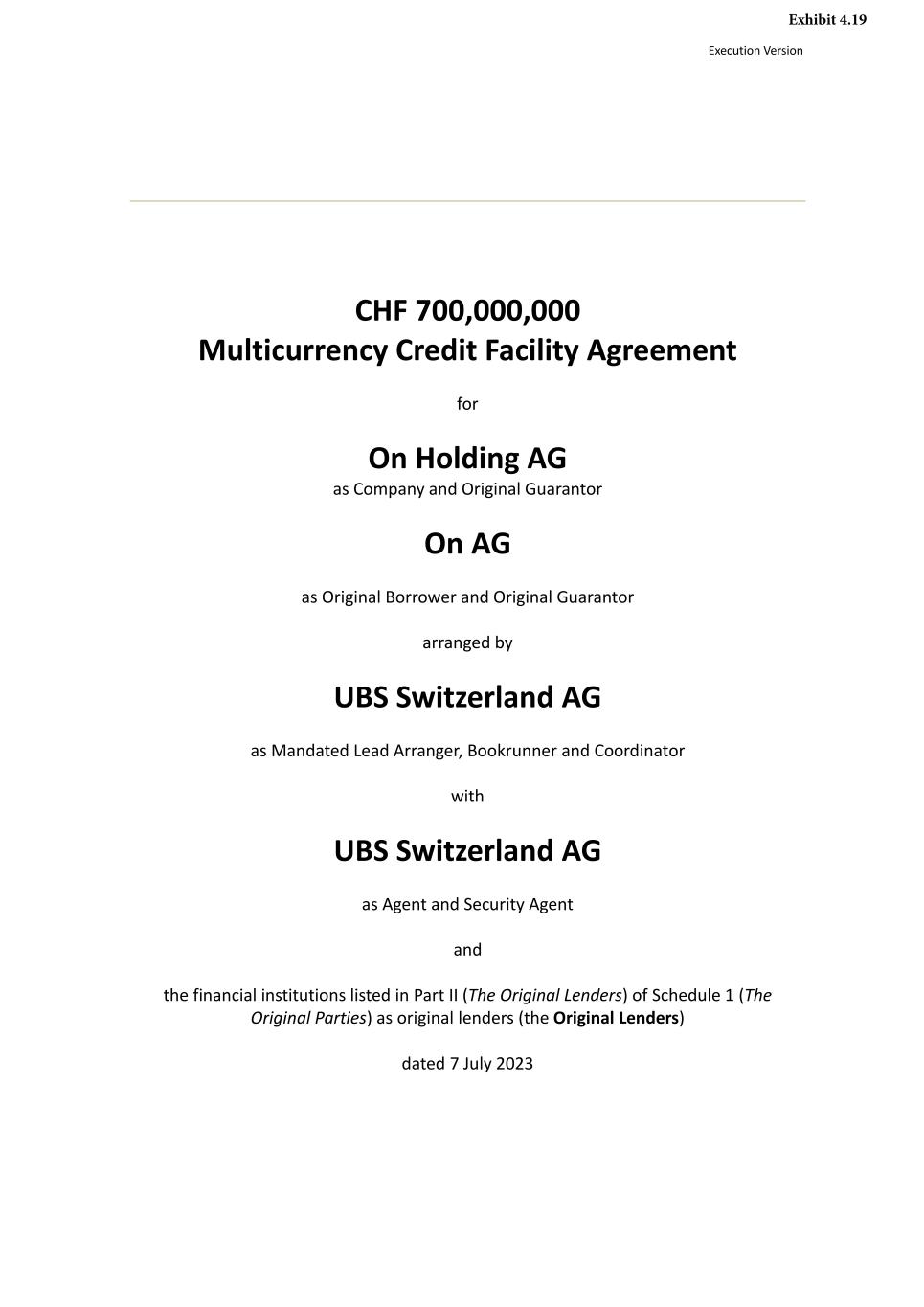
Execution Version CHF 700,000,000 Multicurrency Credit Facility Agreement for On Holding AG as Company and Original Guarantor On AG as Original Borrower and Original Guarantor arranged by UBS Switzerland AG as Mandated Lead Arranger, Bookrunner and Coordinator with UBS Switzerland AG as Agent and Security Agent and the financial institutions listed in Part II (The Original Lenders) of Schedule 1 (The Original Parties) as original lenders (the Original Lenders) dated 7 July 2023 Exhibit 4.19
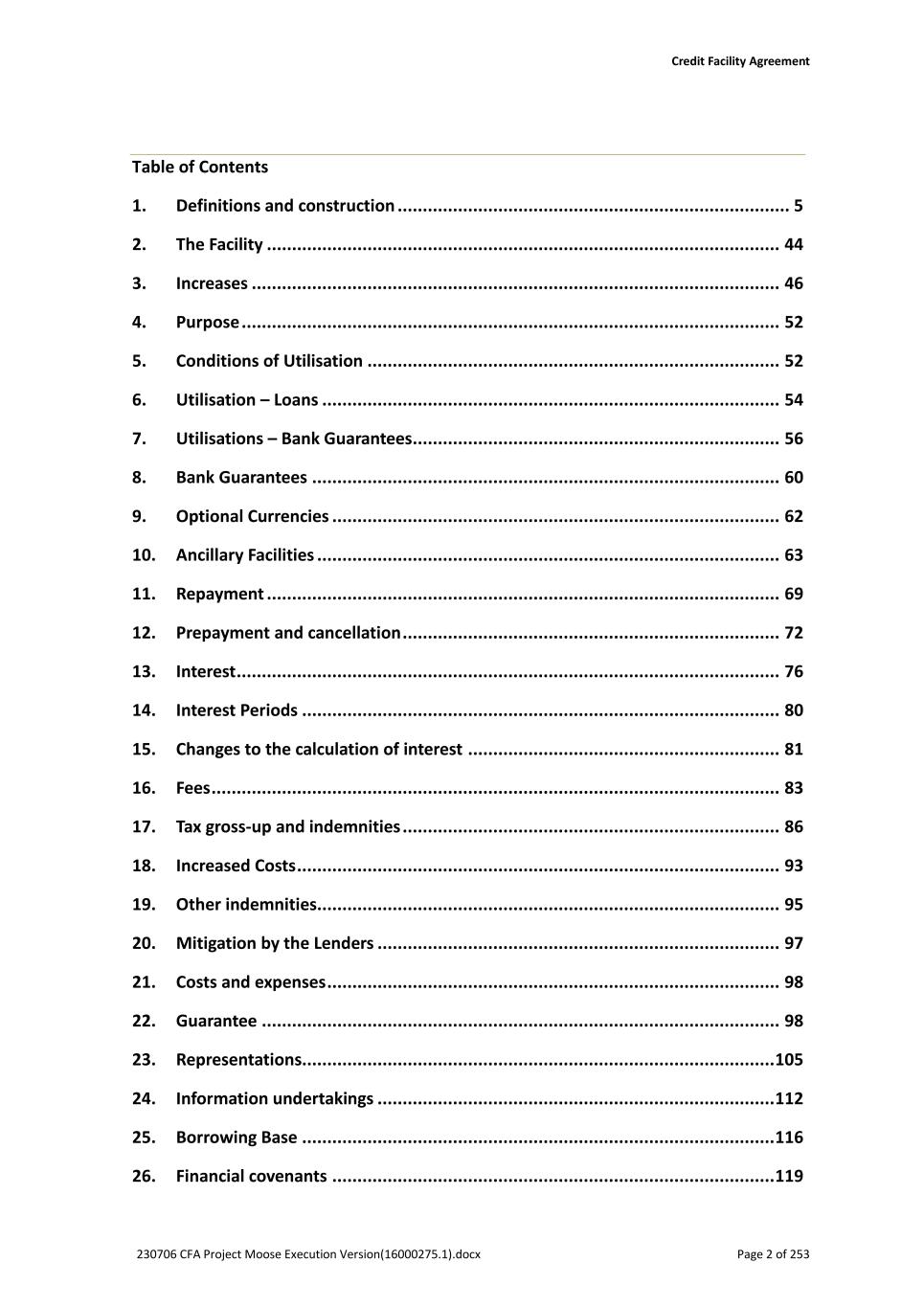
Credit Facility Agreement 230706 CFA Project Moose Execution Version(16000275.1).docx Page 2 of 253 Table of Contents 1. Definitions and construction .............................................................................. 5 2. The Facility ...................................................................................................... 44 3. Increases ......................................................................................................... 46 4. Purpose ........................................................................................................... 52 5. Conditions of Utilisation .................................................................................. 52 6. Utilisation – Loans ........................................................................................... 54 7. Utilisations – Bank Guarantees......................................................................... 56 8. Bank Guarantees ............................................................................................. 60 9. Optional Currencies ......................................................................................... 62 10. Ancillary Facilities ............................................................................................ 63 11. Repayment ...................................................................................................... 69 12. Prepayment and cancellation ........................................................................... 72 13. Interest ............................................................................................................ 76 14. Interest Periods ............................................................................................... 80 15. Changes to the calculation of interest .............................................................. 81 16. Fees ................................................................................................................. 83 17. Tax gross-up and indemnities ........................................................................... 86 18. Increased Costs ................................................................................................ 93 19. Other indemnities............................................................................................ 95 20. Mitigation by the Lenders ................................................................................ 97 21. Costs and expenses .......................................................................................... 98 22. Guarantee ....................................................................................................... 98 23. Representations.............................................................................................. 105 24. Information undertakings ............................................................................... 112 25. Borrowing Base .............................................................................................. 116 26. Financial covenants ........................................................................................ 119
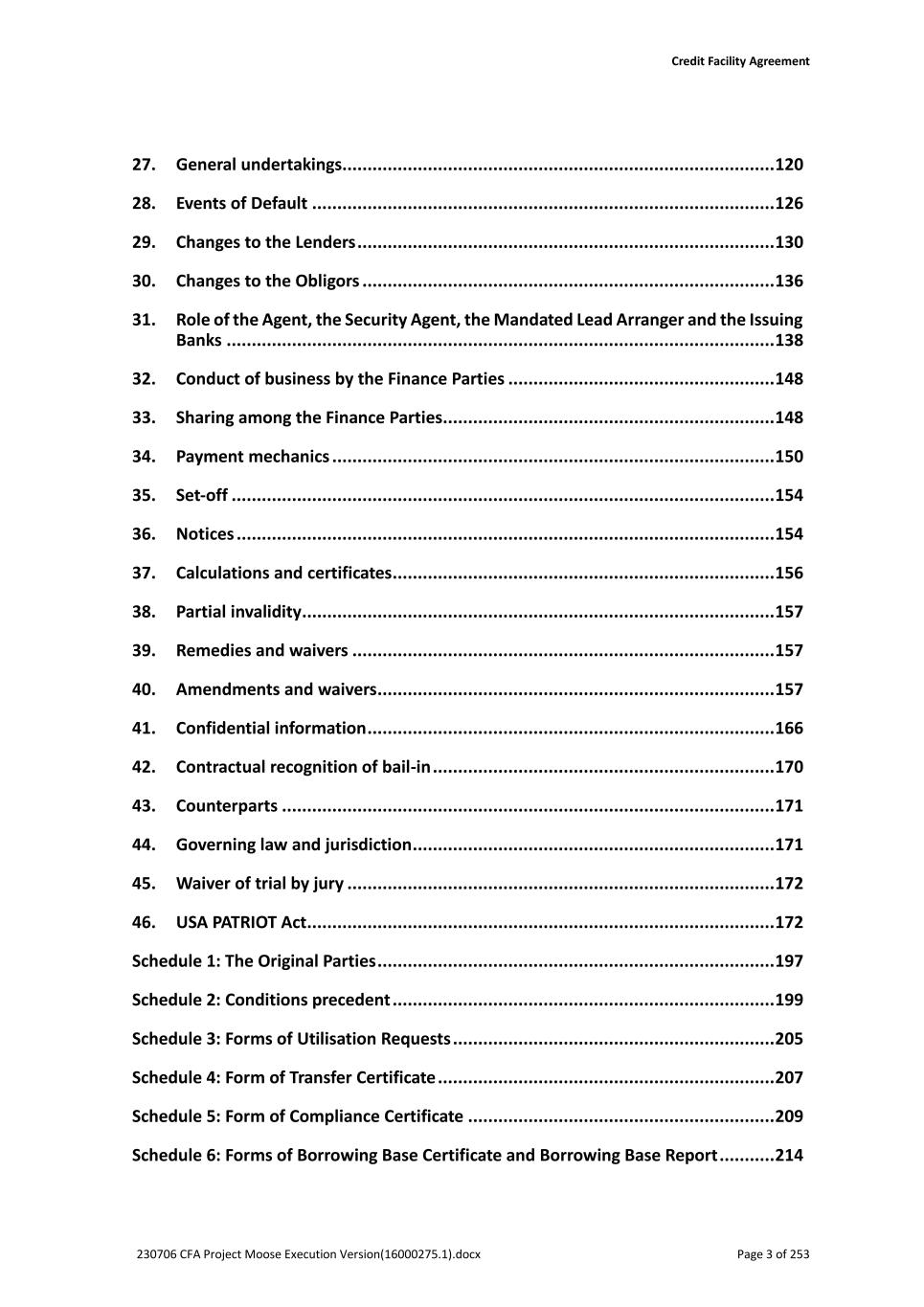
Credit Facility Agreement 230706 CFA Project Moose Execution Version(16000275.1).docx Page 3 of 253 27. General undertakings...................................................................................... 120 28. Events of Default ............................................................................................ 126 29. Changes to the Lenders ................................................................................... 130 30. Changes to the Obligors .................................................................................. 136 31. Role of the Agent, the Security Agent, the Mandated Lead Arranger and the Issuing Banks ............................................................................................................. 138 32. Conduct of business by the Finance Parties ..................................................... 148 33. Sharing among the Finance Parties.................................................................. 148 34. Payment mechanics ........................................................................................ 150 35. Set-off ............................................................................................................ 154 36. Notices ........................................................................................................... 154 37. Calculations and certificates ............................................................................ 156 38. Partial invalidity .............................................................................................. 157 39. Remedies and waivers .................................................................................... 157 40. Amendments and waivers ............................................................................... 157 41. Confidential information ................................................................................. 166 42. Contractual recognition of bail-in .................................................................... 170 43. Counterparts .................................................................................................. 171 44. Governing law and jurisdiction ........................................................................ 171 45. Waiver of trial by jury ..................................................................................... 172 46. USA PATRIOT Act ............................................................................................. 172 Schedule 1: The Original Parties ............................................................................... 197 Schedule 2: Conditions precedent ............................................................................ 199 Schedule 3: Forms of Utilisation Requests ................................................................ 205 Schedule 4: Form of Transfer Certificate ................................................................... 207 Schedule 5: Form of Compliance Certificate ............................................................. 209 Schedule 6: Forms of Borrowing Base Certificate and Borrowing Base Report ........... 214
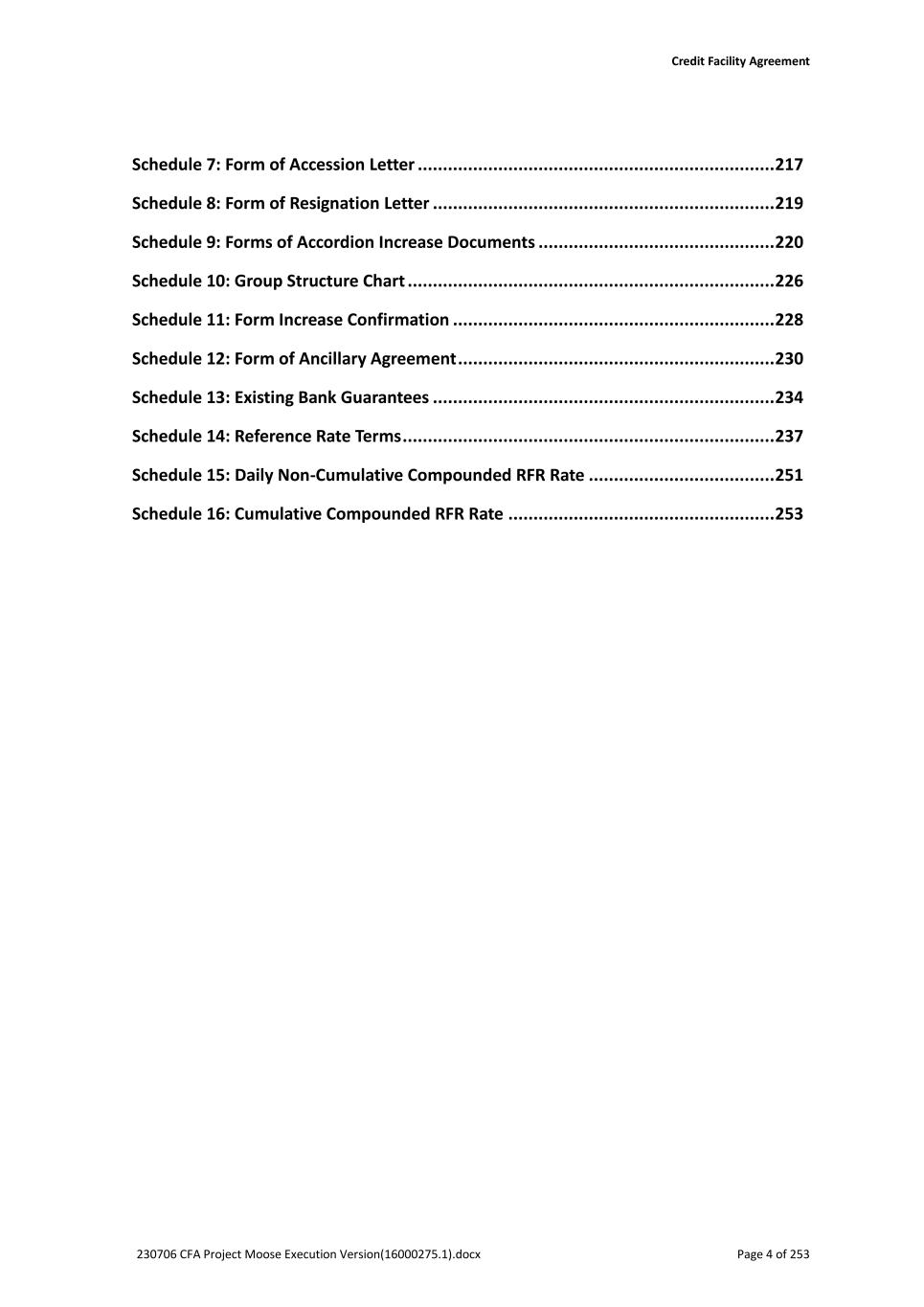
Credit Facility Agreement 230706 CFA Project Moose Execution Version(16000275.1).docx Page 4 of 253 Schedule 7: Form of Accession Letter ....................................................................... 217 Schedule 8: Form of Resignation Letter .................................................................... 219 Schedule 9: Forms of Accordion Increase Documents ............................................... 220 Schedule 10: Group Structure Chart ......................................................................... 226 Schedule 11: Form Increase Confirmation ................................................................ 228 Schedule 12: Form of Ancillary Agreement ............................................................... 230 Schedule 13: Existing Bank Guarantees .................................................................... 234 Schedule 14: Reference Rate Terms .......................................................................... 237 Schedule 15: Daily Non-Cumulative Compounded RFR Rate ..................................... 251 Schedule 16: Cumulative Compounded RFR Rate ..................................................... 253
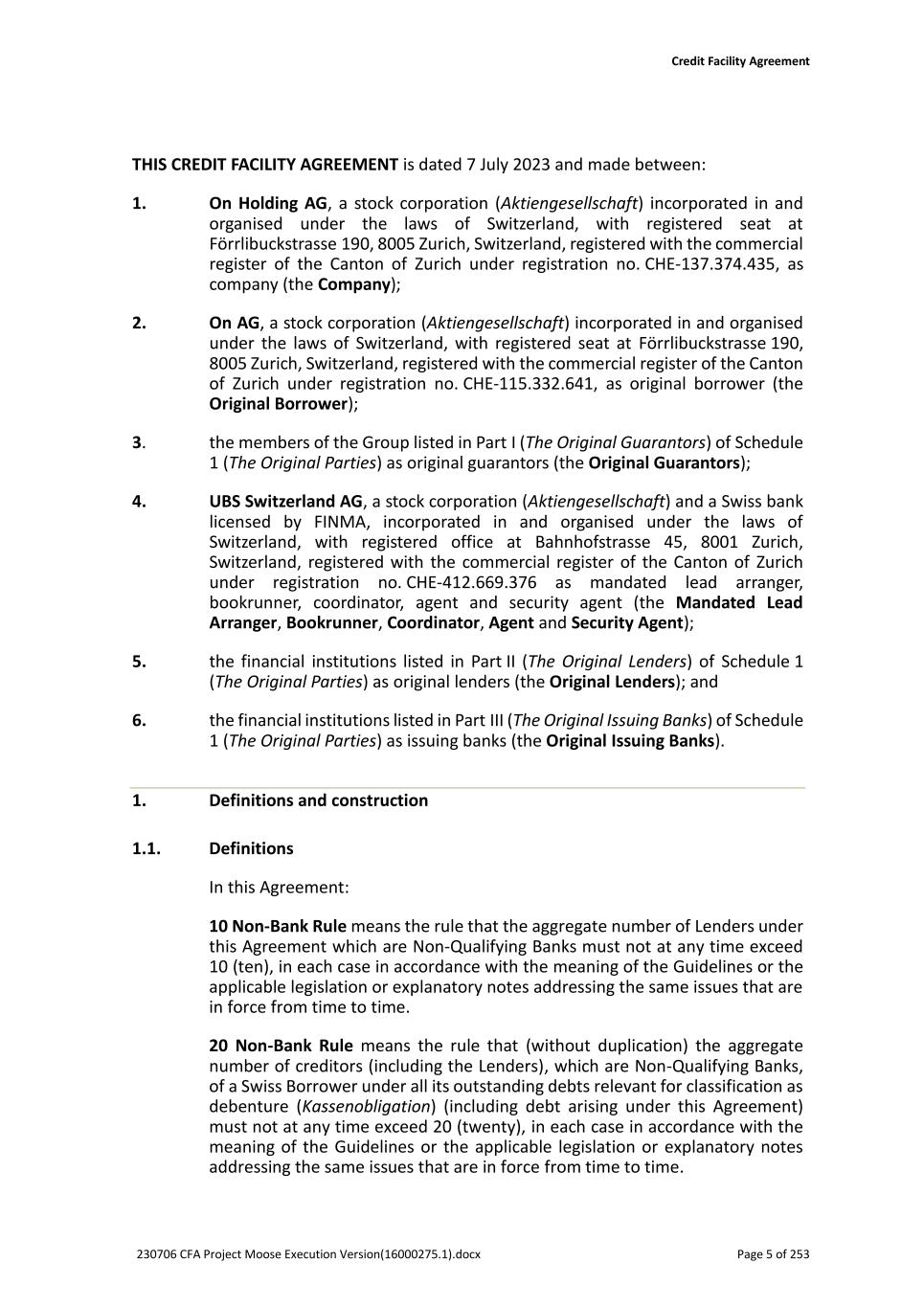
Credit Facility Agreement 230706 CFA Project Moose Execution Version(16000275.1).docx Page 5 of 253 THIS CREDIT FACILITY AGREEMENT is dated 7 July 2023 and made between: 1. On Holding AG, a stock corporation (Aktiengesellschaft) incorporated in and organised under the laws of Switzerland, with registered seat at Förrlibuckstrasse 190, 8005 Zurich, Switzerland, registered with the commercial register of the Canton of Zurich under registration no. CHE-137.374.435, as company (the Company); 2. On AG, a stock corporation (Aktiengesellschaft) incorporated in and organised under the laws of Switzerland, with registered seat at Förrlibuckstrasse 190, 8005 Zurich, Switzerland, registered with the commercial register of the Canton of Zurich under registration no. CHE-115.332.641, as original borrower (the Original Borrower); 3. the members of the Group listed in Part I (The Original Guarantors) of Schedule 1 (The Original Parties) as original guarantors (the Original Guarantors); 4. UBS Switzerland AG, a stock corporation (Aktiengesellschaft) and a Swiss bank licensed by FINMA, incorporated in and organised under the laws of Switzerland, with registered office at Bahnhofstrasse 45, 8001 Zurich, Switzerland, registered with the commercial register of the Canton of Zurich under registration no. CHE-412.669.376 as mandated lead arranger, bookrunner, coordinator, agent and security agent (the Mandated Lead Arranger, Bookrunner, Coordinator, Agent and Security Agent); 5. the financial institutions listed in Part II (The Original Lenders) of Schedule 1 (The Original Parties) as original lenders (the Original Lenders); and 6. the financial institutions listed in Part III (The Original Issuing Banks) of Schedule 1 (The Original Parties) as issuing banks (the Original Issuing Banks). 1. Definitions and construction 1.1. Definitions In this Agreement: 10 Non-Bank Rule means the rule that the aggregate number of Lenders under this Agreement which are Non-Qualifying Banks must not at any time exceed 10 (ten), in each case in accordance with the meaning of the Guidelines or the applicable legislation or explanatory notes addressing the same issues that are in force from time to time. 20 Non-Bank Rule means the rule that (without duplication) the aggregate number of creditors (including the Lenders), which are Non-Qualifying Banks, of a Swiss Borrower under all its outstanding debts relevant for classification as debenture (Kassenobligation) (including debt arising under this Agreement) must not at any time exceed 20 (twenty), in each case in accordance with the meaning of the Guidelines or the applicable legislation or explanatory notes addressing the same issues that are in force from time to time.
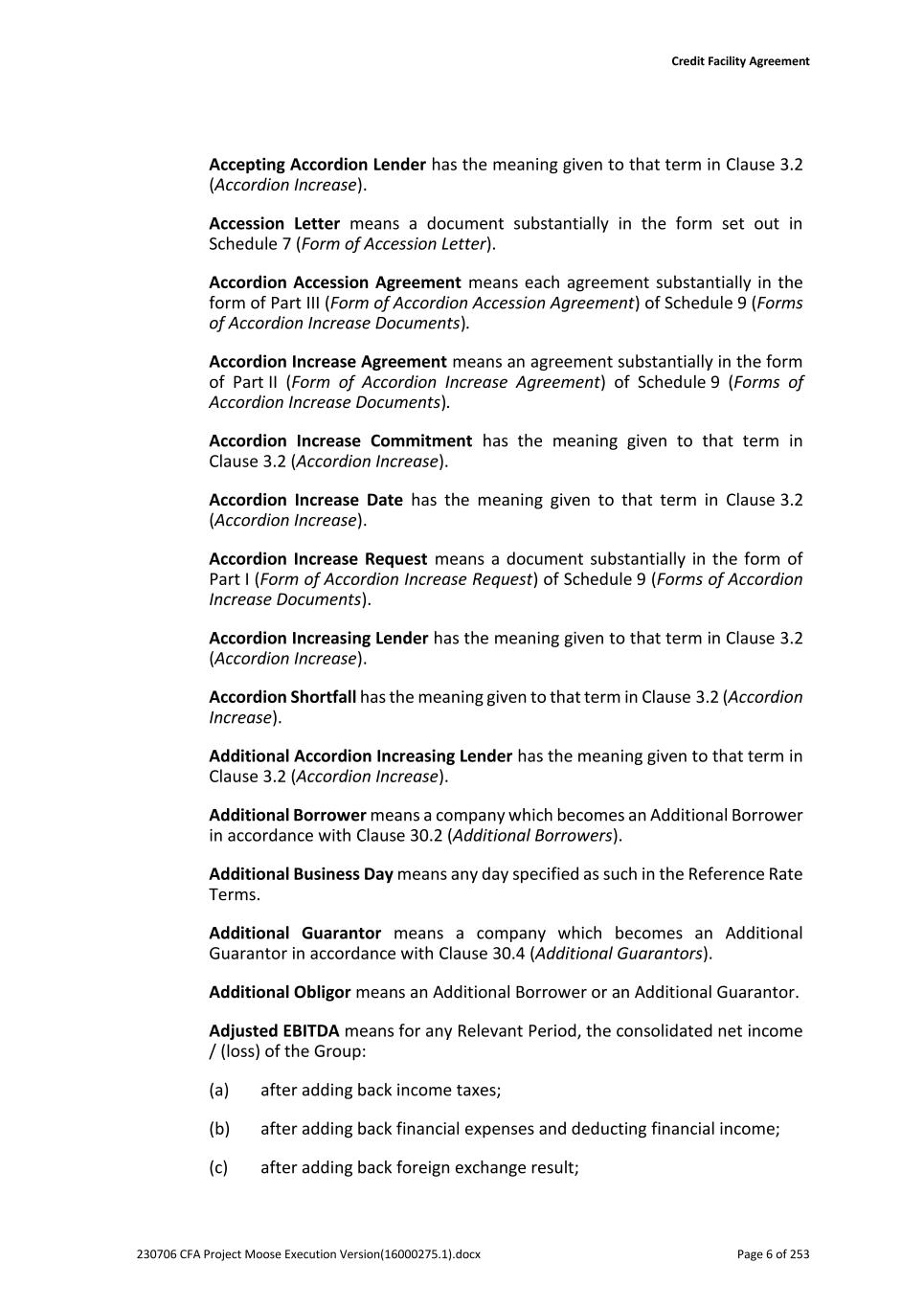
Credit Facility Agreement 230706 CFA Project Moose Execution Version(16000275.1).docx Page 6 of 253 Accepting Accordion Lender has the meaning given to that term in Clause 3.2 (Accordion Increase). Accession Letter means a document substantially in the form set out in Schedule 7 (Form of Accession Letter). Accordion Accession Agreement means each agreement substantially in the form of Part III (Form of Accordion Accession Agreement) of Schedule 9 (Forms of Accordion Increase Documents). Accordion Increase Agreement means an agreement substantially in the form of Part II (Form of Accordion Increase Agreement) of Schedule 9 (Forms of Accordion Increase Documents). Accordion Increase Commitment has the meaning given to that term in Clause 3.2 (Accordion Increase). Accordion Increase Date has the meaning given to that term in Clause 3.2 (Accordion Increase). Accordion Increase Request means a document substantially in the form of Part I (Form of Accordion Increase Request) of Schedule 9 (Forms of Accordion Increase Documents). Accordion Increasing Lender has the meaning given to that term in Clause 3.2 (Accordion Increase). Accordion Shortfall has the meaning given to that term in Clause 3.2 (Accordion Increase). Additional Accordion Increasing Lender has the meaning given to that term in Clause 3.2 (Accordion Increase). Additional Borrower means a company which becomes an Additional Borrower in accordance with Clause 30.2 (Additional Borrowers). Additional Business Day means any day specified as such in the Reference Rate Terms. Additional Guarantor means a company which becomes an Additional Guarantor in accordance with Clause 30.4 (Additional Guarantors). Additional Obligor means an Additional Borrower or an Additional Guarantor. Adjusted EBITDA means for any Relevant Period, the consolidated net income / (loss) of the Group: (a) after adding back income taxes; (b) after adding back financial expenses and deducting financial income; (c) after adding back foreign exchange result;
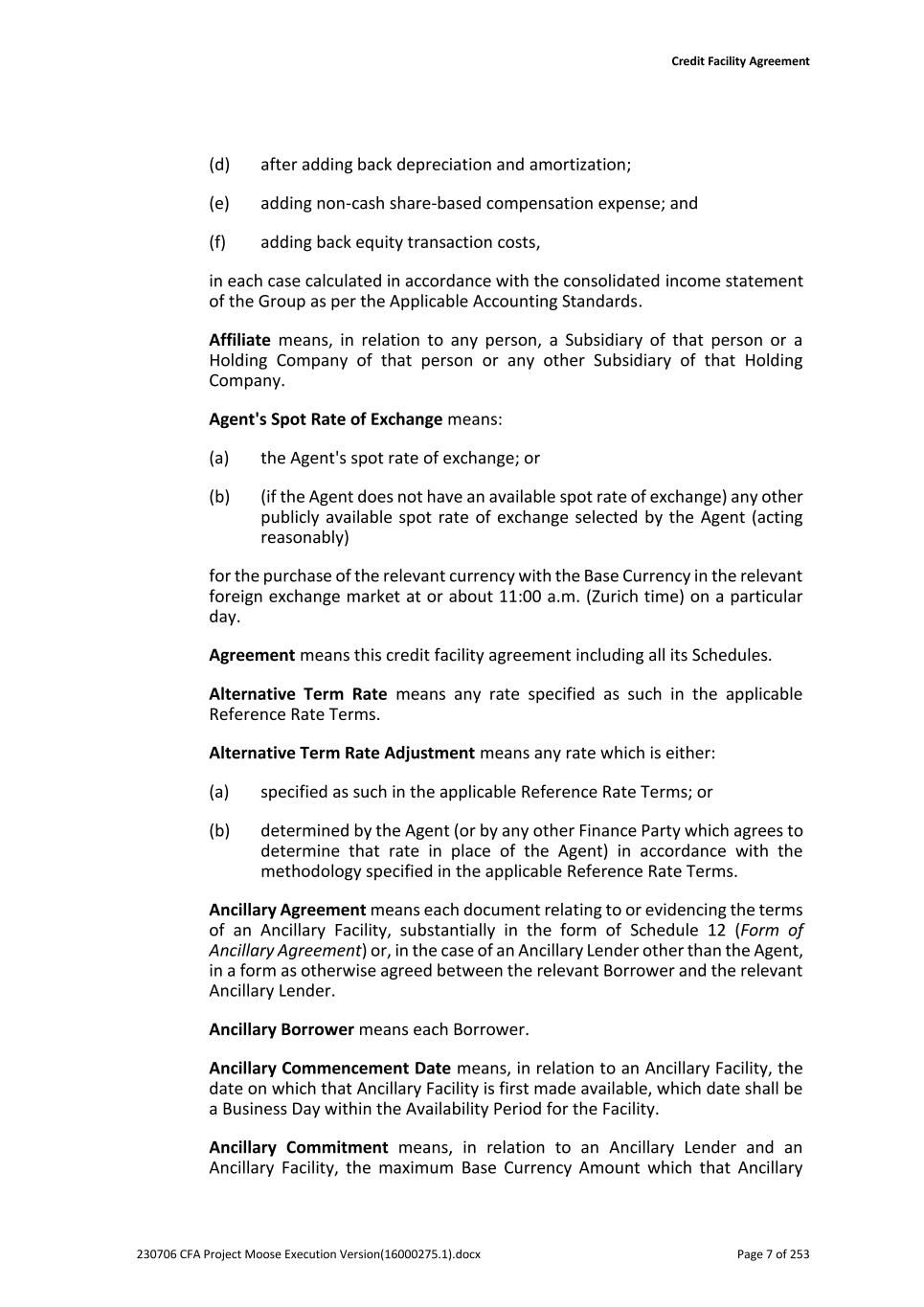
Credit Facility Agreement 230706 CFA Project Moose Execution Version(16000275.1).docx Page 7 of 253 (d) after adding back depreciation and amortization; (e) adding non-cash share-based compensation expense; and (f) adding back equity transaction costs, in each case calculated in accordance with the consolidated income statement of the Group as per the Applicable Accounting Standards. Affiliate means, in relation to any person, a Subsidiary of that person or a Holding Company of that person or any other Subsidiary of that Holding Company. Agent's Spot Rate of Exchange means: (a) the Agent's spot rate of exchange; or (b) (if the Agent does not have an available spot rate of exchange) any other publicly available spot rate of exchange selected by the Agent (acting reasonably) for the purchase of the relevant currency with the Base Currency in the relevant foreign exchange market at or about 11:00 a.m. (Zurich time) on a particular day. Agreement means this credit facility agreement including all its Schedules. Alternative Term Rate means any rate specified as such in the applicable Reference Rate Terms. Alternative Term Rate Adjustment means any rate which is either: (a) specified as such in the applicable Reference Rate Terms; or (b) determined by the Agent (or by any other Finance Party which agrees to determine that rate in place of the Agent) in accordance with the methodology specified in the applicable Reference Rate Terms. Ancillary Agreement means each document relating to or evidencing the terms of an Ancillary Facility, substantially in the form of Schedule 12 (Form of Ancillary Agreement) or, in the case of an Ancillary Lender other than the Agent, in a form as otherwise agreed between the relevant Borrower and the relevant Ancillary Lender. Ancillary Borrower means each Borrower. Ancillary Commencement Date means, in relation to an Ancillary Facility, the date on which that Ancillary Facility is first made available, which date shall be a Business Day within the Availability Period for the Facility. Ancillary Commitment means, in relation to an Ancillary Lender and an Ancillary Facility, the maximum Base Currency Amount which that Ancillary
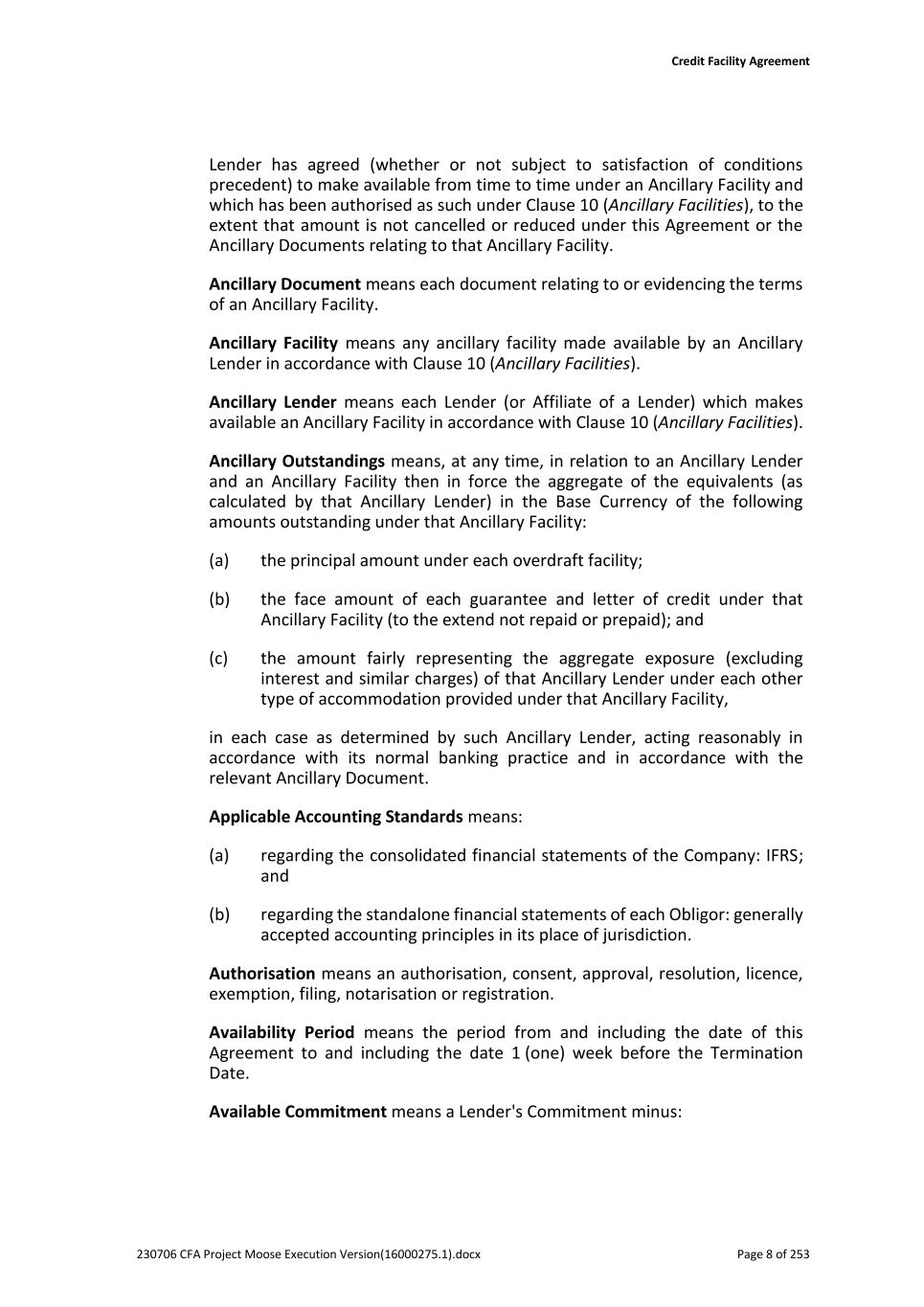
Credit Facility Agreement 230706 CFA Project Moose Execution Version(16000275.1).docx Page 8 of 253 Lender has agreed (whether or not subject to satisfaction of conditions precedent) to make available from time to time under an Ancillary Facility and which has been authorised as such under Clause 10 (Ancillary Facilities), to the extent that amount is not cancelled or reduced under this Agreement or the Ancillary Documents relating to that Ancillary Facility. Ancillary Document means each document relating to or evidencing the terms of an Ancillary Facility. Ancillary Facility means any ancillary facility made available by an Ancillary Lender in accordance with Clause 10 (Ancillary Facilities). Ancillary Lender means each Lender (or Affiliate of a Lender) which makes available an Ancillary Facility in accordance with Clause 10 (Ancillary Facilities). Ancillary Outstandings means, at any time, in relation to an Ancillary Lender and an Ancillary Facility then in force the aggregate of the equivalents (as calculated by that Ancillary Lender) in the Base Currency of the following amounts outstanding under that Ancillary Facility: (a) the principal amount under each overdraft facility; (b) the face amount of each guarantee and letter of credit under that Ancillary Facility (to the extend not repaid or prepaid); and (c) the amount fairly representing the aggregate exposure (excluding interest and similar charges) of that Ancillary Lender under each other type of accommodation provided under that Ancillary Facility, in each case as determined by such Ancillary Lender, acting reasonably in accordance with its normal banking practice and in accordance with the relevant Ancillary Document. Applicable Accounting Standards means: (a) regarding the consolidated financial statements of the Company: IFRS; and (b) regarding the standalone financial statements of each Obligor: generally accepted accounting principles in its place of jurisdiction. Authorisation means an authorisation, consent, approval, resolution, licence, exemption, filing, notarisation or registration. Availability Period means the period from and including the date of this Agreement to and including the date 1 (one) week before the Termination Date. Available Commitment means a Lender's Commitment minus:
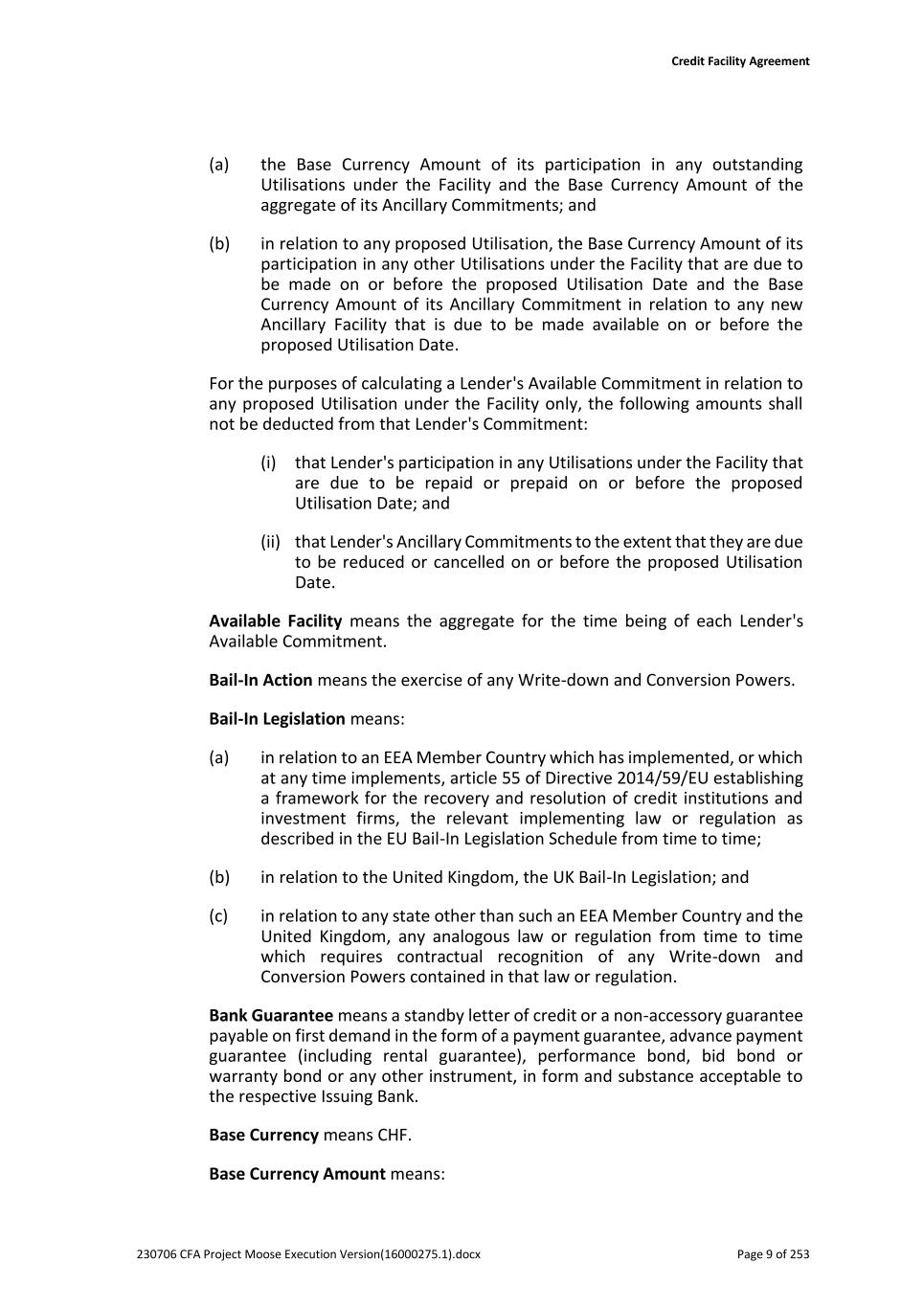
Credit Facility Agreement 230706 CFA Project Moose Execution Version(16000275.1).docx Page 9 of 253 (a) the Base Currency Amount of its participation in any outstanding Utilisations under the Facility and the Base Currency Amount of the aggregate of its Ancillary Commitments; and (b) in relation to any proposed Utilisation, the Base Currency Amount of its participation in any other Utilisations under the Facility that are due to be made on or before the proposed Utilisation Date and the Base Currency Amount of its Ancillary Commitment in relation to any new Ancillary Facility that is due to be made available on or before the proposed Utilisation Date. For the purposes of calculating a Lender's Available Commitment in relation to any proposed Utilisation under the Facility only, the following amounts shall not be deducted from that Lender's Commitment: (i) that Lender's participation in any Utilisations under the Facility that are due to be repaid or prepaid on or before the proposed Utilisation Date; and (ii) that Lender's Ancillary Commitments to the extent that they are due to be reduced or cancelled on or before the proposed Utilisation Date. Available Facility means the aggregate for the time being of each Lender's Available Commitment. Bail-In Action means the exercise of any Write-down and Conversion Powers. Bail-In Legislation means: (a) in relation to an EEA Member Country which has implemented, or which at any time implements, article 55 of Directive 2014/59/EU establishing a framework for the recovery and resolution of credit institutions and investment firms, the relevant implementing law or regulation as described in the EU Bail-In Legislation Schedule from time to time; (b) in relation to the United Kingdom, the UK Bail-In Legislation; and (c) in relation to any state other than such an EEA Member Country and the United Kingdom, any analogous law or regulation from time to time which requires contractual recognition of any Write-down and Conversion Powers contained in that law or regulation. Bank Guarantee means a standby letter of credit or a non-accessory guarantee payable on first demand in the form of a payment guarantee, advance payment guarantee (including rental guarantee), performance bond, bid bond or warranty bond or any other instrument, in form and substance acceptable to the respective Issuing Bank. Base Currency means CHF. Base Currency Amount means:
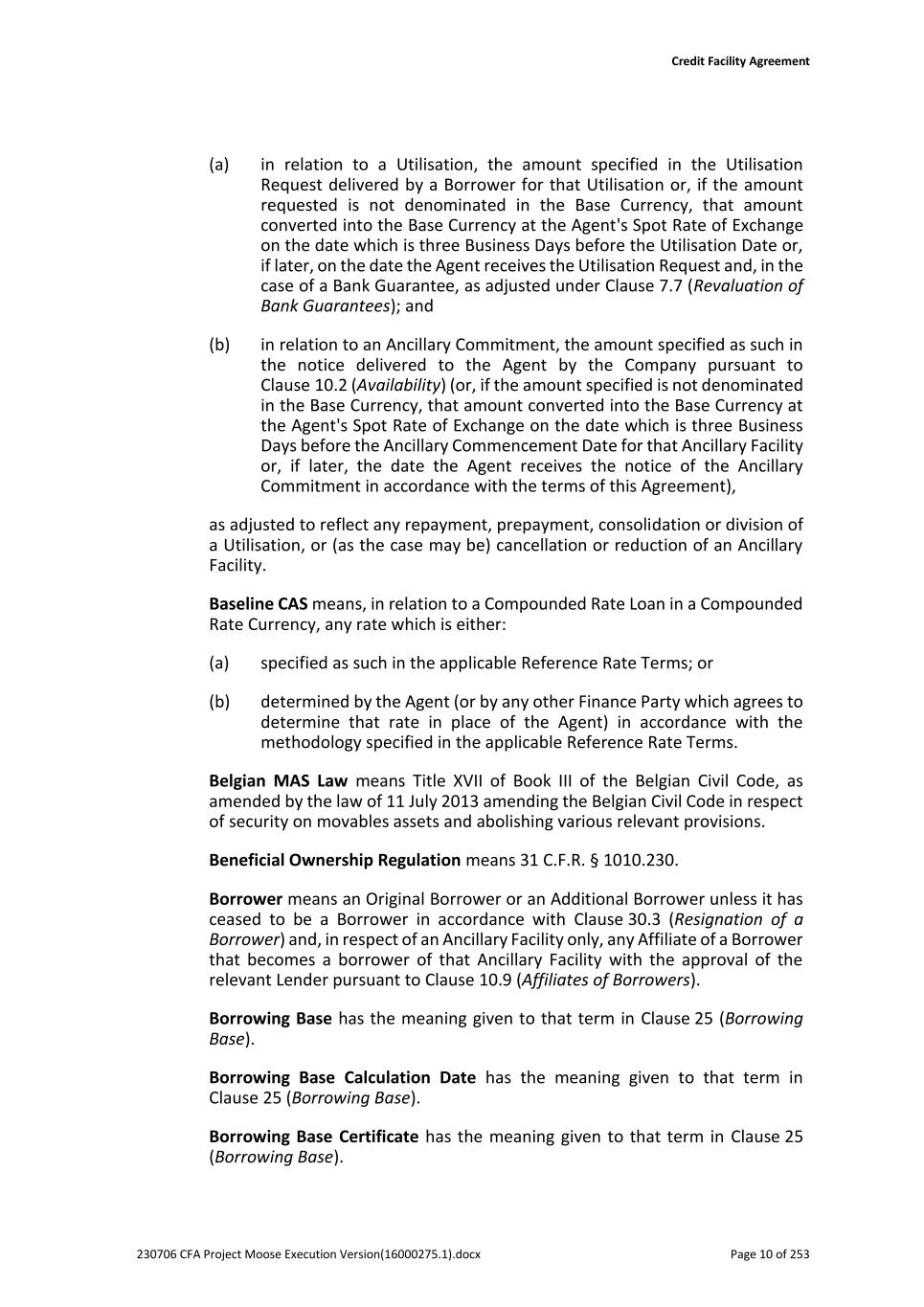
Credit Facility Agreement 230706 CFA Project Moose Execution Version(16000275.1).docx Page 10 of 253 (a) in relation to a Utilisation, the amount specified in the Utilisation Request delivered by a Borrower for that Utilisation or, if the amount requested is not denominated in the Base Currency, that amount converted into the Base Currency at the Agent's Spot Rate of Exchange on the date which is three Business Days before the Utilisation Date or, if later, on the date the Agent receives the Utilisation Request and, in the case of a Bank Guarantee, as adjusted under Clause 7.7 (Revaluation of Bank Guarantees); and (b) in relation to an Ancillary Commitment, the amount specified as such in the notice delivered to the Agent by the Company pursuant to Clause 10.2 (Availability) (or, if the amount specified is not denominated in the Base Currency, that amount converted into the Base Currency at the Agent's Spot Rate of Exchange on the date which is three Business Days before the Ancillary Commencement Date for that Ancillary Facility or, if later, the date the Agent receives the notice of the Ancillary Commitment in accordance with the terms of this Agreement), as adjusted to reflect any repayment, prepayment, consolidation or division of a Utilisation, or (as the case may be) cancellation or reduction of an Ancillary Facility. Baseline CAS means, in relation to a Compounded Rate Loan in a Compounded Rate Currency, any rate which is either: (a) specified as such in the applicable Reference Rate Terms; or (b) determined by the Agent (or by any other Finance Party which agrees to determine that rate in place of the Agent) in accordance with the methodology specified in the applicable Reference Rate Terms. Belgian MAS Law means Title XVII of Book III of the Belgian Civil Code, as amended by the law of 11 July 2013 amending the Belgian Civil Code in respect of security on movables assets and abolishing various relevant provisions. Beneficial Ownership Regulation means 31 C.F.R. § 1010.230. Borrower means an Original Borrower or an Additional Borrower unless it has ceased to be a Borrower in accordance with Clause 30.3 (Resignation of a Borrower) and, in respect of an Ancillary Facility only, any Affiliate of a Borrower that becomes a borrower of that Ancillary Facility with the approval of the relevant Lender pursuant to Clause 10.9 (Affiliates of Borrowers). Borrowing Base has the meaning given to that term in Clause 25 (Borrowing Base). Borrowing Base Calculation Date has the meaning given to that term in Clause 25 (Borrowing Base). Borrowing Base Certificate has the meaning given to that term in Clause 25 (Borrowing Base).
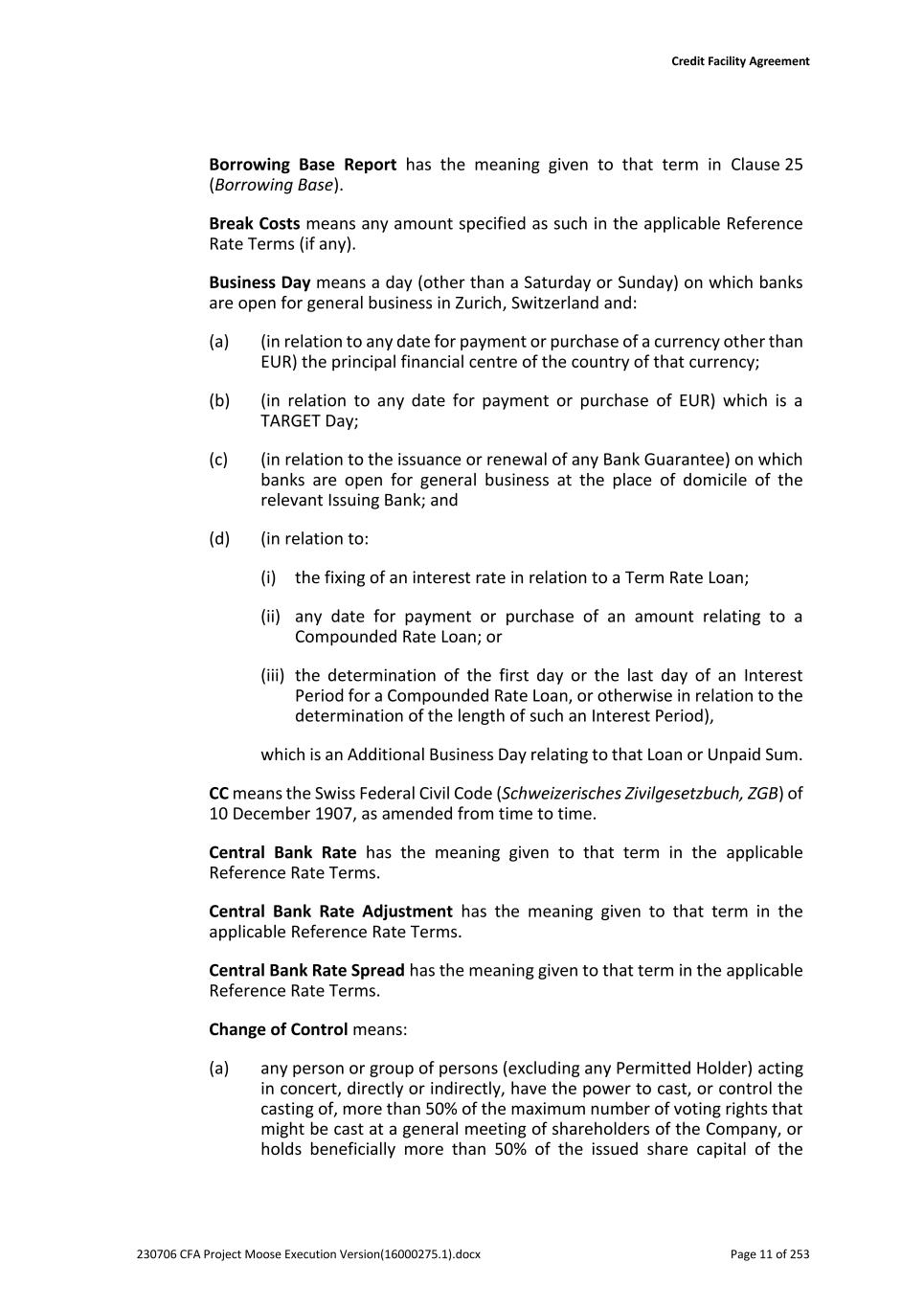
Credit Facility Agreement 230706 CFA Project Moose Execution Version(16000275.1).docx Page 11 of 253 Borrowing Base Report has the meaning given to that term in Clause 25 (Borrowing Base). Break Costs means any amount specified as such in the applicable Reference Rate Terms (if any). Business Day means a day (other than a Saturday or Sunday) on which banks are open for general business in Zurich, Switzerland and: (a) (in relation to any date for payment or purchase of a currency other than EUR) the principal financial centre of the country of that currency; (b) (in relation to any date for payment or purchase of EUR) which is a TARGET Day; (c) (in relation to the issuance or renewal of any Bank Guarantee) on which banks are open for general business at the place of domicile of the relevant Issuing Bank; and (d) (in relation to: (i) the fixing of an interest rate in relation to a Term Rate Loan; (ii) any date for payment or purchase of an amount relating to a Compounded Rate Loan; or (iii) the determination of the first day or the last day of an Interest Period for a Compounded Rate Loan, or otherwise in relation to the determination of the length of such an Interest Period), which is an Additional Business Day relating to that Loan or Unpaid Sum. CC means the Swiss Federal Civil Code (Schweizerisches Zivilgesetzbuch, ZGB) of 10 December 1907, as amended from time to time. Central Bank Rate has the meaning given to that term in the applicable Reference Rate Terms. Central Bank Rate Adjustment has the meaning given to that term in the applicable Reference Rate Terms. Central Bank Rate Spread has the meaning given to that term in the applicable Reference Rate Terms. Change of Control means: (a) any person or group of persons (excluding any Permitted Holder) acting in concert, directly or indirectly, have the power to cast, or control the casting of, more than 50% of the maximum number of voting rights that might be cast at a general meeting of shareholders of the Company, or holds beneficially more than 50% of the issued share capital of the
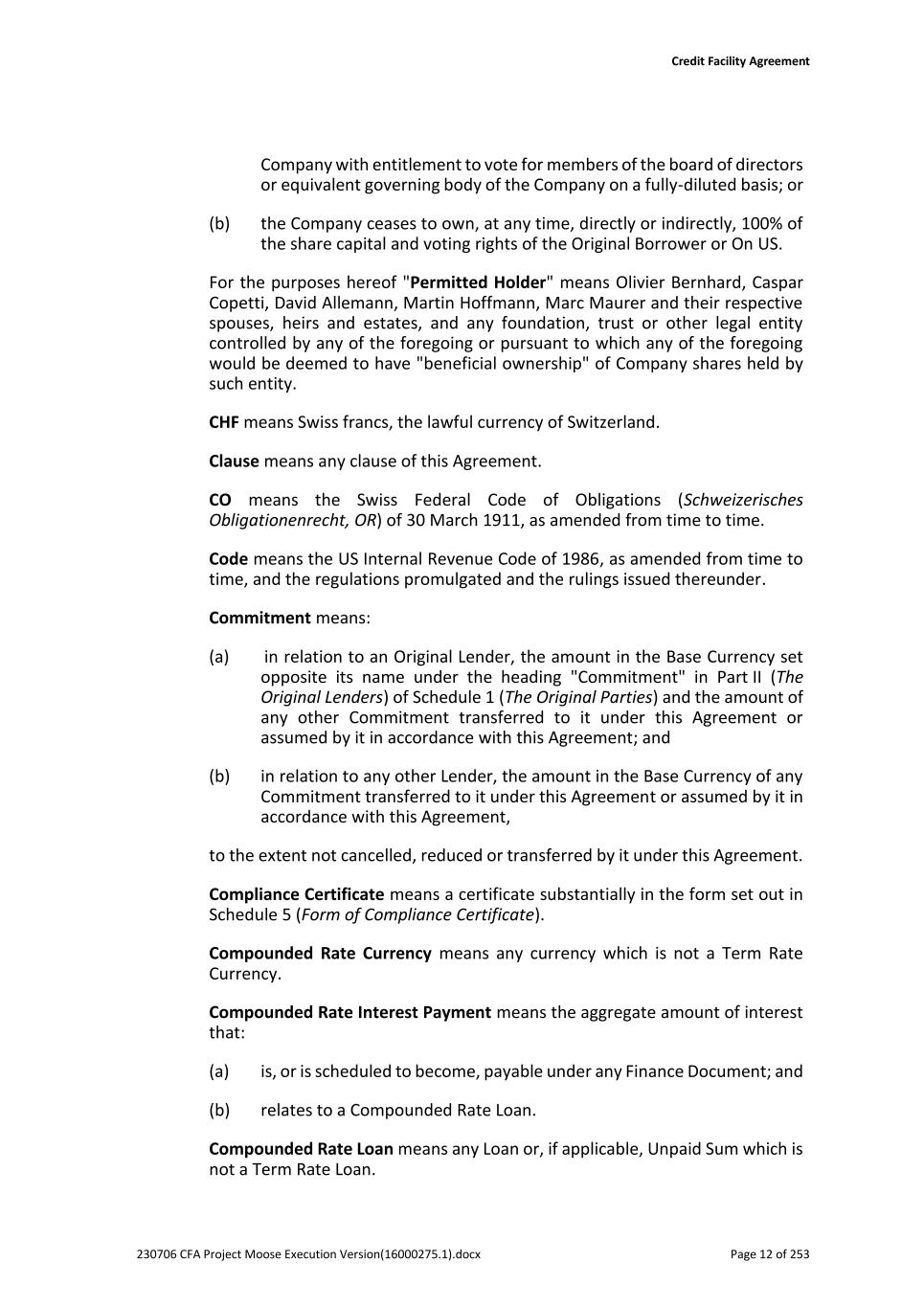
Credit Facility Agreement 230706 CFA Project Moose Execution Version(16000275.1).docx Page 12 of 253 Company with entitlement to vote for members of the board of directors or equivalent governing body of the Company on a fully-diluted basis; or (b) the Company ceases to own, at any time, directly or indirectly, 100% of the share capital and voting rights of the Original Borrower or On US. For the purposes hereof "Permitted Holder" means Olivier Bernhard, Caspar Copetti, David Allemann, Martin Hoffmann, Marc Maurer and their respective spouses, heirs and estates, and any foundation, trust or other legal entity controlled by any of the foregoing or pursuant to which any of the foregoing would be deemed to have "beneficial ownership" of Company shares held by such entity. CHF means Swiss francs, the lawful currency of Switzerland. Clause means any clause of this Agreement. CO means the Swiss Federal Code of Obligations (Schweizerisches Obligationenrecht, OR) of 30 March 1911, as amended from time to time. Code means the US Internal Revenue Code of 1986, as amended from time to time, and the regulations promulgated and the rulings issued thereunder. Commitment means: (a) in relation to an Original Lender, the amount in the Base Currency set opposite its name under the heading "Commitment" in Part II (The Original Lenders) of Schedule 1 (The Original Parties) and the amount of any other Commitment transferred to it under this Agreement or assumed by it in accordance with this Agreement; and (b) in relation to any other Lender, the amount in the Base Currency of any Commitment transferred to it under this Agreement or assumed by it in accordance with this Agreement, to the extent not cancelled, reduced or transferred by it under this Agreement. Compliance Certificate means a certificate substantially in the form set out in Schedule 5 (Form of Compliance Certificate). Compounded Rate Currency means any currency which is not a Term Rate Currency. Compounded Rate Interest Payment means the aggregate amount of interest that: (a) is, or is scheduled to become, payable under any Finance Document; and (b) relates to a Compounded Rate Loan. Compounded Rate Loan means any Loan or, if applicable, Unpaid Sum which is not a Term Rate Loan.
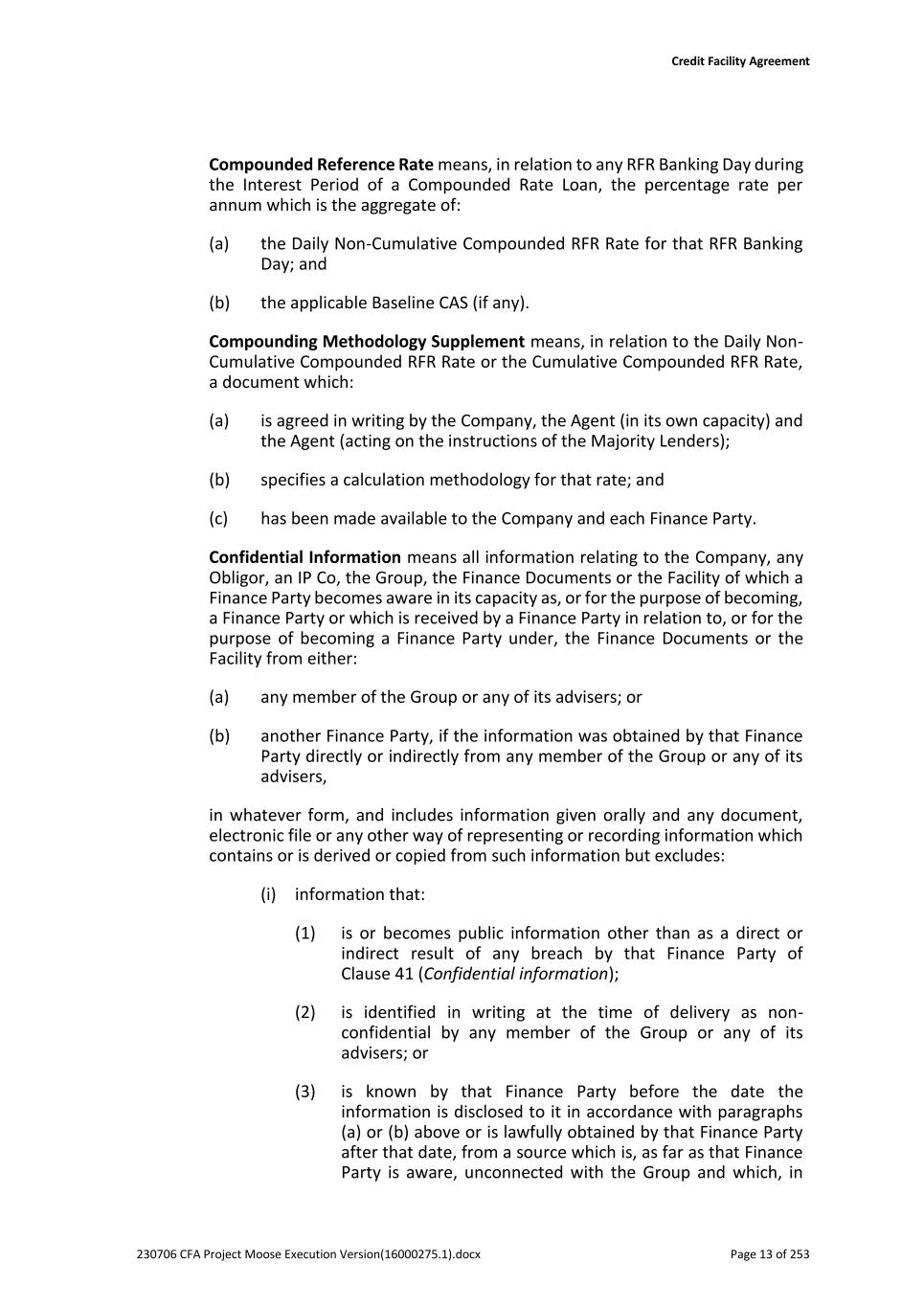
Credit Facility Agreement 230706 CFA Project Moose Execution Version(16000275.1).docx Page 13 of 253 Compounded Reference Rate means, in relation to any RFR Banking Day during the Interest Period of a Compounded Rate Loan, the percentage rate per annum which is the aggregate of: (a) the Daily Non-Cumulative Compounded RFR Rate for that RFR Banking Day; and (b) the applicable Baseline CAS (if any). Compounding Methodology Supplement means, in relation to the Daily Non- Cumulative Compounded RFR Rate or the Cumulative Compounded RFR Rate, a document which: (a) is agreed in writing by the Company, the Agent (in its own capacity) and the Agent (acting on the instructions of the Majority Lenders); (b) specifies a calculation methodology for that rate; and (c) has been made available to the Company and each Finance Party. Confidential Information means all information relating to the Company, any Obligor, an IP Co, the Group, the Finance Documents or the Facility of which a Finance Party becomes aware in its capacity as, or for the purpose of becoming, a Finance Party or which is received by a Finance Party in relation to, or for the purpose of becoming a Finance Party under, the Finance Documents or the Facility from either: (a) any member of the Group or any of its advisers; or (b) another Finance Party, if the information was obtained by that Finance Party directly or indirectly from any member of the Group or any of its advisers, in whatever form, and includes information given orally and any document, electronic file or any other way of representing or recording information which contains or is derived or copied from such information but excludes: (i) information that: (1) is or becomes public information other than as a direct or indirect result of any breach by that Finance Party of Clause 41 (Confidential information); (2) is identified in writing at the time of delivery as non- confidential by any member of the Group or any of its advisers; or (3) is known by that Finance Party before the date the information is disclosed to it in accordance with paragraphs (a) or (b) above or is lawfully obtained by that Finance Party after that date, from a source which is, as far as that Finance Party is aware, unconnected with the Group and which, in
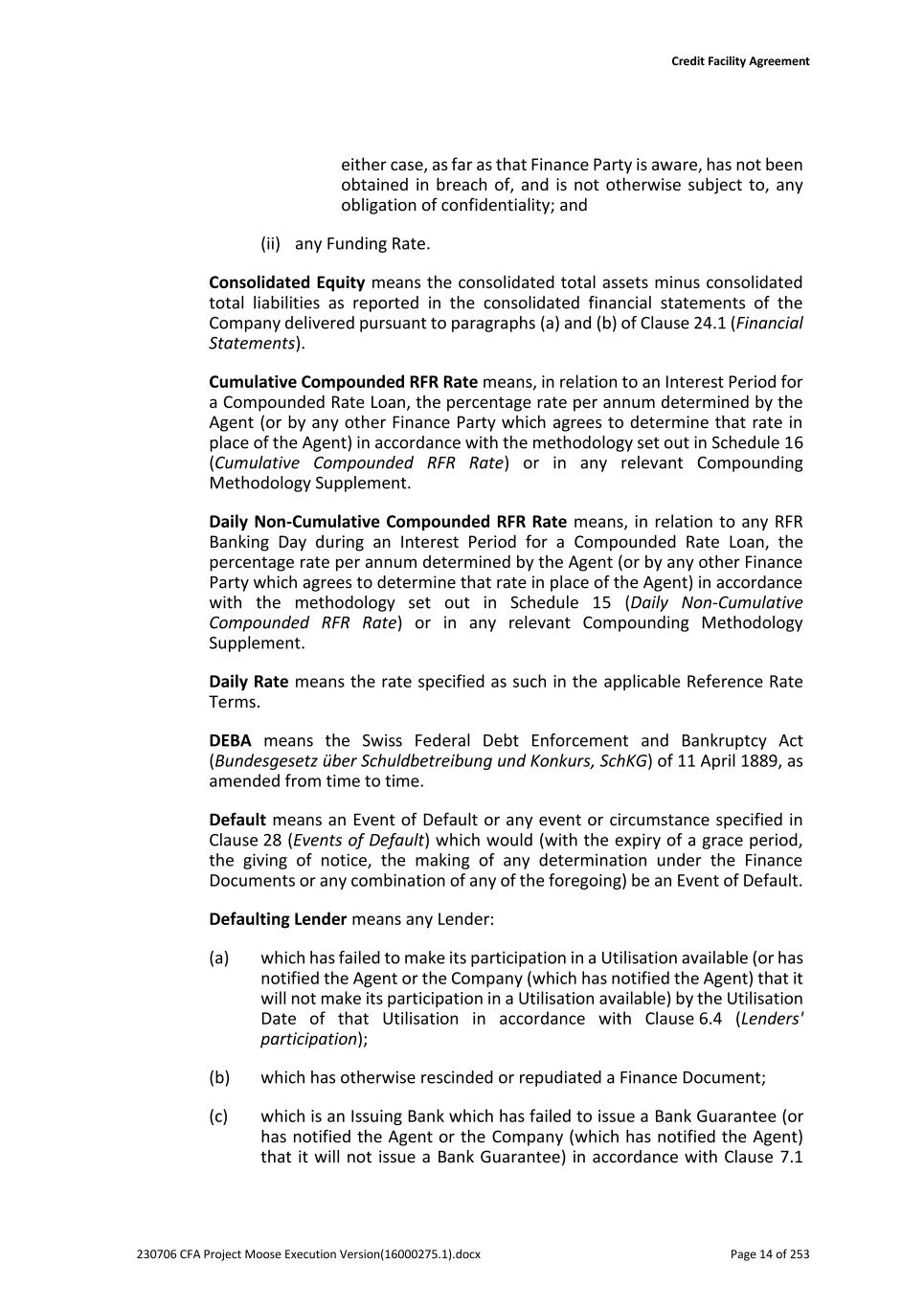
Credit Facility Agreement 230706 CFA Project Moose Execution Version(16000275.1).docx Page 14 of 253 either case, as far as that Finance Party is aware, has not been obtained in breach of, and is not otherwise subject to, any obligation of confidentiality; and (ii) any Funding Rate. Consolidated Equity means the consolidated total assets minus consolidated total liabilities as reported in the consolidated financial statements of the Company delivered pursuant to paragraphs (a) and (b) of Clause 24.1 (Financial Statements). Cumulative Compounded RFR Rate means, in relation to an Interest Period for a Compounded Rate Loan, the percentage rate per annum determined by the Agent (or by any other Finance Party which agrees to determine that rate in place of the Agent) in accordance with the methodology set out in Schedule 16 (Cumulative Compounded RFR Rate) or in any relevant Compounding Methodology Supplement. Daily Non-Cumulative Compounded RFR Rate means, in relation to any RFR Banking Day during an Interest Period for a Compounded Rate Loan, the percentage rate per annum determined by the Agent (or by any other Finance Party which agrees to determine that rate in place of the Agent) in accordance with the methodology set out in Schedule 15 (Daily Non-Cumulative Compounded RFR Rate) or in any relevant Compounding Methodology Supplement. Daily Rate means the rate specified as such in the applicable Reference Rate Terms. DEBA means the Swiss Federal Debt Enforcement and Bankruptcy Act (Bundesgesetz über Schuldbetreibung und Konkurs, SchKG) of 11 April 1889, as amended from time to time. Default means an Event of Default or any event or circumstance specified in Clause 28 (Events of Default) which would (with the expiry of a grace period, the giving of notice, the making of any determination under the Finance Documents or any combination of any of the foregoing) be an Event of Default. Defaulting Lender means any Lender: (a) which has failed to make its participation in a Utilisation available (or has notified the Agent or the Company (which has notified the Agent) that it will not make its participation in a Utilisation available) by the Utilisation Date of that Utilisation in accordance with Clause 6.4 (Lenders' participation); (b) which has otherwise rescinded or repudiated a Finance Document; (c) which is an Issuing Bank which has failed to issue a Bank Guarantee (or has notified the Agent or the Company (which has notified the Agent) that it will not issue a Bank Guarantee) in accordance with Clause 7.1
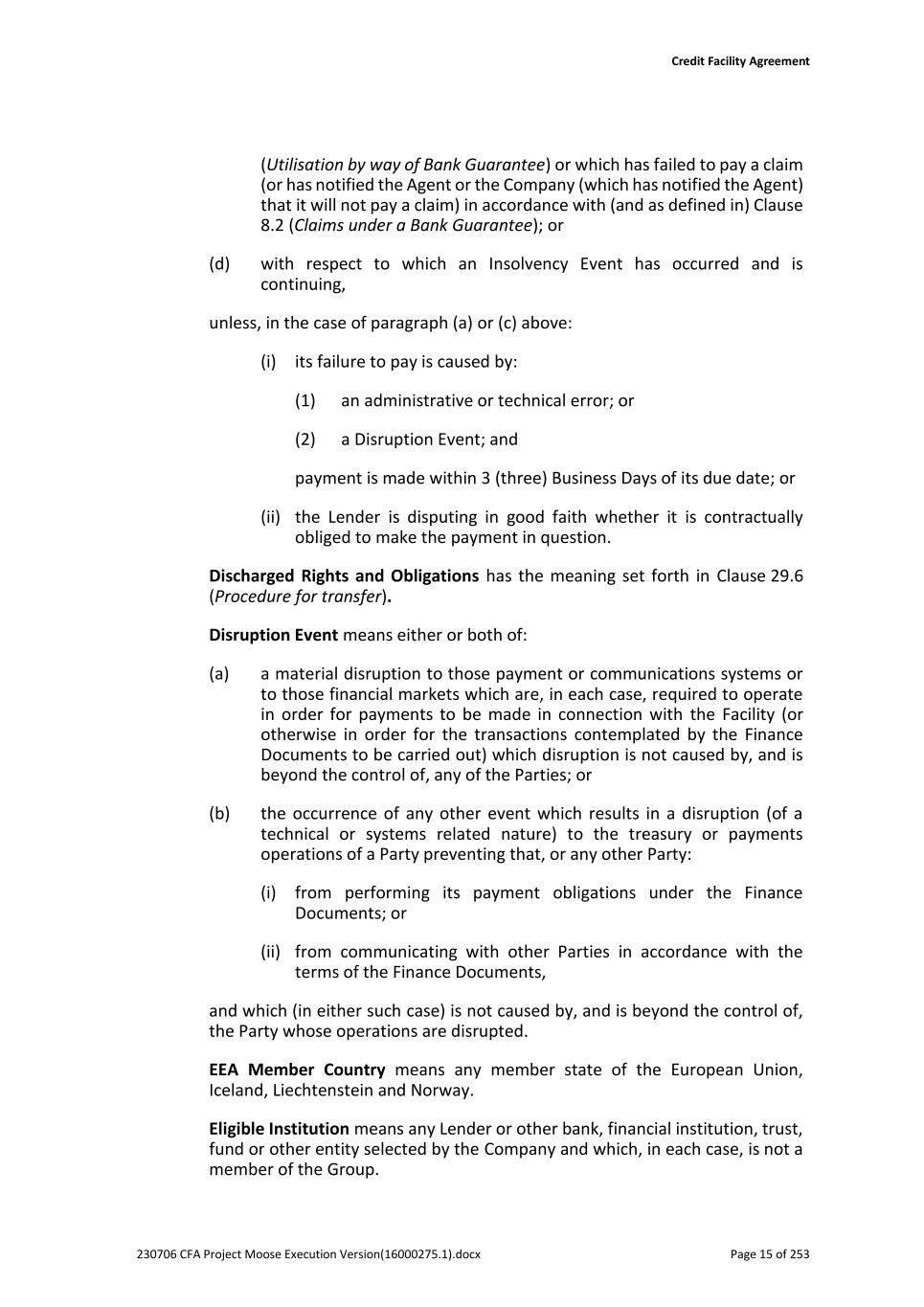
Credit Facility Agreement 230706 CFA Project Moose Execution Version(16000275.1).docx Page 15 of 253 (Utilisation by way of Bank Guarantee) or which has failed to pay a claim (or has notified the Agent or the Company (which has notified the Agent) that it will not pay a claim) in accordance with (and as defined in) Clause 8.2 (Claims under a Bank Guarantee); or (d) with respect to which an Insolvency Event has occurred and is continuing, unless, in the case of paragraph (a) or (c) above: (i) its failure to pay is caused by: (1) an administrative or technical error; or (2) a Disruption Event; and payment is made within 3 (three) Business Days of its due date; or (ii) the Lender is disputing in good faith whether it is contractually obliged to make the payment in question. Discharged Rights and Obligations has the meaning set forth in Clause 29.6 (Procedure for transfer). Disruption Event means either or both of: (a) a material disruption to those payment or communications systems or to those financial markets which are, in each case, required to operate in order for payments to be made in connection with the Facility (or otherwise in order for the transactions contemplated by the Finance Documents to be carried out) which disruption is not caused by, and is beyond the control of, any of the Parties; or (b) the occurrence of any other event which results in a disruption (of a technical or systems related nature) to the treasury or payments operations of a Party preventing that, or any other Party: (i) from performing its payment obligations under the Finance Documents; or (ii) from communicating with other Parties in accordance with the terms of the Finance Documents, and which (in either such case) is not caused by, and is beyond the control of, the Party whose operations are disrupted. EEA Member Country means any member state of the European Union, Iceland, Liechtenstein and Norway. Eligible Institution means any Lender or other bank, financial institution, trust, fund or other entity selected by the Company and which, in each case, is not a member of the Group.
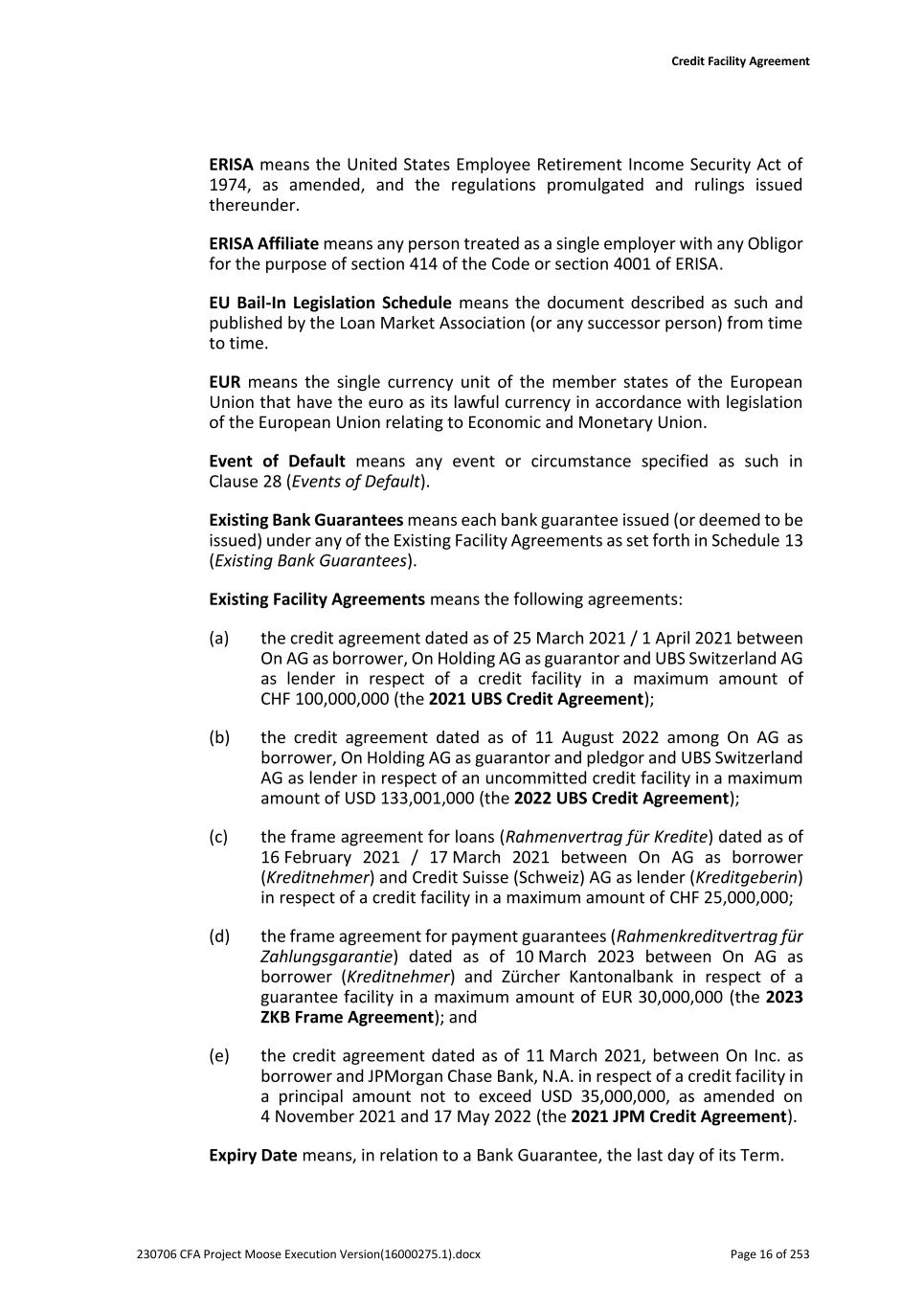
Credit Facility Agreement 230706 CFA Project Moose Execution Version(16000275.1).docx Page 16 of 253 ERISA means the United States Employee Retirement Income Security Act of 1974, as amended, and the regulations promulgated and rulings issued thereunder. ERISA Affiliate means any person treated as a single employer with any Obligor for the purpose of section 414 of the Code or section 4001 of ERISA. EU Bail-In Legislation Schedule means the document described as such and published by the Loan Market Association (or any successor person) from time to time. EUR means the single currency unit of the member states of the European Union that have the euro as its lawful currency in accordance with legislation of the European Union relating to Economic and Monetary Union. Event of Default means any event or circumstance specified as such in Clause 28 (Events of Default). Existing Bank Guarantees means each bank guarantee issued (or deemed to be issued) under any of the Existing Facility Agreements as set forth in Schedule 13 (Existing Bank Guarantees). Existing Facility Agreements means the following agreements: (a) the credit agreement dated as of 25 March 2021 / 1 April 2021 between On AG as borrower, On Holding AG as guarantor and UBS Switzerland AG as lender in respect of a credit facility in a maximum amount of CHF 100,000,000 (the 2021 UBS Credit Agreement); (b) the credit agreement dated as of 11 August 2022 among On AG as borrower, On Holding AG as guarantor and pledgor and UBS Switzerland AG as lender in respect of an uncommitted credit facility in a maximum amount of USD 133,001,000 (the 2022 UBS Credit Agreement); (c) the frame agreement for loans (Rahmenvertrag für Kredite) dated as of 16 February 2021 / 17 March 2021 between On AG as borrower (Kreditnehmer) and Credit Suisse (Schweiz) AG as lender (Kreditgeberin) in respect of a credit facility in a maximum amount of CHF 25,000,000; (d) the frame agreement for payment guarantees (Rahmenkreditvertrag für Zahlungsgarantie) dated as of 10 March 2023 between On AG as borrower (Kreditnehmer) and Zürcher Kantonalbank in respect of a guarantee facility in a maximum amount of EUR 30,000,000 (the 2023 ZKB Frame Agreement); and (e) the credit agreement dated as of 11 March 2021, between On Inc. as borrower and JPMorgan Chase Bank, N.A. in respect of a credit facility in a principal amount not to exceed USD 35,000,000, as amended on 4 November 2021 and 17 May 2022 (the 2021 JPM Credit Agreement). Expiry Date means, in relation to a Bank Guarantee, the last day of its Term.
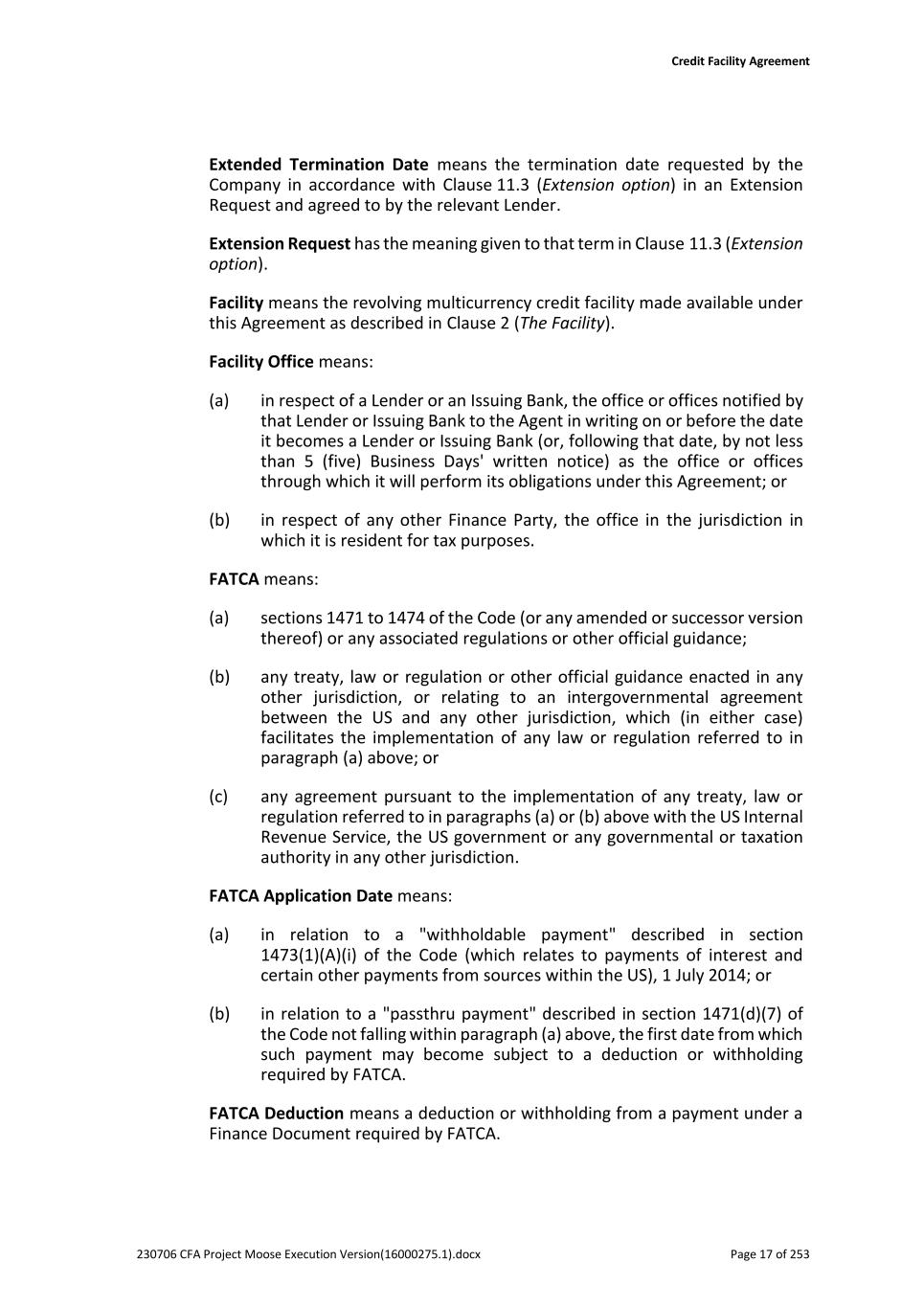
Credit Facility Agreement 230706 CFA Project Moose Execution Version(16000275.1).docx Page 17 of 253 Extended Termination Date means the termination date requested by the Company in accordance with Clause 11.3 (Extension option) in an Extension Request and agreed to by the relevant Lender. Extension Request has the meaning given to that term in Clause 11.3 (Extension option). Facility means the revolving multicurrency credit facility made available under this Agreement as described in Clause 2 (The Facility). Facility Office means: (a) in respect of a Lender or an Issuing Bank, the office or offices notified by that Lender or Issuing Bank to the Agent in writing on or before the date it becomes a Lender or Issuing Bank (or, following that date, by not less than 5 (five) Business Days' written notice) as the office or offices through which it will perform its obligations under this Agreement; or (b) in respect of any other Finance Party, the office in the jurisdiction in which it is resident for tax purposes. FATCA means: (a) sections 1471 to 1474 of the Code (or any amended or successor version thereof) or any associated regulations or other official guidance; (b) any treaty, law or regulation or other official guidance enacted in any other jurisdiction, or relating to an intergovernmental agreement between the US and any other jurisdiction, which (in either case) facilitates the implementation of any law or regulation referred to in paragraph (a) above; or (c) any agreement pursuant to the implementation of any treaty, law or regulation referred to in paragraphs (a) or (b) above with the US Internal Revenue Service, the US government or any governmental or taxation authority in any other jurisdiction. FATCA Application Date means: (a) in relation to a "withholdable payment" described in section 1473(1)(A)(i) of the Code (which relates to payments of interest and certain other payments from sources within the US), 1 July 2014; or (b) in relation to a "passthru payment" described in section 1471(d)(7) of the Code not falling within paragraph (a) above, the first date from which such payment may become subject to a deduction or withholding required by FATCA. FATCA Deduction means a deduction or withholding from a payment under a Finance Document required by FATCA.
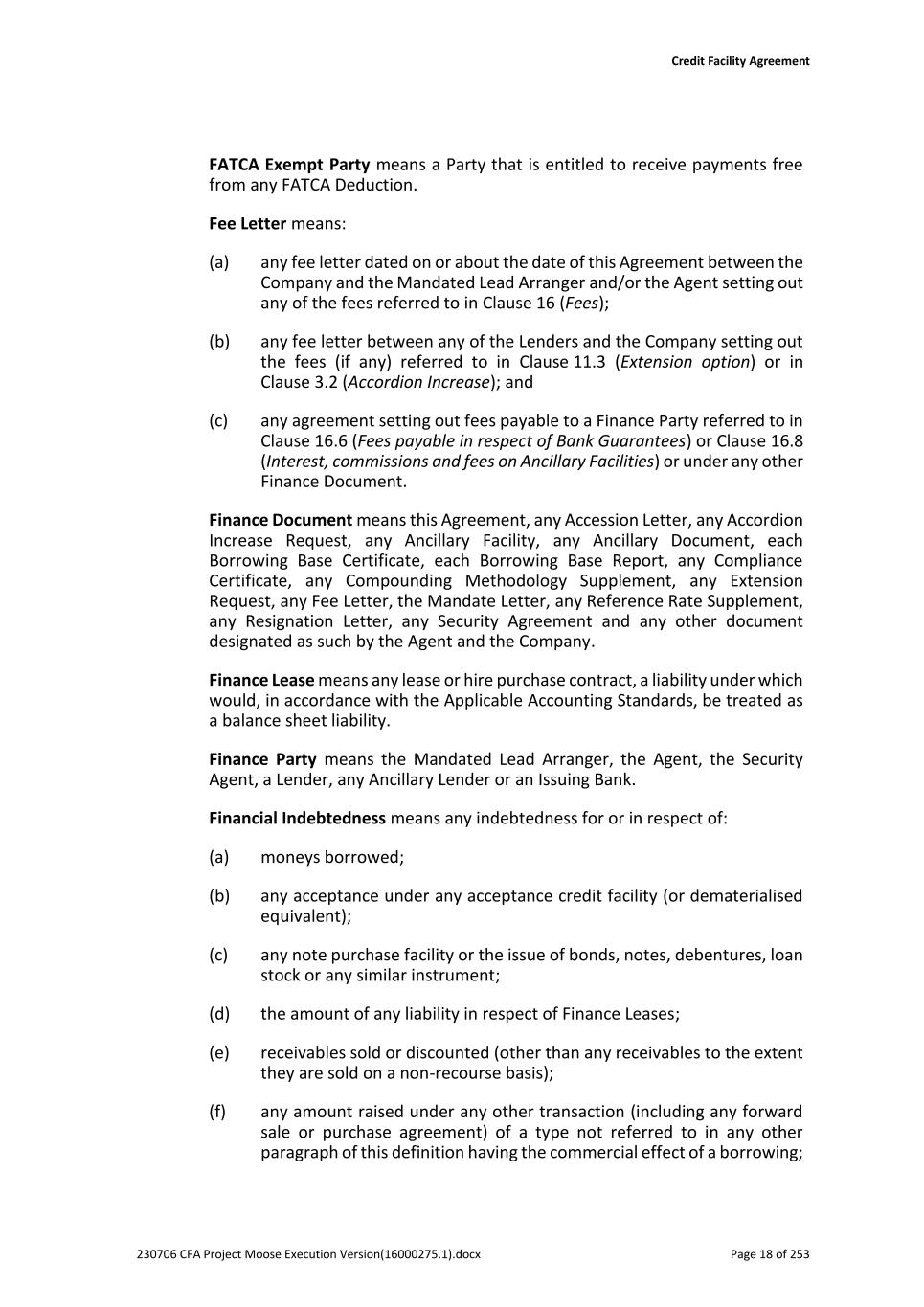
Credit Facility Agreement 230706 CFA Project Moose Execution Version(16000275.1).docx Page 18 of 253 FATCA Exempt Party means a Party that is entitled to receive payments free from any FATCA Deduction. Fee Letter means: (a) any fee letter dated on or about the date of this Agreement between the Company and the Mandated Lead Arranger and/or the Agent setting out any of the fees referred to in Clause 16 (Fees); (b) any fee letter between any of the Lenders and the Company setting out the fees (if any) referred to in Clause 11.3 (Extension option) or in Clause 3.2 (Accordion Increase); and (c) any agreement setting out fees payable to a Finance Party referred to in Clause 16.6 (Fees payable in respect of Bank Guarantees) or Clause 16.8 (Interest, commissions and fees on Ancillary Facilities) or under any other Finance Document. Finance Document means this Agreement, any Accession Letter, any Accordion Increase Request, any Ancillary Facility, any Ancillary Document, each Borrowing Base Certificate, each Borrowing Base Report, any Compliance Certificate, any Compounding Methodology Supplement, any Extension Request, any Fee Letter, the Mandate Letter, any Reference Rate Supplement, any Resignation Letter, any Security Agreement and any other document designated as such by the Agent and the Company. Finance Lease means any lease or hire purchase contract, a liability under which would, in accordance with the Applicable Accounting Standards, be treated as a balance sheet liability. Finance Party means the Mandated Lead Arranger, the Agent, the Security Agent, a Lender, any Ancillary Lender or an Issuing Bank. Financial Indebtedness means any indebtedness for or in respect of: (a) moneys borrowed; (b) any acceptance under any acceptance credit facility (or dematerialised equivalent); (c) any note purchase facility or the issue of bonds, notes, debentures, loan stock or any similar instrument; (d) the amount of any liability in respect of Finance Leases; (e) receivables sold or discounted (other than any receivables to the extent they are sold on a non-recourse basis); (f) any amount raised under any other transaction (including any forward sale or purchase agreement) of a type not referred to in any other paragraph of this definition having the commercial effect of a borrowing;

Credit Facility Agreement 230706 CFA Project Moose Execution Version(16000275.1).docx Page 19 of 253 (g) any derivative transaction entered into in connection with protection against or benefit from fluctuation in any rate or price (and, when calculating the value of any derivative transaction, only the marked to market value (or, if any actual amount is due as a result of the termination or close-out of that derivative transaction, that amount) shall be taken into account); (h) any counter-indemnity obligation in respect of a guarantee, bond, standby or documentary letter of credit or any other instrument issued by a bank or financial institution in respect of (i) an underlying liability of an entity which is not a member of the Group which liability would fall within one of the other paragraphs of this definition or (ii) any liabilities of any member of the Group relating to any post-retirement benefit scheme; and (i) without double counting, the amount of any liability in respect of any guarantee for any of the items referred to in paragraphs (a) to (h) above. Financial Year means the annual accounting period of the Group ending on 31 December in each year. First Extended Termination Date means the date agreed under paragraph (a)(i) of Clause 11.3 (Extension option). Fraudulent Transfer Law means any applicable US Bankruptcy Law (including, without limitation, Section 548 of Title 11 of the United States Bankruptcy Code) or any US state fraudulent transfer or conveyance statute and any related case law, and terms used in Clause 22.3 (US limitation) are to be construed in accordance with the Fraudulent Transfer Laws. Fronting Limit means: (a) in relation to an Original Issuing Bank, the amount in the Base Currency set opposite its name under the heading "Fronting Line" in Part III (The Original Issuing Banks) of Schedule 1 (The Original Parties), or such higher amount as may be agreed between the relevant Original Issuing Bank and the Agent from time to time; and (b) in relation to any other Issuing Bank, the amount as may be agreed between the relevant Issuing Bank and the Agent from time to time. Funding Rate means any individual rate notified by a Lender to the Agent pursuant to paragraph (a)(ii) of Clause 15.4 (Cost of funds). Group means the Company and its Subsidiaries from time to time Group Structure Chart means the structure chart of the Group as set out in Schedule 10 (Group Structure Chart). Guarantee Proportion means in relation to a Lender in respect of any Bank Guarantee, the proportion (expressed as a percentage) borne by that Lender's Available Commitment to the Available Facility immediately prior to the issue
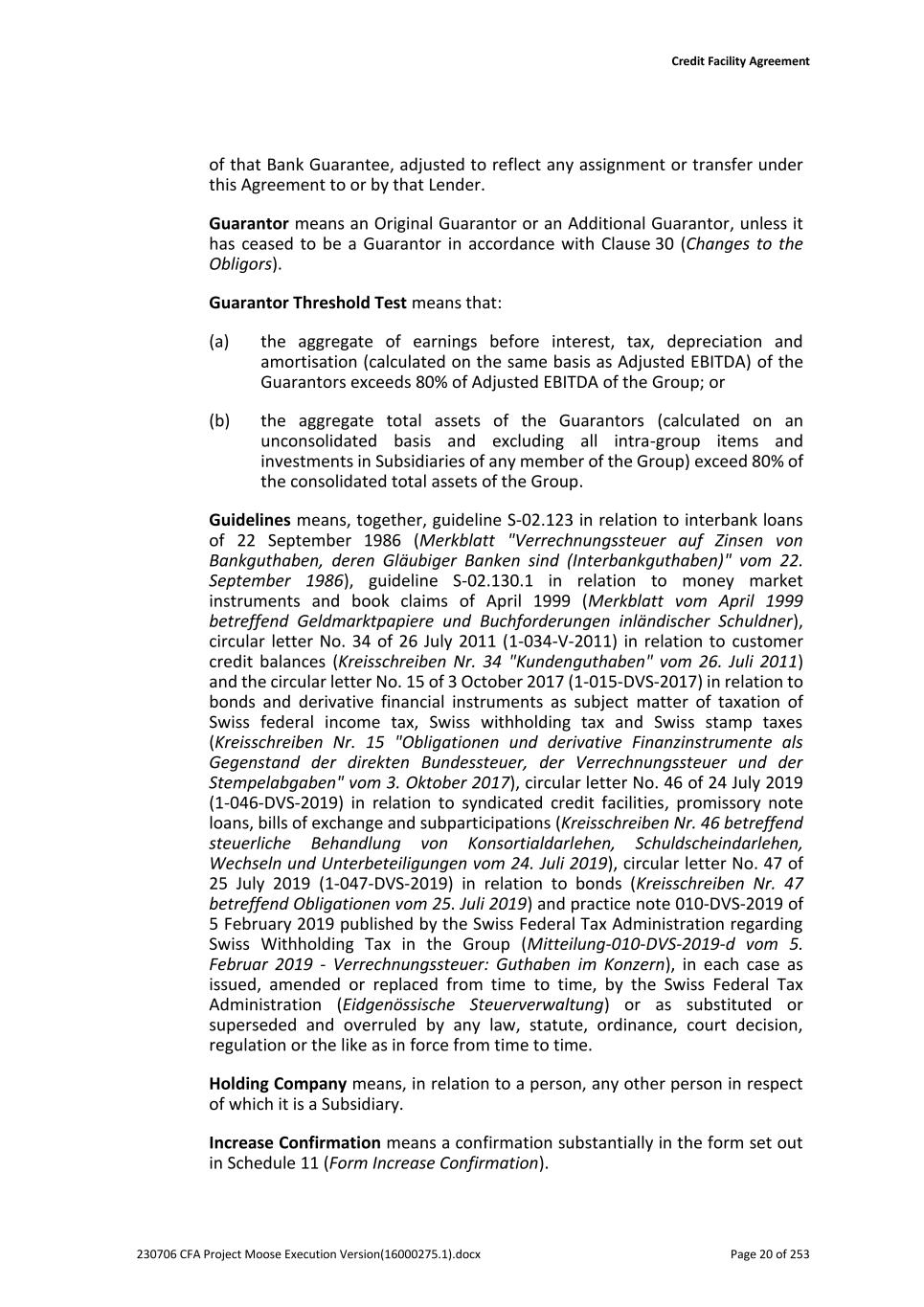
Credit Facility Agreement 230706 CFA Project Moose Execution Version(16000275.1).docx Page 20 of 253 of that Bank Guarantee, adjusted to reflect any assignment or transfer under this Agreement to or by that Lender. Guarantor means an Original Guarantor or an Additional Guarantor, unless it has ceased to be a Guarantor in accordance with Clause 30 (Changes to the Obligors). Guarantor Threshold Test means that: (a) the aggregate of earnings before interest, tax, depreciation and amortisation (calculated on the same basis as Adjusted EBITDA) of the Guarantors exceeds 80% of Adjusted EBITDA of the Group; or (b) the aggregate total assets of the Guarantors (calculated on an unconsolidated basis and excluding all intra-group items and investments in Subsidiaries of any member of the Group) exceed 80% of the consolidated total assets of the Group. Guidelines means, together, guideline S-02.123 in relation to interbank loans of 22 September 1986 (Merkblatt "Verrechnungssteuer auf Zinsen von Bankguthaben, deren Gläubiger Banken sind (Interbankguthaben)" vom 22. September 1986), guideline S-02.130.1 in relation to money market instruments and book claims of April 1999 (Merkblatt vom April 1999 betreffend Geldmarktpapiere und Buchforderungen inländischer Schuldner), circular letter No. 34 of 26 July 2011 (1-034-V-2011) in relation to customer credit balances (Kreisschreiben Nr. 34 "Kundenguthaben" vom 26. Juli 2011) and the circular letter No. 15 of 3 October 2017 (1-015-DVS-2017) in relation to bonds and derivative financial instruments as subject matter of taxation of Swiss federal income tax, Swiss withholding tax and Swiss stamp taxes (Kreisschreiben Nr. 15 "Obligationen und derivative Finanzinstrumente als Gegenstand der direkten Bundessteuer, der Verrechnungssteuer und der Stempelabgaben" vom 3. Oktober 2017), circular letter No. 46 of 24 July 2019 (1-046-DVS-2019) in relation to syndicated credit facilities, promissory note loans, bills of exchange and subparticipations (Kreisschreiben Nr. 46 betreffend steuerliche Behandlung von Konsortialdarlehen, Schuldscheindarlehen, Wechseln und Unterbeteiligungen vom 24. Juli 2019), circular letter No. 47 of 25 July 2019 (1-047-DVS-2019) in relation to bonds (Kreisschreiben Nr. 47 betreffend Obligationen vom 25. Juli 2019) and practice note 010-DVS-2019 of 5 February 2019 published by the Swiss Federal Tax Administration regarding Swiss Withholding Tax in the Group (Mitteilung-010-DVS-2019-d vom 5. Februar 2019 - Verrechnungssteuer: Guthaben im Konzern), in each case as issued, amended or replaced from time to time, by the Swiss Federal Tax Administration (Eidgenössische Steuerverwaltung) or as substituted or superseded and overruled by any law, statute, ordinance, court decision, regulation or the like as in force from time to time. Holding Company means, in relation to a person, any other person in respect of which it is a Subsidiary. Increase Confirmation means a confirmation substantially in the form set out in Schedule 11 (Form Increase Confirmation).
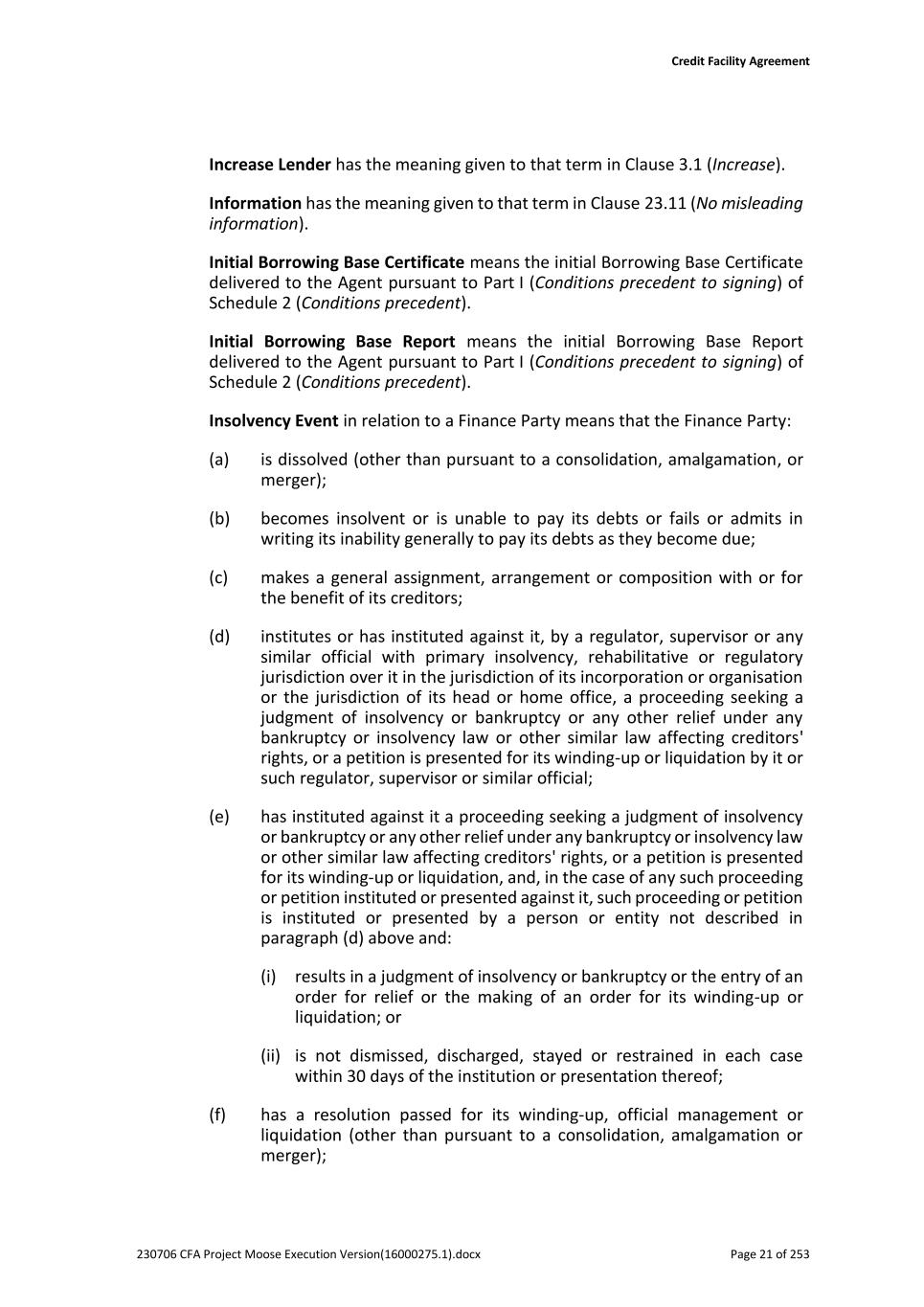
Credit Facility Agreement 230706 CFA Project Moose Execution Version(16000275.1).docx Page 21 of 253 Increase Lender has the meaning given to that term in Clause 3.1 (Increase). Information has the meaning given to that term in Clause 23.11 (No misleading information). Initial Borrowing Base Certificate means the initial Borrowing Base Certificate delivered to the Agent pursuant to Part I (Conditions precedent to signing) of Schedule 2 (Conditions precedent). Initial Borrowing Base Report means the initial Borrowing Base Report delivered to the Agent pursuant to Part I (Conditions precedent to signing) of Schedule 2 (Conditions precedent). Insolvency Event in relation to a Finance Party means that the Finance Party: (a) is dissolved (other than pursuant to a consolidation, amalgamation, or merger); (b) becomes insolvent or is unable to pay its debts or fails or admits in writing its inability generally to pay its debts as they become due; (c) makes a general assignment, arrangement or composition with or for the benefit of its creditors; (d) institutes or has instituted against it, by a regulator, supervisor or any similar official with primary insolvency, rehabilitative or regulatory jurisdiction over it in the jurisdiction of its incorporation or organisation or the jurisdiction of its head or home office, a proceeding seeking a judgment of insolvency or bankruptcy or any other relief under any bankruptcy or insolvency law or other similar law affecting creditors' rights, or a petition is presented for its winding-up or liquidation by it or such regulator, supervisor or similar official; (e) has instituted against it a proceeding seeking a judgment of insolvency or bankruptcy or any other relief under any bankruptcy or insolvency law or other similar law affecting creditors' rights, or a petition is presented for its winding-up or liquidation, and, in the case of any such proceeding or petition instituted or presented against it, such proceeding or petition is instituted or presented by a person or entity not described in paragraph (d) above and: (i) results in a judgment of insolvency or bankruptcy or the entry of an order for relief or the making of an order for its winding-up or liquidation; or (ii) is not dismissed, discharged, stayed or restrained in each case within 30 days of the institution or presentation thereof; (f) has a resolution passed for its winding-up, official management or liquidation (other than pursuant to a consolidation, amalgamation or merger);
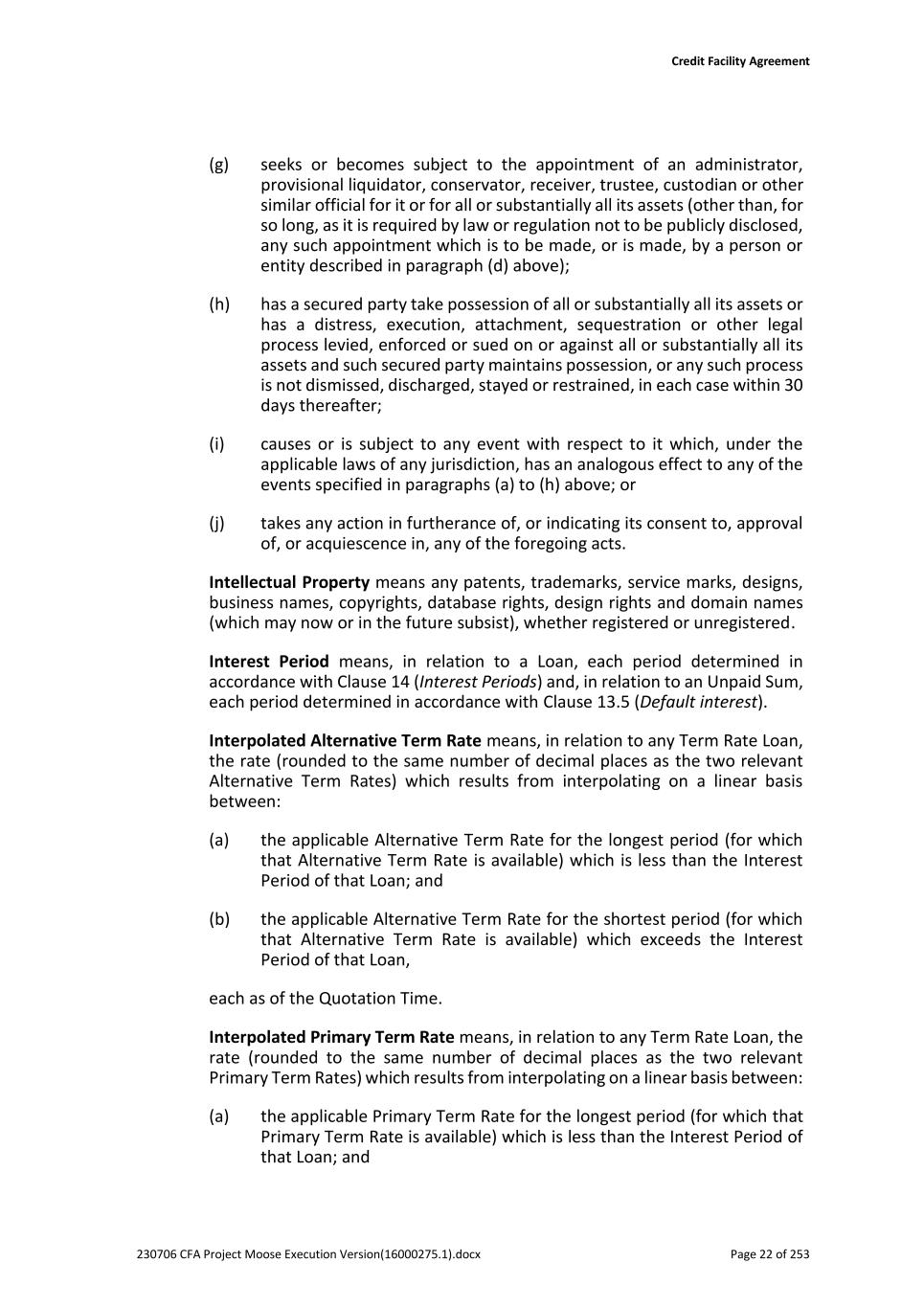
Credit Facility Agreement 230706 CFA Project Moose Execution Version(16000275.1).docx Page 22 of 253 (g) seeks or becomes subject to the appointment of an administrator, provisional liquidator, conservator, receiver, trustee, custodian or other similar official for it or for all or substantially all its assets (other than, for so long, as it is required by law or regulation not to be publicly disclosed, any such appointment which is to be made, or is made, by a person or entity described in paragraph (d) above); (h) has a secured party take possession of all or substantially all its assets or has a distress, execution, attachment, sequestration or other legal process levied, enforced or sued on or against all or substantially all its assets and such secured party maintains possession, or any such process is not dismissed, discharged, stayed or restrained, in each case within 30 days thereafter; (i) causes or is subject to any event with respect to it which, under the applicable laws of any jurisdiction, has an analogous effect to any of the events specified in paragraphs (a) to (h) above; or (j) takes any action in furtherance of, or indicating its consent to, approval of, or acquiescence in, any of the foregoing acts. Intellectual Property means any patents, trademarks, service marks, designs, business names, copyrights, database rights, design rights and domain names (which may now or in the future subsist), whether registered or unregistered. Interest Period means, in relation to a Loan, each period determined in accordance with Clause 14 (Interest Periods) and, in relation to an Unpaid Sum, each period determined in accordance with Clause 13.5 (Default interest). Interpolated Alternative Term Rate means, in relation to any Term Rate Loan, the rate (rounded to the same number of decimal places as the two relevant Alternative Term Rates) which results from interpolating on a linear basis between: (a) the applicable Alternative Term Rate for the longest period (for which that Alternative Term Rate is available) which is less than the Interest Period of that Loan; and (b) the applicable Alternative Term Rate for the shortest period (for which that Alternative Term Rate is available) which exceeds the Interest Period of that Loan, each as of the Quotation Time. Interpolated Primary Term Rate means, in relation to any Term Rate Loan, the rate (rounded to the same number of decimal places as the two relevant Primary Term Rates) which results from interpolating on a linear basis between: (a) the applicable Primary Term Rate for the longest period (for which that Primary Term Rate is available) which is less than the Interest Period of that Loan; and
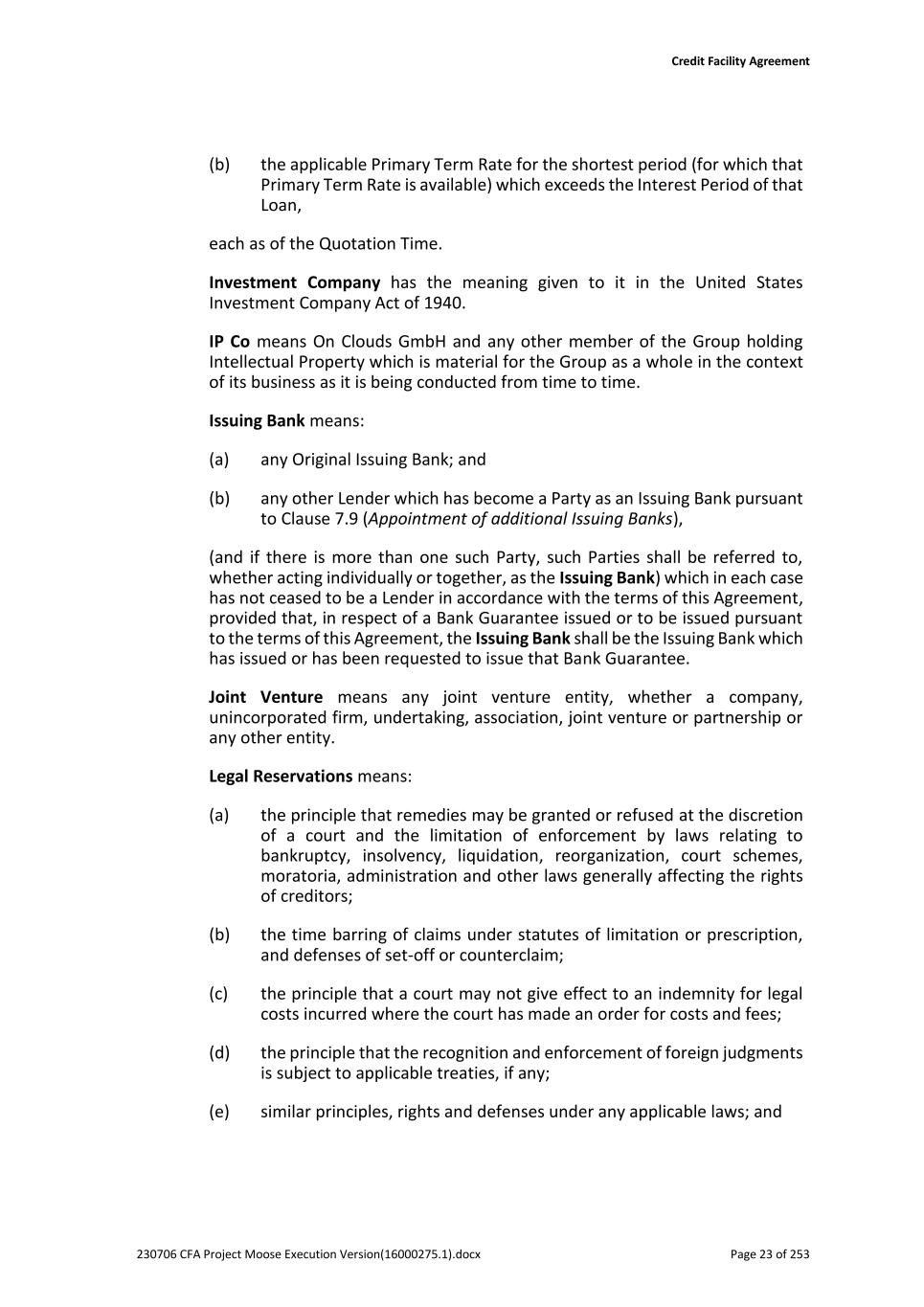
Credit Facility Agreement 230706 CFA Project Moose Execution Version(16000275.1).docx Page 23 of 253 (b) the applicable Primary Term Rate for the shortest period (for which that Primary Term Rate is available) which exceeds the Interest Period of that Loan, each as of the Quotation Time. Investment Company has the meaning given to it in the United States Investment Company Act of 1940. IP Co means On Clouds GmbH and any other member of the Group holding Intellectual Property which is material for the Group as a whole in the context of its business as it is being conducted from time to time. Issuing Bank means: (a) any Original Issuing Bank; and (b) any other Lender which has become a Party as an Issuing Bank pursuant to Clause 7.9 (Appointment of additional Issuing Banks), (and if there is more than one such Party, such Parties shall be referred to, whether acting individually or together, as the Issuing Bank) which in each case has not ceased to be a Lender in accordance with the terms of this Agreement, provided that, in respect of a Bank Guarantee issued or to be issued pursuant to the terms of this Agreement, the Issuing Bank shall be the Issuing Bank which has issued or has been requested to issue that Bank Guarantee. Joint Venture means any joint venture entity, whether a company, unincorporated firm, undertaking, association, joint venture or partnership or any other entity. Legal Reservations means: (a) the principle that remedies may be granted or refused at the discretion of a court and the limitation of enforcement by laws relating to bankruptcy, insolvency, liquidation, reorganization, court schemes, moratoria, administration and other laws generally affecting the rights of creditors; (b) the time barring of claims under statutes of limitation or prescription, and defenses of set-off or counterclaim; (c) the principle that a court may not give effect to an indemnity for legal costs incurred where the court has made an order for costs and fees; (d) the principle that the recognition and enforcement of foreign judgments is subject to applicable treaties, if any; (e) similar principles, rights and defenses under any applicable laws; and
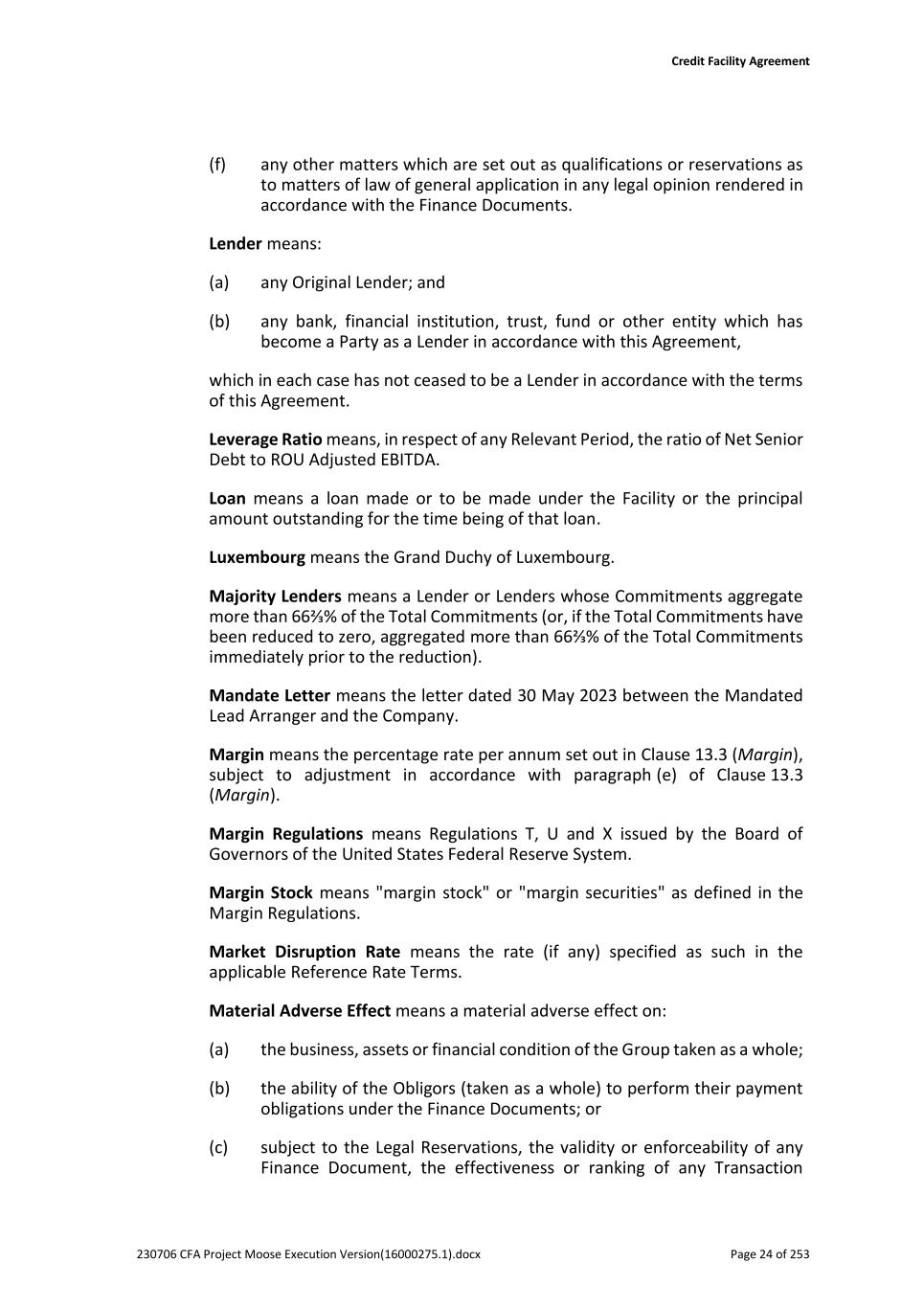
Credit Facility Agreement 230706 CFA Project Moose Execution Version(16000275.1).docx Page 24 of 253 (f) any other matters which are set out as qualifications or reservations as to matters of law of general application in any legal opinion rendered in accordance with the Finance Documents. Lender means: (a) any Original Lender; and (b) any bank, financial institution, trust, fund or other entity which has become a Party as a Lender in accordance with this Agreement, which in each case has not ceased to be a Lender in accordance with the terms of this Agreement. Leverage Ratio means, in respect of any Relevant Period, the ratio of Net Senior Debt to ROU Adjusted EBITDA. Loan means a loan made or to be made under the Facility or the principal amount outstanding for the time being of that loan. Luxembourg means the Grand Duchy of Luxembourg. Majority Lenders means a Lender or Lenders whose Commitments aggregate more than 66⅔% of the Total Commitments (or, if the Total Commitments have been reduced to zero, aggregated more than 66⅔% of the Total Commitments immediately prior to the reduction). Mandate Letter means the letter dated 30 May 2023 between the Mandated Lead Arranger and the Company. Margin means the percentage rate per annum set out in Clause 13.3 (Margin), subject to adjustment in accordance with paragraph (e) of Clause 13.3 (Margin). Margin Regulations means Regulations T, U and X issued by the Board of Governors of the United States Federal Reserve System. Margin Stock means "margin stock" or "margin securities" as defined in the Margin Regulations. Market Disruption Rate means the rate (if any) specified as such in the applicable Reference Rate Terms. Material Adverse Effect means a material adverse effect on: (a) the business, assets or financial condition of the Group taken as a whole; (b) the ability of the Obligors (taken as a whole) to perform their payment obligations under the Finance Documents; or (c) subject to the Legal Reservations, the validity or enforceability of any Finance Document, the effectiveness or ranking of any Transaction
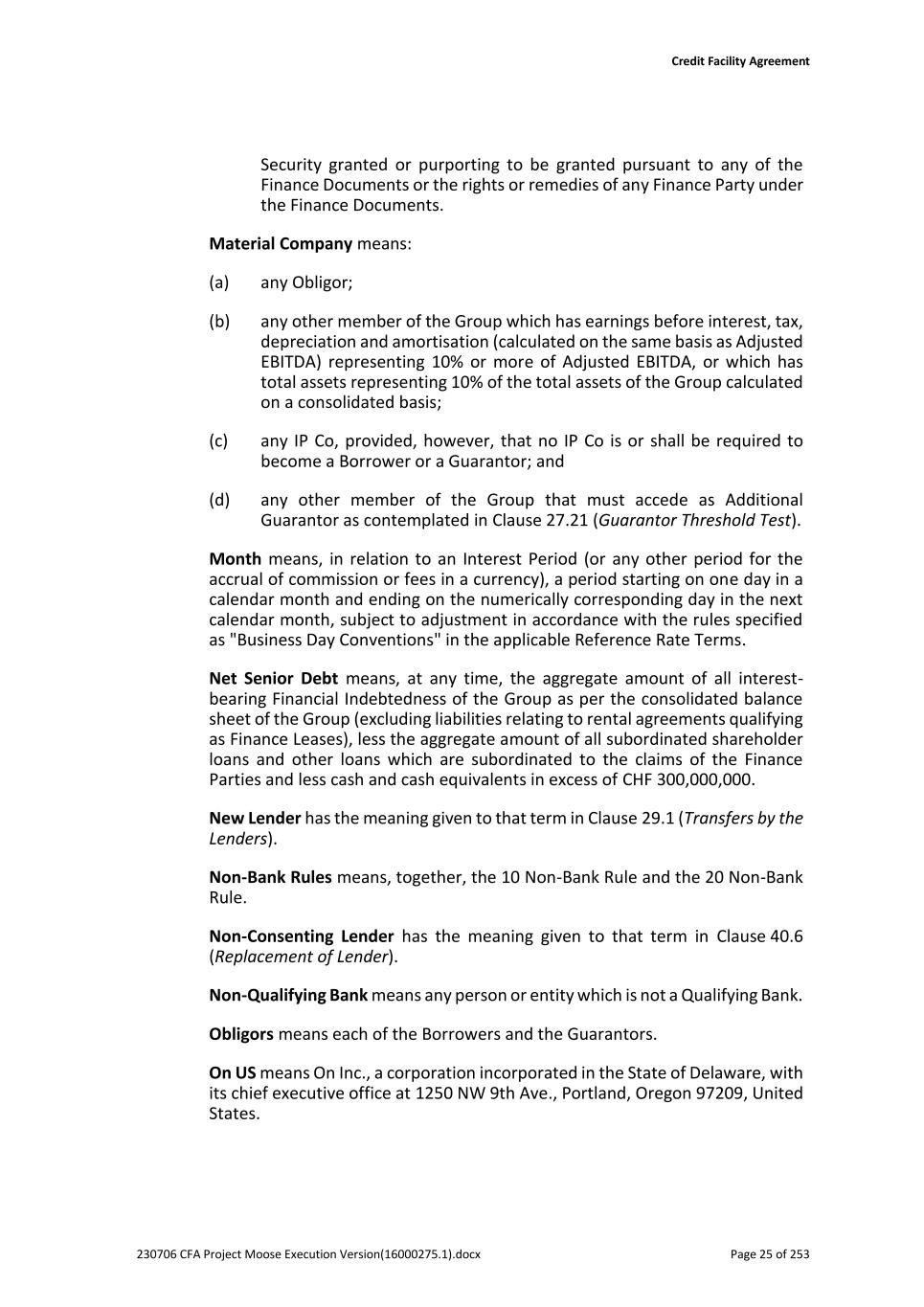
Credit Facility Agreement 230706 CFA Project Moose Execution Version(16000275.1).docx Page 25 of 253 Security granted or purporting to be granted pursuant to any of the Finance Documents or the rights or remedies of any Finance Party under the Finance Documents. Material Company means: (a) any Obligor; (b) any other member of the Group which has earnings before interest, tax, depreciation and amortisation (calculated on the same basis as Adjusted EBITDA) representing 10% or more of Adjusted EBITDA, or which has total assets representing 10% of the total assets of the Group calculated on a consolidated basis; (c) any IP Co, provided, however, that no IP Co is or shall be required to become a Borrower or a Guarantor; and (d) any other member of the Group that must accede as Additional Guarantor as contemplated in Clause 27.21 (Guarantor Threshold Test). Month means, in relation to an Interest Period (or any other period for the accrual of commission or fees in a currency), a period starting on one day in a calendar month and ending on the numerically corresponding day in the next calendar month, subject to adjustment in accordance with the rules specified as "Business Day Conventions" in the applicable Reference Rate Terms. Net Senior Debt means, at any time, the aggregate amount of all interest- bearing Financial Indebtedness of the Group as per the consolidated balance sheet of the Group (excluding liabilities relating to rental agreements qualifying as Finance Leases), less the aggregate amount of all subordinated shareholder loans and other loans which are subordinated to the claims of the Finance Parties and less cash and cash equivalents in excess of CHF 300,000,000. New Lender has the meaning given to that term in Clause 29.1 (Transfers by the Lenders). Non-Bank Rules means, together, the 10 Non-Bank Rule and the 20 Non-Bank Rule. Non-Consenting Lender has the meaning given to that term in Clause 40.6 (Replacement of Lender). Non-Qualifying Bank means any person or entity which is not a Qualifying Bank. Obligors means each of the Borrowers and the Guarantors. On US means On Inc., a corporation incorporated in the State of Delaware, with its chief executive office at 1250 NW 9th Ave., Portland, Oregon 97209, United States.
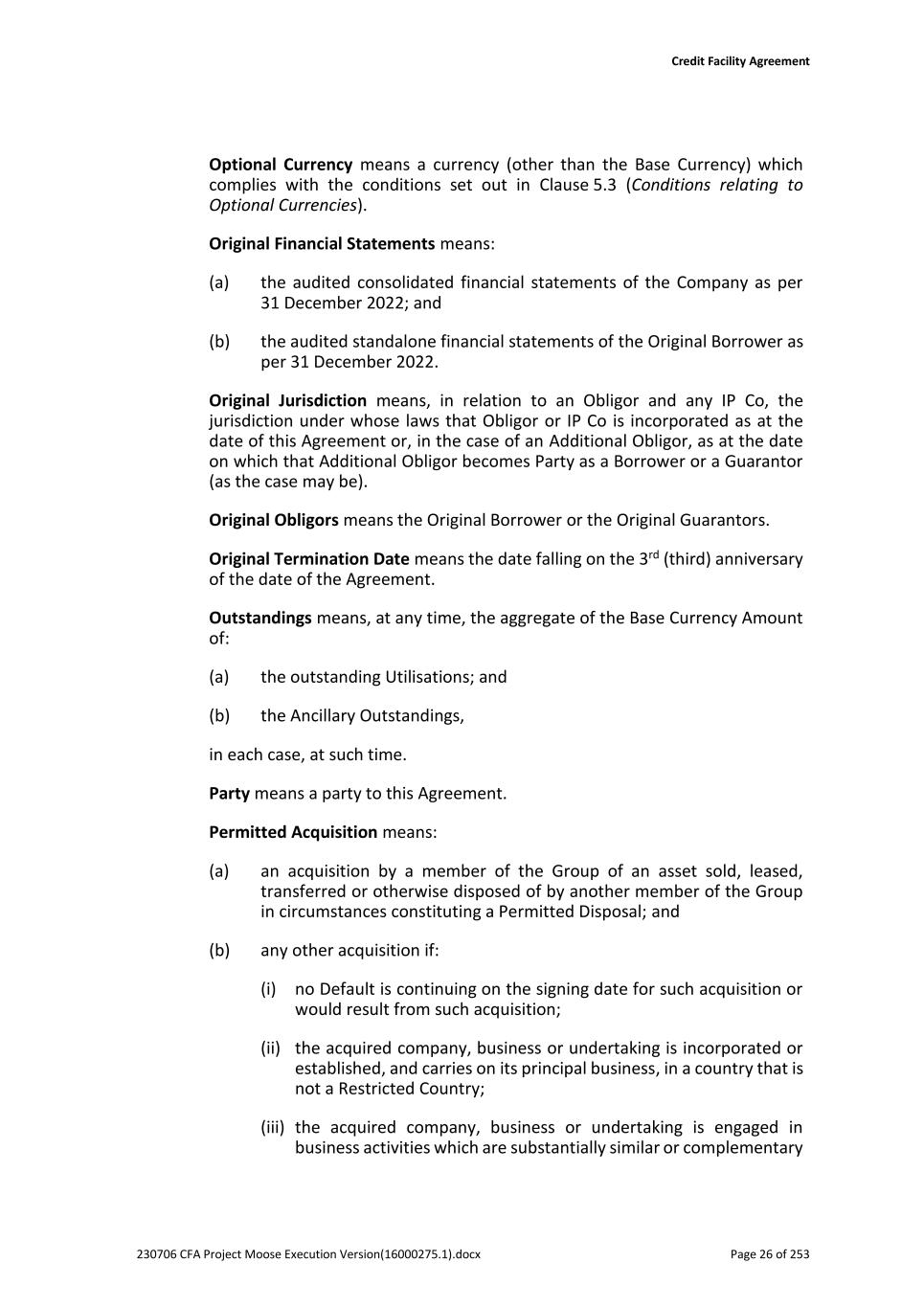
Credit Facility Agreement 230706 CFA Project Moose Execution Version(16000275.1).docx Page 26 of 253 Optional Currency means a currency (other than the Base Currency) which complies with the conditions set out in Clause 5.3 (Conditions relating to Optional Currencies). Original Financial Statements means: (a) the audited consolidated financial statements of the Company as per 31 December 2022; and (b) the audited standalone financial statements of the Original Borrower as per 31 December 2022. Original Jurisdiction means, in relation to an Obligor and any IP Co, the jurisdiction under whose laws that Obligor or IP Co is incorporated as at the date of this Agreement or, in the case of an Additional Obligor, as at the date on which that Additional Obligor becomes Party as a Borrower or a Guarantor (as the case may be). Original Obligors means the Original Borrower or the Original Guarantors. Original Termination Date means the date falling on the 3rd (third) anniversary of the date of the Agreement. Outstandings means, at any time, the aggregate of the Base Currency Amount of: (a) the outstanding Utilisations; and (b) the Ancillary Outstandings, in each case, at such time. Party means a party to this Agreement. Permitted Acquisition means: (a) an acquisition by a member of the Group of an asset sold, leased, transferred or otherwise disposed of by another member of the Group in circumstances constituting a Permitted Disposal; and (b) any other acquisition if: (i) no Default is continuing on the signing date for such acquisition or would result from such acquisition; (ii) the acquired company, business or undertaking is incorporated or established, and carries on its principal business, in a country that is not a Restricted Country; (iii) the acquired company, business or undertaking is engaged in business activities which are substantially similar or complementary
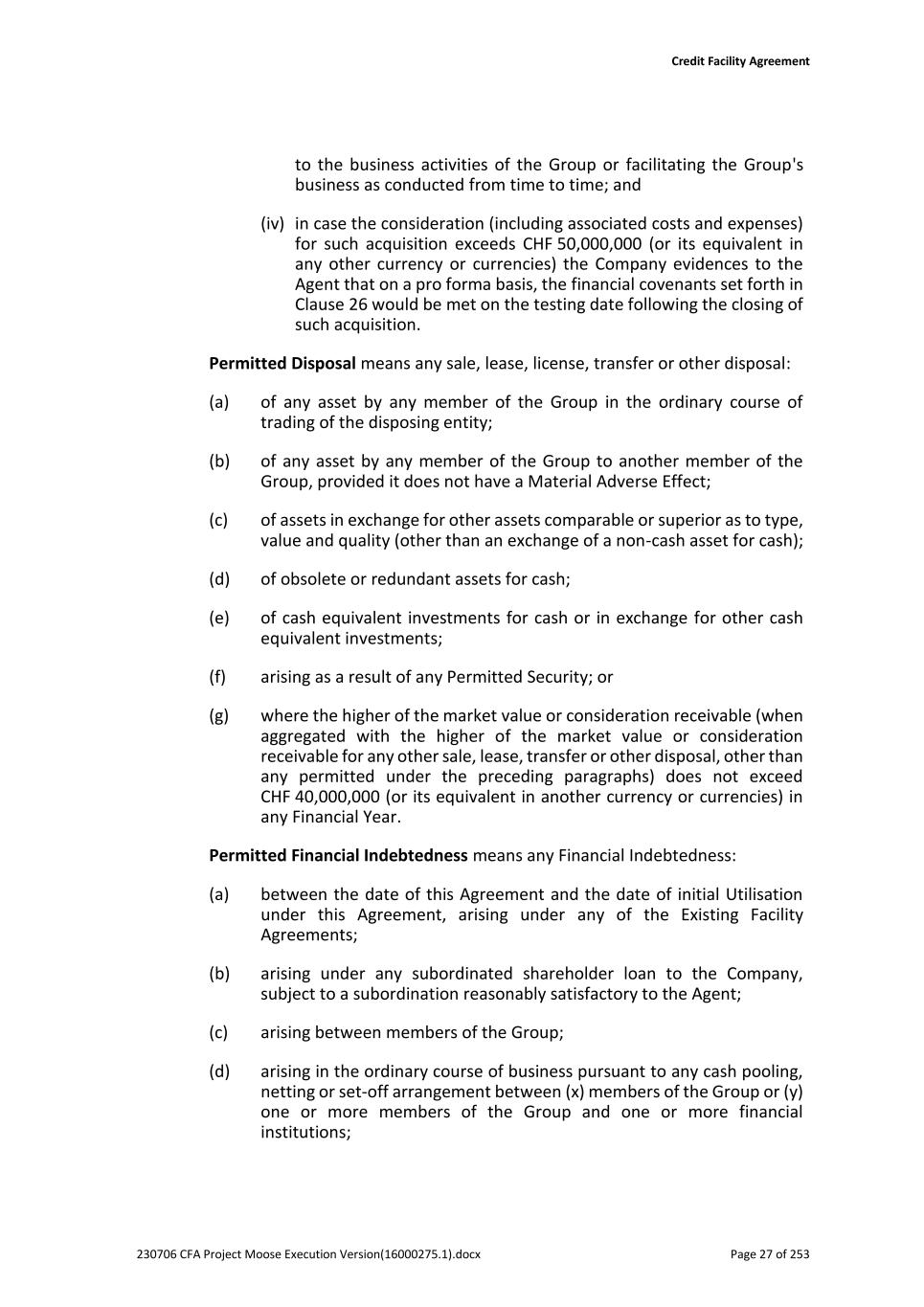
Credit Facility Agreement 230706 CFA Project Moose Execution Version(16000275.1).docx Page 27 of 253 to the business activities of the Group or facilitating the Group's business as conducted from time to time; and (iv) in case the consideration (including associated costs and expenses) for such acquisition exceeds CHF 50,000,000 (or its equivalent in any other currency or currencies) the Company evidences to the Agent that on a pro forma basis, the financial covenants set forth in Clause 26 would be met on the testing date following the closing of such acquisition. Permitted Disposal means any sale, lease, license, transfer or other disposal: (a) of any asset by any member of the Group in the ordinary course of trading of the disposing entity; (b) of any asset by any member of the Group to another member of the Group, provided it does not have a Material Adverse Effect; (c) of assets in exchange for other assets comparable or superior as to type, value and quality (other than an exchange of a non-cash asset for cash); (d) of obsolete or redundant assets for cash; (e) of cash equivalent investments for cash or in exchange for other cash equivalent investments; (f) arising as a result of any Permitted Security; or (g) where the higher of the market value or consideration receivable (when aggregated with the higher of the market value or consideration receivable for any other sale, lease, transfer or other disposal, other than any permitted under the preceding paragraphs) does not exceed CHF 40,000,000 (or its equivalent in another currency or currencies) in any Financial Year. Permitted Financial Indebtedness means any Financial Indebtedness: (a) between the date of this Agreement and the date of initial Utilisation under this Agreement, arising under any of the Existing Facility Agreements; (b) arising under any subordinated shareholder loan to the Company, subject to a subordination reasonably satisfactory to the Agent; (c) arising between members of the Group; (d) arising in the ordinary course of business pursuant to any cash pooling, netting or set-off arrangement between (x) members of the Group or (y) one or more members of the Group and one or more financial institutions;
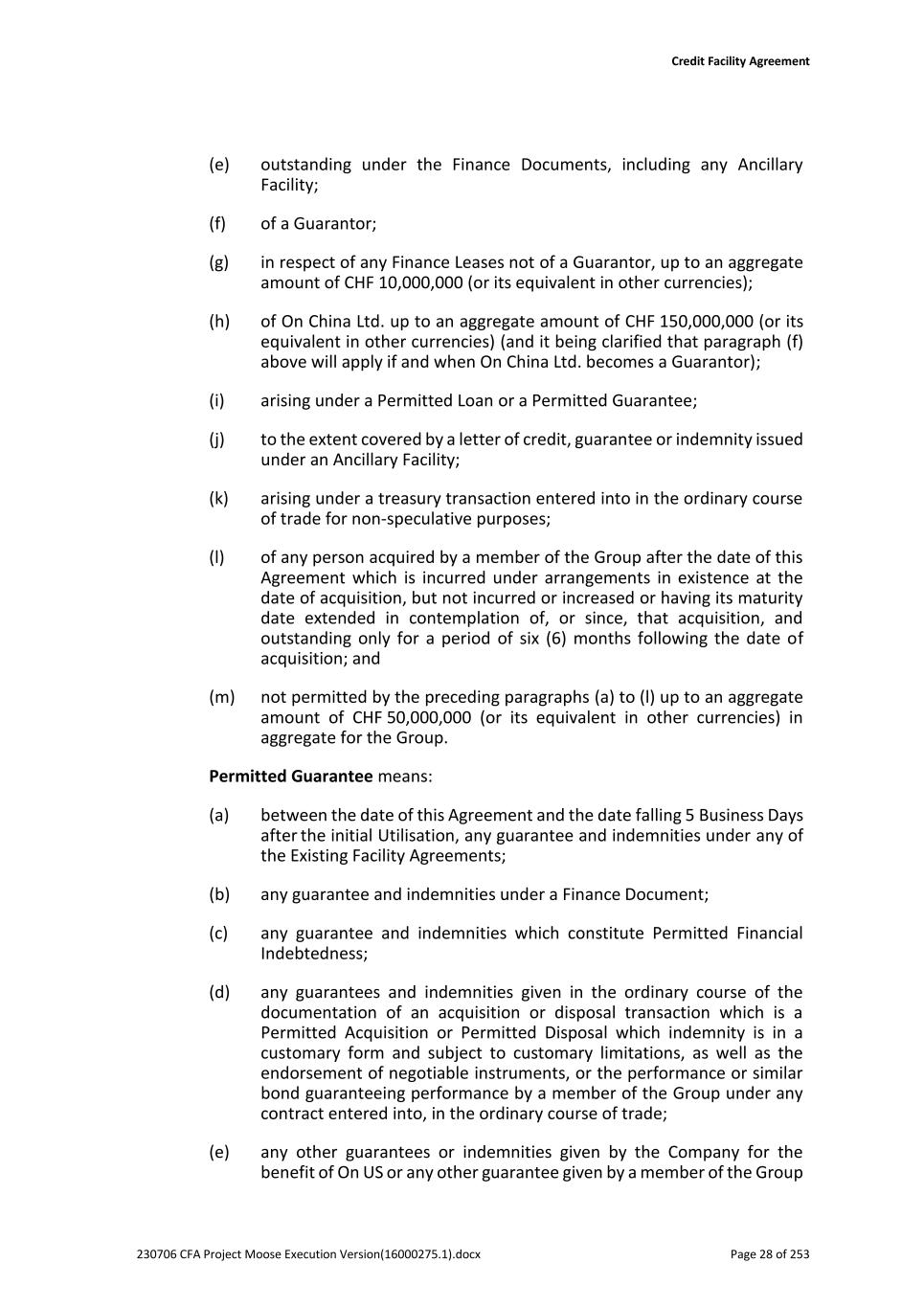
Credit Facility Agreement 230706 CFA Project Moose Execution Version(16000275.1).docx Page 28 of 253 (e) outstanding under the Finance Documents, including any Ancillary Facility; (f) of a Guarantor; (g) in respect of any Finance Leases not of a Guarantor, up to an aggregate amount of CHF 10,000,000 (or its equivalent in other currencies); (h) of On China Ltd. up to an aggregate amount of CHF 150,000,000 (or its equivalent in other currencies) (and it being clarified that paragraph (f) above will apply if and when On China Ltd. becomes a Guarantor); (i) arising under a Permitted Loan or a Permitted Guarantee; (j) to the extent covered by a letter of credit, guarantee or indemnity issued under an Ancillary Facility; (k) arising under a treasury transaction entered into in the ordinary course of trade for non-speculative purposes; (l) of any person acquired by a member of the Group after the date of this Agreement which is incurred under arrangements in existence at the date of acquisition, but not incurred or increased or having its maturity date extended in contemplation of, or since, that acquisition, and outstanding only for a period of six (6) months following the date of acquisition; and (m) not permitted by the preceding paragraphs (a) to (l) up to an aggregate amount of CHF 50,000,000 (or its equivalent in other currencies) in aggregate for the Group. Permitted Guarantee means: (a) between the date of this Agreement and the date falling 5 Business Days after the initial Utilisation, any guarantee and indemnities under any of the Existing Facility Agreements; (b) any guarantee and indemnities under a Finance Document; (c) any guarantee and indemnities which constitute Permitted Financial Indebtedness; (d) any guarantees and indemnities given in the ordinary course of the documentation of an acquisition or disposal transaction which is a Permitted Acquisition or Permitted Disposal which indemnity is in a customary form and subject to customary limitations, as well as the endorsement of negotiable instruments, or the performance or similar bond guaranteeing performance by a member of the Group under any contract entered into, in the ordinary course of trade; (e) any other guarantees or indemnities given by the Company for the benefit of On US or any other guarantee given by a member of the Group
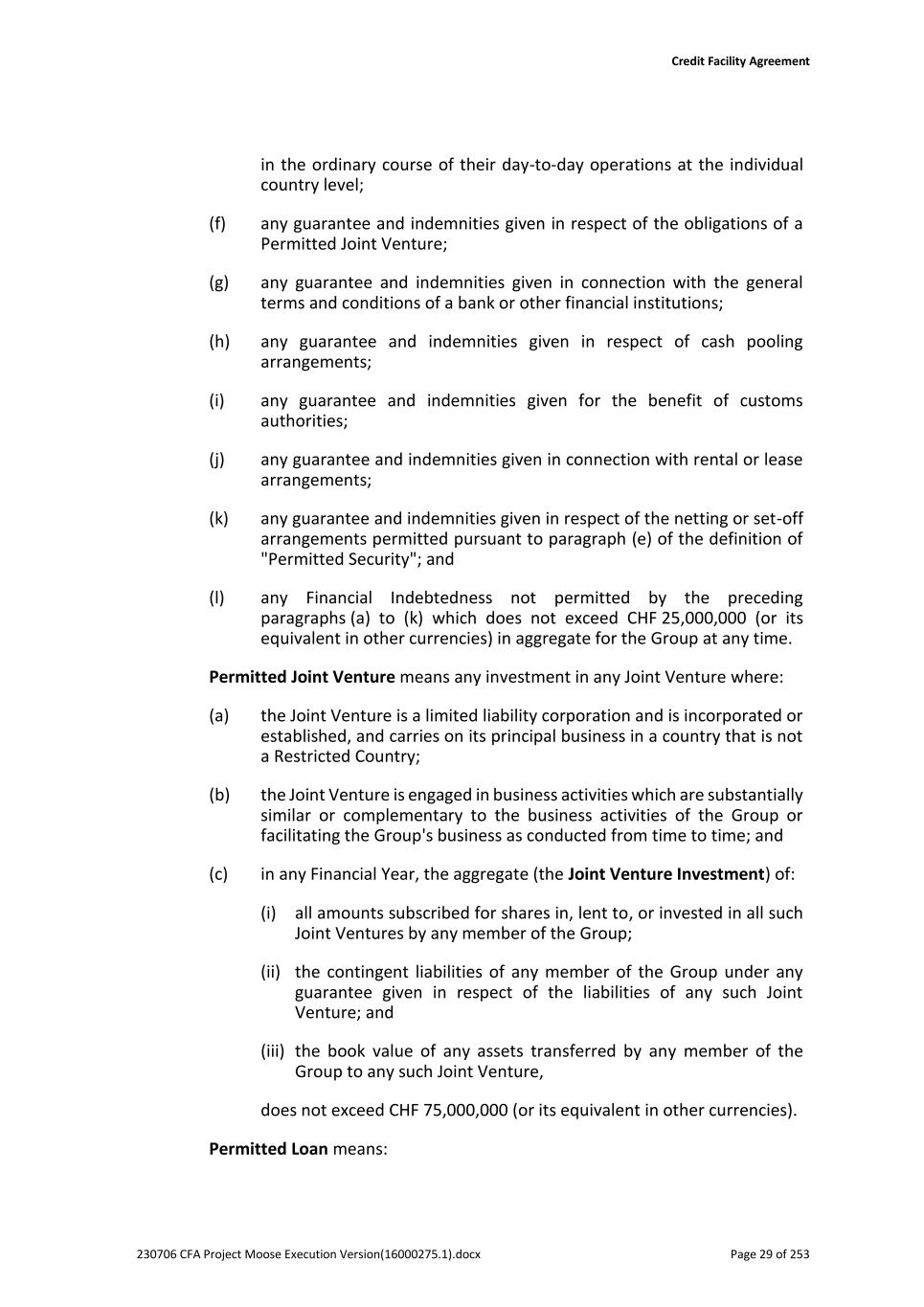
Credit Facility Agreement 230706 CFA Project Moose Execution Version(16000275.1).docx Page 29 of 253 in the ordinary course of their day-to-day operations at the individual country level; (f) any guarantee and indemnities given in respect of the obligations of a Permitted Joint Venture; (g) any guarantee and indemnities given in connection with the general terms and conditions of a bank or other financial institutions; (h) any guarantee and indemnities given in respect of cash pooling arrangements; (i) any guarantee and indemnities given for the benefit of customs authorities; (j) any guarantee and indemnities given in connection with rental or lease arrangements; (k) any guarantee and indemnities given in respect of the netting or set-off arrangements permitted pursuant to paragraph (e) of the definition of "Permitted Security"; and (l) any Financial Indebtedness not permitted by the preceding paragraphs (a) to (k) which does not exceed CHF 25,000,000 (or its equivalent in other currencies) in aggregate for the Group at any time. Permitted Joint Venture means any investment in any Joint Venture where: (a) the Joint Venture is a limited liability corporation and is incorporated or established, and carries on its principal business in a country that is not a Restricted Country; (b) the Joint Venture is engaged in business activities which are substantially similar or complementary to the business activities of the Group or facilitating the Group's business as conducted from time to time; and (c) in any Financial Year, the aggregate (the Joint Venture Investment) of: (i) all amounts subscribed for shares in, lent to, or invested in all such Joint Ventures by any member of the Group; (ii) the contingent liabilities of any member of the Group under any guarantee given in respect of the liabilities of any such Joint Venture; and (iii) the book value of any assets transferred by any member of the Group to any such Joint Venture, does not exceed CHF 75,000,000 (or its equivalent in other currencies). Permitted Loan means:
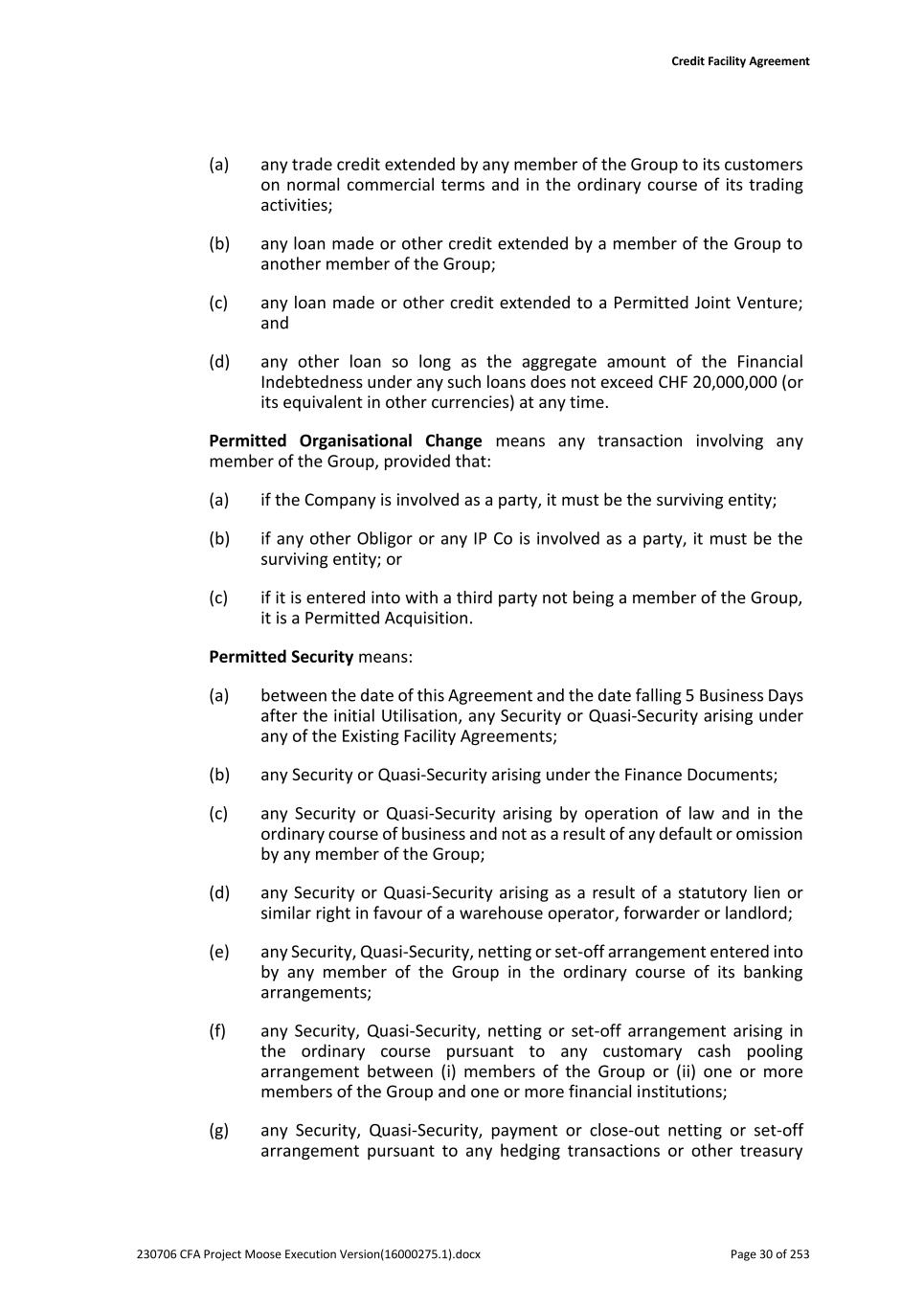
Credit Facility Agreement 230706 CFA Project Moose Execution Version(16000275.1).docx Page 30 of 253 (a) any trade credit extended by any member of the Group to its customers on normal commercial terms and in the ordinary course of its trading activities; (b) any loan made or other credit extended by a member of the Group to another member of the Group; (c) any loan made or other credit extended to a Permitted Joint Venture; and (d) any other loan so long as the aggregate amount of the Financial Indebtedness under any such loans does not exceed CHF 20,000,000 (or its equivalent in other currencies) at any time. Permitted Organisational Change means any transaction involving any member of the Group, provided that: (a) if the Company is involved as a party, it must be the surviving entity; (b) if any other Obligor or any IP Co is involved as a party, it must be the surviving entity; or (c) if it is entered into with a third party not being a member of the Group, it is a Permitted Acquisition. Permitted Security means: (a) between the date of this Agreement and the date falling 5 Business Days after the initial Utilisation, any Security or Quasi-Security arising under any of the Existing Facility Agreements; (b) any Security or Quasi-Security arising under the Finance Documents; (c) any Security or Quasi-Security arising by operation of law and in the ordinary course of business and not as a result of any default or omission by any member of the Group; (d) any Security or Quasi-Security arising as a result of a statutory lien or similar right in favour of a warehouse operator, forwarder or landlord; (e) any Security, Quasi-Security, netting or set-off arrangement entered into by any member of the Group in the ordinary course of its banking arrangements; (f) any Security, Quasi-Security, netting or set-off arrangement arising in the ordinary course pursuant to any customary cash pooling arrangement between (i) members of the Group or (ii) one or more members of the Group and one or more financial institutions; (g) any Security, Quasi-Security, payment or close-out netting or set-off arrangement pursuant to any hedging transactions or other treasury
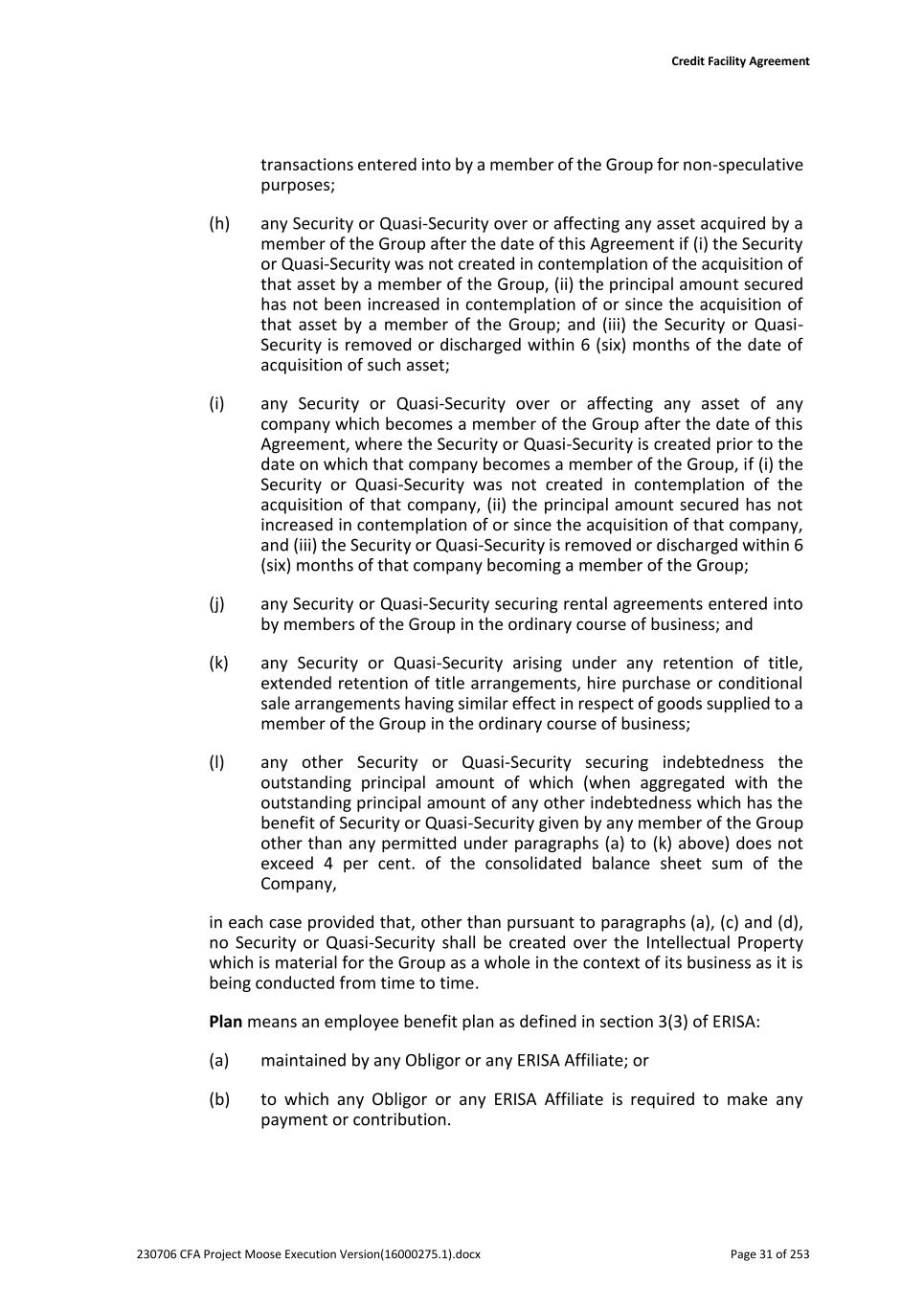
Credit Facility Agreement 230706 CFA Project Moose Execution Version(16000275.1).docx Page 31 of 253 transactions entered into by a member of the Group for non-speculative purposes; (h) any Security or Quasi-Security over or affecting any asset acquired by a member of the Group after the date of this Agreement if (i) the Security or Quasi-Security was not created in contemplation of the acquisition of that asset by a member of the Group, (ii) the principal amount secured has not been increased in contemplation of or since the acquisition of that asset by a member of the Group; and (iii) the Security or Quasi- Security is removed or discharged within 6 (six) months of the date of acquisition of such asset; (i) any Security or Quasi-Security over or affecting any asset of any company which becomes a member of the Group after the date of this Agreement, where the Security or Quasi-Security is created prior to the date on which that company becomes a member of the Group, if (i) the Security or Quasi-Security was not created in contemplation of the acquisition of that company, (ii) the principal amount secured has not increased in contemplation of or since the acquisition of that company, and (iii) the Security or Quasi-Security is removed or discharged within 6 (six) months of that company becoming a member of the Group; (j) any Security or Quasi-Security securing rental agreements entered into by members of the Group in the ordinary course of business; and (k) any Security or Quasi-Security arising under any retention of title, extended retention of title arrangements, hire purchase or conditional sale arrangements having similar effect in respect of goods supplied to a member of the Group in the ordinary course of business; (l) any other Security or Quasi-Security securing indebtedness the outstanding principal amount of which (when aggregated with the outstanding principal amount of any other indebtedness which has the benefit of Security or Quasi-Security given by any member of the Group other than any permitted under paragraphs (a) to (k) above) does not exceed 4 per cent. of the consolidated balance sheet sum of the Company, in each case provided that, other than pursuant to paragraphs (a), (c) and (d), no Security or Quasi-Security shall be created over the Intellectual Property which is material for the Group as a whole in the context of its business as it is being conducted from time to time. Plan means an employee benefit plan as defined in section 3(3) of ERISA: (a) maintained by any Obligor or any ERISA Affiliate; or (b) to which any Obligor or any ERISA Affiliate is required to make any payment or contribution.
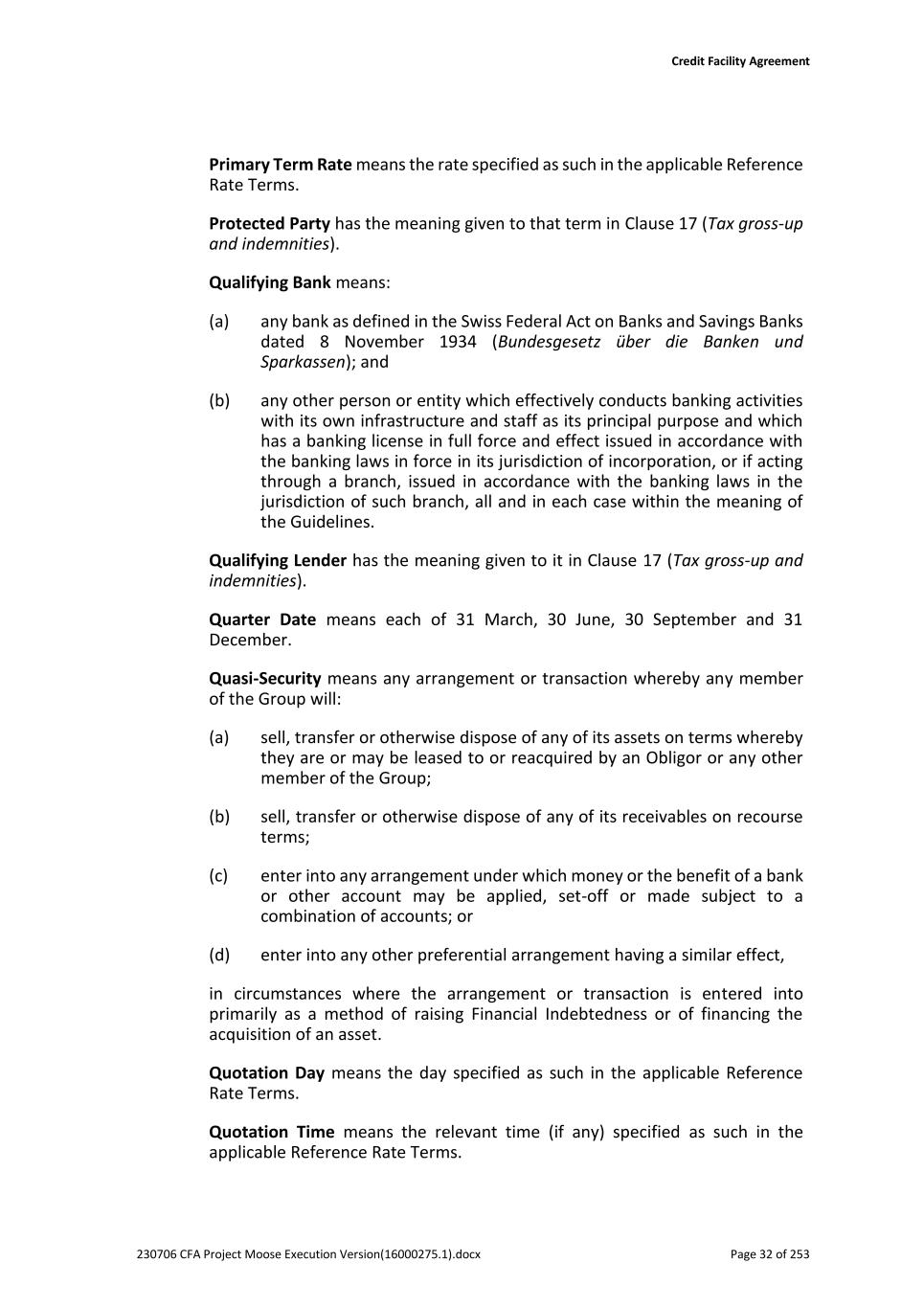
Credit Facility Agreement 230706 CFA Project Moose Execution Version(16000275.1).docx Page 32 of 253 Primary Term Rate means the rate specified as such in the applicable Reference Rate Terms. Protected Party has the meaning given to that term in Clause 17 (Tax gross-up and indemnities). Qualifying Bank means: (a) any bank as defined in the Swiss Federal Act on Banks and Savings Banks dated 8 November 1934 (Bundesgesetz über die Banken und Sparkassen); and (b) any other person or entity which effectively conducts banking activities with its own infrastructure and staff as its principal purpose and which has a banking license in full force and effect issued in accordance with the banking laws in force in its jurisdiction of incorporation, or if acting through a branch, issued in accordance with the banking laws in the jurisdiction of such branch, all and in each case within the meaning of the Guidelines. Qualifying Lender has the meaning given to it in Clause 17 (Tax gross-up and indemnities). Quarter Date means each of 31 March, 30 June, 30 September and 31 December. Quasi-Security means any arrangement or transaction whereby any member of the Group will: (a) sell, transfer or otherwise dispose of any of its assets on terms whereby they are or may be leased to or reacquired by an Obligor or any other member of the Group; (b) sell, transfer or otherwise dispose of any of its receivables on recourse terms; (c) enter into any arrangement under which money or the benefit of a bank or other account may be applied, set-off or made subject to a combination of accounts; or (d) enter into any other preferential arrangement having a similar effect, in circumstances where the arrangement or transaction is entered into primarily as a method of raising Financial Indebtedness or of financing the acquisition of an asset. Quotation Day means the day specified as such in the applicable Reference Rate Terms. Quotation Time means the relevant time (if any) specified as such in the applicable Reference Rate Terms.
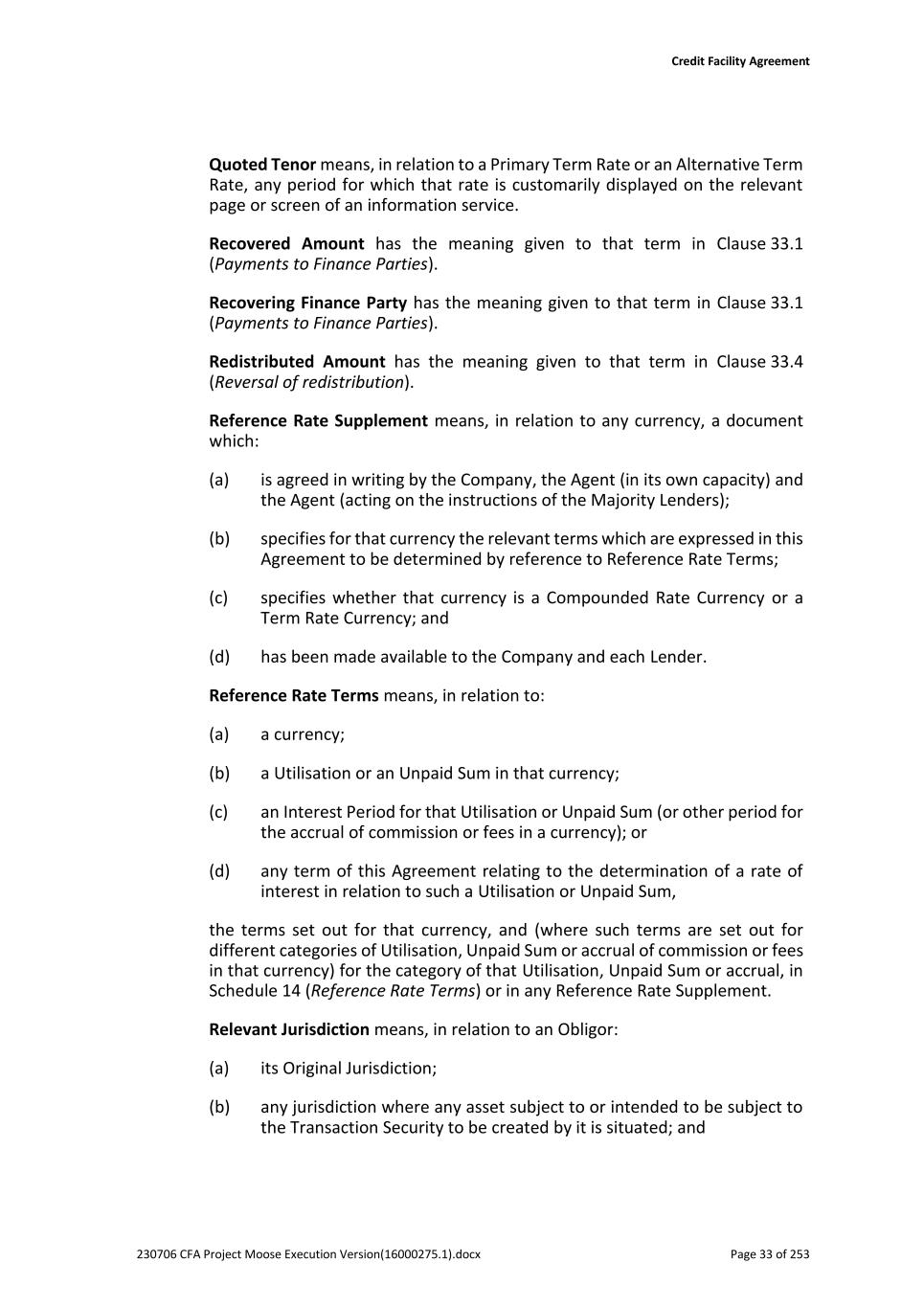
Credit Facility Agreement 230706 CFA Project Moose Execution Version(16000275.1).docx Page 33 of 253 Quoted Tenor means, in relation to a Primary Term Rate or an Alternative Term Rate, any period for which that rate is customarily displayed on the relevant page or screen of an information service. Recovered Amount has the meaning given to that term in Clause 33.1 (Payments to Finance Parties). Recovering Finance Party has the meaning given to that term in Clause 33.1 (Payments to Finance Parties). Redistributed Amount has the meaning given to that term in Clause 33.4 (Reversal of redistribution). Reference Rate Supplement means, in relation to any currency, a document which: (a) is agreed in writing by the Company, the Agent (in its own capacity) and the Agent (acting on the instructions of the Majority Lenders); (b) specifies for that currency the relevant terms which are expressed in this Agreement to be determined by reference to Reference Rate Terms; (c) specifies whether that currency is a Compounded Rate Currency or a Term Rate Currency; and (d) has been made available to the Company and each Lender. Reference Rate Terms means, in relation to: (a) a currency; (b) a Utilisation or an Unpaid Sum in that currency; (c) an Interest Period for that Utilisation or Unpaid Sum (or other period for the accrual of commission or fees in a currency); or (d) any term of this Agreement relating to the determination of a rate of interest in relation to such a Utilisation or Unpaid Sum, the terms set out for that currency, and (where such terms are set out for different categories of Utilisation, Unpaid Sum or accrual of commission or fees in that currency) for the category of that Utilisation, Unpaid Sum or accrual, in Schedule 14 (Reference Rate Terms) or in any Reference Rate Supplement. Relevant Jurisdiction means, in relation to an Obligor: (a) its Original Jurisdiction; (b) any jurisdiction where any asset subject to or intended to be subject to the Transaction Security to be created by it is situated; and
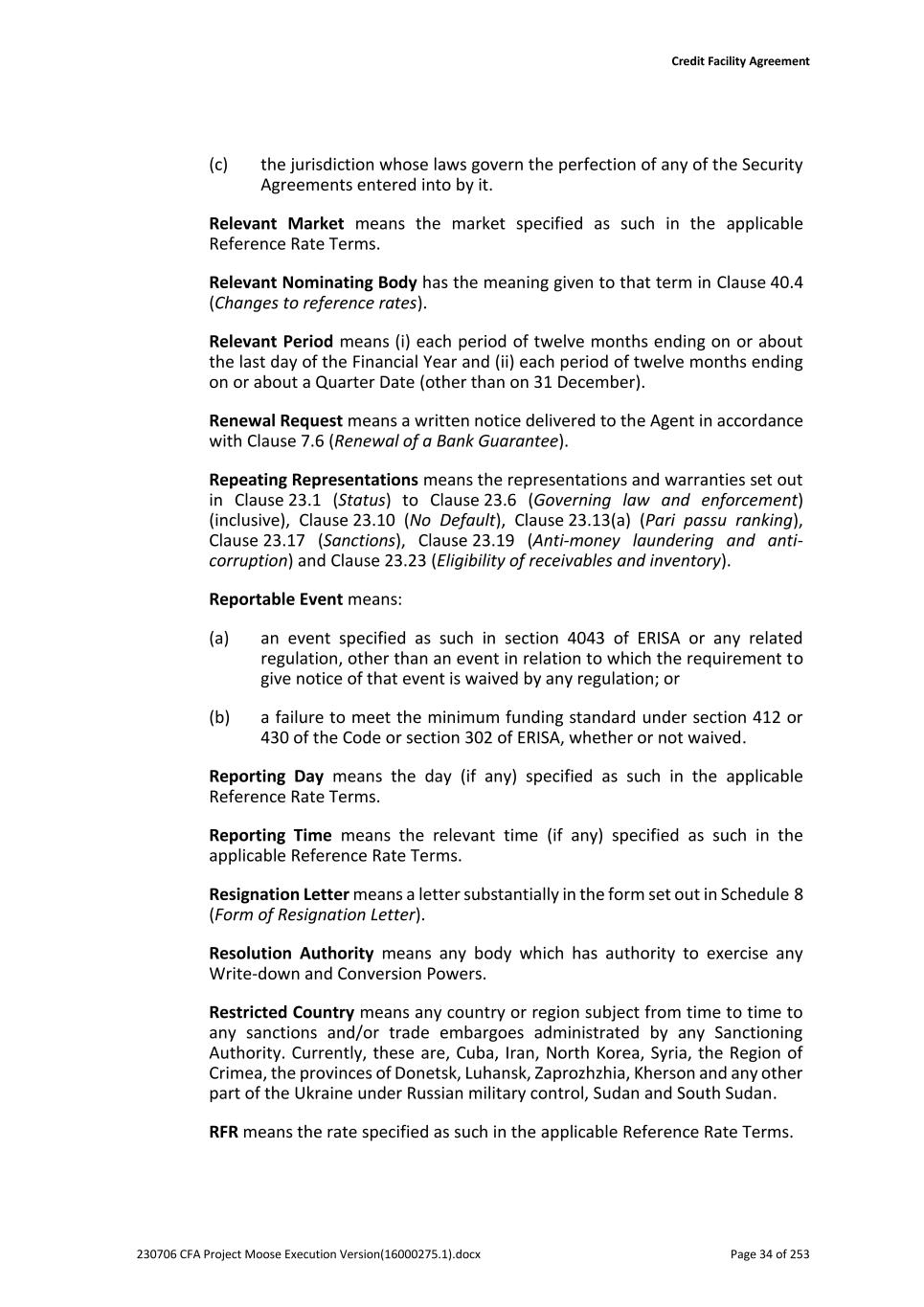
Credit Facility Agreement 230706 CFA Project Moose Execution Version(16000275.1).docx Page 34 of 253 (c) the jurisdiction whose laws govern the perfection of any of the Security Agreements entered into by it. Relevant Market means the market specified as such in the applicable Reference Rate Terms. Relevant Nominating Body has the meaning given to that term in Clause 40.4 (Changes to reference rates). Relevant Period means (i) each period of twelve months ending on or about the last day of the Financial Year and (ii) each period of twelve months ending on or about a Quarter Date (other than on 31 December). Renewal Request means a written notice delivered to the Agent in accordance with Clause 7.6 (Renewal of a Bank Guarantee). Repeating Representations means the representations and warranties set out in Clause 23.1 (Status) to Clause 23.6 (Governing law and enforcement) (inclusive), Clause 23.10 (No Default), Clause 23.13(a) (Pari passu ranking), Clause 23.17 (Sanctions), Clause 23.19 (Anti-money laundering and anti- corruption) and Clause 23.23 (Eligibility of receivables and inventory). Reportable Event means: (a) an event specified as such in section 4043 of ERISA or any related regulation, other than an event in relation to which the requirement to give notice of that event is waived by any regulation; or (b) a failure to meet the minimum funding standard under section 412 or 430 of the Code or section 302 of ERISA, whether or not waived. Reporting Day means the day (if any) specified as such in the applicable Reference Rate Terms. Reporting Time means the relevant time (if any) specified as such in the applicable Reference Rate Terms. Resignation Letter means a letter substantially in the form set out in Schedule 8 (Form of Resignation Letter). Resolution Authority means any body which has authority to exercise any Write-down and Conversion Powers. Restricted Country means any country or region subject from time to time to any sanctions and/or trade embargoes administrated by any Sanctioning Authority. Currently, these are, Cuba, Iran, North Korea, Syria, the Region of Crimea, the provinces of Donetsk, Luhansk, Zaprozhzhia, Kherson and any other part of the Ukraine under Russian military control, Sudan and South Sudan. RFR means the rate specified as such in the applicable Reference Rate Terms.
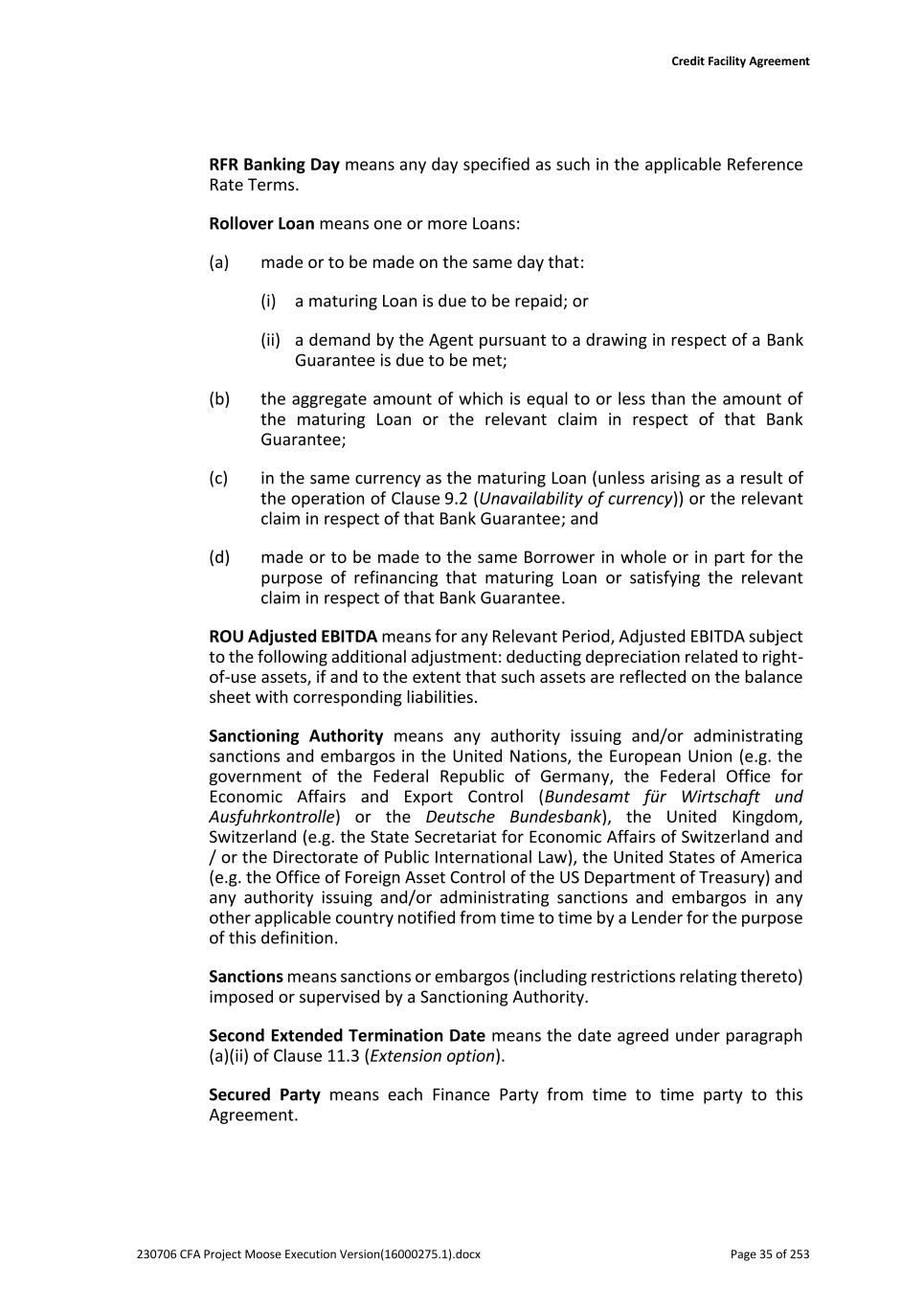
Credit Facility Agreement 230706 CFA Project Moose Execution Version(16000275.1).docx Page 35 of 253 RFR Banking Day means any day specified as such in the applicable Reference Rate Terms. Rollover Loan means one or more Loans: (a) made or to be made on the same day that: (i) a maturing Loan is due to be repaid; or (ii) a demand by the Agent pursuant to a drawing in respect of a Bank Guarantee is due to be met; (b) the aggregate amount of which is equal to or less than the amount of the maturing Loan or the relevant claim in respect of that Bank Guarantee; (c) in the same currency as the maturing Loan (unless arising as a result of the operation of Clause 9.2 (Unavailability of currency)) or the relevant claim in respect of that Bank Guarantee; and (d) made or to be made to the same Borrower in whole or in part for the purpose of refinancing that maturing Loan or satisfying the relevant claim in respect of that Bank Guarantee. ROU Adjusted EBITDA means for any Relevant Period, Adjusted EBITDA subject to the following additional adjustment: deducting depreciation related to right- of-use assets, if and to the extent that such assets are reflected on the balance sheet with corresponding liabilities. Sanctioning Authority means any authority issuing and/or administrating sanctions and embargos in the United Nations, the European Union (e.g. the government of the Federal Republic of Germany, the Federal Office for Economic Affairs and Export Control (Bundesamt für Wirtschaft und Ausfuhrkontrolle) or the Deutsche Bundesbank), the United Kingdom, Switzerland (e.g. the State Secretariat for Economic Affairs of Switzerland and / or the Directorate of Public International Law), the United States of America (e.g. the Office of Foreign Asset Control of the US Department of Treasury) and any authority issuing and/or administrating sanctions and embargos in any other applicable country notified from time to time by a Lender for the purpose of this definition. Sanctions means sanctions or embargos (including restrictions relating thereto) imposed or supervised by a Sanctioning Authority. Second Extended Termination Date means the date agreed under paragraph (a)(ii) of Clause 11.3 (Extension option). Secured Party means each Finance Party from time to time party to this Agreement.
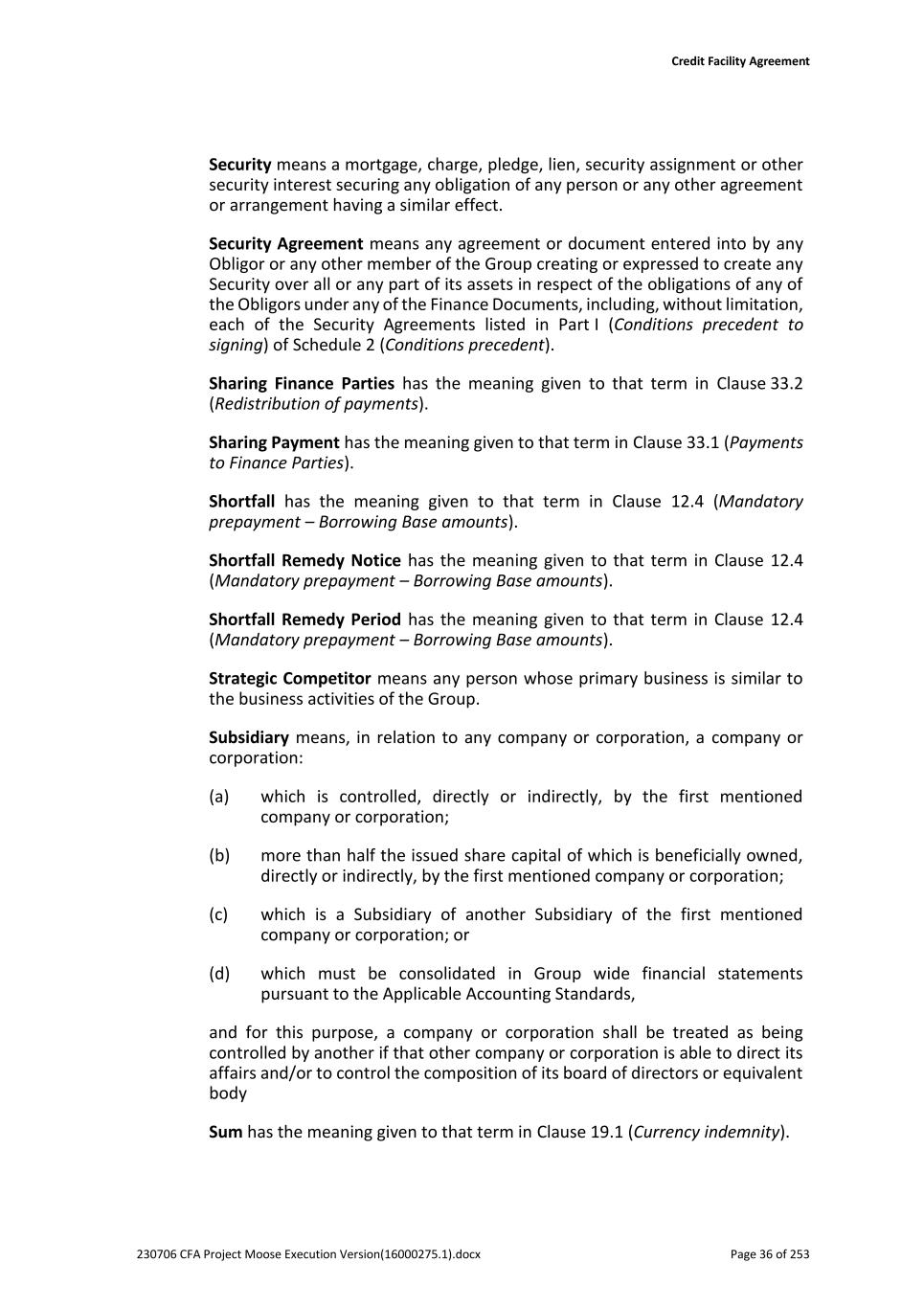
Credit Facility Agreement 230706 CFA Project Moose Execution Version(16000275.1).docx Page 36 of 253 Security means a mortgage, charge, pledge, lien, security assignment or other security interest securing any obligation of any person or any other agreement or arrangement having a similar effect. Security Agreement means any agreement or document entered into by any Obligor or any other member of the Group creating or expressed to create any Security over all or any part of its assets in respect of the obligations of any of the Obligors under any of the Finance Documents, including, without limitation, each of the Security Agreements listed in Part I (Conditions precedent to signing) of Schedule 2 (Conditions precedent). Sharing Finance Parties has the meaning given to that term in Clause 33.2 (Redistribution of payments). Sharing Payment has the meaning given to that term in Clause 33.1 (Payments to Finance Parties). Shortfall has the meaning given to that term in Clause 12.4 (Mandatory prepayment – Borrowing Base amounts). Shortfall Remedy Notice has the meaning given to that term in Clause 12.4 (Mandatory prepayment – Borrowing Base amounts). Shortfall Remedy Period has the meaning given to that term in Clause 12.4 (Mandatory prepayment – Borrowing Base amounts). Strategic Competitor means any person whose primary business is similar to the business activities of the Group. Subsidiary means, in relation to any company or corporation, a company or corporation: (a) which is controlled, directly or indirectly, by the first mentioned company or corporation; (b) more than half the issued share capital of which is beneficially owned, directly or indirectly, by the first mentioned company or corporation; (c) which is a Subsidiary of another Subsidiary of the first mentioned company or corporation; or (d) which must be consolidated in Group wide financial statements pursuant to the Applicable Accounting Standards, and for this purpose, a company or corporation shall be treated as being controlled by another if that other company or corporation is able to direct its affairs and/or to control the composition of its board of directors or equivalent body Sum has the meaning given to that term in Clause 19.1 (Currency indemnity).
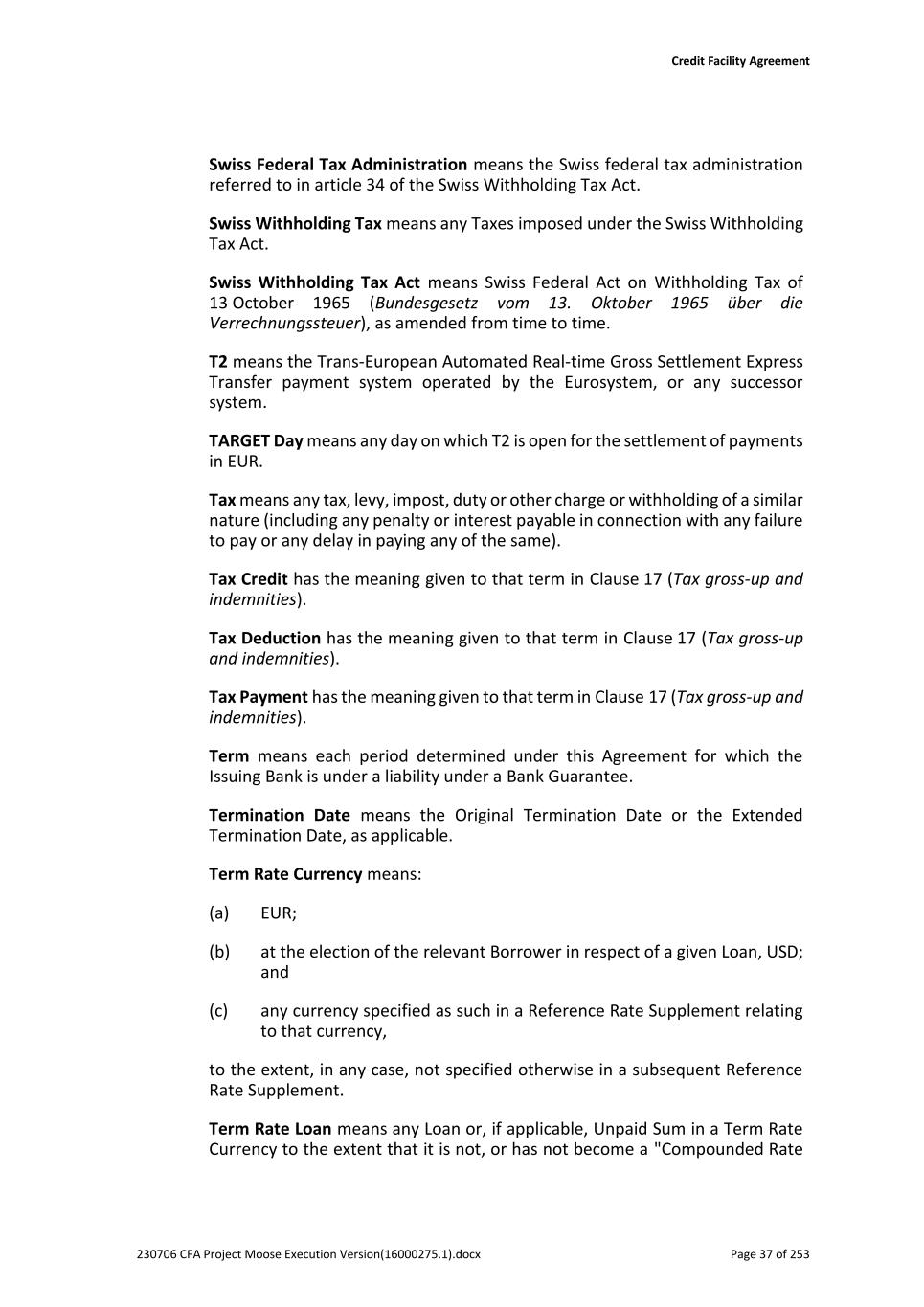
Credit Facility Agreement 230706 CFA Project Moose Execution Version(16000275.1).docx Page 37 of 253 Swiss Federal Tax Administration means the Swiss federal tax administration referred to in article 34 of the Swiss Withholding Tax Act. Swiss Withholding Tax means any Taxes imposed under the Swiss Withholding Tax Act. Swiss Withholding Tax Act means Swiss Federal Act on Withholding Tax of 13 October 1965 (Bundesgesetz vom 13. Oktober 1965 über die Verrechnungssteuer), as amended from time to time. T2 means the Trans-European Automated Real-time Gross Settlement Express Transfer payment system operated by the Eurosystem, or any successor system. TARGET Day means any day on which T2 is open for the settlement of payments in EUR. Tax means any tax, levy, impost, duty or other charge or withholding of a similar nature (including any penalty or interest payable in connection with any failure to pay or any delay in paying any of the same). Tax Credit has the meaning given to that term in Clause 17 (Tax gross-up and indemnities). Tax Deduction has the meaning given to that term in Clause 17 (Tax gross-up and indemnities). Tax Payment has the meaning given to that term in Clause 17 (Tax gross-up and indemnities). Term means each period determined under this Agreement for which the Issuing Bank is under a liability under a Bank Guarantee. Termination Date means the Original Termination Date or the Extended Termination Date, as applicable. Term Rate Currency means: (a) EUR; (b) at the election of the relevant Borrower in respect of a given Loan, USD; and (c) any currency specified as such in a Reference Rate Supplement relating to that currency, to the extent, in any case, not specified otherwise in a subsequent Reference Rate Supplement. Term Rate Loan means any Loan or, if applicable, Unpaid Sum in a Term Rate Currency to the extent that it is not, or has not become a "Compounded Rate
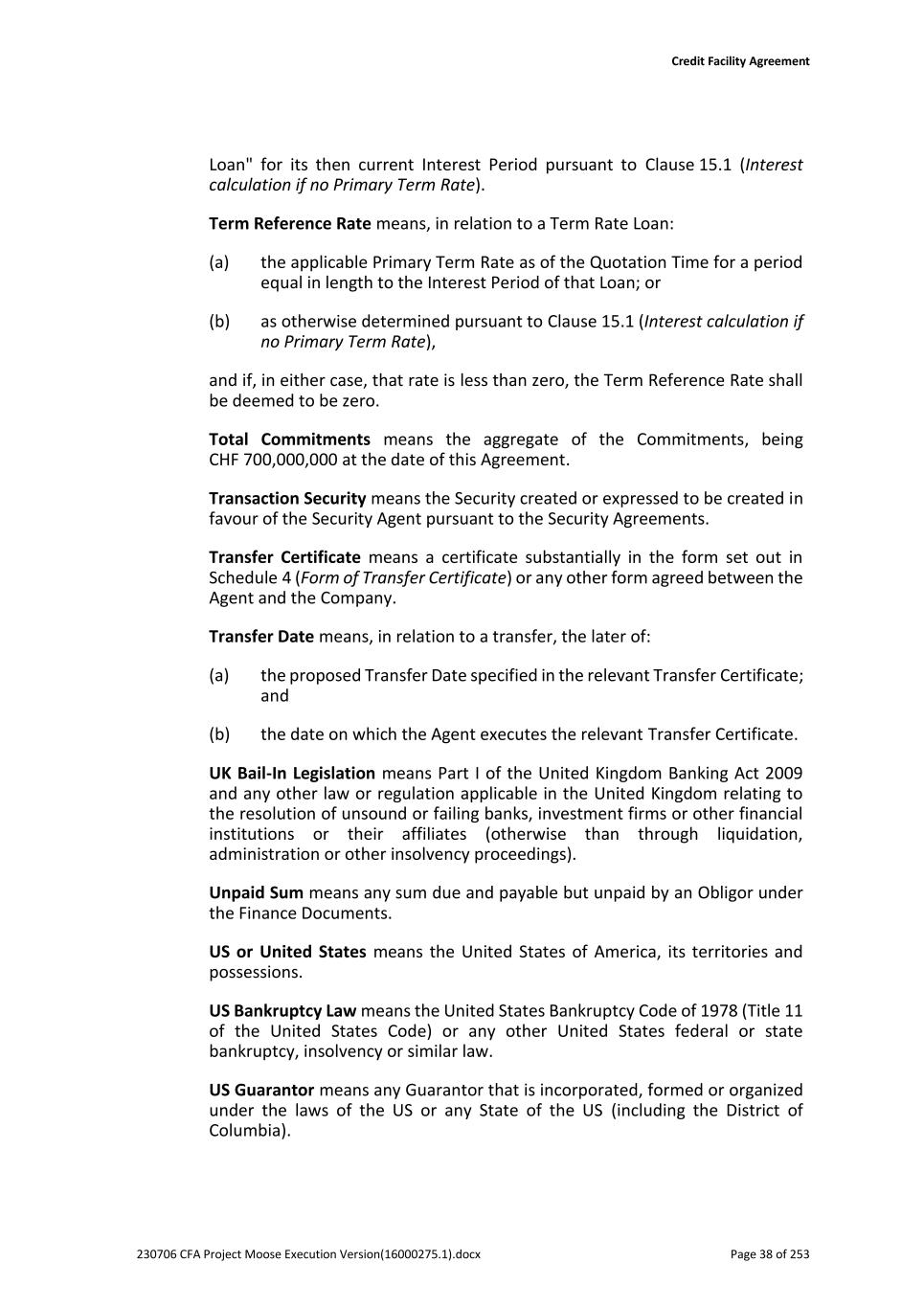
Credit Facility Agreement 230706 CFA Project Moose Execution Version(16000275.1).docx Page 38 of 253 Loan" for its then current Interest Period pursuant to Clause 15.1 (Interest calculation if no Primary Term Rate). Term Reference Rate means, in relation to a Term Rate Loan: (a) the applicable Primary Term Rate as of the Quotation Time for a period equal in length to the Interest Period of that Loan; or (b) as otherwise determined pursuant to Clause 15.1 (Interest calculation if no Primary Term Rate), and if, in either case, that rate is less than zero, the Term Reference Rate shall be deemed to be zero. Total Commitments means the aggregate of the Commitments, being CHF 700,000,000 at the date of this Agreement. Transaction Security means the Security created or expressed to be created in favour of the Security Agent pursuant to the Security Agreements. Transfer Certificate means a certificate substantially in the form set out in Schedule 4 (Form of Transfer Certificate) or any other form agreed between the Agent and the Company. Transfer Date means, in relation to a transfer, the later of: (a) the proposed Transfer Date specified in the relevant Transfer Certificate; and (b) the date on which the Agent executes the relevant Transfer Certificate. UK Bail-In Legislation means Part I of the United Kingdom Banking Act 2009 and any other law or regulation applicable in the United Kingdom relating to the resolution of unsound or failing banks, investment firms or other financial institutions or their affiliates (otherwise than through liquidation, administration or other insolvency proceedings). Unpaid Sum means any sum due and payable but unpaid by an Obligor under the Finance Documents. US or United States means the United States of America, its territories and possessions. US Bankruptcy Law means the United States Bankruptcy Code of 1978 (Title 11 of the United States Code) or any other United States federal or state bankruptcy, insolvency or similar law. US Guarantor means any Guarantor that is incorporated, formed or organized under the laws of the US or any State of the US (including the District of Columbia).
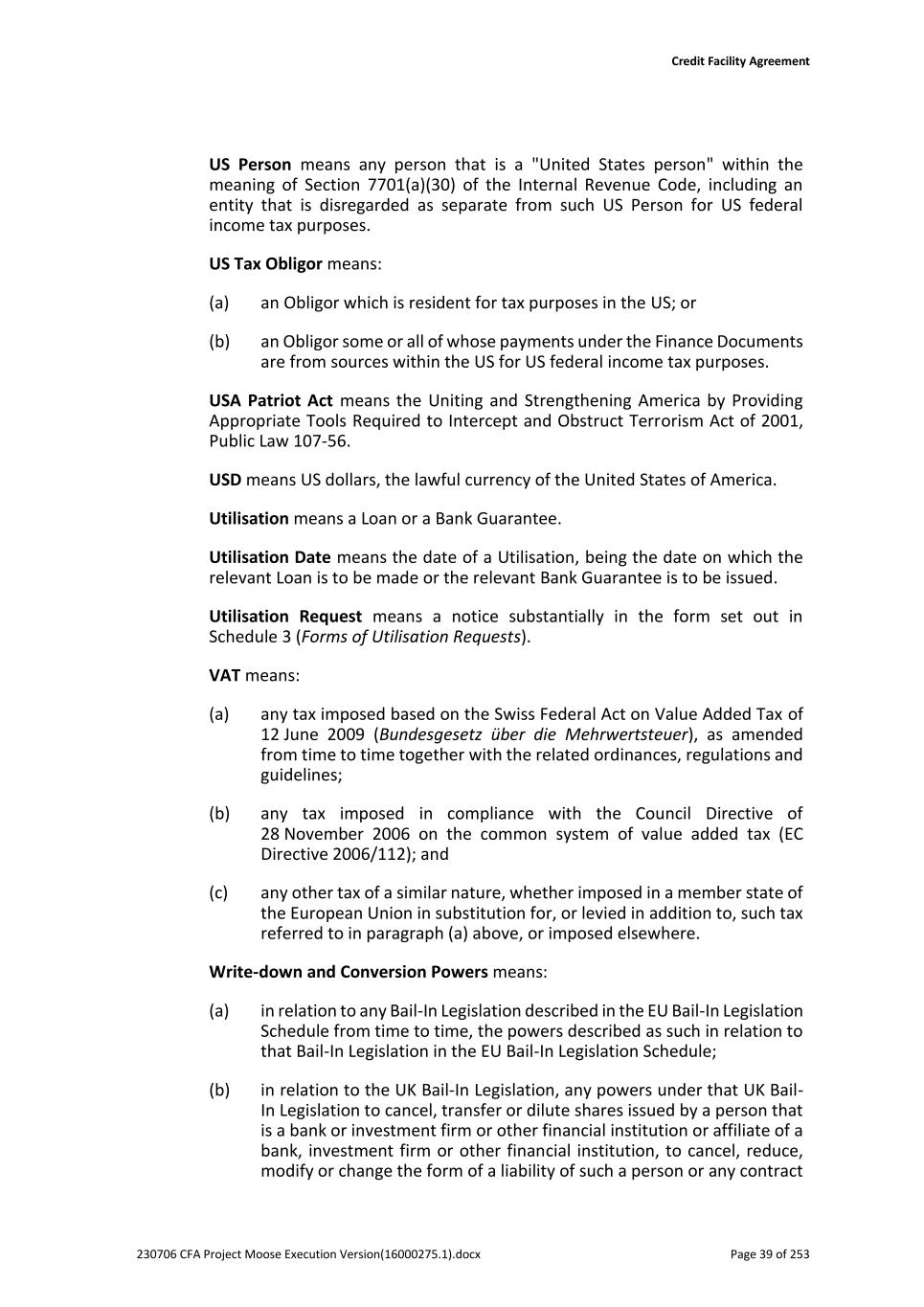
Credit Facility Agreement 230706 CFA Project Moose Execution Version(16000275.1).docx Page 39 of 253 US Person means any person that is a "United States person" within the meaning of Section 7701(a)(30) of the Internal Revenue Code, including an entity that is disregarded as separate from such US Person for US federal income tax purposes. US Tax Obligor means: (a) an Obligor which is resident for tax purposes in the US; or (b) an Obligor some or all of whose payments under the Finance Documents are from sources within the US for US federal income tax purposes. USA Patriot Act means the Uniting and Strengthening America by Providing Appropriate Tools Required to Intercept and Obstruct Terrorism Act of 2001, Public Law 107-56. USD means US dollars, the lawful currency of the United States of America. Utilisation means a Loan or a Bank Guarantee. Utilisation Date means the date of a Utilisation, being the date on which the relevant Loan is to be made or the relevant Bank Guarantee is to be issued. Utilisation Request means a notice substantially in the form set out in Schedule 3 (Forms of Utilisation Requests). VAT means: (a) any tax imposed based on the Swiss Federal Act on Value Added Tax of 12 June 2009 (Bundesgesetz über die Mehrwertsteuer), as amended from time to time together with the related ordinances, regulations and guidelines; (b) any tax imposed in compliance with the Council Directive of 28 November 2006 on the common system of value added tax (EC Directive 2006/112); and (c) any other tax of a similar nature, whether imposed in a member state of the European Union in substitution for, or levied in addition to, such tax referred to in paragraph (a) above, or imposed elsewhere. Write-down and Conversion Powers means: (a) in relation to any Bail-In Legislation described in the EU Bail-In Legislation Schedule from time to time, the powers described as such in relation to that Bail-In Legislation in the EU Bail-In Legislation Schedule; (b) in relation to the UK Bail-In Legislation, any powers under that UK Bail- In Legislation to cancel, transfer or dilute shares issued by a person that is a bank or investment firm or other financial institution or affiliate of a bank, investment firm or other financial institution, to cancel, reduce, modify or change the form of a liability of such a person or any contract
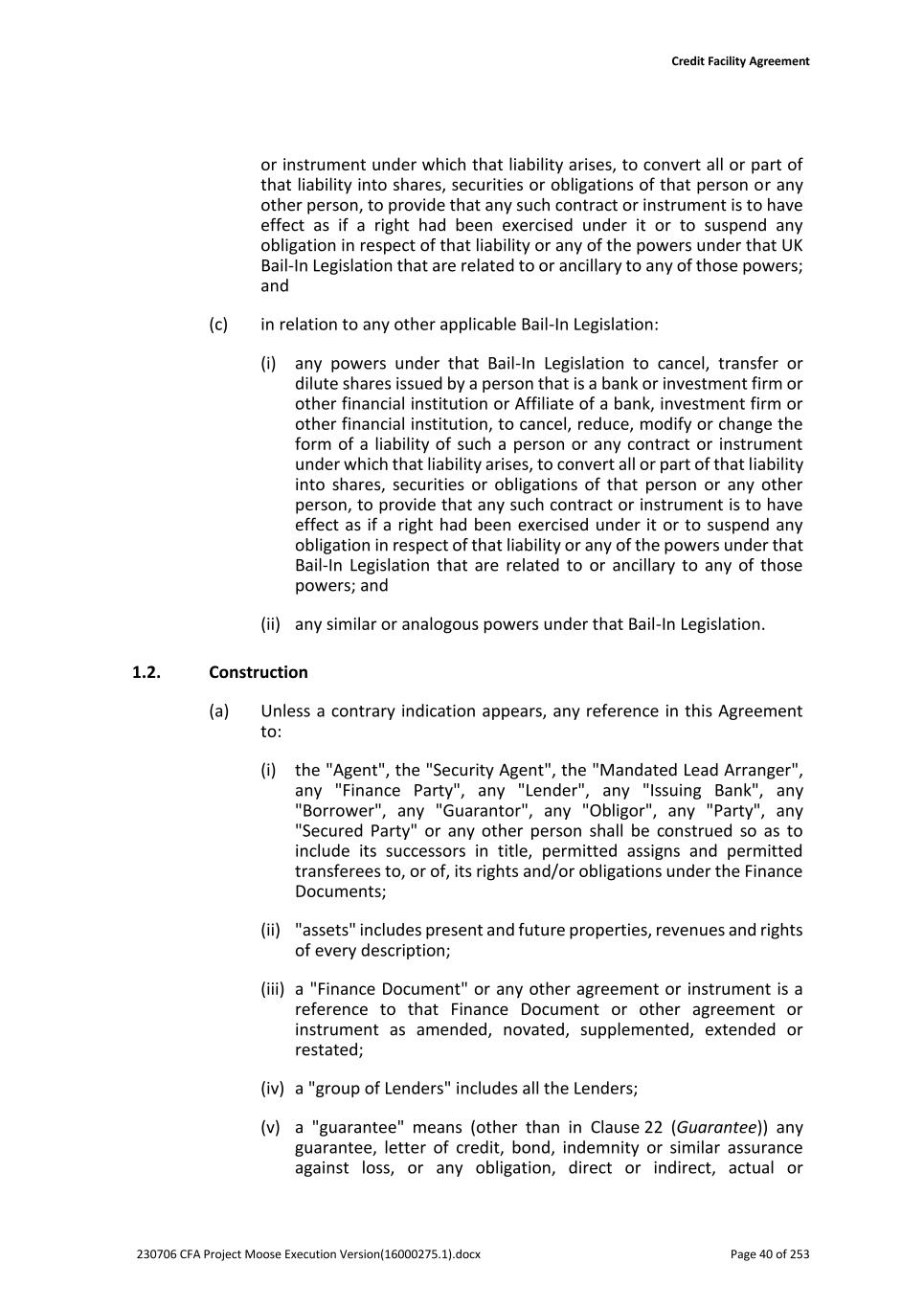
Credit Facility Agreement 230706 CFA Project Moose Execution Version(16000275.1).docx Page 40 of 253 or instrument under which that liability arises, to convert all or part of that liability into shares, securities or obligations of that person or any other person, to provide that any such contract or instrument is to have effect as if a right had been exercised under it or to suspend any obligation in respect of that liability or any of the powers under that UK Bail-In Legislation that are related to or ancillary to any of those powers; and (c) in relation to any other applicable Bail-In Legislation: (i) any powers under that Bail-In Legislation to cancel, transfer or dilute shares issued by a person that is a bank or investment firm or other financial institution or Affiliate of a bank, investment firm or other financial institution, to cancel, reduce, modify or change the form of a liability of such a person or any contract or instrument under which that liability arises, to convert all or part of that liability into shares, securities or obligations of that person or any other person, to provide that any such contract or instrument is to have effect as if a right had been exercised under it or to suspend any obligation in respect of that liability or any of the powers under that Bail-In Legislation that are related to or ancillary to any of those powers; and (ii) any similar or analogous powers under that Bail-In Legislation. 1.2. Construction (a) Unless a contrary indication appears, any reference in this Agreement to: (i) the "Agent", the "Security Agent", the "Mandated Lead Arranger", any "Finance Party", any "Lender", any "Issuing Bank", any "Borrower", any "Guarantor", any "Obligor", any "Party", any "Secured Party" or any other person shall be construed so as to include its successors in title, permitted assigns and permitted transferees to, or of, its rights and/or obligations under the Finance Documents; (ii) "assets" includes present and future properties, revenues and rights of every description; (iii) a "Finance Document" or any other agreement or instrument is a reference to that Finance Document or other agreement or instrument as amended, novated, supplemented, extended or restated; (iv) a "group of Lenders" includes all the Lenders; (v) a "guarantee" means (other than in Clause 22 (Guarantee)) any guarantee, letter of credit, bond, indemnity or similar assurance against loss, or any obligation, direct or indirect, actual or
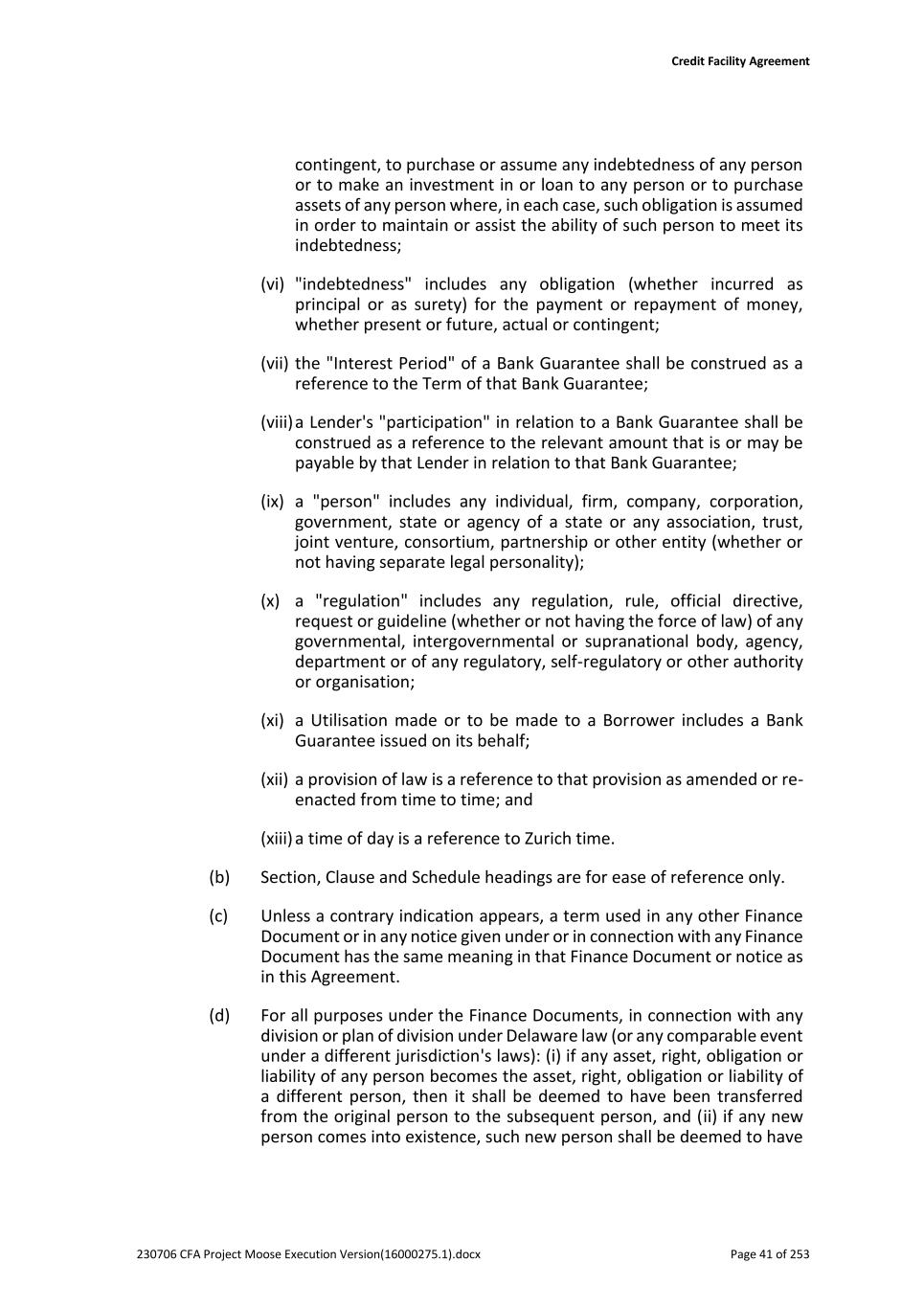
Credit Facility Agreement 230706 CFA Project Moose Execution Version(16000275.1).docx Page 41 of 253 contingent, to purchase or assume any indebtedness of any person or to make an investment in or loan to any person or to purchase assets of any person where, in each case, such obligation is assumed in order to maintain or assist the ability of such person to meet its indebtedness; (vi) "indebtedness" includes any obligation (whether incurred as principal or as surety) for the payment or repayment of money, whether present or future, actual or contingent; (vii) the "Interest Period" of a Bank Guarantee shall be construed as a reference to the Term of that Bank Guarantee; (viii) a Lender's "participation" in relation to a Bank Guarantee shall be construed as a reference to the relevant amount that is or may be payable by that Lender in relation to that Bank Guarantee; (ix) a "person" includes any individual, firm, company, corporation, government, state or agency of a state or any association, trust, joint venture, consortium, partnership or other entity (whether or not having separate legal personality); (x) a "regulation" includes any regulation, rule, official directive, request or guideline (whether or not having the force of law) of any governmental, intergovernmental or supranational body, agency, department or of any regulatory, self-regulatory or other authority or organisation; (xi) a Utilisation made or to be made to a Borrower includes a Bank Guarantee issued on its behalf; (xii) a provision of law is a reference to that provision as amended or re- enacted from time to time; and (xiii) a time of day is a reference to Zurich time. (b) Section, Clause and Schedule headings are for ease of reference only. (c) Unless a contrary indication appears, a term used in any other Finance Document or in any notice given under or in connection with any Finance Document has the same meaning in that Finance Document or notice as in this Agreement. (d) For all purposes under the Finance Documents, in connection with any division or plan of division under Delaware law (or any comparable event under a different jurisdiction's laws): (i) if any asset, right, obligation or liability of any person becomes the asset, right, obligation or liability of a different person, then it shall be deemed to have been transferred from the original person to the subsequent person, and (ii) if any new person comes into existence, such new person shall be deemed to have
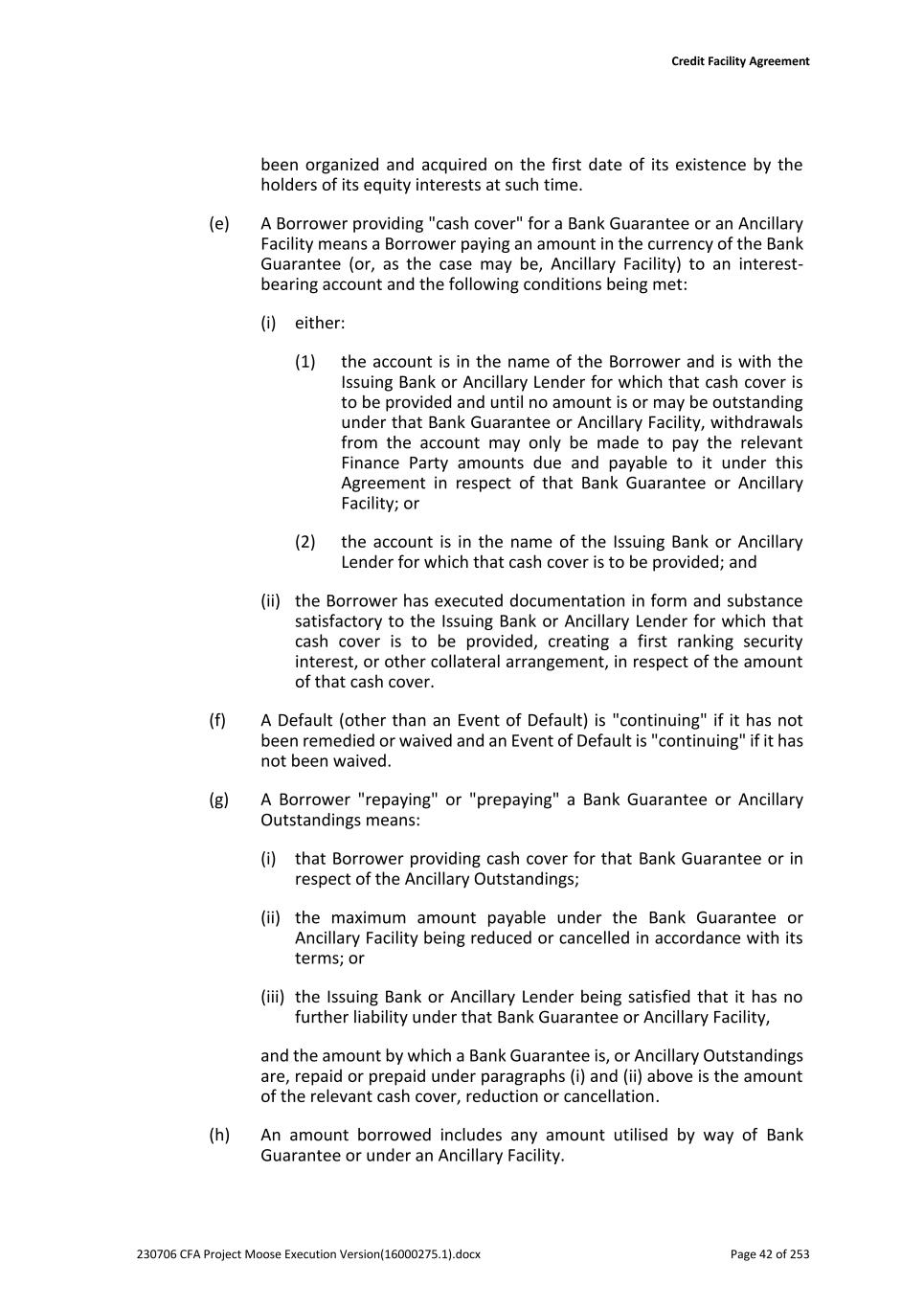
Credit Facility Agreement 230706 CFA Project Moose Execution Version(16000275.1).docx Page 42 of 253 been organized and acquired on the first date of its existence by the holders of its equity interests at such time. (e) A Borrower providing "cash cover" for a Bank Guarantee or an Ancillary Facility means a Borrower paying an amount in the currency of the Bank Guarantee (or, as the case may be, Ancillary Facility) to an interest- bearing account and the following conditions being met: (i) either: (1) the account is in the name of the Borrower and is with the Issuing Bank or Ancillary Lender for which that cash cover is to be provided and until no amount is or may be outstanding under that Bank Guarantee or Ancillary Facility, withdrawals from the account may only be made to pay the relevant Finance Party amounts due and payable to it under this Agreement in respect of that Bank Guarantee or Ancillary Facility; or (2) the account is in the name of the Issuing Bank or Ancillary Lender for which that cash cover is to be provided; and (ii) the Borrower has executed documentation in form and substance satisfactory to the Issuing Bank or Ancillary Lender for which that cash cover is to be provided, creating a first ranking security interest, or other collateral arrangement, in respect of the amount of that cash cover. (f) A Default (other than an Event of Default) is "continuing" if it has not been remedied or waived and an Event of Default is "continuing" if it has not been waived. (g) A Borrower "repaying" or "prepaying" a Bank Guarantee or Ancillary Outstandings means: (i) that Borrower providing cash cover for that Bank Guarantee or in respect of the Ancillary Outstandings; (ii) the maximum amount payable under the Bank Guarantee or Ancillary Facility being reduced or cancelled in accordance with its terms; or (iii) the Issuing Bank or Ancillary Lender being satisfied that it has no further liability under that Bank Guarantee or Ancillary Facility, and the amount by which a Bank Guarantee is, or Ancillary Outstandings are, repaid or prepaid under paragraphs (i) and (ii) above is the amount of the relevant cash cover, reduction or cancellation. (h) An amount borrowed includes any amount utilised by way of Bank Guarantee or under an Ancillary Facility.
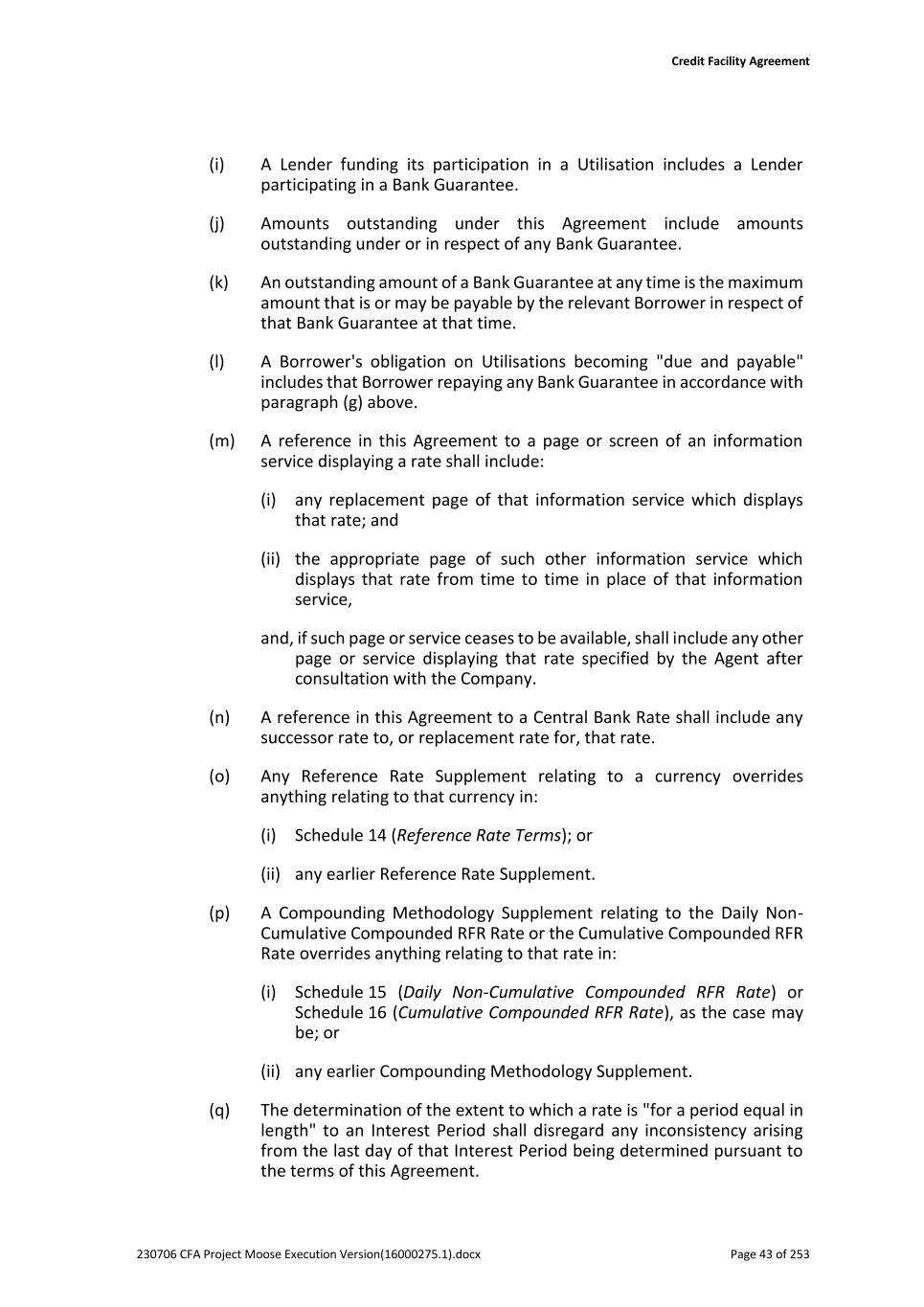
Credit Facility Agreement 230706 CFA Project Moose Execution Version(16000275.1).docx Page 43 of 253 (i) A Lender funding its participation in a Utilisation includes a Lender participating in a Bank Guarantee. (j) Amounts outstanding under this Agreement include amounts outstanding under or in respect of any Bank Guarantee. (k) An outstanding amount of a Bank Guarantee at any time is the maximum amount that is or may be payable by the relevant Borrower in respect of that Bank Guarantee at that time. (l) A Borrower's obligation on Utilisations becoming "due and payable" includes that Borrower repaying any Bank Guarantee in accordance with paragraph (g) above. (m) A reference in this Agreement to a page or screen of an information service displaying a rate shall include: (i) any replacement page of that information service which displays that rate; and (ii) the appropriate page of such other information service which displays that rate from time to time in place of that information service, and, if such page or service ceases to be available, shall include any other page or service displaying that rate specified by the Agent after consultation with the Company. (n) A reference in this Agreement to a Central Bank Rate shall include any successor rate to, or replacement rate for, that rate. (o) Any Reference Rate Supplement relating to a currency overrides anything relating to that currency in: (i) Schedule 14 (Reference Rate Terms); or (ii) any earlier Reference Rate Supplement. (p) A Compounding Methodology Supplement relating to the Daily Non- Cumulative Compounded RFR Rate or the Cumulative Compounded RFR Rate overrides anything relating to that rate in: (i) Schedule 15 (Daily Non-Cumulative Compounded RFR Rate) or Schedule 16 (Cumulative Compounded RFR Rate), as the case may be; or (ii) any earlier Compounding Methodology Supplement. (q) The determination of the extent to which a rate is "for a period equal in length" to an Interest Period shall disregard any inconsistency arising from the last day of that Interest Period being determined pursuant to the terms of this Agreement.
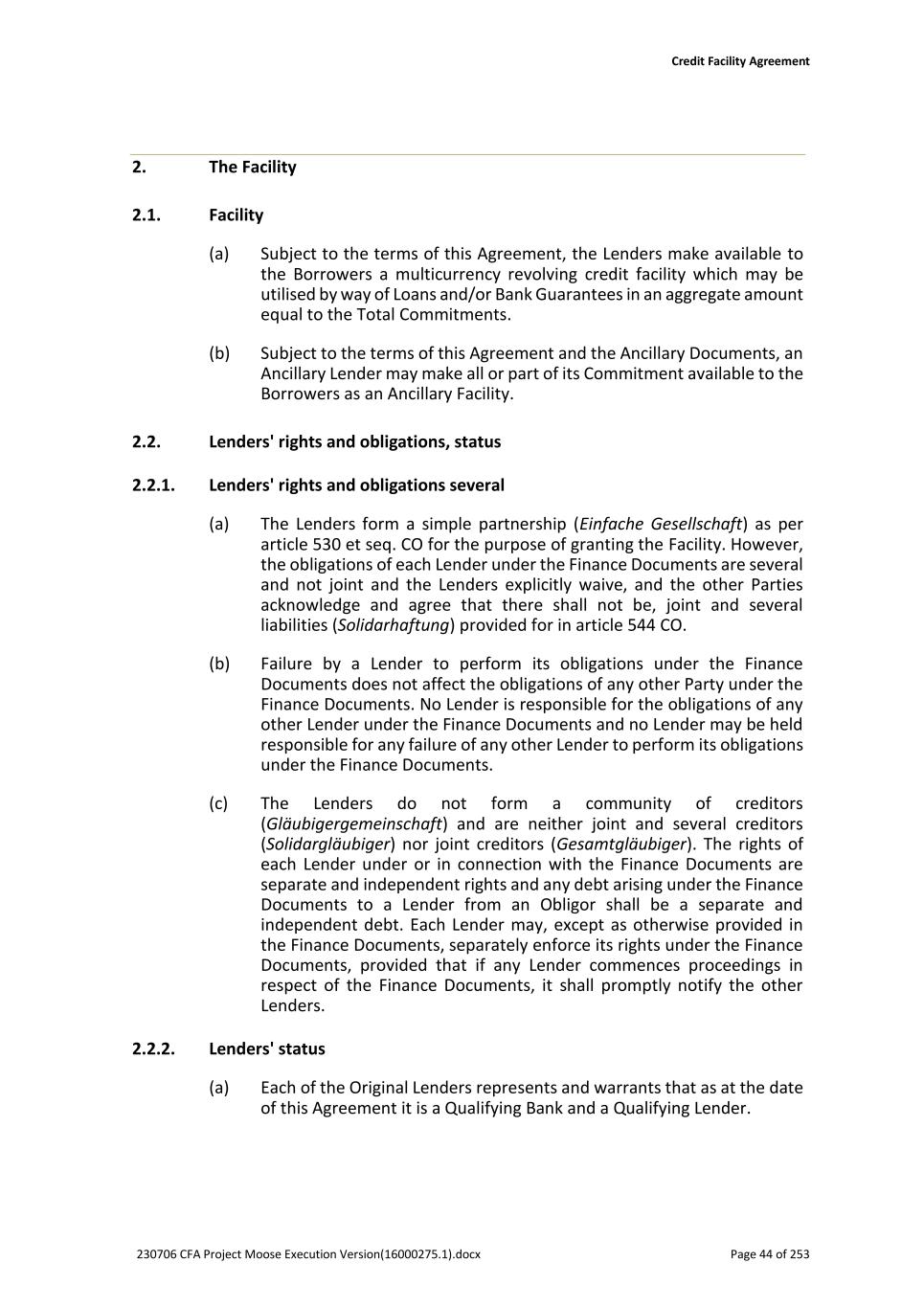
Credit Facility Agreement 230706 CFA Project Moose Execution Version(16000275.1).docx Page 44 of 253 2. The Facility 2.1. Facility (a) Subject to the terms of this Agreement, the Lenders make available to the Borrowers a multicurrency revolving credit facility which may be utilised by way of Loans and/or Bank Guarantees in an aggregate amount equal to the Total Commitments. (b) Subject to the terms of this Agreement and the Ancillary Documents, an Ancillary Lender may make all or part of its Commitment available to the Borrowers as an Ancillary Facility. 2.2. Lenders' rights and obligations, status 2.2.1. Lenders' rights and obligations several (a) The Lenders form a simple partnership (Einfache Gesellschaft) as per article 530 et seq. CO for the purpose of granting the Facility. However, the obligations of each Lender under the Finance Documents are several and not joint and the Lenders explicitly waive, and the other Parties acknowledge and agree that there shall not be, joint and several liabilities (Solidarhaftung) provided for in article 544 CO. (b) Failure by a Lender to perform its obligations under the Finance Documents does not affect the obligations of any other Party under the Finance Documents. No Lender is responsible for the obligations of any other Lender under the Finance Documents and no Lender may be held responsible for any failure of any other Lender to perform its obligations under the Finance Documents. (c) The Lenders do not form a community of creditors (Gläubigergemeinschaft) and are neither joint and several creditors (Solidargläubiger) nor joint creditors (Gesamtgläubiger). The rights of each Lender under or in connection with the Finance Documents are separate and independent rights and any debt arising under the Finance Documents to a Lender from an Obligor shall be a separate and independent debt. Each Lender may, except as otherwise provided in the Finance Documents, separately enforce its rights under the Finance Documents, provided that if any Lender commences proceedings in respect of the Finance Documents, it shall promptly notify the other Lenders. 2.2.2. Lenders' status (a) Each of the Original Lenders represents and warrants that as at the date of this Agreement it is a Qualifying Bank and a Qualifying Lender.
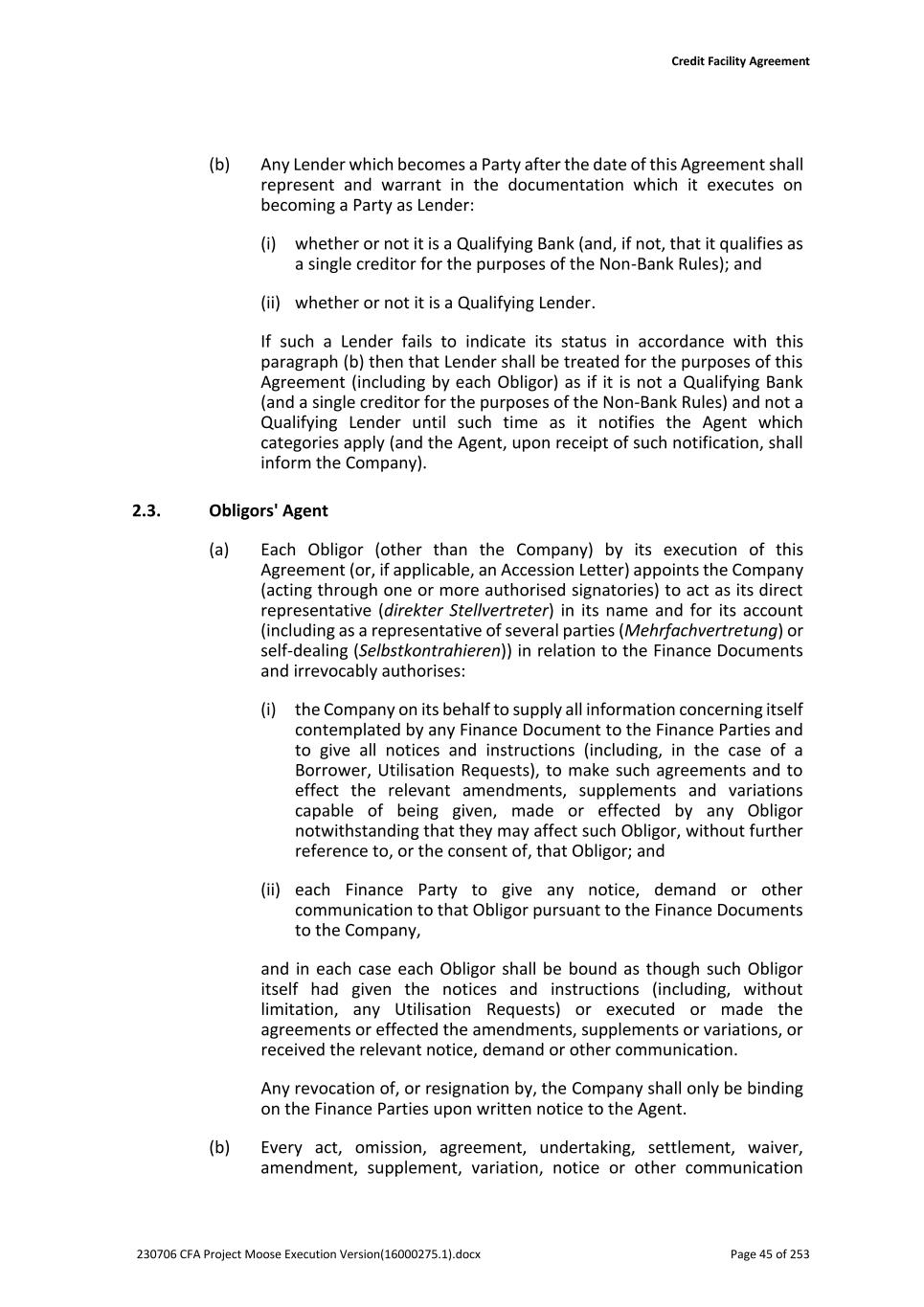
Credit Facility Agreement 230706 CFA Project Moose Execution Version(16000275.1).docx Page 45 of 253 (b) Any Lender which becomes a Party after the date of this Agreement shall represent and warrant in the documentation which it executes on becoming a Party as Lender: (i) whether or not it is a Qualifying Bank (and, if not, that it qualifies as a single creditor for the purposes of the Non-Bank Rules); and (ii) whether or not it is a Qualifying Lender. If such a Lender fails to indicate its status in accordance with this paragraph (b) then that Lender shall be treated for the purposes of this Agreement (including by each Obligor) as if it is not a Qualifying Bank (and a single creditor for the purposes of the Non-Bank Rules) and not a Qualifying Lender until such time as it notifies the Agent which categories apply (and the Agent, upon receipt of such notification, shall inform the Company). 2.3. Obligors' Agent (a) Each Obligor (other than the Company) by its execution of this Agreement (or, if applicable, an Accession Letter) appoints the Company (acting through one or more authorised signatories) to act as its direct representative (direkter Stellvertreter) in its name and for its account (including as a representative of several parties (Mehrfachvertretung) or self-dealing (Selbstkontrahieren)) in relation to the Finance Documents and irrevocably authorises: (i) the Company on its behalf to supply all information concerning itself contemplated by any Finance Document to the Finance Parties and to give all notices and instructions (including, in the case of a Borrower, Utilisation Requests), to make such agreements and to effect the relevant amendments, supplements and variations capable of being given, made or effected by any Obligor notwithstanding that they may affect such Obligor, without further reference to, or the consent of, that Obligor; and (ii) each Finance Party to give any notice, demand or other communication to that Obligor pursuant to the Finance Documents to the Company, and in each case each Obligor shall be bound as though such Obligor itself had given the notices and instructions (including, without limitation, any Utilisation Requests) or executed or made the agreements or effected the amendments, supplements or variations, or received the relevant notice, demand or other communication. Any revocation of, or resignation by, the Company shall only be binding on the Finance Parties upon written notice to the Agent. (b) Every act, omission, agreement, undertaking, settlement, waiver, amendment, supplement, variation, notice or other communication
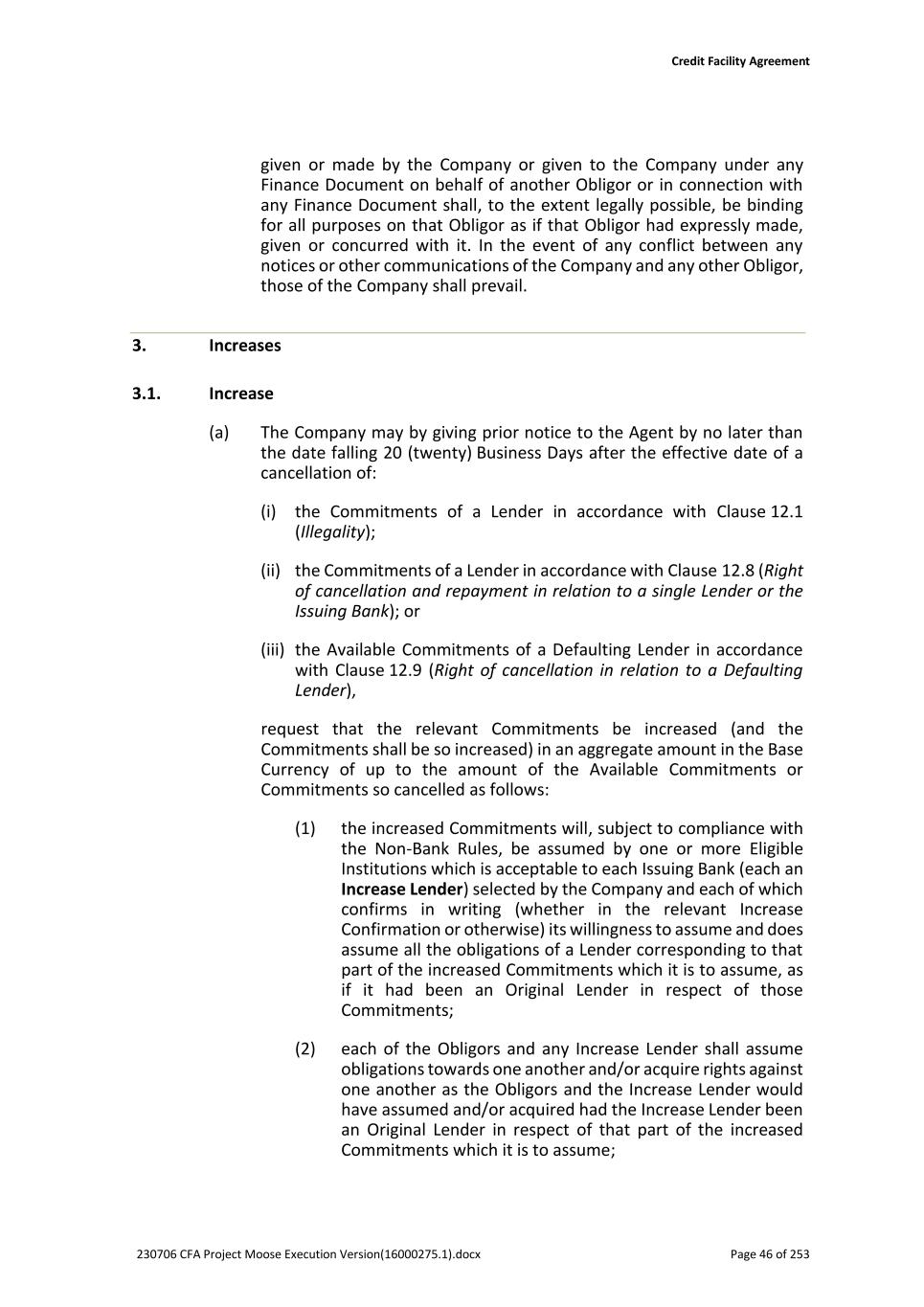
Credit Facility Agreement 230706 CFA Project Moose Execution Version(16000275.1).docx Page 46 of 253 given or made by the Company or given to the Company under any Finance Document on behalf of another Obligor or in connection with any Finance Document shall, to the extent legally possible, be binding for all purposes on that Obligor as if that Obligor had expressly made, given or concurred with it. In the event of any conflict between any notices or other communications of the Company and any other Obligor, those of the Company shall prevail. 3. Increases 3.1. Increase (a) The Company may by giving prior notice to the Agent by no later than the date falling 20 (twenty) Business Days after the effective date of a cancellation of: (i) the Commitments of a Lender in accordance with Clause 12.1 (Illegality); (ii) the Commitments of a Lender in accordance with Clause 12.8 (Right of cancellation and repayment in relation to a single Lender or the Issuing Bank); or (iii) the Available Commitments of a Defaulting Lender in accordance with Clause 12.9 (Right of cancellation in relation to a Defaulting Lender), request that the relevant Commitments be increased (and the Commitments shall be so increased) in an aggregate amount in the Base Currency of up to the amount of the Available Commitments or Commitments so cancelled as follows: (1) the increased Commitments will, subject to compliance with the Non-Bank Rules, be assumed by one or more Eligible Institutions which is acceptable to each Issuing Bank (each an Increase Lender) selected by the Company and each of which confirms in writing (whether in the relevant Increase Confirmation or otherwise) its willingness to assume and does assume all the obligations of a Lender corresponding to that part of the increased Commitments which it is to assume, as if it had been an Original Lender in respect of those Commitments; (2) each of the Obligors and any Increase Lender shall assume obligations towards one another and/or acquire rights against one another as the Obligors and the Increase Lender would have assumed and/or acquired had the Increase Lender been an Original Lender in respect of that part of the increased Commitments which it is to assume;
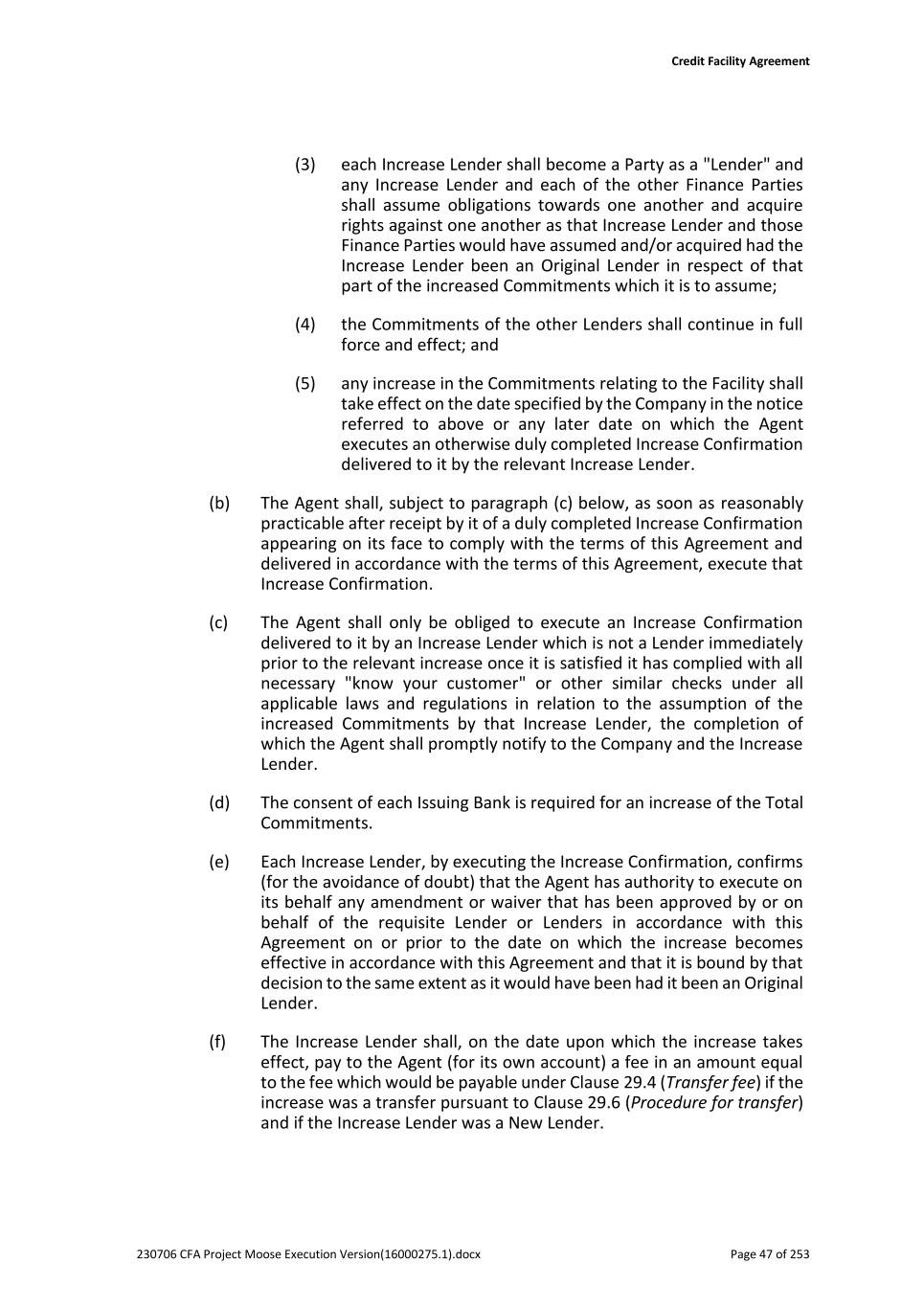
Credit Facility Agreement 230706 CFA Project Moose Execution Version(16000275.1).docx Page 47 of 253 (3) each Increase Lender shall become a Party as a "Lender" and any Increase Lender and each of the other Finance Parties shall assume obligations towards one another and acquire rights against one another as that Increase Lender and those Finance Parties would have assumed and/or acquired had the Increase Lender been an Original Lender in respect of that part of the increased Commitments which it is to assume; (4) the Commitments of the other Lenders shall continue in full force and effect; and (5) any increase in the Commitments relating to the Facility shall take effect on the date specified by the Company in the notice referred to above or any later date on which the Agent executes an otherwise duly completed Increase Confirmation delivered to it by the relevant Increase Lender. (b) The Agent shall, subject to paragraph (c) below, as soon as reasonably practicable after receipt by it of a duly completed Increase Confirmation appearing on its face to comply with the terms of this Agreement and delivered in accordance with the terms of this Agreement, execute that Increase Confirmation. (c) The Agent shall only be obliged to execute an Increase Confirmation delivered to it by an Increase Lender which is not a Lender immediately prior to the relevant increase once it is satisfied it has complied with all necessary "know your customer" or other similar checks under all applicable laws and regulations in relation to the assumption of the increased Commitments by that Increase Lender, the completion of which the Agent shall promptly notify to the Company and the Increase Lender. (d) The consent of each Issuing Bank is required for an increase of the Total Commitments. (e) Each Increase Lender, by executing the Increase Confirmation, confirms (for the avoidance of doubt) that the Agent has authority to execute on its behalf any amendment or waiver that has been approved by or on behalf of the requisite Lender or Lenders in accordance with this Agreement on or prior to the date on which the increase becomes effective in accordance with this Agreement and that it is bound by that decision to the same extent as it would have been had it been an Original Lender. (f) The Increase Lender shall, on the date upon which the increase takes effect, pay to the Agent (for its own account) a fee in an amount equal to the fee which would be payable under Clause 29.4 (Transfer fee) if the increase was a transfer pursuant to Clause 29.6 (Procedure for transfer) and if the Increase Lender was a New Lender.
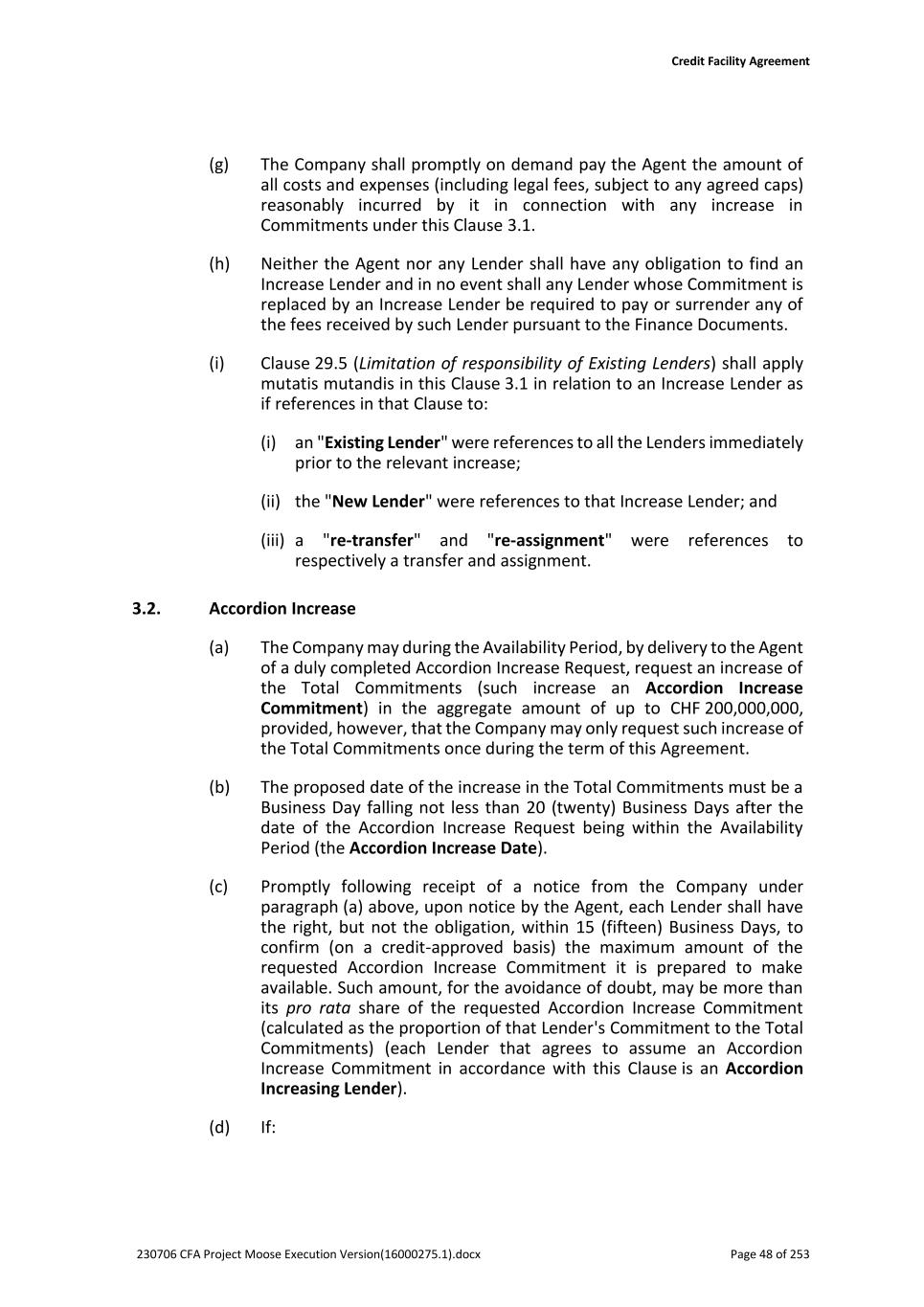
Credit Facility Agreement 230706 CFA Project Moose Execution Version(16000275.1).docx Page 48 of 253 (g) The Company shall promptly on demand pay the Agent the amount of all costs and expenses (including legal fees, subject to any agreed caps) reasonably incurred by it in connection with any increase in Commitments under this Clause 3.1. (h) Neither the Agent nor any Lender shall have any obligation to find an Increase Lender and in no event shall any Lender whose Commitment is replaced by an Increase Lender be required to pay or surrender any of the fees received by such Lender pursuant to the Finance Documents. (i) Clause 29.5 (Limitation of responsibility of Existing Lenders) shall apply mutatis mutandis in this Clause 3.1 in relation to an Increase Lender as if references in that Clause to: (i) an "Existing Lender" were references to all the Lenders immediately prior to the relevant increase; (ii) the "New Lender" were references to that Increase Lender; and (iii) a "re-transfer" and "re-assignment" were references to respectively a transfer and assignment. 3.2. Accordion Increase (a) The Company may during the Availability Period, by delivery to the Agent of a duly completed Accordion Increase Request, request an increase of the Total Commitments (such increase an Accordion Increase Commitment) in the aggregate amount of up to CHF 200,000,000, provided, however, that the Company may only request such increase of the Total Commitments once during the term of this Agreement. (b) The proposed date of the increase in the Total Commitments must be a Business Day falling not less than 20 (twenty) Business Days after the date of the Accordion Increase Request being within the Availability Period (the Accordion Increase Date). (c) Promptly following receipt of a notice from the Company under paragraph (a) above, upon notice by the Agent, each Lender shall have the right, but not the obligation, within 15 (fifteen) Business Days, to confirm (on a credit-approved basis) the maximum amount of the requested Accordion Increase Commitment it is prepared to make available. Such amount, for the avoidance of doubt, may be more than its pro rata share of the requested Accordion Increase Commitment (calculated as the proportion of that Lender's Commitment to the Total Commitments) (each Lender that agrees to assume an Accordion Increase Commitment in accordance with this Clause is an Accordion Increasing Lender). (d) If:
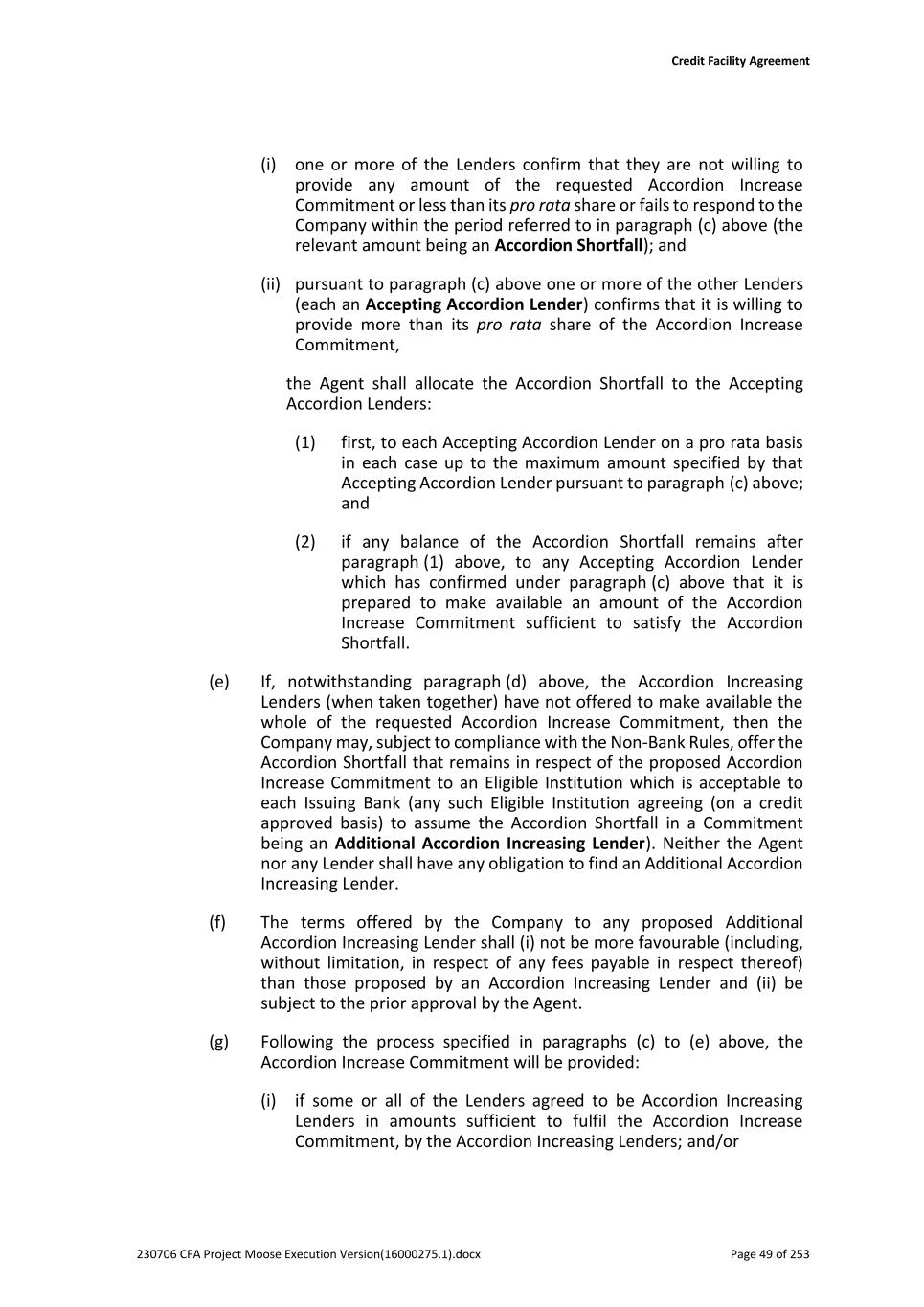
Credit Facility Agreement 230706 CFA Project Moose Execution Version(16000275.1).docx Page 49 of 253 (i) one or more of the Lenders confirm that they are not willing to provide any amount of the requested Accordion Increase Commitment or less than its pro rata share or fails to respond to the Company within the period referred to in paragraph (c) above (the relevant amount being an Accordion Shortfall); and (ii) pursuant to paragraph (c) above one or more of the other Lenders (each an Accepting Accordion Lender) confirms that it is willing to provide more than its pro rata share of the Accordion Increase Commitment, the Agent shall allocate the Accordion Shortfall to the Accepting Accordion Lenders: (1) first, to each Accepting Accordion Lender on a pro rata basis in each case up to the maximum amount specified by that Accepting Accordion Lender pursuant to paragraph (c) above; and (2) if any balance of the Accordion Shortfall remains after paragraph (1) above, to any Accepting Accordion Lender which has confirmed under paragraph (c) above that it is prepared to make available an amount of the Accordion Increase Commitment sufficient to satisfy the Accordion Shortfall. (e) If, notwithstanding paragraph (d) above, the Accordion Increasing Lenders (when taken together) have not offered to make available the whole of the requested Accordion Increase Commitment, then the Company may, subject to compliance with the Non-Bank Rules, offer the Accordion Shortfall that remains in respect of the proposed Accordion Increase Commitment to an Eligible Institution which is acceptable to each Issuing Bank (any such Eligible Institution agreeing (on a credit approved basis) to assume the Accordion Shortfall in a Commitment being an Additional Accordion Increasing Lender). Neither the Agent nor any Lender shall have any obligation to find an Additional Accordion Increasing Lender. (f) The terms offered by the Company to any proposed Additional Accordion Increasing Lender shall (i) not be more favourable (including, without limitation, in respect of any fees payable in respect thereof) than those proposed by an Accordion Increasing Lender and (ii) be subject to the prior approval by the Agent. (g) Following the process specified in paragraphs (c) to (e) above, the Accordion Increase Commitment will be provided: (i) if some or all of the Lenders agreed to be Accordion Increasing Lenders in amounts sufficient to fulfil the Accordion Increase Commitment, by the Accordion Increasing Lenders; and/or
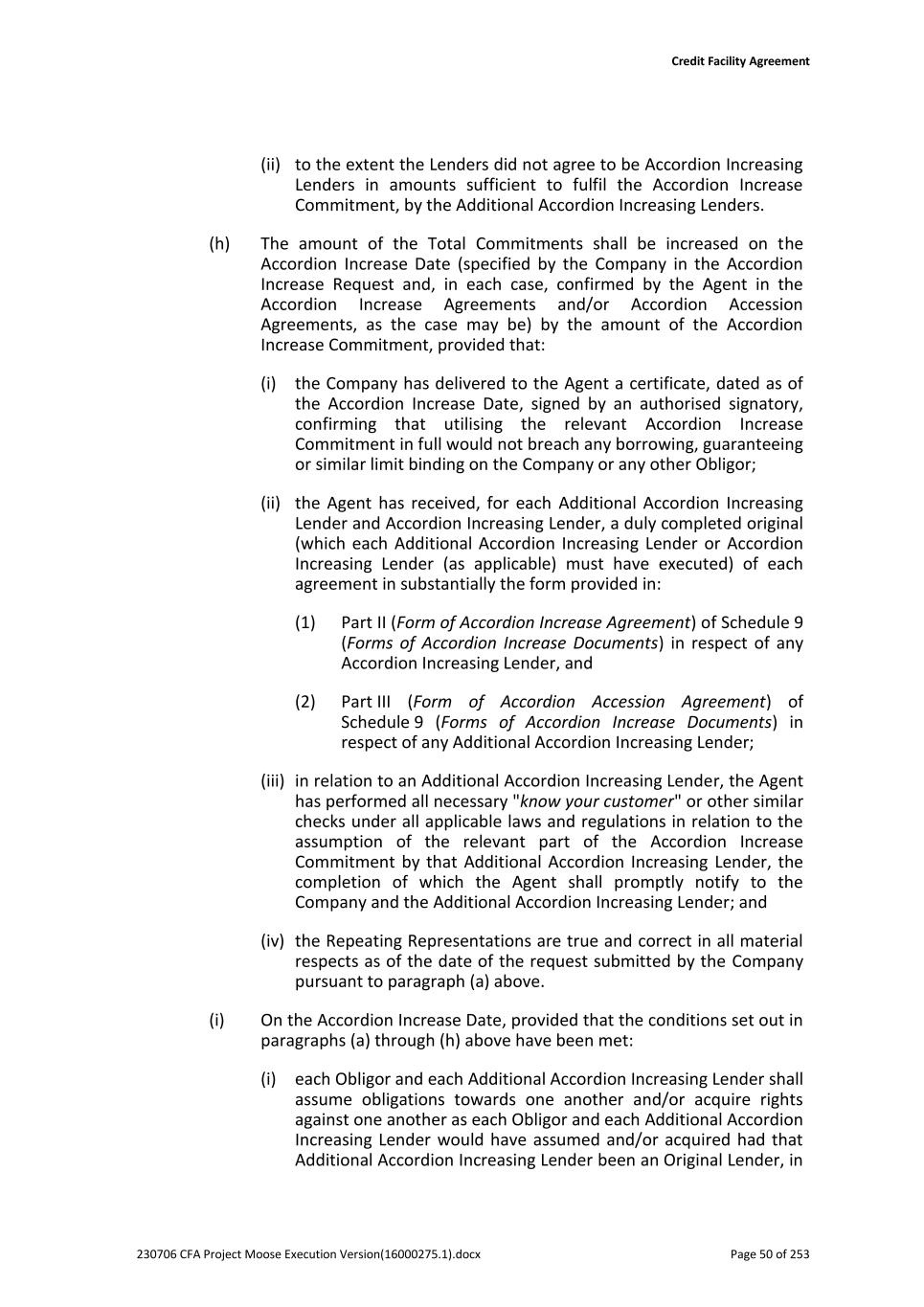
Credit Facility Agreement 230706 CFA Project Moose Execution Version(16000275.1).docx Page 50 of 253 (ii) to the extent the Lenders did not agree to be Accordion Increasing Lenders in amounts sufficient to fulfil the Accordion Increase Commitment, by the Additional Accordion Increasing Lenders. (h) The amount of the Total Commitments shall be increased on the Accordion Increase Date (specified by the Company in the Accordion Increase Request and, in each case, confirmed by the Agent in the Accordion Increase Agreements and/or Accordion Accession Agreements, as the case may be) by the amount of the Accordion Increase Commitment, provided that: (i) the Company has delivered to the Agent a certificate, dated as of the Accordion Increase Date, signed by an authorised signatory, confirming that utilising the relevant Accordion Increase Commitment in full would not breach any borrowing, guaranteeing or similar limit binding on the Company or any other Obligor; (ii) the Agent has received, for each Additional Accordion Increasing Lender and Accordion Increasing Lender, a duly completed original (which each Additional Accordion Increasing Lender or Accordion Increasing Lender (as applicable) must have executed) of each agreement in substantially the form provided in: (1) Part II (Form of Accordion Increase Agreement) of Schedule 9 (Forms of Accordion Increase Documents) in respect of any Accordion Increasing Lender, and (2) Part III (Form of Accordion Accession Agreement) of Schedule 9 (Forms of Accordion Increase Documents) in respect of any Additional Accordion Increasing Lender; (iii) in relation to an Additional Accordion Increasing Lender, the Agent has performed all necessary "know your customer" or other similar checks under all applicable laws and regulations in relation to the assumption of the relevant part of the Accordion Increase Commitment by that Additional Accordion Increasing Lender, the completion of which the Agent shall promptly notify to the Company and the Additional Accordion Increasing Lender; and (iv) the Repeating Representations are true and correct in all material respects as of the date of the request submitted by the Company pursuant to paragraph (a) above. (i) On the Accordion Increase Date, provided that the conditions set out in paragraphs (a) through (h) above have been met: (i) each Obligor and each Additional Accordion Increasing Lender shall assume obligations towards one another and/or acquire rights against one another as each Obligor and each Additional Accordion Increasing Lender would have assumed and/or acquired had that Additional Accordion Increasing Lender been an Original Lender, in
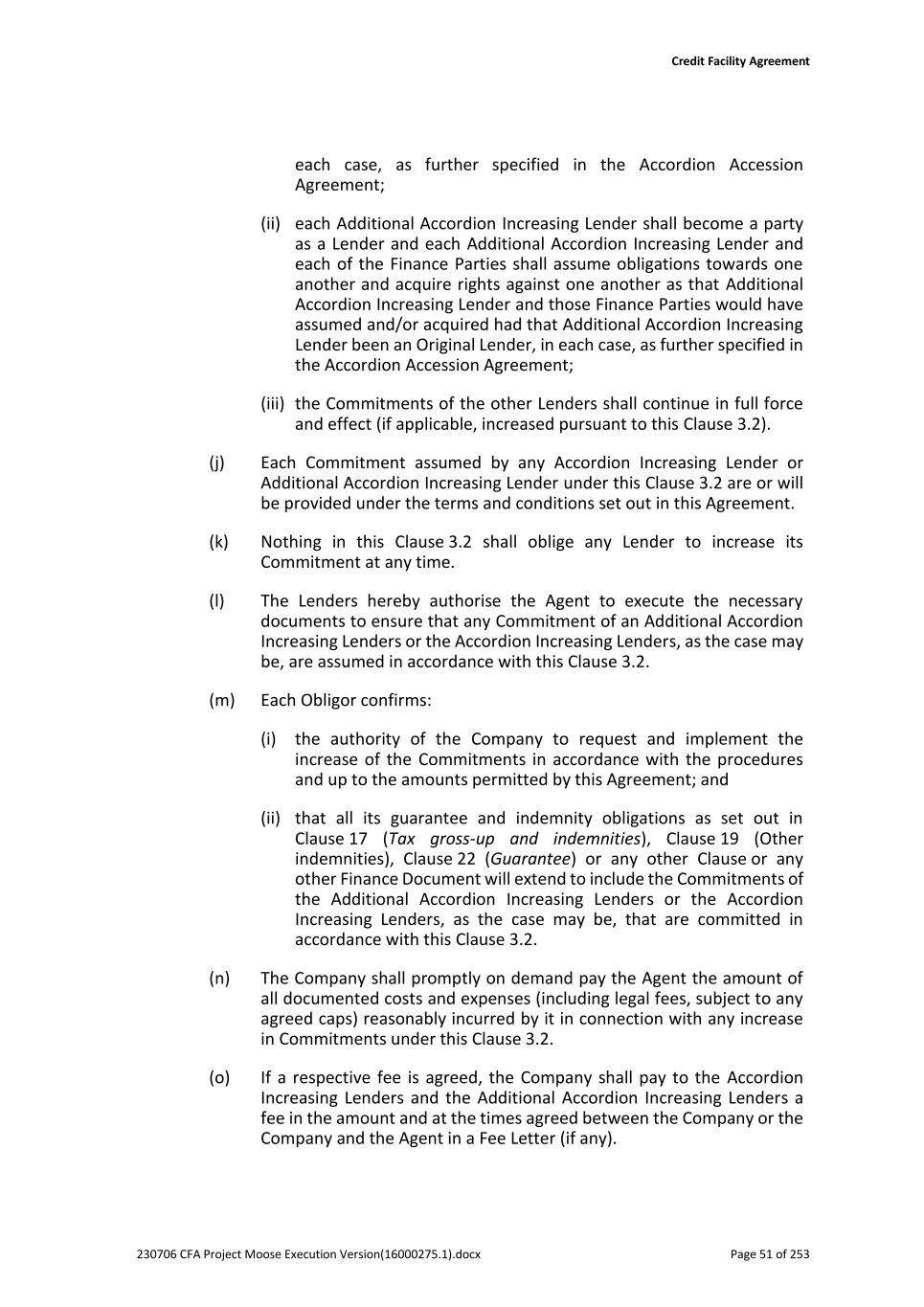
Credit Facility Agreement 230706 CFA Project Moose Execution Version(16000275.1).docx Page 51 of 253 each case, as further specified in the Accordion Accession Agreement; (ii) each Additional Accordion Increasing Lender shall become a party as a Lender and each Additional Accordion Increasing Lender and each of the Finance Parties shall assume obligations towards one another and acquire rights against one another as that Additional Accordion Increasing Lender and those Finance Parties would have assumed and/or acquired had that Additional Accordion Increasing Lender been an Original Lender, in each case, as further specified in the Accordion Accession Agreement; (iii) the Commitments of the other Lenders shall continue in full force and effect (if applicable, increased pursuant to this Clause 3.2). (j) Each Commitment assumed by any Accordion Increasing Lender or Additional Accordion Increasing Lender under this Clause 3.2 are or will be provided under the terms and conditions set out in this Agreement. (k) Nothing in this Clause 3.2 shall oblige any Lender to increase its Commitment at any time. (l) The Lenders hereby authorise the Agent to execute the necessary documents to ensure that any Commitment of an Additional Accordion Increasing Lenders or the Accordion Increasing Lenders, as the case may be, are assumed in accordance with this Clause 3.2. (m) Each Obligor confirms: (i) the authority of the Company to request and implement the increase of the Commitments in accordance with the procedures and up to the amounts permitted by this Agreement; and (ii) that all its guarantee and indemnity obligations as set out in Clause 17 (Tax gross-up and indemnities), Clause 19 (Other indemnities), Clause 22 (Guarantee) or any other Clause or any other Finance Document will extend to include the Commitments of the Additional Accordion Increasing Lenders or the Accordion Increasing Lenders, as the case may be, that are committed in accordance with this Clause 3.2. (n) The Company shall promptly on demand pay the Agent the amount of all documented costs and expenses (including legal fees, subject to any agreed caps) reasonably incurred by it in connection with any increase in Commitments under this Clause 3.2. (o) If a respective fee is agreed, the Company shall pay to the Accordion Increasing Lenders and the Additional Accordion Increasing Lenders a fee in the amount and at the times agreed between the Company or the Company and the Agent in a Fee Letter (if any).
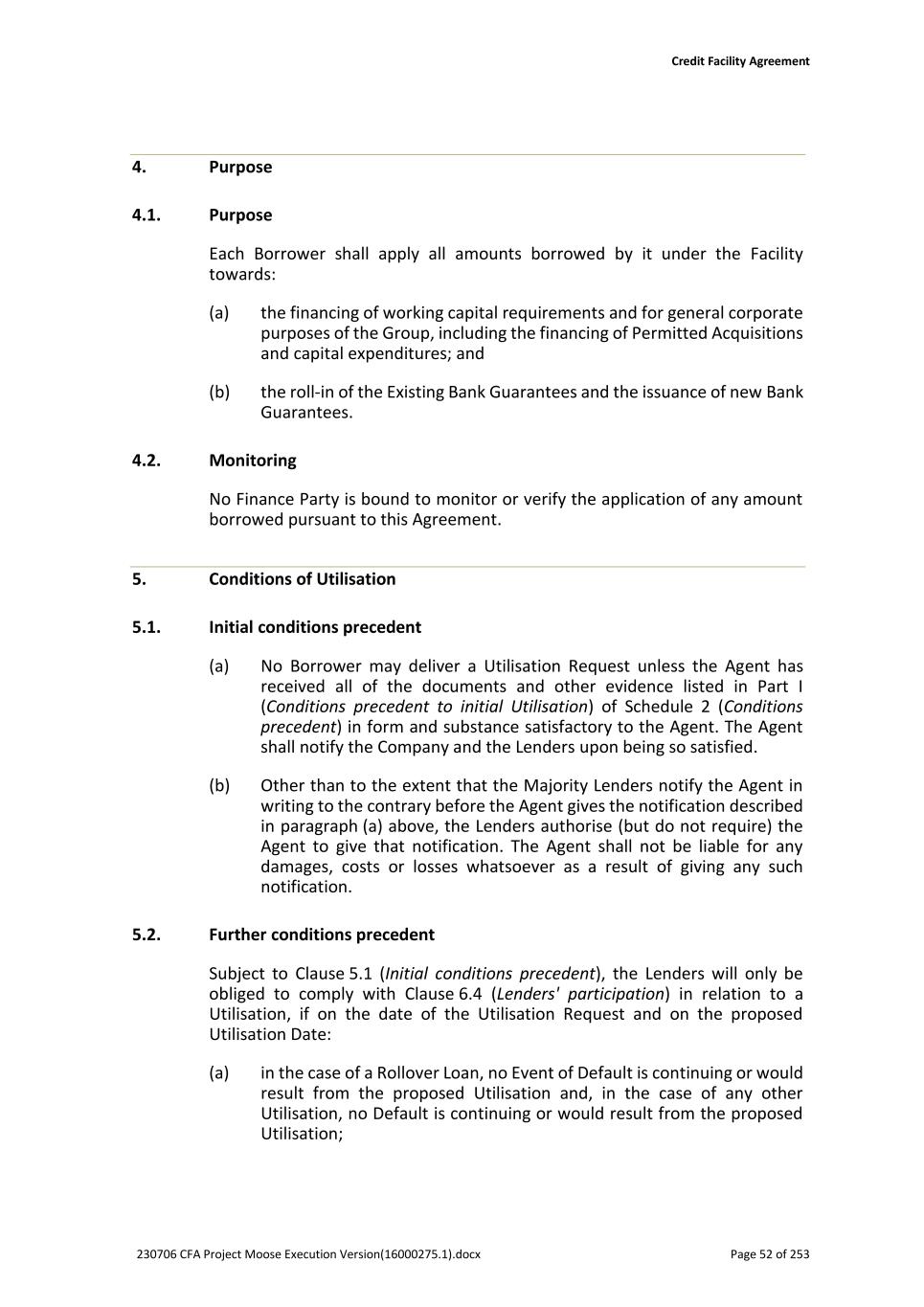
Credit Facility Agreement 230706 CFA Project Moose Execution Version(16000275.1).docx Page 52 of 253 4. Purpose 4.1. Purpose Each Borrower shall apply all amounts borrowed by it under the Facility towards: (a) the financing of working capital requirements and for general corporate purposes of the Group, including the financing of Permitted Acquisitions and capital expenditures; and (b) the roll-in of the Existing Bank Guarantees and the issuance of new Bank Guarantees. 4.2. Monitoring No Finance Party is bound to monitor or verify the application of any amount borrowed pursuant to this Agreement. 5. Conditions of Utilisation 5.1. Initial conditions precedent (a) No Borrower may deliver a Utilisation Request unless the Agent has received all of the documents and other evidence listed in Part I (Conditions precedent to initial Utilisation) of Schedule 2 (Conditions precedent) in form and substance satisfactory to the Agent. The Agent shall notify the Company and the Lenders upon being so satisfied. (b) Other than to the extent that the Majority Lenders notify the Agent in writing to the contrary before the Agent gives the notification described in paragraph (a) above, the Lenders authorise (but do not require) the Agent to give that notification. The Agent shall not be liable for any damages, costs or losses whatsoever as a result of giving any such notification. 5.2. Further conditions precedent Subject to Clause 5.1 (Initial conditions precedent), the Lenders will only be obliged to comply with Clause 6.4 (Lenders' participation) in relation to a Utilisation, if on the date of the Utilisation Request and on the proposed Utilisation Date: (a) in the case of a Rollover Loan, no Event of Default is continuing or would result from the proposed Utilisation and, in the case of any other Utilisation, no Default is continuing or would result from the proposed Utilisation;
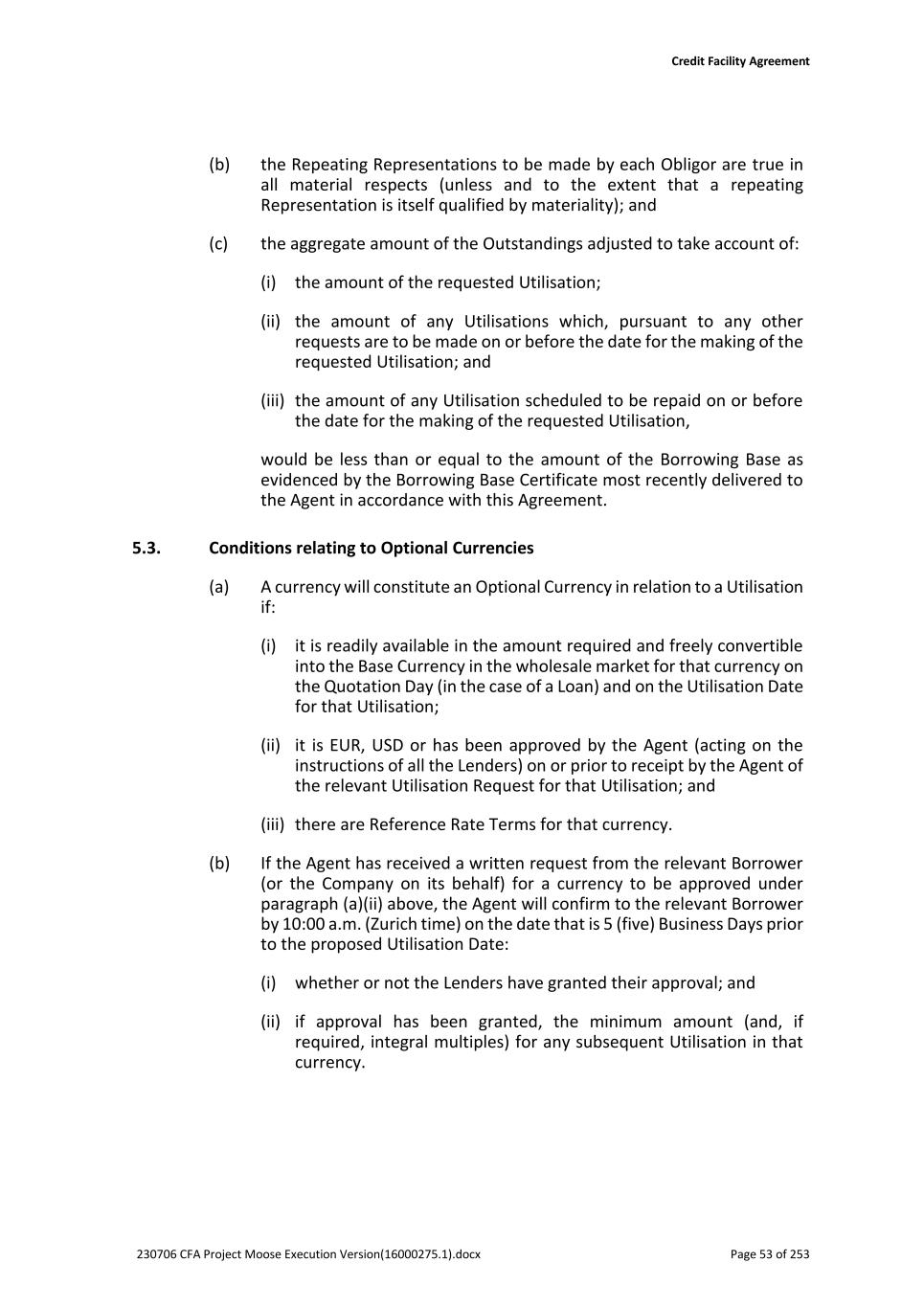
Credit Facility Agreement 230706 CFA Project Moose Execution Version(16000275.1).docx Page 53 of 253 (b) the Repeating Representations to be made by each Obligor are true in all material respects (unless and to the extent that a repeating Representation is itself qualified by materiality); and (c) the aggregate amount of the Outstandings adjusted to take account of: (i) the amount of the requested Utilisation; (ii) the amount of any Utilisations which, pursuant to any other requests are to be made on or before the date for the making of the requested Utilisation; and (iii) the amount of any Utilisation scheduled to be repaid on or before the date for the making of the requested Utilisation, would be less than or equal to the amount of the Borrowing Base as evidenced by the Borrowing Base Certificate most recently delivered to the Agent in accordance with this Agreement. 5.3. Conditions relating to Optional Currencies (a) A currency will constitute an Optional Currency in relation to a Utilisation if: (i) it is readily available in the amount required and freely convertible into the Base Currency in the wholesale market for that currency on the Quotation Day (in the case of a Loan) and on the Utilisation Date for that Utilisation; (ii) it is EUR, USD or has been approved by the Agent (acting on the instructions of all the Lenders) on or prior to receipt by the Agent of the relevant Utilisation Request for that Utilisation; and (iii) there are Reference Rate Terms for that currency. (b) If the Agent has received a written request from the relevant Borrower (or the Company on its behalf) for a currency to be approved under paragraph (a)(ii) above, the Agent will confirm to the relevant Borrower by 10:00 a.m. (Zurich time) on the date that is 5 (five) Business Days prior to the proposed Utilisation Date: (i) whether or not the Lenders have granted their approval; and (ii) if approval has been granted, the minimum amount (and, if required, integral multiples) for any subsequent Utilisation in that currency.
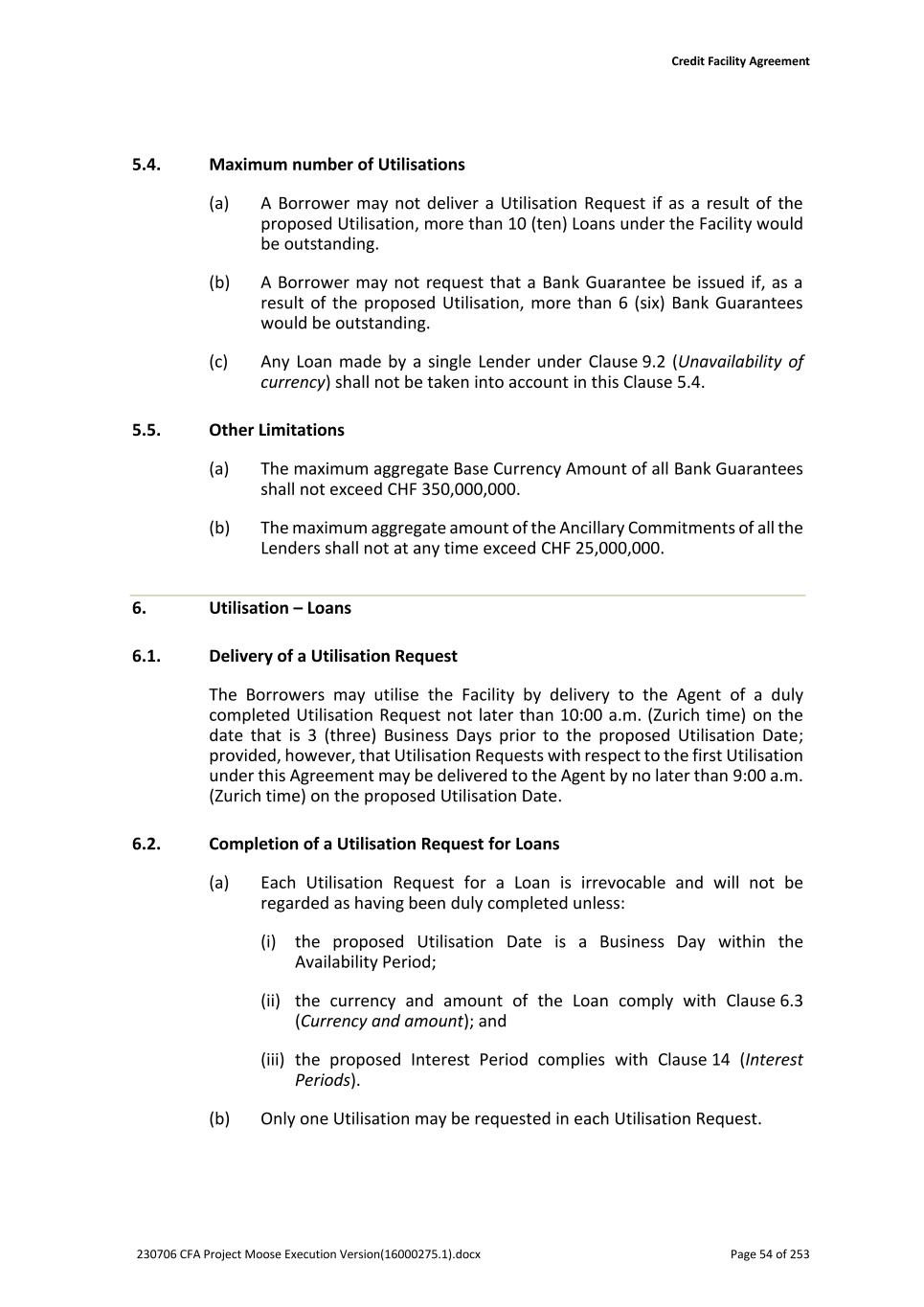
Credit Facility Agreement 230706 CFA Project Moose Execution Version(16000275.1).docx Page 54 of 253 5.4. Maximum number of Utilisations (a) A Borrower may not deliver a Utilisation Request if as a result of the proposed Utilisation, more than 10 (ten) Loans under the Facility would be outstanding. (b) A Borrower may not request that a Bank Guarantee be issued if, as a result of the proposed Utilisation, more than 6 (six) Bank Guarantees would be outstanding. (c) Any Loan made by a single Lender under Clause 9.2 (Unavailability of currency) shall not be taken into account in this Clause 5.4. 5.5. Other Limitations (a) The maximum aggregate Base Currency Amount of all Bank Guarantees shall not exceed CHF 350,000,000. (b) The maximum aggregate amount of the Ancillary Commitments of all the Lenders shall not at any time exceed CHF 25,000,000. 6. Utilisation – Loans 6.1. Delivery of a Utilisation Request The Borrowers may utilise the Facility by delivery to the Agent of a duly completed Utilisation Request not later than 10:00 a.m. (Zurich time) on the date that is 3 (three) Business Days prior to the proposed Utilisation Date; provided, however, that Utilisation Requests with respect to the first Utilisation under this Agreement may be delivered to the Agent by no later than 9:00 a.m. (Zurich time) on the proposed Utilisation Date. 6.2. Completion of a Utilisation Request for Loans (a) Each Utilisation Request for a Loan is irrevocable and will not be regarded as having been duly completed unless: (i) the proposed Utilisation Date is a Business Day within the Availability Period; (ii) the currency and amount of the Loan comply with Clause 6.3 (Currency and amount); and (iii) the proposed Interest Period complies with Clause 14 (Interest Periods). (b) Only one Utilisation may be requested in each Utilisation Request.
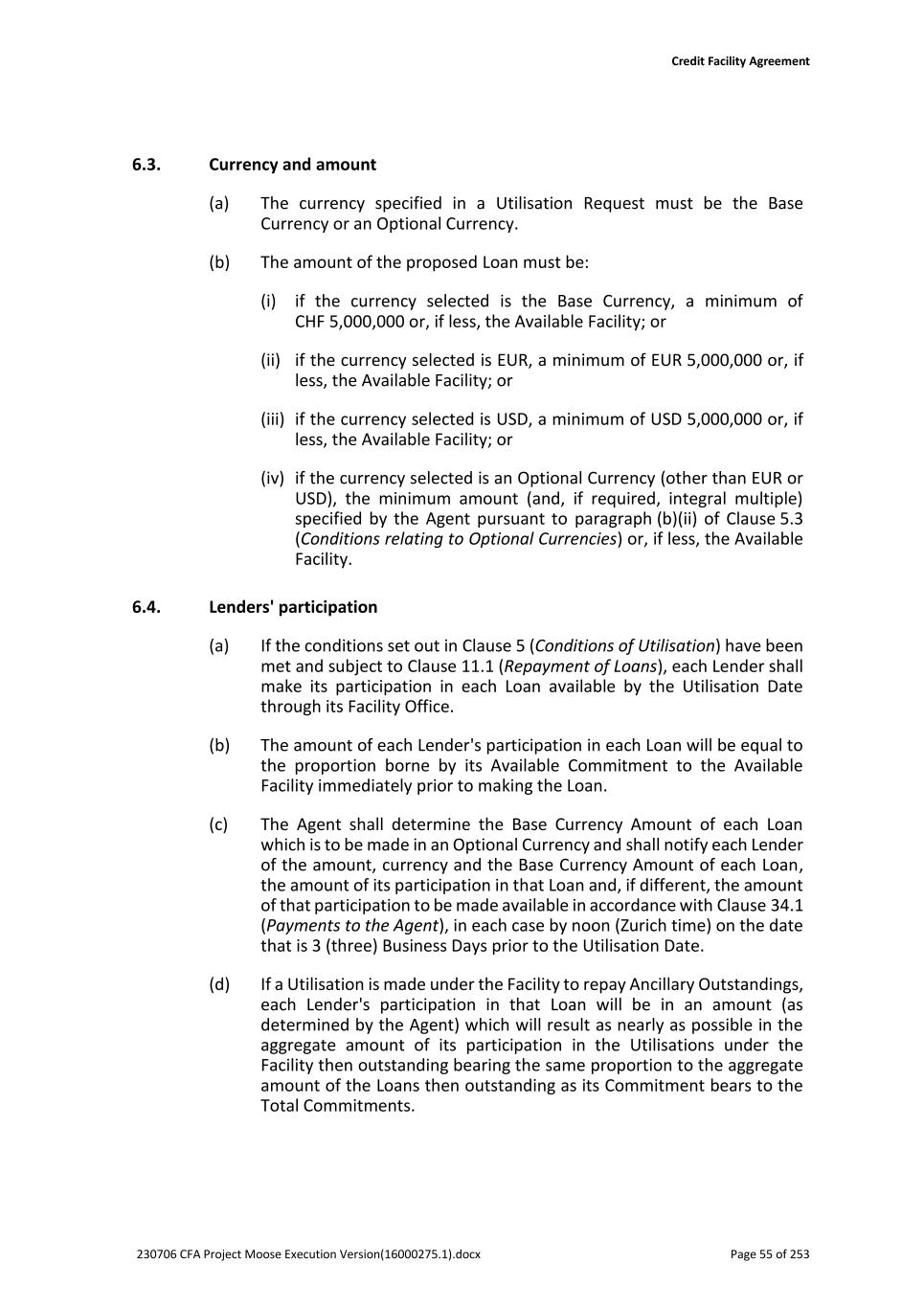
Credit Facility Agreement 230706 CFA Project Moose Execution Version(16000275.1).docx Page 55 of 253 6.3. Currency and amount (a) The currency specified in a Utilisation Request must be the Base Currency or an Optional Currency. (b) The amount of the proposed Loan must be: (i) if the currency selected is the Base Currency, a minimum of CHF 5,000,000 or, if less, the Available Facility; or (ii) if the currency selected is EUR, a minimum of EUR 5,000,000 or, if less, the Available Facility; or (iii) if the currency selected is USD, a minimum of USD 5,000,000 or, if less, the Available Facility; or (iv) if the currency selected is an Optional Currency (other than EUR or USD), the minimum amount (and, if required, integral multiple) specified by the Agent pursuant to paragraph (b)(ii) of Clause 5.3 (Conditions relating to Optional Currencies) or, if less, the Available Facility. 6.4. Lenders' participation (a) If the conditions set out in Clause 5 (Conditions of Utilisation) have been met and subject to Clause 11.1 (Repayment of Loans), each Lender shall make its participation in each Loan available by the Utilisation Date through its Facility Office. (b) The amount of each Lender's participation in each Loan will be equal to the proportion borne by its Available Commitment to the Available Facility immediately prior to making the Loan. (c) The Agent shall determine the Base Currency Amount of each Loan which is to be made in an Optional Currency and shall notify each Lender of the amount, currency and the Base Currency Amount of each Loan, the amount of its participation in that Loan and, if different, the amount of that participation to be made available in accordance with Clause 34.1 (Payments to the Agent), in each case by noon (Zurich time) on the date that is 3 (three) Business Days prior to the Utilisation Date. (d) If a Utilisation is made under the Facility to repay Ancillary Outstandings, each Lender's participation in that Loan will be in an amount (as determined by the Agent) which will result as nearly as possible in the aggregate amount of its participation in the Utilisations under the Facility then outstanding bearing the same proportion to the aggregate amount of the Loans then outstanding as its Commitment bears to the Total Commitments.
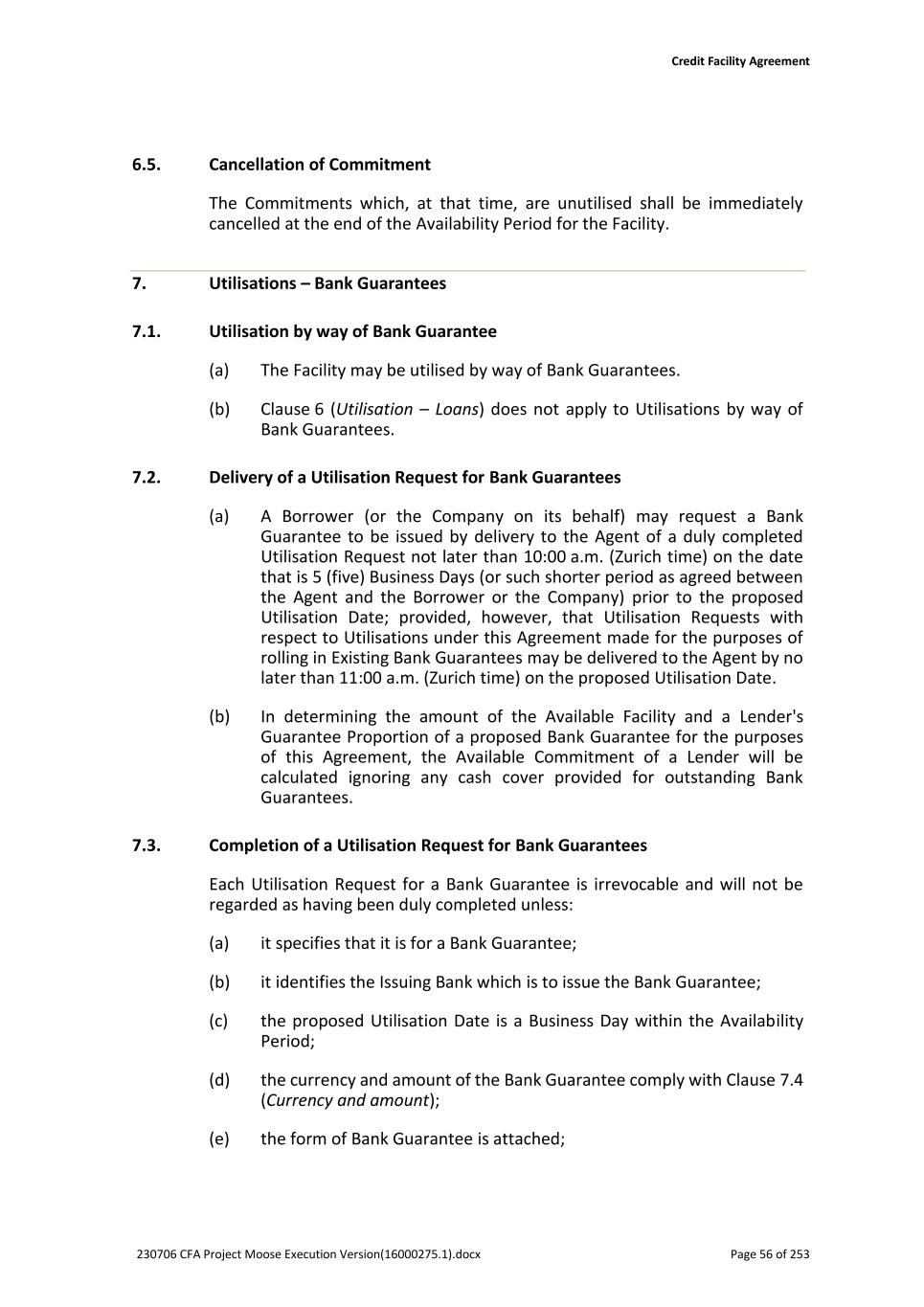
Credit Facility Agreement 230706 CFA Project Moose Execution Version(16000275.1).docx Page 56 of 253 6.5. Cancellation of Commitment The Commitments which, at that time, are unutilised shall be immediately cancelled at the end of the Availability Period for the Facility. 7. Utilisations – Bank Guarantees 7.1. Utilisation by way of Bank Guarantee (a) The Facility may be utilised by way of Bank Guarantees. (b) Clause 6 (Utilisation – Loans) does not apply to Utilisations by way of Bank Guarantees. 7.2. Delivery of a Utilisation Request for Bank Guarantees (a) A Borrower (or the Company on its behalf) may request a Bank Guarantee to be issued by delivery to the Agent of a duly completed Utilisation Request not later than 10:00 a.m. (Zurich time) on the date that is 5 (five) Business Days (or such shorter period as agreed between the Agent and the Borrower or the Company) prior to the proposed Utilisation Date; provided, however, that Utilisation Requests with respect to Utilisations under this Agreement made for the purposes of rolling in Existing Bank Guarantees may be delivered to the Agent by no later than 11:00 a.m. (Zurich time) on the proposed Utilisation Date. (b) In determining the amount of the Available Facility and a Lender's Guarantee Proportion of a proposed Bank Guarantee for the purposes of this Agreement, the Available Commitment of a Lender will be calculated ignoring any cash cover provided for outstanding Bank Guarantees. 7.3. Completion of a Utilisation Request for Bank Guarantees Each Utilisation Request for a Bank Guarantee is irrevocable and will not be regarded as having been duly completed unless: (a) it specifies that it is for a Bank Guarantee; (b) it identifies the Issuing Bank which is to issue the Bank Guarantee; (c) the proposed Utilisation Date is a Business Day within the Availability Period; (d) the currency and amount of the Bank Guarantee comply with Clause 7.4 (Currency and amount); (e) the form of Bank Guarantee is attached;
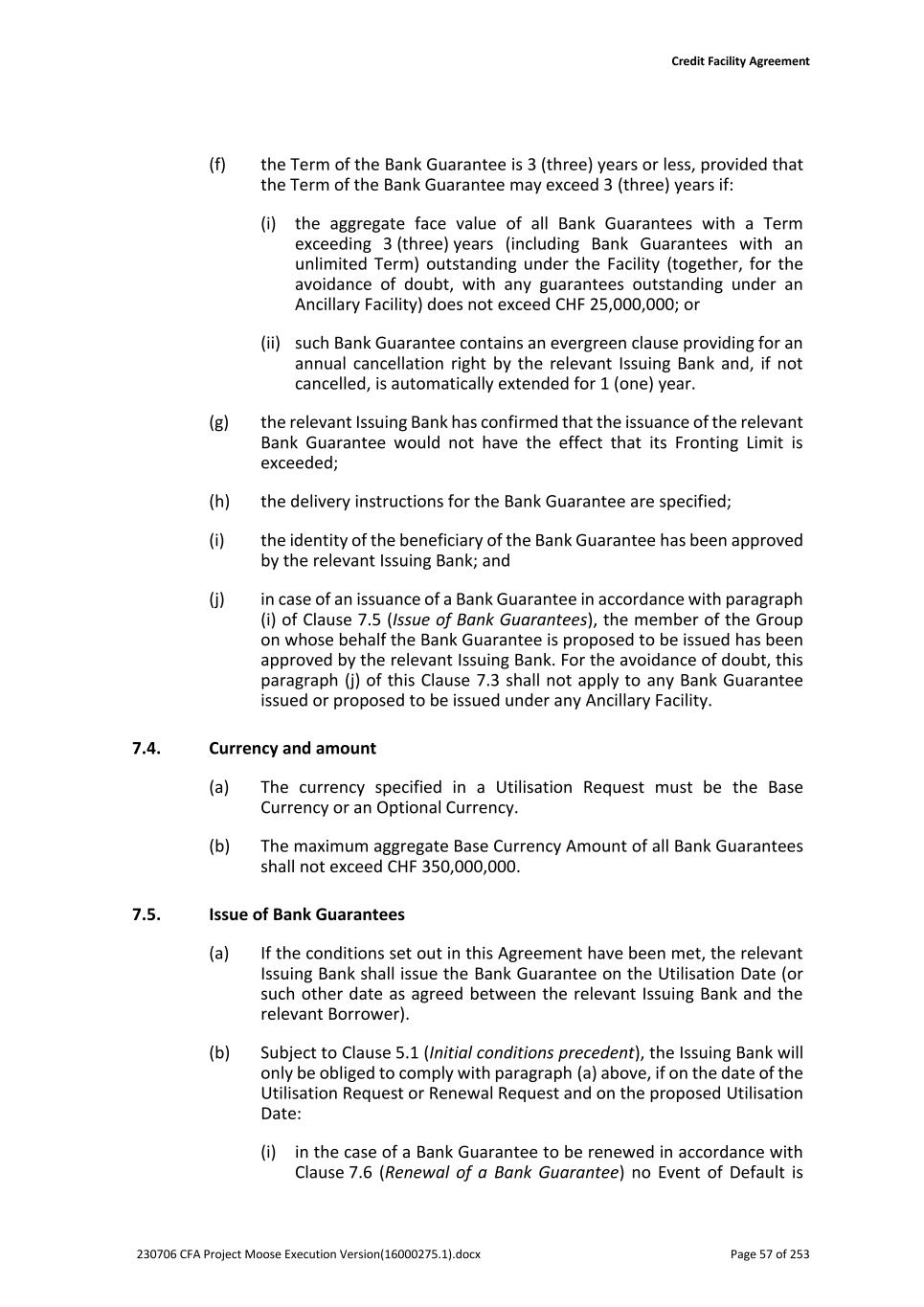
Credit Facility Agreement 230706 CFA Project Moose Execution Version(16000275.1).docx Page 57 of 253 (f) the Term of the Bank Guarantee is 3 (three) years or less, provided that the Term of the Bank Guarantee may exceed 3 (three) years if: (i) the aggregate face value of all Bank Guarantees with a Term exceeding 3 (three) years (including Bank Guarantees with an unlimited Term) outstanding under the Facility (together, for the avoidance of doubt, with any guarantees outstanding under an Ancillary Facility) does not exceed CHF 25,000,000; or (ii) such Bank Guarantee contains an evergreen clause providing for an annual cancellation right by the relevant Issuing Bank and, if not cancelled, is automatically extended for 1 (one) year. (g) the relevant Issuing Bank has confirmed that the issuance of the relevant Bank Guarantee would not have the effect that its Fronting Limit is exceeded; (h) the delivery instructions for the Bank Guarantee are specified; (i) the identity of the beneficiary of the Bank Guarantee has been approved by the relevant Issuing Bank; and (j) in case of an issuance of a Bank Guarantee in accordance with paragraph (i) of Clause 7.5 (Issue of Bank Guarantees), the member of the Group on whose behalf the Bank Guarantee is proposed to be issued has been approved by the relevant Issuing Bank. For the avoidance of doubt, this paragraph (j) of this Clause 7.3 shall not apply to any Bank Guarantee issued or proposed to be issued under any Ancillary Facility. 7.4. Currency and amount (a) The currency specified in a Utilisation Request must be the Base Currency or an Optional Currency. (b) The maximum aggregate Base Currency Amount of all Bank Guarantees shall not exceed CHF 350,000,000. 7.5. Issue of Bank Guarantees (a) If the conditions set out in this Agreement have been met, the relevant Issuing Bank shall issue the Bank Guarantee on the Utilisation Date (or such other date as agreed between the relevant Issuing Bank and the relevant Borrower). (b) Subject to Clause 5.1 (Initial conditions precedent), the Issuing Bank will only be obliged to comply with paragraph (a) above, if on the date of the Utilisation Request or Renewal Request and on the proposed Utilisation Date: (i) in the case of a Bank Guarantee to be renewed in accordance with Clause 7.6 (Renewal of a Bank Guarantee) no Event of Default is
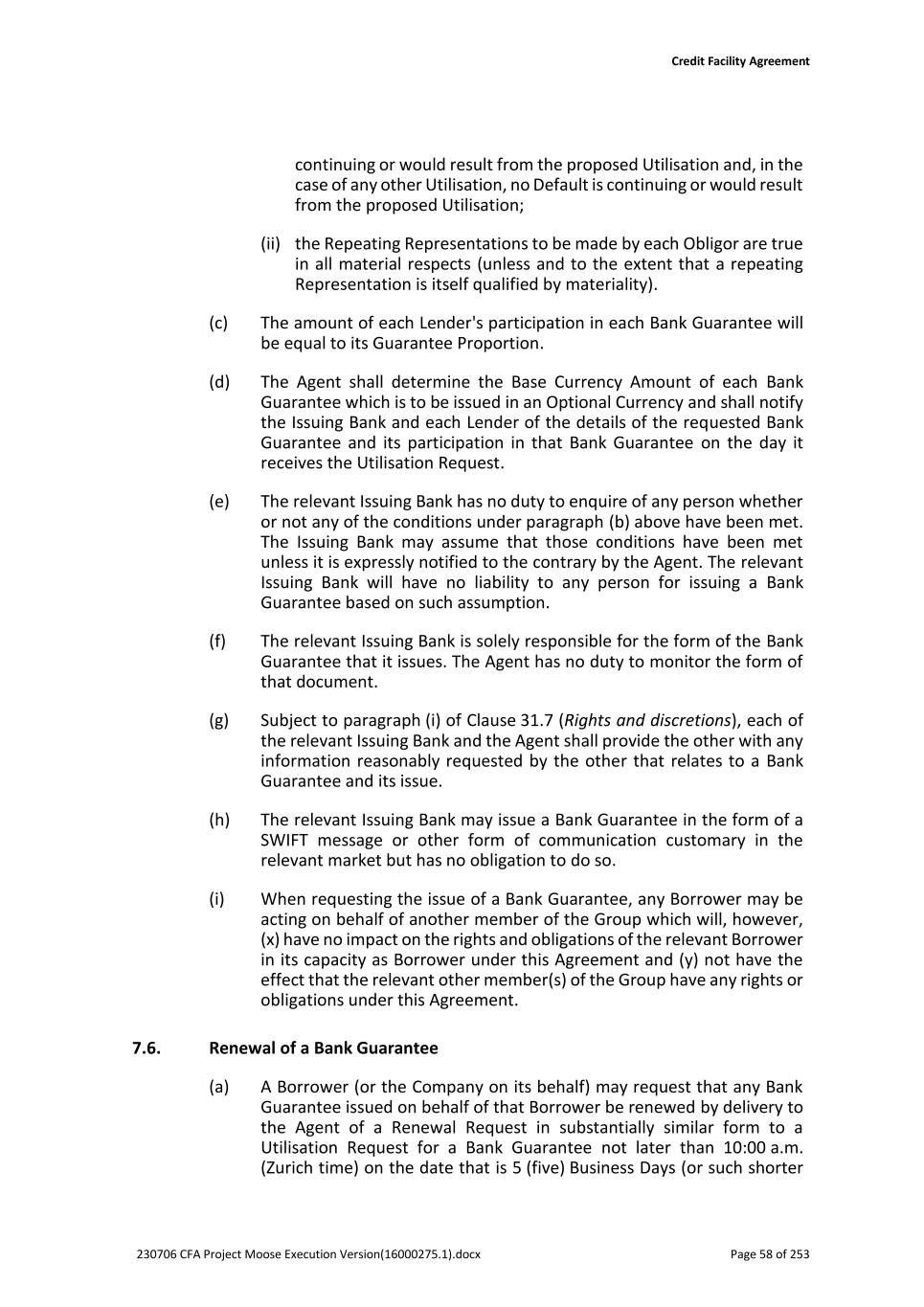
Credit Facility Agreement 230706 CFA Project Moose Execution Version(16000275.1).docx Page 58 of 253 continuing or would result from the proposed Utilisation and, in the case of any other Utilisation, no Default is continuing or would result from the proposed Utilisation; (ii) the Repeating Representations to be made by each Obligor are true in all material respects (unless and to the extent that a repeating Representation is itself qualified by materiality). (c) The amount of each Lender's participation in each Bank Guarantee will be equal to its Guarantee Proportion. (d) The Agent shall determine the Base Currency Amount of each Bank Guarantee which is to be issued in an Optional Currency and shall notify the Issuing Bank and each Lender of the details of the requested Bank Guarantee and its participation in that Bank Guarantee on the day it receives the Utilisation Request. (e) The relevant Issuing Bank has no duty to enquire of any person whether or not any of the conditions under paragraph (b) above have been met. The Issuing Bank may assume that those conditions have been met unless it is expressly notified to the contrary by the Agent. The relevant Issuing Bank will have no liability to any person for issuing a Bank Guarantee based on such assumption. (f) The relevant Issuing Bank is solely responsible for the form of the Bank Guarantee that it issues. The Agent has no duty to monitor the form of that document. (g) Subject to paragraph (i) of Clause 31.7 (Rights and discretions), each of the relevant Issuing Bank and the Agent shall provide the other with any information reasonably requested by the other that relates to a Bank Guarantee and its issue. (h) The relevant Issuing Bank may issue a Bank Guarantee in the form of a SWIFT message or other form of communication customary in the relevant market but has no obligation to do so. (i) When requesting the issue of a Bank Guarantee, any Borrower may be acting on behalf of another member of the Group which will, however, (x) have no impact on the rights and obligations of the relevant Borrower in its capacity as Borrower under this Agreement and (y) not have the effect that the relevant other member(s) of the Group have any rights or obligations under this Agreement. 7.6. Renewal of a Bank Guarantee (a) A Borrower (or the Company on its behalf) may request that any Bank Guarantee issued on behalf of that Borrower be renewed by delivery to the Agent of a Renewal Request in substantially similar form to a Utilisation Request for a Bank Guarantee not later than 10:00 a.m. (Zurich time) on the date that is 5 (five) Business Days (or such shorter
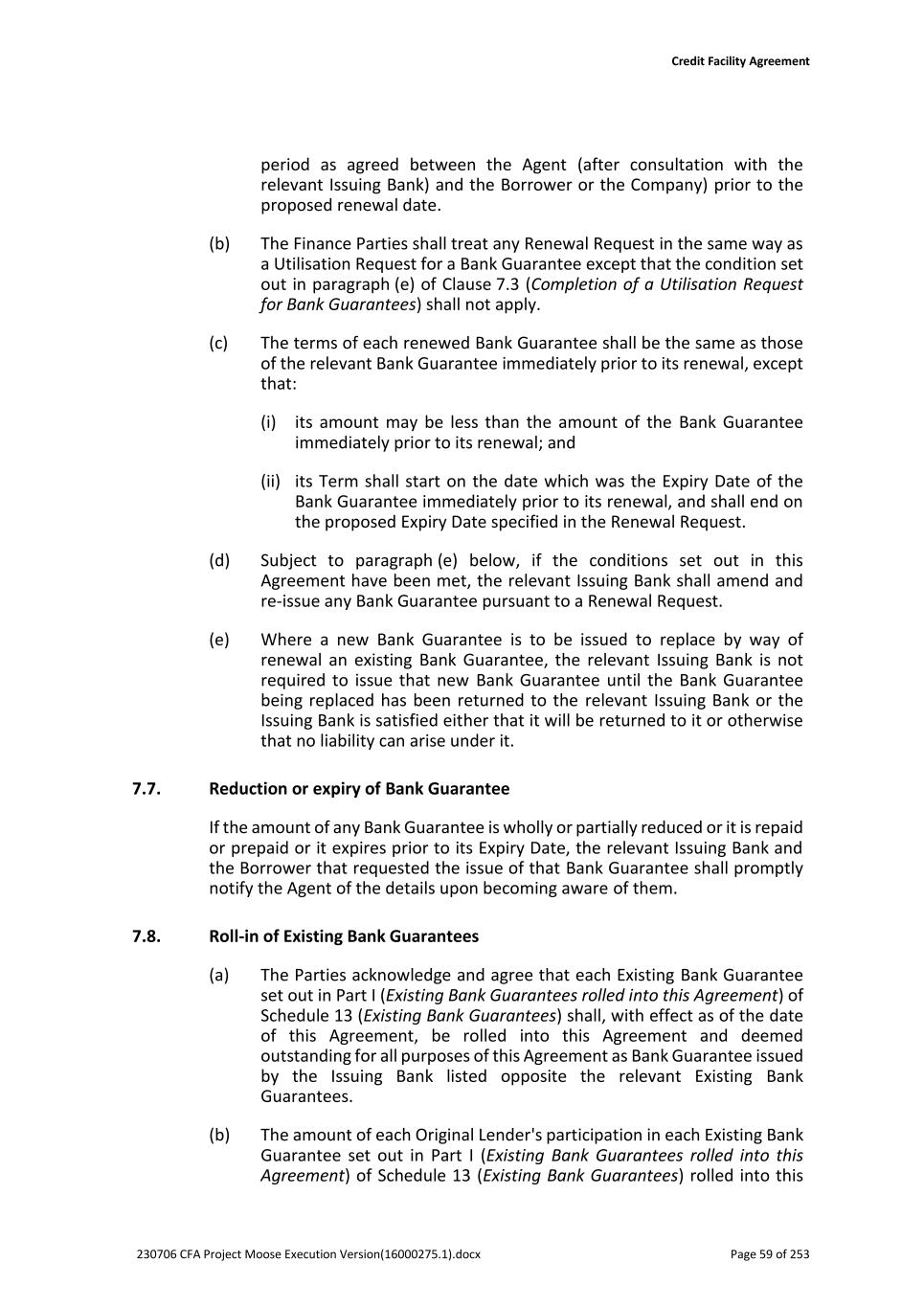
Credit Facility Agreement 230706 CFA Project Moose Execution Version(16000275.1).docx Page 59 of 253 period as agreed between the Agent (after consultation with the relevant Issuing Bank) and the Borrower or the Company) prior to the proposed renewal date. (b) The Finance Parties shall treat any Renewal Request in the same way as a Utilisation Request for a Bank Guarantee except that the condition set out in paragraph (e) of Clause 7.3 (Completion of a Utilisation Request for Bank Guarantees) shall not apply. (c) The terms of each renewed Bank Guarantee shall be the same as those of the relevant Bank Guarantee immediately prior to its renewal, except that: (i) its amount may be less than the amount of the Bank Guarantee immediately prior to its renewal; and (ii) its Term shall start on the date which was the Expiry Date of the Bank Guarantee immediately prior to its renewal, and shall end on the proposed Expiry Date specified in the Renewal Request. (d) Subject to paragraph (e) below, if the conditions set out in this Agreement have been met, the relevant Issuing Bank shall amend and re-issue any Bank Guarantee pursuant to a Renewal Request. (e) Where a new Bank Guarantee is to be issued to replace by way of renewal an existing Bank Guarantee, the relevant Issuing Bank is not required to issue that new Bank Guarantee until the Bank Guarantee being replaced has been returned to the relevant Issuing Bank or the Issuing Bank is satisfied either that it will be returned to it or otherwise that no liability can arise under it. 7.7. Reduction or expiry of Bank Guarantee If the amount of any Bank Guarantee is wholly or partially reduced or it is repaid or prepaid or it expires prior to its Expiry Date, the relevant Issuing Bank and the Borrower that requested the issue of that Bank Guarantee shall promptly notify the Agent of the details upon becoming aware of them. 7.8. Roll-in of Existing Bank Guarantees (a) The Parties acknowledge and agree that each Existing Bank Guarantee set out in Part I (Existing Bank Guarantees rolled into this Agreement) of Schedule 13 (Existing Bank Guarantees) shall, with effect as of the date of this Agreement, be rolled into this Agreement and deemed outstanding for all purposes of this Agreement as Bank Guarantee issued by the Issuing Bank listed opposite the relevant Existing Bank Guarantees. (b) The amount of each Original Lender's participation in each Existing Bank Guarantee set out in Part I (Existing Bank Guarantees rolled into this Agreement) of Schedule 13 (Existing Bank Guarantees) rolled into this
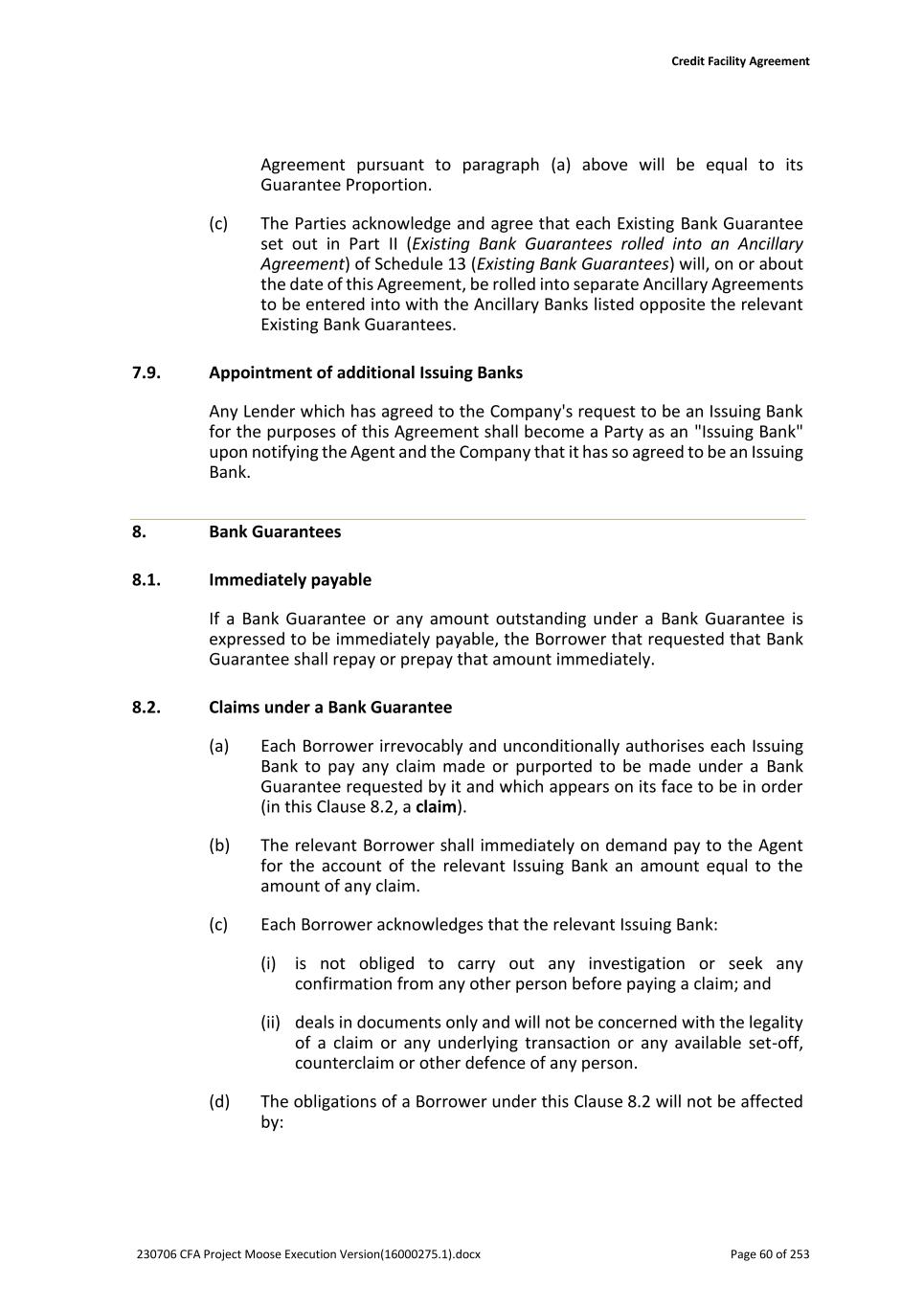
Credit Facility Agreement 230706 CFA Project Moose Execution Version(16000275.1).docx Page 60 of 253 Agreement pursuant to paragraph (a) above will be equal to its Guarantee Proportion. (c) The Parties acknowledge and agree that each Existing Bank Guarantee set out in Part II (Existing Bank Guarantees rolled into an Ancillary Agreement) of Schedule 13 (Existing Bank Guarantees) will, on or about the date of this Agreement, be rolled into separate Ancillary Agreements to be entered into with the Ancillary Banks listed opposite the relevant Existing Bank Guarantees. 7.9. Appointment of additional Issuing Banks Any Lender which has agreed to the Company's request to be an Issuing Bank for the purposes of this Agreement shall become a Party as an "Issuing Bank" upon notifying the Agent and the Company that it has so agreed to be an Issuing Bank. 8. Bank Guarantees 8.1. Immediately payable If a Bank Guarantee or any amount outstanding under a Bank Guarantee is expressed to be immediately payable, the Borrower that requested that Bank Guarantee shall repay or prepay that amount immediately. 8.2. Claims under a Bank Guarantee (a) Each Borrower irrevocably and unconditionally authorises each Issuing Bank to pay any claim made or purported to be made under a Bank Guarantee requested by it and which appears on its face to be in order (in this Clause 8.2, a claim). (b) The relevant Borrower shall immediately on demand pay to the Agent for the account of the relevant Issuing Bank an amount equal to the amount of any claim. (c) Each Borrower acknowledges that the relevant Issuing Bank: (i) is not obliged to carry out any investigation or seek any confirmation from any other person before paying a claim; and (ii) deals in documents only and will not be concerned with the legality of a claim or any underlying transaction or any available set-off, counterclaim or other defence of any person. (d) The obligations of a Borrower under this Clause 8.2 will not be affected by:
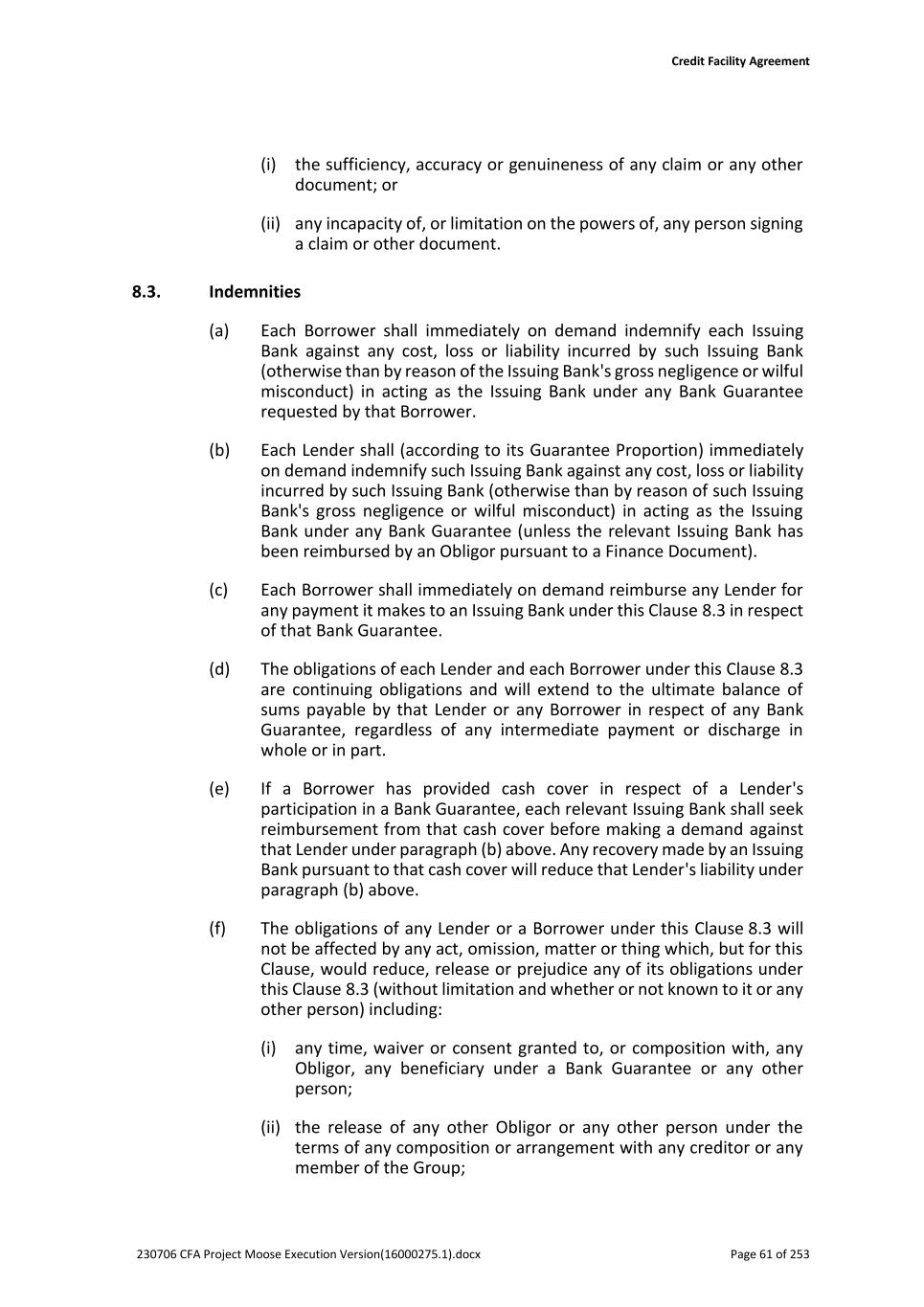
Credit Facility Agreement 230706 CFA Project Moose Execution Version(16000275.1).docx Page 61 of 253 (i) the sufficiency, accuracy or genuineness of any claim or any other document; or (ii) any incapacity of, or limitation on the powers of, any person signing a claim or other document. 8.3. Indemnities (a) Each Borrower shall immediately on demand indemnify each Issuing Bank against any cost, loss or liability incurred by such Issuing Bank (otherwise than by reason of the Issuing Bank's gross negligence or wilful misconduct) in acting as the Issuing Bank under any Bank Guarantee requested by that Borrower. (b) Each Lender shall (according to its Guarantee Proportion) immediately on demand indemnify such Issuing Bank against any cost, loss or liability incurred by such Issuing Bank (otherwise than by reason of such Issuing Bank's gross negligence or wilful misconduct) in acting as the Issuing Bank under any Bank Guarantee (unless the relevant Issuing Bank has been reimbursed by an Obligor pursuant to a Finance Document). (c) Each Borrower shall immediately on demand reimburse any Lender for any payment it makes to an Issuing Bank under this Clause 8.3 in respect of that Bank Guarantee. (d) The obligations of each Lender and each Borrower under this Clause 8.3 are continuing obligations and will extend to the ultimate balance of sums payable by that Lender or any Borrower in respect of any Bank Guarantee, regardless of any intermediate payment or discharge in whole or in part. (e) If a Borrower has provided cash cover in respect of a Lender's participation in a Bank Guarantee, each relevant Issuing Bank shall seek reimbursement from that cash cover before making a demand against that Lender under paragraph (b) above. Any recovery made by an Issuing Bank pursuant to that cash cover will reduce that Lender's liability under paragraph (b) above. (f) The obligations of any Lender or a Borrower under this Clause 8.3 will not be affected by any act, omission, matter or thing which, but for this Clause, would reduce, release or prejudice any of its obligations under this Clause 8.3 (without limitation and whether or not known to it or any other person) including: (i) any time, waiver or consent granted to, or composition with, any Obligor, any beneficiary under a Bank Guarantee or any other person; (ii) the release of any other Obligor or any other person under the terms of any composition or arrangement with any creditor or any member of the Group;
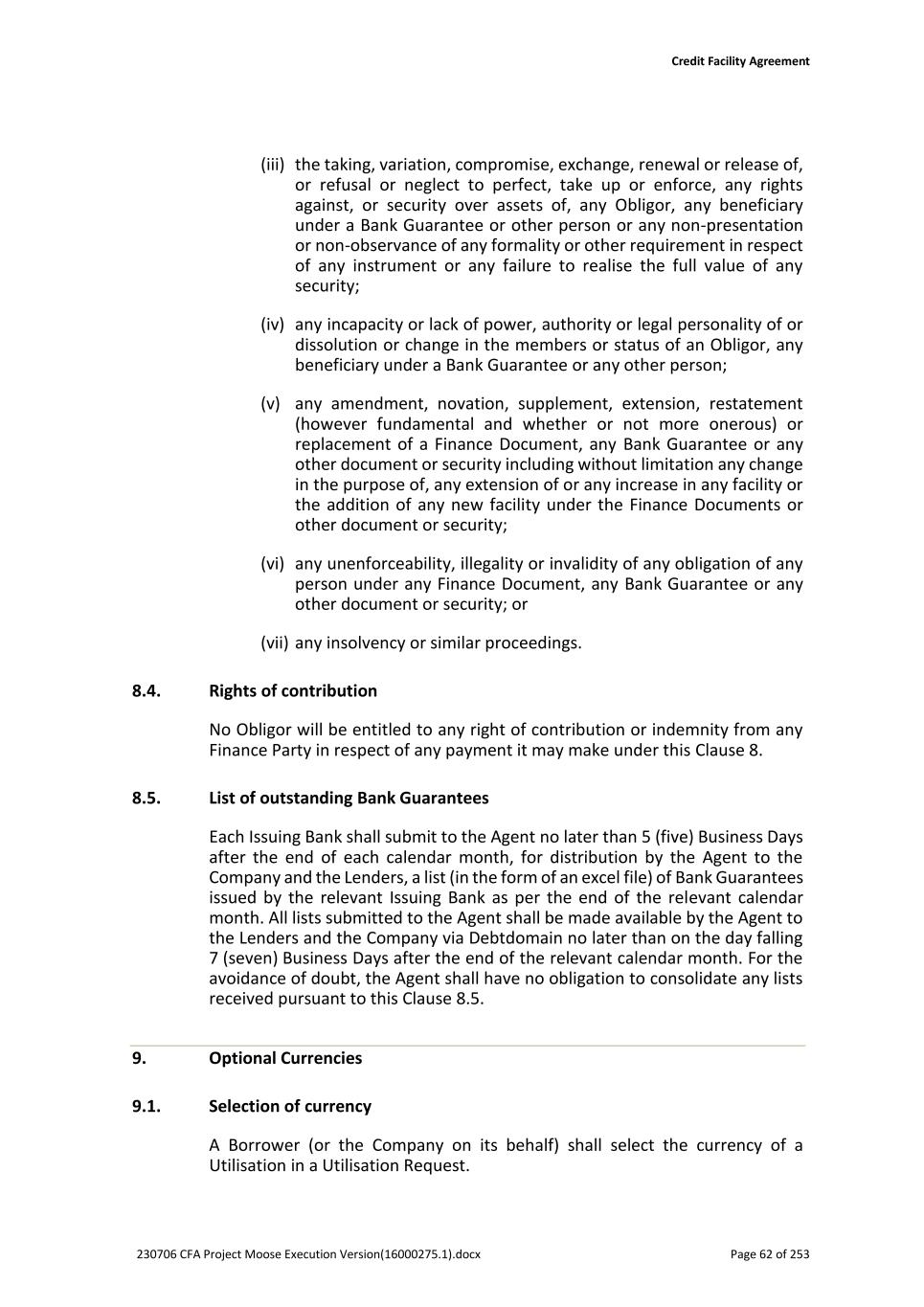
Credit Facility Agreement 230706 CFA Project Moose Execution Version(16000275.1).docx Page 62 of 253 (iii) the taking, variation, compromise, exchange, renewal or release of, or refusal or neglect to perfect, take up or enforce, any rights against, or security over assets of, any Obligor, any beneficiary under a Bank Guarantee or other person or any non-presentation or non-observance of any formality or other requirement in respect of any instrument or any failure to realise the full value of any security; (iv) any incapacity or lack of power, authority or legal personality of or dissolution or change in the members or status of an Obligor, any beneficiary under a Bank Guarantee or any other person; (v) any amendment, novation, supplement, extension, restatement (however fundamental and whether or not more onerous) or replacement of a Finance Document, any Bank Guarantee or any other document or security including without limitation any change in the purpose of, any extension of or any increase in any facility or the addition of any new facility under the Finance Documents or other document or security; (vi) any unenforceability, illegality or invalidity of any obligation of any person under any Finance Document, any Bank Guarantee or any other document or security; or (vii) any insolvency or similar proceedings. 8.4. Rights of contribution No Obligor will be entitled to any right of contribution or indemnity from any Finance Party in respect of any payment it may make under this Clause 8. 8.5. List of outstanding Bank Guarantees Each Issuing Bank shall submit to the Agent no later than 5 (five) Business Days after the end of each calendar month, for distribution by the Agent to the Company and the Lenders, a list (in the form of an excel file) of Bank Guarantees issued by the relevant Issuing Bank as per the end of the relevant calendar month. All lists submitted to the Agent shall be made available by the Agent to the Lenders and the Company via Debtdomain no later than on the day falling 7 (seven) Business Days after the end of the relevant calendar month. For the avoidance of doubt, the Agent shall have no obligation to consolidate any lists received pursuant to this Clause 8.5. 9. Optional Currencies 9.1. Selection of currency A Borrower (or the Company on its behalf) shall select the currency of a Utilisation in a Utilisation Request.
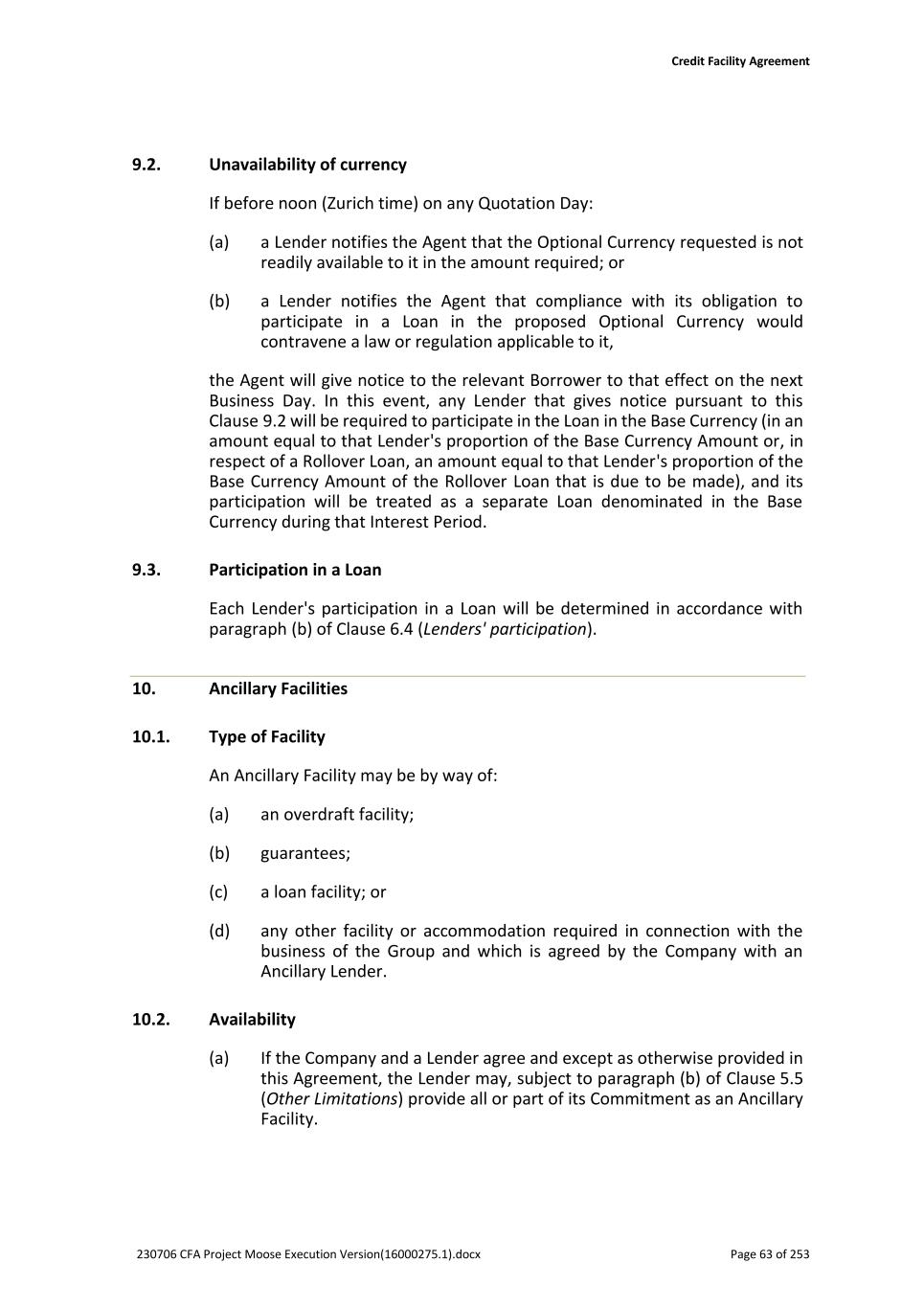
Credit Facility Agreement 230706 CFA Project Moose Execution Version(16000275.1).docx Page 63 of 253 9.2. Unavailability of currency If before noon (Zurich time) on any Quotation Day: (a) a Lender notifies the Agent that the Optional Currency requested is not readily available to it in the amount required; or (b) a Lender notifies the Agent that compliance with its obligation to participate in a Loan in the proposed Optional Currency would contravene a law or regulation applicable to it, the Agent will give notice to the relevant Borrower to that effect on the next Business Day. In this event, any Lender that gives notice pursuant to this Clause 9.2 will be required to participate in the Loan in the Base Currency (in an amount equal to that Lender's proportion of the Base Currency Amount or, in respect of a Rollover Loan, an amount equal to that Lender's proportion of the Base Currency Amount of the Rollover Loan that is due to be made), and its participation will be treated as a separate Loan denominated in the Base Currency during that Interest Period. 9.3. Participation in a Loan Each Lender's participation in a Loan will be determined in accordance with paragraph (b) of Clause 6.4 (Lenders' participation). 10. Ancillary Facilities 10.1. Type of Facility An Ancillary Facility may be by way of: (a) an overdraft facility; (b) guarantees; (c) a loan facility; or (d) any other facility or accommodation required in connection with the business of the Group and which is agreed by the Company with an Ancillary Lender. 10.2. Availability (a) If the Company and a Lender agree and except as otherwise provided in this Agreement, the Lender may, subject to paragraph (b) of Clause 5.5 (Other Limitations) provide all or part of its Commitment as an Ancillary Facility.
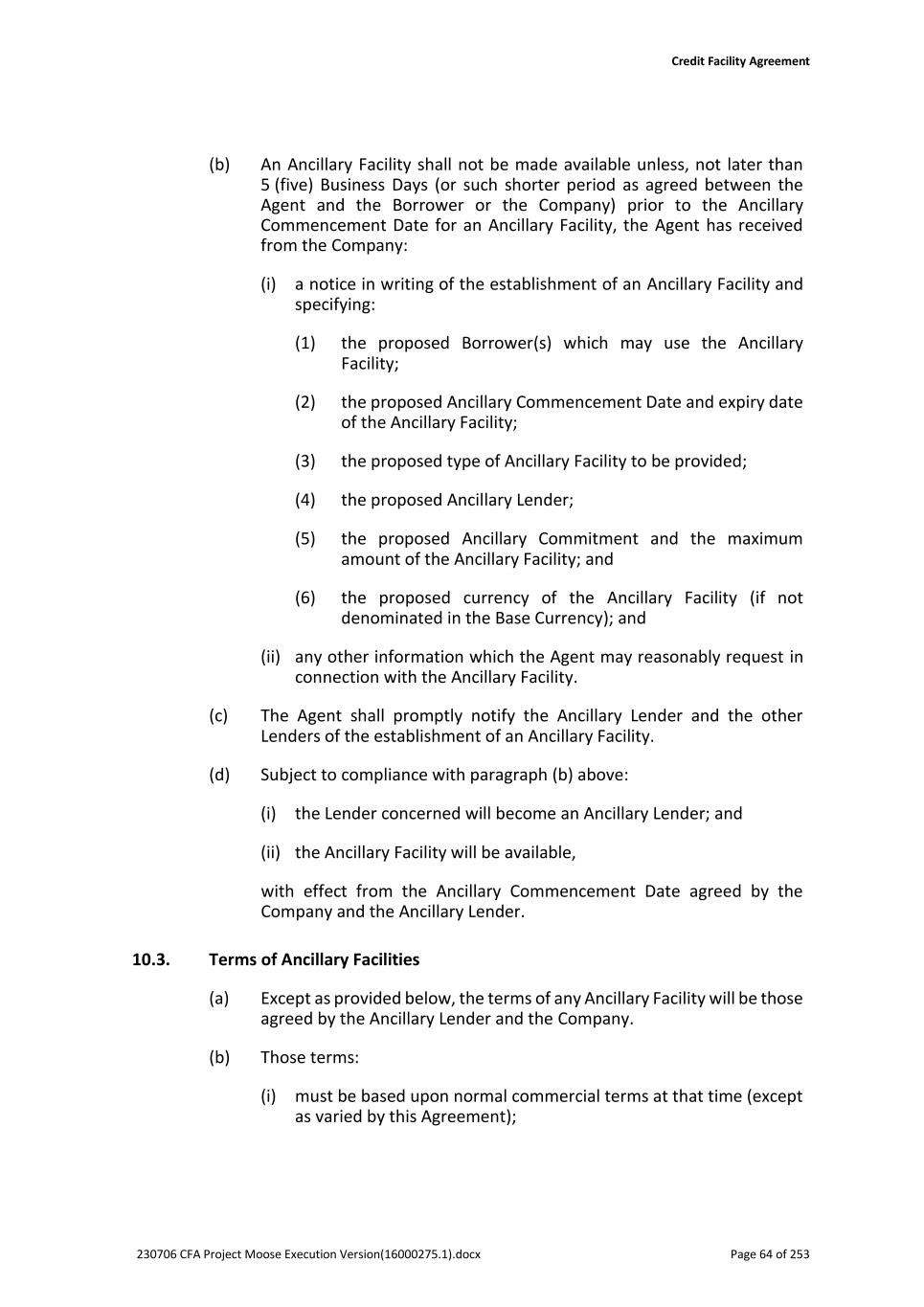
Credit Facility Agreement 230706 CFA Project Moose Execution Version(16000275.1).docx Page 64 of 253 (b) An Ancillary Facility shall not be made available unless, not later than 5 (five) Business Days (or such shorter period as agreed between the Agent and the Borrower or the Company) prior to the Ancillary Commencement Date for an Ancillary Facility, the Agent has received from the Company: (i) a notice in writing of the establishment of an Ancillary Facility and specifying: (1) the proposed Borrower(s) which may use the Ancillary Facility; (2) the proposed Ancillary Commencement Date and expiry date of the Ancillary Facility; (3) the proposed type of Ancillary Facility to be provided; (4) the proposed Ancillary Lender; (5) the proposed Ancillary Commitment and the maximum amount of the Ancillary Facility; and (6) the proposed currency of the Ancillary Facility (if not denominated in the Base Currency); and (ii) any other information which the Agent may reasonably request in connection with the Ancillary Facility. (c) The Agent shall promptly notify the Ancillary Lender and the other Lenders of the establishment of an Ancillary Facility. (d) Subject to compliance with paragraph (b) above: (i) the Lender concerned will become an Ancillary Lender; and (ii) the Ancillary Facility will be available, with effect from the Ancillary Commencement Date agreed by the Company and the Ancillary Lender. 10.3. Terms of Ancillary Facilities (a) Except as provided below, the terms of any Ancillary Facility will be those agreed by the Ancillary Lender and the Company. (b) Those terms: (i) must be based upon normal commercial terms at that time (except as varied by this Agreement);
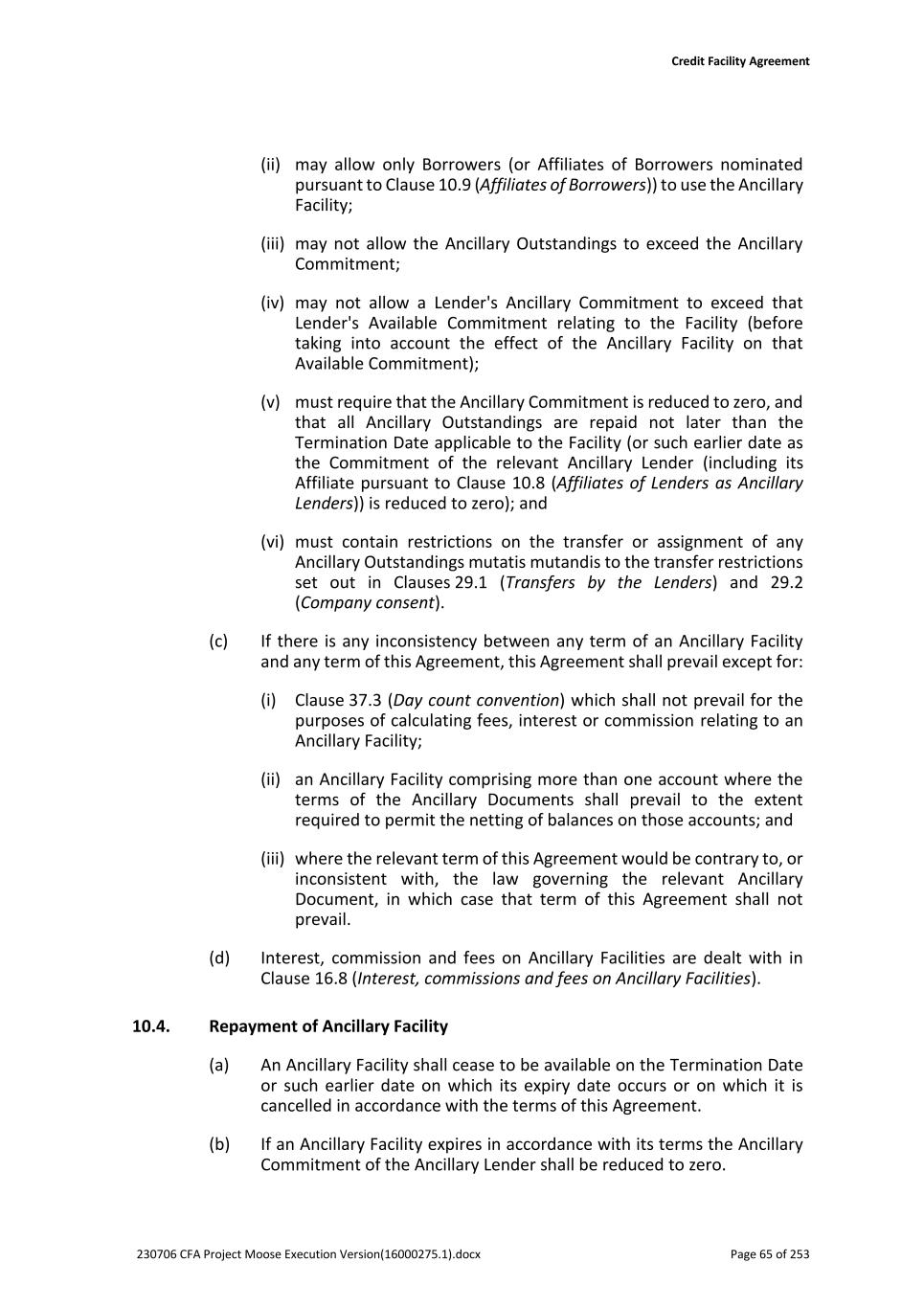
Credit Facility Agreement 230706 CFA Project Moose Execution Version(16000275.1).docx Page 65 of 253 (ii) may allow only Borrowers (or Affiliates of Borrowers nominated pursuant to Clause 10.9 (Affiliates of Borrowers)) to use the Ancillary Facility; (iii) may not allow the Ancillary Outstandings to exceed the Ancillary Commitment; (iv) may not allow a Lender's Ancillary Commitment to exceed that Lender's Available Commitment relating to the Facility (before taking into account the effect of the Ancillary Facility on that Available Commitment); (v) must require that the Ancillary Commitment is reduced to zero, and that all Ancillary Outstandings are repaid not later than the Termination Date applicable to the Facility (or such earlier date as the Commitment of the relevant Ancillary Lender (including its Affiliate pursuant to Clause 10.8 (Affiliates of Lenders as Ancillary Lenders)) is reduced to zero); and (vi) must contain restrictions on the transfer or assignment of any Ancillary Outstandings mutatis mutandis to the transfer restrictions set out in Clauses 29.1 (Transfers by the Lenders) and 29.2 (Company consent). (c) If there is any inconsistency between any term of an Ancillary Facility and any term of this Agreement, this Agreement shall prevail except for: (i) Clause 37.3 (Day count convention) which shall not prevail for the purposes of calculating fees, interest or commission relating to an Ancillary Facility; (ii) an Ancillary Facility comprising more than one account where the terms of the Ancillary Documents shall prevail to the extent required to permit the netting of balances on those accounts; and (iii) where the relevant term of this Agreement would be contrary to, or inconsistent with, the law governing the relevant Ancillary Document, in which case that term of this Agreement shall not prevail. (d) Interest, commission and fees on Ancillary Facilities are dealt with in Clause 16.8 (Interest, commissions and fees on Ancillary Facilities). 10.4. Repayment of Ancillary Facility (a) An Ancillary Facility shall cease to be available on the Termination Date or such earlier date on which its expiry date occurs or on which it is cancelled in accordance with the terms of this Agreement. (b) If an Ancillary Facility expires in accordance with its terms the Ancillary Commitment of the Ancillary Lender shall be reduced to zero.
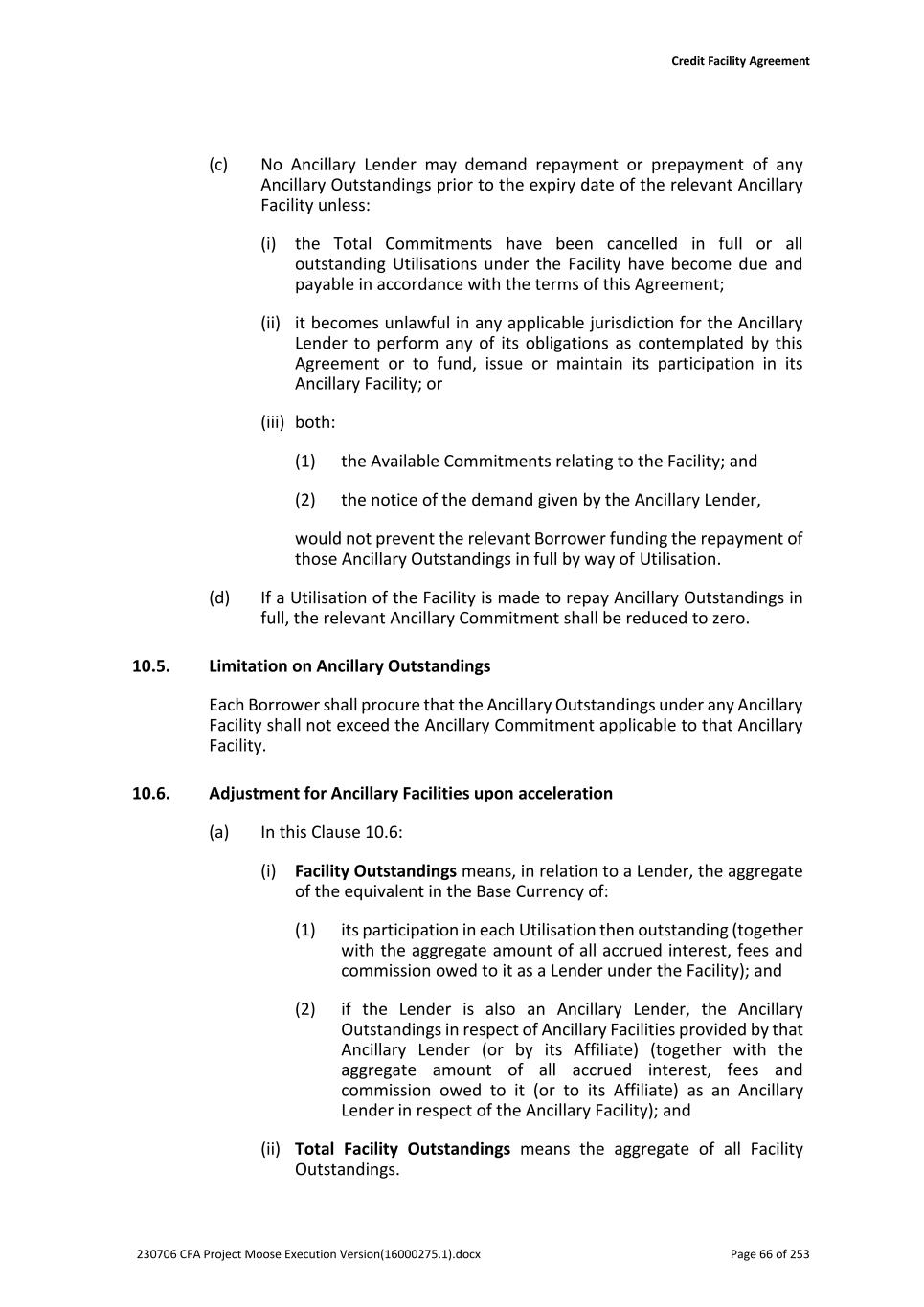
Credit Facility Agreement 230706 CFA Project Moose Execution Version(16000275.1).docx Page 66 of 253 (c) No Ancillary Lender may demand repayment or prepayment of any Ancillary Outstandings prior to the expiry date of the relevant Ancillary Facility unless: (i) the Total Commitments have been cancelled in full or all outstanding Utilisations under the Facility have become due and payable in accordance with the terms of this Agreement; (ii) it becomes unlawful in any applicable jurisdiction for the Ancillary Lender to perform any of its obligations as contemplated by this Agreement or to fund, issue or maintain its participation in its Ancillary Facility; or (iii) both: (1) the Available Commitments relating to the Facility; and (2) the notice of the demand given by the Ancillary Lender, would not prevent the relevant Borrower funding the repayment of those Ancillary Outstandings in full by way of Utilisation. (d) If a Utilisation of the Facility is made to repay Ancillary Outstandings in full, the relevant Ancillary Commitment shall be reduced to zero. 10.5. Limitation on Ancillary Outstandings Each Borrower shall procure that the Ancillary Outstandings under any Ancillary Facility shall not exceed the Ancillary Commitment applicable to that Ancillary Facility. 10.6. Adjustment for Ancillary Facilities upon acceleration (a) In this Clause 10.6: (i) Facility Outstandings means, in relation to a Lender, the aggregate of the equivalent in the Base Currency of: (1) its participation in each Utilisation then outstanding (together with the aggregate amount of all accrued interest, fees and commission owed to it as a Lender under the Facility); and (2) if the Lender is also an Ancillary Lender, the Ancillary Outstandings in respect of Ancillary Facilities provided by that Ancillary Lender (or by its Affiliate) (together with the aggregate amount of all accrued interest, fees and commission owed to it (or to its Affiliate) as an Ancillary Lender in respect of the Ancillary Facility); and (ii) Total Facility Outstandings means the aggregate of all Facility Outstandings.
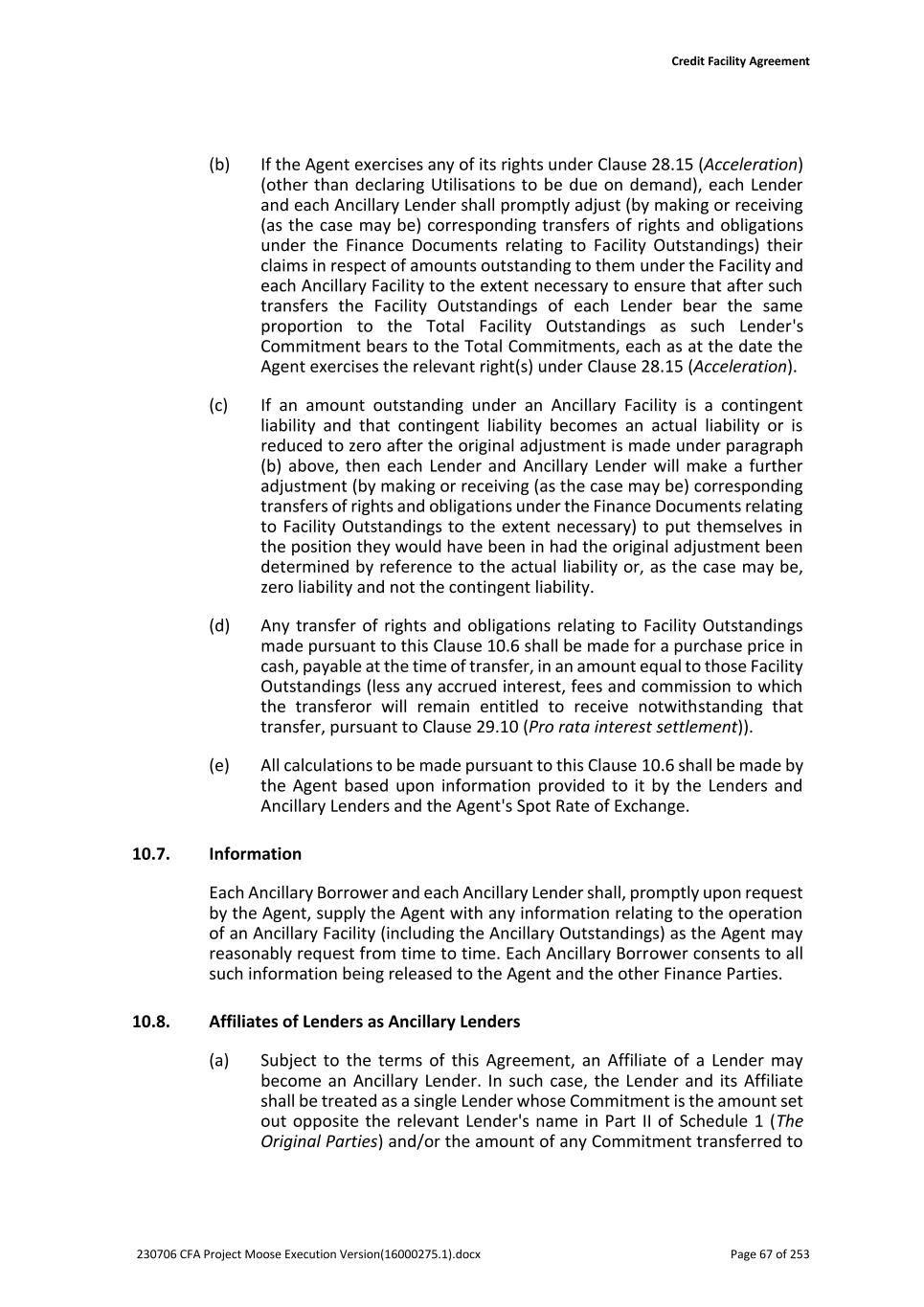
Credit Facility Agreement 230706 CFA Project Moose Execution Version(16000275.1).docx Page 67 of 253 (b) If the Agent exercises any of its rights under Clause 28.15 (Acceleration) (other than declaring Utilisations to be due on demand), each Lender and each Ancillary Lender shall promptly adjust (by making or receiving (as the case may be) corresponding transfers of rights and obligations under the Finance Documents relating to Facility Outstandings) their claims in respect of amounts outstanding to them under the Facility and each Ancillary Facility to the extent necessary to ensure that after such transfers the Facility Outstandings of each Lender bear the same proportion to the Total Facility Outstandings as such Lender's Commitment bears to the Total Commitments, each as at the date the Agent exercises the relevant right(s) under Clause 28.15 (Acceleration). (c) If an amount outstanding under an Ancillary Facility is a contingent liability and that contingent liability becomes an actual liability or is reduced to zero after the original adjustment is made under paragraph (b) above, then each Lender and Ancillary Lender will make a further adjustment (by making or receiving (as the case may be) corresponding transfers of rights and obligations under the Finance Documents relating to Facility Outstandings to the extent necessary) to put themselves in the position they would have been in had the original adjustment been determined by reference to the actual liability or, as the case may be, zero liability and not the contingent liability. (d) Any transfer of rights and obligations relating to Facility Outstandings made pursuant to this Clause 10.6 shall be made for a purchase price in cash, payable at the time of transfer, in an amount equal to those Facility Outstandings (less any accrued interest, fees and commission to which the transferor will remain entitled to receive notwithstanding that transfer, pursuant to Clause 29.10 (Pro rata interest settlement)). (e) All calculations to be made pursuant to this Clause 10.6 shall be made by the Agent based upon information provided to it by the Lenders and Ancillary Lenders and the Agent's Spot Rate of Exchange. 10.7. Information Each Ancillary Borrower and each Ancillary Lender shall, promptly upon request by the Agent, supply the Agent with any information relating to the operation of an Ancillary Facility (including the Ancillary Outstandings) as the Agent may reasonably request from time to time. Each Ancillary Borrower consents to all such information being released to the Agent and the other Finance Parties. 10.8. Affiliates of Lenders as Ancillary Lenders (a) Subject to the terms of this Agreement, an Affiliate of a Lender may become an Ancillary Lender. In such case, the Lender and its Affiliate shall be treated as a single Lender whose Commitment is the amount set out opposite the relevant Lender's name in Part II of Schedule 1 (The Original Parties) and/or the amount of any Commitment transferred to
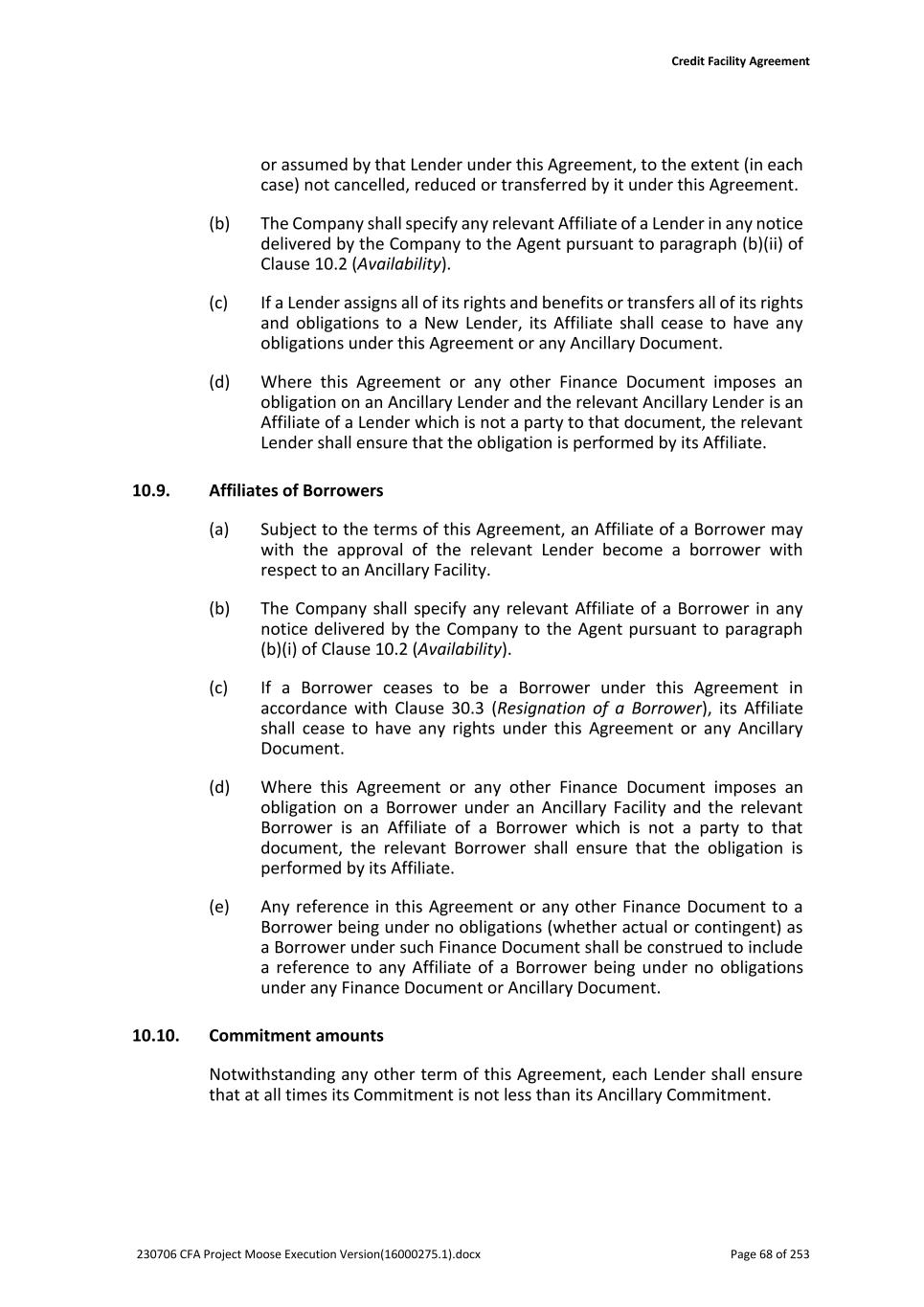
Credit Facility Agreement 230706 CFA Project Moose Execution Version(16000275.1).docx Page 68 of 253 or assumed by that Lender under this Agreement, to the extent (in each case) not cancelled, reduced or transferred by it under this Agreement. (b) The Company shall specify any relevant Affiliate of a Lender in any notice delivered by the Company to the Agent pursuant to paragraph (b)(ii) of Clause 10.2 (Availability). (c) If a Lender assigns all of its rights and benefits or transfers all of its rights and obligations to a New Lender, its Affiliate shall cease to have any obligations under this Agreement or any Ancillary Document. (d) Where this Agreement or any other Finance Document imposes an obligation on an Ancillary Lender and the relevant Ancillary Lender is an Affiliate of a Lender which is not a party to that document, the relevant Lender shall ensure that the obligation is performed by its Affiliate. 10.9. Affiliates of Borrowers (a) Subject to the terms of this Agreement, an Affiliate of a Borrower may with the approval of the relevant Lender become a borrower with respect to an Ancillary Facility. (b) The Company shall specify any relevant Affiliate of a Borrower in any notice delivered by the Company to the Agent pursuant to paragraph (b)(i) of Clause 10.2 (Availability). (c) If a Borrower ceases to be a Borrower under this Agreement in accordance with Clause 30.3 (Resignation of a Borrower), its Affiliate shall cease to have any rights under this Agreement or any Ancillary Document. (d) Where this Agreement or any other Finance Document imposes an obligation on a Borrower under an Ancillary Facility and the relevant Borrower is an Affiliate of a Borrower which is not a party to that document, the relevant Borrower shall ensure that the obligation is performed by its Affiliate. (e) Any reference in this Agreement or any other Finance Document to a Borrower being under no obligations (whether actual or contingent) as a Borrower under such Finance Document shall be construed to include a reference to any Affiliate of a Borrower being under no obligations under any Finance Document or Ancillary Document. 10.10. Commitment amounts Notwithstanding any other term of this Agreement, each Lender shall ensure that at all times its Commitment is not less than its Ancillary Commitment.
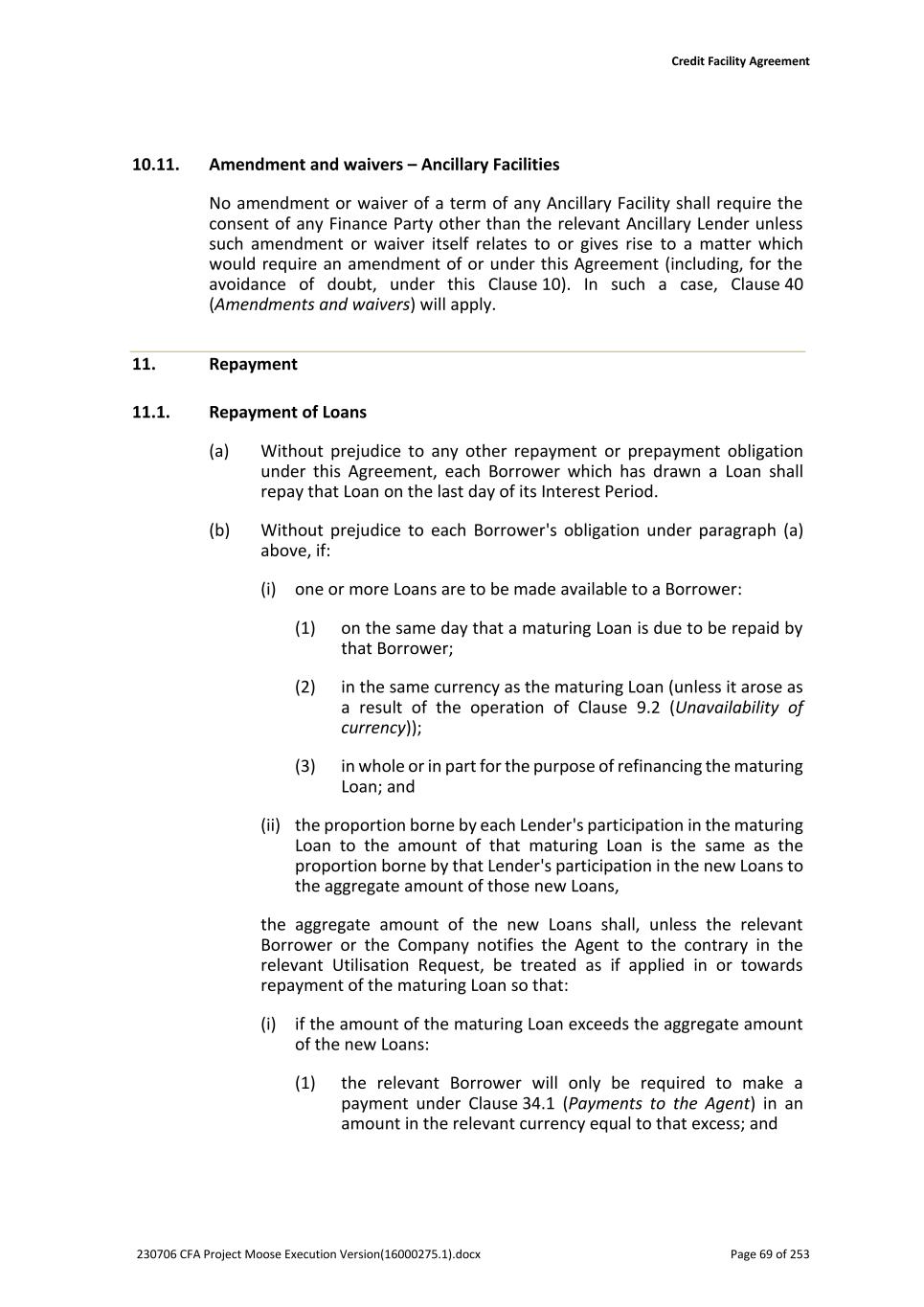
Credit Facility Agreement 230706 CFA Project Moose Execution Version(16000275.1).docx Page 69 of 253 10.11. Amendment and waivers – Ancillary Facilities No amendment or waiver of a term of any Ancillary Facility shall require the consent of any Finance Party other than the relevant Ancillary Lender unless such amendment or waiver itself relates to or gives rise to a matter which would require an amendment of or under this Agreement (including, for the avoidance of doubt, under this Clause 10). In such a case, Clause 40 (Amendments and waivers) will apply. 11. Repayment 11.1. Repayment of Loans (a) Without prejudice to any other repayment or prepayment obligation under this Agreement, each Borrower which has drawn a Loan shall repay that Loan on the last day of its Interest Period. (b) Without prejudice to each Borrower's obligation under paragraph (a) above, if: (i) one or more Loans are to be made available to a Borrower: (1) on the same day that a maturing Loan is due to be repaid by that Borrower; (2) in the same currency as the maturing Loan (unless it arose as a result of the operation of Clause 9.2 (Unavailability of currency)); (3) in whole or in part for the purpose of refinancing the maturing Loan; and (ii) the proportion borne by each Lender's participation in the maturing Loan to the amount of that maturing Loan is the same as the proportion borne by that Lender's participation in the new Loans to the aggregate amount of those new Loans, the aggregate amount of the new Loans shall, unless the relevant Borrower or the Company notifies the Agent to the contrary in the relevant Utilisation Request, be treated as if applied in or towards repayment of the maturing Loan so that: (i) if the amount of the maturing Loan exceeds the aggregate amount of the new Loans: (1) the relevant Borrower will only be required to make a payment under Clause 34.1 (Payments to the Agent) in an amount in the relevant currency equal to that excess; and
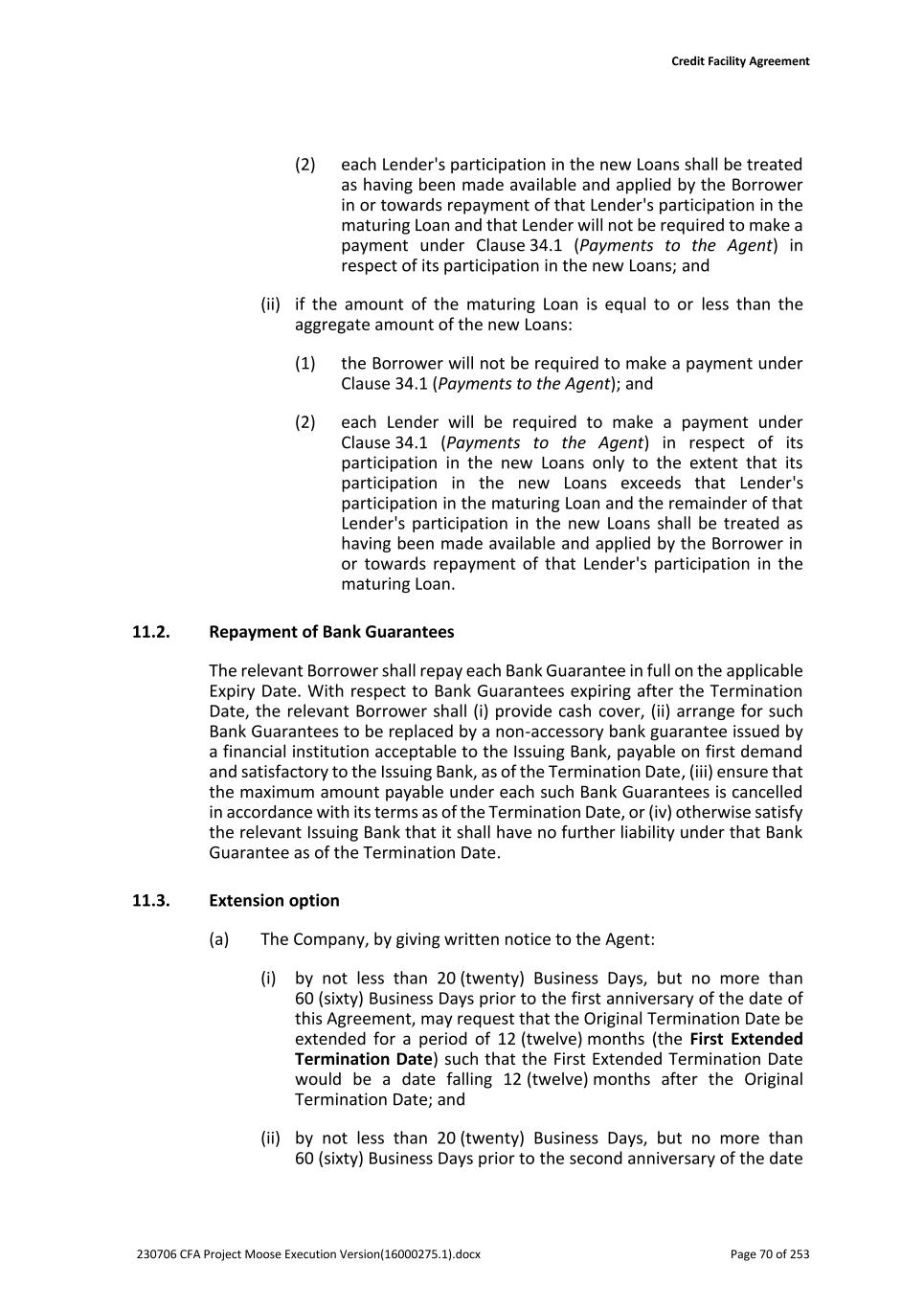
Credit Facility Agreement 230706 CFA Project Moose Execution Version(16000275.1).docx Page 70 of 253 (2) each Lender's participation in the new Loans shall be treated as having been made available and applied by the Borrower in or towards repayment of that Lender's participation in the maturing Loan and that Lender will not be required to make a payment under Clause 34.1 (Payments to the Agent) in respect of its participation in the new Loans; and (ii) if the amount of the maturing Loan is equal to or less than the aggregate amount of the new Loans: (1) the Borrower will not be required to make a payment under Clause 34.1 (Payments to the Agent); and (2) each Lender will be required to make a payment under Clause 34.1 (Payments to the Agent) in respect of its participation in the new Loans only to the extent that its participation in the new Loans exceeds that Lender's participation in the maturing Loan and the remainder of that Lender's participation in the new Loans shall be treated as having been made available and applied by the Borrower in or towards repayment of that Lender's participation in the maturing Loan. 11.2. Repayment of Bank Guarantees The relevant Borrower shall repay each Bank Guarantee in full on the applicable Expiry Date. With respect to Bank Guarantees expiring after the Termination Date, the relevant Borrower shall (i) provide cash cover, (ii) arrange for such Bank Guarantees to be replaced by a non-accessory bank guarantee issued by a financial institution acceptable to the Issuing Bank, payable on first demand and satisfactory to the Issuing Bank, as of the Termination Date, (iii) ensure that the maximum amount payable under each such Bank Guarantees is cancelled in accordance with its terms as of the Termination Date, or (iv) otherwise satisfy the relevant Issuing Bank that it shall have no further liability under that Bank Guarantee as of the Termination Date. 11.3. Extension option (a) The Company, by giving written notice to the Agent: (i) by not less than 20 (twenty) Business Days, but no more than 60 (sixty) Business Days prior to the first anniversary of the date of this Agreement, may request that the Original Termination Date be extended for a period of 12 (twelve) months (the First Extended Termination Date) such that the First Extended Termination Date would be a date falling 12 (twelve) months after the Original Termination Date; and (ii) by not less than 20 (twenty) Business Days, but no more than 60 (sixty) Business Days prior to the second anniversary of the date
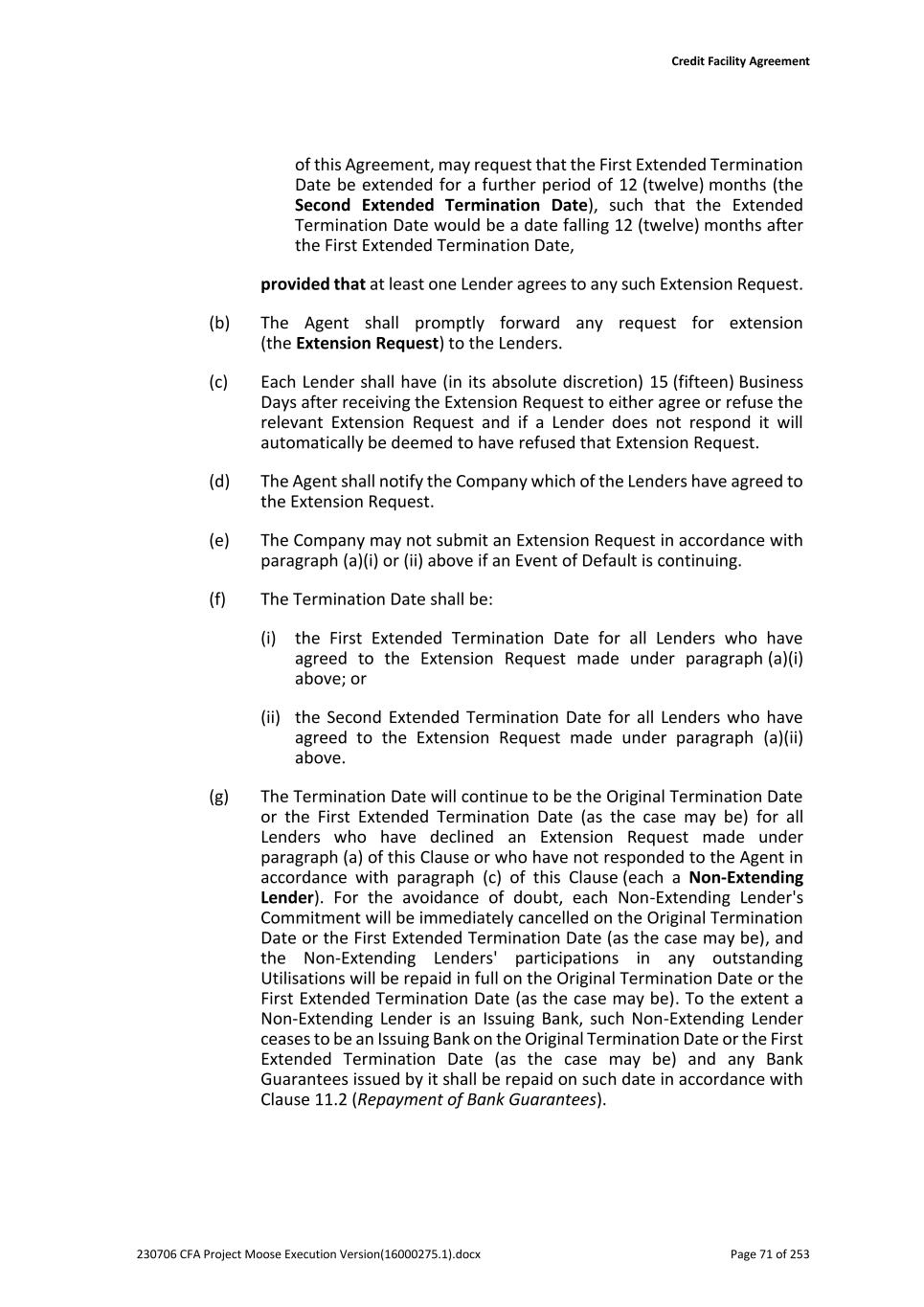
Credit Facility Agreement 230706 CFA Project Moose Execution Version(16000275.1).docx Page 71 of 253 of this Agreement, may request that the First Extended Termination Date be extended for a further period of 12 (twelve) months (the Second Extended Termination Date), such that the Extended Termination Date would be a date falling 12 (twelve) months after the First Extended Termination Date, provided that at least one Lender agrees to any such Extension Request. (b) The Agent shall promptly forward any request for extension (the Extension Request) to the Lenders. (c) Each Lender shall have (in its absolute discretion) 15 (fifteen) Business Days after receiving the Extension Request to either agree or refuse the relevant Extension Request and if a Lender does not respond it will automatically be deemed to have refused that Extension Request. (d) The Agent shall notify the Company which of the Lenders have agreed to the Extension Request. (e) The Company may not submit an Extension Request in accordance with paragraph (a)(i) or (ii) above if an Event of Default is continuing. (f) The Termination Date shall be: (i) the First Extended Termination Date for all Lenders who have agreed to the Extension Request made under paragraph (a)(i) above; or (ii) the Second Extended Termination Date for all Lenders who have agreed to the Extension Request made under paragraph (a)(ii) above. (g) The Termination Date will continue to be the Original Termination Date or the First Extended Termination Date (as the case may be) for all Lenders who have declined an Extension Request made under paragraph (a) of this Clause or who have not responded to the Agent in accordance with paragraph (c) of this Clause (each a Non-Extending Lender). For the avoidance of doubt, each Non-Extending Lender's Commitment will be immediately cancelled on the Original Termination Date or the First Extended Termination Date (as the case may be), and the Non-Extending Lenders' participations in any outstanding Utilisations will be repaid in full on the Original Termination Date or the First Extended Termination Date (as the case may be). To the extent a Non-Extending Lender is an Issuing Bank, such Non-Extending Lender ceases to be an Issuing Bank on the Original Termination Date or the First Extended Termination Date (as the case may be) and any Bank Guarantees issued by it shall be repaid on such date in accordance with Clause 11.2 (Repayment of Bank Guarantees).
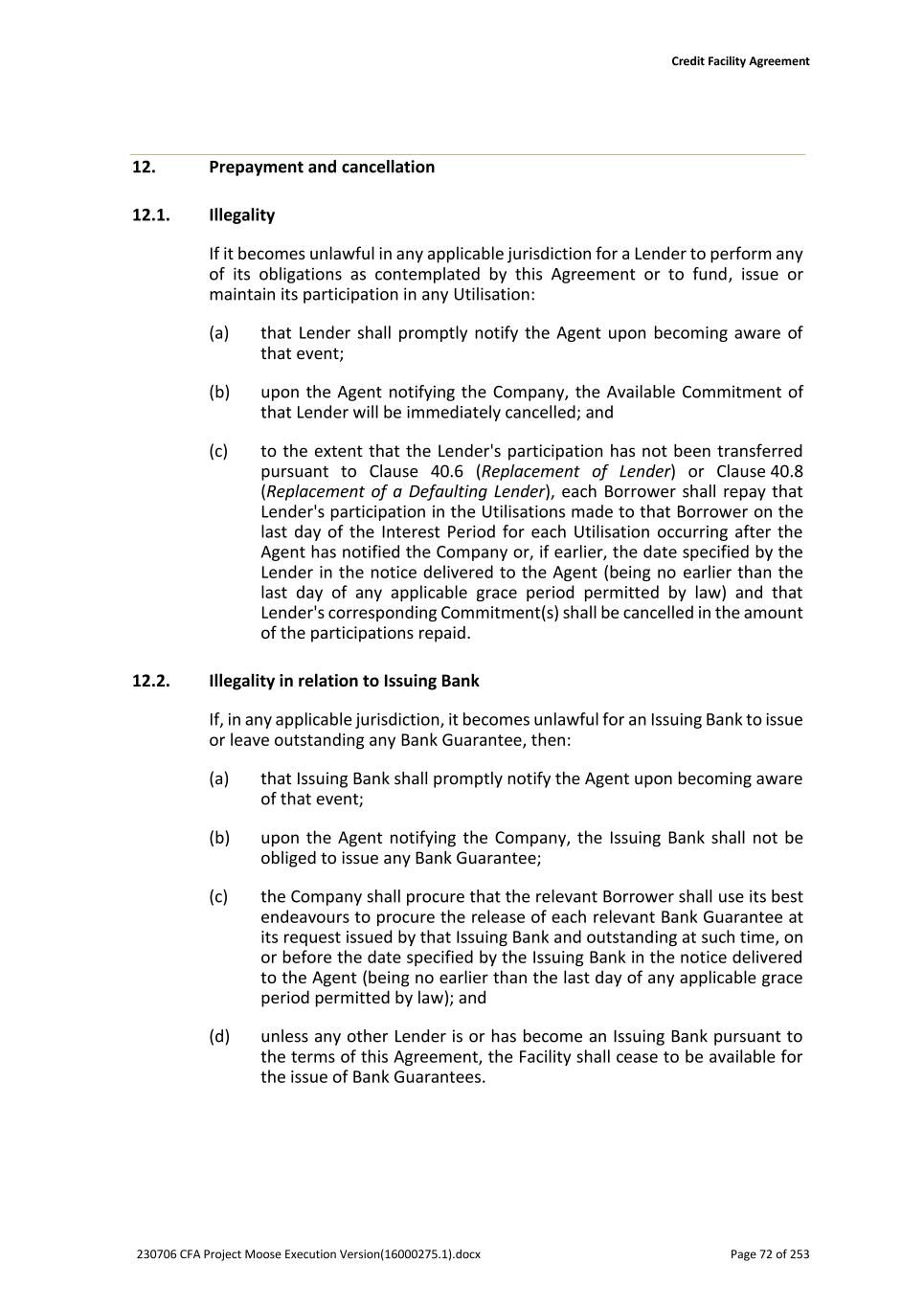
Credit Facility Agreement 230706 CFA Project Moose Execution Version(16000275.1).docx Page 72 of 253 12. Prepayment and cancellation 12.1. Illegality If it becomes unlawful in any applicable jurisdiction for a Lender to perform any of its obligations as contemplated by this Agreement or to fund, issue or maintain its participation in any Utilisation: (a) that Lender shall promptly notify the Agent upon becoming aware of that event; (b) upon the Agent notifying the Company, the Available Commitment of that Lender will be immediately cancelled; and (c) to the extent that the Lender's participation has not been transferred pursuant to Clause 40.6 (Replacement of Lender) or Clause 40.8 (Replacement of a Defaulting Lender), each Borrower shall repay that Lender's participation in the Utilisations made to that Borrower on the last day of the Interest Period for each Utilisation occurring after the Agent has notified the Company or, if earlier, the date specified by the Lender in the notice delivered to the Agent (being no earlier than the last day of any applicable grace period permitted by law) and that Lender's corresponding Commitment(s) shall be cancelled in the amount of the participations repaid. 12.2. Illegality in relation to Issuing Bank If, in any applicable jurisdiction, it becomes unlawful for an Issuing Bank to issue or leave outstanding any Bank Guarantee, then: (a) that Issuing Bank shall promptly notify the Agent upon becoming aware of that event; (b) upon the Agent notifying the Company, the Issuing Bank shall not be obliged to issue any Bank Guarantee; (c) the Company shall procure that the relevant Borrower shall use its best endeavours to procure the release of each relevant Bank Guarantee at its request issued by that Issuing Bank and outstanding at such time, on or before the date specified by the Issuing Bank in the notice delivered to the Agent (being no earlier than the last day of any applicable grace period permitted by law); and (d) unless any other Lender is or has become an Issuing Bank pursuant to the terms of this Agreement, the Facility shall cease to be available for the issue of Bank Guarantees.
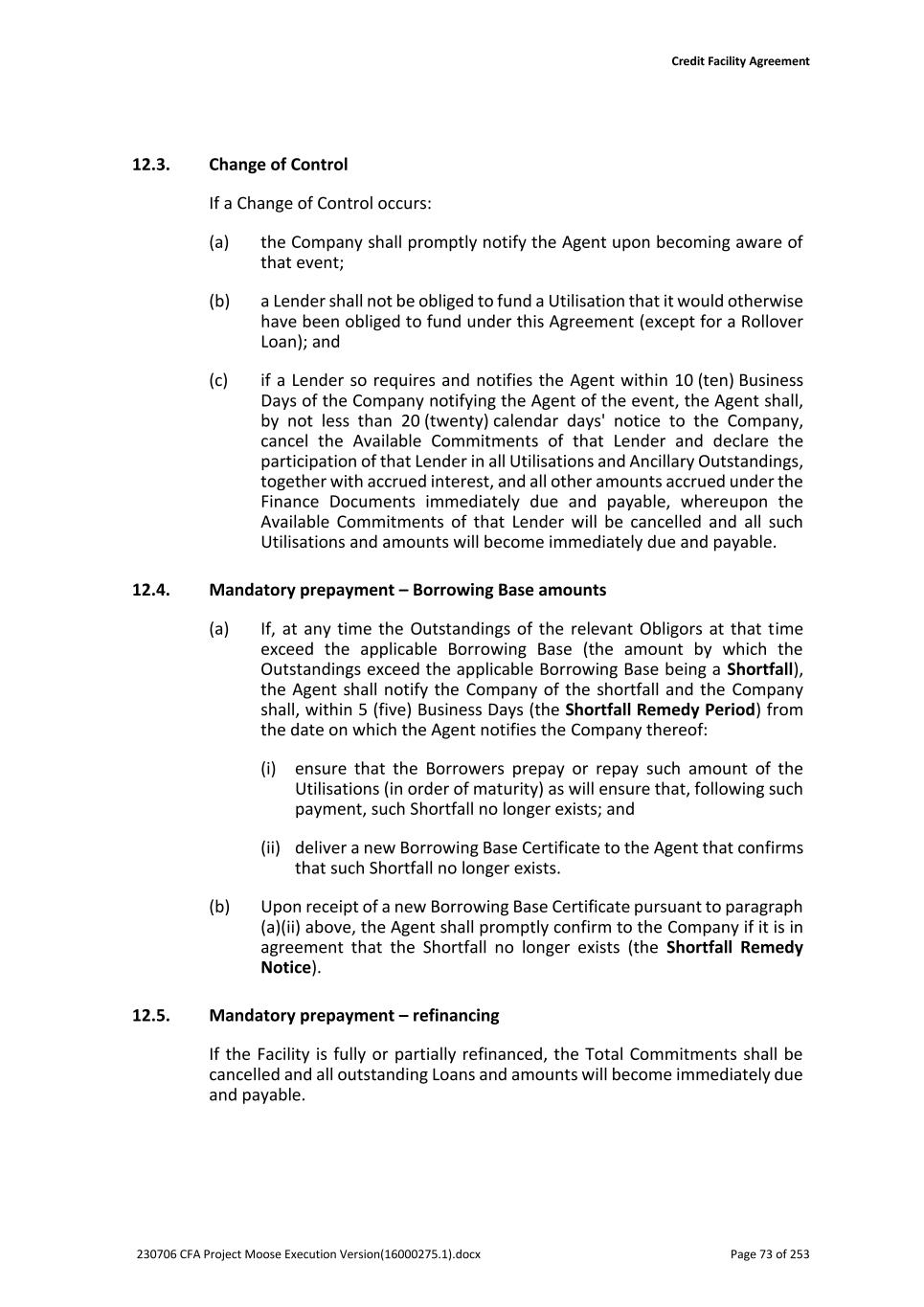
Credit Facility Agreement 230706 CFA Project Moose Execution Version(16000275.1).docx Page 73 of 253 12.3. Change of Control If a Change of Control occurs: (a) the Company shall promptly notify the Agent upon becoming aware of that event; (b) a Lender shall not be obliged to fund a Utilisation that it would otherwise have been obliged to fund under this Agreement (except for a Rollover Loan); and (c) if a Lender so requires and notifies the Agent within 10 (ten) Business Days of the Company notifying the Agent of the event, the Agent shall, by not less than 20 (twenty) calendar days' notice to the Company, cancel the Available Commitments of that Lender and declare the participation of that Lender in all Utilisations and Ancillary Outstandings, together with accrued interest, and all other amounts accrued under the Finance Documents immediately due and payable, whereupon the Available Commitments of that Lender will be cancelled and all such Utilisations and amounts will become immediately due and payable. 12.4. Mandatory prepayment – Borrowing Base amounts (a) If, at any time the Outstandings of the relevant Obligors at that time exceed the applicable Borrowing Base (the amount by which the Outstandings exceed the applicable Borrowing Base being a Shortfall), the Agent shall notify the Company of the shortfall and the Company shall, within 5 (five) Business Days (the Shortfall Remedy Period) from the date on which the Agent notifies the Company thereof: (i) ensure that the Borrowers prepay or repay such amount of the Utilisations (in order of maturity) as will ensure that, following such payment, such Shortfall no longer exists; and (ii) deliver a new Borrowing Base Certificate to the Agent that confirms that such Shortfall no longer exists. (b) Upon receipt of a new Borrowing Base Certificate pursuant to paragraph (a)(ii) above, the Agent shall promptly confirm to the Company if it is in agreement that the Shortfall no longer exists (the Shortfall Remedy Notice). 12.5. Mandatory prepayment – refinancing If the Facility is fully or partially refinanced, the Total Commitments shall be cancelled and all outstanding Loans and amounts will become immediately due and payable.
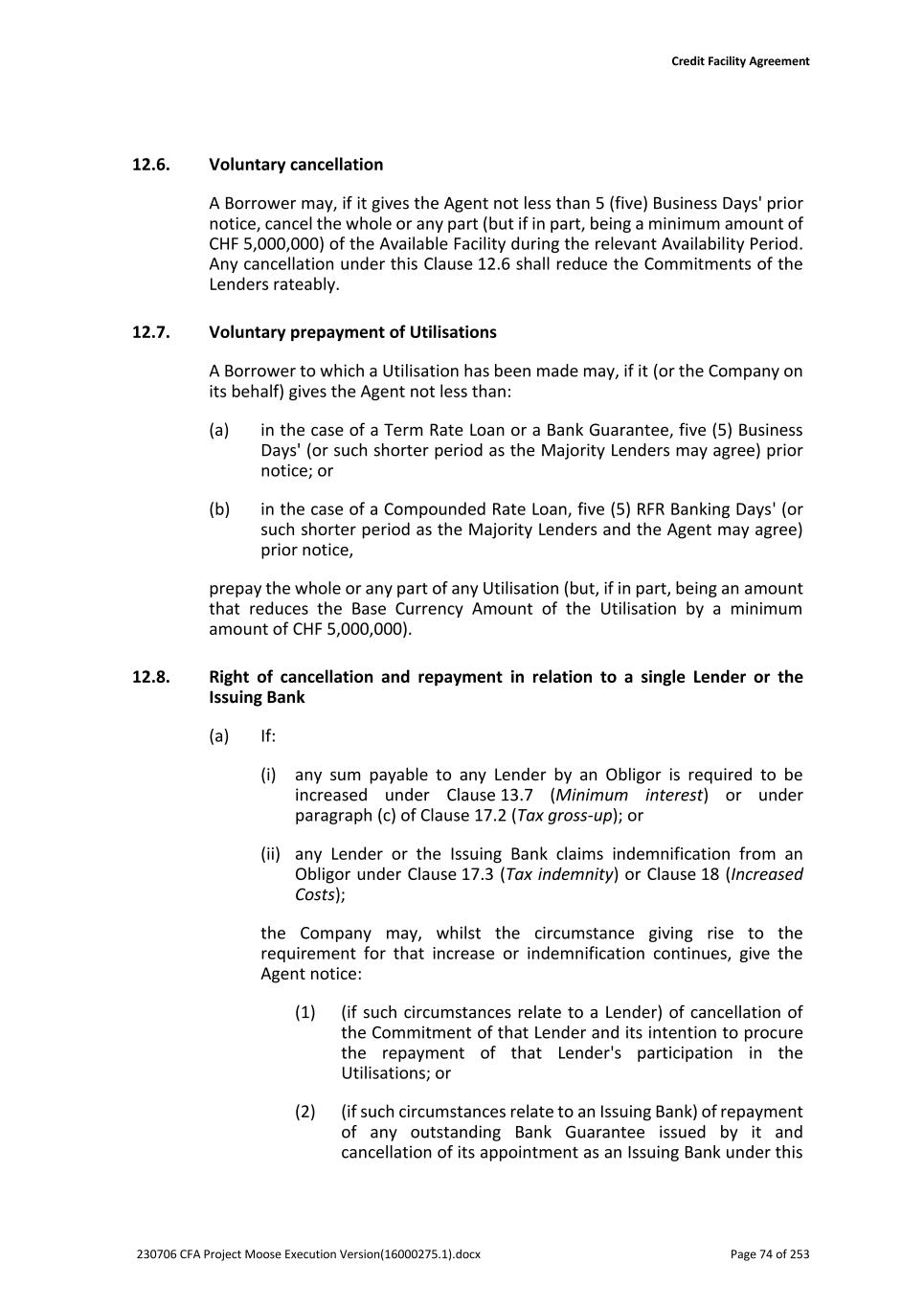
Credit Facility Agreement 230706 CFA Project Moose Execution Version(16000275.1).docx Page 74 of 253 12.6. Voluntary cancellation A Borrower may, if it gives the Agent not less than 5 (five) Business Days' prior notice, cancel the whole or any part (but if in part, being a minimum amount of CHF 5,000,000) of the Available Facility during the relevant Availability Period. Any cancellation under this Clause 12.6 shall reduce the Commitments of the Lenders rateably. 12.7. Voluntary prepayment of Utilisations A Borrower to which a Utilisation has been made may, if it (or the Company on its behalf) gives the Agent not less than: (a) in the case of a Term Rate Loan or a Bank Guarantee, five (5) Business Days' (or such shorter period as the Majority Lenders may agree) prior notice; or (b) in the case of a Compounded Rate Loan, five (5) RFR Banking Days' (or such shorter period as the Majority Lenders and the Agent may agree) prior notice, prepay the whole or any part of any Utilisation (but, if in part, being an amount that reduces the Base Currency Amount of the Utilisation by a minimum amount of CHF 5,000,000). 12.8. Right of cancellation and repayment in relation to a single Lender or the Issuing Bank (a) If: (i) any sum payable to any Lender by an Obligor is required to be increased under Clause 13.7 (Minimum interest) or under paragraph (c) of Clause 17.2 (Tax gross-up); or (ii) any Lender or the Issuing Bank claims indemnification from an Obligor under Clause 17.3 (Tax indemnity) or Clause 18 (Increased Costs); the Company may, whilst the circumstance giving rise to the requirement for that increase or indemnification continues, give the Agent notice: (1) (if such circumstances relate to a Lender) of cancellation of the Commitment of that Lender and its intention to procure the repayment of that Lender's participation in the Utilisations; or (2) (if such circumstances relate to an Issuing Bank) of repayment of any outstanding Bank Guarantee issued by it and cancellation of its appointment as an Issuing Bank under this
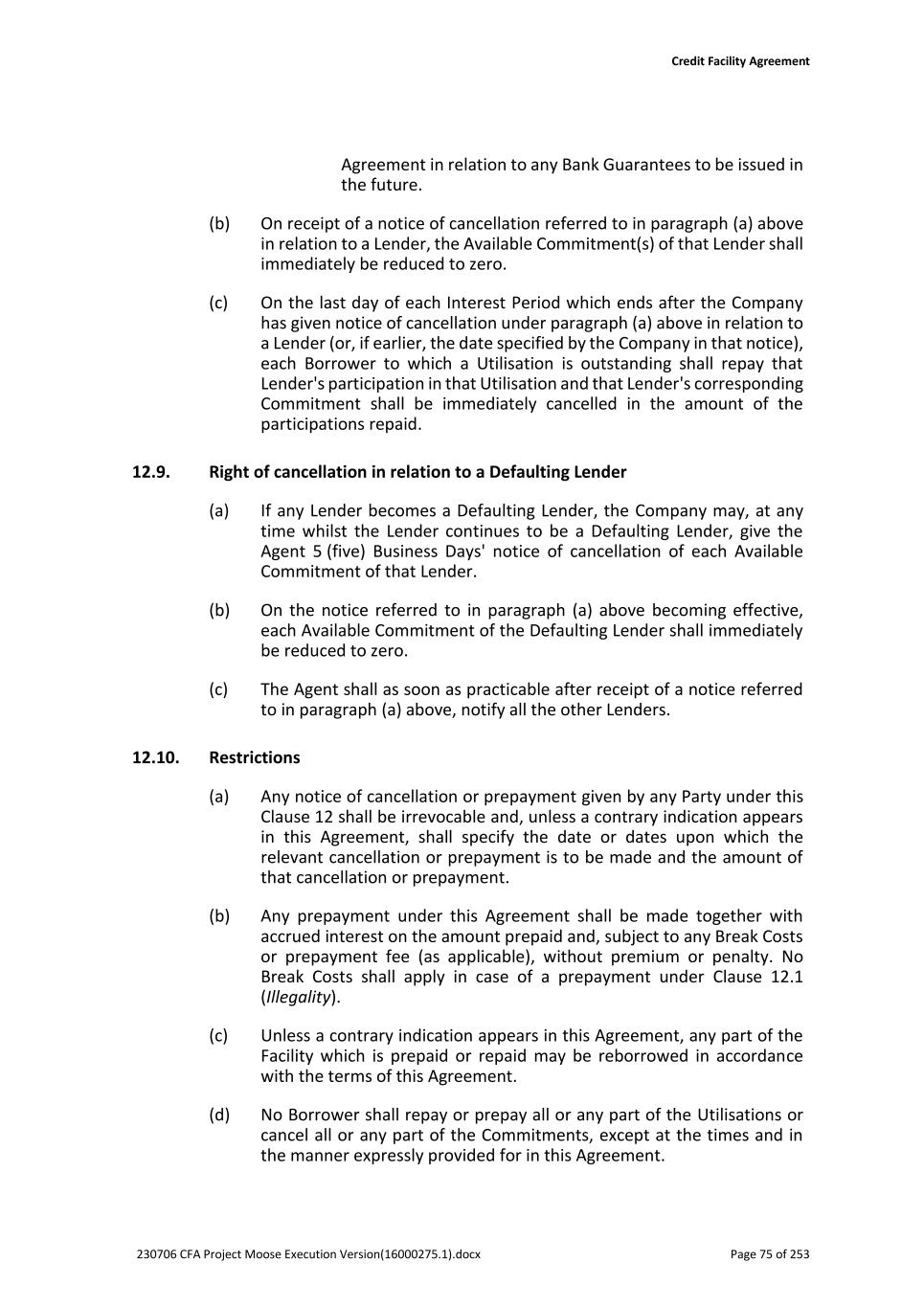
Credit Facility Agreement 230706 CFA Project Moose Execution Version(16000275.1).docx Page 75 of 253 Agreement in relation to any Bank Guarantees to be issued in the future. (b) On receipt of a notice of cancellation referred to in paragraph (a) above in relation to a Lender, the Available Commitment(s) of that Lender shall immediately be reduced to zero. (c) On the last day of each Interest Period which ends after the Company has given notice of cancellation under paragraph (a) above in relation to a Lender (or, if earlier, the date specified by the Company in that notice), each Borrower to which a Utilisation is outstanding shall repay that Lender's participation in that Utilisation and that Lender's corresponding Commitment shall be immediately cancelled in the amount of the participations repaid. 12.9. Right of cancellation in relation to a Defaulting Lender (a) If any Lender becomes a Defaulting Lender, the Company may, at any time whilst the Lender continues to be a Defaulting Lender, give the Agent 5 (five) Business Days' notice of cancellation of each Available Commitment of that Lender. (b) On the notice referred to in paragraph (a) above becoming effective, each Available Commitment of the Defaulting Lender shall immediately be reduced to zero. (c) The Agent shall as soon as practicable after receipt of a notice referred to in paragraph (a) above, notify all the other Lenders. 12.10. Restrictions (a) Any notice of cancellation or prepayment given by any Party under this Clause 12 shall be irrevocable and, unless a contrary indication appears in this Agreement, shall specify the date or dates upon which the relevant cancellation or prepayment is to be made and the amount of that cancellation or prepayment. (b) Any prepayment under this Agreement shall be made together with accrued interest on the amount prepaid and, subject to any Break Costs or prepayment fee (as applicable), without premium or penalty. No Break Costs shall apply in case of a prepayment under Clause 12.1 (Illegality). (c) Unless a contrary indication appears in this Agreement, any part of the Facility which is prepaid or repaid may be reborrowed in accordance with the terms of this Agreement. (d) No Borrower shall repay or prepay all or any part of the Utilisations or cancel all or any part of the Commitments, except at the times and in the manner expressly provided for in this Agreement.
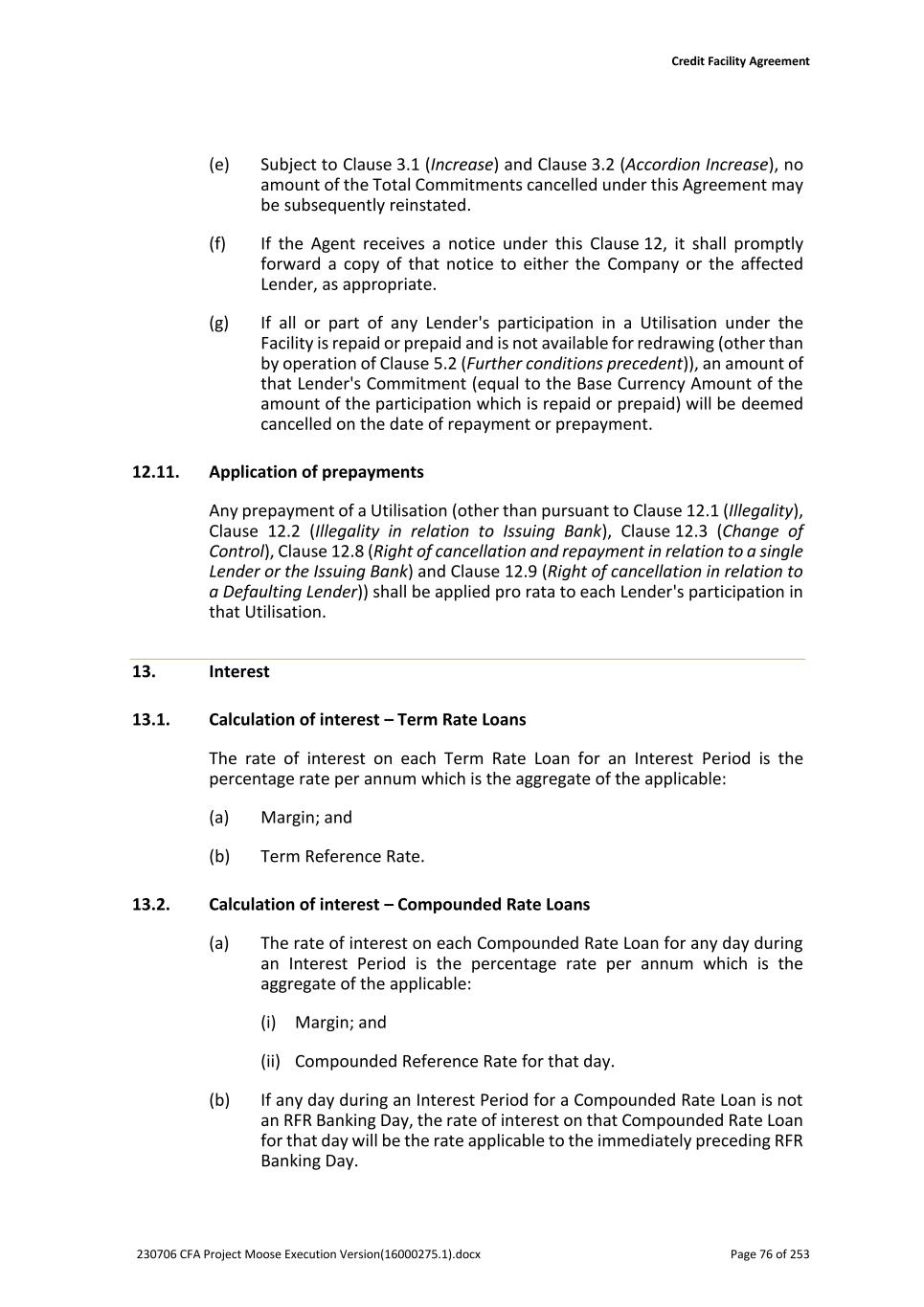
Credit Facility Agreement 230706 CFA Project Moose Execution Version(16000275.1).docx Page 76 of 253 (e) Subject to Clause 3.1 (Increase) and Clause 3.2 (Accordion Increase), no amount of the Total Commitments cancelled under this Agreement may be subsequently reinstated. (f) If the Agent receives a notice under this Clause 12, it shall promptly forward a copy of that notice to either the Company or the affected Lender, as appropriate. (g) If all or part of any Lender's participation in a Utilisation under the Facility is repaid or prepaid and is not available for redrawing (other than by operation of Clause 5.2 (Further conditions precedent)), an amount of that Lender's Commitment (equal to the Base Currency Amount of the amount of the participation which is repaid or prepaid) will be deemed cancelled on the date of repayment or prepayment. 12.11. Application of prepayments Any prepayment of a Utilisation (other than pursuant to Clause 12.1 (Illegality), Clause 12.2 (Illegality in relation to Issuing Bank), Clause 12.3 (Change of Control), Clause 12.8 (Right of cancellation and repayment in relation to a single Lender or the Issuing Bank) and Clause 12.9 (Right of cancellation in relation to a Defaulting Lender)) shall be applied pro rata to each Lender's participation in that Utilisation. 13. Interest 13.1. Calculation of interest – Term Rate Loans The rate of interest on each Term Rate Loan for an Interest Period is the percentage rate per annum which is the aggregate of the applicable: (a) Margin; and (b) Term Reference Rate. 13.2. Calculation of interest – Compounded Rate Loans (a) The rate of interest on each Compounded Rate Loan for any day during an Interest Period is the percentage rate per annum which is the aggregate of the applicable: (i) Margin; and (ii) Compounded Reference Rate for that day. (b) If any day during an Interest Period for a Compounded Rate Loan is not an RFR Banking Day, the rate of interest on that Compounded Rate Loan for that day will be the rate applicable to the immediately preceding RFR Banking Day.
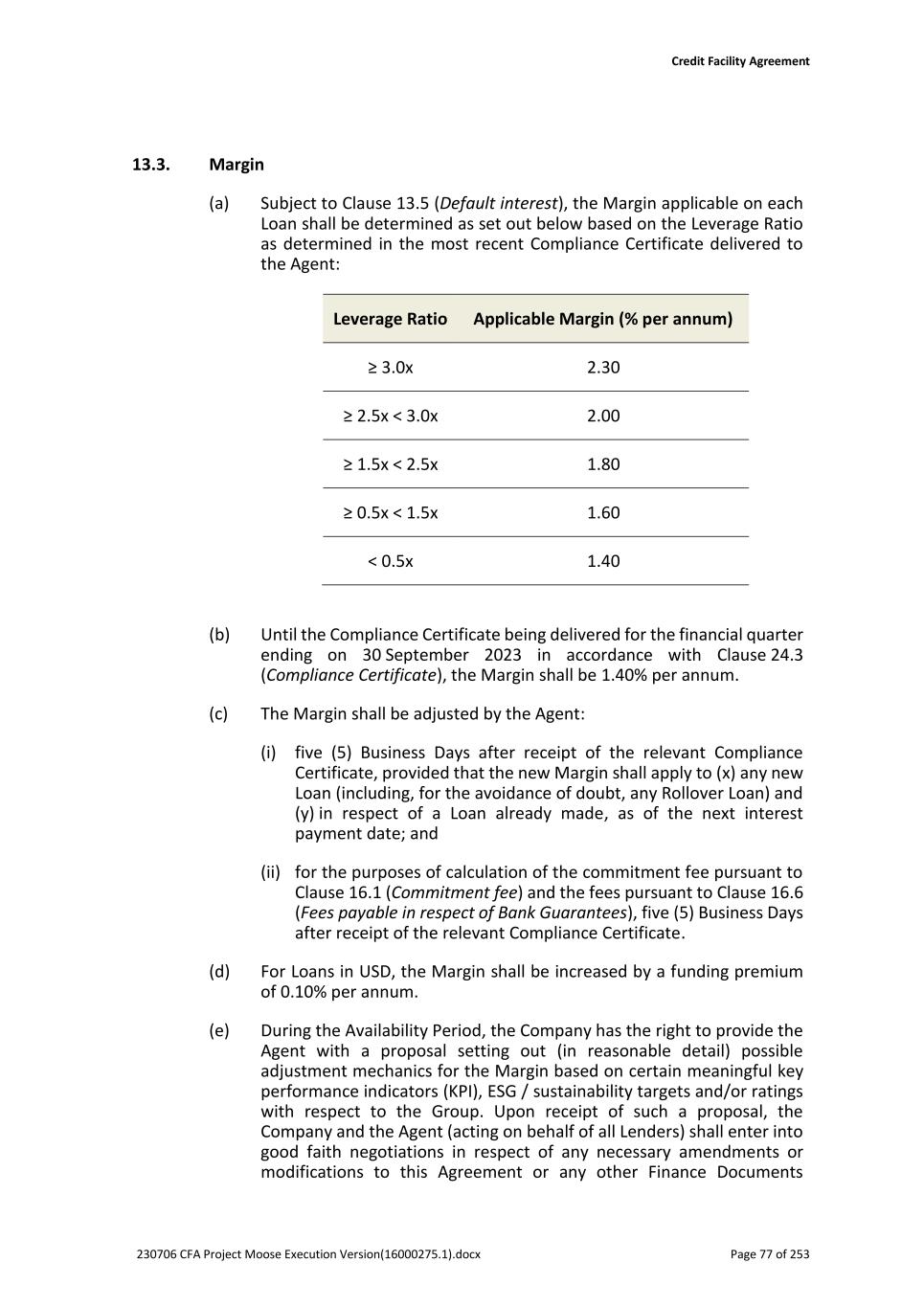
Credit Facility Agreement 230706 CFA Project Moose Execution Version(16000275.1).docx Page 77 of 253 13.3. Margin (a) Subject to Clause 13.5 (Default interest), the Margin applicable on each Loan shall be determined as set out below based on the Leverage Ratio as determined in the most recent Compliance Certificate delivered to the Agent: Leverage Ratio Applicable Margin (% per annum) ≥ 3.0x 2.30 ≥ 2.5x < 3.0x 2.00 ≥ 1.5x < 2.5x 1.80 ≥ 0.5x < 1.5x 1.60 < 0.5x 1.40 (b) Until the Compliance Certificate being delivered for the financial quarter ending on 30 September 2023 in accordance with Clause 24.3 (Compliance Certificate), the Margin shall be 1.40% per annum. (c) The Margin shall be adjusted by the Agent: (i) five (5) Business Days after receipt of the relevant Compliance Certificate, provided that the new Margin shall apply to (x) any new Loan (including, for the avoidance of doubt, any Rollover Loan) and (y) in respect of a Loan already made, as of the next interest payment date; and (ii) for the purposes of calculation of the commitment fee pursuant to Clause 16.1 (Commitment fee) and the fees pursuant to Clause 16.6 (Fees payable in respect of Bank Guarantees), five (5) Business Days after receipt of the relevant Compliance Certificate. (d) For Loans in USD, the Margin shall be increased by a funding premium of 0.10% per annum. (e) During the Availability Period, the Company has the right to provide the Agent with a proposal setting out (in reasonable detail) possible adjustment mechanics for the Margin based on certain meaningful key performance indicators (KPI), ESG / sustainability targets and/or ratings with respect to the Group. Upon receipt of such a proposal, the Company and the Agent (acting on behalf of all Lenders) shall enter into good faith negotiations in respect of any necessary amendments or modifications to this Agreement or any other Finance Documents
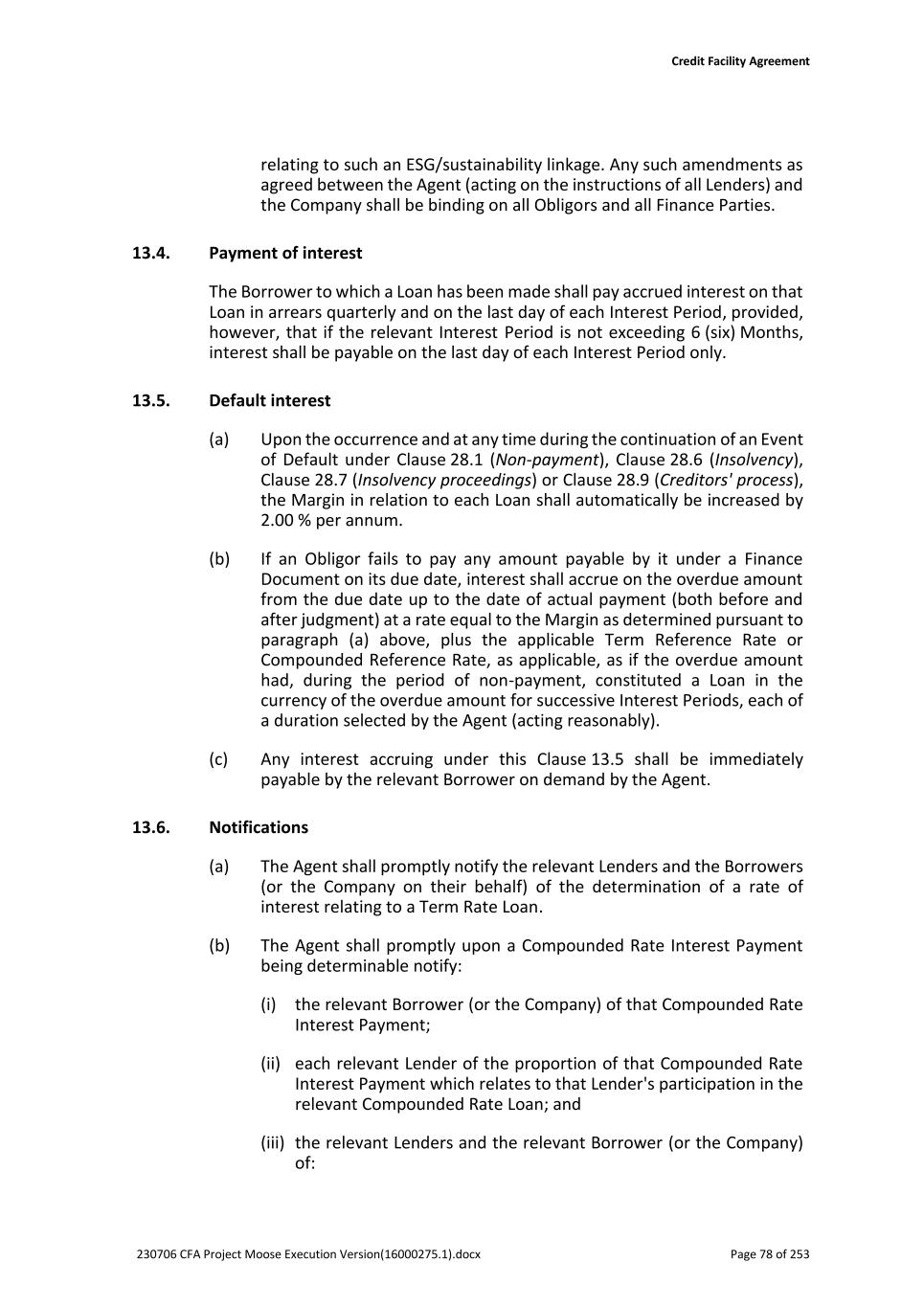
Credit Facility Agreement 230706 CFA Project Moose Execution Version(16000275.1).docx Page 78 of 253 relating to such an ESG/sustainability linkage. Any such amendments as agreed between the Agent (acting on the instructions of all Lenders) and the Company shall be binding on all Obligors and all Finance Parties. 13.4. Payment of interest The Borrower to which a Loan has been made shall pay accrued interest on that Loan in arrears quarterly and on the last day of each Interest Period, provided, however, that if the relevant Interest Period is not exceeding 6 (six) Months, interest shall be payable on the last day of each Interest Period only. 13.5. Default interest (a) Upon the occurrence and at any time during the continuation of an Event of Default under Clause 28.1 (Non-payment), Clause 28.6 (Insolvency), Clause 28.7 (Insolvency proceedings) or Clause 28.9 (Creditors' process), the Margin in relation to each Loan shall automatically be increased by 2.00 % per annum. (b) If an Obligor fails to pay any amount payable by it under a Finance Document on its due date, interest shall accrue on the overdue amount from the due date up to the date of actual payment (both before and after judgment) at a rate equal to the Margin as determined pursuant to paragraph (a) above, plus the applicable Term Reference Rate or Compounded Reference Rate, as applicable, as if the overdue amount had, during the period of non-payment, constituted a Loan in the currency of the overdue amount for successive Interest Periods, each of a duration selected by the Agent (acting reasonably). (c) Any interest accruing under this Clause 13.5 shall be immediately payable by the relevant Borrower on demand by the Agent. 13.6. Notifications (a) The Agent shall promptly notify the relevant Lenders and the Borrowers (or the Company on their behalf) of the determination of a rate of interest relating to a Term Rate Loan. (b) The Agent shall promptly upon a Compounded Rate Interest Payment being determinable notify: (i) the relevant Borrower (or the Company) of that Compounded Rate Interest Payment; (ii) each relevant Lender of the proportion of that Compounded Rate Interest Payment which relates to that Lender's participation in the relevant Compounded Rate Loan; and (iii) the relevant Lenders and the relevant Borrower (or the Company) of:
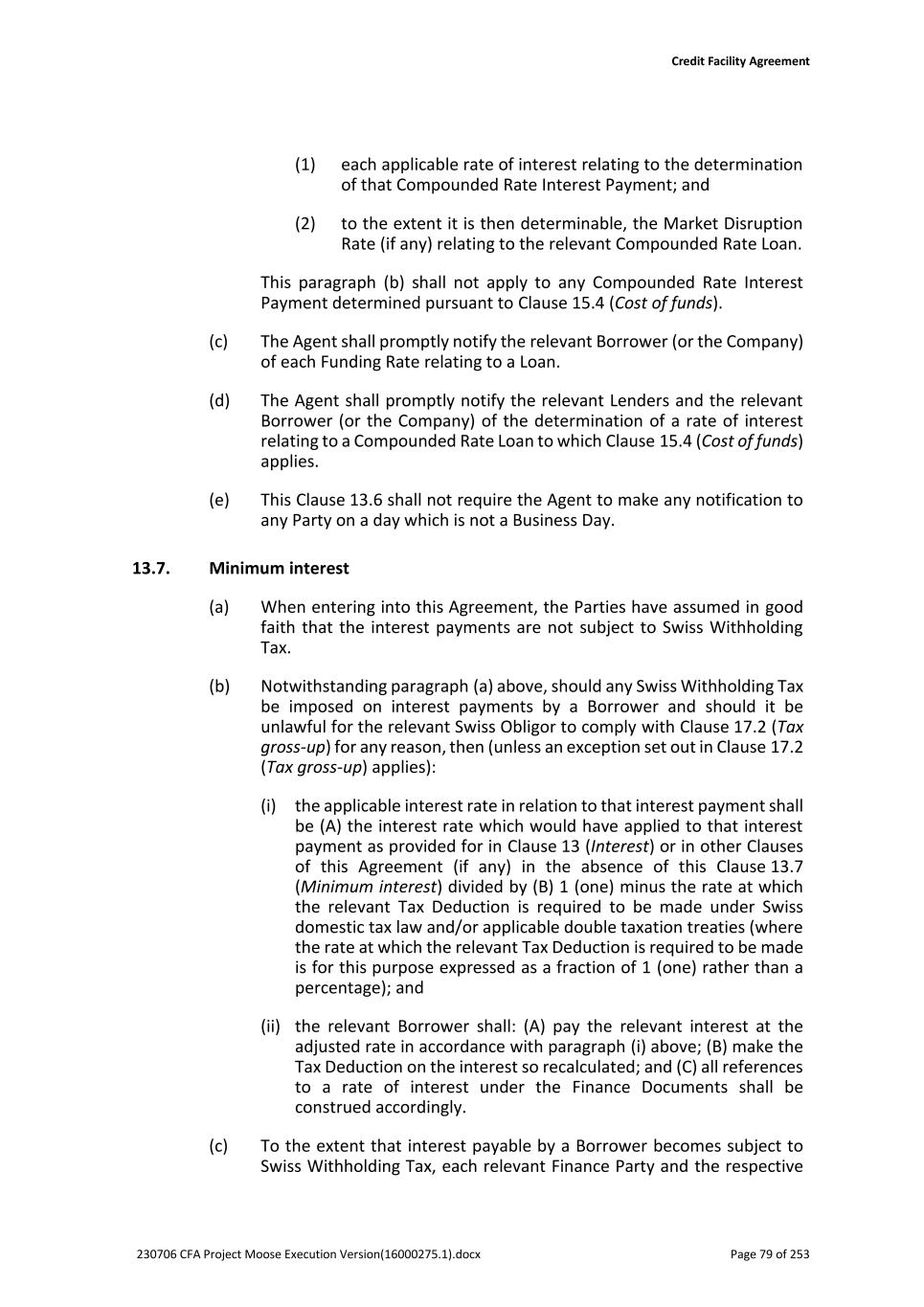
Credit Facility Agreement 230706 CFA Project Moose Execution Version(16000275.1).docx Page 79 of 253 (1) each applicable rate of interest relating to the determination of that Compounded Rate Interest Payment; and (2) to the extent it is then determinable, the Market Disruption Rate (if any) relating to the relevant Compounded Rate Loan. This paragraph (b) shall not apply to any Compounded Rate Interest Payment determined pursuant to Clause 15.4 (Cost of funds). (c) The Agent shall promptly notify the relevant Borrower (or the Company) of each Funding Rate relating to a Loan. (d) The Agent shall promptly notify the relevant Lenders and the relevant Borrower (or the Company) of the determination of a rate of interest relating to a Compounded Rate Loan to which Clause 15.4 (Cost of funds) applies. (e) This Clause 13.6 shall not require the Agent to make any notification to any Party on a day which is not a Business Day. 13.7. Minimum interest (a) When entering into this Agreement, the Parties have assumed in good faith that the interest payments are not subject to Swiss Withholding Tax. (b) Notwithstanding paragraph (a) above, should any Swiss Withholding Tax be imposed on interest payments by a Borrower and should it be unlawful for the relevant Swiss Obligor to comply with Clause 17.2 (Tax gross-up) for any reason, then (unless an exception set out in Clause 17.2 (Tax gross-up) applies): (i) the applicable interest rate in relation to that interest payment shall be (A) the interest rate which would have applied to that interest payment as provided for in Clause 13 (Interest) or in other Clauses of this Agreement (if any) in the absence of this Clause 13.7 (Minimum interest) divided by (B) 1 (one) minus the rate at which the relevant Tax Deduction is required to be made under Swiss domestic tax law and/or applicable double taxation treaties (where the rate at which the relevant Tax Deduction is required to be made is for this purpose expressed as a fraction of 1 (one) rather than a percentage); and (ii) the relevant Borrower shall: (A) pay the relevant interest at the adjusted rate in accordance with paragraph (i) above; (B) make the Tax Deduction on the interest so recalculated; and (C) all references to a rate of interest under the Finance Documents shall be construed accordingly. (c) To the extent that interest payable by a Borrower becomes subject to Swiss Withholding Tax, each relevant Finance Party and the respective
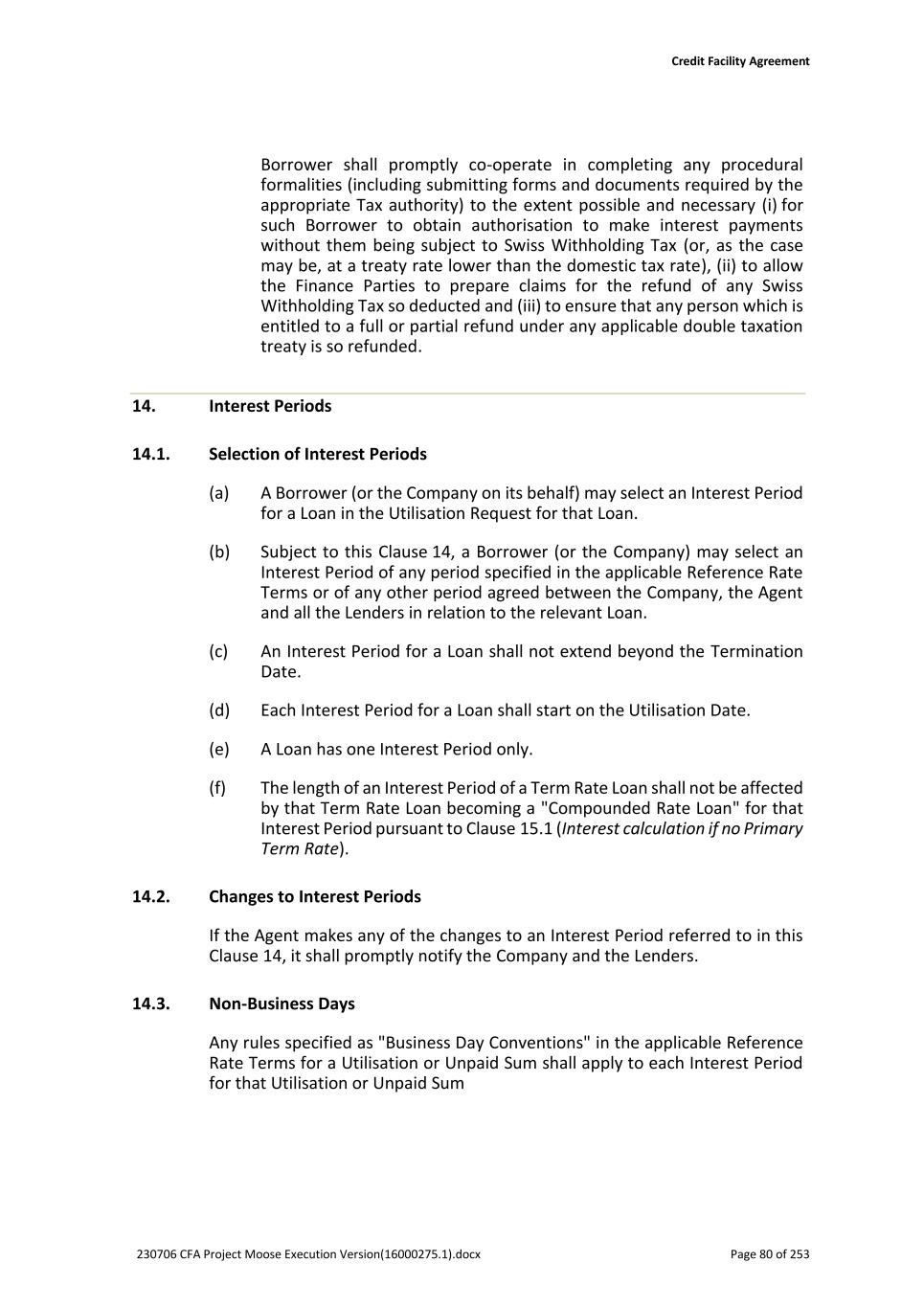
Credit Facility Agreement 230706 CFA Project Moose Execution Version(16000275.1).docx Page 80 of 253 Borrower shall promptly co-operate in completing any procedural formalities (including submitting forms and documents required by the appropriate Tax authority) to the extent possible and necessary (i) for such Borrower to obtain authorisation to make interest payments without them being subject to Swiss Withholding Tax (or, as the case may be, at a treaty rate lower than the domestic tax rate), (ii) to allow the Finance Parties to prepare claims for the refund of any Swiss Withholding Tax so deducted and (iii) to ensure that any person which is entitled to a full or partial refund under any applicable double taxation treaty is so refunded. 14. Interest Periods 14.1. Selection of Interest Periods (a) A Borrower (or the Company on its behalf) may select an Interest Period for a Loan in the Utilisation Request for that Loan. (b) Subject to this Clause 14, a Borrower (or the Company) may select an Interest Period of any period specified in the applicable Reference Rate Terms or of any other period agreed between the Company, the Agent and all the Lenders in relation to the relevant Loan. (c) An Interest Period for a Loan shall not extend beyond the Termination Date. (d) Each Interest Period for a Loan shall start on the Utilisation Date. (e) A Loan has one Interest Period only. (f) The length of an Interest Period of a Term Rate Loan shall not be affected by that Term Rate Loan becoming a "Compounded Rate Loan" for that Interest Period pursuant to Clause 15.1 (Interest calculation if no Primary Term Rate). 14.2. Changes to Interest Periods If the Agent makes any of the changes to an Interest Period referred to in this Clause 14, it shall promptly notify the Company and the Lenders. 14.3. Non-Business Days Any rules specified as "Business Day Conventions" in the applicable Reference Rate Terms for a Utilisation or Unpaid Sum shall apply to each Interest Period for that Utilisation or Unpaid Sum
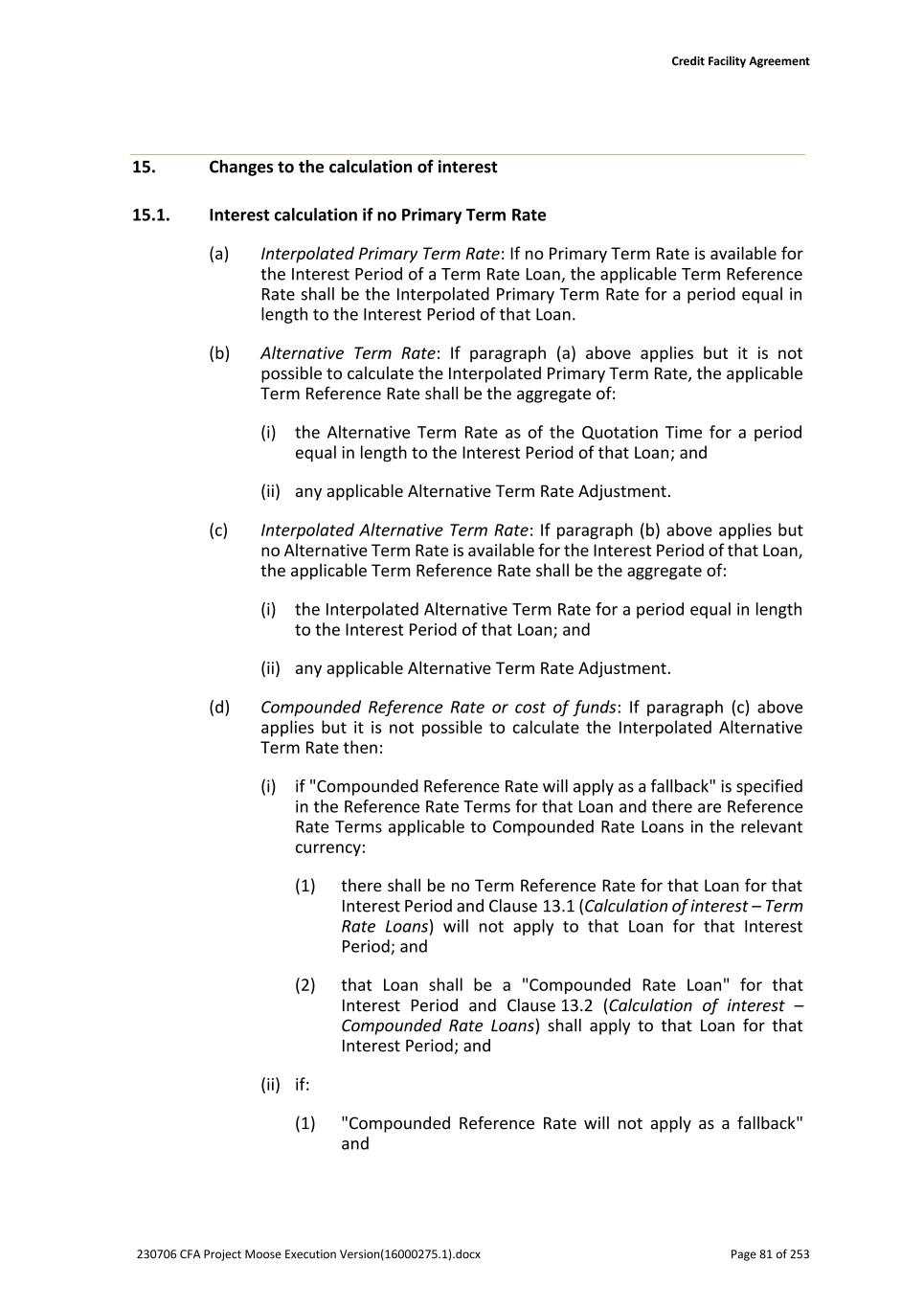
Credit Facility Agreement 230706 CFA Project Moose Execution Version(16000275.1).docx Page 81 of 253 15. Changes to the calculation of interest 15.1. Interest calculation if no Primary Term Rate (a) Interpolated Primary Term Rate: If no Primary Term Rate is available for the Interest Period of a Term Rate Loan, the applicable Term Reference Rate shall be the Interpolated Primary Term Rate for a period equal in length to the Interest Period of that Loan. (b) Alternative Term Rate: If paragraph (a) above applies but it is not possible to calculate the Interpolated Primary Term Rate, the applicable Term Reference Rate shall be the aggregate of: (i) the Alternative Term Rate as of the Quotation Time for a period equal in length to the Interest Period of that Loan; and (ii) any applicable Alternative Term Rate Adjustment. (c) Interpolated Alternative Term Rate: If paragraph (b) above applies but no Alternative Term Rate is available for the Interest Period of that Loan, the applicable Term Reference Rate shall be the aggregate of: (i) the Interpolated Alternative Term Rate for a period equal in length to the Interest Period of that Loan; and (ii) any applicable Alternative Term Rate Adjustment. (d) Compounded Reference Rate or cost of funds: If paragraph (c) above applies but it is not possible to calculate the Interpolated Alternative Term Rate then: (i) if "Compounded Reference Rate will apply as a fallback" is specified in the Reference Rate Terms for that Loan and there are Reference Rate Terms applicable to Compounded Rate Loans in the relevant currency: (1) there shall be no Term Reference Rate for that Loan for that Interest Period and Clause 13.1 (Calculation of interest – Term Rate Loans) will not apply to that Loan for that Interest Period; and (2) that Loan shall be a "Compounded Rate Loan" for that Interest Period and Clause 13.2 (Calculation of interest – Compounded Rate Loans) shall apply to that Loan for that Interest Period; and (ii) if: (1) "Compounded Reference Rate will not apply as a fallback" and
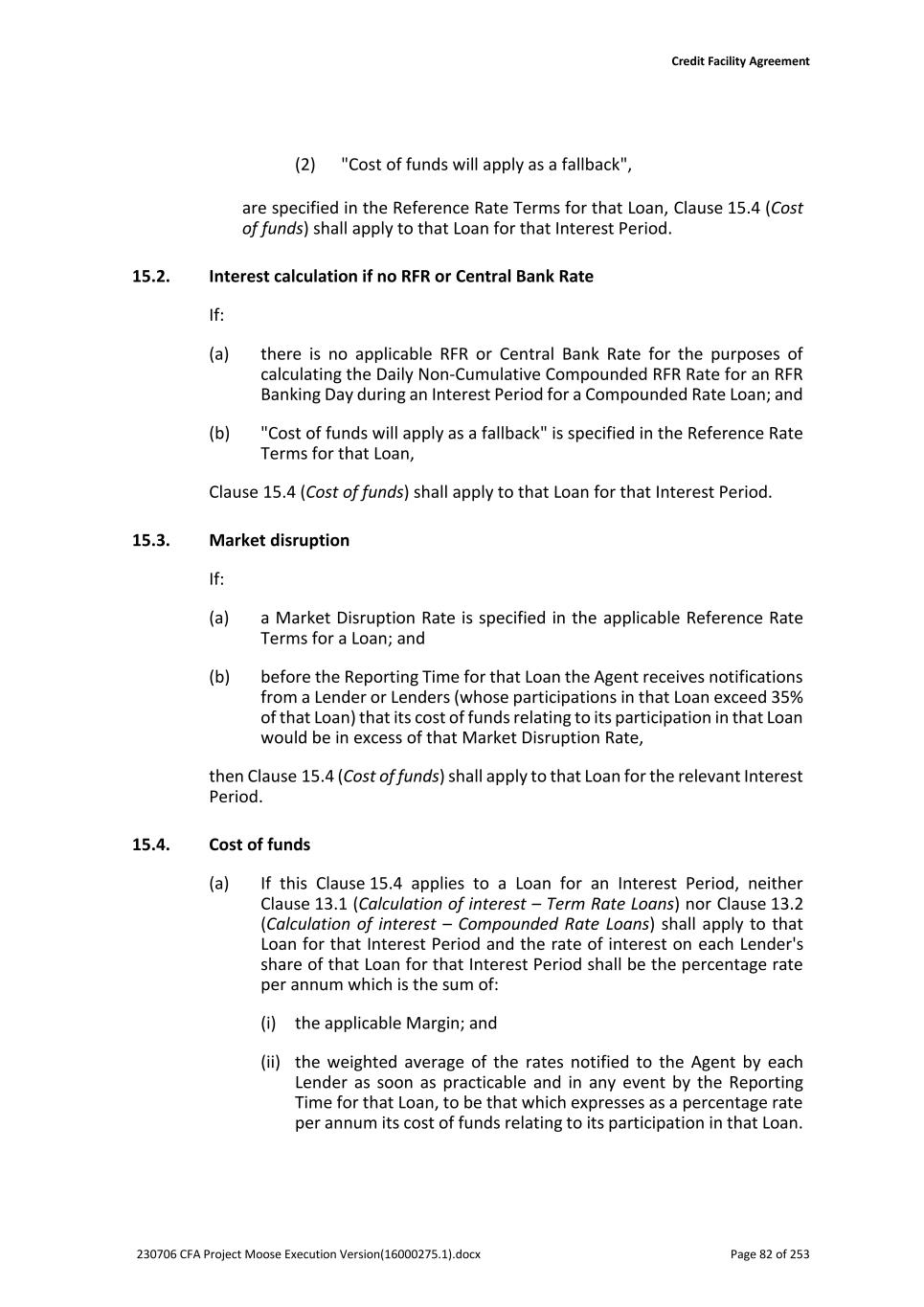
Credit Facility Agreement 230706 CFA Project Moose Execution Version(16000275.1).docx Page 82 of 253 (2) "Cost of funds will apply as a fallback", are specified in the Reference Rate Terms for that Loan, Clause 15.4 (Cost of funds) shall apply to that Loan for that Interest Period. 15.2. Interest calculation if no RFR or Central Bank Rate If: (a) there is no applicable RFR or Central Bank Rate for the purposes of calculating the Daily Non-Cumulative Compounded RFR Rate for an RFR Banking Day during an Interest Period for a Compounded Rate Loan; and (b) "Cost of funds will apply as a fallback" is specified in the Reference Rate Terms for that Loan, Clause 15.4 (Cost of funds) shall apply to that Loan for that Interest Period. 15.3. Market disruption If: (a) a Market Disruption Rate is specified in the applicable Reference Rate Terms for a Loan; and (b) before the Reporting Time for that Loan the Agent receives notifications from a Lender or Lenders (whose participations in that Loan exceed 35% of that Loan) that its cost of funds relating to its participation in that Loan would be in excess of that Market Disruption Rate, then Clause 15.4 (Cost of funds) shall apply to that Loan for the relevant Interest Period. 15.4. Cost of funds (a) If this Clause 15.4 applies to a Loan for an Interest Period, neither Clause 13.1 (Calculation of interest – Term Rate Loans) nor Clause 13.2 (Calculation of interest – Compounded Rate Loans) shall apply to that Loan for that Interest Period and the rate of interest on each Lender's share of that Loan for that Interest Period shall be the percentage rate per annum which is the sum of: (i) the applicable Margin; and (ii) the weighted average of the rates notified to the Agent by each Lender as soon as practicable and in any event by the Reporting Time for that Loan, to be that which expresses as a percentage rate per annum its cost of funds relating to its participation in that Loan.
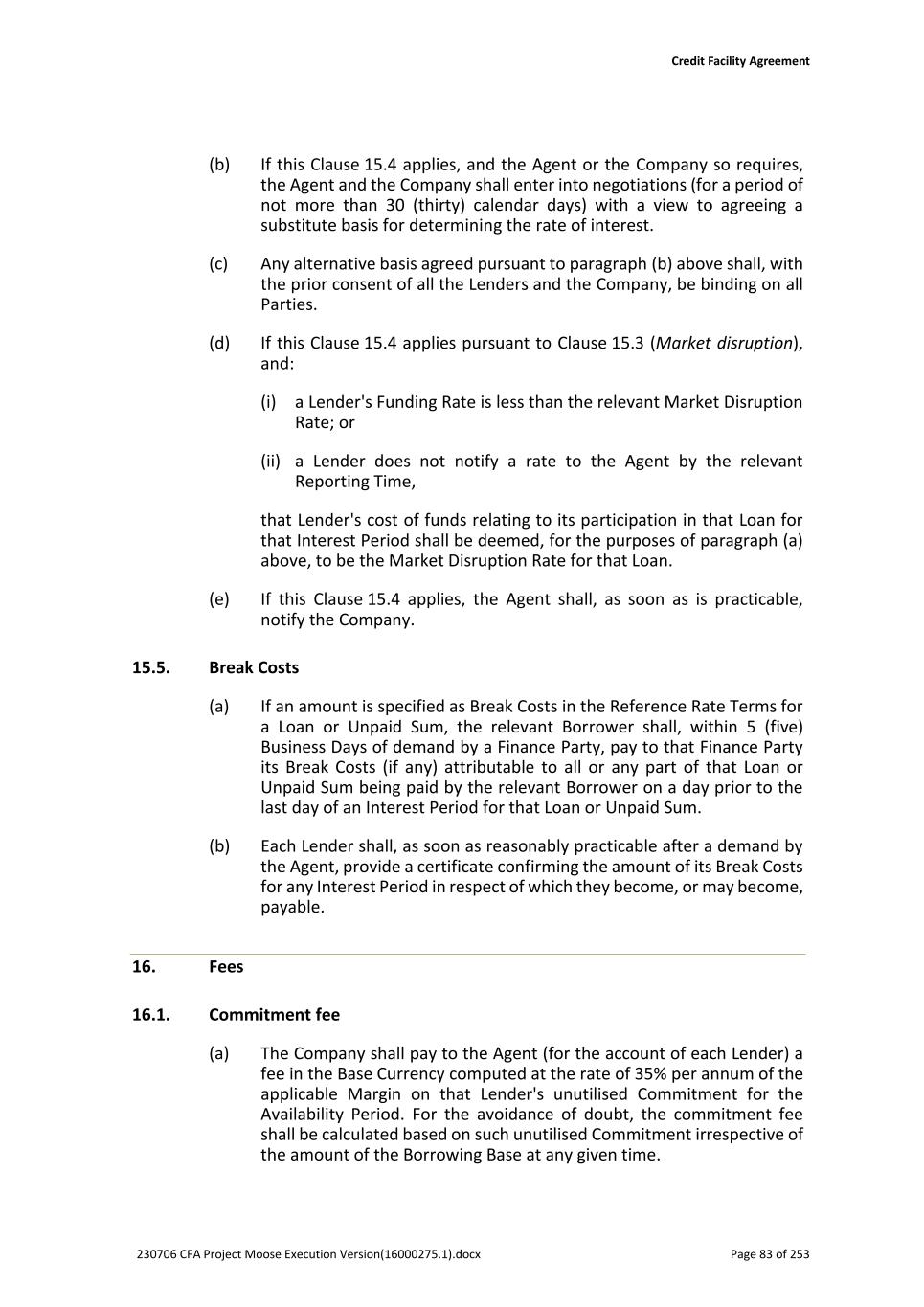
Credit Facility Agreement 230706 CFA Project Moose Execution Version(16000275.1).docx Page 83 of 253 (b) If this Clause 15.4 applies, and the Agent or the Company so requires, the Agent and the Company shall enter into negotiations (for a period of not more than 30 (thirty) calendar days) with a view to agreeing a substitute basis for determining the rate of interest. (c) Any alternative basis agreed pursuant to paragraph (b) above shall, with the prior consent of all the Lenders and the Company, be binding on all Parties. (d) If this Clause 15.4 applies pursuant to Clause 15.3 (Market disruption), and: (i) a Lender's Funding Rate is less than the relevant Market Disruption Rate; or (ii) a Lender does not notify a rate to the Agent by the relevant Reporting Time, that Lender's cost of funds relating to its participation in that Loan for that Interest Period shall be deemed, for the purposes of paragraph (a) above, to be the Market Disruption Rate for that Loan. (e) If this Clause 15.4 applies, the Agent shall, as soon as is practicable, notify the Company. 15.5. Break Costs (a) If an amount is specified as Break Costs in the Reference Rate Terms for a Loan or Unpaid Sum, the relevant Borrower shall, within 5 (five) Business Days of demand by a Finance Party, pay to that Finance Party its Break Costs (if any) attributable to all or any part of that Loan or Unpaid Sum being paid by the relevant Borrower on a day prior to the last day of an Interest Period for that Loan or Unpaid Sum. (b) Each Lender shall, as soon as reasonably practicable after a demand by the Agent, provide a certificate confirming the amount of its Break Costs for any Interest Period in respect of which they become, or may become, payable. 16. Fees 16.1. Commitment fee (a) The Company shall pay to the Agent (for the account of each Lender) a fee in the Base Currency computed at the rate of 35% per annum of the applicable Margin on that Lender's unutilised Commitment for the Availability Period. For the avoidance of doubt, the commitment fee shall be calculated based on such unutilised Commitment irrespective of the amount of the Borrowing Base at any given time.
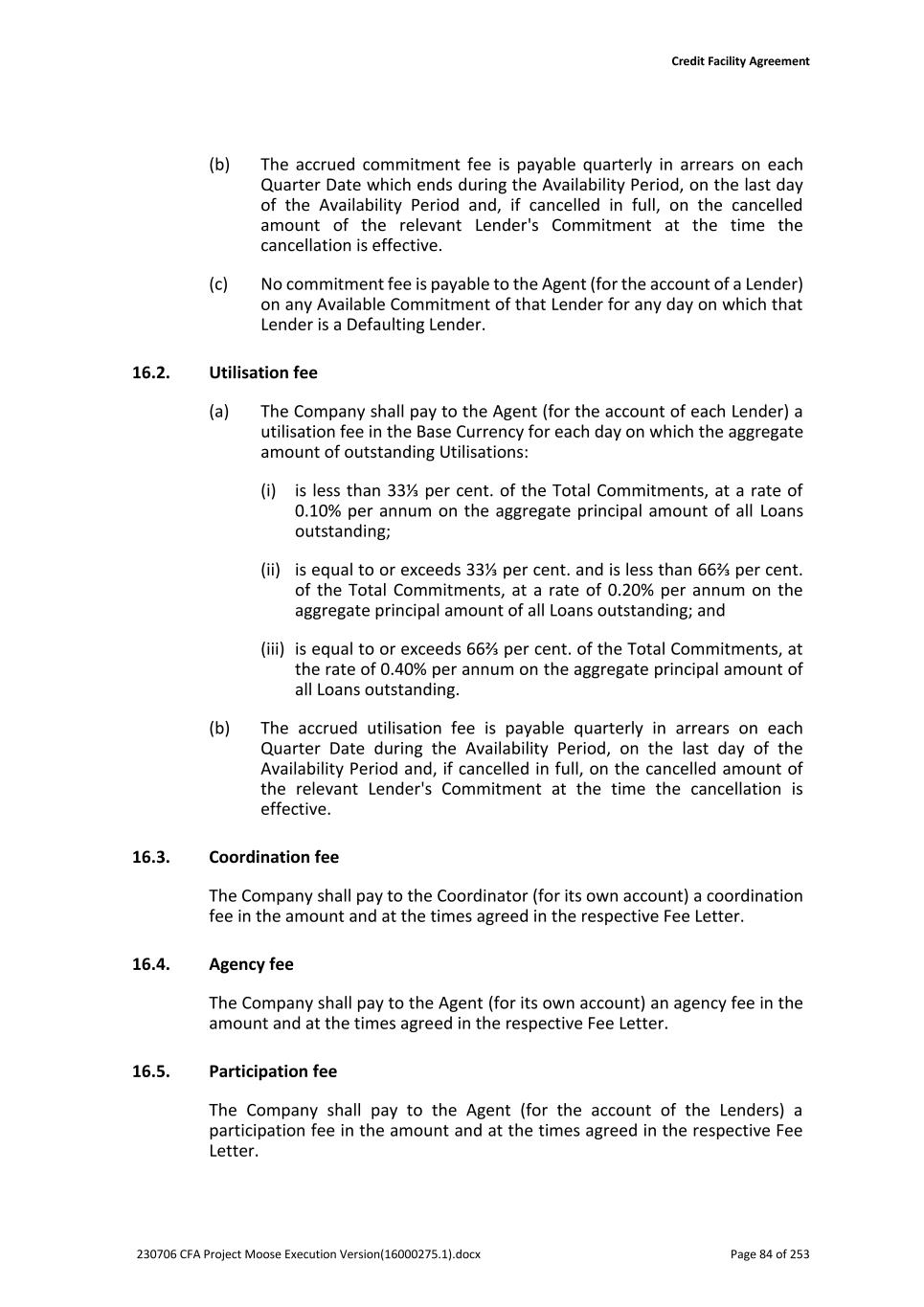
Credit Facility Agreement 230706 CFA Project Moose Execution Version(16000275.1).docx Page 84 of 253 (b) The accrued commitment fee is payable quarterly in arrears on each Quarter Date which ends during the Availability Period, on the last day of the Availability Period and, if cancelled in full, on the cancelled amount of the relevant Lender's Commitment at the time the cancellation is effective. (c) No commitment fee is payable to the Agent (for the account of a Lender) on any Available Commitment of that Lender for any day on which that Lender is a Defaulting Lender. 16.2. Utilisation fee (a) The Company shall pay to the Agent (for the account of each Lender) a utilisation fee in the Base Currency for each day on which the aggregate amount of outstanding Utilisations: (i) is less than 33⅓ per cent. of the Total Commitments, at a rate of 0.10% per annum on the aggregate principal amount of all Loans outstanding; (ii) is equal to or exceeds 33⅓ per cent. and is less than 66⅔ per cent. of the Total Commitments, at a rate of 0.20% per annum on the aggregate principal amount of all Loans outstanding; and (iii) is equal to or exceeds 66⅔ per cent. of the Total Commitments, at the rate of 0.40% per annum on the aggregate principal amount of all Loans outstanding. (b) The accrued utilisation fee is payable quarterly in arrears on each Quarter Date during the Availability Period, on the last day of the Availability Period and, if cancelled in full, on the cancelled amount of the relevant Lender's Commitment at the time the cancellation is effective. 16.3. Coordination fee The Company shall pay to the Coordinator (for its own account) a coordination fee in the amount and at the times agreed in the respective Fee Letter. 16.4. Agency fee The Company shall pay to the Agent (for its own account) an agency fee in the amount and at the times agreed in the respective Fee Letter. 16.5. Participation fee The Company shall pay to the Agent (for the account of the Lenders) a participation fee in the amount and at the times agreed in the respective Fee Letter.
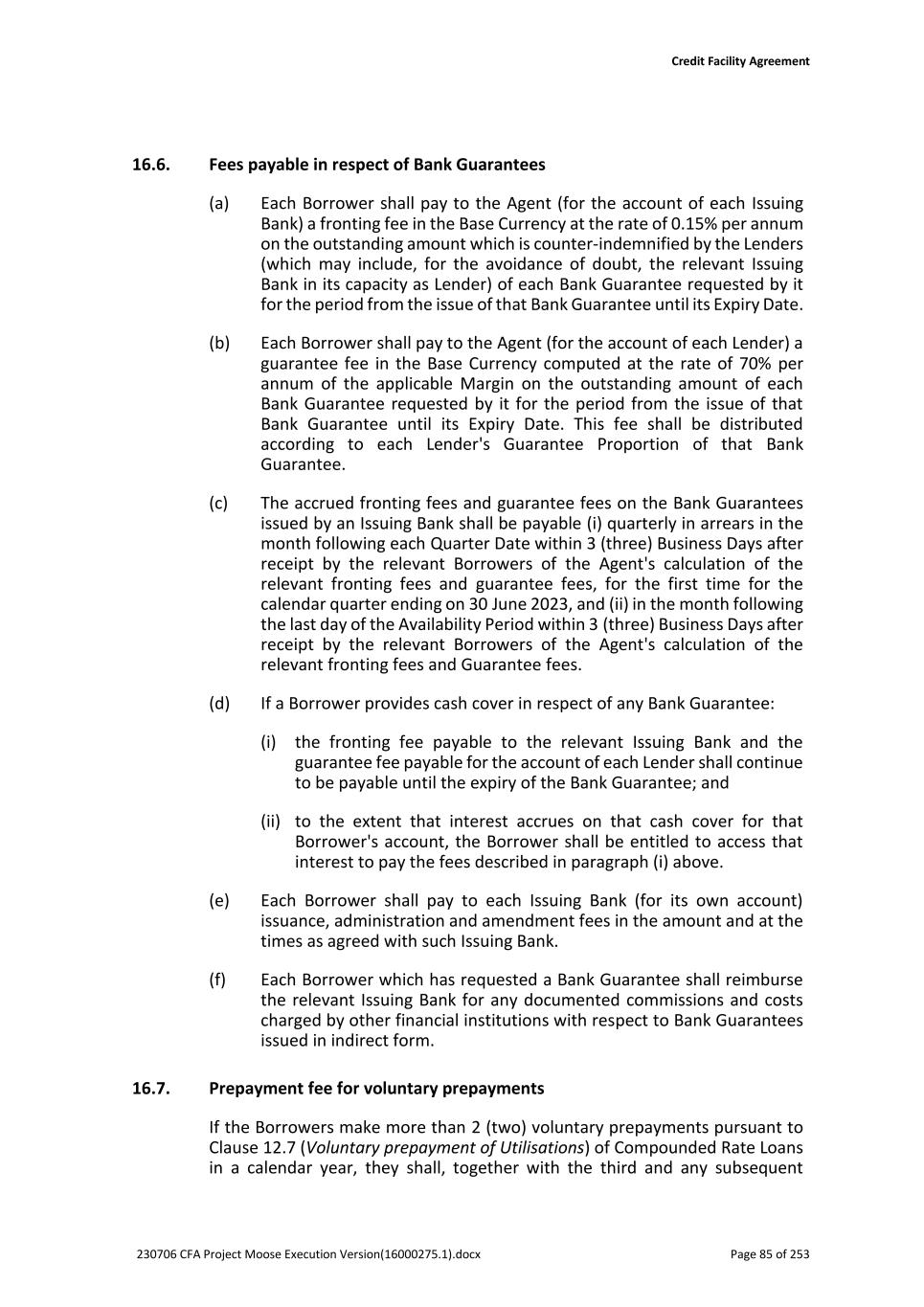
Credit Facility Agreement 230706 CFA Project Moose Execution Version(16000275.1).docx Page 85 of 253 16.6. Fees payable in respect of Bank Guarantees (a) Each Borrower shall pay to the Agent (for the account of each Issuing Bank) a fronting fee in the Base Currency at the rate of 0.15% per annum on the outstanding amount which is counter-indemnified by the Lenders (which may include, for the avoidance of doubt, the relevant Issuing Bank in its capacity as Lender) of each Bank Guarantee requested by it for the period from the issue of that Bank Guarantee until its Expiry Date. (b) Each Borrower shall pay to the Agent (for the account of each Lender) a guarantee fee in the Base Currency computed at the rate of 70% per annum of the applicable Margin on the outstanding amount of each Bank Guarantee requested by it for the period from the issue of that Bank Guarantee until its Expiry Date. This fee shall be distributed according to each Lender's Guarantee Proportion of that Bank Guarantee. (c) The accrued fronting fees and guarantee fees on the Bank Guarantees issued by an Issuing Bank shall be payable (i) quarterly in arrears in the month following each Quarter Date within 3 (three) Business Days after receipt by the relevant Borrowers of the Agent's calculation of the relevant fronting fees and guarantee fees, for the first time for the calendar quarter ending on 30 June 2023, and (ii) in the month following the last day of the Availability Period within 3 (three) Business Days after receipt by the relevant Borrowers of the Agent's calculation of the relevant fronting fees and Guarantee fees. (d) If a Borrower provides cash cover in respect of any Bank Guarantee: (i) the fronting fee payable to the relevant Issuing Bank and the guarantee fee payable for the account of each Lender shall continue to be payable until the expiry of the Bank Guarantee; and (ii) to the extent that interest accrues on that cash cover for that Borrower's account, the Borrower shall be entitled to access that interest to pay the fees described in paragraph (i) above. (e) Each Borrower shall pay to each Issuing Bank (for its own account) issuance, administration and amendment fees in the amount and at the times as agreed with such Issuing Bank. (f) Each Borrower which has requested a Bank Guarantee shall reimburse the relevant Issuing Bank for any documented commissions and costs charged by other financial institutions with respect to Bank Guarantees issued in indirect form. 16.7. Prepayment fee for voluntary prepayments If the Borrowers make more than 2 (two) voluntary prepayments pursuant to Clause 12.7 (Voluntary prepayment of Utilisations) of Compounded Rate Loans in a calendar year, they shall, together with the third and any subsequent
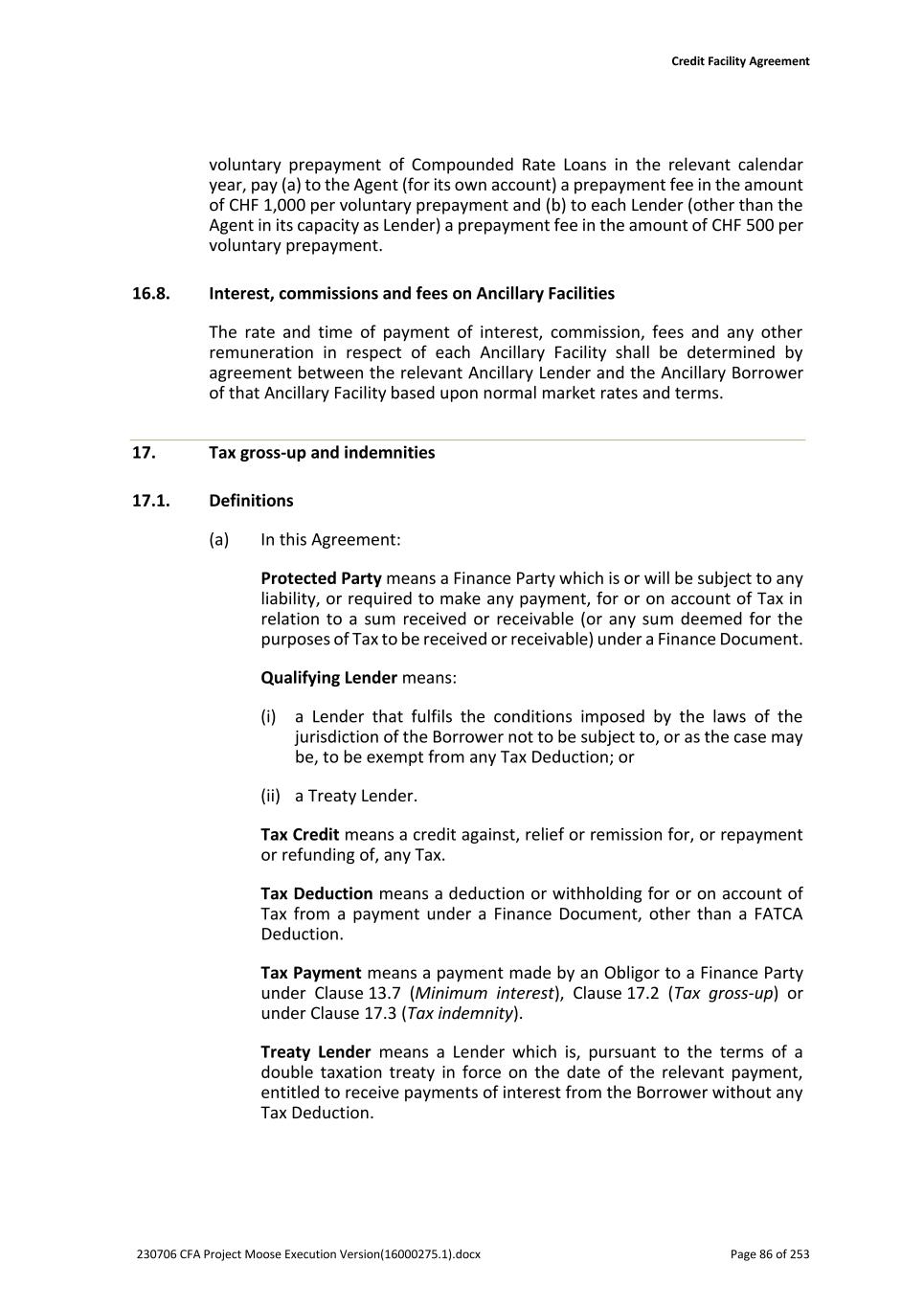
Credit Facility Agreement 230706 CFA Project Moose Execution Version(16000275.1).docx Page 86 of 253 voluntary prepayment of Compounded Rate Loans in the relevant calendar year, pay (a) to the Agent (for its own account) a prepayment fee in the amount of CHF 1,000 per voluntary prepayment and (b) to each Lender (other than the Agent in its capacity as Lender) a prepayment fee in the amount of CHF 500 per voluntary prepayment. 16.8. Interest, commissions and fees on Ancillary Facilities The rate and time of payment of interest, commission, fees and any other remuneration in respect of each Ancillary Facility shall be determined by agreement between the relevant Ancillary Lender and the Ancillary Borrower of that Ancillary Facility based upon normal market rates and terms. 17. Tax gross-up and indemnities 17.1. Definitions (a) In this Agreement: Protected Party means a Finance Party which is or will be subject to any liability, or required to make any payment, for or on account of Tax in relation to a sum received or receivable (or any sum deemed for the purposes of Tax to be received or receivable) under a Finance Document. Qualifying Lender means: (i) a Lender that fulfils the conditions imposed by the laws of the jurisdiction of the Borrower not to be subject to, or as the case may be, to be exempt from any Tax Deduction; or (ii) a Treaty Lender. Tax Credit means a credit against, relief or remission for, or repayment or refunding of, any Tax. Tax Deduction means a deduction or withholding for or on account of Tax from a payment under a Finance Document, other than a FATCA Deduction. Tax Payment means a payment made by an Obligor to a Finance Party under Clause 13.7 (Minimum interest), Clause 17.2 (Tax gross-up) or under Clause 17.3 (Tax indemnity). Treaty Lender means a Lender which is, pursuant to the terms of a double taxation treaty in force on the date of the relevant payment, entitled to receive payments of interest from the Borrower without any Tax Deduction.
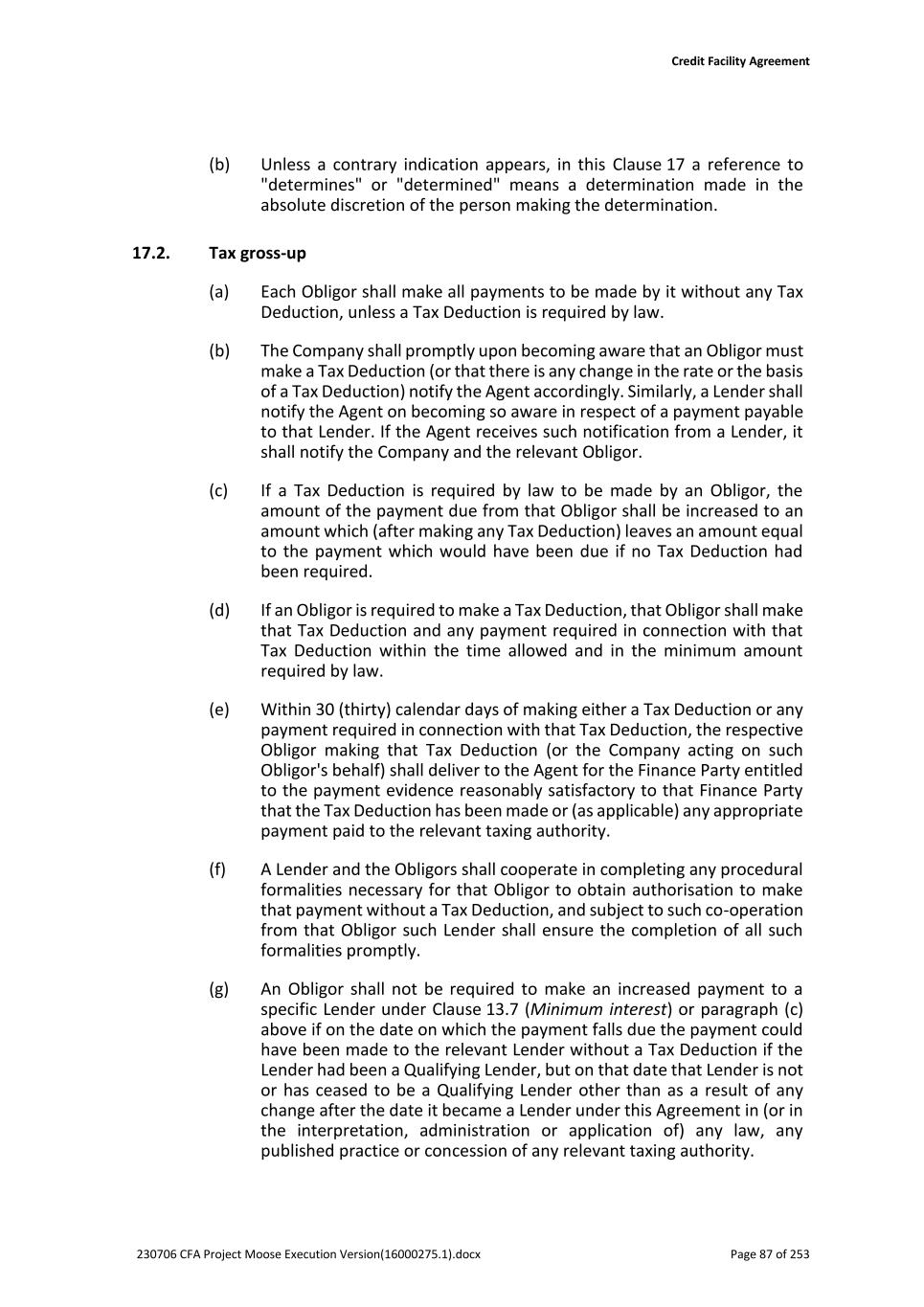
Credit Facility Agreement 230706 CFA Project Moose Execution Version(16000275.1).docx Page 87 of 253 (b) Unless a contrary indication appears, in this Clause 17 a reference to "determines" or "determined" means a determination made in the absolute discretion of the person making the determination. 17.2. Tax gross-up (a) Each Obligor shall make all payments to be made by it without any Tax Deduction, unless a Tax Deduction is required by law. (b) The Company shall promptly upon becoming aware that an Obligor must make a Tax Deduction (or that there is any change in the rate or the basis of a Tax Deduction) notify the Agent accordingly. Similarly, a Lender shall notify the Agent on becoming so aware in respect of a payment payable to that Lender. If the Agent receives such notification from a Lender, it shall notify the Company and the relevant Obligor. (c) If a Tax Deduction is required by law to be made by an Obligor, the amount of the payment due from that Obligor shall be increased to an amount which (after making any Tax Deduction) leaves an amount equal to the payment which would have been due if no Tax Deduction had been required. (d) If an Obligor is required to make a Tax Deduction, that Obligor shall make that Tax Deduction and any payment required in connection with that Tax Deduction within the time allowed and in the minimum amount required by law. (e) Within 30 (thirty) calendar days of making either a Tax Deduction or any payment required in connection with that Tax Deduction, the respective Obligor making that Tax Deduction (or the Company acting on such Obligor's behalf) shall deliver to the Agent for the Finance Party entitled to the payment evidence reasonably satisfactory to that Finance Party that the Tax Deduction has been made or (as applicable) any appropriate payment paid to the relevant taxing authority. (f) A Lender and the Obligors shall cooperate in completing any procedural formalities necessary for that Obligor to obtain authorisation to make that payment without a Tax Deduction, and subject to such co-operation from that Obligor such Lender shall ensure the completion of all such formalities promptly. (g) An Obligor shall not be required to make an increased payment to a specific Lender under Clause 13.7 (Minimum interest) or paragraph (c) above if on the date on which the payment falls due the payment could have been made to the relevant Lender without a Tax Deduction if the Lender had been a Qualifying Lender, but on that date that Lender is not or has ceased to be a Qualifying Lender other than as a result of any change after the date it became a Lender under this Agreement in (or in the interpretation, administration or application of) any law, any published practice or concession of any relevant taxing authority.
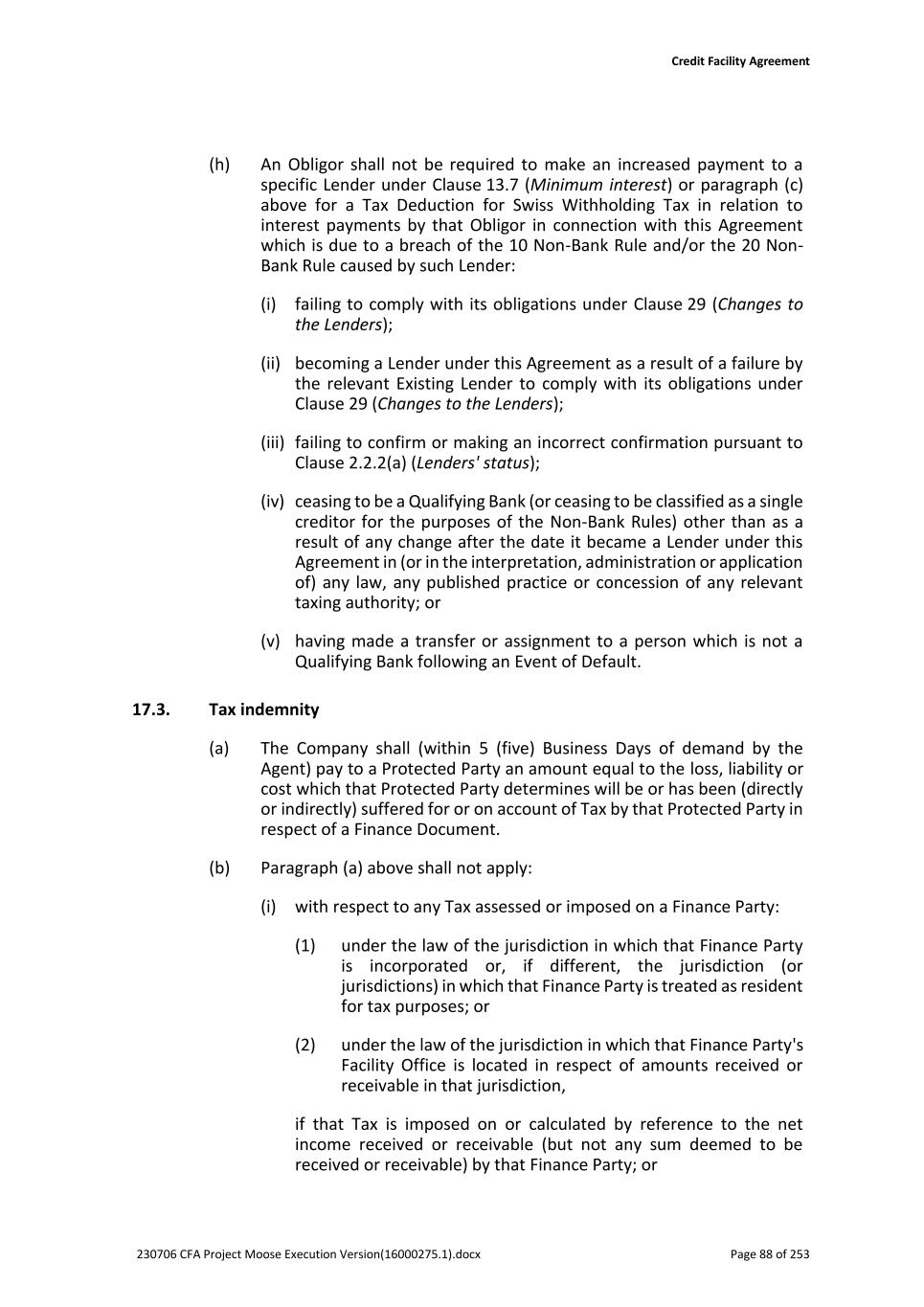
Credit Facility Agreement 230706 CFA Project Moose Execution Version(16000275.1).docx Page 88 of 253 (h) An Obligor shall not be required to make an increased payment to a specific Lender under Clause 13.7 (Minimum interest) or paragraph (c) above for a Tax Deduction for Swiss Withholding Tax in relation to interest payments by that Obligor in connection with this Agreement which is due to a breach of the 10 Non-Bank Rule and/or the 20 Non- Bank Rule caused by such Lender: (i) failing to comply with its obligations under Clause 29 (Changes to the Lenders); (ii) becoming a Lender under this Agreement as a result of a failure by the relevant Existing Lender to comply with its obligations under Clause 29 (Changes to the Lenders); (iii) failing to confirm or making an incorrect confirmation pursuant to Clause 2.2.2(a) (Lenders' status); (iv) ceasing to be a Qualifying Bank (or ceasing to be classified as a single creditor for the purposes of the Non-Bank Rules) other than as a result of any change after the date it became a Lender under this Agreement in (or in the interpretation, administration or application of) any law, any published practice or concession of any relevant taxing authority; or (v) having made a transfer or assignment to a person which is not a Qualifying Bank following an Event of Default. 17.3. Tax indemnity (a) The Company shall (within 5 (five) Business Days of demand by the Agent) pay to a Protected Party an amount equal to the loss, liability or cost which that Protected Party determines will be or has been (directly or indirectly) suffered for or on account of Tax by that Protected Party in respect of a Finance Document. (b) Paragraph (a) above shall not apply: (i) with respect to any Tax assessed or imposed on a Finance Party: (1) under the law of the jurisdiction in which that Finance Party is incorporated or, if different, the jurisdiction (or jurisdictions) in which that Finance Party is treated as resident for tax purposes; or (2) under the law of the jurisdiction in which that Finance Party's Facility Office is located in respect of amounts received or receivable in that jurisdiction, if that Tax is imposed on or calculated by reference to the net income received or receivable (but not any sum deemed to be received or receivable) by that Finance Party; or
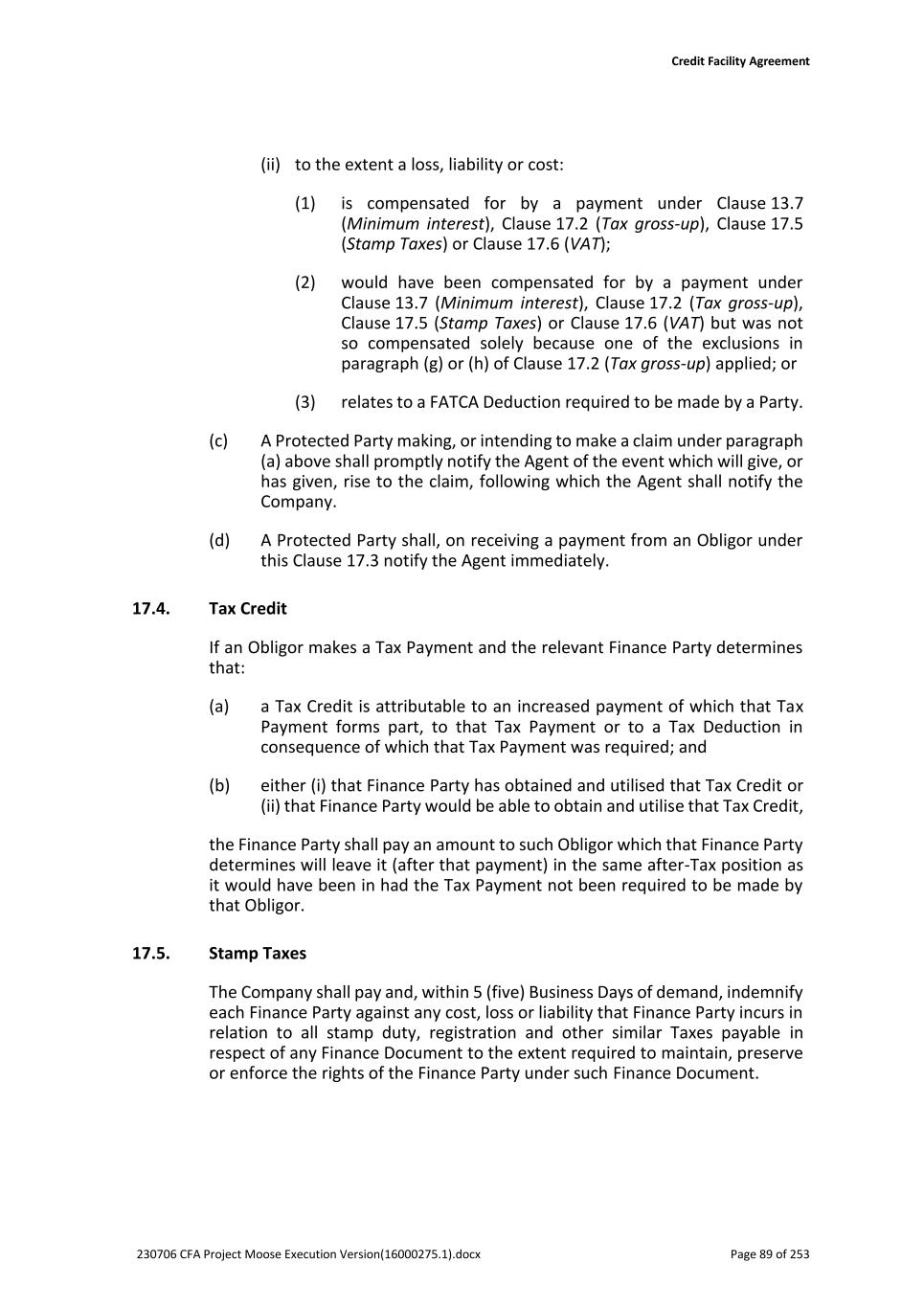
Credit Facility Agreement 230706 CFA Project Moose Execution Version(16000275.1).docx Page 89 of 253 (ii) to the extent a loss, liability or cost: (1) is compensated for by a payment under Clause 13.7 (Minimum interest), Clause 17.2 (Tax gross-up), Clause 17.5 (Stamp Taxes) or Clause 17.6 (VAT); (2) would have been compensated for by a payment under Clause 13.7 (Minimum interest), Clause 17.2 (Tax gross-up), Clause 17.5 (Stamp Taxes) or Clause 17.6 (VAT) but was not so compensated solely because one of the exclusions in paragraph (g) or (h) of Clause 17.2 (Tax gross-up) applied; or (3) relates to a FATCA Deduction required to be made by a Party. (c) A Protected Party making, or intending to make a claim under paragraph (a) above shall promptly notify the Agent of the event which will give, or has given, rise to the claim, following which the Agent shall notify the Company. (d) A Protected Party shall, on receiving a payment from an Obligor under this Clause 17.3 notify the Agent immediately. 17.4. Tax Credit If an Obligor makes a Tax Payment and the relevant Finance Party determines that: (a) a Tax Credit is attributable to an increased payment of which that Tax Payment forms part, to that Tax Payment or to a Tax Deduction in consequence of which that Tax Payment was required; and (b) either (i) that Finance Party has obtained and utilised that Tax Credit or (ii) that Finance Party would be able to obtain and utilise that Tax Credit, the Finance Party shall pay an amount to such Obligor which that Finance Party determines will leave it (after that payment) in the same after-Tax position as it would have been in had the Tax Payment not been required to be made by that Obligor. 17.5. Stamp Taxes The Company shall pay and, within 5 (five) Business Days of demand, indemnify each Finance Party against any cost, loss or liability that Finance Party incurs in relation to all stamp duty, registration and other similar Taxes payable in respect of any Finance Document to the extent required to maintain, preserve or enforce the rights of the Finance Party under such Finance Document.
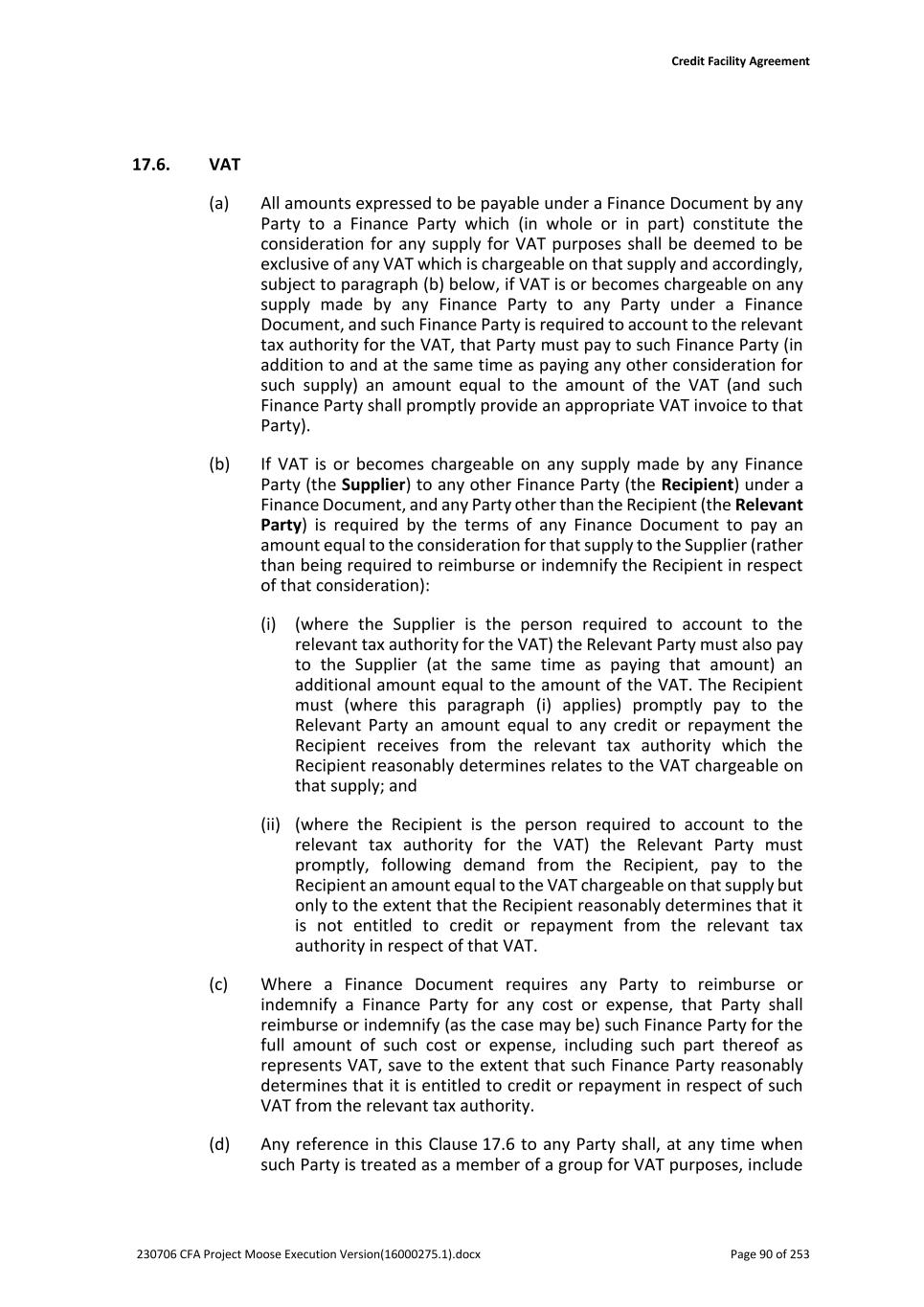
Credit Facility Agreement 230706 CFA Project Moose Execution Version(16000275.1).docx Page 90 of 253 17.6. VAT (a) All amounts expressed to be payable under a Finance Document by any Party to a Finance Party which (in whole or in part) constitute the consideration for any supply for VAT purposes shall be deemed to be exclusive of any VAT which is chargeable on that supply and accordingly, subject to paragraph (b) below, if VAT is or becomes chargeable on any supply made by any Finance Party to any Party under a Finance Document, and such Finance Party is required to account to the relevant tax authority for the VAT, that Party must pay to such Finance Party (in addition to and at the same time as paying any other consideration for such supply) an amount equal to the amount of the VAT (and such Finance Party shall promptly provide an appropriate VAT invoice to that Party). (b) If VAT is or becomes chargeable on any supply made by any Finance Party (the Supplier) to any other Finance Party (the Recipient) under a Finance Document, and any Party other than the Recipient (the Relevant Party) is required by the terms of any Finance Document to pay an amount equal to the consideration for that supply to the Supplier (rather than being required to reimburse or indemnify the Recipient in respect of that consideration): (i) (where the Supplier is the person required to account to the relevant tax authority for the VAT) the Relevant Party must also pay to the Supplier (at the same time as paying that amount) an additional amount equal to the amount of the VAT. The Recipient must (where this paragraph (i) applies) promptly pay to the Relevant Party an amount equal to any credit or repayment the Recipient receives from the relevant tax authority which the Recipient reasonably determines relates to the VAT chargeable on that supply; and (ii) (where the Recipient is the person required to account to the relevant tax authority for the VAT) the Relevant Party must promptly, following demand from the Recipient, pay to the Recipient an amount equal to the VAT chargeable on that supply but only to the extent that the Recipient reasonably determines that it is not entitled to credit or repayment from the relevant tax authority in respect of that VAT. (c) Where a Finance Document requires any Party to reimburse or indemnify a Finance Party for any cost or expense, that Party shall reimburse or indemnify (as the case may be) such Finance Party for the full amount of such cost or expense, including such part thereof as represents VAT, save to the extent that such Finance Party reasonably determines that it is entitled to credit or repayment in respect of such VAT from the relevant tax authority. (d) Any reference in this Clause 17.6 to any Party shall, at any time when such Party is treated as a member of a group for VAT purposes, include
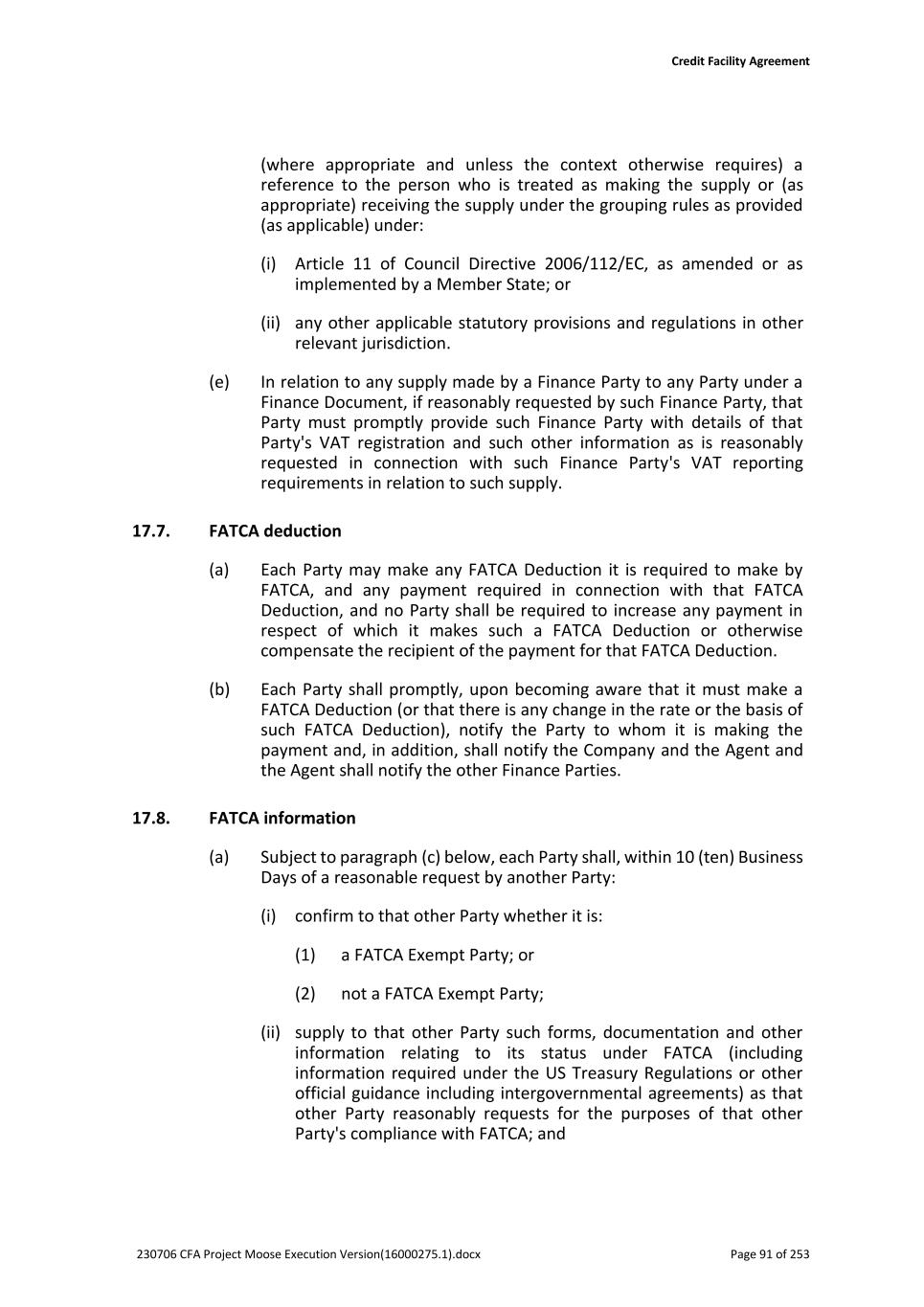
Credit Facility Agreement 230706 CFA Project Moose Execution Version(16000275.1).docx Page 91 of 253 (where appropriate and unless the context otherwise requires) a reference to the person who is treated as making the supply or (as appropriate) receiving the supply under the grouping rules as provided (as applicable) under: (i) Article 11 of Council Directive 2006/112/EC, as amended or as implemented by a Member State; or (ii) any other applicable statutory provisions and regulations in other relevant jurisdiction. (e) In relation to any supply made by a Finance Party to any Party under a Finance Document, if reasonably requested by such Finance Party, that Party must promptly provide such Finance Party with details of that Party's VAT registration and such other information as is reasonably requested in connection with such Finance Party's VAT reporting requirements in relation to such supply. 17.7. FATCA deduction (a) Each Party may make any FATCA Deduction it is required to make by FATCA, and any payment required in connection with that FATCA Deduction, and no Party shall be required to increase any payment in respect of which it makes such a FATCA Deduction or otherwise compensate the recipient of the payment for that FATCA Deduction. (b) Each Party shall promptly, upon becoming aware that it must make a FATCA Deduction (or that there is any change in the rate or the basis of such FATCA Deduction), notify the Party to whom it is making the payment and, in addition, shall notify the Company and the Agent and the Agent shall notify the other Finance Parties. 17.8. FATCA information (a) Subject to paragraph (c) below, each Party shall, within 10 (ten) Business Days of a reasonable request by another Party: (i) confirm to that other Party whether it is: (1) a FATCA Exempt Party; or (2) not a FATCA Exempt Party; (ii) supply to that other Party such forms, documentation and other information relating to its status under FATCA (including information required under the US Treasury Regulations or other official guidance including intergovernmental agreements) as that other Party reasonably requests for the purposes of that other Party's compliance with FATCA; and
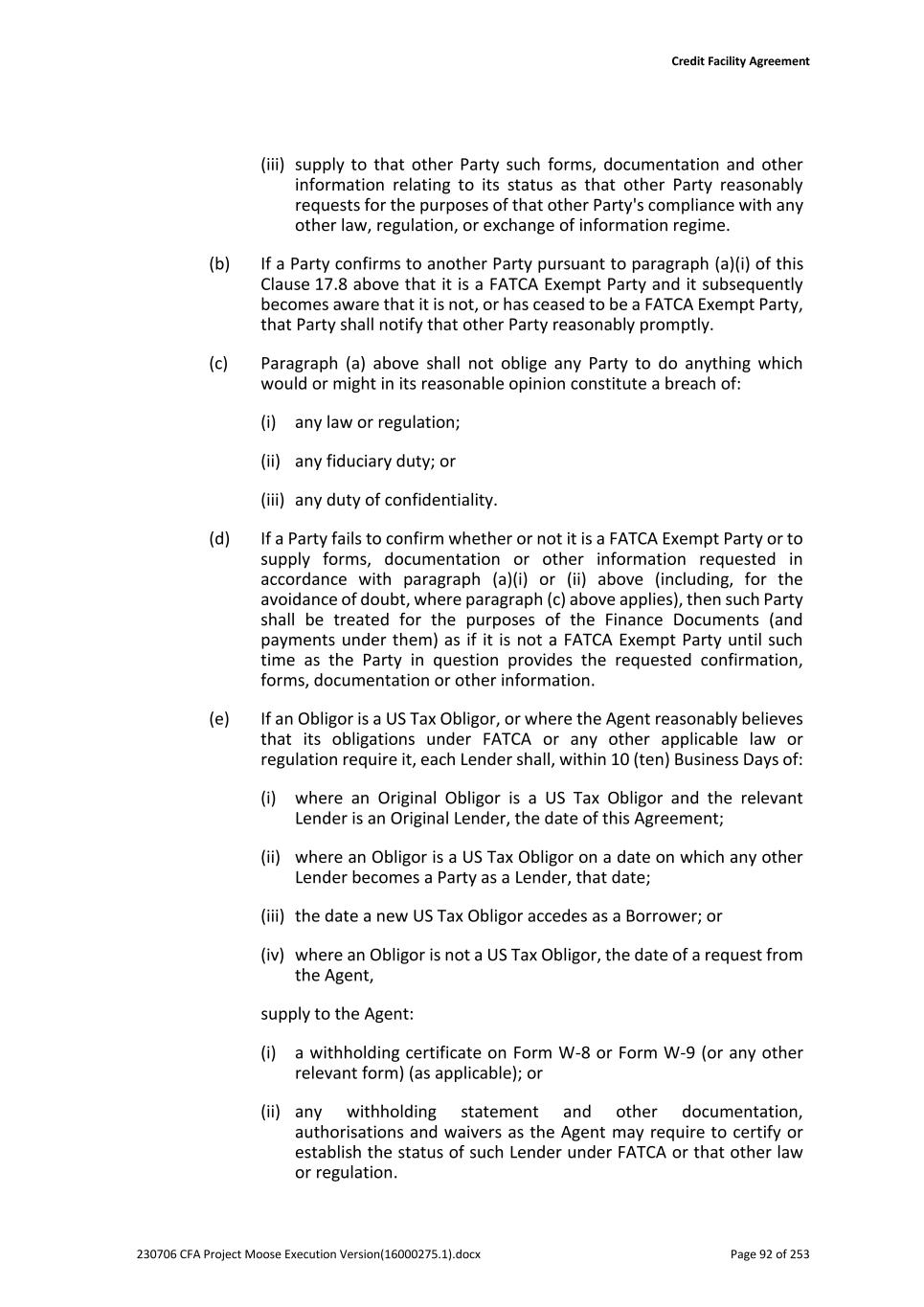
Credit Facility Agreement 230706 CFA Project Moose Execution Version(16000275.1).docx Page 92 of 253 (iii) supply to that other Party such forms, documentation and other information relating to its status as that other Party reasonably requests for the purposes of that other Party's compliance with any other law, regulation, or exchange of information regime. (b) If a Party confirms to another Party pursuant to paragraph (a)(i) of this Clause 17.8 above that it is a FATCA Exempt Party and it subsequently becomes aware that it is not, or has ceased to be a FATCA Exempt Party, that Party shall notify that other Party reasonably promptly. (c) Paragraph (a) above shall not oblige any Party to do anything which would or might in its reasonable opinion constitute a breach of: (i) any law or regulation; (ii) any fiduciary duty; or (iii) any duty of confidentiality. (d) If a Party fails to confirm whether or not it is a FATCA Exempt Party or to supply forms, documentation or other information requested in accordance with paragraph (a)(i) or (ii) above (including, for the avoidance of doubt, where paragraph (c) above applies), then such Party shall be treated for the purposes of the Finance Documents (and payments under them) as if it is not a FATCA Exempt Party until such time as the Party in question provides the requested confirmation, forms, documentation or other information. (e) If an Obligor is a US Tax Obligor, or where the Agent reasonably believes that its obligations under FATCA or any other applicable law or regulation require it, each Lender shall, within 10 (ten) Business Days of: (i) where an Original Obligor is a US Tax Obligor and the relevant Lender is an Original Lender, the date of this Agreement; (ii) where an Obligor is a US Tax Obligor on a date on which any other Lender becomes a Party as a Lender, that date; (iii) the date a new US Tax Obligor accedes as a Borrower; or (iv) where an Obligor is not a US Tax Obligor, the date of a request from the Agent, supply to the Agent: (i) a withholding certificate on Form W-8 or Form W-9 (or any other relevant form) (as applicable); or (ii) any withholding statement and other documentation, authorisations and waivers as the Agent may require to certify or establish the status of such Lender under FATCA or that other law or regulation.
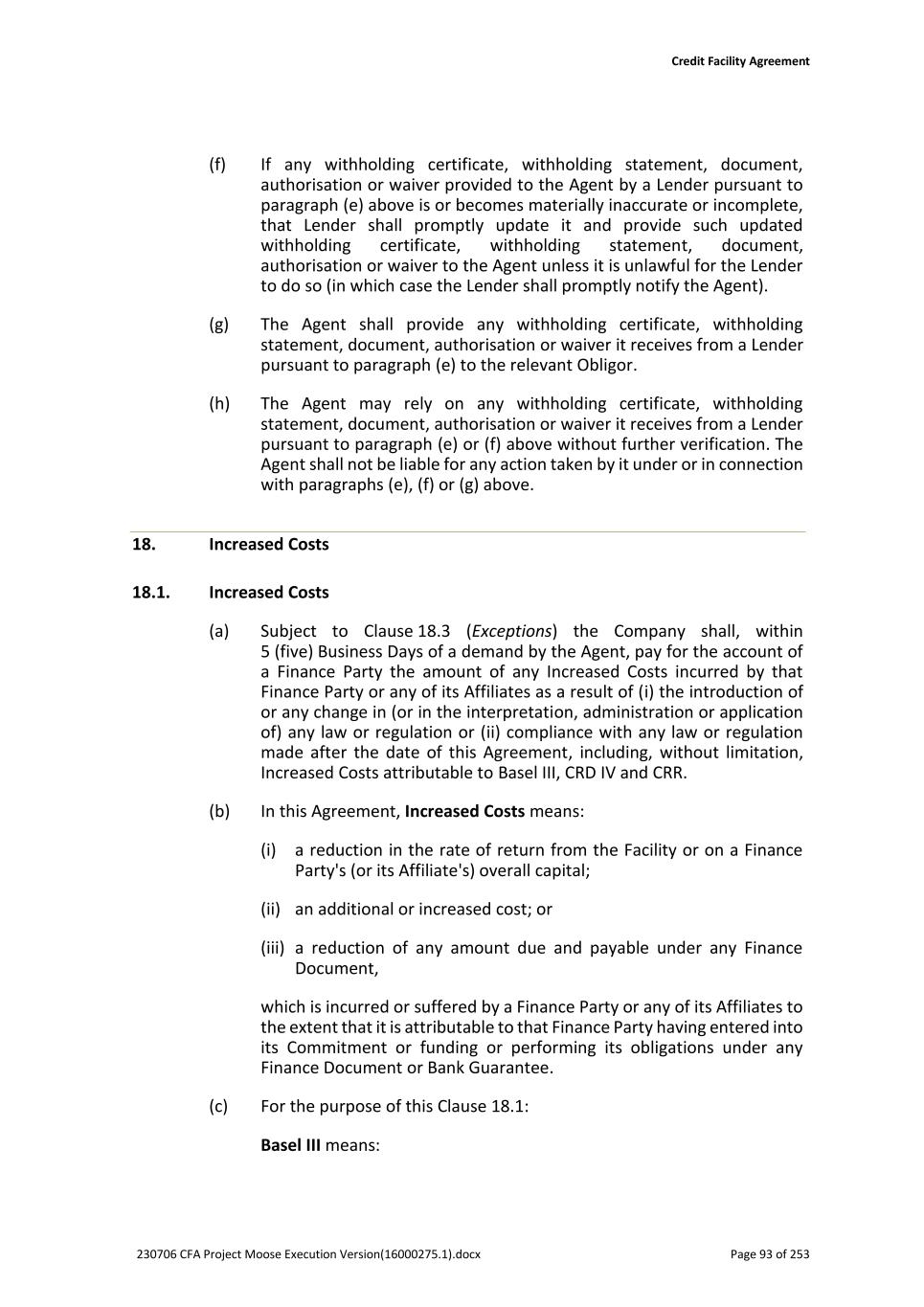
Credit Facility Agreement 230706 CFA Project Moose Execution Version(16000275.1).docx Page 93 of 253 (f) If any withholding certificate, withholding statement, document, authorisation or waiver provided to the Agent by a Lender pursuant to paragraph (e) above is or becomes materially inaccurate or incomplete, that Lender shall promptly update it and provide such updated withholding certificate, withholding statement, document, authorisation or waiver to the Agent unless it is unlawful for the Lender to do so (in which case the Lender shall promptly notify the Agent). (g) The Agent shall provide any withholding certificate, withholding statement, document, authorisation or waiver it receives from a Lender pursuant to paragraph (e) to the relevant Obligor. (h) The Agent may rely on any withholding certificate, withholding statement, document, authorisation or waiver it receives from a Lender pursuant to paragraph (e) or (f) above without further verification. The Agent shall not be liable for any action taken by it under or in connection with paragraphs (e), (f) or (g) above. 18. Increased Costs 18.1. Increased Costs (a) Subject to Clause 18.3 (Exceptions) the Company shall, within 5 (five) Business Days of a demand by the Agent, pay for the account of a Finance Party the amount of any Increased Costs incurred by that Finance Party or any of its Affiliates as a result of (i) the introduction of or any change in (or in the interpretation, administration or application of) any law or regulation or (ii) compliance with any law or regulation made after the date of this Agreement, including, without limitation, Increased Costs attributable to Basel III, CRD IV and CRR. (b) In this Agreement, Increased Costs means: (i) a reduction in the rate of return from the Facility or on a Finance Party's (or its Affiliate's) overall capital; (ii) an additional or increased cost; or (iii) a reduction of any amount due and payable under any Finance Document, which is incurred or suffered by a Finance Party or any of its Affiliates to the extent that it is attributable to that Finance Party having entered into its Commitment or funding or performing its obligations under any Finance Document or Bank Guarantee. (c) For the purpose of this Clause 18.1: Basel III means:
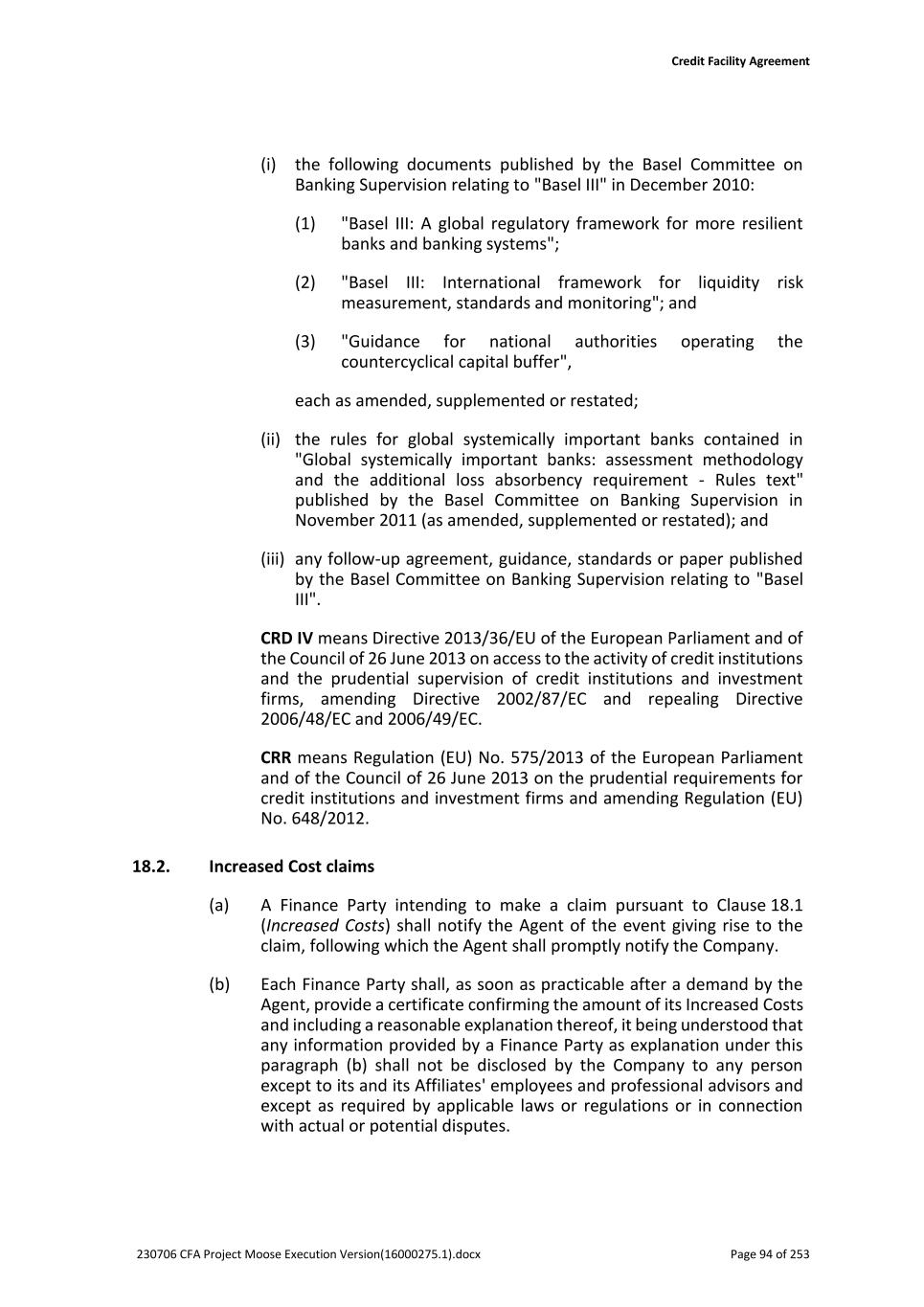
Credit Facility Agreement 230706 CFA Project Moose Execution Version(16000275.1).docx Page 94 of 253 (i) the following documents published by the Basel Committee on Banking Supervision relating to "Basel III" in December 2010: (1) "Basel III: A global regulatory framework for more resilient banks and banking systems"; (2) "Basel III: International framework for liquidity risk measurement, standards and monitoring"; and (3) "Guidance for national authorities operating the countercyclical capital buffer", each as amended, supplemented or restated; (ii) the rules for global systemically important banks contained in "Global systemically important banks: assessment methodology and the additional loss absorbency requirement - Rules text" published by the Basel Committee on Banking Supervision in November 2011 (as amended, supplemented or restated); and (iii) any follow-up agreement, guidance, standards or paper published by the Basel Committee on Banking Supervision relating to "Basel III". CRD IV means Directive 2013/36/EU of the European Parliament and of the Council of 26 June 2013 on access to the activity of credit institutions and the prudential supervision of credit institutions and investment firms, amending Directive 2002/87/EC and repealing Directive 2006/48/EC and 2006/49/EC. CRR means Regulation (EU) No. 575/2013 of the European Parliament and of the Council of 26 June 2013 on the prudential requirements for credit institutions and investment firms and amending Regulation (EU) No. 648/2012. 18.2. Increased Cost claims (a) A Finance Party intending to make a claim pursuant to Clause 18.1 (Increased Costs) shall notify the Agent of the event giving rise to the claim, following which the Agent shall promptly notify the Company. (b) Each Finance Party shall, as soon as practicable after a demand by the Agent, provide a certificate confirming the amount of its Increased Costs and including a reasonable explanation thereof, it being understood that any information provided by a Finance Party as explanation under this paragraph (b) shall not be disclosed by the Company to any person except to its and its Affiliates' employees and professional advisors and except as required by applicable laws or regulations or in connection with actual or potential disputes.
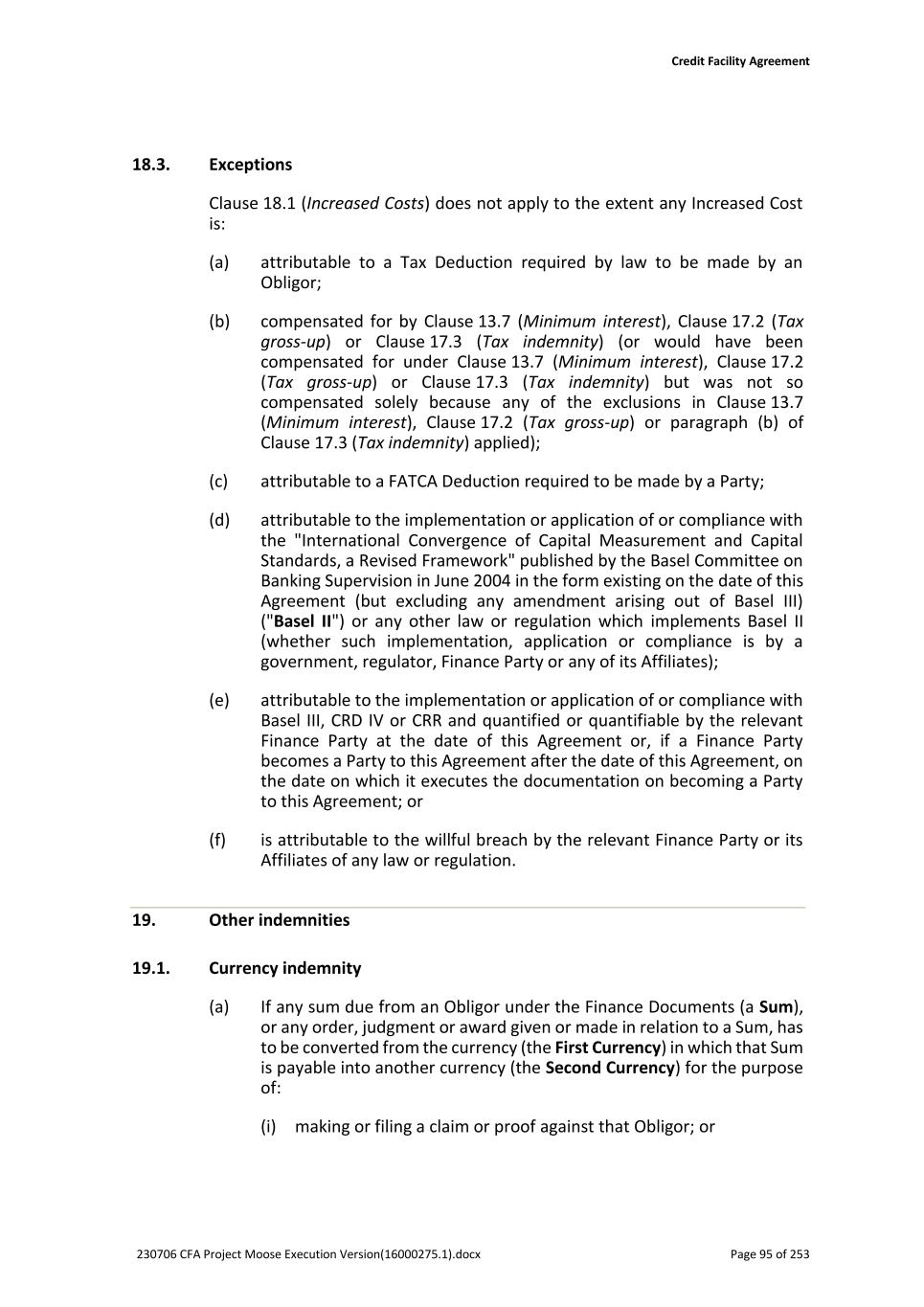
Credit Facility Agreement 230706 CFA Project Moose Execution Version(16000275.1).docx Page 95 of 253 18.3. Exceptions Clause 18.1 (Increased Costs) does not apply to the extent any Increased Cost is: (a) attributable to a Tax Deduction required by law to be made by an Obligor; (b) compensated for by Clause 13.7 (Minimum interest), Clause 17.2 (Tax gross-up) or Clause 17.3 (Tax indemnity) (or would have been compensated for under Clause 13.7 (Minimum interest), Clause 17.2 (Tax gross-up) or Clause 17.3 (Tax indemnity) but was not so compensated solely because any of the exclusions in Clause 13.7 (Minimum interest), Clause 17.2 (Tax gross-up) or paragraph (b) of Clause 17.3 (Tax indemnity) applied); (c) attributable to a FATCA Deduction required to be made by a Party; (d) attributable to the implementation or application of or compliance with the "International Convergence of Capital Measurement and Capital Standards, a Revised Framework" published by the Basel Committee on Banking Supervision in June 2004 in the form existing on the date of this Agreement (but excluding any amendment arising out of Basel III) ("Basel II") or any other law or regulation which implements Basel II (whether such implementation, application or compliance is by a government, regulator, Finance Party or any of its Affiliates); (e) attributable to the implementation or application of or compliance with Basel III, CRD IV or CRR and quantified or quantifiable by the relevant Finance Party at the date of this Agreement or, if a Finance Party becomes a Party to this Agreement after the date of this Agreement, on the date on which it executes the documentation on becoming a Party to this Agreement; or (f) is attributable to the willful breach by the relevant Finance Party or its Affiliates of any law or regulation. 19. Other indemnities 19.1. Currency indemnity (a) If any sum due from an Obligor under the Finance Documents (a Sum), or any order, judgment or award given or made in relation to a Sum, has to be converted from the currency (the First Currency) in which that Sum is payable into another currency (the Second Currency) for the purpose of: (i) making or filing a claim or proof against that Obligor; or
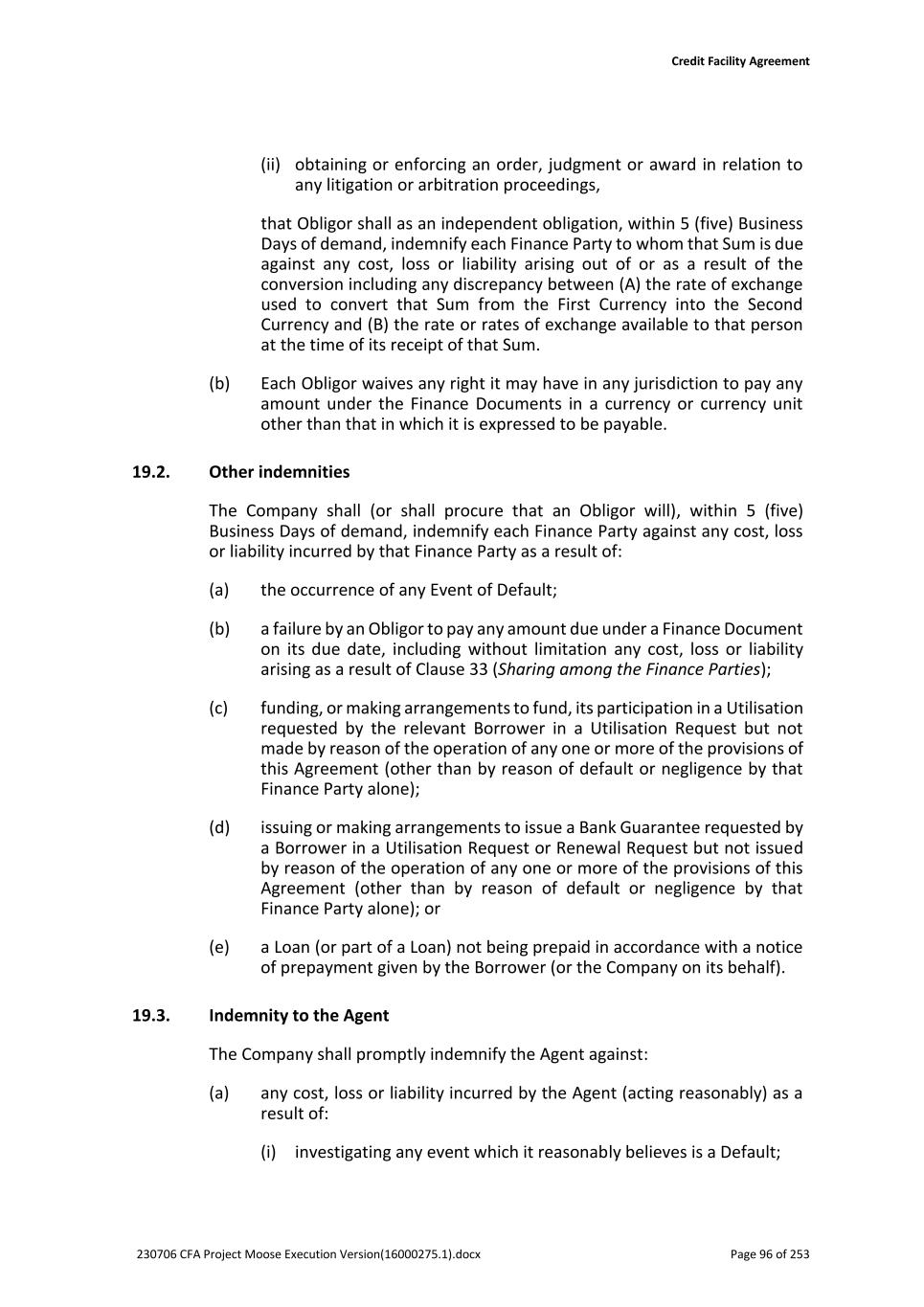
Credit Facility Agreement 230706 CFA Project Moose Execution Version(16000275.1).docx Page 96 of 253 (ii) obtaining or enforcing an order, judgment or award in relation to any litigation or arbitration proceedings, that Obligor shall as an independent obligation, within 5 (five) Business Days of demand, indemnify each Finance Party to whom that Sum is due against any cost, loss or liability arising out of or as a result of the conversion including any discrepancy between (A) the rate of exchange used to convert that Sum from the First Currency into the Second Currency and (B) the rate or rates of exchange available to that person at the time of its receipt of that Sum. (b) Each Obligor waives any right it may have in any jurisdiction to pay any amount under the Finance Documents in a currency or currency unit other than that in which it is expressed to be payable. 19.2. Other indemnities The Company shall (or shall procure that an Obligor will), within 5 (five) Business Days of demand, indemnify each Finance Party against any cost, loss or liability incurred by that Finance Party as a result of: (a) the occurrence of any Event of Default; (b) a failure by an Obligor to pay any amount due under a Finance Document on its due date, including without limitation any cost, loss or liability arising as a result of Clause 33 (Sharing among the Finance Parties); (c) funding, or making arrangements to fund, its participation in a Utilisation requested by the relevant Borrower in a Utilisation Request but not made by reason of the operation of any one or more of the provisions of this Agreement (other than by reason of default or negligence by that Finance Party alone); (d) issuing or making arrangements to issue a Bank Guarantee requested by a Borrower in a Utilisation Request or Renewal Request but not issued by reason of the operation of any one or more of the provisions of this Agreement (other than by reason of default or negligence by that Finance Party alone); or (e) a Loan (or part of a Loan) not being prepaid in accordance with a notice of prepayment given by the Borrower (or the Company on its behalf). 19.3. Indemnity to the Agent The Company shall promptly indemnify the Agent against: (a) any cost, loss or liability incurred by the Agent (acting reasonably) as a result of: (i) investigating any event which it reasonably believes is a Default;
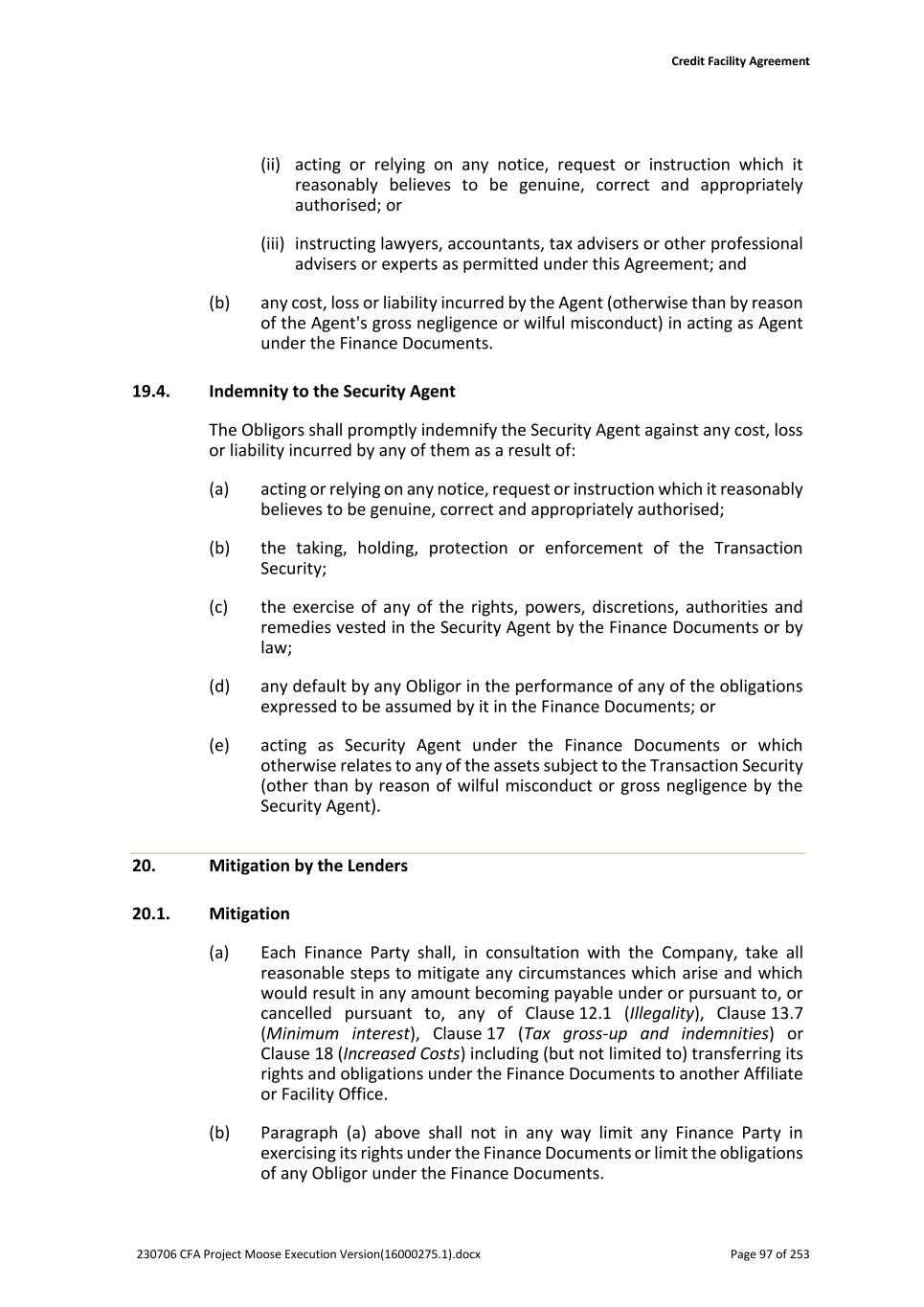
Credit Facility Agreement 230706 CFA Project Moose Execution Version(16000275.1).docx Page 97 of 253 (ii) acting or relying on any notice, request or instruction which it reasonably believes to be genuine, correct and appropriately authorised; or (iii) instructing lawyers, accountants, tax advisers or other professional advisers or experts as permitted under this Agreement; and (b) any cost, loss or liability incurred by the Agent (otherwise than by reason of the Agent's gross negligence or wilful misconduct) in acting as Agent under the Finance Documents. 19.4. Indemnity to the Security Agent The Obligors shall promptly indemnify the Security Agent against any cost, loss or liability incurred by any of them as a result of: (a) acting or relying on any notice, request or instruction which it reasonably believes to be genuine, correct and appropriately authorised; (b) the taking, holding, protection or enforcement of the Transaction Security; (c) the exercise of any of the rights, powers, discretions, authorities and remedies vested in the Security Agent by the Finance Documents or by law; (d) any default by any Obligor in the performance of any of the obligations expressed to be assumed by it in the Finance Documents; or (e) acting as Security Agent under the Finance Documents or which otherwise relates to any of the assets subject to the Transaction Security (other than by reason of wilful misconduct or gross negligence by the Security Agent). 20. Mitigation by the Lenders 20.1. Mitigation (a) Each Finance Party shall, in consultation with the Company, take all reasonable steps to mitigate any circumstances which arise and which would result in any amount becoming payable under or pursuant to, or cancelled pursuant to, any of Clause 12.1 (Illegality), Clause 13.7 (Minimum interest), Clause 17 (Tax gross-up and indemnities) or Clause 18 (Increased Costs) including (but not limited to) transferring its rights and obligations under the Finance Documents to another Affiliate or Facility Office. (b) Paragraph (a) above shall not in any way limit any Finance Party in exercising its rights under the Finance Documents or limit the obligations of any Obligor under the Finance Documents.
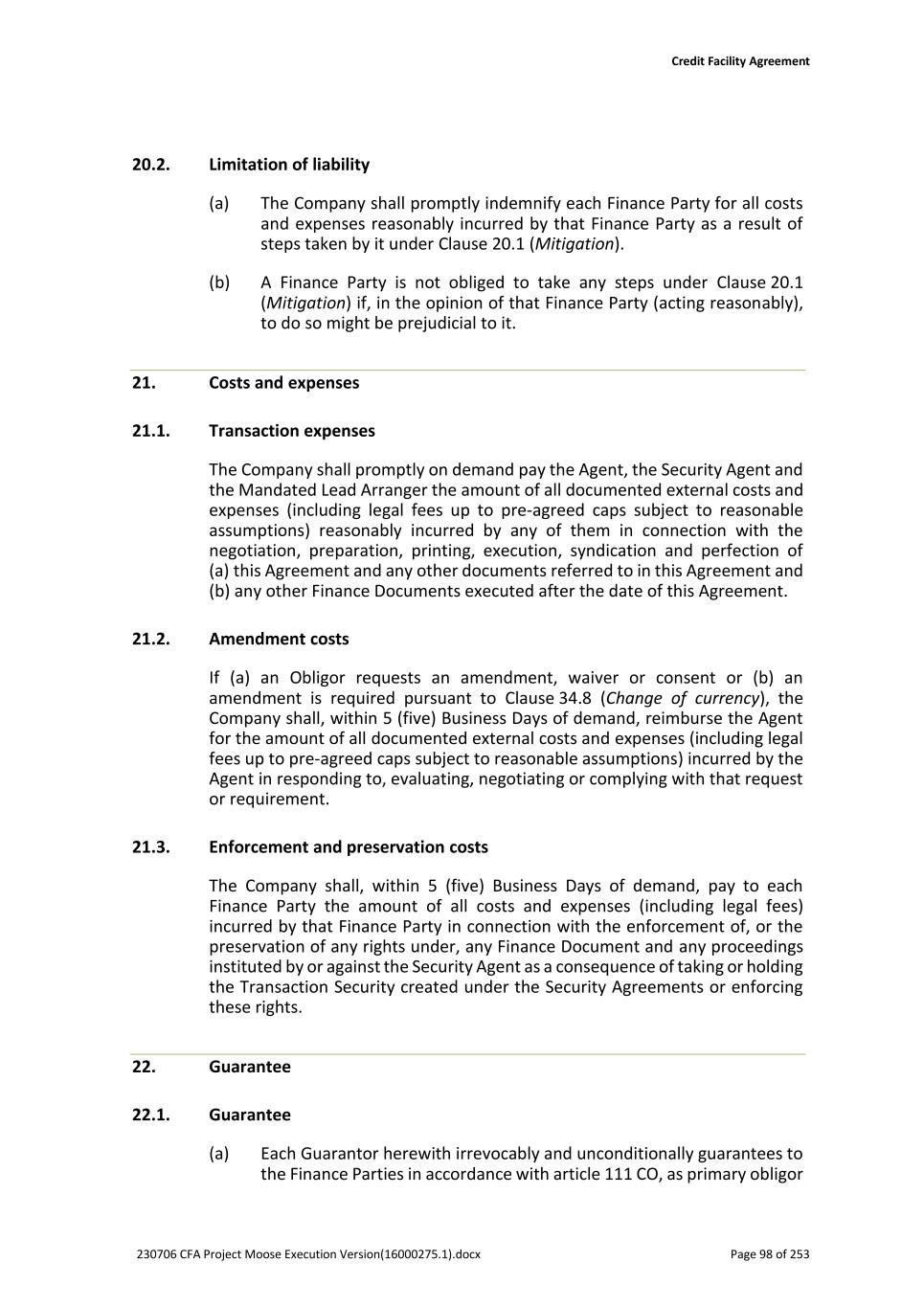
Credit Facility Agreement 230706 CFA Project Moose Execution Version(16000275.1).docx Page 98 of 253 20.2. Limitation of liability (a) The Company shall promptly indemnify each Finance Party for all costs and expenses reasonably incurred by that Finance Party as a result of steps taken by it under Clause 20.1 (Mitigation). (b) A Finance Party is not obliged to take any steps under Clause 20.1 (Mitigation) if, in the opinion of that Finance Party (acting reasonably), to do so might be prejudicial to it. 21. Costs and expenses 21.1. Transaction expenses The Company shall promptly on demand pay the Agent, the Security Agent and the Mandated Lead Arranger the amount of all documented external costs and expenses (including legal fees up to pre-agreed caps subject to reasonable assumptions) reasonably incurred by any of them in connection with the negotiation, preparation, printing, execution, syndication and perfection of (a) this Agreement and any other documents referred to in this Agreement and (b) any other Finance Documents executed after the date of this Agreement. 21.2. Amendment costs If (a) an Obligor requests an amendment, waiver or consent or (b) an amendment is required pursuant to Clause 34.8 (Change of currency), the Company shall, within 5 (five) Business Days of demand, reimburse the Agent for the amount of all documented external costs and expenses (including legal fees up to pre-agreed caps subject to reasonable assumptions) incurred by the Agent in responding to, evaluating, negotiating or complying with that request or requirement. 21.3. Enforcement and preservation costs The Company shall, within 5 (five) Business Days of demand, pay to each Finance Party the amount of all costs and expenses (including legal fees) incurred by that Finance Party in connection with the enforcement of, or the preservation of any rights under, any Finance Document and any proceedings instituted by or against the Security Agent as a consequence of taking or holding the Transaction Security created under the Security Agreements or enforcing these rights. 22. Guarantee 22.1. Guarantee (a) Each Guarantor herewith irrevocably and unconditionally guarantees to the Finance Parties in accordance with article 111 CO, as primary obligor
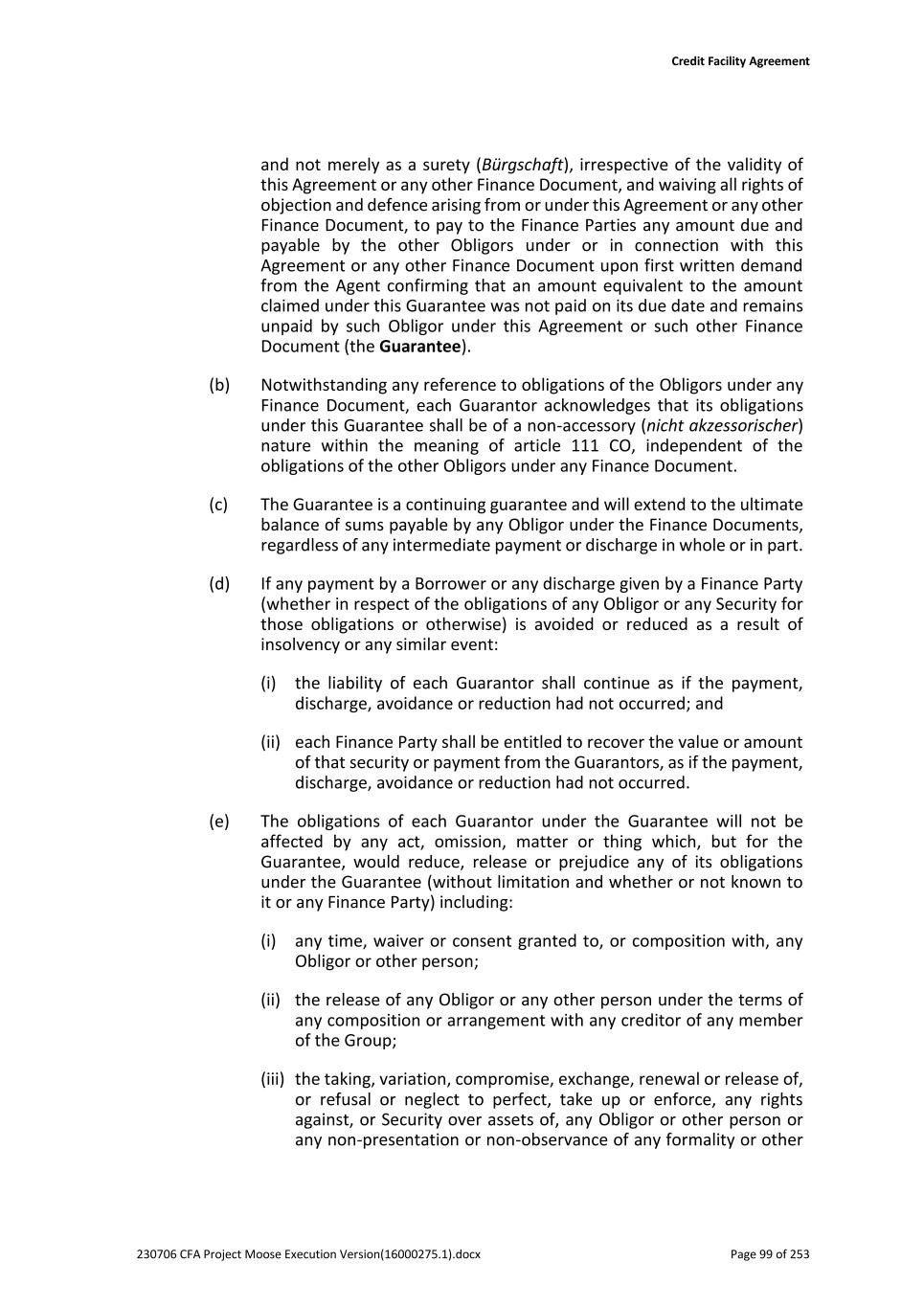
Credit Facility Agreement 230706 CFA Project Moose Execution Version(16000275.1).docx Page 99 of 253 and not merely as a surety (Bürgschaft), irrespective of the validity of this Agreement or any other Finance Document, and waiving all rights of objection and defence arising from or under this Agreement or any other Finance Document, to pay to the Finance Parties any amount due and payable by the other Obligors under or in connection with this Agreement or any other Finance Document upon first written demand from the Agent confirming that an amount equivalent to the amount claimed under this Guarantee was not paid on its due date and remains unpaid by such Obligor under this Agreement or such other Finance Document (the Guarantee). (b) Notwithstanding any reference to obligations of the Obligors under any Finance Document, each Guarantor acknowledges that its obligations under this Guarantee shall be of a non-accessory (nicht akzessorischer) nature within the meaning of article 111 CO, independent of the obligations of the other Obligors under any Finance Document. (c) The Guarantee is a continuing guarantee and will extend to the ultimate balance of sums payable by any Obligor under the Finance Documents, regardless of any intermediate payment or discharge in whole or in part. (d) If any payment by a Borrower or any discharge given by a Finance Party (whether in respect of the obligations of any Obligor or any Security for those obligations or otherwise) is avoided or reduced as a result of insolvency or any similar event: (i) the liability of each Guarantor shall continue as if the payment, discharge, avoidance or reduction had not occurred; and (ii) each Finance Party shall be entitled to recover the value or amount of that security or payment from the Guarantors, as if the payment, discharge, avoidance or reduction had not occurred. (e) The obligations of each Guarantor under the Guarantee will not be affected by any act, omission, matter or thing which, but for the Guarantee, would reduce, release or prejudice any of its obligations under the Guarantee (without limitation and whether or not known to it or any Finance Party) including: (i) any time, waiver or consent granted to, or composition with, any Obligor or other person; (ii) the release of any Obligor or any other person under the terms of any composition or arrangement with any creditor of any member of the Group; (iii) the taking, variation, compromise, exchange, renewal or release of, or refusal or neglect to perfect, take up or enforce, any rights against, or Security over assets of, any Obligor or other person or any non-presentation or non-observance of any formality or other
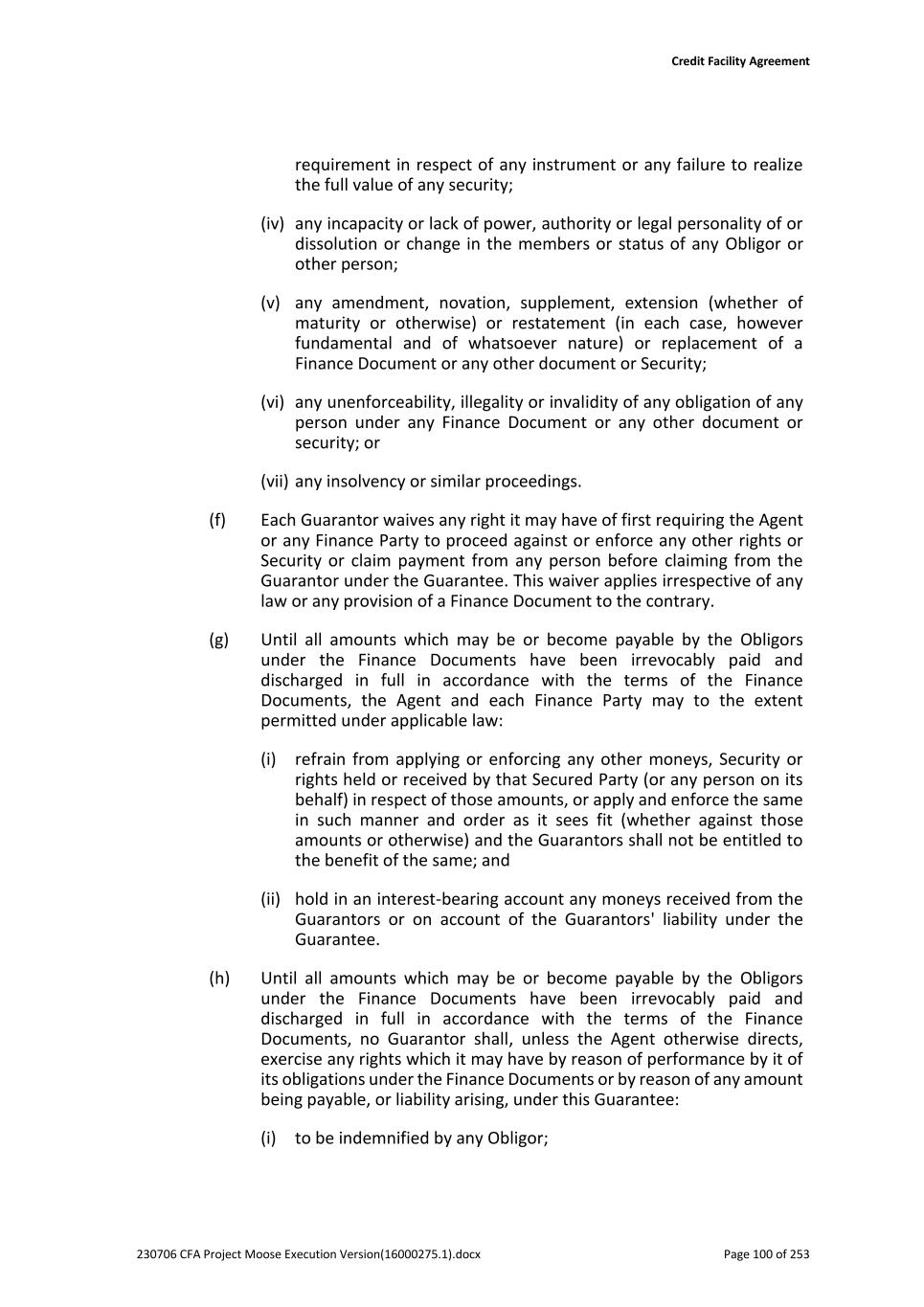
Credit Facility Agreement 230706 CFA Project Moose Execution Version(16000275.1).docx Page 100 of 253 requirement in respect of any instrument or any failure to realize the full value of any security; (iv) any incapacity or lack of power, authority or legal personality of or dissolution or change in the members or status of any Obligor or other person; (v) any amendment, novation, supplement, extension (whether of maturity or otherwise) or restatement (in each case, however fundamental and of whatsoever nature) or replacement of a Finance Document or any other document or Security; (vi) any unenforceability, illegality or invalidity of any obligation of any person under any Finance Document or any other document or security; or (vii) any insolvency or similar proceedings. (f) Each Guarantor waives any right it may have of first requiring the Agent or any Finance Party to proceed against or enforce any other rights or Security or claim payment from any person before claiming from the Guarantor under the Guarantee. This waiver applies irrespective of any law or any provision of a Finance Document to the contrary. (g) Until all amounts which may be or become payable by the Obligors under the Finance Documents have been irrevocably paid and discharged in full in accordance with the terms of the Finance Documents, the Agent and each Finance Party may to the extent permitted under applicable law: (i) refrain from applying or enforcing any other moneys, Security or rights held or received by that Secured Party (or any person on its behalf) in respect of those amounts, or apply and enforce the same in such manner and order as it sees fit (whether against those amounts or otherwise) and the Guarantors shall not be entitled to the benefit of the same; and (ii) hold in an interest-bearing account any moneys received from the Guarantors or on account of the Guarantors' liability under the Guarantee. (h) Until all amounts which may be or become payable by the Obligors under the Finance Documents have been irrevocably paid and discharged in full in accordance with the terms of the Finance Documents, no Guarantor shall, unless the Agent otherwise directs, exercise any rights which it may have by reason of performance by it of its obligations under the Finance Documents or by reason of any amount being payable, or liability arising, under this Guarantee: (i) to be indemnified by any Obligor;
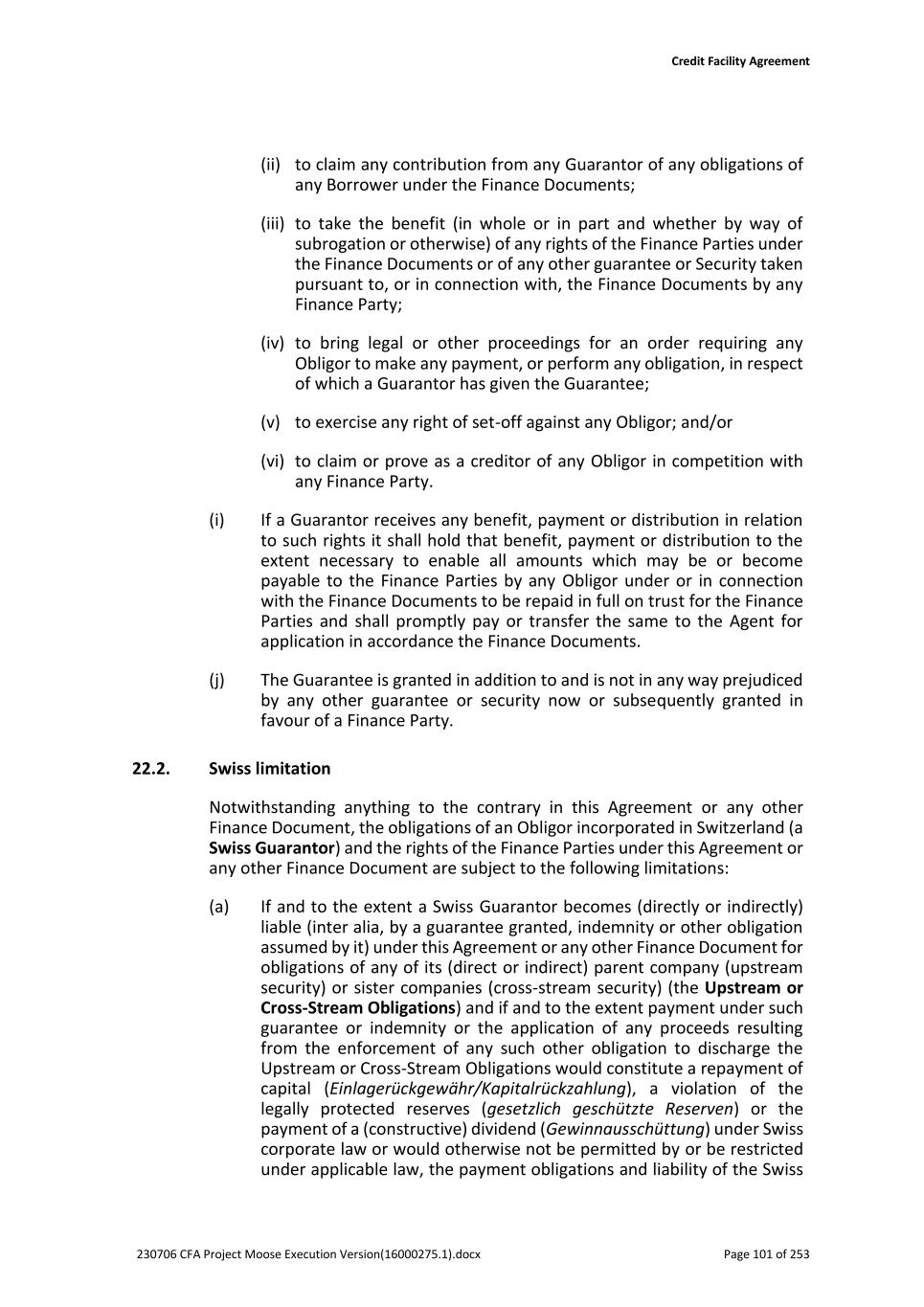
Credit Facility Agreement 230706 CFA Project Moose Execution Version(16000275.1).docx Page 101 of 253 (ii) to claim any contribution from any Guarantor of any obligations of any Borrower under the Finance Documents; (iii) to take the benefit (in whole or in part and whether by way of subrogation or otherwise) of any rights of the Finance Parties under the Finance Documents or of any other guarantee or Security taken pursuant to, or in connection with, the Finance Documents by any Finance Party; (iv) to bring legal or other proceedings for an order requiring any Obligor to make any payment, or perform any obligation, in respect of which a Guarantor has given the Guarantee; (v) to exercise any right of set-off against any Obligor; and/or (vi) to claim or prove as a creditor of any Obligor in competition with any Finance Party. (i) If a Guarantor receives any benefit, payment or distribution in relation to such rights it shall hold that benefit, payment or distribution to the extent necessary to enable all amounts which may be or become payable to the Finance Parties by any Obligor under or in connection with the Finance Documents to be repaid in full on trust for the Finance Parties and shall promptly pay or transfer the same to the Agent for application in accordance the Finance Documents. (j) The Guarantee is granted in addition to and is not in any way prejudiced by any other guarantee or security now or subsequently granted in favour of a Finance Party. 22.2. Swiss limitation Notwithstanding anything to the contrary in this Agreement or any other Finance Document, the obligations of an Obligor incorporated in Switzerland (a Swiss Guarantor) and the rights of the Finance Parties under this Agreement or any other Finance Document are subject to the following limitations: (a) If and to the extent a Swiss Guarantor becomes (directly or indirectly) liable (inter alia, by a guarantee granted, indemnity or other obligation assumed by it) under this Agreement or any other Finance Document for obligations of any of its (direct or indirect) parent company (upstream security) or sister companies (cross-stream security) (the Upstream or Cross-Stream Obligations) and if and to the extent payment under such guarantee or indemnity or the application of any proceeds resulting from the enforcement of any such other obligation to discharge the Upstream or Cross-Stream Obligations would constitute a repayment of capital (Einlagerückgewähr/Kapitalrückzahlung), a violation of the legally protected reserves (gesetzlich geschützte Reserven) or the payment of a (constructive) dividend (Gewinnausschüttung) under Swiss corporate law or would otherwise not be permitted by or be restricted under applicable law, the payment obligations and liability of the Swiss
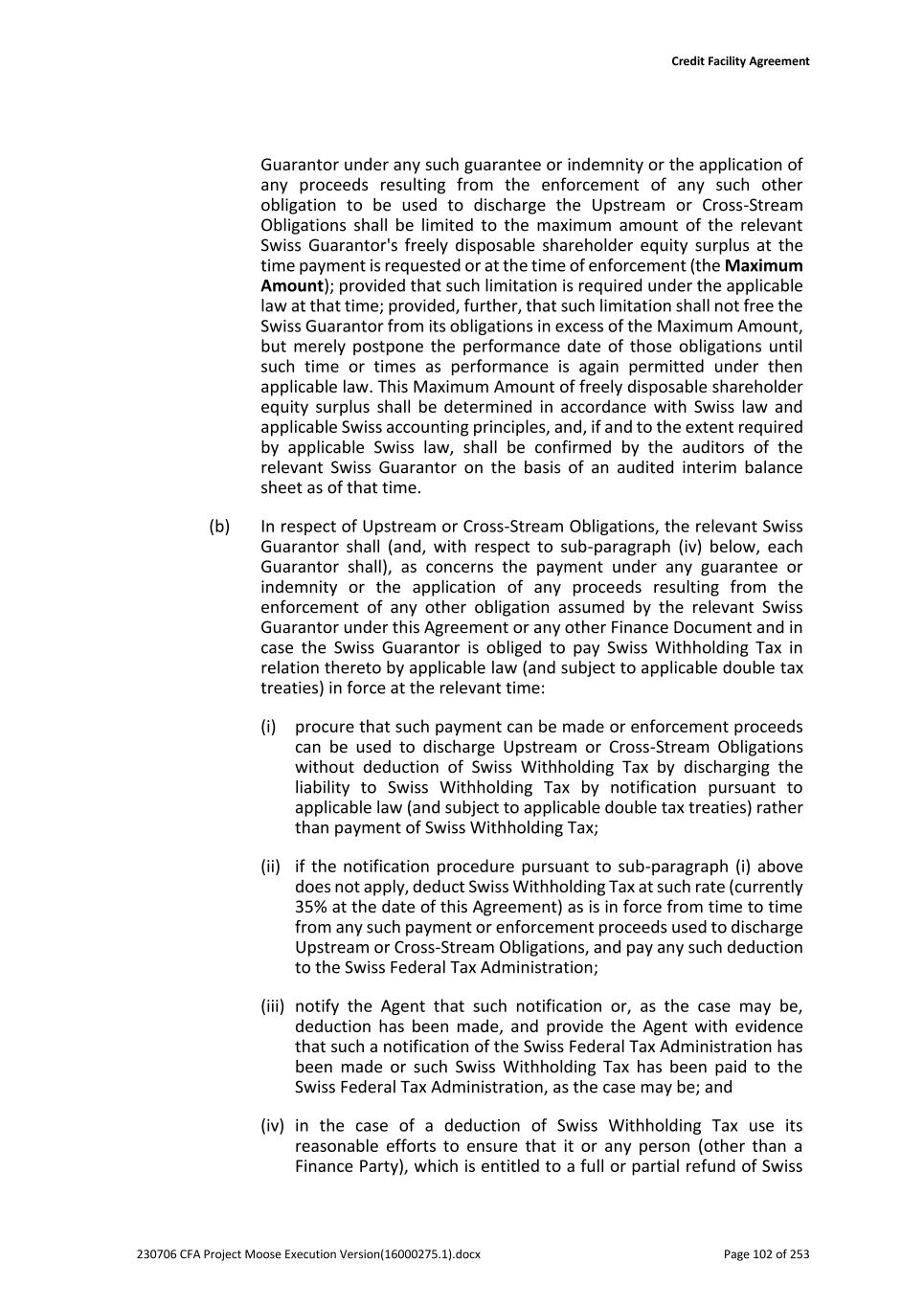
Credit Facility Agreement 230706 CFA Project Moose Execution Version(16000275.1).docx Page 102 of 253 Guarantor under any such guarantee or indemnity or the application of any proceeds resulting from the enforcement of any such other obligation to be used to discharge the Upstream or Cross-Stream Obligations shall be limited to the maximum amount of the relevant Swiss Guarantor's freely disposable shareholder equity surplus at the time payment is requested or at the time of enforcement (the Maximum Amount); provided that such limitation is required under the applicable law at that time; provided, further, that such limitation shall not free the Swiss Guarantor from its obligations in excess of the Maximum Amount, but merely postpone the performance date of those obligations until such time or times as performance is again permitted under then applicable law. This Maximum Amount of freely disposable shareholder equity surplus shall be determined in accordance with Swiss law and applicable Swiss accounting principles, and, if and to the extent required by applicable Swiss law, shall be confirmed by the auditors of the relevant Swiss Guarantor on the basis of an audited interim balance sheet as of that time. (b) In respect of Upstream or Cross-Stream Obligations, the relevant Swiss Guarantor shall (and, with respect to sub-paragraph (iv) below, each Guarantor shall), as concerns the payment under any guarantee or indemnity or the application of any proceeds resulting from the enforcement of any other obligation assumed by the relevant Swiss Guarantor under this Agreement or any other Finance Document and in case the Swiss Guarantor is obliged to pay Swiss Withholding Tax in relation thereto by applicable law (and subject to applicable double tax treaties) in force at the relevant time: (i) procure that such payment can be made or enforcement proceeds can be used to discharge Upstream or Cross-Stream Obligations without deduction of Swiss Withholding Tax by discharging the liability to Swiss Withholding Tax by notification pursuant to applicable law (and subject to applicable double tax treaties) rather than payment of Swiss Withholding Tax; (ii) if the notification procedure pursuant to sub-paragraph (i) above does not apply, deduct Swiss Withholding Tax at such rate (currently 35% at the date of this Agreement) as is in force from time to time from any such payment or enforcement proceeds used to discharge Upstream or Cross-Stream Obligations, and pay any such deduction to the Swiss Federal Tax Administration; (iii) notify the Agent that such notification or, as the case may be, deduction has been made, and provide the Agent with evidence that such a notification of the Swiss Federal Tax Administration has been made or such Swiss Withholding Tax has been paid to the Swiss Federal Tax Administration, as the case may be; and (iv) in the case of a deduction of Swiss Withholding Tax use its reasonable efforts to ensure that it or any person (other than a Finance Party), which is entitled to a full or partial refund of Swiss
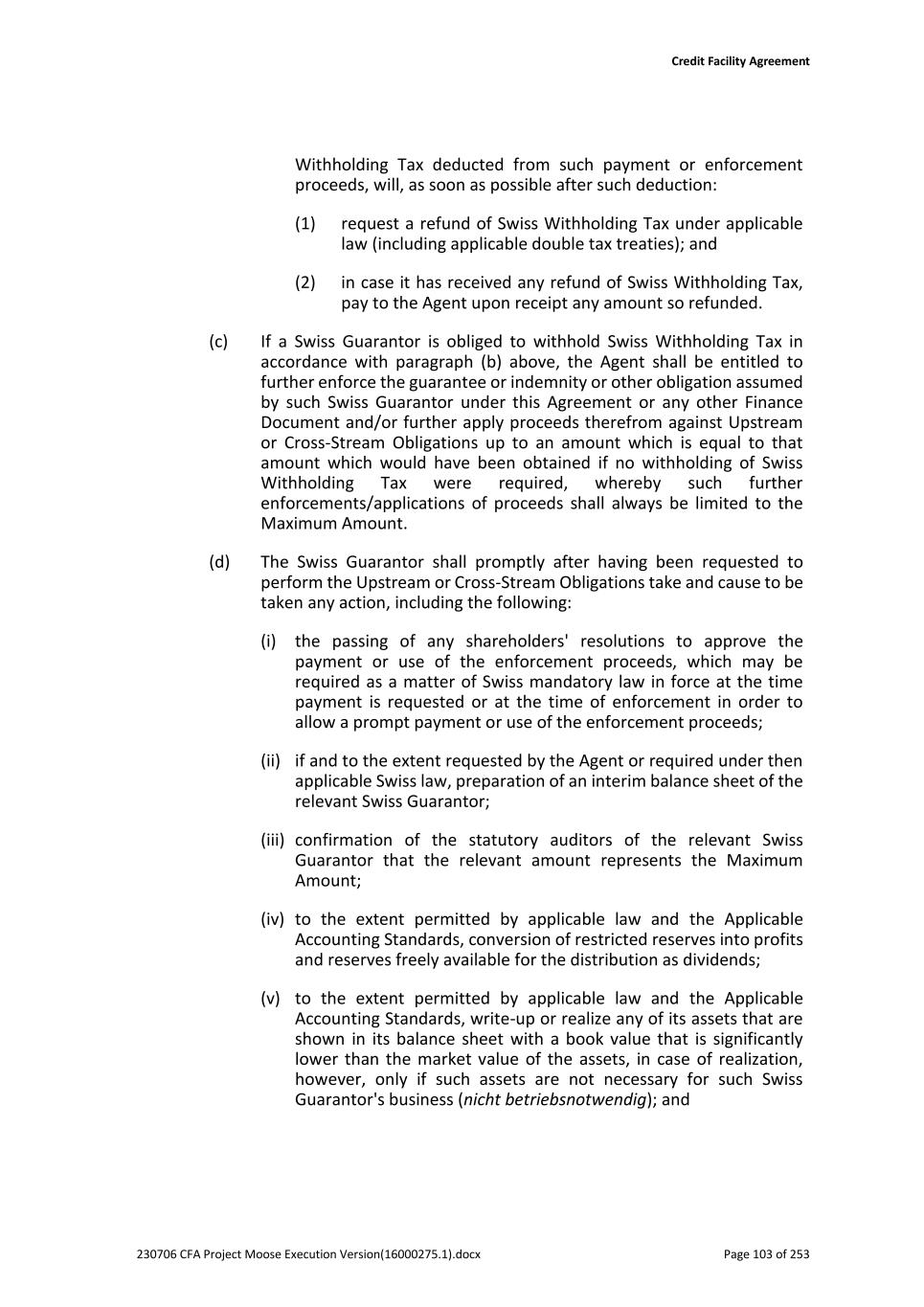
Credit Facility Agreement 230706 CFA Project Moose Execution Version(16000275.1).docx Page 103 of 253 Withholding Tax deducted from such payment or enforcement proceeds, will, as soon as possible after such deduction: (1) request a refund of Swiss Withholding Tax under applicable law (including applicable double tax treaties); and (2) in case it has received any refund of Swiss Withholding Tax, pay to the Agent upon receipt any amount so refunded. (c) If a Swiss Guarantor is obliged to withhold Swiss Withholding Tax in accordance with paragraph (b) above, the Agent shall be entitled to further enforce the guarantee or indemnity or other obligation assumed by such Swiss Guarantor under this Agreement or any other Finance Document and/or further apply proceeds therefrom against Upstream or Cross-Stream Obligations up to an amount which is equal to that amount which would have been obtained if no withholding of Swiss Withholding Tax were required, whereby such further enforcements/applications of proceeds shall always be limited to the Maximum Amount. (d) The Swiss Guarantor shall promptly after having been requested to perform the Upstream or Cross-Stream Obligations take and cause to be taken any action, including the following: (i) the passing of any shareholders' resolutions to approve the payment or use of the enforcement proceeds, which may be required as a matter of Swiss mandatory law in force at the time payment is requested or at the time of enforcement in order to allow a prompt payment or use of the enforcement proceeds; (ii) if and to the extent requested by the Agent or required under then applicable Swiss law, preparation of an interim balance sheet of the relevant Swiss Guarantor; (iii) confirmation of the statutory auditors of the relevant Swiss Guarantor that the relevant amount represents the Maximum Amount; (iv) to the extent permitted by applicable law and the Applicable Accounting Standards, conversion of restricted reserves into profits and reserves freely available for the distribution as dividends; (v) to the extent permitted by applicable law and the Applicable Accounting Standards, write-up or realize any of its assets that are shown in its balance sheet with a book value that is significantly lower than the market value of the assets, in case of realization, however, only if such assets are not necessary for such Swiss Guarantor's business (nicht betriebsnotwendig); and
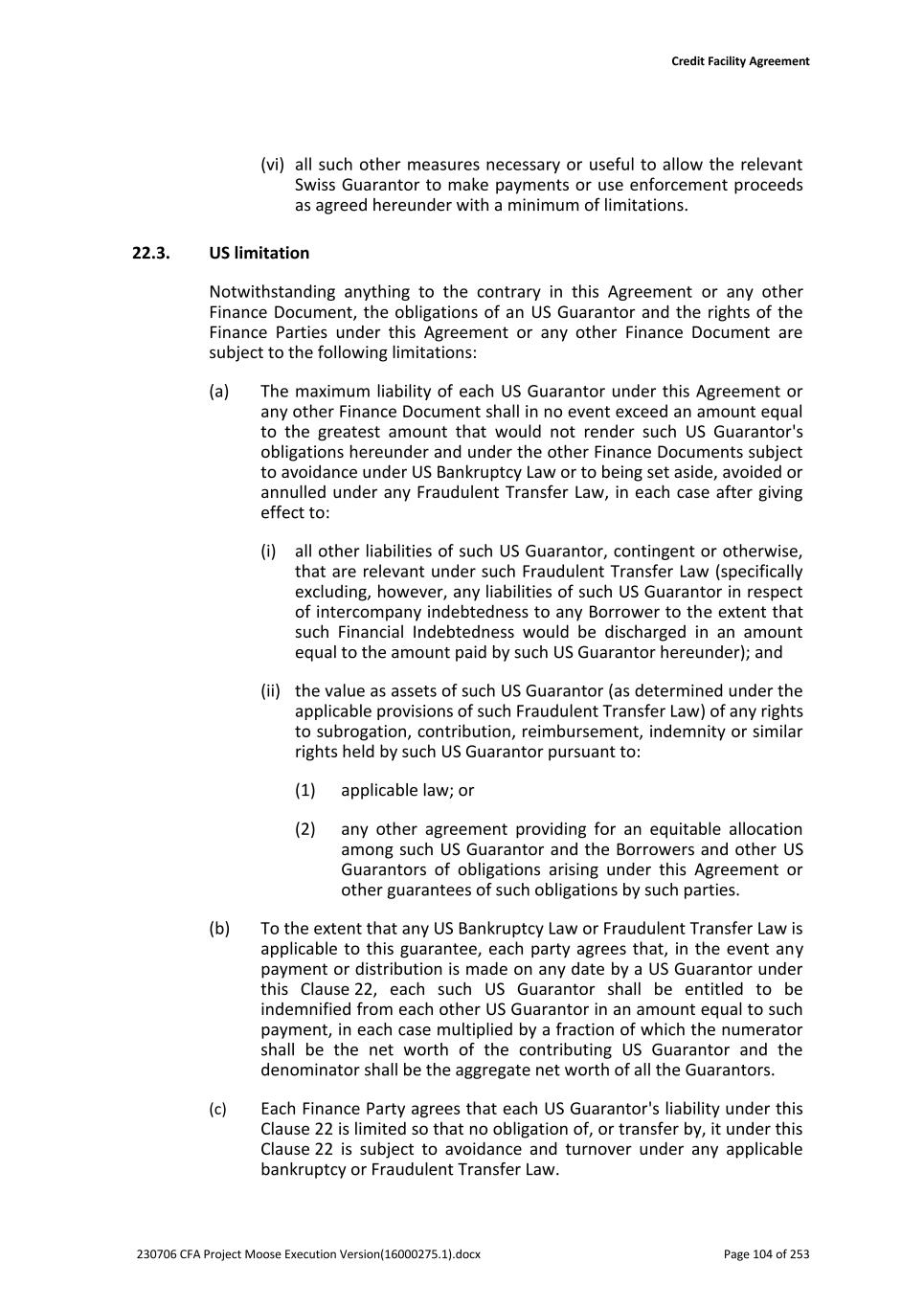
Credit Facility Agreement 230706 CFA Project Moose Execution Version(16000275.1).docx Page 104 of 253 (vi) all such other measures necessary or useful to allow the relevant Swiss Guarantor to make payments or use enforcement proceeds as agreed hereunder with a minimum of limitations. 22.3. US limitation Notwithstanding anything to the contrary in this Agreement or any other Finance Document, the obligations of an US Guarantor and the rights of the Finance Parties under this Agreement or any other Finance Document are subject to the following limitations: (a) The maximum liability of each US Guarantor under this Agreement or any other Finance Document shall in no event exceed an amount equal to the greatest amount that would not render such US Guarantor's obligations hereunder and under the other Finance Documents subject to avoidance under US Bankruptcy Law or to being set aside, avoided or annulled under any Fraudulent Transfer Law, in each case after giving effect to: (i) all other liabilities of such US Guarantor, contingent or otherwise, that are relevant under such Fraudulent Transfer Law (specifically excluding, however, any liabilities of such US Guarantor in respect of intercompany indebtedness to any Borrower to the extent that such Financial Indebtedness would be discharged in an amount equal to the amount paid by such US Guarantor hereunder); and (ii) the value as assets of such US Guarantor (as determined under the applicable provisions of such Fraudulent Transfer Law) of any rights to subrogation, contribution, reimbursement, indemnity or similar rights held by such US Guarantor pursuant to: (1) applicable law; or (2) any other agreement providing for an equitable allocation among such US Guarantor and the Borrowers and other US Guarantors of obligations arising under this Agreement or other guarantees of such obligations by such parties. (b) To the extent that any US Bankruptcy Law or Fraudulent Transfer Law is applicable to this guarantee, each party agrees that, in the event any payment or distribution is made on any date by a US Guarantor under this Clause 22, each such US Guarantor shall be entitled to be indemnified from each other US Guarantor in an amount equal to such payment, in each case multiplied by a fraction of which the numerator shall be the net worth of the contributing US Guarantor and the denominator shall be the aggregate net worth of all the Guarantors. (c) Each Finance Party agrees that each US Guarantor's liability under this Clause 22 is limited so that no obligation of, or transfer by, it under this Clause 22 is subject to avoidance and turnover under any applicable bankruptcy or Fraudulent Transfer Law.
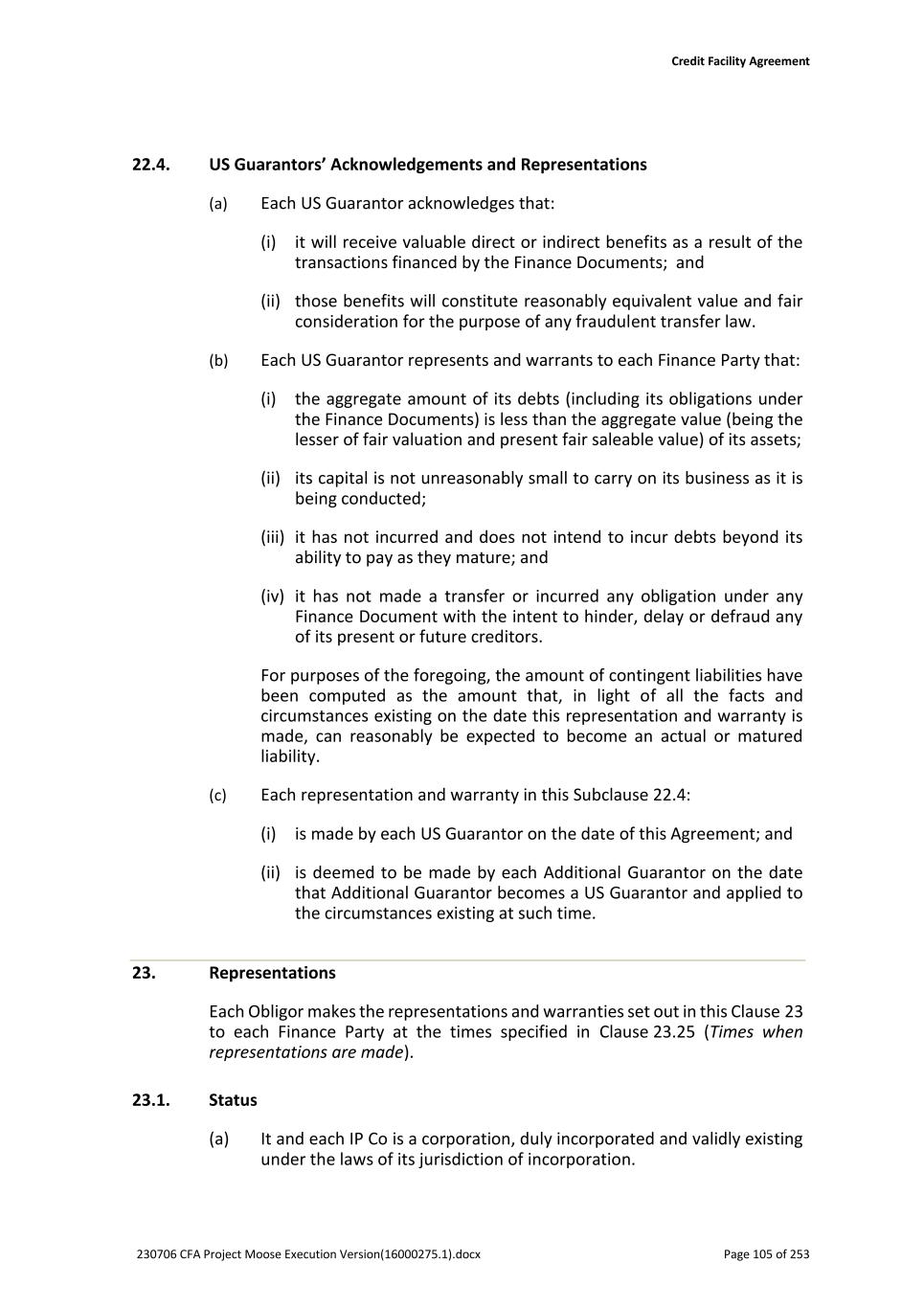
Credit Facility Agreement 230706 CFA Project Moose Execution Version(16000275.1).docx Page 105 of 253 22.4. US Guarantors’ Acknowledgements and Representations (a) Each US Guarantor acknowledges that: (i) it will receive valuable direct or indirect benefits as a result of the transactions financed by the Finance Documents; and (ii) those benefits will constitute reasonably equivalent value and fair consideration for the purpose of any fraudulent transfer law. (b) Each US Guarantor represents and warrants to each Finance Party that: (i) the aggregate amount of its debts (including its obligations under the Finance Documents) is less than the aggregate value (being the lesser of fair valuation and present fair saleable value) of its assets; (ii) its capital is not unreasonably small to carry on its business as it is being conducted; (iii) it has not incurred and does not intend to incur debts beyond its ability to pay as they mature; and (iv) it has not made a transfer or incurred any obligation under any Finance Document with the intent to hinder, delay or defraud any of its present or future creditors. For purposes of the foregoing, the amount of contingent liabilities have been computed as the amount that, in light of all the facts and circumstances existing on the date this representation and warranty is made, can reasonably be expected to become an actual or matured liability. (c) Each representation and warranty in this Subclause 22.4: (i) is made by each US Guarantor on the date of this Agreement; and (ii) is deemed to be made by each Additional Guarantor on the date that Additional Guarantor becomes a US Guarantor and applied to the circumstances existing at such time. 23. Representations Each Obligor makes the representations and warranties set out in this Clause 23 to each Finance Party at the times specified in Clause 23.25 (Times when representations are made). 23.1. Status (a) It and each IP Co is a corporation, duly incorporated and validly existing under the laws of its jurisdiction of incorporation.
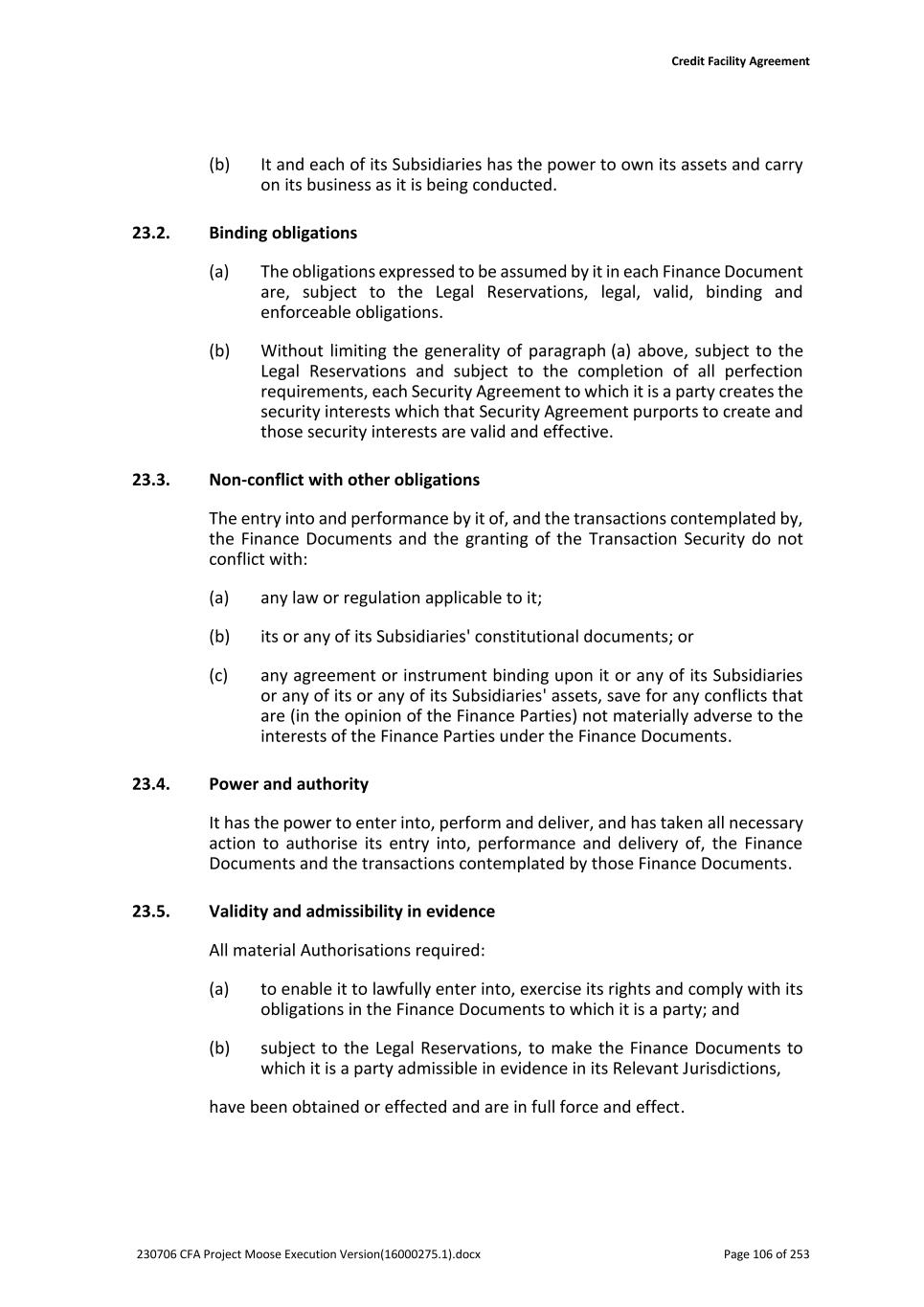
Credit Facility Agreement 230706 CFA Project Moose Execution Version(16000275.1).docx Page 106 of 253 (b) It and each of its Subsidiaries has the power to own its assets and carry on its business as it is being conducted. 23.2. Binding obligations (a) The obligations expressed to be assumed by it in each Finance Document are, subject to the Legal Reservations, legal, valid, binding and enforceable obligations. (b) Without limiting the generality of paragraph (a) above, subject to the Legal Reservations and subject to the completion of all perfection requirements, each Security Agreement to which it is a party creates the security interests which that Security Agreement purports to create and those security interests are valid and effective. 23.3. Non-conflict with other obligations The entry into and performance by it of, and the transactions contemplated by, the Finance Documents and the granting of the Transaction Security do not conflict with: (a) any law or regulation applicable to it; (b) its or any of its Subsidiaries' constitutional documents; or (c) any agreement or instrument binding upon it or any of its Subsidiaries or any of its or any of its Subsidiaries' assets, save for any conflicts that are (in the opinion of the Finance Parties) not materially adverse to the interests of the Finance Parties under the Finance Documents. 23.4. Power and authority It has the power to enter into, perform and deliver, and has taken all necessary action to authorise its entry into, performance and delivery of, the Finance Documents and the transactions contemplated by those Finance Documents. 23.5. Validity and admissibility in evidence All material Authorisations required: (a) to enable it to lawfully enter into, exercise its rights and comply with its obligations in the Finance Documents to which it is a party; and (b) subject to the Legal Reservations, to make the Finance Documents to which it is a party admissible in evidence in its Relevant Jurisdictions, have been obtained or effected and are in full force and effect.
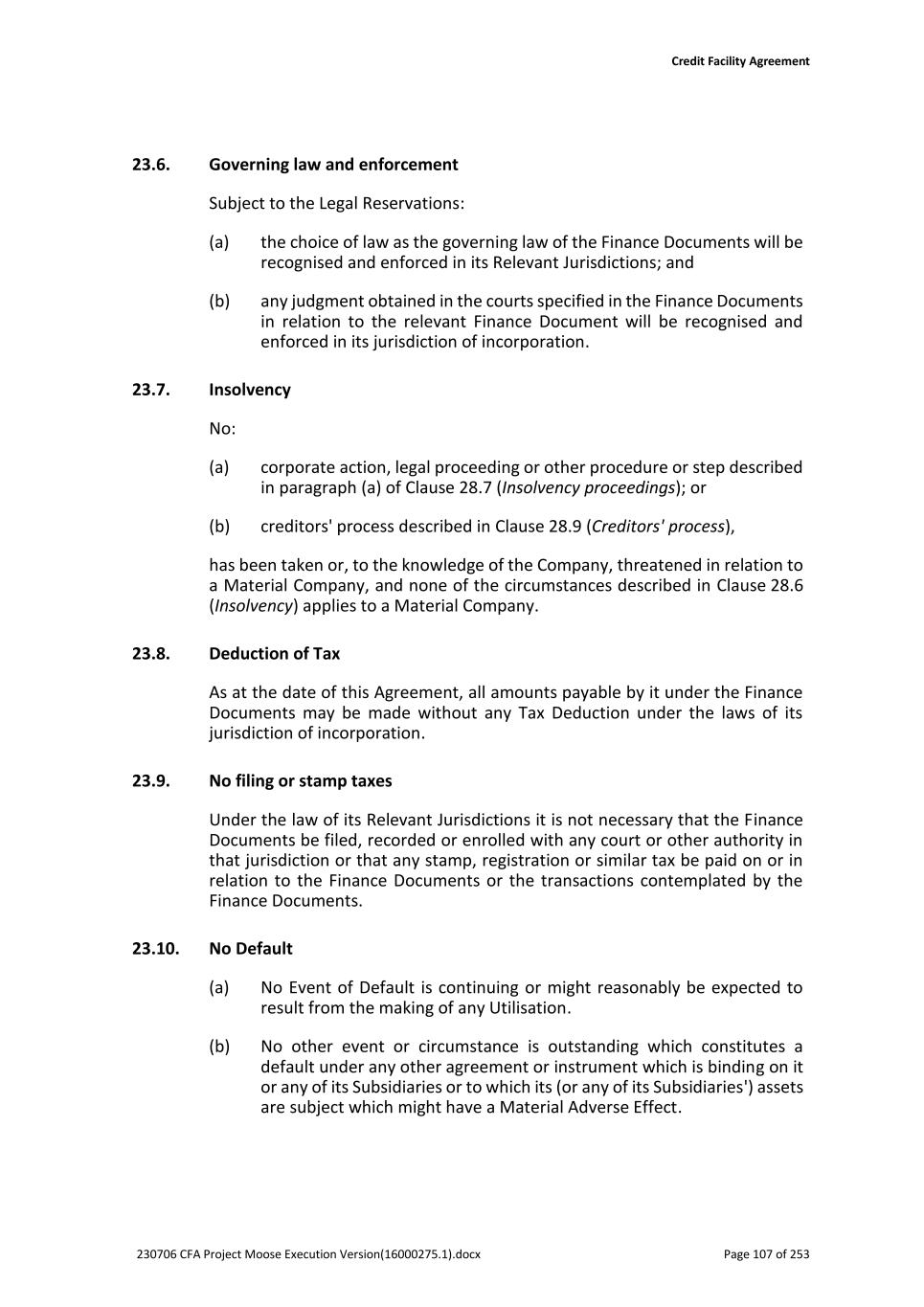
Credit Facility Agreement 230706 CFA Project Moose Execution Version(16000275.1).docx Page 107 of 253 23.6. Governing law and enforcement Subject to the Legal Reservations: (a) the choice of law as the governing law of the Finance Documents will be recognised and enforced in its Relevant Jurisdictions; and (b) any judgment obtained in the courts specified in the Finance Documents in relation to the relevant Finance Document will be recognised and enforced in its jurisdiction of incorporation. 23.7. Insolvency No: (a) corporate action, legal proceeding or other procedure or step described in paragraph (a) of Clause 28.7 (Insolvency proceedings); or (b) creditors' process described in Clause 28.9 (Creditors' process), has been taken or, to the knowledge of the Company, threatened in relation to a Material Company, and none of the circumstances described in Clause 28.6 (Insolvency) applies to a Material Company. 23.8. Deduction of Tax As at the date of this Agreement, all amounts payable by it under the Finance Documents may be made without any Tax Deduction under the laws of its jurisdiction of incorporation. 23.9. No filing or stamp taxes Under the law of its Relevant Jurisdictions it is not necessary that the Finance Documents be filed, recorded or enrolled with any court or other authority in that jurisdiction or that any stamp, registration or similar tax be paid on or in relation to the Finance Documents or the transactions contemplated by the Finance Documents. 23.10. No Default (a) No Event of Default is continuing or might reasonably be expected to result from the making of any Utilisation. (b) No other event or circumstance is outstanding which constitutes a default under any other agreement or instrument which is binding on it or any of its Subsidiaries or to which its (or any of its Subsidiaries') assets are subject which might have a Material Adverse Effect.
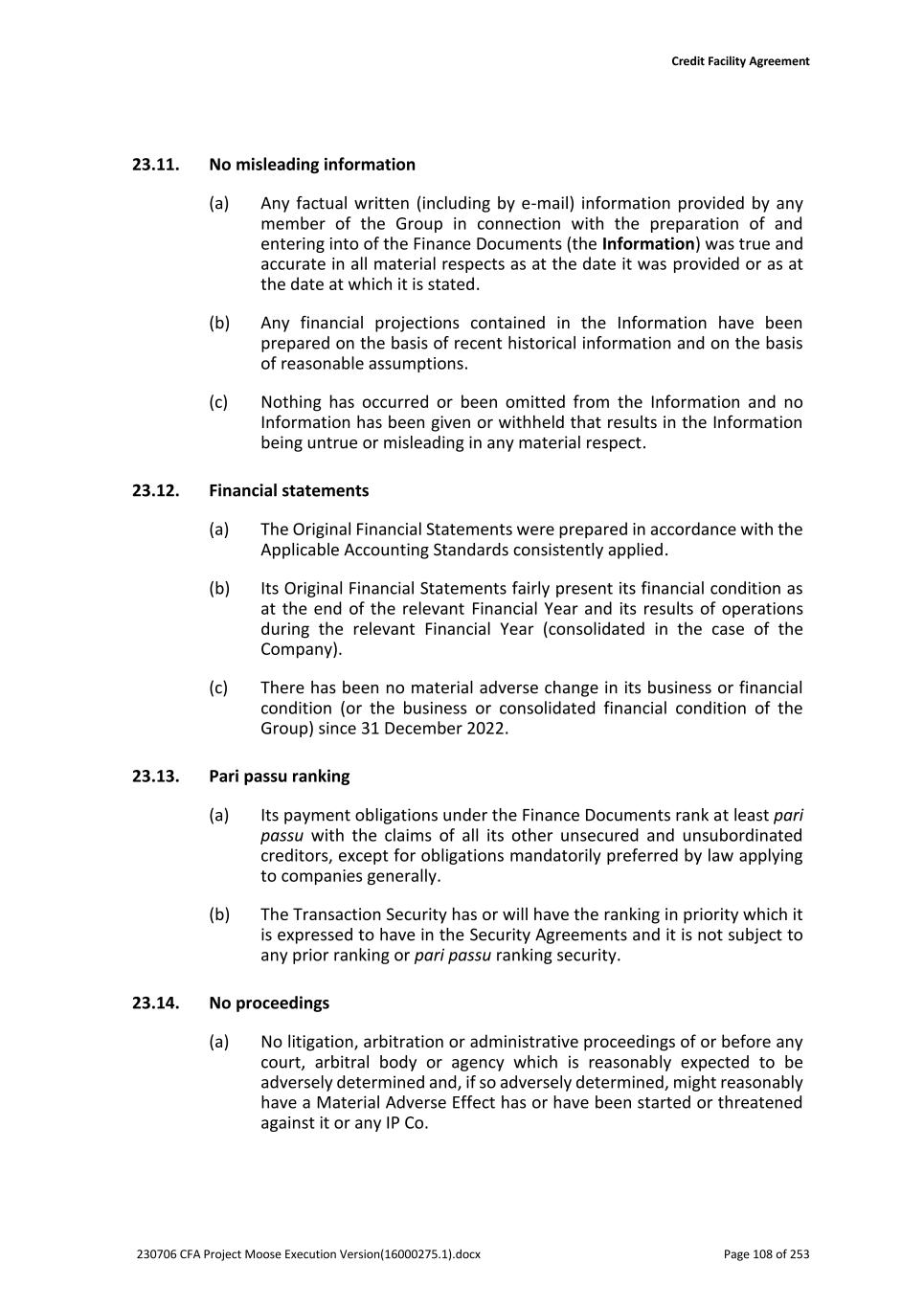
Credit Facility Agreement 230706 CFA Project Moose Execution Version(16000275.1).docx Page 108 of 253 23.11. No misleading information (a) Any factual written (including by e-mail) information provided by any member of the Group in connection with the preparation of and entering into of the Finance Documents (the Information) was true and accurate in all material respects as at the date it was provided or as at the date at which it is stated. (b) Any financial projections contained in the Information have been prepared on the basis of recent historical information and on the basis of reasonable assumptions. (c) Nothing has occurred or been omitted from the Information and no Information has been given or withheld that results in the Information being untrue or misleading in any material respect. 23.12. Financial statements (a) The Original Financial Statements were prepared in accordance with the Applicable Accounting Standards consistently applied. (b) Its Original Financial Statements fairly present its financial condition as at the end of the relevant Financial Year and its results of operations during the relevant Financial Year (consolidated in the case of the Company). (c) There has been no material adverse change in its business or financial condition (or the business or consolidated financial condition of the Group) since 31 December 2022. 23.13. Pari passu ranking (a) Its payment obligations under the Finance Documents rank at least pari passu with the claims of all its other unsecured and unsubordinated creditors, except for obligations mandatorily preferred by law applying to companies generally. (b) The Transaction Security has or will have the ranking in priority which it is expressed to have in the Security Agreements and it is not subject to any prior ranking or pari passu ranking security. 23.14. No proceedings (a) No litigation, arbitration or administrative proceedings of or before any court, arbitral body or agency which is reasonably expected to be adversely determined and, if so adversely determined, might reasonably have a Material Adverse Effect has or have been started or threatened against it or any IP Co.
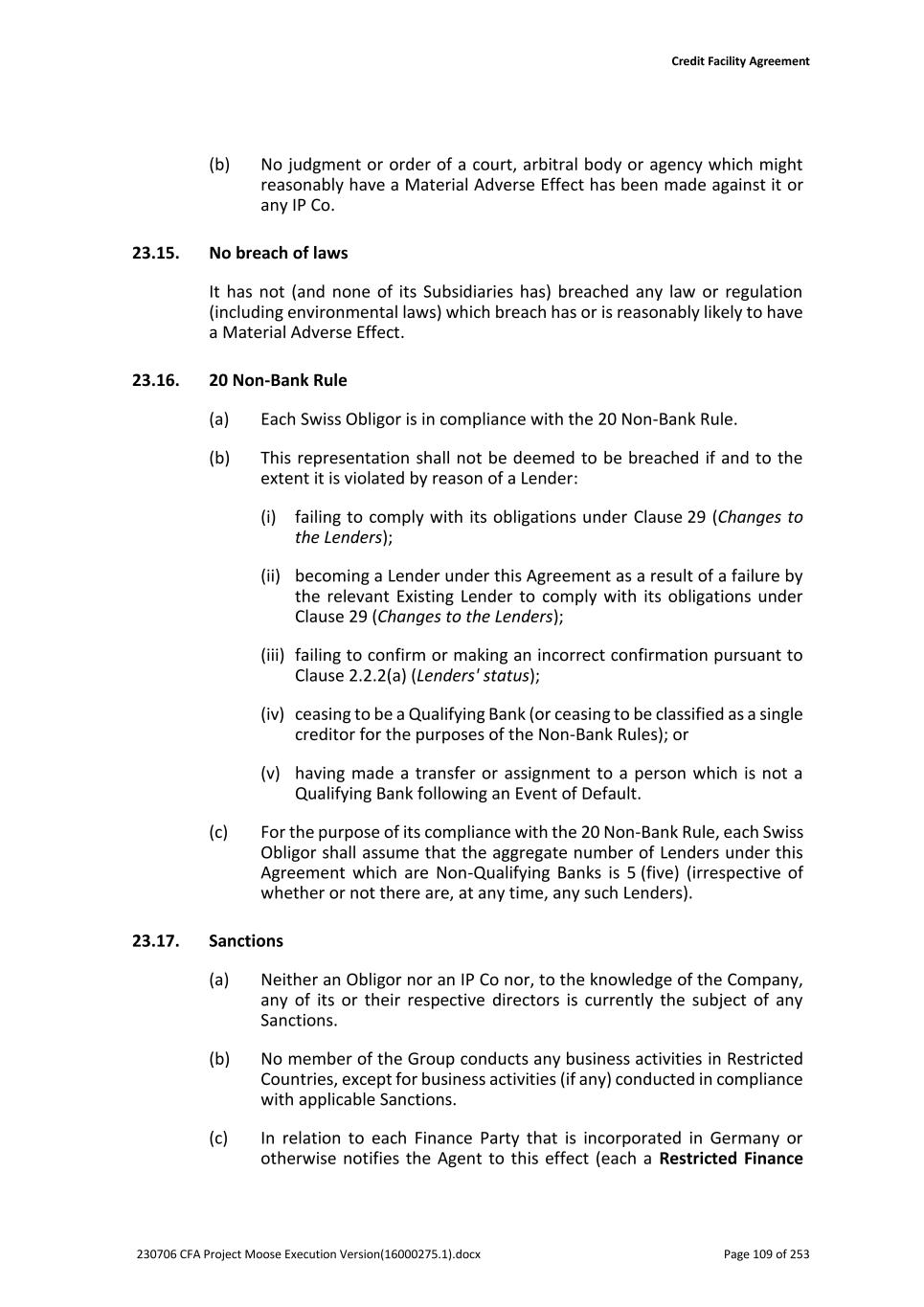
Credit Facility Agreement 230706 CFA Project Moose Execution Version(16000275.1).docx Page 109 of 253 (b) No judgment or order of a court, arbitral body or agency which might reasonably have a Material Adverse Effect has been made against it or any IP Co. 23.15. No breach of laws It has not (and none of its Subsidiaries has) breached any law or regulation (including environmental laws) which breach has or is reasonably likely to have a Material Adverse Effect. 23.16. 20 Non-Bank Rule (a) Each Swiss Obligor is in compliance with the 20 Non-Bank Rule. (b) This representation shall not be deemed to be breached if and to the extent it is violated by reason of a Lender: (i) failing to comply with its obligations under Clause 29 (Changes to the Lenders); (ii) becoming a Lender under this Agreement as a result of a failure by the relevant Existing Lender to comply with its obligations under Clause 29 (Changes to the Lenders); (iii) failing to confirm or making an incorrect confirmation pursuant to Clause 2.2.2(a) (Lenders' status); (iv) ceasing to be a Qualifying Bank (or ceasing to be classified as a single creditor for the purposes of the Non-Bank Rules); or (v) having made a transfer or assignment to a person which is not a Qualifying Bank following an Event of Default. (c) For the purpose of its compliance with the 20 Non-Bank Rule, each Swiss Obligor shall assume that the aggregate number of Lenders under this Agreement which are Non-Qualifying Banks is 5 (five) (irrespective of whether or not there are, at any time, any such Lenders). 23.17. Sanctions (a) Neither an Obligor nor an IP Co nor, to the knowledge of the Company, any of its or their respective directors is currently the subject of any Sanctions. (b) No member of the Group conducts any business activities in Restricted Countries, except for business activities (if any) conducted in compliance with applicable Sanctions. (c) In relation to each Finance Party that is incorporated in Germany or otherwise notifies the Agent to this effect (each a Restricted Finance
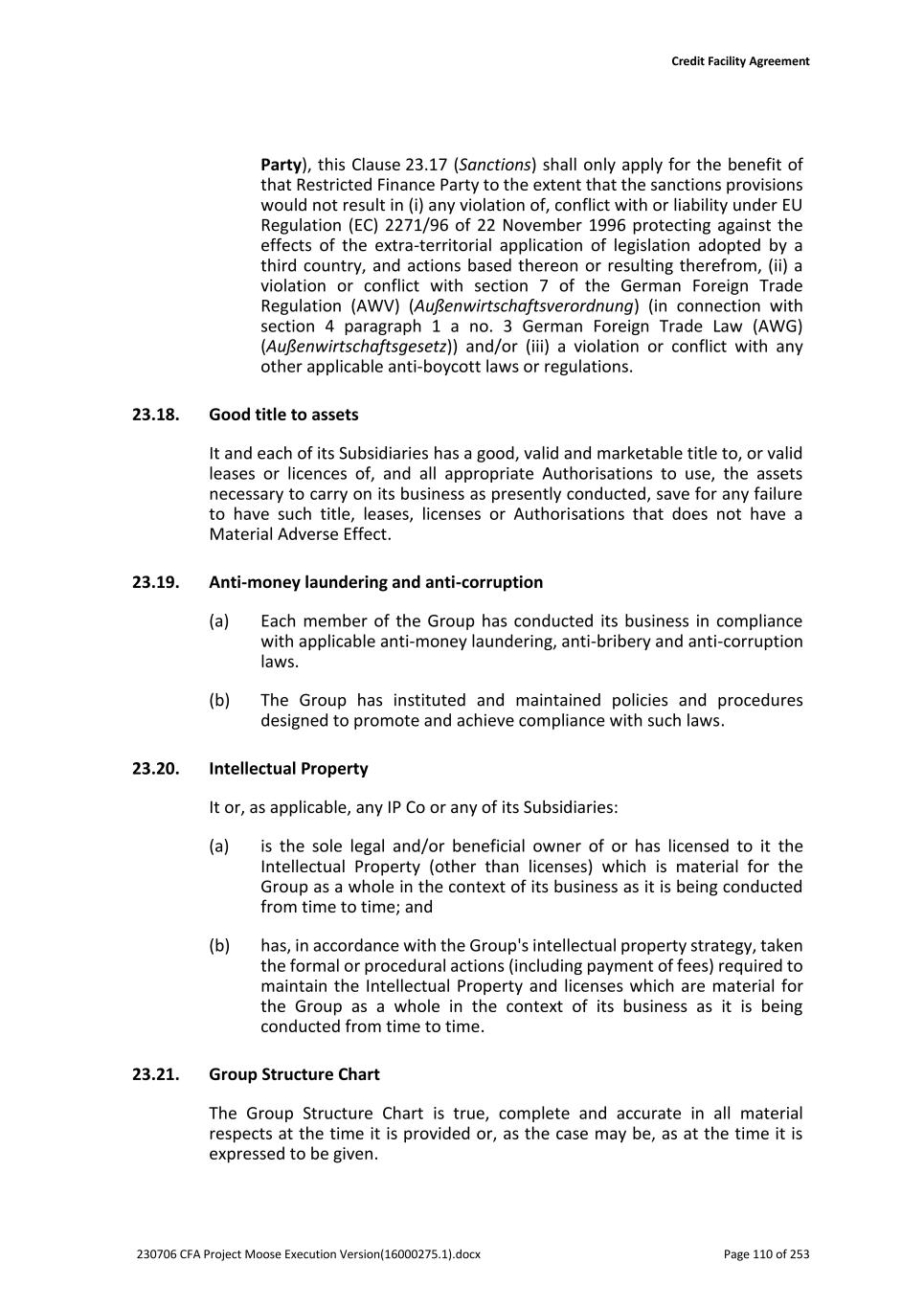
Credit Facility Agreement 230706 CFA Project Moose Execution Version(16000275.1).docx Page 110 of 253 Party), this Clause 23.17 (Sanctions) shall only apply for the benefit of that Restricted Finance Party to the extent that the sanctions provisions would not result in (i) any violation of, conflict with or liability under EU Regulation (EC) 2271/96 of 22 November 1996 protecting against the effects of the extra-territorial application of legislation adopted by a third country, and actions based thereon or resulting therefrom, (ii) a violation or conflict with section 7 of the German Foreign Trade Regulation (AWV) (Außenwirtschaftsverordnung) (in connection with section 4 paragraph 1 a no. 3 German Foreign Trade Law (AWG) (Außenwirtschaftsgesetz)) and/or (iii) a violation or conflict with any other applicable anti-boycott laws or regulations. 23.18. Good title to assets It and each of its Subsidiaries has a good, valid and marketable title to, or valid leases or licences of, and all appropriate Authorisations to use, the assets necessary to carry on its business as presently conducted, save for any failure to have such title, leases, licenses or Authorisations that does not have a Material Adverse Effect. 23.19. Anti-money laundering and anti-corruption (a) Each member of the Group has conducted its business in compliance with applicable anti-money laundering, anti-bribery and anti-corruption laws. (b) The Group has instituted and maintained policies and procedures designed to promote and achieve compliance with such laws. 23.20. Intellectual Property It or, as applicable, any IP Co or any of its Subsidiaries: (a) is the sole legal and/or beneficial owner of or has licensed to it the Intellectual Property (other than licenses) which is material for the Group as a whole in the context of its business as it is being conducted from time to time; and (b) has, in accordance with the Group's intellectual property strategy, taken the formal or procedural actions (including payment of fees) required to maintain the Intellectual Property and licenses which are material for the Group as a whole in the context of its business as it is being conducted from time to time. 23.21. Group Structure Chart The Group Structure Chart is true, complete and accurate in all material respects at the time it is provided or, as the case may be, as at the time it is expressed to be given.
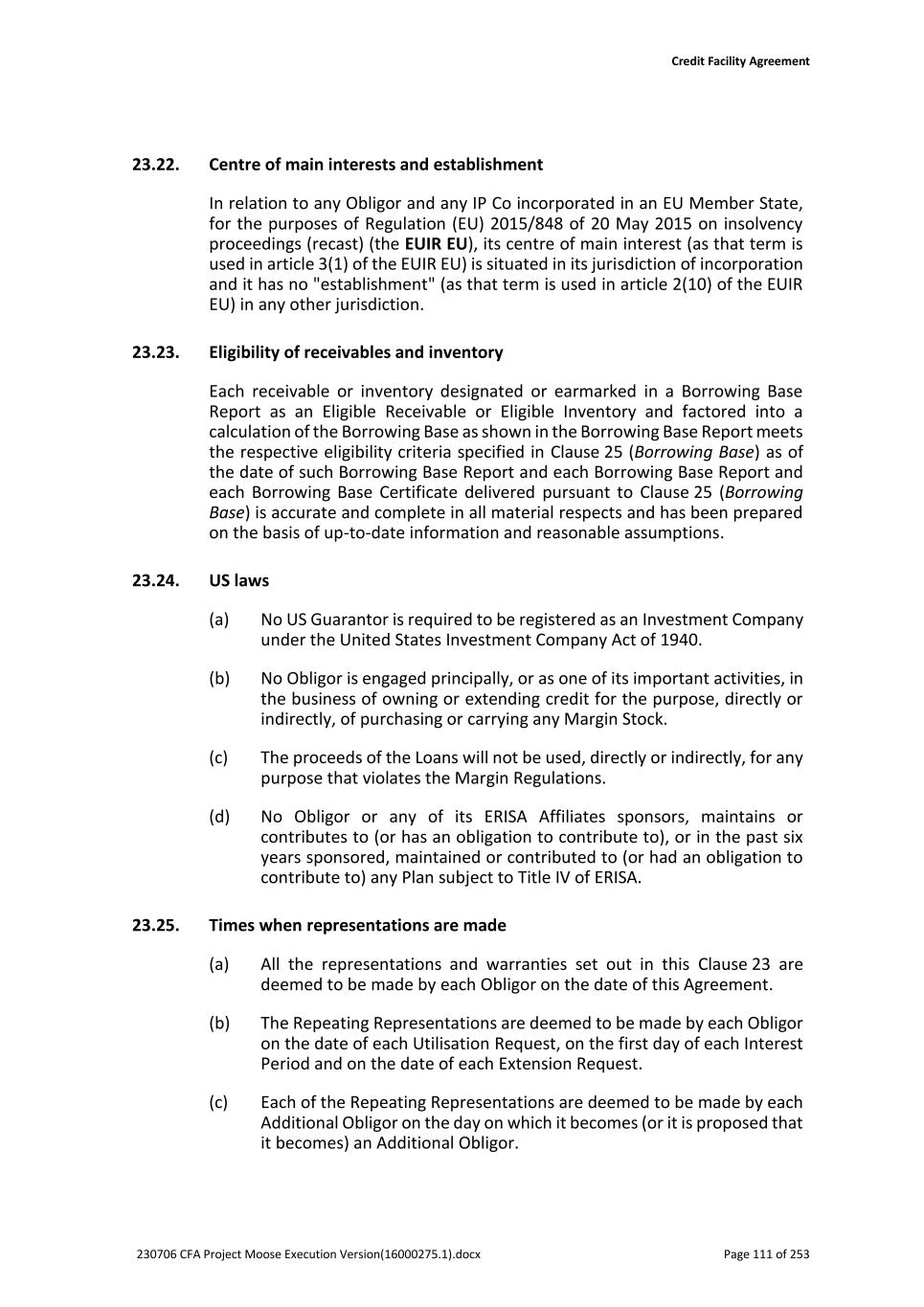
Credit Facility Agreement 230706 CFA Project Moose Execution Version(16000275.1).docx Page 111 of 253 23.22. Centre of main interests and establishment In relation to any Obligor and any IP Co incorporated in an EU Member State, for the purposes of Regulation (EU) 2015/848 of 20 May 2015 on insolvency proceedings (recast) (the EUIR EU), its centre of main interest (as that term is used in article 3(1) of the EUIR EU) is situated in its jurisdiction of incorporation and it has no "establishment" (as that term is used in article 2(10) of the EUIR EU) in any other jurisdiction. 23.23. Eligibility of receivables and inventory Each receivable or inventory designated or earmarked in a Borrowing Base Report as an Eligible Receivable or Eligible Inventory and factored into a calculation of the Borrowing Base as shown in the Borrowing Base Report meets the respective eligibility criteria specified in Clause 25 (Borrowing Base) as of the date of such Borrowing Base Report and each Borrowing Base Report and each Borrowing Base Certificate delivered pursuant to Clause 25 (Borrowing Base) is accurate and complete in all material respects and has been prepared on the basis of up-to-date information and reasonable assumptions. 23.24. US laws (a) No US Guarantor is required to be registered as an Investment Company under the United States Investment Company Act of 1940. (b) No Obligor is engaged principally, or as one of its important activities, in the business of owning or extending credit for the purpose, directly or indirectly, of purchasing or carrying any Margin Stock. (c) The proceeds of the Loans will not be used, directly or indirectly, for any purpose that violates the Margin Regulations. (d) No Obligor or any of its ERISA Affiliates sponsors, maintains or contributes to (or has an obligation to contribute to), or in the past six years sponsored, maintained or contributed to (or had an obligation to contribute to) any Plan subject to Title IV of ERISA. 23.25. Times when representations are made (a) All the representations and warranties set out in this Clause 23 are deemed to be made by each Obligor on the date of this Agreement. (b) The Repeating Representations are deemed to be made by each Obligor on the date of each Utilisation Request, on the first day of each Interest Period and on the date of each Extension Request. (c) Each of the Repeating Representations are deemed to be made by each Additional Obligor on the day on which it becomes (or it is proposed that it becomes) an Additional Obligor.
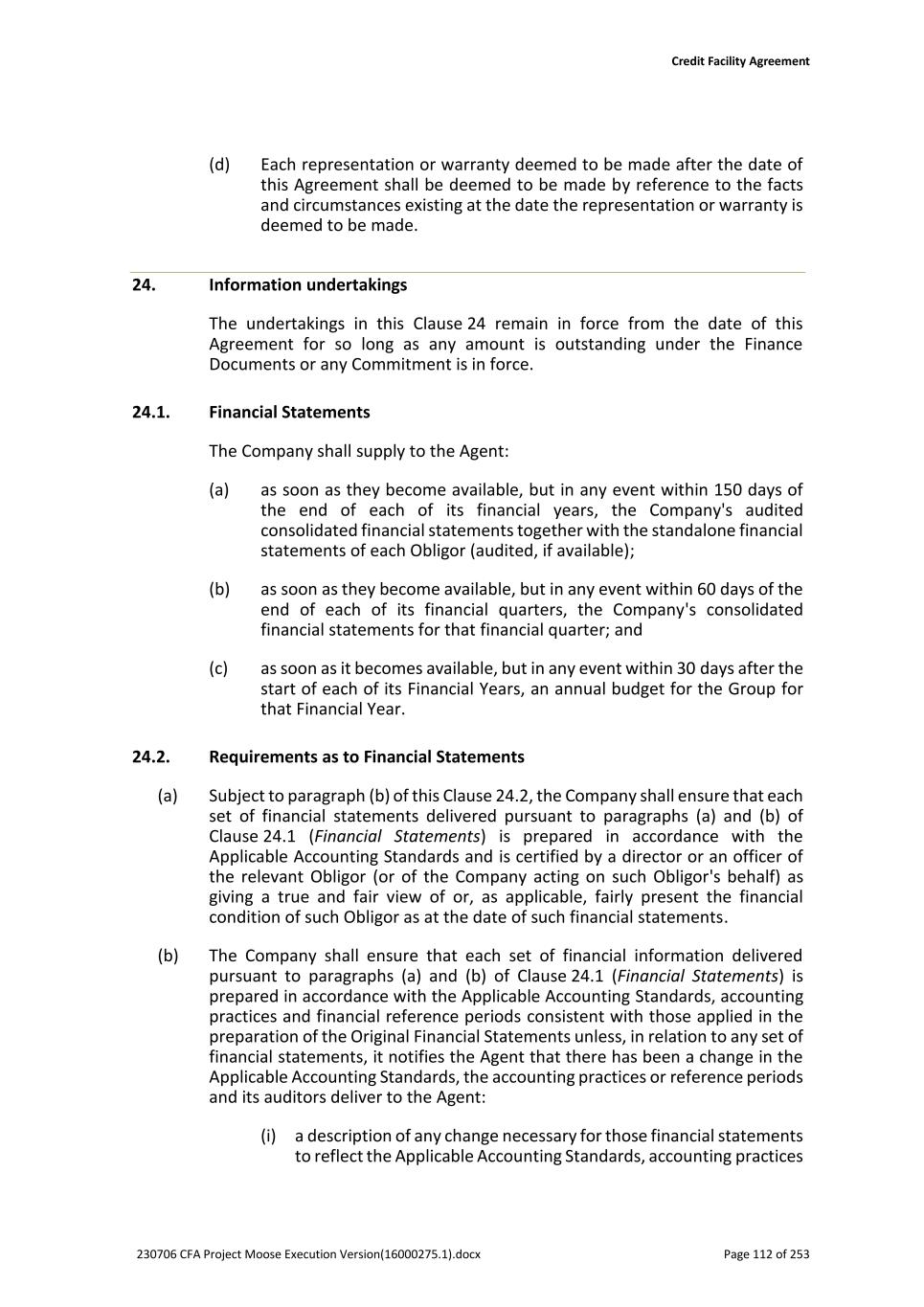
Credit Facility Agreement 230706 CFA Project Moose Execution Version(16000275.1).docx Page 112 of 253 (d) Each representation or warranty deemed to be made after the date of this Agreement shall be deemed to be made by reference to the facts and circumstances existing at the date the representation or warranty is deemed to be made. 24. Information undertakings The undertakings in this Clause 24 remain in force from the date of this Agreement for so long as any amount is outstanding under the Finance Documents or any Commitment is in force. 24.1. Financial Statements The Company shall supply to the Agent: (a) as soon as they become available, but in any event within 150 days of the end of each of its financial years, the Company's audited consolidated financial statements together with the standalone financial statements of each Obligor (audited, if available); (b) as soon as they become available, but in any event within 60 days of the end of each of its financial quarters, the Company's consolidated financial statements for that financial quarter; and (c) as soon as it becomes available, but in any event within 30 days after the start of each of its Financial Years, an annual budget for the Group for that Financial Year. 24.2. Requirements as to Financial Statements (a) Subject to paragraph (b) of this Clause 24.2, the Company shall ensure that each set of financial statements delivered pursuant to paragraphs (a) and (b) of Clause 24.1 (Financial Statements) is prepared in accordance with the Applicable Accounting Standards and is certified by a director or an officer of the relevant Obligor (or of the Company acting on such Obligor's behalf) as giving a true and fair view of or, as applicable, fairly present the financial condition of such Obligor as at the date of such financial statements. (b) The Company shall ensure that each set of financial information delivered pursuant to paragraphs (a) and (b) of Clause 24.1 (Financial Statements) is prepared in accordance with the Applicable Accounting Standards, accounting practices and financial reference periods consistent with those applied in the preparation of the Original Financial Statements unless, in relation to any set of financial statements, it notifies the Agent that there has been a change in the Applicable Accounting Standards, the accounting practices or reference periods and its auditors deliver to the Agent: (i) a description of any change necessary for those financial statements to reflect the Applicable Accounting Standards, accounting practices
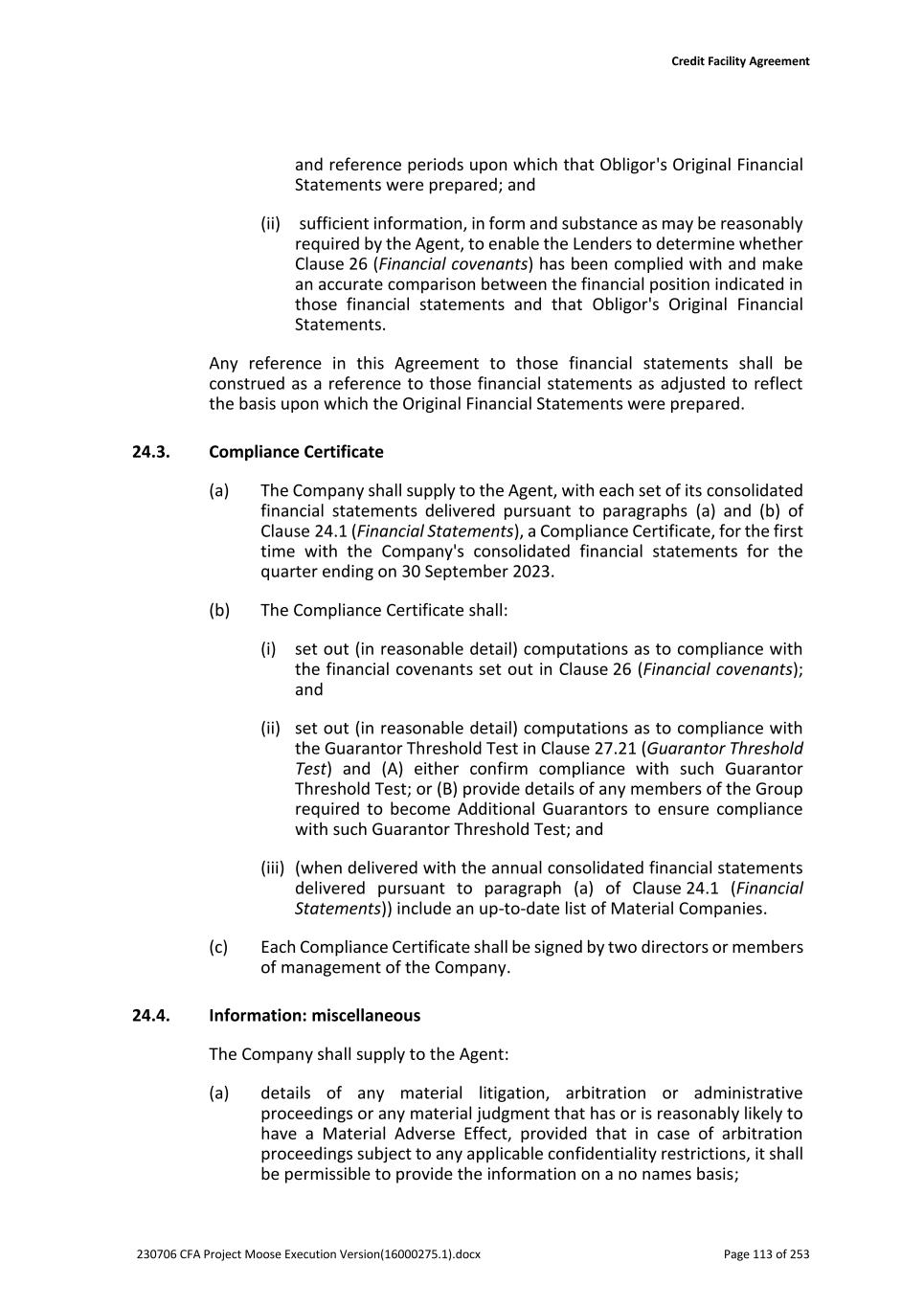
Credit Facility Agreement 230706 CFA Project Moose Execution Version(16000275.1).docx Page 113 of 253 and reference periods upon which that Obligor's Original Financial Statements were prepared; and (ii) sufficient information, in form and substance as may be reasonably required by the Agent, to enable the Lenders to determine whether Clause 26 (Financial covenants) has been complied with and make an accurate comparison between the financial position indicated in those financial statements and that Obligor's Original Financial Statements. Any reference in this Agreement to those financial statements shall be construed as a reference to those financial statements as adjusted to reflect the basis upon which the Original Financial Statements were prepared. 24.3. Compliance Certificate (a) The Company shall supply to the Agent, with each set of its consolidated financial statements delivered pursuant to paragraphs (a) and (b) of Clause 24.1 (Financial Statements), a Compliance Certificate, for the first time with the Company's consolidated financial statements for the quarter ending on 30 September 2023. (b) The Compliance Certificate shall: (i) set out (in reasonable detail) computations as to compliance with the financial covenants set out in Clause 26 (Financial covenants); and (ii) set out (in reasonable detail) computations as to compliance with the Guarantor Threshold Test in Clause 27.21 (Guarantor Threshold Test) and (A) either confirm compliance with such Guarantor Threshold Test; or (B) provide details of any members of the Group required to become Additional Guarantors to ensure compliance with such Guarantor Threshold Test; and (iii) (when delivered with the annual consolidated financial statements delivered pursuant to paragraph (a) of Clause 24.1 (Financial Statements)) include an up-to-date list of Material Companies. (c) Each Compliance Certificate shall be signed by two directors or members of management of the Company. 24.4. Information: miscellaneous The Company shall supply to the Agent: (a) details of any material litigation, arbitration or administrative proceedings or any material judgment that has or is reasonably likely to have a Material Adverse Effect, provided that in case of arbitration proceedings subject to any applicable confidentiality restrictions, it shall be permissible to provide the information on a no names basis;
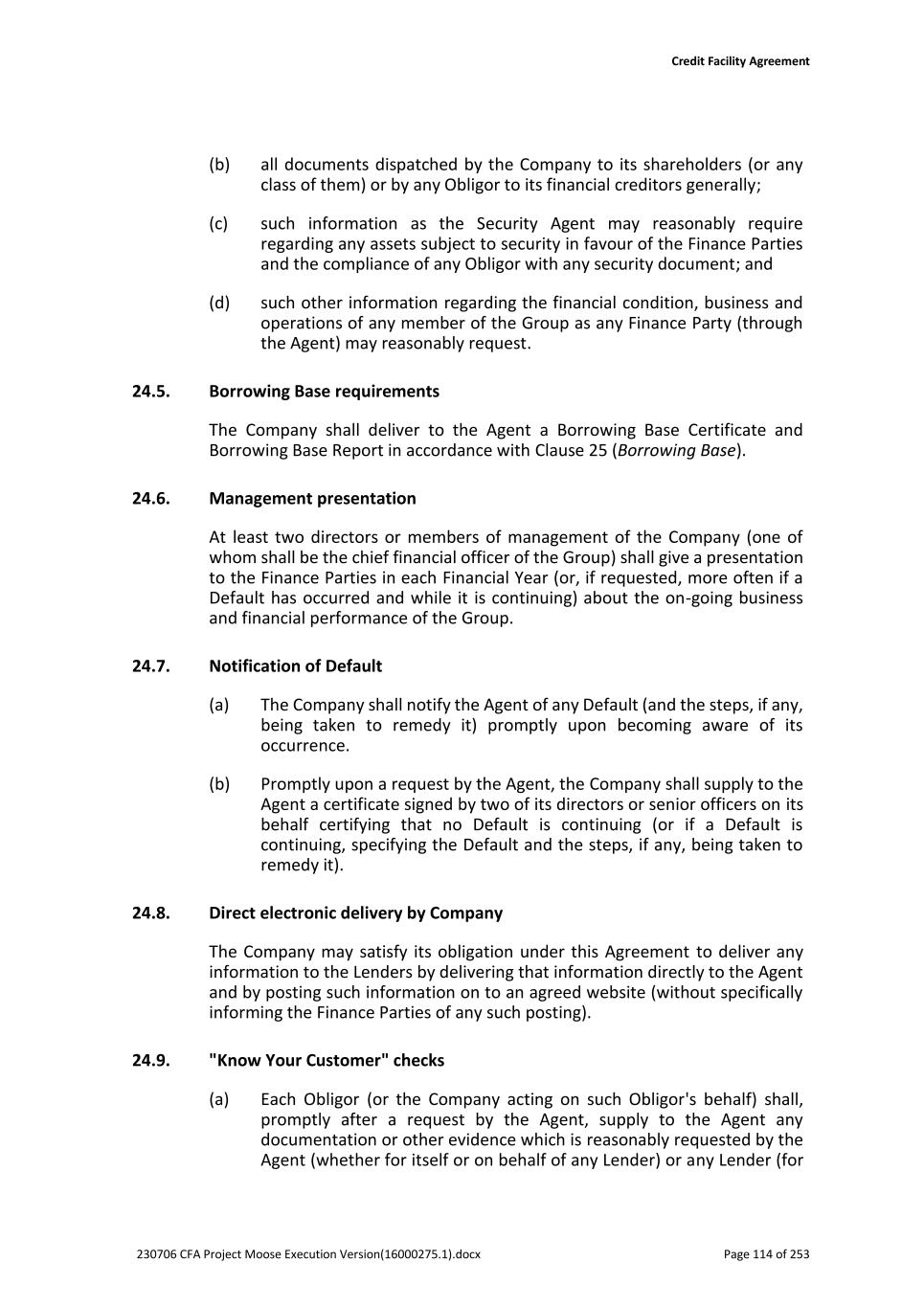
Credit Facility Agreement 230706 CFA Project Moose Execution Version(16000275.1).docx Page 114 of 253 (b) all documents dispatched by the Company to its shareholders (or any class of them) or by any Obligor to its financial creditors generally; (c) such information as the Security Agent may reasonably require regarding any assets subject to security in favour of the Finance Parties and the compliance of any Obligor with any security document; and (d) such other information regarding the financial condition, business and operations of any member of the Group as any Finance Party (through the Agent) may reasonably request. 24.5. Borrowing Base requirements The Company shall deliver to the Agent a Borrowing Base Certificate and Borrowing Base Report in accordance with Clause 25 (Borrowing Base). 24.6. Management presentation At least two directors or members of management of the Company (one of whom shall be the chief financial officer of the Group) shall give a presentation to the Finance Parties in each Financial Year (or, if requested, more often if a Default has occurred and while it is continuing) about the on-going business and financial performance of the Group. 24.7. Notification of Default (a) The Company shall notify the Agent of any Default (and the steps, if any, being taken to remedy it) promptly upon becoming aware of its occurrence. (b) Promptly upon a request by the Agent, the Company shall supply to the Agent a certificate signed by two of its directors or senior officers on its behalf certifying that no Default is continuing (or if a Default is continuing, specifying the Default and the steps, if any, being taken to remedy it). 24.8. Direct electronic delivery by Company The Company may satisfy its obligation under this Agreement to deliver any information to the Lenders by delivering that information directly to the Agent and by posting such information on to an agreed website (without specifically informing the Finance Parties of any such posting). 24.9. "Know Your Customer" checks (a) Each Obligor (or the Company acting on such Obligor's behalf) shall, promptly after a request by the Agent, supply to the Agent any documentation or other evidence which is reasonably requested by the Agent (whether for itself or on behalf of any Lender) or any Lender (for
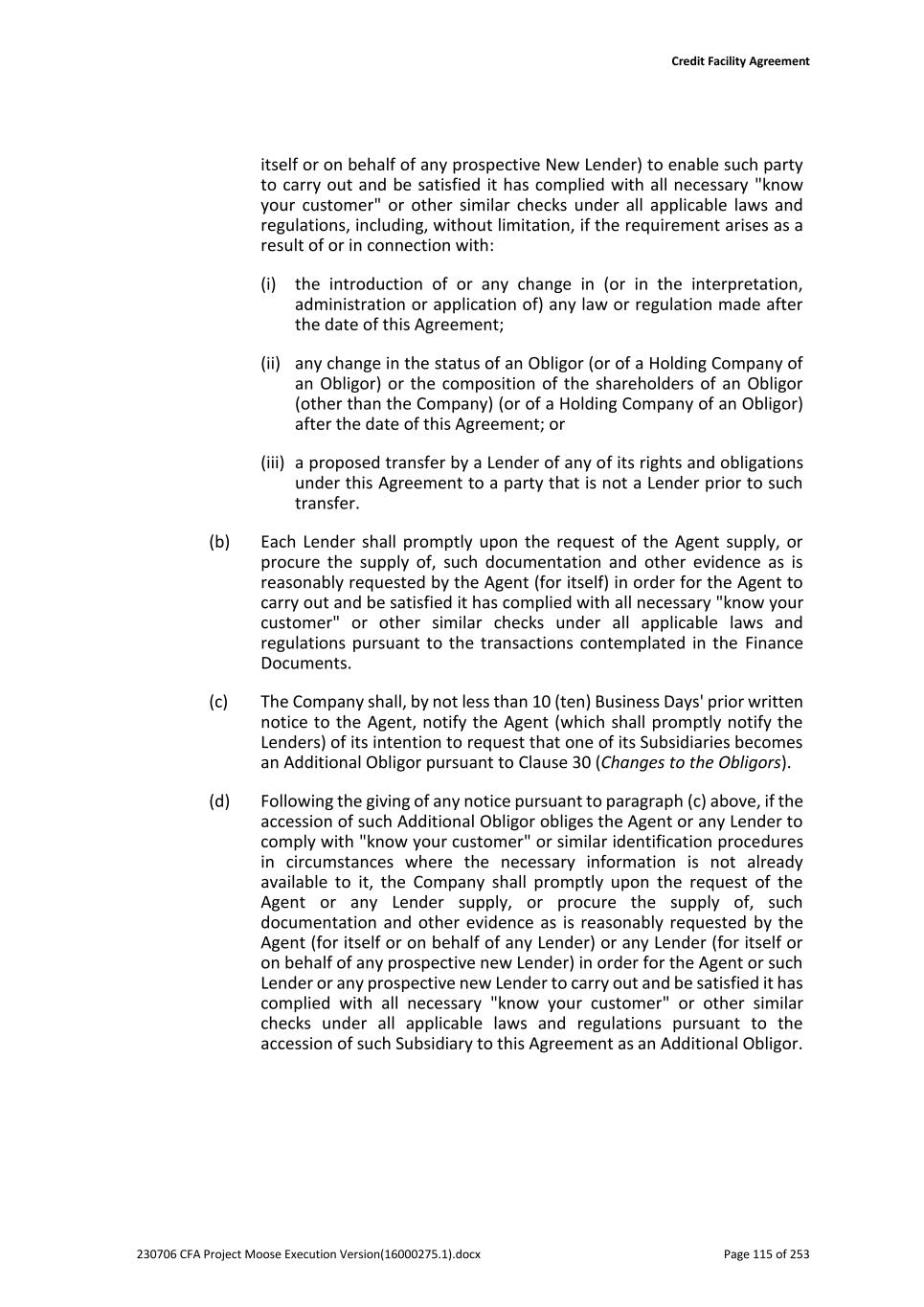
Credit Facility Agreement 230706 CFA Project Moose Execution Version(16000275.1).docx Page 115 of 253 itself or on behalf of any prospective New Lender) to enable such party to carry out and be satisfied it has complied with all necessary "know your customer" or other similar checks under all applicable laws and regulations, including, without limitation, if the requirement arises as a result of or in connection with: (i) the introduction of or any change in (or in the interpretation, administration or application of) any law or regulation made after the date of this Agreement; (ii) any change in the status of an Obligor (or of a Holding Company of an Obligor) or the composition of the shareholders of an Obligor (other than the Company) (or of a Holding Company of an Obligor) after the date of this Agreement; or (iii) a proposed transfer by a Lender of any of its rights and obligations under this Agreement to a party that is not a Lender prior to such transfer. (b) Each Lender shall promptly upon the request of the Agent supply, or procure the supply of, such documentation and other evidence as is reasonably requested by the Agent (for itself) in order for the Agent to carry out and be satisfied it has complied with all necessary "know your customer" or other similar checks under all applicable laws and regulations pursuant to the transactions contemplated in the Finance Documents. (c) The Company shall, by not less than 10 (ten) Business Days' prior written notice to the Agent, notify the Agent (which shall promptly notify the Lenders) of its intention to request that one of its Subsidiaries becomes an Additional Obligor pursuant to Clause 30 (Changes to the Obligors). (d) Following the giving of any notice pursuant to paragraph (c) above, if the accession of such Additional Obligor obliges the Agent or any Lender to comply with "know your customer" or similar identification procedures in circumstances where the necessary information is not already available to it, the Company shall promptly upon the request of the Agent or any Lender supply, or procure the supply of, such documentation and other evidence as is reasonably requested by the Agent (for itself or on behalf of any Lender) or any Lender (for itself or on behalf of any prospective new Lender) in order for the Agent or such Lender or any prospective new Lender to carry out and be satisfied it has complied with all necessary "know your customer" or other similar checks under all applicable laws and regulations pursuant to the accession of such Subsidiary to this Agreement as an Additional Obligor.
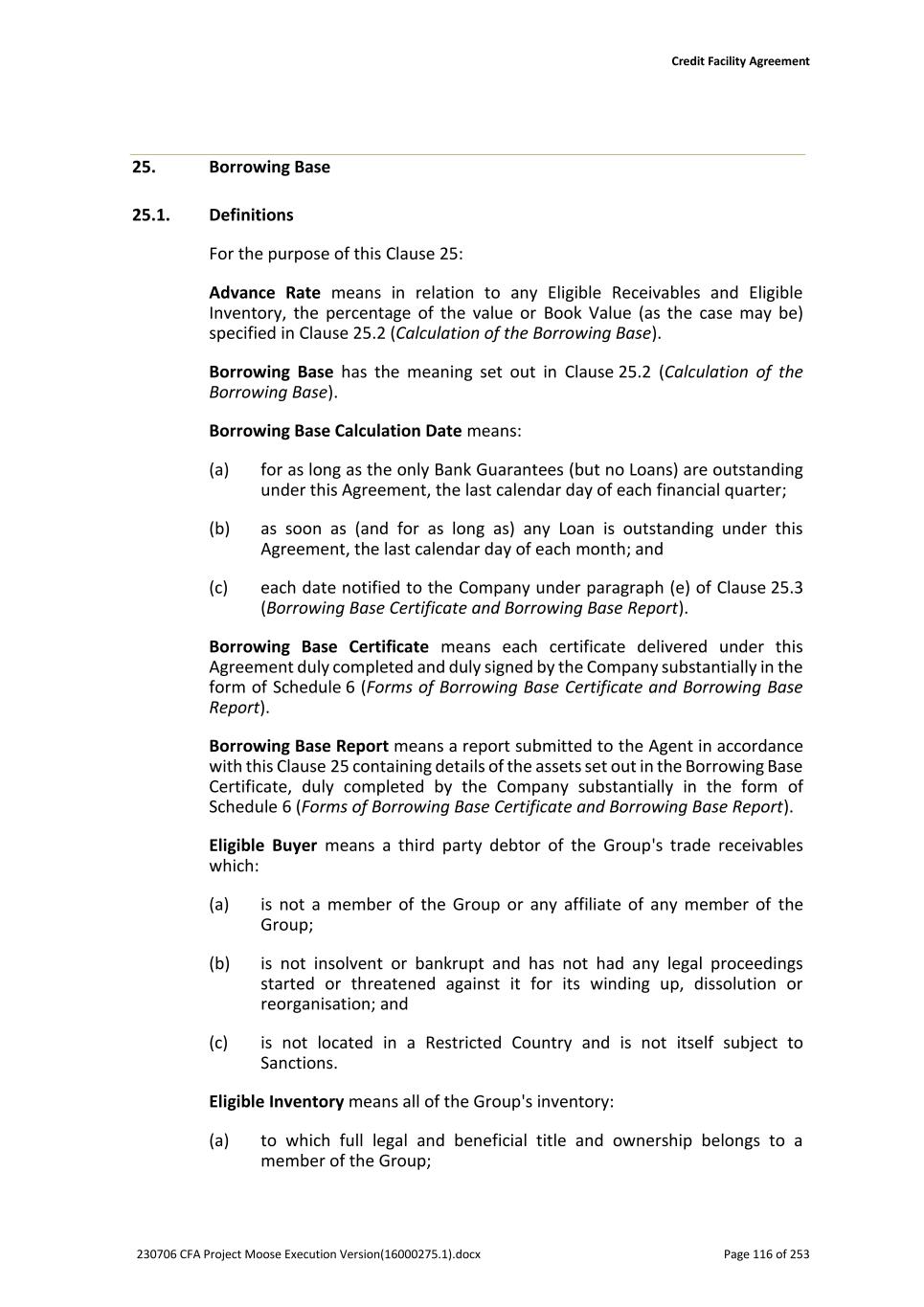
Credit Facility Agreement 230706 CFA Project Moose Execution Version(16000275.1).docx Page 116 of 253 25. Borrowing Base 25.1. Definitions For the purpose of this Clause 25: Advance Rate means in relation to any Eligible Receivables and Eligible Inventory, the percentage of the value or Book Value (as the case may be) specified in Clause 25.2 (Calculation of the Borrowing Base). Borrowing Base has the meaning set out in Clause 25.2 (Calculation of the Borrowing Base). Borrowing Base Calculation Date means: (a) for as long as the only Bank Guarantees (but no Loans) are outstanding under this Agreement, the last calendar day of each financial quarter; (b) as soon as (and for as long as) any Loan is outstanding under this Agreement, the last calendar day of each month; and (c) each date notified to the Company under paragraph (e) of Clause 25.3 (Borrowing Base Certificate and Borrowing Base Report). Borrowing Base Certificate means each certificate delivered under this Agreement duly completed and duly signed by the Company substantially in the form of Schedule 6 (Forms of Borrowing Base Certificate and Borrowing Base Report). Borrowing Base Report means a report submitted to the Agent in accordance with this Clause 25 containing details of the assets set out in the Borrowing Base Certificate, duly completed by the Company substantially in the form of Schedule 6 (Forms of Borrowing Base Certificate and Borrowing Base Report). Eligible Buyer means a third party debtor of the Group's trade receivables which: (a) is not a member of the Group or any affiliate of any member of the Group; (b) is not insolvent or bankrupt and has not had any legal proceedings started or threatened against it for its winding up, dissolution or reorganisation; and (c) is not located in a Restricted Country and is not itself subject to Sanctions. Eligible Inventory means all of the Group's inventory: (a) to which full legal and beneficial title and ownership belongs to a member of the Group;
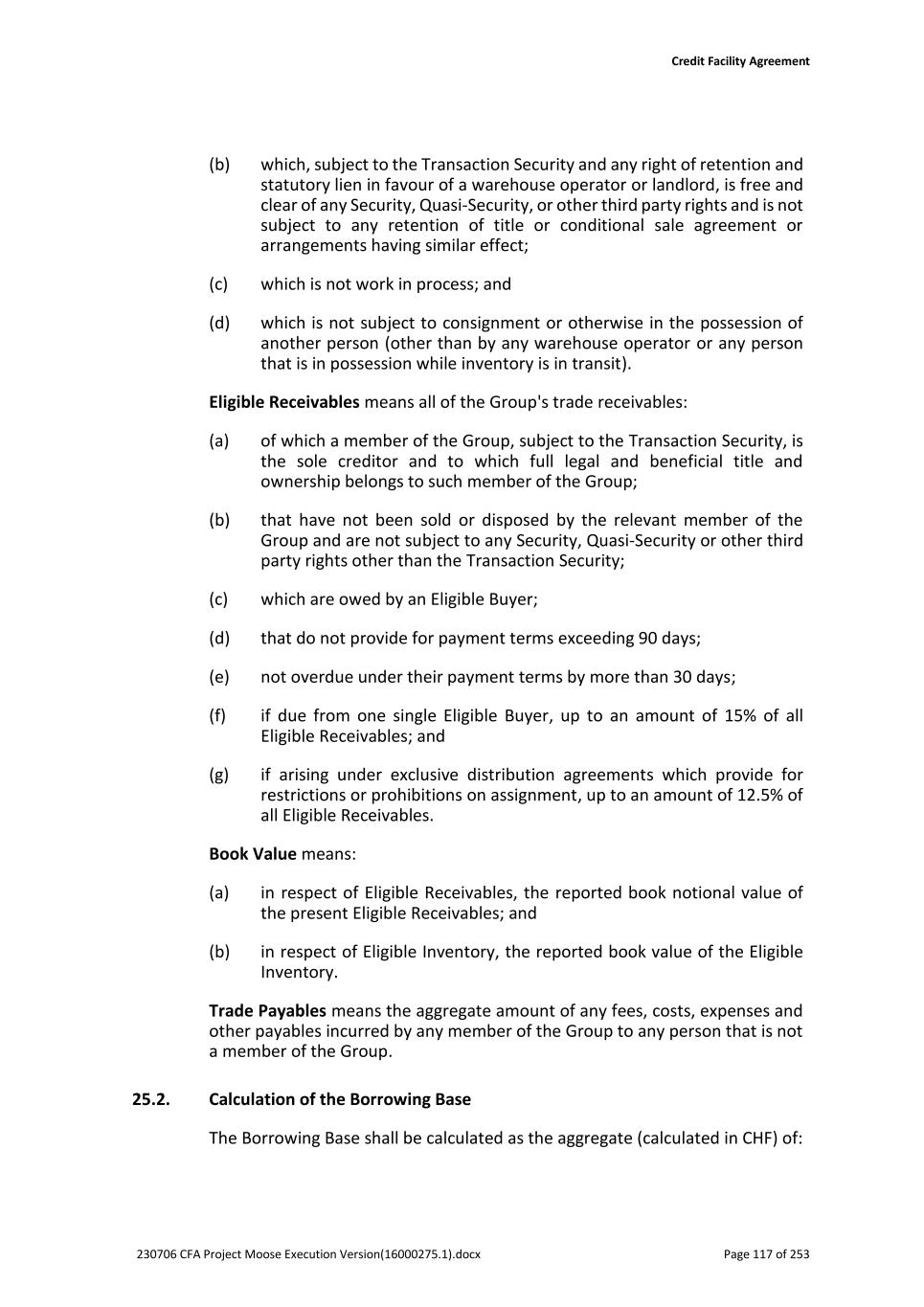
Credit Facility Agreement 230706 CFA Project Moose Execution Version(16000275.1).docx Page 117 of 253 (b) which, subject to the Transaction Security and any right of retention and statutory lien in favour of a warehouse operator or landlord, is free and clear of any Security, Quasi-Security, or other third party rights and is not subject to any retention of title or conditional sale agreement or arrangements having similar effect; (c) which is not work in process; and (d) which is not subject to consignment or otherwise in the possession of another person (other than by any warehouse operator or any person that is in possession while inventory is in transit). Eligible Receivables means all of the Group's trade receivables: (a) of which a member of the Group, subject to the Transaction Security, is the sole creditor and to which full legal and beneficial title and ownership belongs to such member of the Group; (b) that have not been sold or disposed by the relevant member of the Group and are not subject to any Security, Quasi-Security or other third party rights other than the Transaction Security; (c) which are owed by an Eligible Buyer; (d) that do not provide for payment terms exceeding 90 days; (e) not overdue under their payment terms by more than 30 days; (f) if due from one single Eligible Buyer, up to an amount of 15% of all Eligible Receivables; and (g) if arising under exclusive distribution agreements which provide for restrictions or prohibitions on assignment, up to an amount of 12.5% of all Eligible Receivables. Book Value means: (a) in respect of Eligible Receivables, the reported book notional value of the present Eligible Receivables; and (b) in respect of Eligible Inventory, the reported book value of the Eligible Inventory. Trade Payables means the aggregate amount of any fees, costs, expenses and other payables incurred by any member of the Group to any person that is not a member of the Group. 25.2. Calculation of the Borrowing Base The Borrowing Base shall be calculated as the aggregate (calculated in CHF) of:
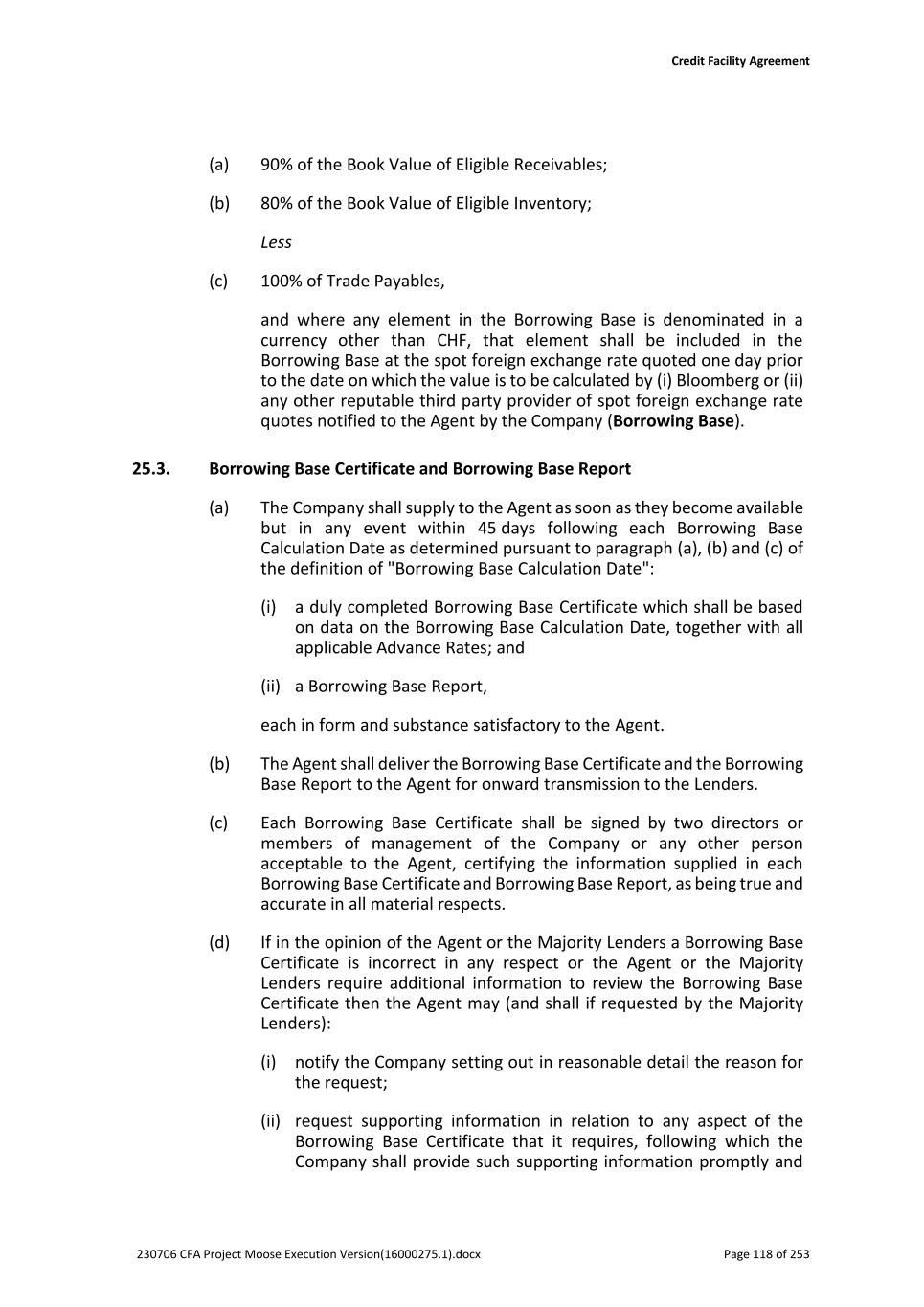
Credit Facility Agreement 230706 CFA Project Moose Execution Version(16000275.1).docx Page 118 of 253 (a) 90% of the Book Value of Eligible Receivables; (b) 80% of the Book Value of Eligible Inventory; Less (c) 100% of Trade Payables, and where any element in the Borrowing Base is denominated in a currency other than CHF, that element shall be included in the Borrowing Base at the spot foreign exchange rate quoted one day prior to the date on which the value is to be calculated by (i) Bloomberg or (ii) any other reputable third party provider of spot foreign exchange rate quotes notified to the Agent by the Company (Borrowing Base). 25.3. Borrowing Base Certificate and Borrowing Base Report (a) The Company shall supply to the Agent as soon as they become available but in any event within 45 days following each Borrowing Base Calculation Date as determined pursuant to paragraph (a), (b) and (c) of the definition of "Borrowing Base Calculation Date": (i) a duly completed Borrowing Base Certificate which shall be based on data on the Borrowing Base Calculation Date, together with all applicable Advance Rates; and (ii) a Borrowing Base Report, each in form and substance satisfactory to the Agent. (b) The Agent shall deliver the Borrowing Base Certificate and the Borrowing Base Report to the Agent for onward transmission to the Lenders. (c) Each Borrowing Base Certificate shall be signed by two directors or members of management of the Company or any other person acceptable to the Agent, certifying the information supplied in each Borrowing Base Certificate and Borrowing Base Report, as being true and accurate in all material respects. (d) If in the opinion of the Agent or the Majority Lenders a Borrowing Base Certificate is incorrect in any respect or the Agent or the Majority Lenders require additional information to review the Borrowing Base Certificate then the Agent may (and shall if requested by the Majority Lenders): (i) notify the Company setting out in reasonable detail the reason for the request; (ii) request supporting information in relation to any aspect of the Borrowing Base Certificate that it requires, following which the Company shall provide such supporting information promptly and
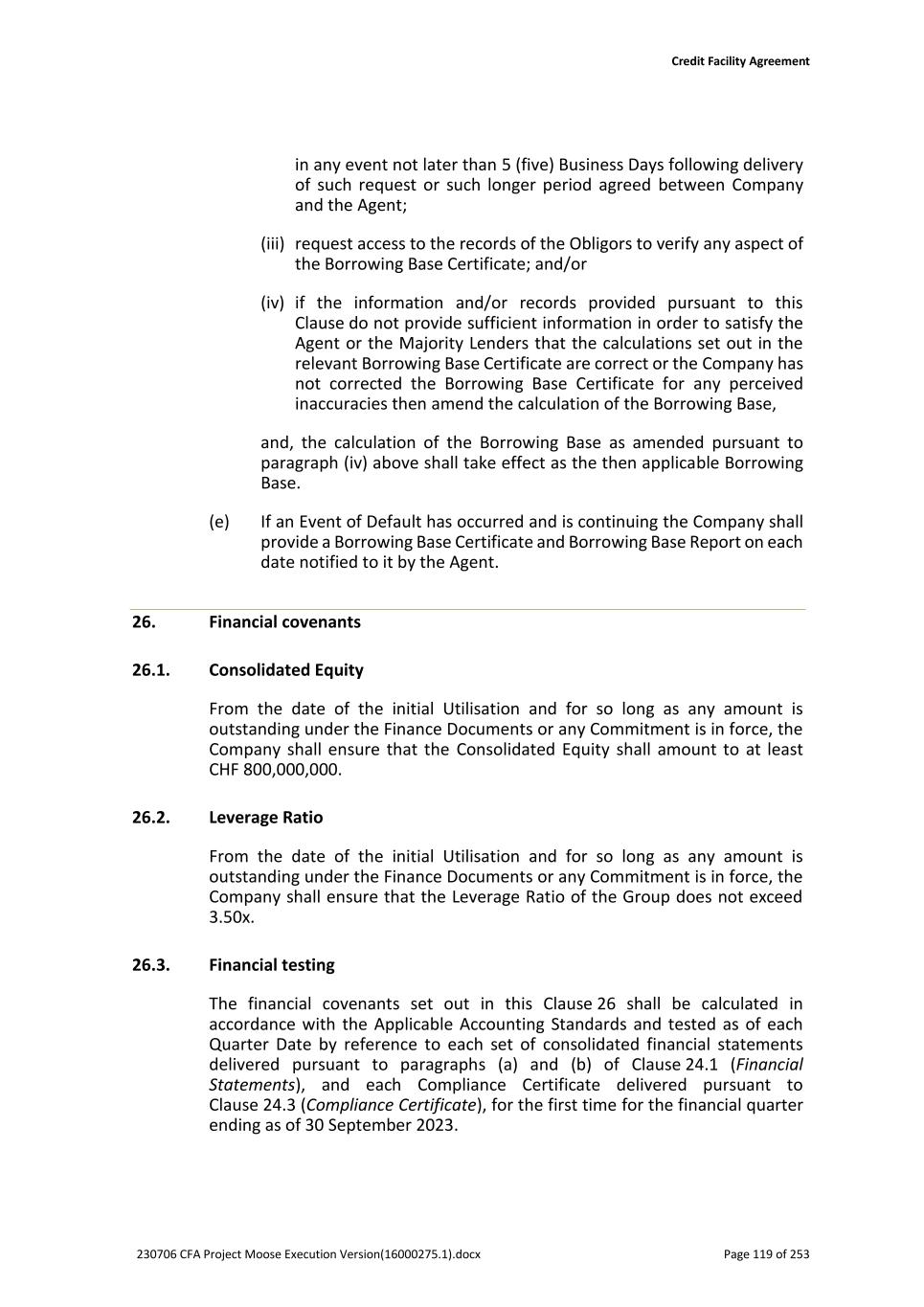
Credit Facility Agreement 230706 CFA Project Moose Execution Version(16000275.1).docx Page 119 of 253 in any event not later than 5 (five) Business Days following delivery of such request or such longer period agreed between Company and the Agent; (iii) request access to the records of the Obligors to verify any aspect of the Borrowing Base Certificate; and/or (iv) if the information and/or records provided pursuant to this Clause do not provide sufficient information in order to satisfy the Agent or the Majority Lenders that the calculations set out in the relevant Borrowing Base Certificate are correct or the Company has not corrected the Borrowing Base Certificate for any perceived inaccuracies then amend the calculation of the Borrowing Base, and, the calculation of the Borrowing Base as amended pursuant to paragraph (iv) above shall take effect as the then applicable Borrowing Base. (e) If an Event of Default has occurred and is continuing the Company shall provide a Borrowing Base Certificate and Borrowing Base Report on each date notified to it by the Agent. 26. Financial covenants 26.1. Consolidated Equity From the date of the initial Utilisation and for so long as any amount is outstanding under the Finance Documents or any Commitment is in force, the Company shall ensure that the Consolidated Equity shall amount to at least CHF 800,000,000. 26.2. Leverage Ratio From the date of the initial Utilisation and for so long as any amount is outstanding under the Finance Documents or any Commitment is in force, the Company shall ensure that the Leverage Ratio of the Group does not exceed 3.50x. 26.3. Financial testing The financial covenants set out in this Clause 26 shall be calculated in accordance with the Applicable Accounting Standards and tested as of each Quarter Date by reference to each set of consolidated financial statements delivered pursuant to paragraphs (a) and (b) of Clause 24.1 (Financial Statements), and each Compliance Certificate delivered pursuant to Clause 24.3 (Compliance Certificate), for the first time for the financial quarter ending as of 30 September 2023.
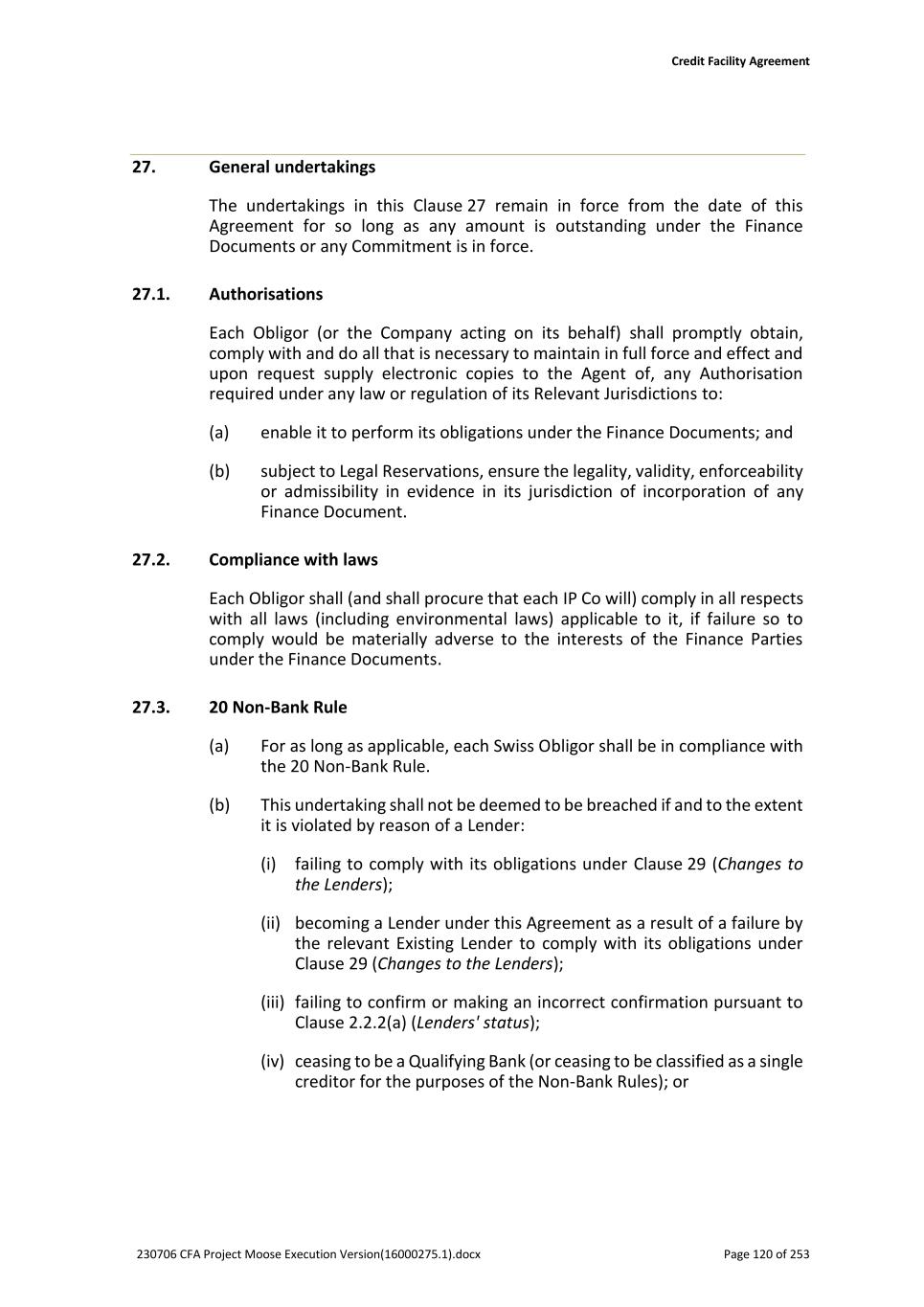
Credit Facility Agreement 230706 CFA Project Moose Execution Version(16000275.1).docx Page 120 of 253 27. General undertakings The undertakings in this Clause 27 remain in force from the date of this Agreement for so long as any amount is outstanding under the Finance Documents or any Commitment is in force. 27.1. Authorisations Each Obligor (or the Company acting on its behalf) shall promptly obtain, comply with and do all that is necessary to maintain in full force and effect and upon request supply electronic copies to the Agent of, any Authorisation required under any law or regulation of its Relevant Jurisdictions to: (a) enable it to perform its obligations under the Finance Documents; and (b) subject to Legal Reservations, ensure the legality, validity, enforceability or admissibility in evidence in its jurisdiction of incorporation of any Finance Document. 27.2. Compliance with laws Each Obligor shall (and shall procure that each IP Co will) comply in all respects with all laws (including environmental laws) applicable to it, if failure so to comply would be materially adverse to the interests of the Finance Parties under the Finance Documents. 27.3. 20 Non-Bank Rule (a) For as long as applicable, each Swiss Obligor shall be in compliance with the 20 Non-Bank Rule. (b) This undertaking shall not be deemed to be breached if and to the extent it is violated by reason of a Lender: (i) failing to comply with its obligations under Clause 29 (Changes to the Lenders); (ii) becoming a Lender under this Agreement as a result of a failure by the relevant Existing Lender to comply with its obligations under Clause 29 (Changes to the Lenders); (iii) failing to confirm or making an incorrect confirmation pursuant to Clause 2.2.2(a) (Lenders' status); (iv) ceasing to be a Qualifying Bank (or ceasing to be classified as a single creditor for the purposes of the Non-Bank Rules); or
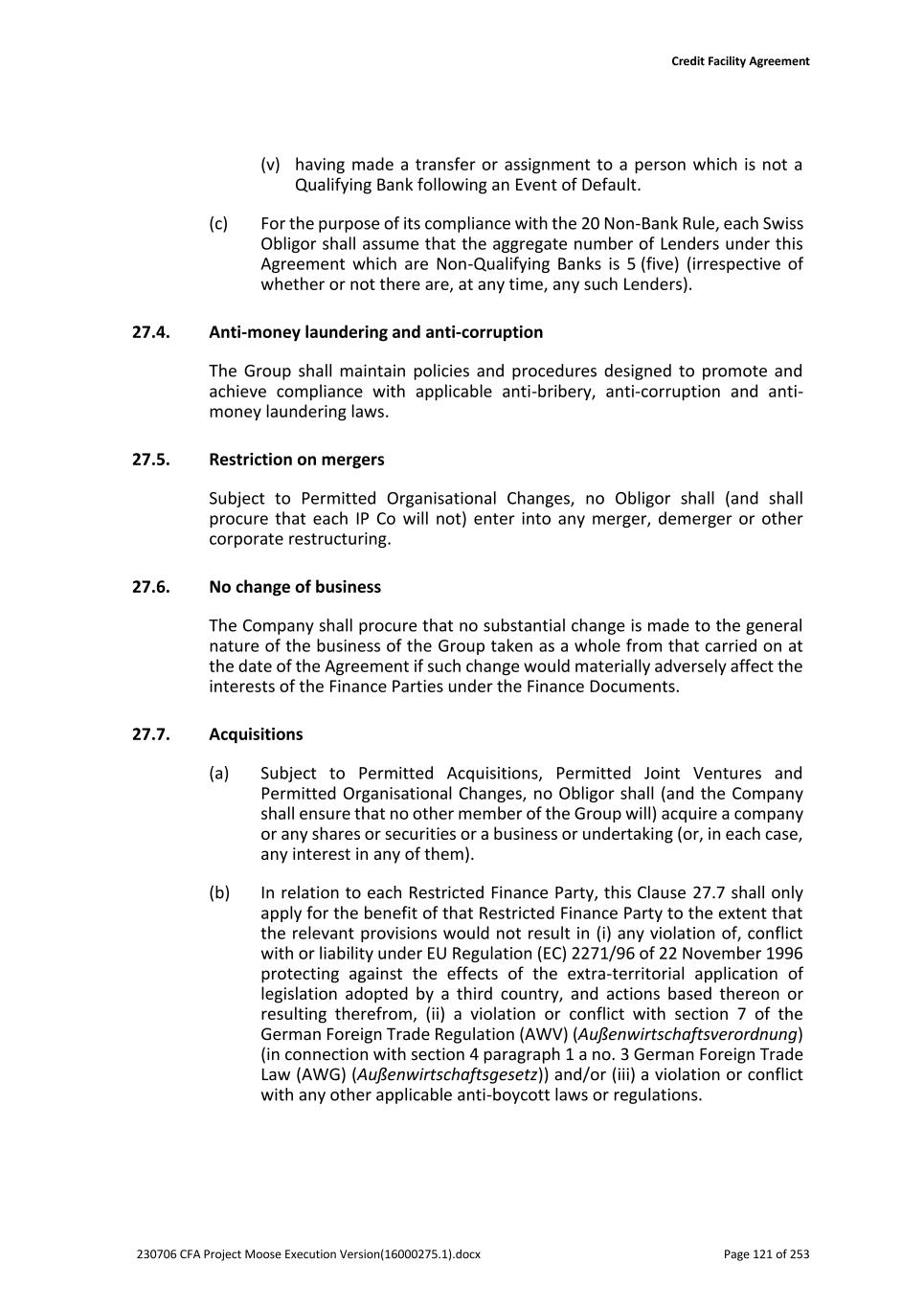
Credit Facility Agreement 230706 CFA Project Moose Execution Version(16000275.1).docx Page 121 of 253 (v) having made a transfer or assignment to a person which is not a Qualifying Bank following an Event of Default. (c) For the purpose of its compliance with the 20 Non-Bank Rule, each Swiss Obligor shall assume that the aggregate number of Lenders under this Agreement which are Non-Qualifying Banks is 5 (five) (irrespective of whether or not there are, at any time, any such Lenders). 27.4. Anti-money laundering and anti-corruption The Group shall maintain policies and procedures designed to promote and achieve compliance with applicable anti-bribery, anti-corruption and anti- money laundering laws. 27.5. Restriction on mergers Subject to Permitted Organisational Changes, no Obligor shall (and shall procure that each IP Co will not) enter into any merger, demerger or other corporate restructuring. 27.6. No change of business The Company shall procure that no substantial change is made to the general nature of the business of the Group taken as a whole from that carried on at the date of the Agreement if such change would materially adversely affect the interests of the Finance Parties under the Finance Documents. 27.7. Acquisitions (a) Subject to Permitted Acquisitions, Permitted Joint Ventures and Permitted Organisational Changes, no Obligor shall (and the Company shall ensure that no other member of the Group will) acquire a company or any shares or securities or a business or undertaking (or, in each case, any interest in any of them). (b) In relation to each Restricted Finance Party, this Clause 27.7 shall only apply for the benefit of that Restricted Finance Party to the extent that the relevant provisions would not result in (i) any violation of, conflict with or liability under EU Regulation (EC) 2271/96 of 22 November 1996 protecting against the effects of the extra-territorial application of legislation adopted by a third country, and actions based thereon or resulting therefrom, (ii) a violation or conflict with section 7 of the German Foreign Trade Regulation (AWV) (Außenwirtschaftsverordnung) (in connection with section 4 paragraph 1 a no. 3 German Foreign Trade Law (AWG) (Außenwirtschaftsgesetz)) and/or (iii) a violation or conflict with any other applicable anti-boycott laws or regulations.
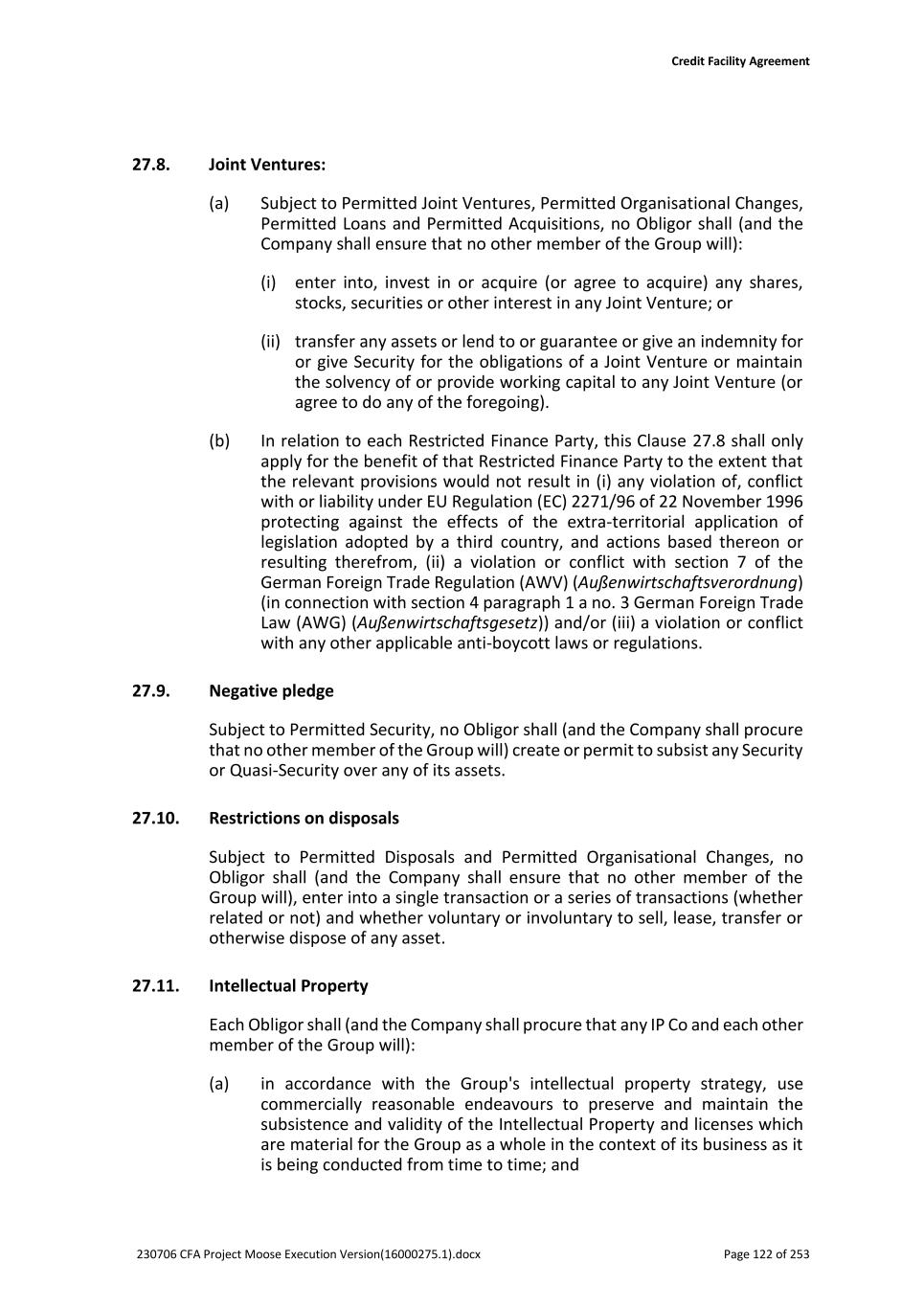
Credit Facility Agreement 230706 CFA Project Moose Execution Version(16000275.1).docx Page 122 of 253 27.8. Joint Ventures: (a) Subject to Permitted Joint Ventures, Permitted Organisational Changes, Permitted Loans and Permitted Acquisitions, no Obligor shall (and the Company shall ensure that no other member of the Group will): (i) enter into, invest in or acquire (or agree to acquire) any shares, stocks, securities or other interest in any Joint Venture; or (ii) transfer any assets or lend to or guarantee or give an indemnity for or give Security for the obligations of a Joint Venture or maintain the solvency of or provide working capital to any Joint Venture (or agree to do any of the foregoing). (b) In relation to each Restricted Finance Party, this Clause 27.8 shall only apply for the benefit of that Restricted Finance Party to the extent that the relevant provisions would not result in (i) any violation of, conflict with or liability under EU Regulation (EC) 2271/96 of 22 November 1996 protecting against the effects of the extra-territorial application of legislation adopted by a third country, and actions based thereon or resulting therefrom, (ii) a violation or conflict with section 7 of the German Foreign Trade Regulation (AWV) (Außenwirtschaftsverordnung) (in connection with section 4 paragraph 1 a no. 3 German Foreign Trade Law (AWG) (Außenwirtschaftsgesetz)) and/or (iii) a violation or conflict with any other applicable anti-boycott laws or regulations. 27.9. Negative pledge Subject to Permitted Security, no Obligor shall (and the Company shall procure that no other member of the Group will) create or permit to subsist any Security or Quasi-Security over any of its assets. 27.10. Restrictions on disposals Subject to Permitted Disposals and Permitted Organisational Changes, no Obligor shall (and the Company shall ensure that no other member of the Group will), enter into a single transaction or a series of transactions (whether related or not) and whether voluntary or involuntary to sell, lease, transfer or otherwise dispose of any asset. 27.11. Intellectual Property Each Obligor shall (and the Company shall procure that any IP Co and each other member of the Group will): (a) in accordance with the Group's intellectual property strategy, use commercially reasonable endeavours to preserve and maintain the subsistence and validity of the Intellectual Property and licenses which are material for the Group as a whole in the context of its business as it is being conducted from time to time; and
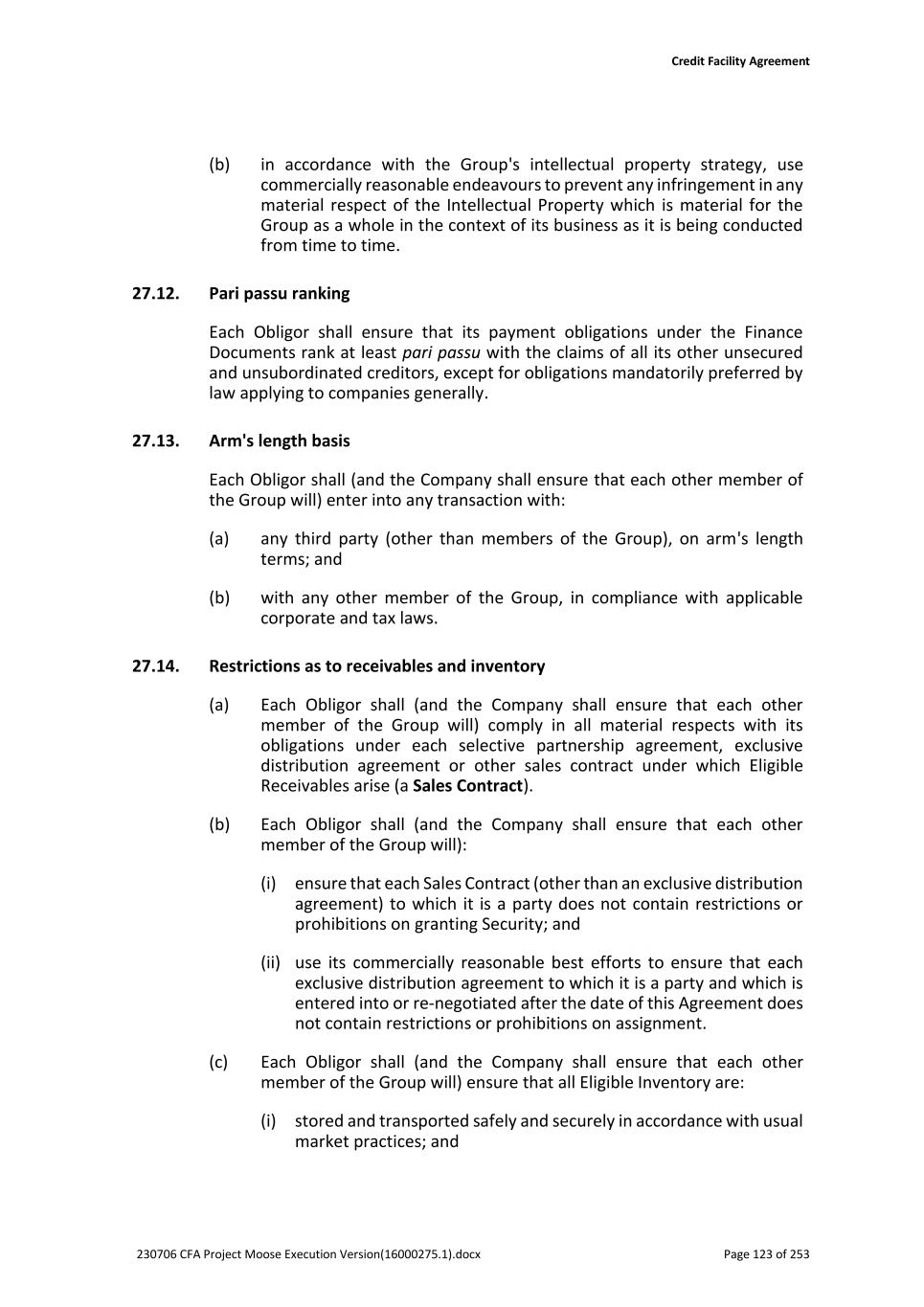
Credit Facility Agreement 230706 CFA Project Moose Execution Version(16000275.1).docx Page 123 of 253 (b) in accordance with the Group's intellectual property strategy, use commercially reasonable endeavours to prevent any infringement in any material respect of the Intellectual Property which is material for the Group as a whole in the context of its business as it is being conducted from time to time. 27.12. Pari passu ranking Each Obligor shall ensure that its payment obligations under the Finance Documents rank at least pari passu with the claims of all its other unsecured and unsubordinated creditors, except for obligations mandatorily preferred by law applying to companies generally. 27.13. Arm's length basis Each Obligor shall (and the Company shall ensure that each other member of the Group will) enter into any transaction with: (a) any third party (other than members of the Group), on arm's length terms; and (b) with any other member of the Group, in compliance with applicable corporate and tax laws. 27.14. Restrictions as to receivables and inventory (a) Each Obligor shall (and the Company shall ensure that each other member of the Group will) comply in all material respects with its obligations under each selective partnership agreement, exclusive distribution agreement or other sales contract under which Eligible Receivables arise (a Sales Contract). (b) Each Obligor shall (and the Company shall ensure that each other member of the Group will): (i) ensure that each Sales Contract (other than an exclusive distribution agreement) to which it is a party does not contain restrictions or prohibitions on granting Security; and (ii) use its commercially reasonable best efforts to ensure that each exclusive distribution agreement to which it is a party and which is entered into or re-negotiated after the date of this Agreement does not contain restrictions or prohibitions on assignment. (c) Each Obligor shall (and the Company shall ensure that each other member of the Group will) ensure that all Eligible Inventory are: (i) stored and transported safely and securely in accordance with usual market practices; and
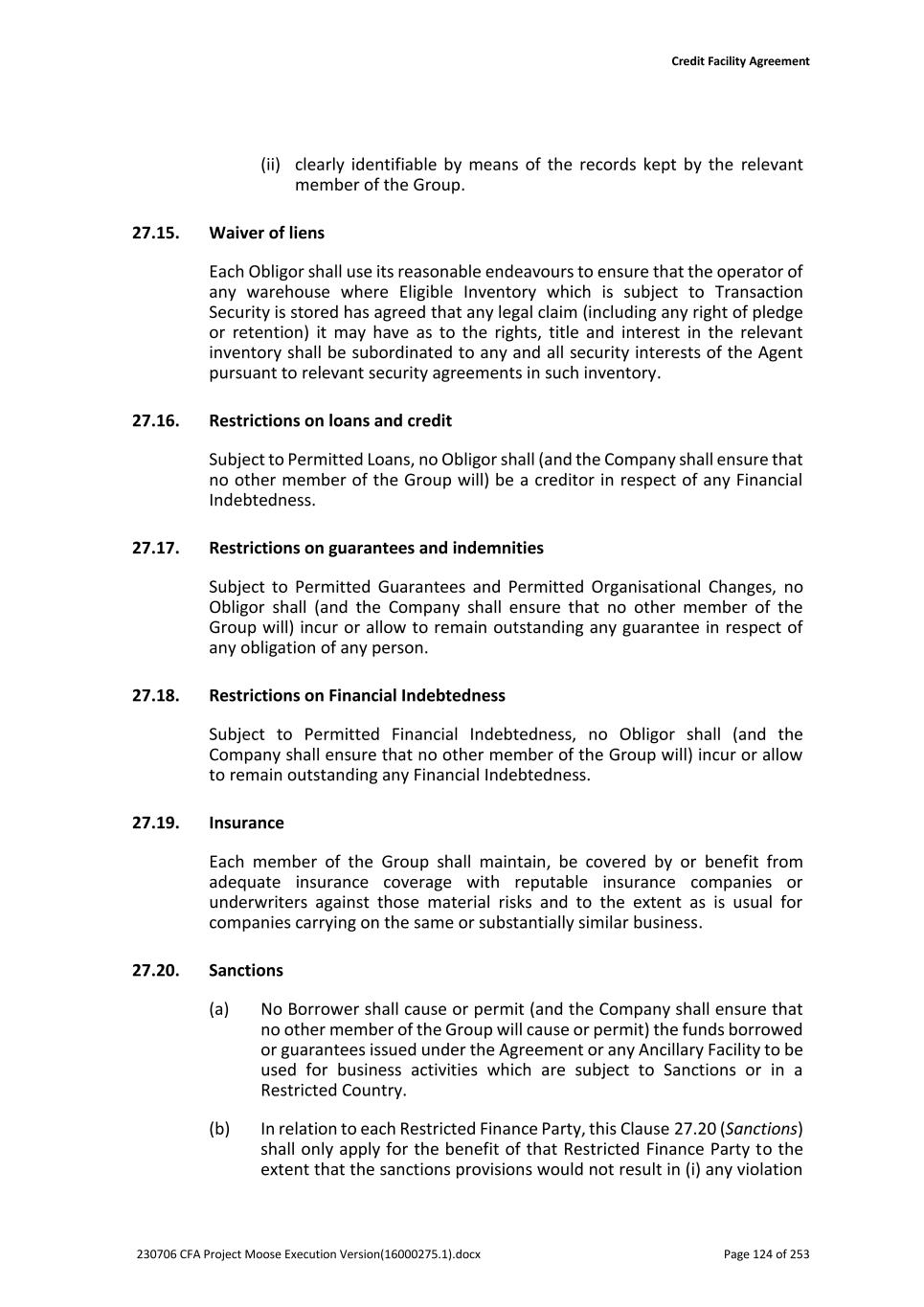
Credit Facility Agreement 230706 CFA Project Moose Execution Version(16000275.1).docx Page 124 of 253 (ii) clearly identifiable by means of the records kept by the relevant member of the Group. 27.15. Waiver of liens Each Obligor shall use its reasonable endeavours to ensure that the operator of any warehouse where Eligible Inventory which is subject to Transaction Security is stored has agreed that any legal claim (including any right of pledge or retention) it may have as to the rights, title and interest in the relevant inventory shall be subordinated to any and all security interests of the Agent pursuant to relevant security agreements in such inventory. 27.16. Restrictions on loans and credit Subject to Permitted Loans, no Obligor shall (and the Company shall ensure that no other member of the Group will) be a creditor in respect of any Financial Indebtedness. 27.17. Restrictions on guarantees and indemnities Subject to Permitted Guarantees and Permitted Organisational Changes, no Obligor shall (and the Company shall ensure that no other member of the Group will) incur or allow to remain outstanding any guarantee in respect of any obligation of any person. 27.18. Restrictions on Financial Indebtedness Subject to Permitted Financial Indebtedness, no Obligor shall (and the Company shall ensure that no other member of the Group will) incur or allow to remain outstanding any Financial Indebtedness. 27.19. Insurance Each member of the Group shall maintain, be covered by or benefit from adequate insurance coverage with reputable insurance companies or underwriters against those material risks and to the extent as is usual for companies carrying on the same or substantially similar business. 27.20. Sanctions (a) No Borrower shall cause or permit (and the Company shall ensure that no other member of the Group will cause or permit) the funds borrowed or guarantees issued under the Agreement or any Ancillary Facility to be used for business activities which are subject to Sanctions or in a Restricted Country. (b) In relation to each Restricted Finance Party, this Clause 27.20 (Sanctions) shall only apply for the benefit of that Restricted Finance Party to the extent that the sanctions provisions would not result in (i) any violation
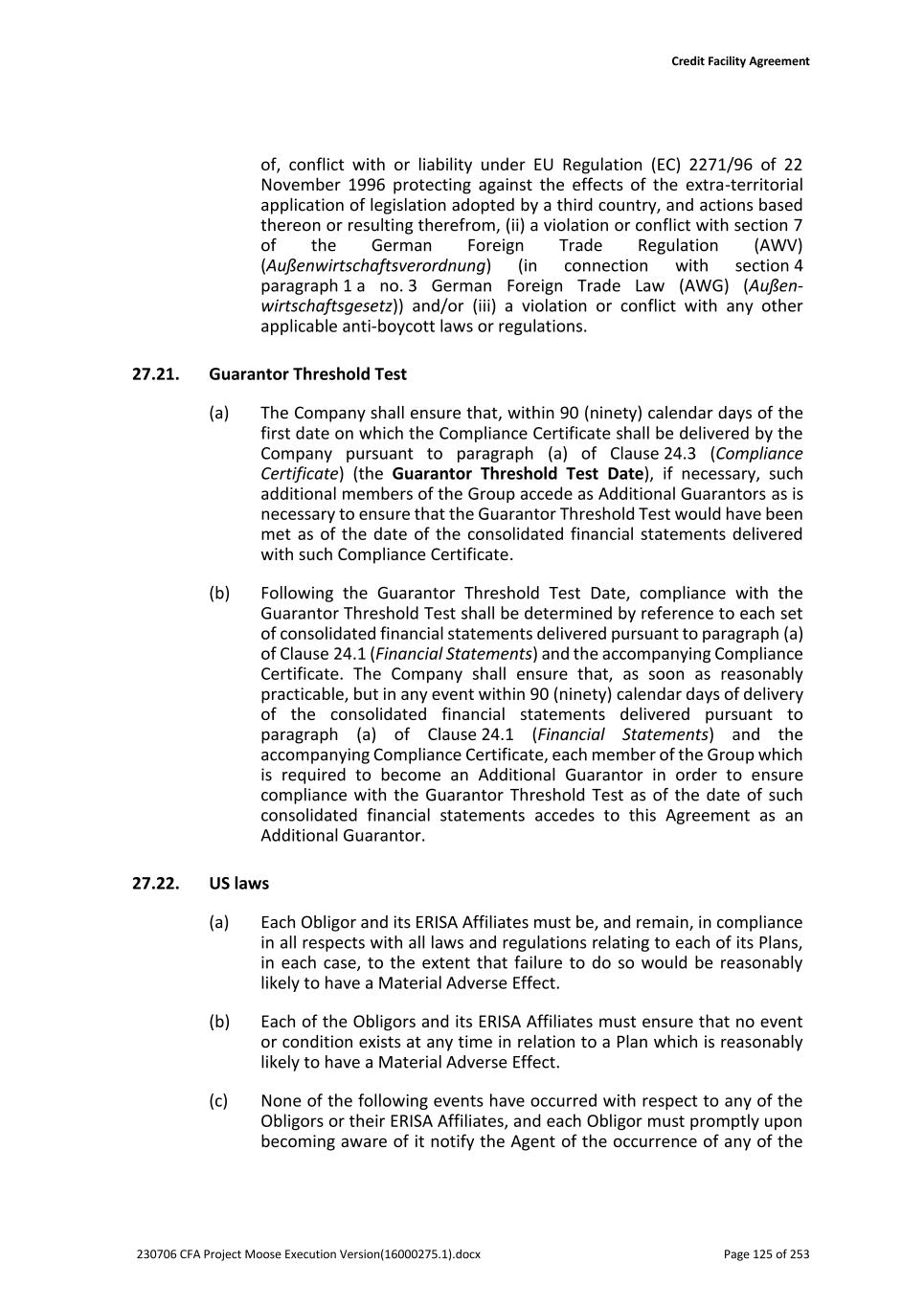
Credit Facility Agreement 230706 CFA Project Moose Execution Version(16000275.1).docx Page 125 of 253 of, conflict with or liability under EU Regulation (EC) 2271/96 of 22 November 1996 protecting against the effects of the extra-territorial application of legislation adopted by a third country, and actions based thereon or resulting therefrom, (ii) a violation or conflict with section 7 of the German Foreign Trade Regulation (AWV) (Außenwirtschaftsverordnung) (in connection with section 4 paragraph 1 a no. 3 German Foreign Trade Law (AWG) (Außen- wirtschaftsgesetz)) and/or (iii) a violation or conflict with any other applicable anti-boycott laws or regulations. 27.21. Guarantor Threshold Test (a) The Company shall ensure that, within 90 (ninety) calendar days of the first date on which the Compliance Certificate shall be delivered by the Company pursuant to paragraph (a) of Clause 24.3 (Compliance Certificate) (the Guarantor Threshold Test Date), if necessary, such additional members of the Group accede as Additional Guarantors as is necessary to ensure that the Guarantor Threshold Test would have been met as of the date of the consolidated financial statements delivered with such Compliance Certificate. (b) Following the Guarantor Threshold Test Date, compliance with the Guarantor Threshold Test shall be determined by reference to each set of consolidated financial statements delivered pursuant to paragraph (a) of Clause 24.1 (Financial Statements) and the accompanying Compliance Certificate. The Company shall ensure that, as soon as reasonably practicable, but in any event within 90 (ninety) calendar days of delivery of the consolidated financial statements delivered pursuant to paragraph (a) of Clause 24.1 (Financial Statements) and the accompanying Compliance Certificate, each member of the Group which is required to become an Additional Guarantor in order to ensure compliance with the Guarantor Threshold Test as of the date of such consolidated financial statements accedes to this Agreement as an Additional Guarantor. 27.22. US laws (a) Each Obligor and its ERISA Affiliates must be, and remain, in compliance in all respects with all laws and regulations relating to each of its Plans, in each case, to the extent that failure to do so would be reasonably likely to have a Material Adverse Effect. (b) Each of the Obligors and its ERISA Affiliates must ensure that no event or condition exists at any time in relation to a Plan which is reasonably likely to have a Material Adverse Effect. (c) None of the following events have occurred with respect to any of the Obligors or their ERISA Affiliates, and each Obligor must promptly upon becoming aware of it notify the Agent of the occurrence of any of the
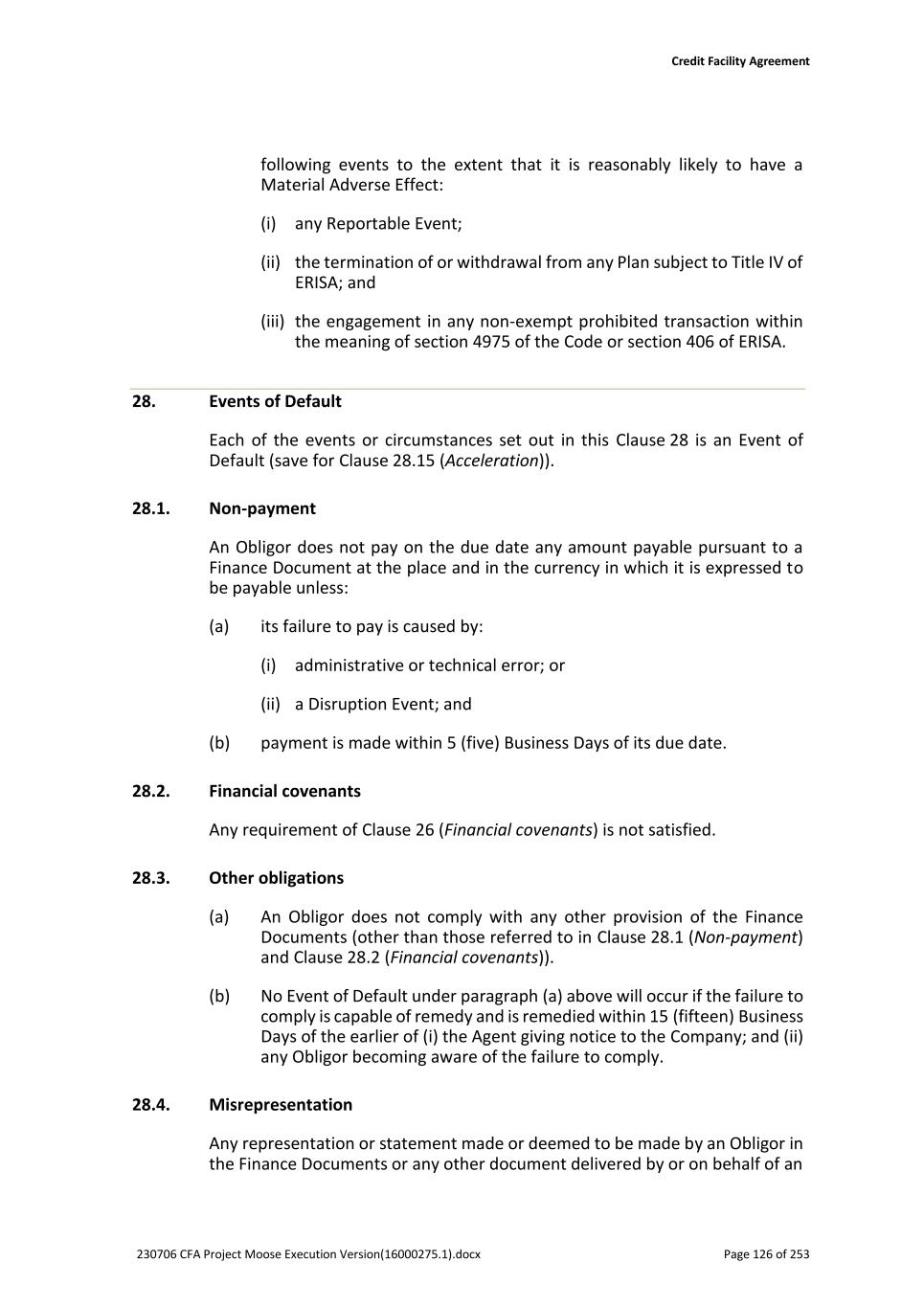
Credit Facility Agreement 230706 CFA Project Moose Execution Version(16000275.1).docx Page 126 of 253 following events to the extent that it is reasonably likely to have a Material Adverse Effect: (i) any Reportable Event; (ii) the termination of or withdrawal from any Plan subject to Title IV of ERISA; and (iii) the engagement in any non-exempt prohibited transaction within the meaning of section 4975 of the Code or section 406 of ERISA. 28. Events of Default Each of the events or circumstances set out in this Clause 28 is an Event of Default (save for Clause 28.15 (Acceleration)). 28.1. Non-payment An Obligor does not pay on the due date any amount payable pursuant to a Finance Document at the place and in the currency in which it is expressed to be payable unless: (a) its failure to pay is caused by: (i) administrative or technical error; or (ii) a Disruption Event; and (b) payment is made within 5 (five) Business Days of its due date. 28.2. Financial covenants Any requirement of Clause 26 (Financial covenants) is not satisfied. 28.3. Other obligations (a) An Obligor does not comply with any other provision of the Finance Documents (other than those referred to in Clause 28.1 (Non-payment) and Clause 28.2 (Financial covenants)). (b) No Event of Default under paragraph (a) above will occur if the failure to comply is capable of remedy and is remedied within 15 (fifteen) Business Days of the earlier of (i) the Agent giving notice to the Company; and (ii) any Obligor becoming aware of the failure to comply. 28.4. Misrepresentation Any representation or statement made or deemed to be made by an Obligor in the Finance Documents or any other document delivered by or on behalf of an
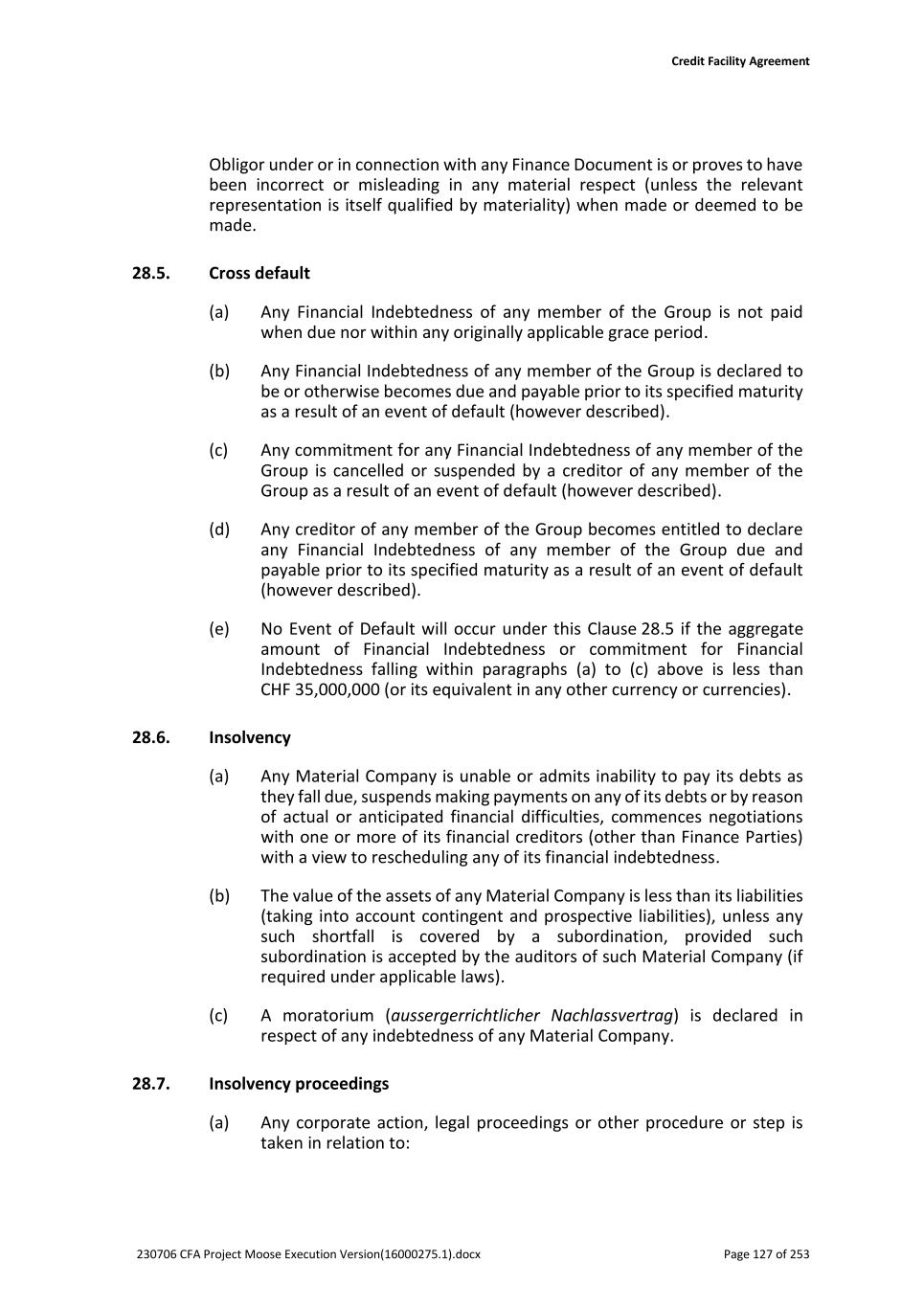
Credit Facility Agreement 230706 CFA Project Moose Execution Version(16000275.1).docx Page 127 of 253 Obligor under or in connection with any Finance Document is or proves to have been incorrect or misleading in any material respect (unless the relevant representation is itself qualified by materiality) when made or deemed to be made. 28.5. Cross default (a) Any Financial Indebtedness of any member of the Group is not paid when due nor within any originally applicable grace period. (b) Any Financial Indebtedness of any member of the Group is declared to be or otherwise becomes due and payable prior to its specified maturity as a result of an event of default (however described). (c) Any commitment for any Financial Indebtedness of any member of the Group is cancelled or suspended by a creditor of any member of the Group as a result of an event of default (however described). (d) Any creditor of any member of the Group becomes entitled to declare any Financial Indebtedness of any member of the Group due and payable prior to its specified maturity as a result of an event of default (however described). (e) No Event of Default will occur under this Clause 28.5 if the aggregate amount of Financial Indebtedness or commitment for Financial Indebtedness falling within paragraphs (a) to (c) above is less than CHF 35,000,000 (or its equivalent in any other currency or currencies). 28.6. Insolvency (a) Any Material Company is unable or admits inability to pay its debts as they fall due, suspends making payments on any of its debts or by reason of actual or anticipated financial difficulties, commences negotiations with one or more of its financial creditors (other than Finance Parties) with a view to rescheduling any of its financial indebtedness. (b) The value of the assets of any Material Company is less than its liabilities (taking into account contingent and prospective liabilities), unless any such shortfall is covered by a subordination, provided such subordination is accepted by the auditors of such Material Company (if required under applicable laws). (c) A moratorium (aussergerrichtlicher Nachlassvertrag) is declared in respect of any indebtedness of any Material Company. 28.7. Insolvency proceedings (a) Any corporate action, legal proceedings or other procedure or step is taken in relation to:
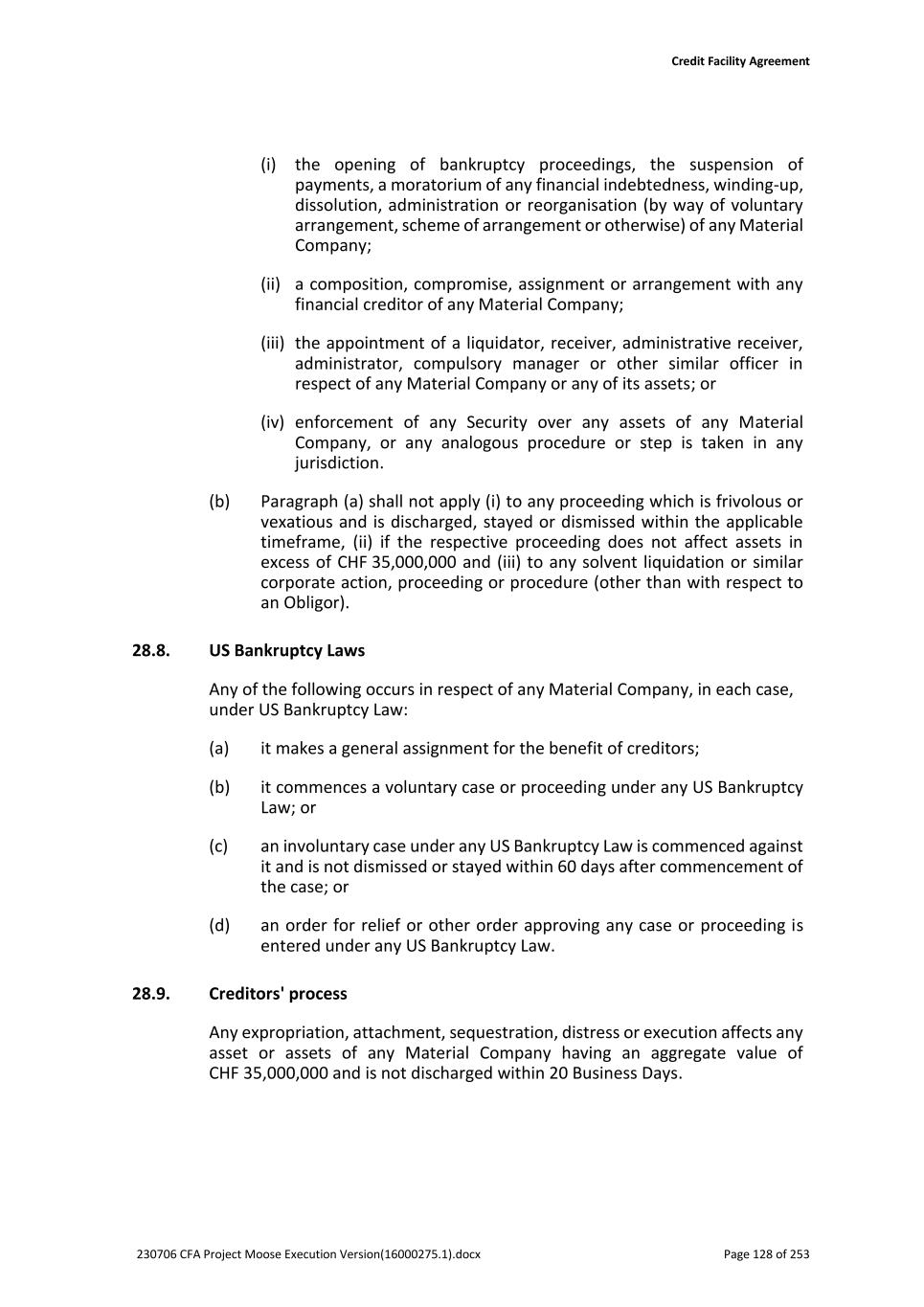
Credit Facility Agreement 230706 CFA Project Moose Execution Version(16000275.1).docx Page 128 of 253 (i) the opening of bankruptcy proceedings, the suspension of payments, a moratorium of any financial indebtedness, winding-up, dissolution, administration or reorganisation (by way of voluntary arrangement, scheme of arrangement or otherwise) of any Material Company; (ii) a composition, compromise, assignment or arrangement with any financial creditor of any Material Company; (iii) the appointment of a liquidator, receiver, administrative receiver, administrator, compulsory manager or other similar officer in respect of any Material Company or any of its assets; or (iv) enforcement of any Security over any assets of any Material Company, or any analogous procedure or step is taken in any jurisdiction. (b) Paragraph (a) shall not apply (i) to any proceeding which is frivolous or vexatious and is discharged, stayed or dismissed within the applicable timeframe, (ii) if the respective proceeding does not affect assets in excess of CHF 35,000,000 and (iii) to any solvent liquidation or similar corporate action, proceeding or procedure (other than with respect to an Obligor). 28.8. US Bankruptcy Laws Any of the following occurs in respect of any Material Company, in each case, under US Bankruptcy Law: (a) it makes a general assignment for the benefit of creditors; (b) it commences a voluntary case or proceeding under any US Bankruptcy Law; or (c) an involuntary case under any US Bankruptcy Law is commenced against it and is not dismissed or stayed within 60 days after commencement of the case; or (d) an order for relief or other order approving any case or proceeding is entered under any US Bankruptcy Law. 28.9. Creditors' process Any expropriation, attachment, sequestration, distress or execution affects any asset or assets of any Material Company having an aggregate value of CHF 35,000,000 and is not discharged within 20 Business Days.
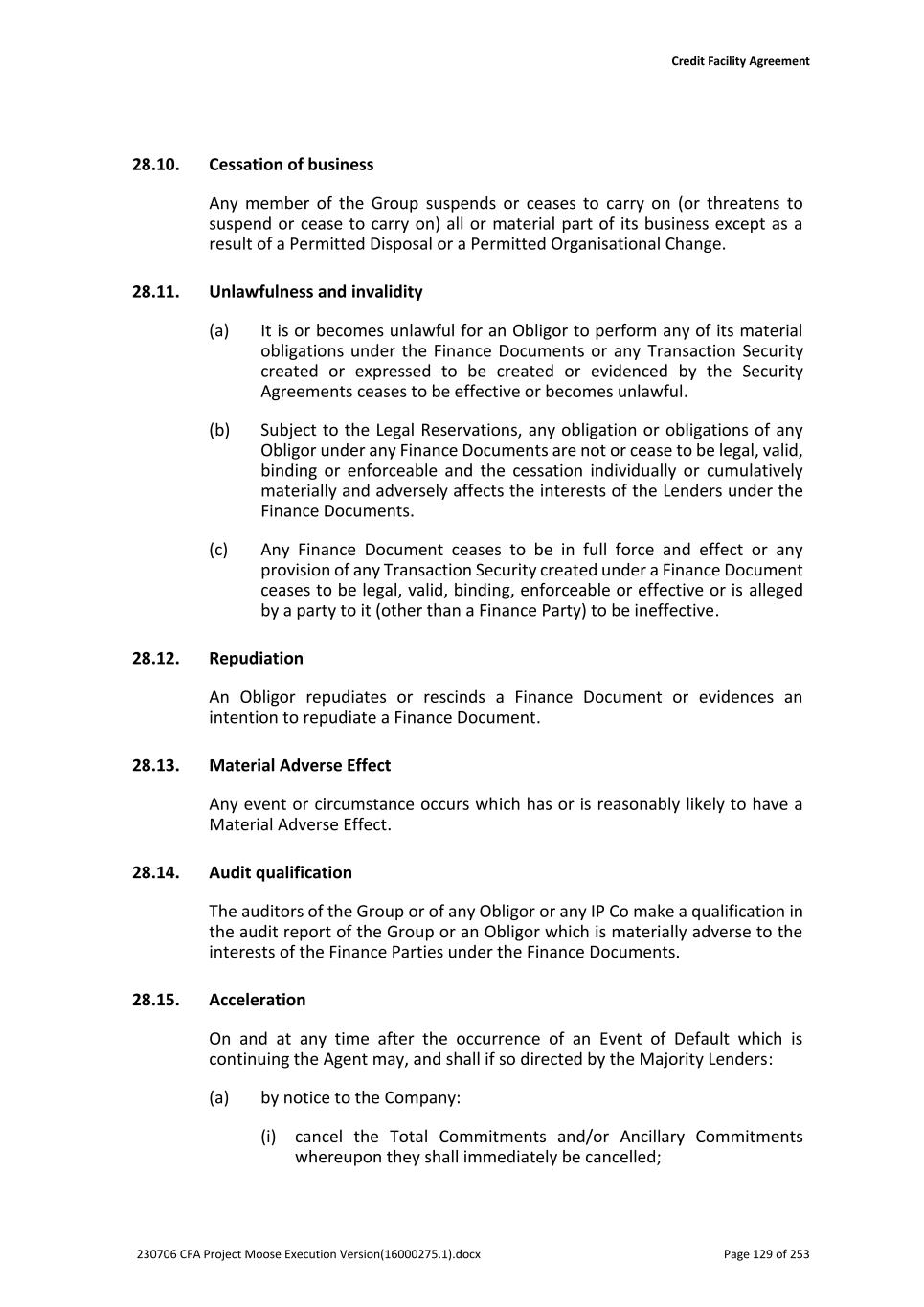
Credit Facility Agreement 230706 CFA Project Moose Execution Version(16000275.1).docx Page 129 of 253 28.10. Cessation of business Any member of the Group suspends or ceases to carry on (or threatens to suspend or cease to carry on) all or material part of its business except as a result of a Permitted Disposal or a Permitted Organisational Change. 28.11. Unlawfulness and invalidity (a) It is or becomes unlawful for an Obligor to perform any of its material obligations under the Finance Documents or any Transaction Security created or expressed to be created or evidenced by the Security Agreements ceases to be effective or becomes unlawful. (b) Subject to the Legal Reservations, any obligation or obligations of any Obligor under any Finance Documents are not or cease to be legal, valid, binding or enforceable and the cessation individually or cumulatively materially and adversely affects the interests of the Lenders under the Finance Documents. (c) Any Finance Document ceases to be in full force and effect or any provision of any Transaction Security created under a Finance Document ceases to be legal, valid, binding, enforceable or effective or is alleged by a party to it (other than a Finance Party) to be ineffective. 28.12. Repudiation An Obligor repudiates or rescinds a Finance Document or evidences an intention to repudiate a Finance Document. 28.13. Material Adverse Effect Any event or circumstance occurs which has or is reasonably likely to have a Material Adverse Effect. 28.14. Audit qualification The auditors of the Group or of any Obligor or any IP Co make a qualification in the audit report of the Group or an Obligor which is materially adverse to the interests of the Finance Parties under the Finance Documents. 28.15. Acceleration On and at any time after the occurrence of an Event of Default which is continuing the Agent may, and shall if so directed by the Majority Lenders: (a) by notice to the Company: (i) cancel the Total Commitments and/or Ancillary Commitments whereupon they shall immediately be cancelled;
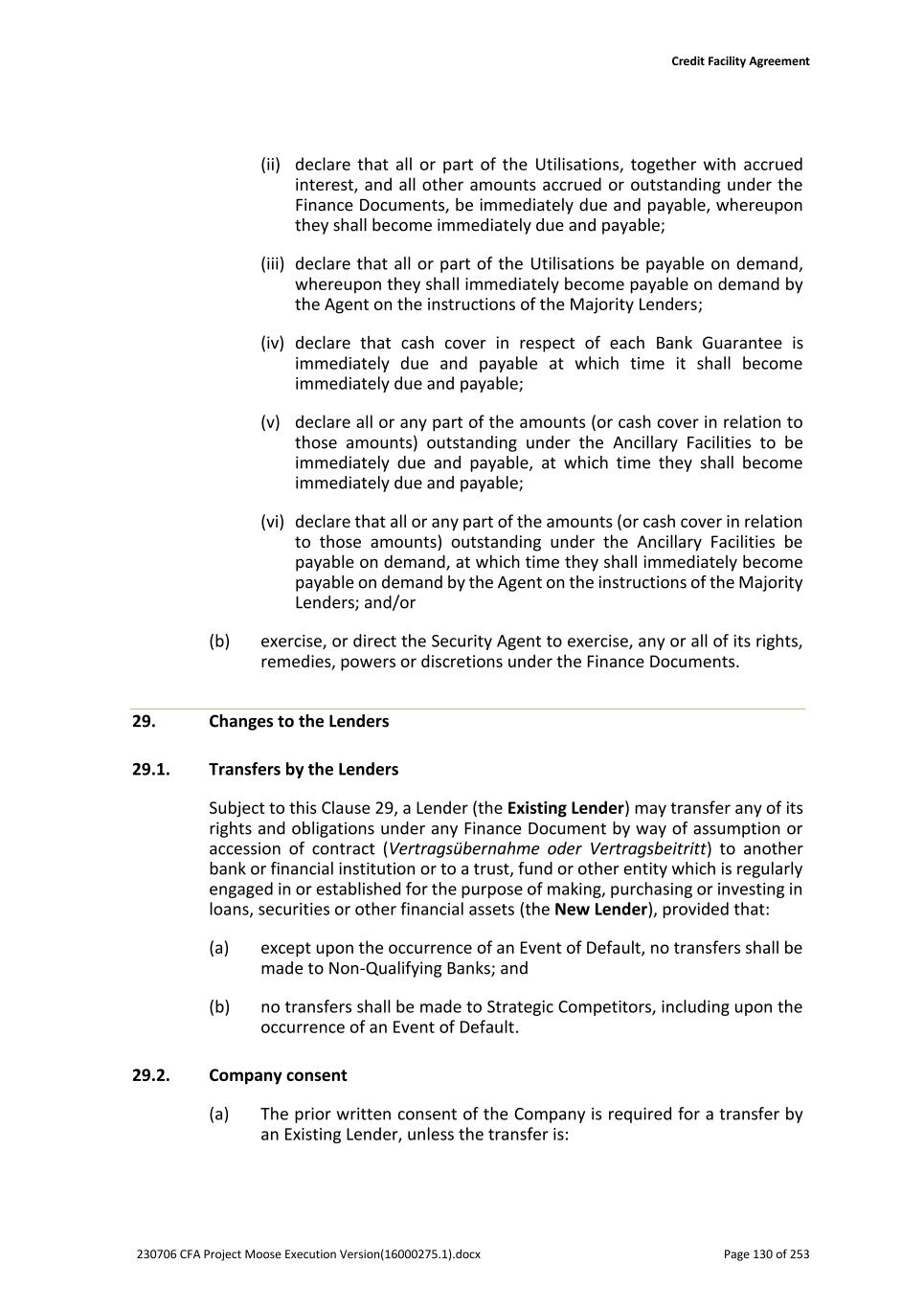
Credit Facility Agreement 230706 CFA Project Moose Execution Version(16000275.1).docx Page 130 of 253 (ii) declare that all or part of the Utilisations, together with accrued interest, and all other amounts accrued or outstanding under the Finance Documents, be immediately due and payable, whereupon they shall become immediately due and payable; (iii) declare that all or part of the Utilisations be payable on demand, whereupon they shall immediately become payable on demand by the Agent on the instructions of the Majority Lenders; (iv) declare that cash cover in respect of each Bank Guarantee is immediately due and payable at which time it shall become immediately due and payable; (v) declare all or any part of the amounts (or cash cover in relation to those amounts) outstanding under the Ancillary Facilities to be immediately due and payable, at which time they shall become immediately due and payable; (vi) declare that all or any part of the amounts (or cash cover in relation to those amounts) outstanding under the Ancillary Facilities be payable on demand, at which time they shall immediately become payable on demand by the Agent on the instructions of the Majority Lenders; and/or (b) exercise, or direct the Security Agent to exercise, any or all of its rights, remedies, powers or discretions under the Finance Documents. 29. Changes to the Lenders 29.1. Transfers by the Lenders Subject to this Clause 29, a Lender (the Existing Lender) may transfer any of its rights and obligations under any Finance Document by way of assumption or accession of contract (Vertragsübernahme oder Vertragsbeitritt) to another bank or financial institution or to a trust, fund or other entity which is regularly engaged in or established for the purpose of making, purchasing or investing in loans, securities or other financial assets (the New Lender), provided that: (a) except upon the occurrence of an Event of Default, no transfers shall be made to Non-Qualifying Banks; and (b) no transfers shall be made to Strategic Competitors, including upon the occurrence of an Event of Default. 29.2. Company consent (a) The prior written consent of the Company is required for a transfer by an Existing Lender, unless the transfer is:
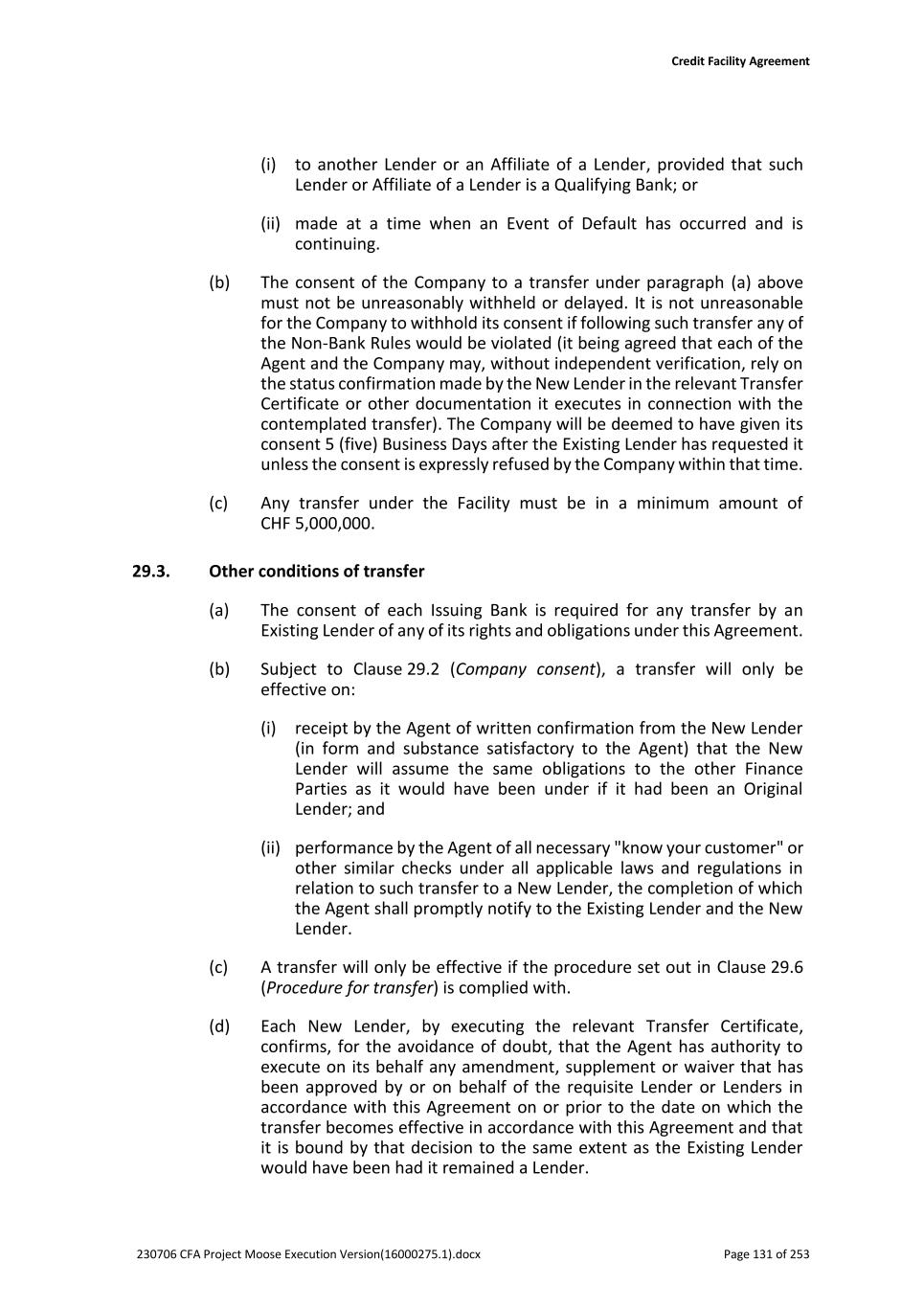
Credit Facility Agreement 230706 CFA Project Moose Execution Version(16000275.1).docx Page 131 of 253 (i) to another Lender or an Affiliate of a Lender, provided that such Lender or Affiliate of a Lender is a Qualifying Bank; or (ii) made at a time when an Event of Default has occurred and is continuing. (b) The consent of the Company to a transfer under paragraph (a) above must not be unreasonably withheld or delayed. It is not unreasonable for the Company to withhold its consent if following such transfer any of the Non-Bank Rules would be violated (it being agreed that each of the Agent and the Company may, without independent verification, rely on the status confirmation made by the New Lender in the relevant Transfer Certificate or other documentation it executes in connection with the contemplated transfer). The Company will be deemed to have given its consent 5 (five) Business Days after the Existing Lender has requested it unless the consent is expressly refused by the Company within that time. (c) Any transfer under the Facility must be in a minimum amount of CHF 5,000,000. 29.3. Other conditions of transfer (a) The consent of each Issuing Bank is required for any transfer by an Existing Lender of any of its rights and obligations under this Agreement. (b) Subject to Clause 29.2 (Company consent), a transfer will only be effective on: (i) receipt by the Agent of written confirmation from the New Lender (in form and substance satisfactory to the Agent) that the New Lender will assume the same obligations to the other Finance Parties as it would have been under if it had been an Original Lender; and (ii) performance by the Agent of all necessary "know your customer" or other similar checks under all applicable laws and regulations in relation to such transfer to a New Lender, the completion of which the Agent shall promptly notify to the Existing Lender and the New Lender. (c) A transfer will only be effective if the procedure set out in Clause 29.6 (Procedure for transfer) is complied with. (d) Each New Lender, by executing the relevant Transfer Certificate, confirms, for the avoidance of doubt, that the Agent has authority to execute on its behalf any amendment, supplement or waiver that has been approved by or on behalf of the requisite Lender or Lenders in accordance with this Agreement on or prior to the date on which the transfer becomes effective in accordance with this Agreement and that it is bound by that decision to the same extent as the Existing Lender would have been had it remained a Lender.
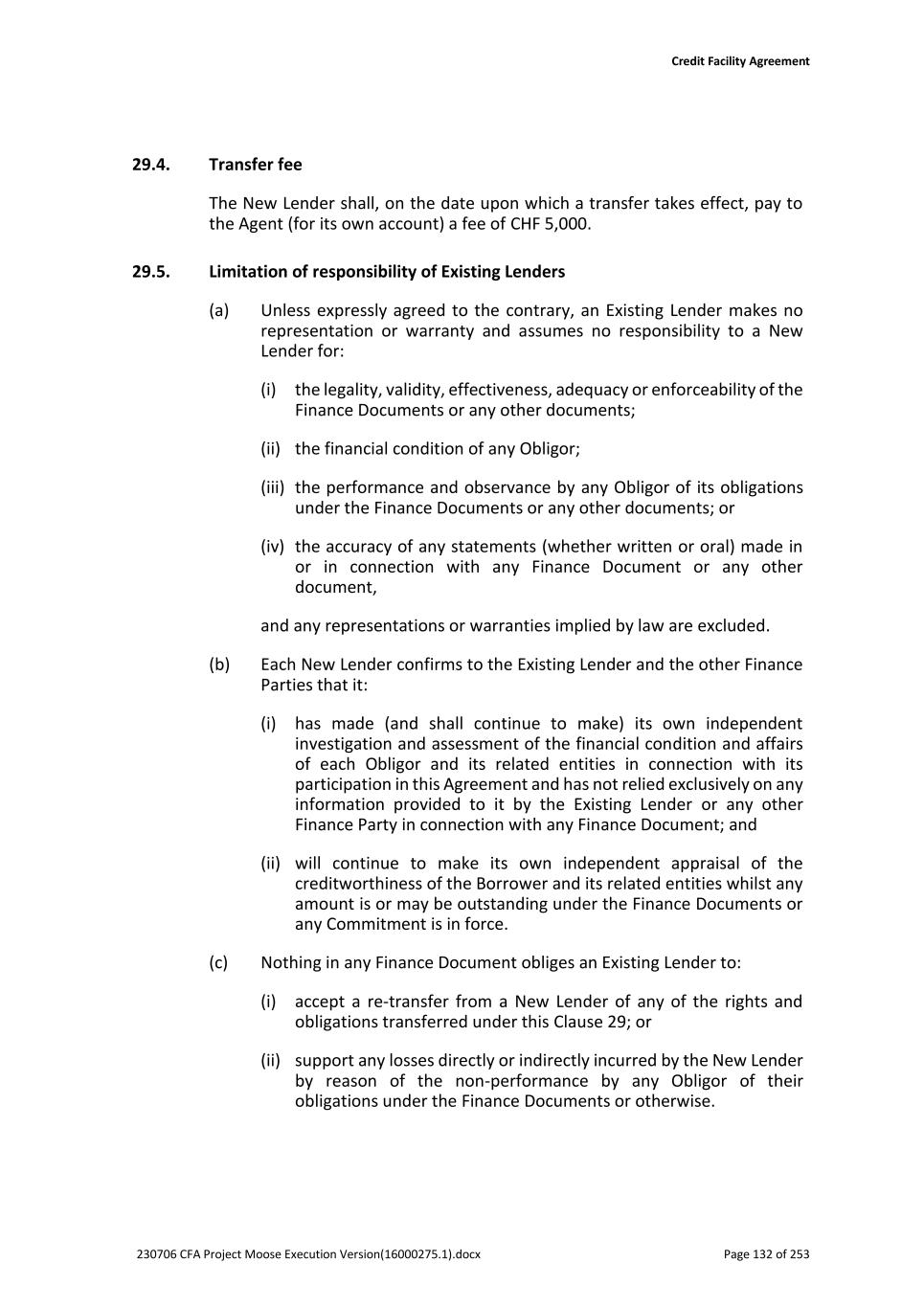
Credit Facility Agreement 230706 CFA Project Moose Execution Version(16000275.1).docx Page 132 of 253 29.4. Transfer fee The New Lender shall, on the date upon which a transfer takes effect, pay to the Agent (for its own account) a fee of CHF 5,000. 29.5. Limitation of responsibility of Existing Lenders (a) Unless expressly agreed to the contrary, an Existing Lender makes no representation or warranty and assumes no responsibility to a New Lender for: (i) the legality, validity, effectiveness, adequacy or enforceability of the Finance Documents or any other documents; (ii) the financial condition of any Obligor; (iii) the performance and observance by any Obligor of its obligations under the Finance Documents or any other documents; or (iv) the accuracy of any statements (whether written or oral) made in or in connection with any Finance Document or any other document, and any representations or warranties implied by law are excluded. (b) Each New Lender confirms to the Existing Lender and the other Finance Parties that it: (i) has made (and shall continue to make) its own independent investigation and assessment of the financial condition and affairs of each Obligor and its related entities in connection with its participation in this Agreement and has not relied exclusively on any information provided to it by the Existing Lender or any other Finance Party in connection with any Finance Document; and (ii) will continue to make its own independent appraisal of the creditworthiness of the Borrower and its related entities whilst any amount is or may be outstanding under the Finance Documents or any Commitment is in force. (c) Nothing in any Finance Document obliges an Existing Lender to: (i) accept a re-transfer from a New Lender of any of the rights and obligations transferred under this Clause 29; or (ii) support any losses directly or indirectly incurred by the New Lender by reason of the non-performance by any Obligor of their obligations under the Finance Documents or otherwise.
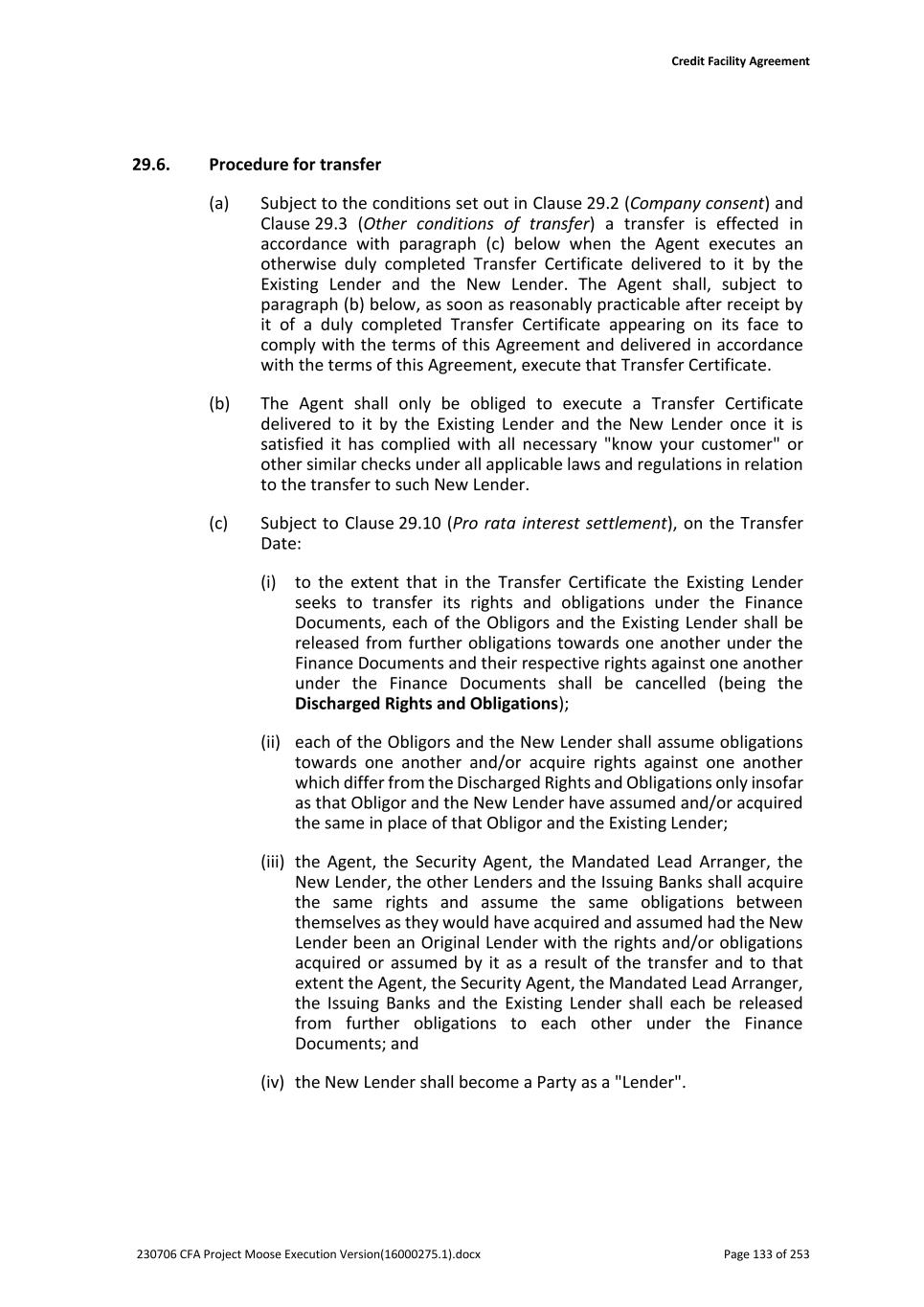
Credit Facility Agreement 230706 CFA Project Moose Execution Version(16000275.1).docx Page 133 of 253 29.6. Procedure for transfer (a) Subject to the conditions set out in Clause 29.2 (Company consent) and Clause 29.3 (Other conditions of transfer) a transfer is effected in accordance with paragraph (c) below when the Agent executes an otherwise duly completed Transfer Certificate delivered to it by the Existing Lender and the New Lender. The Agent shall, subject to paragraph (b) below, as soon as reasonably practicable after receipt by it of a duly completed Transfer Certificate appearing on its face to comply with the terms of this Agreement and delivered in accordance with the terms of this Agreement, execute that Transfer Certificate. (b) The Agent shall only be obliged to execute a Transfer Certificate delivered to it by the Existing Lender and the New Lender once it is satisfied it has complied with all necessary "know your customer" or other similar checks under all applicable laws and regulations in relation to the transfer to such New Lender. (c) Subject to Clause 29.10 (Pro rata interest settlement), on the Transfer Date: (i) to the extent that in the Transfer Certificate the Existing Lender seeks to transfer its rights and obligations under the Finance Documents, each of the Obligors and the Existing Lender shall be released from further obligations towards one another under the Finance Documents and their respective rights against one another under the Finance Documents shall be cancelled (being the Discharged Rights and Obligations); (ii) each of the Obligors and the New Lender shall assume obligations towards one another and/or acquire rights against one another which differ from the Discharged Rights and Obligations only insofar as that Obligor and the New Lender have assumed and/or acquired the same in place of that Obligor and the Existing Lender; (iii) the Agent, the Security Agent, the Mandated Lead Arranger, the New Lender, the other Lenders and the Issuing Banks shall acquire the same rights and assume the same obligations between themselves as they would have acquired and assumed had the New Lender been an Original Lender with the rights and/or obligations acquired or assumed by it as a result of the transfer and to that extent the Agent, the Security Agent, the Mandated Lead Arranger, the Issuing Banks and the Existing Lender shall each be released from further obligations to each other under the Finance Documents; and (iv) the New Lender shall become a Party as a "Lender".
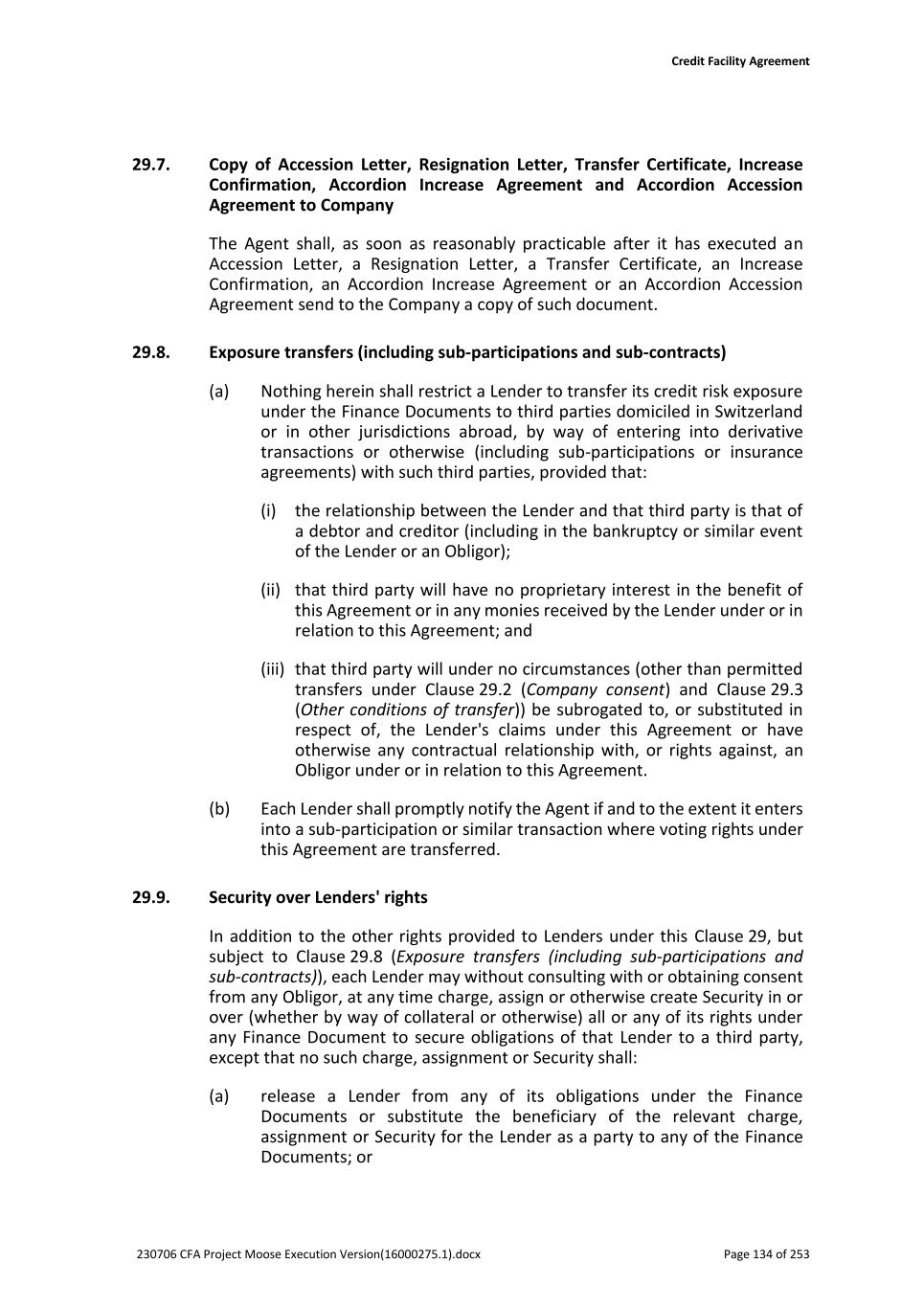
Credit Facility Agreement 230706 CFA Project Moose Execution Version(16000275.1).docx Page 134 of 253 29.7. Copy of Accession Letter, Resignation Letter, Transfer Certificate, Increase Confirmation, Accordion Increase Agreement and Accordion Accession Agreement to Company The Agent shall, as soon as reasonably practicable after it has executed an Accession Letter, a Resignation Letter, a Transfer Certificate, an Increase Confirmation, an Accordion Increase Agreement or an Accordion Accession Agreement send to the Company a copy of such document. 29.8. Exposure transfers (including sub-participations and sub-contracts) (a) Nothing herein shall restrict a Lender to transfer its credit risk exposure under the Finance Documents to third parties domiciled in Switzerland or in other jurisdictions abroad, by way of entering into derivative transactions or otherwise (including sub-participations or insurance agreements) with such third parties, provided that: (i) the relationship between the Lender and that third party is that of a debtor and creditor (including in the bankruptcy or similar event of the Lender or an Obligor); (ii) that third party will have no proprietary interest in the benefit of this Agreement or in any monies received by the Lender under or in relation to this Agreement; and (iii) that third party will under no circumstances (other than permitted transfers under Clause 29.2 (Company consent) and Clause 29.3 (Other conditions of transfer)) be subrogated to, or substituted in respect of, the Lender's claims under this Agreement or have otherwise any contractual relationship with, or rights against, an Obligor under or in relation to this Agreement. (b) Each Lender shall promptly notify the Agent if and to the extent it enters into a sub-participation or similar transaction where voting rights under this Agreement are transferred. 29.9. Security over Lenders' rights In addition to the other rights provided to Lenders under this Clause 29, but subject to Clause 29.8 (Exposure transfers (including sub-participations and sub-contracts)), each Lender may without consulting with or obtaining consent from any Obligor, at any time charge, assign or otherwise create Security in or over (whether by way of collateral or otherwise) all or any of its rights under any Finance Document to secure obligations of that Lender to a third party, except that no such charge, assignment or Security shall: (a) release a Lender from any of its obligations under the Finance Documents or substitute the beneficiary of the relevant charge, assignment or Security for the Lender as a party to any of the Finance Documents; or
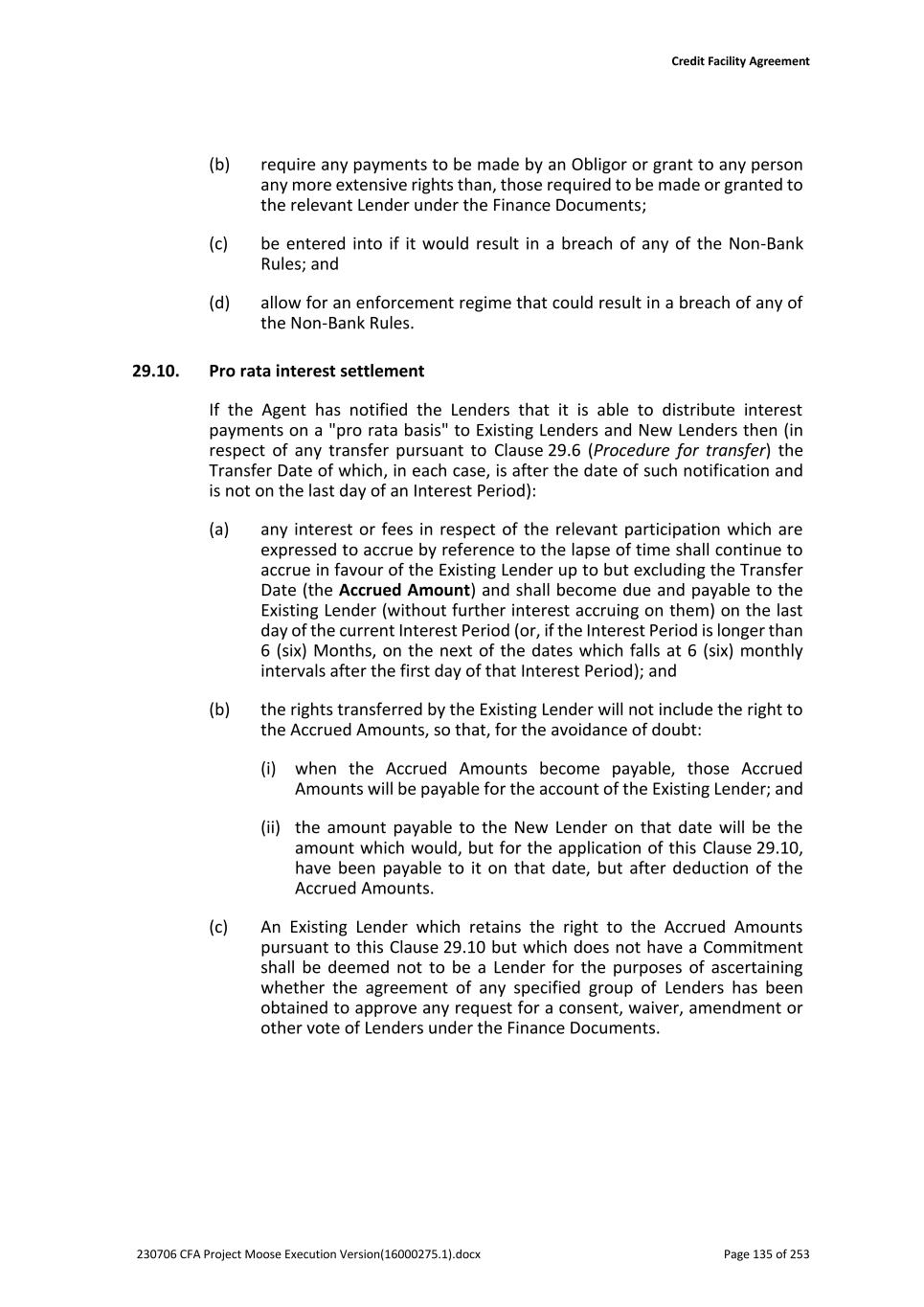
Credit Facility Agreement 230706 CFA Project Moose Execution Version(16000275.1).docx Page 135 of 253 (b) require any payments to be made by an Obligor or grant to any person any more extensive rights than, those required to be made or granted to the relevant Lender under the Finance Documents; (c) be entered into if it would result in a breach of any of the Non-Bank Rules; and (d) allow for an enforcement regime that could result in a breach of any of the Non-Bank Rules. 29.10. Pro rata interest settlement If the Agent has notified the Lenders that it is able to distribute interest payments on a "pro rata basis" to Existing Lenders and New Lenders then (in respect of any transfer pursuant to Clause 29.6 (Procedure for transfer) the Transfer Date of which, in each case, is after the date of such notification and is not on the last day of an Interest Period): (a) any interest or fees in respect of the relevant participation which are expressed to accrue by reference to the lapse of time shall continue to accrue in favour of the Existing Lender up to but excluding the Transfer Date (the Accrued Amount) and shall become due and payable to the Existing Lender (without further interest accruing on them) on the last day of the current Interest Period (or, if the Interest Period is longer than 6 (six) Months, on the next of the dates which falls at 6 (six) monthly intervals after the first day of that Interest Period); and (b) the rights transferred by the Existing Lender will not include the right to the Accrued Amounts, so that, for the avoidance of doubt: (i) when the Accrued Amounts become payable, those Accrued Amounts will be payable for the account of the Existing Lender; and (ii) the amount payable to the New Lender on that date will be the amount which would, but for the application of this Clause 29.10, have been payable to it on that date, but after deduction of the Accrued Amounts. (c) An Existing Lender which retains the right to the Accrued Amounts pursuant to this Clause 29.10 but which does not have a Commitment shall be deemed not to be a Lender for the purposes of ascertaining whether the agreement of any specified group of Lenders has been obtained to approve any request for a consent, waiver, amendment or other vote of Lenders under the Finance Documents.
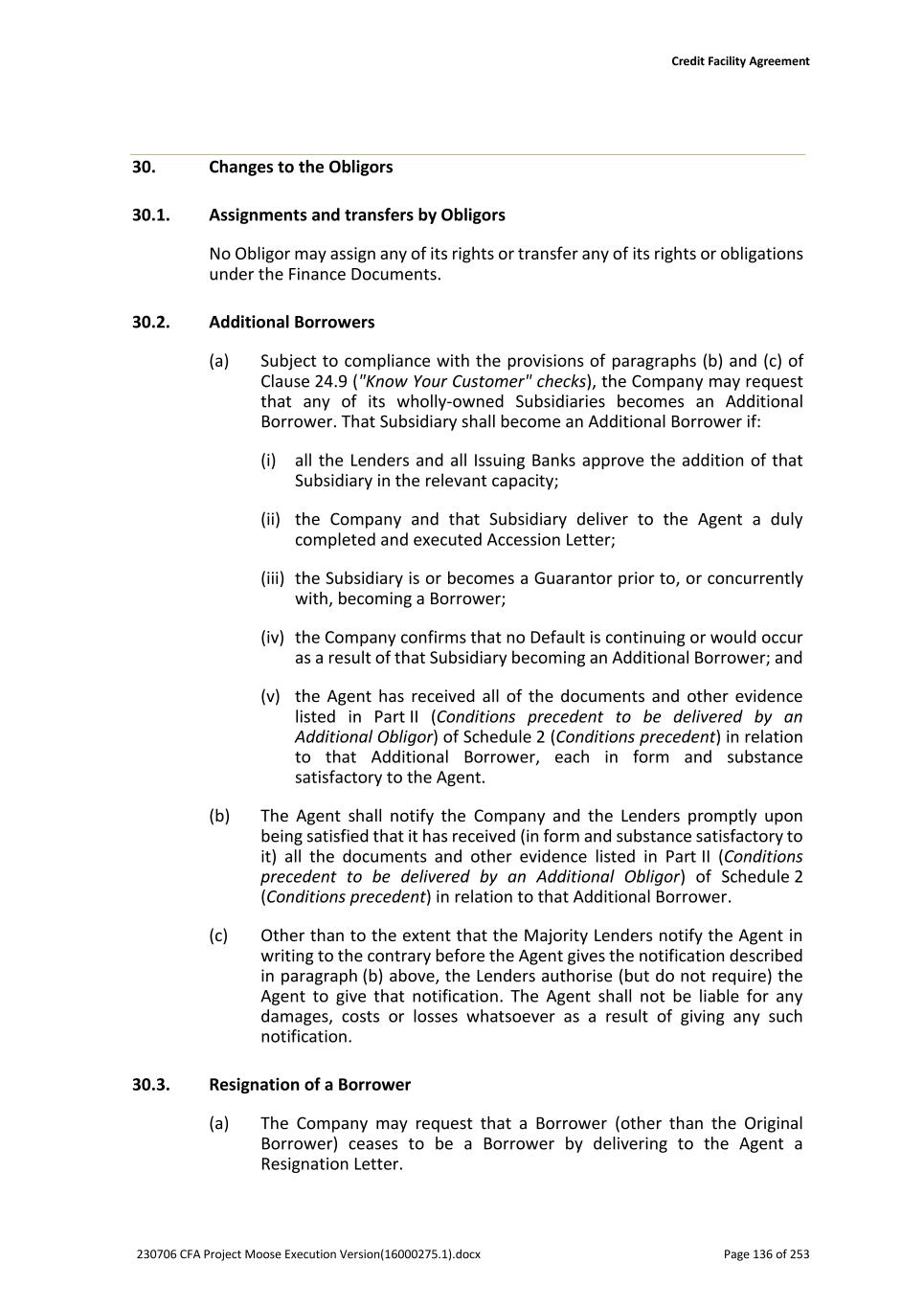
Credit Facility Agreement 230706 CFA Project Moose Execution Version(16000275.1).docx Page 136 of 253 30. Changes to the Obligors 30.1. Assignments and transfers by Obligors No Obligor may assign any of its rights or transfer any of its rights or obligations under the Finance Documents. 30.2. Additional Borrowers (a) Subject to compliance with the provisions of paragraphs (b) and (c) of Clause 24.9 ("Know Your Customer" checks), the Company may request that any of its wholly-owned Subsidiaries becomes an Additional Borrower. That Subsidiary shall become an Additional Borrower if: (i) all the Lenders and all Issuing Banks approve the addition of that Subsidiary in the relevant capacity; (ii) the Company and that Subsidiary deliver to the Agent a duly completed and executed Accession Letter; (iii) the Subsidiary is or becomes a Guarantor prior to, or concurrently with, becoming a Borrower; (iv) the Company confirms that no Default is continuing or would occur as a result of that Subsidiary becoming an Additional Borrower; and (v) the Agent has received all of the documents and other evidence listed in Part II (Conditions precedent to be delivered by an Additional Obligor) of Schedule 2 (Conditions precedent) in relation to that Additional Borrower, each in form and substance satisfactory to the Agent. (b) The Agent shall notify the Company and the Lenders promptly upon being satisfied that it has received (in form and substance satisfactory to it) all the documents and other evidence listed in Part II (Conditions precedent to be delivered by an Additional Obligor) of Schedule 2 (Conditions precedent) in relation to that Additional Borrower. (c) Other than to the extent that the Majority Lenders notify the Agent in writing to the contrary before the Agent gives the notification described in paragraph (b) above, the Lenders authorise (but do not require) the Agent to give that notification. The Agent shall not be liable for any damages, costs or losses whatsoever as a result of giving any such notification. 30.3. Resignation of a Borrower (a) The Company may request that a Borrower (other than the Original Borrower) ceases to be a Borrower by delivering to the Agent a Resignation Letter.
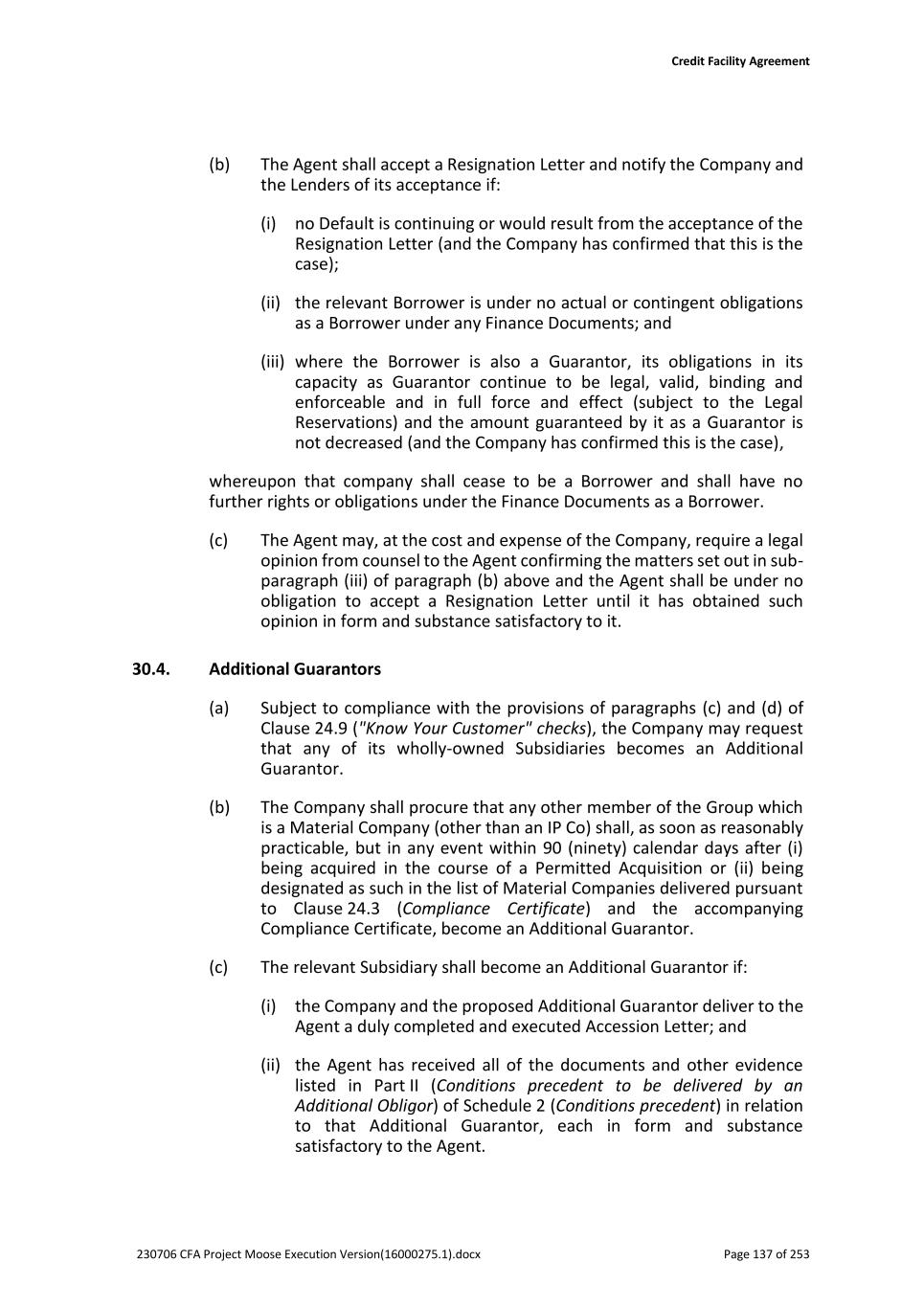
Credit Facility Agreement 230706 CFA Project Moose Execution Version(16000275.1).docx Page 137 of 253 (b) The Agent shall accept a Resignation Letter and notify the Company and the Lenders of its acceptance if: (i) no Default is continuing or would result from the acceptance of the Resignation Letter (and the Company has confirmed that this is the case); (ii) the relevant Borrower is under no actual or contingent obligations as a Borrower under any Finance Documents; and (iii) where the Borrower is also a Guarantor, its obligations in its capacity as Guarantor continue to be legal, valid, binding and enforceable and in full force and effect (subject to the Legal Reservations) and the amount guaranteed by it as a Guarantor is not decreased (and the Company has confirmed this is the case), whereupon that company shall cease to be a Borrower and shall have no further rights or obligations under the Finance Documents as a Borrower. (c) The Agent may, at the cost and expense of the Company, require a legal opinion from counsel to the Agent confirming the matters set out in sub- paragraph (iii) of paragraph (b) above and the Agent shall be under no obligation to accept a Resignation Letter until it has obtained such opinion in form and substance satisfactory to it. 30.4. Additional Guarantors (a) Subject to compliance with the provisions of paragraphs (c) and (d) of Clause 24.9 ("Know Your Customer" checks), the Company may request that any of its wholly-owned Subsidiaries becomes an Additional Guarantor. (b) The Company shall procure that any other member of the Group which is a Material Company (other than an IP Co) shall, as soon as reasonably practicable, but in any event within 90 (ninety) calendar days after (i) being acquired in the course of a Permitted Acquisition or (ii) being designated as such in the list of Material Companies delivered pursuant to Clause 24.3 (Compliance Certificate) and the accompanying Compliance Certificate, become an Additional Guarantor. (c) The relevant Subsidiary shall become an Additional Guarantor if: (i) the Company and the proposed Additional Guarantor deliver to the Agent a duly completed and executed Accession Letter; and (ii) the Agent has received all of the documents and other evidence listed in Part II (Conditions precedent to be delivered by an Additional Obligor) of Schedule 2 (Conditions precedent) in relation to that Additional Guarantor, each in form and substance satisfactory to the Agent.
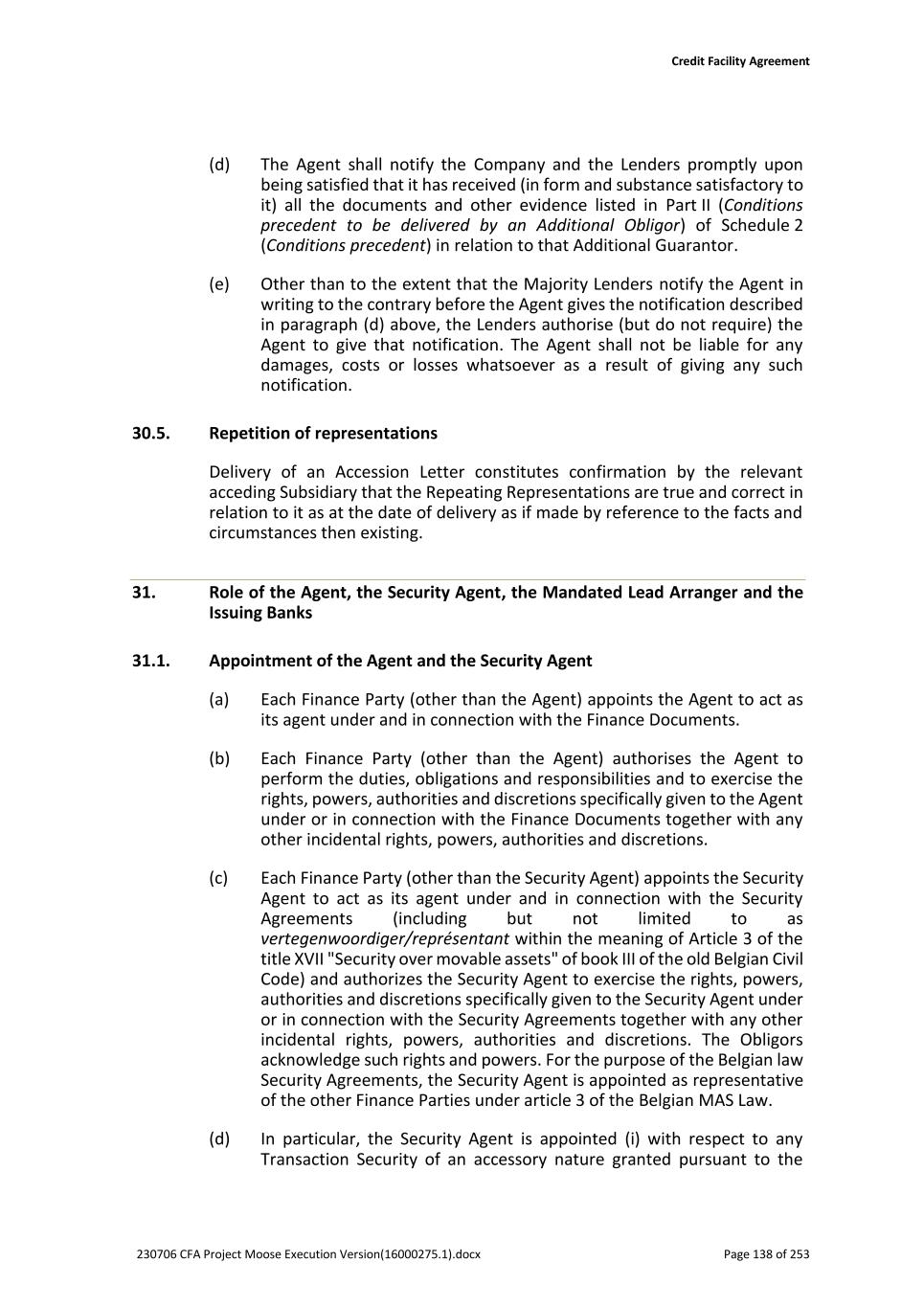
Credit Facility Agreement 230706 CFA Project Moose Execution Version(16000275.1).docx Page 138 of 253 (d) The Agent shall notify the Company and the Lenders promptly upon being satisfied that it has received (in form and substance satisfactory to it) all the documents and other evidence listed in Part II (Conditions precedent to be delivered by an Additional Obligor) of Schedule 2 (Conditions precedent) in relation to that Additional Guarantor. (e) Other than to the extent that the Majority Lenders notify the Agent in writing to the contrary before the Agent gives the notification described in paragraph (d) above, the Lenders authorise (but do not require) the Agent to give that notification. The Agent shall not be liable for any damages, costs or losses whatsoever as a result of giving any such notification. 30.5. Repetition of representations Delivery of an Accession Letter constitutes confirmation by the relevant acceding Subsidiary that the Repeating Representations are true and correct in relation to it as at the date of delivery as if made by reference to the facts and circumstances then existing. 31. Role of the Agent, the Security Agent, the Mandated Lead Arranger and the Issuing Banks 31.1. Appointment of the Agent and the Security Agent (a) Each Finance Party (other than the Agent) appoints the Agent to act as its agent under and in connection with the Finance Documents. (b) Each Finance Party (other than the Agent) authorises the Agent to perform the duties, obligations and responsibilities and to exercise the rights, powers, authorities and discretions specifically given to the Agent under or in connection with the Finance Documents together with any other incidental rights, powers, authorities and discretions. (c) Each Finance Party (other than the Security Agent) appoints the Security Agent to act as its agent under and in connection with the Security Agreements (including but not limited to as vertegenwoordiger/représentant within the meaning of Article 3 of the title XVII "Security over movable assets" of book III of the old Belgian Civil Code) and authorizes the Security Agent to exercise the rights, powers, authorities and discretions specifically given to the Security Agent under or in connection with the Security Agreements together with any other incidental rights, powers, authorities and discretions. The Obligors acknowledge such rights and powers. For the purpose of the Belgian law Security Agreements, the Security Agent is appointed as representative of the other Finance Parties under article 3 of the Belgian MAS Law. (d) In particular, the Security Agent is appointed (i) with respect to any Transaction Security of an accessory nature granted pursuant to the
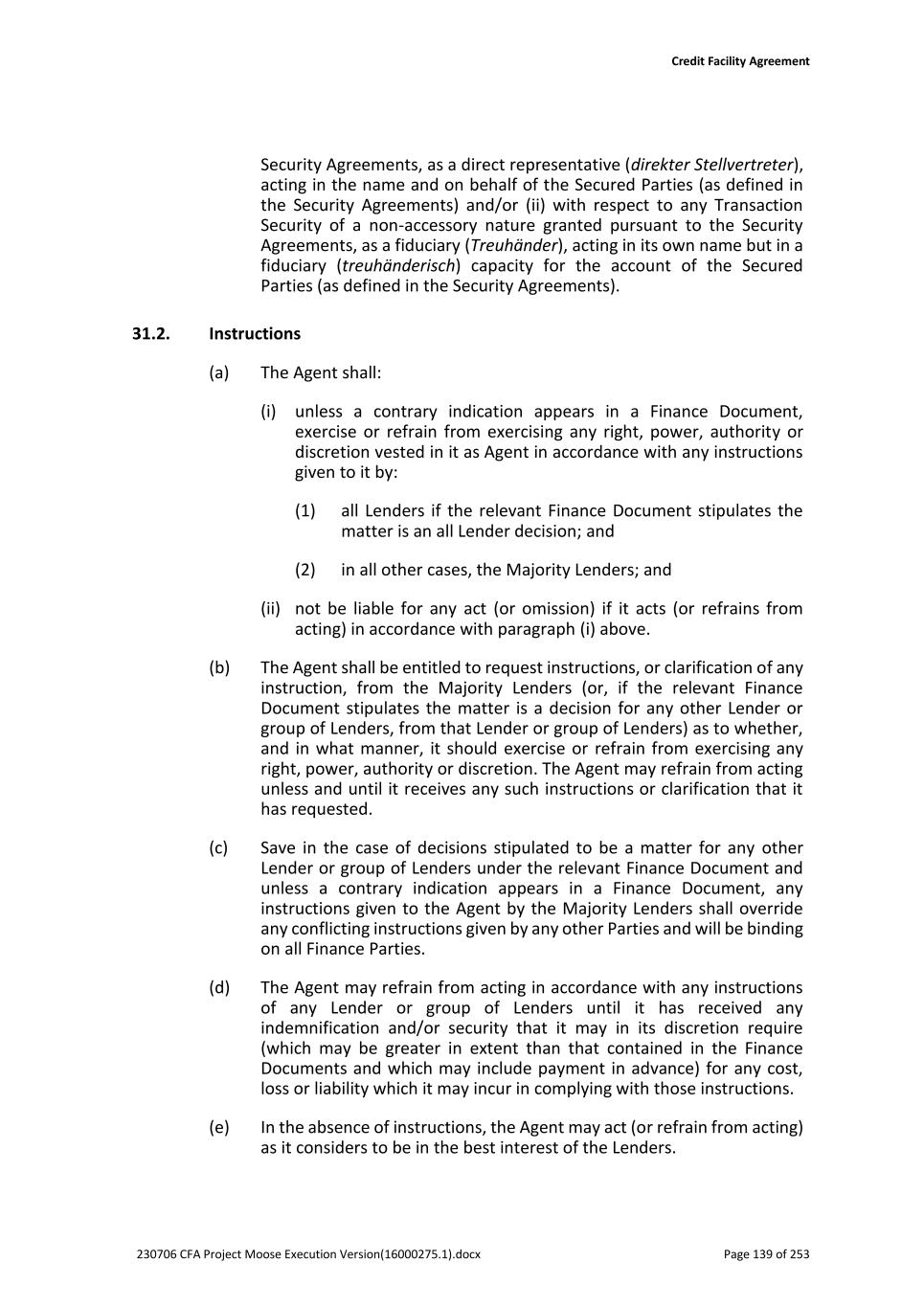
Credit Facility Agreement 230706 CFA Project Moose Execution Version(16000275.1).docx Page 139 of 253 Security Agreements, as a direct representative (direkter Stellvertreter), acting in the name and on behalf of the Secured Parties (as defined in the Security Agreements) and/or (ii) with respect to any Transaction Security of a non-accessory nature granted pursuant to the Security Agreements, as a fiduciary (Treuhänder), acting in its own name but in a fiduciary (treuhänderisch) capacity for the account of the Secured Parties (as defined in the Security Agreements). 31.2. Instructions (a) The Agent shall: (i) unless a contrary indication appears in a Finance Document, exercise or refrain from exercising any right, power, authority or discretion vested in it as Agent in accordance with any instructions given to it by: (1) all Lenders if the relevant Finance Document stipulates the matter is an all Lender decision; and (2) in all other cases, the Majority Lenders; and (ii) not be liable for any act (or omission) if it acts (or refrains from acting) in accordance with paragraph (i) above. (b) The Agent shall be entitled to request instructions, or clarification of any instruction, from the Majority Lenders (or, if the relevant Finance Document stipulates the matter is a decision for any other Lender or group of Lenders, from that Lender or group of Lenders) as to whether, and in what manner, it should exercise or refrain from exercising any right, power, authority or discretion. The Agent may refrain from acting unless and until it receives any such instructions or clarification that it has requested. (c) Save in the case of decisions stipulated to be a matter for any other Lender or group of Lenders under the relevant Finance Document and unless a contrary indication appears in a Finance Document, any instructions given to the Agent by the Majority Lenders shall override any conflicting instructions given by any other Parties and will be binding on all Finance Parties. (d) The Agent may refrain from acting in accordance with any instructions of any Lender or group of Lenders until it has received any indemnification and/or security that it may in its discretion require (which may be greater in extent than that contained in the Finance Documents and which may include payment in advance) for any cost, loss or liability which it may incur in complying with those instructions. (e) In the absence of instructions, the Agent may act (or refrain from acting) as it considers to be in the best interest of the Lenders.
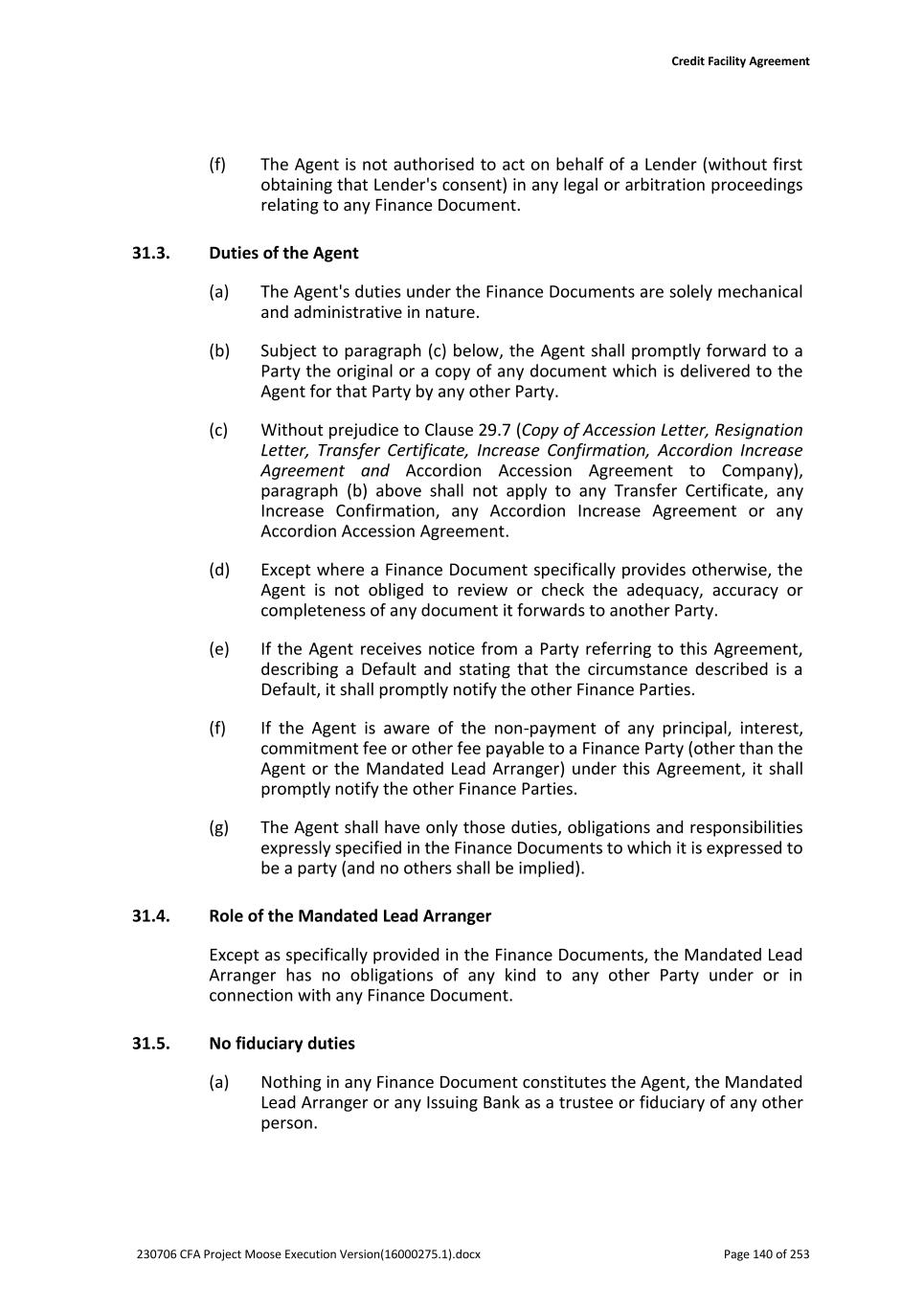
Credit Facility Agreement 230706 CFA Project Moose Execution Version(16000275.1).docx Page 140 of 253 (f) The Agent is not authorised to act on behalf of a Lender (without first obtaining that Lender's consent) in any legal or arbitration proceedings relating to any Finance Document. 31.3. Duties of the Agent (a) The Agent's duties under the Finance Documents are solely mechanical and administrative in nature. (b) Subject to paragraph (c) below, the Agent shall promptly forward to a Party the original or a copy of any document which is delivered to the Agent for that Party by any other Party. (c) Without prejudice to Clause 29.7 (Copy of Accession Letter, Resignation Letter, Transfer Certificate, Increase Confirmation, Accordion Increase Agreement and Accordion Accession Agreement to Company), paragraph (b) above shall not apply to any Transfer Certificate, any Increase Confirmation, any Accordion Increase Agreement or any Accordion Accession Agreement. (d) Except where a Finance Document specifically provides otherwise, the Agent is not obliged to review or check the adequacy, accuracy or completeness of any document it forwards to another Party. (e) If the Agent receives notice from a Party referring to this Agreement, describing a Default and stating that the circumstance described is a Default, it shall promptly notify the other Finance Parties. (f) If the Agent is aware of the non-payment of any principal, interest, commitment fee or other fee payable to a Finance Party (other than the Agent or the Mandated Lead Arranger) under this Agreement, it shall promptly notify the other Finance Parties. (g) The Agent shall have only those duties, obligations and responsibilities expressly specified in the Finance Documents to which it is expressed to be a party (and no others shall be implied). 31.4. Role of the Mandated Lead Arranger Except as specifically provided in the Finance Documents, the Mandated Lead Arranger has no obligations of any kind to any other Party under or in connection with any Finance Document. 31.5. No fiduciary duties (a) Nothing in any Finance Document constitutes the Agent, the Mandated Lead Arranger or any Issuing Bank as a trustee or fiduciary of any other person.
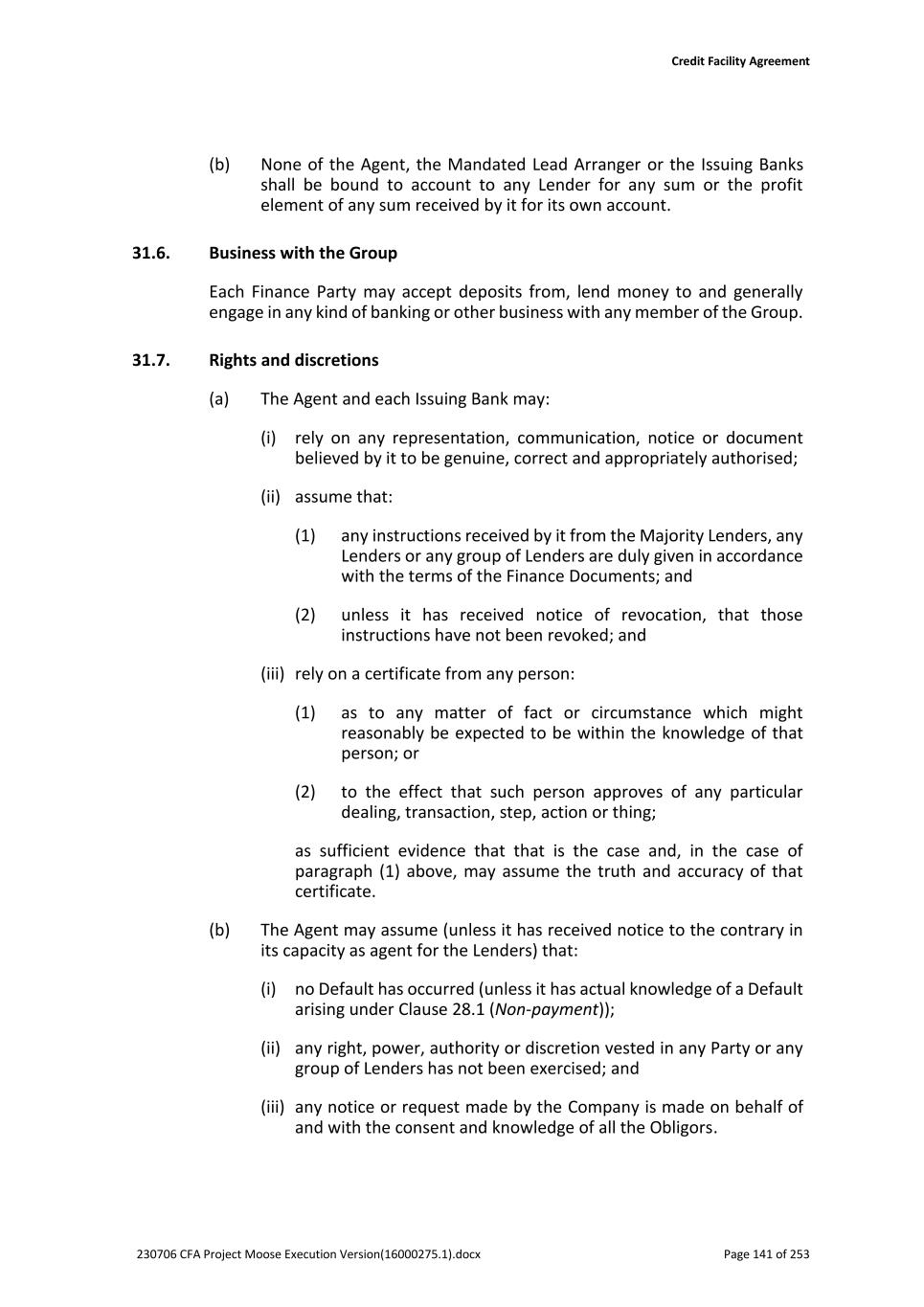
Credit Facility Agreement 230706 CFA Project Moose Execution Version(16000275.1).docx Page 141 of 253 (b) None of the Agent, the Mandated Lead Arranger or the Issuing Banks shall be bound to account to any Lender for any sum or the profit element of any sum received by it for its own account. 31.6. Business with the Group Each Finance Party may accept deposits from, lend money to and generally engage in any kind of banking or other business with any member of the Group. 31.7. Rights and discretions (a) The Agent and each Issuing Bank may: (i) rely on any representation, communication, notice or document believed by it to be genuine, correct and appropriately authorised; (ii) assume that: (1) any instructions received by it from the Majority Lenders, any Lenders or any group of Lenders are duly given in accordance with the terms of the Finance Documents; and (2) unless it has received notice of revocation, that those instructions have not been revoked; and (iii) rely on a certificate from any person: (1) as to any matter of fact or circumstance which might reasonably be expected to be within the knowledge of that person; or (2) to the effect that such person approves of any particular dealing, transaction, step, action or thing; as sufficient evidence that that is the case and, in the case of paragraph (1) above, may assume the truth and accuracy of that certificate. (b) The Agent may assume (unless it has received notice to the contrary in its capacity as agent for the Lenders) that: (i) no Default has occurred (unless it has actual knowledge of a Default arising under Clause 28.1 (Non-payment)); (ii) any right, power, authority or discretion vested in any Party or any group of Lenders has not been exercised; and (iii) any notice or request made by the Company is made on behalf of and with the consent and knowledge of all the Obligors.
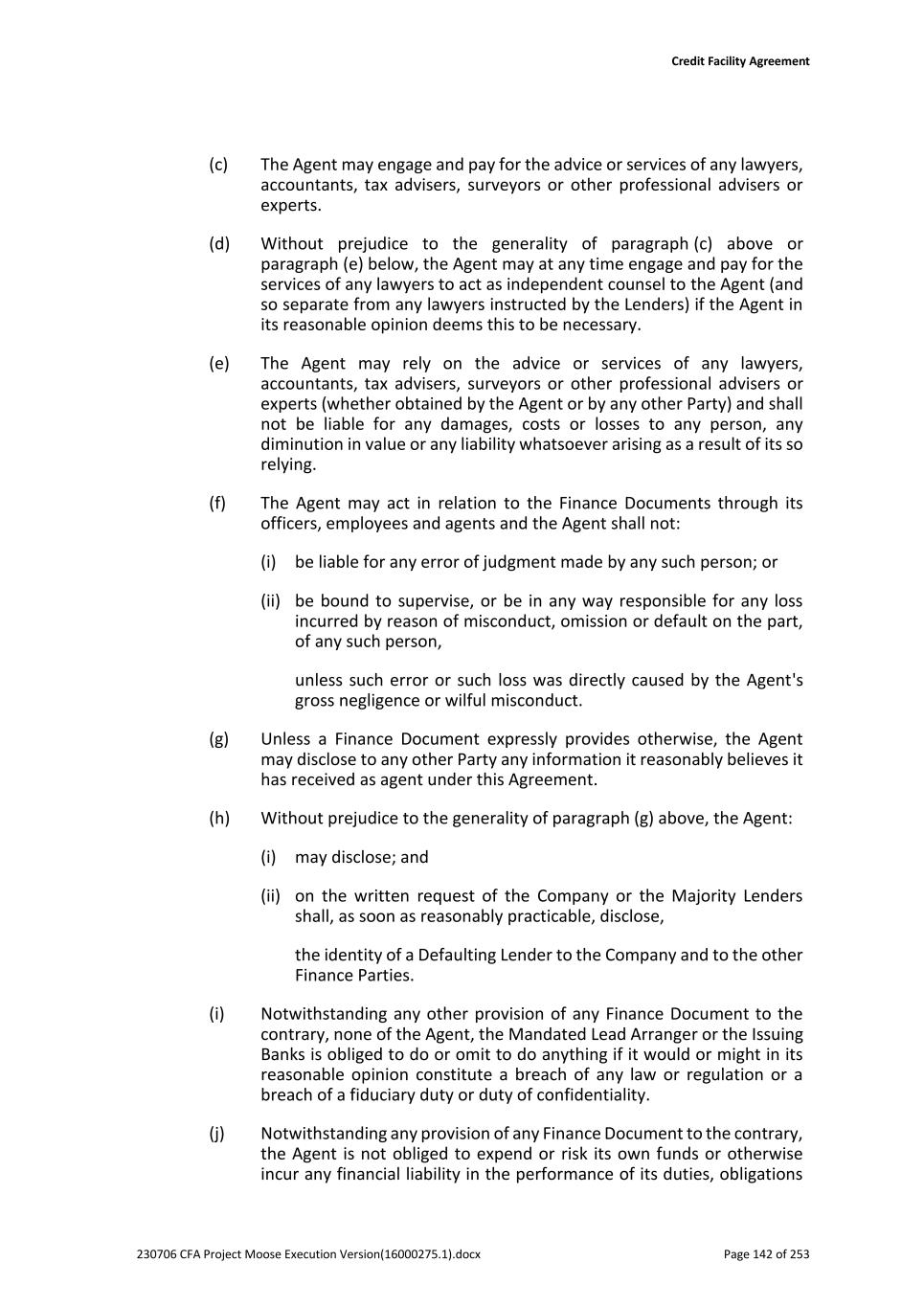
Credit Facility Agreement 230706 CFA Project Moose Execution Version(16000275.1).docx Page 142 of 253 (c) The Agent may engage and pay for the advice or services of any lawyers, accountants, tax advisers, surveyors or other professional advisers or experts. (d) Without prejudice to the generality of paragraph (c) above or paragraph (e) below, the Agent may at any time engage and pay for the services of any lawyers to act as independent counsel to the Agent (and so separate from any lawyers instructed by the Lenders) if the Agent in its reasonable opinion deems this to be necessary. (e) The Agent may rely on the advice or services of any lawyers, accountants, tax advisers, surveyors or other professional advisers or experts (whether obtained by the Agent or by any other Party) and shall not be liable for any damages, costs or losses to any person, any diminution in value or any liability whatsoever arising as a result of its so relying. (f) The Agent may act in relation to the Finance Documents through its officers, employees and agents and the Agent shall not: (i) be liable for any error of judgment made by any such person; or (ii) be bound to supervise, or be in any way responsible for any loss incurred by reason of misconduct, omission or default on the part, of any such person, unless such error or such loss was directly caused by the Agent's gross negligence or wilful misconduct. (g) Unless a Finance Document expressly provides otherwise, the Agent may disclose to any other Party any information it reasonably believes it has received as agent under this Agreement. (h) Without prejudice to the generality of paragraph (g) above, the Agent: (i) may disclose; and (ii) on the written request of the Company or the Majority Lenders shall, as soon as reasonably practicable, disclose, the identity of a Defaulting Lender to the Company and to the other Finance Parties. (i) Notwithstanding any other provision of any Finance Document to the contrary, none of the Agent, the Mandated Lead Arranger or the Issuing Banks is obliged to do or omit to do anything if it would or might in its reasonable opinion constitute a breach of any law or regulation or a breach of a fiduciary duty or duty of confidentiality. (j) Notwithstanding any provision of any Finance Document to the contrary, the Agent is not obliged to expend or risk its own funds or otherwise incur any financial liability in the performance of its duties, obligations
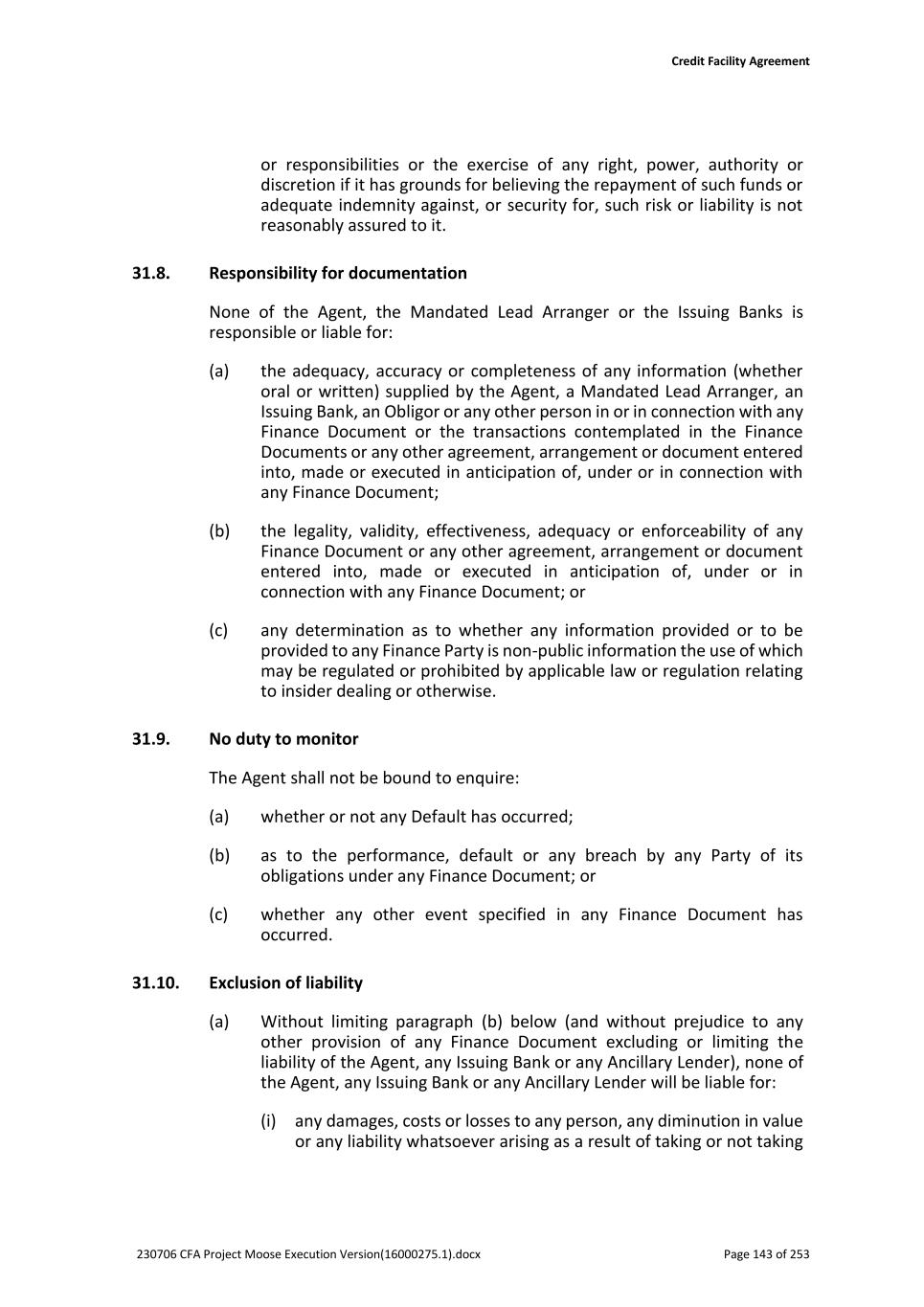
Credit Facility Agreement 230706 CFA Project Moose Execution Version(16000275.1).docx Page 143 of 253 or responsibilities or the exercise of any right, power, authority or discretion if it has grounds for believing the repayment of such funds or adequate indemnity against, or security for, such risk or liability is not reasonably assured to it. 31.8. Responsibility for documentation None of the Agent, the Mandated Lead Arranger or the Issuing Banks is responsible or liable for: (a) the adequacy, accuracy or completeness of any information (whether oral or written) supplied by the Agent, a Mandated Lead Arranger, an Issuing Bank, an Obligor or any other person in or in connection with any Finance Document or the transactions contemplated in the Finance Documents or any other agreement, arrangement or document entered into, made or executed in anticipation of, under or in connection with any Finance Document; (b) the legality, validity, effectiveness, adequacy or enforceability of any Finance Document or any other agreement, arrangement or document entered into, made or executed in anticipation of, under or in connection with any Finance Document; or (c) any determination as to whether any information provided or to be provided to any Finance Party is non-public information the use of which may be regulated or prohibited by applicable law or regulation relating to insider dealing or otherwise. 31.9. No duty to monitor The Agent shall not be bound to enquire: (a) whether or not any Default has occurred; (b) as to the performance, default or any breach by any Party of its obligations under any Finance Document; or (c) whether any other event specified in any Finance Document has occurred. 31.10. Exclusion of liability (a) Without limiting paragraph (b) below (and without prejudice to any other provision of any Finance Document excluding or limiting the liability of the Agent, any Issuing Bank or any Ancillary Lender), none of the Agent, any Issuing Bank or any Ancillary Lender will be liable for: (i) any damages, costs or losses to any person, any diminution in value or any liability whatsoever arising as a result of taking or not taking
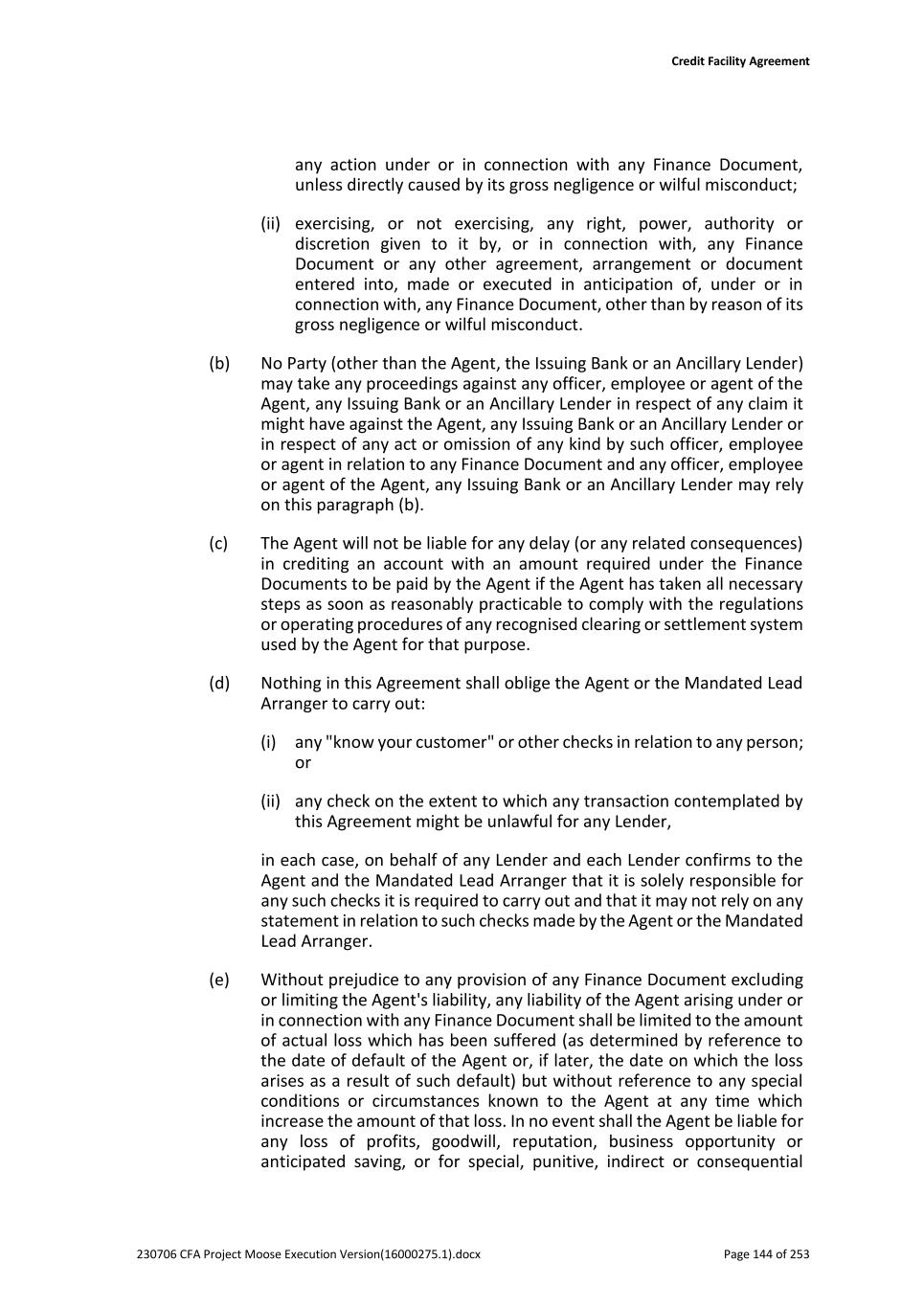
Credit Facility Agreement 230706 CFA Project Moose Execution Version(16000275.1).docx Page 144 of 253 any action under or in connection with any Finance Document, unless directly caused by its gross negligence or wilful misconduct; (ii) exercising, or not exercising, any right, power, authority or discretion given to it by, or in connection with, any Finance Document or any other agreement, arrangement or document entered into, made or executed in anticipation of, under or in connection with, any Finance Document, other than by reason of its gross negligence or wilful misconduct. (b) No Party (other than the Agent, the Issuing Bank or an Ancillary Lender) may take any proceedings against any officer, employee or agent of the Agent, any Issuing Bank or an Ancillary Lender in respect of any claim it might have against the Agent, any Issuing Bank or an Ancillary Lender or in respect of any act or omission of any kind by such officer, employee or agent in relation to any Finance Document and any officer, employee or agent of the Agent, any Issuing Bank or an Ancillary Lender may rely on this paragraph (b). (c) The Agent will not be liable for any delay (or any related consequences) in crediting an account with an amount required under the Finance Documents to be paid by the Agent if the Agent has taken all necessary steps as soon as reasonably practicable to comply with the regulations or operating procedures of any recognised clearing or settlement system used by the Agent for that purpose. (d) Nothing in this Agreement shall oblige the Agent or the Mandated Lead Arranger to carry out: (i) any "know your customer" or other checks in relation to any person; or (ii) any check on the extent to which any transaction contemplated by this Agreement might be unlawful for any Lender, in each case, on behalf of any Lender and each Lender confirms to the Agent and the Mandated Lead Arranger that it is solely responsible for any such checks it is required to carry out and that it may not rely on any statement in relation to such checks made by the Agent or the Mandated Lead Arranger. (e) Without prejudice to any provision of any Finance Document excluding or limiting the Agent's liability, any liability of the Agent arising under or in connection with any Finance Document shall be limited to the amount of actual loss which has been suffered (as determined by reference to the date of default of the Agent or, if later, the date on which the loss arises as a result of such default) but without reference to any special conditions or circumstances known to the Agent at any time which increase the amount of that loss. In no event shall the Agent be liable for any loss of profits, goodwill, reputation, business opportunity or anticipated saving, or for special, punitive, indirect or consequential
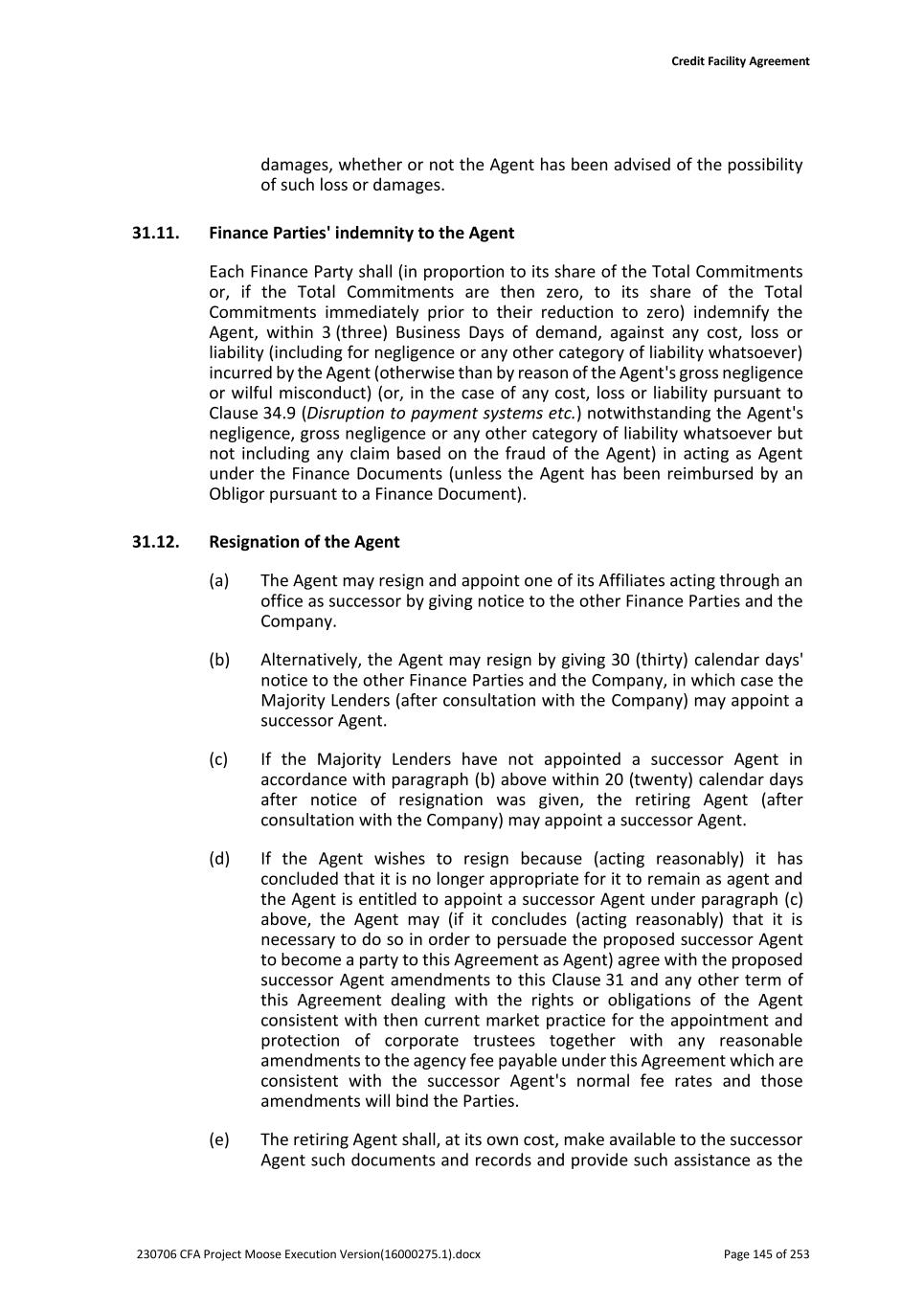
Credit Facility Agreement 230706 CFA Project Moose Execution Version(16000275.1).docx Page 145 of 253 damages, whether or not the Agent has been advised of the possibility of such loss or damages. 31.11. Finance Parties' indemnity to the Agent Each Finance Party shall (in proportion to its share of the Total Commitments or, if the Total Commitments are then zero, to its share of the Total Commitments immediately prior to their reduction to zero) indemnify the Agent, within 3 (three) Business Days of demand, against any cost, loss or liability (including for negligence or any other category of liability whatsoever) incurred by the Agent (otherwise than by reason of the Agent's gross negligence or wilful misconduct) (or, in the case of any cost, loss or liability pursuant to Clause 34.9 (Disruption to payment systems etc.) notwithstanding the Agent's negligence, gross negligence or any other category of liability whatsoever but not including any claim based on the fraud of the Agent) in acting as Agent under the Finance Documents (unless the Agent has been reimbursed by an Obligor pursuant to a Finance Document). 31.12. Resignation of the Agent (a) The Agent may resign and appoint one of its Affiliates acting through an office as successor by giving notice to the other Finance Parties and the Company. (b) Alternatively, the Agent may resign by giving 30 (thirty) calendar days' notice to the other Finance Parties and the Company, in which case the Majority Lenders (after consultation with the Company) may appoint a successor Agent. (c) If the Majority Lenders have not appointed a successor Agent in accordance with paragraph (b) above within 20 (twenty) calendar days after notice of resignation was given, the retiring Agent (after consultation with the Company) may appoint a successor Agent. (d) If the Agent wishes to resign because (acting reasonably) it has concluded that it is no longer appropriate for it to remain as agent and the Agent is entitled to appoint a successor Agent under paragraph (c) above, the Agent may (if it concludes (acting reasonably) that it is necessary to do so in order to persuade the proposed successor Agent to become a party to this Agreement as Agent) agree with the proposed successor Agent amendments to this Clause 31 and any other term of this Agreement dealing with the rights or obligations of the Agent consistent with then current market practice for the appointment and protection of corporate trustees together with any reasonable amendments to the agency fee payable under this Agreement which are consistent with the successor Agent's normal fee rates and those amendments will bind the Parties. (e) The retiring Agent shall, at its own cost, make available to the successor Agent such documents and records and provide such assistance as the
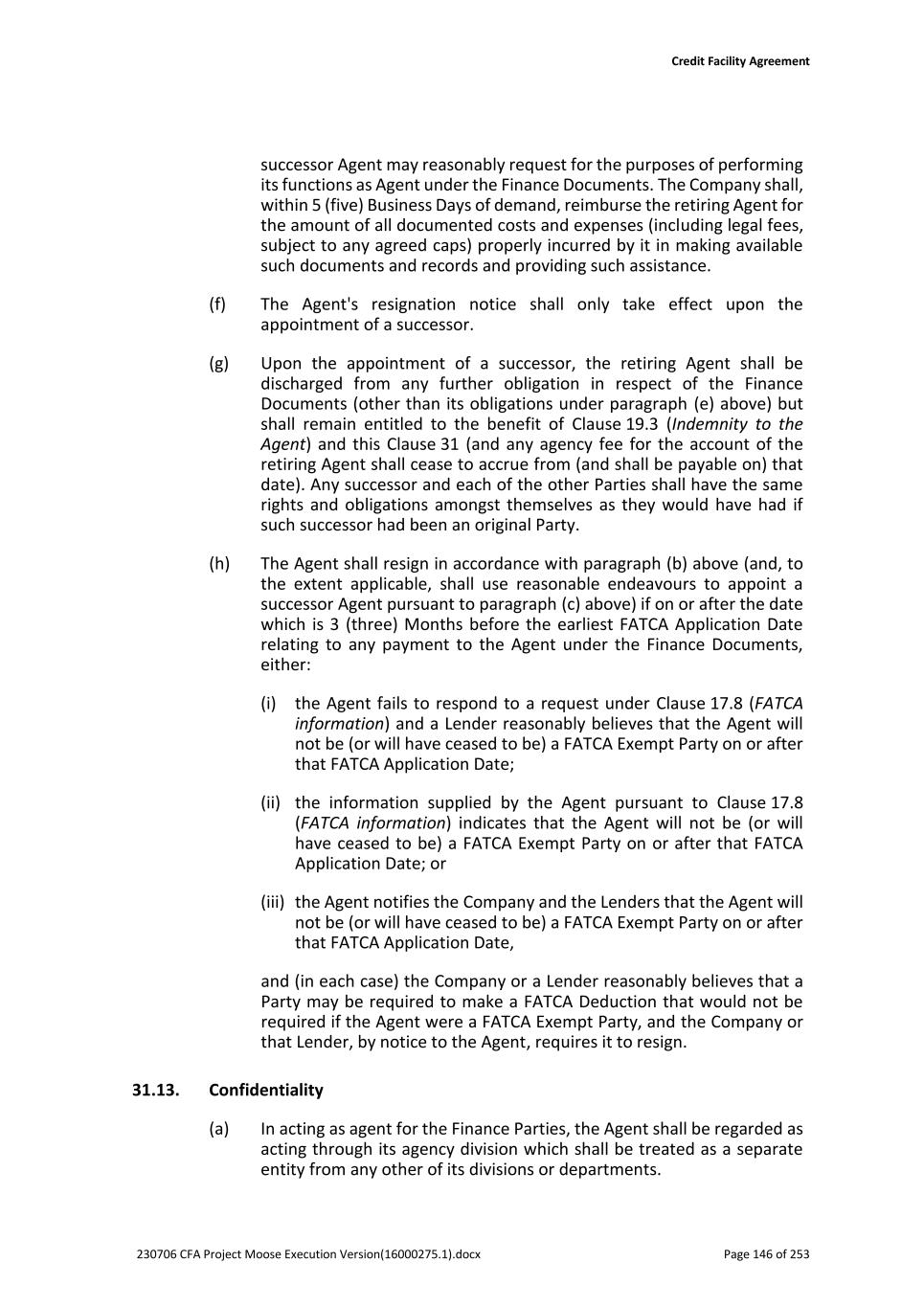
Credit Facility Agreement 230706 CFA Project Moose Execution Version(16000275.1).docx Page 146 of 253 successor Agent may reasonably request for the purposes of performing its functions as Agent under the Finance Documents. The Company shall, within 5 (five) Business Days of demand, reimburse the retiring Agent for the amount of all documented costs and expenses (including legal fees, subject to any agreed caps) properly incurred by it in making available such documents and records and providing such assistance. (f) The Agent's resignation notice shall only take effect upon the appointment of a successor. (g) Upon the appointment of a successor, the retiring Agent shall be discharged from any further obligation in respect of the Finance Documents (other than its obligations under paragraph (e) above) but shall remain entitled to the benefit of Clause 19.3 (Indemnity to the Agent) and this Clause 31 (and any agency fee for the account of the retiring Agent shall cease to accrue from (and shall be payable on) that date). Any successor and each of the other Parties shall have the same rights and obligations amongst themselves as they would have had if such successor had been an original Party. (h) The Agent shall resign in accordance with paragraph (b) above (and, to the extent applicable, shall use reasonable endeavours to appoint a successor Agent pursuant to paragraph (c) above) if on or after the date which is 3 (three) Months before the earliest FATCA Application Date relating to any payment to the Agent under the Finance Documents, either: (i) the Agent fails to respond to a request under Clause 17.8 (FATCA information) and a Lender reasonably believes that the Agent will not be (or will have ceased to be) a FATCA Exempt Party on or after that FATCA Application Date; (ii) the information supplied by the Agent pursuant to Clause 17.8 (FATCA information) indicates that the Agent will not be (or will have ceased to be) a FATCA Exempt Party on or after that FATCA Application Date; or (iii) the Agent notifies the Company and the Lenders that the Agent will not be (or will have ceased to be) a FATCA Exempt Party on or after that FATCA Application Date, and (in each case) the Company or a Lender reasonably believes that a Party may be required to make a FATCA Deduction that would not be required if the Agent were a FATCA Exempt Party, and the Company or that Lender, by notice to the Agent, requires it to resign. 31.13. Confidentiality (a) In acting as agent for the Finance Parties, the Agent shall be regarded as acting through its agency division which shall be treated as a separate entity from any other of its divisions or departments.
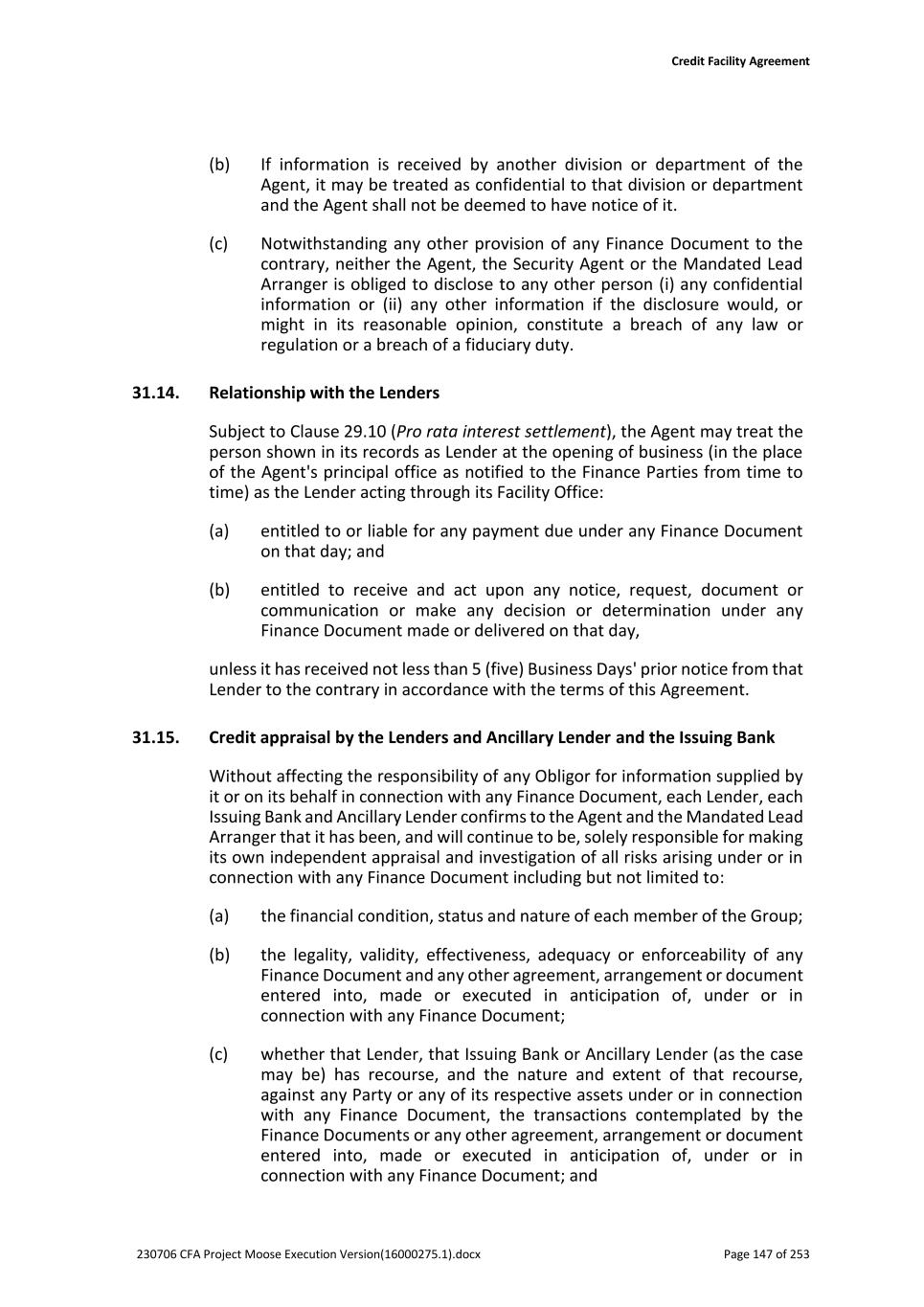
Credit Facility Agreement 230706 CFA Project Moose Execution Version(16000275.1).docx Page 147 of 253 (b) If information is received by another division or department of the Agent, it may be treated as confidential to that division or department and the Agent shall not be deemed to have notice of it. (c) Notwithstanding any other provision of any Finance Document to the contrary, neither the Agent, the Security Agent or the Mandated Lead Arranger is obliged to disclose to any other person (i) any confidential information or (ii) any other information if the disclosure would, or might in its reasonable opinion, constitute a breach of any law or regulation or a breach of a fiduciary duty. 31.14. Relationship with the Lenders Subject to Clause 29.10 (Pro rata interest settlement), the Agent may treat the person shown in its records as Lender at the opening of business (in the place of the Agent's principal office as notified to the Finance Parties from time to time) as the Lender acting through its Facility Office: (a) entitled to or liable for any payment due under any Finance Document on that day; and (b) entitled to receive and act upon any notice, request, document or communication or make any decision or determination under any Finance Document made or delivered on that day, unless it has received not less than 5 (five) Business Days' prior notice from that Lender to the contrary in accordance with the terms of this Agreement. 31.15. Credit appraisal by the Lenders and Ancillary Lender and the Issuing Bank Without affecting the responsibility of any Obligor for information supplied by it or on its behalf in connection with any Finance Document, each Lender, each Issuing Bank and Ancillary Lender confirms to the Agent and the Mandated Lead Arranger that it has been, and will continue to be, solely responsible for making its own independent appraisal and investigation of all risks arising under or in connection with any Finance Document including but not limited to: (a) the financial condition, status and nature of each member of the Group; (b) the legality, validity, effectiveness, adequacy or enforceability of any Finance Document and any other agreement, arrangement or document entered into, made or executed in anticipation of, under or in connection with any Finance Document; (c) whether that Lender, that Issuing Bank or Ancillary Lender (as the case may be) has recourse, and the nature and extent of that recourse, against any Party or any of its respective assets under or in connection with any Finance Document, the transactions contemplated by the Finance Documents or any other agreement, arrangement or document entered into, made or executed in anticipation of, under or in connection with any Finance Document; and
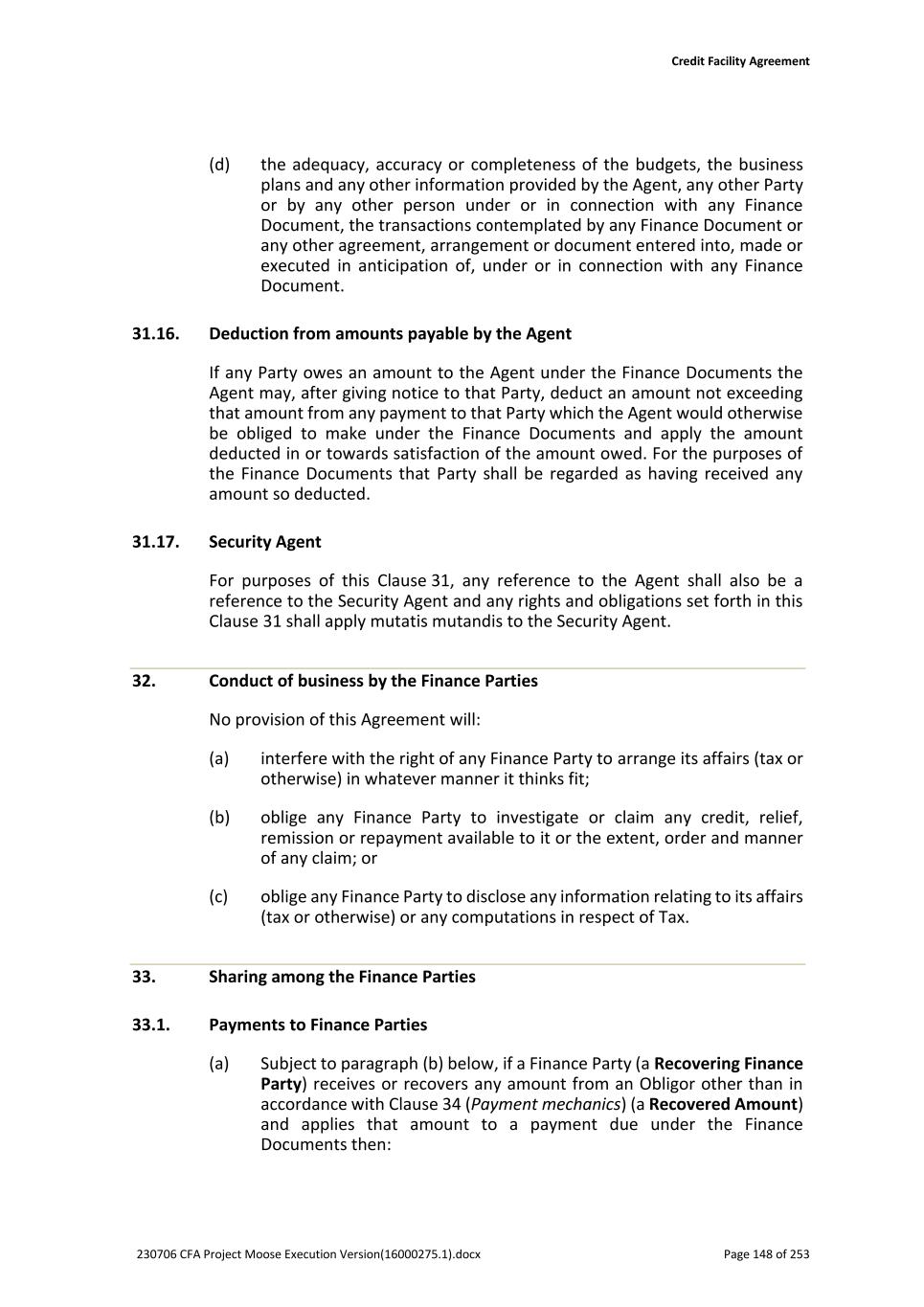
Credit Facility Agreement 230706 CFA Project Moose Execution Version(16000275.1).docx Page 148 of 253 (d) the adequacy, accuracy or completeness of the budgets, the business plans and any other information provided by the Agent, any other Party or by any other person under or in connection with any Finance Document, the transactions contemplated by any Finance Document or any other agreement, arrangement or document entered into, made or executed in anticipation of, under or in connection with any Finance Document. 31.16. Deduction from amounts payable by the Agent If any Party owes an amount to the Agent under the Finance Documents the Agent may, after giving notice to that Party, deduct an amount not exceeding that amount from any payment to that Party which the Agent would otherwise be obliged to make under the Finance Documents and apply the amount deducted in or towards satisfaction of the amount owed. For the purposes of the Finance Documents that Party shall be regarded as having received any amount so deducted. 31.17. Security Agent For purposes of this Clause 31, any reference to the Agent shall also be a reference to the Security Agent and any rights and obligations set forth in this Clause 31 shall apply mutatis mutandis to the Security Agent. 32. Conduct of business by the Finance Parties No provision of this Agreement will: (a) interfere with the right of any Finance Party to arrange its affairs (tax or otherwise) in whatever manner it thinks fit; (b) oblige any Finance Party to investigate or claim any credit, relief, remission or repayment available to it or the extent, order and manner of any claim; or (c) oblige any Finance Party to disclose any information relating to its affairs (tax or otherwise) or any computations in respect of Tax. 33. Sharing among the Finance Parties 33.1. Payments to Finance Parties (a) Subject to paragraph (b) below, if a Finance Party (a Recovering Finance Party) receives or recovers any amount from an Obligor other than in accordance with Clause 34 (Payment mechanics) (a Recovered Amount) and applies that amount to a payment due under the Finance Documents then:
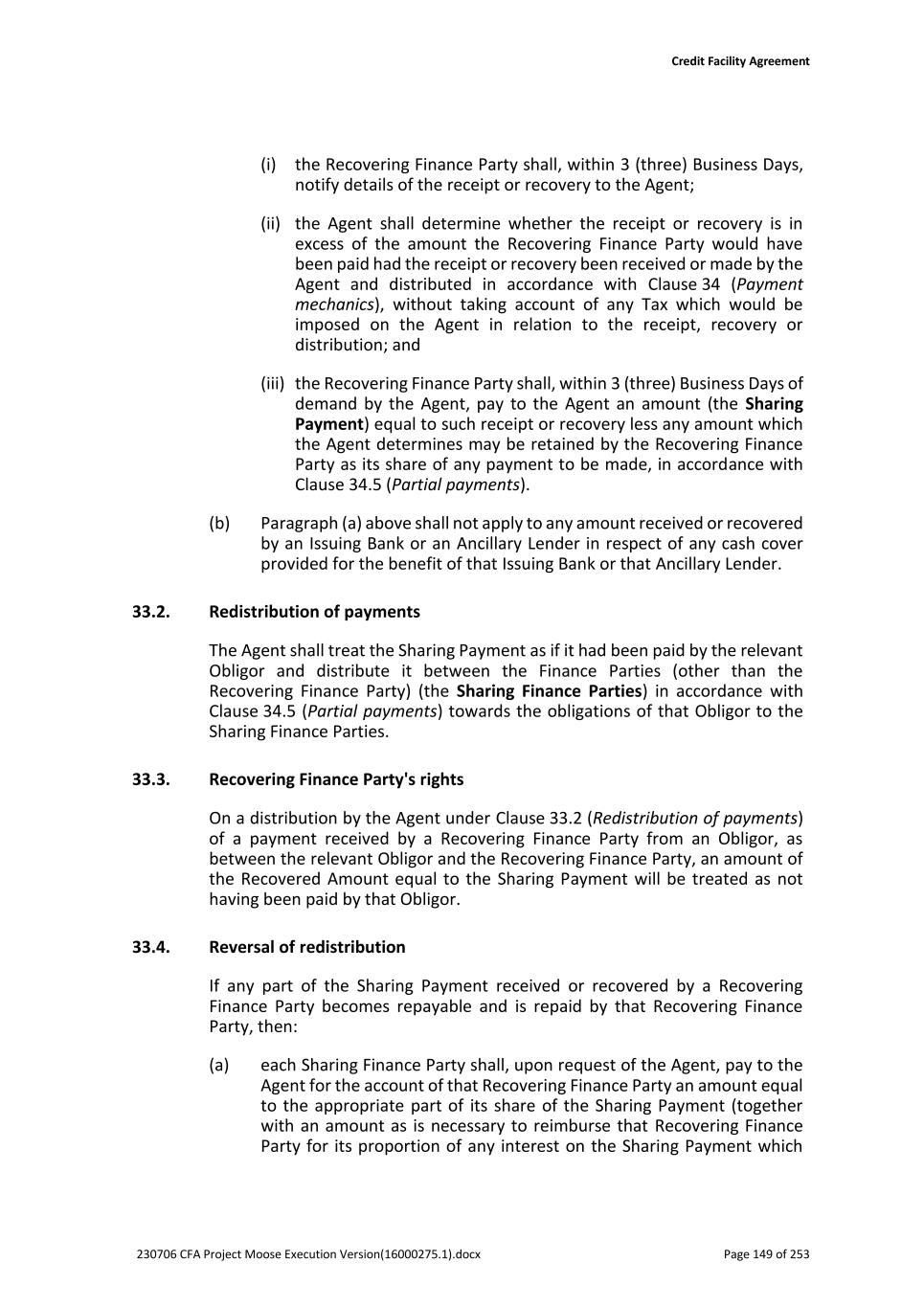
Credit Facility Agreement 230706 CFA Project Moose Execution Version(16000275.1).docx Page 149 of 253 (i) the Recovering Finance Party shall, within 3 (three) Business Days, notify details of the receipt or recovery to the Agent; (ii) the Agent shall determine whether the receipt or recovery is in excess of the amount the Recovering Finance Party would have been paid had the receipt or recovery been received or made by the Agent and distributed in accordance with Clause 34 (Payment mechanics), without taking account of any Tax which would be imposed on the Agent in relation to the receipt, recovery or distribution; and (iii) the Recovering Finance Party shall, within 3 (three) Business Days of demand by the Agent, pay to the Agent an amount (the Sharing Payment) equal to such receipt or recovery less any amount which the Agent determines may be retained by the Recovering Finance Party as its share of any payment to be made, in accordance with Clause 34.5 (Partial payments). (b) Paragraph (a) above shall not apply to any amount received or recovered by an Issuing Bank or an Ancillary Lender in respect of any cash cover provided for the benefit of that Issuing Bank or that Ancillary Lender. 33.2. Redistribution of payments The Agent shall treat the Sharing Payment as if it had been paid by the relevant Obligor and distribute it between the Finance Parties (other than the Recovering Finance Party) (the Sharing Finance Parties) in accordance with Clause 34.5 (Partial payments) towards the obligations of that Obligor to the Sharing Finance Parties. 33.3. Recovering Finance Party's rights On a distribution by the Agent under Clause 33.2 (Redistribution of payments) of a payment received by a Recovering Finance Party from an Obligor, as between the relevant Obligor and the Recovering Finance Party, an amount of the Recovered Amount equal to the Sharing Payment will be treated as not having been paid by that Obligor. 33.4. Reversal of redistribution If any part of the Sharing Payment received or recovered by a Recovering Finance Party becomes repayable and is repaid by that Recovering Finance Party, then: (a) each Sharing Finance Party shall, upon request of the Agent, pay to the Agent for the account of that Recovering Finance Party an amount equal to the appropriate part of its share of the Sharing Payment (together with an amount as is necessary to reimburse that Recovering Finance Party for its proportion of any interest on the Sharing Payment which
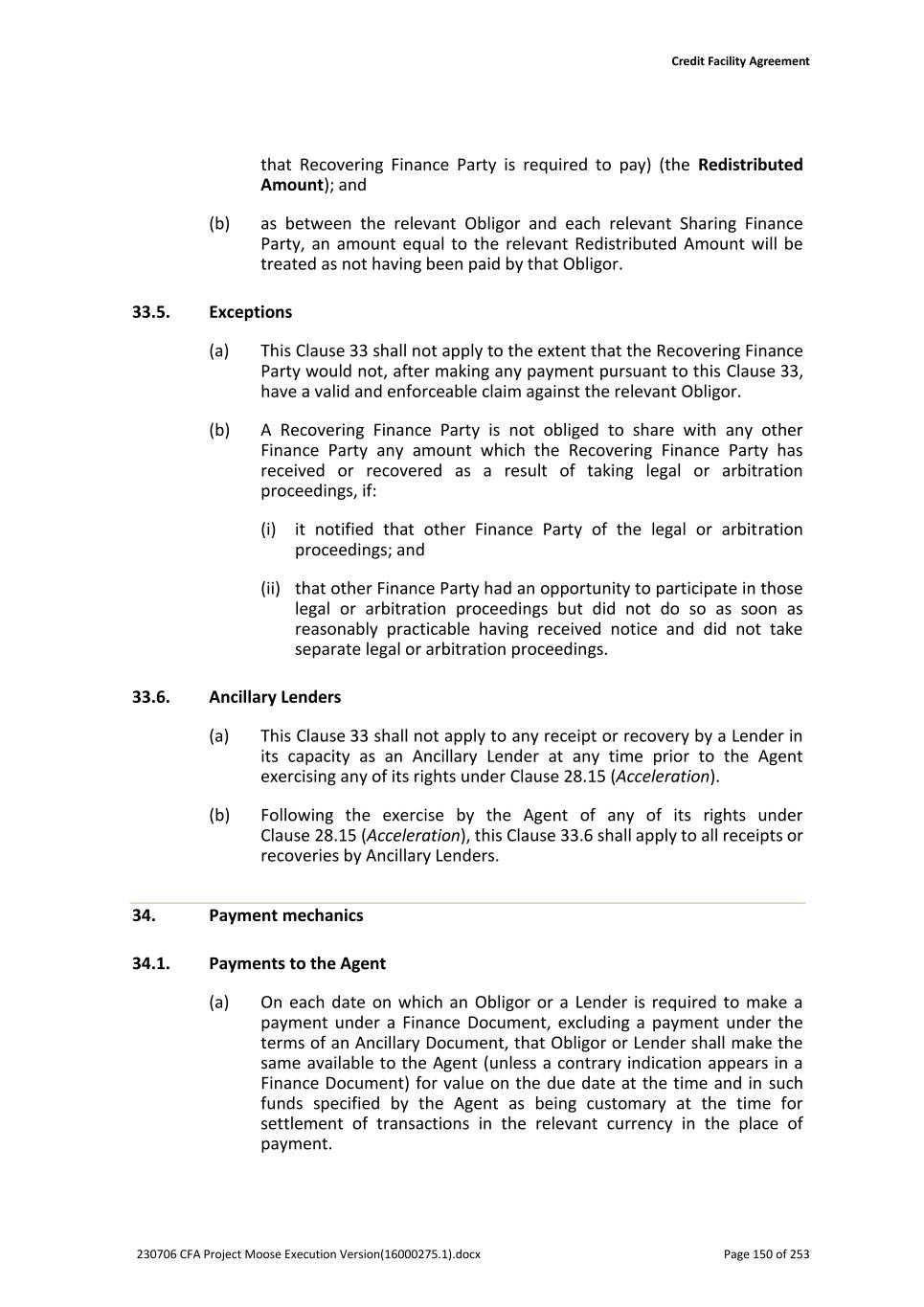
Credit Facility Agreement 230706 CFA Project Moose Execution Version(16000275.1).docx Page 150 of 253 that Recovering Finance Party is required to pay) (the Redistributed Amount); and (b) as between the relevant Obligor and each relevant Sharing Finance Party, an amount equal to the relevant Redistributed Amount will be treated as not having been paid by that Obligor. 33.5. Exceptions (a) This Clause 33 shall not apply to the extent that the Recovering Finance Party would not, after making any payment pursuant to this Clause 33, have a valid and enforceable claim against the relevant Obligor. (b) A Recovering Finance Party is not obliged to share with any other Finance Party any amount which the Recovering Finance Party has received or recovered as a result of taking legal or arbitration proceedings, if: (i) it notified that other Finance Party of the legal or arbitration proceedings; and (ii) that other Finance Party had an opportunity to participate in those legal or arbitration proceedings but did not do so as soon as reasonably practicable having received notice and did not take separate legal or arbitration proceedings. 33.6. Ancillary Lenders (a) This Clause 33 shall not apply to any receipt or recovery by a Lender in its capacity as an Ancillary Lender at any time prior to the Agent exercising any of its rights under Clause 28.15 (Acceleration). (b) Following the exercise by the Agent of any of its rights under Clause 28.15 (Acceleration), this Clause 33.6 shall apply to all receipts or recoveries by Ancillary Lenders. 34. Payment mechanics 34.1. Payments to the Agent (a) On each date on which an Obligor or a Lender is required to make a payment under a Finance Document, excluding a payment under the terms of an Ancillary Document, that Obligor or Lender shall make the same available to the Agent (unless a contrary indication appears in a Finance Document) for value on the due date at the time and in such funds specified by the Agent as being customary at the time for settlement of transactions in the relevant currency in the place of payment.
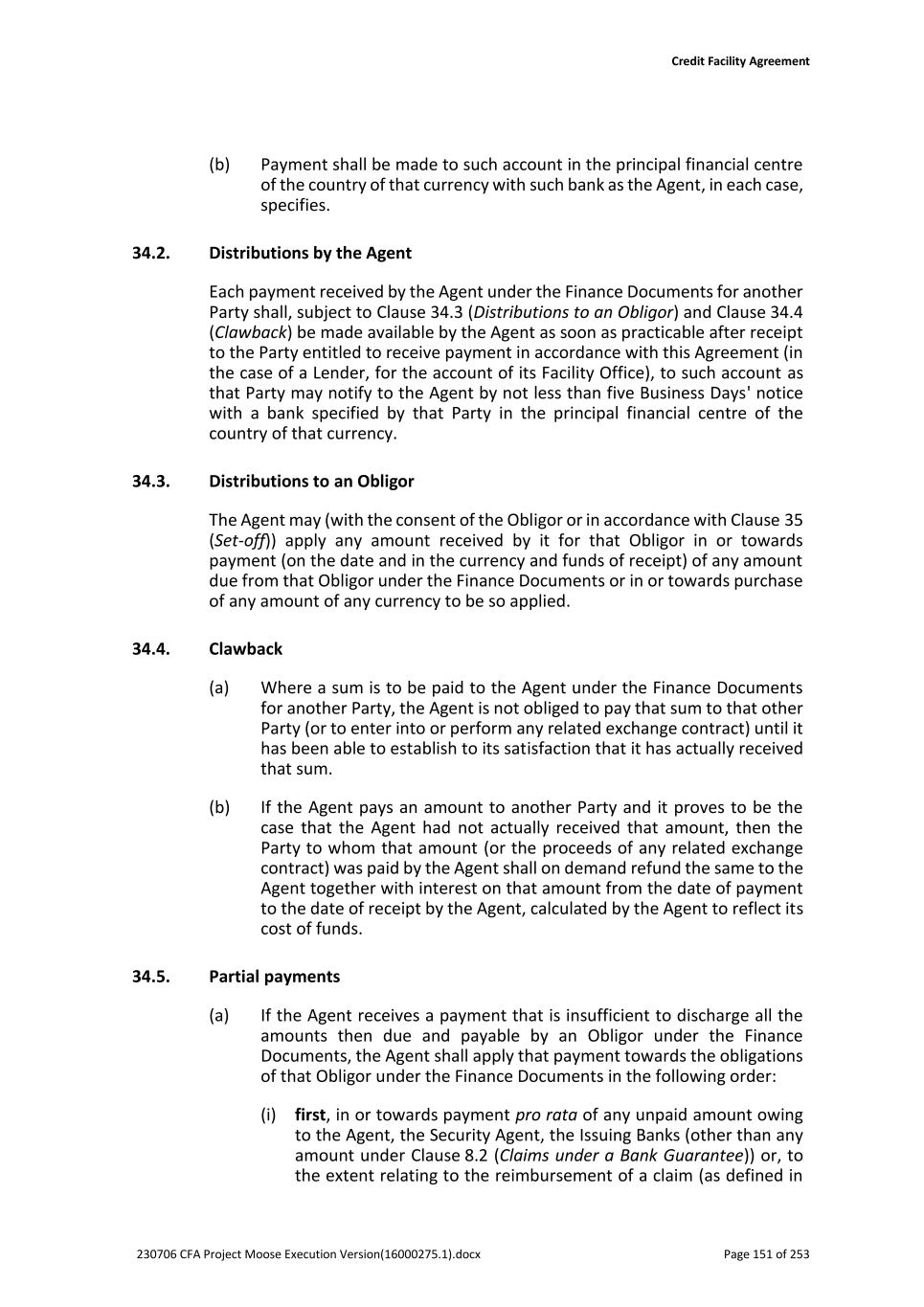
Credit Facility Agreement 230706 CFA Project Moose Execution Version(16000275.1).docx Page 151 of 253 (b) Payment shall be made to such account in the principal financial centre of the country of that currency with such bank as the Agent, in each case, specifies. 34.2. Distributions by the Agent Each payment received by the Agent under the Finance Documents for another Party shall, subject to Clause 34.3 (Distributions to an Obligor) and Clause 34.4 (Clawback) be made available by the Agent as soon as practicable after receipt to the Party entitled to receive payment in accordance with this Agreement (in the case of a Lender, for the account of its Facility Office), to such account as that Party may notify to the Agent by not less than five Business Days' notice with a bank specified by that Party in the principal financial centre of the country of that currency. 34.3. Distributions to an Obligor The Agent may (with the consent of the Obligor or in accordance with Clause 35 (Set-off)) apply any amount received by it for that Obligor in or towards payment (on the date and in the currency and funds of receipt) of any amount due from that Obligor under the Finance Documents or in or towards purchase of any amount of any currency to be so applied. 34.4. Clawback (a) Where a sum is to be paid to the Agent under the Finance Documents for another Party, the Agent is not obliged to pay that sum to that other Party (or to enter into or perform any related exchange contract) until it has been able to establish to its satisfaction that it has actually received that sum. (b) If the Agent pays an amount to another Party and it proves to be the case that the Agent had not actually received that amount, then the Party to whom that amount (or the proceeds of any related exchange contract) was paid by the Agent shall on demand refund the same to the Agent together with interest on that amount from the date of payment to the date of receipt by the Agent, calculated by the Agent to reflect its cost of funds. 34.5. Partial payments (a) If the Agent receives a payment that is insufficient to discharge all the amounts then due and payable by an Obligor under the Finance Documents, the Agent shall apply that payment towards the obligations of that Obligor under the Finance Documents in the following order: (i) first, in or towards payment pro rata of any unpaid amount owing to the Agent, the Security Agent, the Issuing Banks (other than any amount under Clause 8.2 (Claims under a Bank Guarantee)) or, to the extent relating to the reimbursement of a claim (as defined in
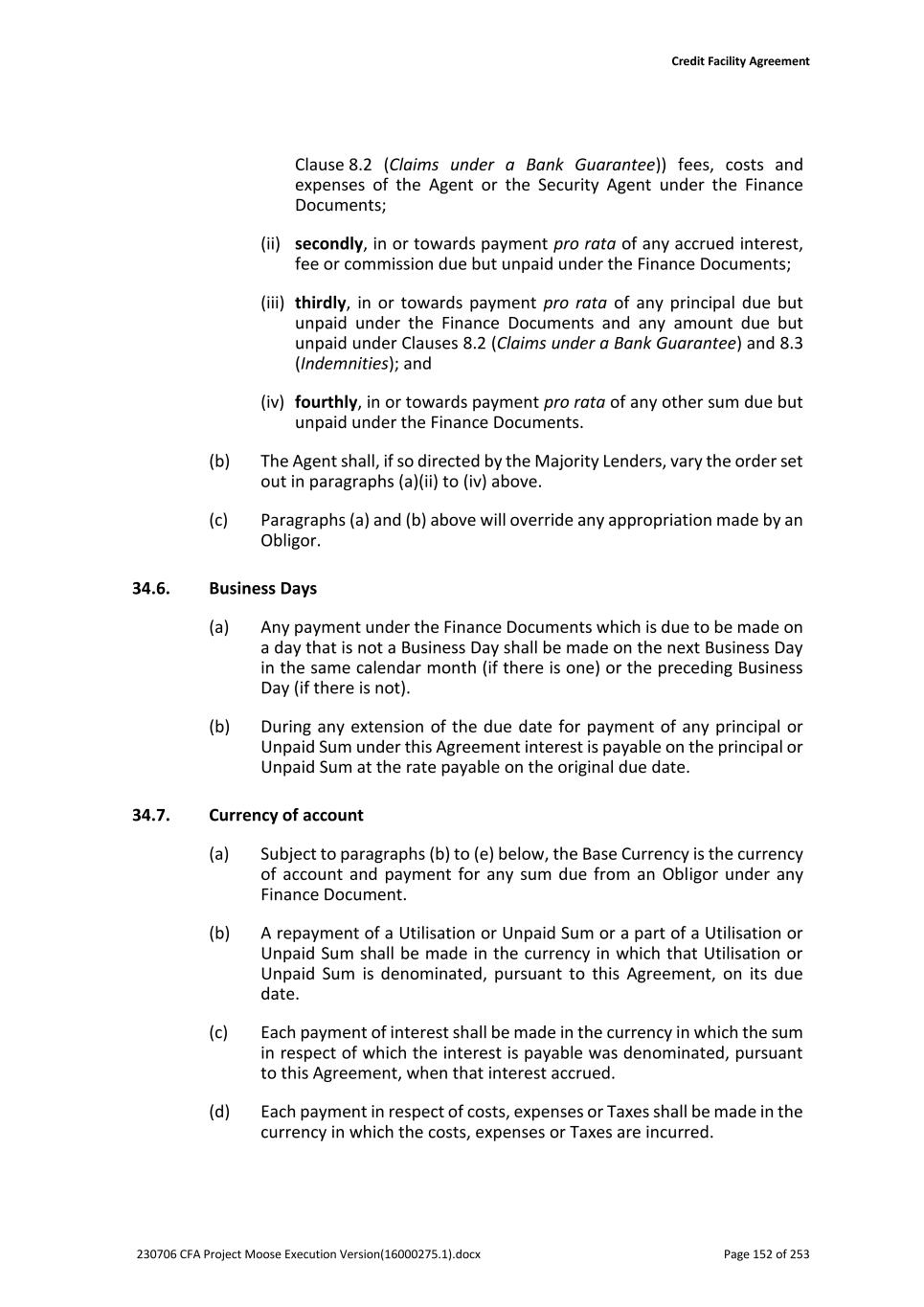
Credit Facility Agreement 230706 CFA Project Moose Execution Version(16000275.1).docx Page 152 of 253 Clause 8.2 (Claims under a Bank Guarantee)) fees, costs and expenses of the Agent or the Security Agent under the Finance Documents; (ii) secondly, in or towards payment pro rata of any accrued interest, fee or commission due but unpaid under the Finance Documents; (iii) thirdly, in or towards payment pro rata of any principal due but unpaid under the Finance Documents and any amount due but unpaid under Clauses 8.2 (Claims under a Bank Guarantee) and 8.3 (Indemnities); and (iv) fourthly, in or towards payment pro rata of any other sum due but unpaid under the Finance Documents. (b) The Agent shall, if so directed by the Majority Lenders, vary the order set out in paragraphs (a)(ii) to (iv) above. (c) Paragraphs (a) and (b) above will override any appropriation made by an Obligor. 34.6. Business Days (a) Any payment under the Finance Documents which is due to be made on a day that is not a Business Day shall be made on the next Business Day in the same calendar month (if there is one) or the preceding Business Day (if there is not). (b) During any extension of the due date for payment of any principal or Unpaid Sum under this Agreement interest is payable on the principal or Unpaid Sum at the rate payable on the original due date. 34.7. Currency of account (a) Subject to paragraphs (b) to (e) below, the Base Currency is the currency of account and payment for any sum due from an Obligor under any Finance Document. (b) A repayment of a Utilisation or Unpaid Sum or a part of a Utilisation or Unpaid Sum shall be made in the currency in which that Utilisation or Unpaid Sum is denominated, pursuant to this Agreement, on its due date. (c) Each payment of interest shall be made in the currency in which the sum in respect of which the interest is payable was denominated, pursuant to this Agreement, when that interest accrued. (d) Each payment in respect of costs, expenses or Taxes shall be made in the currency in which the costs, expenses or Taxes are incurred.
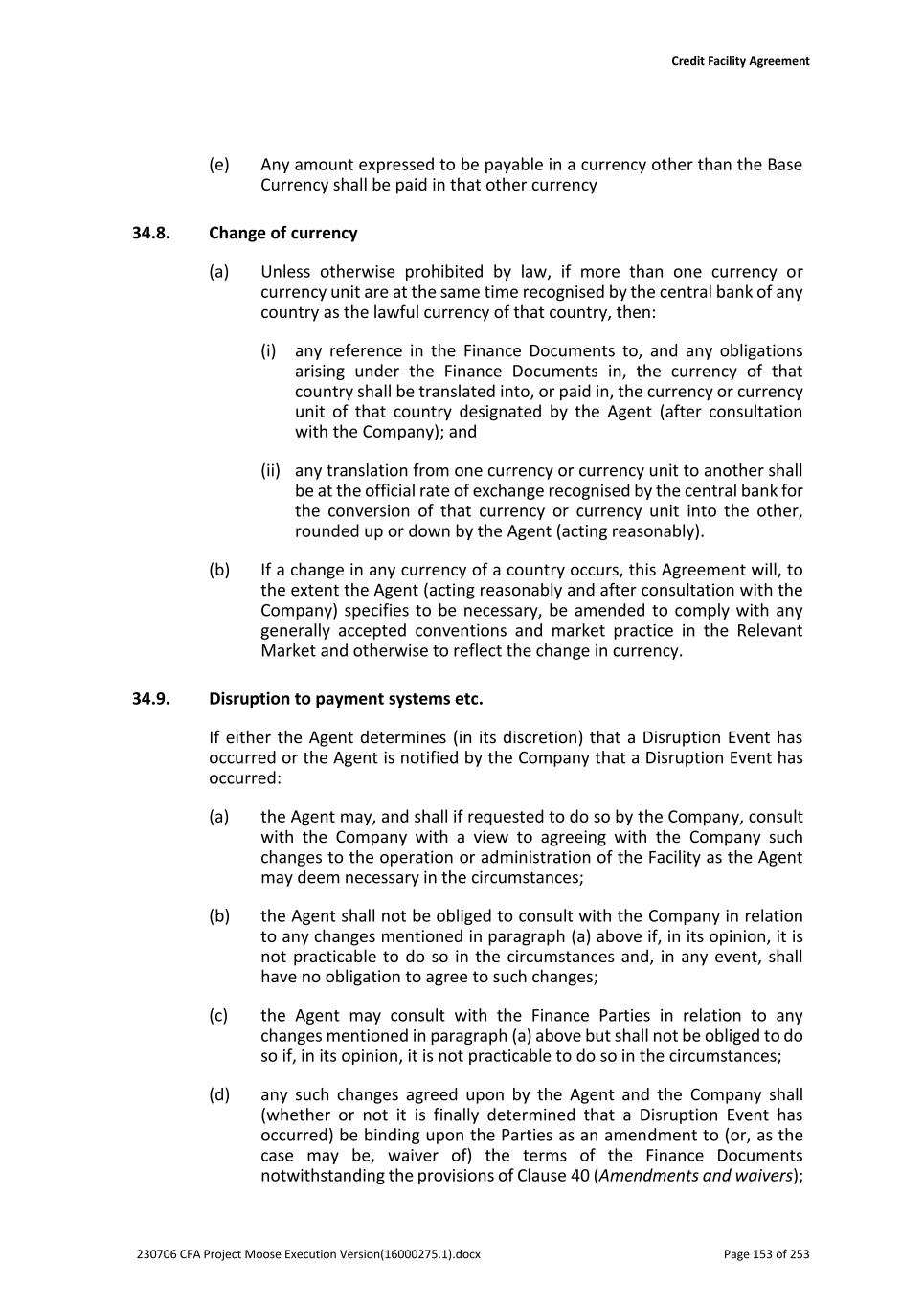
Credit Facility Agreement 230706 CFA Project Moose Execution Version(16000275.1).docx Page 153 of 253 (e) Any amount expressed to be payable in a currency other than the Base Currency shall be paid in that other currency 34.8. Change of currency (a) Unless otherwise prohibited by law, if more than one currency or currency unit are at the same time recognised by the central bank of any country as the lawful currency of that country, then: (i) any reference in the Finance Documents to, and any obligations arising under the Finance Documents in, the currency of that country shall be translated into, or paid in, the currency or currency unit of that country designated by the Agent (after consultation with the Company); and (ii) any translation from one currency or currency unit to another shall be at the official rate of exchange recognised by the central bank for the conversion of that currency or currency unit into the other, rounded up or down by the Agent (acting reasonably). (b) If a change in any currency of a country occurs, this Agreement will, to the extent the Agent (acting reasonably and after consultation with the Company) specifies to be necessary, be amended to comply with any generally accepted conventions and market practice in the Relevant Market and otherwise to reflect the change in currency. 34.9. Disruption to payment systems etc. If either the Agent determines (in its discretion) that a Disruption Event has occurred or the Agent is notified by the Company that a Disruption Event has occurred: (a) the Agent may, and shall if requested to do so by the Company, consult with the Company with a view to agreeing with the Company such changes to the operation or administration of the Facility as the Agent may deem necessary in the circumstances; (b) the Agent shall not be obliged to consult with the Company in relation to any changes mentioned in paragraph (a) above if, in its opinion, it is not practicable to do so in the circumstances and, in any event, shall have no obligation to agree to such changes; (c) the Agent may consult with the Finance Parties in relation to any changes mentioned in paragraph (a) above but shall not be obliged to do so if, in its opinion, it is not practicable to do so in the circumstances; (d) any such changes agreed upon by the Agent and the Company shall (whether or not it is finally determined that a Disruption Event has occurred) be binding upon the Parties as an amendment to (or, as the case may be, waiver of) the terms of the Finance Documents notwithstanding the provisions of Clause 40 (Amendments and waivers);
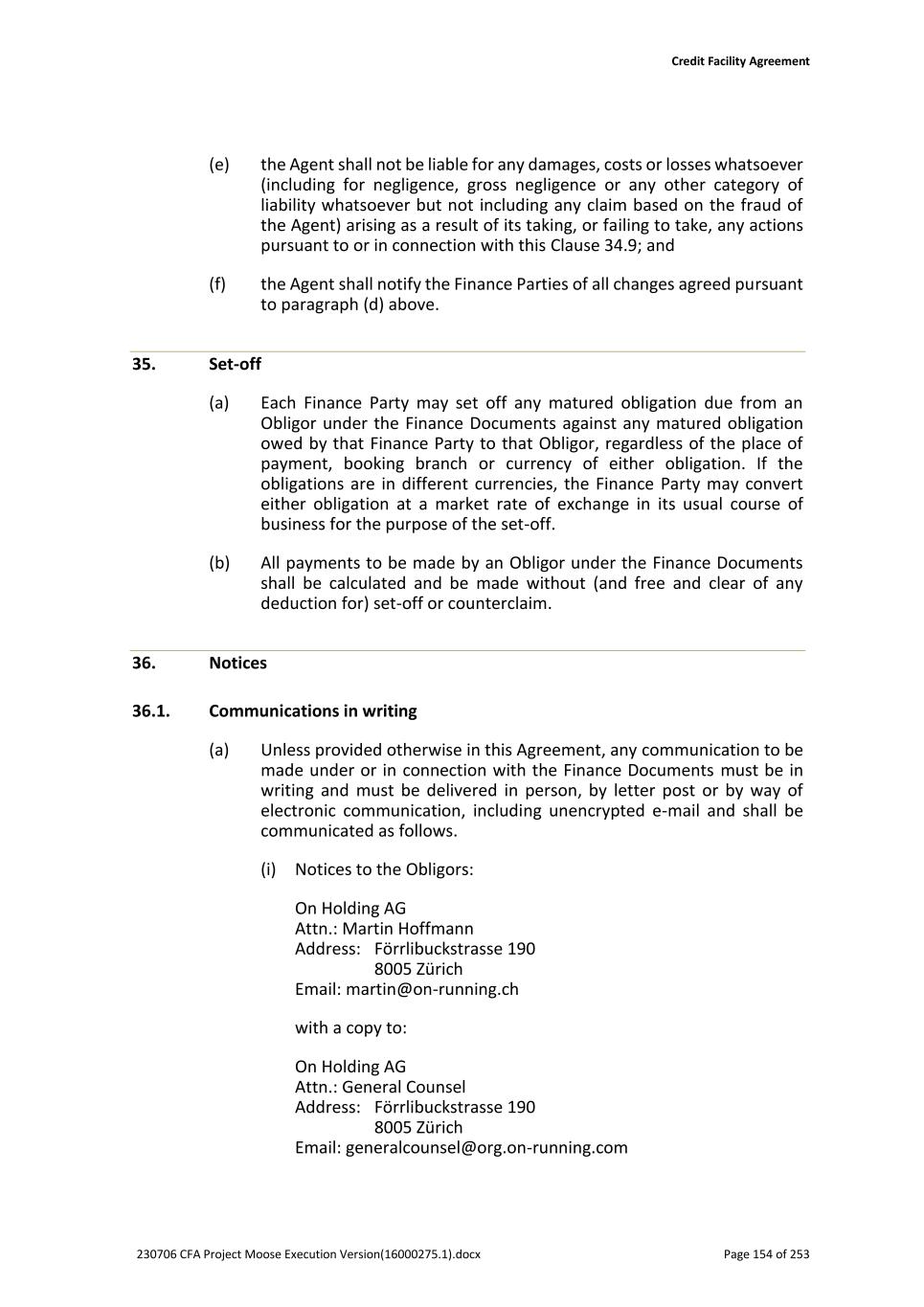
Credit Facility Agreement 230706 CFA Project Moose Execution Version(16000275.1).docx Page 154 of 253 (e) the Agent shall not be liable for any damages, costs or losses whatsoever (including for negligence, gross negligence or any other category of liability whatsoever but not including any claim based on the fraud of the Agent) arising as a result of its taking, or failing to take, any actions pursuant to or in connection with this Clause 34.9; and (f) the Agent shall notify the Finance Parties of all changes agreed pursuant to paragraph (d) above. 35. Set-off (a) Each Finance Party may set off any matured obligation due from an Obligor under the Finance Documents against any matured obligation owed by that Finance Party to that Obligor, regardless of the place of payment, booking branch or currency of either obligation. If the obligations are in different currencies, the Finance Party may convert either obligation at a market rate of exchange in its usual course of business for the purpose of the set-off. (b) All payments to be made by an Obligor under the Finance Documents shall be calculated and be made without (and free and clear of any deduction for) set-off or counterclaim. 36. Notices 36.1. Communications in writing (a) Unless provided otherwise in this Agreement, any communication to be made under or in connection with the Finance Documents must be in writing and must be delivered in person, by letter post or by way of electronic communication, including unencrypted e-mail and shall be communicated as follows. (i) Notices to the Obligors: On Holding AG Attn.: Martin Hoffmann Address: Förrlibuckstrasse 190 8005 Zürich Email: martin@on-running.ch with a copy to: On Holding AG Attn.: General Counsel Address: Förrlibuckstrasse 190 8005 Zürich Email: generalcounsel@org.on-running.com
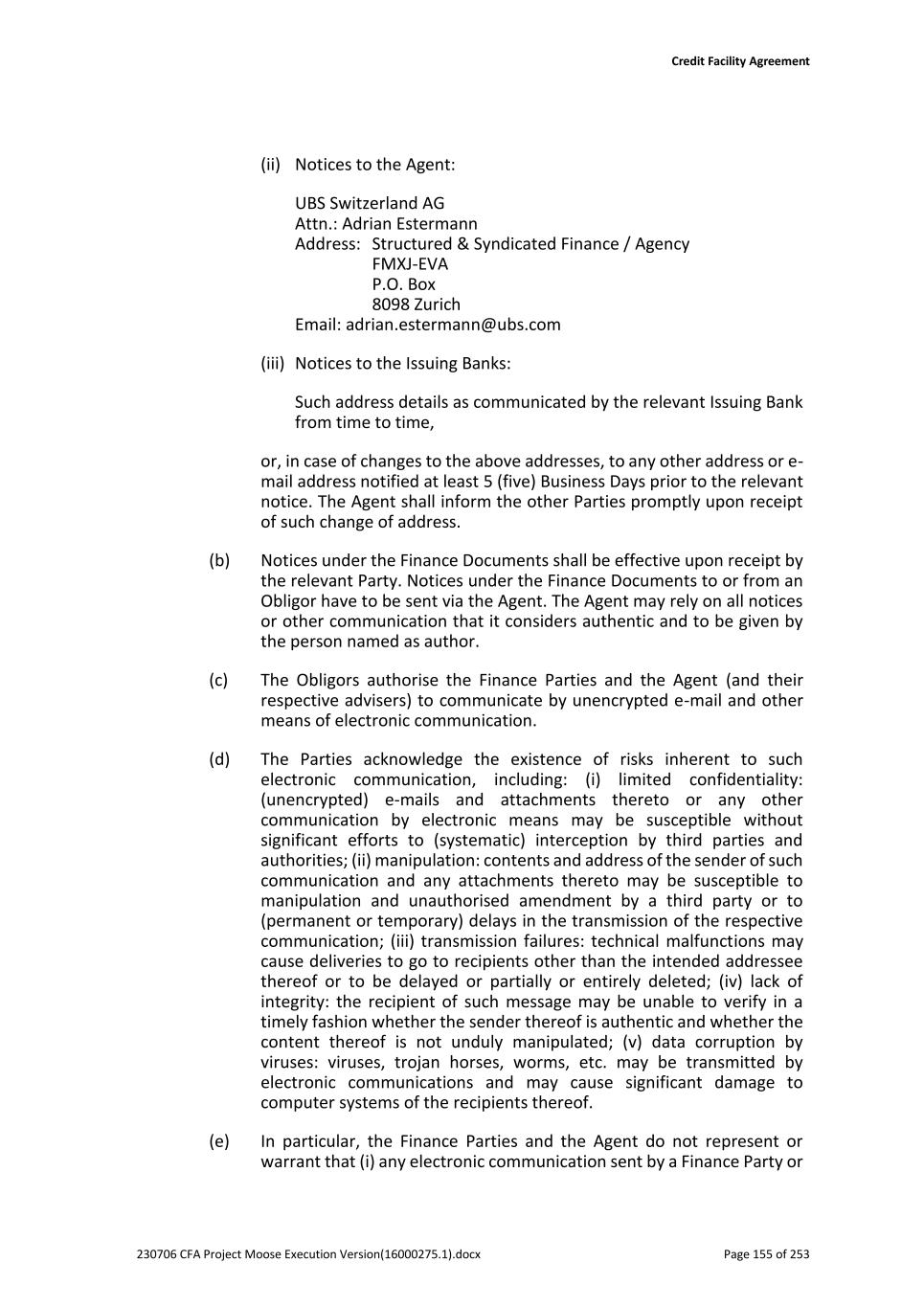
Credit Facility Agreement 230706 CFA Project Moose Execution Version(16000275.1).docx Page 155 of 253 (ii) Notices to the Agent: UBS Switzerland AG Attn.: Adrian Estermann Address: Structured & Syndicated Finance / Agency FMXJ-EVA P.O. Box 8098 Zurich Email: adrian.estermann@ubs.com (iii) Notices to the Issuing Banks: Such address details as communicated by the relevant Issuing Bank from time to time, or, in case of changes to the above addresses, to any other address or e- mail address notified at least 5 (five) Business Days prior to the relevant notice. The Agent shall inform the other Parties promptly upon receipt of such change of address. (b) Notices under the Finance Documents shall be effective upon receipt by the relevant Party. Notices under the Finance Documents to or from an Obligor have to be sent via the Agent. The Agent may rely on all notices or other communication that it considers authentic and to be given by the person named as author. (c) The Obligors authorise the Finance Parties and the Agent (and their respective advisers) to communicate by unencrypted e-mail and other means of electronic communication. (d) The Parties acknowledge the existence of risks inherent to such electronic communication, including: (i) limited confidentiality: (unencrypted) e-mails and attachments thereto or any other communication by electronic means may be susceptible without significant efforts to (systematic) interception by third parties and authorities; (ii) manipulation: contents and address of the sender of such communication and any attachments thereto may be susceptible to manipulation and unauthorised amendment by a third party or to (permanent or temporary) delays in the transmission of the respective communication; (iii) transmission failures: technical malfunctions may cause deliveries to go to recipients other than the intended addressee thereof or to be delayed or partially or entirely deleted; (iv) lack of integrity: the recipient of such message may be unable to verify in a timely fashion whether the sender thereof is authentic and whether the content thereof is not unduly manipulated; (v) data corruption by viruses: viruses, trojan horses, worms, etc. may be transmitted by electronic communications and may cause significant damage to computer systems of the recipients thereof. (e) In particular, the Finance Parties and the Agent do not represent or warrant that (i) any electronic communication sent by a Finance Party or
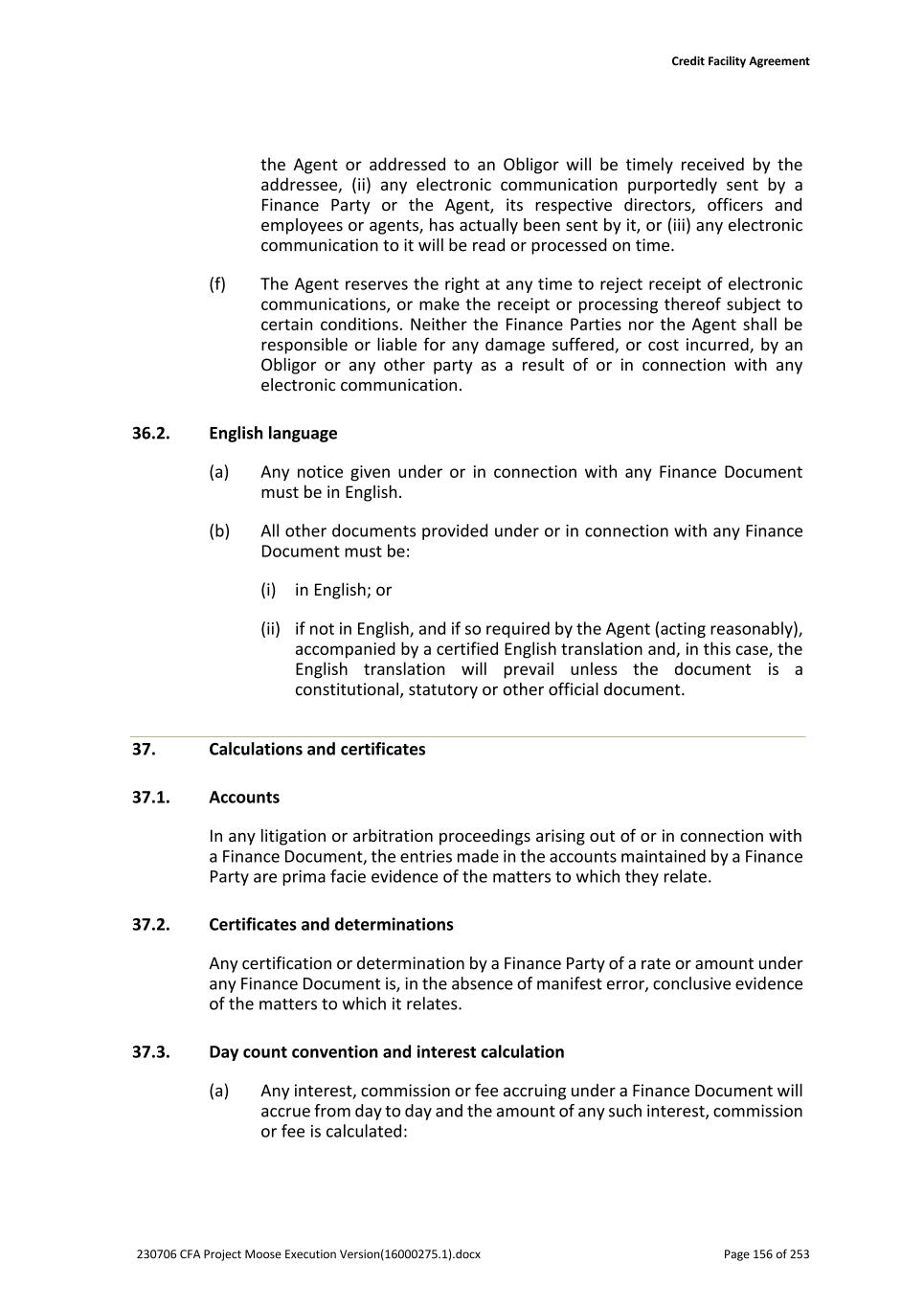
Credit Facility Agreement 230706 CFA Project Moose Execution Version(16000275.1).docx Page 156 of 253 the Agent or addressed to an Obligor will be timely received by the addressee, (ii) any electronic communication purportedly sent by a Finance Party or the Agent, its respective directors, officers and employees or agents, has actually been sent by it, or (iii) any electronic communication to it will be read or processed on time. (f) The Agent reserves the right at any time to reject receipt of electronic communications, or make the receipt or processing thereof subject to certain conditions. Neither the Finance Parties nor the Agent shall be responsible or liable for any damage suffered, or cost incurred, by an Obligor or any other party as a result of or in connection with any electronic communication. 36.2. English language (a) Any notice given under or in connection with any Finance Document must be in English. (b) All other documents provided under or in connection with any Finance Document must be: (i) in English; or (ii) if not in English, and if so required by the Agent (acting reasonably), accompanied by a certified English translation and, in this case, the English translation will prevail unless the document is a constitutional, statutory or other official document. 37. Calculations and certificates 37.1. Accounts In any litigation or arbitration proceedings arising out of or in connection with a Finance Document, the entries made in the accounts maintained by a Finance Party are prima facie evidence of the matters to which they relate. 37.2. Certificates and determinations Any certification or determination by a Finance Party of a rate or amount under any Finance Document is, in the absence of manifest error, conclusive evidence of the matters to which it relates. 37.3. Day count convention and interest calculation (a) Any interest, commission or fee accruing under a Finance Document will accrue from day to day and the amount of any such interest, commission or fee is calculated:
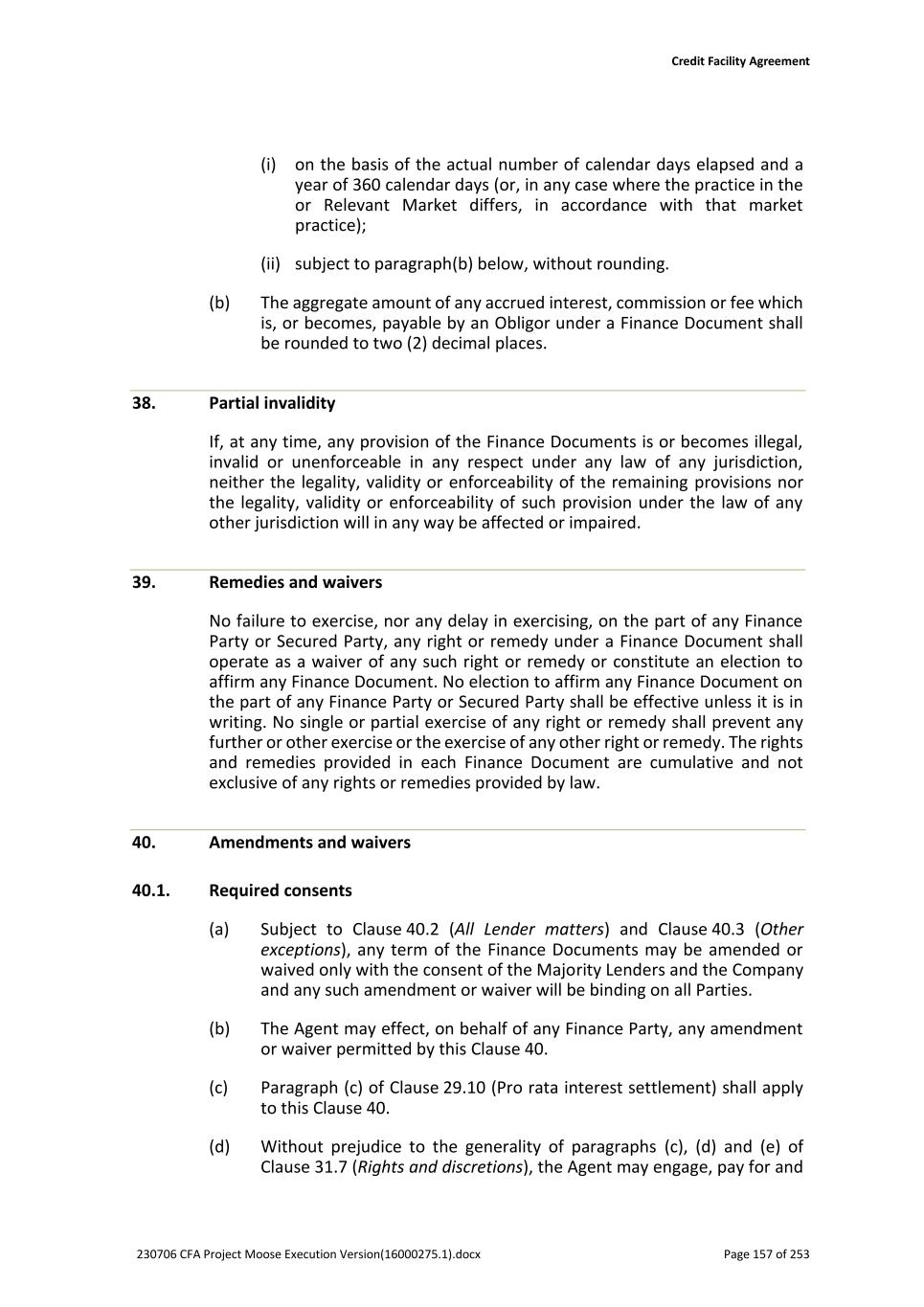
Credit Facility Agreement 230706 CFA Project Moose Execution Version(16000275.1).docx Page 157 of 253 (i) on the basis of the actual number of calendar days elapsed and a year of 360 calendar days (or, in any case where the practice in the or Relevant Market differs, in accordance with that market practice); (ii) subject to paragraph(b) below, without rounding. (b) The aggregate amount of any accrued interest, commission or fee which is, or becomes, payable by an Obligor under a Finance Document shall be rounded to two (2) decimal places. 38. Partial invalidity If, at any time, any provision of the Finance Documents is or becomes illegal, invalid or unenforceable in any respect under any law of any jurisdiction, neither the legality, validity or enforceability of the remaining provisions nor the legality, validity or enforceability of such provision under the law of any other jurisdiction will in any way be affected or impaired. 39. Remedies and waivers No failure to exercise, nor any delay in exercising, on the part of any Finance Party or Secured Party, any right or remedy under a Finance Document shall operate as a waiver of any such right or remedy or constitute an election to affirm any Finance Document. No election to affirm any Finance Document on the part of any Finance Party or Secured Party shall be effective unless it is in writing. No single or partial exercise of any right or remedy shall prevent any further or other exercise or the exercise of any other right or remedy. The rights and remedies provided in each Finance Document are cumulative and not exclusive of any rights or remedies provided by law. 40. Amendments and waivers 40.1. Required consents (a) Subject to Clause 40.2 (All Lender matters) and Clause 40.3 (Other exceptions), any term of the Finance Documents may be amended or waived only with the consent of the Majority Lenders and the Company and any such amendment or waiver will be binding on all Parties. (b) The Agent may effect, on behalf of any Finance Party, any amendment or waiver permitted by this Clause 40. (c) Paragraph (c) of Clause 29.10 (Pro rata interest settlement) shall apply to this Clause 40. (d) Without prejudice to the generality of paragraphs (c), (d) and (e) of Clause 31.7 (Rights and discretions), the Agent may engage, pay for and
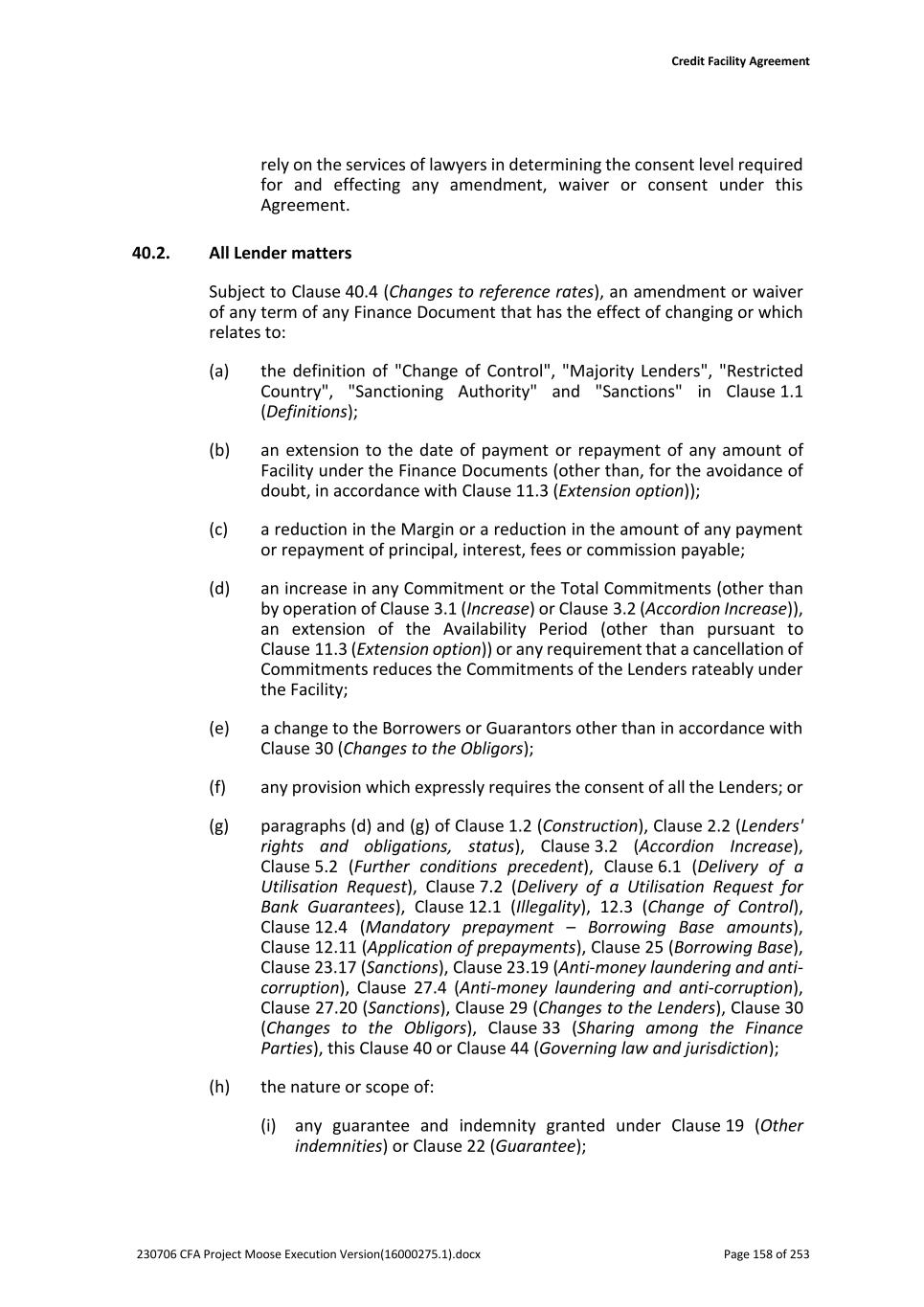
Credit Facility Agreement 230706 CFA Project Moose Execution Version(16000275.1).docx Page 158 of 253 rely on the services of lawyers in determining the consent level required for and effecting any amendment, waiver or consent under this Agreement. 40.2. All Lender matters Subject to Clause 40.4 (Changes to reference rates), an amendment or waiver of any term of any Finance Document that has the effect of changing or which relates to: (a) the definition of "Change of Control", "Majority Lenders", "Restricted Country", "Sanctioning Authority" and "Sanctions" in Clause 1.1 (Definitions); (b) an extension to the date of payment or repayment of any amount of Facility under the Finance Documents (other than, for the avoidance of doubt, in accordance with Clause 11.3 (Extension option)); (c) a reduction in the Margin or a reduction in the amount of any payment or repayment of principal, interest, fees or commission payable; (d) an increase in any Commitment or the Total Commitments (other than by operation of Clause 3.1 (Increase) or Clause 3.2 (Accordion Increase)), an extension of the Availability Period (other than pursuant to Clause 11.3 (Extension option)) or any requirement that a cancellation of Commitments reduces the Commitments of the Lenders rateably under the Facility; (e) a change to the Borrowers or Guarantors other than in accordance with Clause 30 (Changes to the Obligors); (f) any provision which expressly requires the consent of all the Lenders; or (g) paragraphs (d) and (g) of Clause 1.2 (Construction), Clause 2.2 (Lenders' rights and obligations, status), Clause 3.2 (Accordion Increase), Clause 5.2 (Further conditions precedent), Clause 6.1 (Delivery of a Utilisation Request), Clause 7.2 (Delivery of a Utilisation Request for Bank Guarantees), Clause 12.1 (Illegality), 12.3 (Change of Control), Clause 12.4 (Mandatory prepayment – Borrowing Base amounts), Clause 12.11 (Application of prepayments), Clause 25 (Borrowing Base), Clause 23.17 (Sanctions), Clause 23.19 (Anti-money laundering and anti- corruption), Clause 27.4 (Anti-money laundering and anti-corruption), Clause 27.20 (Sanctions), Clause 29 (Changes to the Lenders), Clause 30 (Changes to the Obligors), Clause 33 (Sharing among the Finance Parties), this Clause 40 or Clause 44 (Governing law and jurisdiction); (h) the nature or scope of: (i) any guarantee and indemnity granted under Clause 19 (Other indemnities) or Clause 22 (Guarantee);
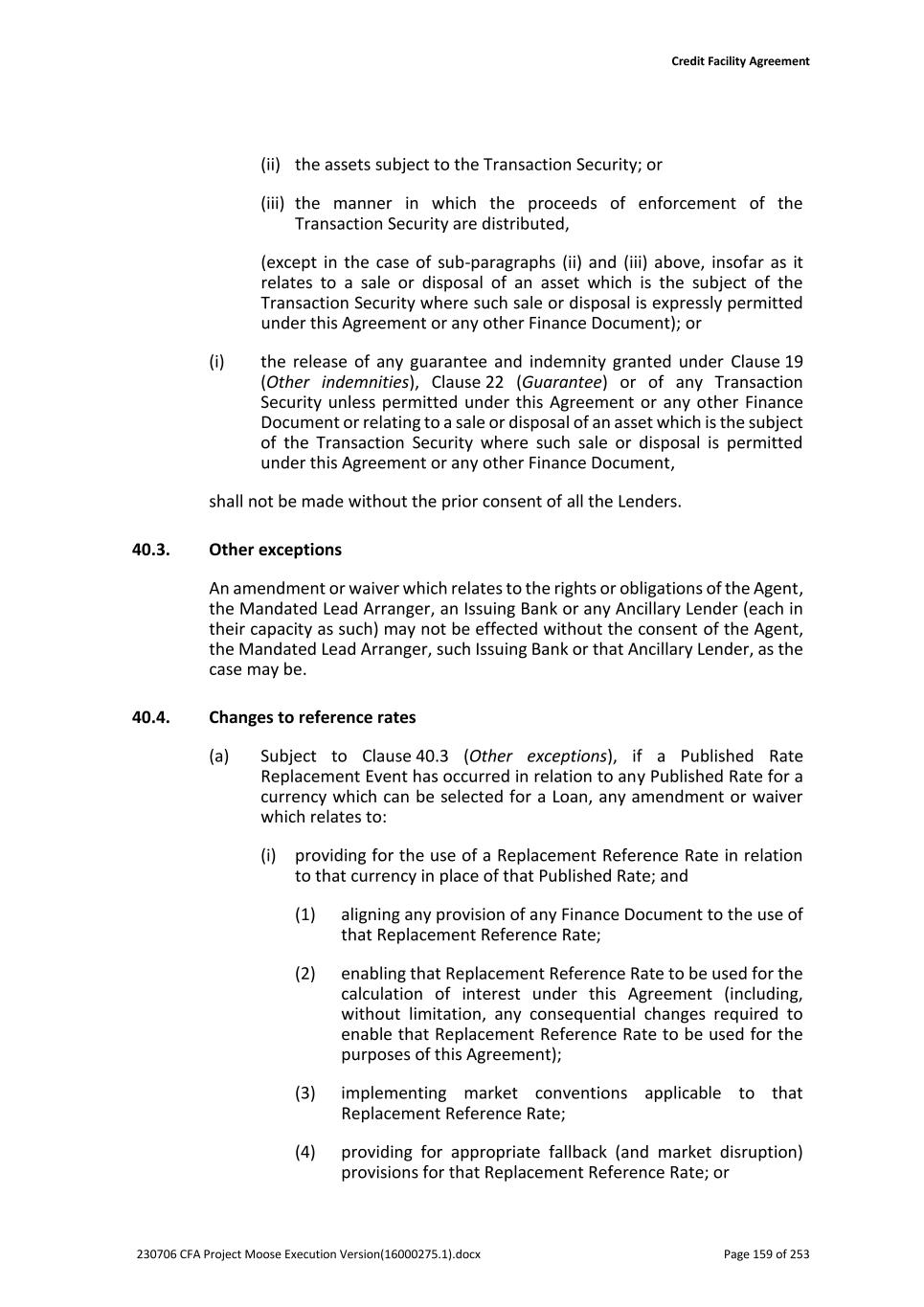
Credit Facility Agreement 230706 CFA Project Moose Execution Version(16000275.1).docx Page 159 of 253 (ii) the assets subject to the Transaction Security; or (iii) the manner in which the proceeds of enforcement of the Transaction Security are distributed, (except in the case of sub-paragraphs (ii) and (iii) above, insofar as it relates to a sale or disposal of an asset which is the subject of the Transaction Security where such sale or disposal is expressly permitted under this Agreement or any other Finance Document); or (i) the release of any guarantee and indemnity granted under Clause 19 (Other indemnities), Clause 22 (Guarantee) or of any Transaction Security unless permitted under this Agreement or any other Finance Document or relating to a sale or disposal of an asset which is the subject of the Transaction Security where such sale or disposal is permitted under this Agreement or any other Finance Document, shall not be made without the prior consent of all the Lenders. 40.3. Other exceptions An amendment or waiver which relates to the rights or obligations of the Agent, the Mandated Lead Arranger, an Issuing Bank or any Ancillary Lender (each in their capacity as such) may not be effected without the consent of the Agent, the Mandated Lead Arranger, such Issuing Bank or that Ancillary Lender, as the case may be. 40.4. Changes to reference rates (a) Subject to Clause 40.3 (Other exceptions), if a Published Rate Replacement Event has occurred in relation to any Published Rate for a currency which can be selected for a Loan, any amendment or waiver which relates to: (i) providing for the use of a Replacement Reference Rate in relation to that currency in place of that Published Rate; and (1) aligning any provision of any Finance Document to the use of that Replacement Reference Rate; (2) enabling that Replacement Reference Rate to be used for the calculation of interest under this Agreement (including, without limitation, any consequential changes required to enable that Replacement Reference Rate to be used for the purposes of this Agreement); (3) implementing market conventions applicable to that Replacement Reference Rate; (4) providing for appropriate fallback (and market disruption) provisions for that Replacement Reference Rate; or
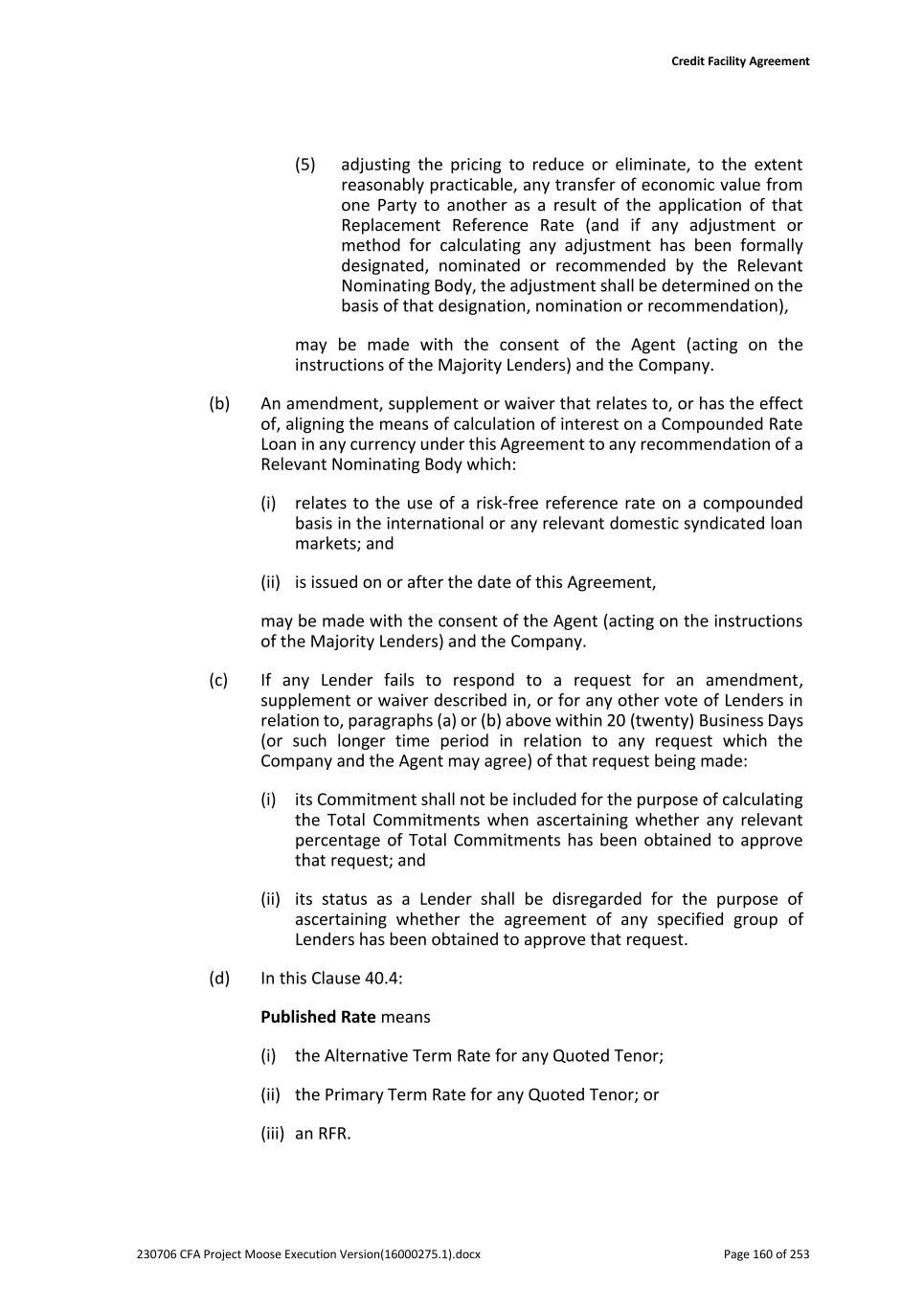
Credit Facility Agreement 230706 CFA Project Moose Execution Version(16000275.1).docx Page 160 of 253 (5) adjusting the pricing to reduce or eliminate, to the extent reasonably practicable, any transfer of economic value from one Party to another as a result of the application of that Replacement Reference Rate (and if any adjustment or method for calculating any adjustment has been formally designated, nominated or recommended by the Relevant Nominating Body, the adjustment shall be determined on the basis of that designation, nomination or recommendation), may be made with the consent of the Agent (acting on the instructions of the Majority Lenders) and the Company. (b) An amendment, supplement or waiver that relates to, or has the effect of, aligning the means of calculation of interest on a Compounded Rate Loan in any currency under this Agreement to any recommendation of a Relevant Nominating Body which: (i) relates to the use of a risk-free reference rate on a compounded basis in the international or any relevant domestic syndicated loan markets; and (ii) is issued on or after the date of this Agreement, may be made with the consent of the Agent (acting on the instructions of the Majority Lenders) and the Company. (c) If any Lender fails to respond to a request for an amendment, supplement or waiver described in, or for any other vote of Lenders in relation to, paragraphs (a) or (b) above within 20 (twenty) Business Days (or such longer time period in relation to any request which the Company and the Agent may agree) of that request being made: (i) its Commitment shall not be included for the purpose of calculating the Total Commitments when ascertaining whether any relevant percentage of Total Commitments has been obtained to approve that request; and (ii) its status as a Lender shall be disregarded for the purpose of ascertaining whether the agreement of any specified group of Lenders has been obtained to approve that request. (d) In this Clause 40.4: Published Rate means (i) the Alternative Term Rate for any Quoted Tenor; (ii) the Primary Term Rate for any Quoted Tenor; or (iii) an RFR.
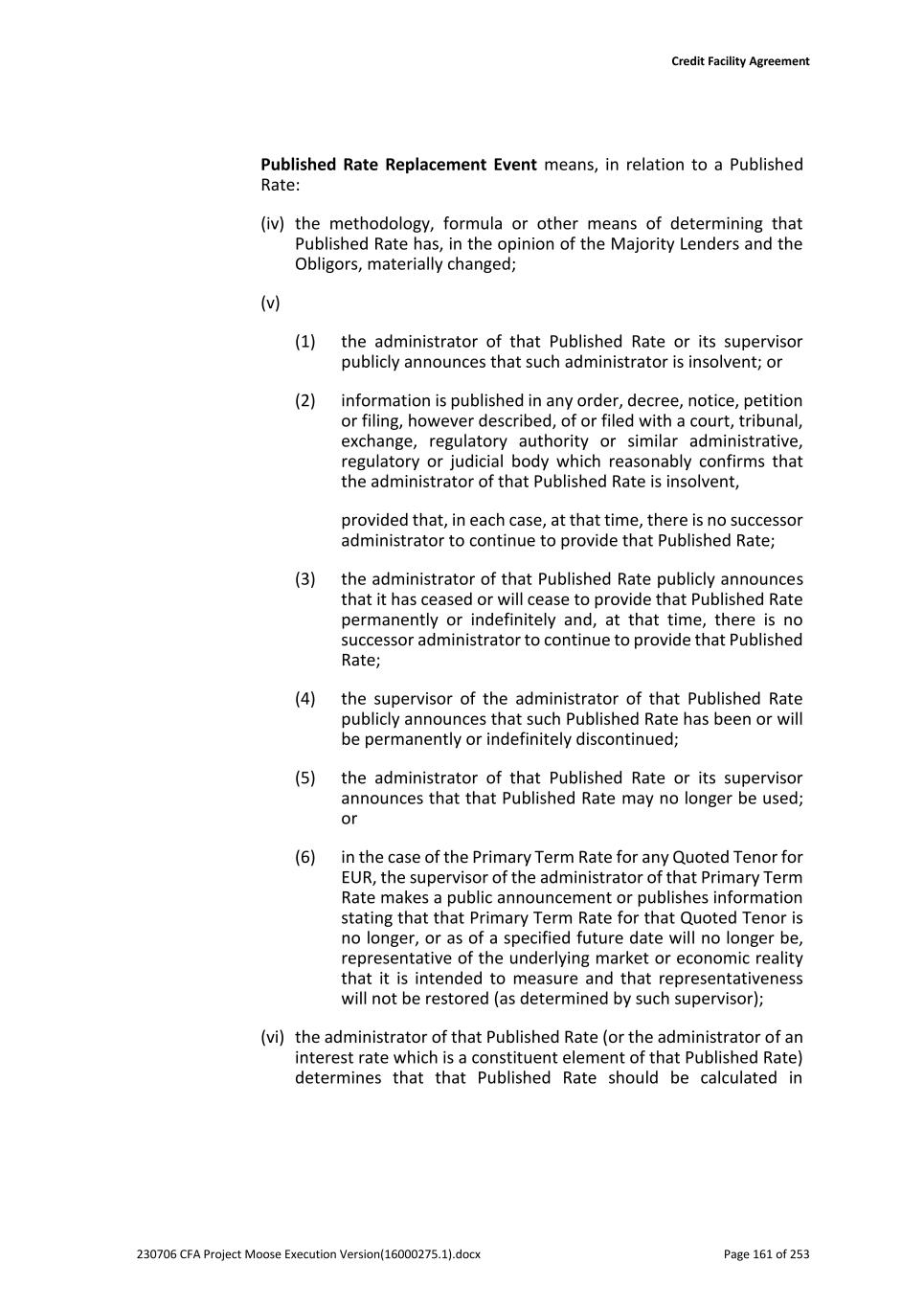
Credit Facility Agreement 230706 CFA Project Moose Execution Version(16000275.1).docx Page 161 of 253 Published Rate Replacement Event means, in relation to a Published Rate: (iv) the methodology, formula or other means of determining that Published Rate has, in the opinion of the Majority Lenders and the Obligors, materially changed; (v) (1) the administrator of that Published Rate or its supervisor publicly announces that such administrator is insolvent; or (2) information is published in any order, decree, notice, petition or filing, however described, of or filed with a court, tribunal, exchange, regulatory authority or similar administrative, regulatory or judicial body which reasonably confirms that the administrator of that Published Rate is insolvent, provided that, in each case, at that time, there is no successor administrator to continue to provide that Published Rate; (3) the administrator of that Published Rate publicly announces that it has ceased or will cease to provide that Published Rate permanently or indefinitely and, at that time, there is no successor administrator to continue to provide that Published Rate; (4) the supervisor of the administrator of that Published Rate publicly announces that such Published Rate has been or will be permanently or indefinitely discontinued; (5) the administrator of that Published Rate or its supervisor announces that that Published Rate may no longer be used; or (6) in the case of the Primary Term Rate for any Quoted Tenor for EUR, the supervisor of the administrator of that Primary Term Rate makes a public announcement or publishes information stating that that Primary Term Rate for that Quoted Tenor is no longer, or as of a specified future date will no longer be, representative of the underlying market or economic reality that it is intended to measure and that representativeness will not be restored (as determined by such supervisor); (vi) the administrator of that Published Rate (or the administrator of an interest rate which is a constituent element of that Published Rate) determines that that Published Rate should be calculated in
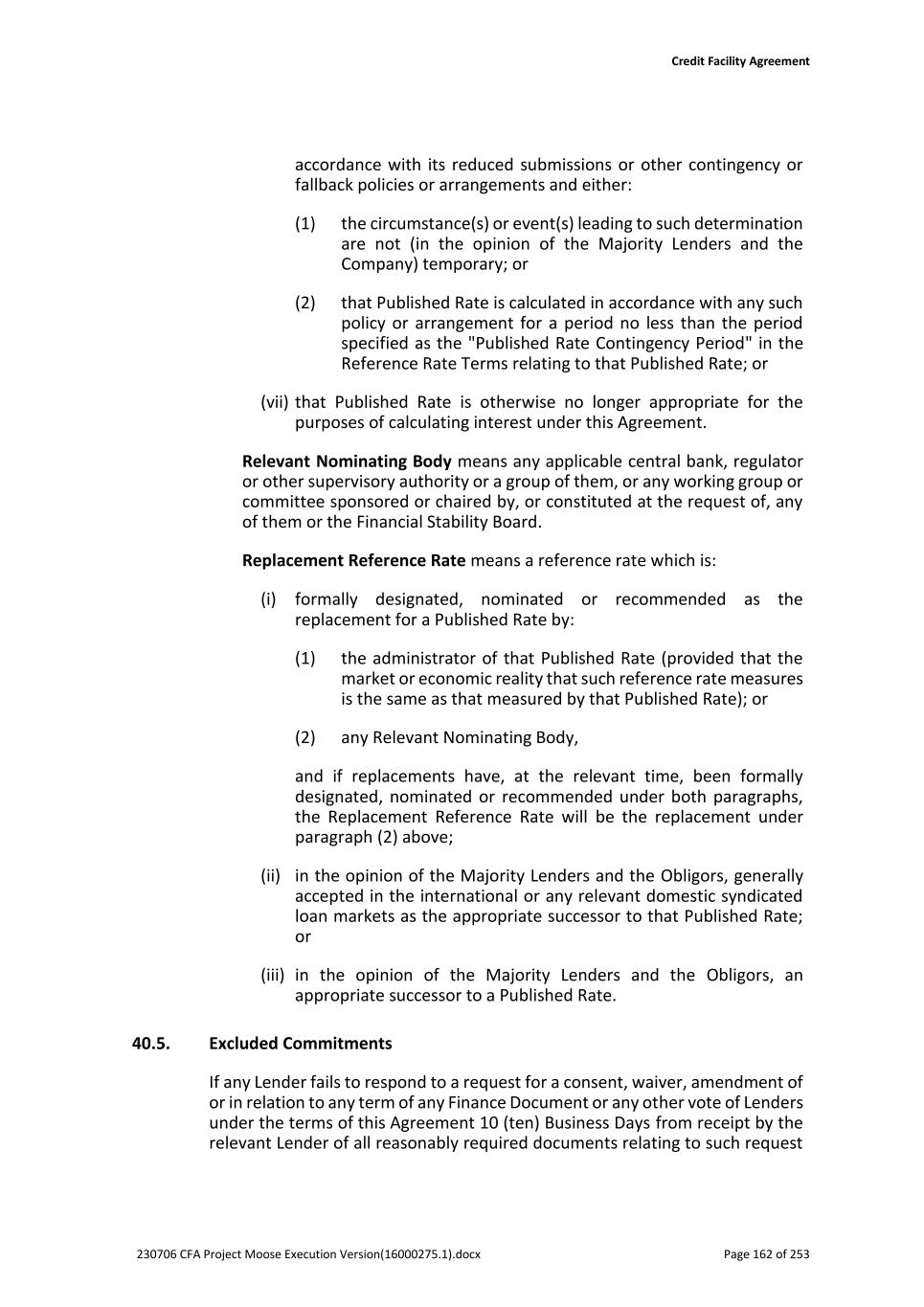
Credit Facility Agreement 230706 CFA Project Moose Execution Version(16000275.1).docx Page 162 of 253 accordance with its reduced submissions or other contingency or fallback policies or arrangements and either: (1) the circumstance(s) or event(s) leading to such determination are not (in the opinion of the Majority Lenders and the Company) temporary; or (2) that Published Rate is calculated in accordance with any such policy or arrangement for a period no less than the period specified as the "Published Rate Contingency Period" in the Reference Rate Terms relating to that Published Rate; or (vii) that Published Rate is otherwise no longer appropriate for the purposes of calculating interest under this Agreement. Relevant Nominating Body means any applicable central bank, regulator or other supervisory authority or a group of them, or any working group or committee sponsored or chaired by, or constituted at the request of, any of them or the Financial Stability Board. Replacement Reference Rate means a reference rate which is: (i) formally designated, nominated or recommended as the replacement for a Published Rate by: (1) the administrator of that Published Rate (provided that the market or economic reality that such reference rate measures is the same as that measured by that Published Rate); or (2) any Relevant Nominating Body, and if replacements have, at the relevant time, been formally designated, nominated or recommended under both paragraphs, the Replacement Reference Rate will be the replacement under paragraph (2) above; (ii) in the opinion of the Majority Lenders and the Obligors, generally accepted in the international or any relevant domestic syndicated loan markets as the appropriate successor to that Published Rate; or (iii) in the opinion of the Majority Lenders and the Obligors, an appropriate successor to a Published Rate. 40.5. Excluded Commitments If any Lender fails to respond to a request for a consent, waiver, amendment of or in relation to any term of any Finance Document or any other vote of Lenders under the terms of this Agreement 10 (ten) Business Days from receipt by the relevant Lender of all reasonably required documents relating to such request
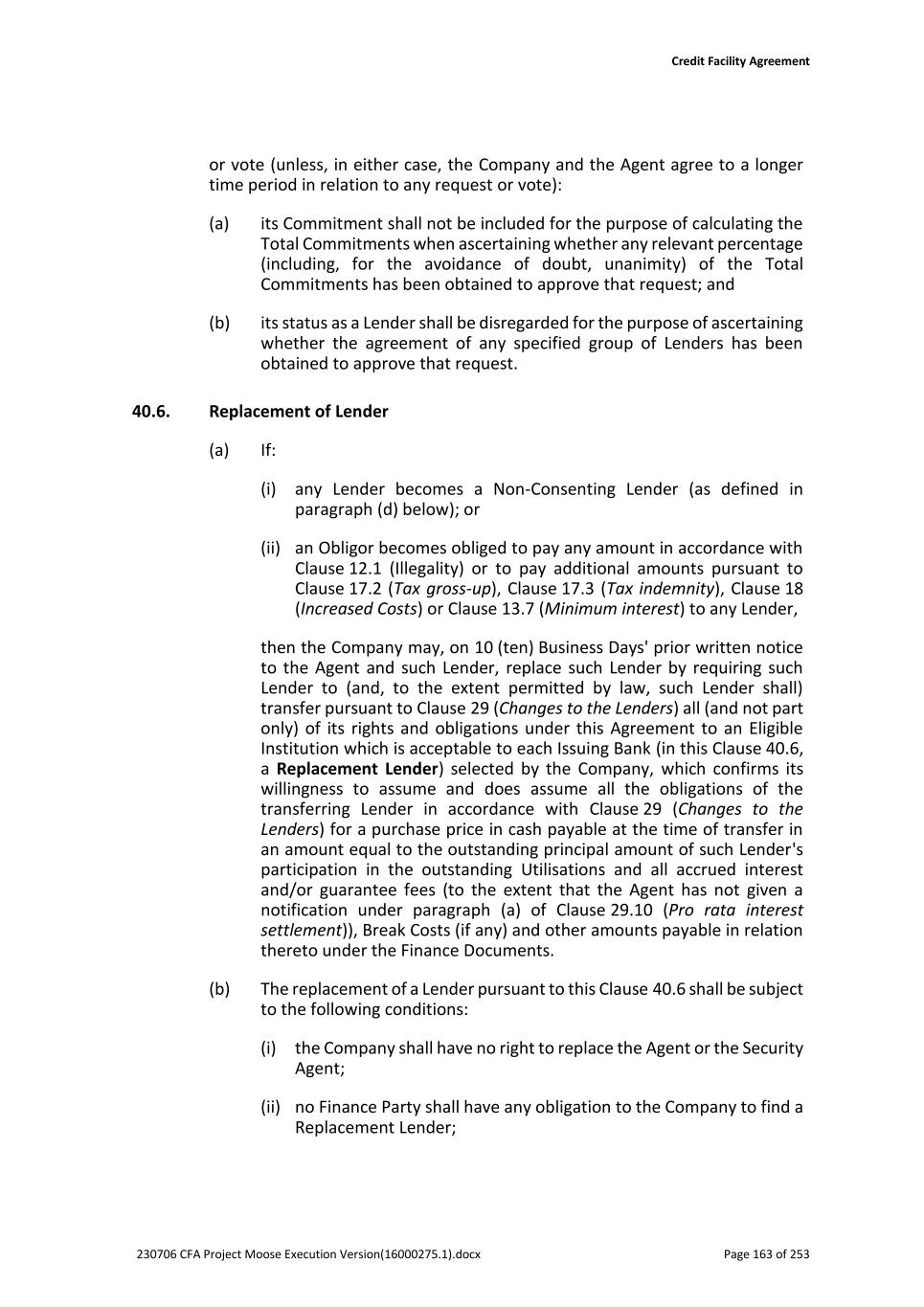
Credit Facility Agreement 230706 CFA Project Moose Execution Version(16000275.1).docx Page 163 of 253 or vote (unless, in either case, the Company and the Agent agree to a longer time period in relation to any request or vote): (a) its Commitment shall not be included for the purpose of calculating the Total Commitments when ascertaining whether any relevant percentage (including, for the avoidance of doubt, unanimity) of the Total Commitments has been obtained to approve that request; and (b) its status as a Lender shall be disregarded for the purpose of ascertaining whether the agreement of any specified group of Lenders has been obtained to approve that request. 40.6. Replacement of Lender (a) If: (i) any Lender becomes a Non-Consenting Lender (as defined in paragraph (d) below); or (ii) an Obligor becomes obliged to pay any amount in accordance with Clause 12.1 (Illegality) or to pay additional amounts pursuant to Clause 17.2 (Tax gross-up), Clause 17.3 (Tax indemnity), Clause 18 (Increased Costs) or Clause 13.7 (Minimum interest) to any Lender, then the Company may, on 10 (ten) Business Days' prior written notice to the Agent and such Lender, replace such Lender by requiring such Lender to (and, to the extent permitted by law, such Lender shall) transfer pursuant to Clause 29 (Changes to the Lenders) all (and not part only) of its rights and obligations under this Agreement to an Eligible Institution which is acceptable to each Issuing Bank (in this Clause 40.6, a Replacement Lender) selected by the Company, which confirms its willingness to assume and does assume all the obligations of the transferring Lender in accordance with Clause 29 (Changes to the Lenders) for a purchase price in cash payable at the time of transfer in an amount equal to the outstanding principal amount of such Lender's participation in the outstanding Utilisations and all accrued interest and/or guarantee fees (to the extent that the Agent has not given a notification under paragraph (a) of Clause 29.10 (Pro rata interest settlement)), Break Costs (if any) and other amounts payable in relation thereto under the Finance Documents. (b) The replacement of a Lender pursuant to this Clause 40.6 shall be subject to the following conditions: (i) the Company shall have no right to replace the Agent or the Security Agent; (ii) no Finance Party shall have any obligation to the Company to find a Replacement Lender;
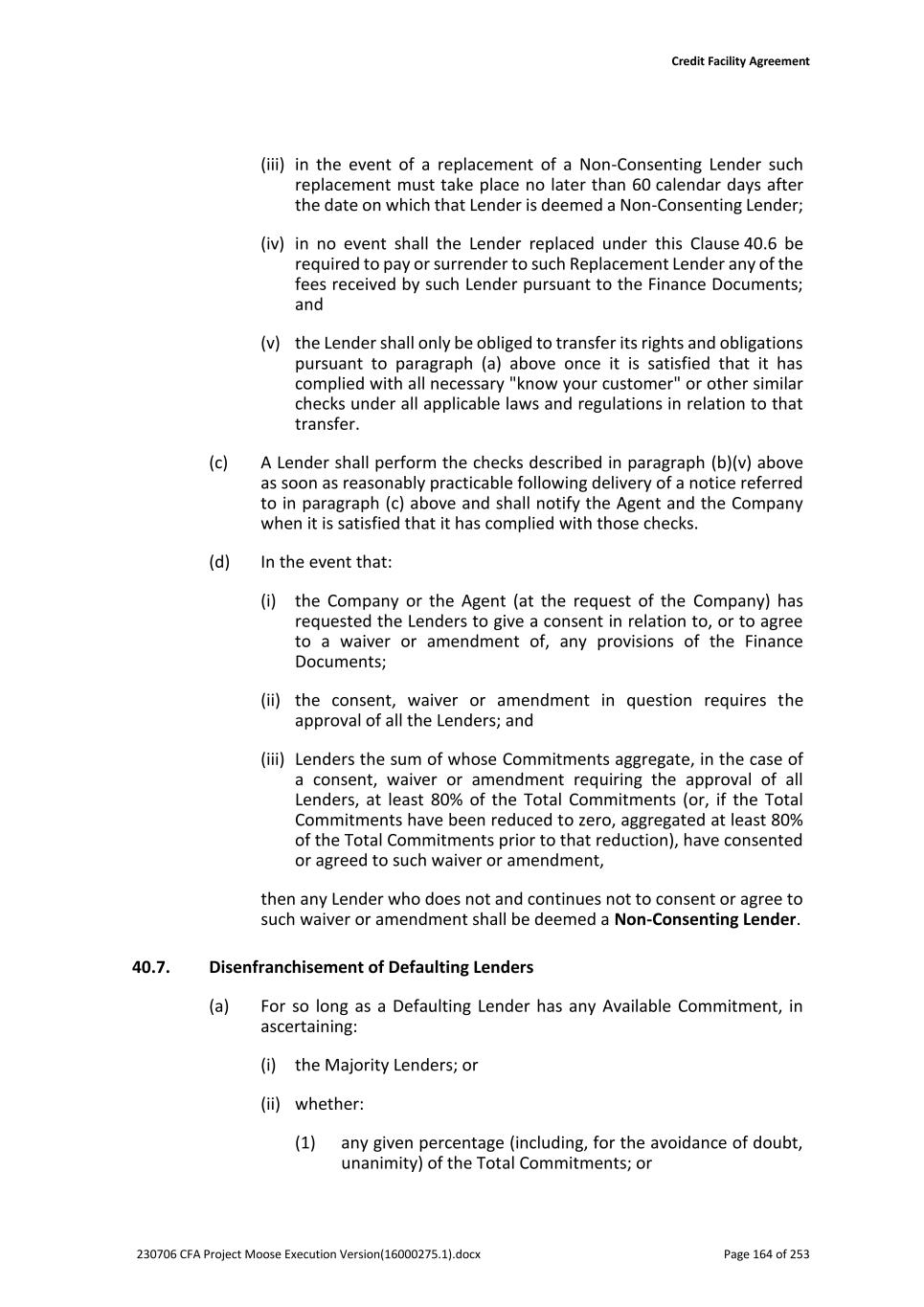
Credit Facility Agreement 230706 CFA Project Moose Execution Version(16000275.1).docx Page 164 of 253 (iii) in the event of a replacement of a Non-Consenting Lender such replacement must take place no later than 60 calendar days after the date on which that Lender is deemed a Non-Consenting Lender; (iv) in no event shall the Lender replaced under this Clause 40.6 be required to pay or surrender to such Replacement Lender any of the fees received by such Lender pursuant to the Finance Documents; and (v) the Lender shall only be obliged to transfer its rights and obligations pursuant to paragraph (a) above once it is satisfied that it has complied with all necessary "know your customer" or other similar checks under all applicable laws and regulations in relation to that transfer. (c) A Lender shall perform the checks described in paragraph (b)(v) above as soon as reasonably practicable following delivery of a notice referred to in paragraph (c) above and shall notify the Agent and the Company when it is satisfied that it has complied with those checks. (d) In the event that: (i) the Company or the Agent (at the request of the Company) has requested the Lenders to give a consent in relation to, or to agree to a waiver or amendment of, any provisions of the Finance Documents; (ii) the consent, waiver or amendment in question requires the approval of all the Lenders; and (iii) Lenders the sum of whose Commitments aggregate, in the case of a consent, waiver or amendment requiring the approval of all Lenders, at least 80% of the Total Commitments (or, if the Total Commitments have been reduced to zero, aggregated at least 80% of the Total Commitments prior to that reduction), have consented or agreed to such waiver or amendment, then any Lender who does not and continues not to consent or agree to such waiver or amendment shall be deemed a Non-Consenting Lender. 40.7. Disenfranchisement of Defaulting Lenders (a) For so long as a Defaulting Lender has any Available Commitment, in ascertaining: (i) the Majority Lenders; or (ii) whether: (1) any given percentage (including, for the avoidance of doubt, unanimity) of the Total Commitments; or
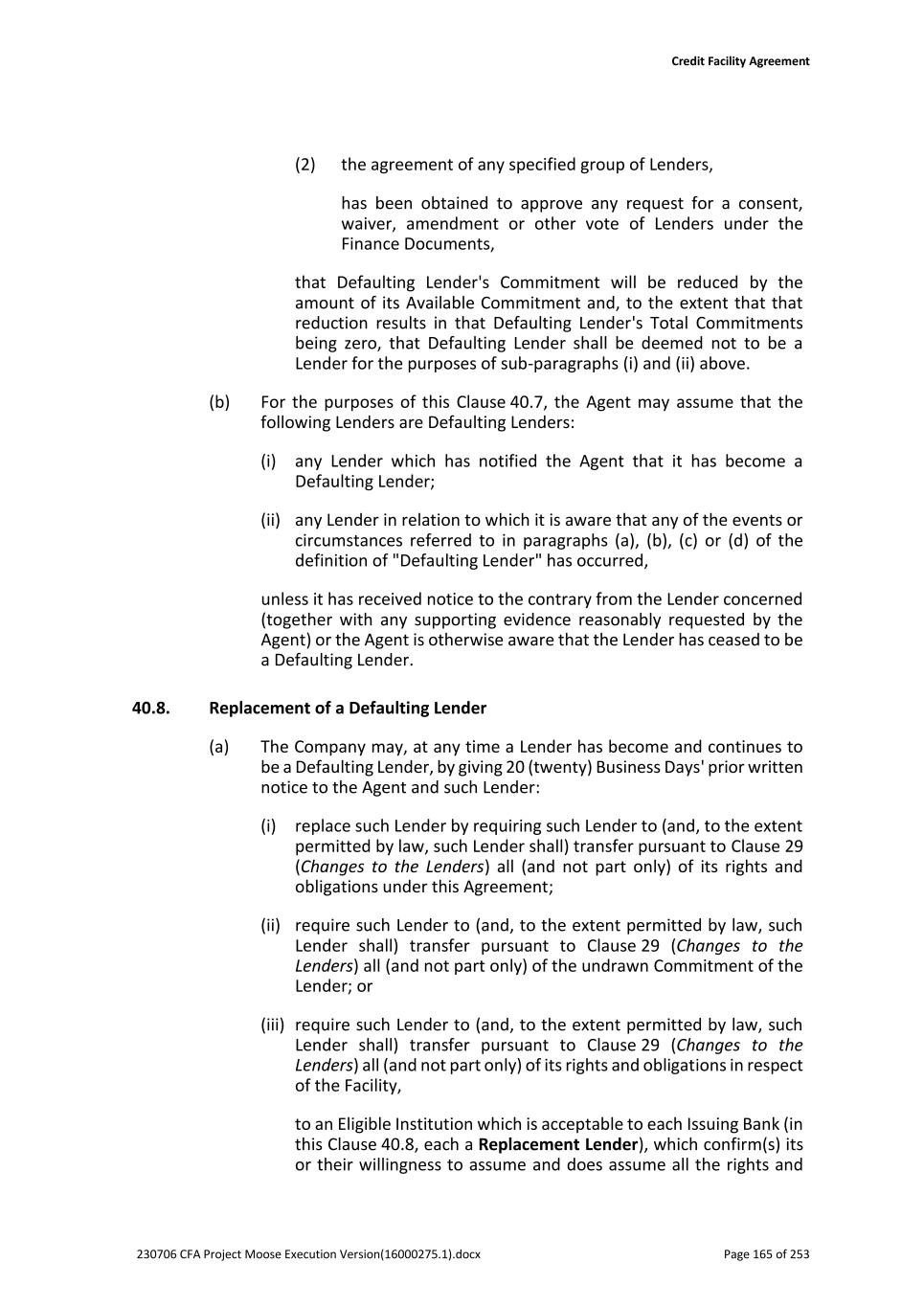
Credit Facility Agreement 230706 CFA Project Moose Execution Version(16000275.1).docx Page 165 of 253 (2) the agreement of any specified group of Lenders, has been obtained to approve any request for a consent, waiver, amendment or other vote of Lenders under the Finance Documents, that Defaulting Lender's Commitment will be reduced by the amount of its Available Commitment and, to the extent that that reduction results in that Defaulting Lender's Total Commitments being zero, that Defaulting Lender shall be deemed not to be a Lender for the purposes of sub-paragraphs (i) and (ii) above. (b) For the purposes of this Clause 40.7, the Agent may assume that the following Lenders are Defaulting Lenders: (i) any Lender which has notified the Agent that it has become a Defaulting Lender; (ii) any Lender in relation to which it is aware that any of the events or circumstances referred to in paragraphs (a), (b), (c) or (d) of the definition of "Defaulting Lender" has occurred, unless it has received notice to the contrary from the Lender concerned (together with any supporting evidence reasonably requested by the Agent) or the Agent is otherwise aware that the Lender has ceased to be a Defaulting Lender. 40.8. Replacement of a Defaulting Lender (a) The Company may, at any time a Lender has become and continues to be a Defaulting Lender, by giving 20 (twenty) Business Days' prior written notice to the Agent and such Lender: (i) replace such Lender by requiring such Lender to (and, to the extent permitted by law, such Lender shall) transfer pursuant to Clause 29 (Changes to the Lenders) all (and not part only) of its rights and obligations under this Agreement; (ii) require such Lender to (and, to the extent permitted by law, such Lender shall) transfer pursuant to Clause 29 (Changes to the Lenders) all (and not part only) of the undrawn Commitment of the Lender; or (iii) require such Lender to (and, to the extent permitted by law, such Lender shall) transfer pursuant to Clause 29 (Changes to the Lenders) all (and not part only) of its rights and obligations in respect of the Facility, to an Eligible Institution which is acceptable to each Issuing Bank (in this Clause 40.8, each a Replacement Lender), which confirm(s) its or their willingness to assume and does assume all the rights and
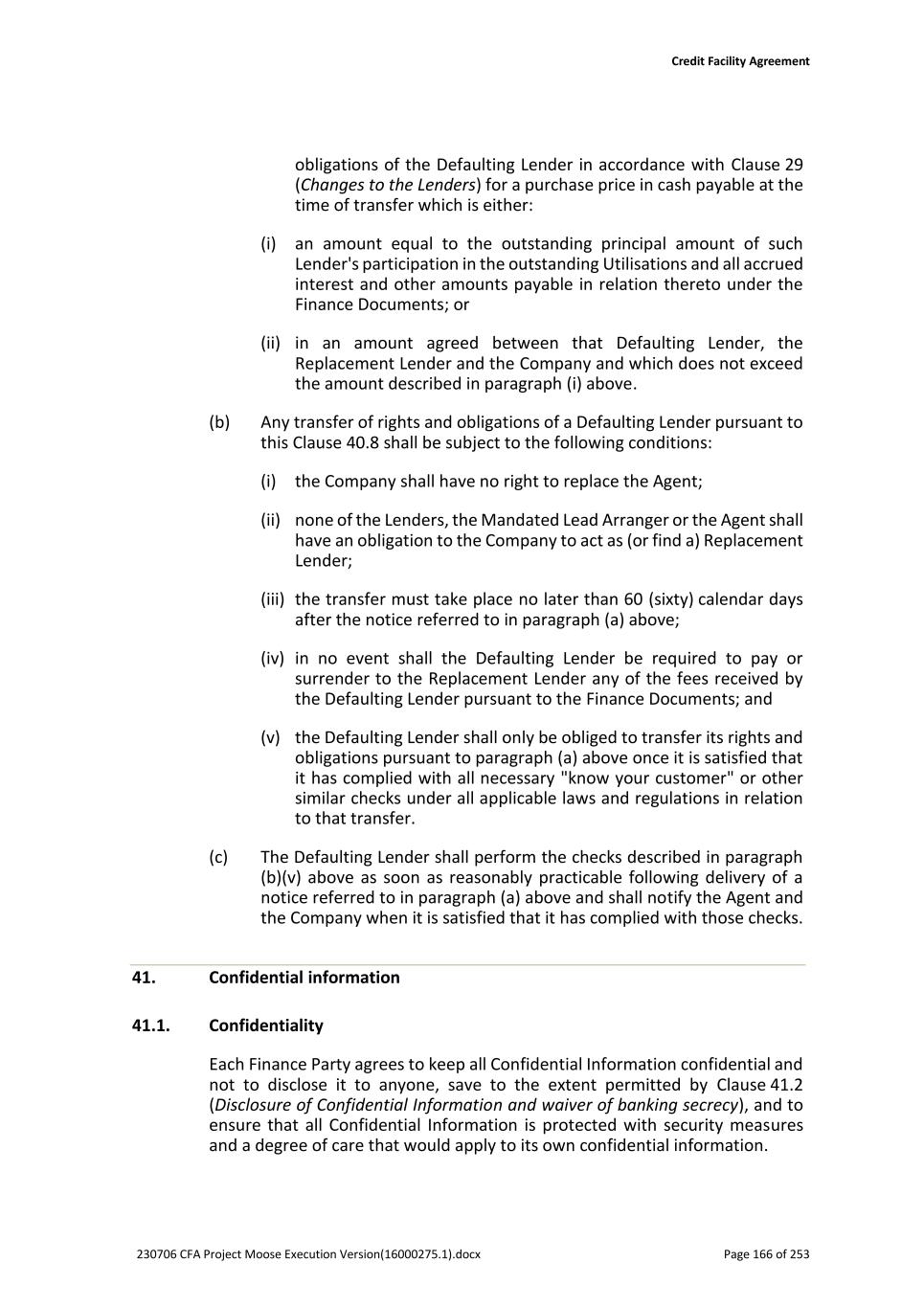
Credit Facility Agreement 230706 CFA Project Moose Execution Version(16000275.1).docx Page 166 of 253 obligations of the Defaulting Lender in accordance with Clause 29 (Changes to the Lenders) for a purchase price in cash payable at the time of transfer which is either: (i) an amount equal to the outstanding principal amount of such Lender's participation in the outstanding Utilisations and all accrued interest and other amounts payable in relation thereto under the Finance Documents; or (ii) in an amount agreed between that Defaulting Lender, the Replacement Lender and the Company and which does not exceed the amount described in paragraph (i) above. (b) Any transfer of rights and obligations of a Defaulting Lender pursuant to this Clause 40.8 shall be subject to the following conditions: (i) the Company shall have no right to replace the Agent; (ii) none of the Lenders, the Mandated Lead Arranger or the Agent shall have an obligation to the Company to act as (or find a) Replacement Lender; (iii) the transfer must take place no later than 60 (sixty) calendar days after the notice referred to in paragraph (a) above; (iv) in no event shall the Defaulting Lender be required to pay or surrender to the Replacement Lender any of the fees received by the Defaulting Lender pursuant to the Finance Documents; and (v) the Defaulting Lender shall only be obliged to transfer its rights and obligations pursuant to paragraph (a) above once it is satisfied that it has complied with all necessary "know your customer" or other similar checks under all applicable laws and regulations in relation to that transfer. (c) The Defaulting Lender shall perform the checks described in paragraph (b)(v) above as soon as reasonably practicable following delivery of a notice referred to in paragraph (a) above and shall notify the Agent and the Company when it is satisfied that it has complied with those checks. 41. Confidential information 41.1. Confidentiality Each Finance Party agrees to keep all Confidential Information confidential and not to disclose it to anyone, save to the extent permitted by Clause 41.2 (Disclosure of Confidential Information and waiver of banking secrecy), and to ensure that all Confidential Information is protected with security measures and a degree of care that would apply to its own confidential information.
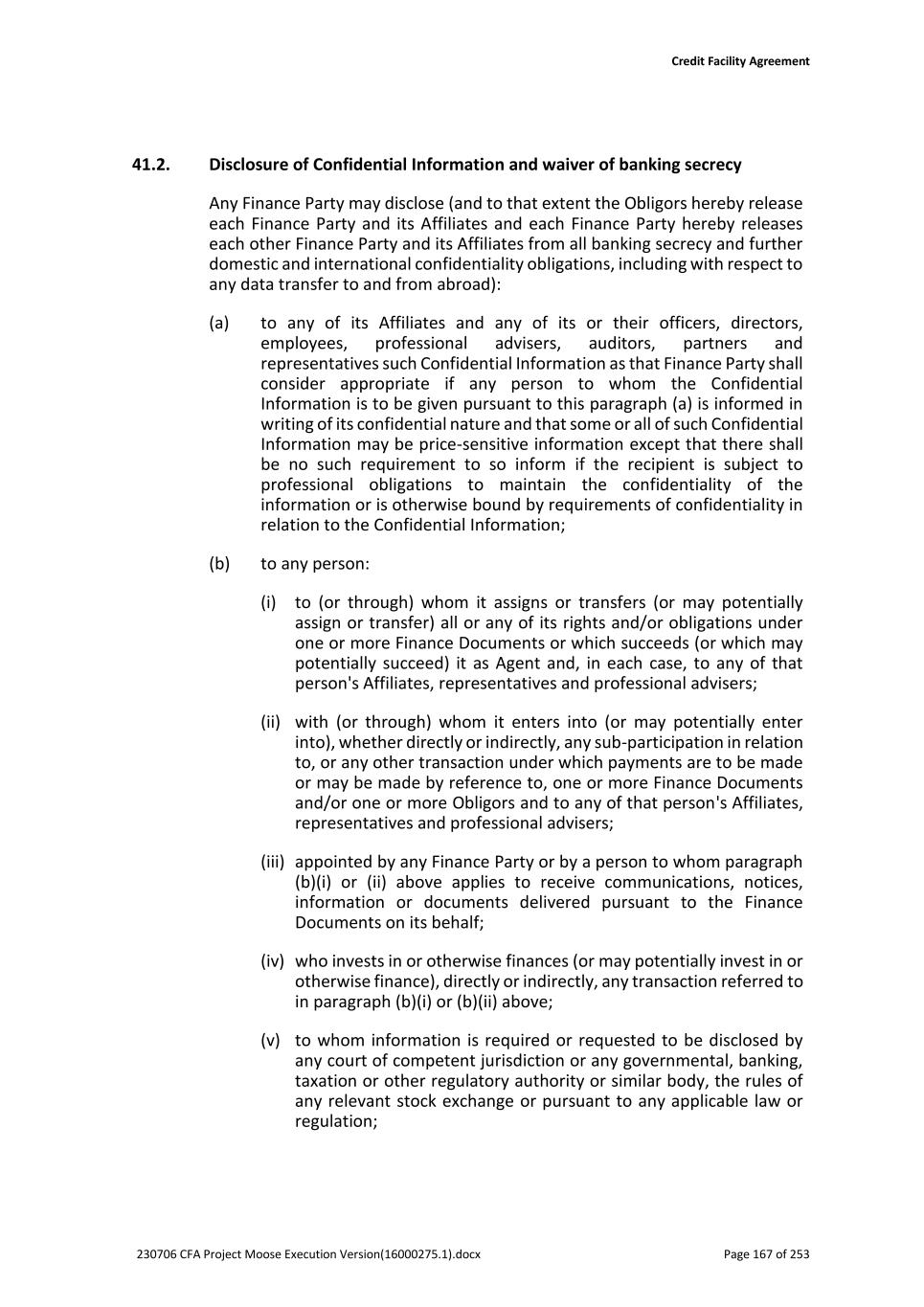
Credit Facility Agreement 230706 CFA Project Moose Execution Version(16000275.1).docx Page 167 of 253 41.2. Disclosure of Confidential Information and waiver of banking secrecy Any Finance Party may disclose (and to that extent the Obligors hereby release each Finance Party and its Affiliates and each Finance Party hereby releases each other Finance Party and its Affiliates from all banking secrecy and further domestic and international confidentiality obligations, including with respect to any data transfer to and from abroad): (a) to any of its Affiliates and any of its or their officers, directors, employees, professional advisers, auditors, partners and representatives such Confidential Information as that Finance Party shall consider appropriate if any person to whom the Confidential Information is to be given pursuant to this paragraph (a) is informed in writing of its confidential nature and that some or all of such Confidential Information may be price-sensitive information except that there shall be no such requirement to so inform if the recipient is subject to professional obligations to maintain the confidentiality of the information or is otherwise bound by requirements of confidentiality in relation to the Confidential Information; (b) to any person: (i) to (or through) whom it assigns or transfers (or may potentially assign or transfer) all or any of its rights and/or obligations under one or more Finance Documents or which succeeds (or which may potentially succeed) it as Agent and, in each case, to any of that person's Affiliates, representatives and professional advisers; (ii) with (or through) whom it enters into (or may potentially enter into), whether directly or indirectly, any sub-participation in relation to, or any other transaction under which payments are to be made or may be made by reference to, one or more Finance Documents and/or one or more Obligors and to any of that person's Affiliates, representatives and professional advisers; (iii) appointed by any Finance Party or by a person to whom paragraph (b)(i) or (ii) above applies to receive communications, notices, information or documents delivered pursuant to the Finance Documents on its behalf; (iv) who invests in or otherwise finances (or may potentially invest in or otherwise finance), directly or indirectly, any transaction referred to in paragraph (b)(i) or (b)(ii) above; (v) to whom information is required or requested to be disclosed by any court of competent jurisdiction or any governmental, banking, taxation or other regulatory authority or similar body, the rules of any relevant stock exchange or pursuant to any applicable law or regulation;
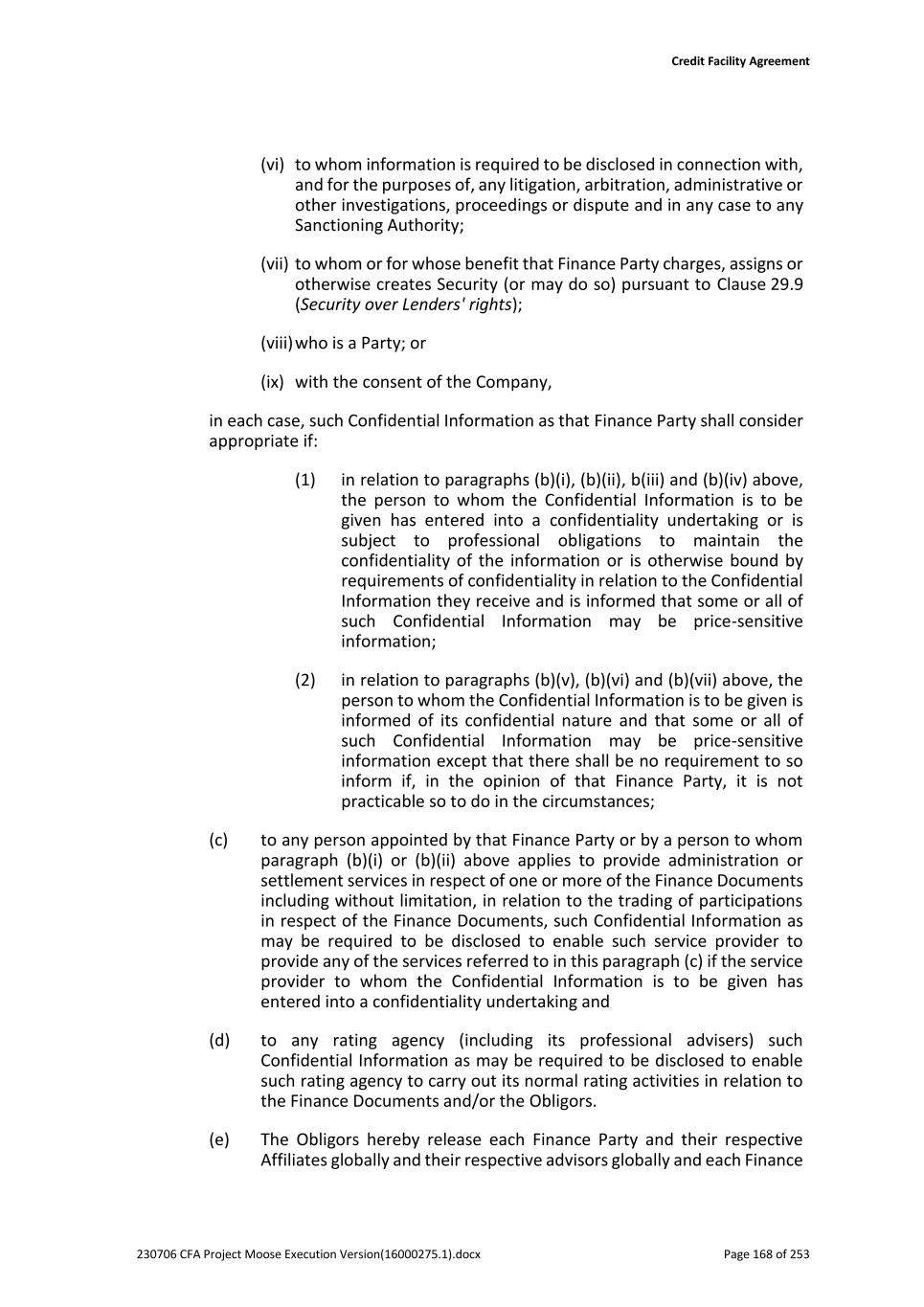
Credit Facility Agreement 230706 CFA Project Moose Execution Version(16000275.1).docx Page 168 of 253 (vi) to whom information is required to be disclosed in connection with, and for the purposes of, any litigation, arbitration, administrative or other investigations, proceedings or dispute and in any case to any Sanctioning Authority; (vii) to whom or for whose benefit that Finance Party charges, assigns or otherwise creates Security (or may do so) pursuant to Clause 29.9 (Security over Lenders' rights); (viii) who is a Party; or (ix) with the consent of the Company, in each case, such Confidential Information as that Finance Party shall consider appropriate if: (1) in relation to paragraphs (b)(i), (b)(ii), b(iii) and (b)(iv) above, the person to whom the Confidential Information is to be given has entered into a confidentiality undertaking or is subject to professional obligations to maintain the confidentiality of the information or is otherwise bound by requirements of confidentiality in relation to the Confidential Information they receive and is informed that some or all of such Confidential Information may be price-sensitive information; (2) in relation to paragraphs (b)(v), (b)(vi) and (b)(vii) above, the person to whom the Confidential Information is to be given is informed of its confidential nature and that some or all of such Confidential Information may be price-sensitive information except that there shall be no requirement to so inform if, in the opinion of that Finance Party, it is not practicable so to do in the circumstances; (c) to any person appointed by that Finance Party or by a person to whom paragraph (b)(i) or (b)(ii) above applies to provide administration or settlement services in respect of one or more of the Finance Documents including without limitation, in relation to the trading of participations in respect of the Finance Documents, such Confidential Information as may be required to be disclosed to enable such service provider to provide any of the services referred to in this paragraph (c) if the service provider to whom the Confidential Information is to be given has entered into a confidentiality undertaking and (d) to any rating agency (including its professional advisers) such Confidential Information as may be required to be disclosed to enable such rating agency to carry out its normal rating activities in relation to the Finance Documents and/or the Obligors. (e) The Obligors hereby release each Finance Party and their respective Affiliates globally and their respective advisors globally and each Finance
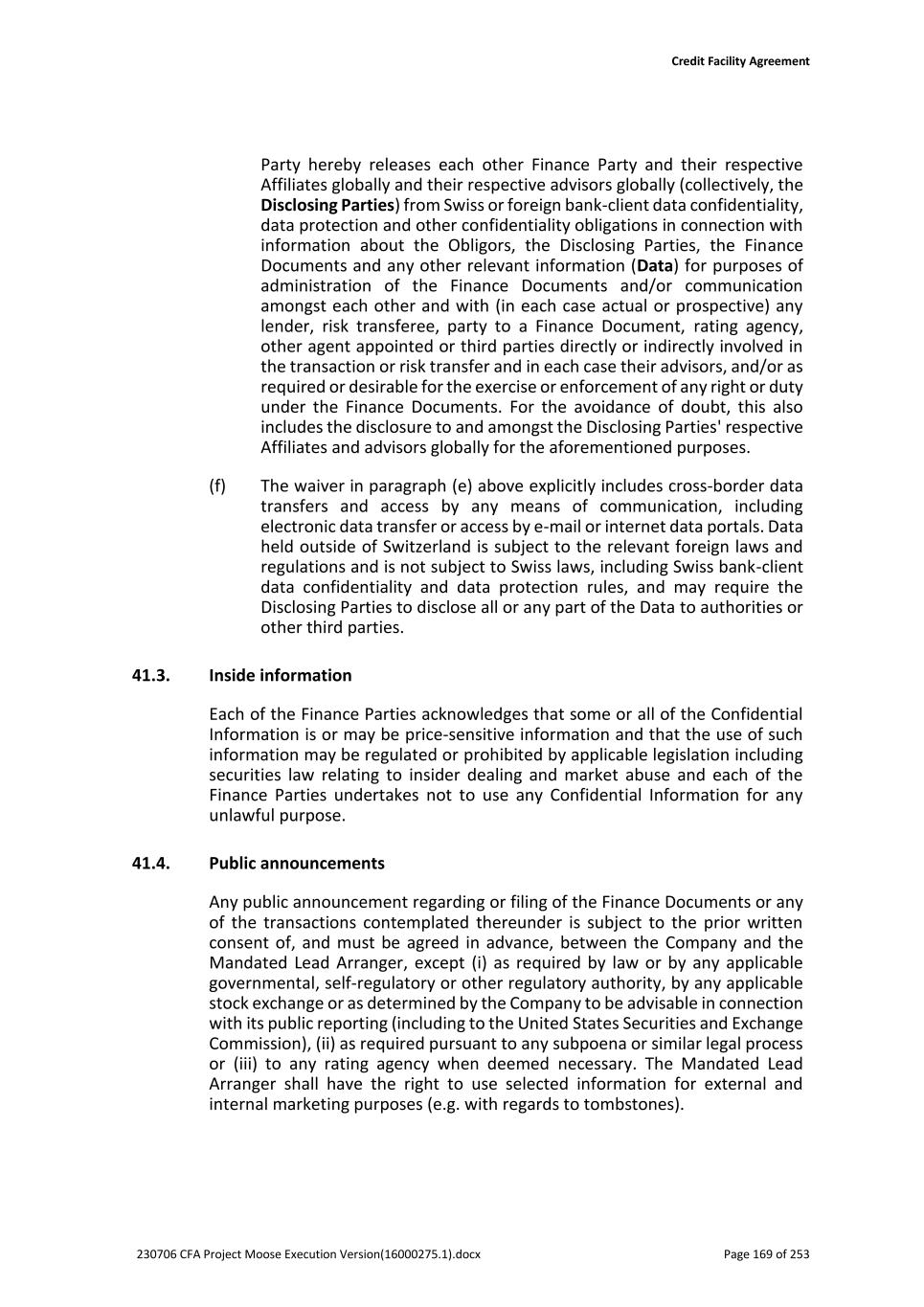
Credit Facility Agreement 230706 CFA Project Moose Execution Version(16000275.1).docx Page 169 of 253 Party hereby releases each other Finance Party and their respective Affiliates globally and their respective advisors globally (collectively, the Disclosing Parties) from Swiss or foreign bank-client data confidentiality, data protection and other confidentiality obligations in connection with information about the Obligors, the Disclosing Parties, the Finance Documents and any other relevant information (Data) for purposes of administration of the Finance Documents and/or communication amongst each other and with (in each case actual or prospective) any lender, risk transferee, party to a Finance Document, rating agency, other agent appointed or third parties directly or indirectly involved in the transaction or risk transfer and in each case their advisors, and/or as required or desirable for the exercise or enforcement of any right or duty under the Finance Documents. For the avoidance of doubt, this also includes the disclosure to and amongst the Disclosing Parties' respective Affiliates and advisors globally for the aforementioned purposes. (f) The waiver in paragraph (e) above explicitly includes cross-border data transfers and access by any means of communication, including electronic data transfer or access by e-mail or internet data portals. Data held outside of Switzerland is subject to the relevant foreign laws and regulations and is not subject to Swiss laws, including Swiss bank-client data confidentiality and data protection rules, and may require the Disclosing Parties to disclose all or any part of the Data to authorities or other third parties. 41.3. Inside information Each of the Finance Parties acknowledges that some or all of the Confidential Information is or may be price-sensitive information and that the use of such information may be regulated or prohibited by applicable legislation including securities law relating to insider dealing and market abuse and each of the Finance Parties undertakes not to use any Confidential Information for any unlawful purpose. 41.4. Public announcements Any public announcement regarding or filing of the Finance Documents or any of the transactions contemplated thereunder is subject to the prior written consent of, and must be agreed in advance, between the Company and the Mandated Lead Arranger, except (i) as required by law or by any applicable governmental, self-regulatory or other regulatory authority, by any applicable stock exchange or as determined by the Company to be advisable in connection with its public reporting (including to the United States Securities and Exchange Commission), (ii) as required pursuant to any subpoena or similar legal process or (iii) to any rating agency when deemed necessary. The Mandated Lead Arranger shall have the right to use selected information for external and internal marketing purposes (e.g. with regards to tombstones).
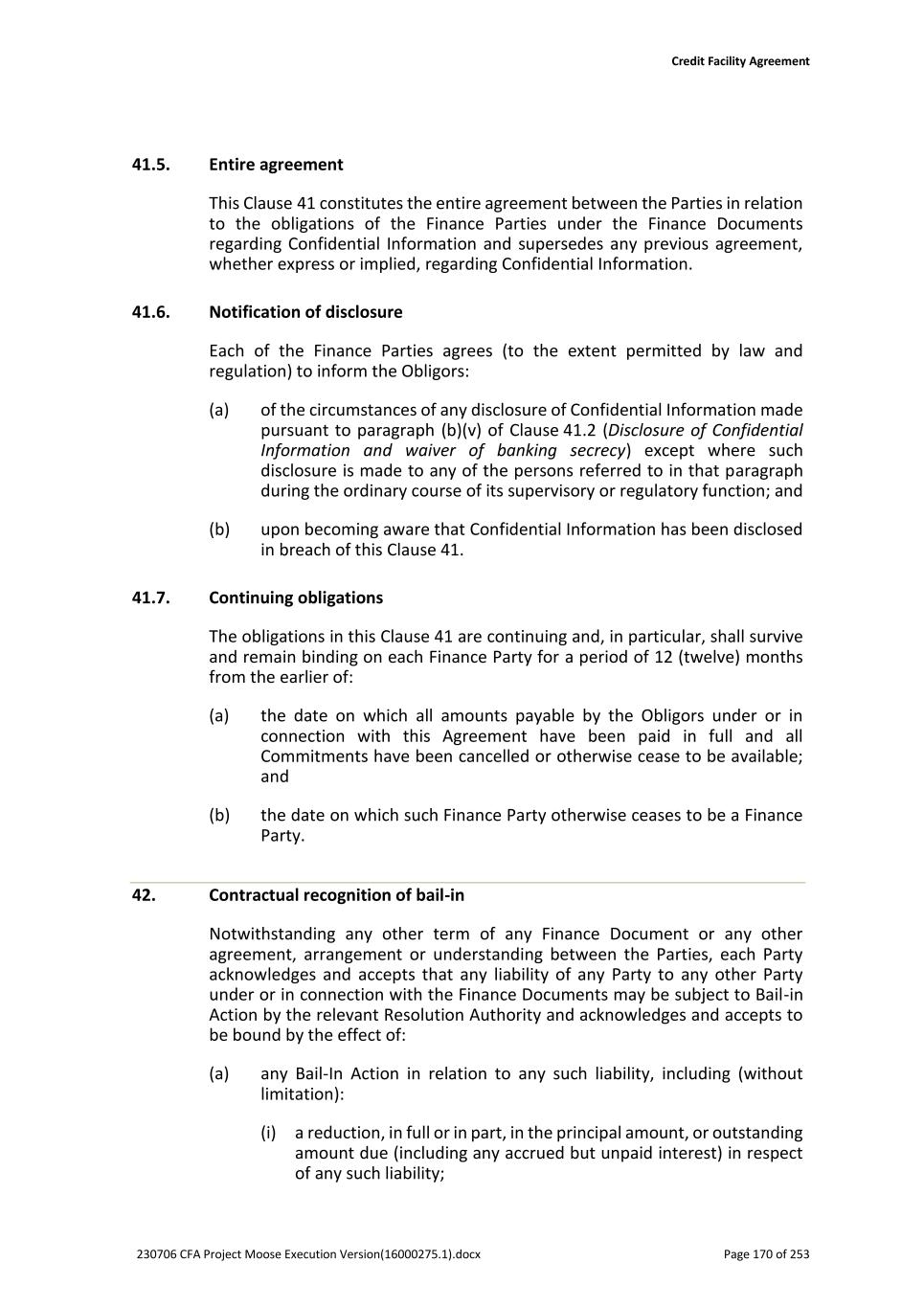
Credit Facility Agreement 230706 CFA Project Moose Execution Version(16000275.1).docx Page 170 of 253 41.5. Entire agreement This Clause 41 constitutes the entire agreement between the Parties in relation to the obligations of the Finance Parties under the Finance Documents regarding Confidential Information and supersedes any previous agreement, whether express or implied, regarding Confidential Information. 41.6. Notification of disclosure Each of the Finance Parties agrees (to the extent permitted by law and regulation) to inform the Obligors: (a) of the circumstances of any disclosure of Confidential Information made pursuant to paragraph (b)(v) of Clause 41.2 (Disclosure of Confidential Information and waiver of banking secrecy) except where such disclosure is made to any of the persons referred to in that paragraph during the ordinary course of its supervisory or regulatory function; and (b) upon becoming aware that Confidential Information has been disclosed in breach of this Clause 41. 41.7. Continuing obligations The obligations in this Clause 41 are continuing and, in particular, shall survive and remain binding on each Finance Party for a period of 12 (twelve) months from the earlier of: (a) the date on which all amounts payable by the Obligors under or in connection with this Agreement have been paid in full and all Commitments have been cancelled or otherwise cease to be available; and (b) the date on which such Finance Party otherwise ceases to be a Finance Party. 42. Contractual recognition of bail-in Notwithstanding any other term of any Finance Document or any other agreement, arrangement or understanding between the Parties, each Party acknowledges and accepts that any liability of any Party to any other Party under or in connection with the Finance Documents may be subject to Bail-in Action by the relevant Resolution Authority and acknowledges and accepts to be bound by the effect of: (a) any Bail-In Action in relation to any such liability, including (without limitation): (i) a reduction, in full or in part, in the principal amount, or outstanding amount due (including any accrued but unpaid interest) in respect of any such liability;
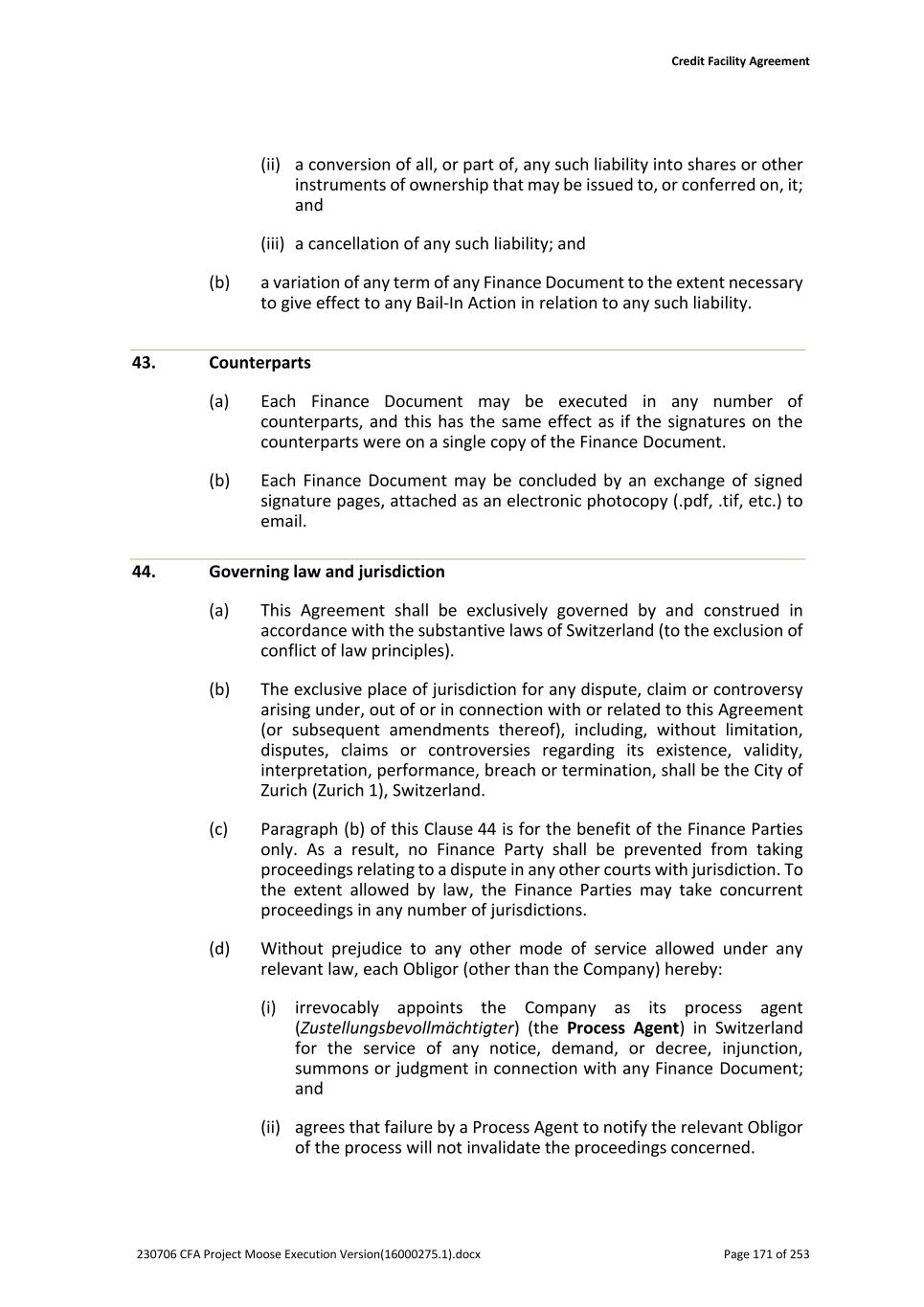
Credit Facility Agreement 230706 CFA Project Moose Execution Version(16000275.1).docx Page 171 of 253 (ii) a conversion of all, or part of, any such liability into shares or other instruments of ownership that may be issued to, or conferred on, it; and (iii) a cancellation of any such liability; and (b) a variation of any term of any Finance Document to the extent necessary to give effect to any Bail-In Action in relation to any such liability. 43. Counterparts (a) Each Finance Document may be executed in any number of counterparts, and this has the same effect as if the signatures on the counterparts were on a single copy of the Finance Document. (b) Each Finance Document may be concluded by an exchange of signed signature pages, attached as an electronic photocopy (.pdf, .tif, etc.) to email. 44. Governing law and jurisdiction (a) This Agreement shall be exclusively governed by and construed in accordance with the substantive laws of Switzerland (to the exclusion of conflict of law principles). (b) The exclusive place of jurisdiction for any dispute, claim or controversy arising under, out of or in connection with or related to this Agreement (or subsequent amendments thereof), including, without limitation, disputes, claims or controversies regarding its existence, validity, interpretation, performance, breach or termination, shall be the City of Zurich (Zurich 1), Switzerland. (c) Paragraph (b) of this Clause 44 is for the benefit of the Finance Parties only. As a result, no Finance Party shall be prevented from taking proceedings relating to a dispute in any other courts with jurisdiction. To the extent allowed by law, the Finance Parties may take concurrent proceedings in any number of jurisdictions. (d) Without prejudice to any other mode of service allowed under any relevant law, each Obligor (other than the Company) hereby: (i) irrevocably appoints the Company as its process agent (Zustellungsbevollmächtigter) (the Process Agent) in Switzerland for the service of any notice, demand, or decree, injunction, summons or judgment in connection with any Finance Document; and (ii) agrees that failure by a Process Agent to notify the relevant Obligor of the process will not invalidate the proceedings concerned.
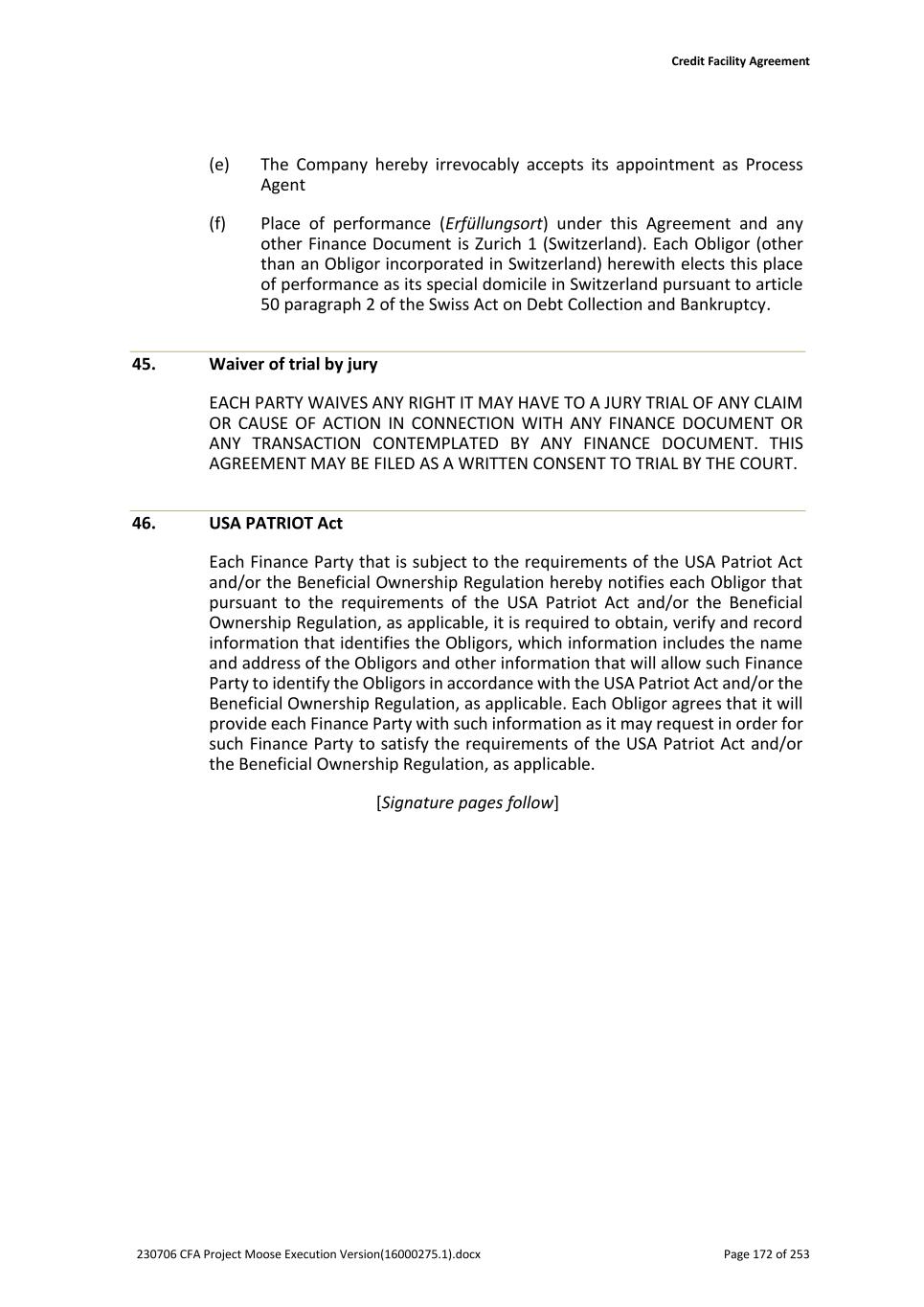
Credit Facility Agreement 230706 CFA Project Moose Execution Version(16000275.1).docx Page 172 of 253 (e) The Company hereby irrevocably accepts its appointment as Process Agent (f) Place of performance (Erfüllungsort) under this Agreement and any other Finance Document is Zurich 1 (Switzerland). Each Obligor (other than an Obligor incorporated in Switzerland) herewith elects this place of performance as its special domicile in Switzerland pursuant to article 50 paragraph 2 of the Swiss Act on Debt Collection and Bankruptcy. 45. Waiver of trial by jury EACH PARTY WAIVES ANY RIGHT IT MAY HAVE TO A JURY TRIAL OF ANY CLAIM OR CAUSE OF ACTION IN CONNECTION WITH ANY FINANCE DOCUMENT OR ANY TRANSACTION CONTEMPLATED BY ANY FINANCE DOCUMENT. THIS AGREEMENT MAY BE FILED AS A WRITTEN CONSENT TO TRIAL BY THE COURT. 46. USA PATRIOT Act Each Finance Party that is subject to the requirements of the USA Patriot Act and/or the Beneficial Ownership Regulation hereby notifies each Obligor that pursuant to the requirements of the USA Patriot Act and/or the Beneficial Ownership Regulation, as applicable, it is required to obtain, verify and record information that identifies the Obligors, which information includes the name and address of the Obligors and other information that will allow such Finance Party to identify the Obligors in accordance with the USA Patriot Act and/or the Beneficial Ownership Regulation, as applicable. Each Obligor agrees that it will provide each Finance Party with such information as it may request in order for such Finance Party to satisfy the requirements of the USA Patriot Act and/or the Beneficial Ownership Regulation, as applicable. [Signature pages follow]
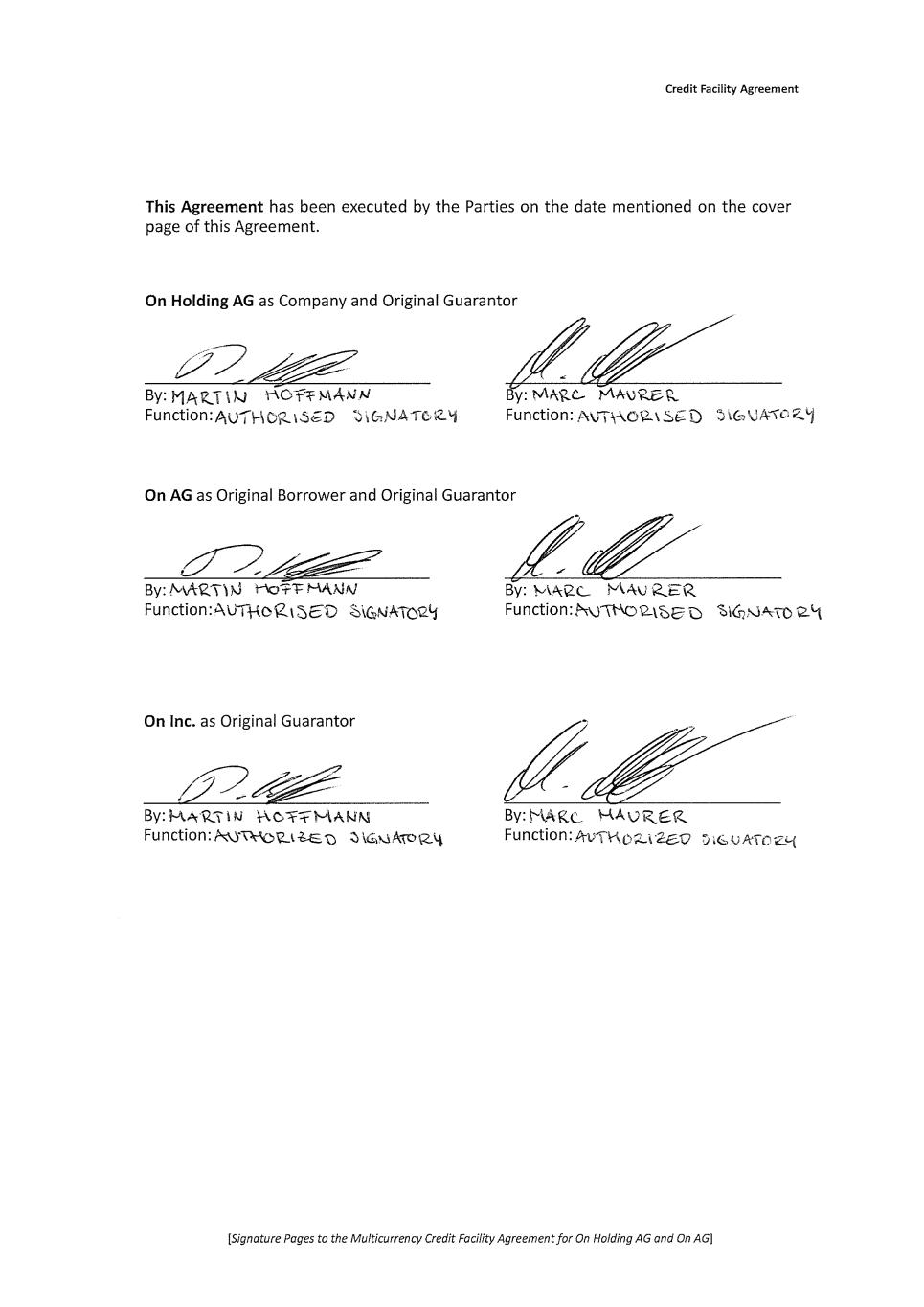
Credit Facility Agreement This Agreement has been executed by the Parties on the date mentioned on the cover page of this Agreement. On Holding AG as Company and Original Guarantor BY: MAZ:Ikki MA-N Function:Au-n-vo 5j,-D ' '1(7,NIA-re>te.4 Function: Avm-\.c.,:c>-‘..s .--D y: is/kA- )?...0-• Ps_ On AG as Original Borrower and Original Guarantor By: ).\-\AZT 1"-AAM Function: Atrri-EocZt ED SGJATO21J On Inc. as Original Guarantor By: c_ NkAki 2..ER Function:N-QM-1/402-1E- ZLI By: 1-k4c1Z.I KiN9 By: MAR.c. Function: r\-\3-7k-k.)?t3----E:o AID kZ-4 Function: Av-prkoc4:t DicuATOZ4-( [Signature Pages to the Multicurrency Credit Facility Agreement for On Holding AG and On AG]
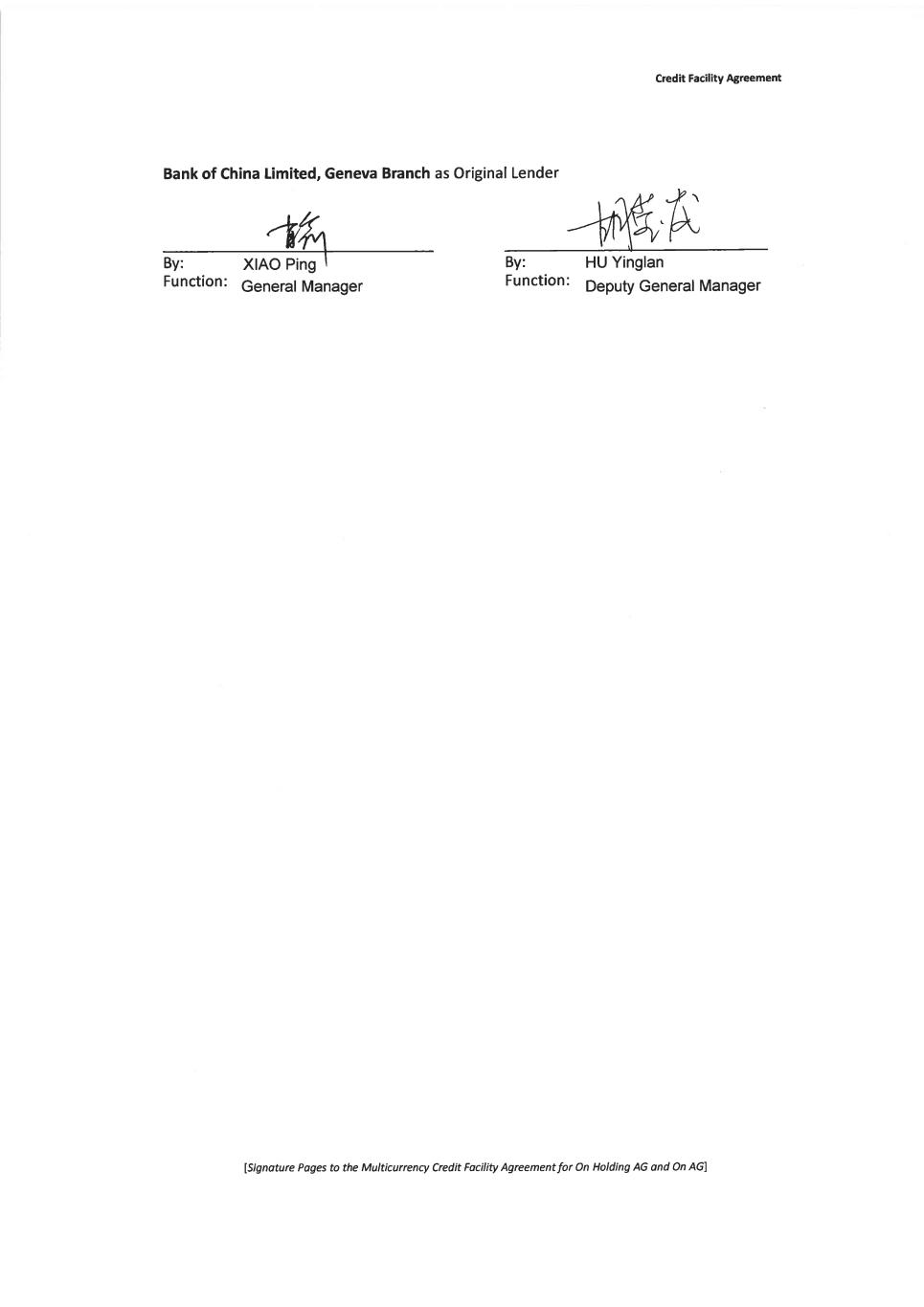
Bank of China Limited, Geneva Branch as Original Lender Credit Facility Agreement By: HU Yinglan Function: Deputy General Manager ryf" -w6 Function: General Manager lsignoture Poges to the Multicurrency Credit Focility Agreementfor On Holding AG ond On AGI
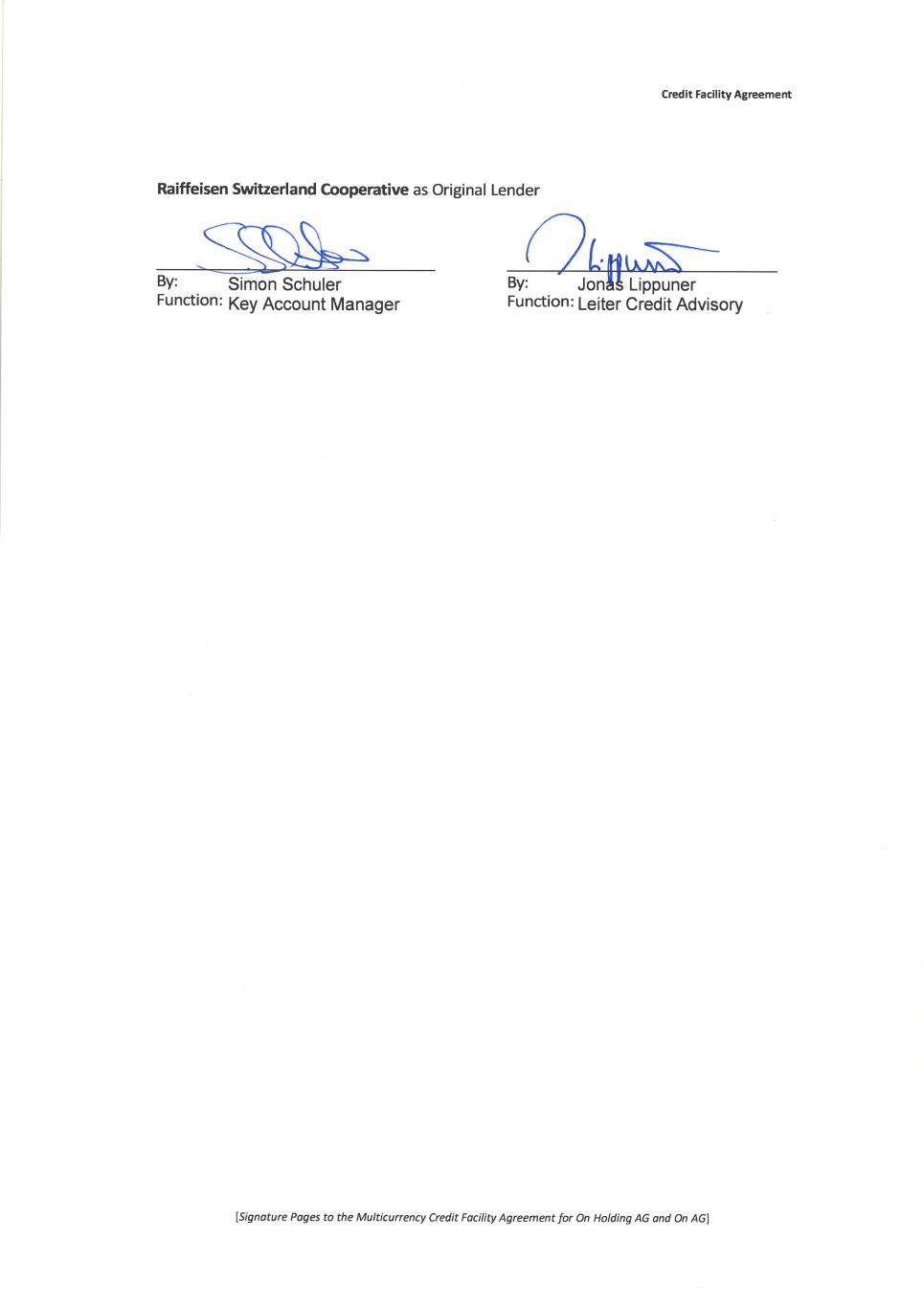
Cr€dlt Facility Agneemefü Raiffeisen Switzerland C.ooperative as Original Lender .N BY: Simon Schuler Function: Key Account Manager By: J Function: Leiter Lippuner CreditAdvisory lSignoture Poges to the Multicurrency Crcdit Focility Agreement for On Holding AG ond On AGI
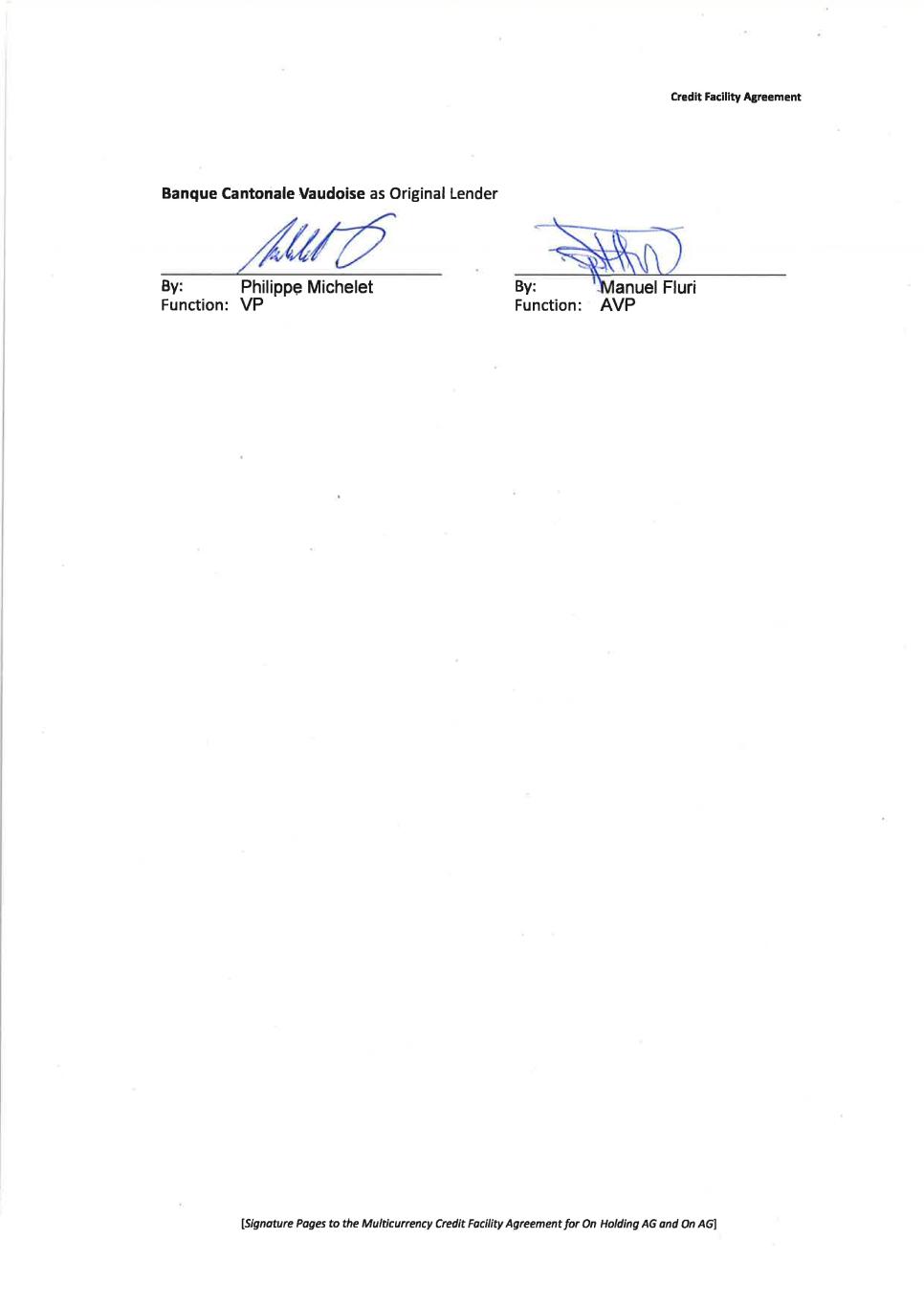
Credlt Facility Agreement Banque Cantonale Vaudoise as Original Lender By: Philippe Michelet Function: VP anuel Fluri AVP By: Function: lsigndture Poges to the Multicunency Credlt Focility Agreement for On Holding AG and On AGI
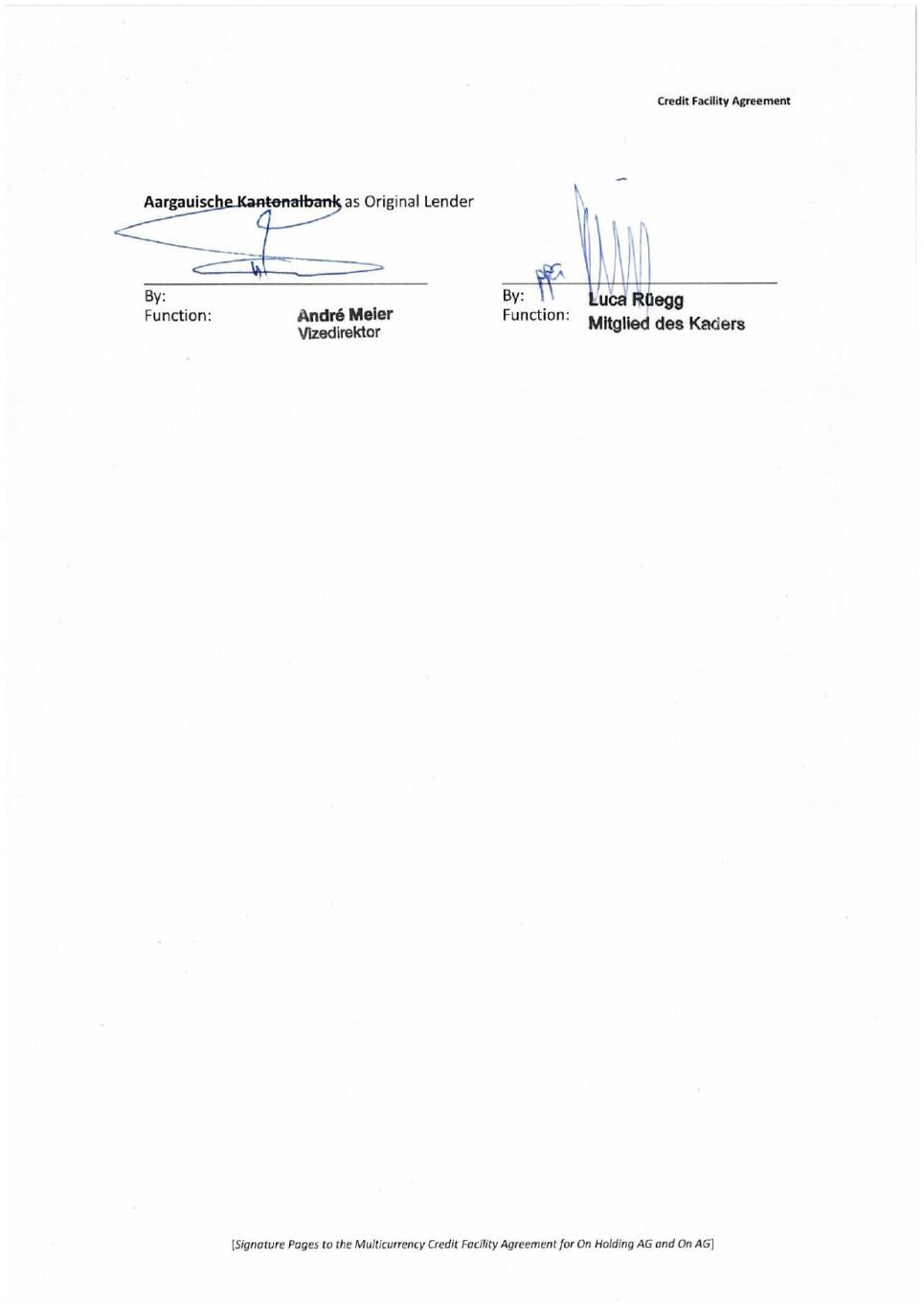
Aargauisc - = : • - as Original Lender By: By: Function: André Meier Function: Vizedirektor Credit Facility Agreement uàa Rüegg Mitglied des Kaders [Signature Pages to the Multicurrency Credit Facility Agreement for On Holding AG and On AG]
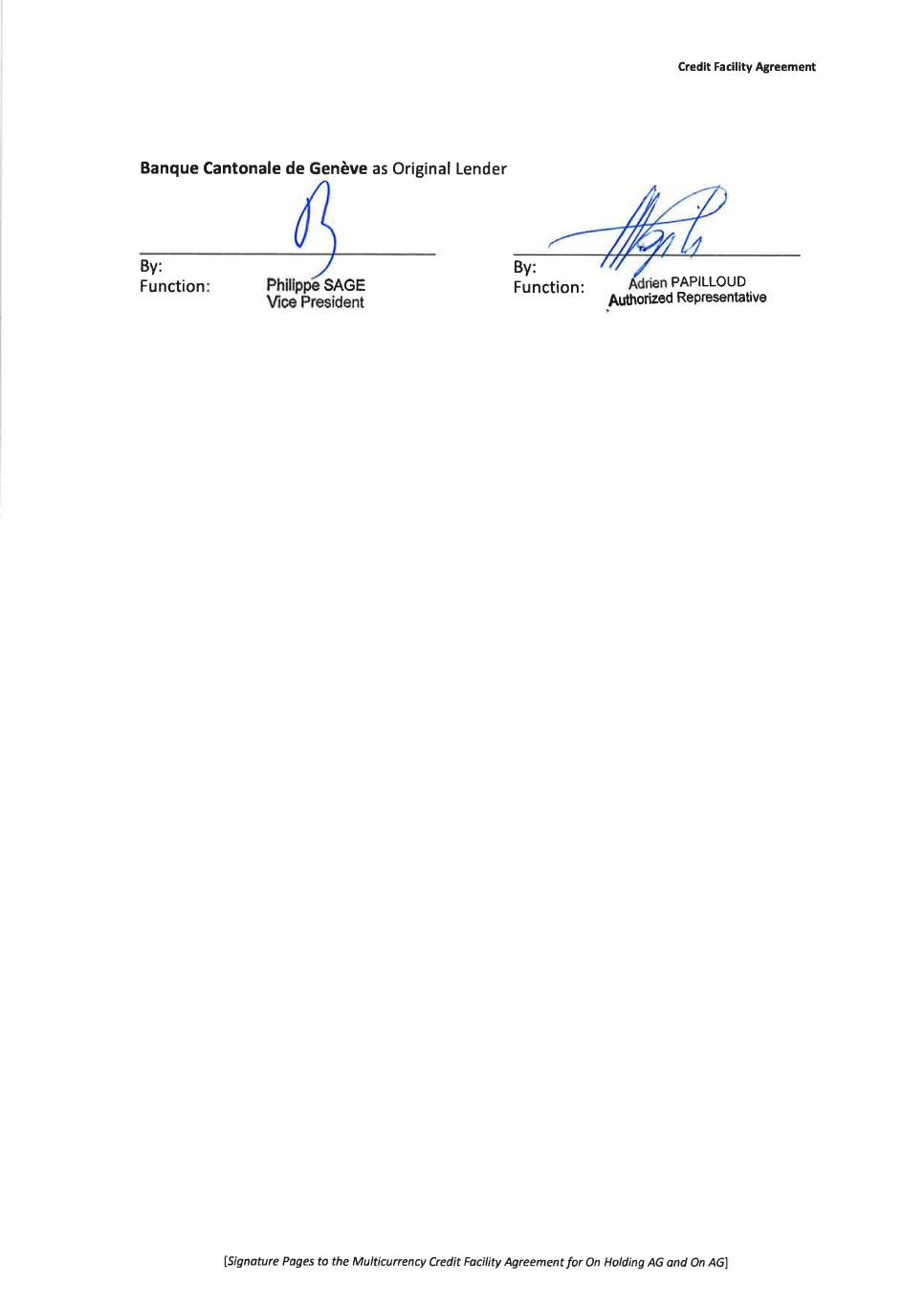
Banque Cantonale de Genève as Original Lender By: Function SAGE By: Function: Credit Facility Agreement PAPILLOUD Autlrorized Representative lSignoture Poges to the Multicurrency Credit Facility Agreement for On Holding AG and On AGI
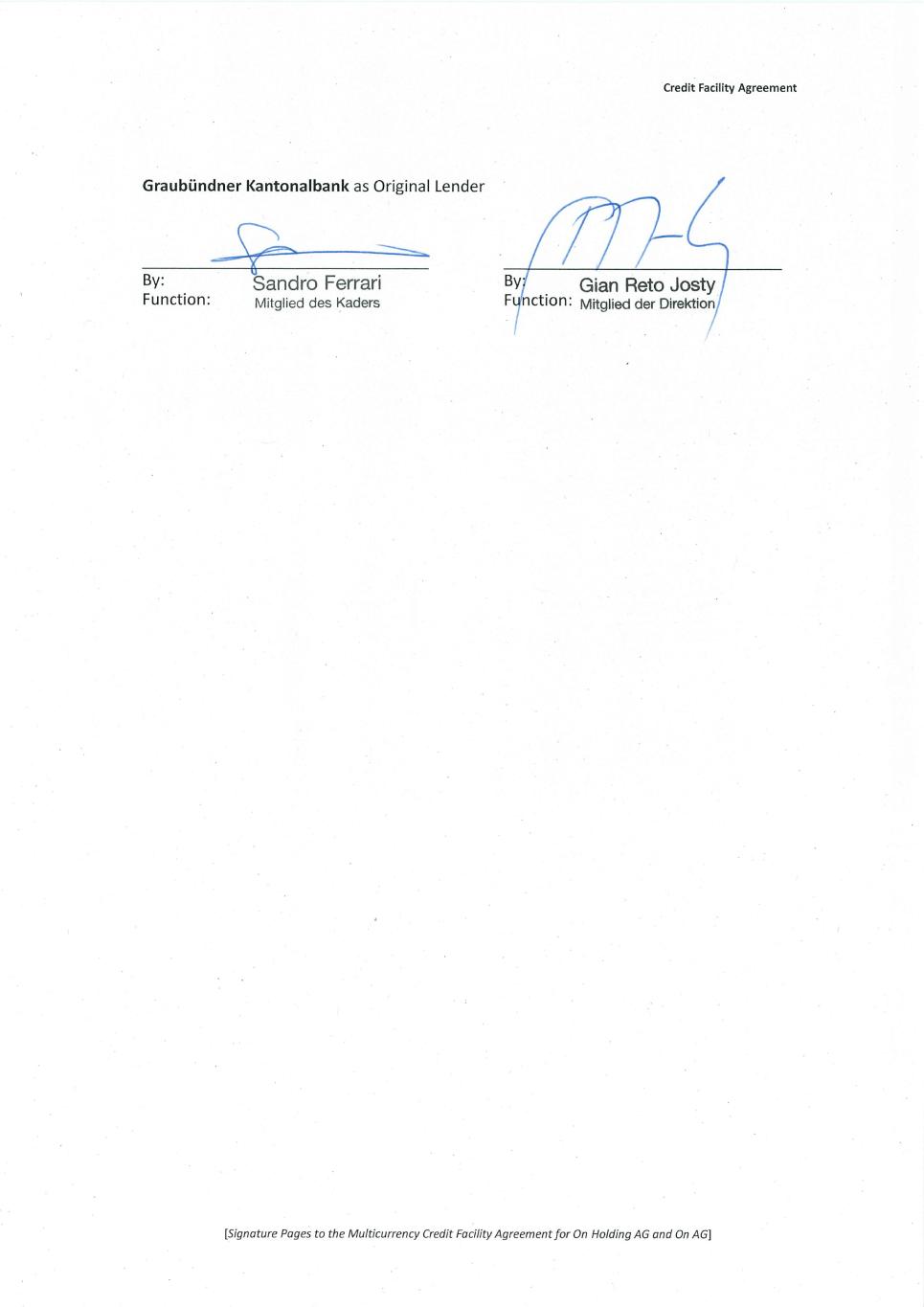
By: Function: Sandro Ferrari Mitglied des Kaders Gian Reto Josty F nction: Mitglied der Direktion By. Credit Facility Agreement Graubündner Kantonalbank as Original Lender [Signature Pages to the Multicurrency Credit Facility Agreement for On Holding AG and On AG]
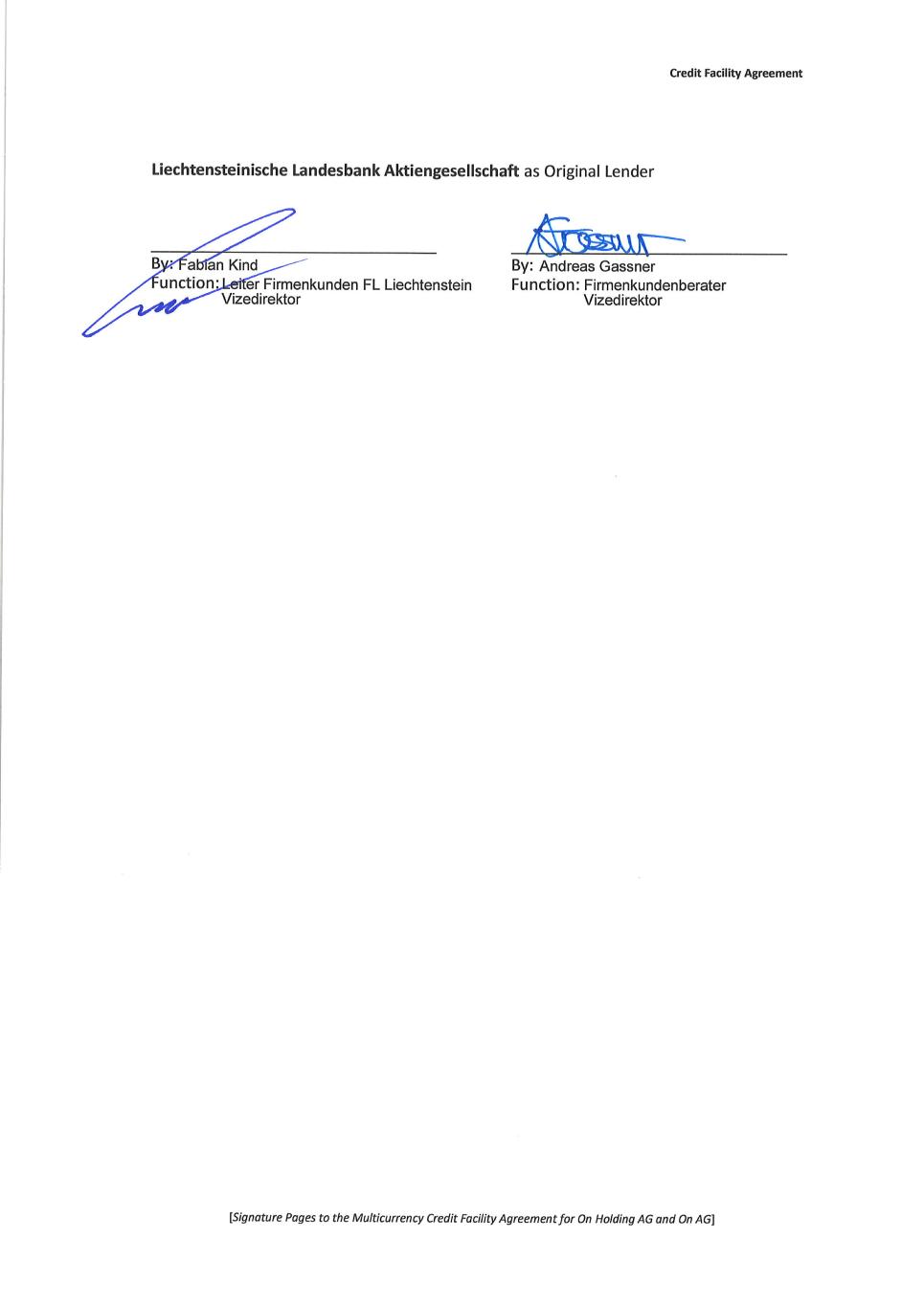
Credlt Faclllty Agreement Liechtensteinische Landesbank Akiengesellschaft as Original Lender Kind Vizedirektor Firmenkunden FL Liechtenstein By: Andreas Gassner Fu nction : Firmenkundenberater Vizedirektor lSignoture Pages to the Multicurrency Credit Focility Agreement for On Holding AG ond On AGI
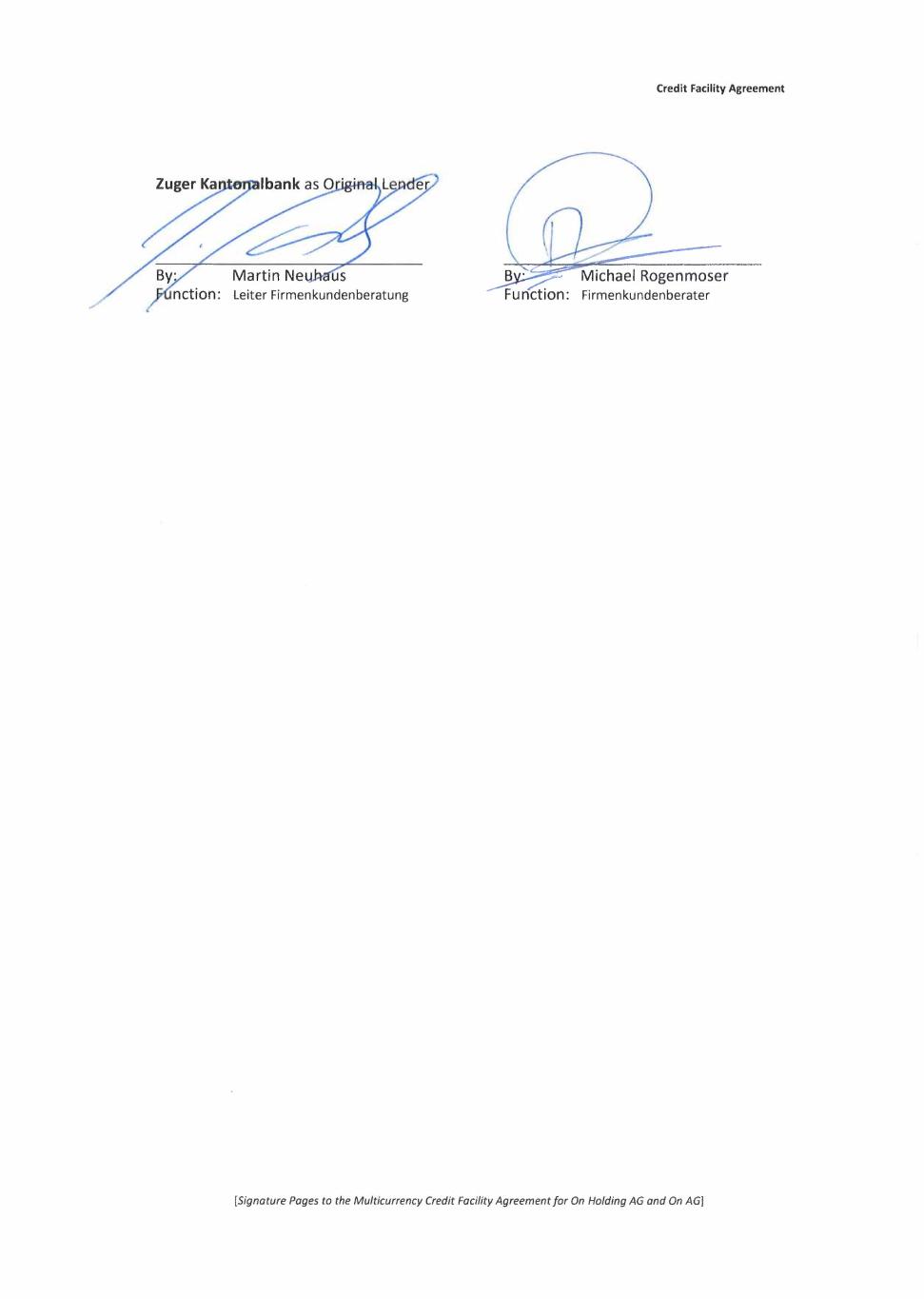
Credit Facility Agreement Firmenkundenberater [Signature Pages ta the Multicurrency Credit Facility Agreement far On Holding AG and On AG]

~.. ce,pQ►c QAukI; Esu+/}[=iSru04:-N gahiE.12 Credit Facility Agreement Freiburger Kantonalbank as Original Lender By: PO PI Function: 6,EScH~4h lS ei..N.d~ )eA /t/Q [Signature Pages to the Multicurrency Credit Facility Agreement for On Holding AG and On AG]

Credit Facility Agreement ~~al Lender By: Adrian Eggenberger Function: Leiter Firmenkunden [Signature Pages to the Multicurrency Credit Facility Agreementfor On Holding AG and On AG)

Crcdit Facility Agr€ement BANCA DE STATO DEL CANTONE TICINO as Original Lender By: Function G.Bassi Condirettore Function: M. Berinl Procuratore lSignature Poges to the Multicurrency Credit Focility Agreement Íor On Holding AG ond On AGI
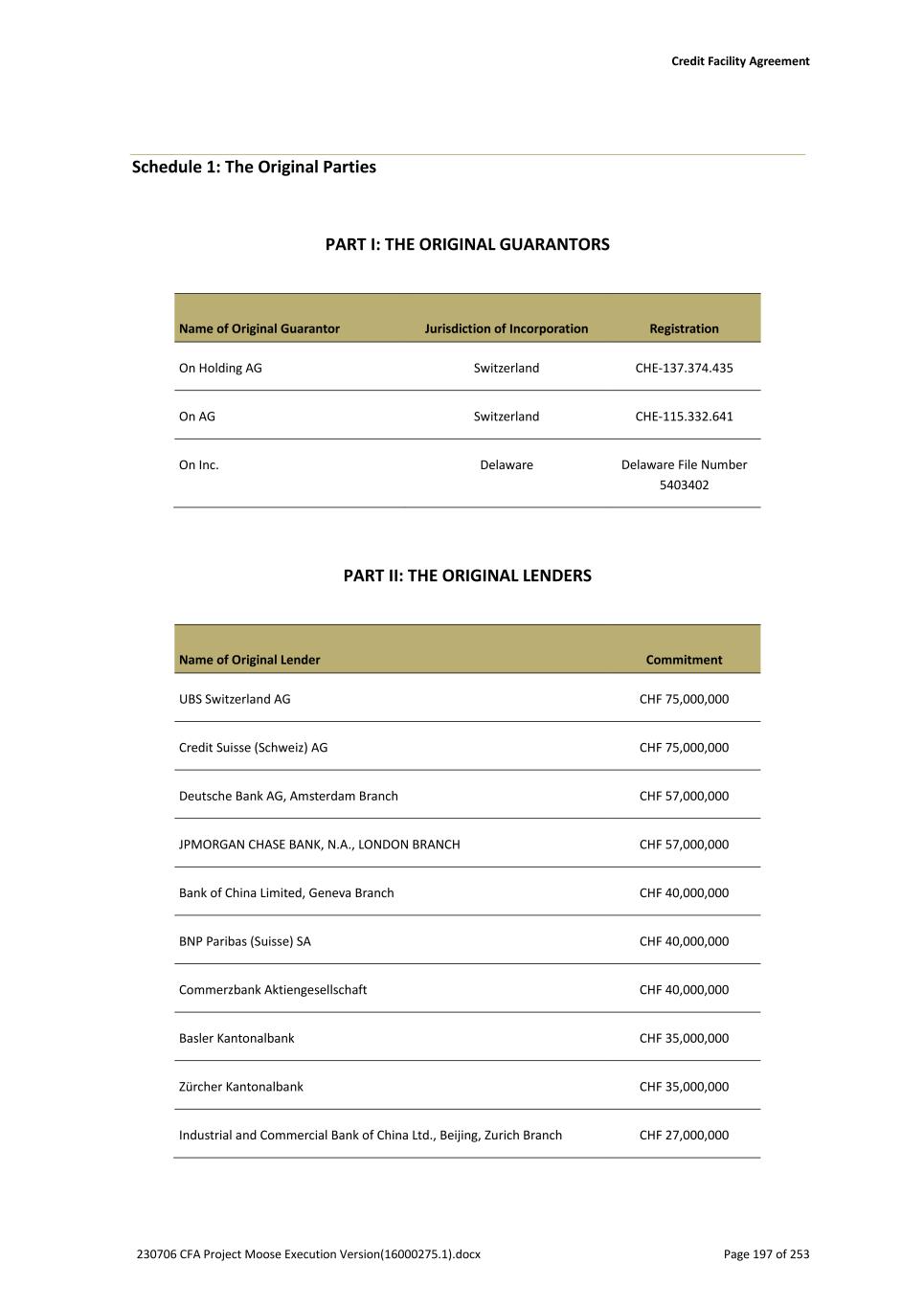
Credit Facility Agreement 230706 CFA Project Moose Execution Version(16000275.1).docx Page 197 of 253 Schedule 1: The Original Parties PART I: THE ORIGINAL GUARANTORS Name of Original Guarantor Jurisdiction of Incorporation Registration On Holding AG Switzerland CHE-137.374.435 On AG Switzerland CHE-115.332.641 On Inc. Delaware Delaware File Number 5403402 PART II: THE ORIGINAL LENDERS Name of Original Lender Commitment UBS Switzerland AG CHF 75,000,000 Credit Suisse (Schweiz) AG CHF 75,000,000 Deutsche Bank AG, Amsterdam Branch CHF 57,000,000 JPMORGAN CHASE BANK, N.A., LONDON BRANCH CHF 57,000,000 Bank of China Limited, Geneva Branch CHF 40,000,000 BNP Paribas (Suisse) SA CHF 40,000,000 Commerzbank Aktiengesellschaft CHF 40,000,000 Basler Kantonalbank CHF 35,000,000 Zürcher Kantonalbank CHF 35,000,000 Industrial and Commercial Bank of China Ltd., Beijing, Zurich Branch CHF 27,000,000
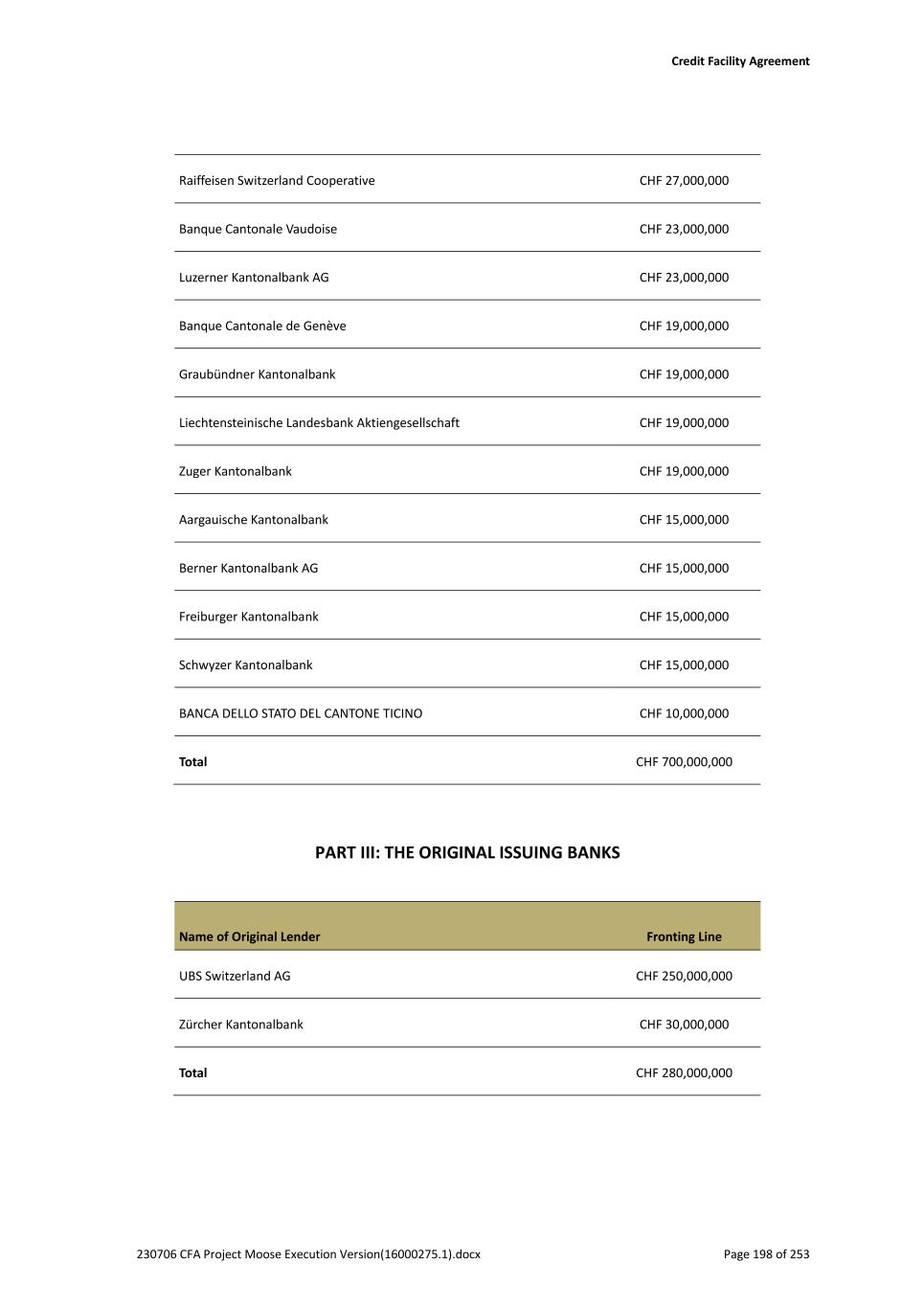
Credit Facility Agreement 230706 CFA Project Moose Execution Version(16000275.1).docx Page 198 of 253 Raiffeisen Switzerland Cooperative CHF 27,000,000 Banque Cantonale Vaudoise CHF 23,000,000 Luzerner Kantonalbank AG CHF 23,000,000 Banque Cantonale de Genève CHF 19,000,000 Graubündner Kantonalbank CHF 19,000,000 Liechtensteinische Landesbank Aktiengesellschaft CHF 19,000,000 Zuger Kantonalbank CHF 19,000,000 Aargauische Kantonalbank CHF 15,000,000 Berner Kantonalbank AG CHF 15,000,000 Freiburger Kantonalbank CHF 15,000,000 Schwyzer Kantonalbank CHF 15,000,000 BANCA DELLO STATO DEL CANTONE TICINO CHF 10,000,000 Total CHF 700,000,000 PART III: THE ORIGINAL ISSUING BANKS Name of Original Lender Fronting Line UBS Switzerland AG CHF 250,000,000 Zürcher Kantonalbank CHF 30,000,000 Total CHF 280,000,000
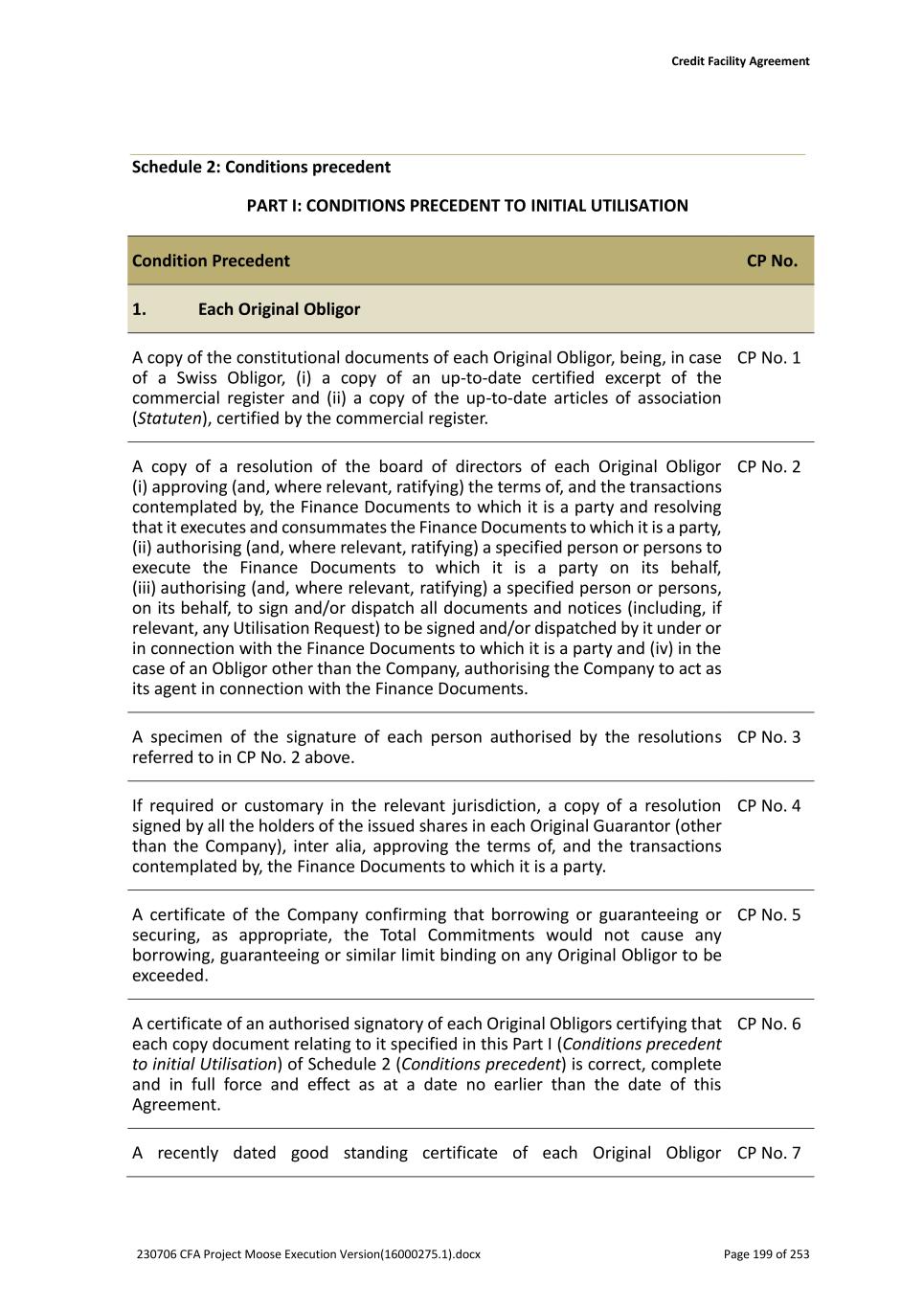
Credit Facility Agreement 230706 CFA Project Moose Execution Version(16000275.1).docx Page 199 of 253 Schedule 2: Conditions precedent PART I: CONDITIONS PRECEDENT TO INITIAL UTILISATION Condition Precedent CP No. 1. Each Original Obligor A copy of the constitutional documents of each Original Obligor, being, in case of a Swiss Obligor, (i) a copy of an up-to-date certified excerpt of the commercial register and (ii) a copy of the up-to-date articles of association (Statuten), certified by the commercial register. CP No. 1 A copy of a resolution of the board of directors of each Original Obligor (i) approving (and, where relevant, ratifying) the terms of, and the transactions contemplated by, the Finance Documents to which it is a party and resolving that it executes and consummates the Finance Documents to which it is a party, (ii) authorising (and, where relevant, ratifying) a specified person or persons to execute the Finance Documents to which it is a party on its behalf, (iii) authorising (and, where relevant, ratifying) a specified person or persons, on its behalf, to sign and/or dispatch all documents and notices (including, if relevant, any Utilisation Request) to be signed and/or dispatched by it under or in connection with the Finance Documents to which it is a party and (iv) in the case of an Obligor other than the Company, authorising the Company to act as its agent in connection with the Finance Documents. CP No. 2 A specimen of the signature of each person authorised by the resolutions referred to in CP No. 2 above. CP No. 3 If required or customary in the relevant jurisdiction, a copy of a resolution signed by all the holders of the issued shares in each Original Guarantor (other than the Company), inter alia, approving the terms of, and the transactions contemplated by, the Finance Documents to which it is a party. CP No. 4 A certificate of the Company confirming that borrowing or guaranteeing or securing, as appropriate, the Total Commitments would not cause any borrowing, guaranteeing or similar limit binding on any Original Obligor to be exceeded. CP No. 5 A certificate of an authorised signatory of each Original Obligors certifying that each copy document relating to it specified in this Part I (Conditions precedent to initial Utilisation) of Schedule 2 (Conditions precedent) is correct, complete and in full force and effect as at a date no earlier than the date of this Agreement. CP No. 6 A recently dated good standing certificate of each Original Obligor CP No. 7
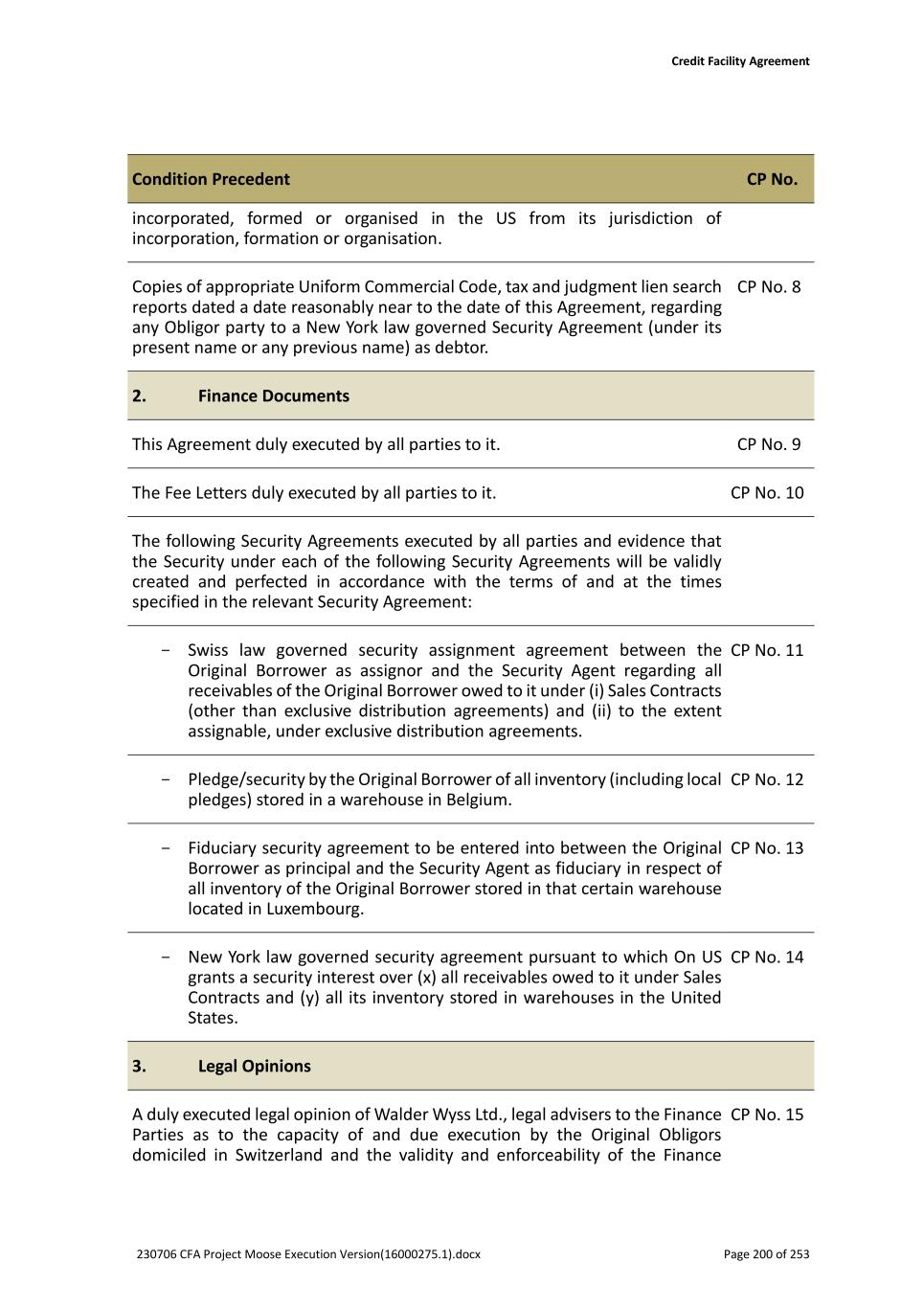
Credit Facility Agreement 230706 CFA Project Moose Execution Version(16000275.1).docx Page 200 of 253 Condition Precedent CP No. incorporated, formed or organised in the US from its jurisdiction of incorporation, formation or organisation. Copies of appropriate Uniform Commercial Code, tax and judgment lien search reports dated a date reasonably near to the date of this Agreement, regarding any Obligor party to a New York law governed Security Agreement (under its present name or any previous name) as debtor. CP No. 8 2. Finance Documents This Agreement duly executed by all parties to it. CP No. 9 The Fee Letters duly executed by all parties to it. CP No. 10 The following Security Agreements executed by all parties and evidence that the Security under each of the following Security Agreements will be validly created and perfected in accordance with the terms of and at the times specified in the relevant Security Agreement: Swiss law governed security assignment agreement between the Original Borrower as assignor and the Security Agent regarding all receivables of the Original Borrower owed to it under (i) Sales Contracts (other than exclusive distribution agreements) and (ii) to the extent assignable, under exclusive distribution agreements. CP No. 11 Pledge/security by the Original Borrower of all inventory (including local pledges) stored in a warehouse in Belgium. CP No. 12 Fiduciary security agreement to be entered into between the Original Borrower as principal and the Security Agent as fiduciary in respect of all inventory of the Original Borrower stored in that certain warehouse located in Luxembourg. CP No. 13 New York law governed security agreement pursuant to which On US grants a security interest over (x) all receivables owed to it under Sales Contracts and (y) all its inventory stored in warehouses in the United States. CP No. 14 3. Legal Opinions A duly executed legal opinion of Walder Wyss Ltd., legal advisers to the Finance Parties as to the capacity of and due execution by the Original Obligors domiciled in Switzerland and the validity and enforceability of the Finance CP No. 15
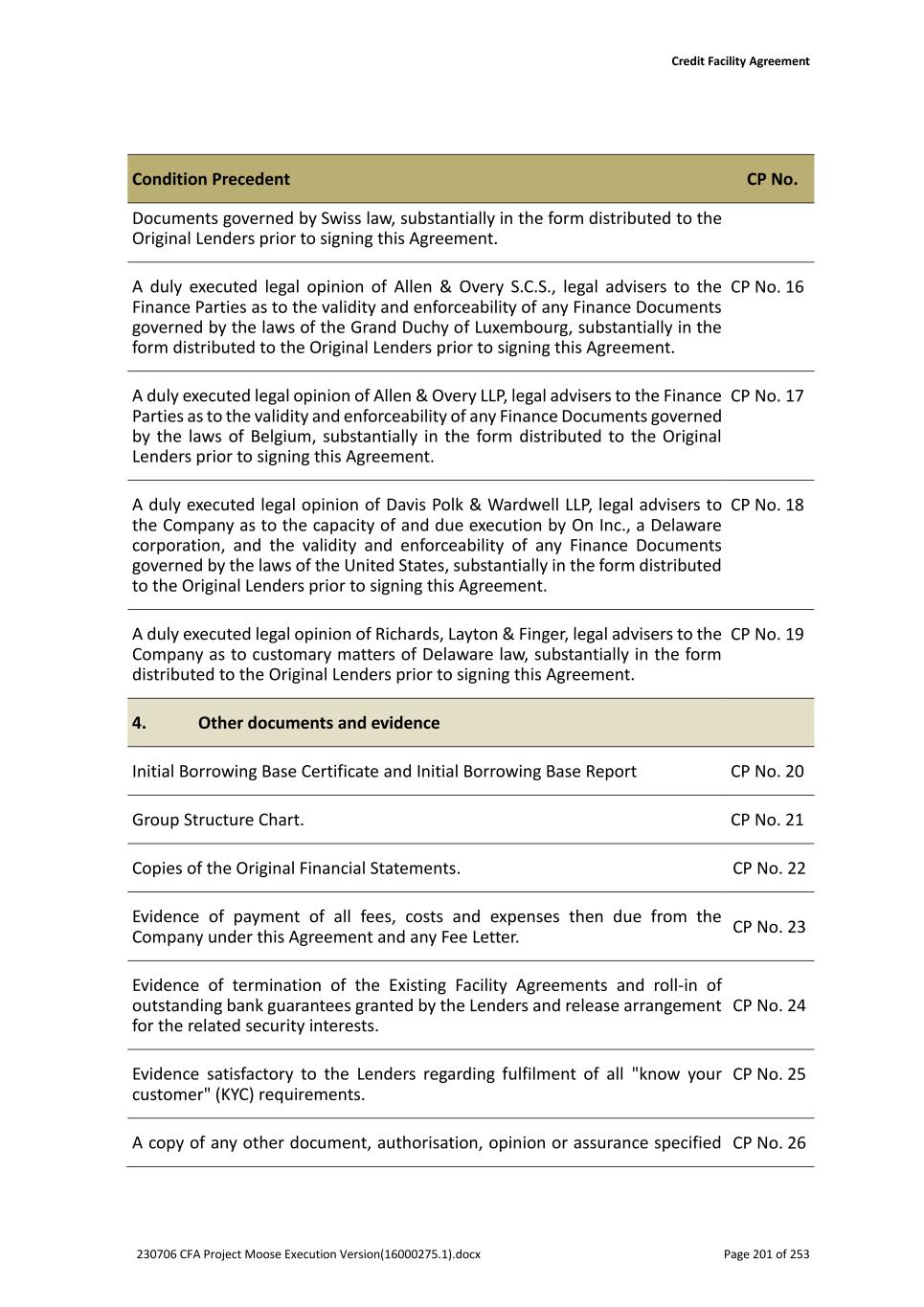
Credit Facility Agreement 230706 CFA Project Moose Execution Version(16000275.1).docx Page 201 of 253 Condition Precedent CP No. Documents governed by Swiss law, substantially in the form distributed to the Original Lenders prior to signing this Agreement. A duly executed legal opinion of Allen & Overy S.C.S., legal advisers to the Finance Parties as to the validity and enforceability of any Finance Documents governed by the laws of the Grand Duchy of Luxembourg, substantially in the form distributed to the Original Lenders prior to signing this Agreement. CP No. 16 A duly executed legal opinion of Allen & Overy LLP, legal advisers to the Finance Parties as to the validity and enforceability of any Finance Documents governed by the laws of Belgium, substantially in the form distributed to the Original Lenders prior to signing this Agreement. CP No. 17 A duly executed legal opinion of Davis Polk & Wardwell LLP, legal advisers to the Company as to the capacity of and due execution by On Inc., a Delaware corporation, and the validity and enforceability of any Finance Documents governed by the laws of the United States, substantially in the form distributed to the Original Lenders prior to signing this Agreement. CP No. 18 A duly executed legal opinion of Richards, Layton & Finger, legal advisers to the Company as to customary matters of Delaware law, substantially in the form distributed to the Original Lenders prior to signing this Agreement. CP No. 19 4. Other documents and evidence Initial Borrowing Base Certificate and Initial Borrowing Base Report CP No. 20 Group Structure Chart. CP No. 21 Copies of the Original Financial Statements. CP No. 22 Evidence of payment of all fees, costs and expenses then due from the Company under this Agreement and any Fee Letter. CP No. 23 Evidence of termination of the Existing Facility Agreements and roll-in of outstanding bank guarantees granted by the Lenders and release arrangement for the related security interests. CP No. 24 Evidence satisfactory to the Lenders regarding fulfilment of all "know your customer" (KYC) requirements. CP No. 25 A copy of any other document, authorisation, opinion or assurance specified CP No. 26
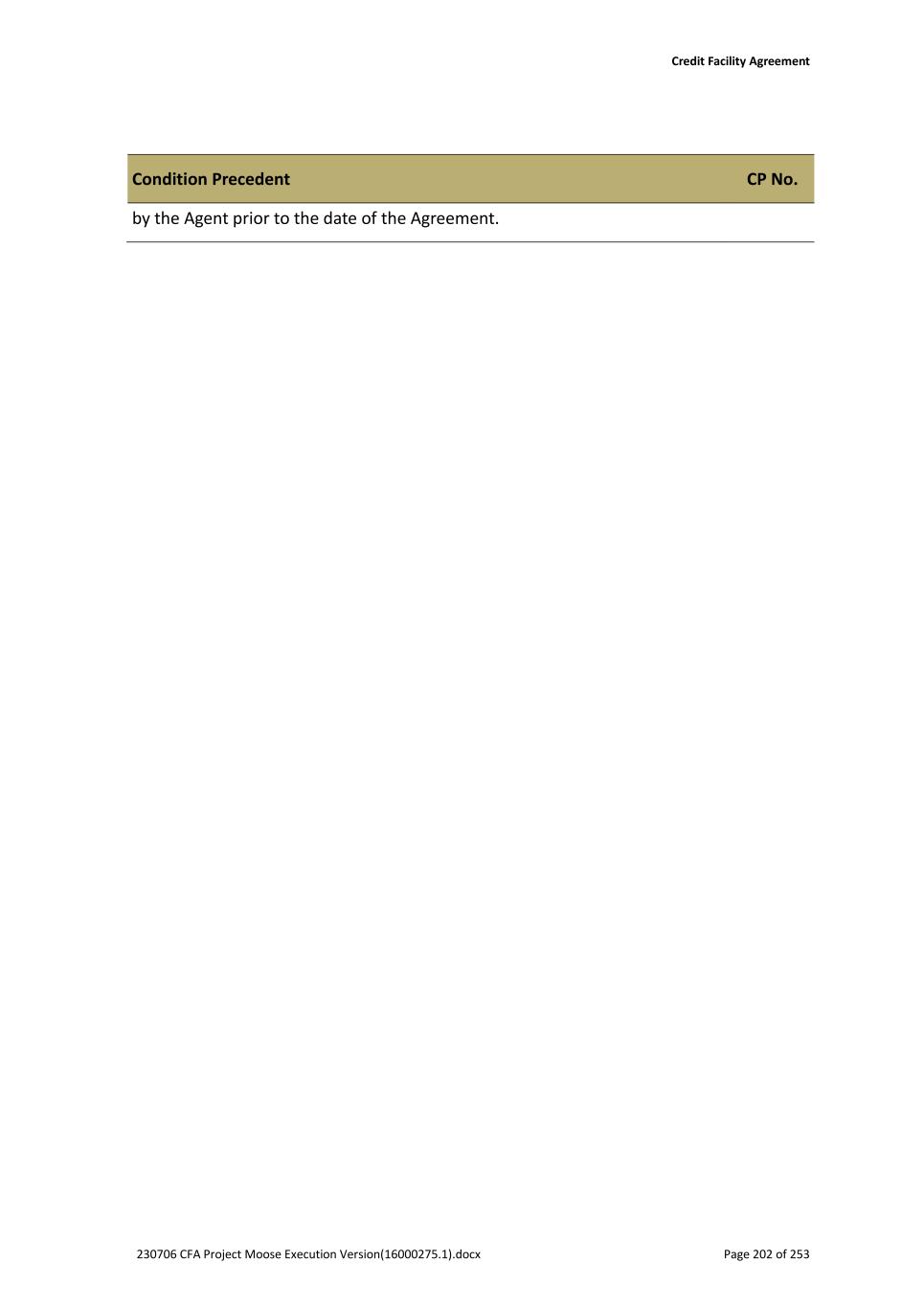
Credit Facility Agreement 230706 CFA Project Moose Execution Version(16000275.1).docx Page 202 of 253 Condition Precedent CP No. by the Agent prior to the date of the Agreement.
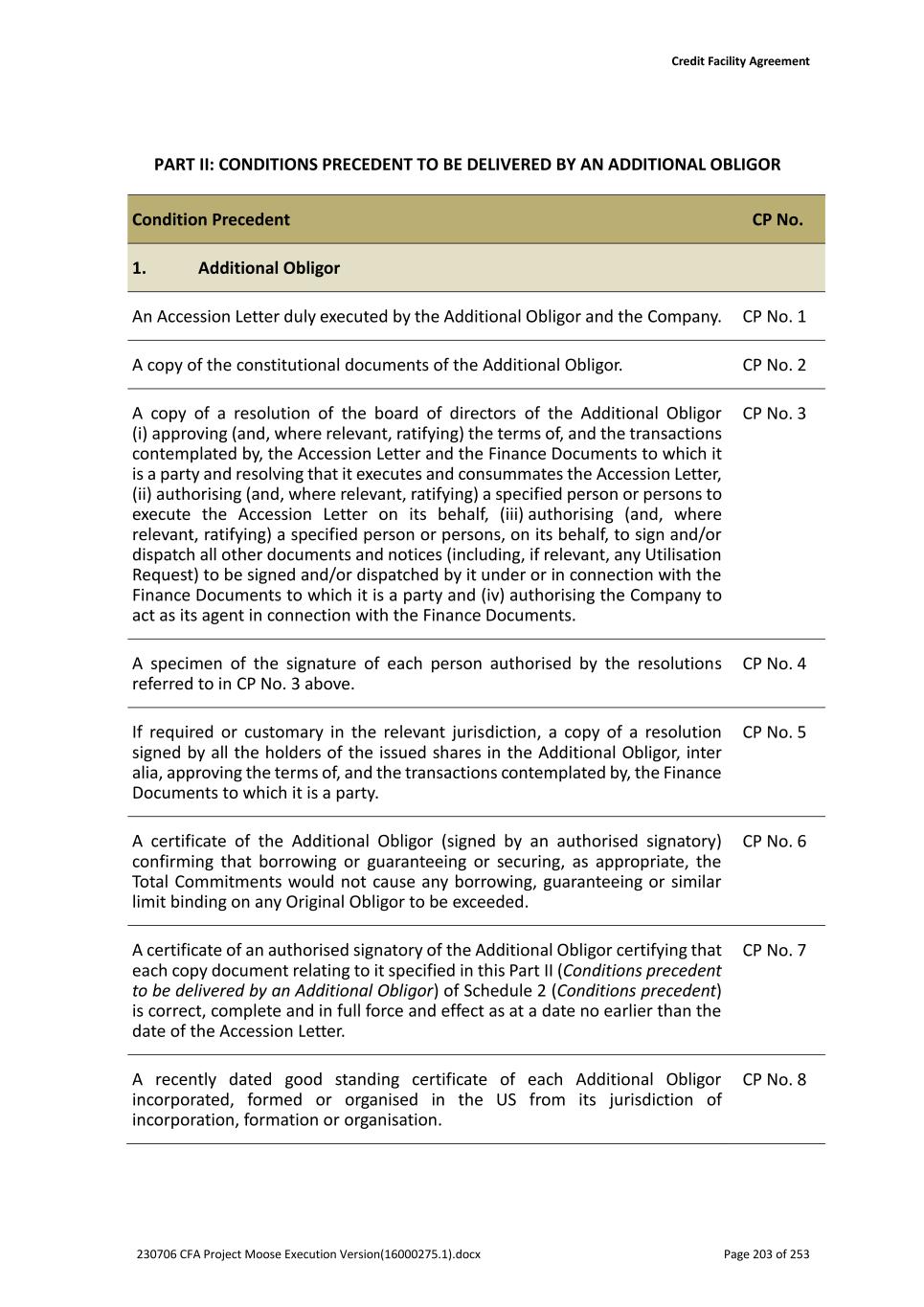
Credit Facility Agreement 230706 CFA Project Moose Execution Version(16000275.1).docx Page 203 of 253 PART II: CONDITIONS PRECEDENT TO BE DELIVERED BY AN ADDITIONAL OBLIGOR Condition Precedent CP No. 1. Additional Obligor An Accession Letter duly executed by the Additional Obligor and the Company. CP No. 1 A copy of the constitutional documents of the Additional Obligor. CP No. 2 A copy of a resolution of the board of directors of the Additional Obligor (i) approving (and, where relevant, ratifying) the terms of, and the transactions contemplated by, the Accession Letter and the Finance Documents to which it is a party and resolving that it executes and consummates the Accession Letter, (ii) authorising (and, where relevant, ratifying) a specified person or persons to execute the Accession Letter on its behalf, (iii) authorising (and, where relevant, ratifying) a specified person or persons, on its behalf, to sign and/or dispatch all other documents and notices (including, if relevant, any Utilisation Request) to be signed and/or dispatched by it under or in connection with the Finance Documents to which it is a party and (iv) authorising the Company to act as its agent in connection with the Finance Documents. CP No. 3 A specimen of the signature of each person authorised by the resolutions referred to in CP No. 3 above. CP No. 4 If required or customary in the relevant jurisdiction, a copy of a resolution signed by all the holders of the issued shares in the Additional Obligor, inter alia, approving the terms of, and the transactions contemplated by, the Finance Documents to which it is a party. CP No. 5 A certificate of the Additional Obligor (signed by an authorised signatory) confirming that borrowing or guaranteeing or securing, as appropriate, the Total Commitments would not cause any borrowing, guaranteeing or similar limit binding on any Original Obligor to be exceeded. CP No. 6 A certificate of an authorised signatory of the Additional Obligor certifying that each copy document relating to it specified in this Part II (Conditions precedent to be delivered by an Additional Obligor) of Schedule 2 (Conditions precedent) is correct, complete and in full force and effect as at a date no earlier than the date of the Accession Letter. CP No. 7 A recently dated good standing certificate of each Additional Obligor incorporated, formed or organised in the US from its jurisdiction of incorporation, formation or organisation. CP No. 8
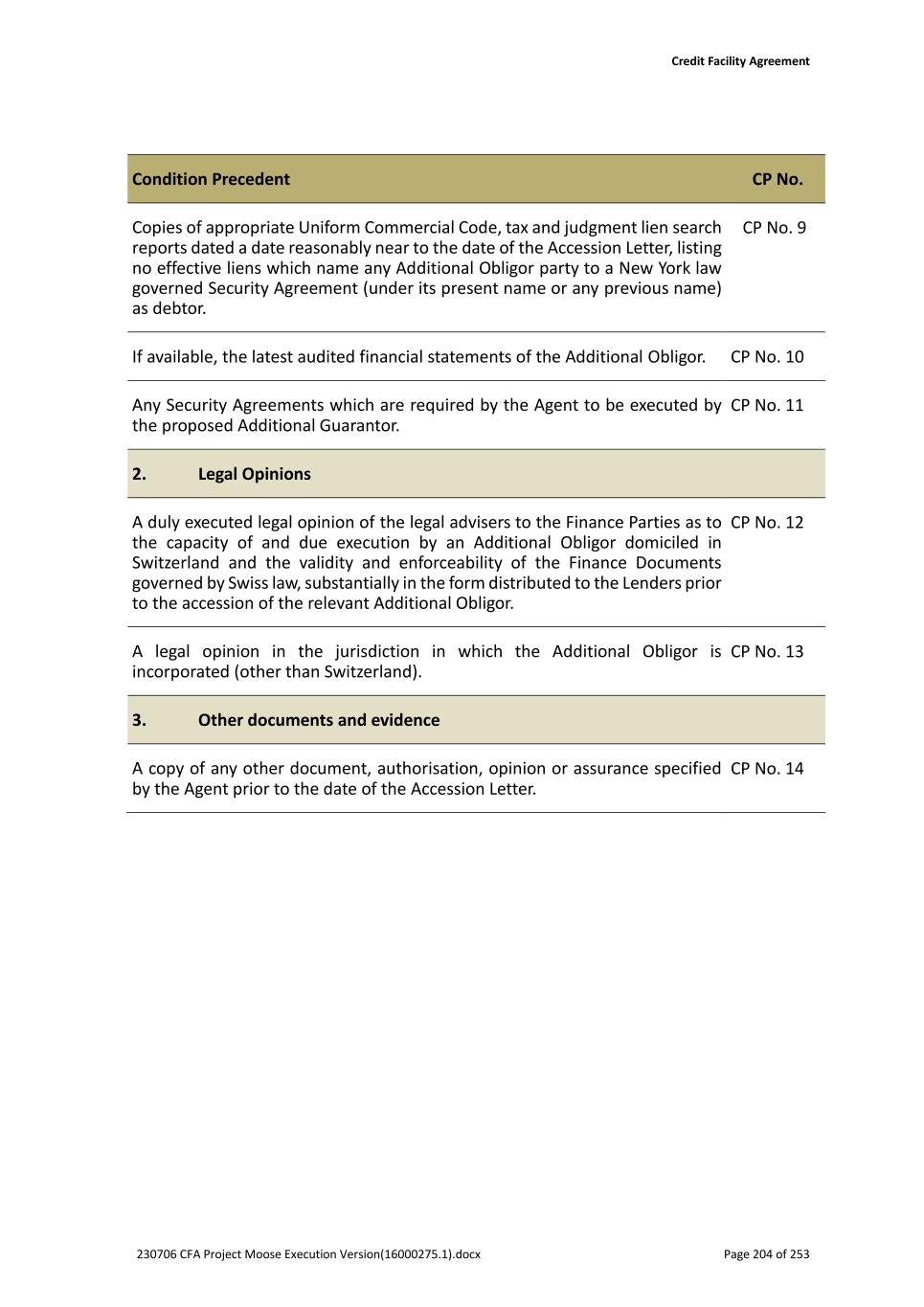
Credit Facility Agreement 230706 CFA Project Moose Execution Version(16000275.1).docx Page 204 of 253 Condition Precedent CP No. Copies of appropriate Uniform Commercial Code, tax and judgment lien search reports dated a date reasonably near to the date of the Accession Letter, listing no effective liens which name any Additional Obligor party to a New York law governed Security Agreement (under its present name or any previous name) as debtor. CP No. 9 If available, the latest audited financial statements of the Additional Obligor. CP No. 10 Any Security Agreements which are required by the Agent to be executed by the proposed Additional Guarantor. CP No. 11 2. Legal Opinions A duly executed legal opinion of the legal advisers to the Finance Parties as to the capacity of and due execution by an Additional Obligor domiciled in Switzerland and the validity and enforceability of the Finance Documents governed by Swiss law, substantially in the form distributed to the Lenders prior to the accession of the relevant Additional Obligor. CP No. 12 A legal opinion in the jurisdiction in which the Additional Obligor is incorporated (other than Switzerland). CP No. 13 3. Other documents and evidence A copy of any other document, authorisation, opinion or assurance specified by the Agent prior to the date of the Accession Letter. CP No. 14
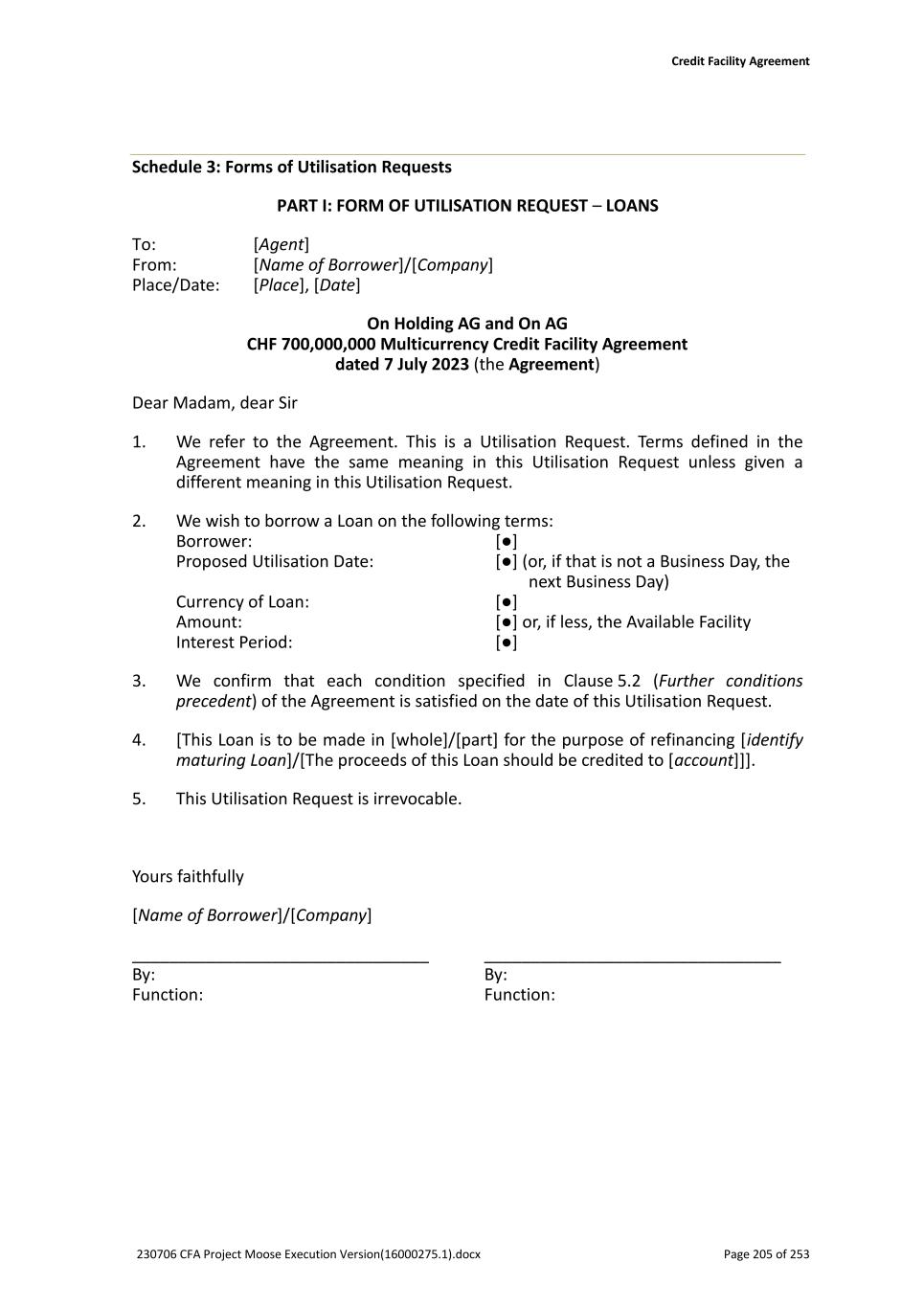
Credit Facility Agreement 230706 CFA Project Moose Execution Version(16000275.1).docx Page 205 of 253 Schedule 3: Forms of Utilisation Requests PART I: FORM OF UTILISATION REQUEST – LOANS To: [Agent] From: [Name of Borrower]/[Company] Place/Date: [Place], [Date] On Holding AG and On AG CHF 700,000,000 Multicurrency Credit Facility Agreement dated 7 July 2023 (the Agreement) Dear Madam, dear Sir 1. We refer to the Agreement. This is a Utilisation Request. Terms defined in the Agreement have the same meaning in this Utilisation Request unless given a different meaning in this Utilisation Request. 2. We wish to borrow a Loan on the following terms: Borrower: [●] Proposed Utilisation Date: [●] (or, if that is not a Business Day, the next Business Day) Currency of Loan: [●] Amount: [●] or, if less, the Available Facility Interest Period: [●] 3. We confirm that each condition specified in Clause 5.2 (Further conditions precedent) of the Agreement is satisfied on the date of this Utilisation Request. 4. [This Loan is to be made in [whole]/[part] for the purpose of refinancing [identify maturing Loan]/[The proceeds of this Loan should be credited to [account]]]. 5. This Utilisation Request is irrevocable. Yours faithfully [Name of Borrower]/[Company] ________________________________ ________________________________ By: By: Function: Function:
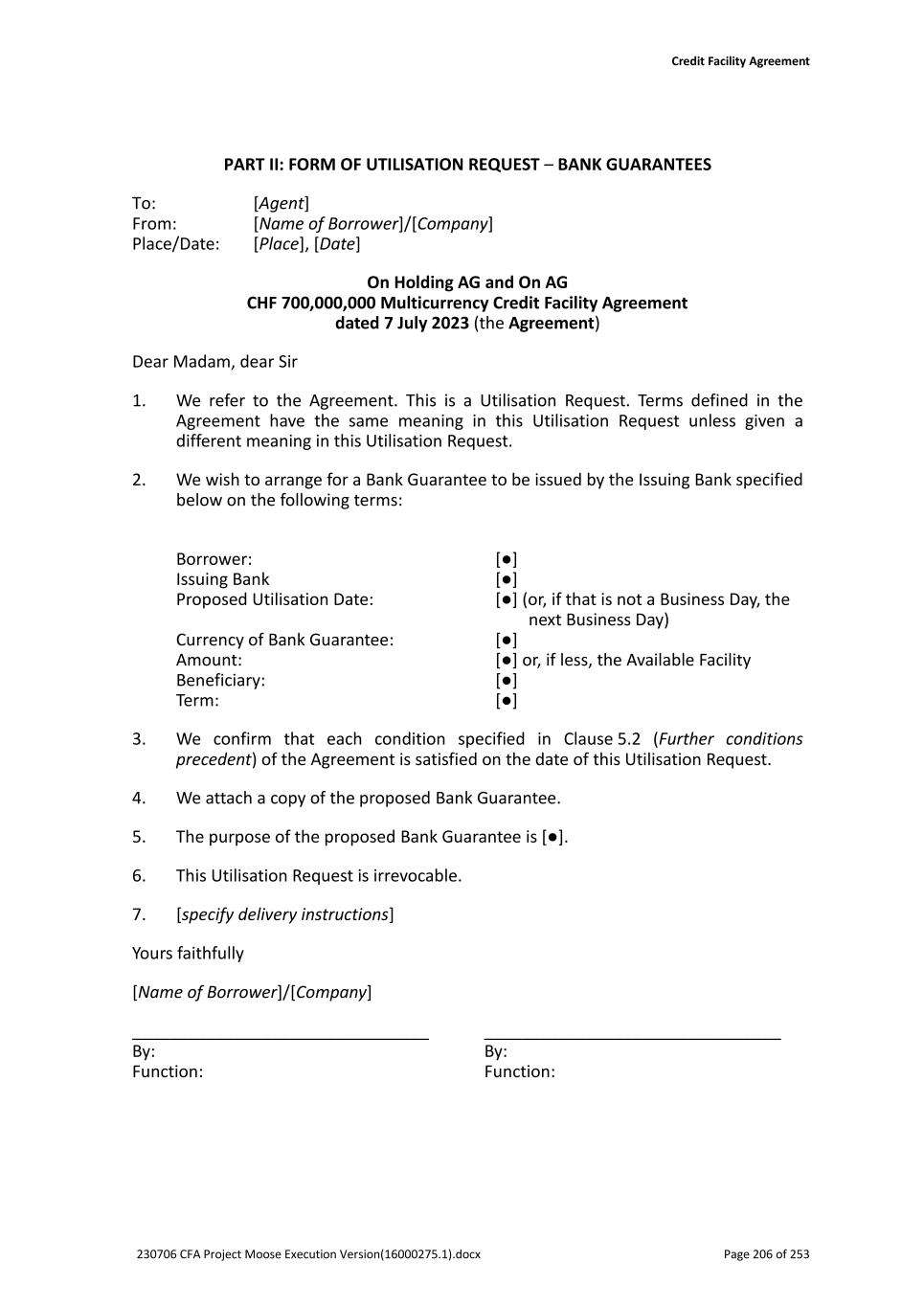
Credit Facility Agreement 230706 CFA Project Moose Execution Version(16000275.1).docx Page 206 of 253 PART II: FORM OF UTILISATION REQUEST – BANK GUARANTEES To: [Agent] From: [Name of Borrower]/[Company] Place/Date: [Place], [Date] On Holding AG and On AG CHF 700,000,000 Multicurrency Credit Facility Agreement dated 7 July 2023 (the Agreement) Dear Madam, dear Sir 1. We refer to the Agreement. This is a Utilisation Request. Terms defined in the Agreement have the same meaning in this Utilisation Request unless given a different meaning in this Utilisation Request. 2. We wish to arrange for a Bank Guarantee to be issued by the Issuing Bank specified below on the following terms: Borrower: [●] Issuing Bank [●] Proposed Utilisation Date: [●] (or, if that is not a Business Day, the next Business Day) Currency of Bank Guarantee: [●] Amount: [●] or, if less, the Available Facility Beneficiary: [●] Term: [●] 3. We confirm that each condition specified in Clause 5.2 (Further conditions precedent) of the Agreement is satisfied on the date of this Utilisation Request. 4. We attach a copy of the proposed Bank Guarantee. 5. The purpose of the proposed Bank Guarantee is [●]. 6. This Utilisation Request is irrevocable. 7. [specify delivery instructions] Yours faithfully [Name of Borrower]/[Company] ________________________________ ________________________________ By: By: Function: Function:
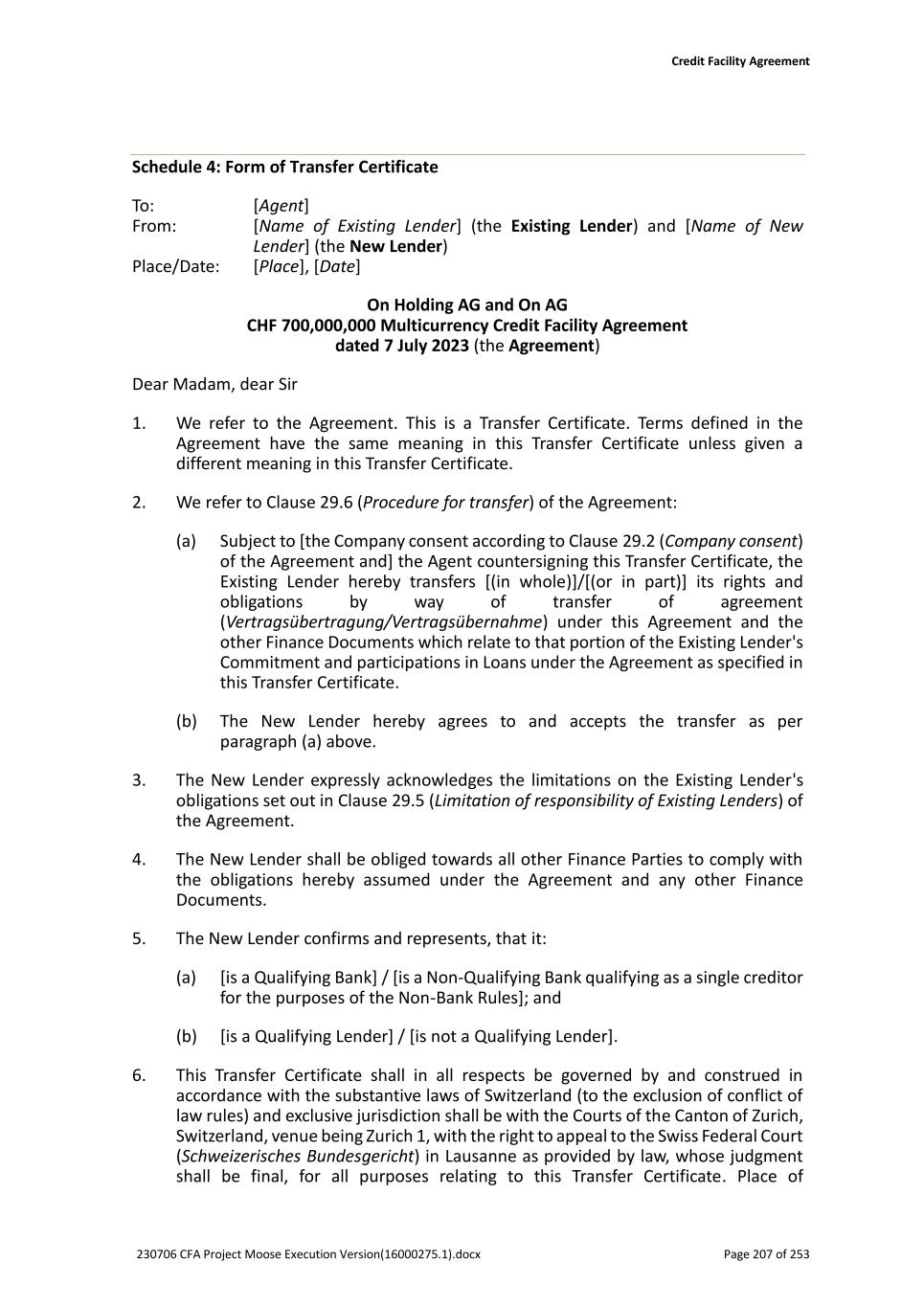
Credit Facility Agreement 230706 CFA Project Moose Execution Version(16000275.1).docx Page 207 of 253 Schedule 4: Form of Transfer Certificate To: [Agent] From: [Name of Existing Lender] (the Existing Lender) and [Name of New Lender] (the New Lender) Place/Date: [Place], [Date] On Holding AG and On AG CHF 700,000,000 Multicurrency Credit Facility Agreement dated 7 July 2023 (the Agreement) Dear Madam, dear Sir 1. We refer to the Agreement. This is a Transfer Certificate. Terms defined in the Agreement have the same meaning in this Transfer Certificate unless given a different meaning in this Transfer Certificate. 2. We refer to Clause 29.6 (Procedure for transfer) of the Agreement: (a) Subject to [the Company consent according to Clause 29.2 (Company consent) of the Agreement and] the Agent countersigning this Transfer Certificate, the Existing Lender hereby transfers [(in whole)]/[(or in part)] its rights and obligations by way of transfer of agreement (Vertragsübertragung/Vertragsübernahme) under this Agreement and the other Finance Documents which relate to that portion of the Existing Lender's Commitment and participations in Loans under the Agreement as specified in this Transfer Certificate. (b) The New Lender hereby agrees to and accepts the transfer as per paragraph (a) above. 3. The New Lender expressly acknowledges the limitations on the Existing Lender's obligations set out in Clause 29.5 (Limitation of responsibility of Existing Lenders) of the Agreement. 4. The New Lender shall be obliged towards all other Finance Parties to comply with the obligations hereby assumed under the Agreement and any other Finance Documents. 5. The New Lender confirms and represents, that it: (a) [is a Qualifying Bank] / [is a Non-Qualifying Bank qualifying as a single creditor for the purposes of the Non-Bank Rules]; and (b) [is a Qualifying Lender] / [is not a Qualifying Lender]. 6. This Transfer Certificate shall in all respects be governed by and construed in accordance with the substantive laws of Switzerland (to the exclusion of conflict of law rules) and exclusive jurisdiction shall be with the Courts of the Canton of Zurich, Switzerland, venue being Zurich 1, with the right to appeal to the Swiss Federal Court (Schweizerisches Bundesgericht) in Lausanne as provided by law, whose judgment shall be final, for all purposes relating to this Transfer Certificate. Place of
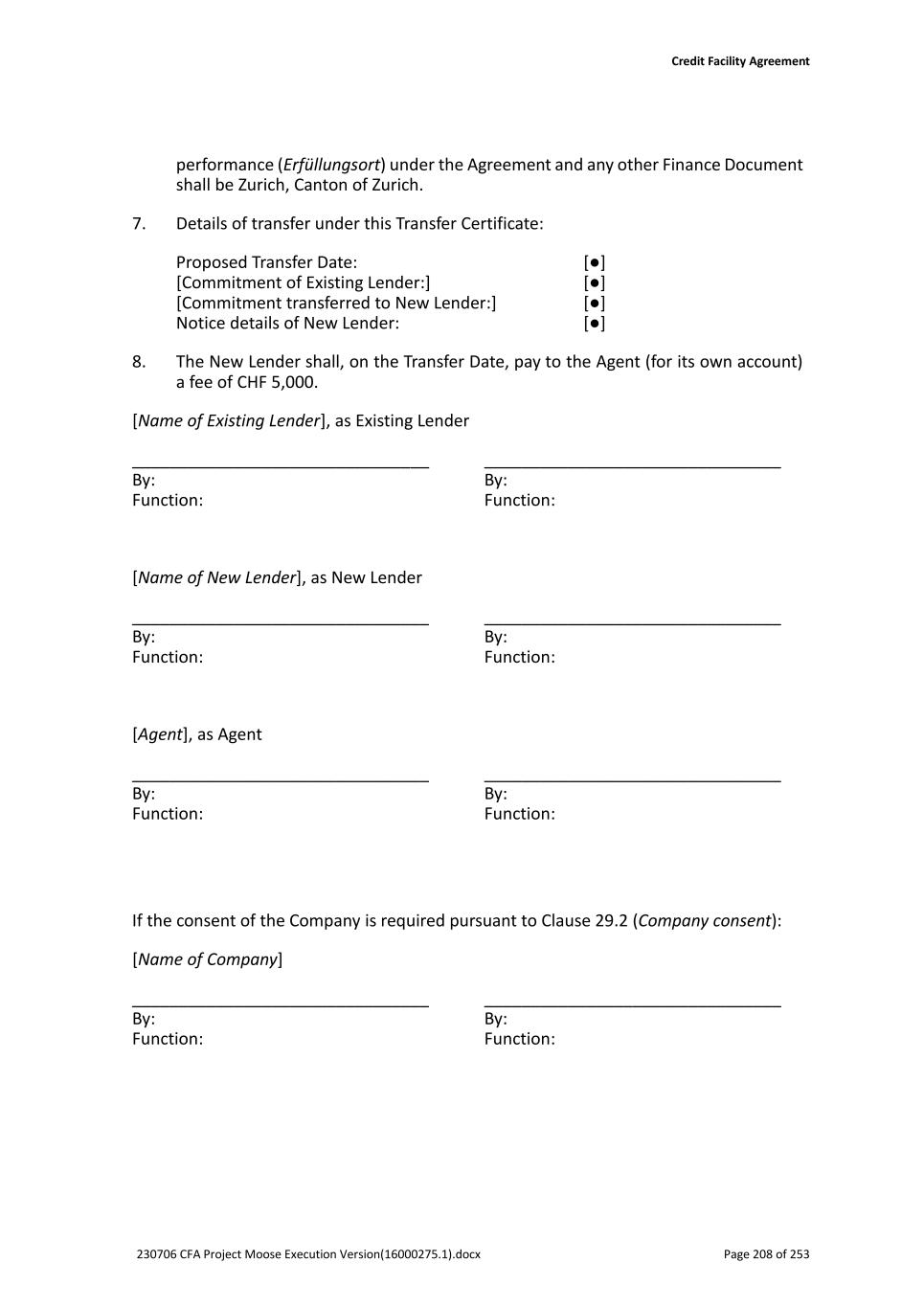
Credit Facility Agreement 230706 CFA Project Moose Execution Version(16000275.1).docx Page 208 of 253 performance (Erfüllungsort) under the Agreement and any other Finance Document shall be Zurich, Canton of Zurich. 7. Details of transfer under this Transfer Certificate: Proposed Transfer Date: [●] [Commitment of Existing Lender:] [●] [Commitment transferred to New Lender:] [●] Notice details of New Lender: [●] 8. The New Lender shall, on the Transfer Date, pay to the Agent (for its own account) a fee of CHF 5,000. [Name of Existing Lender], as Existing Lender ________________________________ ________________________________ By: By: Function: Function: [Name of New Lender], as New Lender ________________________________ ________________________________ By: By: Function: Function: [Agent], as Agent ________________________________ ________________________________ By: By: Function: Function: If the consent of the Company is required pursuant to Clause 29.2 (Company consent): [Name of Company] ________________________________ ________________________________ By: By: Function: Function:
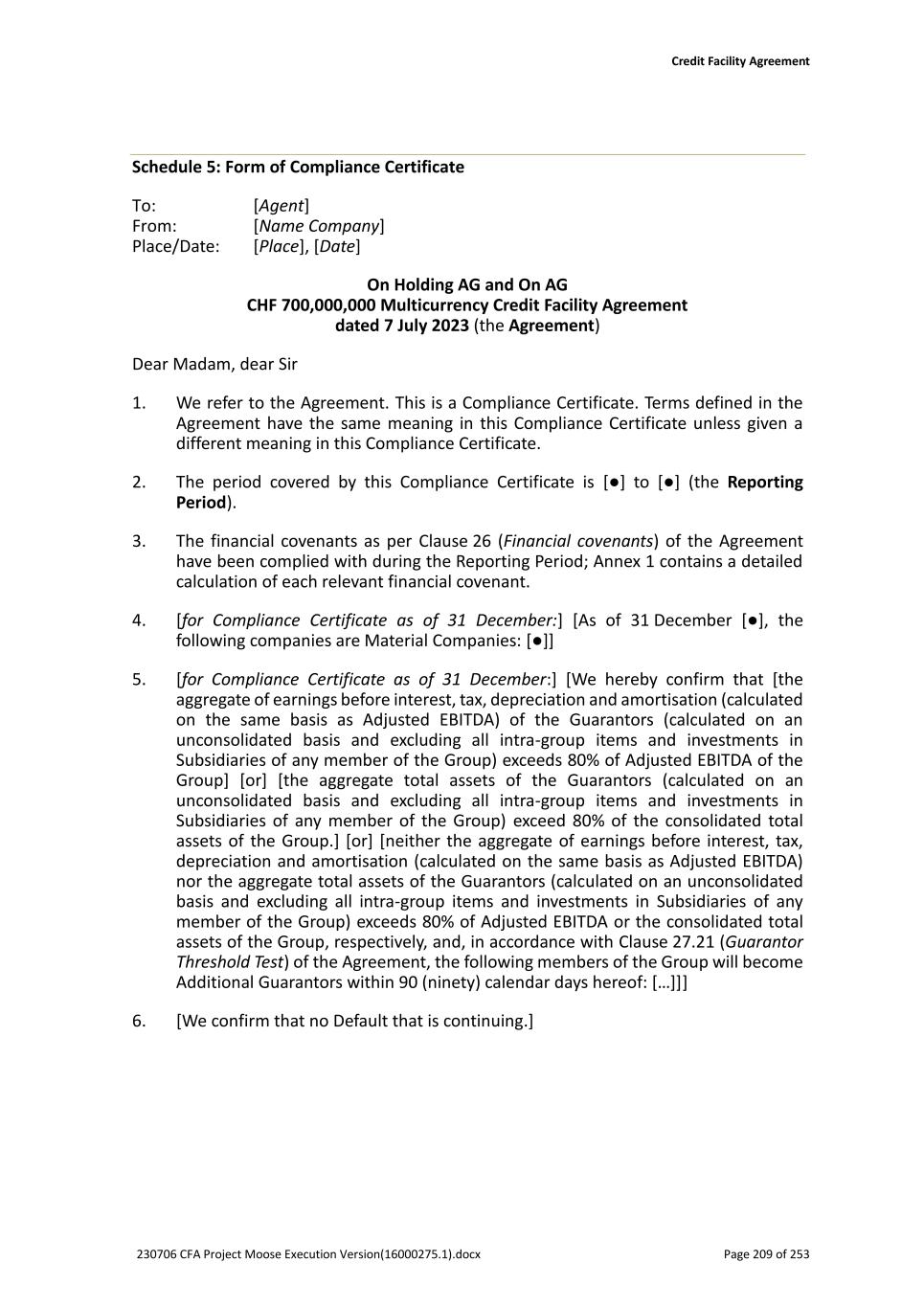
Credit Facility Agreement 230706 CFA Project Moose Execution Version(16000275.1).docx Page 209 of 253 Schedule 5: Form of Compliance Certificate To: [Agent] From: [Name Company] Place/Date: [Place], [Date] On Holding AG and On AG CHF 700,000,000 Multicurrency Credit Facility Agreement dated 7 July 2023 (the Agreement) Dear Madam, dear Sir 1. We refer to the Agreement. This is a Compliance Certificate. Terms defined in the Agreement have the same meaning in this Compliance Certificate unless given a different meaning in this Compliance Certificate. 2. The period covered by this Compliance Certificate is [●] to [●] (the Reporting Period). 3. The financial covenants as per Clause 26 (Financial covenants) of the Agreement have been complied with during the Reporting Period; Annex 1 contains a detailed calculation of each relevant financial covenant. 4. [for Compliance Certificate as of 31 December:] [As of 31 December [●], the following companies are Material Companies: [●]] 5. [for Compliance Certificate as of 31 December:] [We hereby confirm that [the aggregate of earnings before interest, tax, depreciation and amortisation (calculated on the same basis as Adjusted EBITDA) of the Guarantors (calculated on an unconsolidated basis and excluding all intra-group items and investments in Subsidiaries of any member of the Group) exceeds 80% of Adjusted EBITDA of the Group] [or] [the aggregate total assets of the Guarantors (calculated on an unconsolidated basis and excluding all intra-group items and investments in Subsidiaries of any member of the Group) exceed 80% of the consolidated total assets of the Group.] [or] [neither the aggregate of earnings before interest, tax, depreciation and amortisation (calculated on the same basis as Adjusted EBITDA) nor the aggregate total assets of the Guarantors (calculated on an unconsolidated basis and excluding all intra-group items and investments in Subsidiaries of any member of the Group) exceeds 80% of Adjusted EBITDA or the consolidated total assets of the Group, respectively, and, in accordance with Clause 27.21 (Guarantor Threshold Test) of the Agreement, the following members of the Group will become Additional Guarantors within 90 (ninety) calendar days hereof: […]]] 6. [We confirm that no Default that is continuing.]

Credit Facility Agreement 230706 CFA Project Moose Execution Version(16000275.1).docx Page 210 of 253 Yours faithfully [Company] ________________________________ ________________________________ By: By: Function: Function:
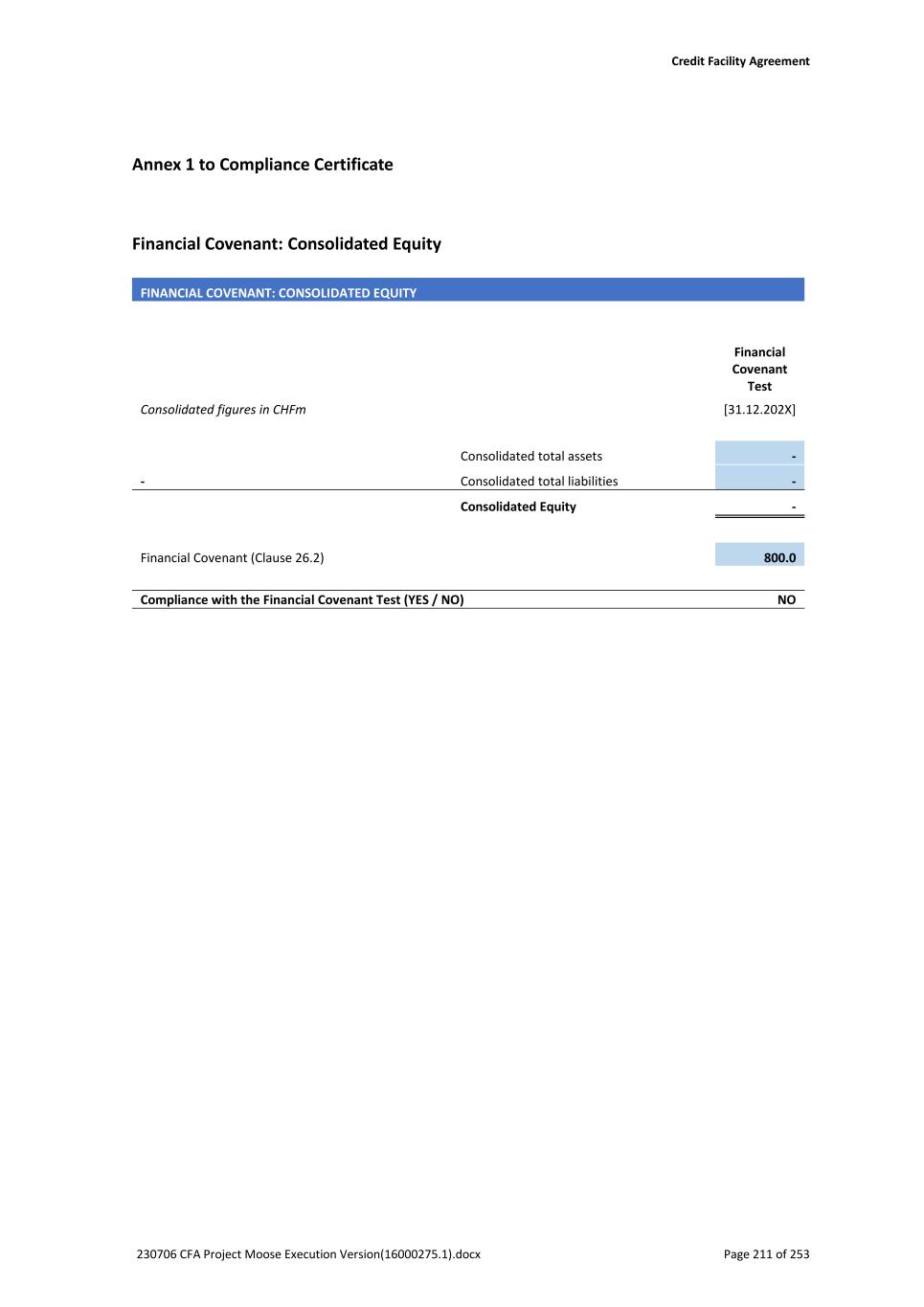
Credit Facility Agreement 230706 CFA Project Moose Execution Version(16000275.1).docx Page 211 of 253 Annex 1 to Compliance Certificate Financial Covenant: Consolidated Equity FINANCIAL COVENANT: CONSOLIDATED EQUITY Financial Covenant Test Consolidated figures in CHFm [31.12.202X] Consolidated total assets - - Consolidated total liabilities - Consolidated Equity - Financial Covenant (Clause 26.2) 800.0 Compliance with the Financial Covenant Test (YES / NO) NO
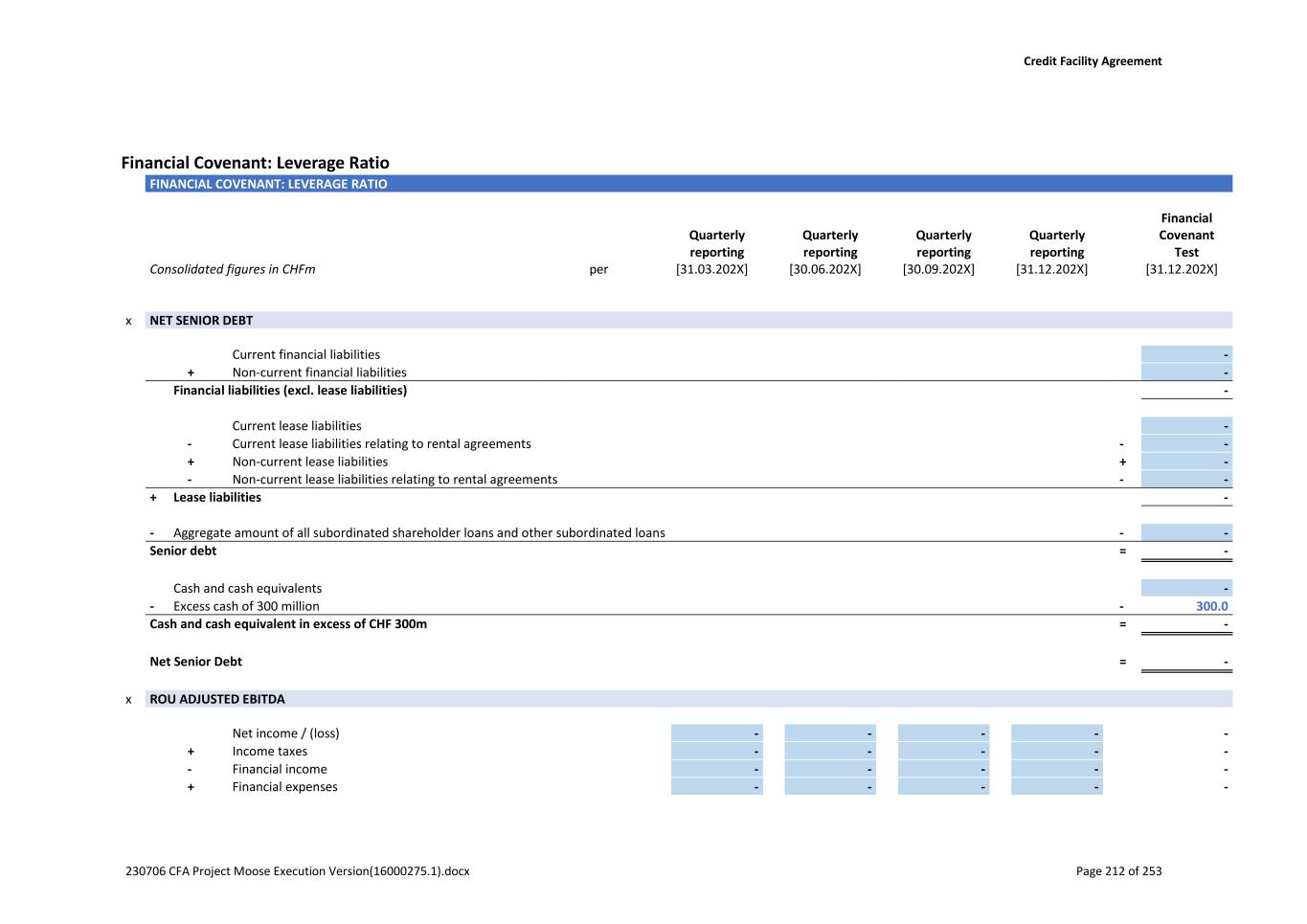
Credit Facility Agreement 230706 CFA Project Moose Execution Version(16000275.1).docx Page 212 of 253 Financial Covenant: Leverage Ratio FINANCIAL COVENANT: LEVERAGE RATIO Quarterly reporting Quarterly reporting Quarterly reporting Quarterly reporting Financial Covenant Test Consolidated figures in CHFm per [31.03.202X] [30.06.202X] [30.09.202X] [31.12.202X] [31.12.202X] x NET SENIOR DEBT Current financial liabilities - + Non-current financial liabilities - Financial liabilities (excl. lease liabilities) - Current lease liabilities - - Current lease liabilities relating to rental agreements - - + Non-current lease liabilities + - - Non-current lease liabilities relating to rental agreements - - + Lease liabilities - - Aggregate amount of all subordinated shareholder loans and other subordinated loans - - Senior debt = - Cash and cash equivalents - - Excess cash of 300 million - 300.0 Cash and cash equivalent in excess of CHF 300m = - Net Senior Debt = - x ROU ADJUSTED EBITDA Net income / (loss) - - - - - + Income taxes - - - - - - Financial income - - - - - + Financial expenses - - - - -
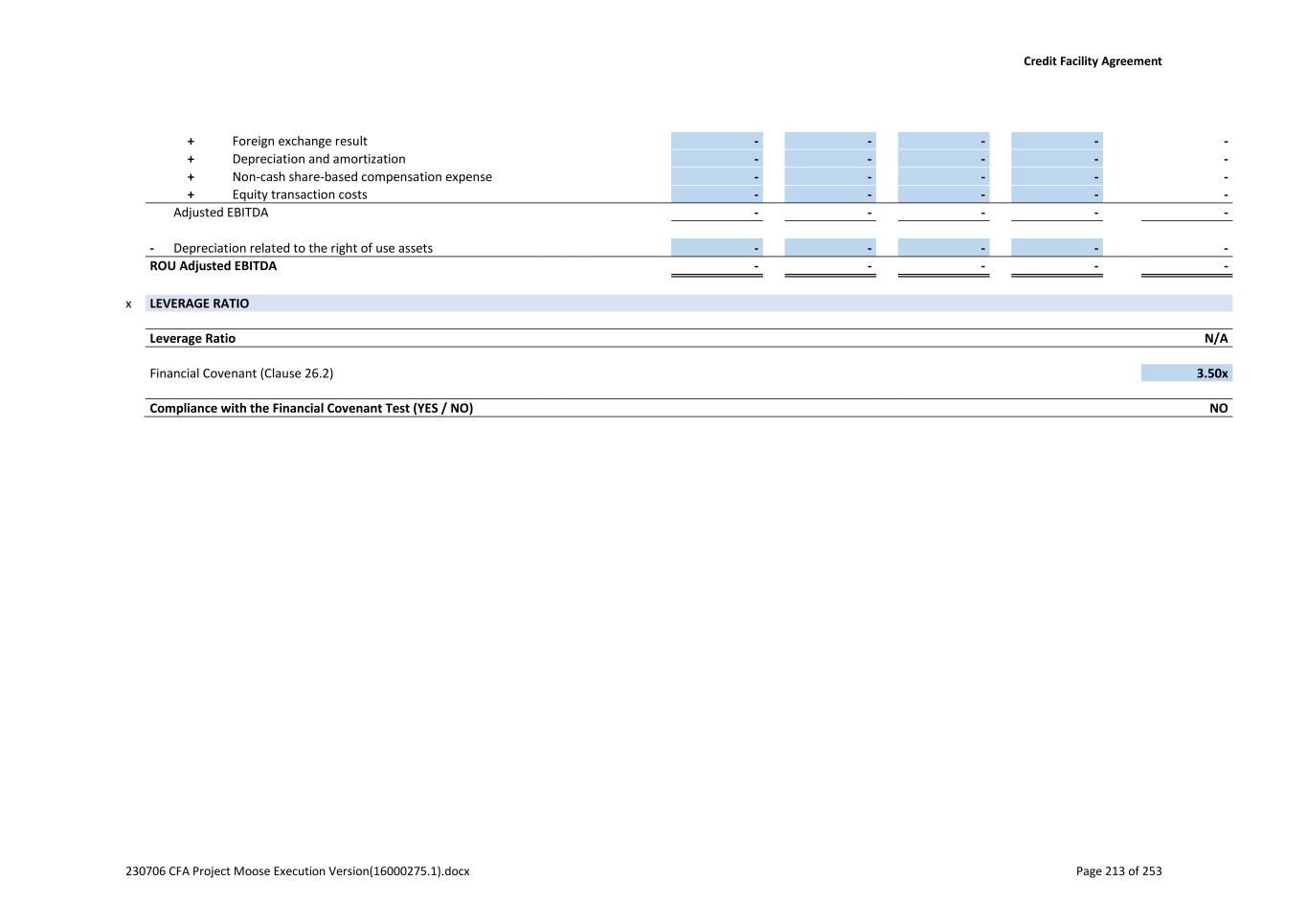
Credit Facility Agreement 230706 CFA Project Moose Execution Version(16000275.1).docx Page 213 of 253 + Foreign exchange result - - - - - + Depreciation and amortization - - - - - + Non-cash share-based compensation expense - - - - - + Equity transaction costs - - - - - Adjusted EBITDA - - - - - - Depreciation related to the right of use assets - - - - - ROU Adjusted EBITDA - - - - - x LEVERAGE RATIO Leverage Ratio N/A Financial Covenant (Clause 26.2) 3.50x Compliance with the Financial Covenant Test (YES / NO) NO
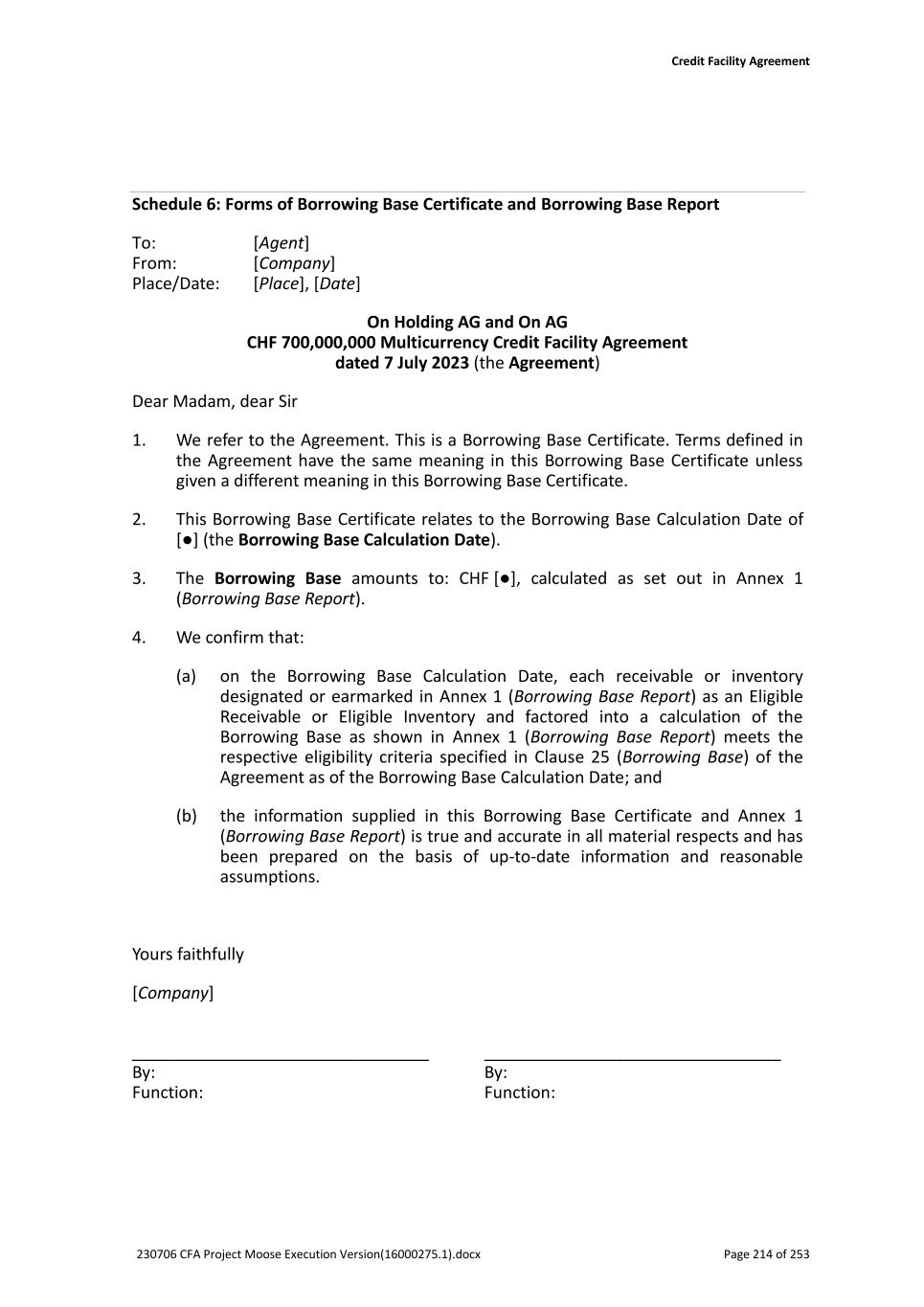
Credit Facility Agreement 230706 CFA Project Moose Execution Version(16000275.1).docx Page 214 of 253 Schedule 6: Forms of Borrowing Base Certificate and Borrowing Base Report To: [Agent] From: [Company] Place/Date: [Place], [Date] On Holding AG and On AG CHF 700,000,000 Multicurrency Credit Facility Agreement dated 7 July 2023 (the Agreement) Dear Madam, dear Sir 1. We refer to the Agreement. This is a Borrowing Base Certificate. Terms defined in the Agreement have the same meaning in this Borrowing Base Certificate unless given a different meaning in this Borrowing Base Certificate. 2. This Borrowing Base Certificate relates to the Borrowing Base Calculation Date of [●] (the Borrowing Base Calculation Date). 3. The Borrowing Base amounts to: CHF [●], calculated as set out in Annex 1 (Borrowing Base Report). 4. We confirm that: (a) on the Borrowing Base Calculation Date, each receivable or inventory designated or earmarked in Annex 1 (Borrowing Base Report) as an Eligible Receivable or Eligible Inventory and factored into a calculation of the Borrowing Base as shown in Annex 1 (Borrowing Base Report) meets the respective eligibility criteria specified in Clause 25 (Borrowing Base) of the Agreement as of the Borrowing Base Calculation Date; and (b) the information supplied in this Borrowing Base Certificate and Annex 1 (Borrowing Base Report) is true and accurate in all material respects and has been prepared on the basis of up-to-date information and reasonable assumptions. Yours faithfully [Company] ________________________________ ________________________________ By: By: Function: Function:
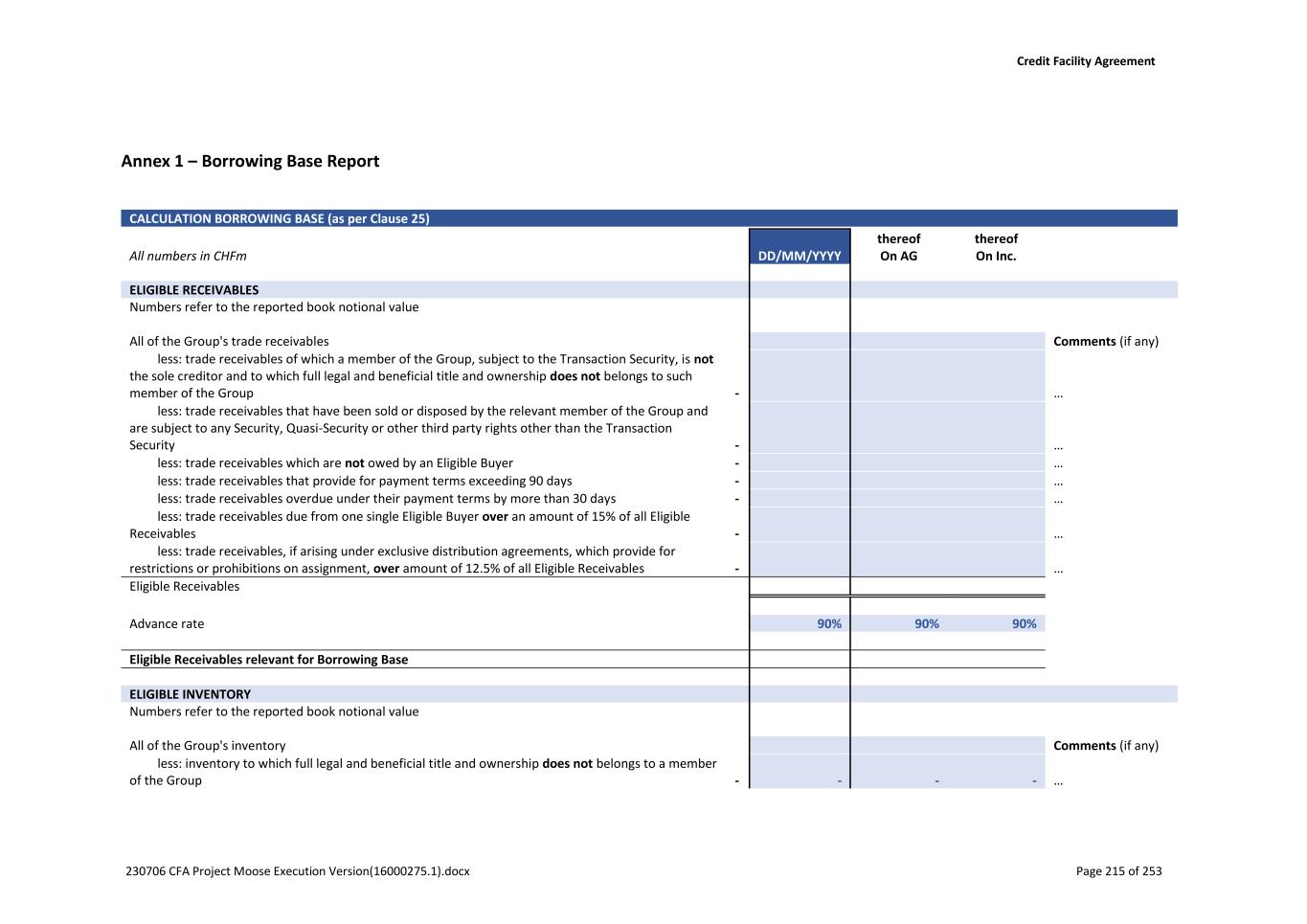
Credit Facility Agreement 230706 CFA Project Moose Execution Version(16000275.1).docx Page 215 of 253 Annex 1 – Borrowing Base Report CALCULATION BORROWING BASE (as per Clause 25) All numbers in CHFm DD/MM/YYYY thereof On AG thereof On Inc. ELIGIBLE RECEIVABLES Numbers refer to the reported book notional value All of the Group's trade receivables Comments (if any) less: trade receivables of which a member of the Group, subject to the Transaction Security, is not the sole creditor and to which full legal and beneficial title and ownership does not belongs to such member of the Group - … less: trade receivables that have been sold or disposed by the relevant member of the Group and are subject to any Security, Quasi-Security or other third party rights other than the Transaction Security - … less: trade receivables which are not owed by an Eligible Buyer - … less: trade receivables that provide for payment terms exceeding 90 days - … less: trade receivables overdue under their payment terms by more than 30 days - … less: trade receivables due from one single Eligible Buyer over an amount of 15% of all Eligible Receivables - … less: trade receivables, if arising under exclusive distribution agreements, which provide for restrictions or prohibitions on assignment, over amount of 12.5% of all Eligible Receivables - … Eligible Receivables Advance rate 90% 90% 90% Eligible Receivables relevant for Borrowing Base ELIGIBLE INVENTORY Numbers refer to the reported book notional value All of the Group's inventory Comments (if any) less: inventory to which full legal and beneficial title and ownership does not belongs to a member of the Group - - - - …
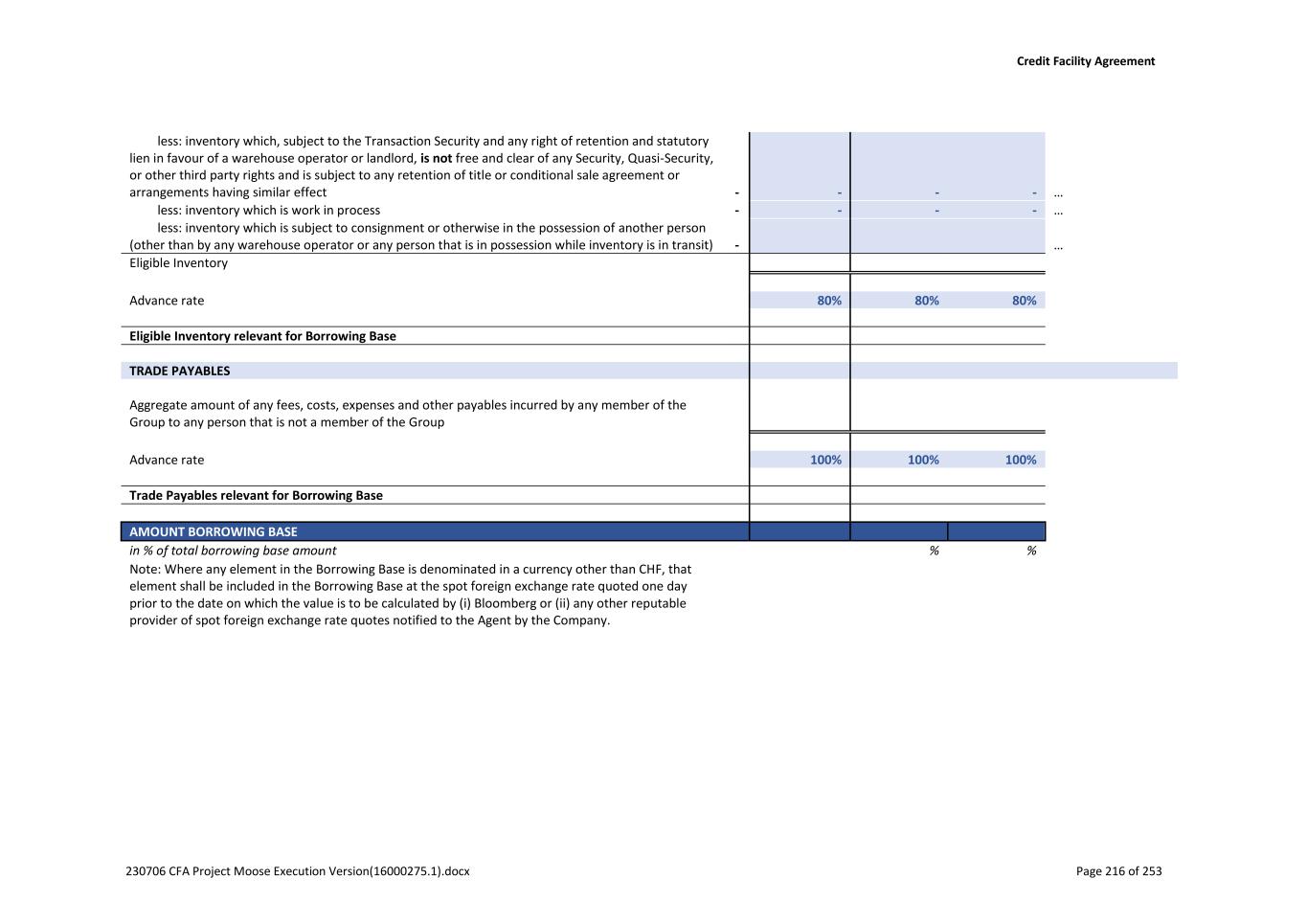
Credit Facility Agreement 230706 CFA Project Moose Execution Version(16000275.1).docx Page 216 of 253 less: inventory which, subject to the Transaction Security and any right of retention and statutory lien in favour of a warehouse operator or landlord, is not free and clear of any Security, Quasi-Security, or other third party rights and is subject to any retention of title or conditional sale agreement or arrangements having similar effect - - - - … less: inventory which is work in process - - - - … less: inventory which is subject to consignment or otherwise in the possession of another person (other than by any warehouse operator or any person that is in possession while inventory is in transit) - … Eligible Inventory Advance rate 80% 80% 80% Eligible Inventory relevant for Borrowing Base TRADE PAYABLES Aggregate amount of any fees, costs, expenses and other payables incurred by any member of the Group to any person that is not a member of the Group Advance rate 100% 100% 100% Trade Payables relevant for Borrowing Base AMOUNT BORROWING BASE in % of total borrowing base amount % % Note: Where any element in the Borrowing Base is denominated in a currency other than CHF, that element shall be included in the Borrowing Base at the spot foreign exchange rate quoted one day prior to the date on which the value is to be calculated by (i) Bloomberg or (ii) any other reputable provider of spot foreign exchange rate quotes notified to the Agent by the Company.
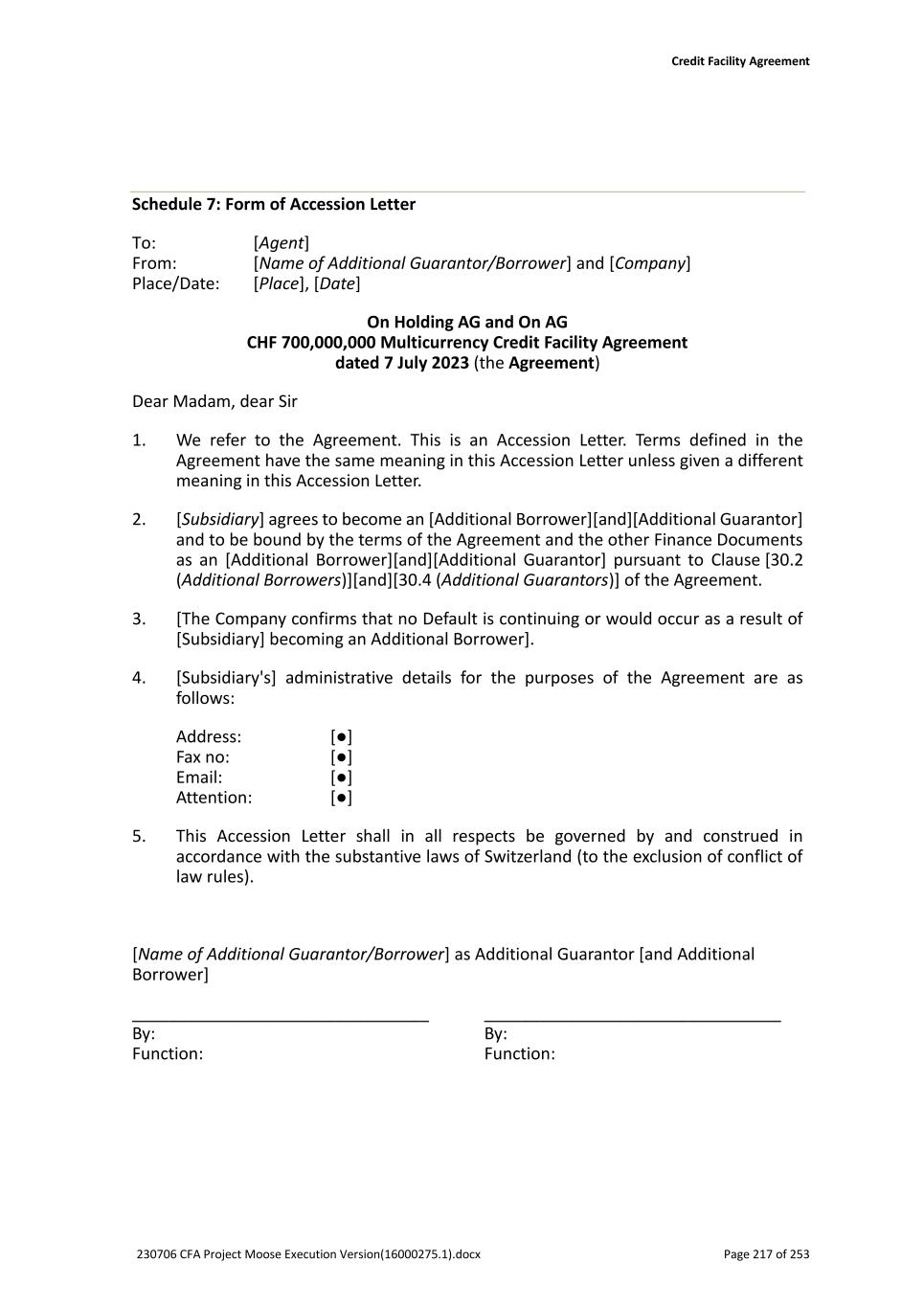
Credit Facility Agreement 230706 CFA Project Moose Execution Version(16000275.1).docx Page 217 of 253 Schedule 7: Form of Accession Letter To: [Agent] From: [Name of Additional Guarantor/Borrower] and [Company] Place/Date: [Place], [Date] On Holding AG and On AG CHF 700,000,000 Multicurrency Credit Facility Agreement dated 7 July 2023 (the Agreement) Dear Madam, dear Sir 1. We refer to the Agreement. This is an Accession Letter. Terms defined in the Agreement have the same meaning in this Accession Letter unless given a different meaning in this Accession Letter. 2. [Subsidiary] agrees to become an [Additional Borrower][and][Additional Guarantor] and to be bound by the terms of the Agreement and the other Finance Documents as an [Additional Borrower][and][Additional Guarantor] pursuant to Clause [30.2 (Additional Borrowers)][and][30.4 (Additional Guarantors)] of the Agreement. 3. [The Company confirms that no Default is continuing or would occur as a result of [Subsidiary] becoming an Additional Borrower]. 4. [Subsidiary's] administrative details for the purposes of the Agreement are as follows: Address: [●] Fax no: [●] Email: [●] Attention: [●] 5. This Accession Letter shall in all respects be governed by and construed in accordance with the substantive laws of Switzerland (to the exclusion of conflict of law rules). [Name of Additional Guarantor/Borrower] as Additional Guarantor [and Additional Borrower] ________________________________ ________________________________ By: By: Function: Function:

Credit Facility Agreement 230706 CFA Project Moose Execution Version(16000275.1).docx Page 218 of 253 [Company] ________________________________ ________________________________ By: By: Function: Function: [Agent] ________________________________ ________________________________ By: By: Function: Function:
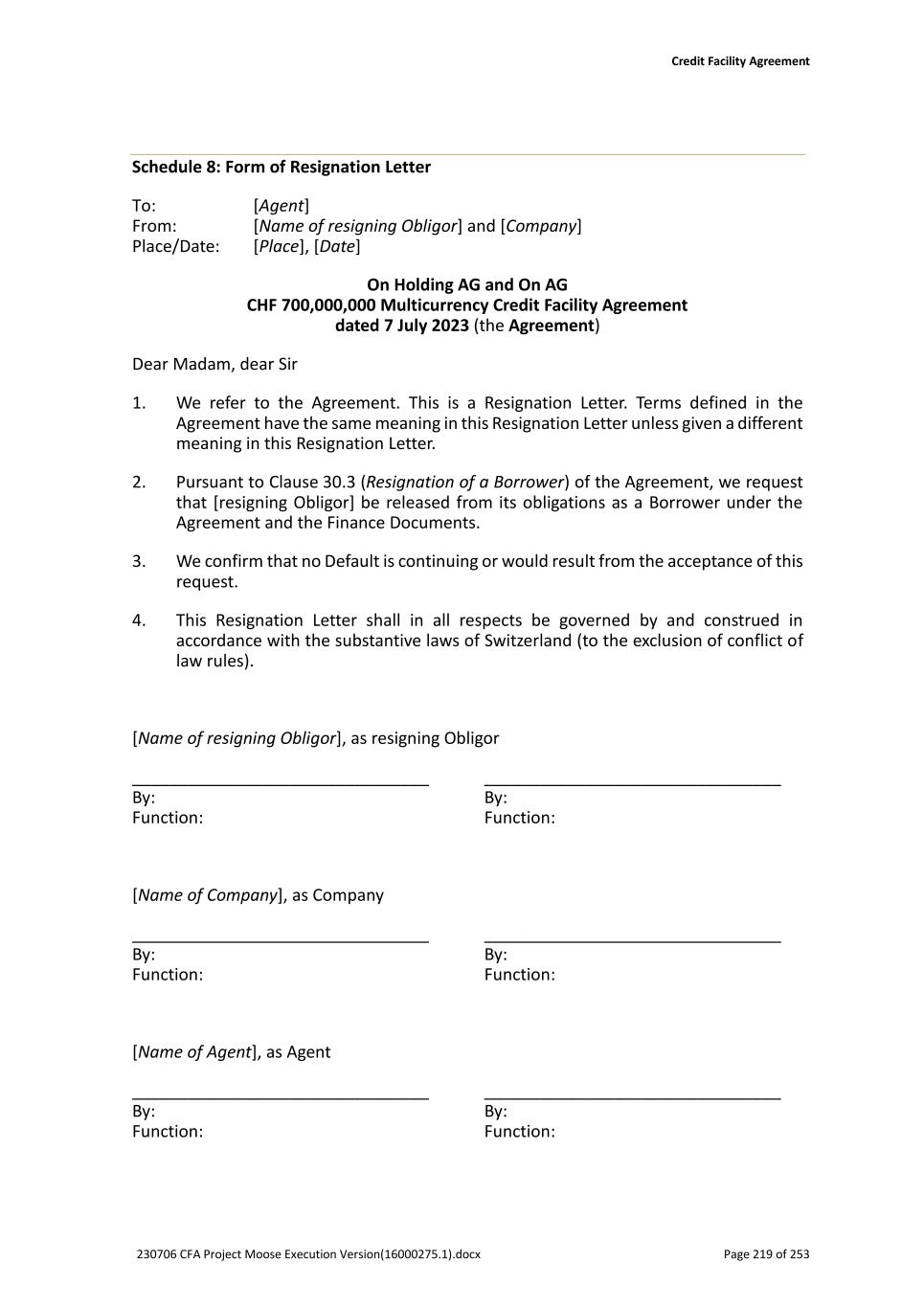
Credit Facility Agreement 230706 CFA Project Moose Execution Version(16000275.1).docx Page 219 of 253 Schedule 8: Form of Resignation Letter To: [Agent] From: [Name of resigning Obligor] and [Company] Place/Date: [Place], [Date] On Holding AG and On AG CHF 700,000,000 Multicurrency Credit Facility Agreement dated 7 July 2023 (the Agreement) Dear Madam, dear Sir 1. We refer to the Agreement. This is a Resignation Letter. Terms defined in the Agreement have the same meaning in this Resignation Letter unless given a different meaning in this Resignation Letter. 2. Pursuant to Clause 30.3 (Resignation of a Borrower) of the Agreement, we request that [resigning Obligor] be released from its obligations as a Borrower under the Agreement and the Finance Documents. 3. We confirm that no Default is continuing or would result from the acceptance of this request. 4. This Resignation Letter shall in all respects be governed by and construed in accordance with the substantive laws of Switzerland (to the exclusion of conflict of law rules). [Name of resigning Obligor], as resigning Obligor ________________________________ ________________________________ By: By: Function: Function: [Name of Company], as Company ________________________________ ________________________________ By: By: Function: Function: [Name of Agent], as Agent ________________________________ ________________________________ By: By: Function: Function:
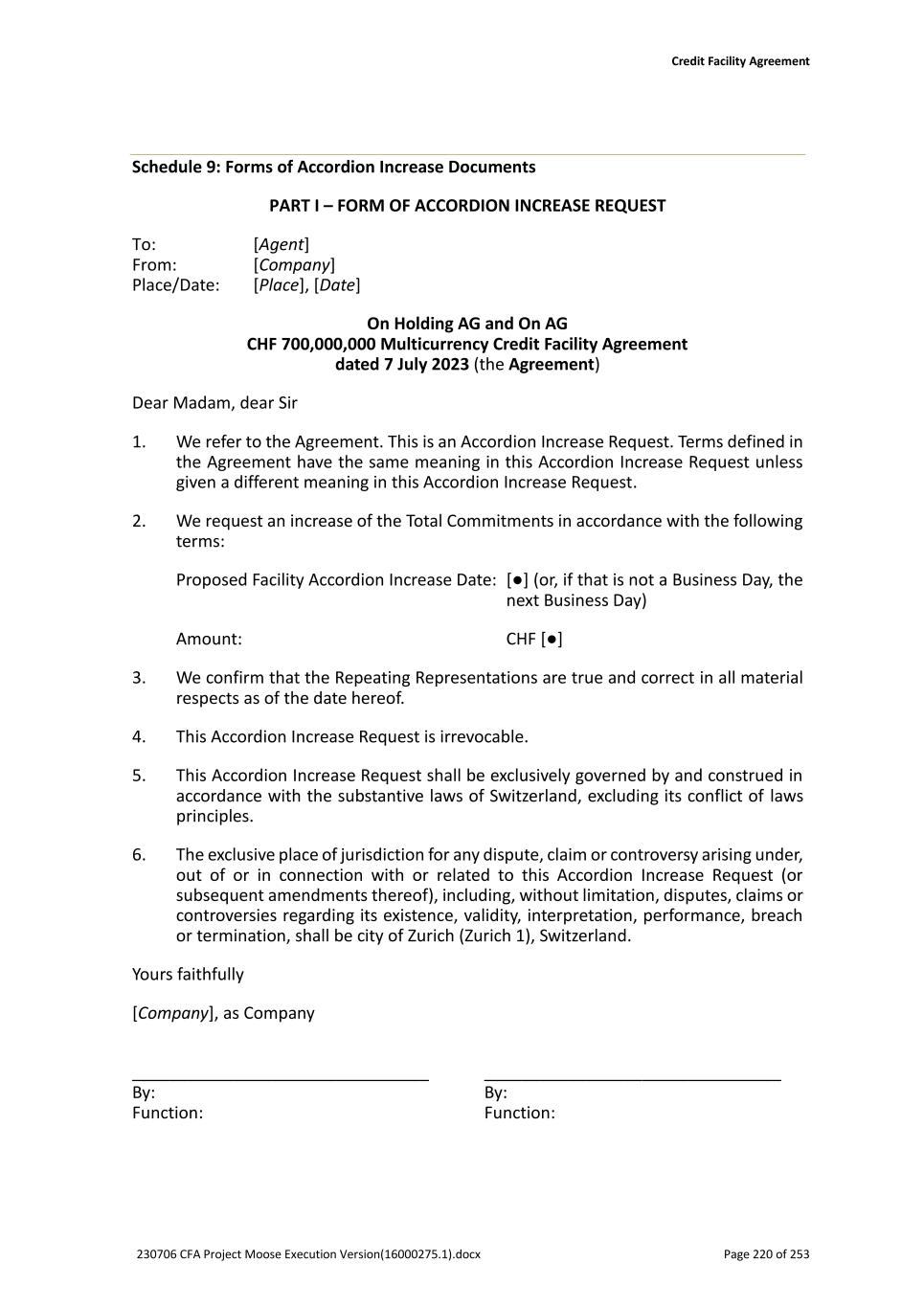
Credit Facility Agreement 230706 CFA Project Moose Execution Version(16000275.1).docx Page 220 of 253 Schedule 9: Forms of Accordion Increase Documents PART I – FORM OF ACCORDION INCREASE REQUEST To: [Agent] From: [Company] Place/Date: [Place], [Date] On Holding AG and On AG CHF 700,000,000 Multicurrency Credit Facility Agreement dated 7 July 2023 (the Agreement) Dear Madam, dear Sir 1. We refer to the Agreement. This is an Accordion Increase Request. Terms defined in the Agreement have the same meaning in this Accordion Increase Request unless given a different meaning in this Accordion Increase Request. 2. We request an increase of the Total Commitments in accordance with the following terms: Proposed Facility Accordion Increase Date: [●] (or, if that is not a Business Day, the next Business Day) Amount: CHF [●] 3. We confirm that the Repeating Representations are true and correct in all material respects as of the date hereof. 4. This Accordion Increase Request is irrevocable. 5. This Accordion Increase Request shall be exclusively governed by and construed in accordance with the substantive laws of Switzerland, excluding its conflict of laws principles. 6. The exclusive place of jurisdiction for any dispute, claim or controversy arising under, out of or in connection with or related to this Accordion Increase Request (or subsequent amendments thereof), including, without limitation, disputes, claims or controversies regarding its existence, validity, interpretation, performance, breach or termination, shall be city of Zurich (Zurich 1), Switzerland. Yours faithfully [Company], as Company ________________________________ ________________________________ By: By: Function: Function:
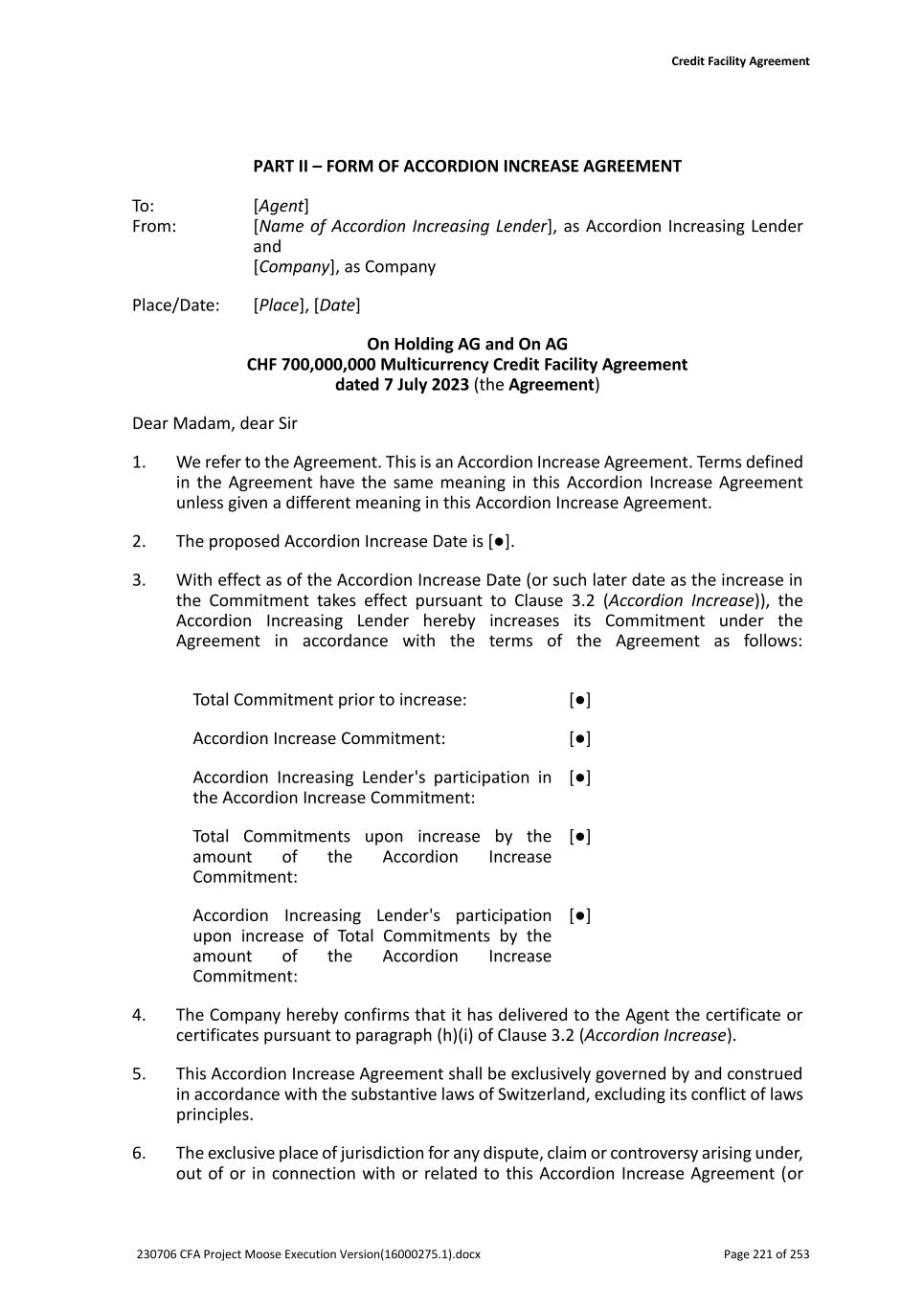
Credit Facility Agreement 230706 CFA Project Moose Execution Version(16000275.1).docx Page 221 of 253 PART II – FORM OF ACCORDION INCREASE AGREEMENT To: [Agent] From: [Name of Accordion Increasing Lender], as Accordion Increasing Lender and [Company], as Company Place/Date: [Place], [Date] On Holding AG and On AG CHF 700,000,000 Multicurrency Credit Facility Agreement dated 7 July 2023 (the Agreement) Dear Madam, dear Sir 1. We refer to the Agreement. This is an Accordion Increase Agreement. Terms defined in the Agreement have the same meaning in this Accordion Increase Agreement unless given a different meaning in this Accordion Increase Agreement. 2. The proposed Accordion Increase Date is [●]. 3. With effect as of the Accordion Increase Date (or such later date as the increase in the Commitment takes effect pursuant to Clause 3.2 (Accordion Increase)), the Accordion Increasing Lender hereby increases its Commitment under the Agreement in accordance with the terms of the Agreement as follows: Total Commitment prior to increase: [●] Accordion Increase Commitment: [●] Accordion Increasing Lender's participation in the Accordion Increase Commitment: [●] Total Commitments upon increase by the amount of the Accordion Increase Commitment: [●] Accordion Increasing Lender's participation upon increase of Total Commitments by the amount of the Accordion Increase Commitment: [●] 4. The Company hereby confirms that it has delivered to the Agent the certificate or certificates pursuant to paragraph (h)(i) of Clause 3.2 (Accordion Increase). 5. This Accordion Increase Agreement shall be exclusively governed by and construed in accordance with the substantive laws of Switzerland, excluding its conflict of laws principles. 6. The exclusive place of jurisdiction for any dispute, claim or controversy arising under, out of or in connection with or related to this Accordion Increase Agreement (or
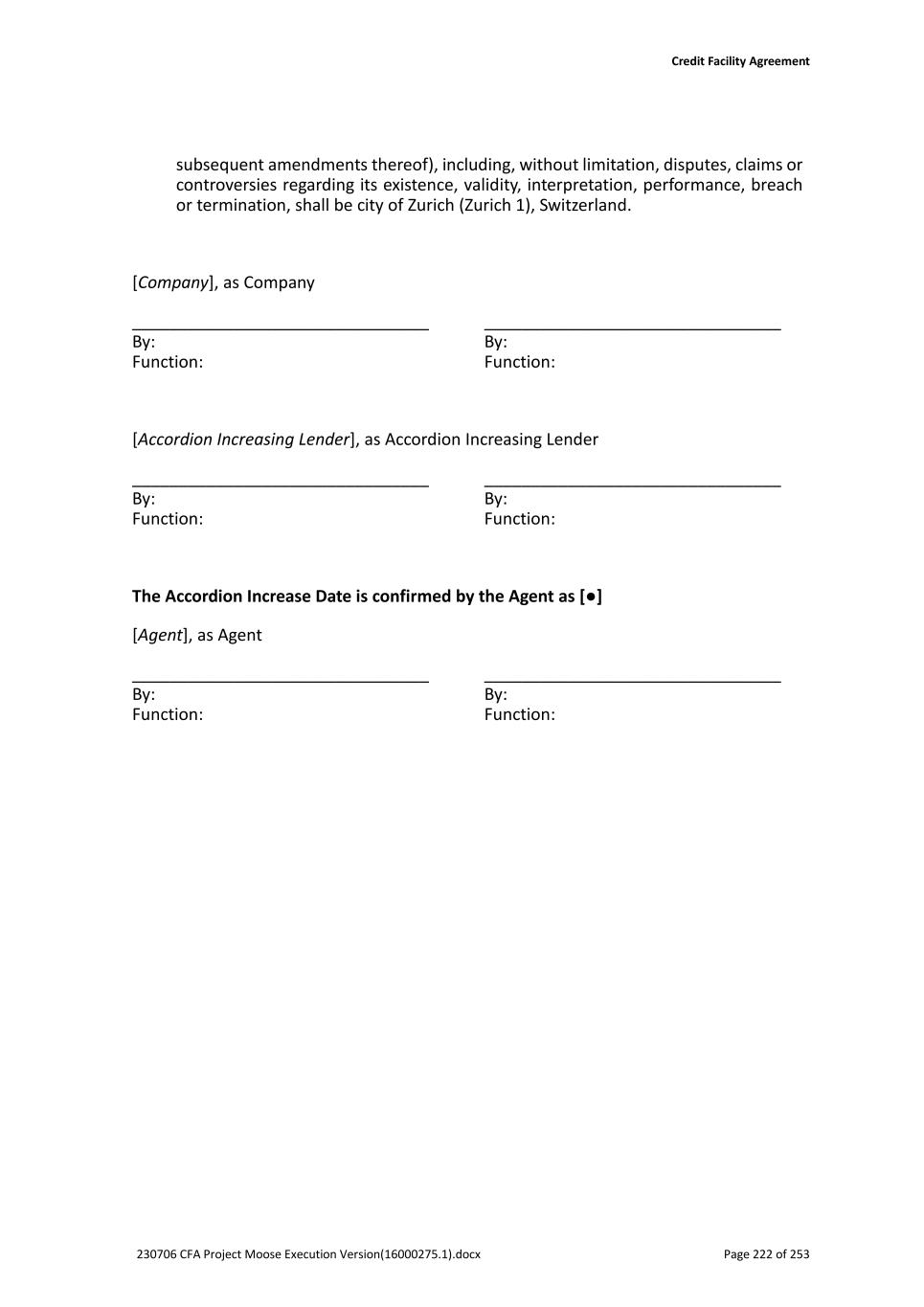
Credit Facility Agreement 230706 CFA Project Moose Execution Version(16000275.1).docx Page 222 of 253 subsequent amendments thereof), including, without limitation, disputes, claims or controversies regarding its existence, validity, interpretation, performance, breach or termination, shall be city of Zurich (Zurich 1), Switzerland. [Company], as Company ________________________________ ________________________________ By: By: Function: Function: [Accordion Increasing Lender], as Accordion Increasing Lender ________________________________ ________________________________ By: By: Function: Function: The Accordion Increase Date is confirmed by the Agent as [●] [Agent], as Agent ________________________________ ________________________________ By: By: Function: Function:
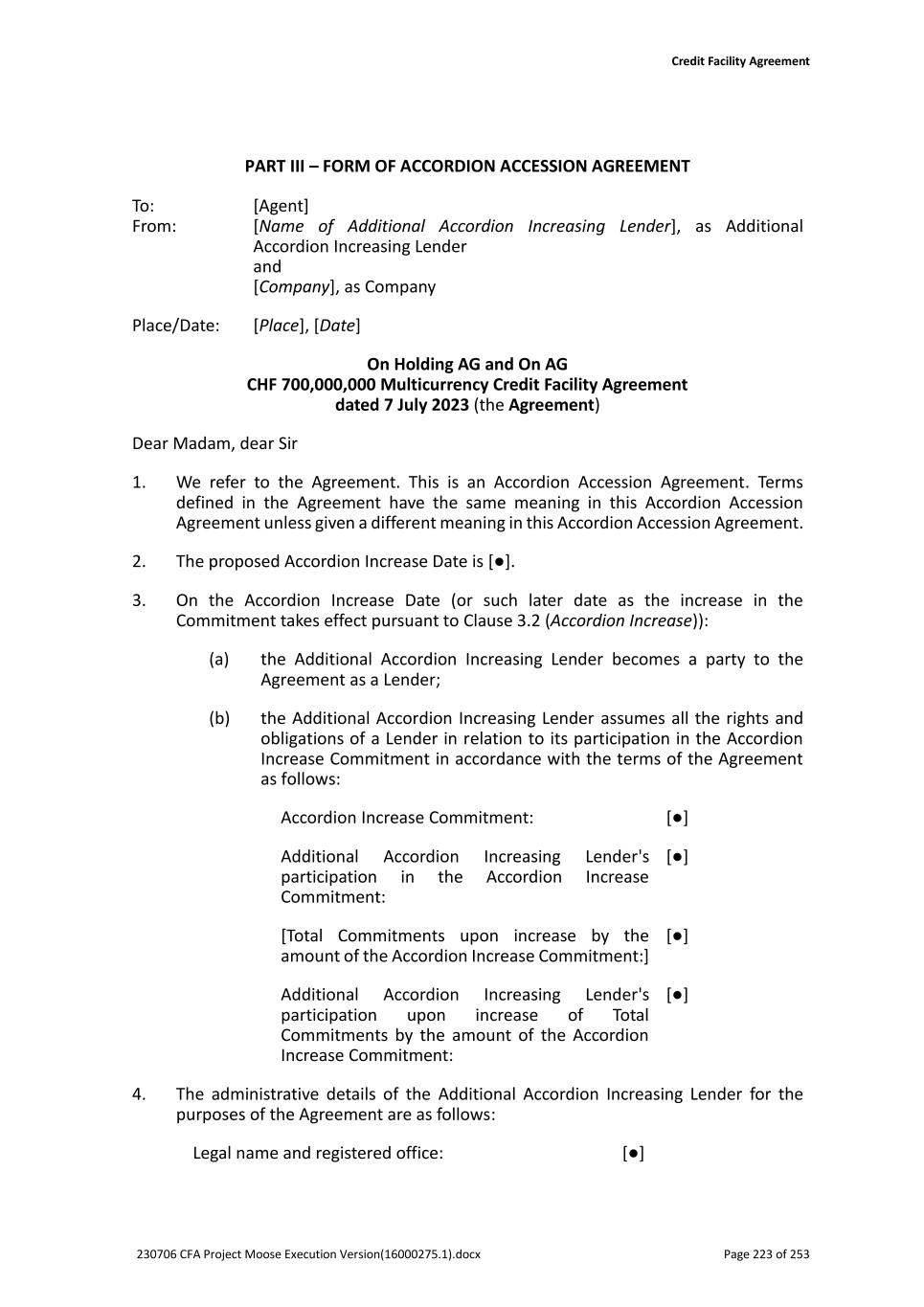
Credit Facility Agreement 230706 CFA Project Moose Execution Version(16000275.1).docx Page 223 of 253 PART III – FORM OF ACCORDION ACCESSION AGREEMENT To: [Agent] From: [Name of Additional Accordion Increasing Lender], as Additional Accordion Increasing Lender and [Company], as Company Place/Date: [Place], [Date] On Holding AG and On AG CHF 700,000,000 Multicurrency Credit Facility Agreement dated 7 July 2023 (the Agreement) Dear Madam, dear Sir 1. We refer to the Agreement. This is an Accordion Accession Agreement. Terms defined in the Agreement have the same meaning in this Accordion Accession Agreement unless given a different meaning in this Accordion Accession Agreement. 2. The proposed Accordion Increase Date is [●]. 3. On the Accordion Increase Date (or such later date as the increase in the Commitment takes effect pursuant to Clause 3.2 (Accordion Increase)): (a) the Additional Accordion Increasing Lender becomes a party to the Agreement as a Lender; (b) the Additional Accordion Increasing Lender assumes all the rights and obligations of a Lender in relation to its participation in the Accordion Increase Commitment in accordance with the terms of the Agreement as follows: Accordion Increase Commitment: [●] Additional Accordion Increasing Lender's participation in the Accordion Increase Commitment: [●] [Total Commitments upon increase by the amount of the Accordion Increase Commitment:] [●] Additional Accordion Increasing Lender's participation upon increase of Total Commitments by the amount of the Accordion Increase Commitment: [●] 4. The administrative details of the Additional Accordion Increasing Lender for the purposes of the Agreement are as follows: Legal name and registered office: [●]
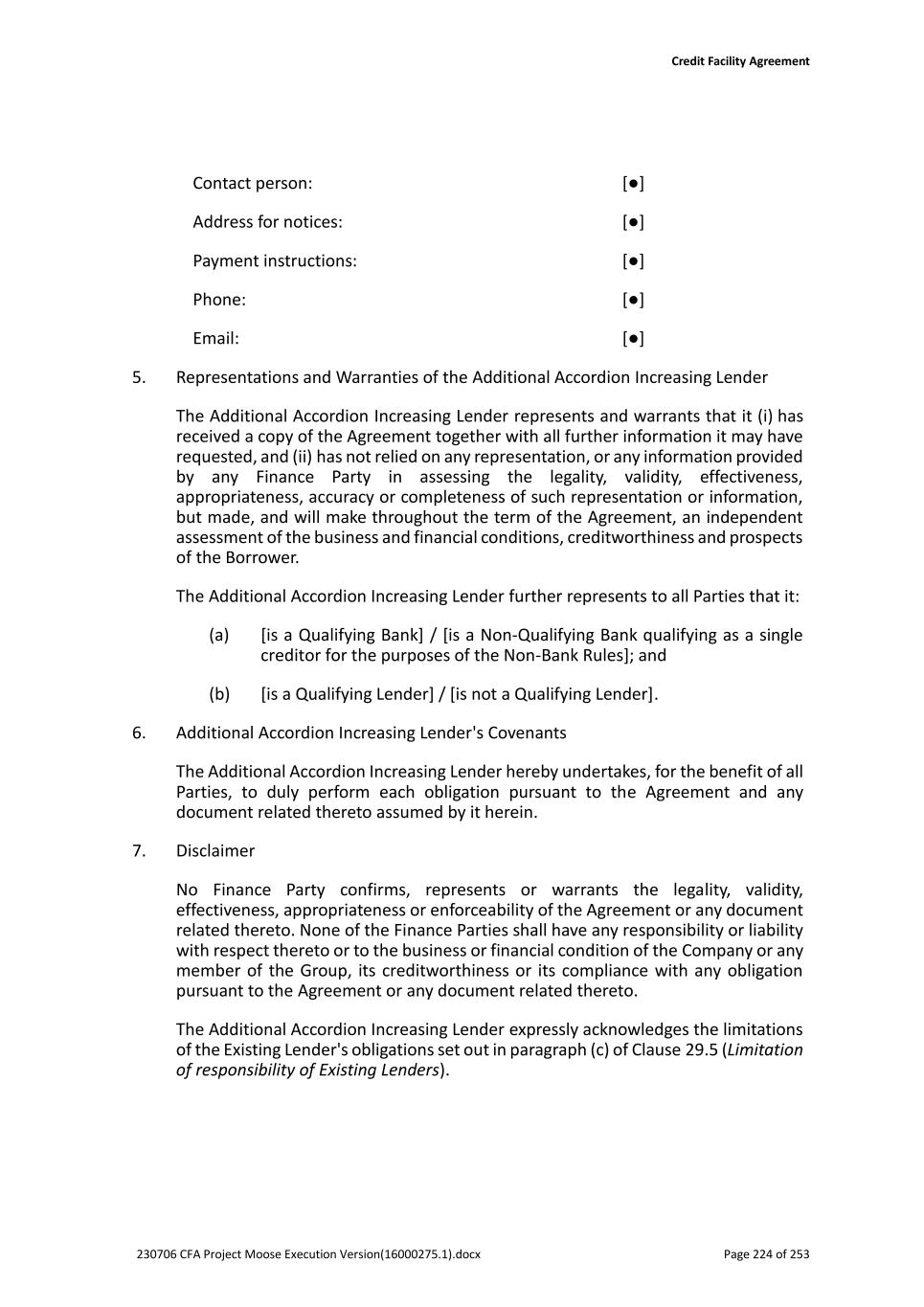
Credit Facility Agreement 230706 CFA Project Moose Execution Version(16000275.1).docx Page 224 of 253 Contact person: [●] Address for notices: [●] Payment instructions: [●] Phone: [●] Email: [●] 5. Representations and Warranties of the Additional Accordion Increasing Lender The Additional Accordion Increasing Lender represents and warrants that it (i) has received a copy of the Agreement together with all further information it may have requested, and (ii) has not relied on any representation, or any information provided by any Finance Party in assessing the legality, validity, effectiveness, appropriateness, accuracy or completeness of such representation or information, but made, and will make throughout the term of the Agreement, an independent assessment of the business and financial conditions, creditworthiness and prospects of the Borrower. The Additional Accordion Increasing Lender further represents to all Parties that it: (a) [is a Qualifying Bank] / [is a Non-Qualifying Bank qualifying as a single creditor for the purposes of the Non-Bank Rules]; and (b) [is a Qualifying Lender] / [is not a Qualifying Lender]. 6. Additional Accordion Increasing Lender's Covenants The Additional Accordion Increasing Lender hereby undertakes, for the benefit of all Parties, to duly perform each obligation pursuant to the Agreement and any document related thereto assumed by it herein. 7. Disclaimer No Finance Party confirms, represents or warrants the legality, validity, effectiveness, appropriateness or enforceability of the Agreement or any document related thereto. None of the Finance Parties shall have any responsibility or liability with respect thereto or to the business or financial condition of the Company or any member of the Group, its creditworthiness or its compliance with any obligation pursuant to the Agreement or any document related thereto. The Additional Accordion Increasing Lender expressly acknowledges the limitations of the Existing Lender's obligations set out in paragraph (c) of Clause 29.5 (Limitation of responsibility of Existing Lenders).
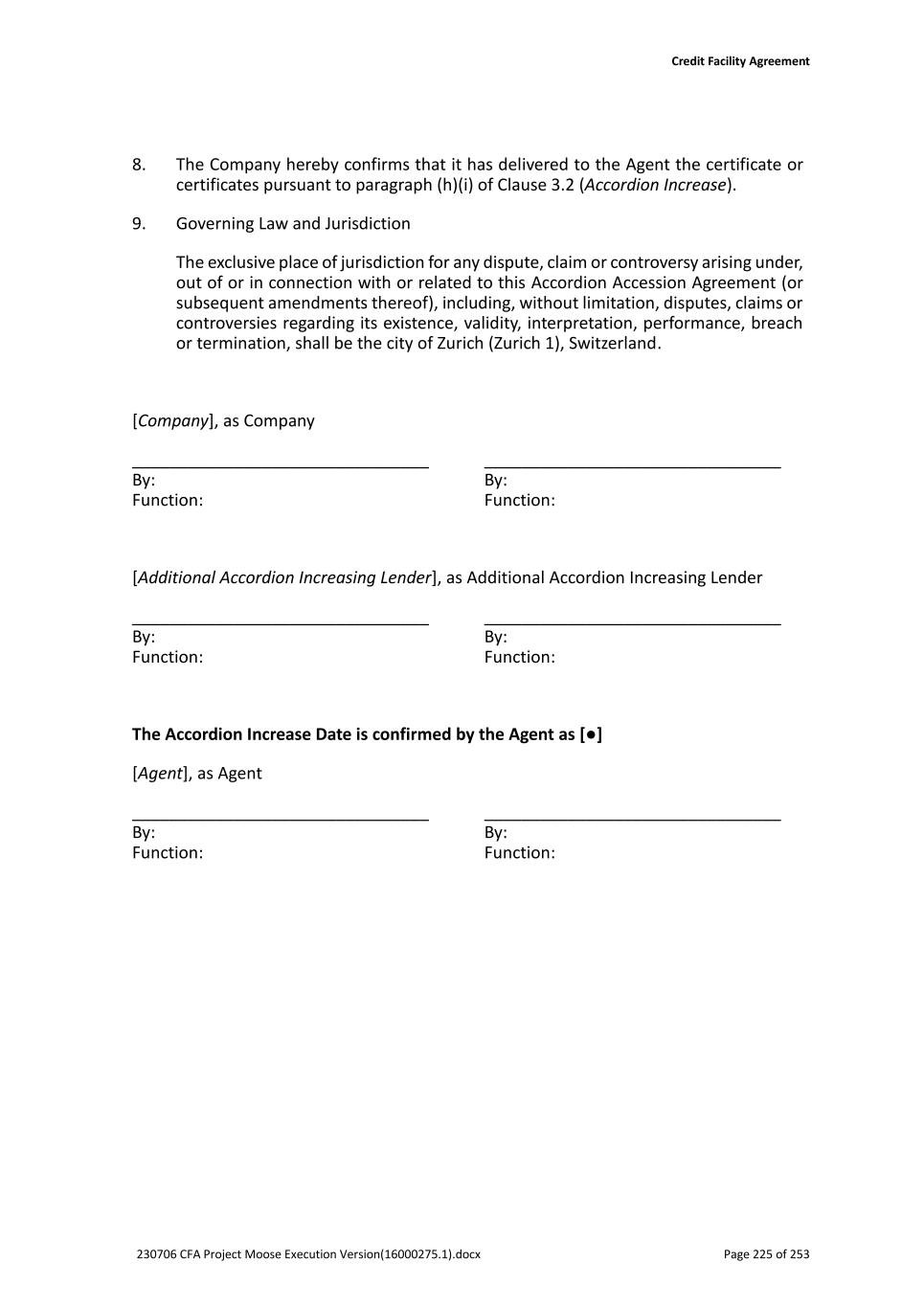
Credit Facility Agreement 230706 CFA Project Moose Execution Version(16000275.1).docx Page 225 of 253 8. The Company hereby confirms that it has delivered to the Agent the certificate or certificates pursuant to paragraph (h)(i) of Clause 3.2 (Accordion Increase). 9. Governing Law and Jurisdiction The exclusive place of jurisdiction for any dispute, claim or controversy arising under, out of or in connection with or related to this Accordion Accession Agreement (or subsequent amendments thereof), including, without limitation, disputes, claims or controversies regarding its existence, validity, interpretation, performance, breach or termination, shall be the city of Zurich (Zurich 1), Switzerland. [Company], as Company ________________________________ ________________________________ By: By: Function: Function: [Additional Accordion Increasing Lender], as Additional Accordion Increasing Lender ________________________________ ________________________________ By: By: Function: Function: The Accordion Increase Date is confirmed by the Agent as [●] [Agent], as Agent ________________________________ ________________________________ By: By: Function: Function:
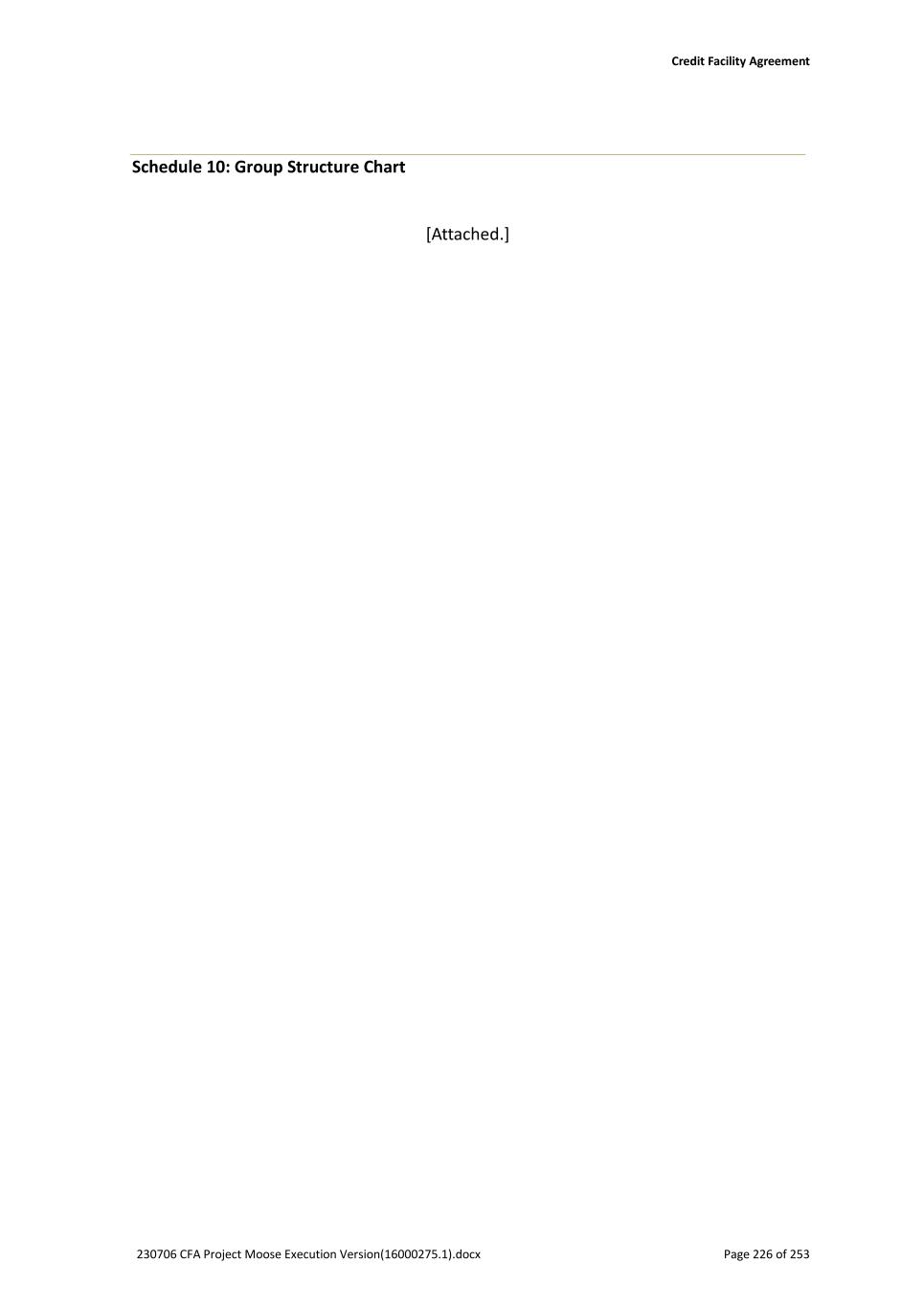
Credit Facility Agreement 230706 CFA Project Moose Execution Version(16000275.1).docx Page 226 of 253 Schedule 10: Group Structure Chart [Attached.]
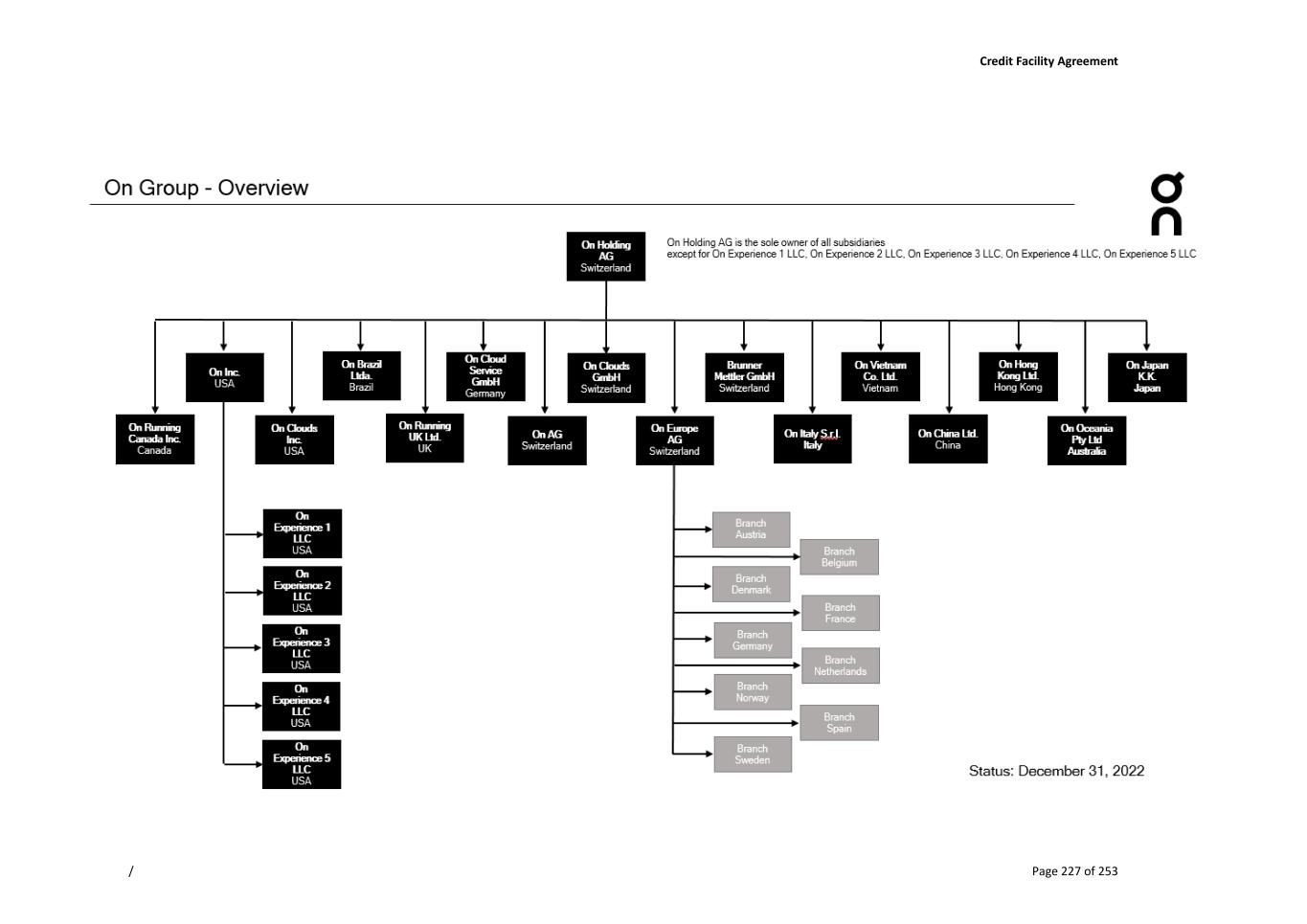
Credit Facility Agreement / Page 227 of 253
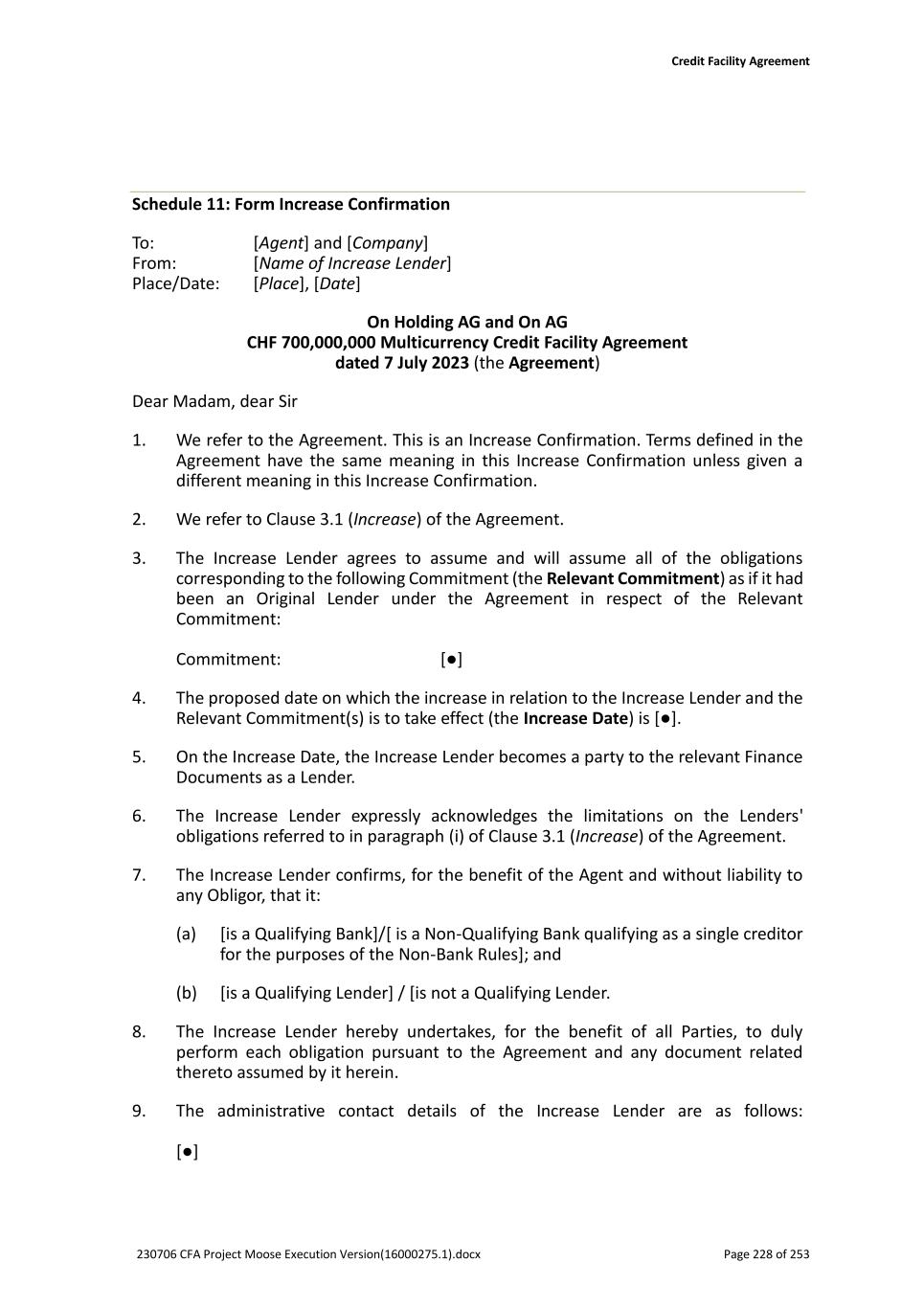
Credit Facility Agreement 230706 CFA Project Moose Execution Version(16000275.1).docx Page 228 of 253 Schedule 11: Form Increase Confirmation To: [Agent] and [Company] From: [Name of Increase Lender] Place/Date: [Place], [Date] On Holding AG and On AG CHF 700,000,000 Multicurrency Credit Facility Agreement dated 7 July 2023 (the Agreement) Dear Madam, dear Sir 1. We refer to the Agreement. This is an Increase Confirmation. Terms defined in the Agreement have the same meaning in this Increase Confirmation unless given a different meaning in this Increase Confirmation. 2. We refer to Clause 3.1 (Increase) of the Agreement. 3. The Increase Lender agrees to assume and will assume all of the obligations corresponding to the following Commitment (the Relevant Commitment) as if it had been an Original Lender under the Agreement in respect of the Relevant Commitment: Commitment: [●] 4. The proposed date on which the increase in relation to the Increase Lender and the Relevant Commitment(s) is to take effect (the Increase Date) is [●]. 5. On the Increase Date, the Increase Lender becomes a party to the relevant Finance Documents as a Lender. 6. The Increase Lender expressly acknowledges the limitations on the Lenders' obligations referred to in paragraph (i) of Clause 3.1 (Increase) of the Agreement. 7. The Increase Lender confirms, for the benefit of the Agent and without liability to any Obligor, that it: (a) [is a Qualifying Bank]/[ is a Non-Qualifying Bank qualifying as a single creditor for the purposes of the Non-Bank Rules]; and (b) [is a Qualifying Lender] / [is not a Qualifying Lender. 8. The Increase Lender hereby undertakes, for the benefit of all Parties, to duly perform each obligation pursuant to the Agreement and any document related thereto assumed by it herein. 9. The administrative contact details of the Increase Lender are as follows: [●]
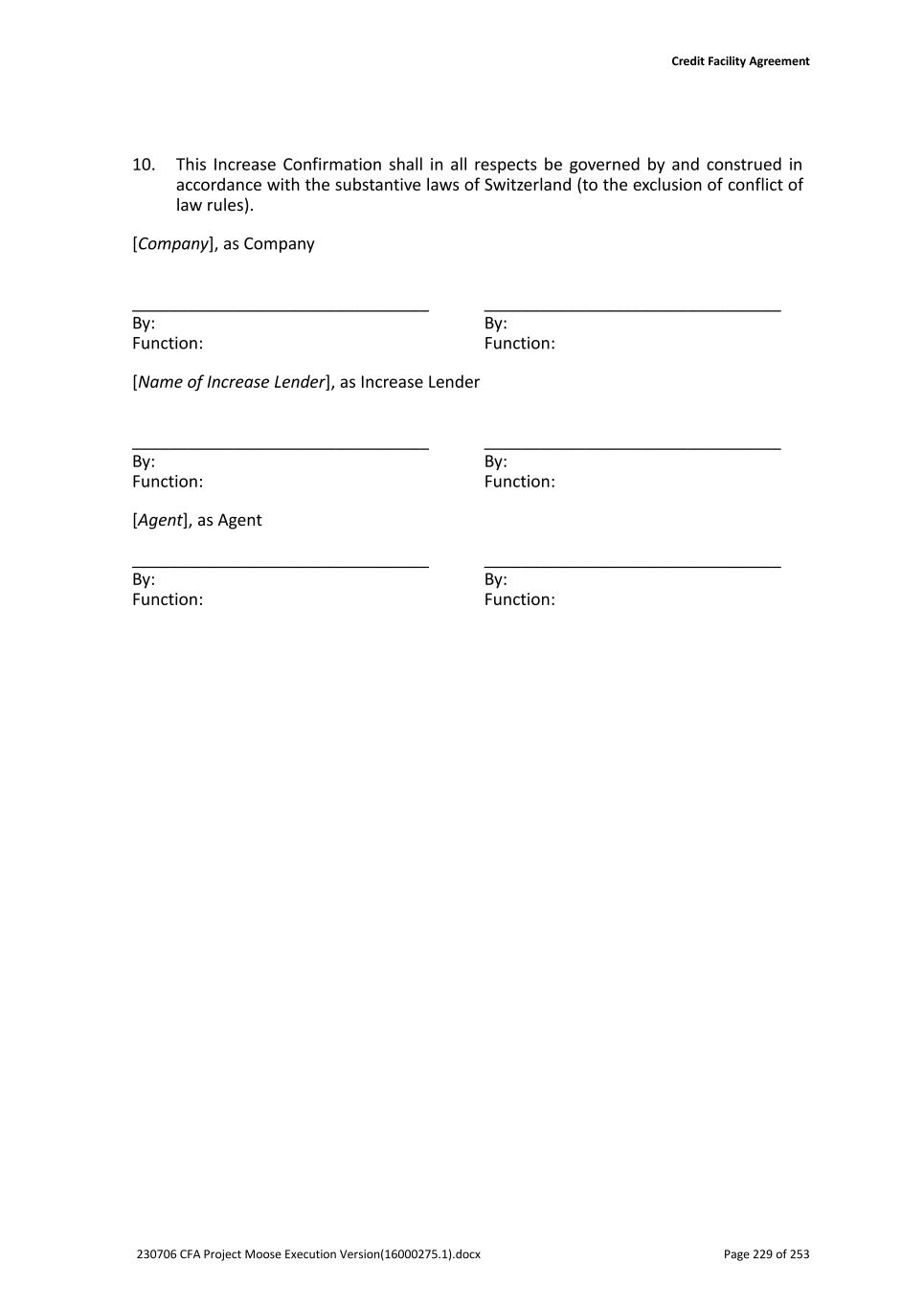
Credit Facility Agreement 230706 CFA Project Moose Execution Version(16000275.1).docx Page 229 of 253 10. This Increase Confirmation shall in all respects be governed by and construed in accordance with the substantive laws of Switzerland (to the exclusion of conflict of law rules). [Company], as Company ________________________________ ________________________________ By: By: Function: Function: [Name of Increase Lender], as Increase Lender ________________________________ ________________________________ By: By: Function: Function: [Agent], as Agent ________________________________ ________________________________ By: By: Function: Function:
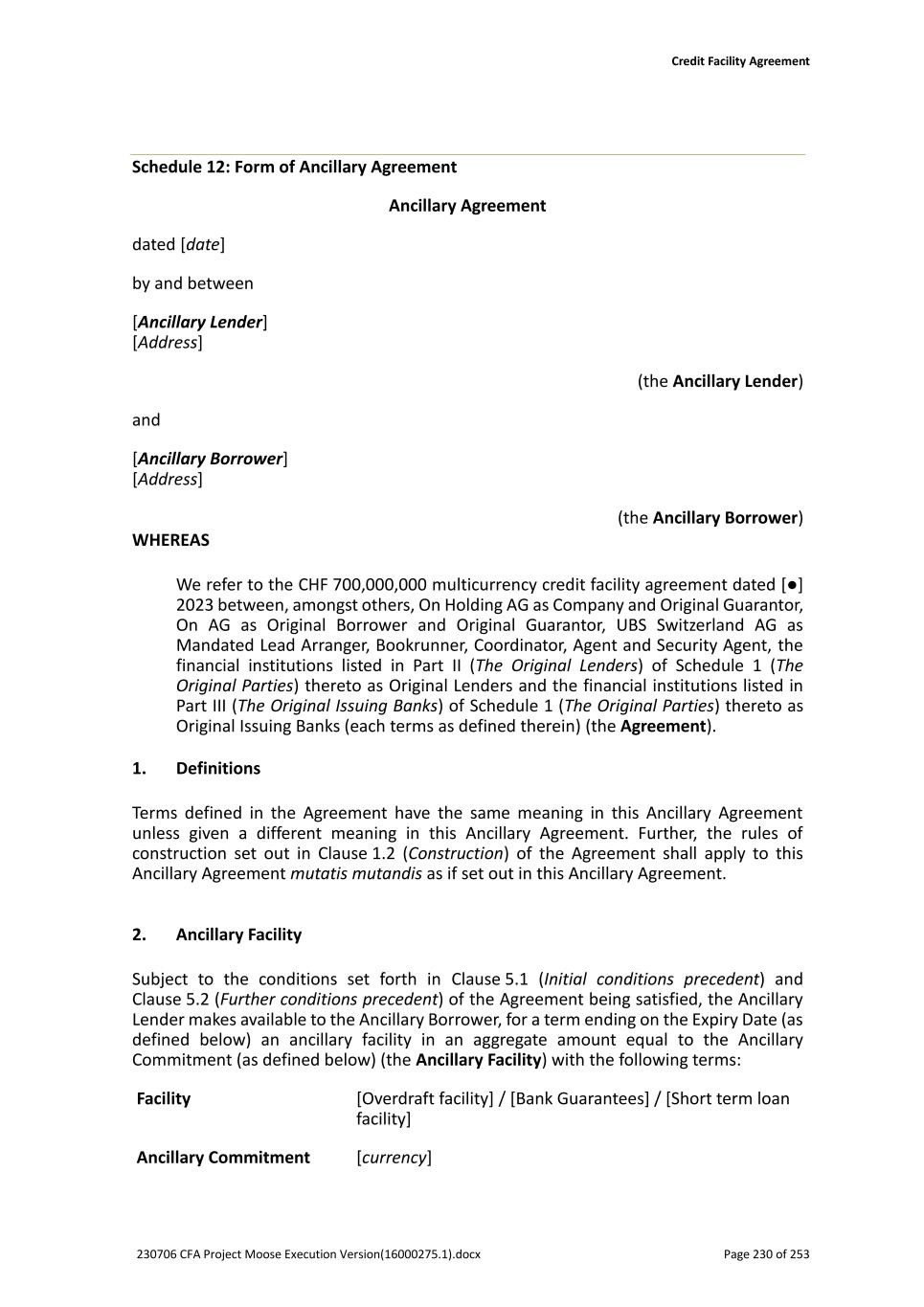
Credit Facility Agreement 230706 CFA Project Moose Execution Version(16000275.1).docx Page 230 of 253 Schedule 12: Form of Ancillary Agreement Ancillary Agreement dated [date] by and between [Ancillary Lender] [Address] (the Ancillary Lender) and [Ancillary Borrower] [Address] (the Ancillary Borrower) WHEREAS We refer to the CHF 700,000,000 multicurrency credit facility agreement dated [●] 2023 between, amongst others, On Holding AG as Company and Original Guarantor, On AG as Original Borrower and Original Guarantor, UBS Switzerland AG as Mandated Lead Arranger, Bookrunner, Coordinator, Agent and Security Agent, the financial institutions listed in Part II (The Original Lenders) of Schedule 1 (The Original Parties) thereto as Original Lenders and the financial institutions listed in Part III (The Original Issuing Banks) of Schedule 1 (The Original Parties) thereto as Original Issuing Banks (each terms as defined therein) (the Agreement). 1. Definitions Terms defined in the Agreement have the same meaning in this Ancillary Agreement unless given a different meaning in this Ancillary Agreement. Further, the rules of construction set out in Clause 1.2 (Construction) of the Agreement shall apply to this Ancillary Agreement mutatis mutandis as if set out in this Ancillary Agreement. 2. Ancillary Facility Subject to the conditions set forth in Clause 5.1 (Initial conditions precedent) and Clause 5.2 (Further conditions precedent) of the Agreement being satisfied, the Ancillary Lender makes available to the Ancillary Borrower, for a term ending on the Expiry Date (as defined below) an ancillary facility in an aggregate amount equal to the Ancillary Commitment (as defined below) (the Ancillary Facility) with the following terms: Facility [Overdraft facility] / [Bank Guarantees] / [Short term loan facility] Ancillary Commitment [currency]
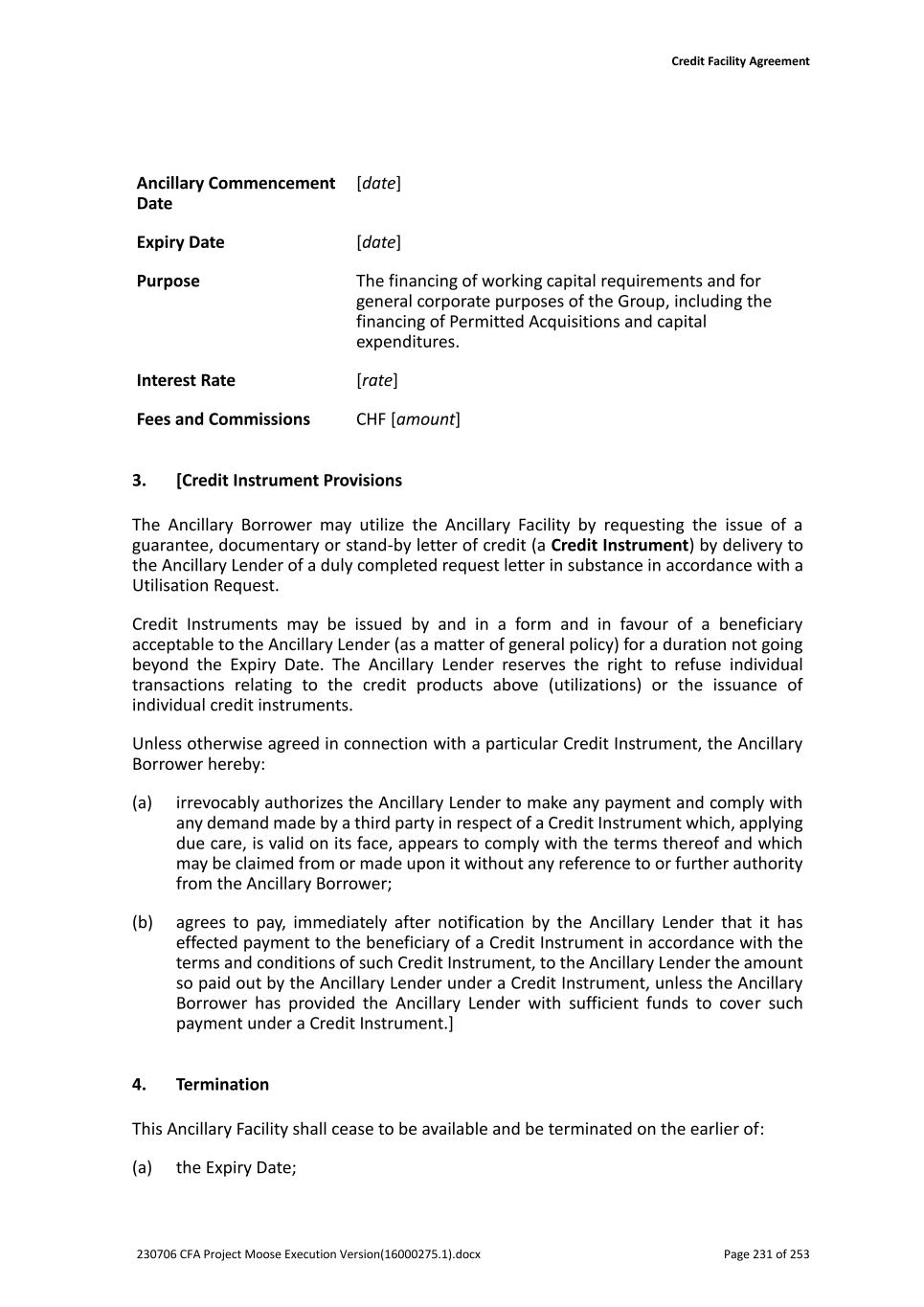
Credit Facility Agreement 230706 CFA Project Moose Execution Version(16000275.1).docx Page 231 of 253 Ancillary Commencement Date [date] Expiry Date [date] Purpose The financing of working capital requirements and for general corporate purposes of the Group, including the financing of Permitted Acquisitions and capital expenditures. Interest Rate [rate] Fees and Commissions CHF [amount] 3. [Credit Instrument Provisions The Ancillary Borrower may utilize the Ancillary Facility by requesting the issue of a guarantee, documentary or stand-by letter of credit (a Credit Instrument) by delivery to the Ancillary Lender of a duly completed request letter in substance in accordance with a Utilisation Request. Credit Instruments may be issued by and in a form and in favour of a beneficiary acceptable to the Ancillary Lender (as a matter of general policy) for a duration not going beyond the Expiry Date. The Ancillary Lender reserves the right to refuse individual transactions relating to the credit products above (utilizations) or the issuance of individual credit instruments. Unless otherwise agreed in connection with a particular Credit Instrument, the Ancillary Borrower hereby: (a) irrevocably authorizes the Ancillary Lender to make any payment and comply with any demand made by a third party in respect of a Credit Instrument which, applying due care, is valid on its face, appears to comply with the terms thereof and which may be claimed from or made upon it without any reference to or further authority from the Ancillary Borrower; (b) agrees to pay, immediately after notification by the Ancillary Lender that it has effected payment to the beneficiary of a Credit Instrument in accordance with the terms and conditions of such Credit Instrument, to the Ancillary Lender the amount so paid out by the Ancillary Lender under a Credit Instrument, unless the Ancillary Borrower has provided the Ancillary Lender with sufficient funds to cover such payment under a Credit Instrument.] 4. Termination This Ancillary Facility shall cease to be available and be terminated on the earlier of: (a) the Expiry Date;
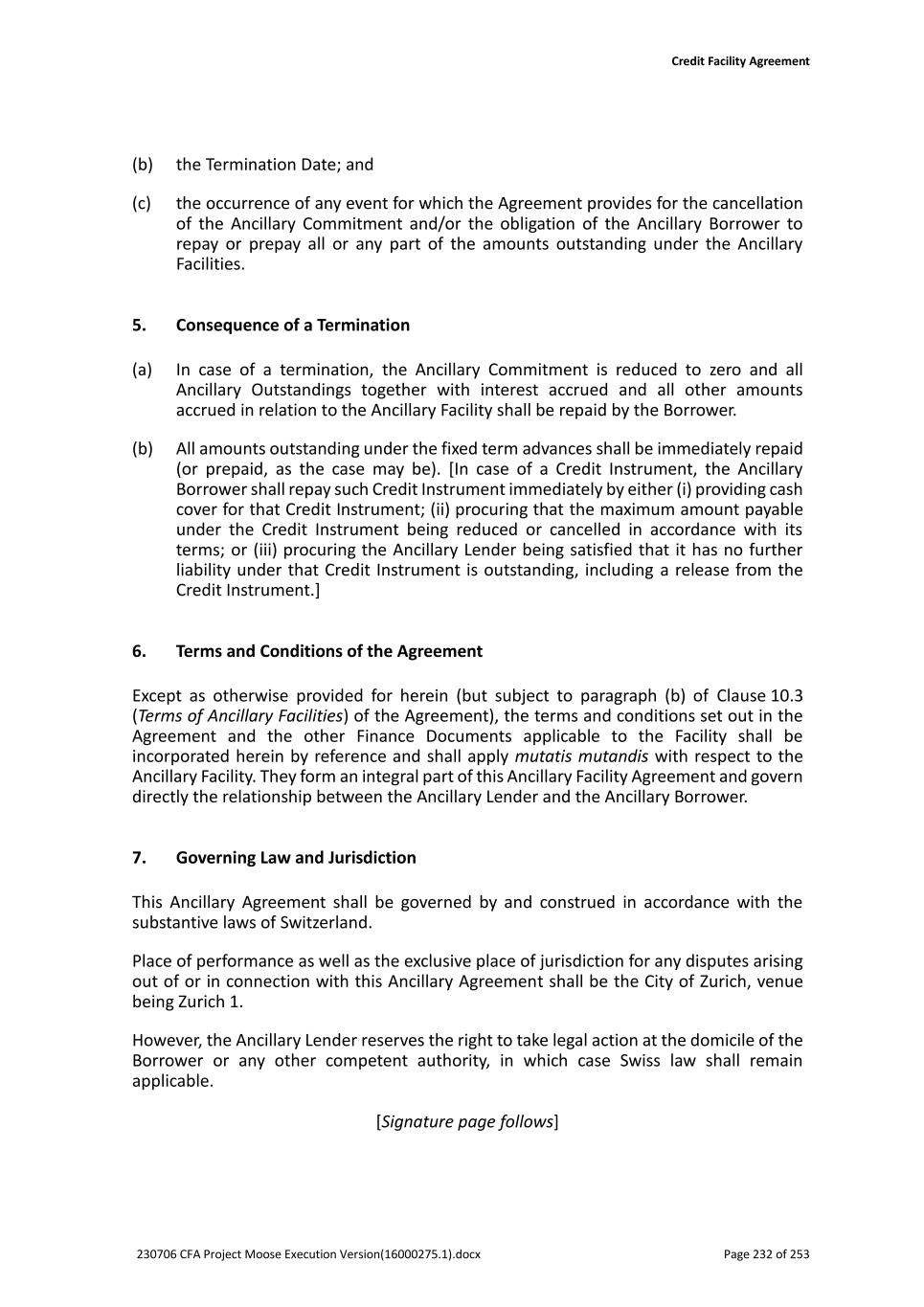
Credit Facility Agreement 230706 CFA Project Moose Execution Version(16000275.1).docx Page 232 of 253 (b) the Termination Date; and (c) the occurrence of any event for which the Agreement provides for the cancellation of the Ancillary Commitment and/or the obligation of the Ancillary Borrower to repay or prepay all or any part of the amounts outstanding under the Ancillary Facilities. 5. Consequence of a Termination (a) In case of a termination, the Ancillary Commitment is reduced to zero and all Ancillary Outstandings together with interest accrued and all other amounts accrued in relation to the Ancillary Facility shall be repaid by the Borrower. (b) All amounts outstanding under the fixed term advances shall be immediately repaid (or prepaid, as the case may be). [In case of a Credit Instrument, the Ancillary Borrower shall repay such Credit Instrument immediately by either (i) providing cash cover for that Credit Instrument; (ii) procuring that the maximum amount payable under the Credit Instrument being reduced or cancelled in accordance with its terms; or (iii) procuring the Ancillary Lender being satisfied that it has no further liability under that Credit Instrument is outstanding, including a release from the Credit Instrument.] 6. Terms and Conditions of the Agreement Except as otherwise provided for herein (but subject to paragraph (b) of Clause 10.3 (Terms of Ancillary Facilities) of the Agreement), the terms and conditions set out in the Agreement and the other Finance Documents applicable to the Facility shall be incorporated herein by reference and shall apply mutatis mutandis with respect to the Ancillary Facility. They form an integral part of this Ancillary Facility Agreement and govern directly the relationship between the Ancillary Lender and the Ancillary Borrower. 7. Governing Law and Jurisdiction This Ancillary Agreement shall be governed by and construed in accordance with the substantive laws of Switzerland. Place of performance as well as the exclusive place of jurisdiction for any disputes arising out of or in connection with this Ancillary Agreement shall be the City of Zurich, venue being Zurich 1. However, the Ancillary Lender reserves the right to take legal action at the domicile of the Borrower or any other competent authority, in which case Swiss law shall remain applicable. [Signature page follows]
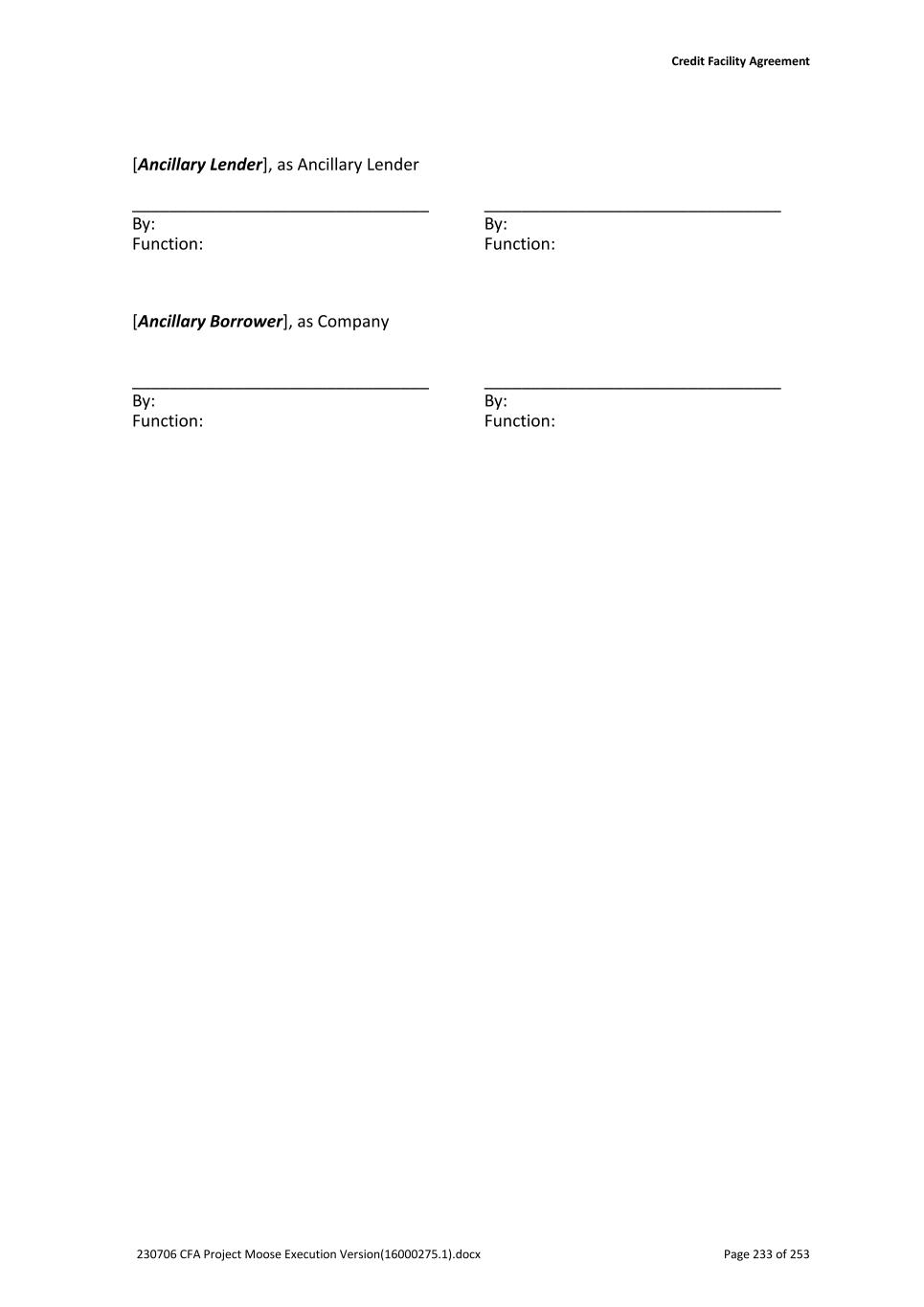
Credit Facility Agreement 230706 CFA Project Moose Execution Version(16000275.1).docx Page 233 of 253 [Ancillary Lender], as Ancillary Lender ________________________________ ________________________________ By: By: Function: Function: [Ancillary Borrower], as Company ________________________________ ________________________________ By: By: Function: Function:
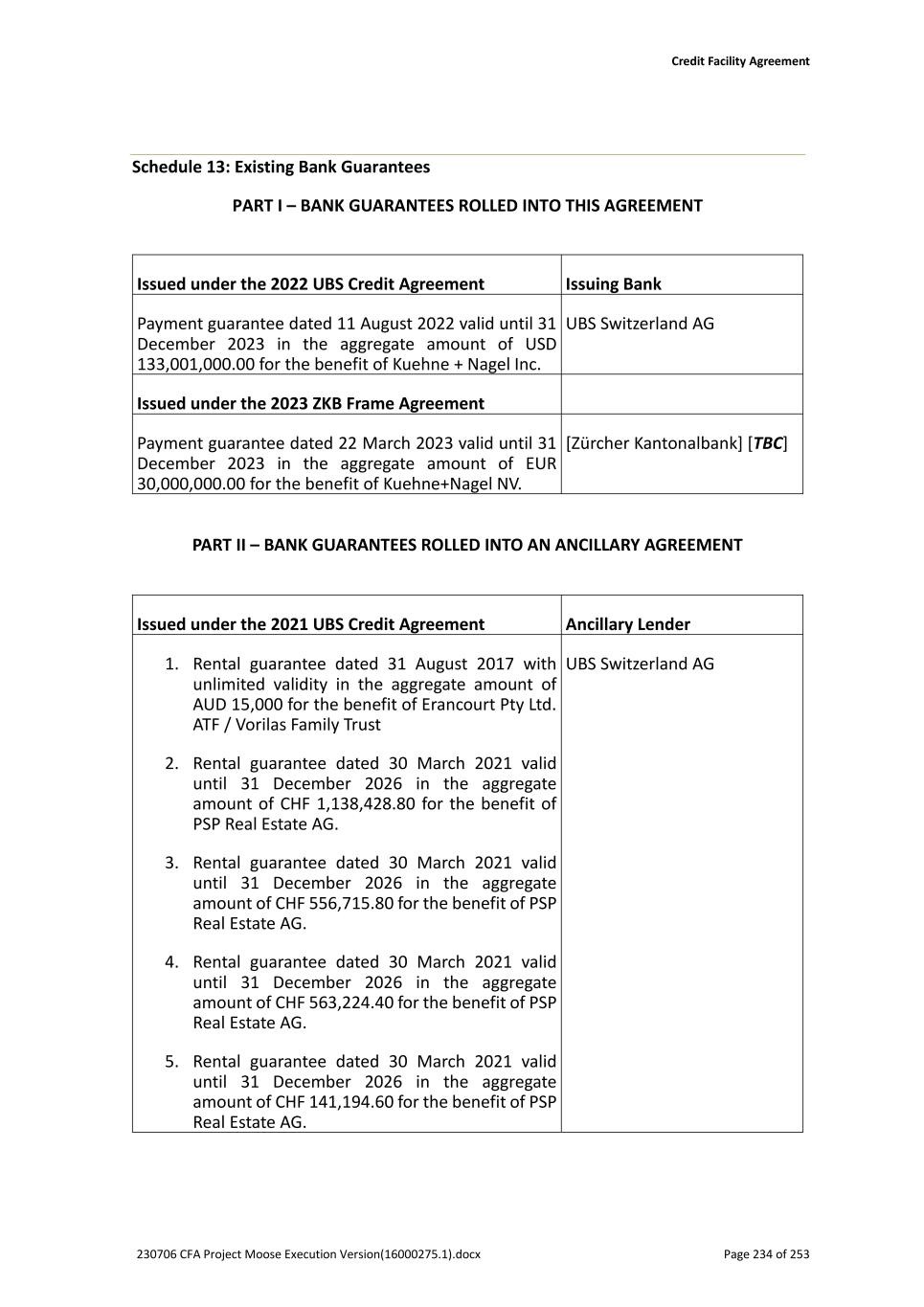
Credit Facility Agreement 230706 CFA Project Moose Execution Version(16000275.1).docx Page 234 of 253 Schedule 13: Existing Bank Guarantees PART I – BANK GUARANTEES ROLLED INTO THIS AGREEMENT Issued under the 2022 UBS Credit Agreement Issuing Bank Payment guarantee dated 11 August 2022 valid until 31 December 2023 in the aggregate amount of USD 133,001,000.00 for the benefit of Kuehne + Nagel Inc. UBS Switzerland AG Issued under the 2023 ZKB Frame Agreement Payment guarantee dated 22 March 2023 valid until 31 December 2023 in the aggregate amount of EUR 30,000,000.00 for the benefit of Kuehne+Nagel NV. [Zürcher Kantonalbank] [TBC] PART II – BANK GUARANTEES ROLLED INTO AN ANCILLARY AGREEMENT Issued under the 2021 UBS Credit Agreement Ancillary Lender 1. Rental guarantee dated 31 August 2017 with unlimited validity in the aggregate amount of AUD 15,000 for the benefit of Erancourt Pty Ltd. ATF / Vorilas Family Trust 2. Rental guarantee dated 30 March 2021 valid until 31 December 2026 in the aggregate amount of CHF 1,138,428.80 for the benefit of PSP Real Estate AG. 3. Rental guarantee dated 30 March 2021 valid until 31 December 2026 in the aggregate amount of CHF 556,715.80 for the benefit of PSP Real Estate AG. 4. Rental guarantee dated 30 March 2021 valid until 31 December 2026 in the aggregate amount of CHF 563,224.40 for the benefit of PSP Real Estate AG. 5. Rental guarantee dated 30 March 2021 valid until 31 December 2026 in the aggregate amount of CHF 141,194.60 for the benefit of PSP Real Estate AG. UBS Switzerland AG
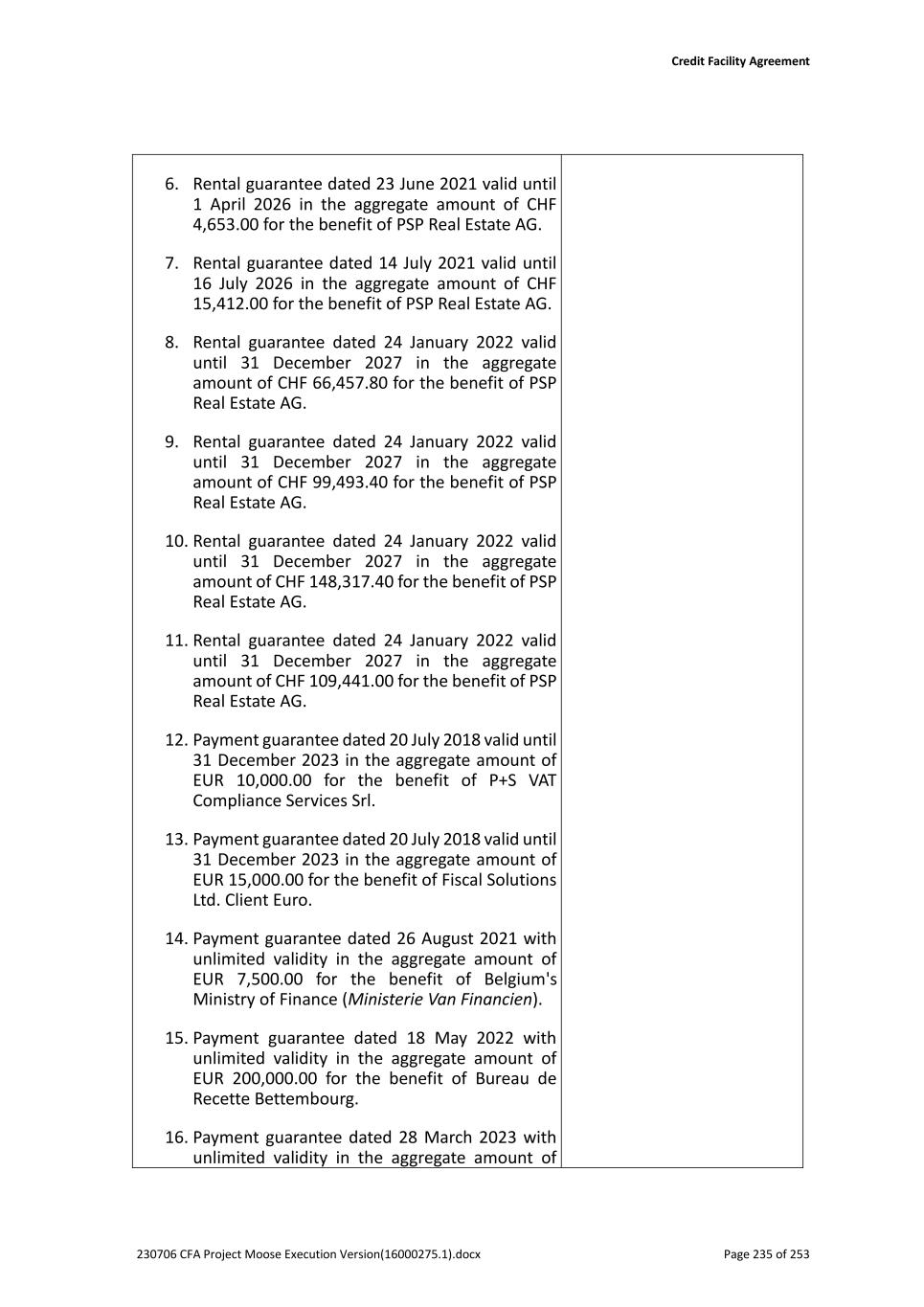
Credit Facility Agreement 230706 CFA Project Moose Execution Version(16000275.1).docx Page 235 of 253 6. Rental guarantee dated 23 June 2021 valid until 1 April 2026 in the aggregate amount of CHF 4,653.00 for the benefit of PSP Real Estate AG. 7. Rental guarantee dated 14 July 2021 valid until 16 July 2026 in the aggregate amount of CHF 15,412.00 for the benefit of PSP Real Estate AG. 8. Rental guarantee dated 24 January 2022 valid until 31 December 2027 in the aggregate amount of CHF 66,457.80 for the benefit of PSP Real Estate AG. 9. Rental guarantee dated 24 January 2022 valid until 31 December 2027 in the aggregate amount of CHF 99,493.40 for the benefit of PSP Real Estate AG. 10. Rental guarantee dated 24 January 2022 valid until 31 December 2027 in the aggregate amount of CHF 148,317.40 for the benefit of PSP Real Estate AG. 11. Rental guarantee dated 24 January 2022 valid until 31 December 2027 in the aggregate amount of CHF 109,441.00 for the benefit of PSP Real Estate AG. 12. Payment guarantee dated 20 July 2018 valid until 31 December 2023 in the aggregate amount of EUR 10,000.00 for the benefit of P+S VAT Compliance Services Srl. 13. Payment guarantee dated 20 July 2018 valid until 31 December 2023 in the aggregate amount of EUR 15,000.00 for the benefit of Fiscal Solutions Ltd. Client Euro. 14. Payment guarantee dated 26 August 2021 with unlimited validity in the aggregate amount of EUR 7,500.00 for the benefit of Belgium's Ministry of Finance (Ministerie Van Financien). 15. Payment guarantee dated 18 May 2022 with unlimited validity in the aggregate amount of EUR 200,000.00 for the benefit of Bureau de Recette Bettembourg. 16. Payment guarantee dated 28 March 2023 with unlimited validity in the aggregate amount of
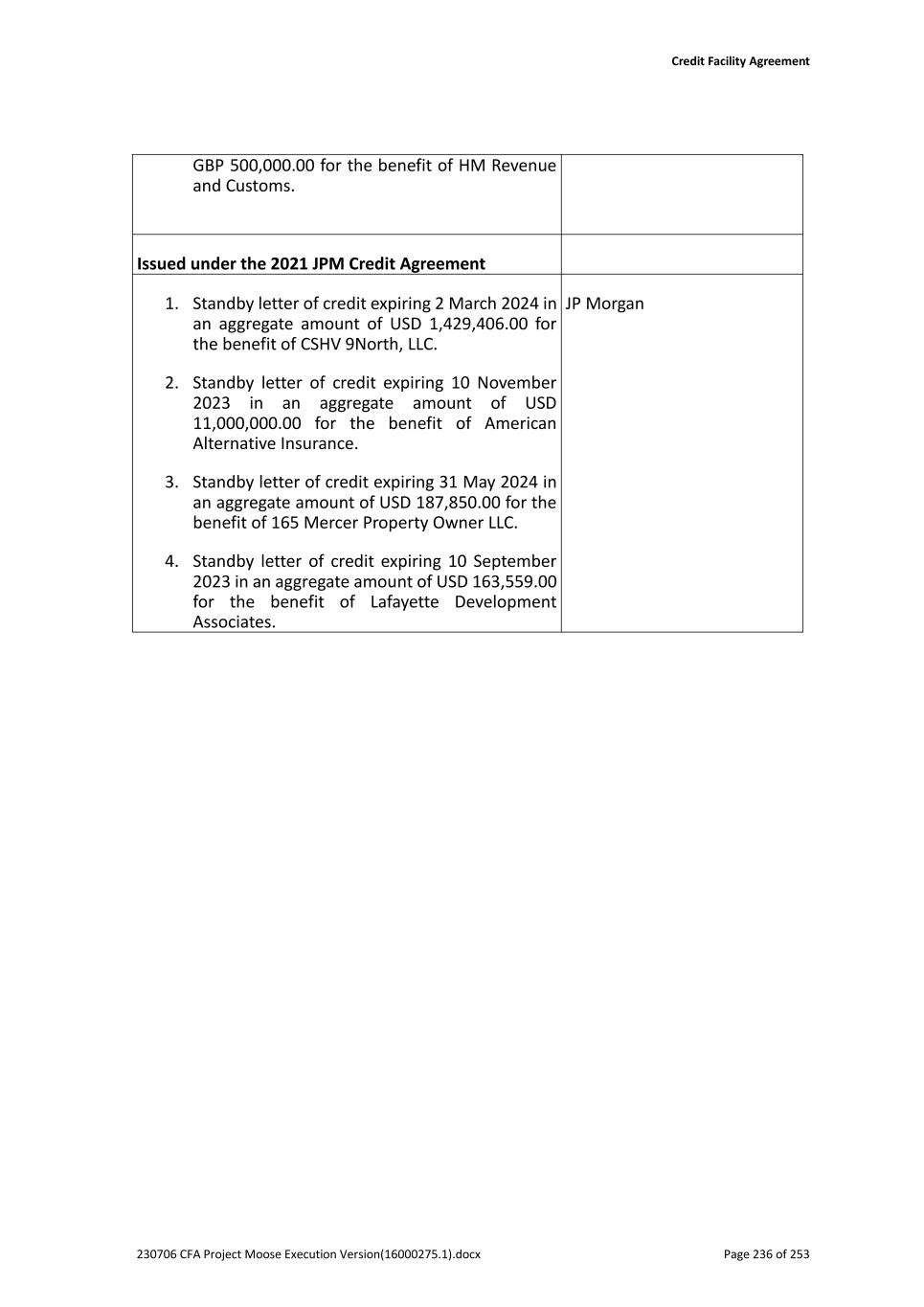
Credit Facility Agreement 230706 CFA Project Moose Execution Version(16000275.1).docx Page 236 of 253 GBP 500,000.00 for the benefit of HM Revenue and Customs. Issued under the 2021 JPM Credit Agreement 1. Standby letter of credit expiring 2 March 2024 in an aggregate amount of USD 1,429,406.00 for the benefit of CSHV 9North, LLC. 2. Standby letter of credit expiring 10 November 2023 in an aggregate amount of USD 11,000,000.00 for the benefit of American Alternative Insurance. 3. Standby letter of credit expiring 31 May 2024 in an aggregate amount of USD 187,850.00 for the benefit of 165 Mercer Property Owner LLC. 4. Standby letter of credit expiring 10 September 2023 in an aggregate amount of USD 163,559.00 for the benefit of Lafayette Development Associates. JP Morgan
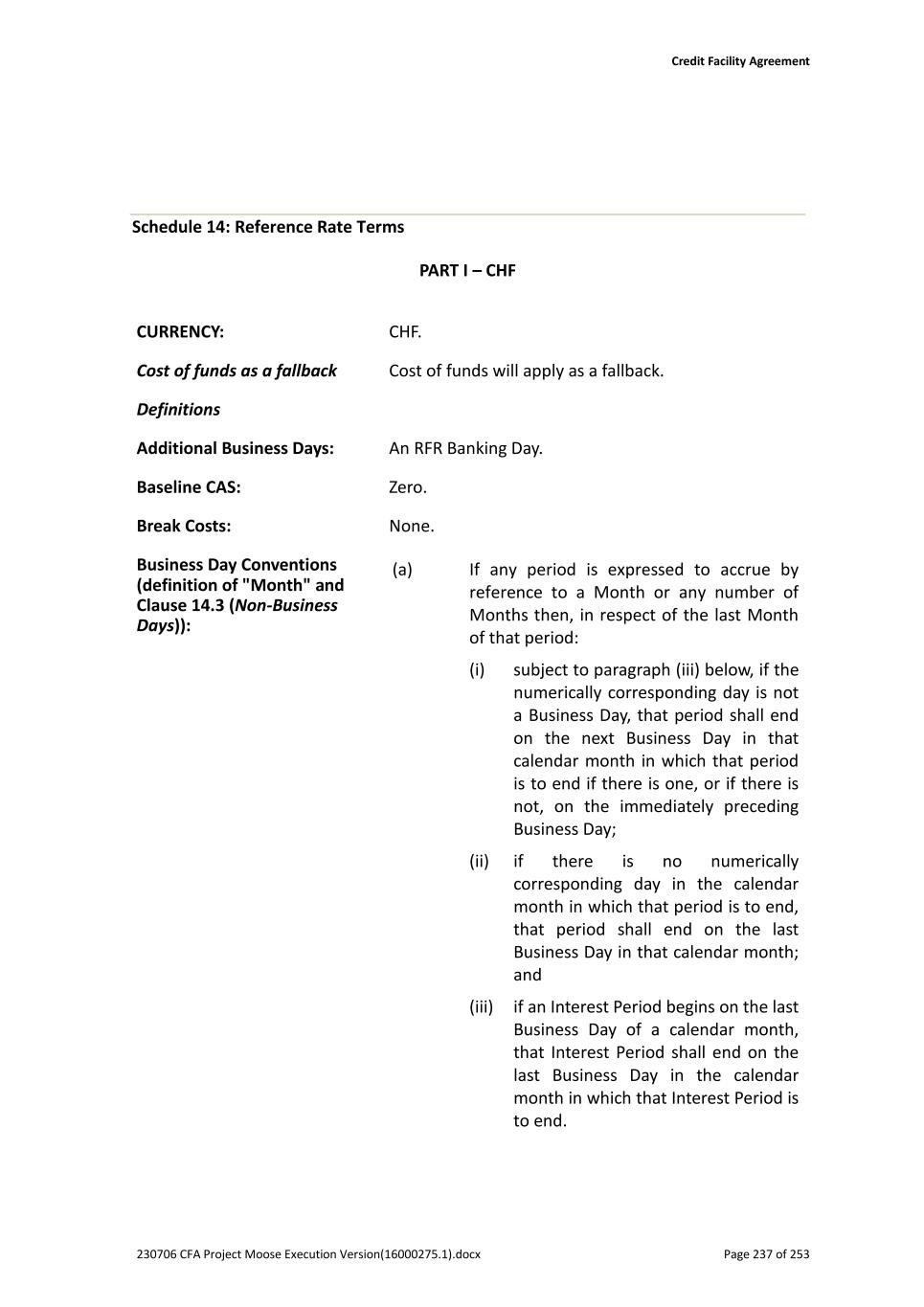
Credit Facility Agreement 230706 CFA Project Moose Execution Version(16000275.1).docx Page 237 of 253 Schedule 14: Reference Rate Terms PART I – CHF CURRENCY: CHF. Cost of funds as a fallback Cost of funds will apply as a fallback. Definitions Additional Business Days: An RFR Banking Day. Baseline CAS: Zero. Break Costs: None. Business Day Conventions (definition of "Month" and Clause 14.3 (Non-Business Days)): (a) If any period is expressed to accrue by reference to a Month or any number of Months then, in respect of the last Month of that period: (i) subject to paragraph (iii) below, if the numerically corresponding day is not a Business Day, that period shall end on the next Business Day in that calendar month in which that period is to end if there is one, or if there is not, on the immediately preceding Business Day; (ii) if there is no numerically corresponding day in the calendar month in which that period is to end, that period shall end on the last Business Day in that calendar month; and (iii) if an Interest Period begins on the last Business Day of a calendar month, that Interest Period shall end on the last Business Day in the calendar month in which that Interest Period is to end.
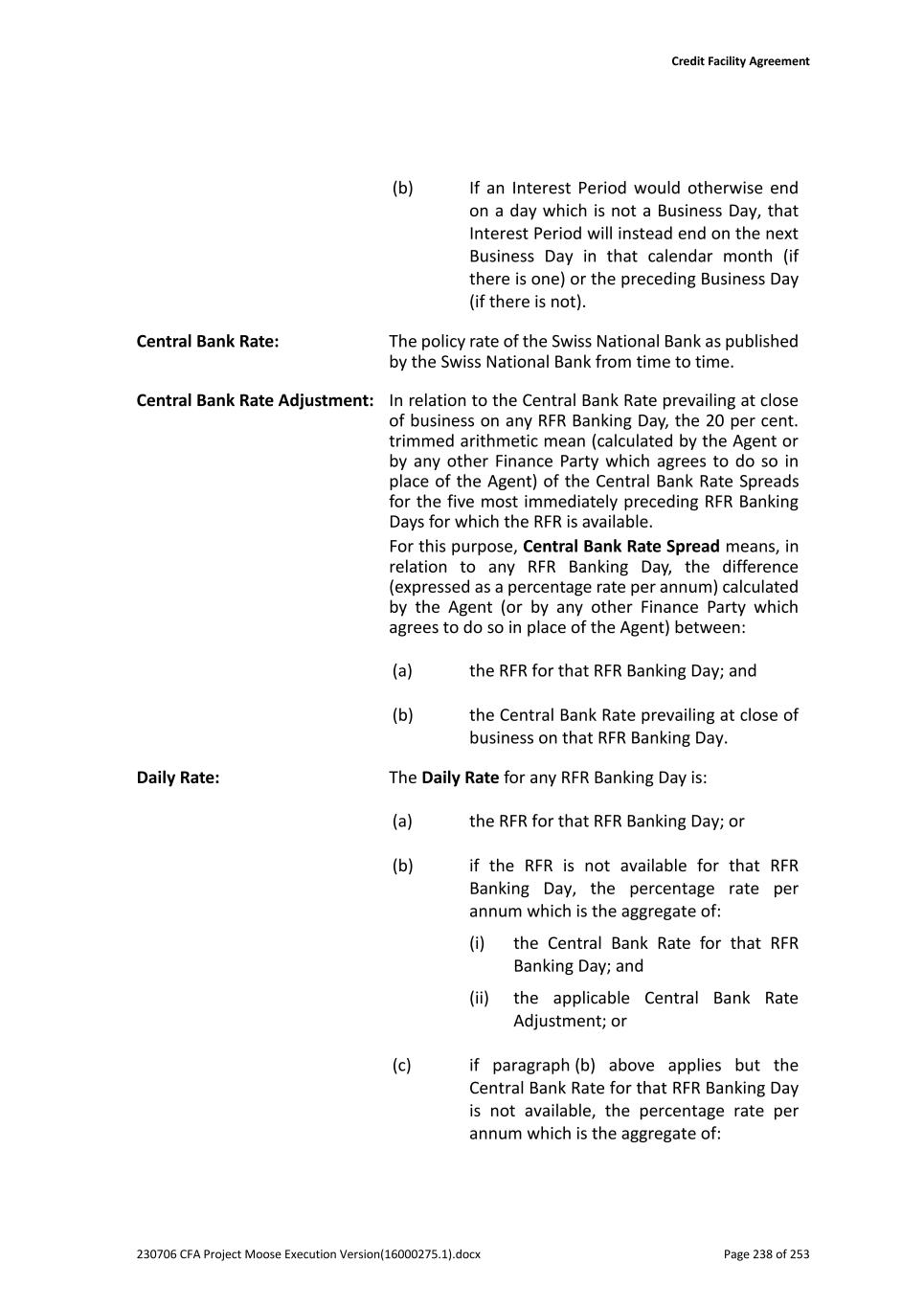
Credit Facility Agreement 230706 CFA Project Moose Execution Version(16000275.1).docx Page 238 of 253 (b) If an Interest Period would otherwise end on a day which is not a Business Day, that Interest Period will instead end on the next Business Day in that calendar month (if there is one) or the preceding Business Day (if there is not). Central Bank Rate: The policy rate of the Swiss National Bank as published by the Swiss National Bank from time to time. Central Bank Rate Adjustment: In relation to the Central Bank Rate prevailing at close of business on any RFR Banking Day, the 20 per cent. trimmed arithmetic mean (calculated by the Agent or by any other Finance Party which agrees to do so in place of the Agent) of the Central Bank Rate Spreads for the five most immediately preceding RFR Banking Days for which the RFR is available. For this purpose, Central Bank Rate Spread means, in relation to any RFR Banking Day, the difference (expressed as a percentage rate per annum) calculated by the Agent (or by any other Finance Party which agrees to do so in place of the Agent) between: (a) the RFR for that RFR Banking Day; and (b) the Central Bank Rate prevailing at close of business on that RFR Banking Day. Daily Rate: The Daily Rate for any RFR Banking Day is: (a) the RFR for that RFR Banking Day; or (b) if the RFR is not available for that RFR Banking Day, the percentage rate per annum which is the aggregate of: (i) the Central Bank Rate for that RFR Banking Day; and (ii) the applicable Central Bank Rate Adjustment; or (c) if paragraph (b) above applies but the Central Bank Rate for that RFR Banking Day is not available, the percentage rate per annum which is the aggregate of:
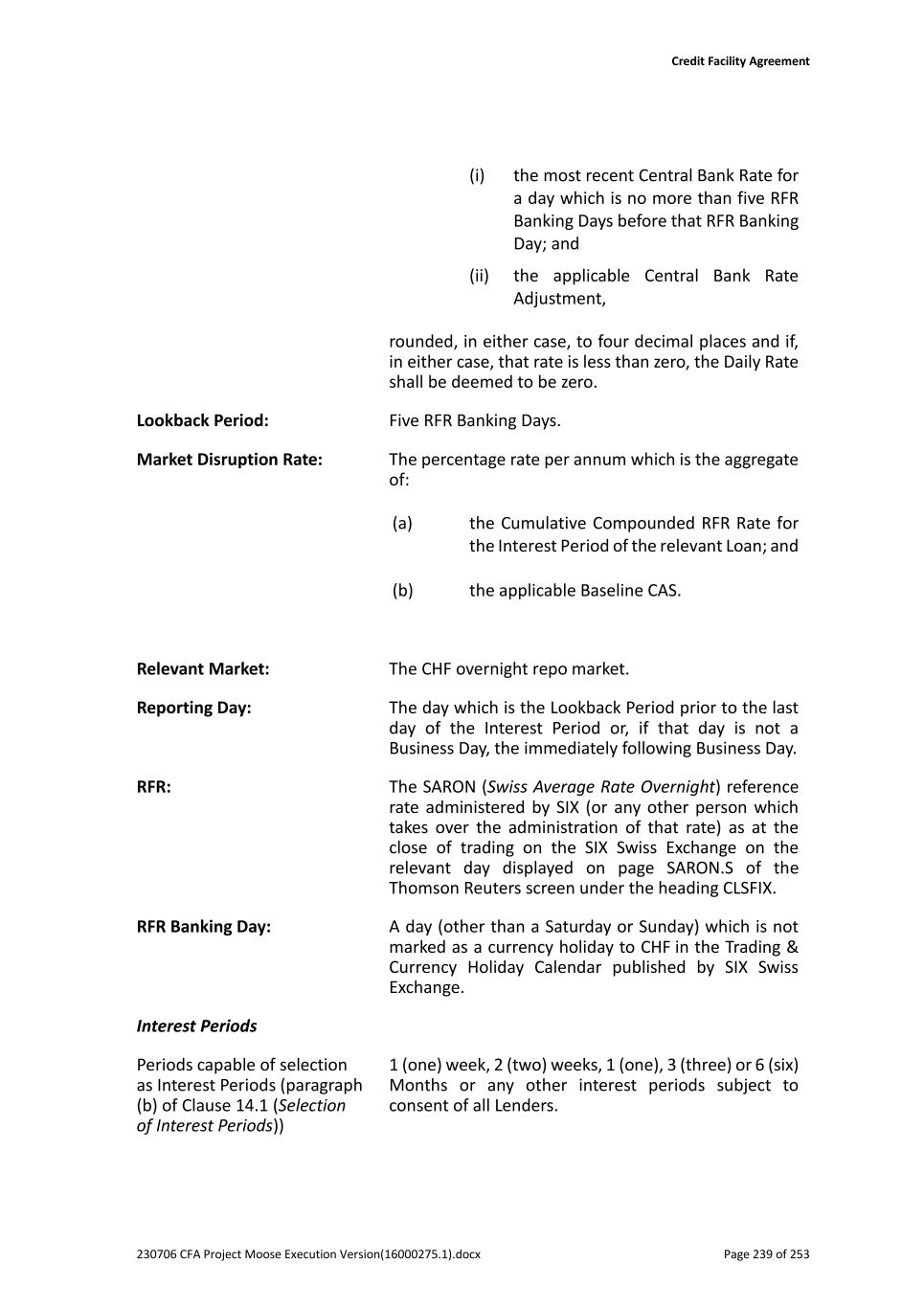
Credit Facility Agreement 230706 CFA Project Moose Execution Version(16000275.1).docx Page 239 of 253 (i) the most recent Central Bank Rate for a day which is no more than five RFR Banking Days before that RFR Banking Day; and (ii) the applicable Central Bank Rate Adjustment, rounded, in either case, to four decimal places and if, in either case, that rate is less than zero, the Daily Rate shall be deemed to be zero. Lookback Period: Five RFR Banking Days. Market Disruption Rate: The percentage rate per annum which is the aggregate of: (a) the Cumulative Compounded RFR Rate for the Interest Period of the relevant Loan; and (b) the applicable Baseline CAS. Relevant Market: The CHF overnight repo market. Reporting Day: The day which is the Lookback Period prior to the last day of the Interest Period or, if that day is not a Business Day, the immediately following Business Day. RFR: The SARON (Swiss Average Rate Overnight) reference rate administered by SIX (or any other person which takes over the administration of that rate) as at the close of trading on the SIX Swiss Exchange on the relevant day displayed on page SARON.S of the Thomson Reuters screen under the heading CLSFIX. RFR Banking Day: A day (other than a Saturday or Sunday) which is not marked as a currency holiday to CHF in the Trading & Currency Holiday Calendar published by SIX Swiss Exchange. Interest Periods Periods capable of selection as Interest Periods (paragraph (b) of Clause 14.1 (Selection of Interest Periods)) 1 (one) week, 2 (two) weeks, 1 (one), 3 (three) or 6 (six) Months or any other interest periods subject to consent of all Lenders.
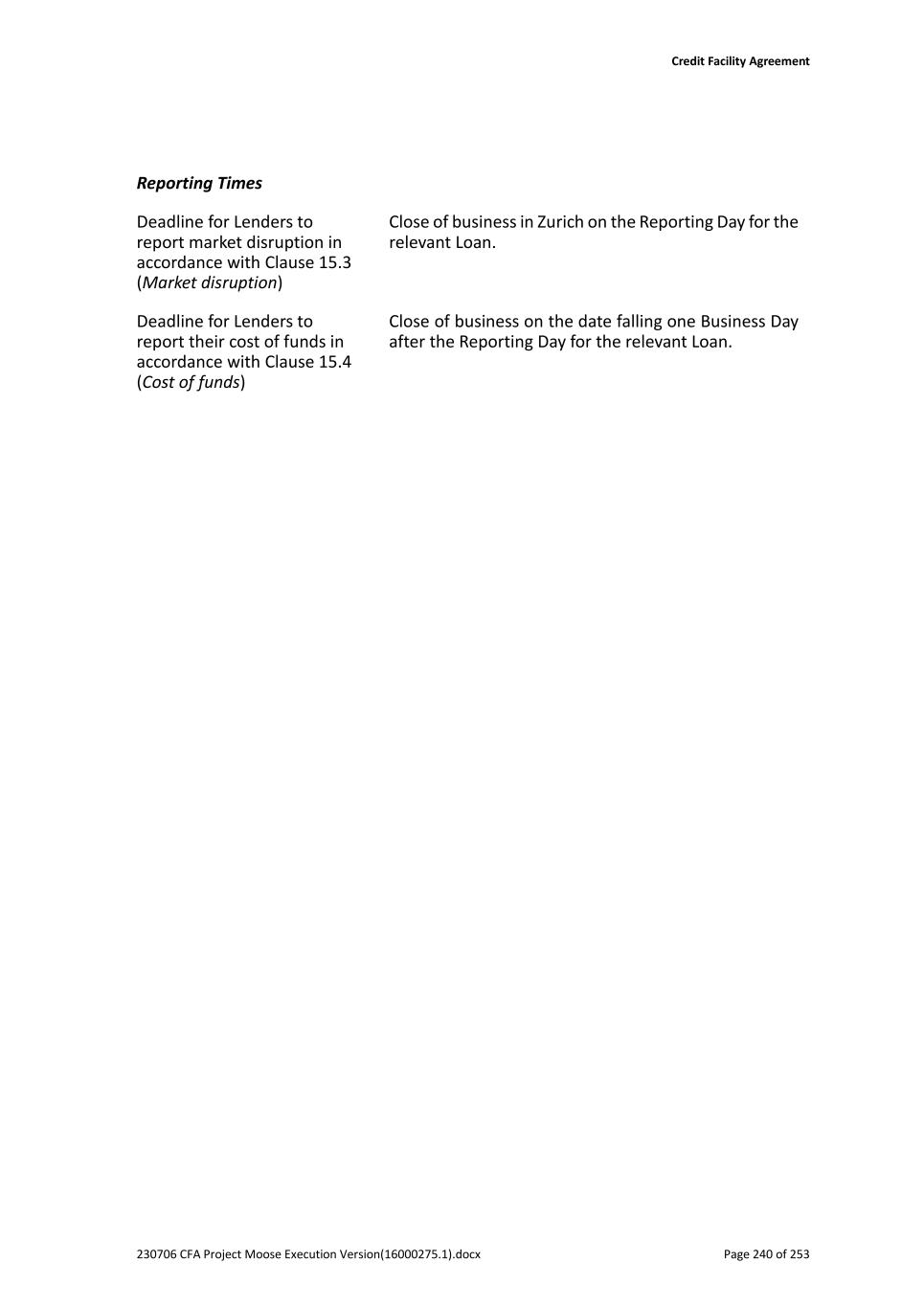
Credit Facility Agreement 230706 CFA Project Moose Execution Version(16000275.1).docx Page 240 of 253 Reporting Times Deadline for Lenders to report market disruption in accordance with Clause 15.3 (Market disruption) Close of business in Zurich on the Reporting Day for the relevant Loan. Deadline for Lenders to report their cost of funds in accordance with Clause 15.4 (Cost of funds) Close of business on the date falling one Business Day after the Reporting Day for the relevant Loan.
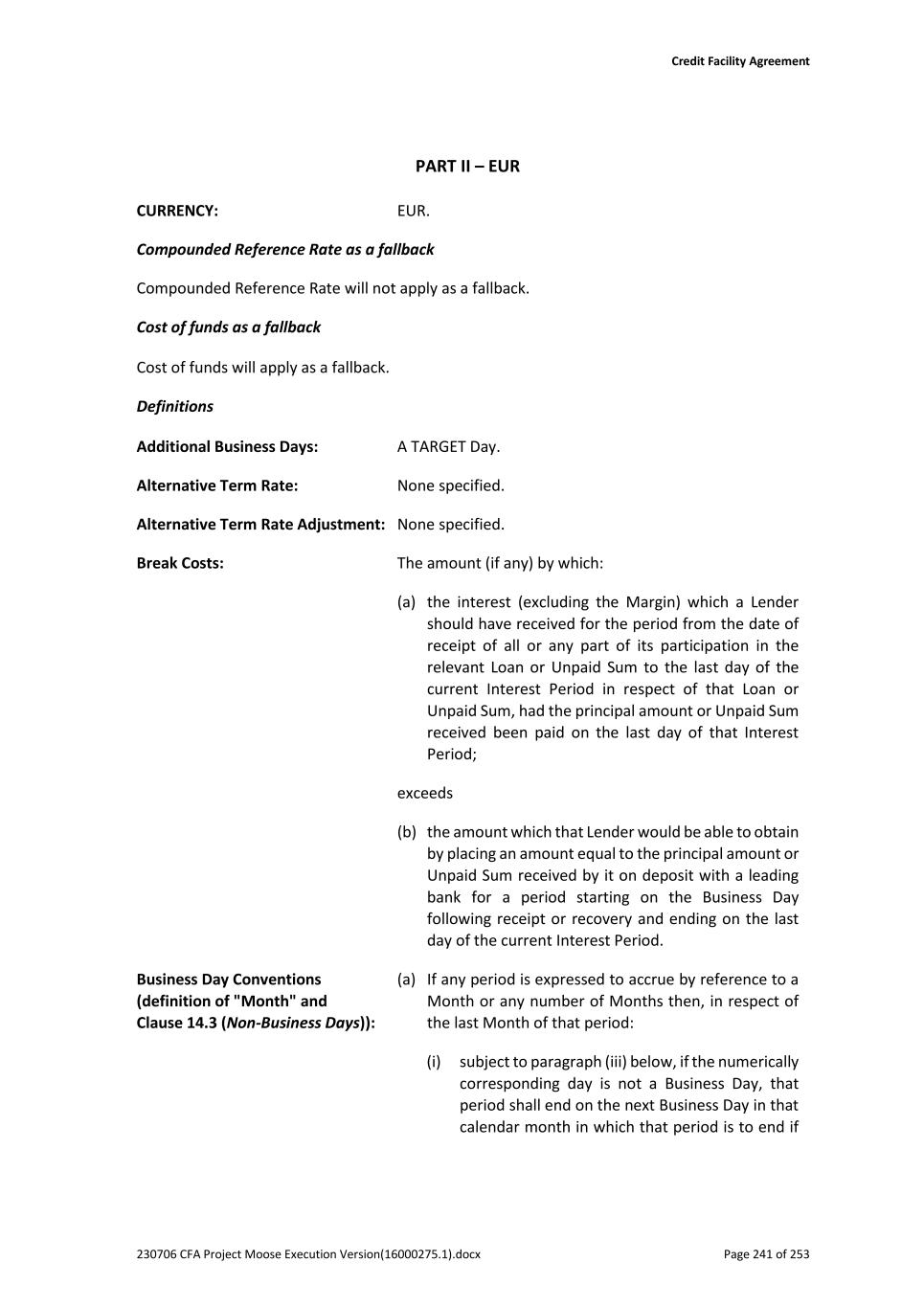
Credit Facility Agreement 230706 CFA Project Moose Execution Version(16000275.1).docx Page 241 of 253 PART II – EUR CURRENCY: EUR. Compounded Reference Rate as a fallback Compounded Reference Rate will not apply as a fallback. Cost of funds as a fallback Cost of funds will apply as a fallback. Definitions Additional Business Days: A TARGET Day. Alternative Term Rate: None specified. Alternative Term Rate Adjustment: None specified. Break Costs: The amount (if any) by which: (a) the interest (excluding the Margin) which a Lender should have received for the period from the date of receipt of all or any part of its participation in the relevant Loan or Unpaid Sum to the last day of the current Interest Period in respect of that Loan or Unpaid Sum, had the principal amount or Unpaid Sum received been paid on the last day of that Interest Period; exceeds (b) the amount which that Lender would be able to obtain by placing an amount equal to the principal amount or Unpaid Sum received by it on deposit with a leading bank for a period starting on the Business Day following receipt or recovery and ending on the last day of the current Interest Period. Business Day Conventions (definition of "Month" and Clause 14.3 (Non-Business Days)): (a) If any period is expressed to accrue by reference to a Month or any number of Months then, in respect of the last Month of that period: (i) subject to paragraph (iii) below, if the numerically corresponding day is not a Business Day, that period shall end on the next Business Day in that calendar month in which that period is to end if
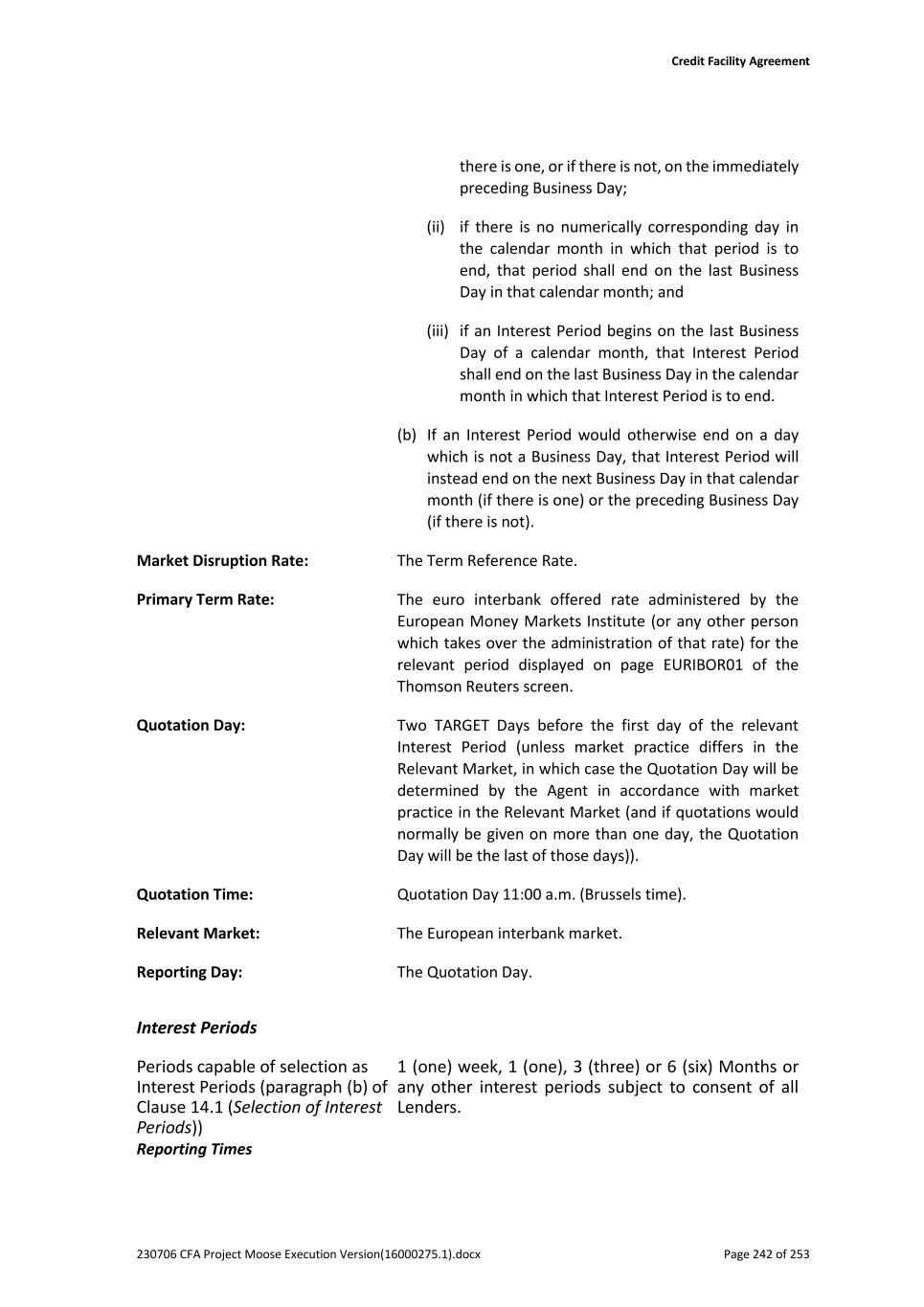
Credit Facility Agreement 230706 CFA Project Moose Execution Version(16000275.1).docx Page 242 of 253 there is one, or if there is not, on the immediately preceding Business Day; (ii) if there is no numerically corresponding day in the calendar month in which that period is to end, that period shall end on the last Business Day in that calendar month; and (iii) if an Interest Period begins on the last Business Day of a calendar month, that Interest Period shall end on the last Business Day in the calendar month in which that Interest Period is to end. (b) If an Interest Period would otherwise end on a day which is not a Business Day, that Interest Period will instead end on the next Business Day in that calendar month (if there is one) or the preceding Business Day (if there is not). Market Disruption Rate: The Term Reference Rate. Primary Term Rate: The euro interbank offered rate administered by the European Money Markets Institute (or any other person which takes over the administration of that rate) for the relevant period displayed on page EURIBOR01 of the Thomson Reuters screen. Quotation Day: Two TARGET Days before the first day of the relevant Interest Period (unless market practice differs in the Relevant Market, in which case the Quotation Day will be determined by the Agent in accordance with market practice in the Relevant Market (and if quotations would normally be given on more than one day, the Quotation Day will be the last of those days)). Quotation Time: Quotation Day 11:00 a.m. (Brussels time). Relevant Market: The European interbank market. Reporting Day: The Quotation Day. Interest Periods Periods capable of selection as Interest Periods (paragraph (b) of Clause 14.1 (Selection of Interest Periods)) 1 (one) week, 1 (one), 3 (three) or 6 (six) Months or any other interest periods subject to consent of all Lenders. Reporting Times
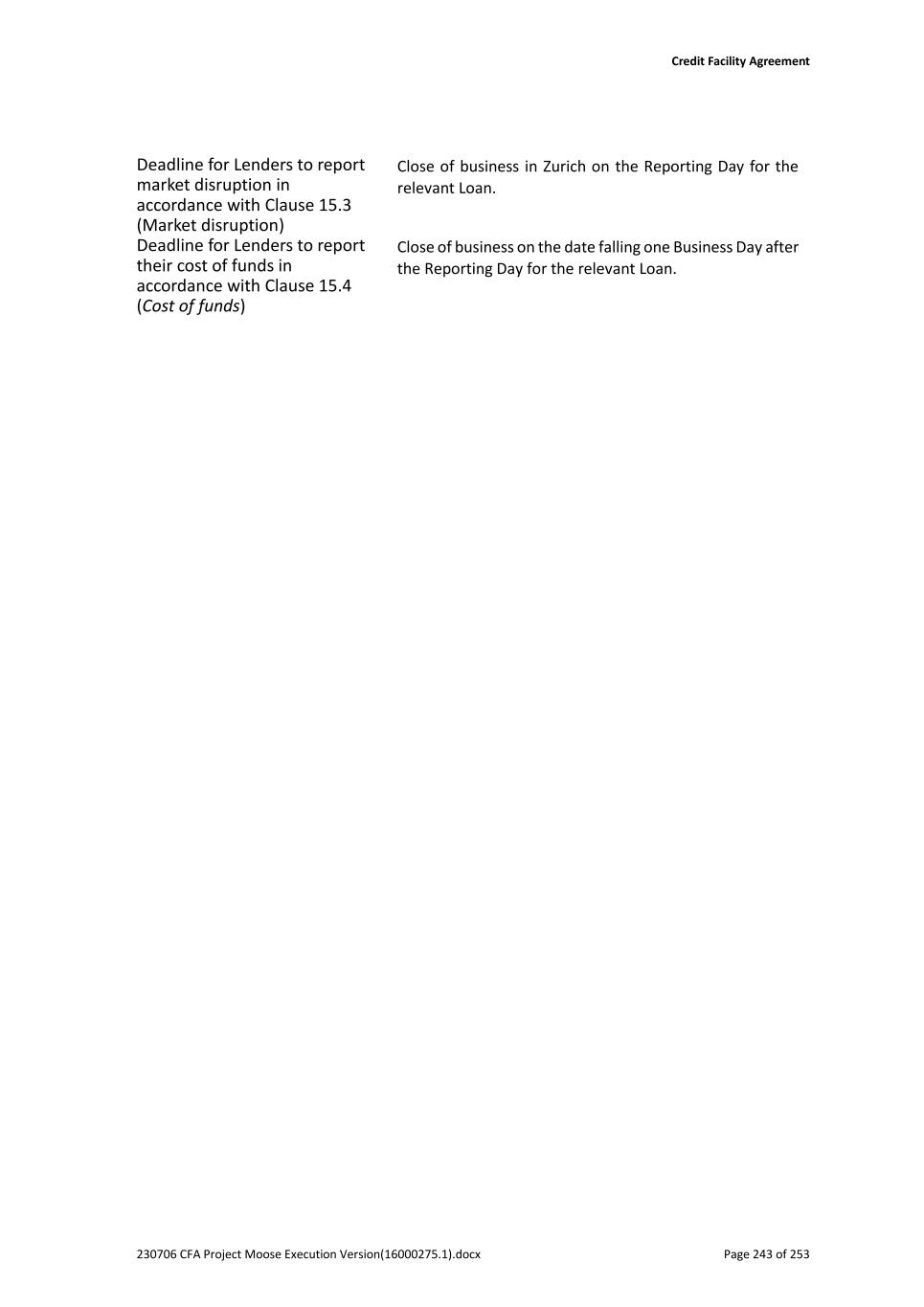
Credit Facility Agreement 230706 CFA Project Moose Execution Version(16000275.1).docx Page 243 of 253 Deadline for Lenders to report market disruption in accordance with Clause 15.3 (Market disruption) Close of business in Zurich on the Reporting Day for the relevant Loan. Deadline for Lenders to report their cost of funds in accordance with Clause 15.4 (Cost of funds) Close of business on the date falling one Business Day after the Reporting Day for the relevant Loan.
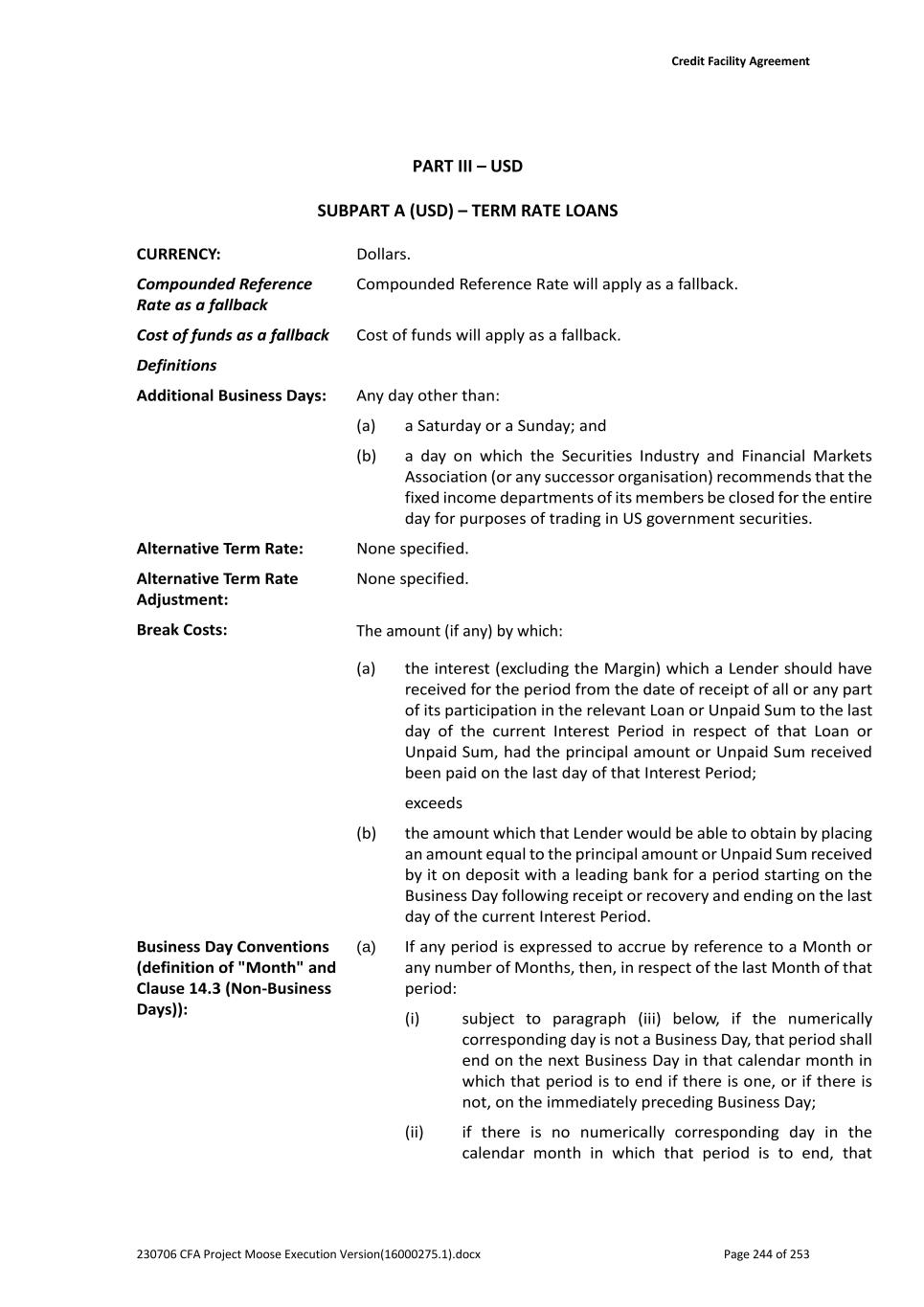
Credit Facility Agreement 230706 CFA Project Moose Execution Version(16000275.1).docx Page 244 of 253 PART III – USD SUBPART A (USD) – TERM RATE LOANS CURRENCY: Dollars. Compounded Reference Rate as a fallback Compounded Reference Rate will apply as a fallback. Cost of funds as a fallback Cost of funds will apply as a fallback. Definitions Additional Business Days: Any day other than: (a) a Saturday or a Sunday; and (b) a day on which the Securities Industry and Financial Markets Association (or any successor organisation) recommends that the fixed income departments of its members be closed for the entire day for purposes of trading in US government securities. Alternative Term Rate: None specified. Alternative Term Rate Adjustment: None specified. Break Costs: The amount (if any) by which: (a) the interest (excluding the Margin) which a Lender should have received for the period from the date of receipt of all or any part of its participation in the relevant Loan or Unpaid Sum to the last day of the current Interest Period in respect of that Loan or Unpaid Sum, had the principal amount or Unpaid Sum received been paid on the last day of that Interest Period; exceeds (b) the amount which that Lender would be able to obtain by placing an amount equal to the principal amount or Unpaid Sum received by it on deposit with a leading bank for a period starting on the Business Day following receipt or recovery and ending on the last day of the current Interest Period. Business Day Conventions (definition of "Month" and Clause 14.3 (Non-Business Days)): (a) If any period is expressed to accrue by reference to a Month or any number of Months, then, in respect of the last Month of that period: (i) subject to paragraph (iii) below, if the numerically corresponding day is not a Business Day, that period shall end on the next Business Day in that calendar month in which that period is to end if there is one, or if there is not, on the immediately preceding Business Day; (ii) if there is no numerically corresponding day in the calendar month in which that period is to end, that
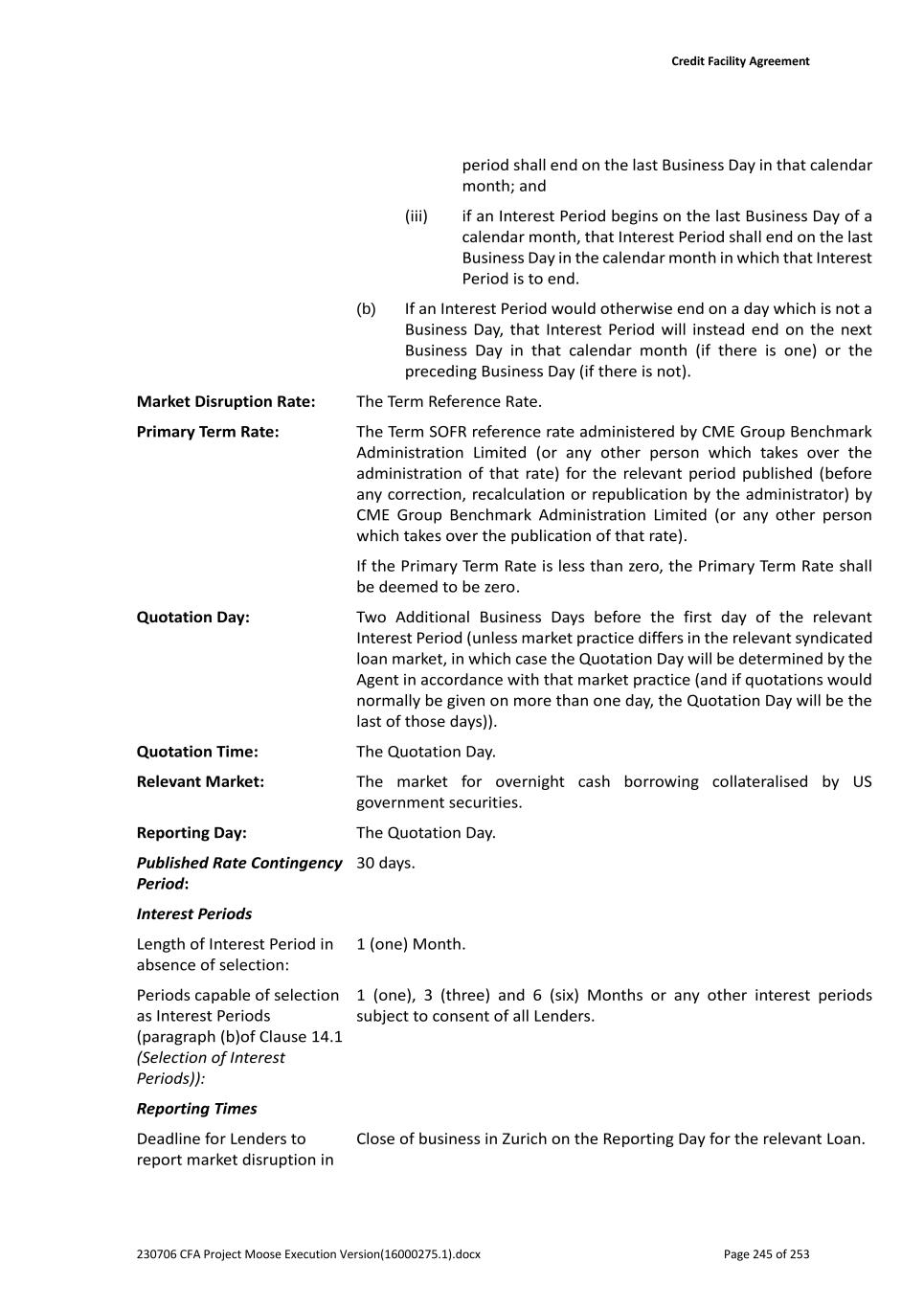
Credit Facility Agreement 230706 CFA Project Moose Execution Version(16000275.1).docx Page 245 of 253 period shall end on the last Business Day in that calendar month; and (iii) if an Interest Period begins on the last Business Day of a calendar month, that Interest Period shall end on the last Business Day in the calendar month in which that Interest Period is to end. (b) If an Interest Period would otherwise end on a day which is not a Business Day, that Interest Period will instead end on the next Business Day in that calendar month (if there is one) or the preceding Business Day (if there is not). Market Disruption Rate: The Term Reference Rate. Primary Term Rate: The Term SOFR reference rate administered by CME Group Benchmark Administration Limited (or any other person which takes over the administration of that rate) for the relevant period published (before any correction, recalculation or republication by the administrator) by CME Group Benchmark Administration Limited (or any other person which takes over the publication of that rate). If the Primary Term Rate is less than zero, the Primary Term Rate shall be deemed to be zero. Quotation Day: Two Additional Business Days before the first day of the relevant Interest Period (unless market practice differs in the relevant syndicated loan market, in which case the Quotation Day will be determined by the Agent in accordance with that market practice (and if quotations would normally be given on more than one day, the Quotation Day will be the last of those days)). Quotation Time: The Quotation Day. Relevant Market: The market for overnight cash borrowing collateralised by US government securities. Reporting Day: The Quotation Day. Published Rate Contingency Period: 30 days. Interest Periods Length of Interest Period in absence of selection: 1 (one) Month. Periods capable of selection as Interest Periods (paragraph (b)of Clause 14.1 (Selection of Interest Periods)): 1 (one), 3 (three) and 6 (six) Months or any other interest periods subject to consent of all Lenders. Reporting Times Deadline for Lenders to report market disruption in Close of business in Zurich on the Reporting Day for the relevant Loan.
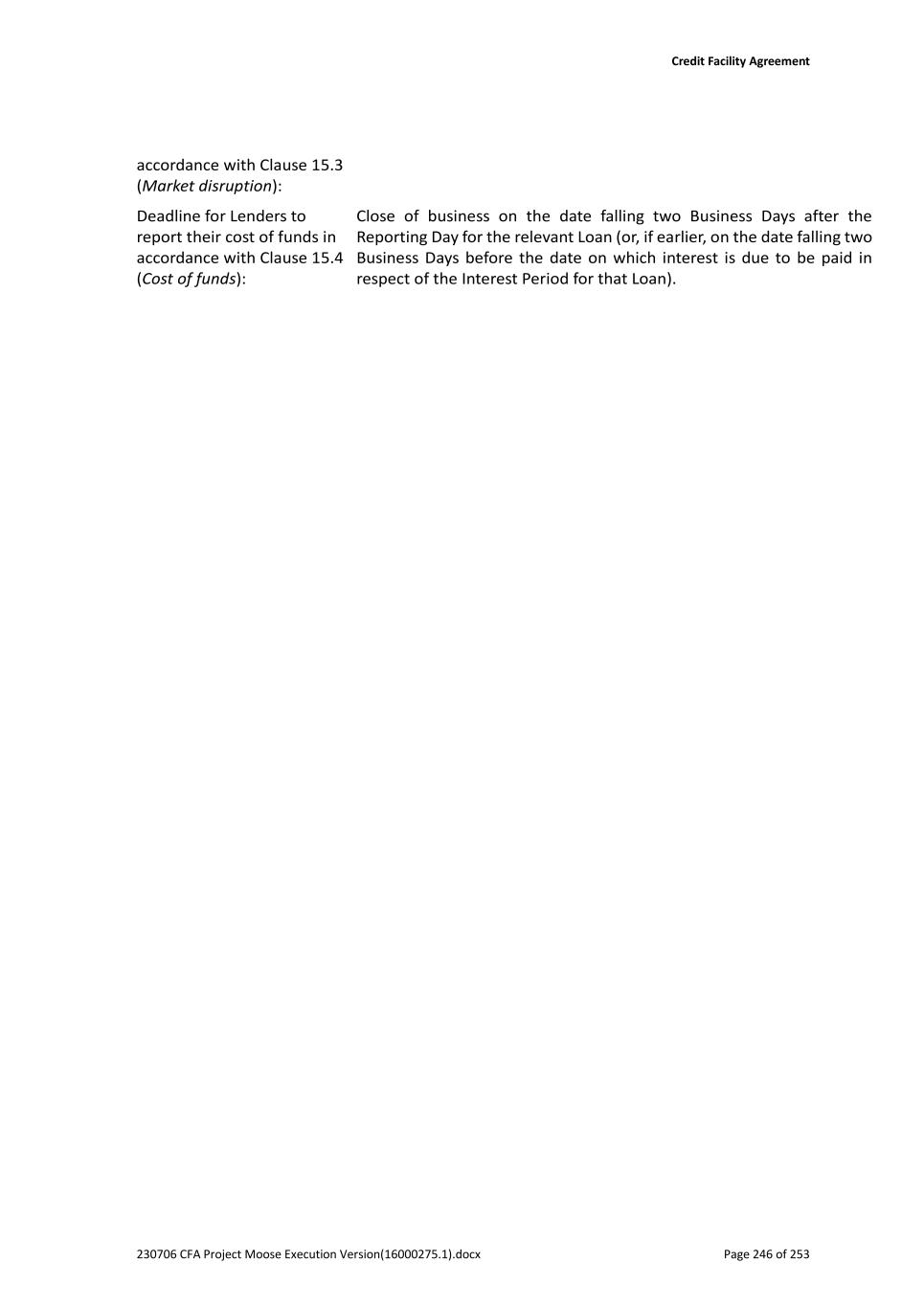
Credit Facility Agreement 230706 CFA Project Moose Execution Version(16000275.1).docx Page 246 of 253 accordance with Clause 15.3 (Market disruption): Deadline for Lenders to report their cost of funds in accordance with Clause 15.4 (Cost of funds): Close of business on the date falling two Business Days after the Reporting Day for the relevant Loan (or, if earlier, on the date falling two Business Days before the date on which interest is due to be paid in respect of the Interest Period for that Loan).
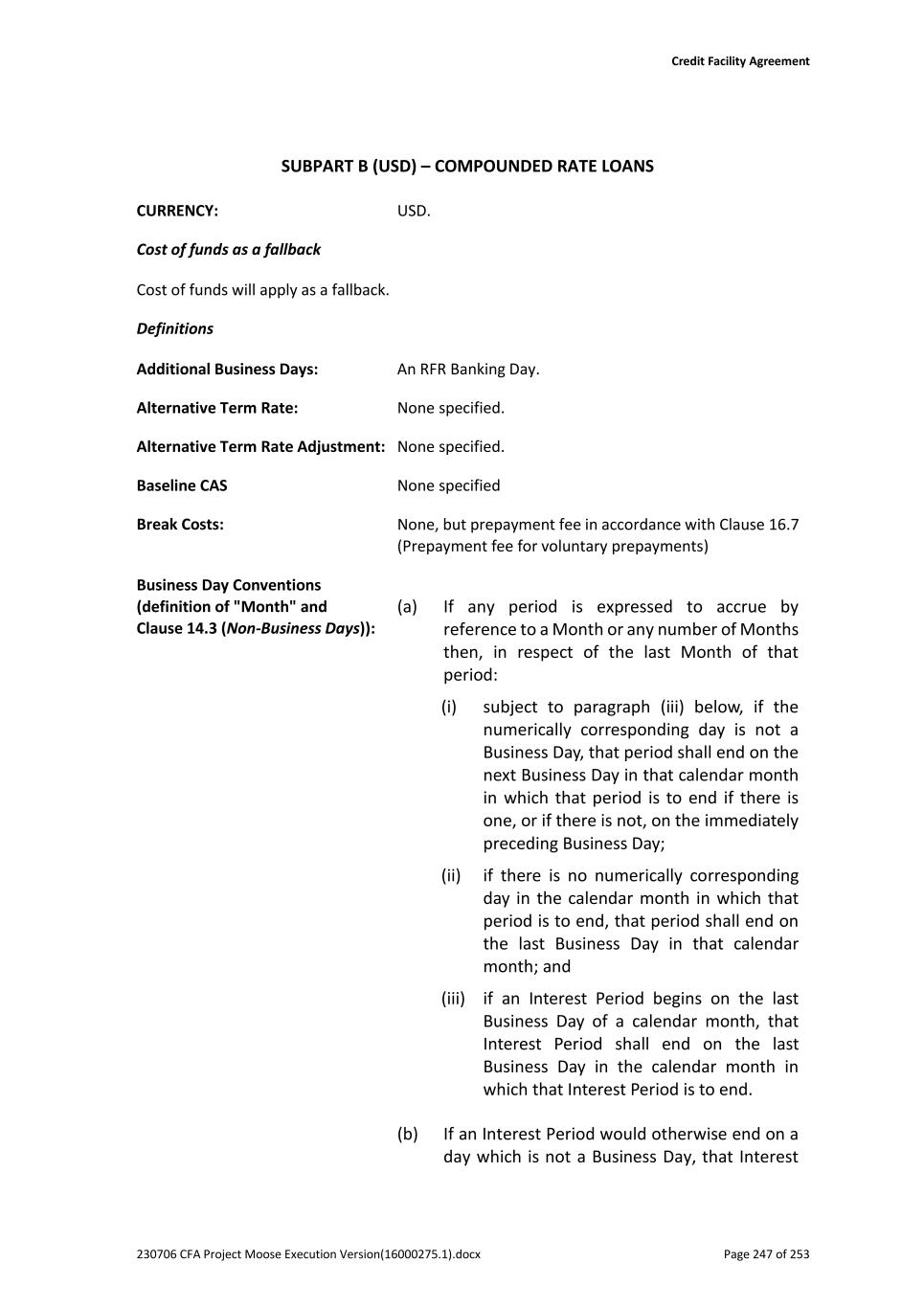
Credit Facility Agreement 230706 CFA Project Moose Execution Version(16000275.1).docx Page 247 of 253 SUBPART B (USD) – COMPOUNDED RATE LOANS CURRENCY: USD. Cost of funds as a fallback Cost of funds will apply as a fallback. Definitions Additional Business Days: An RFR Banking Day. Alternative Term Rate: None specified. Alternative Term Rate Adjustment: None specified. Baseline CAS None specified Break Costs: None, but prepayment fee in accordance with Clause 16.7 (Prepayment fee for voluntary prepayments) Business Day Conventions (definition of "Month" and Clause 14.3 (Non-Business Days)): (a) If any period is expressed to accrue by reference to a Month or any number of Months then, in respect of the last Month of that period: (i) subject to paragraph (iii) below, if the numerically corresponding day is not a Business Day, that period shall end on the next Business Day in that calendar month in which that period is to end if there is one, or if there is not, on the immediately preceding Business Day; (ii) if there is no numerically corresponding day in the calendar month in which that period is to end, that period shall end on the last Business Day in that calendar month; and (iii) if an Interest Period begins on the last Business Day of a calendar month, that Interest Period shall end on the last Business Day in the calendar month in which that Interest Period is to end. (b) If an Interest Period would otherwise end on a day which is not a Business Day, that Interest
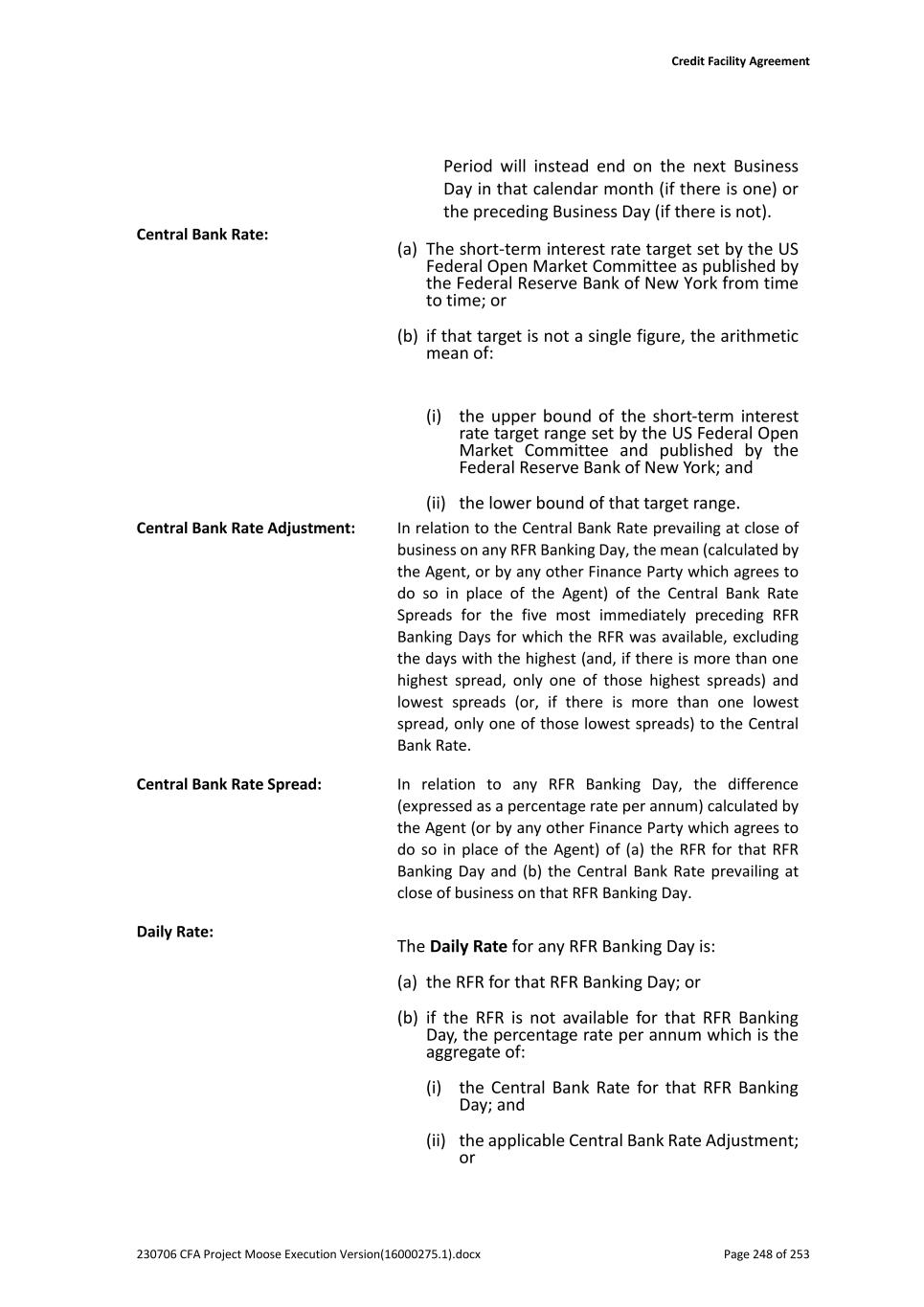
Credit Facility Agreement 230706 CFA Project Moose Execution Version(16000275.1).docx Page 248 of 253 Period will instead end on the next Business Day in that calendar month (if there is one) or the preceding Business Day (if there is not). Central Bank Rate: (a) The short-term interest rate target set by the US Federal Open Market Committee as published by the Federal Reserve Bank of New York from time to time; or (b) if that target is not a single figure, the arithmetic mean of: (i) the upper bound of the short-term interest rate target range set by the US Federal Open Market Committee and published by the Federal Reserve Bank of New York; and (ii) the lower bound of that target range. Central Bank Rate Adjustment: In relation to the Central Bank Rate prevailing at close of business on any RFR Banking Day, the mean (calculated by the Agent, or by any other Finance Party which agrees to do so in place of the Agent) of the Central Bank Rate Spreads for the five most immediately preceding RFR Banking Days for which the RFR was available, excluding the days with the highest (and, if there is more than one highest spread, only one of those highest spreads) and lowest spreads (or, if there is more than one lowest spread, only one of those lowest spreads) to the Central Bank Rate. Central Bank Rate Spread: In relation to any RFR Banking Day, the difference (expressed as a percentage rate per annum) calculated by the Agent (or by any other Finance Party which agrees to do so in place of the Agent) of (a) the RFR for that RFR Banking Day and (b) the Central Bank Rate prevailing at close of business on that RFR Banking Day. Daily Rate: The Daily Rate for any RFR Banking Day is: (a) the RFR for that RFR Banking Day; or (b) if the RFR is not available for that RFR Banking Day, the percentage rate per annum which is the aggregate of: (i) the Central Bank Rate for that RFR Banking Day; and (ii) the applicable Central Bank Rate Adjustment; or
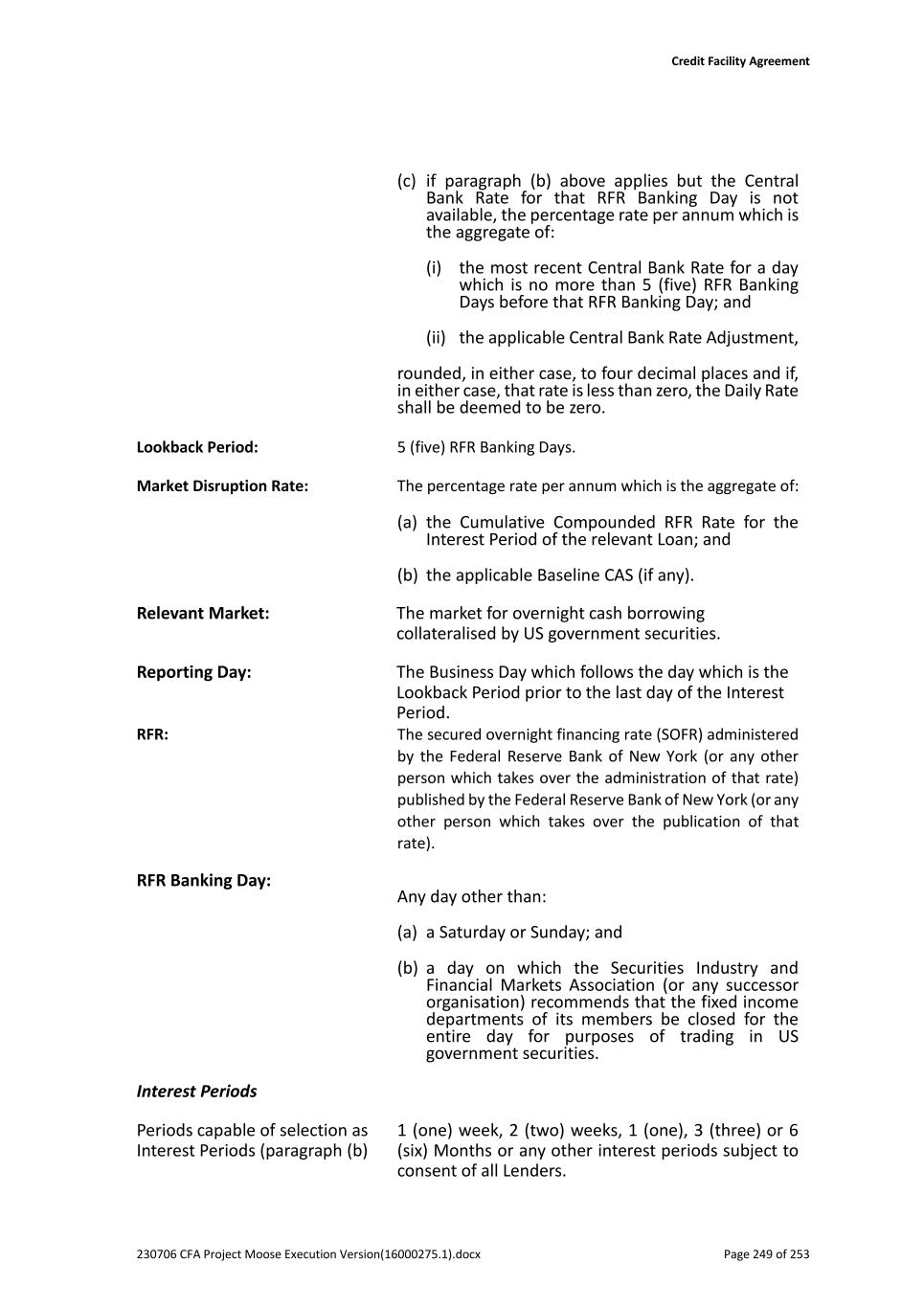
Credit Facility Agreement 230706 CFA Project Moose Execution Version(16000275.1).docx Page 249 of 253 (c) if paragraph (b) above applies but the Central Bank Rate for that RFR Banking Day is not available, the percentage rate per annum which is the aggregate of: (i) the most recent Central Bank Rate for a day which is no more than 5 (five) RFR Banking Days before that RFR Banking Day; and (ii) the applicable Central Bank Rate Adjustment, rounded, in either case, to four decimal places and if, in either case, that rate is less than zero, the Daily Rate shall be deemed to be zero. Lookback Period: 5 (five) RFR Banking Days. Market Disruption Rate: The percentage rate per annum which is the aggregate of: (a) the Cumulative Compounded RFR Rate for the Interest Period of the relevant Loan; and (b) the applicable Baseline CAS (if any). Relevant Market: The market for overnight cash borrowing collateralised by US government securities. Reporting Day: The Business Day which follows the day which is the Lookback Period prior to the last day of the Interest Period. RFR: The secured overnight financing rate (SOFR) administered by the Federal Reserve Bank of New York (or any other person which takes over the administration of that rate) published by the Federal Reserve Bank of New York (or any other person which takes over the publication of that rate). RFR Banking Day: Any day other than: (a) a Saturday or Sunday; and (b) a day on which the Securities Industry and Financial Markets Association (or any successor organisation) recommends that the fixed income departments of its members be closed for the entire day for purposes of trading in US government securities. Interest Periods Periods capable of selection as Interest Periods (paragraph (b) 1 (one) week, 2 (two) weeks, 1 (one), 3 (three) or 6 (six) Months or any other interest periods subject to consent of all Lenders.
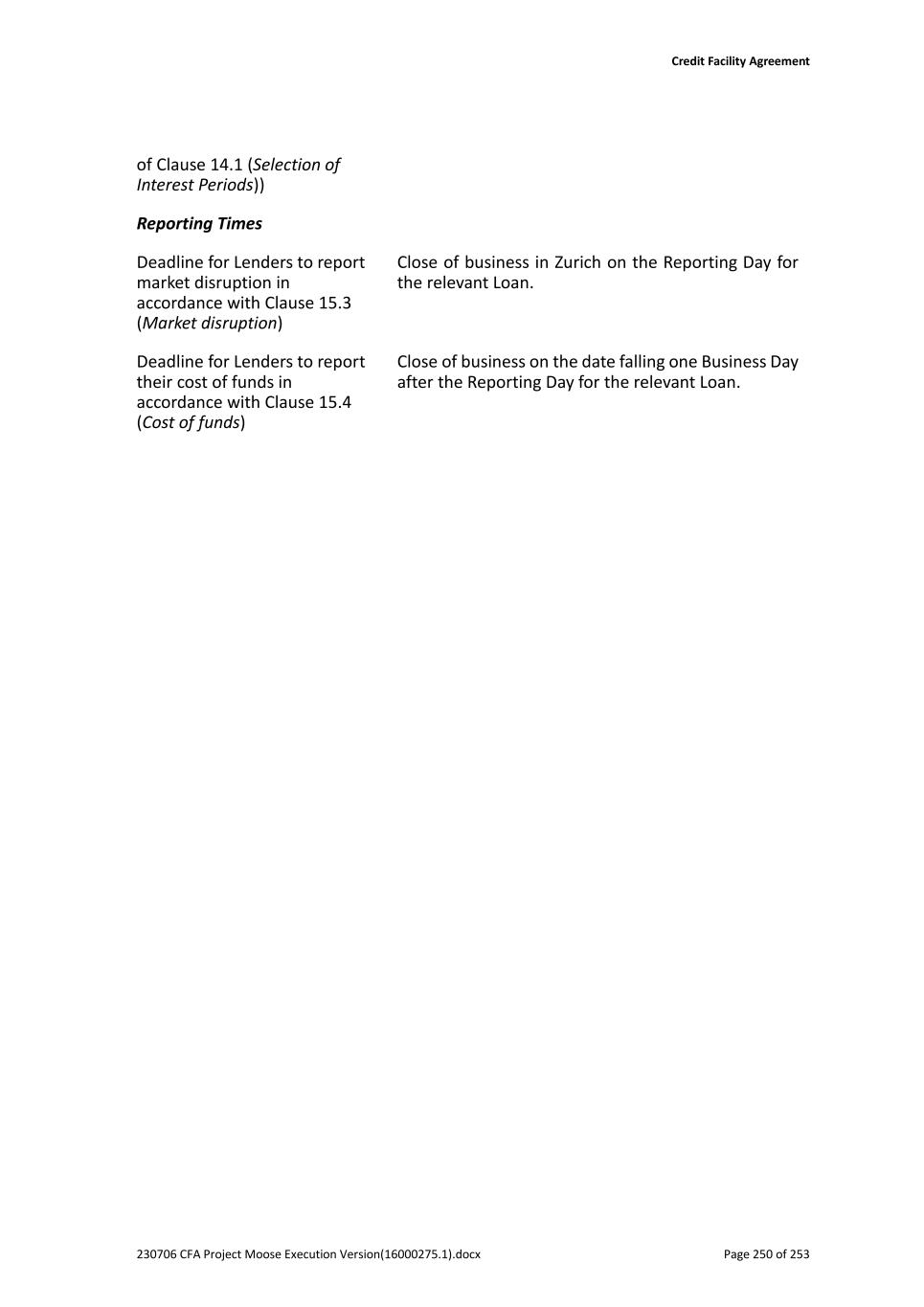
Credit Facility Agreement 230706 CFA Project Moose Execution Version(16000275.1).docx Page 250 of 253 of Clause 14.1 (Selection of Interest Periods)) Reporting Times Deadline for Lenders to report market disruption in accordance with Clause 15.3 (Market disruption) Close of business in Zurich on the Reporting Day for the relevant Loan. Deadline for Lenders to report their cost of funds in accordance with Clause 15.4 (Cost of funds) Close of business on the date falling one Business Day after the Reporting Day for the relevant Loan.
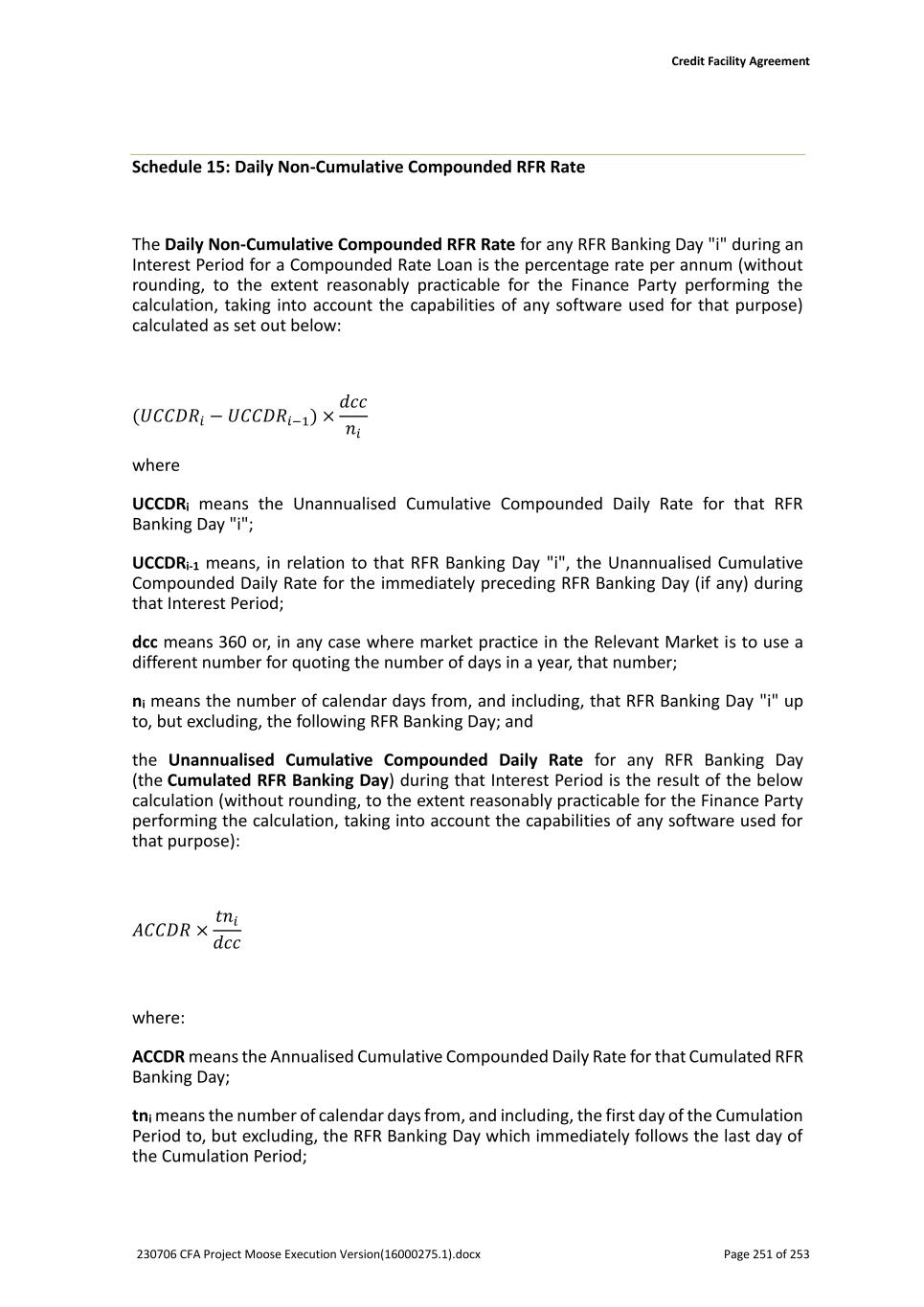
Credit Facility Agreement 230706 CFA Project Moose Execution Version(16000275.1).docx Page 251 of 253 Schedule 15: Daily Non-Cumulative Compounded RFR Rate The Daily Non-Cumulative Compounded RFR Rate for any RFR Banking Day "i" during an Interest Period for a Compounded Rate Loan is the percentage rate per annum (without rounding, to the extent reasonably practicable for the Finance Party performing the calculation, taking into account the capabilities of any software used for that purpose) calculated as set out below: (𝑈𝐶𝐶𝐷𝑅𝑖 − 𝑈𝐶𝐶𝐷𝑅𝑖−1) × 𝑑𝑐𝑐 𝑛𝑖 where UCCDRi means the Unannualised Cumulative Compounded Daily Rate for that RFR Banking Day "i"; UCCDRi-1 means, in relation to that RFR Banking Day "i", the Unannualised Cumulative Compounded Daily Rate for the immediately preceding RFR Banking Day (if any) during that Interest Period; dcc means 360 or, in any case where market practice in the Relevant Market is to use a different number for quoting the number of days in a year, that number; ni means the number of calendar days from, and including, that RFR Banking Day "i" up to, but excluding, the following RFR Banking Day; and the Unannualised Cumulative Compounded Daily Rate for any RFR Banking Day (the Cumulated RFR Banking Day) during that Interest Period is the result of the below calculation (without rounding, to the extent reasonably practicable for the Finance Party performing the calculation, taking into account the capabilities of any software used for that purpose): 𝐴𝐶𝐶𝐷𝑅 × 𝑡𝑛𝑖 𝑑𝑐𝑐 where: ACCDR means the Annualised Cumulative Compounded Daily Rate for that Cumulated RFR Banking Day; tni means the number of calendar days from, and including, the first day of the Cumulation Period to, but excluding, the RFR Banking Day which immediately follows the last day of the Cumulation Period;

Credit Facility Agreement 230706 CFA Project Moose Execution Version(16000275.1).docx Page 252 of 253 Cumulation Period means the period from, and including, the first RFR Banking Day of that Interest Period to, and including, that Cumulated RFR Banking Day; dcc has the meaning given to that term above; and the Annualised Cumulative Compounded Daily Rate for that Cumulated RFR Banking Day is the percentage rate per annum (rounded to the same number of decimal places as is specified in the definition of the respective Daily Rate) calculated as set out below: [ ∏(1 + 𝐷𝑎𝑖𝑙𝑦𝑅𝑎𝑡𝑒i−LP × ni dcc ) d0 i̇=1 − 1 ] × dcc tni where: d0 means the number of RFR Banking Days in the Cumulation Period; Cumulation Period has the meaning given to that term above; i means a series of whole numbers from one to d0, each representing the relevant RFR Banking Day in chronological order in the Cumulation Period; DailyRatei-LP means, for any RFR Banking Day "i" in the Cumulation Period, the Daily Rate for the RFR Banking Day which is the applicable Lookback Period prior to that RFR Banking Day "i"; ni means, for any RFR Banking Day "i" in the Cumulation Period, the number of calendar days from, and including, that RFR Banking Day "i" up to, but excluding, the following RFR Banking Day; dcc has the meaning given to that term above; and tni has the meaning given to that term above.
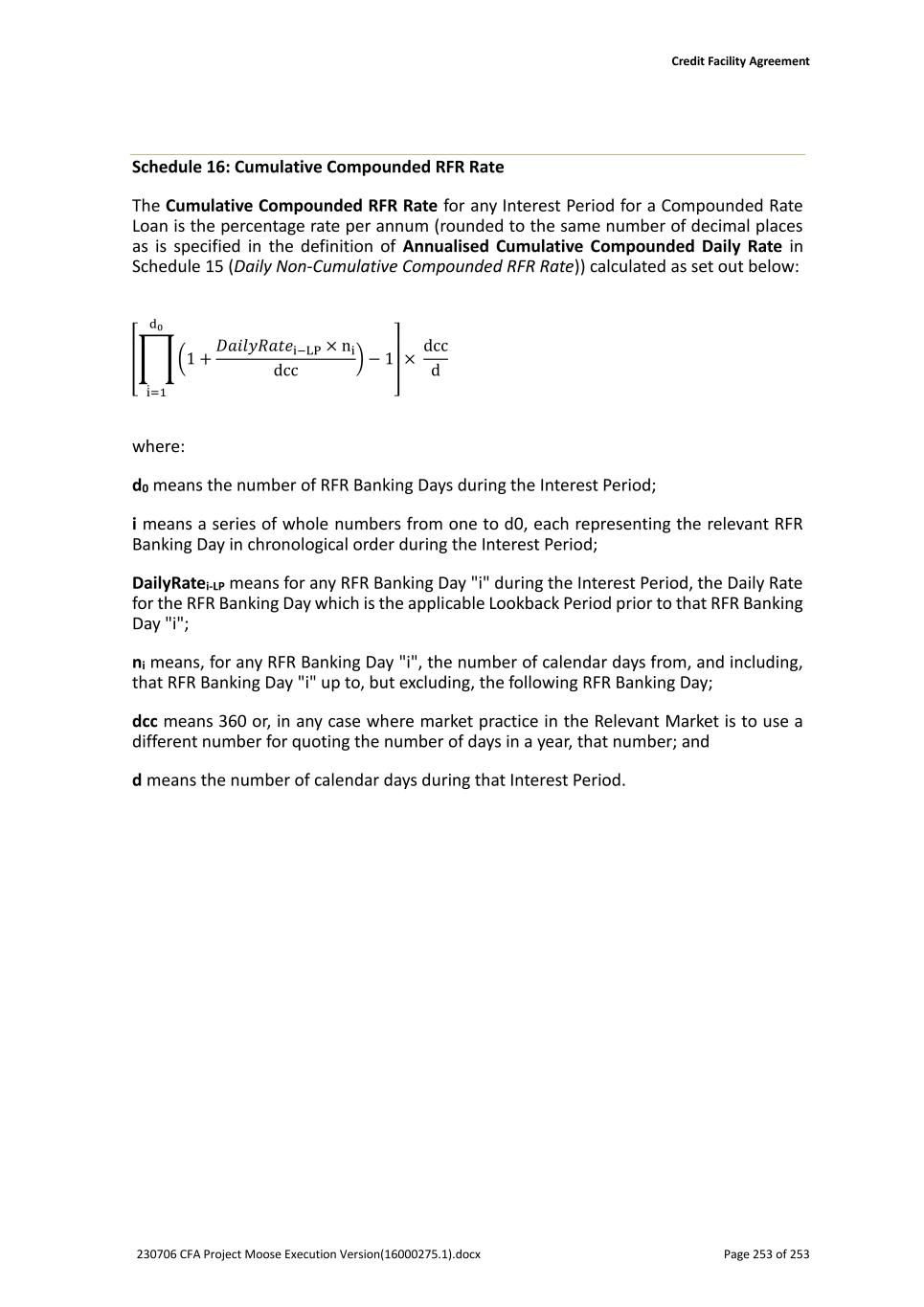
Credit Facility Agreement 230706 CFA Project Moose Execution Version(16000275.1).docx Page 253 of 253 Schedule 16: Cumulative Compounded RFR Rate The Cumulative Compounded RFR Rate for any Interest Period for a Compounded Rate Loan is the percentage rate per annum (rounded to the same number of decimal places as is specified in the definition of Annualised Cumulative Compounded Daily Rate in Schedule 15 (Daily Non-Cumulative Compounded RFR Rate)) calculated as set out below: [ ∏(1 + 𝐷𝑎𝑖𝑙𝑦𝑅𝑎𝑡𝑒i−LP × ni dcc ) d0 i̇=1 − 1 ] × dcc d where: d0 means the number of RFR Banking Days during the Interest Period; i means a series of whole numbers from one to d0, each representing the relevant RFR Banking Day in chronological order during the Interest Period; DailyRatei-LP means for any RFR Banking Day "i" during the Interest Period, the Daily Rate for the RFR Banking Day which is the applicable Lookback Period prior to that RFR Banking Day "i"; ni means, for any RFR Banking Day "i", the number of calendar days from, and including, that RFR Banking Day "i" up to, but excluding, the following RFR Banking Day; dcc means 360 or, in any case where market practice in the Relevant Market is to use a different number for quoting the number of days in a year, that number; and d means the number of calendar days during that Interest Period.
EX-8.1
4
exhibit81_exhibit81subsidi.htm
EX-8.1_LIST_OF_SUBSIDIARIES
Document
Exhibit 8.1
Subsidiaries of On Holding AG
|
|
|
|
|
|
| Name of Subsidiary |
Jurisdiction of Organization |
| |
|
| On AG |
Zurich, CH |
| On Brazil Ltda. |
Sao Paulo, BR |
| On Cloud Service GmbH |
Berlin, DE |
| On Clouds GmbH |
Zurich, CH |
| On Clouds Inc. |
Delaware, USA |
| On Europe AG |
Zurich, CH |
| On Experience 1 LLC |
Delaware, USA |
| On Experience 2 LLC |
Delaware, USA |
| On Experience 3 LLC |
Delaware, USA |
| On Experience 4 LLC |
Delaware, USA |
| On Experience 5 LLC |
Delaware, USA |
On Experience 6 LLC |
Delaware, USA |
On Experience 7 LLC |
Delaware, USA |
On Experience 8 LLC |
Delaware, USA |
| On Hong Kong Ltd. |
Hong Kong, SAR of CN |
| On Inc. |
Oregon, USA |
| On Italy S.r.l. |
Milan, IT |
| On Japan K.K. |
Yokohama, JP |
On Korea Ltd. |
Seoul, Korea |
| On Oceania Pty Ltd. |
Melbourne, AU |
| On Running Canada Inc. |
Vancouver, CA |
| On Running Sports Products (Shanghai) Company Ltd. |
Shanghai, CN |
| On Running UK Ltd. |
London, UK |
| On Vietnam Co. Ltd. |
Ho Chi Minh City, VN |
| Brunner Mettler GmbH |
Zurich, CH |
EX-12.1
5
exhibit121_302certificatio.htm
EX-12.1_SEC.302_CERTIFICATION_MARC_MAURER
Document
Exhibit 12.1
Certification of Marc Maurer, Co-Chief Executive Officer of On Holding AG, Pursuant to Section 302 of the Sarbanes-Oxley Act of 2002
I, Marc Maurer, certify that:
1.I have reviewed this annual report on Form 20-F of On Holding AG (the "Company");
2.Based on my knowledge, this report does not contain any untrue statement of a material fact or omit to state a material fact necessary to make the statements made, in light of the circumstances under which such statements were made, not misleading with respect to the period covered by this report;
3.Based on my knowledge, the financial statements, and other financial information included in this report, fairly present in all material respects the financial condition, results of operations and cash flows of the Company as of, and for, the periods presented in this report;
4.The Company’s other certifying officer and I are responsible for establishing and maintaining disclosure controls and procedures (as defined in Exchange Act Rules 13a-15(e) and 15d-15(e)) and internal control over financial reporting (as defined in Exchange Act Rules 13a-15(f) and 15d-15(f)) for the Company and have:
a)Designed such disclosure controls and procedures, or caused such disclosure controls and procedures to be designed under our supervision, to ensure that material information relating to the Company, including its consolidated subsidiaries, is made known to us by others within those entities, particularly during the period in which this report is being prepared;
b)Designed such internal control over financial reporting, or caused such internal control over financial reporting to be designed under our supervision, to provide reasonable assurance regarding the reliability of financial reporting and the preparation of financial statements for external purposes in accordance with generally accepted accounting principles;
c)Evaluated the effectiveness of the Company’s disclosure controls and procedures and presented in this report our conclusions about the effectiveness of the disclosure controls and procedures, as of the end of the period covered by this report based on such evaluation; and
d)Disclosed in this report any change in the Company’s internal control over financial reporting that occurred during the period covered by the annual report that has materially affected, or is reasonably likely to materially affect, the Company’s internal control over financial reporting; and
5.The Company’s other certifying officer and I have disclosed, based on our most recent evaluation of internal control over financial reporting, to the Company’s auditors and the audit committee of the Company’s board of directors (or persons performing the equivalent functions):
a)All significant deficiencies and material weaknesses in the design or operation of internal control over financial reporting which are reasonably likely to adversely affect the Company’s ability to record, process, summarize and report financial information; and
b)Any fraud, whether or not material, that involves management or other employees who have a significant role in the Company’s internal control over financial reporting.
Dated: March 12, 2024
By: /s/ Marc Maurer
Name: Marc Maurer
Co-Chief Executive Officer
EX-12.2
6
exhibit122_302certificatio.htm
EX-12.2_SEC.302_CERTIFICATION_MARTIN_HOFFMANN
Document
Exhibit 12.2
Certification of Martin Hoffmann, Chief Financial Officer and Co-Chief Executive Officer of On Holding AG, Pursuant to Section 302 of the Sarbanes-Oxley Act of 2002
I, Martin Hoffmann, certify that:
1.I have reviewed this annual report on Form 20-F of On Holding AG (the "Company");
2.Based on my knowledge, this report does not contain any untrue statement of a material fact or omit to state a material fact necessary to make the statements made, in light of the circumstances under which such statements were made, not misleading with respect to the period covered by this report;
3.Based on my knowledge, the financial statements, and other financial information included in this report, fairly present in all material respects the financial condition, results of operations and cash flows of the Company as of, and for, the periods presented in this report;
4.The Company’s other certifying officer and I are responsible for establishing and maintaining disclosure controls and procedures (as defined in Exchange Act Rules 13a-15(e) and 15d-15(e)) and internal control over financial reporting (as defined in Exchange Act Rules 13a-15(f) and 15d-15(f)) for the Company and have:
a)Designed such disclosure controls and procedures, or caused such disclosure controls and procedures to be designed under our supervision, to ensure that material information relating to the Company, including its consolidated subsidiaries, is made known to us by others within those entities, particularly during the period in which this report is being prepared;
b)Designed such internal control over financial reporting, or caused such internal control over financial reporting to be designed under our supervision, to provide reasonable assurance regarding the reliability of financial reporting and the preparation of financial statements for external purposes in accordance with generally accepted accounting principles;
c)Evaluated the effectiveness of the Company’s disclosure controls and procedures and presented in this report our conclusions about the effectiveness of the disclosure controls and procedures, as of the end of the period covered by this report based on such evaluation; and
d)Disclosed in this report any change in the Company’s internal control over financial reporting that occurred during the period covered by the annual report that has materially affected, or is reasonably likely to materially affect, the Company’s internal control over financial reporting; and
5.The Company’s other certifying officer and I have disclosed, based on our most recent evaluation of internal control over financial reporting, to the Company’s auditors and the audit committee of the Company’s board of directors (or persons performing the equivalent functions):
a)All significant deficiencies and material weaknesses in the design or operation of internal control over financial reporting which are reasonably likely to adversely affect the Company’s ability to record, process, summarize and report financial information; and
b)Any fraud, whether or not material, that involves management or other employees who have a significant role in the Company’s internal control over financial reporting.
Dated: March 12, 2024
By: /s/ Martin Hoffmann
Name: Martin Hoffmann
Chief Financial Officer and Co-Chief Executive Officer
EX-13.1
7
exhibit131_906certificatio.htm
EX-13.1_SEC.906_CERTIFICATIONS
Document
Exhibit 13.1
Certifications of Co-Chief Executive Officers and Chief Financial Officer of On Holding AG Pursuant to Section 18 U.S.C. Section 1350, as adopted Pursuant to Section 906 of the Sarbanes-Oxley Act of 2002
I, Marc Maurer, to the best of my knowledge certify, pursuant to 18 U.S.C. Section 1350, as adopted pursuant to Section 906 of the Sarbanes-Oxley Act of 2002, that the Annual Report on Form 20-F of On Holding AG for the year ended December 31, 2023, fully complies with the requirements of Section 13(a) or Section 15(d) of the Securities Exchange Act of 1934 and that the information contained in such report fairly presents, in all material respects, the financial condition and results of operations of the On Holding AG.
Dated: March 12, 2024
By: /s/ Marc Maurer
Name: Marc Maurer
Title: Co-Chief Executive Officer
I, Martin Hoffmann, to the best of my knowledge certify, pursuant to 18 U.S.C. Section 1350, as adopted pursuant to Section 906 of the Sarbanes-Oxley Act of 2002, that the Annual Report on Form 20-F of On Holding AG for the year ended December 31, 2023, fully complies with the requirements of Section 13(a) or Section 15(d) of the Securities Exchange Act of 1934 and that the information contained in such report fairly presents, in all material respects, the financial condition and results of operations of the On Holding AG.
Dated: March 12, 2024
By: /s/ Martin Hoffmann
Name: Martin Hoffmann
Title: Chief Financial Officer and Co-Chief Executive Officer
EX-15.1
8
exhibit151_pricewaterhouse.htm
EX-15.1_CONSENT_OF_PRICEWATERHOUSECOOPERS_AG
Document
Exhibit 15.1
Consent of Independent Registered Public Accounting Firm
We hereby consent to the incorporation by reference in the Registration Statements on Form F-3 (No. 333-268852) and Form S-8 (No. 333-268853 and No. 333-259533) of On Holding AG of our report dated March 12, 2024 relating to the financial statements and the effectiveness of internal control over financial reporting, which appears in this Form 20-F.
/s/ PricewaterhouseCoopers AG
Zurich, Switzerland
March 12, 2024
EX-97.1
9
exhibit971_onholdingagfina.htm
EX-97.1_FINANCIAL_STATEMENT_COMPENSATION_RECOUPMENT_POLICY
Document
Exhibit 97.1
On Holding AG
FINANCIAL STATEMENT COMPENSATION RECOUPMENT POLICY
This On Holding AG Financial Statement Compensation Recoupment Policy (the “Policy”) has been adopted by the Board of Directors (the “Board”) of On Holding AG (the “Company”) on November 2, 2023.This Policy provides for the recoupment of certain executive compensation in the event of an accounting restatement resulting from material noncompliance with financial reporting requirements under U.S. federal securities laws in accordance with the terms and conditions set forth herein. This Policy is intended to comply with the requirements of Section 10D of the Exchange Act (as defined below) and Section 303A.14 of the NYSE Listed Company Manual and will apply to compensation "received" from and after October 2, 2023, the date on which Section 303A.14 of the NYSE Listed Company Manual becomes effective.
1.Definitions. For the purposes of this Policy, the following terms shall have the meanings set forth below. Capitalized terms used but not defined in this Policy shall have the meanings set forth in the "On Holding AG Long Term Incentive Plan 2021" (the “LTIP 2021”) as may be amended from time to time).
(a)“Committee” means the Nomination and Compensation Committee of the Board or any successor committee thereof.
(b)“Covered Compensation” means any Incentive-based Compensation “received” by a Covered Executive during the applicable Recoupment Period; provided that:
(i)such Covered Compensation was received by such Covered Executive (A) after the Effective Date, (B) after he or she commenced service as an Executive Officer and (C) while the Company had a class of securities publicly listed on a United States national securities exchange; and
(ii)such Covered Executive served as an Executive Officer at any time during the performance period applicable to such Incentive-based Compensation.
For purposes of this Policy, Incentive-based Compensation is “received” by a Covered Executive during the fiscal period in which the Financial Reporting Measure applicable to such Incentive-based Compensation (or portion thereof) is attained, even if the payment or grant of such Incentive-based Compensation is made thereafter.
(c)“Covered Executive” means any (i) current or former Executive Officer.
(d)“Effective Date” means the date on which Section 303A.14 of the NYSE Listed Company Manual becomes effective.
(e)“Exchange Act” means the U.S. Securities Exchange Act of 1934, as amended.
(f)“Executive Officer” means, with respect to the Company, (i) its Founders, (ii) its Chief Executive Officer(s) (iii) its president, (iv) its principal financial officer, (v) its principal accounting officer (or if there is no such accounting officer, its controller), (vi) any vice-president in charge of a principal business unit, division or function (such as sales, administration or finance), (vii) any other officer who performs a policy-making function for the Company (including any officer of the Company’s parent(s) or subsidiaries if they perform policy making functions for the Company) and (viii) any other person who performs similar policy-making functions for the Company. Policy-making function is not intended to include policy-making functions that are not significant. The determination as to an individual’s status as an Executive Officer shall be made by the Committee and such determination shall be final, conclusive and binding on such individual and all other interested persons.
(g)“Financial Reporting Measure” means any (i) measure that is determined and presented in accordance with the accounting principles used in preparing the Company’s financial statements, (ii) stock price measure or (iii) total shareholder return measure (and any measures that are derived wholly or in part from any measure referenced in clause (i), (ii) or (iii) above). For the avoidance of doubt, any such measure does not need to be presented within the Company’s financial statements or included in a filing with the U.S. Securities and Exchange Commission to constitute a Financial Reporting Measure.
(h)“Financial Restatement” means a restatement of the Company’s financial statements due to the Company’s material noncompliance with any financial reporting requirement under U.S. federal securities laws that is required in order to correct:
(i) an error in previously issued financial statements that is material to the previously issued financial statements; or (ii) an error that would result in a material misstatement if (A) the error were corrected in the current period or (B) left uncorrected in the current period.
For purposes of this Policy, a Financial Restatement shall not be deemed to occur in the event of a revision of the Company’s financial statements due to an out-of-period adjustment (i.e., when the error is immaterial to the previously issued financial statements and the correction of the error is also immaterial to the current period) or a retrospective (1) application of a change in accounting principles; (2) revision to reportable segment information due to a change in the structure of the Company’s internal organization; (3) reclassification due to a discontinued operation; (4) application of a change in reporting entity, such as from a reorganization of entities under common control; (5) revision for stock splits, reverse stock splits, stock dividends or other changes in capital structure; or (6) adjustment to provisional amounts in connection with a prior business combination.
(i)“Incentive-based Compensation” means any compensation (including, for the avoidance of doubt, any cash or equity or equity-based compensation, whether deferred or current) that is granted, earned and/or vested based wholly or in part upon the achievement of a Financial Reporting Measure. For purposes of this Policy, “Incentive-based Compensation” shall also be deemed to include any amounts which were determined based on (or were otherwise calculated by reference to) Incentive-based Compensation (including, without limitation, any amounts under any long-term disability, life insurance or supplemental retirement or severance plan or agreement or any notional account that is based on Incentive-based Compensation, as well as any earnings accrued thereon).
(j)“NYSE” means the New York Stock Exchange, or any successor thereof.
(k)“Recoupment Period” means the three (3) fiscal years completed immediately preceding the date of any applicable Recoupment Trigger Date. Notwithstanding the foregoing, the Recoupment Period additionally includes any transition period (that results from a change in the Company’s fiscal year) within or immediately following those three completed fiscal years, provided that a transition period between the last day of the Company’s previous fiscal year end and the first day of its new fiscal year that comprises a period of nine (9) to twelve (12) months would be deemed a completed fiscal year.
(l)“Recoupment Trigger Date” means the earlier of (i) the date that the Board (or a committee thereof or the officer(s) of the Company authorized to take such action if Board action is not required) concludes, or reasonably should have concluded, that the Company is required to prepare a Financial Restatement, and (ii) the date on which a court, regulator or other legally authorized body directs the Company to prepare a Financial Restatement.
2.Recoupment of Erroneously Awarded Compensation.
(a)In the event of a Financial Restatement, if the amount of any Covered Compensation received by a Covered Executive (the “Awarded Compensation”) exceeds the amount of such Covered Compensation that would have otherwise been received by such Covered Executive if calculated based on the Financial Restatement (the “Adjusted Compensation”), the Company shall reasonably promptly recover from such Covered Executive an amount equal to the excess of the Awarded Compensation over the Adjusted Compensation, each calculated on a pre-tax basis (such excess amount, the “Erroneously Awarded Compensation”).
(b)If (i) the Financial Reporting Measure applicable to the relevant Covered Compensation is stock price or total shareholder return (or any measure derived wholly or in part from either of such measures) and (ii) the amount of Erroneously Awarded Compensation is not subject to mathematical recalculation directly from the information in the Financial Restatement, then the amount of
Erroneously Awarded Compensation shall be determined (on a pre-tax basis) based on the Company’s reasonable estimate of the effect of the Financial Restatement on the Company’s stock price or total shareholder return (or the derivative measure thereof) upon which such Covered Compensation was received.
(c)For the avoidance of doubt, the Company’s obligation to recover Erroneously Awarded Compensation is not dependent on (i) if or when the restated financial statements are filed or (ii) any fault of any Covered Executive for the accounting errors or other actions leading to a Financial Restatement.
(d)Notwithstanding anything to the contrary in Sections 2(a) through (c) hereof, the Company shall not be required to recover any Erroneously Awarded Compensation if both (x) the conditions set forth in either of the following clauses (i), (ii), or (iii) are satisfied and (y) the Committee (or a majority of the independent directors serving on the Board) has determined that recovery of the Erroneously Awarded Compensation would be impracticable:
(i) the direct expense paid to a third party to assist in enforcing the recovery of the Erroneously Awarded Compensation under this Policy would exceed the amount of such Erroneously Awarded Compensation to be recovered; provided that, before concluding that it would be impracticable to recover any amount of Erroneously Awarded Compensation pursuant to this Section 2(d), the Company shall have first made a reasonable attempt to recover such Erroneously Awarded Compensation, document such reasonable attempt(s) to make such recovery and provide that documentation to the NYSE;
(ii) recovery of the Erroneously Awarded Compensation would violate Swiss law to the extent such law was adopted prior to November 28, 2022 (provided that, before concluding that it would be impracticable to recover any amount of Erroneously Awarded Compensation pursuant to this Section 2(d)), the Company shall have first obtained an opinion of home country counsel of Switzerland, that is acceptable to the NYSE, that recovery would result in such a violation, and the Company must provide such opinion to the NYSE; or
(iii) recovery of the Erroneously Awarded Compensation would likely cause an otherwise tax-qualified retirement plan, under which benefits are broadly available to employees of the Company, to fail to meet the requirements of Sections 401(a)(13) or 411(a) of the U.S. Internal Revenue Code of 1986, as amended (the “Code”).
(e)The Company shall not indemnify any Covered Executive, directly or indirectly, for any losses that such Covered Executive may incur in connection with the recovery of Erroneously Awarded Compensation pursuant to this Policy, including through the payment of insurance premiums or gross up payments.
(f)The Committee shall determine, in its sole discretion, the manner and timing in which any Erroneously Awarded Compensation shall be recovered from a Covered Executive in accordance with applicable law, including, without limitation, by (i) requiring reimbursement of Covered Compensation previously paid in cash; (ii) seeking recovery of any gain realized on the vesting, exercise, settlement, sale, transfer or other disposition of any equity or equity-based awards; (iii) offsetting the Erroneously Awarded Compensation amount from any compensation otherwise owed by the Company or any of its affiliates to the Covered Executive; (iv) cancelling outstanding vested or unvested equity or equity based awards; and/or (v) taking any other remedial and recovery action permitted by applicable law. For the avoidance of doubt, except as set forth in Section 2(d), in no event may the Company accept an amount that is less than the amount of Erroneously Awarded Compensation; provided that, to the extent necessary to avoid any adverse tax consequences to the Covered Executive pursuant to Section 409A of the Code, any offsets against amounts under any nonqualified deferred compensation plans (as defined under Section 409A of the Code) shall be made in compliance with Section 409A of the Code.
3.Administration. This Policy shall be administered by the Committee. All decisions of the Committee shall be final, conclusive and binding upon the Company and the Covered Executives, their beneficiaries, executors, administrators and any other legal representative. The Committee shall have full power and authority to (i) administer and interpret this Policy; (ii) correct any defect, supply any omission and reconcile any inconsistency in this Policy; and (iii) make any other determination and take any other action that the Committee deems necessary or desirable for the administration of this Policy and to comply with applicable law (including Section 10D of the Exchange Act) and applicable stock market or exchange rules and regulations. Notwithstanding anything to the contrary contained herein, to the extent permitted by Section 10D of the Exchange Act and Section 303A.14 of the NYSE Listed Company Manual, the Board may, in its sole discretion, at any time and from time to time, administer this Policy in the same manner as the Committee.
4.Amendment/Termination. Subject to Section 10D of the Exchange Act and Section 303A.14 of the NYSE Listed Company Manual, this Policy may be amended or terminated by the Committee at any time. To the extent that any applicable law, or stock market or exchange rules or regulations require recovery of Erroneously Awarded Compensation in circumstances in addition to those specified herein, nothing in this Policy shall be deemed to limit or restrict the right or obligation of the Company to recover Erroneously Awarded Compensation to the fullest extent required by such applicable law, stock market or exchange rules and regulations. Unless otherwise required by applicable law, this Policy shall no longer be effective from and after the date that the Company no longer has a class of securities publicly listed on a United States national securities exchange.
5.Interpretation. Notwithstanding anything to the contrary herein, this Policy is intended to comply with the requirements of Section 10D of the Exchange Act and Section 303A.14 of the NYSE Listed Company Manual (and any applicable regulations, administrative interpretations or stock market or exchange rules and regulations adopted in connection therewith). The provisions of this Policy shall be interpreted in a manner that satisfies such requirements and this Policy shall be operated accordingly. If any provision of this Policy would otherwise frustrate or conflict with this intent, the provision shall be interpreted and deemed amended so as to avoid such conflict.
6.Other Compensation Clawback/Recoupment Rights. Any right of recoupment under this Policy is in addition to, and not in lieu of, any other remedies, rights or requirements with respect to the clawback or recoupment of any compensation that may be available to the Company pursuant to the terms of any other recoupment or clawback policy of the Company (or any of its affiliates) that may be in effect from time to time, any provisions in any employment agreement, offer letter, equity plan, equity award agreement or similar plan or agreement, and any other legal remedies available to the Company, as well as applicable law, stock market or exchange rules, listing standards or regulations; provided, however, that any amounts recouped or clawed back under any other policy that would be recoupable under this Policy shall count toward any required clawback or recoupment under this Policy and vice versa.
7.Exempt Compensation. Notwithstanding anything to the contrary herein, the Company has no obligation to seek recoupment of amounts paid to a Covered Executive which are granted, vested or earned based solely upon the occurrence or non-occurrence of nonfinancial events. Such exempt compensation includes, without limitation, base salary, time-vesting awards, compensation awarded on the basis of the achievement of metrics that are not Financial Reporting Measures or compensation awarded solely at the discretion of the Committee or the Board, provided that such amounts are in no way contingent on and were not in any way granted on the basis of, the achievement of any Financial Reporting Measure performance goal.
8.Miscellaneous.
(a) Any applicable award agreement or other document setting forth the terms and conditions of any compensation covered by this Policy shall be deemed to include the restrictions imposed herein and incorporate this Policy by reference and, in the event of any inconsistency, the terms of this Policy will govern. For the avoidance of doubt, this Policy applies to all compensation that is received on or after the Effective Date, regardless of the date on which the award agreement or other document setting forth the terms and conditions of the Covered Executive’s compensation became effective, including, without limitation, compensation received under the LTIP 2021 and any successor plan thereto.
(b) This Policy shall be binding and enforceable against all Covered Executives and their beneficiaries, heirs, executors, administrators or other legal representatives.
(c) All issues concerning the construction, validity, enforcement and interpretation of this Policy and all related documents, including, without limitation, any employment agreement, offer letter, equity award agreement or similar agreement, shall be governed by, and construed in accordance with Swiss substantive law, without giving effect to any choice of law or conflict of law rules or provisions (whether of Switzerland or any other jurisdiction) that would cause the application of the laws of any jurisdiction other than Switzerland.
(d) The Covered Executives, their beneficiaries, executors, administrators and any other legal representative and the Company shall initially attempt to resolve all claims, disputes or controversies arising under, out of or in connection with this Policy by conducting good faith negotiations amongst themselves. Any and all disputes, claims or causes of action arising from or relating to the enforcement, performance or interpretation of this Policy shall be resolved by the courts in Switzerland having jurisdictions regarding any claims under the respective employment agreements between the Company (or any of its affiliates) and the respective Executive Officer.
(e) If any provision of this Policy is determined to be unenforceable or invalid under any applicable law, such provision will be applied to the maximum extent permitted by applicable law and shall automatically be deemed amended in a manner consistent with its objectives to the extent necessary to conform to any limitations required under applicable law.








